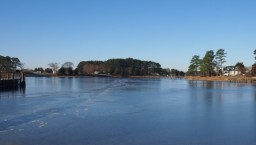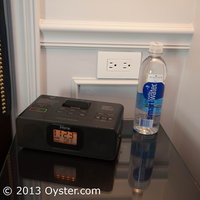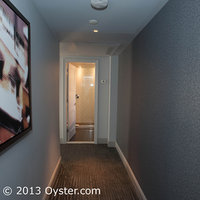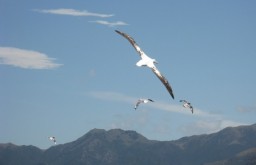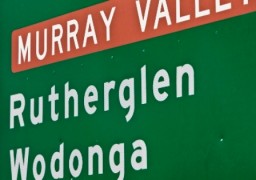How to travel haphazardly from Stockholm to Turku during late winter in a few days? Try this itinerary for something different.
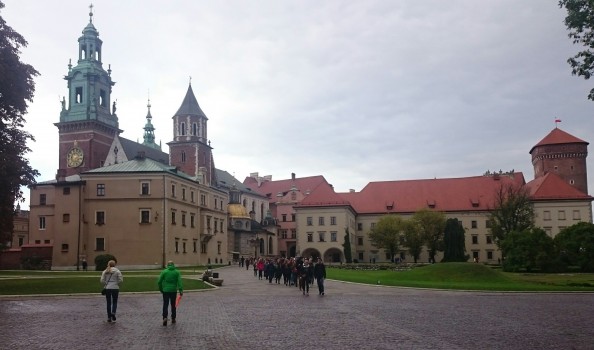 https://nakedhungrytraveller.com.au/krakow-bright-future-dark-past/ Krakow: Bright Future, Dark PastMention Poland to travellers and eyes are raised. ‘Why are you going there?’ is a typical query. As if I needed a reason to visit one of Europe’s most interesting countries. The Polish quandary. It’s off radar for many Europe bound travellers. No one asks me why I go to France, Italy or the UK. Popularity explains everything supposedly. Krakow was the capital city until the ruling Swedish king moved it to Warsaw in 1596. It remained the capital of the Grand Duchy of Krakow from 1846 until 1918. Which largely accounts for its impressive public buildings. [caption id="attachment_4006" align="alignnone" width="610"]
https://nakedhungrytraveller.com.au/krakow-bright-future-dark-past/ Krakow: Bright Future, Dark PastMention Poland to travellers and eyes are raised. ‘Why are you going there?’ is a typical query. As if I needed a reason to visit one of Europe’s most interesting countries. The Polish quandary. It’s off radar for many Europe bound travellers. No one asks me why I go to France, Italy or the UK. Popularity explains everything supposedly. Krakow was the capital city until the ruling Swedish king moved it to Warsaw in 1596. It remained the capital of the Grand Duchy of Krakow from 1846 until 1918. Which largely accounts for its impressive public buildings. [caption id="attachment_4006" align="alignnone" width="610"]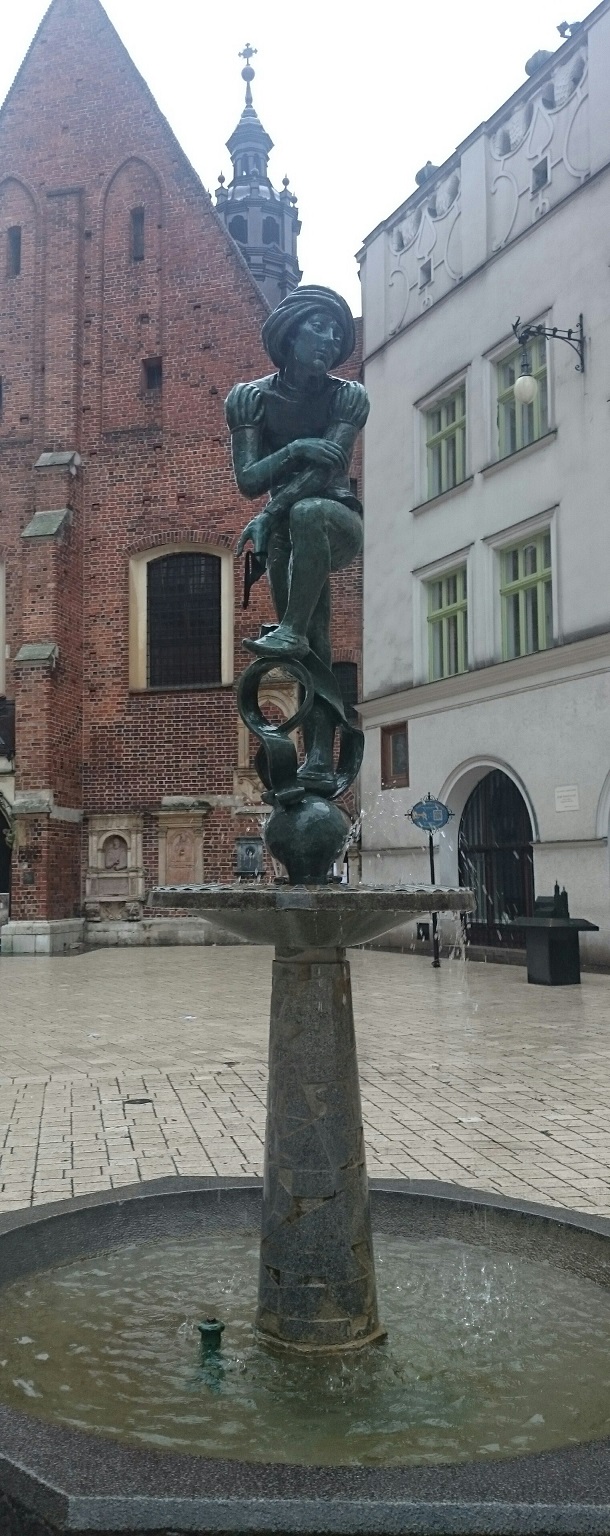 Krakow University[/caption]
Unlike Warsaw, sadly bombed to smithereens in WW2, Krakow retains its historic Old City (Stare Miasto) and Jewish Quarter (Kazimierz) almost intact.
Krakow University where Copernicus studied astronomy and mathematics helps sustain a lively student atmosphere; beer bars and wine infused bistros pepper the central city like ubiquitous Polish pickles.
With a population fewer than 1 million it’s also comparatively easy to navigate, a pedestrian’s paradise with parklands encircling the central district and an efficient tram network that reaches most everywhere a visitor would be interested in.
A Polish Australian connection is long standing.
Explorer Sir Pawel Edmund Strzelecki was commissioned by NSW Governor Sir George Gipps to survey what eventually became Gippsland. While surveying the Australian Alps in 1840 he named Australia’s highest point in honour of Tadeusz Kosciuszko, one of Poland’s most important national heroes.
The connection is a curious one for visitors. Just outside Krakow is an artificial hill, constructed in 1823 in commemoration of Kosciuszko. It’s simply called ‘Kosciuszko’s Mound’. Apparently when Strzelecki saw Australia’s highest peak it reminded him of the mound.
Krakow’s dominant sight is the Wawel Castle set on a rise overlooking the Vistula River. Not just one building but several command this impressive position. Polish royal families lived within its walls, kings and queens were crowned. In 1930 the complex became a national museum and now comprises ten separate curatorial departments from medieval tapestries to Renaissance art, armour to princely relics. The Polish crown jewels are here but they’re outshone by the coronation sword, ‘Szczerbiec’ in terms of cultural significance.
[caption id="attachment_4008" align="alignnone" width="1357"]
Krakow University[/caption]
Unlike Warsaw, sadly bombed to smithereens in WW2, Krakow retains its historic Old City (Stare Miasto) and Jewish Quarter (Kazimierz) almost intact.
Krakow University where Copernicus studied astronomy and mathematics helps sustain a lively student atmosphere; beer bars and wine infused bistros pepper the central city like ubiquitous Polish pickles.
With a population fewer than 1 million it’s also comparatively easy to navigate, a pedestrian’s paradise with parklands encircling the central district and an efficient tram network that reaches most everywhere a visitor would be interested in.
A Polish Australian connection is long standing.
Explorer Sir Pawel Edmund Strzelecki was commissioned by NSW Governor Sir George Gipps to survey what eventually became Gippsland. While surveying the Australian Alps in 1840 he named Australia’s highest point in honour of Tadeusz Kosciuszko, one of Poland’s most important national heroes.
The connection is a curious one for visitors. Just outside Krakow is an artificial hill, constructed in 1823 in commemoration of Kosciuszko. It’s simply called ‘Kosciuszko’s Mound’. Apparently when Strzelecki saw Australia’s highest peak it reminded him of the mound.
Krakow’s dominant sight is the Wawel Castle set on a rise overlooking the Vistula River. Not just one building but several command this impressive position. Polish royal families lived within its walls, kings and queens were crowned. In 1930 the complex became a national museum and now comprises ten separate curatorial departments from medieval tapestries to Renaissance art, armour to princely relics. The Polish crown jewels are here but they’re outshone by the coronation sword, ‘Szczerbiec’ in terms of cultural significance.
[caption id="attachment_4008" align="alignnone" width="1357"]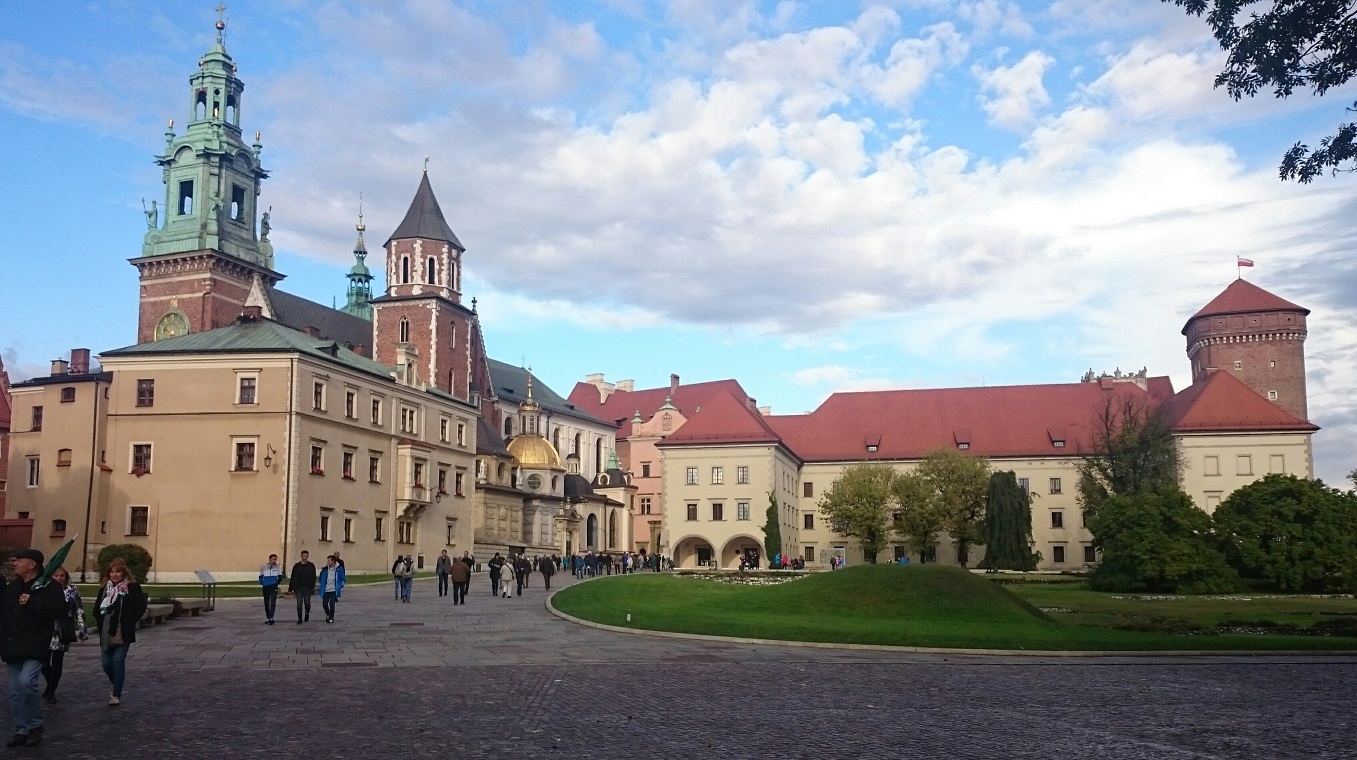 Wawel Castle[/caption]
The most famous face in art is Da Vinci’s ‘Mona Lisa’. The Louvre in Paris is lucky to have her. From my point of view his ‘The Lady with the Ermine’ in Krakow’s Vavel Castle (where she has her own room in the Czartoryski Museum) is equally mesmerising. The day I visited her it was late, about an hour before 5pm when the museum shuts its doors. During my hour with this masterpiece I was alone except for a single grumpy Polish guard. Ms Grumpy pointedly looked at her wristwatch whenever she caught my eye in case I overlooked closing time. Photography is prohibited inside the room where the exquisitely dressed young lady, a little white weasel held tentatively in her arms, gazes into space as if she ruled it, mysterious as her sister-in-fame the ‘Mona Lisa’. A well written history of the painting, its inception, subject and how it came to Krakow is in the adjacent room; photography is allowed there. wawel.krakow.pl
[caption id="attachment_4024" align="alignnone" width="600"]
Wawel Castle[/caption]
The most famous face in art is Da Vinci’s ‘Mona Lisa’. The Louvre in Paris is lucky to have her. From my point of view his ‘The Lady with the Ermine’ in Krakow’s Vavel Castle (where she has her own room in the Czartoryski Museum) is equally mesmerising. The day I visited her it was late, about an hour before 5pm when the museum shuts its doors. During my hour with this masterpiece I was alone except for a single grumpy Polish guard. Ms Grumpy pointedly looked at her wristwatch whenever she caught my eye in case I overlooked closing time. Photography is prohibited inside the room where the exquisitely dressed young lady, a little white weasel held tentatively in her arms, gazes into space as if she ruled it, mysterious as her sister-in-fame the ‘Mona Lisa’. A well written history of the painting, its inception, subject and how it came to Krakow is in the adjacent room; photography is allowed there. wawel.krakow.pl
[caption id="attachment_4024" align="alignnone" width="600"] Lady with an Ermine by Leonardo da Vinci[/caption]
The Old City (Stare Miasto) is a delight. A huge square occupies pride of place; it’s where you’ll find a fairly constant movable feast of humanity in all its guises. The wonderful Cloth Hall houses a market and is surrounded by cafes.
The square’s St Mary’s Basilica is the city’s largest church. Each hour, seven days a week, a single trumpeter emerges from its highest spire and plays the ‘Hejnal Mariacki’, a kind of national anthem. The trumpeter cuts off mid song in remembrance of when the original player was shot in the throat during a Mongol attack in the 13th century.
The noon performance is played each day on Polish national radio.
It’s a stirring memory. I waited for the trumpeter to face down on me (and some 20 patiently waiting primary school students). He plays the same interrupted tune four times facing the four compass points. Occasionally he waves down to the adoring crowds. The kids went wild cheering—as did I.
[caption id="attachment_4010" align="alignnone" width="615"]
Lady with an Ermine by Leonardo da Vinci[/caption]
The Old City (Stare Miasto) is a delight. A huge square occupies pride of place; it’s where you’ll find a fairly constant movable feast of humanity in all its guises. The wonderful Cloth Hall houses a market and is surrounded by cafes.
The square’s St Mary’s Basilica is the city’s largest church. Each hour, seven days a week, a single trumpeter emerges from its highest spire and plays the ‘Hejnal Mariacki’, a kind of national anthem. The trumpeter cuts off mid song in remembrance of when the original player was shot in the throat during a Mongol attack in the 13th century.
The noon performance is played each day on Polish national radio.
It’s a stirring memory. I waited for the trumpeter to face down on me (and some 20 patiently waiting primary school students). He plays the same interrupted tune four times facing the four compass points. Occasionally he waves down to the adoring crowds. The kids went wild cheering—as did I.
[caption id="attachment_4010" align="alignnone" width="615"]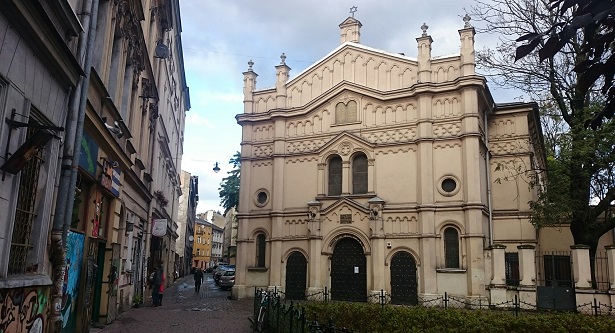 Krakow's oldest synagogue[/caption]
The Kazimierz (Jewish Quarter) is where many of Krakow’s funkiest bars and micro-breweries are located. The city’s oldest synagogue is also there.
[caption id="attachment_4011" align="alignnone" width="818"]
Krakow's oldest synagogue[/caption]
The Kazimierz (Jewish Quarter) is where many of Krakow’s funkiest bars and micro-breweries are located. The city’s oldest synagogue is also there.
[caption id="attachment_4011" align="alignnone" width="818"]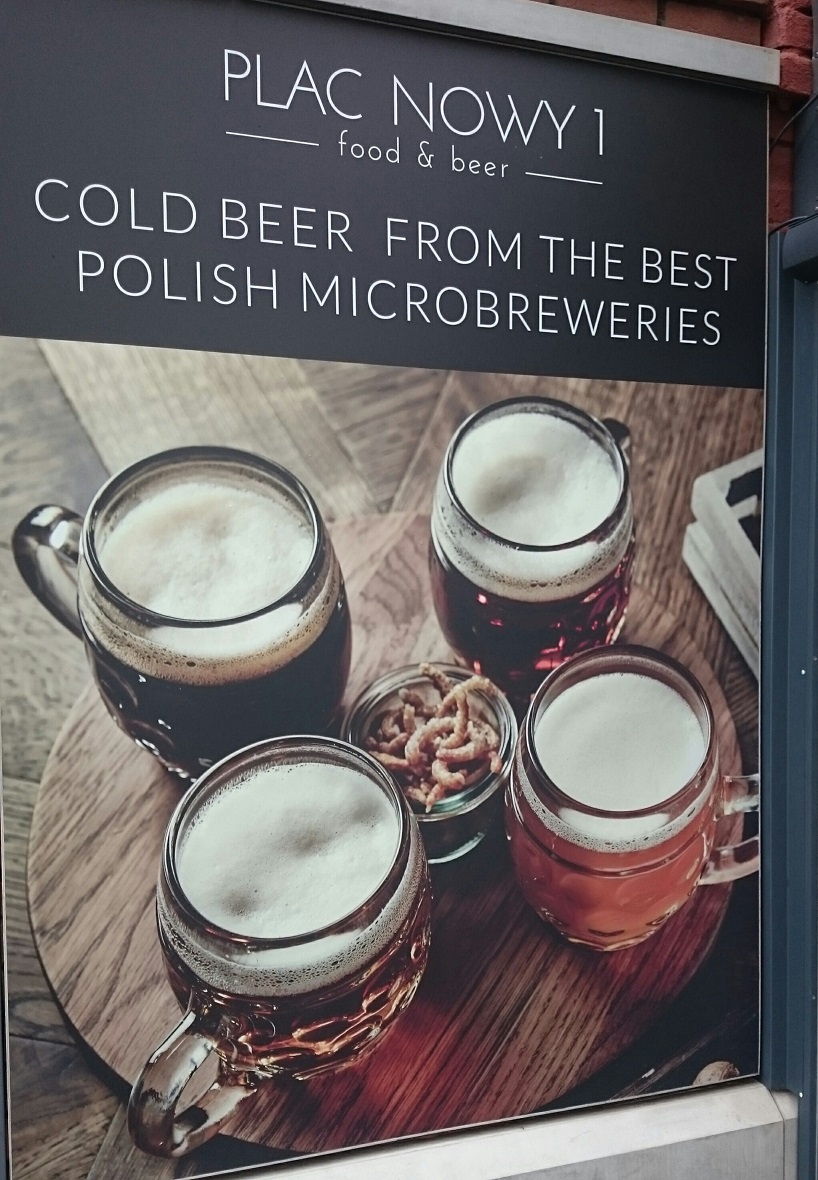 Boutique breweries thrive in Krakow[/caption]
Though Krakow is overwhelmingly a Catholic city (Pope John Paul 2 hailed from Krakow. He was the city’s Cardinal Karol Jozef Wotyla until attaining the papacy in 1978. His ongoing presence is strong in Krakow), its Jewish past remains strong, perhaps nowhere felt with more passion than in the newish Oskar Schindler Museum across the Vistula from the Old City.
[caption id="attachment_4012" align="alignnone" width="406"]
Boutique breweries thrive in Krakow[/caption]
Though Krakow is overwhelmingly a Catholic city (Pope John Paul 2 hailed from Krakow. He was the city’s Cardinal Karol Jozef Wotyla until attaining the papacy in 1978. His ongoing presence is strong in Krakow), its Jewish past remains strong, perhaps nowhere felt with more passion than in the newish Oskar Schindler Museum across the Vistula from the Old City.
[caption id="attachment_4012" align="alignnone" width="406"] Pope JP 2 regularly addressed crowds from this balcony[/caption]
Housed in the original Enamel Factory owned and run by Schindler, this is an obligatory attraction for all visitors to Krakow. Even if you haven’t read Thomas Keneally’s ‘Schindler’s Ark’ or seen Steven Spielberg’s film ‘Schindler’s List’, this museum will inform both the mind and heart.
[caption id="attachment_4013" align="alignnone" width="1112"]
Pope JP 2 regularly addressed crowds from this balcony[/caption]
Housed in the original Enamel Factory owned and run by Schindler, this is an obligatory attraction for all visitors to Krakow. Even if you haven’t read Thomas Keneally’s ‘Schindler’s Ark’ or seen Steven Spielberg’s film ‘Schindler’s List’, this museum will inform both the mind and heart.
[caption id="attachment_4013" align="alignnone" width="1112"]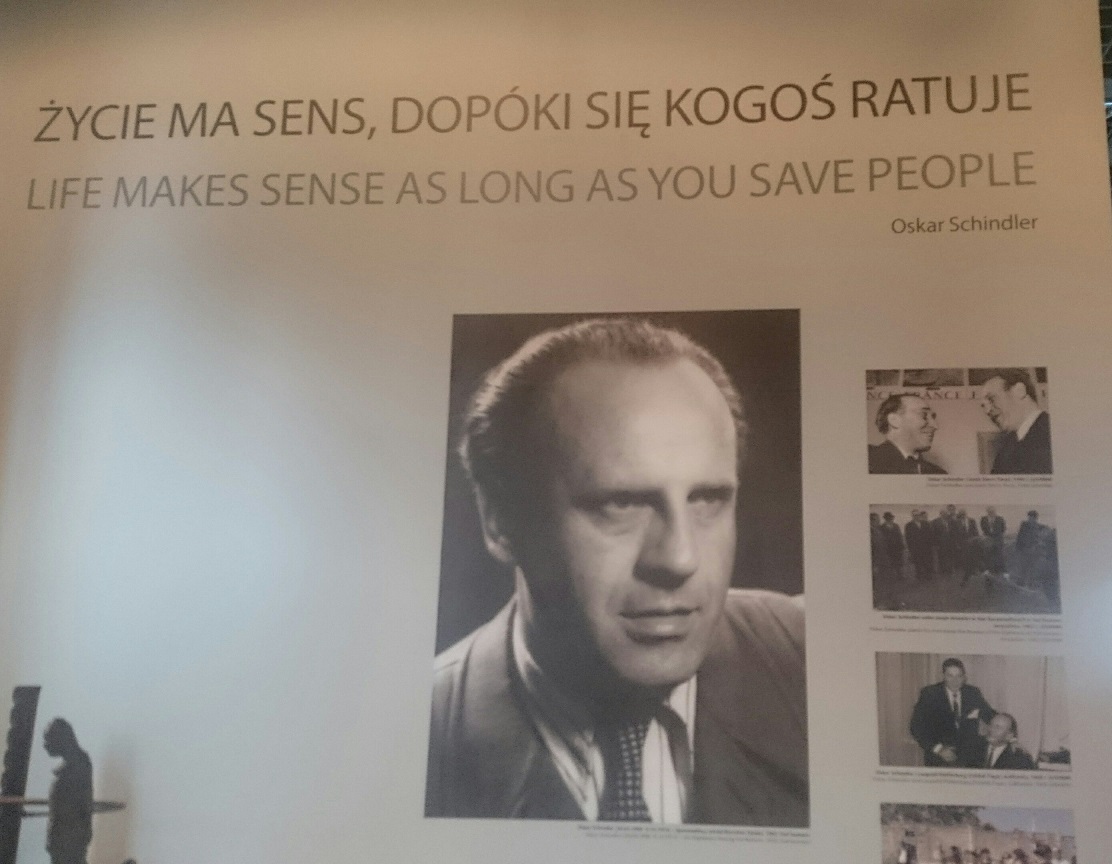 Oskar Schindler Museum[/caption]
Approximately 45 minutes’ drive west of Krakow are the twin camps run by the Germans during WW2: Auschwitz and Birkenau.
[caption id="attachment_4015" align="alignnone" width="1238"]
Oskar Schindler Museum[/caption]
Approximately 45 minutes’ drive west of Krakow are the twin camps run by the Germans during WW2: Auschwitz and Birkenau.
[caption id="attachment_4015" align="alignnone" width="1238"] Auschwitz Birkenau plaque[/caption]
The former was both a work (so-called concentration) camp and death factory, the latter operated solely as a death camp.
Guided visits are conducted daily. During busy summer months, booking in advance is recommended. Organised transport and a tour to both camps may be arranged in Krakow via numerous tour operators.
[caption id="attachment_4016" align="alignnone" width="1536"]
Auschwitz Birkenau plaque[/caption]
The former was both a work (so-called concentration) camp and death factory, the latter operated solely as a death camp.
Guided visits are conducted daily. During busy summer months, booking in advance is recommended. Organised transport and a tour to both camps may be arranged in Krakow via numerous tour operators.
[caption id="attachment_4016" align="alignnone" width="1536"] Visitors at Auschwitz[/caption]
Some 3 million visitors pay their respects here. To say it’s a humbling experience is wildly understated.
Everyone feels differently, some weep openly, some remain silent. I witnessed nervous laughter and occasional inappropriate behaviour, such as taking pictures despite signs indicating photography is prohibited.
My personal belief is that everyone should visit here, if only as a reminder of the depths to which human depravity and cruelty will sink. Its opposite, that hope prevails if we bear in mind hatred and intolerance are no solutions to imaginary problems based entirely on ignorance and fear, is a lesson humanity continues to learn.
[caption id="attachment_4017" align="alignnone" width="1281"]
Visitors at Auschwitz[/caption]
Some 3 million visitors pay their respects here. To say it’s a humbling experience is wildly understated.
Everyone feels differently, some weep openly, some remain silent. I witnessed nervous laughter and occasional inappropriate behaviour, such as taking pictures despite signs indicating photography is prohibited.
My personal belief is that everyone should visit here, if only as a reminder of the depths to which human depravity and cruelty will sink. Its opposite, that hope prevails if we bear in mind hatred and intolerance are no solutions to imaginary problems based entirely on ignorance and fear, is a lesson humanity continues to learn.
[caption id="attachment_4017" align="alignnone" width="1281"] Infamous Auschwitz sign[/caption]
With hand on heart I highly recommend a visit to Krakow and Auschwitz/Birkenau. There’s much to see in this region; I’ve only highlighted the obvious. Dig deeper and find rewards.
I’m already planning my next visit.
Naked Eats:
Poland’s dining scene is far better than I anticipated. Three Krakow restaurants impressed me in particular, all three in the Old City:
Miod Malina for its refreshing take on traditional Polish food.
www.miodmalina.pl
[caption id="attachment_4018" align="alignnone" width="1218"]
Infamous Auschwitz sign[/caption]
With hand on heart I highly recommend a visit to Krakow and Auschwitz/Birkenau. There’s much to see in this region; I’ve only highlighted the obvious. Dig deeper and find rewards.
I’m already planning my next visit.
Naked Eats:
Poland’s dining scene is far better than I anticipated. Three Krakow restaurants impressed me in particular, all three in the Old City:
Miod Malina for its refreshing take on traditional Polish food.
www.miodmalina.pl
[caption id="attachment_4018" align="alignnone" width="1218"]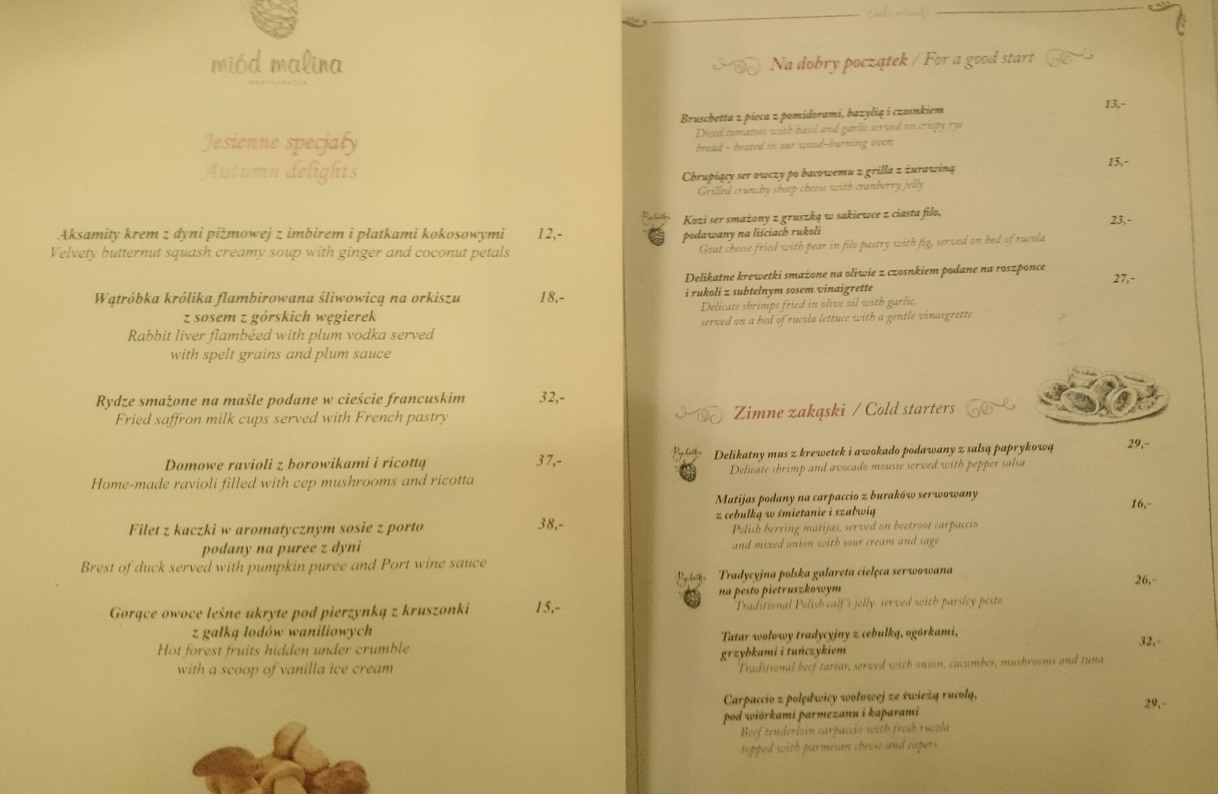 Miod Malina menu[/caption]
Wierzynek is a rambling historic restaurant (over 300 years serving the Polish elite) in the Main Square. Well prepared dishes focused on game and other local ingredients. Polished (pun intended) service is geared up for tourists. Try the Vodka flight.
www.wierzynek.pl
[caption id="attachment_4019" align="alignnone" width="202"]
Miod Malina menu[/caption]
Wierzynek is a rambling historic restaurant (over 300 years serving the Polish elite) in the Main Square. Well prepared dishes focused on game and other local ingredients. Polished (pun intended) service is geared up for tourists. Try the Vodka flight.
www.wierzynek.pl
[caption id="attachment_4019" align="alignnone" width="202"] Wierzynek sign[/caption]
[caption id="attachment_4020" align="alignnone" width="1536"]
Wierzynek sign[/caption]
[caption id="attachment_4020" align="alignnone" width="1536"]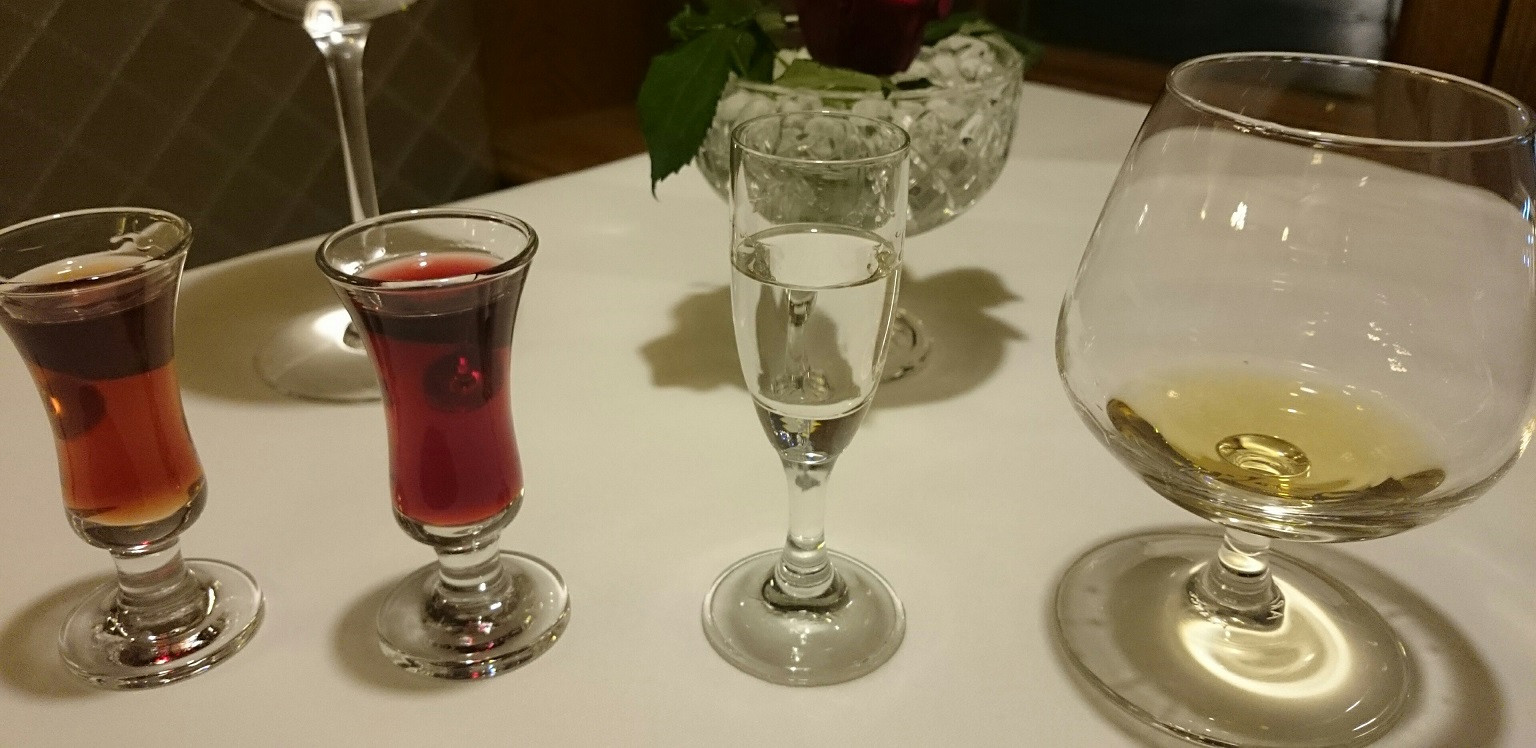 Wierzynek Vodka flight[/caption]
Albertina was my favourite. Service is friendly and informed. A terrific place to sample Poland’s surprising array of decent wines while chowing down on food cooked with a deftly light touch.
www.albertinarestaurant.pl
[caption id="attachment_4021" align="alignnone" width="594"]
Wierzynek Vodka flight[/caption]
Albertina was my favourite. Service is friendly and informed. A terrific place to sample Poland’s surprising array of decent wines while chowing down on food cooked with a deftly light touch.
www.albertinarestaurant.pl
[caption id="attachment_4021" align="alignnone" width="594"] Albertina crayfish bisque[/caption]
[caption id="attachment_4022" align="alignnone" width="202"]
Albertina crayfish bisque[/caption]
[caption id="attachment_4022" align="alignnone" width="202"]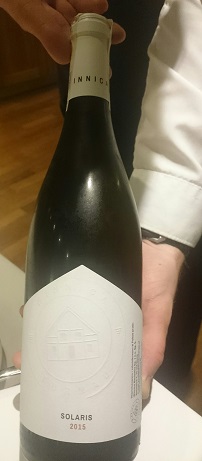 Polish wine at Albertina[/caption]
Naked Sleeps:
The modern Galaxy hotel may not be deluxe but it offers clean rooms, helpful employees and a warm welcome in a convenient location. Easy walking distance to the Oskar Schindler Museum, the Jewish Quarter and Old Town.
www.m.galaxyhotel.pl
Naked Tips:
A Krakow Card is handy for entry to most attractions, public transport included. See www.discovercracow.com
Also: www.krakow.pl/english and www.krakow-info.com
Tom Neal Tacker travelled to and visited Krakow as a guest of RailEurope (www.raileurope.com.au) and Krakow Tourist Board
Polish wine at Albertina[/caption]
Naked Sleeps:
The modern Galaxy hotel may not be deluxe but it offers clean rooms, helpful employees and a warm welcome in a convenient location. Easy walking distance to the Oskar Schindler Museum, the Jewish Quarter and Old Town.
www.m.galaxyhotel.pl
Naked Tips:
A Krakow Card is handy for entry to most attractions, public transport included. See www.discovercracow.com
Also: www.krakow.pl/english and www.krakow-info.com
Tom Neal Tacker travelled to and visited Krakow as a guest of RailEurope (www.raileurope.com.au) and Krakow Tourist Board  https://nakedhungrytraveller.com.au/family-travelling-travails/ Family Travelling Travails - Thanks for the Memories?The Grand Canyon was tantalisingly close. We’d been driving since early morning in a hot car, cramped with luggage. Back seat space was tight. My grandfather was driving and talking. ‘It’s the best way. Longer but better. The North Rim is higher, prettier views.’ He didn’t mention that it added an extra six hours drive time. When you’re thirteen, six hours is like being trapped forever in a time capsule. My grandmother sighed, passed a jug of iced water to my brother and me, which helped to relieve the discomfort of sticky vinyl covered seats and teenaged impatience. Late afternoon we pulled up to the grand old hotel’s carpark. Gramps turned off the engine, yelled to my brother and me, ‘C’mon, it’s just there through the lobby window, the grandest sight in America!’ Following his lead, we leapt from the car, slamming doors behind us. How to describe seeing the Grand Canyon for the first time? Stupendous is a start. Mind boggling. Long minutes of awe robbed us of speech until Gramps suddenly interrupted, ‘Where’s Grandma?’ In our haste to leave the car, we also left our grandmother behind. Gramps looked worried. ‘We’d better find her’ he added, stating the obvious in his initial guilt avoidance strategy. When our grandmother turned angry, a rare occurrence, hell would be paid and my grandfather kept a running account. Back to the carpark, no car, no Grandma. Knowing my grandmother’s anger management technique, it was entirely possible that she decided to leave her ‘boys’ high and dry without money or transport in an expensive hotel’s parking lot. For all we knew, she’d decided to drive to Scottsdale and a spa she mentioned earlier in the day. I share this account as an example of the hazards of family travel. Travels with my family have always been unusual. Losing someone featured often. Losing tempers was a given. Losing minds seemed inevitable. My mother always proved an amiable travelling companion as long as she refrained from flirting with waiters, doormen, flight attendants, fellow travellers, everyone else actually. Then our wanderings became more unusual than usual. In Thailand, the ever-polite Thais exclaimed, ‘She not your mother, she your sister!’ My mother’s vanity revelled in shedding twenty plus years at my expense. When one gushing bartender gleefully told me, ‘She not your mother, she your wife,’ I choked on my lychee Martini and begged my mother never to tell anyone about this. Within a week I was receiving emails from mutual acquaintances asking me how I liked travelling with my new wife. Travelling with my father normally involved pub crawls. Everything else was incidental. During a trip to San Antonio for an uncle’s 100th birthday party (the uncle passed away aged 99, three weeks before his centenary but the party wasn’t cancelled), he led me on a Best Margarita Bar Bust along the city’s picturesque River Walk. The San Antonio river is lined with Tex-Mex cantinas. My father was intent on visiting most of them. Alamo Shalamo. Why waste time at a historic site when a salt rimmed horizon beckoned? Lucky the river is shallow otherwise my father would have drowned. Weaving his way across another Venice-like footbridge he lost his footing and tipped in. When you stagger into a bar and without so much as a ‘Buenos Dias’ instruct the bartender to ‘Use that Tequila, that bottle of Cointreau and I want to see you squeeze the limes’ a dunking is the price to be paid. As the emotionally challenging holiday travel season approaches, spare a moment of compassion for those who have faced extended periods of public embarrassment for the sake of family experience. This would be me. During another extended family outing, hotel security was called. Apparently laughing loudly at 2am is unacceptable to other guests. When my 8 years old niece answered the door, I noticed the burly guard momentarily overlook her short stature, rightly expecting his banging on our suite door to be answered by an adult. His eyes widened. ‘We’ve had complaints,’ he said. ‘Which room?’ my brother countered. ‘Across the hall,’ he replied. ‘That would be our uncle then,’ my brother confirmed. ‘Would you all mind keeping your noise levels down please—some of your family apparently want to sleep.’ The following morning the hotel manager greeted us at breakfast with, ‘What time are you checking out?’ I thing other guests applauded but that may have been my headache banging around an empty skull. Travelling with family is challenging at the best of times. A word from the wise, go with the flow. You choose your friends but don’t choose your family. Accept that as fact. By the way, my grandmother had moved the car under the shade of a pine tree. ‘You should have seen the look on your faces,’ she laughed. ‘Thought you’d been left in a lurch didn’t you? Well, boys, don’t ever do me that way again and we’ll all just get along fine,’ she glared at my grandfather. The Grand Canyon’s magnificent impression never matched the one made on me that day. Keep your travelling companions close, your family travelling companions at safe travelling distance.
https://nakedhungrytraveller.com.au/family-travelling-travails/ Family Travelling Travails - Thanks for the Memories?The Grand Canyon was tantalisingly close. We’d been driving since early morning in a hot car, cramped with luggage. Back seat space was tight. My grandfather was driving and talking. ‘It’s the best way. Longer but better. The North Rim is higher, prettier views.’ He didn’t mention that it added an extra six hours drive time. When you’re thirteen, six hours is like being trapped forever in a time capsule. My grandmother sighed, passed a jug of iced water to my brother and me, which helped to relieve the discomfort of sticky vinyl covered seats and teenaged impatience. Late afternoon we pulled up to the grand old hotel’s carpark. Gramps turned off the engine, yelled to my brother and me, ‘C’mon, it’s just there through the lobby window, the grandest sight in America!’ Following his lead, we leapt from the car, slamming doors behind us. How to describe seeing the Grand Canyon for the first time? Stupendous is a start. Mind boggling. Long minutes of awe robbed us of speech until Gramps suddenly interrupted, ‘Where’s Grandma?’ In our haste to leave the car, we also left our grandmother behind. Gramps looked worried. ‘We’d better find her’ he added, stating the obvious in his initial guilt avoidance strategy. When our grandmother turned angry, a rare occurrence, hell would be paid and my grandfather kept a running account. Back to the carpark, no car, no Grandma. Knowing my grandmother’s anger management technique, it was entirely possible that she decided to leave her ‘boys’ high and dry without money or transport in an expensive hotel’s parking lot. For all we knew, she’d decided to drive to Scottsdale and a spa she mentioned earlier in the day. I share this account as an example of the hazards of family travel. Travels with my family have always been unusual. Losing someone featured often. Losing tempers was a given. Losing minds seemed inevitable. My mother always proved an amiable travelling companion as long as she refrained from flirting with waiters, doormen, flight attendants, fellow travellers, everyone else actually. Then our wanderings became more unusual than usual. In Thailand, the ever-polite Thais exclaimed, ‘She not your mother, she your sister!’ My mother’s vanity revelled in shedding twenty plus years at my expense. When one gushing bartender gleefully told me, ‘She not your mother, she your wife,’ I choked on my lychee Martini and begged my mother never to tell anyone about this. Within a week I was receiving emails from mutual acquaintances asking me how I liked travelling with my new wife. Travelling with my father normally involved pub crawls. Everything else was incidental. During a trip to San Antonio for an uncle’s 100th birthday party (the uncle passed away aged 99, three weeks before his centenary but the party wasn’t cancelled), he led me on a Best Margarita Bar Bust along the city’s picturesque River Walk. The San Antonio river is lined with Tex-Mex cantinas. My father was intent on visiting most of them. Alamo Shalamo. Why waste time at a historic site when a salt rimmed horizon beckoned? Lucky the river is shallow otherwise my father would have drowned. Weaving his way across another Venice-like footbridge he lost his footing and tipped in. When you stagger into a bar and without so much as a ‘Buenos Dias’ instruct the bartender to ‘Use that Tequila, that bottle of Cointreau and I want to see you squeeze the limes’ a dunking is the price to be paid. As the emotionally challenging holiday travel season approaches, spare a moment of compassion for those who have faced extended periods of public embarrassment for the sake of family experience. This would be me. During another extended family outing, hotel security was called. Apparently laughing loudly at 2am is unacceptable to other guests. When my 8 years old niece answered the door, I noticed the burly guard momentarily overlook her short stature, rightly expecting his banging on our suite door to be answered by an adult. His eyes widened. ‘We’ve had complaints,’ he said. ‘Which room?’ my brother countered. ‘Across the hall,’ he replied. ‘That would be our uncle then,’ my brother confirmed. ‘Would you all mind keeping your noise levels down please—some of your family apparently want to sleep.’ The following morning the hotel manager greeted us at breakfast with, ‘What time are you checking out?’ I thing other guests applauded but that may have been my headache banging around an empty skull. Travelling with family is challenging at the best of times. A word from the wise, go with the flow. You choose your friends but don’t choose your family. Accept that as fact. By the way, my grandmother had moved the car under the shade of a pine tree. ‘You should have seen the look on your faces,’ she laughed. ‘Thought you’d been left in a lurch didn’t you? Well, boys, don’t ever do me that way again and we’ll all just get along fine,’ she glared at my grandfather. The Grand Canyon’s magnificent impression never matched the one made on me that day. Keep your travelling companions close, your family travelling companions at safe travelling distance.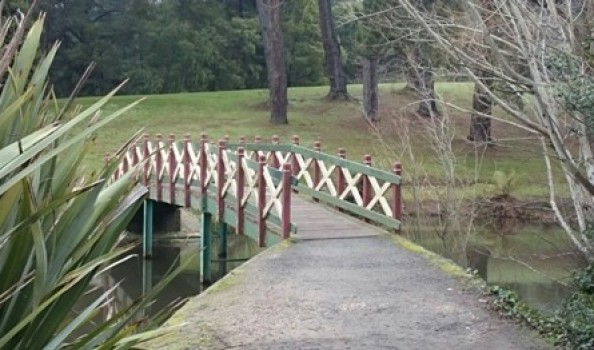 https://nakedhungrytraveller.com.au/making-the-most-of-the-macedon-ranges/ Making Most of the Macedon Ranges
https://nakedhungrytraveller.com.au/making-the-most-of-the-macedon-ranges/ Making Most of the Macedon RangesSome of Australia’s finest cool climate wines and best country restaurants are found here.
I like to eat and drink the good stuff. Who doesn't? Spreading over the high country from the northern fringes of Mount Macedon, east to Heathcote’s warmer climate and west to Daylesford’s wooded outskirts, the Macedon Ranges wine country is the pre-eminent cool country wine locale on the Australian mainland. Day-tripping visits or longer stays hold equal appeal. Exploring the pleasingly rural landscape dotted with cute country towns is to experience country Australia at its best. With Daylesford/Hepburn Springs serving as the region’s gourmet locus, visitors looking for a range of accommodation will be well catered for.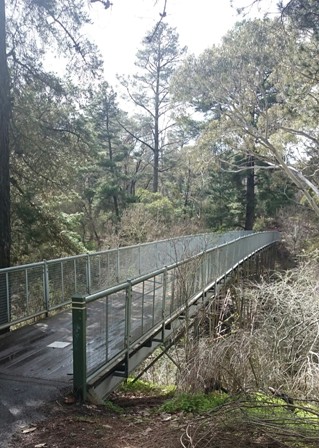 Footbridge into the bush at Hepburn Springs
Author Joan Lindsay’s fabulous novel, Picnic at Hanging Rock, which was made into a ground-breaking film by director Peter Weir in 1975, tells the story of four women lost forever in the labyrinth of Hanging Rock’s rocky slopes. An ancient volcanic plug, (a 'mamelon' in geological nomenclature from the French derived word mammary as the rounded shape resembles a nipple on a breast), the basalt behemoth dominates the plain immediately north of Mount Macedon.
Footbridge into the bush at Hepburn Springs
Author Joan Lindsay’s fabulous novel, Picnic at Hanging Rock, which was made into a ground-breaking film by director Peter Weir in 1975, tells the story of four women lost forever in the labyrinth of Hanging Rock’s rocky slopes. An ancient volcanic plug, (a 'mamelon' in geological nomenclature from the French derived word mammary as the rounded shape resembles a nipple on a breast), the basalt behemoth dominates the plain immediately north of Mount Macedon.
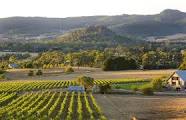
Hanging Rock vineyards
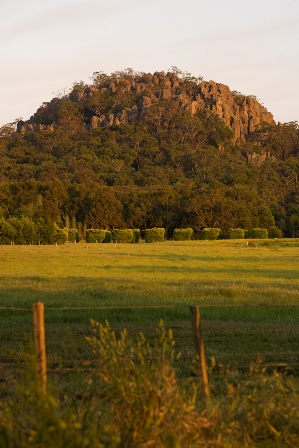
Hanging Rock
Hike to the summit for great views over the ancient volcanic landscape. Northeast is Mount William, famed by indigenous people throughout all of eastern Australia for the quality of its flint stones which were traded up and down country. Not a walker? A simple picnic at the rock’s base among the gum trees and watchful kookaburras accompanied by one of the local wines may prove a less strenuous option. Tables are scattered through the parklands next to the famous Hanging Rock racecourse.
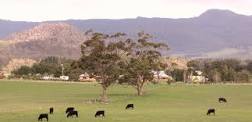 With thirty-four wineries currently in operation, visitors are treated to a broad array of wines. Be prepared to encounter vinous descriptions ranging from racy and austere to refined and rich (i.e. zesty bone dry or fruity full-bodied). Dominant grape varieties are: Pinot Noir, Chardonnay, Pinot Gris, Gewurtztraminer, Riesling and Shiraz. Scatterings of red Bordeaux varieties: Cabernet Sauvignon, Merlot, Petit Verdot and Cabernet Franc are sparsely planted in warmer lower areas. A Macedon Ranges’ defining geological feature, one of many that make this region unique, is its rich volcanic soil, clearly evident in the colour of the basalt rock formations that are part and parcel of the scenic beauty of the locale. Another is the altitude. All Macedon Ranges wineries are sited above 400 metres, the highest at 700 metres on the northern slopes of Mount Macedon itself.
John Ellis, the slightly grizzled though still dapper owner/operator of Hanging Rock Winery (www.hangingrock.com.au) has been instrumental in securing international fame for the region. He established his winery in 1983, grapes were planted in 1982. Always an eloquent spokesperson he says, ‘We weren’t the first however. Tom Lazar of Virgin Hills, who began making wines at his property in the 70s encouraged Gordon Knight at Knight’s Granite Hills and a few others to follow suit. There was a bit of a slump from the early 70s till the 80s but the region has been expanding ever since.’
Ellis served as Chairman of the Macedon Ranges Regional Tourism Association for many years, claiming, ‘What separates the Macedon Ranges from others is all of the wineries here are family owned. There are no multi-nationals.’ With further emphasis he explains, ‘We’re all small, different and individualistic. Our wines are basically limited editions.’
In 2002 the Macedon Ranges was granted formal Geographical Indication status. Its 650 hectares of wine producing land is one of Australia’s smallest recognised regions, a clear indication of its importance in comparison to larger areas of equal fame.
Though best known for its Pinot Noir and Chardonnay based sparkling wines, made in the same method as Champagne, wineries here produce many styles, from earthy and ethereal reds to both fragrant and full-bodied whites. Popping the cork on a bottle of prime Macedon fizz is to savour a rare treat.
But don’t forget to indulge in the region’s other notable wine styles.
With alternative varieties such as Lagrein, Sangiovese and Tempranillo as new cultivars, the region is expanding its horizons. Ellis elaborates, ‘One or two vineyards of Lagrein does not a regional specialty make however. Riesling is a superb variety here as are Pinot Noir and Chardonnay. Macedon Ranges’ Shiraz is interesting too, very peppery and spicy. We all continue to do the best we can in marginal conditions. It’s why Macedon Ranges’ wines are so special.’
Here’s a short list of my other favourite Macedon Ranges wineries.
Granite Hills (www.granitehills.com.au) produces superb Chardonnay, Pinot Noir and Shiraz but it’s really famous for successively outstanding vintages of Riesling. Owned and run by the Knight family since its founding in the late 70s, Granite Hills is one of Australia’s most consistent award winning wineries.
With thirty-four wineries currently in operation, visitors are treated to a broad array of wines. Be prepared to encounter vinous descriptions ranging from racy and austere to refined and rich (i.e. zesty bone dry or fruity full-bodied). Dominant grape varieties are: Pinot Noir, Chardonnay, Pinot Gris, Gewurtztraminer, Riesling and Shiraz. Scatterings of red Bordeaux varieties: Cabernet Sauvignon, Merlot, Petit Verdot and Cabernet Franc are sparsely planted in warmer lower areas. A Macedon Ranges’ defining geological feature, one of many that make this region unique, is its rich volcanic soil, clearly evident in the colour of the basalt rock formations that are part and parcel of the scenic beauty of the locale. Another is the altitude. All Macedon Ranges wineries are sited above 400 metres, the highest at 700 metres on the northern slopes of Mount Macedon itself.
John Ellis, the slightly grizzled though still dapper owner/operator of Hanging Rock Winery (www.hangingrock.com.au) has been instrumental in securing international fame for the region. He established his winery in 1983, grapes were planted in 1982. Always an eloquent spokesperson he says, ‘We weren’t the first however. Tom Lazar of Virgin Hills, who began making wines at his property in the 70s encouraged Gordon Knight at Knight’s Granite Hills and a few others to follow suit. There was a bit of a slump from the early 70s till the 80s but the region has been expanding ever since.’
Ellis served as Chairman of the Macedon Ranges Regional Tourism Association for many years, claiming, ‘What separates the Macedon Ranges from others is all of the wineries here are family owned. There are no multi-nationals.’ With further emphasis he explains, ‘We’re all small, different and individualistic. Our wines are basically limited editions.’
In 2002 the Macedon Ranges was granted formal Geographical Indication status. Its 650 hectares of wine producing land is one of Australia’s smallest recognised regions, a clear indication of its importance in comparison to larger areas of equal fame.
Though best known for its Pinot Noir and Chardonnay based sparkling wines, made in the same method as Champagne, wineries here produce many styles, from earthy and ethereal reds to both fragrant and full-bodied whites. Popping the cork on a bottle of prime Macedon fizz is to savour a rare treat.
But don’t forget to indulge in the region’s other notable wine styles.
With alternative varieties such as Lagrein, Sangiovese and Tempranillo as new cultivars, the region is expanding its horizons. Ellis elaborates, ‘One or two vineyards of Lagrein does not a regional specialty make however. Riesling is a superb variety here as are Pinot Noir and Chardonnay. Macedon Ranges’ Shiraz is interesting too, very peppery and spicy. We all continue to do the best we can in marginal conditions. It’s why Macedon Ranges’ wines are so special.’
Here’s a short list of my other favourite Macedon Ranges wineries.
Granite Hills (www.granitehills.com.au) produces superb Chardonnay, Pinot Noir and Shiraz but it’s really famous for successively outstanding vintages of Riesling. Owned and run by the Knight family since its founding in the late 70s, Granite Hills is one of Australia’s most consistent award winning wineries.
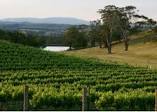
Also top-notch is Curly Flat (www.curlyflat.com), whose Chardonnay and Pinot Noir wines continually rank amongst the finest in the country.

Cobaw Ridge (www.cobawridge.com.au) is really off the beaten track. Here Shiraz and Lagrein grapes are kings of the castle. Cobaw Ridge specialises in long lived wines, full of character and finesse.
Zig Zag Road Winery (www.zigzagwines.com.au), for its prize-winning Riesling and Cabernet Sauvignon completes my current shortlist.
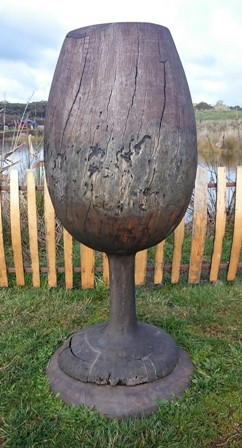 Outside Musk near Daylesford, is the Leith family’s Passing Clouds Winery. Top quality Pinot Noir, Chardonnay and Cabernet Shiraz blends have put this small vineyard on the map of renown for over thirty years. (www.passingclouds.com.au) Recently opened, the ‘cellar door dining room’ restaurant is drawing in happy local crowds with delicious food cooked by the exceptionally talented David Willcocks, (formerly of The Argus Dining Room). The restaurant is open weekends only. Like all superlative dining spots in this popular region, be wise and book ahead.
Outside Musk near Daylesford, is the Leith family’s Passing Clouds Winery. Top quality Pinot Noir, Chardonnay and Cabernet Shiraz blends have put this small vineyard on the map of renown for over thirty years. (www.passingclouds.com.au) Recently opened, the ‘cellar door dining room’ restaurant is drawing in happy local crowds with delicious food cooked by the exceptionally talented David Willcocks, (formerly of The Argus Dining Room). The restaurant is open weekends only. Like all superlative dining spots in this popular region, be wise and book ahead.
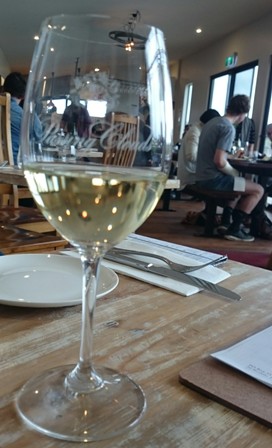
Thirty-four wineries are listed as members of the Macedon Ranges Vigneron’s Association. Their website (www.macedonrangeswine.com.au) is a useful tool when discovering this district as many wineries are open to the public by appointment only. A number of boutique guesthouses are listed in addition to other dining options I've not mentioned below.
West of Mount Macedon is a scattering of small villages and two large towns: Kyneton and Daylesford. Their relative close proximity to Melbourne attracts tree-changers, folks bent on escaping the trials of the big city for a more relaxed back-to-nature country lifestyle. That many end up working harder than they ever did in the city should surprise no one toiling in the hospitality industry. Similarly, running a successful farm or small business in country areas isn’t quite the doddle some naive people may believe.

Drawing in permanent residents and visitors alike is the region’s sophisticated food scene.
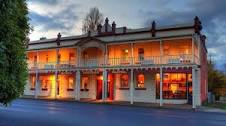
 Kyneton boasts a few outstanding restaurants in its unofficial ‘Eat Street’, Piper St: Source Dining (www.sourcedining.com.au) which was formerly Annie Smither’s Bistro, Mr Carsisi (www.mrcarsisi.com), and the Royal George Hotel (www.royalgeorge.com.au) are each excellent examples of country dining at its best. The good value Dhaba at The Mill (www.dhaba.com.au), also in Piper St, does authentic curries with house made Indian breads.
Kyneton boasts a few outstanding restaurants in its unofficial ‘Eat Street’, Piper St: Source Dining (www.sourcedining.com.au) which was formerly Annie Smither’s Bistro, Mr Carsisi (www.mrcarsisi.com), and the Royal George Hotel (www.royalgeorge.com.au) are each excellent examples of country dining at its best. The good value Dhaba at The Mill (www.dhaba.com.au), also in Piper St, does authentic curries with house made Indian breads.
 Daylesford’s cutting edge restaurants start me salivating as soon as I make a reservation to dine: the Lake House (www.lakehouse.com.au), Kazuki’s (www.kazukis.com.au) and Mercato @ Daylesford (www.mercatorestaurant.com.au) The Perfect Drop (www.theperfectdrop.com) and Sault Restaurant on Daylesford’s southern outskirts (www.sault.com.au) vie for top honours.
Daylesford’s cutting edge restaurants start me salivating as soon as I make a reservation to dine: the Lake House (www.lakehouse.com.au), Kazuki’s (www.kazukis.com.au) and Mercato @ Daylesford (www.mercatorestaurant.com.au) The Perfect Drop (www.theperfectdrop.com) and Sault Restaurant on Daylesford’s southern outskirts (www.sault.com.au) vie for top honours.
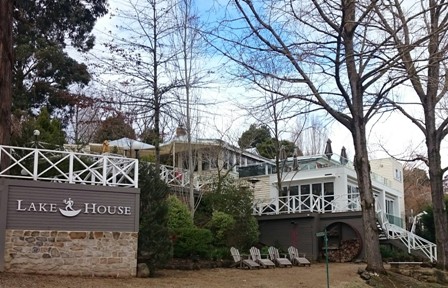
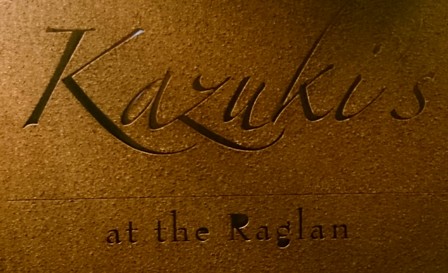 One of Victoria’s best country pubs, the Farmer’s Arms (www.farmersarmsdaylesford.com.au) is another local favourite. Run like I want to see all Australian country pubs operate; always friendly, always reliable and always great eating (and drinking).
One of Victoria’s best country pubs, the Farmer’s Arms (www.farmersarmsdaylesford.com.au) is another local favourite. Run like I want to see all Australian country pubs operate; always friendly, always reliable and always great eating (and drinking).
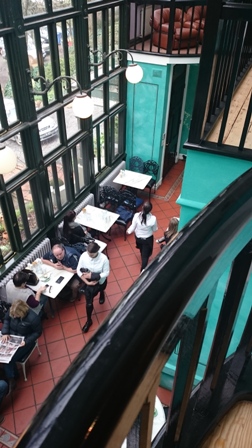 Convent Gallery cafe
The Convent Cafe and Gallery (www.conventgallery.com.au) near the top of Wombat Hill (don’t miss the Wombat Hill Botanical Gardens for its splendid Victorian era collection of rare trees; the views overlooking surrounding countryside are damned fine as well) is still rocking a terrific high tea—book in advance. The old convent was converted to an art gallery years ago. Changing exhibitions make it a must-see whenever you’re dawdling around Daylesford.
Convent Gallery cafe
The Convent Cafe and Gallery (www.conventgallery.com.au) near the top of Wombat Hill (don’t miss the Wombat Hill Botanical Gardens for its splendid Victorian era collection of rare trees; the views overlooking surrounding countryside are damned fine as well) is still rocking a terrific high tea—book in advance. The old convent was converted to an art gallery years ago. Changing exhibitions make it a must-see whenever you’re dawdling around Daylesford.

 In Vincent St is the Wine Shop and Bar, (owned and run 7 days a week from 10am by Owen Latta of the same family that also owns the consistently marvellous Eastern Peake Winery north of Ballarat www.easternpeake.com.au), serving many local wines by the glass unavailable for tasting elsewhere. A small menu of homemade tapas style dishes compliments the wine selection. (www.wineandthecountry.com.au)
In Vincent St is the Wine Shop and Bar, (owned and run 7 days a week from 10am by Owen Latta of the same family that also owns the consistently marvellous Eastern Peake Winery north of Ballarat www.easternpeake.com.au), serving many local wines by the glass unavailable for tasting elsewhere. A small menu of homemade tapas style dishes compliments the wine selection. (www.wineandthecountry.com.au)
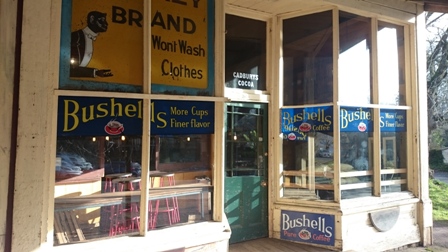 In Raglan St near Mercato @ Daylesford is Cliffy’s Emporium, a neat little shop packed with delicious locally made goods and fresh organic produce. A cafe here also does terrific lunches. (www.cliffysemporium.com.au)
[caption id="attachment_3900" align="alignnone" width="385"]
In Raglan St near Mercato @ Daylesford is Cliffy’s Emporium, a neat little shop packed with delicious locally made goods and fresh organic produce. A cafe here also does terrific lunches. (www.cliffysemporium.com.au)
[caption id="attachment_3900" align="alignnone" width="385"] Lake Daylesford in the mist[/caption]
On the shores of lovely Lake Daylesford are two wonderful cafes: The Boathouse, run by the same dynamic two ladies formerly of the Farmers Arms pub, is serving excellent lunches in a relaxed setting (www.boathousedaylesford.com.au) and the utterly charming 2nd hand bookstore cum cafe The Book Barn @ Daylesford (www.bookbarndaylesford.com).
Lake Daylesford in the mist[/caption]
On the shores of lovely Lake Daylesford are two wonderful cafes: The Boathouse, run by the same dynamic two ladies formerly of the Farmers Arms pub, is serving excellent lunches in a relaxed setting (www.boathousedaylesford.com.au) and the utterly charming 2nd hand bookstore cum cafe The Book Barn @ Daylesford (www.bookbarndaylesford.com).
 How lucky Daylesford is to have a lake as captivating and beautiful as this on its doorstep. Walking its circumference takes approximately two hours gentle strolling. Misty winter mornings strike a picturesque contrast to summer’s clear sunny days.
How lucky Daylesford is to have a lake as captivating and beautiful as this on its doorstep. Walking its circumference takes approximately two hours gentle strolling. Misty winter mornings strike a picturesque contrast to summer’s clear sunny days.
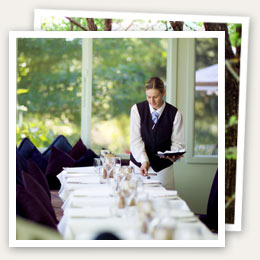 Of course, the esteemed Lake House restaurant and suites is already a legend in its own lifetime. When Alla and Allan Wolf-Tasker turned a run down cafe on the shores of a forgotten lake into one of the state’s premier dining destinations, they set in train a revolution in taste that all Daylesford now comprehensively enjoys. Alla Wolf-Tasker once told me that, ‘the locals thought we were crazy when we began planting trees on the barren site as they’d spent years pulling them all out.’ Theirs was a task not only consumed by hard physical labour but also one of convincing conservative locals that good food and wine could change hearts and minds too. More than thirty years later, the battle has been won, thanks largely to Alla and Allan Wolf-Tasker’s dedication to excellence.
Kazuki Tsuya worked as a sous-chef at the Lake House, proving that great training comes full circle. I find it delightful that one of Daylesford’s most interesting restaurants is owned and run by an ex-Lake House employee, further proof that Daylesford has come into its own as a food town given that with Tsuya’s background and experience he could have chosen to work anywhere. Instead he chose to remain local. Well done. Kazuki’s restaurant has raised the dining bar even higher in this food obsessed highland town.
Mercato is another lovely dining affair. With owner/chef Richard Mee heading the kitchen, deft hands craft local produce into sensational dishes, particularly adept with meats. Carnivores will be well sated. This little shop front fine diner is always a winner with locals and visitors alike.
Just up the road from Daylesford is tiny Hepburn Springs. Here is where tourism landed on wet feet. Back in the late 19th and early 20th centuries, most visitors ‘took the waters’ while seeking cures for ailments from gout to asthma by soaking in the region’s mineral-dense spring water. The public baths were renovated in 2014 but one hotel, the Peppers Mineral Springs Retreat, is the best place to see what the fuss was all about. (www.pepperssprings.com.au or www.theargusdiningroom.com.au)
Owners Wayne Cross and Chris Malden have done a superlative job in refashioning this Art Deco palace into a contemporary and swish boutique hotel. The newly outfitted spa is quite simply stunning. The usual range of treatments is available but here authenticity is the key to success. Hepburn Springs’ waters haven’t changed; it’s still aglow with health giving qualities, which the Mineral Springs Retreat makes excellent use of.
Of course, the esteemed Lake House restaurant and suites is already a legend in its own lifetime. When Alla and Allan Wolf-Tasker turned a run down cafe on the shores of a forgotten lake into one of the state’s premier dining destinations, they set in train a revolution in taste that all Daylesford now comprehensively enjoys. Alla Wolf-Tasker once told me that, ‘the locals thought we were crazy when we began planting trees on the barren site as they’d spent years pulling them all out.’ Theirs was a task not only consumed by hard physical labour but also one of convincing conservative locals that good food and wine could change hearts and minds too. More than thirty years later, the battle has been won, thanks largely to Alla and Allan Wolf-Tasker’s dedication to excellence.
Kazuki Tsuya worked as a sous-chef at the Lake House, proving that great training comes full circle. I find it delightful that one of Daylesford’s most interesting restaurants is owned and run by an ex-Lake House employee, further proof that Daylesford has come into its own as a food town given that with Tsuya’s background and experience he could have chosen to work anywhere. Instead he chose to remain local. Well done. Kazuki’s restaurant has raised the dining bar even higher in this food obsessed highland town.
Mercato is another lovely dining affair. With owner/chef Richard Mee heading the kitchen, deft hands craft local produce into sensational dishes, particularly adept with meats. Carnivores will be well sated. This little shop front fine diner is always a winner with locals and visitors alike.
Just up the road from Daylesford is tiny Hepburn Springs. Here is where tourism landed on wet feet. Back in the late 19th and early 20th centuries, most visitors ‘took the waters’ while seeking cures for ailments from gout to asthma by soaking in the region’s mineral-dense spring water. The public baths were renovated in 2014 but one hotel, the Peppers Mineral Springs Retreat, is the best place to see what the fuss was all about. (www.pepperssprings.com.au or www.theargusdiningroom.com.au)
Owners Wayne Cross and Chris Malden have done a superlative job in refashioning this Art Deco palace into a contemporary and swish boutique hotel. The newly outfitted spa is quite simply stunning. The usual range of treatments is available but here authenticity is the key to success. Hepburn Springs’ waters haven’t changed; it’s still aglow with health giving qualities, which the Mineral Springs Retreat makes excellent use of.
 I loved my floating ‘soft pak float bed’ water bed treatment for instance. Cross and Malden bought two of these nifty German made contraptions for their spa, (the only two in Australia I’m told). They’re water beds but you don’t actually get wet. Imagine being rubbed down in the nicest way possible with an aromatised oil of your choice, then plastered with healing ointments, then wrapped cocoon like in warm fluffy towels and then gradually and ever so sweetly settled down into an all enveloping water bed that wraps round you like a lover you never want to let go. After a long nap (sleep is inevitable under these foetal like conditions), I was gently awoken, sponged off and moisturised again. Feeling like a freshly minted fortune, I was then truly ready to tackle any possible stress inducing situation that may come my way. Luckily none did.
I loved my floating ‘soft pak float bed’ water bed treatment for instance. Cross and Malden bought two of these nifty German made contraptions for their spa, (the only two in Australia I’m told). They’re water beds but you don’t actually get wet. Imagine being rubbed down in the nicest way possible with an aromatised oil of your choice, then plastered with healing ointments, then wrapped cocoon like in warm fluffy towels and then gradually and ever so sweetly settled down into an all enveloping water bed that wraps round you like a lover you never want to let go. After a long nap (sleep is inevitable under these foetal like conditions), I was gently awoken, sponged off and moisturised again. Feeling like a freshly minted fortune, I was then truly ready to tackle any possible stress inducing situation that may come my way. Luckily none did.
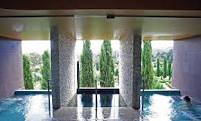 The refurbished The Argus Dining Room offers an interesting menu, a bit on the pricey side considering portion size but the chefs show flair and imaginative use of local ingredients. Banish all memories of execrable hotel food. Embrace instead the refreshing notion that hotel food can be pace-setting and inspiring. The wine list under sommelier/restaurant manager Jeremy Shiell is a compendium of booze I like to drink.
Also in Hepburn Springs is the newish Surly Goat (owned by a couple who ran the Farmers Arms pub; a wellspring of talent), where authentic hospitality rules and where Chef Sean Marshall is cooking the kind of food I expect to eat at a metropolitan foodie pilgrimage place. In a word, wow! (www.thesurlygoat.com.au)
The refurbished The Argus Dining Room offers an interesting menu, a bit on the pricey side considering portion size but the chefs show flair and imaginative use of local ingredients. Banish all memories of execrable hotel food. Embrace instead the refreshing notion that hotel food can be pace-setting and inspiring. The wine list under sommelier/restaurant manager Jeremy Shiell is a compendium of booze I like to drink.
Also in Hepburn Springs is the newish Surly Goat (owned by a couple who ran the Farmers Arms pub; a wellspring of talent), where authentic hospitality rules and where Chef Sean Marshall is cooking the kind of food I expect to eat at a metropolitan foodie pilgrimage place. In a word, wow! (www.thesurlygoat.com.au)
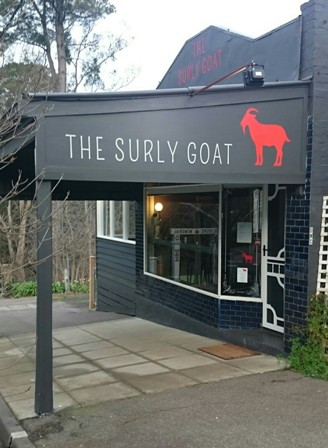 Just around the corner from the Surly Goat is Frank and Connie’s Kitchen, a lovely restaurant where quality is king, service down home friendly and the cooking is inspired Mod Oz without fuss. (www.frankandconnies.com.au)
Just around the corner from the Surly Goat is Frank and Connie’s Kitchen, a lovely restaurant where quality is king, service down home friendly and the cooking is inspired Mod Oz without fuss. (www.frankandconnies.com.au)
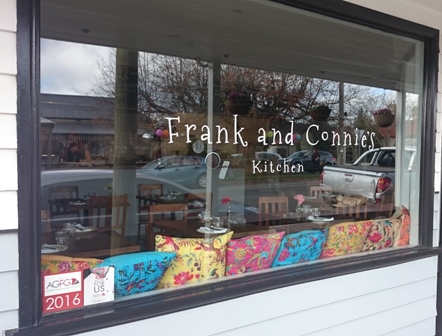 Across the road from Frank and Connie’s is the not-to-be-missed funky shop Portal 108. Shopping here is pure joy. (www.portal108.com.au)
The old Hepburn Springs hot springs centre was strikingly renovated in 2014 and now offers a variety of day packages and self-contained upscale accommodation. The unique slightly carbonated waters (high in calcium, silica and rare trace minerals) have been boosting health for over a century. When gold fever was at its pitch, the springs were nearly run dry as a result excessive digging and drilling in pursuit of gold. Concerted efforts by devoted fans saved the springs from ultimate dried-up disaster, thereby turning a tiny mining camp into Australia’s preeminent natural springs’ town. (See www.hepburnbathhouse.com)
[caption id="attachment_3930" align="alignnone" width="448"]
Across the road from Frank and Connie’s is the not-to-be-missed funky shop Portal 108. Shopping here is pure joy. (www.portal108.com.au)
The old Hepburn Springs hot springs centre was strikingly renovated in 2014 and now offers a variety of day packages and self-contained upscale accommodation. The unique slightly carbonated waters (high in calcium, silica and rare trace minerals) have been boosting health for over a century. When gold fever was at its pitch, the springs were nearly run dry as a result excessive digging and drilling in pursuit of gold. Concerted efforts by devoted fans saved the springs from ultimate dried-up disaster, thereby turning a tiny mining camp into Australia’s preeminent natural springs’ town. (See www.hepburnbathhouse.com)
[caption id="attachment_3930" align="alignnone" width="448"]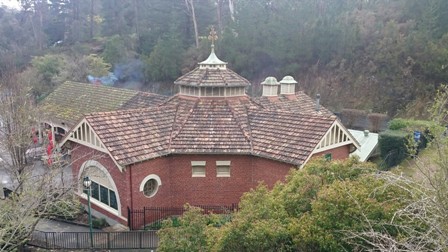 Hepburn Springs cafe pavilion, a caffeine blast from the past[/caption]
Hepburn Springs cafe pavilion, a caffeine blast from the past[/caption]
 Mineral water scones are the go in local cafes
[caption id="attachment_2516" align="alignnone" width="335"]
Mineral water scones are the go in local cafes
[caption id="attachment_2516" align="alignnone" width="335"]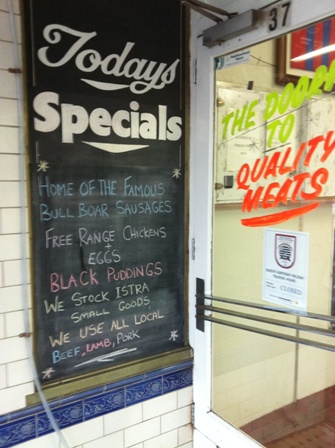 Daylesford butcher shop window, fresh is best![/caption]
Between Daylesford and Trentham is tiny Lyonville, a simple one-pub town, where the Radio Springs Hotel is the centre of the universe. Weekend lunches are justifiably popular. Book ahead or don’t get in. (www.radiospringshotel.com.au)
Daylesford butcher shop window, fresh is best![/caption]
Between Daylesford and Trentham is tiny Lyonville, a simple one-pub town, where the Radio Springs Hotel is the centre of the universe. Weekend lunches are justifiably popular. Book ahead or don’t get in. (www.radiospringshotel.com.au)
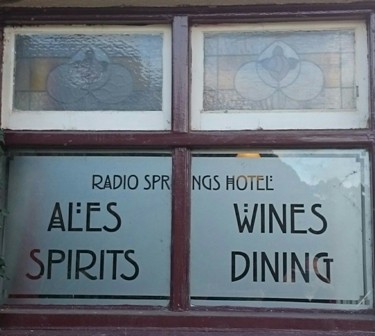
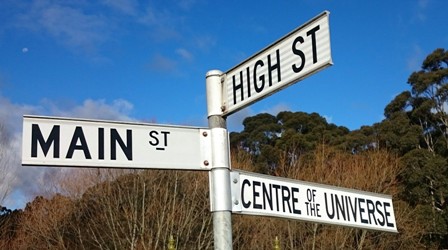
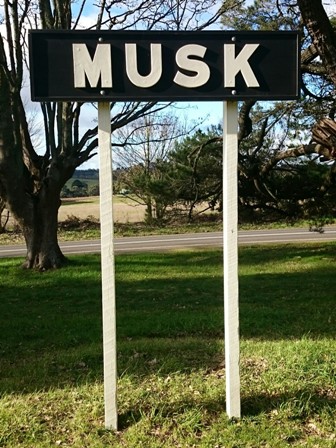 Over in Malmsbury is the tiny and funky Small Holdings open kitchen bistro. There’s no menu but who cares? The food is rustic, unpretentious but authentically good. Using local produce wherever possible, the team here espouses ‘paddock to plate’ ethos and the customer is the beneficiary. Let them cook for you. You’ll be happy they do. (www.smallholdings.com.au)
Over in Malmsbury is the tiny and funky Small Holdings open kitchen bistro. There’s no menu but who cares? The food is rustic, unpretentious but authentically good. Using local produce wherever possible, the team here espouses ‘paddock to plate’ ethos and the customer is the beneficiary. Let them cook for you. You’ll be happy they do. (www.smallholdings.com.au)
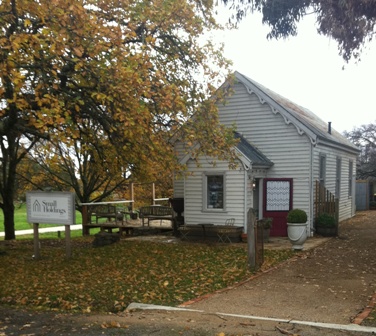 In Trentham, a lovely village well cared for by its tree-changing inhabitants, try Du Fermier (www.dufermier.com.au) owned and run by gardener chef extraordinaire Annie Smithers (she sold her eponymous Kyneton bistro to Tim Foster who has done a smashing job maintaining Smithers’ impeccably high standards while changing its name to Source Dining). Simple Frenchified food done to perfection is the go here. Open weekends only, this excellent bistro tends to book out completely weeks ahead; reserve well in advance for a table.
In Trentham, a lovely village well cared for by its tree-changing inhabitants, try Du Fermier (www.dufermier.com.au) owned and run by gardener chef extraordinaire Annie Smithers (she sold her eponymous Kyneton bistro to Tim Foster who has done a smashing job maintaining Smithers’ impeccably high standards while changing its name to Source Dining). Simple Frenchified food done to perfection is the go here. Open weekends only, this excellent bistro tends to book out completely weeks ahead; reserve well in advance for a table.
 Also in Trentham is the famous Red Beard Historic Bakery where hand-crafted sourdough breads of exceptional quality matched by addictive sweet treats are the rule. The cafe does a roaring weekend trade. Luckily it’s also open weekdays. (www.redbeardbakery.com.au)
Also in Trentham is the famous Red Beard Historic Bakery where hand-crafted sourdough breads of exceptional quality matched by addictive sweet treats are the rule. The cafe does a roaring weekend trade. Luckily it’s also open weekdays. (www.redbeardbakery.com.au)
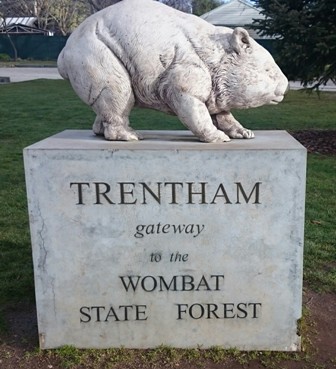 Near Trentham is the Wombat State Forest and Victoria’s highest waterfall, Trentham Falls. Plunging 32 metres over a sheer basalt cliff face, it’s almost hidden by dense temperate rain forest high up the Great Dividing Range, a sure surprise on first sight. Grab some picnic supplies (and wine of course) from the huge range of Macedon Ranges’ gourmet network of shops, purveyors or farmers’ markets. Spread a rug amongst the lush mossy bushland, relax over terrific food and wine and revel in the good life.
Near Trentham is the Wombat State Forest and Victoria’s highest waterfall, Trentham Falls. Plunging 32 metres over a sheer basalt cliff face, it’s almost hidden by dense temperate rain forest high up the Great Dividing Range, a sure surprise on first sight. Grab some picnic supplies (and wine of course) from the huge range of Macedon Ranges’ gourmet network of shops, purveyors or farmers’ markets. Spread a rug amongst the lush mossy bushland, relax over terrific food and wine and revel in the good life.
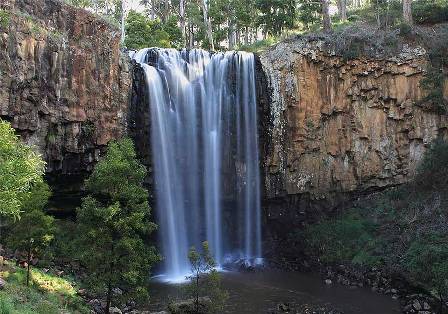 Rural Australia rarely gets better than this.
Tom Neal Tacker travelled courtesy of Macedon Ranges Regional Tourism Association.
Naked Tips
Don’t miss the Macedon Ranges’ wine lovers annual Budburst Festival held mid-November. www.budburst.com
Australia’s largest regional celebration of diversity is Daylesford and Hepburn Springs’ annual ChillOut Festival which takes place each Labour Day weekend in March. Running successfully with lovable enthusiasm since 1997, this festival draws in huge crowds from all over Victoria, Australia and beyond. Accommodation is booked out well in advance so plan ahead. All of Daylesford and Hepburn Springs becomes party-ville. It’s a family friendly, pet friendly all-inclusive event, an excellent path to engaging with local residents. (www.chilloutfestival.com.au)
Rural Australia rarely gets better than this.
Tom Neal Tacker travelled courtesy of Macedon Ranges Regional Tourism Association.
Naked Tips
Don’t miss the Macedon Ranges’ wine lovers annual Budburst Festival held mid-November. www.budburst.com
Australia’s largest regional celebration of diversity is Daylesford and Hepburn Springs’ annual ChillOut Festival which takes place each Labour Day weekend in March. Running successfully with lovable enthusiasm since 1997, this festival draws in huge crowds from all over Victoria, Australia and beyond. Accommodation is booked out well in advance so plan ahead. All of Daylesford and Hepburn Springs becomes party-ville. It’s a family friendly, pet friendly all-inclusive event, an excellent path to engaging with local residents. (www.chilloutfestival.com.au)
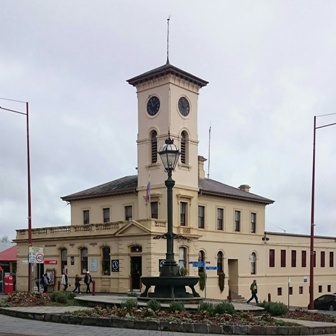
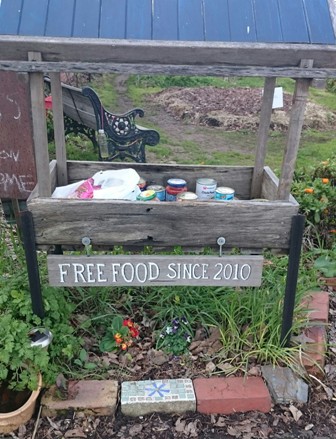 Naked Routes:
The Macedon Ranges is within very easy reach of Melbourne. Less than two hours drive from the city’s CBD will bring visitors to Daylesford or Kyneton. Alternatively, Kyneton is on the main train line from Melbourne north to Bendigo with frequent daily services.
Naked Sleeps:
Peppers Mineral Springs Hotel in Hepburn Springs is a wonderfully run boutique hotel. The Art Deco main building has been tastefully renovated while the newer suites in the capacious gardens boast spa baths. A few suites also sport their own balcony spas with calming garden views. (www.mineralspringshotel.com.au)
[caption id="attachment_3915" align="alignnone" width="435"]
Naked Routes:
The Macedon Ranges is within very easy reach of Melbourne. Less than two hours drive from the city’s CBD will bring visitors to Daylesford or Kyneton. Alternatively, Kyneton is on the main train line from Melbourne north to Bendigo with frequent daily services.
Naked Sleeps:
Peppers Mineral Springs Hotel in Hepburn Springs is a wonderfully run boutique hotel. The Art Deco main building has been tastefully renovated while the newer suites in the capacious gardens boast spa baths. A few suites also sport their own balcony spas with calming garden views. (www.mineralspringshotel.com.au)
[caption id="attachment_3915" align="alignnone" width="435"] Peppers Hepburn Springs entrance[/caption]
The historic 1930s era Grande Hotel in Hepburn Springs has a terrific cabaret venue, good restaurant and well appointed refurbished rooms full of character. The back deck overlooking dense forest is a launching pad to dreamland. (www.thegrandehotel.com.au)
[caption id="attachment_3916" align="alignnone" width="448"]
Peppers Hepburn Springs entrance[/caption]
The historic 1930s era Grande Hotel in Hepburn Springs has a terrific cabaret venue, good restaurant and well appointed refurbished rooms full of character. The back deck overlooking dense forest is a launching pad to dreamland. (www.thegrandehotel.com.au)
[caption id="attachment_3916" align="alignnone" width="448"]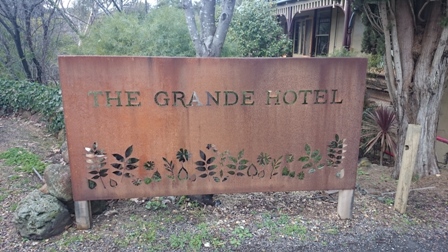 The Grande Hotel sign[/caption]
Also in Hepburn Springs is Victoria’s only Small Luxury Hotel member The Dudley. Immaculately maintained, this lovingly restored guest house is sheer perfection. Breakfasts are memorable. Service is flawless. (www.thedudley.com.au)
The Grande Hotel sign[/caption]
Also in Hepburn Springs is Victoria’s only Small Luxury Hotel member The Dudley. Immaculately maintained, this lovingly restored guest house is sheer perfection. Breakfasts are memorable. Service is flawless. (www.thedudley.com.au)
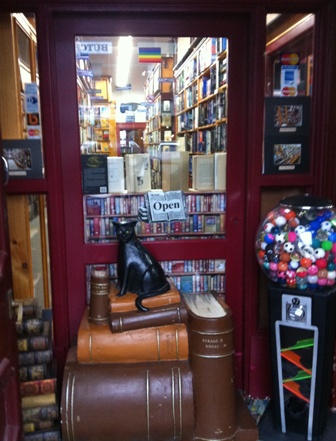 [caption id="attachment_3917" align="alignnone" width="287"]
[caption id="attachment_3917" align="alignnone" width="287"] Wombat Hill Botanical Gardens Daylesford 'Boy with a Thorn' statue[/caption]
Wombat Hill Botanical Gardens Daylesford 'Boy with a Thorn' statue[/caption]

 https://nakedhungrytraveller.com.au/tokyo-temptations/ Tokyo Temptations
https://nakedhungrytraveller.com.au/tokyo-temptations/ Tokyo TemptationsSuch a puzzle!
Tokyo is a multitude of colourful pieces spread across the Kanto plain waiting to be assembled. A tricky task for sure. Like all the world’s massive conurbations, Tokyo is almost unfathomably challenging to grasp as a single entity. Best approach is to pick a neighbourhood, stay a while and get to know it. Gradually a semblance of order will appear; streets, shops and people become familiar. I chose Asakusa because it’s one of Tokyo’s original villages, a bit like New York’s Greenwich Village or London’s Soho, mostly low-rise comprising neighbourhoods of narrow laneways near the Senso-ji temple, Tokyo’s oldest (completed in 645AD to honour Kannon, the goddess of mercy). [caption id="attachment_3942" align="alignnone" width="744"]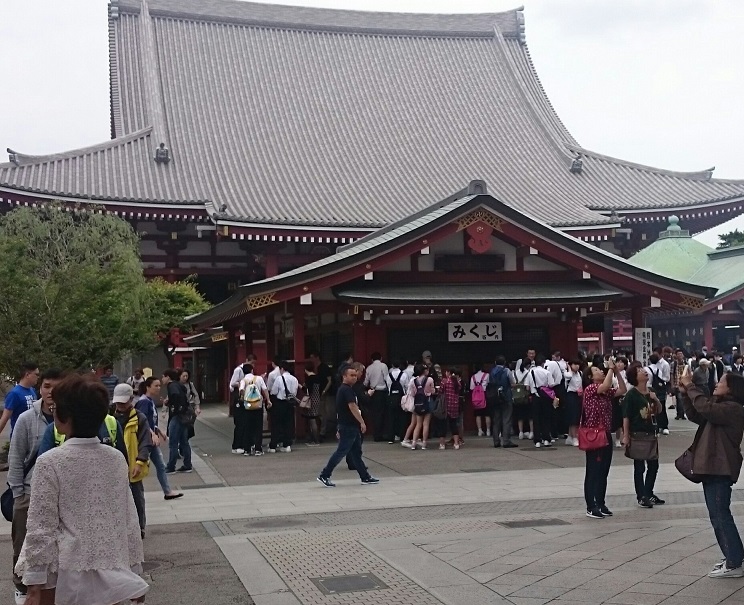 Senso-ji main temple[/caption]
It’s a funky neighbourhood without being cutting edge, relaxed compared to crazy Shinjuku or Shibuya, a bit touristy but not overwhelmingly so.
[caption id="attachment_3944" align="alignnone" width="461"]
Senso-ji main temple[/caption]
It’s a funky neighbourhood without being cutting edge, relaxed compared to crazy Shinjuku or Shibuya, a bit touristy but not overwhelmingly so.
[caption id="attachment_3944" align="alignnone" width="461"]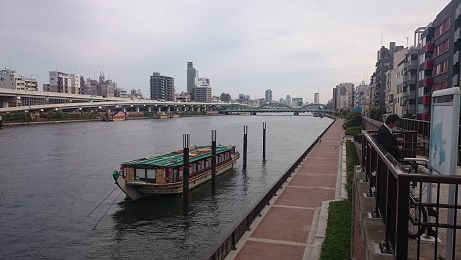 Sumida River Asakusa[/caption]
Straddled along the Sumida River and within walking distance to Ueno Park (Tokyo’s most popular art museums are here) and Kappa-Bashi dori (world’s largest cookware market, quite simply a foodie’s Nirvana), Asakusa is criss-crossed by two major subway lines (one going directly to the Ginza and Haneda Airport, the other heading out towards Narita Airport), it’s well located near major attractions while retaining some original character (as much as Tokyo can since the massive fire-bombing near the end of WW2).
[caption id="attachment_3980" align="alignnone" width="922"]
Sumida River Asakusa[/caption]
Straddled along the Sumida River and within walking distance to Ueno Park (Tokyo’s most popular art museums are here) and Kappa-Bashi dori (world’s largest cookware market, quite simply a foodie’s Nirvana), Asakusa is criss-crossed by two major subway lines (one going directly to the Ginza and Haneda Airport, the other heading out towards Narita Airport), it’s well located near major attractions while retaining some original character (as much as Tokyo can since the massive fire-bombing near the end of WW2).
[caption id="attachment_3980" align="alignnone" width="922"]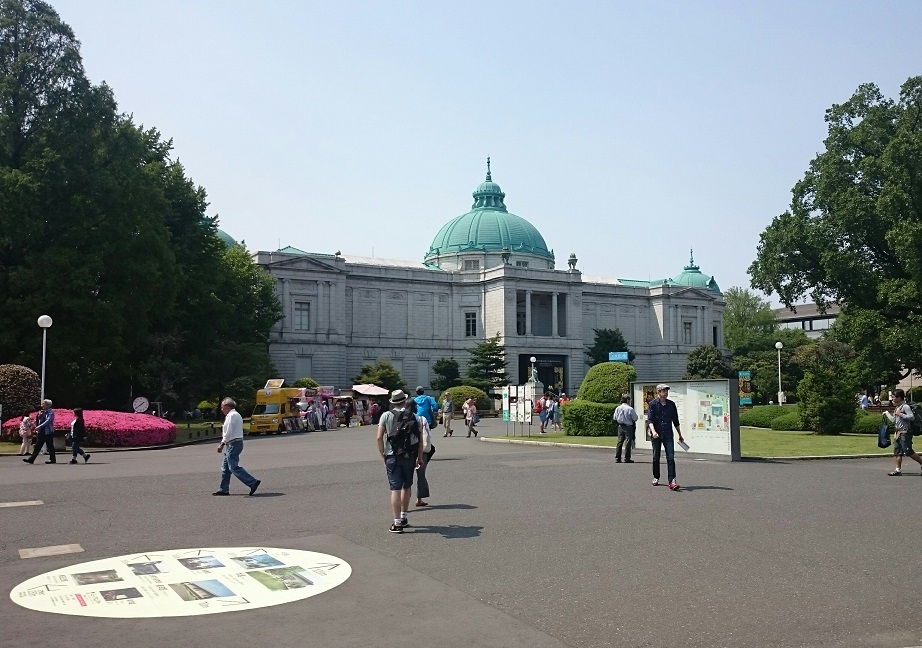 Ueno Park and National Art Museum[/caption]
[caption id="attachment_3981" align="alignnone" width="410"]
Ueno Park and National Art Museum[/caption]
[caption id="attachment_3981" align="alignnone" width="410"]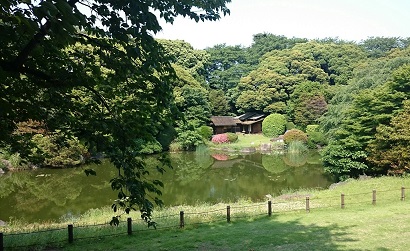 Gardener's cottage behind National Art Museum in Ueno Park[/caption]
[caption id="attachment_3982" align="alignnone" width="842"]
Gardener's cottage behind National Art Museum in Ueno Park[/caption]
[caption id="attachment_3982" align="alignnone" width="842"]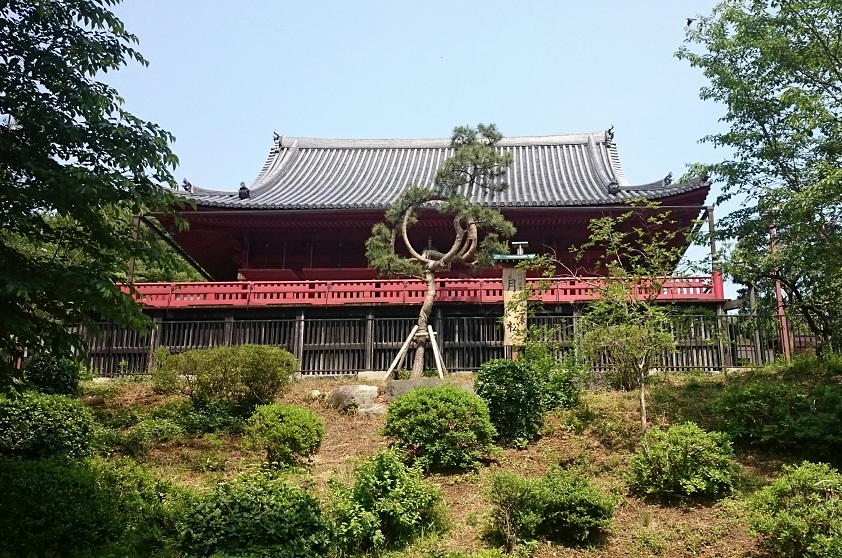 Ueno Park shrine[/caption]
[caption id="attachment_3961" align="alignnone" width="293"]
Ueno Park shrine[/caption]
[caption id="attachment_3961" align="alignnone" width="293"] Kappa Bashi street with Godzilla[/caption]
[caption id="attachment_3962" align="alignnone" width="748"]
Kappa Bashi street with Godzilla[/caption]
[caption id="attachment_3962" align="alignnone" width="748"] Kappa Bashi street store selling food replicas[/caption]
[caption id="attachment_3983" align="alignnone" width="960"]
Kappa Bashi street store selling food replicas[/caption]
[caption id="attachment_3983" align="alignnone" width="960"] Kappa Bashi street knife shop[/caption]
Nakamise-dori (so-called the Orange Street because of the brightly painted terraced tourist shops that line both sides all the way to the main ‘Thunder Gate’ entrance to Senso-ji temple grounds) is where the day-tripping tourists hang out searching for a souvenir and a selfie opportunity.
[caption id="attachment_3964" align="alignnone" width="578"]
Kappa Bashi street knife shop[/caption]
Nakamise-dori (so-called the Orange Street because of the brightly painted terraced tourist shops that line both sides all the way to the main ‘Thunder Gate’ entrance to Senso-ji temple grounds) is where the day-tripping tourists hang out searching for a souvenir and a selfie opportunity.
[caption id="attachment_3964" align="alignnone" width="578"]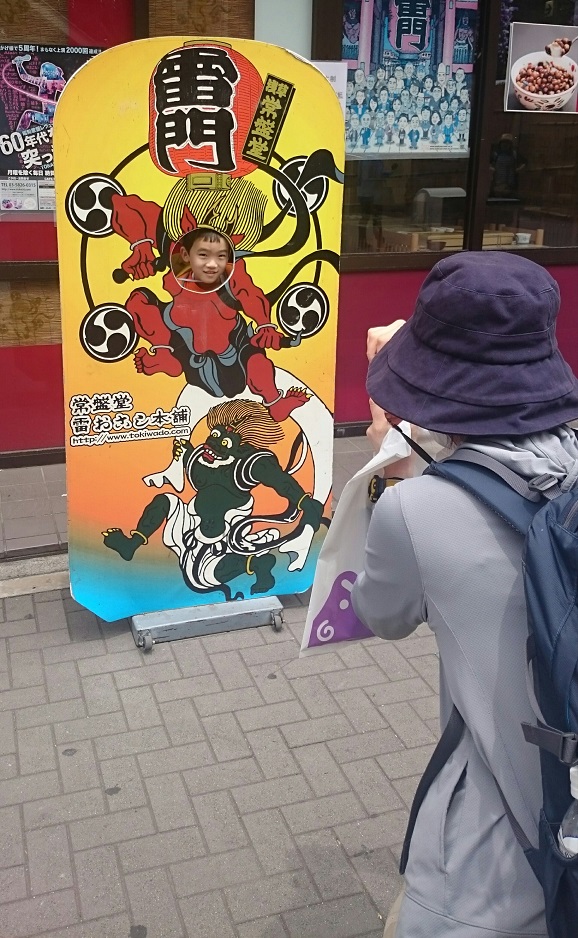 Kid in Asakusa near Senso-ji[/caption]
The back streets west of the Senso-ji are packed with tiny cafes and bars, shops and restaurants, quite unlike Nakamise-dori with its constant hordes crowding in from everywhere. I walked once along Orange Rip-off Street and didn’t return.
[caption id="attachment_3945" align="alignnone" width="605"]
Kid in Asakusa near Senso-ji[/caption]
The back streets west of the Senso-ji are packed with tiny cafes and bars, shops and restaurants, quite unlike Nakamise-dori with its constant hordes crowding in from everywhere. I walked once along Orange Rip-off Street and didn’t return.
[caption id="attachment_3945" align="alignnone" width="605"] Asakusa street scene with rickshaw[/caption]
[caption id="attachment_3949" align="alignnone" width="745"]
Asakusa street scene with rickshaw[/caption]
[caption id="attachment_3949" align="alignnone" width="745"]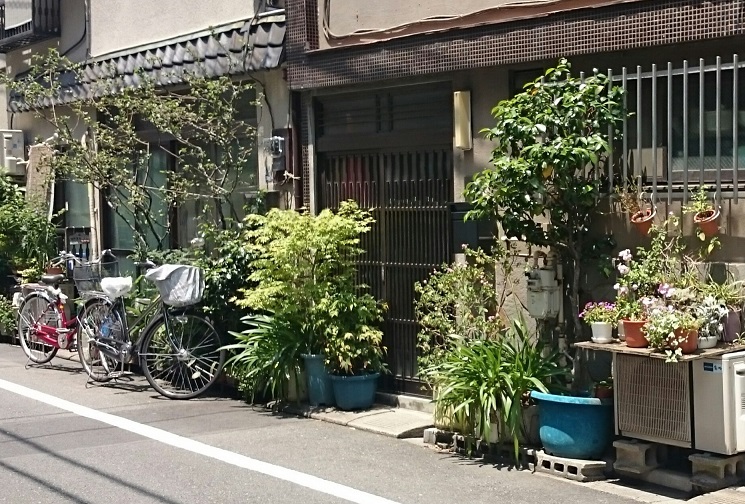 Asakusa street scene[/caption]
[caption id="attachment_3950" align="alignnone" width="581"]
Asakusa street scene[/caption]
[caption id="attachment_3950" align="alignnone" width="581"]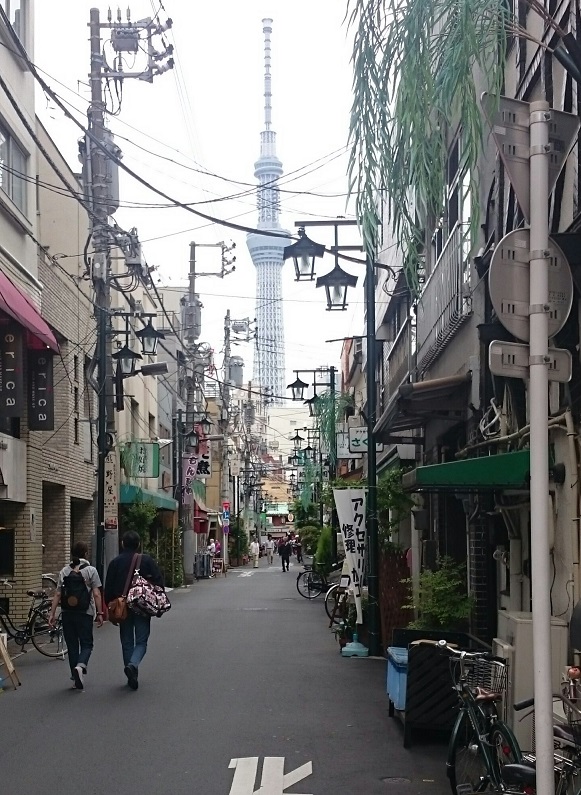 Asakusa street scene[/caption]
The riverside is lined with promenades. Scores of local people sunbake there when weather permits. Tourist boats cruise the river many times per day, well worth half an afternoon for a view of Tokyo unlike any other.
[caption id="attachment_3946" align="alignnone" width="565"]
Asakusa street scene[/caption]
The riverside is lined with promenades. Scores of local people sunbake there when weather permits. Tourist boats cruise the river many times per day, well worth half an afternoon for a view of Tokyo unlike any other.
[caption id="attachment_3946" align="alignnone" width="565"]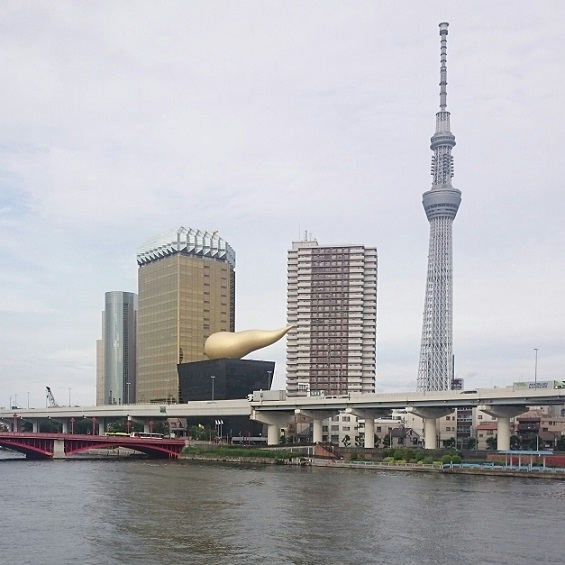 Sumida River from Asakusa[/caption]
Sumida was once famed for its eels. These days it’s not clean enough for regular eel migrations upriver from Tokyo Bay but many local restaurants continue the tradition specialising in eel (unagi) dishes. Walking east from Asakusa station to the narrow riverside street either side of Kaminarimon-dori will find many restaurants serving unagi.
Skipping dinner focused solely on eel, I chose a couple of Asakusa’s best restaurants. Actually I found them by aimlessly wandering -- serendipity rules.
Countless ramen eateries can be found along Kaminarimon-dori and Kokusai-dori, Asakusa’s two main cross streets. Here too are convenience stores like 7-11 with ATMs that accept foreign bankcards, handy when paying for a cheap ramen meal as almost all small Japanese cafes and restaurants operate on a cash-only basis.
Pick your ramen joint as you would anywhere in Japan; if it’s packed with locals, it’s good. Between 600 and 1,000 Yen will score a huge bowl of slippery scrumptious noodles, vegetables, with or without meat, swimming in a rich soup. I tripped into Hidakaya where a delicious bowl of chicken ramen with a half dozen succulent pork, shitake and chive gyozo and a half shochu/half fruit juice drink set me back less than 1,000 Yen. O-cha is of course included.
[caption id="attachment_3947" align="alignnone" width="162"]
Sumida River from Asakusa[/caption]
Sumida was once famed for its eels. These days it’s not clean enough for regular eel migrations upriver from Tokyo Bay but many local restaurants continue the tradition specialising in eel (unagi) dishes. Walking east from Asakusa station to the narrow riverside street either side of Kaminarimon-dori will find many restaurants serving unagi.
Skipping dinner focused solely on eel, I chose a couple of Asakusa’s best restaurants. Actually I found them by aimlessly wandering -- serendipity rules.
Countless ramen eateries can be found along Kaminarimon-dori and Kokusai-dori, Asakusa’s two main cross streets. Here too are convenience stores like 7-11 with ATMs that accept foreign bankcards, handy when paying for a cheap ramen meal as almost all small Japanese cafes and restaurants operate on a cash-only basis.
Pick your ramen joint as you would anywhere in Japan; if it’s packed with locals, it’s good. Between 600 and 1,000 Yen will score a huge bowl of slippery scrumptious noodles, vegetables, with or without meat, swimming in a rich soup. I tripped into Hidakaya where a delicious bowl of chicken ramen with a half dozen succulent pork, shitake and chive gyozo and a half shochu/half fruit juice drink set me back less than 1,000 Yen. O-cha is of course included.
[caption id="attachment_3947" align="alignnone" width="162"]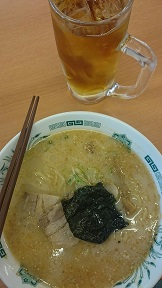 Hidakaya ramen with shoju/tea drink[/caption]
[caption id="attachment_3951" align="alignnone" width="540"]
Hidakaya ramen with shoju/tea drink[/caption]
[caption id="attachment_3951" align="alignnone" width="540"] Hidakaya menu[/caption]
[caption id="attachment_3965" align="alignnone" width="519"]
Hidakaya menu[/caption]
[caption id="attachment_3965" align="alignnone" width="519"]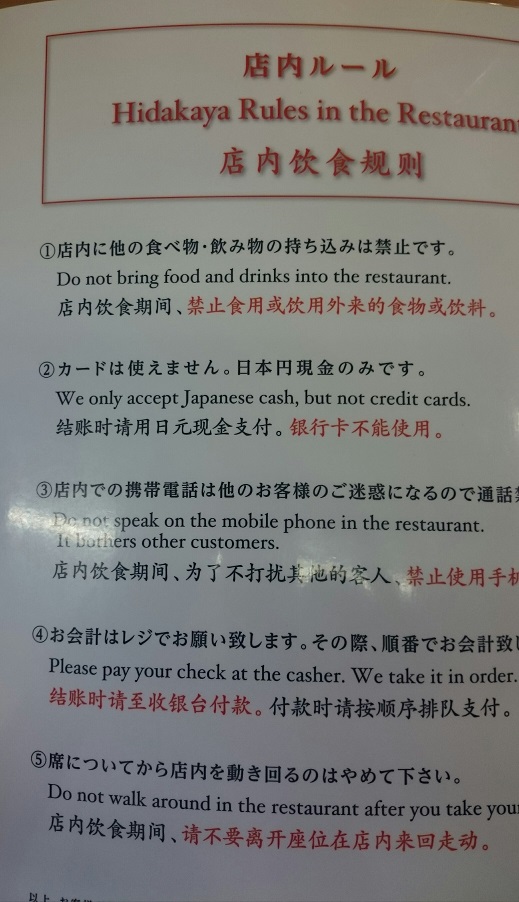 Hidakaya restaurant rules[/caption]
Asakusa is known for its special pork tonkatsu with udon. The restaurants with queues of waiting customers in Kaminarimon-dori nearer the temple are excellent indicators of justifiable popularity. Check prices before entering, some charging more than others but average for a meal is around 2,500 Yen.
I ate exceedingly well at two restaurants: Hanabo owned by master chef Mr Mori, a tiny place with fewer than 20 seats in a narrow laneway bordering the river near where Kaminarimon-dori crosses the main bridge over the Sumida.
[caption id="attachment_3952" align="alignnone" width="605"]
Hidakaya restaurant rules[/caption]
Asakusa is known for its special pork tonkatsu with udon. The restaurants with queues of waiting customers in Kaminarimon-dori nearer the temple are excellent indicators of justifiable popularity. Check prices before entering, some charging more than others but average for a meal is around 2,500 Yen.
I ate exceedingly well at two restaurants: Hanabo owned by master chef Mr Mori, a tiny place with fewer than 20 seats in a narrow laneway bordering the river near where Kaminarimon-dori crosses the main bridge over the Sumida.
[caption id="attachment_3952" align="alignnone" width="605"] Chef/owner Mori-san of the exquisite Hanabo[/caption]
[caption id="attachment_3966" align="alignnone" width="605"]
Chef/owner Mori-san of the exquisite Hanabo[/caption]
[caption id="attachment_3966" align="alignnone" width="605"]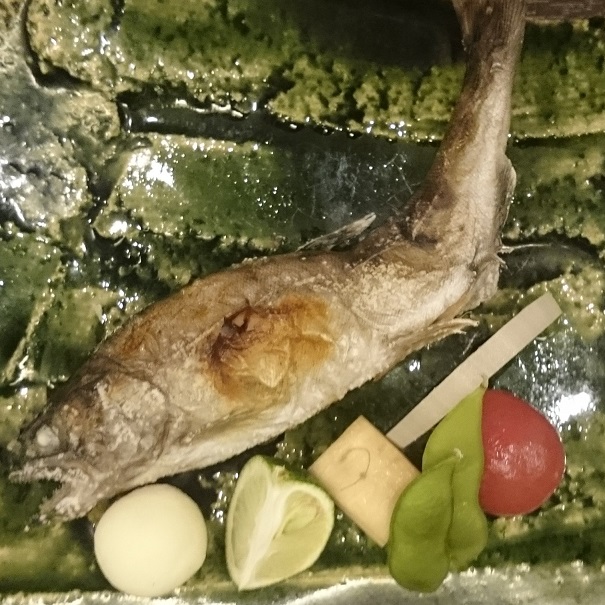 Ayu fish dish at Hanabo, part of a 10 course kaiseki[/caption]
Tsukimiso restaurant in Kokusai-dori is a long-standing favourite with local residents. More French influenced while remaining strongly Japanese (kaiseki is the go), the wine list is interesting, lots of Japanese wines. Service is excellent. In both places, seasonality is the benchmark.
[caption id="attachment_3953" align="alignnone" width="945"]
Ayu fish dish at Hanabo, part of a 10 course kaiseki[/caption]
Tsukimiso restaurant in Kokusai-dori is a long-standing favourite with local residents. More French influenced while remaining strongly Japanese (kaiseki is the go), the wine list is interesting, lots of Japanese wines. Service is excellent. In both places, seasonality is the benchmark.
[caption id="attachment_3953" align="alignnone" width="945"] Tsukimiso restaurant waiters[/caption]
[caption id="attachment_3967" align="alignnone" width="1152"]
Tsukimiso restaurant waiters[/caption]
[caption id="attachment_3967" align="alignnone" width="1152"]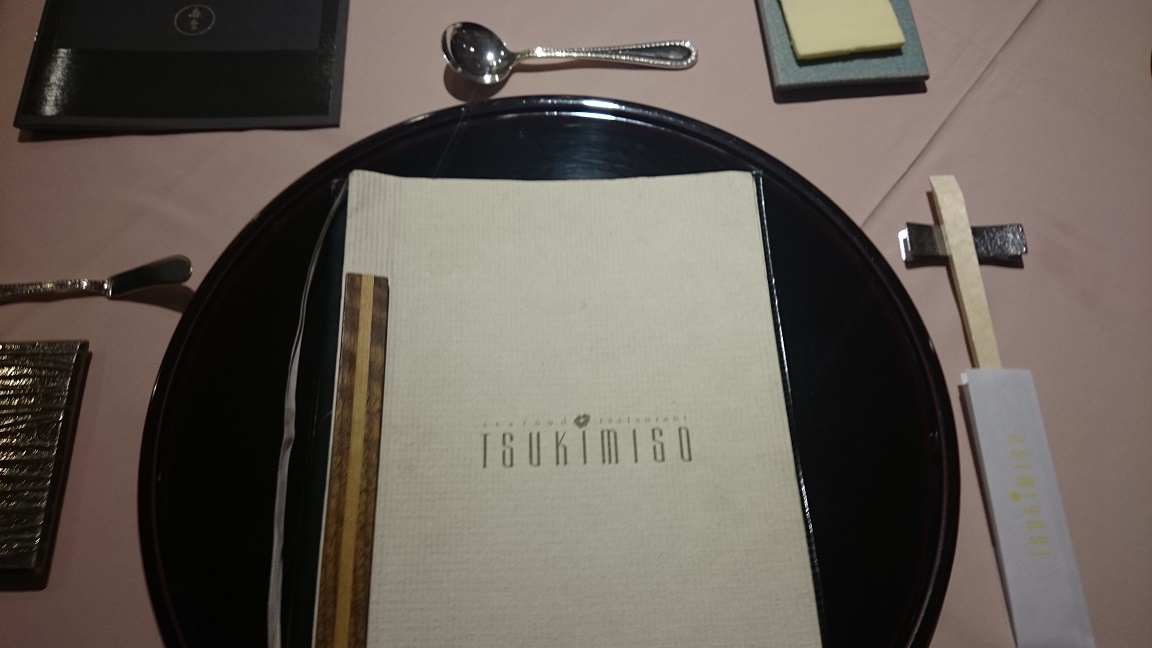 Tsukimiso menu cover[/caption]
Those same back streets west of Senso-ji are littered with typically tiny Tokyo bars, rarely with more than a dozen bar stools each, usually serving booze friendly food such as yakitori or takoyaki. Order a glass of sake or a biru; Kambai!
[caption id="attachment_3954" align="alignnone" width="835"]
Tsukimiso menu cover[/caption]
Those same back streets west of Senso-ji are littered with typically tiny Tokyo bars, rarely with more than a dozen bar stools each, usually serving booze friendly food such as yakitori or takoyaki. Order a glass of sake or a biru; Kambai!
[caption id="attachment_3954" align="alignnone" width="835"] Asakusa bar[/caption]
[caption id="attachment_3955" align="alignnone" width="938"]
Asakusa bar[/caption]
[caption id="attachment_3955" align="alignnone" width="938"]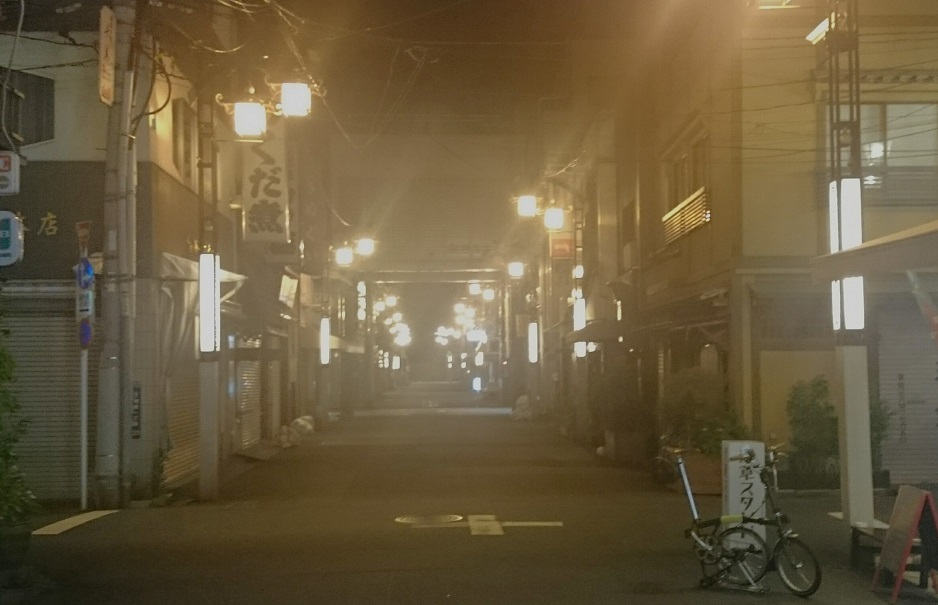 Asakusa at night[/caption]
[caption id="attachment_3968" align="alignnone" width="493"]
Asakusa at night[/caption]
[caption id="attachment_3968" align="alignnone" width="493"] Asakusa spare parts shop[/caption]
[caption id="attachment_3977" align="alignnone" width="462"]
Asakusa spare parts shop[/caption]
[caption id="attachment_3977" align="alignnone" width="462"]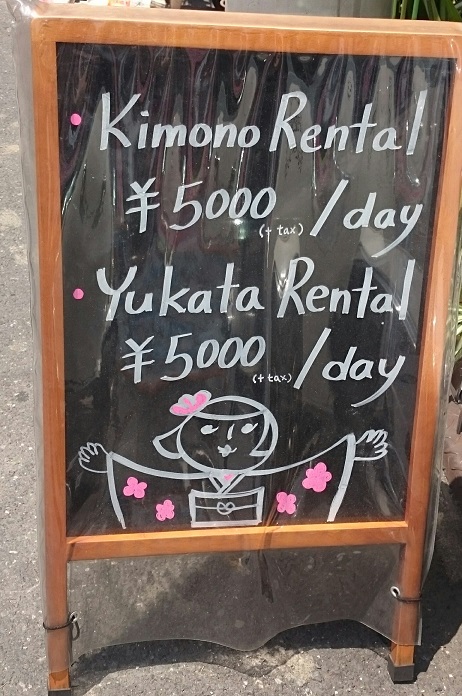 Rent an outfit sign[/caption]
Japan has more vending machines and puzzling signage than anywhere else.
[caption id="attachment_3956" align="alignnone" width="380"]
Rent an outfit sign[/caption]
Japan has more vending machines and puzzling signage than anywhere else.
[caption id="attachment_3956" align="alignnone" width="380"]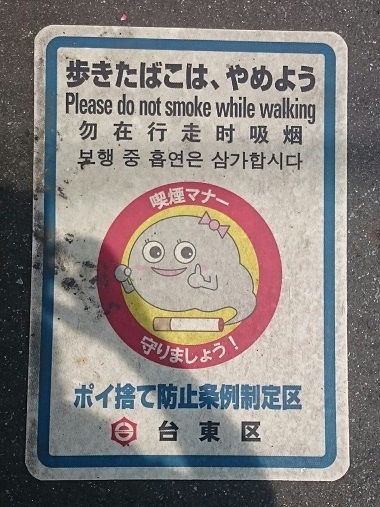 Strange sign one[/caption]
[caption id="attachment_3957" align="alignnone" width="342"]
Strange sign one[/caption]
[caption id="attachment_3957" align="alignnone" width="342"] Strange sign 2[/caption]
[caption id="attachment_3958" align="alignnone" width="137"]
Strange sign 2[/caption]
[caption id="attachment_3958" align="alignnone" width="137"]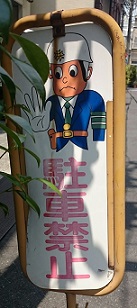 Strange sign 3[/caption]
[caption id="attachment_3959" align="alignnone" width="502"]
Strange sign 3[/caption]
[caption id="attachment_3959" align="alignnone" width="502"] Three of many thousands throughout Japan[/caption]
See what I mean?
From historic tradition to contemporary fetish via less than an hour from Asakusa on Tokyo’s marvellous public transport, I got lost in a haze of cartoon characters at the Tokyo Disneyland complex.
[caption id="attachment_3969" align="alignnone" width="469"]
Three of many thousands throughout Japan[/caption]
See what I mean?
From historic tradition to contemporary fetish via less than an hour from Asakusa on Tokyo’s marvellous public transport, I got lost in a haze of cartoon characters at the Tokyo Disneyland complex.
[caption id="attachment_3969" align="alignnone" width="469"]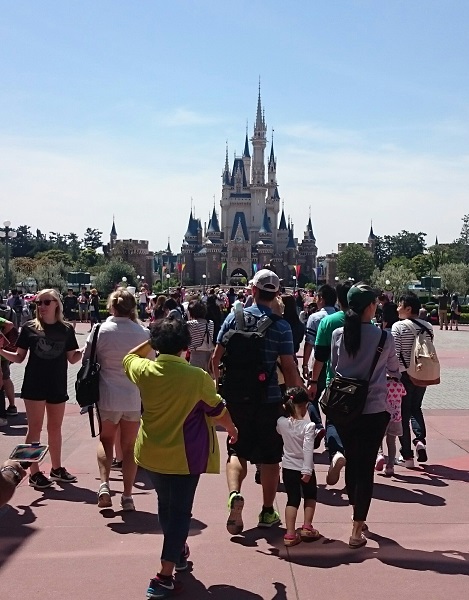 Tokyo Disneyland Cinderella castle[/caption]
As a curious insight into what makes the Japanese character tick like no others on Planet Earth, I can recommend it as a day trip, two days if you want to visit both Disneyland and DisneySea.
So...What’s a visit to Tokyo without a side trip to Disneyland and DisneySea?
Minus Mickey, Donald and Duffy is what.
Duffy?
[caption id="attachment_3970" align="alignnone" width="720"]
Tokyo Disneyland Cinderella castle[/caption]
As a curious insight into what makes the Japanese character tick like no others on Planet Earth, I can recommend it as a day trip, two days if you want to visit both Disneyland and DisneySea.
So...What’s a visit to Tokyo without a side trip to Disneyland and DisneySea?
Minus Mickey, Donald and Duffy is what.
Duffy?
[caption id="attachment_3970" align="alignnone" width="720"] Duffy fans[/caption]
Duffy the bear is a favourite Disney character in Japan, just one of the quirkier aspects integral to a visit to one of the world’s largest cities where difference, from a Westerner’s eye, is everything.
Launched as a main attraction at DisneySea (the adjacent park to Disneyland) in 2005, Duffy had never been a prominent character in USA Disney parks.
In Tokyo, it’s a different case.
Duffy the bear is everywhere.
By the way, for the uninitiated, Duffy travelled with Mickey from his Cape Cod, Massachusetts base, a duo set to have frolicking fun wherever they went.
DisneySea along with Disneyland straddling Tokyo Bay presents Duffy the bear in a perfect seaside location.
[caption id="attachment_3971" align="alignnone" width="583"]
Duffy fans[/caption]
Duffy the bear is a favourite Disney character in Japan, just one of the quirkier aspects integral to a visit to one of the world’s largest cities where difference, from a Westerner’s eye, is everything.
Launched as a main attraction at DisneySea (the adjacent park to Disneyland) in 2005, Duffy had never been a prominent character in USA Disney parks.
In Tokyo, it’s a different case.
Duffy the bear is everywhere.
By the way, for the uninitiated, Duffy travelled with Mickey from his Cape Cod, Massachusetts base, a duo set to have frolicking fun wherever they went.
DisneySea along with Disneyland straddling Tokyo Bay presents Duffy the bear in a perfect seaside location.
[caption id="attachment_3971" align="alignnone" width="583"] DisneySea Parade[/caption]
[caption id="attachment_3972" align="alignnone" width="188"]
DisneySea Parade[/caption]
[caption id="attachment_3972" align="alignnone" width="188"] Sindbad on parade at DisneySea[/caption]
The Japanese have embraced Duffy like a long lost friend. Duffy merchandise has prominent position in all the shops across Disneyland/DisneySea. He’s the inescapable bear.
So popular is this ursine character that purchases of Duffy themed merchandise are limited for each customer in case the shops run out. Given the amount of Disney paraphernalia the Japanese wear during a visit, I’m not surprised that Disney bosses have taken measures to ensure everyone gets a chance to buy their own Duffy souvenir.
Tokyo Disneyland has been in operation since 1983. DisneySea (focused on contemporary characters: Sindbad, the Little Mermaid, Mulan and the recently acquired Star Wars franchise for example) was opened in 2001.
A monorail links the two parks and Ikspiari Shopping Mall, providing easy and fast access.
[caption id="attachment_3973" align="alignnone" width="346"]
Sindbad on parade at DisneySea[/caption]
The Japanese have embraced Duffy like a long lost friend. Duffy merchandise has prominent position in all the shops across Disneyland/DisneySea. He’s the inescapable bear.
So popular is this ursine character that purchases of Duffy themed merchandise are limited for each customer in case the shops run out. Given the amount of Disney paraphernalia the Japanese wear during a visit, I’m not surprised that Disney bosses have taken measures to ensure everyone gets a chance to buy their own Duffy souvenir.
Tokyo Disneyland has been in operation since 1983. DisneySea (focused on contemporary characters: Sindbad, the Little Mermaid, Mulan and the recently acquired Star Wars franchise for example) was opened in 2001.
A monorail links the two parks and Ikspiari Shopping Mall, providing easy and fast access.
[caption id="attachment_3973" align="alignnone" width="346"]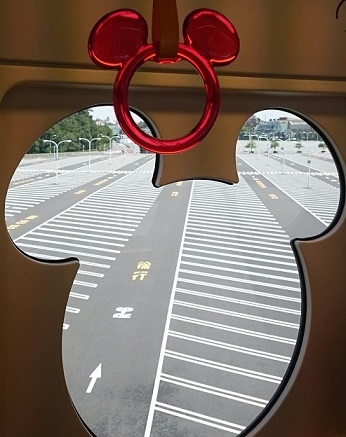 Mickey monorail window[/caption]
Tickets to both parks can be purchased online at www.tokyodisneyresort.jp
(It’s a good idea to purchase online before visiting. During school holidays and peak summer season, you won’t get in otherwise.)
Different passes are available: one day, multi-day, family and individual.
Like all Disney parks across the world (the newest park in Shanghai is set to open in 2016), the whole shebang is immaculately run.
Gardens are lovingly tended to the nth degree, not an errant leaf out of place. Queues at popular rides (sometimes two hours long) are scrupulously monitored by ever smiling Disney employees, customers jollied along like happy seals to the next waterfall ride.
[caption id="attachment_3974" align="alignnone" width="242"]
Mickey monorail window[/caption]
Tickets to both parks can be purchased online at www.tokyodisneyresort.jp
(It’s a good idea to purchase online before visiting. During school holidays and peak summer season, you won’t get in otherwise.)
Different passes are available: one day, multi-day, family and individual.
Like all Disney parks across the world (the newest park in Shanghai is set to open in 2016), the whole shebang is immaculately run.
Gardens are lovingly tended to the nth degree, not an errant leaf out of place. Queues at popular rides (sometimes two hours long) are scrupulously monitored by ever smiling Disney employees, customers jollied along like happy seals to the next waterfall ride.
[caption id="attachment_3974" align="alignnone" width="242"]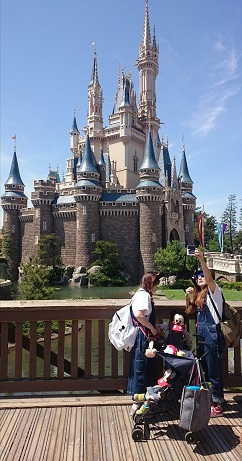 Cinderella castle selfie opportunity[/caption]
Food and beverage outlets (the majority are buffets) are easily accessible with comestibles available at various price points though food is where authentic Japanese influence is lacking. A weird amalgam of USA/Japanese cuisine constitutes the buffet arrays in both parks, borrowing from both but sadly excelling at neither.
[caption id="attachment_3976" align="alignnone" width="491"]
Cinderella castle selfie opportunity[/caption]
Food and beverage outlets (the majority are buffets) are easily accessible with comestibles available at various price points though food is where authentic Japanese influence is lacking. A weird amalgam of USA/Japanese cuisine constitutes the buffet arrays in both parks, borrowing from both but sadly excelling at neither.
[caption id="attachment_3976" align="alignnone" width="491"]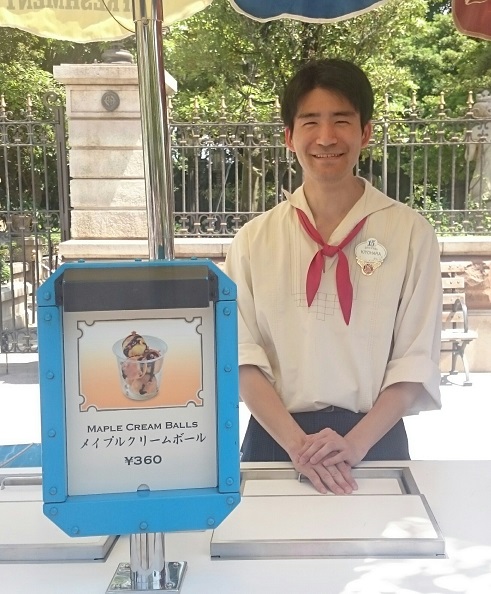 Maple cream balls anyone?[/caption]
But if a fantasy land experience is your oyster, this is the place to find a pearl or three.
I’m no great fan of the Disney illusion but constant messages of good triumphing over dastardly evil and the joys of eternal simplistic youth are compelling.
[caption id="attachment_3975" align="alignnone" width="655"]
Maple cream balls anyone?[/caption]
But if a fantasy land experience is your oyster, this is the place to find a pearl or three.
I’m no great fan of the Disney illusion but constant messages of good triumphing over dastardly evil and the joys of eternal simplistic youth are compelling.
[caption id="attachment_3975" align="alignnone" width="655"]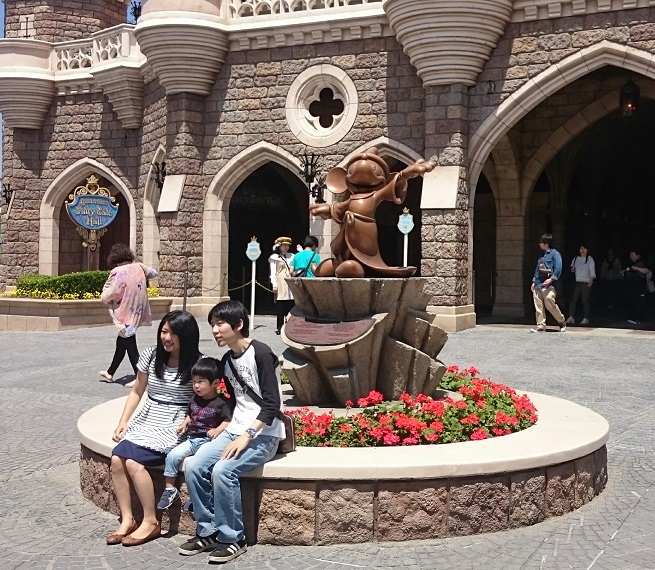 Family with Mickey Mouse wizard statue[/caption]
If you’re in Tokyo for a few days and feel the need for pure escapism, the Disney parks provide a completely alternate reality.
Certainly the Japanese have embraced Disney characters (and their requisite wholesomeness) like ducks to water.
The daily Easter Parade sees hundreds of Japanese waiting patiently in prime positions along the route. Seated like Buddha on the cleanly swept footpaths, they wait quietly for a walk on down the Mickey, Donald, Goofy, Snow White and Duffy road. I’ve only seen comparable devotion in the holiest temples and churches.
[caption id="attachment_3978" align="alignnone" width="390"]
Family with Mickey Mouse wizard statue[/caption]
If you’re in Tokyo for a few days and feel the need for pure escapism, the Disney parks provide a completely alternate reality.
Certainly the Japanese have embraced Disney characters (and their requisite wholesomeness) like ducks to water.
The daily Easter Parade sees hundreds of Japanese waiting patiently in prime positions along the route. Seated like Buddha on the cleanly swept footpaths, they wait quietly for a walk on down the Mickey, Donald, Goofy, Snow White and Duffy road. I’ve only seen comparable devotion in the holiest temples and churches.
[caption id="attachment_3978" align="alignnone" width="390"] Waiting for the daily Easter Parade[/caption]
The rides are terrific. I loved the Indiana Jones like volcano roller coaster, the Tower of Terror amongst several other thrill seekers’ delights. I didn’t make it to Space Mountain (next time I hope), but I did love the newest Star Wars 3D ride where I did indeed feel like Luke Skywalker travelling from one planet to another at light speed.
(Naked Tip: don’t overdose on junk food before going on this one.)
I was less impressed by the shows; saccharine sweet and oh-so-twee but the kids seemed to love them.
Both parks are open until well after sunset. Stay late and enjoy the fireworks. The lighting is fantastic and the whole waterside extravaganza comes alive after dark.
Takeshita-dori near Harajuka Station, one stop past Shibuya, where young Japanese dress up like Lolita, Goths and other fantasy fetishes is weirdly like Disneyland and DisneySea but more grunge chic and edgy. How can Snow White be Lolita for instance?
Nevertheless I loved watching Japanese fans model their appearances to characters from the Disney fantasy world.
[caption id="attachment_3979" align="alignnone" width="570"]
Waiting for the daily Easter Parade[/caption]
The rides are terrific. I loved the Indiana Jones like volcano roller coaster, the Tower of Terror amongst several other thrill seekers’ delights. I didn’t make it to Space Mountain (next time I hope), but I did love the newest Star Wars 3D ride where I did indeed feel like Luke Skywalker travelling from one planet to another at light speed.
(Naked Tip: don’t overdose on junk food before going on this one.)
I was less impressed by the shows; saccharine sweet and oh-so-twee but the kids seemed to love them.
Both parks are open until well after sunset. Stay late and enjoy the fireworks. The lighting is fantastic and the whole waterside extravaganza comes alive after dark.
Takeshita-dori near Harajuka Station, one stop past Shibuya, where young Japanese dress up like Lolita, Goths and other fantasy fetishes is weirdly like Disneyland and DisneySea but more grunge chic and edgy. How can Snow White be Lolita for instance?
Nevertheless I loved watching Japanese fans model their appearances to characters from the Disney fantasy world.
[caption id="attachment_3979" align="alignnone" width="570"] Disney fans all dressed up and somewhere to go[/caption]
In this respect alone, Tokyo Disneyland and DisneySea are well worth visiting.
No visit to Disney wherever is complete without a shopping opportunity. Smack bang between the two Disney parks is the Ikspiari shopping mall. Spread over three floors, there’s more shops and food outlets here than Donald Duck could line up in a row. Some of the restaurants are better than in the two parks themselves. The retail shops are pricy. See www.ikspiari.com
I never expected to feel such cross-cultural resonances in Mickey Mouse land but there you have it; always be ready for surprises in Japan.
[caption id="attachment_3984" align="alignnone" width="771"]
Disney fans all dressed up and somewhere to go[/caption]
In this respect alone, Tokyo Disneyland and DisneySea are well worth visiting.
No visit to Disney wherever is complete without a shopping opportunity. Smack bang between the two Disney parks is the Ikspiari shopping mall. Spread over three floors, there’s more shops and food outlets here than Donald Duck could line up in a row. Some of the restaurants are better than in the two parks themselves. The retail shops are pricy. See www.ikspiari.com
I never expected to feel such cross-cultural resonances in Mickey Mouse land but there you have it; always be ready for surprises in Japan.
[caption id="attachment_3984" align="alignnone" width="771"] Safe Journey Sindbad[/caption]
Tom Neal Tacker travelled to Tokyo as a guest of Tokyo Disneyland.
Naked Routes:
If you can’t find your way to Tokyo, something is wrong with your sense of direction.
Japan Airlines, JAL, is the national carrier. The few flights I’ve had with this above average carrier (compared to North American airlines), seated in the back of the bus, have been just tolerable. Service is efficient and friendly—without exception but economy seats in the Boeing 777-200 serving the Sydney-Tokyo route are cramped. Miserly service of alcohol doesn’t improve the overall impression either. Requesting more than one tiny bottle of ordinary wine, I felt like I was borderline ‘problem passenger’. The meals (apart from a small cup of miso soup) were the worst I’ve tasted of Japanese derivation, which is clearly not reflective of the high quality food available throughout Japan itself.
I don’t understand why JAL continues to use old aircraft on its Sydney-Tokyo route. I was once seated in Premium Economy on a hop from Tokyo to Osaka; far better in a larger, newer aircraft but wasted on the hour’s flight. Incidentally JAL’s Premium Economy passengers are served exactly the same meals as Economy passengers—go figure!
Nine hours Sydney-Tokyo (worse still on the overnight Tokyo-Sydney return) in an old Boeing 777 is inexplicable if JAL is trying to pull more traffic from the Australian market.
See www.jal.com
ANA (All Nippon Airways) is Japan’s alternate national carrier. It’s viewed as a far better airline than JAL by industry insiders. The Skytrax 5-star rating isn’t given out lightly and ANA apparently earns it.
See www.ana.co.jp
Naked Sleeps:
Nearby to the Disney complex is the Emion Hotel. Thematically linked to the parks via merchandising and family friendly facilities, it’s an above average place to stay. Free shuttle buses carry guests to and from the parks (approximately 2 ks). A good onsen is open for a nominal fee to house guests. A restaurant on the top floor serves authentic Japanese cuisine, something the Disney parks do not. See www.hotel-emion.jp
In Asakusa, I stayed at the hotel Apa Asakusa Kuramae. Despite the tiniest room I’ve ever slept in (a capsule hotel would bear close comparison) and a rather ordinary breakfast buffet, I loved the rooftop onsen, the location and the quiet. See www.JAPANiCAN.com klick on APA Hotel Asakusa-Kuramae for best deals of the day.
[caption id="attachment_3985" align="alignnone" width="853"]
Safe Journey Sindbad[/caption]
Tom Neal Tacker travelled to Tokyo as a guest of Tokyo Disneyland.
Naked Routes:
If you can’t find your way to Tokyo, something is wrong with your sense of direction.
Japan Airlines, JAL, is the national carrier. The few flights I’ve had with this above average carrier (compared to North American airlines), seated in the back of the bus, have been just tolerable. Service is efficient and friendly—without exception but economy seats in the Boeing 777-200 serving the Sydney-Tokyo route are cramped. Miserly service of alcohol doesn’t improve the overall impression either. Requesting more than one tiny bottle of ordinary wine, I felt like I was borderline ‘problem passenger’. The meals (apart from a small cup of miso soup) were the worst I’ve tasted of Japanese derivation, which is clearly not reflective of the high quality food available throughout Japan itself.
I don’t understand why JAL continues to use old aircraft on its Sydney-Tokyo route. I was once seated in Premium Economy on a hop from Tokyo to Osaka; far better in a larger, newer aircraft but wasted on the hour’s flight. Incidentally JAL’s Premium Economy passengers are served exactly the same meals as Economy passengers—go figure!
Nine hours Sydney-Tokyo (worse still on the overnight Tokyo-Sydney return) in an old Boeing 777 is inexplicable if JAL is trying to pull more traffic from the Australian market.
See www.jal.com
ANA (All Nippon Airways) is Japan’s alternate national carrier. It’s viewed as a far better airline than JAL by industry insiders. The Skytrax 5-star rating isn’t given out lightly and ANA apparently earns it.
See www.ana.co.jp
Naked Sleeps:
Nearby to the Disney complex is the Emion Hotel. Thematically linked to the parks via merchandising and family friendly facilities, it’s an above average place to stay. Free shuttle buses carry guests to and from the parks (approximately 2 ks). A good onsen is open for a nominal fee to house guests. A restaurant on the top floor serves authentic Japanese cuisine, something the Disney parks do not. See www.hotel-emion.jp
In Asakusa, I stayed at the hotel Apa Asakusa Kuramae. Despite the tiniest room I’ve ever slept in (a capsule hotel would bear close comparison) and a rather ordinary breakfast buffet, I loved the rooftop onsen, the location and the quiet. See www.JAPANiCAN.com klick on APA Hotel Asakusa-Kuramae for best deals of the day.
[caption id="attachment_3985" align="alignnone" width="853"] Crossing Kappa Bashi street[/caption]
Crossing Kappa Bashi street[/caption]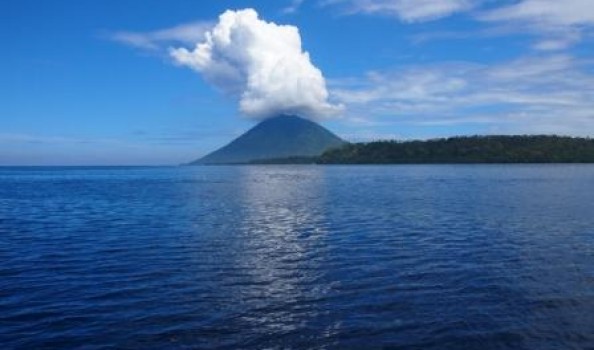 https://nakedhungrytraveller.com.au/sulawesi-and-ambon-spice-and-pirates/ Sulawesi and Ambon -- Spice and PiratesIndonesia: 13,466 islands... so why does one get all the attention? Bali is by far the best known and also gets the lion’s share of international visitors. This has proven both a blessing and curse for loved-to-death Bali. Aquifers are drained for upmarket resort pools at the expense of irrigation for rice paddies; rubbish accumulates in ever increasing amounts to be burned in noxious dumps or left to clog up beaches. Local culture suffers a king hit to its holy head while uninformed tourists ignore Bali’s unique Hindu/Animist version of mainstream religion. For tourism to survive and thrive in Indonesia, visitors need to re-focus their attention on Indonesia-other-than-Bali. Indonesia’s glorious tropical beaches and lush mountain backdrops fill tourist brochures with idyllic images but eco-tourism is the main driver in positive directions, the saviour for this dynamic country’s fragile environment. [caption id="attachment_3761" align="alignnone" width="448"]
https://nakedhungrytraveller.com.au/sulawesi-and-ambon-spice-and-pirates/ Sulawesi and Ambon -- Spice and PiratesIndonesia: 13,466 islands... so why does one get all the attention? Bali is by far the best known and also gets the lion’s share of international visitors. This has proven both a blessing and curse for loved-to-death Bali. Aquifers are drained for upmarket resort pools at the expense of irrigation for rice paddies; rubbish accumulates in ever increasing amounts to be burned in noxious dumps or left to clog up beaches. Local culture suffers a king hit to its holy head while uninformed tourists ignore Bali’s unique Hindu/Animist version of mainstream religion. For tourism to survive and thrive in Indonesia, visitors need to re-focus their attention on Indonesia-other-than-Bali. Indonesia’s glorious tropical beaches and lush mountain backdrops fill tourist brochures with idyllic images but eco-tourism is the main driver in positive directions, the saviour for this dynamic country’s fragile environment. [caption id="attachment_3761" align="alignnone" width="448"]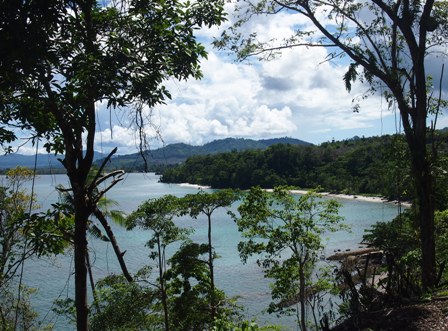 Saparua Maluku beaches[/caption]
The country’s extraordinarily diverse bio-systems support indigenous wildlife that perilously clings on for survival. Already a strong attraction for dedicated travellers in search of something other than resorts, cocktails and beaches (not that there’s anything wrong with those of course), this is what makes Indonesia absolutely special.
[caption id="attachment_3762" align="alignnone" width="448"]
Saparua Maluku beaches[/caption]
The country’s extraordinarily diverse bio-systems support indigenous wildlife that perilously clings on for survival. Already a strong attraction for dedicated travellers in search of something other than resorts, cocktails and beaches (not that there’s anything wrong with those of course), this is what makes Indonesia absolutely special.
[caption id="attachment_3762" align="alignnone" width="448"] Manado marina[/caption]
I’ve written before about personal encounters with orang-utans in Kalimantan and with tigers, rhinos and elephants in Sumatra. (See www.nakedhungrytraveller.com.au/orangutans-and-others and www.nakedhungrytraveller.com.au/sumatras-rarest-animals) I’ve climbed Mount Bromo and searched out Dutch heritage architecture in Malang, East Java. I’ve delved into Lombok’s mountainous interior resplendently draped in multitudes of waterfalls and got far as I could get from tourists on Bali. (See www.nakedhungrytraveller.com.au/off-beat-lombok) I’ve tripped into the darker side of Jakarta’s slums on bizarre shopping escapades (See www.nakedhungrytraveller.com.au/retail-therapy-in-jakarta) but a recent trip to Sulawesi and Maluku provinces showed me just how much more there is to Indonesia’s complex archipelago than I could ever have imagined.
While Indonesia is the world’s most populous Islamic nation, it encompasses sizeable Christian and Animist communities. Hindus and Buddhists also add their polytheistic flavours to the nation’s religious melting pot.
[caption id="attachment_3763" align="alignnone" width="448"]
Manado marina[/caption]
I’ve written before about personal encounters with orang-utans in Kalimantan and with tigers, rhinos and elephants in Sumatra. (See www.nakedhungrytraveller.com.au/orangutans-and-others and www.nakedhungrytraveller.com.au/sumatras-rarest-animals) I’ve climbed Mount Bromo and searched out Dutch heritage architecture in Malang, East Java. I’ve delved into Lombok’s mountainous interior resplendently draped in multitudes of waterfalls and got far as I could get from tourists on Bali. (See www.nakedhungrytraveller.com.au/off-beat-lombok) I’ve tripped into the darker side of Jakarta’s slums on bizarre shopping escapades (See www.nakedhungrytraveller.com.au/retail-therapy-in-jakarta) but a recent trip to Sulawesi and Maluku provinces showed me just how much more there is to Indonesia’s complex archipelago than I could ever have imagined.
While Indonesia is the world’s most populous Islamic nation, it encompasses sizeable Christian and Animist communities. Hindus and Buddhists also add their polytheistic flavours to the nation’s religious melting pot.
[caption id="attachment_3763" align="alignnone" width="448"]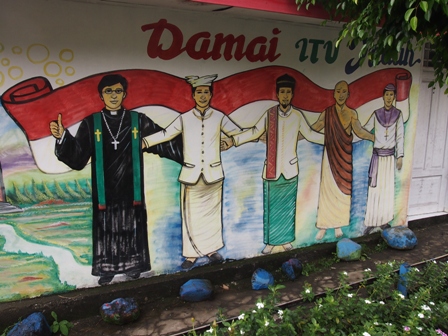 Hill of Love mural[/caption]
Over 500 languages are spoken in Indonesia, though Bahasa Indonesia is taught to all students across the country and is the main lingua franca.
With countless multi-cultural communities and wildlife sharing the world’s most diverse rainforests all in a single country, what’s not to love?
Manado
Daily Garuda flights (www.garuda-indonesia.com) connect Jakarta to Manado in North Sulawesi Province.
Manado lies north of the Equator, close enough to the Philippines to share similar histories and cultural ties.
The local Minahasan people were intrepid seafarers, voyaging throughout the South China Sea including the Philippines and south beyond Timor to northern Australia in search of kupang (sea cucumber).
Like Mindanao in the southern Philippines, Manado’s population is a mix of Christian and Muslim communities. Civil strife flares up occasionally (as in Ambon in the mid 90s, more on that later) but first impression indicates a peaceable coexistence nowadays.
Manado’s name derives from Minahasan for ‘in the distance’ or ‘on the far coast’.
It’s a long way from Jakarta, that’s for sure.
Manado is making its mark on the eco-traveller’s list of preferred destinations because it’s the closest access point to Bunaken National Marine Park.
The majority of international visitors to Manado carry masks, fins and PADI certificates. The diving around Bunaken is some of the world’s best.
[caption id="attachment_3764" align="alignnone" width="448"]
Hill of Love mural[/caption]
Over 500 languages are spoken in Indonesia, though Bahasa Indonesia is taught to all students across the country and is the main lingua franca.
With countless multi-cultural communities and wildlife sharing the world’s most diverse rainforests all in a single country, what’s not to love?
Manado
Daily Garuda flights (www.garuda-indonesia.com) connect Jakarta to Manado in North Sulawesi Province.
Manado lies north of the Equator, close enough to the Philippines to share similar histories and cultural ties.
The local Minahasan people were intrepid seafarers, voyaging throughout the South China Sea including the Philippines and south beyond Timor to northern Australia in search of kupang (sea cucumber).
Like Mindanao in the southern Philippines, Manado’s population is a mix of Christian and Muslim communities. Civil strife flares up occasionally (as in Ambon in the mid 90s, more on that later) but first impression indicates a peaceable coexistence nowadays.
Manado’s name derives from Minahasan for ‘in the distance’ or ‘on the far coast’.
It’s a long way from Jakarta, that’s for sure.
Manado is making its mark on the eco-traveller’s list of preferred destinations because it’s the closest access point to Bunaken National Marine Park.
The majority of international visitors to Manado carry masks, fins and PADI certificates. The diving around Bunaken is some of the world’s best.
[caption id="attachment_3764" align="alignnone" width="448"]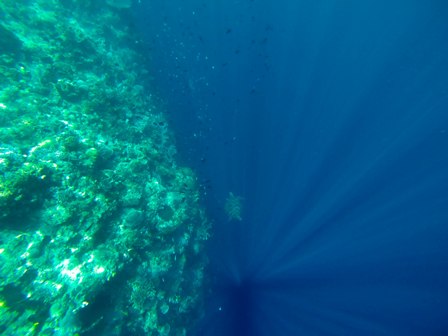 Photo courtesy of Aga Kozmic Gourmand Guide[/caption]
Fringing reef from Bunaken Island extends almost 500 metres to a very deep channel, some 1,566 metres in fact. Snorkelling over the abyss I could feel cold water upwelling beneath my sunburnt back. No wonder large pelagic fish, whales, turtles and rays hang out around Bunaken. Cold deep water means lots of fish food. Seven of the world’s eight species of giant clam live around Bunaken while the park boasts at least 70% of all known fish species of the Indo-Pacific. Coral species are manifold in abundance with Bunaken claiming to have seven times more genera of coral than all of Hawaii.
[caption id="attachment_3765" align="alignnone" width="448"]
Photo courtesy of Aga Kozmic Gourmand Guide[/caption]
Fringing reef from Bunaken Island extends almost 500 metres to a very deep channel, some 1,566 metres in fact. Snorkelling over the abyss I could feel cold water upwelling beneath my sunburnt back. No wonder large pelagic fish, whales, turtles and rays hang out around Bunaken. Cold deep water means lots of fish food. Seven of the world’s eight species of giant clam live around Bunaken while the park boasts at least 70% of all known fish species of the Indo-Pacific. Coral species are manifold in abundance with Bunaken claiming to have seven times more genera of coral than all of Hawaii.
[caption id="attachment_3765" align="alignnone" width="448"] Sam snorkelling at Bunaken photo courtesy of Aga Kozmic Gourmand Guide[/caption]
Bunaken Marine National Park lies approximately ten kilometres offshore from Manado. Boats to Bunaken leave from the funky little Dermaga Marina Plaza near central Manado. Major hotels in Manado can arrange boat transfers to Bunaken for day trips if the island’s small assortment of basic resorts doesn’t appeal.
[caption id="attachment_3766" align="alignnone" width="408"]
Sam snorkelling at Bunaken photo courtesy of Aga Kozmic Gourmand Guide[/caption]
Bunaken Marine National Park lies approximately ten kilometres offshore from Manado. Boats to Bunaken leave from the funky little Dermaga Marina Plaza near central Manado. Major hotels in Manado can arrange boat transfers to Bunaken for day trips if the island’s small assortment of basic resorts doesn’t appeal.
[caption id="attachment_3766" align="alignnone" width="408"] Snorkeling boat off Bunaken photo courtesy of Aga Kozmic Gourmand Guide[/caption]
Check out the pirate guarding the entrance to a very out-of-place and empty tourist restaurant at the marina. Minahasan were formidable pirates in their heyday but this replica looks more like a Jamaican rum swizzling Captain Hook than a Minahasan vagabond.
[caption id="attachment_3767" align="alignnone" width="357"]
Snorkeling boat off Bunaken photo courtesy of Aga Kozmic Gourmand Guide[/caption]
Check out the pirate guarding the entrance to a very out-of-place and empty tourist restaurant at the marina. Minahasan were formidable pirates in their heyday but this replica looks more like a Jamaican rum swizzling Captain Hook than a Minahasan vagabond.
[caption id="attachment_3767" align="alignnone" width="357"] Pirate in front of marina restaurant Manado[/caption]
Volcanic highlands surrounding town include Indonesia’s third largest lake, the wonderfully picturesque Lake Tondano with nearby villages still strong in Minahasan culture including historic ‘Waruga’ stone graves built above ground and strangely similar to the vault crypts of New Orleans.
[caption id="attachment_3768" align="alignnone" width="374"]
Pirate in front of marina restaurant Manado[/caption]
Volcanic highlands surrounding town include Indonesia’s third largest lake, the wonderfully picturesque Lake Tondano with nearby villages still strong in Minahasan culture including historic ‘Waruga’ stone graves built above ground and strangely similar to the vault crypts of New Orleans.
[caption id="attachment_3768" align="alignnone" width="374"]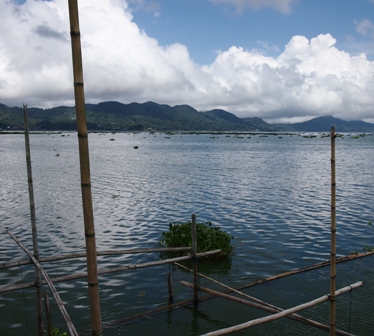 Lake Tonando[/caption]
Lake Tondano lies approximately 600 metres above sea level, slightly less steamy than sweltering Manado. A few fish restaurants line the lakeshore, clearly providing a favourite day trip destination for hungry locals. Lunch at Astomi Restaurant was very good.
[caption id="attachment_3773" align="alignnone" width="280"]
Lake Tonando[/caption]
Lake Tondano lies approximately 600 metres above sea level, slightly less steamy than sweltering Manado. A few fish restaurants line the lakeshore, clearly providing a favourite day trip destination for hungry locals. Lunch at Astomi Restaurant was very good.
[caption id="attachment_3773" align="alignnone" width="280"]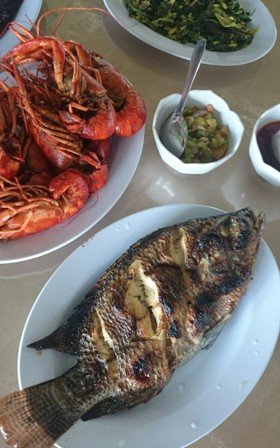 Lunch at Astomi restaurant[/caption]
[caption id="attachment_3826" align="alignnone" width="448"]
Lunch at Astomi restaurant[/caption]
[caption id="attachment_3826" align="alignnone" width="448"]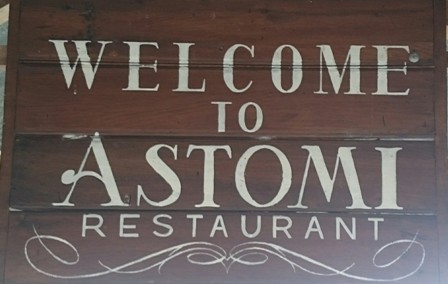 Astomi Restaurant on Lake Tonando[/caption]
The mountains and hills encompassing the lake create a lush atmosphere, imbuing a desire to linger. I wish I’d had more time there to simply relax.
[caption id="attachment_3769" align="alignnone" width="390"]
Astomi Restaurant on Lake Tonando[/caption]
The mountains and hills encompassing the lake create a lush atmosphere, imbuing a desire to linger. I wish I’d had more time there to simply relax.
[caption id="attachment_3769" align="alignnone" width="390"]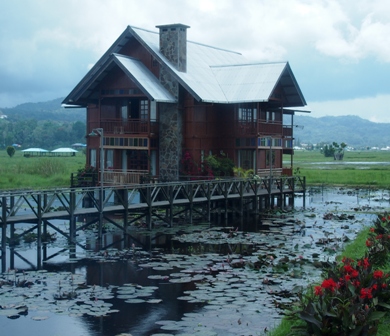 Lake Tonando house[/caption]
The ‘Waruga’ stone graves at Taman Purbakala Waruga-Waruga was designated a UNESCO World Heritage Site in 1995. Of all the UNESCO World Heritage Sites I have visited, this was the least touristy.
[caption id="attachment_3770" align="alignnone" width="448"]
Lake Tonando house[/caption]
The ‘Waruga’ stone graves at Taman Purbakala Waruga-Waruga was designated a UNESCO World Heritage Site in 1995. Of all the UNESCO World Heritage Sites I have visited, this was the least touristy.
[caption id="attachment_3770" align="alignnone" width="448"]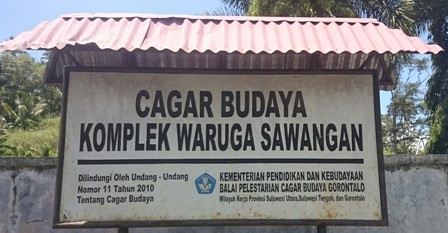 Waruga tombs sign[/caption]
Signage is minimal. It’s not easy to find. A single local guide is occasionally available to show visitors around the cemetery, the majority of whose graves were moved from other locations for preservation.
[caption id="attachment_3771" align="alignnone" width="394"]
Waruga tombs sign[/caption]
Signage is minimal. It’s not easy to find. A single local guide is occasionally available to show visitors around the cemetery, the majority of whose graves were moved from other locations for preservation.
[caption id="attachment_3771" align="alignnone" width="394"]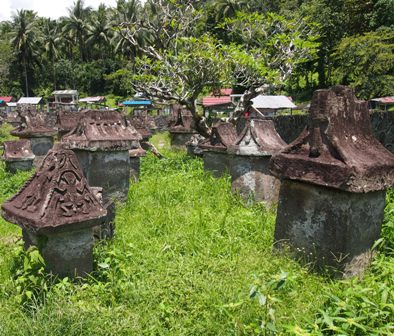 Waruga tombs[/caption]
‘Waruga’ graves look like stone boxes, upright and surprisingly narrow. Bodies were interred in a seated position always facing north as the belief was that Minahasan ancestors came to Manado from the north, perhaps the Philippines or beyond.
[caption id="attachment_3772" align="alignnone" width="366"]
Waruga tombs[/caption]
‘Waruga’ graves look like stone boxes, upright and surprisingly narrow. Bodies were interred in a seated position always facing north as the belief was that Minahasan ancestors came to Manado from the north, perhaps the Philippines or beyond.
[caption id="attachment_3772" align="alignnone" width="366"] Local kids at Waruga tombs site[/caption]
Crammed into the smallish hot boxes, men’s arms were crossed at the chest while women’s were folded with hands facing out, representative of traditional roles men and women played in Minahasan society. Bodies decayed rapidly in the harsh tropical sunlight but intricate carvings on each ‘Waruga’ tomb served to remind friends and relatives of the long-cooked deceased.
[caption id="attachment_3827" align="alignnone" width="411"]
Local kids at Waruga tombs site[/caption]
Crammed into the smallish hot boxes, men’s arms were crossed at the chest while women’s were folded with hands facing out, representative of traditional roles men and women played in Minahasan society. Bodies decayed rapidly in the harsh tropical sunlight but intricate carvings on each ‘Waruga’ tomb served to remind friends and relatives of the long-cooked deceased.
[caption id="attachment_3827" align="alignnone" width="411"] Spanish Waruga tombs[/caption]
Curiously there are a number of Portuguese and Spanish ‘Waruga’ graves amongst the Minahasan. The Dutch banned ‘Waruga’ graves in 1828, plenty of time before then for earlier Portuguese and Spanish colonists to adopt the local tradition.
[caption id="attachment_3774" align="alignnone" width="448"]
Spanish Waruga tombs[/caption]
Curiously there are a number of Portuguese and Spanish ‘Waruga’ graves amongst the Minahasan. The Dutch banned ‘Waruga’ graves in 1828, plenty of time before then for earlier Portuguese and Spanish colonists to adopt the local tradition.
[caption id="attachment_3774" align="alignnone" width="448"]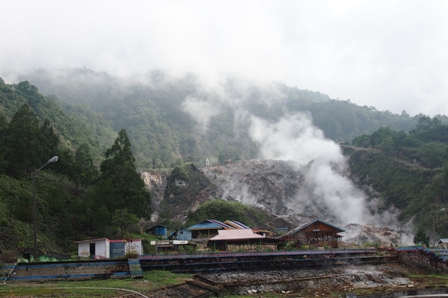 Hill of Love[/caption]
Not far from Lake Tonando is the kitsch Bukit Kasih ‘Hill of Love’, 2,435 steps over sulphur rotten egg-stinking vents to a hill overlooking lush volcanic plains below. Established as a kind of goodwill place espousing peace for all religious persuasions (namely Islam, Catholicism, Protestantism, Buddhism, Hinduism), the effect was marred by at least a dozen hucksters forcing photo opportunities with owls on unsuspecting visitors.
The owls are illegally trapped in the wild. The group I was with expressed abhorrence but I viewed a number of Indonesian tourists happily posing for silly selfies with a tied-up owl perched on their shoulders.
[caption id="attachment_3775" align="alignnone" width="185"]
Hill of Love[/caption]
Not far from Lake Tonando is the kitsch Bukit Kasih ‘Hill of Love’, 2,435 steps over sulphur rotten egg-stinking vents to a hill overlooking lush volcanic plains below. Established as a kind of goodwill place espousing peace for all religious persuasions (namely Islam, Catholicism, Protestantism, Buddhism, Hinduism), the effect was marred by at least a dozen hucksters forcing photo opportunities with owls on unsuspecting visitors.
The owls are illegally trapped in the wild. The group I was with expressed abhorrence but I viewed a number of Indonesian tourists happily posing for silly selfies with a tied-up owl perched on their shoulders.
[caption id="attachment_3775" align="alignnone" width="185"]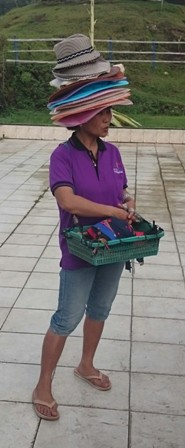 Hill of Love hat seller[/caption]
This represents another incidence of cultural difference as respect for animals and the environment isn’t yet a universal sentiment in Indonesia. On that note, the amount of plastic rubbish littering what are at first glance paradisiacal beaches is equally upsetting. After China, Indonesia is responsible for the greatest amount of plastic rubbish polluting our oceans. A sad fact that is inescapably obvious even somewhere as relatively unvisited as North Sulawesi.
Tangkoko National Park is home to two endangered primates that are surprisingly easy to spot when accompanied by an expert guide. If you want to get up close and personal with one of the world’s smallest monkeys, the Tarsier, or follow a troupe of Crested Black Macaques through jungle to a remote black sand beach, this is the place.
[caption id="attachment_3776" align="alignnone" width="448"]
Hill of Love hat seller[/caption]
This represents another incidence of cultural difference as respect for animals and the environment isn’t yet a universal sentiment in Indonesia. On that note, the amount of plastic rubbish littering what are at first glance paradisiacal beaches is equally upsetting. After China, Indonesia is responsible for the greatest amount of plastic rubbish polluting our oceans. A sad fact that is inescapably obvious even somewhere as relatively unvisited as North Sulawesi.
Tangkoko National Park is home to two endangered primates that are surprisingly easy to spot when accompanied by an expert guide. If you want to get up close and personal with one of the world’s smallest monkeys, the Tarsier, or follow a troupe of Crested Black Macaques through jungle to a remote black sand beach, this is the place.
[caption id="attachment_3776" align="alignnone" width="448"]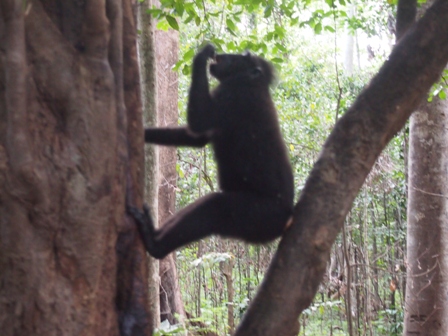 Crested Black Macaque drinking[/caption]
The park is located on the southern side of the peninsula opposite Manado (approximately two hours drive over steep and narrow mountain roads) and represents a good news story about the preservation of two endangered indigenous species.
[caption id="attachment_3777" align="alignnone" width="448"]
Crested Black Macaque drinking[/caption]
The park is located on the southern side of the peninsula opposite Manado (approximately two hours drive over steep and narrow mountain roads) and represents a good news story about the preservation of two endangered indigenous species.
[caption id="attachment_3777" align="alignnone" width="448"]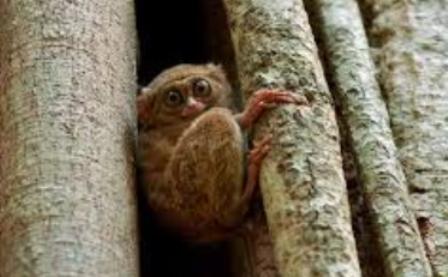 Tarsier in a tree hollow[/caption]
Tarsiers are small and cute. For that, they are often snared from forests to keep as house pets. Crested Black Macaques are larger primates with sharp teeth and aggressive body language. Be wary of approaching macaques, don’t touch; they bite and rabies is a problem. Consequently they haven’t gained local acceptance as house pets like Tarsiers but they do occasionally appear on butcher’s blocks in Manado’s central market as ‘bush meat’. The Minahasan have a reputation for eating everything but the table leg and local wildlife suffers for ignorant appetites.
[caption id="attachment_3778" align="alignnone" width="336"]
Tarsier in a tree hollow[/caption]
Tarsiers are small and cute. For that, they are often snared from forests to keep as house pets. Crested Black Macaques are larger primates with sharp teeth and aggressive body language. Be wary of approaching macaques, don’t touch; they bite and rabies is a problem. Consequently they haven’t gained local acceptance as house pets like Tarsiers but they do occasionally appear on butcher’s blocks in Manado’s central market as ‘bush meat’. The Minahasan have a reputation for eating everything but the table leg and local wildlife suffers for ignorant appetites.
[caption id="attachment_3778" align="alignnone" width="336"]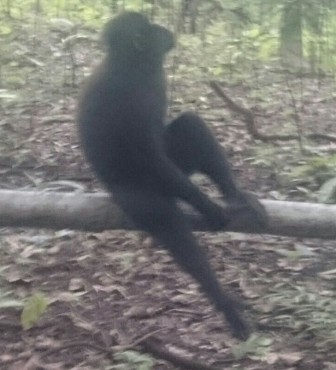 Crested Black Macaque out on a limb[/caption]
Tangkoko National Park may be small but it’s densely forested, fairly well protected from poachers and supports a few thriving troupes of Crested Black Macaques. I thought my chance of spotting one in the wild was akin to winning second prize in a beauty contest but was delighted to wander amongst a troupe of at least 30 macaques while they foraged in the jungle’s gloaming light.
[caption id="attachment_3779" align="alignnone" width="448"]
Crested Black Macaque out on a limb[/caption]
Tangkoko National Park may be small but it’s densely forested, fairly well protected from poachers and supports a few thriving troupes of Crested Black Macaques. I thought my chance of spotting one in the wild was akin to winning second prize in a beauty contest but was delighted to wander amongst a troupe of at least 30 macaques while they foraged in the jungle’s gloaming light.
[caption id="attachment_3779" align="alignnone" width="448"] Tarsier[/caption]
A Tarsier on the other hand is mostly nocturnal (those huge eyes can easily spot moths, small lizards and other insects) and is about as easy to find as a green needle in the rainforest. Luckily our guide had found one earlier, remembered its location where its tiny brown body was wedged in a slim brown cleft in a narrow brown tree limb which took me at least ten minutes to spot while I was looking at a different tree limb above the one he indicated.
Tangkoko also supports a stable population of reptiles, reticulated pythons and green vipers included; something to remember while traipsing around the jungle in dim moonlight. Mosquitoes also thrive in Tangkoko’s humid climate. Remember to bring repellent. Birdlife is abundant. Two species of hornbills live in Tangkoko, spectacularly impressive birds whose presence accounts for much of Sulawesi’s inbound tourism; it’s a twitcher’s dream destination.
[caption id="attachment_3780" align="alignnone" width="448"]
Tarsier[/caption]
A Tarsier on the other hand is mostly nocturnal (those huge eyes can easily spot moths, small lizards and other insects) and is about as easy to find as a green needle in the rainforest. Luckily our guide had found one earlier, remembered its location where its tiny brown body was wedged in a slim brown cleft in a narrow brown tree limb which took me at least ten minutes to spot while I was looking at a different tree limb above the one he indicated.
Tangkoko also supports a stable population of reptiles, reticulated pythons and green vipers included; something to remember while traipsing around the jungle in dim moonlight. Mosquitoes also thrive in Tangkoko’s humid climate. Remember to bring repellent. Birdlife is abundant. Two species of hornbills live in Tangkoko, spectacularly impressive birds whose presence accounts for much of Sulawesi’s inbound tourism; it’s a twitcher’s dream destination.
[caption id="attachment_3780" align="alignnone" width="448"]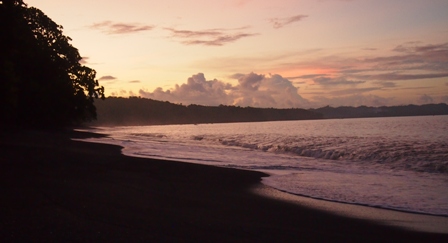 Sunset on Tangkoko's black sand beach[/caption]
Contact local guide Noldi Kakauhe for individual tours around Tangkoko and other national parks in Sulawesi. He’s a wildlife expert, experienced naturalist, speaks good English and a nice guy: info@endemic-tours.com or noldikakauhe@gmail.com
Palu
The capital of Central Sulawesi, Palu is a small city stretched out along Palu Bay, a long indentation into Sulawesi’s high mountains.
[caption id="attachment_3800" align="alignnone" width="263"]
Sunset on Tangkoko's black sand beach[/caption]
Contact local guide Noldi Kakauhe for individual tours around Tangkoko and other national parks in Sulawesi. He’s a wildlife expert, experienced naturalist, speaks good English and a nice guy: info@endemic-tours.com or noldikakauhe@gmail.com
Palu
The capital of Central Sulawesi, Palu is a small city stretched out along Palu Bay, a long indentation into Sulawesi’s high mountains.
[caption id="attachment_3800" align="alignnone" width="263"]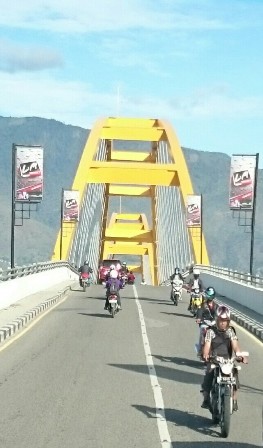 Palu bridge[/caption]
[caption id="attachment_3801" align="alignnone" width="448"]
Palu bridge[/caption]
[caption id="attachment_3801" align="alignnone" width="448"]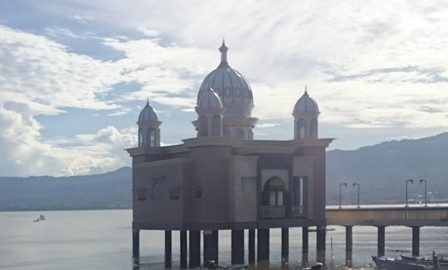 Palu waterfront mosque[/caption]
We flew from Manado to Palu via Luwuk with Wings Air, a division of Lion Air (www.lionairplus.com), on a twin prop ATR-47. Wings and Lion do not have the best reputation for safety. Currently all Lion Air flights (including another subsidiary Batik Air) are banned from flying to Australia and Europe due to insufficient adherence to aircraft maintenance, pilot training and overall safety standards. When flying around Sulawesi, Maluku and West Papua, Garuda’s superior domestic flights aren’t always available... unfortunately. Try avoiding bad weather and night flights if Lion and Wings are your only choice.
[caption id="attachment_3781" align="alignnone" width="448"]
Palu waterfront mosque[/caption]
We flew from Manado to Palu via Luwuk with Wings Air, a division of Lion Air (www.lionairplus.com), on a twin prop ATR-47. Wings and Lion do not have the best reputation for safety. Currently all Lion Air flights (including another subsidiary Batik Air) are banned from flying to Australia and Europe due to insufficient adherence to aircraft maintenance, pilot training and overall safety standards. When flying around Sulawesi, Maluku and West Papua, Garuda’s superior domestic flights aren’t always available... unfortunately. Try avoiding bad weather and night flights if Lion and Wings are your only choice.
[caption id="attachment_3781" align="alignnone" width="448"] Wings landed in Palu[/caption]
My Wings Air flights were fairly uneventful despite a 5 hour delay in Manado and an overwhelming stink of cigarette smoke in the cabin.
[caption id="attachment_3786" align="alignnone" width="448"]
Wings landed in Palu[/caption]
My Wings Air flights were fairly uneventful despite a 5 hour delay in Manado and an overwhelming stink of cigarette smoke in the cabin.
[caption id="attachment_3786" align="alignnone" width="448"]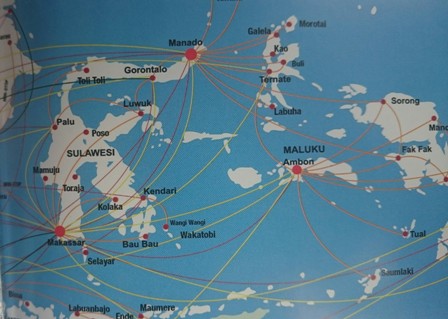 Wings Air route map[/caption]
I like Palu. Compared to traffic congested Manado, it seemed laid-back and friendlier as a consequence.
[caption id="attachment_3782" align="alignnone" width="448"]
Wings Air route map[/caption]
I like Palu. Compared to traffic congested Manado, it seemed laid-back and friendlier as a consequence.
[caption id="attachment_3782" align="alignnone" width="448"]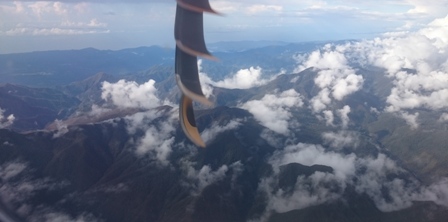 Flying with Wings over Sulawesi[/caption]
There’s nothing of any great import to see in Palu apart from a modern bridge across the bay, surely a compelling reason to visit as touristy towns are so often disappointing with their crowds of babbling bucket-listers posing for more selfies.
[caption id="attachment_3783" align="alignnone" width="448"]
Flying with Wings over Sulawesi[/caption]
There’s nothing of any great import to see in Palu apart from a modern bridge across the bay, surely a compelling reason to visit as touristy towns are so often disappointing with their crowds of babbling bucket-listers posing for more selfies.
[caption id="attachment_3783" align="alignnone" width="448"]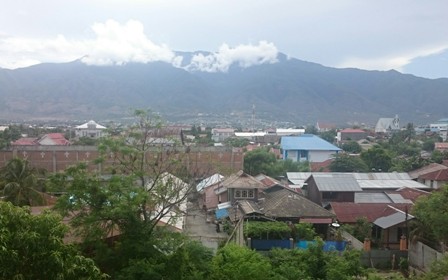 Palu overview[/caption]
[caption id="attachment_3802" align="alignnone" width="412"]
Palu overview[/caption]
[caption id="attachment_3802" align="alignnone" width="412"]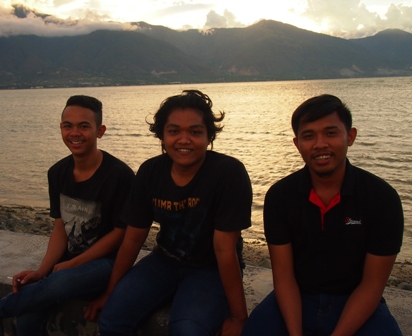 Palu Bay Sunset with the locals[/caption]
At the mouth of Palu Bay is Tanjung Karang beach. Waters offshore descend to over 400 metres, creating similar diving conditions to those around Bunaken.
[caption id="attachment_3785" align="alignnone" width="358"]
Palu Bay Sunset with the locals[/caption]
At the mouth of Palu Bay is Tanjung Karang beach. Waters offshore descend to over 400 metres, creating similar diving conditions to those around Bunaken.
[caption id="attachment_3785" align="alignnone" width="358"]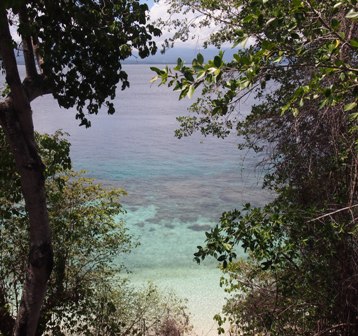 View from a Prince John Resort villa[/caption]
A wonderful afternoon was spent at the Prince John Dive Resort, a German-Indonesian owned and managed small beach-side hotel that was easily the best accommodation I visited during this recent Indonesian visit. It’s the one place I could happily have stayed four or five days: diving, snorkelling, beach-combing, wandering into nearby Donggala town for market shopping and mixing with local people and imbibing the occasional Bintang or Arak mixture. (See www.prince-john-dive-resort.com). The resort manager Alexander Franz is clearly passionate about the environment and his lovely little resort. Working with local schools organising beach clean-up crews, he’s putting his energy into local education and supporting employment amongst villagers interested in protecting a special place.
[caption id="attachment_3787" align="alignnone" width="448"]
View from a Prince John Resort villa[/caption]
A wonderful afternoon was spent at the Prince John Dive Resort, a German-Indonesian owned and managed small beach-side hotel that was easily the best accommodation I visited during this recent Indonesian visit. It’s the one place I could happily have stayed four or five days: diving, snorkelling, beach-combing, wandering into nearby Donggala town for market shopping and mixing with local people and imbibing the occasional Bintang or Arak mixture. (See www.prince-john-dive-resort.com). The resort manager Alexander Franz is clearly passionate about the environment and his lovely little resort. Working with local schools organising beach clean-up crews, he’s putting his energy into local education and supporting employment amongst villagers interested in protecting a special place.
[caption id="attachment_3787" align="alignnone" width="448"]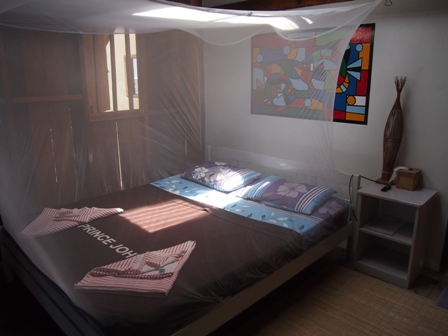 Prince John Dive Resort bedroom[/caption]
Makassar
It’s Sulawesi’s biggest city with over 1.3 million inhabitants. Anyone flying from Jakarta or Bali to destinations in North or South Maluku or West Papua will inevitably make a flight connection or stopover in Makassar.
Arriving at night, it looks like just another crowded congested dirty SE Asian city.
Daylight arrival shows a different side. Makassar occupies an intensely farmed plain edged by sugar-cone shaped forested mountains. Had I more time, a day trip to those mountains would no doubt have provided more informative editorial.
The Bugis people dominate Makassar’s history. Seafaring experts like their Minahasan neighbours to the north, the Bugis have always been adventurers, sailing throughout the archipelago in search of new trade routes and goods to sell or buy.
Makassar has been an important port city for centuries.
[caption id="attachment_3788" align="alignnone" width="448"]
Prince John Dive Resort bedroom[/caption]
Makassar
It’s Sulawesi’s biggest city with over 1.3 million inhabitants. Anyone flying from Jakarta or Bali to destinations in North or South Maluku or West Papua will inevitably make a flight connection or stopover in Makassar.
Arriving at night, it looks like just another crowded congested dirty SE Asian city.
Daylight arrival shows a different side. Makassar occupies an intensely farmed plain edged by sugar-cone shaped forested mountains. Had I more time, a day trip to those mountains would no doubt have provided more informative editorial.
The Bugis people dominate Makassar’s history. Seafaring experts like their Minahasan neighbours to the north, the Bugis have always been adventurers, sailing throughout the archipelago in search of new trade routes and goods to sell or buy.
Makassar has been an important port city for centuries.
[caption id="attachment_3788" align="alignnone" width="448"]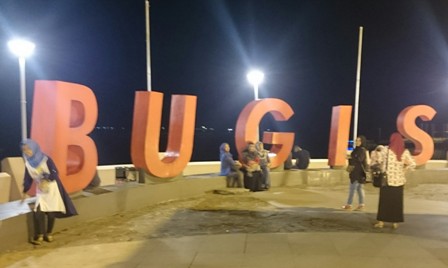 Bugis sign Makassar waterfront[/caption]
Unfortunately, I spent a short night in Makassar between flights, time enough to stroll along the waterfront and to check out what is purportedly the world’s longest restaurant. An extensive line-up of waterfront street stalls selling fried pisang (bananas) with peanut sauce or cheese or chillis seemed the most popular go-to snack. Satay warung, ayam barbecue joints, ikan grills, nasi or mee goreng stands... the whole gamut of popular Indonesian snack food is available, cheap as chips too.
Ambon
[caption id="attachment_3799" align="alignnone" width="336"]
Bugis sign Makassar waterfront[/caption]
Unfortunately, I spent a short night in Makassar between flights, time enough to stroll along the waterfront and to check out what is purportedly the world’s longest restaurant. An extensive line-up of waterfront street stalls selling fried pisang (bananas) with peanut sauce or cheese or chillis seemed the most popular go-to snack. Satay warung, ayam barbecue joints, ikan grills, nasi or mee goreng stands... the whole gamut of popular Indonesian snack food is available, cheap as chips too.
Ambon
[caption id="attachment_3799" align="alignnone" width="336"] Motorcyclist Ambon[/caption]
The flight between Makassar and Ambon is about 90 minutes yet a world of difference lies in the transit.
Garuda has daily flights from Jakarta and Bali to Ambon via Makassar.
Naked Tip: A reliable local tourism source in Ambon told me that Garuda flights between Darwin and Ambon are scheduled to commence sometime in late 2016 or early 2017.
When arriving in Maluku the Wallace Line separating Asian and Australian flora and fauna is crossed, though some Australian species such as cus-cus (a type of tree kangaroo) inhabit both sides of the line.
In Ambon, Indonesia melds into Melanesia.
Islam mingles noticeably with Christianity as both churches and mosques are scattered around the islands.
The historic Dutch influence remains strongly apparent.
Most importantly the aroma of spice pervades the air.
Maluku (Molucca Islands) is the original home of clove, mace and nutmeg. In the 17th century Dutch colonists subjugated ‘the natives’, forcing them into slavery to work their plantations, stealing their land and as a consequence fomenting a nascent Indonesian identity.
The Dutch East India Company was formed in 1602 to protect Dutch national interests, therefore instituting a monopoly on the fabulous riches derived from slave labour.
Dutch hegemony over the cash-cow Spice Islands lasted until 1799 when Napoleon broke up historic European associations. The Dutch subsequently acceded power to the British and French as competitors for rampant colonialism in SE Asia.
[caption id="attachment_3789" align="alignnone" width="448"]
Motorcyclist Ambon[/caption]
The flight between Makassar and Ambon is about 90 minutes yet a world of difference lies in the transit.
Garuda has daily flights from Jakarta and Bali to Ambon via Makassar.
Naked Tip: A reliable local tourism source in Ambon told me that Garuda flights between Darwin and Ambon are scheduled to commence sometime in late 2016 or early 2017.
When arriving in Maluku the Wallace Line separating Asian and Australian flora and fauna is crossed, though some Australian species such as cus-cus (a type of tree kangaroo) inhabit both sides of the line.
In Ambon, Indonesia melds into Melanesia.
Islam mingles noticeably with Christianity as both churches and mosques are scattered around the islands.
The historic Dutch influence remains strongly apparent.
Most importantly the aroma of spice pervades the air.
Maluku (Molucca Islands) is the original home of clove, mace and nutmeg. In the 17th century Dutch colonists subjugated ‘the natives’, forcing them into slavery to work their plantations, stealing their land and as a consequence fomenting a nascent Indonesian identity.
The Dutch East India Company was formed in 1602 to protect Dutch national interests, therefore instituting a monopoly on the fabulous riches derived from slave labour.
Dutch hegemony over the cash-cow Spice Islands lasted until 1799 when Napoleon broke up historic European associations. The Dutch subsequently acceded power to the British and French as competitors for rampant colonialism in SE Asia.
[caption id="attachment_3789" align="alignnone" width="448"]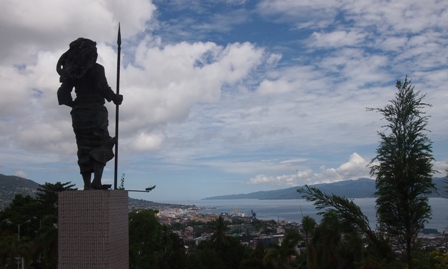 Martha Christina Tiahahu statue overlooking Ambon[/caption]
Overlooking central Ambon is an impressive statue of Martha Christina Tiahahu. Aged 17 she led fights for freedom and independence against the Dutch in the early 19th century. She was also a follower of Kapitan Pattimura, who was born on nearby Saparua Island. He is another Indonesian national independence hero who was hanged by the Dutch in 16 December 1817 aged 34. Pattimura’s daughter continued to fight against the Dutch when she was only 16.
[caption id="attachment_3790" align="alignnone" width="448"]
Martha Christina Tiahahu statue overlooking Ambon[/caption]
Overlooking central Ambon is an impressive statue of Martha Christina Tiahahu. Aged 17 she led fights for freedom and independence against the Dutch in the early 19th century. She was also a follower of Kapitan Pattimura, who was born on nearby Saparua Island. He is another Indonesian national independence hero who was hanged by the Dutch in 16 December 1817 aged 34. Pattimura’s daughter continued to fight against the Dutch when she was only 16.
[caption id="attachment_3790" align="alignnone" width="448"]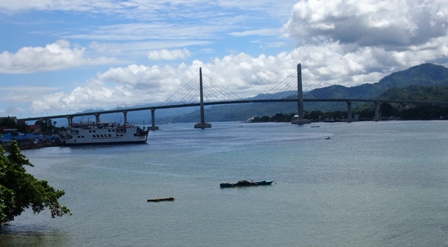 New bridge connecting Ambon[/caption]
The spirit of independence burns brightly in Maluku.
From 1999 until about 2006 internecine fighting between Muslims and Christians claimed over 5,000 lives while thousands more were moved from Ambon to other islands away from the worst of the slaughter. Historic allegiances amongst family groups accounted for much of the anger. Land grabs and unfair distribution of resources were claimed as the main reasons behind the fighting. The army and police maintain a visible presence in Ambon.
Today Ambon is a calm small city on a big bay, sleepy in appearance, well-kept and surprisingly inviting.
I shared a special greeting given by Sahureka-reka dancers from a local school at Namalatu beach, about twenty kilometres southwest of Ambon. Sahureka-reka dance is representative of sharing between communities: fish from the ocean, crops from inland i.e. Muslims and Christians living in harmony.
[caption id="attachment_3791" align="alignnone" width="448"]
New bridge connecting Ambon[/caption]
The spirit of independence burns brightly in Maluku.
From 1999 until about 2006 internecine fighting between Muslims and Christians claimed over 5,000 lives while thousands more were moved from Ambon to other islands away from the worst of the slaughter. Historic allegiances amongst family groups accounted for much of the anger. Land grabs and unfair distribution of resources were claimed as the main reasons behind the fighting. The army and police maintain a visible presence in Ambon.
Today Ambon is a calm small city on a big bay, sleepy in appearance, well-kept and surprisingly inviting.
I shared a special greeting given by Sahureka-reka dancers from a local school at Namalatu beach, about twenty kilometres southwest of Ambon. Sahureka-reka dance is representative of sharing between communities: fish from the ocean, crops from inland i.e. Muslims and Christians living in harmony.
[caption id="attachment_3791" align="alignnone" width="448"]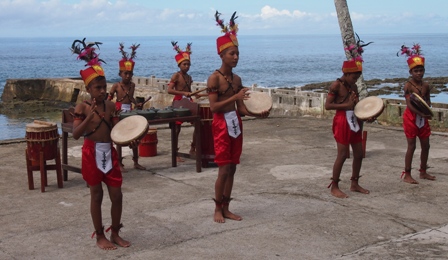 Dancers at Namalatu beach[/caption]
[caption id="attachment_3792" align="alignnone" width="448"]
Dancers at Namalatu beach[/caption]
[caption id="attachment_3792" align="alignnone" width="448"]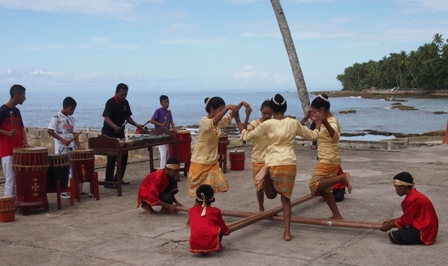 Reka dancers[/caption]
The Australian War Memorial cemetery in Ambon evokes strong emotions of young lives wasted in an exceptionally cruel war.
[caption id="attachment_3794" align="alignnone" width="429"]
Reka dancers[/caption]
The Australian War Memorial cemetery in Ambon evokes strong emotions of young lives wasted in an exceptionally cruel war.
[caption id="attachment_3794" align="alignnone" width="429"] War cemetery and park in Ambon[/caption]
The huge trees shading the graves provided cooling relief, a place to linger and think about mankind’s continuous failure to remember the past while doomed to repeat his mistakes.
[caption id="attachment_3793" align="alignnone" width="366"]
War cemetery and park in Ambon[/caption]
The huge trees shading the graves provided cooling relief, a place to linger and think about mankind’s continuous failure to remember the past while doomed to repeat his mistakes.
[caption id="attachment_3793" align="alignnone" width="366"]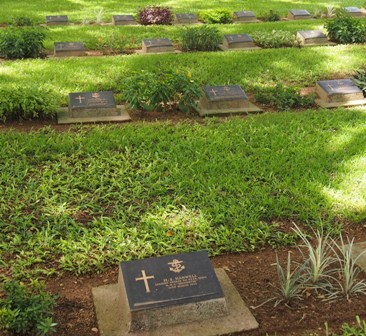 Graves at War Cemetery Ambon[/caption]
In central Ambon is a traffic circle surrounding a plaza and hill topped with a large and brightly painted gong. Decorated with flags from round the world, the gong espouses universal tenets of peace and justice. The ‘Gong of Peace’ hangs from a highly decorated metal and wooden stand. The meaning behind this emblem is clear: live and let live.
[caption id="attachment_3795" align="alignnone" width="415"]
Graves at War Cemetery Ambon[/caption]
In central Ambon is a traffic circle surrounding a plaza and hill topped with a large and brightly painted gong. Decorated with flags from round the world, the gong espouses universal tenets of peace and justice. The ‘Gong of Peace’ hangs from a highly decorated metal and wooden stand. The meaning behind this emblem is clear: live and let live.
[caption id="attachment_3795" align="alignnone" width="415"]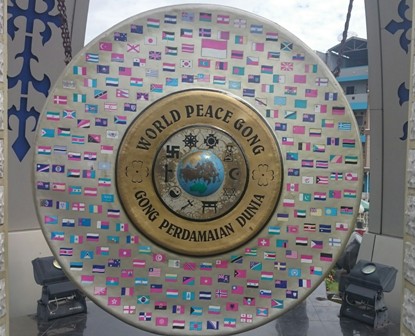 World Peace Gong Ambon[/caption]
[caption id="attachment_3796" align="alignnone" width="247"]
World Peace Gong Ambon[/caption]
[caption id="attachment_3796" align="alignnone" width="247"] School kids at World Peace Gong plaza[/caption]
Hunimua beach across Ambon Island from Ambon city is a favourite with the locals. It’s a nice place to idle away the hours swimming and chatting with friendly locals.
[caption id="attachment_3798" align="alignnone" width="448"]
School kids at World Peace Gong plaza[/caption]
Hunimua beach across Ambon Island from Ambon city is a favourite with the locals. It’s a nice place to idle away the hours swimming and chatting with friendly locals.
[caption id="attachment_3798" align="alignnone" width="448"]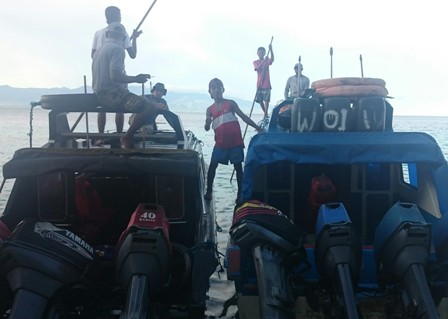 Boat crews at Hunimua beach Ambon[/caption]
At Hunimua beach, we were treated to an impromptu ‘crazy bamboo’ (Gili Bambu) dance performance. Not quite a performance nor a dance, ‘crazy bamboo’ dance consists of eight or more men running in circles with a large bamboo log grasped in their arms trying to dump fellow dancers all the while staying clear of a pyromaniac brandishing a burning torch.
[caption id="attachment_3797" align="alignnone" width="386"]
Boat crews at Hunimua beach Ambon[/caption]
At Hunimua beach, we were treated to an impromptu ‘crazy bamboo’ (Gili Bambu) dance performance. Not quite a performance nor a dance, ‘crazy bamboo’ dance consists of eight or more men running in circles with a large bamboo log grasped in their arms trying to dump fellow dancers all the while staying clear of a pyromaniac brandishing a burning torch.
[caption id="attachment_3797" align="alignnone" width="386"]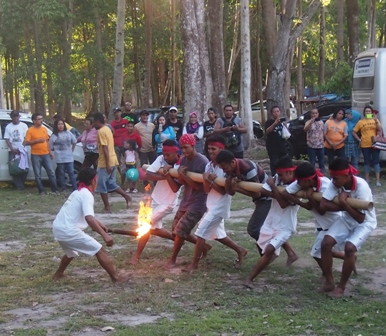 Crazy bamboo dance[/caption]
I have no idea what the rules are (neither apparently did the participants) and the dance served no obvious purpose but it was fun to watch. Drinking lots of cold Bintang seemed to help in understanding what the fuss was all about.
[caption id="attachment_3803" align="alignnone" width="240"]
Crazy bamboo dance[/caption]
I have no idea what the rules are (neither apparently did the participants) and the dance served no obvious purpose but it was fun to watch. Drinking lots of cold Bintang seemed to help in understanding what the fuss was all about.
[caption id="attachment_3803" align="alignnone" width="240"]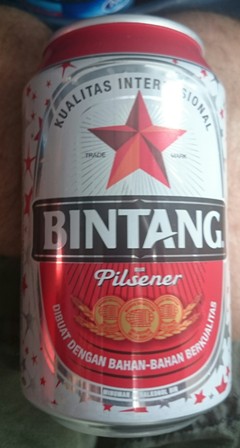 Cold Bintang, a lifesaver during torrid days in Maluku[/caption]
Saparua
Approximately 40 kilometres east of Ambon is Saparua Island.
90 minutes by fast boat (or more if the boat breaks down because of motor trouble or propellers becoming tangled in plastic rubbish, both of which happened to our two small boats), Saparua is indeed off the beaten track.
[caption id="attachment_3805" align="alignnone" width="448"]
Cold Bintang, a lifesaver during torrid days in Maluku[/caption]
Saparua
Approximately 40 kilometres east of Ambon is Saparua Island.
90 minutes by fast boat (or more if the boat breaks down because of motor trouble or propellers becoming tangled in plastic rubbish, both of which happened to our two small boats), Saparua is indeed off the beaten track.
[caption id="attachment_3805" align="alignnone" width="448"] Village seen from boat between Ambon and Saparua[/caption]
[caption id="attachment_3806" align="alignnone" width="448"]
Village seen from boat between Ambon and Saparua[/caption]
[caption id="attachment_3806" align="alignnone" width="448"]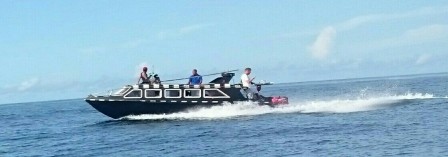 Ambon to Saparua on the 'fast boat'[/caption]
The Dutch heavily fortified the island to protect their lucrative spice trade. The ruins of Duur Stede Fort serve as a reminder of how important the rivers of gold from nutmeg and clove were to the Dutch East India Company. Mercenaries were hired to keep the natives in line, imprisoning the recalcitrant or hanging the most resistant to Dutch rule. (Fans of Frank Herbert’s ‘Dune’ novels will undoubtedly see an allegory: Let the Spice Flow!)
[caption id="attachment_3804" align="alignnone" width="448"]
Ambon to Saparua on the 'fast boat'[/caption]
The Dutch heavily fortified the island to protect their lucrative spice trade. The ruins of Duur Stede Fort serve as a reminder of how important the rivers of gold from nutmeg and clove were to the Dutch East India Company. Mercenaries were hired to keep the natives in line, imprisoning the recalcitrant or hanging the most resistant to Dutch rule. (Fans of Frank Herbert’s ‘Dune’ novels will undoubtedly see an allegory: Let the Spice Flow!)
[caption id="attachment_3804" align="alignnone" width="448"]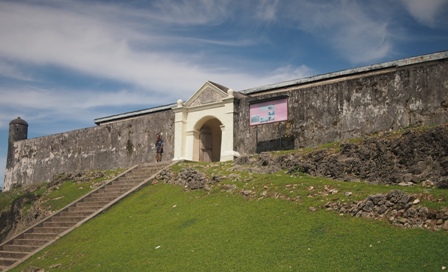 Duur Stede Fort[/caption]
[caption id="attachment_3815" align="alignnone" width="424"]
Duur Stede Fort[/caption]
[caption id="attachment_3815" align="alignnone" width="424"] Kapitan Pattimura birthplace[/caption]
Locally born Thomas Matulessy (whose birthplace in Sirisori village is preserved as a shrine to his memory) became known as Kapitan Pattimura, one of Indonesia’s first independence heroes. A diorama museum next to the fort is worth visiting to gain a sense of how Saparuan people fought against Dutch rule.
[caption id="attachment_3807" align="alignnone" width="448"]
Kapitan Pattimura birthplace[/caption]
Locally born Thomas Matulessy (whose birthplace in Sirisori village is preserved as a shrine to his memory) became known as Kapitan Pattimura, one of Indonesia’s first independence heroes. A diorama museum next to the fort is worth visiting to gain a sense of how Saparuan people fought against Dutch rule.
[caption id="attachment_3807" align="alignnone" width="448"]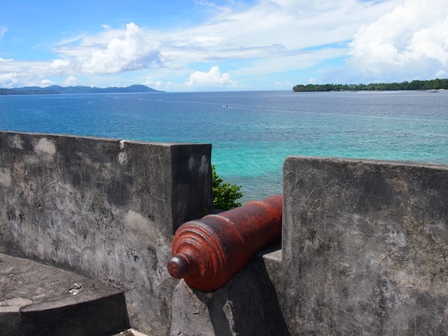 Cannon at Duur Stede Fort[/caption]
Despite its important and turbulent past, Saparua is now a proverbial sleepy backwater. Here tourism hasn’t had a noticeable impact on local infrastructure.
[caption id="attachment_3808" align="alignnone" width="448"]
Cannon at Duur Stede Fort[/caption]
Despite its important and turbulent past, Saparua is now a proverbial sleepy backwater. Here tourism hasn’t had a noticeable impact on local infrastructure.
[caption id="attachment_3808" align="alignnone" width="448"]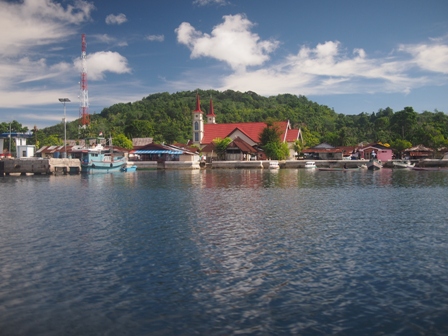 Haria town Saparua[/caption]
Boats arrive from Ambon to Haria harbour, Saparua’s main town.
[caption id="attachment_3816" align="alignnone" width="448"]
Haria town Saparua[/caption]
Boats arrive from Ambon to Haria harbour, Saparua’s main town.
[caption id="attachment_3816" align="alignnone" width="448"]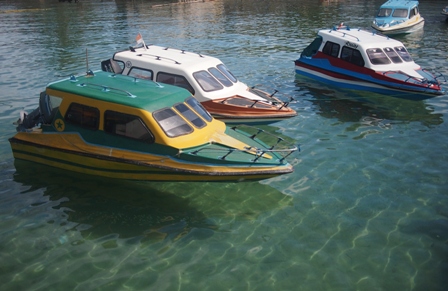 Boats in Haria harbour[/caption]
The Perdana Hotel in Haria is approximately ten minutes walk from the Duur Stede Fort or thirty minutes along the main market street from the harbour.
[caption id="attachment_3809" align="alignnone" width="448"]
Boats in Haria harbour[/caption]
The Perdana Hotel in Haria is approximately ten minutes walk from the Duur Stede Fort or thirty minutes along the main market street from the harbour.
[caption id="attachment_3809" align="alignnone" width="448"]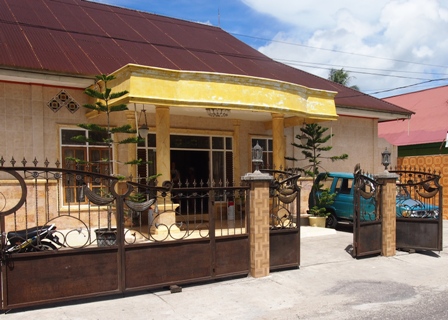 Perdana hotel Haria Saparua[/caption]
(Naked Tip: The Perdana doesn’t have a website and credit cards are not accepted. Bookings should be made by fronting up to the reception desk and handing over hard cash. Prices vary from approximately AUD$10 to AUD$40 per night and do not include breakfast.)
The hotel is my preferred accommodation option. A decent restaurant operates across the road from the hotel entrance.
[caption id="attachment_3810" align="alignnone" width="405"]
Perdana hotel Haria Saparua[/caption]
(Naked Tip: The Perdana doesn’t have a website and credit cards are not accepted. Bookings should be made by fronting up to the reception desk and handing over hard cash. Prices vary from approximately AUD$10 to AUD$40 per night and do not include breakfast.)
The hotel is my preferred accommodation option. A decent restaurant operates across the road from the hotel entrance.
[caption id="attachment_3810" align="alignnone" width="405"]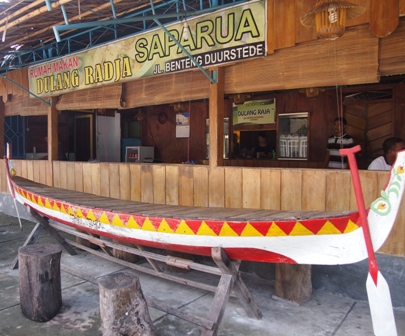 Dulang Radja restaurant Haria Saparua[/caption]
It’s possible to hire a taxi and driver for a day’s inexpensive touring around the island; that or a motorbike.
[caption id="attachment_3819" align="alignnone" width="365"]
Dulang Radja restaurant Haria Saparua[/caption]
It’s possible to hire a taxi and driver for a day’s inexpensive touring around the island; that or a motorbike.
[caption id="attachment_3819" align="alignnone" width="365"]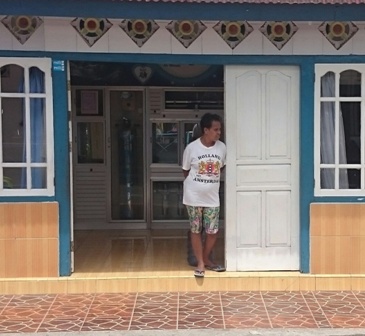 Haria Saparua man in doorway[/caption]
Colourfully painted houses populate small villages like hundreds and thousands sprinkled across a birthday cake.
[caption id="attachment_3812" align="alignnone" width="336"]
Haria Saparua man in doorway[/caption]
Colourfully painted houses populate small villages like hundreds and thousands sprinkled across a birthday cake.
[caption id="attachment_3812" align="alignnone" width="336"]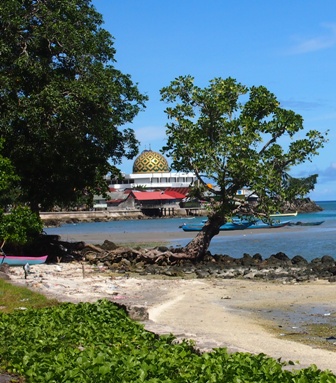 Saparua village mosque[/caption]
Mosques and churches dominate various villages, indications as to whether the population is primarily Muslim or Christian.
[caption id="attachment_3811" align="alignnone" width="448"]
Saparua village mosque[/caption]
Mosques and churches dominate various villages, indications as to whether the population is primarily Muslim or Christian.
[caption id="attachment_3811" align="alignnone" width="448"]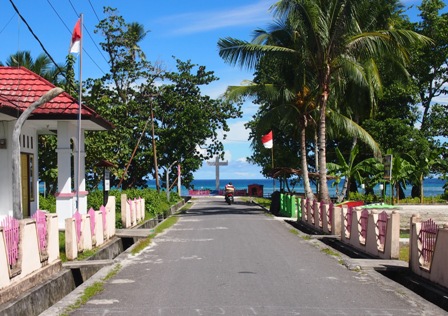 Saparua village[/caption]
If going by the number of waves and smiling faces we encountered is a reasonably accurate measure of hospitality, everyone seems genuinely friendly and welcoming of foreign visitors regardless of religious persuasion.
[caption id="attachment_3813" align="alignnone" width="330"]
Saparua village[/caption]
If going by the number of waves and smiling faces we encountered is a reasonably accurate measure of hospitality, everyone seems genuinely friendly and welcoming of foreign visitors regardless of religious persuasion.
[caption id="attachment_3813" align="alignnone" width="330"] Haria Saparua market street scene[/caption]
The island’s main market operates along the main street from early morning until early afternoon and is clearly the centre of activity.
[caption id="attachment_3814" align="alignnone" width="403"]
Haria Saparua market street scene[/caption]
The island’s main market operates along the main street from early morning until early afternoon and is clearly the centre of activity.
[caption id="attachment_3814" align="alignnone" width="403"] Haria market stall[/caption]
Summing up, I advise skipping Bali on your next visit to Indonesia.
[caption id="attachment_3818" align="alignnone" width="338"]
Haria market stall[/caption]
Summing up, I advise skipping Bali on your next visit to Indonesia.
[caption id="attachment_3818" align="alignnone" width="338"] A face of Saparua[/caption]
Sulawesi and Maluku offer rich rewards for visitors willing to forgo standard international resort touring in favour of more stimulating travel.
Tom Neal Tacker travelled as a guest of Visit Indonesia and the Indonesian Ministry of Tourism.
Naked Tips:
For more information about Indonesian food see www.nakedhungrytraveller.com.au/jawing-on-javanese-food
For professional guides, hotel bookings, local tours around Maluku province, boat and car rental hire with or without driver, excursions and flights contact: Haical Abas Binthahir at iLMi TOUR. Haical speaks good English and is a helpful, informative expert on all things Maluku. Email: ilmitour2015@gmail.com
For more information about Indonesia tourism see www.indonesia-tourism.com or www.indonesia.travel.com
A face of Saparua[/caption]
Sulawesi and Maluku offer rich rewards for visitors willing to forgo standard international resort touring in favour of more stimulating travel.
Tom Neal Tacker travelled as a guest of Visit Indonesia and the Indonesian Ministry of Tourism.
Naked Tips:
For more information about Indonesian food see www.nakedhungrytraveller.com.au/jawing-on-javanese-food
For professional guides, hotel bookings, local tours around Maluku province, boat and car rental hire with or without driver, excursions and flights contact: Haical Abas Binthahir at iLMi TOUR. Haical speaks good English and is a helpful, informative expert on all things Maluku. Email: ilmitour2015@gmail.com
For more information about Indonesia tourism see www.indonesia-tourism.com or www.indonesia.travel.com
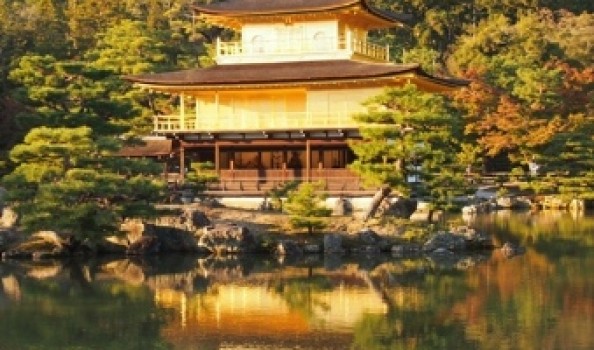 https://nakedhungrytraveller.com.au/kyoto-jewel-japan/ Kyoto, the Jewel of JapanLooking for a smart way into Japan's most popular tourist town? This is it. She walks purposefully, if a bit daintily outside one of Kyoto’s countless temples. Dressed in a long pink satin kimono, her black hair is swept up and fixed with a fake scarlet hibiscus flower. Traditional wooden soled shoes make a susurrus on the pavement. As a fashion statement, she makes a splendid impression. [caption id="attachment_3673" align="alignnone" width="300"]
https://nakedhungrytraveller.com.au/kyoto-jewel-japan/ Kyoto, the Jewel of JapanLooking for a smart way into Japan's most popular tourist town? This is it. She walks purposefully, if a bit daintily outside one of Kyoto’s countless temples. Dressed in a long pink satin kimono, her black hair is swept up and fixed with a fake scarlet hibiscus flower. Traditional wooden soled shoes make a susurrus on the pavement. As a fashion statement, she makes a splendid impression. [caption id="attachment_3673" align="alignnone" width="300"]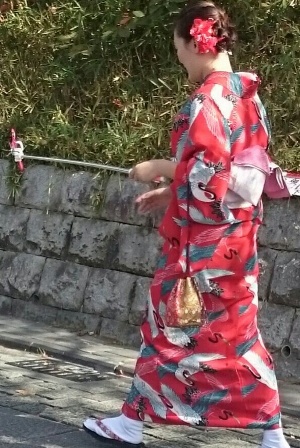 Kimono clad tourist with selfie stick[/caption]
Extending from her left hand is a selfie stick, smartphone set on video mode. She narrates loudly while walking. Her attention is entirely self-focused.
Is this the contemporary face of tourism in Kyoto?
[caption id="attachment_3674" align="alignnone" width="242"]
Kimono clad tourist with selfie stick[/caption]
Extending from her left hand is a selfie stick, smartphone set on video mode. She narrates loudly while walking. Her attention is entirely self-focused.
Is this the contemporary face of tourism in Kyoto?
[caption id="attachment_3674" align="alignnone" width="242"]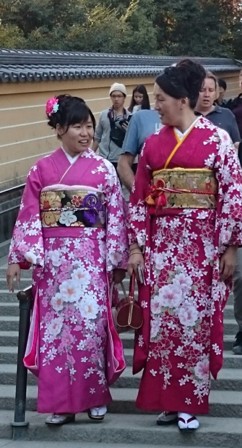 Two tourists dressed in traditional kimono[/caption]
Keeping up with its historical past, traditional outfits are for hire in countless shops throughout Kyoto, which is why you see contradictory sights like a modern woman attired in a mock vintage kimono doing the tourist walk with a selfie stick in hand.
By the way, many international visitors are unaware of this custom popular with Japanese, Korean and Taiwanese tourists in Kyoto.
[caption id="attachment_3675" align="alignnone" width="433"]
Two tourists dressed in traditional kimono[/caption]
Keeping up with its historical past, traditional outfits are for hire in countless shops throughout Kyoto, which is why you see contradictory sights like a modern woman attired in a mock vintage kimono doing the tourist walk with a selfie stick in hand.
By the way, many international visitors are unaware of this custom popular with Japanese, Korean and Taiwanese tourists in Kyoto.
[caption id="attachment_3675" align="alignnone" width="433"]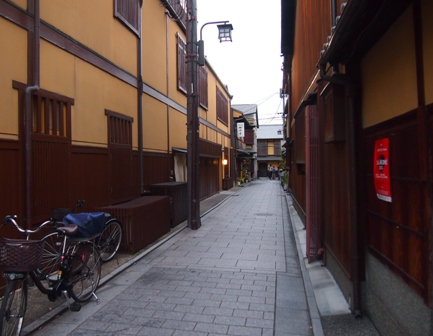 Gion street scene[/caption]
The elaborately costumed women you see everywhere in Kyoto aren’t one of the Gion district’s few remaining working geisha, despite frocking up in a traditional looking outfit.
[caption id="attachment_3676" align="alignnone" width="398"]
Gion street scene[/caption]
The elaborately costumed women you see everywhere in Kyoto aren’t one of the Gion district’s few remaining working geisha, despite frocking up in a traditional looking outfit.
[caption id="attachment_3676" align="alignnone" width="398"]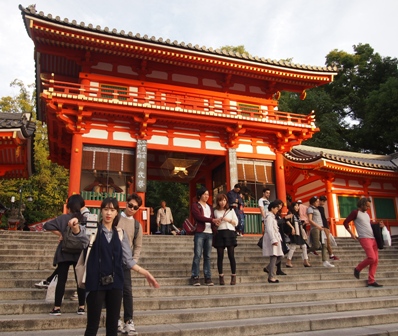 Gion Temple Yasaka Shrine[/caption]
In old Kyoto, the Gion shrine gave name to the well preserved historic Gion district. The name of the temple was changed to Yasaka some two centuries ago when the neighbourhood attained status as a place where sex and fun could be bought in lieu of piety and reflection. Gion is where geisha continue their honoured profession working from a few private clubs.
Check the sign boards near the entrance to see which geisha are available for hire if you’re in the mood for some old fashioned Japanese entertainment.
[caption id="attachment_3677" align="alignnone" width="448"]
Gion Temple Yasaka Shrine[/caption]
In old Kyoto, the Gion shrine gave name to the well preserved historic Gion district. The name of the temple was changed to Yasaka some two centuries ago when the neighbourhood attained status as a place where sex and fun could be bought in lieu of piety and reflection. Gion is where geisha continue their honoured profession working from a few private clubs.
Check the sign boards near the entrance to see which geisha are available for hire if you’re in the mood for some old fashioned Japanese entertainment.
[caption id="attachment_3677" align="alignnone" width="448"]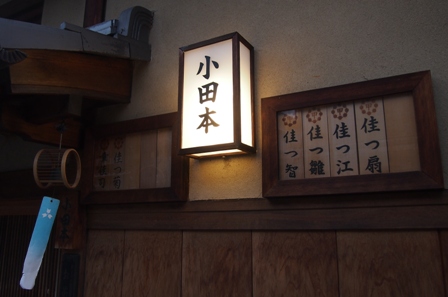 Gion geisha club--geisha available are named next to lit sign[/caption]
Kyoto is to the Japanese what Washington DC is to Americans, what Beijing is to the Chinese. A patriotic pilgrim’s right of passage, every good Japanese citizen isn’t doing their national duty without making at least one visit.
Kyoto is also Japan’s international tourist town.
[caption id="attachment_3678" align="alignnone" width="433"]
Gion geisha club--geisha available are named next to lit sign[/caption]
Kyoto is to the Japanese what Washington DC is to Americans, what Beijing is to the Chinese. A patriotic pilgrim’s right of passage, every good Japanese citizen isn’t doing their national duty without making at least one visit.
Kyoto is also Japan’s international tourist town.
[caption id="attachment_3678" align="alignnone" width="433"]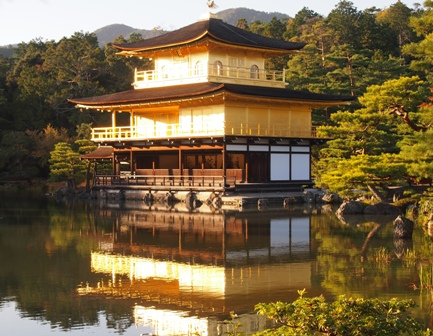 Rokuon-Ji Golden temple[/caption]
Actually it’s not a town. With more than one million residents spread across a large area, it’s no more a town than Manhattan is.
But it is assuredly the single most important cultural city in all Japan, capital for over one thousand years, from 794 until 1889 when the Emperor Meiji and his court moved permanently to Tokyo (‘Eastern Capital’) whose name he had changed from Edo.
[caption id="attachment_3679" align="alignnone" width="448"]
Rokuon-Ji Golden temple[/caption]
Actually it’s not a town. With more than one million residents spread across a large area, it’s no more a town than Manhattan is.
But it is assuredly the single most important cultural city in all Japan, capital for over one thousand years, from 794 until 1889 when the Emperor Meiji and his court moved permanently to Tokyo (‘Eastern Capital’) whose name he had changed from Edo.
[caption id="attachment_3679" align="alignnone" width="448"]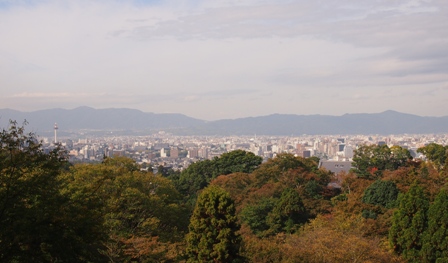 Overview of Kyoto from Kiyomizudera Temple[/caption]
It’s important to remember that Kyoto’s status as a national treasure would not be what it is today were it not for a capricious twist of fate. Targeted as the second drop spot for the atomic bomb, nicknamed ‘Fat Boy’, it was the more powerful one that destroyed Nagasaki after the first less powerful bomb (‘Little Boy’) flattened Hiroshima.
[caption id="attachment_3680" align="alignnone" width="409"]
Overview of Kyoto from Kiyomizudera Temple[/caption]
It’s important to remember that Kyoto’s status as a national treasure would not be what it is today were it not for a capricious twist of fate. Targeted as the second drop spot for the atomic bomb, nicknamed ‘Fat Boy’, it was the more powerful one that destroyed Nagasaki after the first less powerful bomb (‘Little Boy’) flattened Hiroshima.
[caption id="attachment_3680" align="alignnone" width="409"] Kyoto CBD art-deco building by architect J.M. Gardiner[/caption]
Kyoto’s annihilation was seen by many Americans in charge of the nuclear bomb program as the more favourable target due to its cultural heritage, significant universities and strategic position as a manufacturing hub.
[caption id="attachment_3730" align="alignnone" width="448"]
Kyoto CBD art-deco building by architect J.M. Gardiner[/caption]
Kyoto’s annihilation was seen by many Americans in charge of the nuclear bomb program as the more favourable target due to its cultural heritage, significant universities and strategic position as a manufacturing hub.
[caption id="attachment_3730" align="alignnone" width="448"]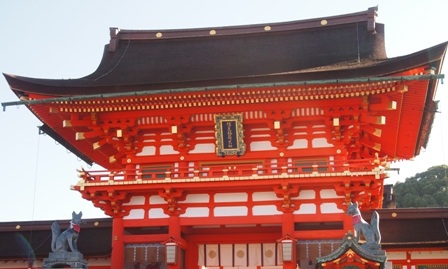 Fushimi Inari Temple[/caption]
Though the well known American art historian and archaeologist Langdon Warner is attributed as pleading convincingly for the recognition of the ancient city’s treasures and therefore rescuing Kyoto from impending doom, the real saviour was America’s Secretary of War, Henry Stimson. It was Stimson who argued successfully for its ultimate survival. Secretary Stimson convinced President Truman that bombing Kyoto, therefore forcing the Emperor’s capitulation, would irrevocably turn Japanese public opinion towards the Russians instead of the Americans during Japan’s subsequent occupation and inevitable restoration.
[caption id="attachment_3731" align="alignnone" width="292"]
Fushimi Inari Temple[/caption]
Though the well known American art historian and archaeologist Langdon Warner is attributed as pleading convincingly for the recognition of the ancient city’s treasures and therefore rescuing Kyoto from impending doom, the real saviour was America’s Secretary of War, Henry Stimson. It was Stimson who argued successfully for its ultimate survival. Secretary Stimson convinced President Truman that bombing Kyoto, therefore forcing the Emperor’s capitulation, would irrevocably turn Japanese public opinion towards the Russians instead of the Americans during Japan’s subsequent occupation and inevitable restoration.
[caption id="attachment_3731" align="alignnone" width="292"]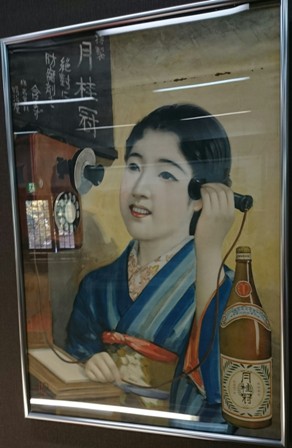 Heritage poster at Geikken museum[/caption]
In the 1920s Stimson served as the US Governor of the Philippines and supposedly honeymooned in Kyoto. He was passionate about Kyoto’s unique collection of over 1,600 shrines and temples and their importance to Japanese sense of identity and its lengthy history. Most of all, he recognised Kyoto’s unique position amongst the remaining wonders of the world.
Kiyomizudera Temple
Heritage poster at Geikken museum[/caption]
In the 1920s Stimson served as the US Governor of the Philippines and supposedly honeymooned in Kyoto. He was passionate about Kyoto’s unique collection of over 1,600 shrines and temples and their importance to Japanese sense of identity and its lengthy history. Most of all, he recognised Kyoto’s unique position amongst the remaining wonders of the world.
Kiyomizudera Temple
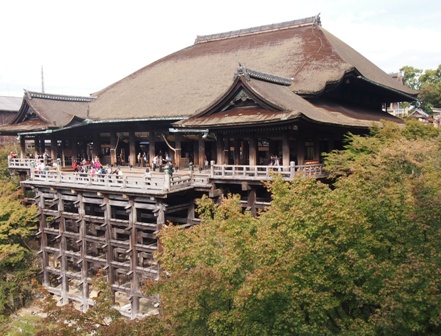 Over the centuries, most of Kyoto’s innumerable shrines and temples have burnt to cinders and been rebuilt or been shattered by earthquakes and reconstructed but an atomic bomb would have utterly destroyed everything and everyone.
[caption id="attachment_3682" align="alignnone" width="394"]
Over the centuries, most of Kyoto’s innumerable shrines and temples have burnt to cinders and been rebuilt or been shattered by earthquakes and reconstructed but an atomic bomb would have utterly destroyed everything and everyone.
[caption id="attachment_3682" align="alignnone" width="394"]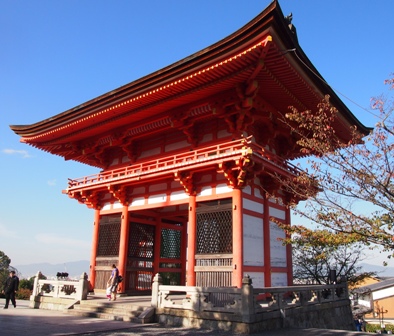 Shrine at Kiyomizudera Temple[/caption]
Would all of Kyoto’s wonders have been rebuilt in perfect replication from the ashes of the most destructive bomb ever detonated to end a war?
[caption id="attachment_3732" align="alignnone" width="419"]
Shrine at Kiyomizudera Temple[/caption]
Would all of Kyoto’s wonders have been rebuilt in perfect replication from the ashes of the most destructive bomb ever detonated to end a war?
[caption id="attachment_3732" align="alignnone" width="419"] Kyoto's original dwellings have been saved[/caption]
Luckily for us, we’ll never know.
[caption id="attachment_3733" align="alignnone" width="336"]
Kyoto's original dwellings have been saved[/caption]
Luckily for us, we’ll never know.
[caption id="attachment_3733" align="alignnone" width="336"]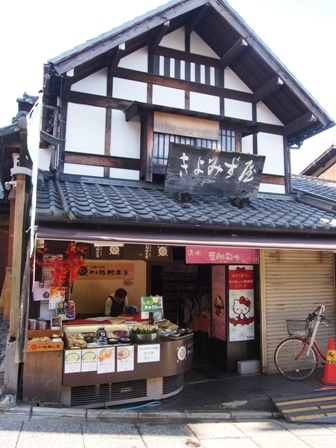 Typical Sannenzaka shopfront[/caption]
Reflect on this knife-edge twist of fate when visiting Kyoto and give thanks.
[caption id="attachment_3683" align="alignnone" width="394"]
Typical Sannenzaka shopfront[/caption]
Reflect on this knife-edge twist of fate when visiting Kyoto and give thanks.
[caption id="attachment_3683" align="alignnone" width="394"]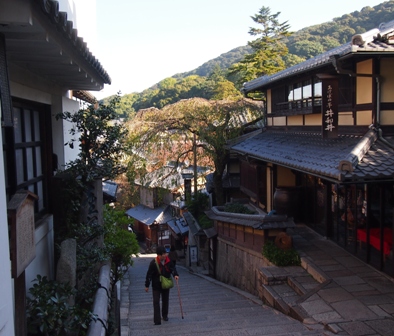 Sannenzaka street scene[/caption]
Back to the present... you simply can’t take in all Kyoto’s sights in a few days. It would take months to explore thoroughly its array of 1,600 shrines and temples.
[caption id="attachment_3684" align="alignnone" width="448"]
Sannenzaka street scene[/caption]
Back to the present... you simply can’t take in all Kyoto’s sights in a few days. It would take months to explore thoroughly its array of 1,600 shrines and temples.
[caption id="attachment_3684" align="alignnone" width="448"]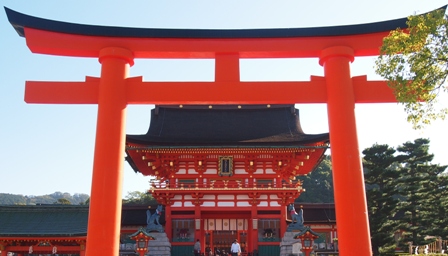 Fushimi Inari Temple entry[/caption]
After a recent four day visit, my head was spinning; a bad case of temple-shrine vertigo. When they all begin to look too much alike, it’s time for a break, perhaps sipping a locally brewed Nihonshu (sake) in a cosy bar, flipping through a manga comic in a cute cafe or soaking in an onsen’s mineral bath.
Kyoto has plenty of cafes, restaurants, onsen and bookshops. It’s not all about shrine hopping. All the major temple complexes also include lovely gardens, perfect for quiet strolling and a bit of Zen reflection.
[caption id="attachment_3685" align="alignnone" width="448"]
Fushimi Inari Temple entry[/caption]
After a recent four day visit, my head was spinning; a bad case of temple-shrine vertigo. When they all begin to look too much alike, it’s time for a break, perhaps sipping a locally brewed Nihonshu (sake) in a cosy bar, flipping through a manga comic in a cute cafe or soaking in an onsen’s mineral bath.
Kyoto has plenty of cafes, restaurants, onsen and bookshops. It’s not all about shrine hopping. All the major temple complexes also include lovely gardens, perfect for quiet strolling and a bit of Zen reflection.
[caption id="attachment_3685" align="alignnone" width="448"]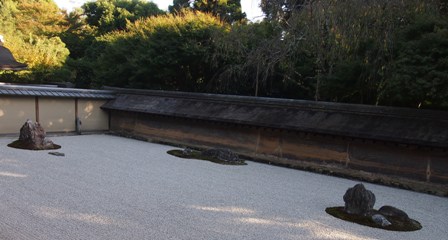 Zen garden at Ryoanji Temple[/caption]
The modern CBD, the area from the main Kyoto Station north to Karasuma Oike subway station (western boundary Horikawa-dori Street, eastern boundary Kawabata-dori Street), including the city’s major crossroads at Shijo-dori and Karamasu-dori streets, boasts all the major chain department stores and high end international boutiques if you need a shopping fix. Neighbourhoods away from the major tourist attractions have the usual assortments of small bars, cafes shops where locals hang out buying the same stuff everyone else in Japan buys.
[caption id="attachment_3686" align="alignnone" width="448"]
Zen garden at Ryoanji Temple[/caption]
The modern CBD, the area from the main Kyoto Station north to Karasuma Oike subway station (western boundary Horikawa-dori Street, eastern boundary Kawabata-dori Street), including the city’s major crossroads at Shijo-dori and Karamasu-dori streets, boasts all the major chain department stores and high end international boutiques if you need a shopping fix. Neighbourhoods away from the major tourist attractions have the usual assortments of small bars, cafes shops where locals hang out buying the same stuff everyone else in Japan buys.
[caption id="attachment_3686" align="alignnone" width="448"]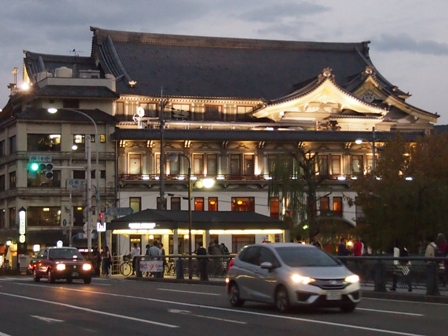 Kyoto opera theatre[/caption]
Despite a reputation as Japan’s most popular tourist destination, Kyoto is also a working city with the majority of residents not employed in the tourism industry.
I took in the major sights but managed to side-step the tourist crowds by avoiding peak visiting hours and including some off-piste attractions.
Because Kyoto’s major sights are literally on opposite sides of the metropolis with many in between, it’s helpful to divide your visits geographically.
[caption id="attachment_3734" align="alignnone" width="448"]
Kyoto opera theatre[/caption]
Despite a reputation as Japan’s most popular tourist destination, Kyoto is also a working city with the majority of residents not employed in the tourism industry.
I took in the major sights but managed to side-step the tourist crowds by avoiding peak visiting hours and including some off-piste attractions.
Because Kyoto’s major sights are literally on opposite sides of the metropolis with many in between, it’s helpful to divide your visits geographically.
[caption id="attachment_3734" align="alignnone" width="448"]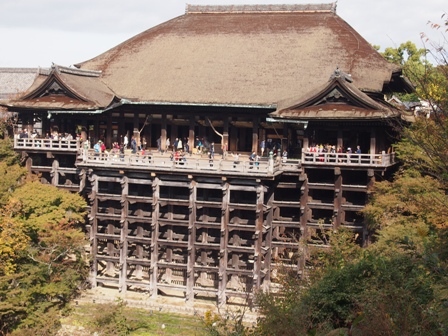 Kiyomizudera Temple[/caption]
Try to pass at least one day exploring each: northwest (Kinkakuji Temple, Ryoanji Temple, Insho Domo Museum of Fine Arts are the justifiably most popular), east and southeast: (Kyomizudera Temple, Sanjusangendo Temple, Fushimi Inari Shrine and Sekhoji Temple are the highlights), central: (Nijo-jo Castle, the Heian Shrine and museums and the Imperial Palace, Sento Palace grounds and parklands feature at the top of everyone’s lists).
[caption id="attachment_3687" align="alignnone" width="394"]
Kiyomizudera Temple[/caption]
Try to pass at least one day exploring each: northwest (Kinkakuji Temple, Ryoanji Temple, Insho Domo Museum of Fine Arts are the justifiably most popular), east and southeast: (Kyomizudera Temple, Sanjusangendo Temple, Fushimi Inari Shrine and Sekhoji Temple are the highlights), central: (Nijo-jo Castle, the Heian Shrine and museums and the Imperial Palace, Sento Palace grounds and parklands feature at the top of everyone’s lists).
[caption id="attachment_3687" align="alignnone" width="394"] Torii Gates at Fushimi Inari Temple[/caption]
The Sannenzaka and Ninenzaka preserved districts down the hill from the Jishu Shrine and Kiyomizudera Temple are lovely for strolling both during the day and evening.
[caption id="attachment_3747" align="alignnone" width="205"]
Torii Gates at Fushimi Inari Temple[/caption]
The Sannenzaka and Ninenzaka preserved districts down the hill from the Jishu Shrine and Kiyomizudera Temple are lovely for strolling both during the day and evening.
[caption id="attachment_3747" align="alignnone" width="205"]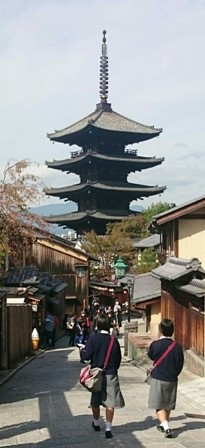 Yasaka Pagoda in Sannenzaka[/caption]
Many of Kyoto’s best preserved private historic homes are found here. Several operate as ryokan where traditional Japanese services including kaiseki meals and tatami rooms are on offer at the high end of the yen scale.
[caption id="attachment_3688" align="alignnone" width="403"]
Yasaka Pagoda in Sannenzaka[/caption]
Many of Kyoto’s best preserved private historic homes are found here. Several operate as ryokan where traditional Japanese services including kaiseki meals and tatami rooms are on offer at the high end of the yen scale.
[caption id="attachment_3688" align="alignnone" width="403"]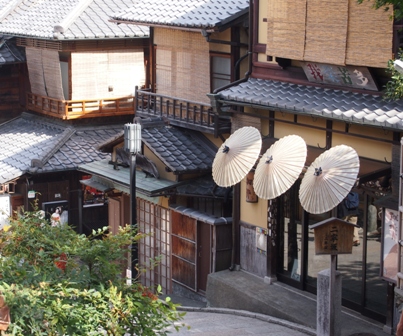 Sannenzaka shops[/caption]
At the far western end of the Kyoto metropolitan area is Arashiyama district, another cluster of shrines and temples nestled in forested foothills, arrestingly beautiful in autumn when the maple trees are glowing orange and red. Spring cherry blossom (sakura) time is equally lovely. The Tenryuji Temple is the heart of this area, easily accessible from Saga-Arashiyama and Trokko Saga stations.
Across town from Arashiyama district on the eastern side is the Ginkakuji Temple area with its ‘Path of Philosophy’ walk and adjoining Honen-in Temple. Nearby is the Kyoto University, Chionji Temple and Yoshida Shrine district, part of central Kyoto, less touristy than Gion or Sannenzaka but with a good assortment of cafes, restaurants and bars catering to students on a budget.
[caption id="attachment_3689" align="alignnone" width="445"]
Sannenzaka shops[/caption]
At the far western end of the Kyoto metropolitan area is Arashiyama district, another cluster of shrines and temples nestled in forested foothills, arrestingly beautiful in autumn when the maple trees are glowing orange and red. Spring cherry blossom (sakura) time is equally lovely. The Tenryuji Temple is the heart of this area, easily accessible from Saga-Arashiyama and Trokko Saga stations.
Across town from Arashiyama district on the eastern side is the Ginkakuji Temple area with its ‘Path of Philosophy’ walk and adjoining Honen-in Temple. Nearby is the Kyoto University, Chionji Temple and Yoshida Shrine district, part of central Kyoto, less touristy than Gion or Sannenzaka but with a good assortment of cafes, restaurants and bars catering to students on a budget.
[caption id="attachment_3689" align="alignnone" width="445"]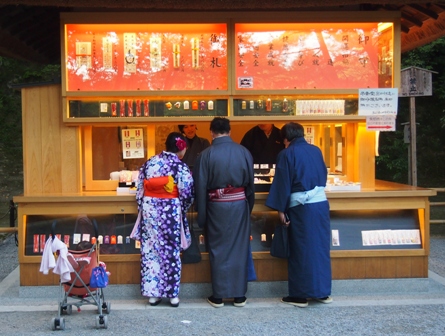 Family at Golden Temple kiosk[/caption]
Bear in mind that Kyoto’s temples and shrines are not only historically significant but also religiously and culturally important to the Japanese. Many have been deemed ‘national treasures’ that visitors are obliged to treat with respect.
For instance the sublime Zen rock garden at Ryoanji Temple is a place of quiet reflection. Noise isn’t tolerated.
[caption id="attachment_3691" align="alignnone" width="448"]
Family at Golden Temple kiosk[/caption]
Bear in mind that Kyoto’s temples and shrines are not only historically significant but also religiously and culturally important to the Japanese. Many have been deemed ‘national treasures’ that visitors are obliged to treat with respect.
For instance the sublime Zen rock garden at Ryoanji Temple is a place of quiet reflection. Noise isn’t tolerated.
[caption id="attachment_3691" align="alignnone" width="448"]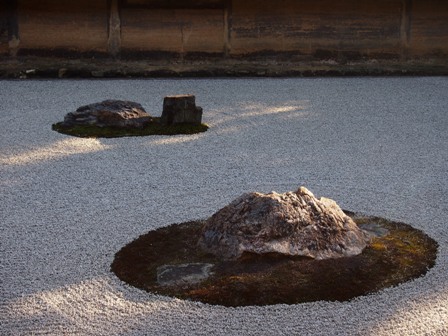 Zen garden at Ryoanji Temple[/caption]
At Kiyomizudera Temple is the Jishu Shrine. Known as the ‘Cupid of Japan’ where rabbit images proliferate (rabbit images equate fertility in Japan as they do in Europe and elsewhere). Facing the main building are two stones set approximately ten metres apart. Blindfolded love struck visitors walk between the stones. If they reach each one safely (no tripping over or straying off a straight path) from one stone to the other, dreams of love will be realised.
Try it. You may be surprised at how quickly your dance card fills.
[caption id="attachment_3694" align="alignnone" width="448"]
Zen garden at Ryoanji Temple[/caption]
At Kiyomizudera Temple is the Jishu Shrine. Known as the ‘Cupid of Japan’ where rabbit images proliferate (rabbit images equate fertility in Japan as they do in Europe and elsewhere). Facing the main building are two stones set approximately ten metres apart. Blindfolded love struck visitors walk between the stones. If they reach each one safely (no tripping over or straying off a straight path) from one stone to the other, dreams of love will be realised.
Try it. You may be surprised at how quickly your dance card fills.
[caption id="attachment_3694" align="alignnone" width="448"]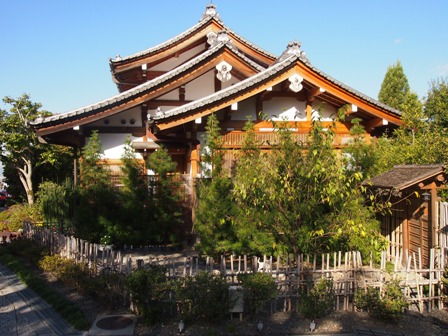 Monk's house at Kiyomizudera Temple[/caption]
The Fushimi Inari Temple is also a holy site. Fox images guard the entry gates. Signifying messengers of wisdom and cleverness, the fox also carries a key in its mouth representative of the lock to the rice granary, in other words the community’s repository of wealth and security.
[caption id="attachment_3692" align="alignnone" width="429"]
Monk's house at Kiyomizudera Temple[/caption]
The Fushimi Inari Temple is also a holy site. Fox images guard the entry gates. Signifying messengers of wisdom and cleverness, the fox also carries a key in its mouth representative of the lock to the rice granary, in other words the community’s repository of wealth and security.
[caption id="attachment_3692" align="alignnone" width="429"]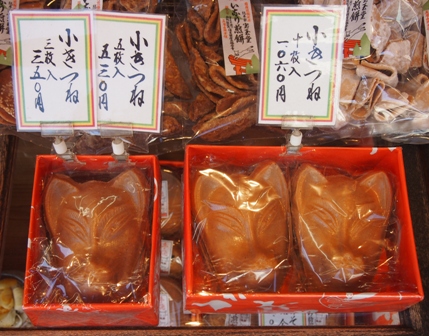 Fox head biscuits for sale near Fushimi Inari Temple[/caption]
The main path up Inari Mountain (233 metres, roughly two hours climb up and back) above Fushimi is lined with over 10,000 Torii gates and is now the most popular sight in Kyoto. Inari is considered the patron of business, which is why so many Torii gates have been donated by scores of businesses to this particular temple.
[caption id="attachment_3696" align="alignnone" width="361"]
Fox head biscuits for sale near Fushimi Inari Temple[/caption]
The main path up Inari Mountain (233 metres, roughly two hours climb up and back) above Fushimi is lined with over 10,000 Torii gates and is now the most popular sight in Kyoto. Inari is considered the patron of business, which is why so many Torii gates have been donated by scores of businesses to this particular temple.
[caption id="attachment_3696" align="alignnone" width="361"] Cleansing spring at Fushimi Inari Temple[/caption]
Also near the main gate is a space specially reserved for a single car where temple priests are ‘paid’ to bless the (usually prestige) purchase, hopefully ensuring a safe drive to and from work.
[caption id="attachment_3695" align="alignnone" width="448"]
Cleansing spring at Fushimi Inari Temple[/caption]
Also near the main gate is a space specially reserved for a single car where temple priests are ‘paid’ to bless the (usually prestige) purchase, hopefully ensuring a safe drive to and from work.
[caption id="attachment_3695" align="alignnone" width="448"]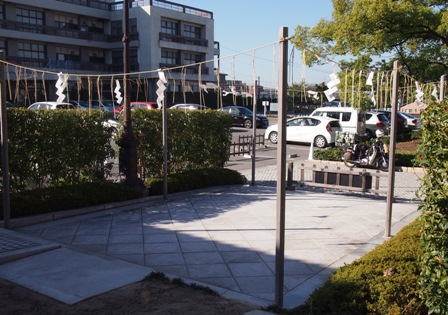 Vehicle blessing space at Fushimi Inari Temple[/caption]
This summary of Kyoto’s highlights would maintain a keen traveller’s interest piqued for at least a week’s worth of persistent temple and shrine visits.
[caption id="attachment_3697" align="alignnone" width="448"]
Vehicle blessing space at Fushimi Inari Temple[/caption]
This summary of Kyoto’s highlights would maintain a keen traveller’s interest piqued for at least a week’s worth of persistent temple and shrine visits.
[caption id="attachment_3697" align="alignnone" width="448"]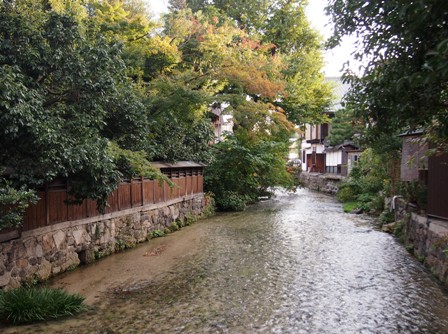 Along the river and Kyoto back streets[/caption]
Central Kyoto is mostly flat, prime bicycling territory. Hire a bicycle and have fun pedalling along canals lined with maple and willow trees, away from traffic and other tourists.
[caption id="attachment_3748" align="alignnone" width="448"]
Along the river and Kyoto back streets[/caption]
Central Kyoto is mostly flat, prime bicycling territory. Hire a bicycle and have fun pedalling along canals lined with maple and willow trees, away from traffic and other tourists.
[caption id="attachment_3748" align="alignnone" width="448"] Garden at Ryoanji Temple[/caption]
The main railway station is Kyoto's transport hub. Rails tickets, bus and subway passes can be purchased here.
[caption id="attachment_3740" align="alignnone" width="336"]
Garden at Ryoanji Temple[/caption]
The main railway station is Kyoto's transport hub. Rails tickets, bus and subway passes can be purchased here.
[caption id="attachment_3740" align="alignnone" width="336"]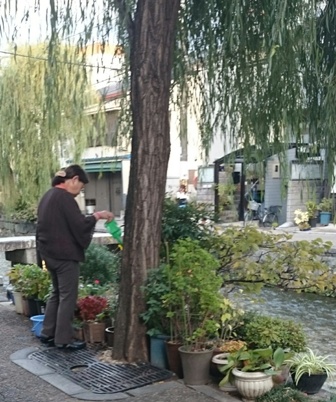 Civic pride in the back streets of Kyoto[/caption]
Naked Tip:
A terrific day trip from Kyoto is to Himechi, approximately 45 minutes by Shinkansen from Kyoto’s main railway station, one stop after Osaka.
[caption id="attachment_3698" align="alignnone" width="448"]
Civic pride in the back streets of Kyoto[/caption]
Naked Tip:
A terrific day trip from Kyoto is to Himechi, approximately 45 minutes by Shinkansen from Kyoto’s main railway station, one stop after Osaka.
[caption id="attachment_3698" align="alignnone" width="448"]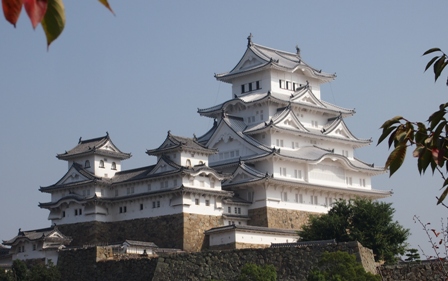 Himechi castle main keep[/caption]
Himechi is dominated by a huge castle (Shirasagijo aka ‘White Heron Castle’), the largest in Japan. Reopened to the public in June 2015 after a five year restoration, Himechi Castle is indescribably impressive. It was first established in 1333 as a hilltop fort. The 5-storied 7-floored structure you see now was completed in 1609.
[caption id="attachment_3700" align="alignnone" width="448"]
Himechi castle main keep[/caption]
Himechi is dominated by a huge castle (Shirasagijo aka ‘White Heron Castle’), the largest in Japan. Reopened to the public in June 2015 after a five year restoration, Himechi Castle is indescribably impressive. It was first established in 1333 as a hilltop fort. The 5-storied 7-floored structure you see now was completed in 1609.
[caption id="attachment_3700" align="alignnone" width="448"]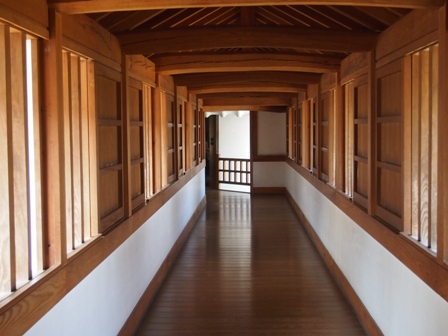 A corridor in Princess Sen's palace[/caption]
The 52 metres high ‘White Heron’ tower dominates several hectares of landscaped gardens, imperial palaces (83 buildings in all but Princess Sen’s palace is the highlight) and mighty fortress gates (21 in total) all under the gaze of a stupendous ivory tower glowering over the surrounding cityscape from atop its strategically important hill.
[caption id="attachment_3699" align="alignnone" width="448"]
A corridor in Princess Sen's palace[/caption]
The 52 metres high ‘White Heron’ tower dominates several hectares of landscaped gardens, imperial palaces (83 buildings in all but Princess Sen’s palace is the highlight) and mighty fortress gates (21 in total) all under the gaze of a stupendous ivory tower glowering over the surrounding cityscape from atop its strategically important hill.
[caption id="attachment_3699" align="alignnone" width="448"]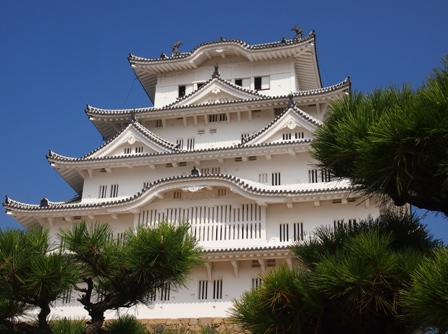 Himechi castle main keep[/caption]
Incredibly Himechi Castle has survived earthquake, fire and WW 2 bombing almost unscathed.
[caption id="attachment_3704" align="alignnone" width="448"]
Himechi castle main keep[/caption]
Incredibly Himechi Castle has survived earthquake, fire and WW 2 bombing almost unscathed.
[caption id="attachment_3704" align="alignnone" width="448"] Late flowering sakura at Himechi[/caption]
Like so many historic Japanese buildings, no nails were used in construction just wood beams connected using mortise-and-tenon joints that hang together like huge Lego sets. The engineering and skill involved is mind boggling.
[caption id="attachment_3701" align="alignnone" width="409"]
Late flowering sakura at Himechi[/caption]
Like so many historic Japanese buildings, no nails were used in construction just wood beams connected using mortise-and-tenon joints that hang together like huge Lego sets. The engineering and skill involved is mind boggling.
[caption id="attachment_3701" align="alignnone" width="409"] Himechi castle keep looms over all[/caption]
Exiting from Himechi’s railway station the castle looms from about a kilometre away and is easily reached on foot along the pedestrian friendly main street or by bus or taxi. During peak tourist season (March to October) it’s advisable to buy a ticket online before visiting. This is one of the most popular attractions for Japanese people, many of whom also make a day trip from Kyoto or Osaka.
Prepare to spend at least a full day wandering Himechi Castle’s expansive grounds and its palaces within the massive walled compound.
[caption id="attachment_3703" align="alignnone" width="416"]
Himechi castle keep looms over all[/caption]
Exiting from Himechi’s railway station the castle looms from about a kilometre away and is easily reached on foot along the pedestrian friendly main street or by bus or taxi. During peak tourist season (March to October) it’s advisable to buy a ticket online before visiting. This is one of the most popular attractions for Japanese people, many of whom also make a day trip from Kyoto or Osaka.
Prepare to spend at least a full day wandering Himechi Castle’s expansive grounds and its palaces within the massive walled compound.
[caption id="attachment_3703" align="alignnone" width="416"] Samurai at Himechi castle[/caption]
Beyond Kyoto’s undeniably attractive cultural sights lies another perspective, the food and drink point of view.
[caption id="attachment_3702" align="alignnone" width="448"]
Samurai at Himechi castle[/caption]
Beyond Kyoto’s undeniably attractive cultural sights lies another perspective, the food and drink point of view.
[caption id="attachment_3702" align="alignnone" width="448"]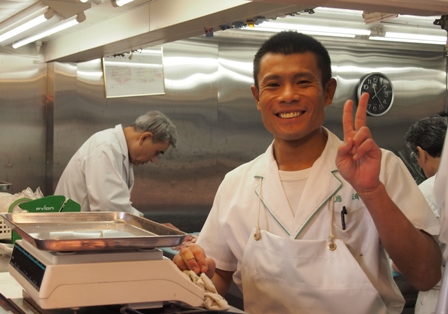 Nishiki Ichiba market poultry man[/caption]
The central food market, Nishiki Ichiba, is a prime example. Lining a long covered laneway stretching across two city blocks is a splendid assortment of shops, cafes, restaurants and food and drink stalls displaying what Kyoto’s surrounding region has to offer hungry travellers.
[caption id="attachment_3705" align="alignnone" width="336"]
Nishiki Ichiba market poultry man[/caption]
The central food market, Nishiki Ichiba, is a prime example. Lining a long covered laneway stretching across two city blocks is a splendid assortment of shops, cafes, restaurants and food and drink stalls displaying what Kyoto’s surrounding region has to offer hungry travellers.
[caption id="attachment_3705" align="alignnone" width="336"]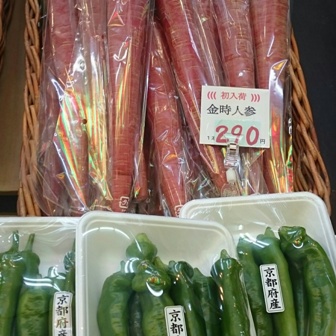 Kyoto carrots and peppers[/caption]
Try a Kyoto carrot or a Kyoto peanut, both unique to the area. Take up a seat at the oyster bar and watch the cook steam a freshly shucked half dozen.
[caption id="attachment_3706" align="alignnone" width="336"]
Kyoto carrots and peppers[/caption]
Try a Kyoto carrot or a Kyoto peanut, both unique to the area. Take up a seat at the oyster bar and watch the cook steam a freshly shucked half dozen.
[caption id="attachment_3706" align="alignnone" width="336"]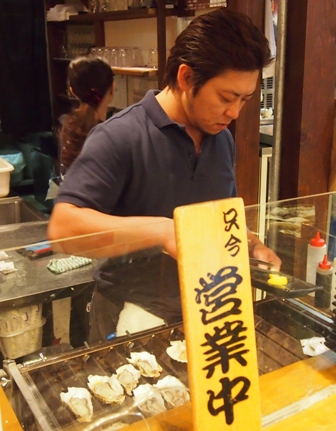 Oyster stall at Nishiki Ichiba market[/caption]
Or sample from a dizzying array of teas.
[caption id="attachment_3707" align="alignnone" width="339"]
Oyster stall at Nishiki Ichiba market[/caption]
Or sample from a dizzying array of teas.
[caption id="attachment_3707" align="alignnone" width="339"] Nishiki Ichiba market tea shop[/caption]
Or watch a fishmonger dissect a bonito in a blink of an eye.
[caption id="attachment_3708" align="alignnone" width="436"]
Nishiki Ichiba market tea shop[/caption]
Or watch a fishmonger dissect a bonito in a blink of an eye.
[caption id="attachment_3708" align="alignnone" width="436"] Nishiki Ichiba market stalls[/caption]
Stop in one of numerous restaurants for a bowl of soothing udon or ramen.
[caption id="attachment_3709" align="alignnone" width="299"]
Nishiki Ichiba market stalls[/caption]
Stop in one of numerous restaurants for a bowl of soothing udon or ramen.
[caption id="attachment_3709" align="alignnone" width="299"] Nishiki Ichiba market tuna roe for sale[/caption]
Looking for gifts to take home? This is good a place as any.
[caption id="attachment_3710" align="alignnone" width="448"]
Nishiki Ichiba market tuna roe for sale[/caption]
Looking for gifts to take home? This is good a place as any.
[caption id="attachment_3710" align="alignnone" width="448"]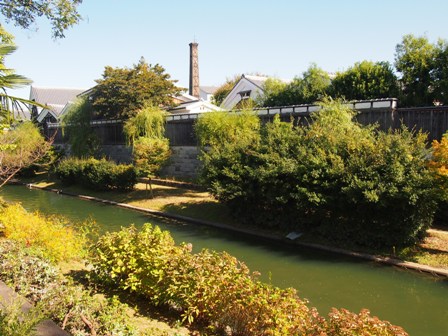 Across from Geikken sake brewery[/caption]
Also off the beaten track is the Geikken sake brewery occupying a lovely spot along a canal in the centrally located Fushimi neighbourhood.
[caption id="attachment_3711" align="alignnone" width="270"]
Across from Geikken sake brewery[/caption]
Also off the beaten track is the Geikken sake brewery occupying a lovely spot along a canal in the centrally located Fushimi neighbourhood.
[caption id="attachment_3711" align="alignnone" width="270"]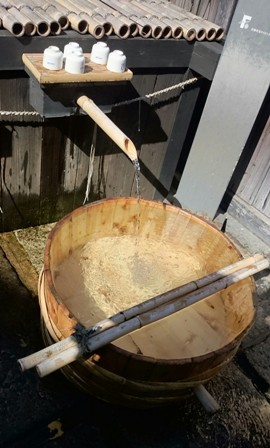 Sake made the old fashioned way at Geikken[/caption]
Kyoto’s water has been famous for its purity since before the first Emperor took up residence. Sake (Nihonshu) is comprised simply of rice, water and yeast. The trick in making good sake is finding clear and clean water, the best rice for whatever style of sake being made and the correct conditions for fermentation from specially developed sake yeast strains. Climate also has a lot to do with the process: not too hot, not too cold.
[caption id="attachment_3712" align="alignnone" width="304"]
Sake made the old fashioned way at Geikken[/caption]
Kyoto’s water has been famous for its purity since before the first Emperor took up residence. Sake (Nihonshu) is comprised simply of rice, water and yeast. The trick in making good sake is finding clear and clean water, the best rice for whatever style of sake being made and the correct conditions for fermentation from specially developed sake yeast strains. Climate also has a lot to do with the process: not too hot, not too cold.
[caption id="attachment_3712" align="alignnone" width="304"] Fermenting sake on display at Geikken[/caption]
Though a large operation, Geikken remains family owned and is open to visitors. Several sake on sale in its pleasantly appointed shop are unavailable elsewhere. The small museum adjoining the shop is fascinating if your knowledge of sake is limited, as was mine.
(See www.geikkeikan.co.jp for details regards opening hours and tours.)
[caption id="attachment_3713" align="alignnone" width="179"]
Fermenting sake on display at Geikken[/caption]
Though a large operation, Geikken remains family owned and is open to visitors. Several sake on sale in its pleasantly appointed shop are unavailable elsewhere. The small museum adjoining the shop is fascinating if your knowledge of sake is limited, as was mine.
(See www.geikkeikan.co.jp for details regards opening hours and tours.)
[caption id="attachment_3713" align="alignnone" width="179"]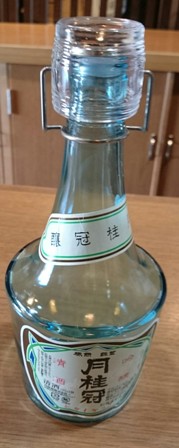 Antique sake bottle at Geikken museum[/caption]
I came away with a bottle of new sake, brewed for consumption within three weeks, rather like a Beaujolais Nouveau and impossible to find outside Japan. Drunk at home within a week after returning from Japan, it tasted of Kyoto, complex, lovely, fresh and altogether different.
[caption id="attachment_3714" align="alignnone" width="336"]
Antique sake bottle at Geikken museum[/caption]
I came away with a bottle of new sake, brewed for consumption within three weeks, rather like a Beaujolais Nouveau and impossible to find outside Japan. Drunk at home within a week after returning from Japan, it tasted of Kyoto, complex, lovely, fresh and altogether different.
[caption id="attachment_3714" align="alignnone" width="336"]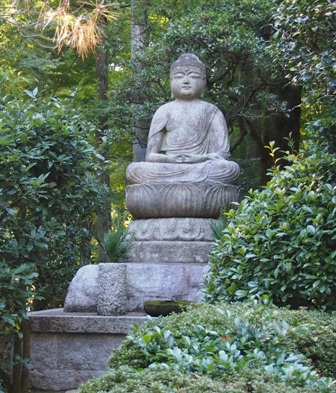 Buddha statue at Geikken sake brewery[/caption]
Tom Neal Tacker visited Kyoto courtesy of the Kyoto Tourism Organisation and the JNTO.
Naked Sleeps:
[caption id="attachment_3716" align="alignnone" width="448"]
Buddha statue at Geikken sake brewery[/caption]
Tom Neal Tacker visited Kyoto courtesy of the Kyoto Tourism Organisation and the JNTO.
Naked Sleeps:
[caption id="attachment_3716" align="alignnone" width="448"] Travelers Inn facade[/caption]
The Travelers Inn is an impeccably managed moderately priced hotel in central Kyoto. Within easy walking distance to the Gion District, Imperial Palace and University, it’s situated in a leafy street opposite the Kyoto Municipal Museum of Art and the Heian Shrine complex while backing on to a very quiet canal-side neighbourhood full of traditional wooden houses and small businesses.
[caption id="attachment_3717" align="alignnone" width="448"]
Travelers Inn facade[/caption]
The Travelers Inn is an impeccably managed moderately priced hotel in central Kyoto. Within easy walking distance to the Gion District, Imperial Palace and University, it’s situated in a leafy street opposite the Kyoto Municipal Museum of Art and the Heian Shrine complex while backing on to a very quiet canal-side neighbourhood full of traditional wooden houses and small businesses.
[caption id="attachment_3717" align="alignnone" width="448"]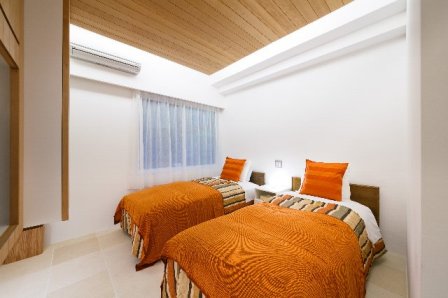 Travelers Inn room[/caption]
Rooms are simply furnished but larger than what most typically tight-spaced Japanese hotels offer.
[caption id="attachment_3720" align="alignnone" width="448"]
Travelers Inn room[/caption]
Rooms are simply furnished but larger than what most typically tight-spaced Japanese hotels offer.
[caption id="attachment_3720" align="alignnone" width="448"]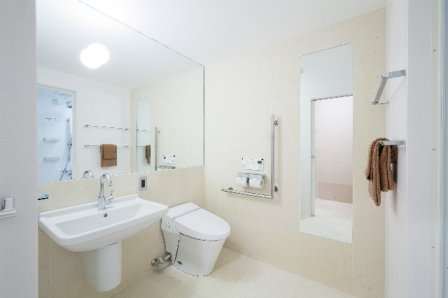 Travelers Inn bathroom[/caption]
A cafe is open for guests and visitors alike, serving breakfasts and simple lunches. Breakfast is included in the tariff.
[caption id="attachment_3718" align="alignnone" width="448"]
Travelers Inn bathroom[/caption]
A cafe is open for guests and visitors alike, serving breakfasts and simple lunches. Breakfast is included in the tariff.
[caption id="attachment_3718" align="alignnone" width="448"]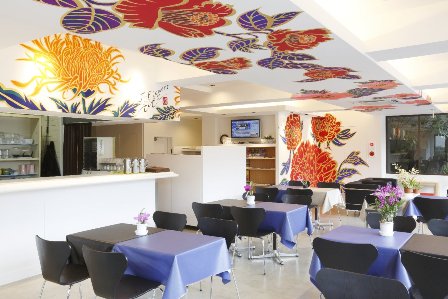 Travelers Inn cafe[/caption]
Both Western and Japanese tatami style rooms are available. Specify your preference when booking.
[caption id="attachment_3719" align="alignnone" width="448"]
Travelers Inn cafe[/caption]
Both Western and Japanese tatami style rooms are available. Specify your preference when booking.
[caption id="attachment_3719" align="alignnone" width="448"]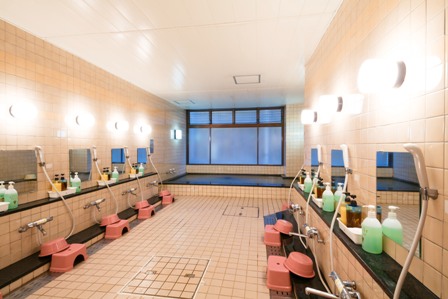 Travelers Inn onsen[/caption]
An onsen in the below ground area is popular with visitors and may be booked out for small groups. Check with front office staff to ensure you may have access after the groups have left.
What could be a better balm for sore muscles after a day’s traipsing around Kyoto’s temples and shrines than a revivifying soak in a hot springs onsen?
What sets this family owned and operated small hotel above the rest is how well managed it is. Guests are really treated like honoured friends, no cliché implied.
I felt like I was coming home after a long tiring day each time I walked through the door.
English is spoken by most employees while owner Ms. Izumi Nakagawa speaks fluent English and is one of the loveliest people you’ll ever meet.
See www.k-travelersinn.com
Tel: (+81) 75 771 0225
91 Enshoji-cho, Okazaki, Saikyo-ku, Kyoto 606-8344
Naked Eats:
To say Kyoto is not lacking in choice is stating the bleeding obvious.
Where to eat? What to drink? These are the questions.
Apply the standard rule: avoid the worst tourist restaurants.
[caption id="attachment_3721" align="alignnone" width="336"]
Travelers Inn onsen[/caption]
An onsen in the below ground area is popular with visitors and may be booked out for small groups. Check with front office staff to ensure you may have access after the groups have left.
What could be a better balm for sore muscles after a day’s traipsing around Kyoto’s temples and shrines than a revivifying soak in a hot springs onsen?
What sets this family owned and operated small hotel above the rest is how well managed it is. Guests are really treated like honoured friends, no cliché implied.
I felt like I was coming home after a long tiring day each time I walked through the door.
English is spoken by most employees while owner Ms. Izumi Nakagawa speaks fluent English and is one of the loveliest people you’ll ever meet.
See www.k-travelersinn.com
Tel: (+81) 75 771 0225
91 Enshoji-cho, Okazaki, Saikyo-ku, Kyoto 606-8344
Naked Eats:
To say Kyoto is not lacking in choice is stating the bleeding obvious.
Where to eat? What to drink? These are the questions.
Apply the standard rule: avoid the worst tourist restaurants.
[caption id="attachment_3721" align="alignnone" width="336"]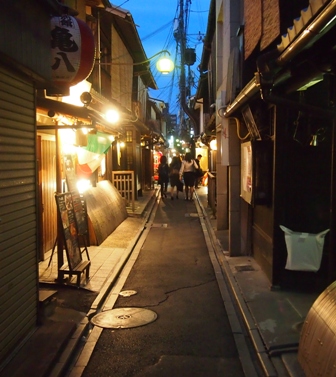 Ponto Cho street scene at dusk[/caption]
Fortunately Kyoto isn’t plagued by a surfeit of rip-off tourist joints.
Near Gion is Ponto-cho Street in central Kyoto. It’s cute and quaint and touristy but amongst the ordinary is an assortment of izakaya well worth your yen. Follow the locals’ nose; they’re as fond of the street’s bars and cafes as visitors are.
[caption id="attachment_3722" align="alignnone" width="379"]
Ponto Cho street scene at dusk[/caption]
Fortunately Kyoto isn’t plagued by a surfeit of rip-off tourist joints.
Near Gion is Ponto-cho Street in central Kyoto. It’s cute and quaint and touristy but amongst the ordinary is an assortment of izakaya well worth your yen. Follow the locals’ nose; they’re as fond of the street’s bars and cafes as visitors are.
[caption id="attachment_3722" align="alignnone" width="379"]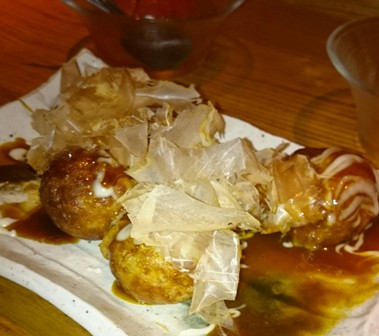 Ponto Cho izakaya -- best takoyaki ever[/caption]
I had the best takoyaki (octopus bits fried in batter, served with special takoyaki sauce) in a lovely izakaya in the middle of Ponto-cho backing on to the river side of the street. Eight seats downstairs at a bar with six seats upstairs, it was like many other izakaya lining Ponto-cho Street but stood out for superlative service and excellent food -- reasonably priced too.
[caption id="attachment_3723" align="alignnone" width="373"]
Ponto Cho izakaya -- best takoyaki ever[/caption]
I had the best takoyaki (octopus bits fried in batter, served with special takoyaki sauce) in a lovely izakaya in the middle of Ponto-cho backing on to the river side of the street. Eight seats downstairs at a bar with six seats upstairs, it was like many other izakaya lining Ponto-cho Street but stood out for superlative service and excellent food -- reasonably priced too.
[caption id="attachment_3723" align="alignnone" width="373"]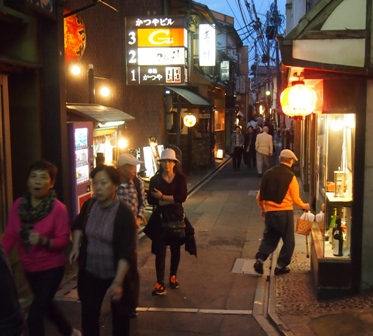 Ponto Cho street lined with izakaya and cafes[/caption]
Look for takoyaki grilling in the front window next to a discreet wooden entrance door.
[caption id="attachment_3724" align="alignnone" width="324"]
Ponto Cho street lined with izakaya and cafes[/caption]
Look for takoyaki grilling in the front window next to a discreet wooden entrance door.
[caption id="attachment_3724" align="alignnone" width="324"]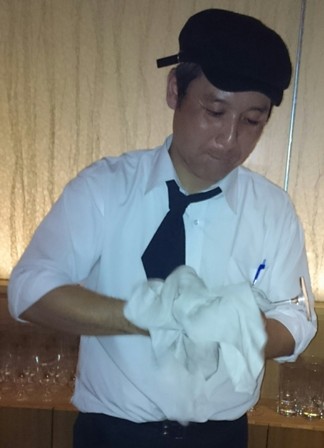 Takoyaki izakaya in Ponto Cho manager/owner[/caption]
Kyoto boasts a few of Japan’s top restaurants, the sort where a reservation is almost impossible to secure without advanced planning and an Anglophone connection.
[caption id="attachment_3725" align="alignnone" width="223"]
Takoyaki izakaya in Ponto Cho manager/owner[/caption]
Kyoto boasts a few of Japan’s top restaurants, the sort where a reservation is almost impossible to secure without advanced planning and an Anglophone connection.
[caption id="attachment_3725" align="alignnone" width="223"] Waiter at Motoi--choose your favourite coloured Laguiole knife[/caption]
I was lucky to get into Motoi, a French influenced restaurant (the chef/owner worked in France at a couple Michelin-starred places) where I enjoyed one of the best meals I’ve had in my life.
[caption id="attachment_3726" align="alignnone" width="336"]
Waiter at Motoi--choose your favourite coloured Laguiole knife[/caption]
I was lucky to get into Motoi, a French influenced restaurant (the chef/owner worked in France at a couple Michelin-starred places) where I enjoyed one of the best meals I’ve had in my life.
[caption id="attachment_3726" align="alignnone" width="336"]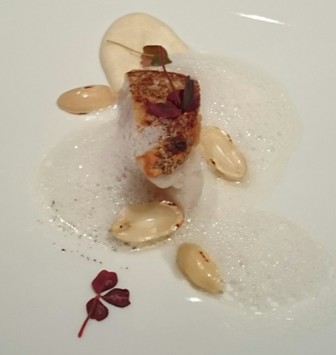 Pan fried local grouper with Kyoto peanuts and vanilla oil[/caption]
Unlike many upscale Japanese restaurants Motoi accepts credit cards.
[caption id="attachment_3727" align="alignnone" width="330"]
Pan fried local grouper with Kyoto peanuts and vanilla oil[/caption]
Unlike many upscale Japanese restaurants Motoi accepts credit cards.
[caption id="attachment_3727" align="alignnone" width="330"]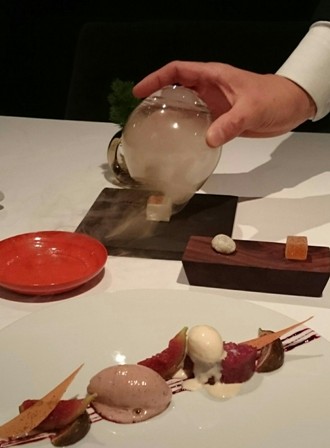 Fig dessert with mignardise[/caption]
Suffice to say, apart from a dazzling succession of dishes sourced from the best local ingredients purveyors could supply, cooked with exquisite finesse and served with inspiring elan, I also learned that Japan does support a few budding boutique cheese making farms. The cheese course I had after eight preceding savoury courses and before three desserts was a revelation.
[caption id="attachment_3728" align="alignnone" width="448"]
Fig dessert with mignardise[/caption]
Suffice to say, apart from a dazzling succession of dishes sourced from the best local ingredients purveyors could supply, cooked with exquisite finesse and served with inspiring elan, I also learned that Japan does support a few budding boutique cheese making farms. The cheese course I had after eight preceding savoury courses and before three desserts was a revelation.
[caption id="attachment_3728" align="alignnone" width="448"]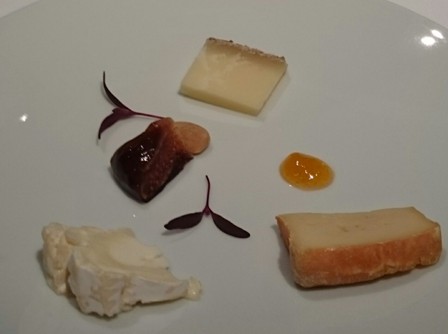 Cheeses from Yoshida farm (near Hiroshima) at Motoi[/caption]
Being French inspired, the wine list brought tears of joy to my eyes, like a gift presented by Bacchus himself.
Service was flawless, truly flawless. Friendly yet formal, informed and gracious, polite yet warm; I felt like a dinner guest at someone’s home instead of just another paying customer.
If you’re looking for at least one lavish feast in one of Kyoto’s best restaurants, go here.
The whole team, chef owner included, waved me good-bye outside in the street while my taxi waited. Bowing in unison and thanking me again, I nearly cried when leaving.
It’s that good.
www.kyoto-motoi.com
(+81) 75 231 0709
186 Tawarayacho Tominokoji 2-jo Sagaru, Kakagyo-ku Kyoto
Naked Tips:
Finding an ATM in Japan can be a challenge. 7-11 stores usually have an ATM that accepts foreign banks via the Cirrus Maestro network. Most banks do not have ATMs that accept foreign bank cards.
Credit cards are not accepted in surprising places, restaurants for example. Japan remains a cash economy.
Book entry tickets online for popular tourist attractions such as Himechi Castle and major sights in Kyoto. The Japan National Tourist Organization website is a good one-stop shop for inquiries regarding accommodation and transport.
www.jnto.go.jp
[caption id="attachment_3742" align="alignnone" width="336"]
Cheeses from Yoshida farm (near Hiroshima) at Motoi[/caption]
Being French inspired, the wine list brought tears of joy to my eyes, like a gift presented by Bacchus himself.
Service was flawless, truly flawless. Friendly yet formal, informed and gracious, polite yet warm; I felt like a dinner guest at someone’s home instead of just another paying customer.
If you’re looking for at least one lavish feast in one of Kyoto’s best restaurants, go here.
The whole team, chef owner included, waved me good-bye outside in the street while my taxi waited. Bowing in unison and thanking me again, I nearly cried when leaving.
It’s that good.
www.kyoto-motoi.com
(+81) 75 231 0709
186 Tawarayacho Tominokoji 2-jo Sagaru, Kakagyo-ku Kyoto
Naked Tips:
Finding an ATM in Japan can be a challenge. 7-11 stores usually have an ATM that accepts foreign banks via the Cirrus Maestro network. Most banks do not have ATMs that accept foreign bank cards.
Credit cards are not accepted in surprising places, restaurants for example. Japan remains a cash economy.
Book entry tickets online for popular tourist attractions such as Himechi Castle and major sights in Kyoto. The Japan National Tourist Organization website is a good one-stop shop for inquiries regarding accommodation and transport.
www.jnto.go.jp
[caption id="attachment_3742" align="alignnone" width="336"]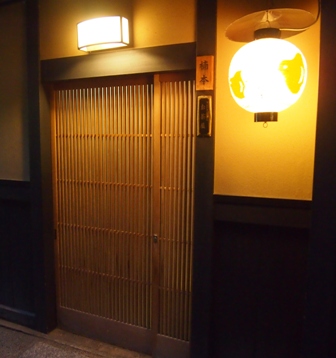 Ponto Cho doorway[/caption]
Ponto Cho doorway[/caption]
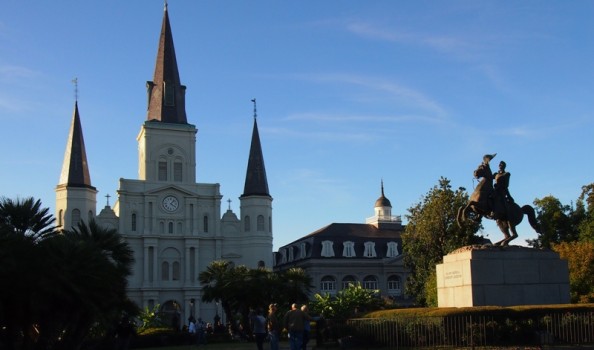 https://nakedhungrytraveller.com.au/voodoo-new-orleans-fun-stuff/ Doing the Voodoo in New Orleans and Other Fun StuffNew Orleans is the voodoo capital of the USA, a city where the dead are buried above ground and the past is lived in the now. For a woman in her mid 70s she’s surprisingly youthful. Graced with a virtually unlined face despite years of struggle with untimely death and loss, she’s a bright-eyed testament to the vitality of her voodoo faith. [caption id="attachment_3835" align="alignnone" width="336"]
https://nakedhungrytraveller.com.au/voodoo-new-orleans-fun-stuff/ Doing the Voodoo in New Orleans and Other Fun StuffNew Orleans is the voodoo capital of the USA, a city where the dead are buried above ground and the past is lived in the now. For a woman in her mid 70s she’s surprisingly youthful. Graced with a virtually unlined face despite years of struggle with untimely death and loss, she’s a bright-eyed testament to the vitality of her voodoo faith. [caption id="attachment_3835" align="alignnone" width="336"]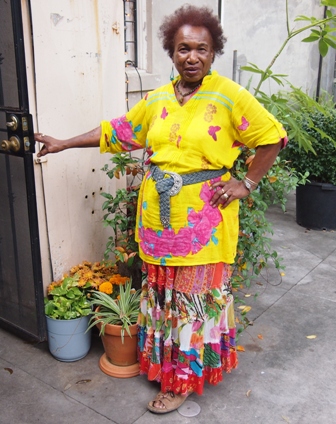 Priestess Miriam[/caption]
For many, the word voodoo conjures up vivid images of death cults, ritual sacrifice and downright spookiness. In New Orleans, voodooism is a widely accepted religion, densely woven into the fabric of this richly coloured city, a creed practiced openly by a significant minority of its citizens.
Priestess Miriam Chamani is the founder and Queen Mother of the Voodoo Spiritual Temple and Cultural Center. She cuts a striking figure dressed in a flowing skirt of many hues, a top to match and eyes that seem always in sharp focus.
A conversation with Priestess Miriam is manifold with parables. You don’t so much as chat as listen while she poses questions about the meaning of life and death following one question with another that may, or may not, answer her previous question. Her wisdom is offered in circular patterns, always returning to a central tenet, the importance of love and acceptance for all people no matter the religion or race and that life will go on while the dead are remembered.
[caption id="attachment_3836" align="alignnone" width="336"]
Priestess Miriam[/caption]
For many, the word voodoo conjures up vivid images of death cults, ritual sacrifice and downright spookiness. In New Orleans, voodooism is a widely accepted religion, densely woven into the fabric of this richly coloured city, a creed practiced openly by a significant minority of its citizens.
Priestess Miriam Chamani is the founder and Queen Mother of the Voodoo Spiritual Temple and Cultural Center. She cuts a striking figure dressed in a flowing skirt of many hues, a top to match and eyes that seem always in sharp focus.
A conversation with Priestess Miriam is manifold with parables. You don’t so much as chat as listen while she poses questions about the meaning of life and death following one question with another that may, or may not, answer her previous question. Her wisdom is offered in circular patterns, always returning to a central tenet, the importance of love and acceptance for all people no matter the religion or race and that life will go on while the dead are remembered.
[caption id="attachment_3836" align="alignnone" width="336"]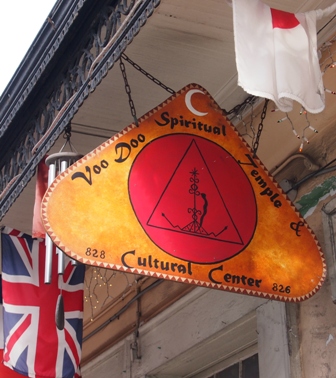 Voodoo Temple sign[/caption]
In her eclectically decorated temple, Miriam works her magic. Currency notes from round the world are pinned to a bewildering array of small shrines dedicated to just about every major religion. Paintings of saints adorn walls of numerous small rooms.
Attempting to take it all in, in just one corner of one room I saw a small stuffed alligator, beaded figures and ceramic figures ranging from a kitsch Jesus to an old photo of who I think was Albert Schweitzer.
But I didn’t see a voodoo doll festooned with pins anywhere.
Her inner sanctuary contains a desk overrunning with curios, crucifixes and divining bones. A computer is nearly hidden amongst the assortment, like an afterthought to 21st century connections.
[caption id="attachment_3837" align="alignnone" width="448"]
Voodoo Temple sign[/caption]
In her eclectically decorated temple, Miriam works her magic. Currency notes from round the world are pinned to a bewildering array of small shrines dedicated to just about every major religion. Paintings of saints adorn walls of numerous small rooms.
Attempting to take it all in, in just one corner of one room I saw a small stuffed alligator, beaded figures and ceramic figures ranging from a kitsch Jesus to an old photo of who I think was Albert Schweitzer.
But I didn’t see a voodoo doll festooned with pins anywhere.
Her inner sanctuary contains a desk overrunning with curios, crucifixes and divining bones. A computer is nearly hidden amongst the assortment, like an afterthought to 21st century connections.
[caption id="attachment_3837" align="alignnone" width="448"] Oven Vaults sign[/caption]
Before meeting Priestess Miriam I’d been on a walk with Robert Florence of Cemetery Voodoo Tours (www.tourneworleans.com). Florence is the author of New Orleans Cemeteries and City of the Dead, two authoritative books about how New Orleans has dealt with human mortality unlike anywhere else in the USA. He is also one of New Orleans top-rated guides. His ancestors also happen to be buried in New Orleans’ St Louis Cemetery #1.
Voodoo as practiced by Priestess Miriam reflects contemporary society’s attitude towards laissez-faire belief systems with lots of New Age influences. Borrowing like a magpie from most of the world’s main religions, her voodooism spreads the word via simple messages about love, eternal truth and the holy spirits. She also tells fortunes, spruiks natural healing and travels the world helping set up other voodoo chapters. Her latest project has been establishing a Russian branch of her temple.
(Update: Sadly an electrical fire damaged Mother Miriam’s temple 1 February 2016. Check www.voodoospiritualtemple.org before arranging a visit. Thankfully, no one was hurt.)
We had spent hours exploring the St Louis Cemetery #1 reading tombstones from early French settlers to Spanish conquistadors to German merchants, Irish, English and Scotch pioneers before visiting Priestess Miriam’s temple.
[caption id="attachment_3838" align="alignnone" width="384"]
Oven Vaults sign[/caption]
Before meeting Priestess Miriam I’d been on a walk with Robert Florence of Cemetery Voodoo Tours (www.tourneworleans.com). Florence is the author of New Orleans Cemeteries and City of the Dead, two authoritative books about how New Orleans has dealt with human mortality unlike anywhere else in the USA. He is also one of New Orleans top-rated guides. His ancestors also happen to be buried in New Orleans’ St Louis Cemetery #1.
Voodoo as practiced by Priestess Miriam reflects contemporary society’s attitude towards laissez-faire belief systems with lots of New Age influences. Borrowing like a magpie from most of the world’s main religions, her voodooism spreads the word via simple messages about love, eternal truth and the holy spirits. She also tells fortunes, spruiks natural healing and travels the world helping set up other voodoo chapters. Her latest project has been establishing a Russian branch of her temple.
(Update: Sadly an electrical fire damaged Mother Miriam’s temple 1 February 2016. Check www.voodoospiritualtemple.org before arranging a visit. Thankfully, no one was hurt.)
We had spent hours exploring the St Louis Cemetery #1 reading tombstones from early French settlers to Spanish conquistadors to German merchants, Irish, English and Scotch pioneers before visiting Priestess Miriam’s temple.
[caption id="attachment_3838" align="alignnone" width="384"] St Louis Cemetery #1 tombstone[/caption]
Established in 1789 when the Spanish government still ruled New Orleans, it’s the city’s oldest cemetery still in existence. By the late 18th century, New Orleans’ great St Louis cathedral needed more space in which to bury its parishioners. The city had grown from a colonial backwater French town into the new country’s greatest commercial cosmopolitan city after New York. When Napoleon sold Louisiana to the USA in 1803 to help fund his empire building in Europe, New Orleans subsequently became the gateway city to the vast new land acquisition, replete with untapped wealth and lots of room for new settlers.
[caption id="attachment_3864" align="alignnone" width="448"]
St Louis Cemetery #1 tombstone[/caption]
Established in 1789 when the Spanish government still ruled New Orleans, it’s the city’s oldest cemetery still in existence. By the late 18th century, New Orleans’ great St Louis cathedral needed more space in which to bury its parishioners. The city had grown from a colonial backwater French town into the new country’s greatest commercial cosmopolitan city after New York. When Napoleon sold Louisiana to the USA in 1803 to help fund his empire building in Europe, New Orleans subsequently became the gateway city to the vast new land acquisition, replete with untapped wealth and lots of room for new settlers.
[caption id="attachment_3864" align="alignnone" width="448"]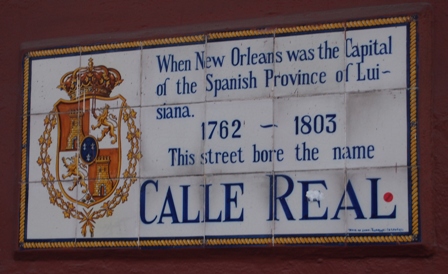 French Quarter street sign[/caption]
An earlier established cemetery, St Peter Street Cemetery was made redundant due to overcrowding in 1788 when over 80% of New Orleans burnt to the ground and approximately 1,200 people were killed. A new cemetery was created in boggy ground near the Basin St canal, the St Louis Cemetery #1. There are three St Louis Cemeteries around New Orleans today, but #1 is by far the most famous and most centrally located.
St Louis Cemetery #1 is the city’s prime burial ground. Many of the city’s most famous citizens are interred there, almost all above ground.
New Orleans’ marshlands impede burying the dead six feet under. Bodies in shallow graves tend to rise up out of sodden earth after a hurricane or severe flood. Consequently New Orleans’ cemeteries are an assembly of tightly packed mausoleums. This is the widely accepted explanation for above ground burial. The real reason was lack of space and the Catholic Church’s prohibition of cremation.
Resourceful morticians solved the problem of overcrowding the mausoleums by devising a uniquely New Orleans’ solution to the problem. The corpses are placed in wooden coffins, stuffed into the mausoleum for a traditionally allotted period of one year and one day, by which time the remains have ‘cooked’ in New Orleans’ sultry heat and been rendered into ash and bone, the wood almost completely rotted. The mausoleum is reopened after the officially tallied 366 days have passed. The wooden remnants are removed while the body’s remains are brushed to the rear of the chamber where they fall into an empty space discretely fitted to the back of the mausoleum thereby leaving the now empty shelf free for another corpse, an efficient though somewhat gruesome disposal of the dead.
Voodoo adherents honour their dead. Having evolved from a mixture of African animism, Catholicism and Pantheism, contemporary voodoo sanctifies life in equal measure to death. Links to Mexico’s Day of the Dead celebrations every 2nd of November are clear, New Orleans is separated from Mexico by only a short trip across the Gulf of Mexico after all.
One of the most famous tombs in St Louis Cemetery #1 is the Voodoo Queen’s, Marie Catherine Laveau.
[caption id="attachment_3839" align="alignnone" width="336"]
French Quarter street sign[/caption]
An earlier established cemetery, St Peter Street Cemetery was made redundant due to overcrowding in 1788 when over 80% of New Orleans burnt to the ground and approximately 1,200 people were killed. A new cemetery was created in boggy ground near the Basin St canal, the St Louis Cemetery #1. There are three St Louis Cemeteries around New Orleans today, but #1 is by far the most famous and most centrally located.
St Louis Cemetery #1 is the city’s prime burial ground. Many of the city’s most famous citizens are interred there, almost all above ground.
New Orleans’ marshlands impede burying the dead six feet under. Bodies in shallow graves tend to rise up out of sodden earth after a hurricane or severe flood. Consequently New Orleans’ cemeteries are an assembly of tightly packed mausoleums. This is the widely accepted explanation for above ground burial. The real reason was lack of space and the Catholic Church’s prohibition of cremation.
Resourceful morticians solved the problem of overcrowding the mausoleums by devising a uniquely New Orleans’ solution to the problem. The corpses are placed in wooden coffins, stuffed into the mausoleum for a traditionally allotted period of one year and one day, by which time the remains have ‘cooked’ in New Orleans’ sultry heat and been rendered into ash and bone, the wood almost completely rotted. The mausoleum is reopened after the officially tallied 366 days have passed. The wooden remnants are removed while the body’s remains are brushed to the rear of the chamber where they fall into an empty space discretely fitted to the back of the mausoleum thereby leaving the now empty shelf free for another corpse, an efficient though somewhat gruesome disposal of the dead.
Voodoo adherents honour their dead. Having evolved from a mixture of African animism, Catholicism and Pantheism, contemporary voodoo sanctifies life in equal measure to death. Links to Mexico’s Day of the Dead celebrations every 2nd of November are clear, New Orleans is separated from Mexico by only a short trip across the Gulf of Mexico after all.
One of the most famous tombs in St Louis Cemetery #1 is the Voodoo Queen’s, Marie Catherine Laveau.
[caption id="attachment_3839" align="alignnone" width="336"] Voodoo Queen tomb[/caption]
Laveau was a spiritual healer of African ancestry. Word of her expertise with herbal remedies combined with her sympathetic nature (and smart business acumen) spread like a Mississippi flood throughout New Orleans where she was a celebrated figure until her death in 1881 aged 80. Her exact birth date is unknown but it’s reckoned she was born in New Orleans in 1801. Like so many New Orleans’ celebrated figures, Marie Laveau’s life is a riddle of fact and fiction. She was a hairdresser, a liquor importer (bootlegger) and brothel owner.
She is now New Orleans’ most famous Voodoo Queen and her tomb in the St Louis Cemetery #1 is the most visited.
Offerings of food and drink are constantly left at her mausoleum, keeping the cemetery maintenance workers busy cleaning up the detritus. Florence disparaged the fast food offerings as an insult to her memory and complained that people had no sense if they thought fried chicken would honour her memory, ‘It just attracts rats,’ he said.
His comments about the actor Nicholas Cage’s tomb were equally critical. The Cage mausoleum is an ostentatious pyramid very unfitting when compared to the neo-Classical edifices surrounding it. Cage made a film in New Orleans, became infatuated with the place and decided he would be buried there. Florence commented that ‘He bought a number of homes here, too many by all accounts, made bad investments, sold some of them but kept this silly tomb.’
[caption id="attachment_3840" align="alignnone" width="403"]
Voodoo Queen tomb[/caption]
Laveau was a spiritual healer of African ancestry. Word of her expertise with herbal remedies combined with her sympathetic nature (and smart business acumen) spread like a Mississippi flood throughout New Orleans where she was a celebrated figure until her death in 1881 aged 80. Her exact birth date is unknown but it’s reckoned she was born in New Orleans in 1801. Like so many New Orleans’ celebrated figures, Marie Laveau’s life is a riddle of fact and fiction. She was a hairdresser, a liquor importer (bootlegger) and brothel owner.
She is now New Orleans’ most famous Voodoo Queen and her tomb in the St Louis Cemetery #1 is the most visited.
Offerings of food and drink are constantly left at her mausoleum, keeping the cemetery maintenance workers busy cleaning up the detritus. Florence disparaged the fast food offerings as an insult to her memory and complained that people had no sense if they thought fried chicken would honour her memory, ‘It just attracts rats,’ he said.
His comments about the actor Nicholas Cage’s tomb were equally critical. The Cage mausoleum is an ostentatious pyramid very unfitting when compared to the neo-Classical edifices surrounding it. Cage made a film in New Orleans, became infatuated with the place and decided he would be buried there. Florence commented that ‘He bought a number of homes here, too many by all accounts, made bad investments, sold some of them but kept this silly tomb.’
[caption id="attachment_3840" align="alignnone" width="403"]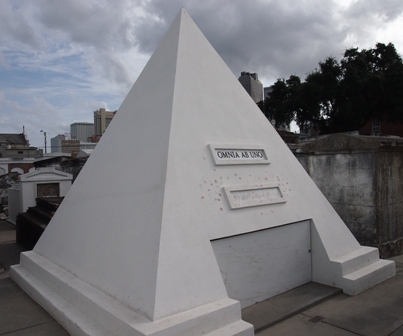 Nicholas Cage tomb[/caption]
Having spent hours on a fascinating walk amongst the living dead of the St Louis Cemetery #1and in the company of an authentic Voodoo Priestess, I can honestly say there’s more fiction than fact surrounding the reality of doing voodoo for a day in New Orleans but the facts are a hell of a lot more interesting.
Naked Tip: New Orleans boasts several commonly used nicknames: N’awlins, NOLA (New Orleans, LA (LA is the state of Louisiana’s official abbreviation) The Big Easy and the Crescent City.
[caption id="attachment_3841" align="alignnone" width="448"]
Nicholas Cage tomb[/caption]
Having spent hours on a fascinating walk amongst the living dead of the St Louis Cemetery #1and in the company of an authentic Voodoo Priestess, I can honestly say there’s more fiction than fact surrounding the reality of doing voodoo for a day in New Orleans but the facts are a hell of a lot more interesting.
Naked Tip: New Orleans boasts several commonly used nicknames: N’awlins, NOLA (New Orleans, LA (LA is the state of Louisiana’s official abbreviation) The Big Easy and the Crescent City.
[caption id="attachment_3841" align="alignnone" width="448"]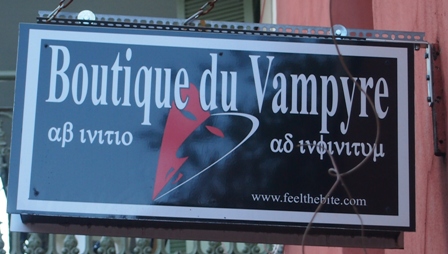 French Quarter shop sign[/caption]
NOLA is of course also famous for its nightlife, perfect for zombie inducing fantasies while the undead prefer moonlight over sunlight.
Grammy and Billboard award winner Irvin Mayfield hosts an improv jazz show Wednesday nights at the Royal Sonesta hotel in the French Quarter (300 Bourbon St. www.sonesta.com/royalneworleans) where budding new talent is invited to join the master on the small stage. Bookings are obligatory for this quintessential jam session.
[caption id="attachment_3842" align="alignnone" width="448"]
French Quarter shop sign[/caption]
NOLA is of course also famous for its nightlife, perfect for zombie inducing fantasies while the undead prefer moonlight over sunlight.
Grammy and Billboard award winner Irvin Mayfield hosts an improv jazz show Wednesday nights at the Royal Sonesta hotel in the French Quarter (300 Bourbon St. www.sonesta.com/royalneworleans) where budding new talent is invited to join the master on the small stage. Bookings are obligatory for this quintessential jam session.
[caption id="attachment_3842" align="alignnone" width="448"]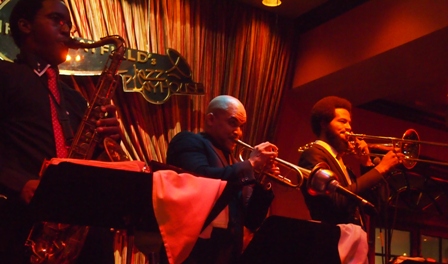 Irvin Mayfield playing trumpet[/caption]
Nearby the French Quarter is the Faubourg Bywater-Marigny district where in and around Frenchmen St. numerous jazz clubs draw in regular crowds of N’awlins’ style music. Heavy on brass, rich in history, soul and bravado, it’s the thumping beat of the Big Easy. Most clubs start hopping after 10pm. Cover charges if any are minimal. For the price of a drink, you get a memorable show.
By the way, both Sazerac and Hurricane cocktails were invented in NOLA. The former is a simple blend of rye whisky, bitters and absinthe, the latter a mix of dark and light rums, one of them overproof, Grenadine, passion fruit juice and lemon. Both are potent; you have been warned.
The love of food is the passion that drives this old city. Creole (a mix of Spanish, Native American and African), Cajun (French Canadian and Dixie) dominate the indigenous food culture.
[caption id="attachment_3843" align="alignnone" width="396"]
Irvin Mayfield playing trumpet[/caption]
Nearby the French Quarter is the Faubourg Bywater-Marigny district where in and around Frenchmen St. numerous jazz clubs draw in regular crowds of N’awlins’ style music. Heavy on brass, rich in history, soul and bravado, it’s the thumping beat of the Big Easy. Most clubs start hopping after 10pm. Cover charges if any are minimal. For the price of a drink, you get a memorable show.
By the way, both Sazerac and Hurricane cocktails were invented in NOLA. The former is a simple blend of rye whisky, bitters and absinthe, the latter a mix of dark and light rums, one of them overproof, Grenadine, passion fruit juice and lemon. Both are potent; you have been warned.
The love of food is the passion that drives this old city. Creole (a mix of Spanish, Native American and African), Cajun (French Canadian and Dixie) dominate the indigenous food culture.
[caption id="attachment_3843" align="alignnone" width="396"] Chartres St French Quarter scene[/caption]
The French Market near the river, oldest of its kind in the USA, spanning six blocks at the bottom of the French Quarter is open daily. Once a small meat market spread around the equally famous Cafe du Monde, it expanded over the years to encompass a long covered arcade packed with food stalls, produce carts, tourist shops and some of the best people watching in town. The freshly shucked oysters served with lemon wedges, crackers and Tabasco sauce were my top pick. (Tabasco sauce is made in Cajun country approximately two hundred kilometres west of New Orleans on Avery Island. Daily tours are highly recommended www.tabasco.com)
New Orleans is full of terrific restaurants, far too many to list here. Some are clearly best avoided dives (the west end of Bourbon St is the main tourist zone, suffering from a surfeit of cheap looking bars with overpriced bad food) while many are cutting edge bonanzas of produce driven excellence.
[caption id="attachment_3845" align="alignnone" width="406"]
Chartres St French Quarter scene[/caption]
The French Market near the river, oldest of its kind in the USA, spanning six blocks at the bottom of the French Quarter is open daily. Once a small meat market spread around the equally famous Cafe du Monde, it expanded over the years to encompass a long covered arcade packed with food stalls, produce carts, tourist shops and some of the best people watching in town. The freshly shucked oysters served with lemon wedges, crackers and Tabasco sauce were my top pick. (Tabasco sauce is made in Cajun country approximately two hundred kilometres west of New Orleans on Avery Island. Daily tours are highly recommended www.tabasco.com)
New Orleans is full of terrific restaurants, far too many to list here. Some are clearly best avoided dives (the west end of Bourbon St is the main tourist zone, suffering from a surfeit of cheap looking bars with overpriced bad food) while many are cutting edge bonanzas of produce driven excellence.
[caption id="attachment_3845" align="alignnone" width="406"]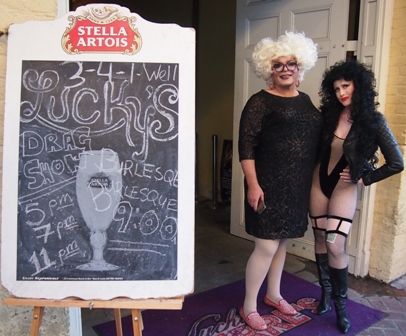 Bourbon St drag club hostesses[/caption]
From plain down home cafes where fried chicken is so popular that queues begin snaking around the block well before lunch time (such as the fabulous Willie Mae’s Scotch House in operation since 1957, 2401 St. Ann St or Dooky Chase’s Restaurant, 2301 Orleans Ave.) to upscale palaces where service is sublime, the drinks powerful and the food exquisite.
Naked Tip: My top pick is the Commander’s Palace in the Garden District, a street car named desire’s ride from the CBD, 1403 Washington Ave www.commanderspalace.com operating since 1880 and in the same family hands since early last century. Book first!
This is a city where the inhabitants are led by their nose directly to their stomachs.
[caption id="attachment_3861" align="alignnone" width="435"]
Bourbon St drag club hostesses[/caption]
From plain down home cafes where fried chicken is so popular that queues begin snaking around the block well before lunch time (such as the fabulous Willie Mae’s Scotch House in operation since 1957, 2401 St. Ann St or Dooky Chase’s Restaurant, 2301 Orleans Ave.) to upscale palaces where service is sublime, the drinks powerful and the food exquisite.
Naked Tip: My top pick is the Commander’s Palace in the Garden District, a street car named desire’s ride from the CBD, 1403 Washington Ave www.commanderspalace.com operating since 1880 and in the same family hands since early last century. Book first!
This is a city where the inhabitants are led by their nose directly to their stomachs.
[caption id="attachment_3861" align="alignnone" width="435"]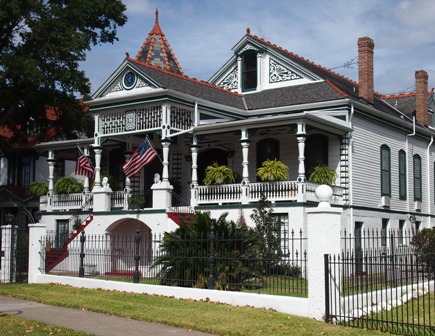 House near City Park[/caption]
Naked Tip: Ask a local foodie or the concierge at your hotel for what’s hot at the moment. Preferences change faster than shoes on a Milan fashion show runway.
[caption id="attachment_3844" align="alignnone" width="336"]
House near City Park[/caption]
Naked Tip: Ask a local foodie or the concierge at your hotel for what’s hot at the moment. Preferences change faster than shoes on a Milan fashion show runway.
[caption id="attachment_3844" align="alignnone" width="336"]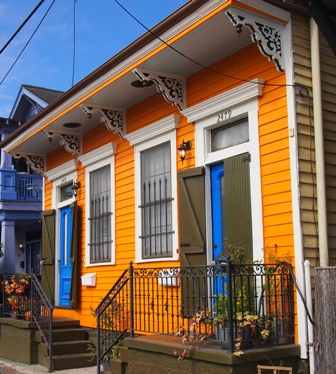 A typical brightly painted Marigny house[/caption]
Bicycling is a terrific way to explore this flat-as-a-crepe city. I joined an excellent bike tour offered by FreeWheelin’ Bike Tours led by a friendly guide whose knowledge of NOLA was encyclopaedic, shared freely while interspersed by witty jokes. Taking in NOLA’s most historic sights during a half day’s easy pedalling was truly laissez les bons temps roulez. (See www.neworleansbiketour.com 325 Burgundy St. in the French Quarter, for a complete listing of their daily tours.)
[caption id="attachment_3846" align="alignnone" width="393"]
A typical brightly painted Marigny house[/caption]
Bicycling is a terrific way to explore this flat-as-a-crepe city. I joined an excellent bike tour offered by FreeWheelin’ Bike Tours led by a friendly guide whose knowledge of NOLA was encyclopaedic, shared freely while interspersed by witty jokes. Taking in NOLA’s most historic sights during a half day’s easy pedalling was truly laissez les bons temps roulez. (See www.neworleansbiketour.com 325 Burgundy St. in the French Quarter, for a complete listing of their daily tours.)
[caption id="attachment_3846" align="alignnone" width="393"] FreeWheelin bike tour pedallers[/caption]
[caption id="attachment_3863" align="alignnone" width="392"]
FreeWheelin bike tour pedallers[/caption]
[caption id="attachment_3863" align="alignnone" width="392"]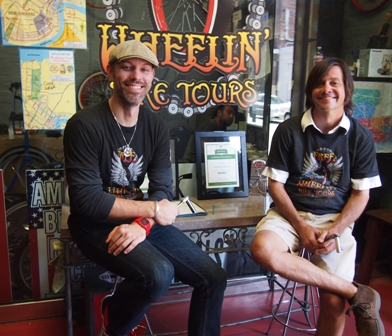 FreeWheelin Bike Tours owner/guides[/caption]
During the half day’s pedalling around NOLA, we stopped at the heart-breaking Monument to the Unknown Slave in the Marigny District. New Orleans, along with Charleston, SC operated one of the two largest slave markets in pre-Civil War USA.
[caption id="attachment_3847" align="alignnone" width="350"]
FreeWheelin Bike Tours owner/guides[/caption]
During the half day’s pedalling around NOLA, we stopped at the heart-breaking Monument to the Unknown Slave in the Marigny District. New Orleans, along with Charleston, SC operated one of the two largest slave markets in pre-Civil War USA.
[caption id="attachment_3847" align="alignnone" width="350"]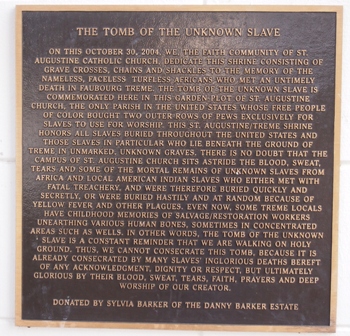 Unknown Slave monument sign[/caption]
[caption id="attachment_3848" align="alignnone" width="395"]
Unknown Slave monument sign[/caption]
[caption id="attachment_3848" align="alignnone" width="395"] Unknown Slave Monument[/caption]
From the Marigny and Bywater Districts we headed up to the glorious City Park, 50% larger than New York’s Central Park and one of the oldest in the USA. With its New Orleans Museum of Art and hundreds of live oak trees (some over 600 years old), it’s one of the loveliest green spaces around.
[caption id="attachment_3849" align="alignnone" width="448"]
Unknown Slave Monument[/caption]
From the Marigny and Bywater Districts we headed up to the glorious City Park, 50% larger than New York’s Central Park and one of the oldest in the USA. With its New Orleans Museum of Art and hundreds of live oak trees (some over 600 years old), it’s one of the loveliest green spaces around.
[caption id="attachment_3849" align="alignnone" width="448"]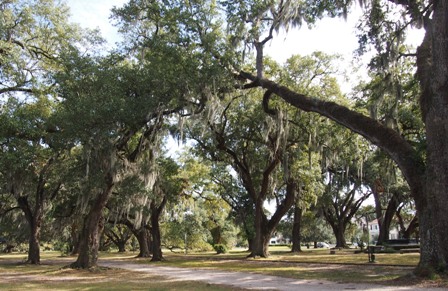 City Park live oaks[/caption]
[caption id="attachment_3850" align="alignnone" width="448"]
City Park live oaks[/caption]
[caption id="attachment_3850" align="alignnone" width="448"]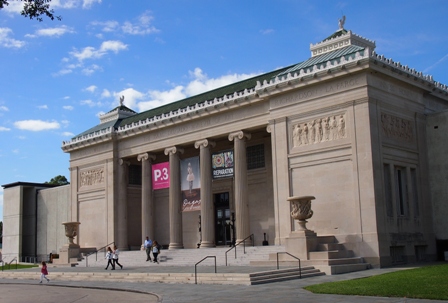 New Orleans Museum of Art in City Park[/caption]
On the way back to the French Quarter we stopped in Rampart St to visit the Mahalia Jackson Theater for the Performing Arts with an iconic statue of Louis Armstrong in the forecourt. A show here is a must-do experience while in New Orleans.
[caption id="attachment_3851" align="alignnone" width="336"]
New Orleans Museum of Art in City Park[/caption]
On the way back to the French Quarter we stopped in Rampart St to visit the Mahalia Jackson Theater for the Performing Arts with an iconic statue of Louis Armstrong in the forecourt. A show here is a must-do experience while in New Orleans.
[caption id="attachment_3851" align="alignnone" width="336"] Louis Armstrong statue[/caption]
[caption id="attachment_3852" align="alignnone" width="376"]
Louis Armstrong statue[/caption]
[caption id="attachment_3852" align="alignnone" width="376"] Mahalia Jackson Theater for the Performing Arts[/caption]
Lost Land Tours (www.lostlandtours.org) run kayak trips in threatened eco-systems closest to New Orleans. Small group tours (no more than six people) are conducted by well trained experts in ecology, wildlife and the state’s dubious reputation for environmental mismanagement. (The US Army Corps of Engineers constructed so many levees that New Orleans’ very existence is under real jeopardy from inundation due to encroaching waters from the Gulf of Mexico.)
[caption id="attachment_3853" align="alignnone" width="448"]
Mahalia Jackson Theater for the Performing Arts[/caption]
Lost Land Tours (www.lostlandtours.org) run kayak trips in threatened eco-systems closest to New Orleans. Small group tours (no more than six people) are conducted by well trained experts in ecology, wildlife and the state’s dubious reputation for environmental mismanagement. (The US Army Corps of Engineers constructed so many levees that New Orleans’ very existence is under real jeopardy from inundation due to encroaching waters from the Gulf of Mexico.)
[caption id="attachment_3853" align="alignnone" width="448"] Bayou scene[/caption]
One of the best days I spent in this city unlike any other in the USA was while paddling ten kilometres up and down an eerily quiet bayou north of the CBD just west of Lake Pontchartrain. The peace was interrupted by alligators splashing off logs, bald eagles occasionally screeching overhead, turtles plopping from muddy banks into still water and flocks of herons, wings flapping lazily above. Paddling waist height, gliding silently through the ebony coloured bayou surrounded by goldenrod, lilies, wild orchids and irises, looking out for wildlife... was a wonder.
[caption id="attachment_3854" align="alignnone" width="372"]
Bayou scene[/caption]
One of the best days I spent in this city unlike any other in the USA was while paddling ten kilometres up and down an eerily quiet bayou north of the CBD just west of Lake Pontchartrain. The peace was interrupted by alligators splashing off logs, bald eagles occasionally screeching overhead, turtles plopping from muddy banks into still water and flocks of herons, wings flapping lazily above. Paddling waist height, gliding silently through the ebony coloured bayou surrounded by goldenrod, lilies, wild orchids and irises, looking out for wildlife... was a wonder.
[caption id="attachment_3854" align="alignnone" width="372"]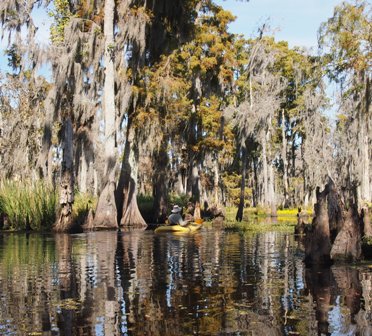 Bayou kayak guide[/caption]
[caption id="attachment_3855" align="alignnone" width="367"]
Bayou kayak guide[/caption]
[caption id="attachment_3855" align="alignnone" width="367"]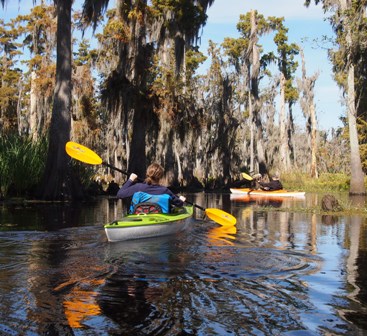 Kayaks on the bayou[/caption]
[caption id="attachment_3856" align="alignnone" width="448"]
Kayaks on the bayou[/caption]
[caption id="attachment_3856" align="alignnone" width="448"]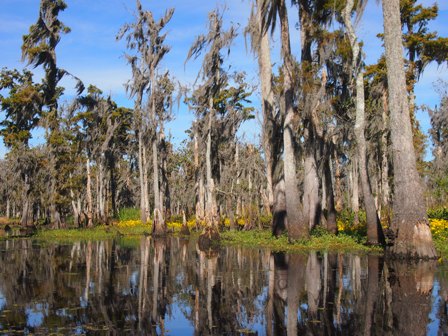 Still waters on the bayou[/caption]
This experience is all about education; it’s not a ‘gator hunt’ like other operators spruik to attract gawking tourists, a thoroughly authentic immersive and educational experience.
New Orleans offers a variety of walking tours. I recommend a Garden District architectural tour to get a better idea of what this alternative to the French Quarter’s sometimes maddening tourist scene offers. Tres elegant in parts, raffish in others, the Garden District provides a rich chocolate box array of grand houses, gracious public squares surrounded by oak trees draped in Spanish moss and a hodge-podge of trendy boutiques and fashionable cafes. See www.neworleans.com/tours/shop/garden-district for more information.
[caption id="attachment_3857" align="alignnone" width="448"]
Still waters on the bayou[/caption]
This experience is all about education; it’s not a ‘gator hunt’ like other operators spruik to attract gawking tourists, a thoroughly authentic immersive and educational experience.
New Orleans offers a variety of walking tours. I recommend a Garden District architectural tour to get a better idea of what this alternative to the French Quarter’s sometimes maddening tourist scene offers. Tres elegant in parts, raffish in others, the Garden District provides a rich chocolate box array of grand houses, gracious public squares surrounded by oak trees draped in Spanish moss and a hodge-podge of trendy boutiques and fashionable cafes. See www.neworleans.com/tours/shop/garden-district for more information.
[caption id="attachment_3857" align="alignnone" width="448"] Evening in the Garden District[/caption]
New Orleans is a city everyone should visit at least once.
That being said, I dare you to limit your visits to just one.
Tom Neal Tacker visited New Orleans as a guest of the New Orleans CVB.
[caption id="attachment_3858" align="alignnone" width="360"]
Evening in the Garden District[/caption]
New Orleans is a city everyone should visit at least once.
That being said, I dare you to limit your visits to just one.
Tom Neal Tacker visited New Orleans as a guest of the New Orleans CVB.
[caption id="attachment_3858" align="alignnone" width="360"]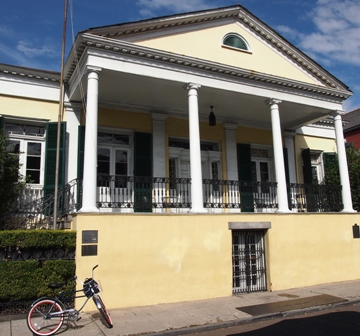 French Quarter house[/caption]
[caption id="attachment_3859" align="alignnone" width="435"]
French Quarter house[/caption]
[caption id="attachment_3859" align="alignnone" width="435"] Marigny fuel stop shop[/caption]
Naked Facts:
www.neworleanscvb.com is a one-stop shop for general tourism inquiries about New Orleans.
Naked Routes:
Louis Armstrong New Orleans International Airport is approximately 19 kilometres west of the city’s downtown and adjoining French Quarter. Most major USA based airlines offer frequent connections to New Orleans from their hub airports.
Naked Sleeps:
The Le Richelieu is an historic boutique hotel ideally located in Chartres St (pronounced ‘Charters’) at the eastern and more peaceful residential end of the French Quarter, very close to the French Market and numerous cafes, restaurants and shops. Unusual for New Orleans’ small hotels it boasts a large swimming pool and garden. Rooms are decorated in 19th century period style, a mix of French and Spanish neo-Classical furnishings with contemporary flourishes. See www.lerichelieuhotel.com
[caption id="attachment_3862" align="alignnone" width="448"]
Marigny fuel stop shop[/caption]
Naked Facts:
www.neworleanscvb.com is a one-stop shop for general tourism inquiries about New Orleans.
Naked Routes:
Louis Armstrong New Orleans International Airport is approximately 19 kilometres west of the city’s downtown and adjoining French Quarter. Most major USA based airlines offer frequent connections to New Orleans from their hub airports.
Naked Sleeps:
The Le Richelieu is an historic boutique hotel ideally located in Chartres St (pronounced ‘Charters’) at the eastern and more peaceful residential end of the French Quarter, very close to the French Market and numerous cafes, restaurants and shops. Unusual for New Orleans’ small hotels it boasts a large swimming pool and garden. Rooms are decorated in 19th century period style, a mix of French and Spanish neo-Classical furnishings with contemporary flourishes. See www.lerichelieuhotel.com
[caption id="attachment_3862" align="alignnone" width="448"]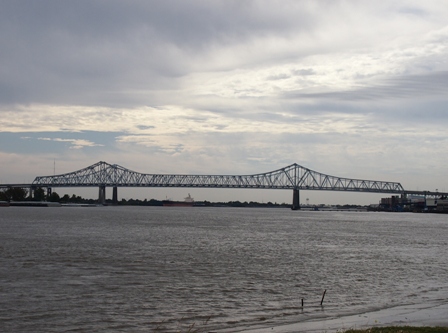 Muddy Mississippi River rolling along[/caption]
Muddy Mississippi River rolling along[/caption]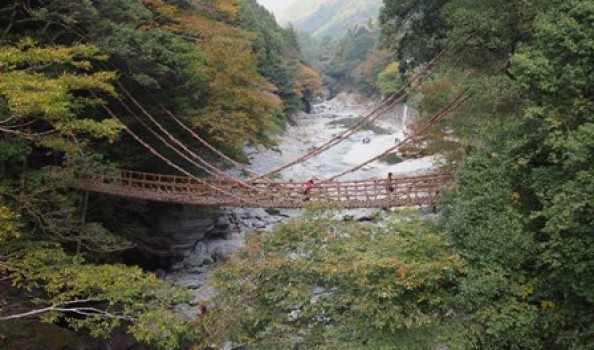 https://nakedhungrytraveller.com.au/shikoku-japans-not-so-little-island/ Shikoku, Japan's Not So Little IslandShikoku? Haven’t heard of it? If you’ve been wondering how to discover a relatively untouched Japan, this could be your best option. Fourth in size among Japan’s main islands (Honshu, Kyushu and Hokkaido are the other three) and least known to most international travellers, it’s a bit off the beaten track but easily accessible from western Honshu. Osaka’s two airports (Kansai and Itami) are a couple hours drive via a series of bridges across the eastern end of the (Seto) Inland Sea and Awaji Island. Japan’s impressive railway network also provides quick entry to Shikoku from Hiroshima, Osaka and Kyoto. (See www.jbtravel.com.au/japan-rail-pass.com for advance purchase of a week’s rail pass including the ‘All Shikoku Rail Pass’.)
https://nakedhungrytraveller.com.au/shikoku-japans-not-so-little-island/ Shikoku, Japan's Not So Little IslandShikoku? Haven’t heard of it? If you’ve been wondering how to discover a relatively untouched Japan, this could be your best option. Fourth in size among Japan’s main islands (Honshu, Kyushu and Hokkaido are the other three) and least known to most international travellers, it’s a bit off the beaten track but easily accessible from western Honshu. Osaka’s two airports (Kansai and Itami) are a couple hours drive via a series of bridges across the eastern end of the (Seto) Inland Sea and Awaji Island. Japan’s impressive railway network also provides quick entry to Shikoku from Hiroshima, Osaka and Kyoto. (See www.jbtravel.com.au/japan-rail-pass.com for advance purchase of a week’s rail pass including the ‘All Shikoku Rail Pass’.)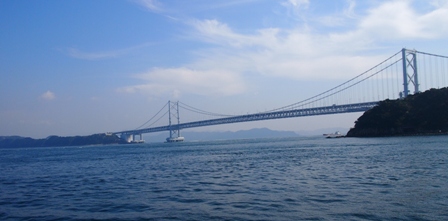 Naruto Strait bridge
Shikoku’s northern side which faces the (Seto) Inland Sea is the most populated while offering easiest access to its top sights.
Driving from Osaka via Kobe, you cross Awaji Island over the Naruto Strait. Look down (there’s a viewing platform complete with transparent reinforced glass) and see whirlpools. Seen from below during a short sightseeing cruise, the Naruto suspension bridge soaring overhead adds extra dramatic effect. Listed for inclusion to UNESCO World Heritage status, the whirlpools are an impressive natural feature caused by massive tidal change from the Pacific Ocean to the (Seto) Inland Sea through the narrow 1.2 kilometre wide strait.
Naruto Strait bridge
Shikoku’s northern side which faces the (Seto) Inland Sea is the most populated while offering easiest access to its top sights.
Driving from Osaka via Kobe, you cross Awaji Island over the Naruto Strait. Look down (there’s a viewing platform complete with transparent reinforced glass) and see whirlpools. Seen from below during a short sightseeing cruise, the Naruto suspension bridge soaring overhead adds extra dramatic effect. Listed for inclusion to UNESCO World Heritage status, the whirlpools are an impressive natural feature caused by massive tidal change from the Pacific Ocean to the (Seto) Inland Sea through the narrow 1.2 kilometre wide strait.
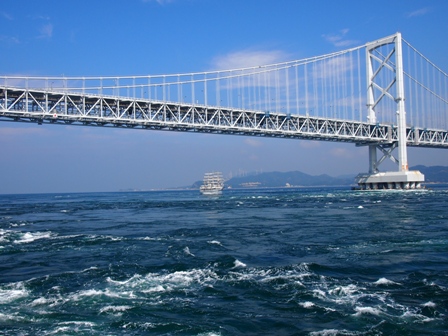 Naruto whirlpools
No accompanying stories about mythical dragons swallowing fishing boats or sea monsters inhabiting dangerous waters (I asked the boat captain about ancient lore) but the whirlpools, some stretching twenty metres across, are impressive nonetheless.
Best viewed from the water, Naruto Kanko Kisen sightseeing tours make regular daily trips to the swirling vortexes from nearby Naruto marina. Check tide tables beforehand to gauge prime whirlpool action. When the tide is running high (Spring and Autumn full moons are best), the twisting currents could indeed hide a Godzilla or two.
Naruto whirlpools
No accompanying stories about mythical dragons swallowing fishing boats or sea monsters inhabiting dangerous waters (I asked the boat captain about ancient lore) but the whirlpools, some stretching twenty metres across, are impressive nonetheless.
Best viewed from the water, Naruto Kanko Kisen sightseeing tours make regular daily trips to the swirling vortexes from nearby Naruto marina. Check tide tables beforehand to gauge prime whirlpool action. When the tide is running high (Spring and Autumn full moons are best), the twisting currents could indeed hide a Godzilla or two.
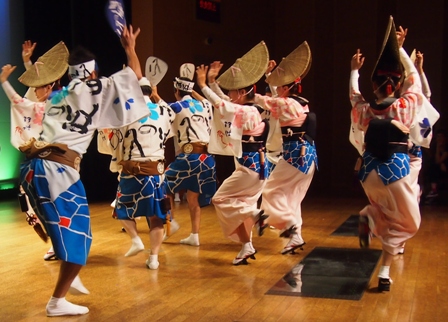 Awa-Dori dancers in full flight
Nearby Tokushima is a small city famous for its annual Awa-Odori Dance Festival. A ritualised dance in remembrance of the dead is held in mid-August during the national Buddhist/Shinto Bon Festival though local dance troupes meet regularly year round to practice technique in hopes to gain a prize and national fame during the big shindig.
Awa-Dori dancers in full flight
Nearby Tokushima is a small city famous for its annual Awa-Odori Dance Festival. A ritualised dance in remembrance of the dead is held in mid-August during the national Buddhist/Shinto Bon Festival though local dance troupes meet regularly year round to practice technique in hopes to gain a prize and national fame during the big shindig.
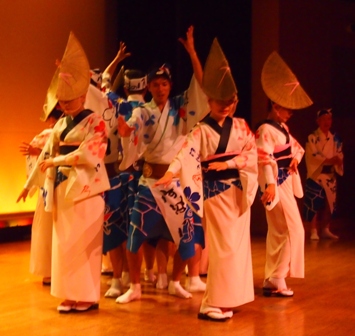 Awa-Dori dancers
Dancers chant, ‘The dancers are fools, the watchers are fools, both are so alike, so why not dance’, while doing the Awa-Dori shuffle.
Awa-Dori dancers
Dancers chant, ‘The dancers are fools, the watchers are fools, both are so alike, so why not dance’, while doing the Awa-Dori shuffle.
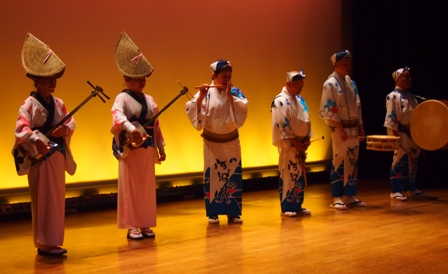 Awa-Dori band at Kaikan museum theatre
Hands are raised up like you’re attempting a swan dive into a deep pool and your feet, toes first, step in time with the music. Awa-Dori is deceptively easy looking to perform. In reality it’s anything but. The accompanying lutes, flutes and taiko drums establish a punishing rhythm.
Awa-Dori band at Kaikan museum theatre
Hands are raised up like you’re attempting a swan dive into a deep pool and your feet, toes first, step in time with the music. Awa-Dori is deceptively easy looking to perform. In reality it’s anything but. The accompanying lutes, flutes and taiko drums establish a punishing rhythm.
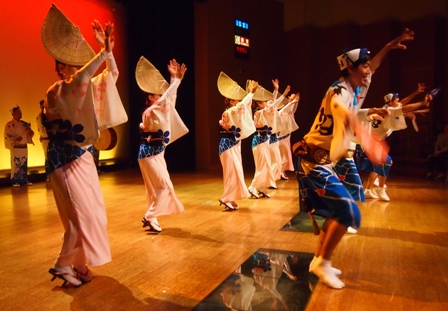 Awa-Dori dancers
The Awa Dance Festival dominates the city’s tourist scene. Attracting over a million visitors, accommodation is booked out well in advance in Tokushima and nearby towns. This is a huge event in Japan but not well known to international travellers.
[caption id="attachment_3572" align="alignnone" width="304"]
Awa-Dori dancers
The Awa Dance Festival dominates the city’s tourist scene. Attracting over a million visitors, accommodation is booked out well in advance in Tokushima and nearby towns. This is a huge event in Japan but not well known to international travellers.
[caption id="attachment_3572" align="alignnone" width="304"] Poised Awa-Dori dancer[/caption]
Street bars and cafes are open until late at night. More formal scheduled Awa-Dori dance performances can be seen throughout the day in various theatres and impromptu spaces set up just for the festival. Each evening however from 6pm until about 10:30pm the streets are packed with thousands of participants doing the Awa-Dori in a massive parade. If you want to get your jiggle on, this is the place.
Viewing stands are set up for non-terpsichorean observers though everyone is encouraged to join the festivities, like a Japanese version of Brazil’s Mardi Gras in Rio de Janeiro.
Outside festival season, Awa-Odori can be seen during daily shows in Tokushima at the Awadori-Kaikan Museum located in the town centre. It’s worth visiting for an intriguing insight into Japan’s rich cultural history.
Takamatsu is another small city not far from Tokushima on the (Seto) Inland Sea.
[caption id="attachment_3573" align="alignnone" width="336"]
Poised Awa-Dori dancer[/caption]
Street bars and cafes are open until late at night. More formal scheduled Awa-Dori dance performances can be seen throughout the day in various theatres and impromptu spaces set up just for the festival. Each evening however from 6pm until about 10:30pm the streets are packed with thousands of participants doing the Awa-Dori in a massive parade. If you want to get your jiggle on, this is the place.
Viewing stands are set up for non-terpsichorean observers though everyone is encouraged to join the festivities, like a Japanese version of Brazil’s Mardi Gras in Rio de Janeiro.
Outside festival season, Awa-Odori can be seen during daily shows in Tokushima at the Awadori-Kaikan Museum located in the town centre. It’s worth visiting for an intriguing insight into Japan’s rich cultural history.
Takamatsu is another small city not far from Tokushima on the (Seto) Inland Sea.
[caption id="attachment_3573" align="alignnone" width="336"] Drying udon ready for the pot[/caption]
Shikoku’s udon noodles are unique in Japan; indeed every region sports at least one special dish or preparation and Takamatsu udon are particularly well favoured.
[caption id="attachment_3574" align="alignnone" width="448"]
Drying udon ready for the pot[/caption]
Shikoku’s udon noodles are unique in Japan; indeed every region sports at least one special dish or preparation and Takamatsu udon are particularly well favoured.
[caption id="attachment_3574" align="alignnone" width="448"] Udon noodle class teacher Tanaka-san[/caption]
Udon noodle making classes are available at Nakano Udon School. Taking approximately two hours to complete, the package includes lunch and is fun for keen cooks and innocent bystanders alike. Book well ahead to secure a place; the create your own udon sessions are justly popular.
[caption id="attachment_3575" align="alignnone" width="448"]
Udon noodle class teacher Tanaka-san[/caption]
Udon noodle making classes are available at Nakano Udon School. Taking approximately two hours to complete, the package includes lunch and is fun for keen cooks and innocent bystanders alike. Book well ahead to secure a place; the create your own udon sessions are justly popular.
[caption id="attachment_3575" align="alignnone" width="448"] Ever smiling Tanaka-san[/caption]
My teacher, the engaging and fun Tanaka-san was a pint-sized dynamo who, during vigorous noodle kneading had her students laughing heartily in tune with Japanese pop music while she danced with a tambourine in hand. Who knew a cooking class could become a karaoke session?
Ever smiling Tanaka-san[/caption]
My teacher, the engaging and fun Tanaka-san was a pint-sized dynamo who, during vigorous noodle kneading had her students laughing heartily in tune with Japanese pop music while she danced with a tambourine in hand. Who knew a cooking class could become a karaoke session?
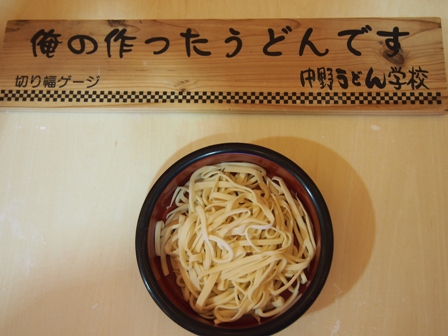 Udon ready for cooking
Udon noodles require a fair bit of massaging. The plastic wrapped noodle dough is worked by jumping on it in time with the music. Hand kneading isn’t enough. Though the recipe is simple: flour, water and salt, perfection of the udon is nothing but simple. Once your noodle dough is ready, you fold into three pleats, cut into thin strands, dry by hanging over a wooden cylinder for about ten minutes and then cook in simmering dashi stock.
Udon ready for cooking
Udon noodles require a fair bit of massaging. The plastic wrapped noodle dough is worked by jumping on it in time with the music. Hand kneading isn’t enough. Though the recipe is simple: flour, water and salt, perfection of the udon is nothing but simple. Once your noodle dough is ready, you fold into three pleats, cut into thin strands, dry by hanging over a wooden cylinder for about ten minutes and then cook in simmering dashi stock.
 Udon cooking in dashi
Lunch is served in an adjoining dining room, your freshly prepared udon being the star course.
Udon cooking in dashi
Lunch is served in an adjoining dining room, your freshly prepared udon being the star course.
 Foot kneading udon dough
(A curious side-note: karaoke dancing was once banned after midnight in many Japanese cities. Imaginative devotees brought udon noodle dough in plastic bags to clubs for jumping on to get round the ban. Apparently, you can bounce on dough and recover later from a strenuous routine by eating your noodles.)
Also in Takamatsu is the absolutely lovely Ritsurin garden, dedicated in 1953 as a National Place of Special Scenic Beauty.
Foot kneading udon dough
(A curious side-note: karaoke dancing was once banned after midnight in many Japanese cities. Imaginative devotees brought udon noodle dough in plastic bags to clubs for jumping on to get round the ban. Apparently, you can bounce on dough and recover later from a strenuous routine by eating your noodles.)
Also in Takamatsu is the absolutely lovely Ritsurin garden, dedicated in 1953 as a National Place of Special Scenic Beauty.
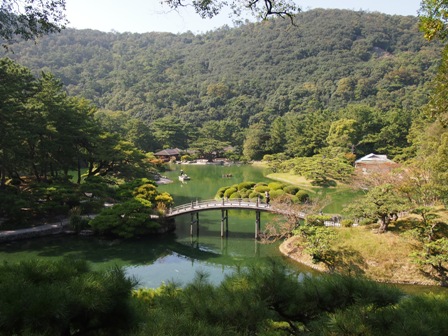 Ritsurin lake and gardens
One of the country’s most famous gardens for its sublime ‘daimyo strolling’ horticultural design and ancient stands of Hakomatsu (box pine) and a special Neagari Goyo-matsu (a five-needle pine bonsai gifted in 1833 from the 11th Tokugawa Shogun), its 16 hectares of dedicated garden area is a sublime urban retreat, a Zen master plan of utter peacefulness.
[caption id="attachment_3523" align="alignnone" width="398"]
Ritsurin lake and gardens
One of the country’s most famous gardens for its sublime ‘daimyo strolling’ horticultural design and ancient stands of Hakomatsu (box pine) and a special Neagari Goyo-matsu (a five-needle pine bonsai gifted in 1833 from the 11th Tokugawa Shogun), its 16 hectares of dedicated garden area is a sublime urban retreat, a Zen master plan of utter peacefulness.
[caption id="attachment_3523" align="alignnone" width="398"] Ancient box pines at Ritsurin[/caption]
Within the garden is the Kikugetsu-tei teahouse which dates from over three centuries ago and continues to offer authentic tea ceremonies, green and pungent matcha tea being the preferred tipple.
Ancient box pines at Ritsurin[/caption]
Within the garden is the Kikugetsu-tei teahouse which dates from over three centuries ago and continues to offer authentic tea ceremonies, green and pungent matcha tea being the preferred tipple.
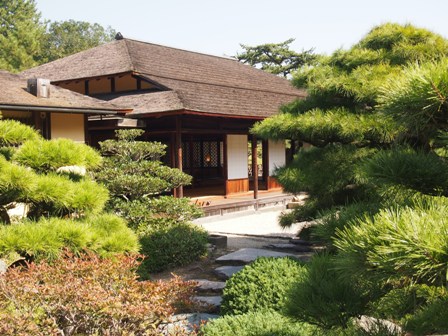 Ritsurin tea house
Volunteer guides are available for visits to Ritsurin and come highly recommended. My two 70-something guides added a personal touch; they’d both worked at Ritsurin for many years. Their emotional attachment to the place was clearly evident. Ask at the ticket office upon entry if any English speaking guides are available.
[caption id="attachment_3522" align="alignnone" width="310"]
Ritsurin tea house
Volunteer guides are available for visits to Ritsurin and come highly recommended. My two 70-something guides added a personal touch; they’d both worked at Ritsurin for many years. Their emotional attachment to the place was clearly evident. Ask at the ticket office upon entry if any English speaking guides are available.
[caption id="attachment_3522" align="alignnone" width="310"] Volunteer guides at Ritsurin[/caption]
[caption id="attachment_3581" align="alignnone" width="448"]
Volunteer guides at Ritsurin[/caption]
[caption id="attachment_3581" align="alignnone" width="448"] Boating on lake at Ritsurin[/caption]
Near Takamatsu is an easily accessible reminder of Shikoku’s rural past. The Shikoku Folk House Museum located in hills outside Yashima is a recreated 18th century village set in forested slopes complete with a waterfall and koi-filled lily ponds.
[caption id="attachment_3524" align="alignnone" width="328"]
Boating on lake at Ritsurin[/caption]
Near Takamatsu is an easily accessible reminder of Shikoku’s rural past. The Shikoku Folk House Museum located in hills outside Yashima is a recreated 18th century village set in forested slopes complete with a waterfall and koi-filled lily ponds.
[caption id="attachment_3524" align="alignnone" width="328"]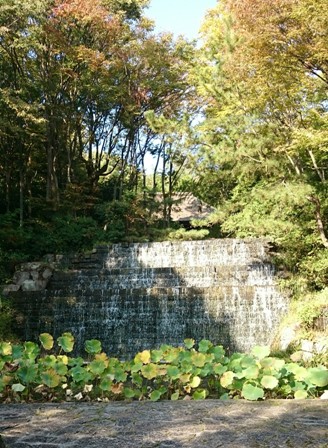 Old Shikoku village waterfall[/caption]
It’s crowded with restored buildings collected from various villages around Shikoku, from various shops to a water powered rice mill, private residences and a full sized kabuki theatre which features frequent performances.
[caption id="attachment_3525" align="alignnone" width="448"]
Old Shikoku village waterfall[/caption]
It’s crowded with restored buildings collected from various villages around Shikoku, from various shops to a water powered rice mill, private residences and a full sized kabuki theatre which features frequent performances.
[caption id="attachment_3525" align="alignnone" width="448"]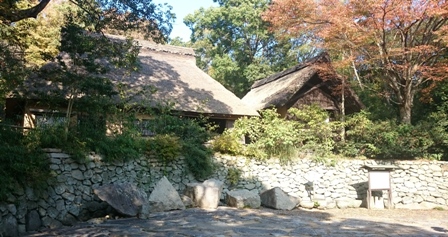 Old Shikoku houses[/caption]
Shikoku’s mountainous interior boasts Japan’s longest white water rafting river and beautiful evergreen forest scenery.
[caption id="attachment_3526" align="alignnone" width="334"]
Old Shikoku houses[/caption]
Shikoku’s mountainous interior boasts Japan’s longest white water rafting river and beautiful evergreen forest scenery.
[caption id="attachment_3526" align="alignnone" width="334"]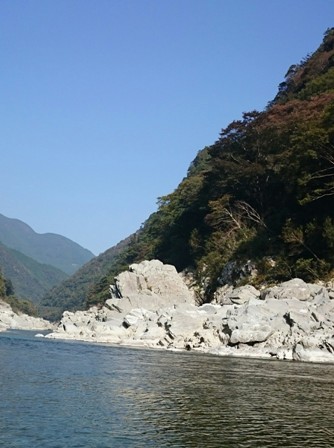 Oboke Gorge cliffs[/caption]
The Yoshino River in the Mt Tsurugi National Park in the Kochi Prefecture is best known for its geologically interesting Oboke Gorge, a narrow defile running through glistening cliffs lined with white crystalline schist.
[caption id="attachment_3583" align="alignnone" width="448"]
Oboke Gorge cliffs[/caption]
The Yoshino River in the Mt Tsurugi National Park in the Kochi Prefecture is best known for its geologically interesting Oboke Gorge, a narrow defile running through glistening cliffs lined with white crystalline schist.
[caption id="attachment_3583" align="alignnone" width="448"]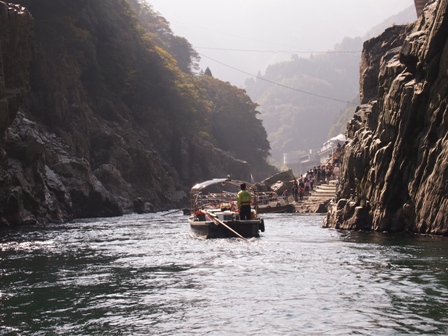 Oboke Gorge boat cruise[/caption]
Frequent small boat cruises ferry visitors up and down the gorge when weather permits.
Oboke Gorge boat cruise[/caption]
Frequent small boat cruises ferry visitors up and down the gorge when weather permits.
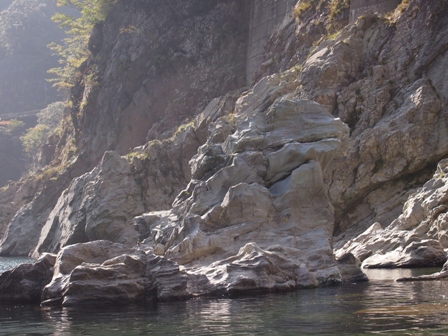 Lion Rock, Oboke Gorge
The Dosan rail line between Tadotsu in Kagawa Prefecture to Kubokawa in Kochi Prefecture clings to cliffs as it travels up and down the picturesque Yoshino River valley including the Oboke Gorge. This is undoubtedly one of Japan’s most scenic rail journeys.
[caption id="attachment_3527" align="alignnone" width="384"]
Lion Rock, Oboke Gorge
The Dosan rail line between Tadotsu in Kagawa Prefecture to Kubokawa in Kochi Prefecture clings to cliffs as it travels up and down the picturesque Yoshino River valley including the Oboke Gorge. This is undoubtedly one of Japan’s most scenic rail journeys.
[caption id="attachment_3527" align="alignnone" width="384"]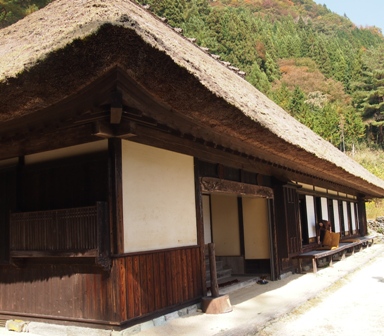 Old Samurai house[/caption]
Also in the mountains above Takamatsu is the beautifully situated Bukeyashiki-Kita Clan old samurai house. Relocated over twenty years ago to its present position overlooking surrounding peaks, it is an authentic 18th century samurai house that now serves as a memento to the distant past.
[caption id="attachment_3528" align="alignnone" width="341"]
Old Samurai house[/caption]
Also in the mountains above Takamatsu is the beautifully situated Bukeyashiki-Kita Clan old samurai house. Relocated over twenty years ago to its present position overlooking surrounding peaks, it is an authentic 18th century samurai house that now serves as a memento to the distant past.
[caption id="attachment_3528" align="alignnone" width="341"]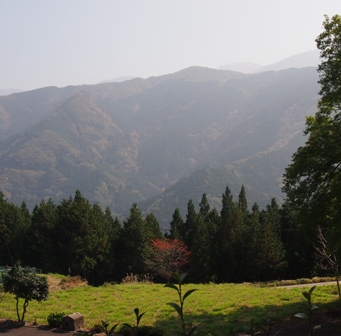 Mountain outlook from Old Samurai house[/caption]
Traditional lunches prepared with all local ingredients served in the rustic dining room may be arranged with prior notice.
Mountain outlook from Old Samurai house[/caption]
Traditional lunches prepared with all local ingredients served in the rustic dining room may be arranged with prior notice.
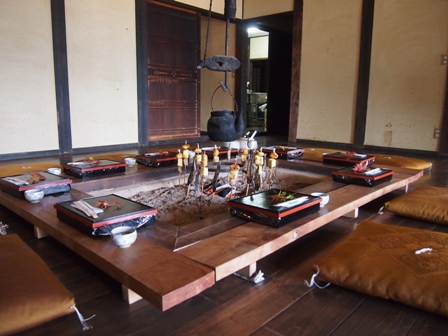 Lunch ready at Old Samurai house
One of Shikoku’s most photographed sights is the picturesque Iya-no-Kazura Bashi rope-bridge near Miyoshi-shi.
[caption id="attachment_3529" align="alignnone" width="219"]
Lunch ready at Old Samurai house
One of Shikoku’s most photographed sights is the picturesque Iya-no-Kazura Bashi rope-bridge near Miyoshi-shi.
[caption id="attachment_3529" align="alignnone" width="219"] Iya-no-Kazura Bashi bridge[/caption]
Ignore the outsized and ugly visitor’s centre, frequently crowded with numerous coach loads of tourists and focus your gaze instead on the lovely wooden and rope bridge. History reveals the bridge was first built over 800 years ago by samurai warriors who occasionally cut the support ropes to repel unwelcome invaders.
Iya-no-Kazura Bashi bridge[/caption]
Ignore the outsized and ugly visitor’s centre, frequently crowded with numerous coach loads of tourists and focus your gaze instead on the lovely wooden and rope bridge. History reveals the bridge was first built over 800 years ago by samurai warriors who occasionally cut the support ropes to repel unwelcome invaders.
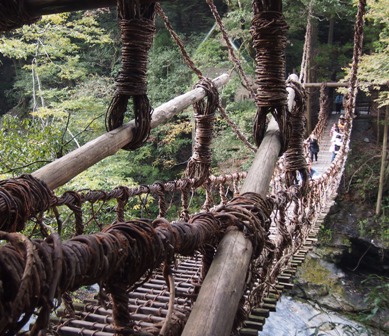 Rope Bridge close up
The entire bridge is rebuilt every three years to traditional custom. Walking across it is encouraged, though jumping up and down on it is not. Trust me, I tried it and was warned to mind my manners by a hidden loudspeaker. Big brother is watching even in rural Japan.
My favourite town on Shikoku is Matsuyama at the extreme western end of the island. Saved from the extensive WW2 bombing that destroyed the centres of so many Japanese cities (such as Tokushima and Takamatsu), it has survived with much of its low-scale residential neighbourhoods intact.
Though the small downtown area is filled with unattractive utilitarian architecture as in most Japanese cities, the streets surrounding Matsuyama Castle are wonderful for strolling and shopping. Antiques and second hand goods here are often cheaper than in Tokyo; stay alert bargain hunters!
[caption id="attachment_3530" align="alignnone" width="326"]
Rope Bridge close up
The entire bridge is rebuilt every three years to traditional custom. Walking across it is encouraged, though jumping up and down on it is not. Trust me, I tried it and was warned to mind my manners by a hidden loudspeaker. Big brother is watching even in rural Japan.
My favourite town on Shikoku is Matsuyama at the extreme western end of the island. Saved from the extensive WW2 bombing that destroyed the centres of so many Japanese cities (such as Tokushima and Takamatsu), it has survived with much of its low-scale residential neighbourhoods intact.
Though the small downtown area is filled with unattractive utilitarian architecture as in most Japanese cities, the streets surrounding Matsuyama Castle are wonderful for strolling and shopping. Antiques and second hand goods here are often cheaper than in Tokyo; stay alert bargain hunters!
[caption id="attachment_3530" align="alignnone" width="326"] Shopper in Matsuyama[/caption]
The restored steam locomotive ‘Botchan’ train leaves from near the Dogo Onsen (in front of the clock that also celebrates the work of famous author Soseki Natsume's novel 'Botchan' and a stepping stone’s throw from a lovely small hot spring with stone benches provided for a quick foot dip in soothing waters, free and open 24 hours).
Botchan clock in Matsuyama
Shopper in Matsuyama[/caption]
The restored steam locomotive ‘Botchan’ train leaves from near the Dogo Onsen (in front of the clock that also celebrates the work of famous author Soseki Natsume's novel 'Botchan' and a stepping stone’s throw from a lovely small hot spring with stone benches provided for a quick foot dip in soothing waters, free and open 24 hours).
Botchan clock in Matsuyama
 [caption id="attachment_3533" align="alignnone" width="448"]
[caption id="attachment_3533" align="alignnone" width="448"]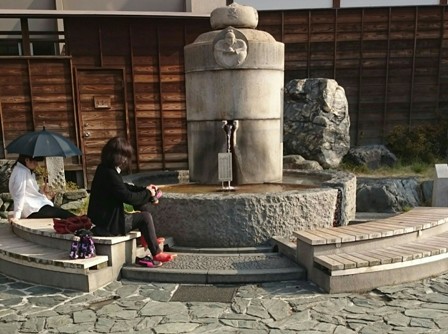 Public hot springs foot bath in Matsuyama[/caption]
The tiny train jauntily pulls a single restored carriage through downtown Matsuyama’s streets, depositing its passengers within easy walking proximity of the Matsuyama Castle. As a commuter experience, it’s unlike any other in Japan.
[caption id="attachment_3534" align="alignnone" width="336"]
Public hot springs foot bath in Matsuyama[/caption]
The tiny train jauntily pulls a single restored carriage through downtown Matsuyama’s streets, depositing its passengers within easy walking proximity of the Matsuyama Castle. As a commuter experience, it’s unlike any other in Japan.
[caption id="attachment_3534" align="alignnone" width="336"]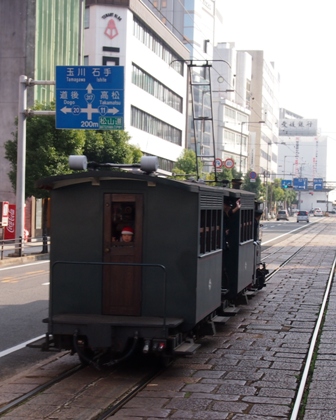 Botchan train trundling along Matsuyama street[/caption]
[caption id="attachment_3535" align="alignnone" width="336"]
Botchan train trundling along Matsuyama street[/caption]
[caption id="attachment_3535" align="alignnone" width="336"]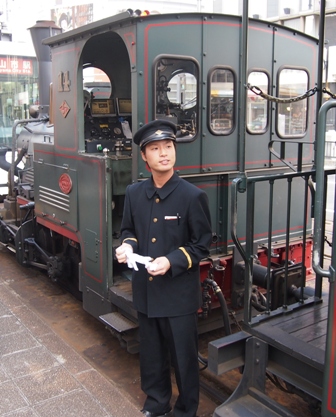 Botchan train conductor[/caption]
Dating from 1603, Matsuyama Castle is perched high atop a hill overlooking the city and (Seto) Inland Sea and is a wonderfully maintained historic site. Don’t miss it.
[caption id="attachment_3598" align="alignnone" width="352"]
Botchan train conductor[/caption]
Dating from 1603, Matsuyama Castle is perched high atop a hill overlooking the city and (Seto) Inland Sea and is a wonderfully maintained historic site. Don’t miss it.
[caption id="attachment_3598" align="alignnone" width="352"] Matsuyama Castle roofs[/caption]
Self-guided tours follow a logical progression through the castle grounds with signs in Japanese and English.
[caption id="attachment_3536" align="alignnone" width="353"]
Matsuyama Castle roofs[/caption]
Self-guided tours follow a logical progression through the castle grounds with signs in Japanese and English.
[caption id="attachment_3536" align="alignnone" width="353"]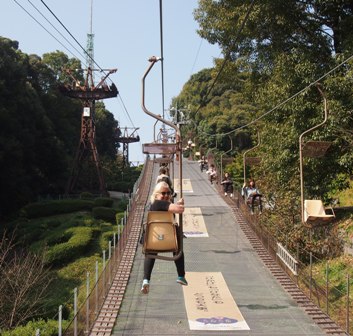 Chairlift to Matsuyama Castle[/caption]
A chair-lift to the hilltop is an easy way to reach the castle, a real gift on a sweltering humid summer’s day. The views over the city and sea are illuminating.
Matsuyama Castle keep tower
Chairlift to Matsuyama Castle[/caption]
A chair-lift to the hilltop is an easy way to reach the castle, a real gift on a sweltering humid summer’s day. The views over the city and sea are illuminating.
Matsuyama Castle keep tower
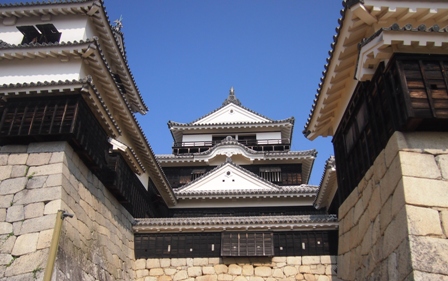 Haiku, Japan’s revered poetry is honoured in Matsuyama. One of its founders and heroes, Masaoka Shiki, lived in Matsuyama. His house, the Shiki-do, is also the Shiki Memorial Museum. Haiku is celebrated in Matsuyama like nowhere else in Japan. International awards for the best haiku are presented occasionally to Japanese and international entrants.
Shiki (1867-1902) clearly had a sense of humour. Here’s one of his haiku translated into English:
‘A Quart of Phlegm’
‘a quart of phlegm
even gourd water
couldn’t mop it up’
[caption id="attachment_3537" align="alignnone" width="273"]
Haiku, Japan’s revered poetry is honoured in Matsuyama. One of its founders and heroes, Masaoka Shiki, lived in Matsuyama. His house, the Shiki-do, is also the Shiki Memorial Museum. Haiku is celebrated in Matsuyama like nowhere else in Japan. International awards for the best haiku are presented occasionally to Japanese and international entrants.
Shiki (1867-1902) clearly had a sense of humour. Here’s one of his haiku translated into English:
‘A Quart of Phlegm’
‘a quart of phlegm
even gourd water
couldn’t mop it up’
[caption id="attachment_3537" align="alignnone" width="273"]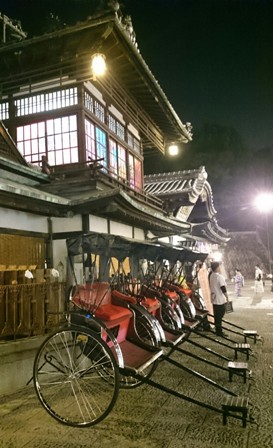 Rickshaws outside Dogo Onsen[/caption]
Many visitors to Matsuyama are there for the historic Dogo Onsen. For over 3,000 years Japan’s oldest hot springs has been open for public access. Housed in a lovely old wooden building (rebuilt in 1894) in the centre of town, it has provided hot spring therapy to many weary travellers.
[caption id="attachment_3538" align="alignnone" width="320"]
Rickshaws outside Dogo Onsen[/caption]
Many visitors to Matsuyama are there for the historic Dogo Onsen. For over 3,000 years Japan’s oldest hot springs has been open for public access. Housed in a lovely old wooden building (rebuilt in 1894) in the centre of town, it has provided hot spring therapy to many weary travellers.
[caption id="attachment_3538" align="alignnone" width="320"] Dogo Onsen at night[/caption]
Private rooms on the third floor can be hired for 1,550 Yen for a couple hours soaking bliss including a yukata to wear and tea served with the local ‘Botchan’ dango confectionary.
The Dogo Onsen Hanayuzuki Hotel Ehime is a modern ryokan opposite the original Dogo Onsen that offers both traditional ryokan tatami rooms as well as Western style accommodation.
[caption id="attachment_3539" align="alignnone" width="284"]
Dogo Onsen at night[/caption]
Private rooms on the third floor can be hired for 1,550 Yen for a couple hours soaking bliss including a yukata to wear and tea served with the local ‘Botchan’ dango confectionary.
The Dogo Onsen Hanayuzuki Hotel Ehime is a modern ryokan opposite the original Dogo Onsen that offers both traditional ryokan tatami rooms as well as Western style accommodation.
[caption id="attachment_3539" align="alignnone" width="284"]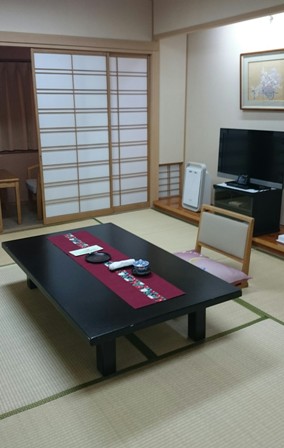 Tatami room at hotel[/caption]
Vouching for the tatami room, I can say sleeping on a futon in a traditional room including a kaiseki banquet dinner and breakfast while dressed in very comfortable yukata robe provided by the hotel (similar to a kimono but designed for both men and women with slightly differing rituals regards tying the sash), was one of the most memorable and enjoyable experiences during the whole recent visit to Shikoku.
From Matsuyama it’s an easy drive to Imabari on the (Seto) Inland Sea. A separate cycling path adjoins the Shimanami Kaido expressway linking Shikoku and Honshu via nine bridges and six islands. Keen cyclists can make the approximately 70 kilometres land and water crossing in a day of dedicated hard and fast pedalling but most people stretch out the trip to at least two days easy travelling, stopping at small islands for refreshing swims (the beaches are lovely during summer) and spending at least one night in a traditional ryokan or the new Hotel Cycle.
Tatami room at hotel[/caption]
Vouching for the tatami room, I can say sleeping on a futon in a traditional room including a kaiseki banquet dinner and breakfast while dressed in very comfortable yukata robe provided by the hotel (similar to a kimono but designed for both men and women with slightly differing rituals regards tying the sash), was one of the most memorable and enjoyable experiences during the whole recent visit to Shikoku.
From Matsuyama it’s an easy drive to Imabari on the (Seto) Inland Sea. A separate cycling path adjoins the Shimanami Kaido expressway linking Shikoku and Honshu via nine bridges and six islands. Keen cyclists can make the approximately 70 kilometres land and water crossing in a day of dedicated hard and fast pedalling but most people stretch out the trip to at least two days easy travelling, stopping at small islands for refreshing swims (the beaches are lovely during summer) and spending at least one night in a traditional ryokan or the new Hotel Cycle.
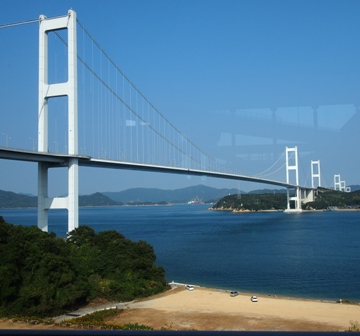 Bridge at Imabari and cycle way
Well maintained bicycles (including tandem and electric-assisted) can be rented at Sunrise Itoyama Visitors Centre near Imabari and fifteen other locations along the route (with a convenient return vehicle pick-up service included if you don’t want to cycle all the way back from Honshu). Time poor travellers like me may cycle across the first bridge (Kurushima Kaikyo which is part of the Shimanami Kaiyo Expressway between Ehime and Hiroshima Prefectures) and back to the visitor’s centre in a couple hours easy pedalling.
Bridge at Imabari and cycle way
Well maintained bicycles (including tandem and electric-assisted) can be rented at Sunrise Itoyama Visitors Centre near Imabari and fifteen other locations along the route (with a convenient return vehicle pick-up service included if you don’t want to cycle all the way back from Honshu). Time poor travellers like me may cycle across the first bridge (Kurushima Kaikyo which is part of the Shimanami Kaiyo Expressway between Ehime and Hiroshima Prefectures) and back to the visitor’s centre in a couple hours easy pedalling.
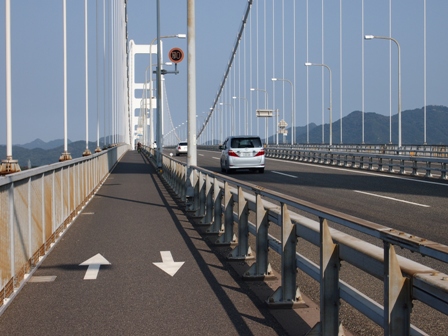 Cycle way on bridge
The views from high atop the bridge over the strait and tiny islands studding a cobalt blue sea are beautiful on a clear day.
Cycle way on bridge
The views from high atop the bridge over the strait and tiny islands studding a cobalt blue sea are beautiful on a clear day.
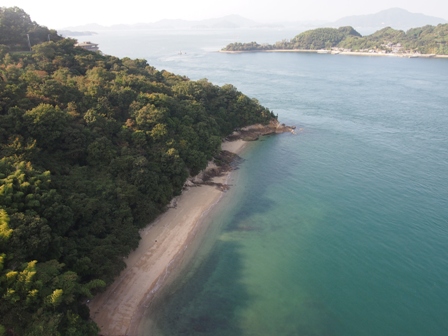 Inland Seto Sea island beach
Japan’s (Seto) Inland Sea was once a kind of industrial dumping ground. Thirty years of tight anti-pollution laws have resulted in a return to glory days for this overlooked body of water, a sailor’s dream-world with hundreds of small forested islands, innumerable coves and safe anchorages away from the madding crowds of contemporary Japan, particularly at the western end away from Osaka’s metropolis.
Inland Seto Sea island beach
Japan’s (Seto) Inland Sea was once a kind of industrial dumping ground. Thirty years of tight anti-pollution laws have resulted in a return to glory days for this overlooked body of water, a sailor’s dream-world with hundreds of small forested islands, innumerable coves and safe anchorages away from the madding crowds of contemporary Japan, particularly at the western end away from Osaka’s metropolis.
 Inland Seto Sea island
If time permits and you’re an avid walker ready for a different kind of ‘Camino’ pilgrimage, Shikoku is famous for its ‘88 Temples’ walk which commemorates the teachings of Kobo Daishi (AD 774-835) who is considered one of the most influential figures in Japanese Buddhist history.
[caption id="attachment_3540" align="alignnone" width="342"]
Inland Seto Sea island
If time permits and you’re an avid walker ready for a different kind of ‘Camino’ pilgrimage, Shikoku is famous for its ‘88 Temples’ walk which commemorates the teachings of Kobo Daishi (AD 774-835) who is considered one of the most influential figures in Japanese Buddhist history.
[caption id="attachment_3540" align="alignnone" width="342"]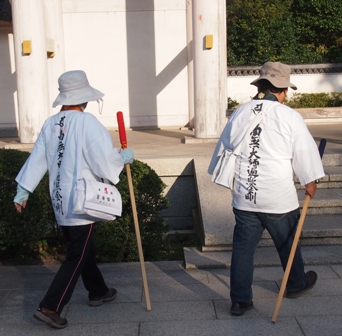 Pilgrims on 88 Temples walk[/caption]
Straddling the island from east to west are eighty-eight temples linked by a popular and well signposted (in Japanese) track, some of them representative of significant national importance (such as Yashima Temple, with a shrine dedicated to badgers, in the hills overlooking the agricultural plains outside Takamatsu).
[caption id="attachment_3541" align="alignnone" width="336"]
Pilgrims on 88 Temples walk[/caption]
Straddling the island from east to west are eighty-eight temples linked by a popular and well signposted (in Japanese) track, some of them representative of significant national importance (such as Yashima Temple, with a shrine dedicated to badgers, in the hills overlooking the agricultural plains outside Takamatsu).
[caption id="attachment_3541" align="alignnone" width="336"]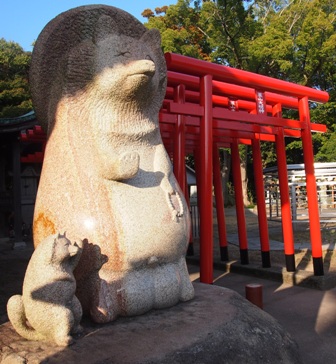 Badger statue[/caption]
Serious pilgrims dress in white robes topped off with peaked white hats while they make the eighty-eight temples’ circuit to cleanse their spirits and reconnect with ancient beliefs.
[caption id="attachment_3542" align="alignnone" width="378"]
Badger statue[/caption]
Serious pilgrims dress in white robes topped off with peaked white hats while they make the eighty-eight temples’ circuit to cleanse their spirits and reconnect with ancient beliefs.
[caption id="attachment_3542" align="alignnone" width="378"]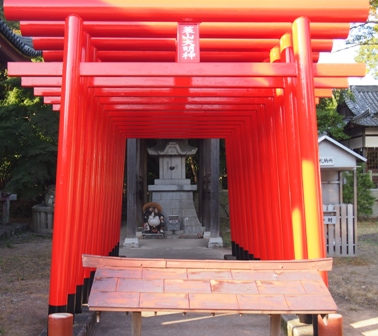 Torii gates at one of the 88 temples[/caption]
At over 1,400 kilometres long, the circuit may take several weeks to complete, some of it hard walking up and down steep mountains. Weather conditions should be paid attention when attempting the more remote parts of the trek. While this is almost wholly a Japanese ritual, it may appeal to travellers keen to immerse themselves into local culture.
[caption id="attachment_3591" align="alignnone" width="440"]
Torii gates at one of the 88 temples[/caption]
At over 1,400 kilometres long, the circuit may take several weeks to complete, some of it hard walking up and down steep mountains. Weather conditions should be paid attention when attempting the more remote parts of the trek. While this is almost wholly a Japanese ritual, it may appeal to travellers keen to immerse themselves into local culture.
[caption id="attachment_3591" align="alignnone" width="440"]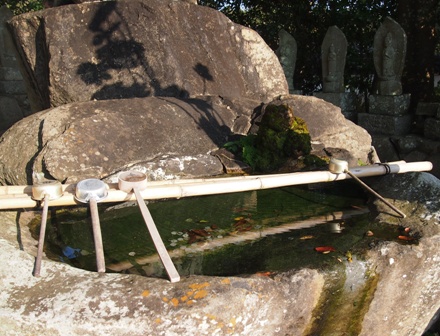 Ladles at temple spring for spiritual cleansing[/caption]
More than a basic understanding of both Buddhist/Shinto faiths and the Japanese language would be essential for a successful completion of the famous pilgrimage. Many pilgrims--o-henro san in Japanese-- take the easier option of bus connections or private car between the major temples, collecting a signature and special stamps from the monks at each temple.
[caption id="attachment_3543" align="alignnone" width="448"]
Ladles at temple spring for spiritual cleansing[/caption]
More than a basic understanding of both Buddhist/Shinto faiths and the Japanese language would be essential for a successful completion of the famous pilgrimage. Many pilgrims--o-henro san in Japanese-- take the easier option of bus connections or private car between the major temples, collecting a signature and special stamps from the monks at each temple.
[caption id="attachment_3543" align="alignnone" width="448"]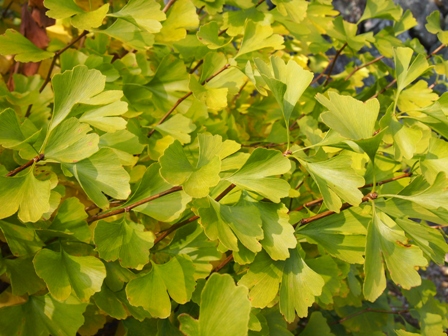 Gingko leaves[/caption]
Eighty-eight famous temples linked by an island wide trek?
A nationally important dance festival that attracts over a million visitors annually?
Special noodles that need jumping on for perfect conditioning?
Whirlpools and white water rafting?
Remote mountain samurai houses and imperial castles?
An Onsen to die for?
Go there and find out yourself why it’s a special place.
Tom Neal Tacker travelled courtesy of the JNTO (Japan National Tourist Organisation).
[caption id="attachment_3544" align="alignnone" width="322"]
Gingko leaves[/caption]
Eighty-eight famous temples linked by an island wide trek?
A nationally important dance festival that attracts over a million visitors annually?
Special noodles that need jumping on for perfect conditioning?
Whirlpools and white water rafting?
Remote mountain samurai houses and imperial castles?
An Onsen to die for?
Go there and find out yourself why it’s a special place.
Tom Neal Tacker travelled courtesy of the JNTO (Japan National Tourist Organisation).
[caption id="attachment_3544" align="alignnone" width="322"]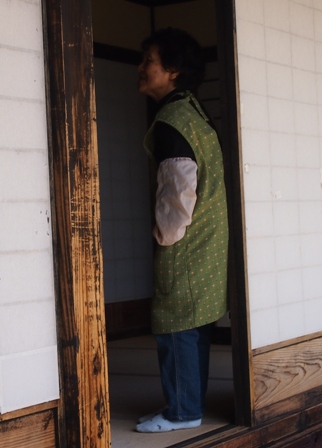 Cook at Old Samurai house[/caption]
Naked Facts:
The JNTO (Japan National Tourism Organisation) has a useful site: www.jnto.org.au
Further assistance including hotel and train passes can be arranged via: www.jtbtravel.com.au
Shikoku offers its own tourism website: www.tourismshikoku.org for information regarding accommodation, transport, festivals and weather.
For more information about Awa-Dori Dance Museum and its daily shows see: www.awadori-kaikan.jp (Japanese only)
Naruto Whirlpool Cruises can be arranged via www.www.uzusio.com
Nakano Udon School classes can be booked via www.nakanoya.net/school
The Shikoku Folk Museum village: www.city-takamatsu.kagawa.jp
To reach the Iya-no-Kazura-Bashi (Vine Bridge) a bus connects from JR Oboke Station www.miyoshinavi.jp/english
Matsuyama Castle is open daily: www.matsuyama.jp
Bicycle hire can be arranged via www.sunrise-itoyama.jp
For more information about the 88 Temples pilgrimage see: www.tourismshikoku.org/henro
The compact easy-to-use NINJA Wi-Fi router gave me continuous Wi-Fi access via my Smartphone throughout Shikoku, even in far-flung mountainous areas. The device can be hired via www.vision-net.co.jp is moderately priced and easy to use. I recharged its battery each night which provided Wi-Fi access for a moderate cost during my whole journey around Shikoku.
Naked Sleeps:
The Naruto Renaissance Resort on a wide clean beach near the Naruto Whirlpools and Strait but in safe swimming waters with life-guards and an array of beach equipment. It’s a medium sized, modern hotel with good facilities. Rooms vary between traditional tatami or Western style and a very family-friendly place.
[caption id="attachment_3593" align="alignnone" width="448"]
Cook at Old Samurai house[/caption]
Naked Facts:
The JNTO (Japan National Tourism Organisation) has a useful site: www.jnto.org.au
Further assistance including hotel and train passes can be arranged via: www.jtbtravel.com.au
Shikoku offers its own tourism website: www.tourismshikoku.org for information regarding accommodation, transport, festivals and weather.
For more information about Awa-Dori Dance Museum and its daily shows see: www.awadori-kaikan.jp (Japanese only)
Naruto Whirlpool Cruises can be arranged via www.www.uzusio.com
Nakano Udon School classes can be booked via www.nakanoya.net/school
The Shikoku Folk Museum village: www.city-takamatsu.kagawa.jp
To reach the Iya-no-Kazura-Bashi (Vine Bridge) a bus connects from JR Oboke Station www.miyoshinavi.jp/english
Matsuyama Castle is open daily: www.matsuyama.jp
Bicycle hire can be arranged via www.sunrise-itoyama.jp
For more information about the 88 Temples pilgrimage see: www.tourismshikoku.org/henro
The compact easy-to-use NINJA Wi-Fi router gave me continuous Wi-Fi access via my Smartphone throughout Shikoku, even in far-flung mountainous areas. The device can be hired via www.vision-net.co.jp is moderately priced and easy to use. I recharged its battery each night which provided Wi-Fi access for a moderate cost during my whole journey around Shikoku.
Naked Sleeps:
The Naruto Renaissance Resort on a wide clean beach near the Naruto Whirlpools and Strait but in safe swimming waters with life-guards and an array of beach equipment. It’s a medium sized, modern hotel with good facilities. Rooms vary between traditional tatami or Western style and a very family-friendly place.
[caption id="attachment_3593" align="alignnone" width="448"] Sashimi at Naruto Renaissance Resort restaurant[/caption]
The hotel buffet lunch had one of the best sashimi and sushi spreads I’ve seen in Japan. See www.renaissance-naruto.com
[caption id="attachment_3545" align="alignnone" width="417"]
Sashimi at Naruto Renaissance Resort restaurant[/caption]
The hotel buffet lunch had one of the best sashimi and sushi spreads I’ve seen in Japan. See www.renaissance-naruto.com
[caption id="attachment_3545" align="alignnone" width="417"]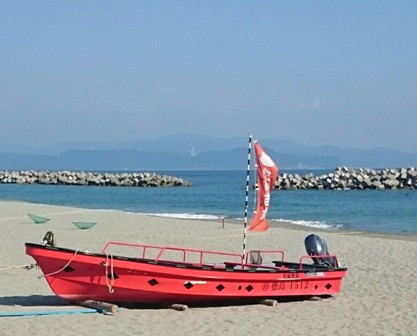 Beach at Naruto Renaissance Resort[/caption]
[caption id="attachment_3548" align="alignnone" width="220"]
Beach at Naruto Renaissance Resort[/caption]
[caption id="attachment_3548" align="alignnone" width="220"]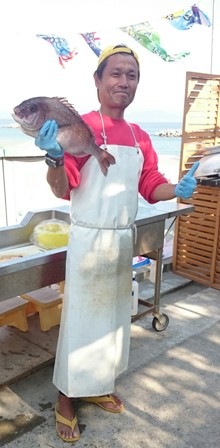 Fresh snapper on the menu at Naruto Renaissance Resort[/caption]
The Grand XIV Kairakuen Hotel Golf & Spa Resort in the hills overlooking Tokushima is a collection of rather bizarre faux-Tuscan accommodation buildings (they are hotels actually) from deluxe to mid-range. This Italian themed folly attempting to appear like a San Gimignano apparition with belfries and towers set in rural Japan is all ephemera, with a lot of imagination thrown in for pizzazz. First impressions? Weird, misplaced and overwrought spring to mind. For a walk on the hole-in-one side of wild in Japan, this may fit into your fantasy world like a bespoke golf glove. My room was fairly ordinary with innocuous furnishings and the meal of Italian-inspired food was the last thing I wanted to eat in rural Japan. But each to his own oyster, right? See www.kkstokyo.co.jp
[caption id="attachment_3559" align="alignnone" width="448"]
Fresh snapper on the menu at Naruto Renaissance Resort[/caption]
The Grand XIV Kairakuen Hotel Golf & Spa Resort in the hills overlooking Tokushima is a collection of rather bizarre faux-Tuscan accommodation buildings (they are hotels actually) from deluxe to mid-range. This Italian themed folly attempting to appear like a San Gimignano apparition with belfries and towers set in rural Japan is all ephemera, with a lot of imagination thrown in for pizzazz. First impressions? Weird, misplaced and overwrought spring to mind. For a walk on the hole-in-one side of wild in Japan, this may fit into your fantasy world like a bespoke golf glove. My room was fairly ordinary with innocuous furnishings and the meal of Italian-inspired food was the last thing I wanted to eat in rural Japan. But each to his own oyster, right? See www.kkstokyo.co.jp
[caption id="attachment_3559" align="alignnone" width="448"]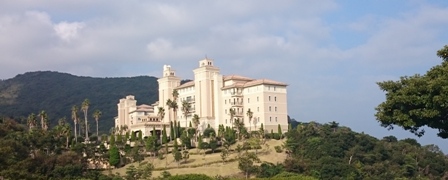 Faux Tuscan at XIV hotel[/caption]
For inquiries regards room rates and special packages (such as tatami rooms with kaiseki meals included) at Matsuyama’s Onsen Dogo Hanayuzuki Hotel Ehime in an excellent location stepping distance from the Dogo Onsen itself, see www.hotel-hanayuzaki.jp This modern hotel also boasts an open air roof top onsen with splendid views over the city reserved for hotel guests only.
[caption id="attachment_3560" align="alignnone" width="288"]
Faux Tuscan at XIV hotel[/caption]
For inquiries regards room rates and special packages (such as tatami rooms with kaiseki meals included) at Matsuyama’s Onsen Dogo Hanayuzuki Hotel Ehime in an excellent location stepping distance from the Dogo Onsen itself, see www.hotel-hanayuzaki.jp This modern hotel also boasts an open air roof top onsen with splendid views over the city reserved for hotel guests only.
[caption id="attachment_3560" align="alignnone" width="288"]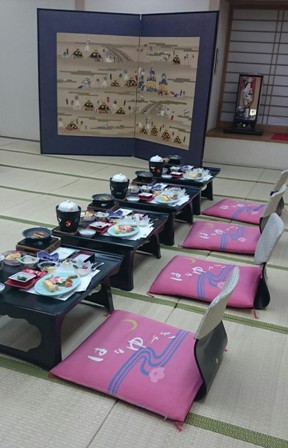 Table set for breakfast[/caption]
[caption id="attachment_3561" align="alignnone" width="336"]
Table set for breakfast[/caption]
[caption id="attachment_3561" align="alignnone" width="336"]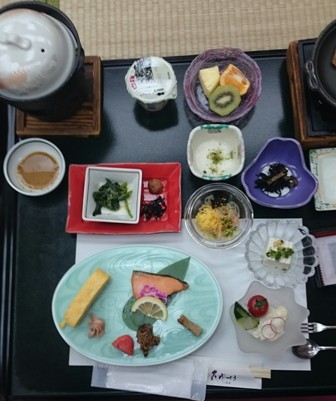 Breakfast tray[/caption]
The JR Clement Hotel in Takamatsu, Kagawa is a standard business hotel. Rooms are on the small side (as they are in just about every Japanese business hotel) but service is efficient while the breakfast buffet was better than average. www.jrclement.co.jp
Naked Routes:
Japan’s incredibly vast railway network is easy to use. Shinkansen (Bullet Trains) routes continue to expand (such as the Hokuriku line in March 2015 from Tokyo to Kanazawa on the west coast). In March 2016 the Hokkaido Shinkansen line will open using the new Seikan Tunnel from Aomori to Hakodate then on to Sapporo.
[caption id="attachment_3549" align="alignnone" width="336"]
Breakfast tray[/caption]
The JR Clement Hotel in Takamatsu, Kagawa is a standard business hotel. Rooms are on the small side (as they are in just about every Japanese business hotel) but service is efficient while the breakfast buffet was better than average. www.jrclement.co.jp
Naked Routes:
Japan’s incredibly vast railway network is easy to use. Shinkansen (Bullet Trains) routes continue to expand (such as the Hokuriku line in March 2015 from Tokyo to Kanazawa on the west coast). In March 2016 the Hokkaido Shinkansen line will open using the new Seikan Tunnel from Aomori to Hakodate then on to Sapporo.
[caption id="attachment_3549" align="alignnone" width="336"]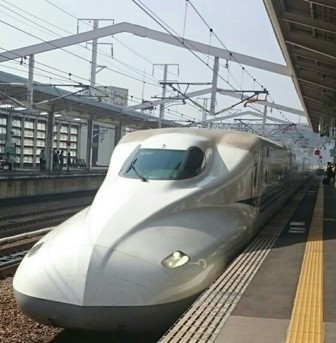 Shinkansen at station[/caption]
The Shinkansen trains run to rigorously punctual timetables. Average delays are rarely more than 40 seconds, including those caused by natural disasters. Check your carriage and seat number printed clearly on your ticket. Find the corresponding number on the platform (seats between rows are posted on indicators hanging above platforms and painted on the platform surface itself), stand in the appropriate spot and wait for disembarking passengers before alighting the train.
Always sit in your reserved seat.
Luggage space on Shinkansen is limited. Avoid hauling large bags as overhead compartment space is small.
[caption id="attachment_3562" align="alignnone" width="448"]
Shinkansen at station[/caption]
The Shinkansen trains run to rigorously punctual timetables. Average delays are rarely more than 40 seconds, including those caused by natural disasters. Check your carriage and seat number printed clearly on your ticket. Find the corresponding number on the platform (seats between rows are posted on indicators hanging above platforms and painted on the platform surface itself), stand in the appropriate spot and wait for disembarking passengers before alighting the train.
Always sit in your reserved seat.
Luggage space on Shinkansen is limited. Avoid hauling large bags as overhead compartment space is small.
[caption id="attachment_3562" align="alignnone" width="448"]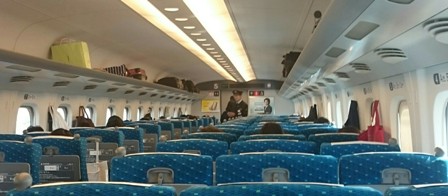 Shinkansen Nozomi Express carriage interior[/caption]
Forever resourceful, the Japanese use a luggage transfer system instead of dragging heavy bags around crowded railway stations (or subway stations when changing lines in Tokyo or Osaka). Ask at your hotel about luggage transfer facilities. Between large cities and popular tourist destinations, bags will arrive the following day (usually before you) or up to two days in remote locations. The fee is nominal and the service is delightfully efficient. Why isn’t this available in all countries?
Special Shinkansen such as the Nozomi Express run slightly faster than normal Shinkansen with fewer stops. Between Tokyo and Osaka, the Nozomi stops only at Yokohama, Nagoya and Kyoto before arriving in Osaka just over two hours after leaving Tokyo and vice-versa, faster than flying and much more efficient (and fun) when airport security measures are taken into account.
A kind of business class also operates on major routes. These green car carriages offer a bit more seating space, foot rests and maybe even a seat warmer. Blue carriage first class is available on selected Shinkansen routes which boasts special leather seats, privacy screens and shoe trays in case you want to feel really at home.
This being said, all Shinkansen trains deliver impeccable travelling experiences. Carriages are immaculately clean, toilets included. Employees are unfailingly polite and helpful. Trains are shiny-looking new, are cleaned thoroughly between each journey and there are no dirty windows or graffiti.
Impressively groomed and attired Shinkansen conductors enter each carriage with a bow and formal greeting before politely asking to check your ticket. They even wear white gloves for goodness sake!
Similarly outfitted attendants drive refreshment carts throughout carriages during the whole journey. Offering an array of hot and cold drinks and snacks, they are politeness embodied, elegantly dressed in crisply ironed uniforms.
[caption id="attachment_3563" align="alignnone" width="339"]
Shinkansen Nozomi Express carriage interior[/caption]
Forever resourceful, the Japanese use a luggage transfer system instead of dragging heavy bags around crowded railway stations (or subway stations when changing lines in Tokyo or Osaka). Ask at your hotel about luggage transfer facilities. Between large cities and popular tourist destinations, bags will arrive the following day (usually before you) or up to two days in remote locations. The fee is nominal and the service is delightfully efficient. Why isn’t this available in all countries?
Special Shinkansen such as the Nozomi Express run slightly faster than normal Shinkansen with fewer stops. Between Tokyo and Osaka, the Nozomi stops only at Yokohama, Nagoya and Kyoto before arriving in Osaka just over two hours after leaving Tokyo and vice-versa, faster than flying and much more efficient (and fun) when airport security measures are taken into account.
A kind of business class also operates on major routes. These green car carriages offer a bit more seating space, foot rests and maybe even a seat warmer. Blue carriage first class is available on selected Shinkansen routes which boasts special leather seats, privacy screens and shoe trays in case you want to feel really at home.
This being said, all Shinkansen trains deliver impeccable travelling experiences. Carriages are immaculately clean, toilets included. Employees are unfailingly polite and helpful. Trains are shiny-looking new, are cleaned thoroughly between each journey and there are no dirty windows or graffiti.
Impressively groomed and attired Shinkansen conductors enter each carriage with a bow and formal greeting before politely asking to check your ticket. They even wear white gloves for goodness sake!
Similarly outfitted attendants drive refreshment carts throughout carriages during the whole journey. Offering an array of hot and cold drinks and snacks, they are politeness embodied, elegantly dressed in crisply ironed uniforms.
[caption id="attachment_3563" align="alignnone" width="339"]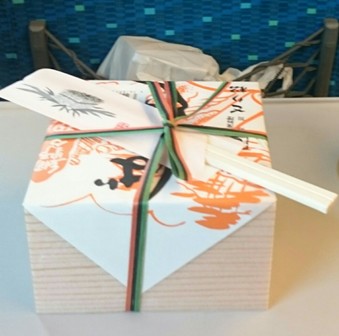 Wrapped ekiben[/caption]
Most canny passengers take advantage of numerous railway station purveyors for purchasing meals. There’s a reason why bento boxes (ekiben when prepared for railway journeys) are so popular: convenience and freshly prepared food.
[caption id="attachment_3564" align="alignnone" width="336"]
Wrapped ekiben[/caption]
Most canny passengers take advantage of numerous railway station purveyors for purchasing meals. There’s a reason why bento boxes (ekiben when prepared for railway journeys) are so popular: convenience and freshly prepared food.
[caption id="attachment_3564" align="alignnone" width="336"] Ekiben unwrapped[/caption]
Unfold your in-seat tray, untie the bright ribbon around your ekiben/bento box and dig in. Most stations offer regional delicacies in their selections; they’re inexpensive and healthy eating options.
[caption id="attachment_3550" align="alignnone" width="406"]
Ekiben unwrapped[/caption]
Unfold your in-seat tray, untie the bright ribbon around your ekiben/bento box and dig in. Most stations offer regional delicacies in their selections; they’re inexpensive and healthy eating options.
[caption id="attachment_3550" align="alignnone" width="406"]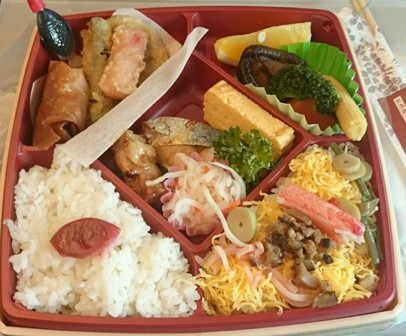 Ekiben lunch on Shinkansen[/caption]
All Shinkansen carriages are designated quiet zones where mobile phone use is prohibited. If you must use your phone, go to the space between carriages and speak softly. Speaking loudly on Japanese trains is a cultural no-no. Passengers are advised to put their phones on silent mode while travelling and conversations with companions should be in muted tones. I find this utter bliss.
Naked Tips:
Three observations that single the Japanese out for special mention:
Courtesy:
Bowing, greeting and thanking. Everyone does it. Millions of words have been written about Japanese customs regards personal space and the need for politeness in densely crowded urban communities. I need not add more other than to advise: follow their lead and react accordingly. Give thanks or greetings in return, bow as a sign of respect and smile a lot.
[caption id="attachment_3552" align="alignnone" width="297"]
Ekiben lunch on Shinkansen[/caption]
All Shinkansen carriages are designated quiet zones where mobile phone use is prohibited. If you must use your phone, go to the space between carriages and speak softly. Speaking loudly on Japanese trains is a cultural no-no. Passengers are advised to put their phones on silent mode while travelling and conversations with companions should be in muted tones. I find this utter bliss.
Naked Tips:
Three observations that single the Japanese out for special mention:
Courtesy:
Bowing, greeting and thanking. Everyone does it. Millions of words have been written about Japanese customs regards personal space and the need for politeness in densely crowded urban communities. I need not add more other than to advise: follow their lead and react accordingly. Give thanks or greetings in return, bow as a sign of respect and smile a lot.
[caption id="attachment_3552" align="alignnone" width="297"]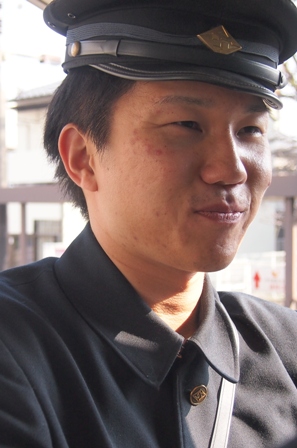 Train conductor on Botchan[/caption]
Respect:
Japan’s population is aging like almost nowhere else. You’ll see people so old, some almost look mummified. Zimmer frames are common as bicycles. What I like about Japanese attitude to aging is this: young people bow to their elders, treat them as fellow human beings, listen to them and show obvious care when around them. Frailty due to aging isn’t such a social stigma as it is in so many western countries.
[caption id="attachment_3594" align="alignnone" width="230"]
Train conductor on Botchan[/caption]
Respect:
Japan’s population is aging like almost nowhere else. You’ll see people so old, some almost look mummified. Zimmer frames are common as bicycles. What I like about Japanese attitude to aging is this: young people bow to their elders, treat them as fellow human beings, listen to them and show obvious care when around them. Frailty due to aging isn’t such a social stigma as it is in so many western countries.
[caption id="attachment_3594" align="alignnone" width="230"] Lovely older shopkeeper selling local crafts in Tokushima[/caption]
Tradition:
Yes, there’s nowhere else like Japan. Cultural hegemony has caused frightful problems (WW2 atrocities and dolphin/whale hunting are clear examples) and yet, this is a country in a state of social change. Young people aren’t so hide bound to conformity as their elders. And yet, they remain respectful and polite.
[caption id="attachment_3595" align="alignnone" width="336"]
Lovely older shopkeeper selling local crafts in Tokushima[/caption]
Tradition:
Yes, there’s nowhere else like Japan. Cultural hegemony has caused frightful problems (WW2 atrocities and dolphin/whale hunting are clear examples) and yet, this is a country in a state of social change. Young people aren’t so hide bound to conformity as their elders. And yet, they remain respectful and polite.
[caption id="attachment_3595" align="alignnone" width="336"] Old fashioned service Japan style[/caption]
I love seeing kids walk from school unaccompanied by adults. Each student wears a kind of branded uniform that identifies their school in case they get lost and need help. The hyper-sensitivity about ‘stranger-danger’ that pervades western culture isn’t so prevalent in Japan. Kids aren’t collected by their chauffeurs (i.e. parents) from school. They walk or travel by public bus or train. When they’re older, they cycle.
Theft is rare. I’ve never been in a country where I didn’t have to be constantly hyper-careful about my stuff. Sitting in an airport cafe supping on another delicious bowl of ramen with tempura, I could leave my camera, passport, boarding pass, bag and wallet while using the toilet facilities, return to my table and all my things would be exactly as I left them. Talk about blessed relief!
Vending machines are another Japanese obsession. You’ll never believe how many are around until you see them in even the most unusual locations, adjoining a carpark outside a traditional village museum for example. Hot and cold drinks, toothpaste and toothbrushes, condoms, snacks, combs... you name it and a vending machine probably has it.
[caption id="attachment_3553" align="alignnone" width="448"]
Old fashioned service Japan style[/caption]
I love seeing kids walk from school unaccompanied by adults. Each student wears a kind of branded uniform that identifies their school in case they get lost and need help. The hyper-sensitivity about ‘stranger-danger’ that pervades western culture isn’t so prevalent in Japan. Kids aren’t collected by their chauffeurs (i.e. parents) from school. They walk or travel by public bus or train. When they’re older, they cycle.
Theft is rare. I’ve never been in a country where I didn’t have to be constantly hyper-careful about my stuff. Sitting in an airport cafe supping on another delicious bowl of ramen with tempura, I could leave my camera, passport, boarding pass, bag and wallet while using the toilet facilities, return to my table and all my things would be exactly as I left them. Talk about blessed relief!
Vending machines are another Japanese obsession. You’ll never believe how many are around until you see them in even the most unusual locations, adjoining a carpark outside a traditional village museum for example. Hot and cold drinks, toothpaste and toothbrushes, condoms, snacks, combs... you name it and a vending machine probably has it.
[caption id="attachment_3553" align="alignnone" width="448"] Lunch preparation[/caption]
While dining at a fuel station wouldn’t be where I would normally hang out, in Japan it’s not so bad an option. Most major highway roadside stations also act as a kind of local market.
[caption id="attachment_3554" align="alignnone" width="448"]
Lunch preparation[/caption]
While dining at a fuel station wouldn’t be where I would normally hang out, in Japan it’s not so bad an option. Most major highway roadside stations also act as a kind of local market.
[caption id="attachment_3554" align="alignnone" width="448"] Takoyaki takeaway at fuel station[/caption]
Mega-stations even have food stalls lined up outside where takoyaki or fried sausages, ice cream treats and sweet biscuits are prepared to order. Inside you’ll find dozens of competing stalls cooking everything from bowls of delectable ramen with meats/fish, pickles and various sauces to hearty regional udon cooked in dashi with vegetables to delicately crisp and delicious tempura and fresh sushi to throw-in-everything-tasty okonomiyaki.
[caption id="attachment_3555" align="alignnone" width="336"]
Takoyaki takeaway at fuel station[/caption]
Mega-stations even have food stalls lined up outside where takoyaki or fried sausages, ice cream treats and sweet biscuits are prepared to order. Inside you’ll find dozens of competing stalls cooking everything from bowls of delectable ramen with meats/fish, pickles and various sauces to hearty regional udon cooked in dashi with vegetables to delicately crisp and delicious tempura and fresh sushi to throw-in-everything-tasty okonomiyaki.
[caption id="attachment_3555" align="alignnone" width="336"]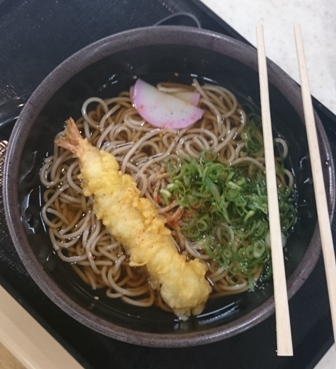 Tempura ramen at fuel station[/caption]
I dare you to find a bad meal amongst them. They’re cheap, cheerful and fast food... the way it should be unlike ubiquitous MuccasBurgerBlahKFCrapPizzaShit outlets found alongside major highways in western countries.
Tempura ramen at fuel station[/caption]
I dare you to find a bad meal amongst them. They’re cheap, cheerful and fast food... the way it should be unlike ubiquitous MuccasBurgerBlahKFCrapPizzaShit outlets found alongside major highways in western countries.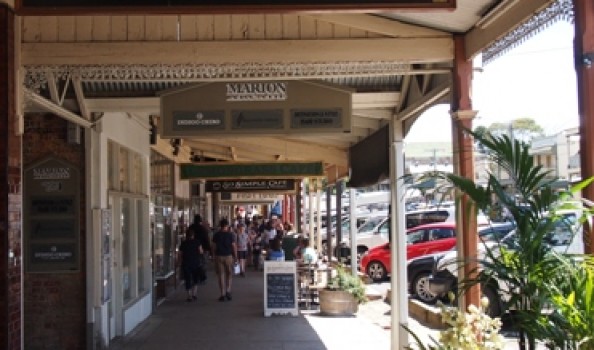 https://nakedhungrytraveller.com.au/beechworth-worthiness/ Beechworth Worthiness
https://nakedhungrytraveller.com.au/beechworth-worthiness/ Beechworth WorthinessOkay, I'm hooked on Beechworth and have been for at least five years. As one of Victoria's most historic towns, it's packed with stories to tell, both old and new. Well preserved yet fresh as a spring daffodil, Beechworth is also a gourmet's pilgrimage.
Let's study the facts. Beechworth town offers three restaurants of distinction, Provenance, The Ox and Hound and newcomer The Press Room. Provenance is the leader of a fine pack of chef driven restaurants. Not a chain restaurant in sight either; it's a town that embraces individuality in both wine and food. [caption id="attachment_3472" align="alignnone" width="348"]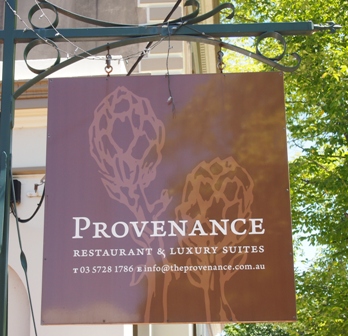 Simply the best[/caption]
The Ox and Hound offers modern Australian/Asian influenced food with sophisticated flash and real talent.
[caption id="attachment_3473" align="alignnone" width="448"]
Simply the best[/caption]
The Ox and Hound offers modern Australian/Asian influenced food with sophisticated flash and real talent.
[caption id="attachment_3473" align="alignnone" width="448"]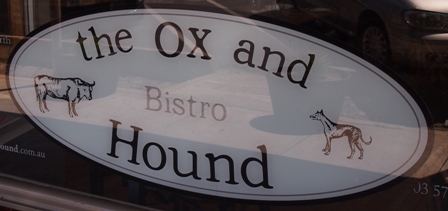 Ox and Hound Bistro[/caption]
The Press Room (formerly the Green Shed) offers a sophisticated take on tapas with local wines to match.
All in all, the dining stage in old Beechworth sets an exhilarating standard much larger communities find hard to match. Not bad for a town of fewer than five thousand inhabitants.
[caption id="attachment_1888" align="alignnone" width="448"]
Ox and Hound Bistro[/caption]
The Press Room (formerly the Green Shed) offers a sophisticated take on tapas with local wines to match.
All in all, the dining stage in old Beechworth sets an exhilarating standard much larger communities find hard to match. Not bad for a town of fewer than five thousand inhabitants.
[caption id="attachment_1888" align="alignnone" width="448"]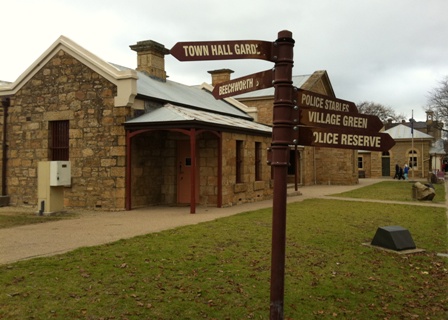 Beechworth's historic precinct road sign[/caption]
Add to this illustrious mix the Bridge Road Brewery for its pizzas and artisan beers, the town's most popular family venue.
[caption id="attachment_3482" align="alignnone" width="322"]
Beechworth's historic precinct road sign[/caption]
Add to this illustrious mix the Bridge Road Brewery for its pizzas and artisan beers, the town's most popular family venue.
[caption id="attachment_3482" align="alignnone" width="322"]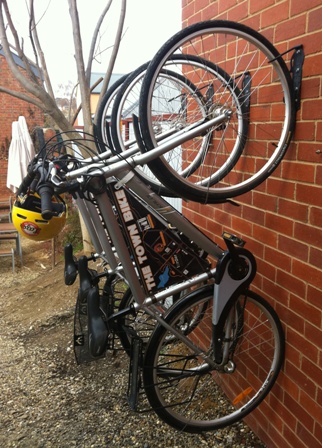 Bicycles for hire outside Bridge Road Brewery[/caption]
With The Larder Fromagerie and Provisions, great for coffee and cake expertise, the Beechworth Provender for its local wine selection and the famed, though touristy, Beechworth Bakery (don’t miss the Vanilla Slice) for its general all round welcome and you have a town of serious gourmet reputation.
[caption id="attachment_3476" align="alignnone" width="336"]
Bicycles for hire outside Bridge Road Brewery[/caption]
With The Larder Fromagerie and Provisions, great for coffee and cake expertise, the Beechworth Provender for its local wine selection and the famed, though touristy, Beechworth Bakery (don’t miss the Vanilla Slice) for its general all round welcome and you have a town of serious gourmet reputation.
[caption id="attachment_3476" align="alignnone" width="336"] A town icon[/caption]
Excellent news for all Beechworth aficionados: Rocco Esposito and Lisa Pidutti (former owners of Wardens) are back in town with a hot new venture simply called 'Project 49'. Aiming to supply most of what they sell from their local organic farm, they're currently running a lovely little deli/cafe with a view towards serving evening meals. A liquor license approval is pending (January 2016).
[caption id="attachment_3477" align="alignnone" width="427"]
A town icon[/caption]
Excellent news for all Beechworth aficionados: Rocco Esposito and Lisa Pidutti (former owners of Wardens) are back in town with a hot new venture simply called 'Project 49'. Aiming to supply most of what they sell from their local organic farm, they're currently running a lovely little deli/cafe with a view towards serving evening meals. A liquor license approval is pending (January 2016).
[caption id="attachment_3477" align="alignnone" width="427"]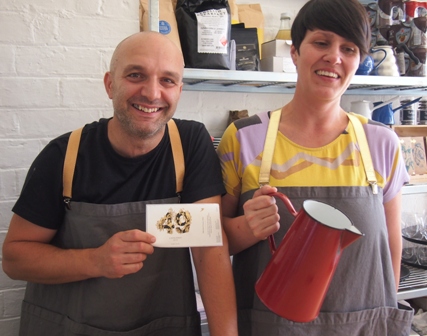 Rocco and Lisa, owner/operators of Project 49[/caption]
[caption id="attachment_3488" align="alignnone" width="448"]
Rocco and Lisa, owner/operators of Project 49[/caption]
[caption id="attachment_3488" align="alignnone" width="448"]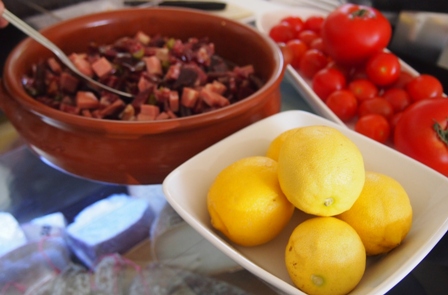 Project 49 produce looking delicious[/caption]
Just behind Rocco and Lisa's new shop at 49 Ressom Lane off Ford Street is the new Eldorado Road Cellar Door wine sales shop. Terrific well priced wines direct from the vineyard at Eldorado up the road from Tarrawingee.
Tanswell's Commercial Hotel pub at 50 Ford St is another local favourite. Food isn't great but the atmosphere is authentic country retro. Looking for eccentric local characters, tired and emotional regulars, blow ins from the big smokes? This is the place.
Tanswell's retro stained glass window sign
Project 49 produce looking delicious[/caption]
Just behind Rocco and Lisa's new shop at 49 Ressom Lane off Ford Street is the new Eldorado Road Cellar Door wine sales shop. Terrific well priced wines direct from the vineyard at Eldorado up the road from Tarrawingee.
Tanswell's Commercial Hotel pub at 50 Ford St is another local favourite. Food isn't great but the atmosphere is authentic country retro. Looking for eccentric local characters, tired and emotional regulars, blow ins from the big smokes? This is the place.
Tanswell's retro stained glass window sign
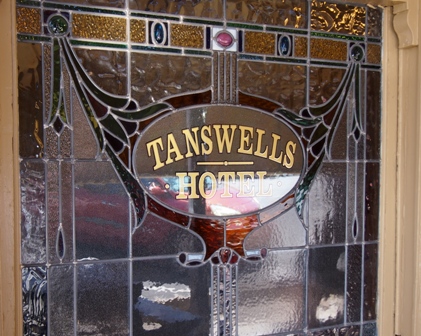 Near this is Paul and Ivy's All Day Diner at 38 Ford Street, which is now open for dinner weekend evenings. Ivy is from China and her cooking influence is prevalent. Home made dumplings are a stand-out.
[caption id="attachment_1889" align="alignnone" width="335"]
Near this is Paul and Ivy's All Day Diner at 38 Ford Street, which is now open for dinner weekend evenings. Ivy is from China and her cooking influence is prevalent. Home made dumplings are a stand-out.
[caption id="attachment_1889" align="alignnone" width="335"]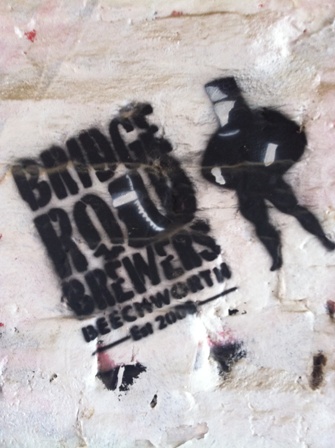 Bridge Road Brewery graffiti sign[/caption]
The Cellar Door Wine Store, owned and run by two ex-Provenance employees, Aaron and Martina, has stepped up in offering many local wines by the glass.
[caption id="attachment_3468" align="alignnone" width="439"]
Bridge Road Brewery graffiti sign[/caption]
The Cellar Door Wine Store, owned and run by two ex-Provenance employees, Aaron and Martina, has stepped up in offering many local wines by the glass.
[caption id="attachment_3468" align="alignnone" width="439"]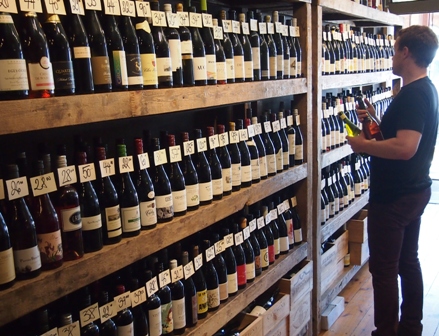 Aaron at Cellar Door shop[/caption]
[caption id="attachment_3469" align="alignnone" width="336"]
Aaron at Cellar Door shop[/caption]
[caption id="attachment_3469" align="alignnone" width="336"]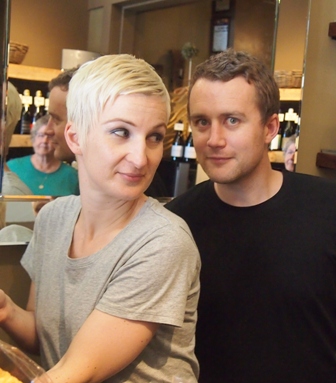 Martina and Aaron, owner operators of the Cellar Door[/caption]
Beechworth wineries are mostly open by appointment only, creating problems for visitors unused to advanced planning. To everyone's benefit, Aaron and Martina have opened a centrally located cozy wine bar that promotes the best local wines available, many served by the glass, all by the reasonably priced bottle, as well as a tidy selection of some of the finest spirits and fortified wines known to mankind. For instance, when I see Tesseron Cognac on a top shelf, I know I'm in safe drinking hands.
By the way, arguably speaking, the town's best coffee is to be had here. The changing cheese selection is a winner.
[caption id="attachment_3470" align="alignnone" width="448"]
Martina and Aaron, owner operators of the Cellar Door[/caption]
Beechworth wineries are mostly open by appointment only, creating problems for visitors unused to advanced planning. To everyone's benefit, Aaron and Martina have opened a centrally located cozy wine bar that promotes the best local wines available, many served by the glass, all by the reasonably priced bottle, as well as a tidy selection of some of the finest spirits and fortified wines known to mankind. For instance, when I see Tesseron Cognac on a top shelf, I know I'm in safe drinking hands.
By the way, arguably speaking, the town's best coffee is to be had here. The changing cheese selection is a winner.
[caption id="attachment_3470" align="alignnone" width="448"]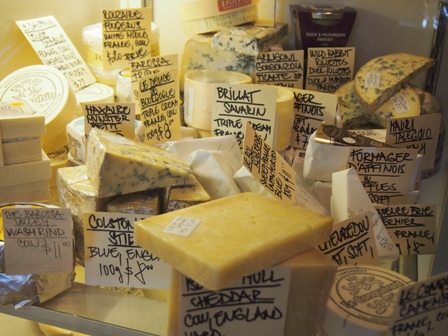 Cellar Door cheese selection[/caption]
Another local hero, the Beechworth Honey shop (and experience) continues to charm its way into all sweet hearts. Under no circumstances should a visit to this small store be missed. A very complete range of honeys is on sale along with a thorough assortment of products made with all the great stuff that exudes out of a bee's bum. A new premises opened recently in an old bank building with a terrific cafe attached.
[caption id="attachment_3471" align="alignnone" width="417"]
Cellar Door cheese selection[/caption]
Another local hero, the Beechworth Honey shop (and experience) continues to charm its way into all sweet hearts. Under no circumstances should a visit to this small store be missed. A very complete range of honeys is on sale along with a thorough assortment of products made with all the great stuff that exudes out of a bee's bum. A new premises opened recently in an old bank building with a terrific cafe attached.
[caption id="attachment_3471" align="alignnone" width="417"] New Beechworth honey shop and cafe[/caption]
[caption id="attachment_1892" align="alignnone" width="448"]
New Beechworth honey shop and cafe[/caption]
[caption id="attachment_1892" align="alignnone" width="448"]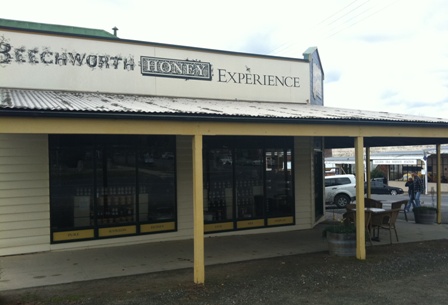 Beechworth Honey Experience storefront[/caption]
Though Beechworth is justifiably famous for its well preserved historical past fuelled largely by a wildly successful gold mining rush, boasting an austerely impressive gaol (Ned Kelly was remanded into custody here) and an insane asylum (reputedly haunted) all amidst a town centre full of facades that hasn’t changed much since 1870, it has become since 1995, a place where travellers also dwell happily in a rural gourmet’s paradise.
[caption id="attachment_3481" align="alignnone" width="378"]
Beechworth Honey Experience storefront[/caption]
Though Beechworth is justifiably famous for its well preserved historical past fuelled largely by a wildly successful gold mining rush, boasting an austerely impressive gaol (Ned Kelly was remanded into custody here) and an insane asylum (reputedly haunted) all amidst a town centre full of facades that hasn’t changed much since 1870, it has become since 1995, a place where travellers also dwell happily in a rural gourmet’s paradise.
[caption id="attachment_3481" align="alignnone" width="378"] Post Office tower in centre of town[/caption]
With Beechworth's growing touristic popularity, rents have increased as available empty shopfronts for more cafes and restaurants dwindle. Now it's a chance situation for many clue-y operators to sink or swim in this competitive marketplace.
[caption id="attachment_3480" align="alignnone" width="448"]
Post Office tower in centre of town[/caption]
With Beechworth's growing touristic popularity, rents have increased as available empty shopfronts for more cafes and restaurants dwindle. Now it's a chance situation for many clue-y operators to sink or swim in this competitive marketplace.
[caption id="attachment_3480" align="alignnone" width="448"]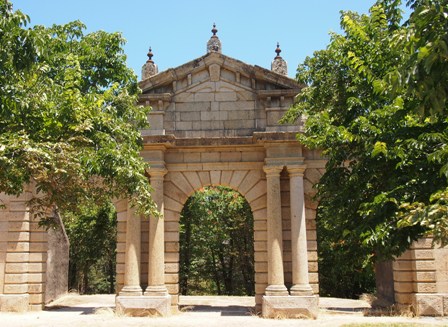 The old hospital facade and gardens behind[/caption]
Horse driven carriage out for a ride during a busy holiday weekend
The old hospital facade and gardens behind[/caption]
Horse driven carriage out for a ride during a busy holiday weekend
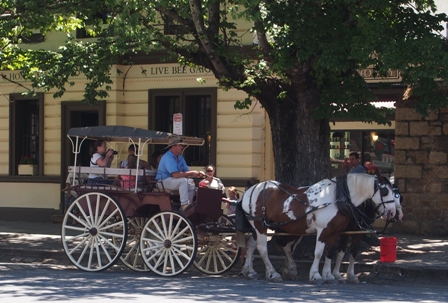 Which is why a few entrepreneurial types have looked outside Beechworth's somewhat narrowly concentrated main streets for greener less expensive pastures.
To wit, one stands out for special gourmet mention in the newly renovated pub, The Plough Inn of Tarrawingee approximately half way between Beechworth and Wangaratta.
In tiny Tarrawingee, a fly-speck crossroads village that used to serve as a mainstay on the old 19th century Cobb and Co carriage route, one pub remains, The Plough Inn. Acquired early this year by Andrew and Feona Roscouet (Andrew was the head chef at Warden's Wine Bar & Restaurant), the old dame has been tarted up in fine fashion.
[caption id="attachment_1897" align="alignnone" width="336"]
Which is why a few entrepreneurial types have looked outside Beechworth's somewhat narrowly concentrated main streets for greener less expensive pastures.
To wit, one stands out for special gourmet mention in the newly renovated pub, The Plough Inn of Tarrawingee approximately half way between Beechworth and Wangaratta.
In tiny Tarrawingee, a fly-speck crossroads village that used to serve as a mainstay on the old 19th century Cobb and Co carriage route, one pub remains, The Plough Inn. Acquired early this year by Andrew and Feona Roscouet (Andrew was the head chef at Warden's Wine Bar & Restaurant), the old dame has been tarted up in fine fashion.
[caption id="attachment_1897" align="alignnone" width="336"]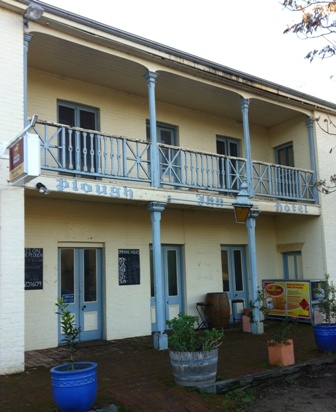 Plough Inn entrance[/caption]
Roscouet is an experienced chef who knows his way around the pans. Cooking both ways with a bar menu to suit regular pub customers and a restaurant menu to suit insatiable gourmands, to wit: Chicken Parma, Burgers, Fish and Chips or Roasted corn chilli croquettes and sauce Romesco, local lamb, beef and illustriously imaginative creations arriving on big plates at a fair price have ensured that this wonderful old pub has attained a new lease on life. A sunny beer garden out back, a localised wine list and fine service have also combined to add credit to this region's claim as a food/wine lover's fantasy homecoming.
Indeed nearly the whole of northeast Victoria is somewhere hungry travellers fill up. From wines and walnuts to chestnuts and cheeses, it’s a very mixed bag of treats. Local horticulturalists produce some of the country’s best apples, pears, peaches, plums and quinces from some of the country's most picturesque orchards. Asparagus in spring, tomatoes in summer and pumpkins in autumn represent vegetarian paradise while the continental climate combined with rich volcanic soil effortlessly reaps bounty.
In tiny surrounding towns like Stanley, the Beechworth bonanza has reached rich heights, literally. Stanley is nearly 300 metres higher up than Beechworth, a completely different climate zone. Just outside town, Michael Nuck produces some of Australia's best saffron. The fickle weather here parallels that of colder parts of Iran where tonnes of saffron are hand-picked, mostly for export. At approximately $35,000 per kilo, this rare spice out prices gold. If conditions are right, the crocus flowers rise up in late autumn. The stamens are picked very early morning before the sun opens the flowers, drying the fragrance and diluting its intensity. Saffron quality is at its best early morning.
Producing saffron is labour intensive; it takes some 150,000 flowers to produce one kilo of dried saffron. No wonder this stuff is expensive. Imitations abound of course. If you’re lucky to have real saffron in your pantry, the difference between it and artificially coloured imitation saffron is like night and day.
Sadly, conditions haven't been kind over the last few years and the saffron harvest has been a meager one. Stocks are non-existent for the time being.
What has led this region’s dining scene to its current state of excellence is wine. Some of Australia’s most daring and dazzling vignerons/winemakers thrive here. The topography allows startling innovation. Beechworth attained G.I. (Geographical Indicator) status as a signifier of its unique character. Quoting from Beechworth Vignerons’ publicity brochure, the region is “Geographically defined as a hillside winegrowing region. Its ancient geology is bony, weathered ground with meagre vineyard soils of degraded granite, compressed and fractured shale and slate and free draining gravely slopes. These soil types naturally restrict yield and each vineyard produces concentrated, intense wines; a situation shared with many of the most revered winegrowing regions of the world.”
Most vineyards are located west of town along the C315 road to Wangaratta at altitudes from 300 to 550 metres. A scattering of other wineries are north and northeast of Beechworth along the roads to Chiltern and Wooragee sited between 300 and 400 metres. Beechworth town centre is at 550 metres, Stanley is at 800 metres.
Unfortunately most wineries are not open to casual visitors. Some advance planning is required to visit. Dropping in is inadvisable. That being said, curious enthusiastic visitors may be welcomed with open arms though prior arrangement is necessary.
My preferred recommendations from an excellent bunch that require advance notice for visits are: Savaterre, Giaconda, Piano Piano, Smith’s, Sorrenberg, Castagna, Serengale, Golden Ball and Star Lane.
[caption id="attachment_3479" align="alignnone" width="448"]
Plough Inn entrance[/caption]
Roscouet is an experienced chef who knows his way around the pans. Cooking both ways with a bar menu to suit regular pub customers and a restaurant menu to suit insatiable gourmands, to wit: Chicken Parma, Burgers, Fish and Chips or Roasted corn chilli croquettes and sauce Romesco, local lamb, beef and illustriously imaginative creations arriving on big plates at a fair price have ensured that this wonderful old pub has attained a new lease on life. A sunny beer garden out back, a localised wine list and fine service have also combined to add credit to this region's claim as a food/wine lover's fantasy homecoming.
Indeed nearly the whole of northeast Victoria is somewhere hungry travellers fill up. From wines and walnuts to chestnuts and cheeses, it’s a very mixed bag of treats. Local horticulturalists produce some of the country’s best apples, pears, peaches, plums and quinces from some of the country's most picturesque orchards. Asparagus in spring, tomatoes in summer and pumpkins in autumn represent vegetarian paradise while the continental climate combined with rich volcanic soil effortlessly reaps bounty.
In tiny surrounding towns like Stanley, the Beechworth bonanza has reached rich heights, literally. Stanley is nearly 300 metres higher up than Beechworth, a completely different climate zone. Just outside town, Michael Nuck produces some of Australia's best saffron. The fickle weather here parallels that of colder parts of Iran where tonnes of saffron are hand-picked, mostly for export. At approximately $35,000 per kilo, this rare spice out prices gold. If conditions are right, the crocus flowers rise up in late autumn. The stamens are picked very early morning before the sun opens the flowers, drying the fragrance and diluting its intensity. Saffron quality is at its best early morning.
Producing saffron is labour intensive; it takes some 150,000 flowers to produce one kilo of dried saffron. No wonder this stuff is expensive. Imitations abound of course. If you’re lucky to have real saffron in your pantry, the difference between it and artificially coloured imitation saffron is like night and day.
Sadly, conditions haven't been kind over the last few years and the saffron harvest has been a meager one. Stocks are non-existent for the time being.
What has led this region’s dining scene to its current state of excellence is wine. Some of Australia’s most daring and dazzling vignerons/winemakers thrive here. The topography allows startling innovation. Beechworth attained G.I. (Geographical Indicator) status as a signifier of its unique character. Quoting from Beechworth Vignerons’ publicity brochure, the region is “Geographically defined as a hillside winegrowing region. Its ancient geology is bony, weathered ground with meagre vineyard soils of degraded granite, compressed and fractured shale and slate and free draining gravely slopes. These soil types naturally restrict yield and each vineyard produces concentrated, intense wines; a situation shared with many of the most revered winegrowing regions of the world.”
Most vineyards are located west of town along the C315 road to Wangaratta at altitudes from 300 to 550 metres. A scattering of other wineries are north and northeast of Beechworth along the roads to Chiltern and Wooragee sited between 300 and 400 metres. Beechworth town centre is at 550 metres, Stanley is at 800 metres.
Unfortunately most wineries are not open to casual visitors. Some advance planning is required to visit. Dropping in is inadvisable. That being said, curious enthusiastic visitors may be welcomed with open arms though prior arrangement is necessary.
My preferred recommendations from an excellent bunch that require advance notice for visits are: Savaterre, Giaconda, Piano Piano, Smith’s, Sorrenberg, Castagna, Serengale, Golden Ball and Star Lane.
[caption id="attachment_3479" align="alignnone" width="448"]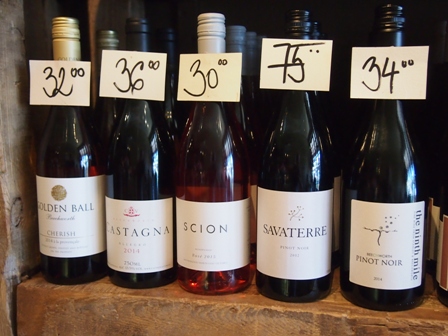 Local wines for sale at Cellar Door Wine Shop[/caption]
Amulet and Tinker’s Hill wineries are open weekends and public holidays.
Fortunately, two wineries are open to visitors seven days, Indigo and Pennyweight.
My top pick is Pennyweight. Owned and run by the Morris family, Stephen N, Elizabeth, Fred, Stephen MG and CJX, their bio-dynamic wines are uniformly superior while their range of fortified wines from a very well managed Solera system are absolutely outstanding. To sip a Pennyweight Fino or Amontillado or Oloroso sherry style wine is to see real gold in a glass. Much as I love authentic Spanish Sherries and Portuguese Ports, Pennyweight does wonders with their Antipodean versions of those time-honoured Iberian wines. As time (and the angel's share) go by, I've grown to love this winery more and more. The sheer expertise in operation here is remarkably consistent. Kudos to this wonderful family run winery.
[caption id="attachment_1900" align="alignnone" width="290"]
Local wines for sale at Cellar Door Wine Shop[/caption]
Amulet and Tinker’s Hill wineries are open weekends and public holidays.
Fortunately, two wineries are open to visitors seven days, Indigo and Pennyweight.
My top pick is Pennyweight. Owned and run by the Morris family, Stephen N, Elizabeth, Fred, Stephen MG and CJX, their bio-dynamic wines are uniformly superior while their range of fortified wines from a very well managed Solera system are absolutely outstanding. To sip a Pennyweight Fino or Amontillado or Oloroso sherry style wine is to see real gold in a glass. Much as I love authentic Spanish Sherries and Portuguese Ports, Pennyweight does wonders with their Antipodean versions of those time-honoured Iberian wines. As time (and the angel's share) go by, I've grown to love this winery more and more. The sheer expertise in operation here is remarkably consistent. Kudos to this wonderful family run winery.
[caption id="attachment_1900" align="alignnone" width="290"]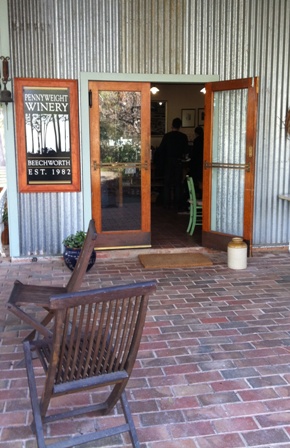 Pennyweight Cellar Door entry[/caption]
During a recent visit, I was fortunate to view the 'flor' resting contentedly in barrel, creating magic in wine as it works prestidigitation on fermented Palomino grape juice on their way to the next glorious Pennyweight Fino or Amontillado or Oloroso style Aussie made fortified wine.
Back in Beechworth after a long day’s touring around wineries and orchards, I dine again at the best of the best, Michael Ryan’s Provenance. Eight courses means for me, delicious degustation.
[caption id="attachment_1901" align="alignnone" width="261"]
Pennyweight Cellar Door entry[/caption]
During a recent visit, I was fortunate to view the 'flor' resting contentedly in barrel, creating magic in wine as it works prestidigitation on fermented Palomino grape juice on their way to the next glorious Pennyweight Fino or Amontillado or Oloroso style Aussie made fortified wine.
Back in Beechworth after a long day’s touring around wineries and orchards, I dine again at the best of the best, Michael Ryan’s Provenance. Eight courses means for me, delicious degustation.
[caption id="attachment_1901" align="alignnone" width="261"] Provenance front door[/caption]
When a talented chef like Michael Ryan wants to choose my dinner, I’m very happy. After another memorable feast in December 2015, I'm convinced Ryan is performing at the top of his game.
Floor staff are better than ever, oozing confidence while being country-friendly. The wine list is in superb form with more rare sakes taking pride of place among local stars. Ryan and his chefs often serve straight from the kitchen these days, an additional charm offensive that works. Overhearing customers exclaiming delight and praise straight to the horse's mouth so to speak, I notice a gradual nuance from formality to organised relaxation.
Michael Ryan's imagination and grasp of flavour integration is an illumination of gastronomic alchemy. Go to Provenance and find out for yourself what brilliant cooking is.
If you detect a Japanese influence here, it’s a reflection of Ryan’s admiration of Japanese flavours and style. A project based in Japan now benefits from Ryan’s advice and help while he makes regular visits to the land of the rising sun. The Japanese influence on Provenance’s overall sensibility is one of its strongest attractions, that and the fact that Michael Ryan is one of Australia’s most brilliant chefs. He combines two cultures (and a scattering of others, Italian and French spring immediately to mind) in seemingly effortless fashion, a veritable antithesis to the notion of gastronomic 'con-fusion'.
Michael Ryan at the helm of Provenance is an inspirational driver. Other chefs look to him as a benchmark while they assert their own individual talents. This is healthy competition at its best.
[caption id="attachment_1903" align="alignnone" width="336"]
Provenance front door[/caption]
When a talented chef like Michael Ryan wants to choose my dinner, I’m very happy. After another memorable feast in December 2015, I'm convinced Ryan is performing at the top of his game.
Floor staff are better than ever, oozing confidence while being country-friendly. The wine list is in superb form with more rare sakes taking pride of place among local stars. Ryan and his chefs often serve straight from the kitchen these days, an additional charm offensive that works. Overhearing customers exclaiming delight and praise straight to the horse's mouth so to speak, I notice a gradual nuance from formality to organised relaxation.
Michael Ryan's imagination and grasp of flavour integration is an illumination of gastronomic alchemy. Go to Provenance and find out for yourself what brilliant cooking is.
If you detect a Japanese influence here, it’s a reflection of Ryan’s admiration of Japanese flavours and style. A project based in Japan now benefits from Ryan’s advice and help while he makes regular visits to the land of the rising sun. The Japanese influence on Provenance’s overall sensibility is one of its strongest attractions, that and the fact that Michael Ryan is one of Australia’s most brilliant chefs. He combines two cultures (and a scattering of others, Italian and French spring immediately to mind) in seemingly effortless fashion, a veritable antithesis to the notion of gastronomic 'con-fusion'.
Michael Ryan at the helm of Provenance is an inspirational driver. Other chefs look to him as a benchmark while they assert their own individual talents. This is healthy competition at its best.
[caption id="attachment_1903" align="alignnone" width="336"]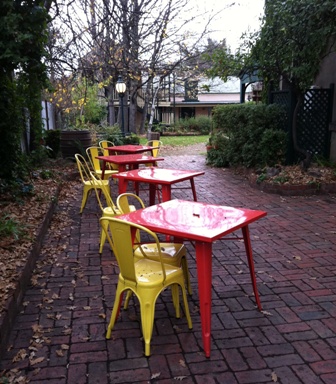 Outside tables at Provenance with accommodation in background[/caption]
Beechworth residents and visitors alike are lucky to have such a wealth of cooking and wine-making talent close at hand. Their constant striving to improve their businesses is both impressively dynamic and resolutely commendable.
Naked Facts:
[caption id="attachment_1905" align="alignnone" width="336"]
Outside tables at Provenance with accommodation in background[/caption]
Beechworth residents and visitors alike are lucky to have such a wealth of cooking and wine-making talent close at hand. Their constant striving to improve their businesses is both impressively dynamic and resolutely commendable.
Naked Facts:
[caption id="attachment_1905" align="alignnone" width="336"]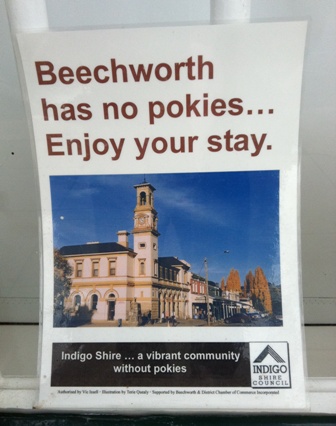 No pokies in Beechworth.[/caption]
No pokies in Beechworth.[/caption]
See www.northeastvalleys.com.au for more food and wine focused touring information, suggested itineraries and annual local festivals and events.
See www.beechworthonline.com.au www.beechworth.com.au and www.beechworth.com for suggested accommodation, transport information, general facts and history, cycling paths (the Rail Trail from Wangaratta to Bright has a spur line to Beechworth) and other information pertinent to interstate and international travellers.
Naked Drinks:
Pennyweight is my favourite cellar door. One of only two open daily in and around Beechworth. It’s the best by far and rightly nationally famous for its bio-dynamic table and fortified wines.
13 Pennyweight Lane
Tel: +61 (0)3 5728 1747
Indigo Vineyard is owned by Brokenwood of New South Wales. It’s quite a substantial vineyard for this area (46 ha.) and produces high quality wines separate from the larger Brokenwood group. Top picks are the Chardonnay, the Bordeaux red blend (Cabernet Sauvignon, Merlot and Petit Verdot) and a very good Shiraz, all from the vineyard outside the lovely cellar door. Their Muscat from Rutherglen grapes is very fine as well. Indigo’s cellar door experience is rather structured; a seated tasting experience with a small snack to cleanse the palate between wines. If time is short or the formality of the tasting is too much, ask to sample the wines at the bar instead. Cellar door manager Bridget Hooper is more than pleased to ensure all customers’ needs are met.
1221 Beechworth – Wangaratta Road
Everton Upper
Tel: +61 (0)3 5727 0233
Amulet Wines is the last of the three that boasts a cellar door open to the general public without appointment. I’ve tried a few Amulet wines over the years. They’re representative of the region’s overall superior standards.
1036 Beechworth – Wangaratta Road
Beechworth/Upper Everton
Tel: +61 (0)3 5727 0420
See www.beechworthvineyards.com.au for up to date opening times for cellar doors and information regarding visits by appointment, maps and further links.
Naked Eats:
Bridge Road Brewery & Pizzeria
Ford St.
Tel: +61 (0)3 5728 2709
Cellar Door Wine Store
62 Ford St.
Tel: +61 (0)3 5728 2882
www.cellardoorwinestore.com.au
The Plough Inn
2322 Beechworth – Wangaratta Road
Tarrawingee
Tel: +61 (0)3 5725 1609
Provenance under chef/proprietor Michael Ryan’s guidance continues to impress me like no other restaurant in Beechworth (and most of country Australia for that matter).
Provenance
86 Ford St.
Tel: +61 (0)3 5728 1786
The Press Room 37 Camp St. Tel: +61 (0)3 5728 2360 www.thepressroomwinebar.com.auThe Ox & Hound Bistro Restaurant
52 Ford St.
Tel: +61 (0)3 5728 2123
www.oxandhound.com.au
Naked Sleeps:
This is the short list and I’ve stayed in all of them.
Finches of Beechworth 3 Finch St. Tel: +61 (0)3 5728 2655 www.finchesofbeechworth.com.au Wow! Absolutely delightful, top-notch facilities, great location and perfect hosts. This is the B & B I want to live in. Owner operators Peter and Margo are consummate hosts and have created a luxuriously appointed retreat in a lovingly restored house with extensive gardens and private pool. Do yourself a favour, stay here at least one night just to see what authentic hospitality is all about. Freeman on Ford 97 Ford St. Tel: +61 (0)3 5728 2371 www.freemanonford.com.au The other top accommodation in town, one of Australia's most awarded boutique B & Bs. Try to score one of two Crystal Suites overlooking the garden and pool with direct veranda access though all the rooms are superb. Attention to detail is unparalleled. Breakfasts are excellent.Barnsley House Historic B & B
5 John St.
Tel: +61 (0)3 5728 1037
www.barnsleyhouse.com.au
Under new owners, Steve and Irene, Barnsley House continues to raise the stakes in superlative accommodation. Like Finches and Freeman on Ford, Barnsley House is a big notch above its competitors.
The Provenance Restaurant also offers excellent accommodation.
The Hotel Nicholas has two large rooms for overnight accommodation. Breakfast is a ‘do-it-yourself’ affair comprised of very ordinary elements (two pieces of bread, packaged jam, butter, packaged juice, tea and coffee bags) but the rooms are surprisingly grand and pleasingly priced. Parking is in the street outside the hotel but there wasn’t a problem finding space even on a busy holiday weekend.
[caption id="attachment_3483" align="alignnone" width="448"]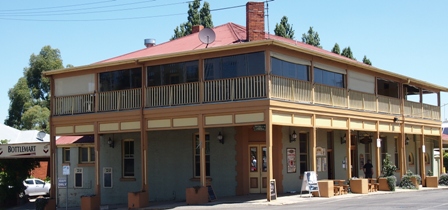 Nicholas Pub[/caption]
Nicholas Pub[/caption]
Best of all, the hotel operates a terrific restaurant on its upstairs balcony. Run by the Stanley Pub's former chef, she’s a great cook who understands the integrity of using excellent local produce.
The Nicholas is the town’s best place in which to see live music. The downstairs pub dining room converts to an intimate performance space (seating for approximately 80 persons) from 9pm on most weekends and attracts a strong local and interstate following. It’s a wonderful place to catch local talent. Occasionally internationally famous musicians play here; it’s that good!
1A Camp St.
Tel: +61 (0)3 5728 2655
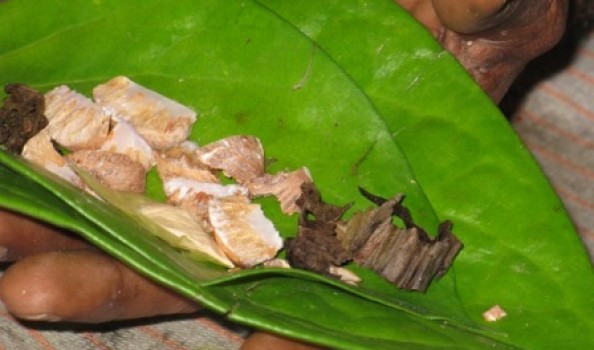 https://nakedhungrytraveller.com.au/hot-and-not-so-hot-indian-food/ Hot and Not So Hot, Indian FoodIs all Indian food hot stuff or not? Getting the facts right. Not all of India’s food is fiery hot, nor is it a curry. Variety is the true spice in Indian food which comprises a multitude of flavours from many regions. An understanding of Indian cuisine is a major step to innate comprehension of the mystery that is India itself. A country of 29 separate states, each boasts social, religious and geographical influences and their own unique approach to food. [caption id="attachment_3457" align="alignnone" width="225"]
https://nakedhungrytraveller.com.au/hot-and-not-so-hot-indian-food/ Hot and Not So Hot, Indian FoodIs all Indian food hot stuff or not? Getting the facts right. Not all of India’s food is fiery hot, nor is it a curry. Variety is the true spice in Indian food which comprises a multitude of flavours from many regions. An understanding of Indian cuisine is a major step to innate comprehension of the mystery that is India itself. A country of 29 separate states, each boasts social, religious and geographical influences and their own unique approach to food. [caption id="attachment_3457" align="alignnone" width="225"] Children eating, giving thanks[/caption]
From Kashmir’s meaty kebabs to Kerala’s coconut-cream seafood curries, making sense of the myriad flavours from so many individual areas isn’t an easy task. But for the keen enthusiast it can be a pleasant and rewarding one. Well-known actress and cook Madhur Jaffrey says, “The greatness of India’s cuisine lies in its regional foods and its regional menus.”
[caption id="attachment_3449" align="alignnone" width="204"]
Children eating, giving thanks[/caption]
From Kashmir’s meaty kebabs to Kerala’s coconut-cream seafood curries, making sense of the myriad flavours from so many individual areas isn’t an easy task. But for the keen enthusiast it can be a pleasant and rewarding one. Well-known actress and cook Madhur Jaffrey says, “The greatness of India’s cuisine lies in its regional foods and its regional menus.”
[caption id="attachment_3449" align="alignnone" width="204"] Madhur Jaffrey with one of her cookbooks[/caption]
As a starting point, forget the notion that there’s an actual Indian national cuisine. There is however a blend of different cuisines from all over the sub-continent and even further afield. The ‘classic’ dishes such as chicken tikka, naan, aloo gobi, tandoori lamb and even lassi are all from the Punjab in northern India. Many Punjabis migrated to the UK, USA, Canada, East Asia and Australia and went on to open restaurants making these the most recognised Indian menu items abroad, yet only represent a fraction of the country’s cuisine in its entirety.
[caption id="attachment_3450" align="alignnone" width="252"]
Madhur Jaffrey with one of her cookbooks[/caption]
As a starting point, forget the notion that there’s an actual Indian national cuisine. There is however a blend of different cuisines from all over the sub-continent and even further afield. The ‘classic’ dishes such as chicken tikka, naan, aloo gobi, tandoori lamb and even lassi are all from the Punjab in northern India. Many Punjabis migrated to the UK, USA, Canada, East Asia and Australia and went on to open restaurants making these the most recognised Indian menu items abroad, yet only represent a fraction of the country’s cuisine in its entirety.
[caption id="attachment_3450" align="alignnone" width="252"] Chicken leg from the tandoor[/caption]
A tour of India will quickly highlight diversity and readily apparent differences though exceptions to rules constantly break domestic boundaries. Mega-cities such as Delhi tend to reflect their surrounding states, its food scene primarily encompasses India’s northern cuisines: from the green and rich Punjab, famous for its tandoor cooking, to Rajasthan’s amazing rotis and imaginative use of scarce ingredients and Kashmir’s heavy use of dried pulses and meats cooked in curds or milk. Goat and lamb meat commonly feature in Northern Indian recipes along with dried chillies, saffron, and nuts.
[caption id="attachment_3451" align="alignnone" width="282"]
Chicken leg from the tandoor[/caption]
A tour of India will quickly highlight diversity and readily apparent differences though exceptions to rules constantly break domestic boundaries. Mega-cities such as Delhi tend to reflect their surrounding states, its food scene primarily encompasses India’s northern cuisines: from the green and rich Punjab, famous for its tandoor cooking, to Rajasthan’s amazing rotis and imaginative use of scarce ingredients and Kashmir’s heavy use of dried pulses and meats cooked in curds or milk. Goat and lamb meat commonly feature in Northern Indian recipes along with dried chillies, saffron, and nuts.
[caption id="attachment_3451" align="alignnone" width="282"]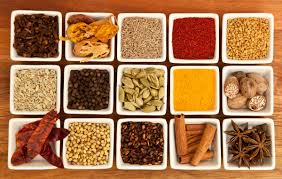 Indian spice assortment[/caption]
To the west, Gujarat is almost entirely an alcohol free zone where strict Hindu rules enforce the state’s temperance laws while adhering to conservative Hinduism. (India's current PM Narendra Modi was the Chief Minister of Gujarat before he was elected as the head of the national government.) Here are many of India’s most innovative vegetarian dishes, some with an unusual Chinese-influenced twist.
Mumbai, the biggest city in India, has a food culture largely driven by its tropical climate and bordering states. Though seafood is increasingly expensive (primarily due to over-fishing and pollution), most local people consider fish essential to an important meal. Here Bombay Duck (a kind of white flesh fish) became famous beyond Mumbai’s shores.
Further south Goa still retains its Portuguese influence with its pork vindaloo, a Hindi corruption of the Portuguese words vin d’alho (wine and garlic), alongside spicy seafood coconut curries.
Ananda Solomon, executive chef at one of India’s luxury Taj hotels, offers up the area stretching from Mumbai to northern Kerala as his favourite regional Indian cusine. “The Konkan Belt, from Mumbai, Vasai, Alibaugh, Sindhudurgh, Goa, Karwar and Mangalore… this coastal belt is lush with paddy fields and coconut laden palms. The sea is teeming with pomfret, prawns, kingfish, mussels, Bombay duck and clams. Central to the cooking of these regions and its communities are three ingredients: fish, rice and coconut grated, roasted or by itself, coconut lends body to the curries. Rice fine, fat unpolished and even red, is eaten not just boiled but also in the form of dosai, fine white neer dosai, parathas and spongy appams.”
[caption id="attachment_3461" align="alignnone" width="295"]
Indian spice assortment[/caption]
To the west, Gujarat is almost entirely an alcohol free zone where strict Hindu rules enforce the state’s temperance laws while adhering to conservative Hinduism. (India's current PM Narendra Modi was the Chief Minister of Gujarat before he was elected as the head of the national government.) Here are many of India’s most innovative vegetarian dishes, some with an unusual Chinese-influenced twist.
Mumbai, the biggest city in India, has a food culture largely driven by its tropical climate and bordering states. Though seafood is increasingly expensive (primarily due to over-fishing and pollution), most local people consider fish essential to an important meal. Here Bombay Duck (a kind of white flesh fish) became famous beyond Mumbai’s shores.
Further south Goa still retains its Portuguese influence with its pork vindaloo, a Hindi corruption of the Portuguese words vin d’alho (wine and garlic), alongside spicy seafood coconut curries.
Ananda Solomon, executive chef at one of India’s luxury Taj hotels, offers up the area stretching from Mumbai to northern Kerala as his favourite regional Indian cusine. “The Konkan Belt, from Mumbai, Vasai, Alibaugh, Sindhudurgh, Goa, Karwar and Mangalore… this coastal belt is lush with paddy fields and coconut laden palms. The sea is teeming with pomfret, prawns, kingfish, mussels, Bombay duck and clams. Central to the cooking of these regions and its communities are three ingredients: fish, rice and coconut grated, roasted or by itself, coconut lends body to the curries. Rice fine, fat unpolished and even red, is eaten not just boiled but also in the form of dosai, fine white neer dosai, parathas and spongy appams.”
[caption id="attachment_3461" align="alignnone" width="295"] Eating from thali in south India[/caption]
On the eastern coast, intellectual Kolkata and the area around the Bay of Bengal, is unsurprisingly renowned for its rice and fish dishes. The eastern states such as West Bengal and Assam are also well-known for their desserts such as the syrupy rasgulla. Strong links with Burmese and Thai cuisines are evident in the balance between sweet and sour tastes.
Central India from Hyderabad northwards to Lucknow offers up the best of Mughlai cuisine, heavily Middle Eastern influenced with pulao (rice pilafs) and barfi (milk sweets).
The southern cities of Chennai and Bangalore enjoy various dosas, fermented rice flour pancakes stuffed with any number of local vegetarian ingredients, best known being the masala dosa with potato, curry leaf and onions. Served with a sambar or chatni, they are sublime. Southern states Kerala and Tamil Nadu combine fish, seafood and coconuts with the world’s best spices.
One aspect of cuisine does identify India as a single culinary entity: spice. No Indian cook would ever be without a spice box and the mark of a talented chef are his masterful masalas (spice blends). From hot to mild, sweet to sour, bitter to salty and everything in between, spice rules the kitchen. It’s a fabulous mélange of spices that relies much on the chef’s knowledge and ability to blend that permeates Indian food from one corner of this huge country to another.
[caption id="attachment_3453" align="alignnone" width="275"]
Eating from thali in south India[/caption]
On the eastern coast, intellectual Kolkata and the area around the Bay of Bengal, is unsurprisingly renowned for its rice and fish dishes. The eastern states such as West Bengal and Assam are also well-known for their desserts such as the syrupy rasgulla. Strong links with Burmese and Thai cuisines are evident in the balance between sweet and sour tastes.
Central India from Hyderabad northwards to Lucknow offers up the best of Mughlai cuisine, heavily Middle Eastern influenced with pulao (rice pilafs) and barfi (milk sweets).
The southern cities of Chennai and Bangalore enjoy various dosas, fermented rice flour pancakes stuffed with any number of local vegetarian ingredients, best known being the masala dosa with potato, curry leaf and onions. Served with a sambar or chatni, they are sublime. Southern states Kerala and Tamil Nadu combine fish, seafood and coconuts with the world’s best spices.
One aspect of cuisine does identify India as a single culinary entity: spice. No Indian cook would ever be without a spice box and the mark of a talented chef are his masterful masalas (spice blends). From hot to mild, sweet to sour, bitter to salty and everything in between, spice rules the kitchen. It’s a fabulous mélange of spices that relies much on the chef’s knowledge and ability to blend that permeates Indian food from one corner of this huge country to another.
[caption id="attachment_3453" align="alignnone" width="275"]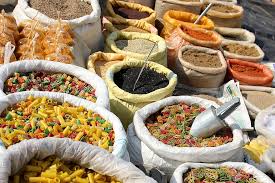 Bags of spices and dried legumes for sale[/caption]
Many Indian culinary practices also have their roots in Ayurveda, the science of life, health and longevity existent for more than four thousand years. Ayurvedic cooking is basically the practice of using ingredients much for their medicinal benefits as for their taste. It is the most widely practiced medicine in India.
[caption id="attachment_3456" align="alignnone" width="299"]
Bags of spices and dried legumes for sale[/caption]
Many Indian culinary practices also have their roots in Ayurveda, the science of life, health and longevity existent for more than four thousand years. Ayurvedic cooking is basically the practice of using ingredients much for their medicinal benefits as for their taste. It is the most widely practiced medicine in India.
[caption id="attachment_3456" align="alignnone" width="299"] Sikhs eating in temple[/caption]
Another commonality is that an Indian meal is never without a grain: wheat (usually as a roti, generic term for bread) in the north and rice in the south. Each is generally eaten with some sort of dahl, the generic term for pulses or lentils and sabzi, vegetables. Pickles and chutneys are standard accompaniments. Depending upon circumstances, usually religious, meat or fish may be served. Beyond these staples, the only limits are the chef’s imagination.
[caption id="attachment_3454" align="alignnone" width="188"]
Sikhs eating in temple[/caption]
Another commonality is that an Indian meal is never without a grain: wheat (usually as a roti, generic term for bread) in the north and rice in the south. Each is generally eaten with some sort of dahl, the generic term for pulses or lentils and sabzi, vegetables. Pickles and chutneys are standard accompaniments. Depending upon circumstances, usually religious, meat or fish may be served. Beyond these staples, the only limits are the chef’s imagination.
[caption id="attachment_3454" align="alignnone" width="188"] Sabzi cauliflower[/caption]
As India’s first Michelin-starred chef, London-based Atul Kochhar says, “Look at Indian food… It’s a huge fusion pot. It’s about pushing the boundaries of cooking and experimenting.” Sample it widely and be surprised.
The Religion of Food:
India is a deeply religious nation and food is used to celebrate innumerable religious ceremonies. Moreover, vegetarianism is sacred to Hindus, Buddhists and Jains; and even carnivorous Hindus show innate respect for vegetarians.
[caption id="attachment_3455" align="alignnone" width="299"]
Sabzi cauliflower[/caption]
As India’s first Michelin-starred chef, London-based Atul Kochhar says, “Look at Indian food… It’s a huge fusion pot. It’s about pushing the boundaries of cooking and experimenting.” Sample it widely and be surprised.
The Religion of Food:
India is a deeply religious nation and food is used to celebrate innumerable religious ceremonies. Moreover, vegetarianism is sacred to Hindus, Buddhists and Jains; and even carnivorous Hindus show innate respect for vegetarians.
[caption id="attachment_3455" align="alignnone" width="299"]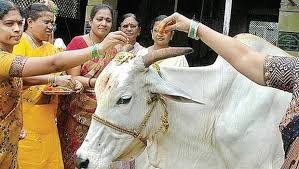 Sacred cow[/caption]
For the business traveller, it is important to remember that there are more than twenty major religious feast days in the Hindu calendar - India is more than 80% Hindu (who avoid sacred cows) and 12% Muslim (who avoid pigs and follow Halal protocol) - in addition to personal feast days, weddings and funerals. Plus, fasting is also about as common as feasting.
Many people fast or avoid certain foods before festivals or feast days and on days associated with their favourite gods. Hanuman, the monkey god, is associated with Tuesday, for example, a day when meat is avoided. Krishna is associated with dairy products and Ganesh, connected with luck and good fortune, is never seen without offerings of modak (sweet rice flour dumplings). However, have no fear, knowing this will only help your understanding of India and your hosts; foreign visitors are not expected to fast in the same way.
[caption id="attachment_3458" align="alignnone" width="275"]
Sacred cow[/caption]
For the business traveller, it is important to remember that there are more than twenty major religious feast days in the Hindu calendar - India is more than 80% Hindu (who avoid sacred cows) and 12% Muslim (who avoid pigs and follow Halal protocol) - in addition to personal feast days, weddings and funerals. Plus, fasting is also about as common as feasting.
Many people fast or avoid certain foods before festivals or feast days and on days associated with their favourite gods. Hanuman, the monkey god, is associated with Tuesday, for example, a day when meat is avoided. Krishna is associated with dairy products and Ganesh, connected with luck and good fortune, is never seen without offerings of modak (sweet rice flour dumplings). However, have no fear, knowing this will only help your understanding of India and your hosts; foreign visitors are not expected to fast in the same way.
[caption id="attachment_3458" align="alignnone" width="275"] Plate in hand[/caption]
Naked Drinks:
Alcohol is commonly served in hotels throughout India though only Delhi, Mumbai and Goa may reasonably claim a pub culture or nightclub scene where cocktail bars rival those in London or New York for sheer trendiness. Mumbai’s Bollywood district in the city’s fashionable northern beaches has a thriving club culture. Similarly in India’s Silicon Valley outside Delhi in Gurgaon, a buzzing nocturnal bar-hopping crowd may easily be found. Bangalore’s well paid info-technology call centre employees are well paid enough to support a busy club scene but nowhere near the scale as seen in Mumbai or Delhi.
India has a budding wine industry located in the Western Ghats Mountains and foothills to the east of Mumbai. Don’t expect the same quality as other New World wines but standards are gradually improving.
Locally brewed beer is the preferred tipple, a leftover habit that developed from Anglo-Indian links going back as far as the Raj. Kingfisher is one of the better known brands. During the worst of India’s pre-monsoon hot season from April till June, an icy beer can be like a drink sent down from Nirvana.
Arak or feni (local moonshine or hooch) is widely available. Imbibe at your own risk as methanol poisoning is widespread, particularly in Gujarat where alcohol sales and consumption away from specially licensed international tourist hotels is prohibited.
Paan (tobacco, mixed dried spices and aromatics wrapped in betel leaves) is sold at nearly every corner, even in the smallest villages. Chewed as a finish to a meal or as an appetite stimulant (or suppressant) .
Chaat (snacks) are sold everywhere. Indians are inveterate snackers. Fried savouries or sweets are cheap and cheerfully sold at inexpensive prices. Bear sanitation issues in mind if you choose to eat from street stalls.
Naked Tips:
Basic Indian Food Glossary:
achhar-pickles or marinade
arrack- rum like spirit made from coconut palm sap
bhang-marijuana leaves mixed with vegetables or in a lassi
basmati-long-grain aromatic rice
biryani-Mughlai dish of rice and meat
chaat-snack foods
chai-tea
chapati-unleavened bread or roti
dahi-curds, similar to yoghurt
dhaba-roadside restaurant
desi- local or home-grown
feni-coconut or cashew nut spirit
filtered pani-filtered water
ganga jal-Ganga river holy water
garam masala---spice blend with up to 15 ingredients
ghee-clarified butter
halwa-sweet made from cereals, vegetables, nuts or fruits
idli-fermented rice flour cakes (south India)
jaggery-unprocessed sugar
kadhai-an Indian wok, known in the northwest as a balti
Plate in hand[/caption]
Naked Drinks:
Alcohol is commonly served in hotels throughout India though only Delhi, Mumbai and Goa may reasonably claim a pub culture or nightclub scene where cocktail bars rival those in London or New York for sheer trendiness. Mumbai’s Bollywood district in the city’s fashionable northern beaches has a thriving club culture. Similarly in India’s Silicon Valley outside Delhi in Gurgaon, a buzzing nocturnal bar-hopping crowd may easily be found. Bangalore’s well paid info-technology call centre employees are well paid enough to support a busy club scene but nowhere near the scale as seen in Mumbai or Delhi.
India has a budding wine industry located in the Western Ghats Mountains and foothills to the east of Mumbai. Don’t expect the same quality as other New World wines but standards are gradually improving.
Locally brewed beer is the preferred tipple, a leftover habit that developed from Anglo-Indian links going back as far as the Raj. Kingfisher is one of the better known brands. During the worst of India’s pre-monsoon hot season from April till June, an icy beer can be like a drink sent down from Nirvana.
Arak or feni (local moonshine or hooch) is widely available. Imbibe at your own risk as methanol poisoning is widespread, particularly in Gujarat where alcohol sales and consumption away from specially licensed international tourist hotels is prohibited.
Paan (tobacco, mixed dried spices and aromatics wrapped in betel leaves) is sold at nearly every corner, even in the smallest villages. Chewed as a finish to a meal or as an appetite stimulant (or suppressant) .
Chaat (snacks) are sold everywhere. Indians are inveterate snackers. Fried savouries or sweets are cheap and cheerfully sold at inexpensive prices. Bear sanitation issues in mind if you choose to eat from street stalls.
Naked Tips:
Basic Indian Food Glossary:
achhar-pickles or marinade
arrack- rum like spirit made from coconut palm sap
bhang-marijuana leaves mixed with vegetables or in a lassi
basmati-long-grain aromatic rice
biryani-Mughlai dish of rice and meat
chaat-snack foods
chai-tea
chapati-unleavened bread or roti
dahi-curds, similar to yoghurt
dhaba-roadside restaurant
desi- local or home-grown
feni-coconut or cashew nut spirit
filtered pani-filtered water
ganga jal-Ganga river holy water
garam masala---spice blend with up to 15 ingredients
ghee-clarified butter
halwa-sweet made from cereals, vegetables, nuts or fruits
idli-fermented rice flour cakes (south India)
jaggery-unprocessed sugar
kadhai-an Indian wok, known in the northwest as a balti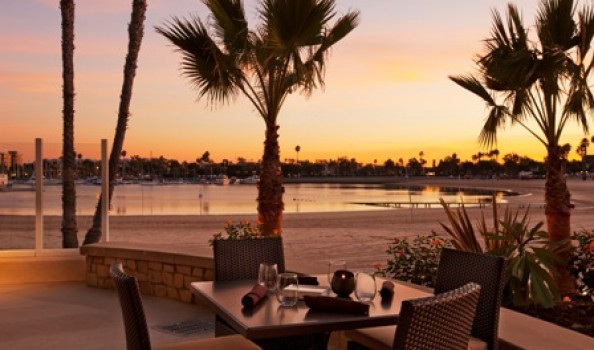 https://nakedhungrytraveller.com.au/making-lax-bearable/ Making LAX BearableLong haul air travel can be a real drag: cramped flights, aggressive security and bad food immediately spring to mind. It gets worse when a very long transit stop is included. Here the choices facing travellers become more complicated. Get away from the airport, enjoy a good night’s sleep, eat well and relax. [caption id="attachment_3430" align="alignnone" width="190"]
https://nakedhungrytraveller.com.au/making-lax-bearable/ Making LAX BearableLong haul air travel can be a real drag: cramped flights, aggressive security and bad food immediately spring to mind. It gets worse when a very long transit stop is included. Here the choices facing travellers become more complicated. Get away from the airport, enjoy a good night’s sleep, eat well and relax. [caption id="attachment_3430" align="alignnone" width="190"] Security queues outside LAX-BC (Bedlam Central)[/caption]
How you start a holiday is often a key indicator of how it will finish.
LAX is a stop I do everything to avoid short of hijacking the plane. For most visitors from Australia and New Zealand, it’s the unavoidable airport (San Francisco and Honolulu are reasonable alternatives) when travelling to North and Central America.
[caption id="attachment_3426" align="alignnone" width="275"]
Security queues outside LAX-BC (Bedlam Central)[/caption]
How you start a holiday is often a key indicator of how it will finish.
LAX is a stop I do everything to avoid short of hijacking the plane. For most visitors from Australia and New Zealand, it’s the unavoidable airport (San Francisco and Honolulu are reasonable alternatives) when travelling to North and Central America.
[caption id="attachment_3426" align="alignnone" width="275"]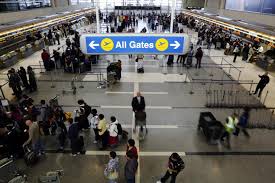 LAX-BC: where do I go?[/caption]
While LAX continues to upgrade some facilities, security, customs and immigration and public areas beyond the revamped Tom Bradley international terminal’s inner sanctum are still woefully inadequate and overcrowded.
It’s like a 4th world where anger management skills are tested beyond endurance point.
[caption id="attachment_3429" align="alignnone" width="275"]
LAX-BC: where do I go?[/caption]
While LAX continues to upgrade some facilities, security, customs and immigration and public areas beyond the revamped Tom Bradley international terminal’s inner sanctum are still woefully inadequate and overcrowded.
It’s like a 4th world where anger management skills are tested beyond endurance point.
[caption id="attachment_3429" align="alignnone" width="275"] Typical day at LAX-BC[/caption]
Less than 20 minutes drive from LAX-BC (Bedlam Central) is the waterfront village Marina Del Rey.
[caption id="attachment_3418" align="alignnone" width="336"]
Typical day at LAX-BC[/caption]
Less than 20 minutes drive from LAX-BC (Bedlam Central) is the waterfront village Marina Del Rey.
[caption id="attachment_3418" align="alignnone" width="336"]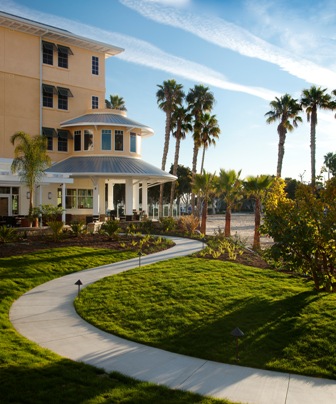 Jamaica Bay Inn walkway to bay beach[/caption]
This is my newest LAX-BC sufferance compensation plan.
With a sweet assortment of hotels lined up like refuges along a sheltered bay (with safe swimming beaches), mostly upmarket, mid-sized and new, this tidy bay side town is the guaranteed antidote to LAX-BC dyspepsia.
[caption id="attachment_3419" align="alignnone" width="450"]
Jamaica Bay Inn walkway to bay beach[/caption]
This is my newest LAX-BC sufferance compensation plan.
With a sweet assortment of hotels lined up like refuges along a sheltered bay (with safe swimming beaches), mostly upmarket, mid-sized and new, this tidy bay side town is the guaranteed antidote to LAX-BC dyspepsia.
[caption id="attachment_3419" align="alignnone" width="450"]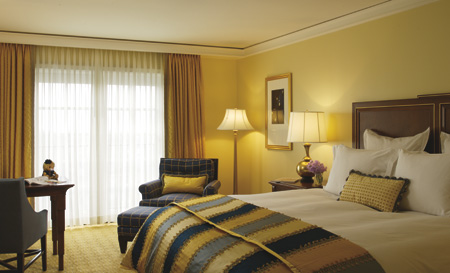 Ritz-Carlton Marina Del Rey deluxe room[/caption]
Arrange a transfer to your hotel (or book Uber as taxis have virtually disappeared from LAX-BC), have a good meal, sleep and awake refreshed for another onslaught at the urban disaster that is Los Angeles’ international gateway airport.
[caption id="attachment_3755" align="alignnone" width="800"]
Ritz-Carlton Marina Del Rey deluxe room[/caption]
Arrange a transfer to your hotel (or book Uber as taxis have virtually disappeared from LAX-BC), have a good meal, sleep and awake refreshed for another onslaught at the urban disaster that is Los Angeles’ international gateway airport.
[caption id="attachment_3755" align="alignnone" width="800"]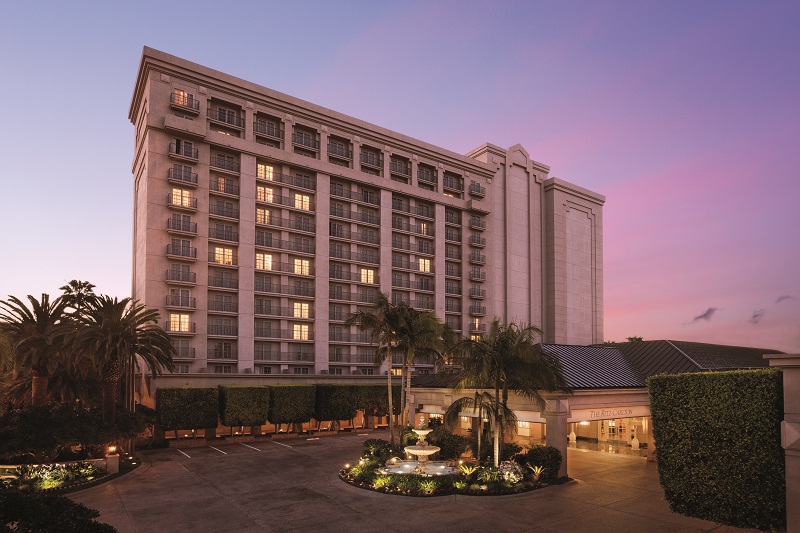 Ritz-Carlton Marina del Rey exterior[/caption]
I recently stayed at two different hotels during two separate transits: the Jamaica Bay Inn and the Ritz-Carlton.
www.pacificahotels.com/jamaicabayinn
www.ritzcarlton.com/marinadelrey
5-star hotels each one, sleek and well run, both in lovely waterside locations and both balms to restore faith in humanity after LAX-BC’s inhumanity to man treatment.
[caption id="attachment_3437" align="alignnone" width="448"]
Ritz-Carlton Marina del Rey exterior[/caption]
I recently stayed at two different hotels during two separate transits: the Jamaica Bay Inn and the Ritz-Carlton.
www.pacificahotels.com/jamaicabayinn
www.ritzcarlton.com/marinadelrey
5-star hotels each one, sleek and well run, both in lovely waterside locations and both balms to restore faith in humanity after LAX-BC’s inhumanity to man treatment.
[caption id="attachment_3437" align="alignnone" width="448"] Jamaica Bay Inn king room[/caption]
My stays were brief, late arrivals and early morning departures necessitated short acquaintanceships (sadly) but I left feeling revived, like the nightmare memory of LAX-BC was almost totally erased.
[caption id="attachment_3421" align="alignnone" width="600"]
Jamaica Bay Inn king room[/caption]
My stays were brief, late arrivals and early morning departures necessitated short acquaintanceships (sadly) but I left feeling revived, like the nightmare memory of LAX-BC was almost totally erased.
[caption id="attachment_3421" align="alignnone" width="600"]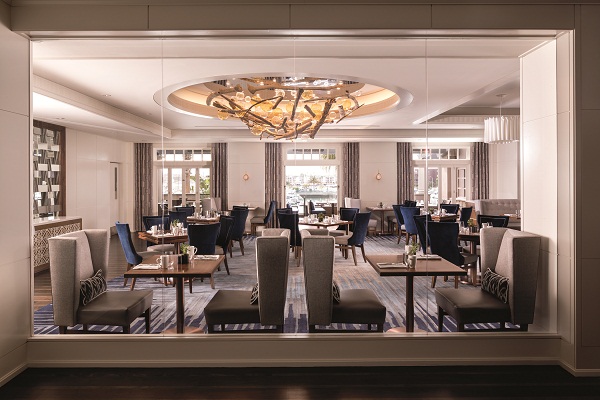 Cast & Plow restaurant interior[/caption]
Can anyone ask more from an overnight transit stay?
Were I forced to pick between the two, I’d choose the Ritz-Carlton (it’s more expensive but worth it) for its terrific restaurant Cast & Plow, which specialises in farm to table food cooked with expertise and imagination and a terrific in house spa where I passed out during an hour’s massage. My room was generously proportioned, plenty of space to spread out; large windows opened to picturesque views over the bay (and not the airport thank goodness) was furnished with a comfy armchair and large desk. Typical hotel room in all respects but with a touch of class brand Ritz-Carlton does exceedingly well. The bed was a dream space... literally. I wanted to take the bed away with me; our love affair was sadly all too brief.
The Jamaica Bay Inn is about the same size as the Ritz-Carlton room-wise but has bay beachfront access if a refreshing dip in the pacifying Pacific is in order. Its outdoor restaurant sports a tropical air, relaxed atmosphere, perfect for a cocktail flight, Mexican inspired food that delivers the goods, everything the bad transit doctor ordered to cure LAX-BC blues.
Jamaica Bay Inn rooms are smartly decorated; no complaints, best of all, peace and quiet rules.
Both hotels boast excellently trained employees, helpful when needed, polite, solicitous and always friendly without being overbearing. When United Airlines lost my bag again, the Jamaica Bay Inn reception desk managers made all the necessary ‘where-is-his-luggage?’ calls for me, ensuring my suitcase was delivered to the hotel before my subsequent early morning flight. I know it’s the job to look after the guest but this seemed to me above and beyond the call of duty. Had my bag and I not been re-united (pun intended) that night, I doubt I would ever have seen it again. United Airlines has sent my bag to parts unknown before; a track record I find unnervingly constant.
NHT advice: skip the boring LAX-BC hotels overlooking the runways and make the short and easy trip to Marina Del Rey for the overnight transit refresher to beat all others.
[caption id="attachment_3423" align="alignnone" width="600"]
Cast & Plow restaurant interior[/caption]
Can anyone ask more from an overnight transit stay?
Were I forced to pick between the two, I’d choose the Ritz-Carlton (it’s more expensive but worth it) for its terrific restaurant Cast & Plow, which specialises in farm to table food cooked with expertise and imagination and a terrific in house spa where I passed out during an hour’s massage. My room was generously proportioned, plenty of space to spread out; large windows opened to picturesque views over the bay (and not the airport thank goodness) was furnished with a comfy armchair and large desk. Typical hotel room in all respects but with a touch of class brand Ritz-Carlton does exceedingly well. The bed was a dream space... literally. I wanted to take the bed away with me; our love affair was sadly all too brief.
The Jamaica Bay Inn is about the same size as the Ritz-Carlton room-wise but has bay beachfront access if a refreshing dip in the pacifying Pacific is in order. Its outdoor restaurant sports a tropical air, relaxed atmosphere, perfect for a cocktail flight, Mexican inspired food that delivers the goods, everything the bad transit doctor ordered to cure LAX-BC blues.
Jamaica Bay Inn rooms are smartly decorated; no complaints, best of all, peace and quiet rules.
Both hotels boast excellently trained employees, helpful when needed, polite, solicitous and always friendly without being overbearing. When United Airlines lost my bag again, the Jamaica Bay Inn reception desk managers made all the necessary ‘where-is-his-luggage?’ calls for me, ensuring my suitcase was delivered to the hotel before my subsequent early morning flight. I know it’s the job to look after the guest but this seemed to me above and beyond the call of duty. Had my bag and I not been re-united (pun intended) that night, I doubt I would ever have seen it again. United Airlines has sent my bag to parts unknown before; a track record I find unnervingly constant.
NHT advice: skip the boring LAX-BC hotels overlooking the runways and make the short and easy trip to Marina Del Rey for the overnight transit refresher to beat all others.
[caption id="attachment_3423" align="alignnone" width="600"]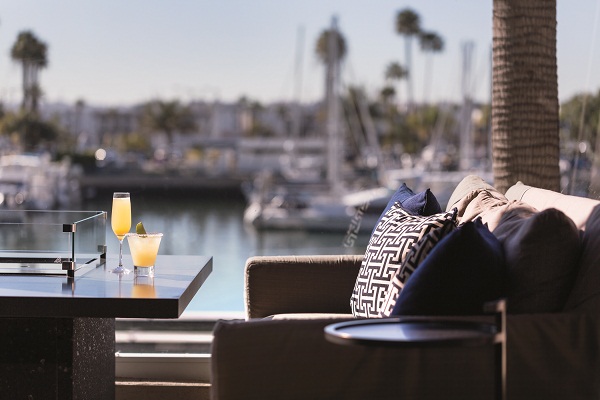 Drinks at the Ritz-Carlton Marina Del Rey[/caption]
Tom Neal Tacker stayed (briefly) in Marina Del Rey as a guest of the Marina Del Rey Convention and Visitor’s Bureau.
Drinks at the Ritz-Carlton Marina Del Rey[/caption]
Tom Neal Tacker stayed (briefly) in Marina Del Rey as a guest of the Marina Del Rey Convention and Visitor’s Bureau.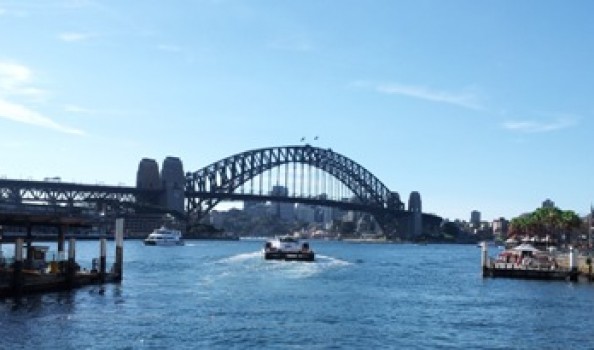 https://nakedhungrytraveller.com.au/sydney-beyond-thunderdome/ Sydney: Beyond Thunderdome?
https://nakedhungrytraveller.com.au/sydney-beyond-thunderdome/ Sydney: Beyond Thunderdome?What does tourist-central Sydney look like on a perfect spring day? Huge crowds line Circular Quay’s rounded shore like it’s the planet’s best natural amphitheatre, no ticket required.
Angling for the best view of the Opera House, travellers happy snap other travellers taking happy snaps, the Harbour Bridge as a backdrop always the preferred selfie position. Winter blues are swept away by smog-less sunny skies.
[caption id="attachment_2249" align="alignnone" width="448"]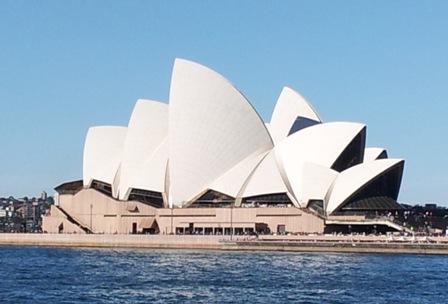 Sydney Opera House.[/caption]
Sydney Opera House.[/caption]
The Opera Bar on the concourse level is packed. Other waterside cafes do a roaring trade. Buskers cash in on crowds ready to contribute to amateur shows, acrobats prancing one impromptu stage, didgeridoo players puffing on another. The new wing of the Museum of Contemporary Art is full of admirers or bored hangers-on. Packed ferries wash in and out from their prime-positioned wharves, full of commuters and tourists. Seagulls look fat on chips and meat pie crusts.
[caption id="attachment_2252" align="alignnone" width="448"]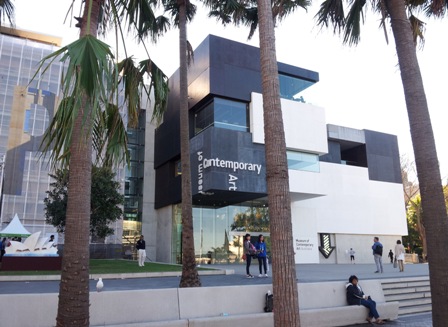 Museum of Contemporary Art new entry.[/caption]
Museum of Contemporary Art new entry.[/caption]
Random pedestrians take time to read the Writer’s Walk bronze plaques commemorating national and international writers embedded into Circular Quay’s pavements. Comparatively speaking, not many onlookers read the plaques but a few curious travellers with obvious literary interests enjoy the potted histories nonetheless. These metal mementos are my favourite Quay objects; the similarly embedded bronze dotted lines marking the extent of Circular Quay’s historic shoreline sharing an equal fascination.
Sydney’s dress circle is looking great these days. (It will look better when the disastrous elevated section of the Cahill Expressway is removed and the train line is finally shoved underground but that’s a multi-billion dollar project waiting on a forward thinking government willing to commit to a budgetary decision beyond the next election date.)
[caption id="attachment_2251" align="alignnone" width="448"]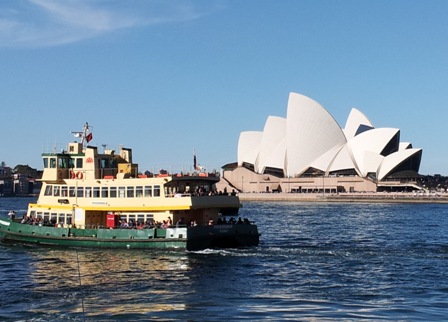 Opera House and ferry.[/caption]
Opera House and ferry.[/caption]
Remember Sydney 2000? The Olympics centre of planet universe? Sydney was the epicentre of sport and media attention combined. Juan Antonio Samaranch (former President of the International Olympic Committee, fondly nicknamed by smart-alecky Sydneysiders as ‘One Tomato Sandwich’) famously declared that ‘Syd-erney’ hosted the best Olympics ever. The city was completely and flagrantly abuzz with entertainment and sports-related activity, most of it free. Lanyard wearing volunteers worked the city streets like seasoned tour guides, greeting complete strangers with entreaties of charitable assistance, happy to help whomever whenever. There was an overriding sense that Sydney’s attractions-loaded gravitational pull had finally become globally irresistible.
[caption id="attachment_2253" align="alignnone" width="448"]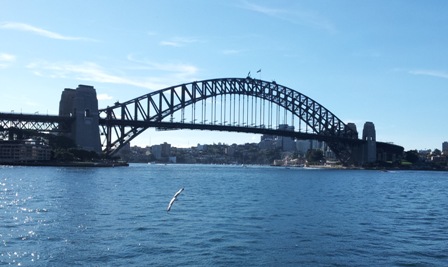 Harbour Bridge towards Lower North Shore.[/caption]
Harbour Bridge towards Lower North Shore.[/caption]
At the coalface, Sydneysiders exclaimed joy at the surfeit of free parking spaces (me amongst them) in the normally car crowded CBD. Public transport worked better than ever, the cleaner trains actually ran on time. Better still, prime harbour side houses could be rented to visitors at unbelievable prices, even enough to fund a luxury trip to Paris for a month while their owners were keen to avoid the Olympian crowds. Already cashed-up Sydneysiders reaped lucrative rewards.
Those were heady times indeed.
Post Olympics, Sydney tourism slumped. Too many 5-star hotels built for 2000’s rush competed for too few visitors. Tourism Sydney and NSW Tourism PR campaigns were roundly criticised for relying on past glories rather than encouraging newly refreshed repeat business. A lack of imagination on the part of tourism bureaucrats was all too apparent.
Only recently has Sydney begun to emerge from its post-Olympics tourism doldrums.
Fast forward to 2015, an O. Winfrey chat show circus came and went. An E. De Generes chat show circus followed. Different audiences (mostly USA based) expressed renewed interest in visiting old ‘Syder-ney’. More cruise ships than ever are stopping in for a night or two. Most good hotels are registering over 80% capacity while more visitors from China, India and the Middle East have taken up the slack left by Europeans and Americans frightened off by high prices, restricted by their own moribund economies.
Sydney is one of the world’s favourite cities. That fact hasn’t changed. What has changed is an increase in international visitors. Overall numbers are up again.
Apart from taking in the usual suspects: Bridge, Opera House, Circular Quay being the dress circle stars of the show, why not have a look at a few other sides of Sydney unknown to most visitors?
[caption id="attachment_2257" align="alignnone" width="448"]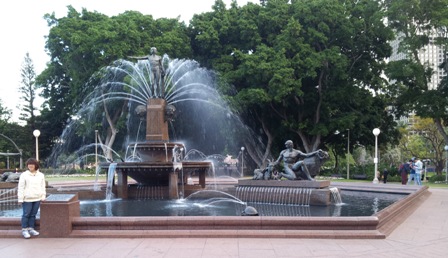 Archibald Fountain in Hyde Park.[/caption]
Archibald Fountain in Hyde Park.[/caption]
For instance, a short walk south from the Opera House along Macquarie St to Hyde Park takes in some major historical sights: the New South Wales Parliament building, the Australian Mint, the Hyde Park Barracks and the northern entrance to Hyde Park itself with its marvellous Archibald Fountain serving as the bubbly end point to the fig-tree lined walk south to the ANZAC memorial. Statues of Queen Victoria (glowering as usual) and her Prince Consort Albert (attractive as usual) stand at either end of the small Queen’s Square facing the front of renowned convict architect Francis Greenway’s St. James’ Church.
[caption id="attachment_2255" align="alignnone" width="298"]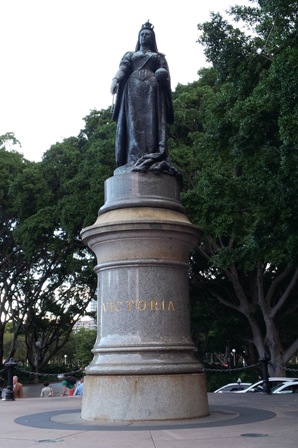 Queen Victoria statue in Queen's Square.[/caption]
Queen Victoria statue in Queen's Square.[/caption]
It’s a quintessential downtown Sydney historical promenade. What most visitors overlook as they stroll along Macquarie St is the statue of Matthew Flinders in front of the State Library of NSW (The Mitchell Library). The first two volumes of Flinders’ journal concerning his circumnavigation of Australia in 1802 are housed within. A small statue of Flinders’ faithful and beloved cat, Trim, rests on the outside sill of a stained glass window of the library behind the much larger statue of the great navigator himself.
[caption id="attachment_2254" align="alignnone" width="336"] Statue of Trim, Matthew Flinders' cat in one of Library of NSW's windows.[/caption]
Statue of Trim, Matthew Flinders' cat in one of Library of NSW's windows.[/caption]
The plaque under Trim’s statue reads: TO THE MEMORY OF TRIM:
The best and most illustrious of his race. The most affectionate of friends, faithful of servants, and best of creatures. He made the tour of the globe, and a voyage to Australia, which he circumnavigated, and was ever the delight and pleasure of his fellow voyagers.Written by Matthew Flinders in memory of his cat Memorial donated by the North Shore Historical Society
I always pause (paws?) to reflect at this particular point in the brief walk along Sydney’s memory lane. Trim was well loved among Flinders’ crew for his good nature and tenacity.
[caption id="attachment_2256" align="alignnone" width="336"]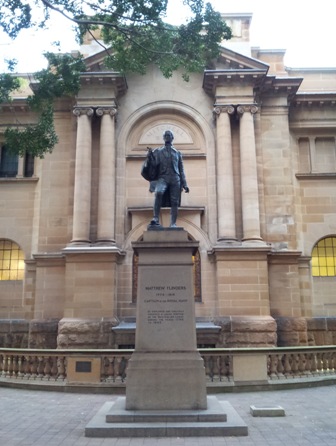 Matthew Flinders statue-Trim is behind him in the window.[/caption]
Matthew Flinders statue-Trim is behind him in the window.[/caption]
Here’s a short list of three off-the-beaten-track excursions, all easily managed in a day and readily accessible on public transport:
[caption id="attachment_2266" align="alignnone" width="180"] View over Middle Harbour with Spit Bridge.[/caption]
View over Middle Harbour with Spit Bridge.[/caption]
1) 1) Take a bus across the Harbour Bridge along the lower North Shore to The Spit and hire a kayak. Paddle up Middle Harbour past the Roseville Bridge into Garigal National Park to witness a slice of Australia’s largest city from sea level. If you’re lucky, at the northernmost reaches of Middle Harbour the water will run clear as gin and your only company will be kookaburras flitting in and out of surrounding gum forest while mullets leap from the water around the kayak. The city’s hubbub is completely forgotten. As you paddle over a white sandy bottom, remember what Sydney once was before urbanisation obliterated the landscape and Kuringai people owned the land. Be sure to return the hired kayak before the rental shop closes at 6pm. Also pay attention to the tides. A hard paddle back to The Spit from Garigal National Park takes at least three hours if the tide is running against you.
[caption id="attachment_2267" align="alignnone" width="163"]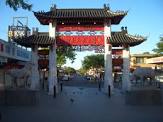 Welcome gate at Cabramatta.[/caption]
Welcome gate at Cabramatta.[/caption]
2) 2) Take the train to Cabramatta, former heroin distribution capital of NSW and now a reformed example of positive multiculturalism in action. The Southeast Asian community here dominates the atmosphere and the lively vibe is infectious. In summer, street vendors sell freshly pressed sugar cane juice served fresh in plastic cups with a squeeze of lime. AUD$2 is the going price. At any time of year, duck or pork sold from various roasting specialists perfume Cabramatta’s laneways while vegetarian fresh rice paper spring rolls pop up in dozens of stalls at about AUD$3 per roll. Vietnamese Pho soup is served in huge bowls for AUD$10, always a bargain. If a better example of urban renewal exists in Australia, please alert the media.
[caption id="attachment_2269" align="alignnone" width="171"] Wendy Whiteley's secret garden.[/caption]
[caption id="attachment_2268" align="alignnone" width="174"]
Wendy Whiteley's secret garden.[/caption]
[caption id="attachment_2268" align="alignnone" width="174"] Kirribilli House Gate.[/caption]
Kirribilli House Gate.[/caption]
1) 3) Take the ferry to Kirribilli, five minutes across the Harbour from Circular Quay. Walk to Kirribilli House and Admiralty House along the foreshore besides some fairly non-descript apartment blocks to two of the Harbour’s ultimate chic addresses, both grand residences right on Sydney’s Harbour. The former (Kirribilli House) is the Prime Minister’s residence in Sydney and the latter (Admiralty House) is the Queen of Australia’s residence when she visits Sydney. Entry without prior invitation to either house or their gardens (that’s you visitor!) is prohibited. Loitering at the wrought iron gate entrance to Kirribilli House is also discouraged but it’s a fun exercise tempting existential fate. Ask the security goons whether or not the PM is at home and be prepared to accept ‘No’ as the answer. Retrace your steps to the other (western) side of the Bridge to the fantastical Art Deco amusement park Luna Park, skirting its northern edge while making your way across Blues Point Road to Wendy Whiteley’s private garden at McMahon’s Point overlooking Lavender Bay near Clark Park. Wendy Whiteley (widow of famous deceased artist Brett Whiteley) created this delightfully simple garden essentially out of a public dumping ground. Her daughter Arkie (who died of cancer at a young age) and husband Brett’s ashes are buried in the park. Artists are naturally encouraged to linger, perhaps to draw, perhaps to paint or write. Follow the shoreline to Balls Head past the Waverton bowls club at the shore’s edge along Berrys Bay to the last remaining bit of original bushland on this part of Sydney's Inner Harbour. Follow the track around the headland to search for ancient indigenous rock carvings (a man inside a whale is one of the most interesting) and various middens. Stop to marvel at the view across the water to Darling Harbour. Walk back up Balls Head Road to Bay Road which leads to the Waverton railway station. Board the train back into the city from here, which is less than ten minutes away by train across the Harbour Bridge via North Sydney.
These three easy excursions provide a slice of Sydney life unknown to most visitors while the day trip to Cabramatta in Sydney’s western outskirts offers a glimpse into where the majority of Sydney’s population actually lives.
A house with a harbour view costs on average more than AUD$3,000,000 these days. Only a minority of residents can afford to live on the water. The two waterside day trips pack a lot of pizzazz, no wonder Sydneysiders dream of living in a house on the Harbour.
But beyond the Harbour’s glittering shores, life in the suburbs has become harder, traffic is worse than ever according to complaints uttered by commuters making the daily trek into and out of town on over-crowded, late-running trains, ferries and buses. Roads are jammed from early morning until well after sunset. The lack of public transport funding is contentious as always, a side of Sydney most international and domestic visitors almost never see.
A journalist friend with whom I once worked (at a local newspaper) told me she thought Sydney was a ‘wicked step-sister of a city’ a nice way of saying it was a bitch of a place in which to live if money is short. That fact hasn’t changed. Sydney is very expensive, even when compared to the average daily living expenses incurred in well known money-gobbling cities such as New York, London, Tokyo or Paris.
For travellers trying to get by on less than AUD$200 per day, staying in the worst flea-pit backpacker hostels, eating two simple take-away meals per day and walking everywhere, is possible but not very nice.
A recent acquaintance (originally from New Zealand) calls Sydney ‘Beyond Thunderdome’. Certainly that’s a description which conveys ‘Mad Max’ memories, applicable to Sydney’s public arena appeal.
But as former PM Paul Keating once quipped, ‘If you’re not living in Sydney, you’re just camping out.’
Personally speaking, I like camping out. Having been a resident of Sydney for more than twenty years, I say with hand on heart that it’s not the be-all-to-end-all Australian city but it’s a very nice place to visit.
Tom Neal Tacker visited Sydney as a guest of Swissotel Sydney.
Naked Facts:
Naked Sleeps:
One of Sydney’s better 5-star hotels is the Swissotel. A recent upgrade of its rooms (2014) and public facilities has provided even more good reasons to enjoy its restaurant and bar. An in-house spa is one of the city’s top pampering palaces.
[caption id="attachment_2260" align="alignnone" width="322"]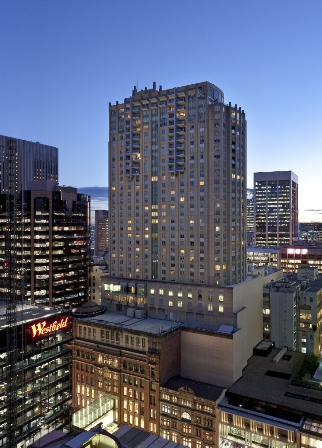 Swissotel Sydney exterior.[/caption]
Swissotel Sydney exterior.[/caption]
The upper two floors offer access to the executive lounge, free breakfast and evening drinks plus snacks for a moderate surcharge. The rooms from these two levels boast great views either over the lower Harbour to the Heads or west all the way to the Blue Mountains and the upper Harbour. A large outdoor heated pool and well equipped gymnasium add more value.
[caption id="attachment_2259" align="alignnone" width="448"]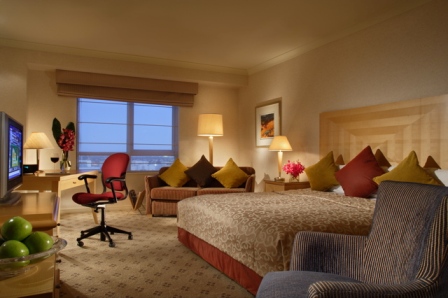 Swissotel Executive King room.[/caption]
Swissotel Executive King room.[/caption]
Service is slick and efficient. It’s a very well run establishment, befitting its Swiss heritage, everything works like... well... clockwork. The location in Market Street near the corner of George Street is unbeatable. All the city’s major CBD attractions are within an easy walk.
See www.swissotel.com for more information.
Another hotel I like is the Fraser Suites apartment hotel. It’s a sleek modern tower kind of hidden away in a quiet block of Kent Street near Town Hall. I’ve stayed here a few times and appreciated the in-room kitchens, very large rooms (separate bedroom and lounge room with kitchenette) which provide plenty of space to claim as a temporary home. Though Fraser Suites doesn’t offer the same range of amenities as a truly full service hotel, it’s still a treat staying there as sometimes I like the independence that self-catering offers.
See www.sydneyfrasershospitality.com
Another old favourite is The Hughenden in Queen St near the corner of Oxford St in tony Woollahra. A home away from home for writers and artists looking for the bolthole that offers the seclusion and home comforts they miss. Recent upgrades to the rooms, bar and restaurant have lifted this once quirky but fun boutique hotel to still quirky but now very reliably upmarket with service to match. Unusual for inner Sydney hotels, it's also pet friendly with several rooms set aside for travelling pets and their minders. With the expanse of Centennial Park directly across the street, what could serve better to provide doggy bliss?
While the in-house restaurant used to be rather hit and miss, since 2014 it's moved up several notches on the good cooking scale. Now I eat dinner there without hesitation.
Breakfasts are cooked to order from an a la carte menu that ticks all the requisite boxes to keep travellers happy until the next meal.
The owners have acquired the old Centennial Park manager's house for private accommodation. A lovingly restored Federation era grand house comprising four spacious bedrooms with ensuite bathrooms, tastefully decorated entertaining areas, a formal dining room and superbly equipped kitchen is set within its own private garden. When the park gates shut at sunset, residents have the whole park to themselves. Security keys allow access 24/7 for paying guests. The house is available as a complete package; rooms cannot be rented separately. As a private function space, it's unparalleled in this swish neighbourhood. The Hughenden will provide a private chef and well stocked larder as well.
See www.thehughenden.com.au for more information and reservations.
Naked Eats:
During another recent visit I dined very well at Dragoncello, owned and operated by Roy Mcveigh. With a very impressive chef's pedigree, he's cooking what I like to eat: honest, toothsome and healthy. Following the trends set by most leading-edge chefs these days, Mcveigh's menu emphasises locally grown produce much as possible, accompanied by a small but expanding kitchen garden and a cleverly assembled wine list. Dragoncello (tarragon in Italian) is at the quiet end of Cleveland St in Surry Hills near South Dowling St. See www.dragoncello.com.au for bookings.
Over three nights during another recent visit to ‘Beyond Thunderdome’ I dined at Tetsuya’s, Est and Sepia. Tetsuya’s is rightly famous. Since the early 90s ‘Tet’s, (as Tetsuya Wakuda is affectionately known to all persons who’ve crossed his gregariously engaging path) restaurant has evolved into a globally recognised temple of gastronomy. However, in my opinion Tetsuya Wakuda’s cooking these days isn’t nearly as cutting edge as it once was. That’s not a bad thing necessarily (maintaining an excellent standard for so many years is laudable and should be respectfully acknowledged) but during a degustation of more than ten courses, three of them were primarily comprised of very simple sashimi. I like superb quality produce as much as any glutton but those three courses out of ten exhibited a lack of imagination that impaired what should have been a feast of inspiration.
The meal I ate at Est was better than Tetsuya’s. Chef/owner Peter Doyle is one of Sydney’s hero chefs, a long-standing favourite of dedicated diners keen on the pursuit of gastronomic prowess who’s been in the hospitality game for decades. He commands great respect from his peers while customers continue to fall in love with his superlative cooking. A dinner at Est is simply sublime. By the way, both Tetsuya’s and Est provide seamless dining experiences. Wine lists are literally works of encyclopaedic art and service is nothing short of flawless.
That being said, Sepia was the restaurant that knocked off my socks and blew my mind simultaneously.
[caption id="attachment_2261" align="alignnone" width="448"]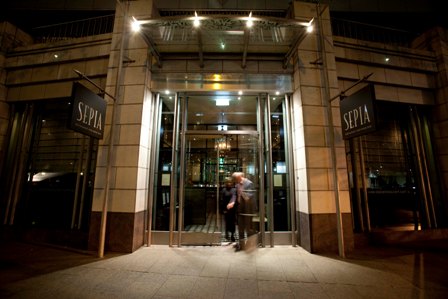 Entrance to Sepia restaurant.[/caption]
Entrance to Sepia restaurant.[/caption]
Hungry sophisticated travellers will be excited by the whole package at Sepia, one of the city’s most stimulating restaurants. Chef/owner Martin Benn is one of those rare geniuses, whose cooking talents display a level of sophistication that should be encouraged and embraced wholeheartedly by all dedicated gastronomes.
Devouring thirteen courses during a degustation of immense expertise, I admit to being in an element I’d like to call real food heaven for all holy gourmet cynical atheists like me.
While our table was being prepared, we sat in comfy leather lounges at the bar while sipping aperitifs. A Lillet Rose on ice for me, a chilled Floc de Gascogne for my partner in dinner crime.
Gracefully escorted into the slightly dark (sepia tones naturally), rather hushed but not unfriendly dining room, we checked out other diners. Fashion victims out for a big night on the town? Tick. Food bloggers snapping pics of plates while texting friends in HK? Tick. Small groups of family friends dining out at the big end of town? Tick. Date night for couples in the throes of infatuation? Tick.
Another Friday night out in Sydney for people interested in food that may provide conversation in and of itself? Most definitely yes.
To start: freshly shucked Pambula Sydney Rock oysters with lime and sake and a glass of Laurent-Perrier ‘Ultra Brut’ Brut Nature. I’m a total sucker for oysters and Champagne so I fell under the Sepia spell right from the get-go.
But wait there’s more...
Sashimi of Big Eye tuna, steamed Japanese omelette, white soy jelly, dashi onion cream, puffed buckwheat, green apple and nori.
A course that could confound anyone given the surfeit of ingredients but actually it was simplicity personified. The omelette almost melted along side the exquisitely fresh fish while all the other factors just melded into the mix like a magic pudding I never wanted to see end. A matching glass of Umenoyado ‘Gin’ Jinmao-Ginjo sake from Nara was a brilliantly chosen accompaniment.
Following was another sashimi course (Tetsuya’s comparisons are inevitable but Sepia’s two sashimi courses were infinitely better executed) of Bonito, flavours of roasted chicken, umeboshi, upland cress, green tea and nori. This course really rocked.
Crisped chicken skin and raw bonito with sour umeboshi and tannic green tea combined to create an umami driven taste sensation. Paired with an Austrian 2011 Furmint from Wenzel in the Burgenland, by then I had fallen into a state of pure culinary kismet.
A single barely cooked Scampi tail was accompanied with sudachi, parsley root, white miso, nori fried potato and white Linaria flowers. Great to look at, better to eat. Meltingly buttery, slightly sweet scampi was infused by the other salty, bitter flavours, the pretty little flowers adding both piquancy and texture all at once. A 2011 Clos Sainte Magdeleine Marsanne-Clairette-Ugni Blanc-Bourboulenc from Cassis in southern France was another gob-smacking wine match.
A Seared Mandagery Venison, boudin noir, chocolate crumb, macadamia nut yoghurt, blackcurrant and sichimi pepper reads like a bizarre dessert horror story but this incredible treatment of excellent quality venison and surprisingly complementary accompaniments was another perfect dish highlighting outstanding kitchen accomplishment, fully realising an ability to draw a clearly defined line between savoury and sweet without erring on one side or the other. The 2006 Dominio de Alauta Tempranillo from the Ribero del Duero was another example of truly inspired wine/food matching.
The Aged Garrotxa goat cheese, sake and goat milk dumplings, celeriac cream, nashi pear and celery matched with a cider from Suffolk (Aspall ‘Draught’) was yet another revelation. I didn’t think I could eat more protein after the venison but I was happy I did. Those dumplings were a tour-de-force.
The chef threw in a special course of his (becoming famous) Sugar ball with finger lime sorbet encased within. We were offered a special Japanese Yuzu liqueur to accompany that incredibly innovative course. Evidently, Benn worked for over three months to bring the perfectly spherical planet of sweet/sour sorbet freshness to fruition.
A Soft-poached meringue, truffle ice cream, truffle and rosemary honey hazelnut praline with malt second dessert followed. The 2011 Royal Tokaji Wine Company ‘Late Harvest’ Furmint-Harslevelu-Sarga Muscotaly matched that particular indulgence, fascinating to sample two wines (one dry the other sweet) made from the primarily Hungarian grape Furmint in the one meal.
We had three additional courses to the set ten course menu. The first were the Pambula oysters, the dumplings were second and the third was compliments of the chef, the sugar ball encasing finger lime sorbet.
Do yourselves a flavour favour: dine at Sepia to witness greatness in action.
[caption id="attachment_2262" align="alignnone" width="448"]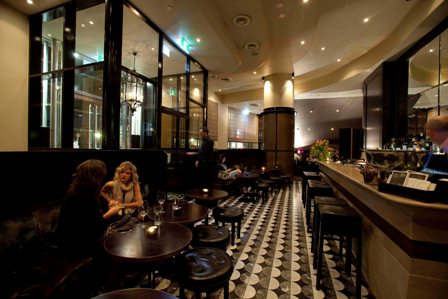 Sepia restaurant bar at night.[/caption]
Sepia restaurant bar at night.[/caption]
Naked Tips:
For very general information see www.sydney.com for accommodation tips, public transport information and special events specifically pertaining to Sydney.
For comprehensive NSW state tourism information visit: www.visitnsw.com
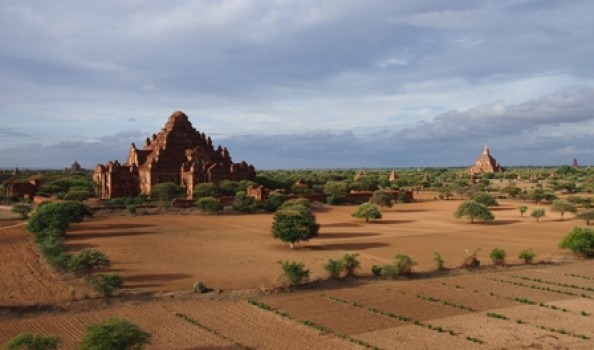 https://nakedhungrytraveller.com.au/myanmar-meandering-pagan-mandalay/ Myanmar Meandering Pagan to MandalayHave you been to Pagan? Pronounced Pah-Gahn and occasionally spelled Bagan, isn’t a locus for transfixed pagan worshipers. Instead it’s one of the world’s most bewitching archaeological sites. (Realising I wrote a very clumsy introductory sentence due to the fact so much has already been written about Pagan’s obvious wonders, a segue to the first stanza of a Samuel Taylor Coleridge poem is in order. It best describes what Pagan means to me.)
https://nakedhungrytraveller.com.au/myanmar-meandering-pagan-mandalay/ Myanmar Meandering Pagan to MandalayHave you been to Pagan? Pronounced Pah-Gahn and occasionally spelled Bagan, isn’t a locus for transfixed pagan worshipers. Instead it’s one of the world’s most bewitching archaeological sites. (Realising I wrote a very clumsy introductory sentence due to the fact so much has already been written about Pagan’s obvious wonders, a segue to the first stanza of a Samuel Taylor Coleridge poem is in order. It best describes what Pagan means to me.)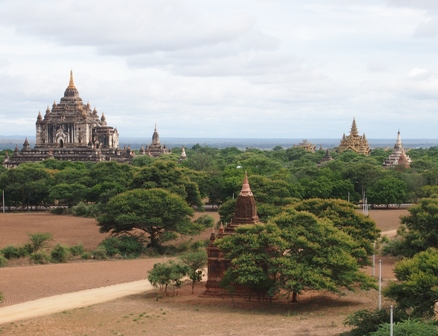 Kubla Khan
In Xanadu did Kubla Khan, A stately pleasure-dome decree:
Where Alph, the sacred river,
Ran through caverns measureless to man
Down to a sunless sea.
So twice five miles of fertile ground
With walls and towers were girdled round;
And there were gardens bright with sinuous rills,
Where blossomed many an incense-bearing tree;
And here were forests ancient as the hills, Enfolding sunny spots of greenery.
[caption id="attachment_3112" align="alignnone" width="448"]
Kubla Khan
In Xanadu did Kubla Khan, A stately pleasure-dome decree:
Where Alph, the sacred river,
Ran through caverns measureless to man
Down to a sunless sea.
So twice five miles of fertile ground
With walls and towers were girdled round;
And there were gardens bright with sinuous rills,
Where blossomed many an incense-bearing tree;
And here were forests ancient as the hills, Enfolding sunny spots of greenery.
[caption id="attachment_3112" align="alignnone" width="448"]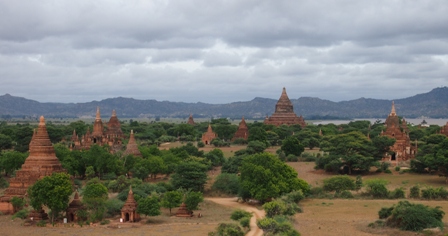 Ananda Temple view at Pagan[/caption]
In 1287AD, Kublai Khan, the rampaging Mongol military genius who conquered most of Asia including Myanmar, brought an abrupt end to Pagan's dominance.
[caption id="attachment_3188" align="alignnone" width="448"]
Ananda Temple view at Pagan[/caption]
In 1287AD, Kublai Khan, the rampaging Mongol military genius who conquered most of Asia including Myanmar, brought an abrupt end to Pagan's dominance.
[caption id="attachment_3188" align="alignnone" width="448"]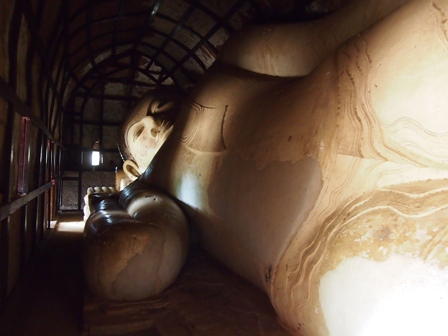 Reclining Buddha at Shwesandaw Stupa Pagan[/caption]
Depopulated and forgot the former capital slumbered for centuries in almost total obscurity.
[caption id="attachment_3134" align="alignnone" width="375"]
Reclining Buddha at Shwesandaw Stupa Pagan[/caption]
Depopulated and forgot the former capital slumbered for centuries in almost total obscurity.
[caption id="attachment_3134" align="alignnone" width="375"] Temple Buddha Pagan[/caption]
The great temple city became a ghost of its past, crops of sesame and peanuts subsumed royal roads, while ornate pagodas and simple mud brick houses alike dissolved under monsoon rains, leaving behind merely the memory of former glory.
[caption id="attachment_3113" align="alignnone" width="448"]
Temple Buddha Pagan[/caption]
The great temple city became a ghost of its past, crops of sesame and peanuts subsumed royal roads, while ornate pagodas and simple mud brick houses alike dissolved under monsoon rains, leaving behind merely the memory of former glory.
[caption id="attachment_3113" align="alignnone" width="448"] Pagan temples[/caption]
Only the sturdiest stone and brick temples remained (over 3,000 by some counts), scattered over a wide area along the east bank of the Irrawaddy River (Sacred Alph stand-in) amongst the russet dirt fields, tiny villages with hard scrabbling farmers and ‘thanaka’ tree groves.
[caption id="attachment_3198" align="alignnone" width="448"]
Pagan temples[/caption]
Only the sturdiest stone and brick temples remained (over 3,000 by some counts), scattered over a wide area along the east bank of the Irrawaddy River (Sacred Alph stand-in) amongst the russet dirt fields, tiny villages with hard scrabbling farmers and ‘thanaka’ tree groves.
[caption id="attachment_3198" align="alignnone" width="448"]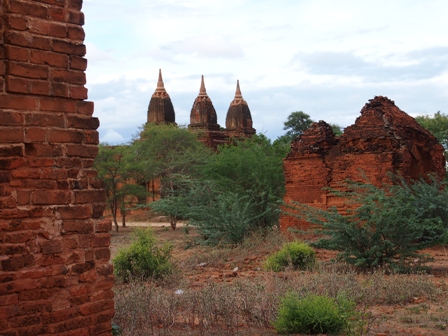 Pagan pagodas[/caption]
Had Kublai Khan stayed to establish Pagan as his new empire’s capital, present history may have turned out differently.
[caption id="attachment_3197" align="alignnone" width="448"]
Pagan pagodas[/caption]
Had Kublai Khan stayed to establish Pagan as his new empire’s capital, present history may have turned out differently.
[caption id="attachment_3197" align="alignnone" width="448"]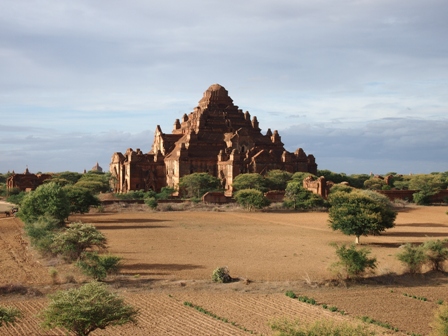 Htilo-Minlo Temple Pagan[/caption]
Now Pagan is Myanmar’s global tourism drawcard, a sight unlike any other in Asia, including Angkor Wat, Borobudur and Anuradhapura.
[caption id="attachment_3199" align="alignnone" width="336"]
Htilo-Minlo Temple Pagan[/caption]
Now Pagan is Myanmar’s global tourism drawcard, a sight unlike any other in Asia, including Angkor Wat, Borobudur and Anuradhapura.
[caption id="attachment_3199" align="alignnone" width="336"]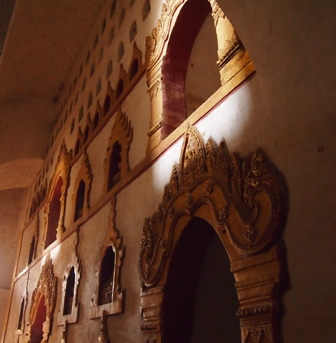 Manuha temple interior Pagan[/caption]
Unlike many tourism drawcards which can be disappointing when seen firsthand, Pagan is endlessly fascinating. I could easily have spent weeks there lost in a wondrous mental haze wandering amongst forgotten temples, my own meandering motion, echoing Coleridge’s poem.
[caption id="attachment_3115" align="alignnone" width="443"]
Manuha temple interior Pagan[/caption]
Unlike many tourism drawcards which can be disappointing when seen firsthand, Pagan is endlessly fascinating. I could easily have spent weeks there lost in a wondrous mental haze wandering amongst forgotten temples, my own meandering motion, echoing Coleridge’s poem.
[caption id="attachment_3115" align="alignnone" width="443"]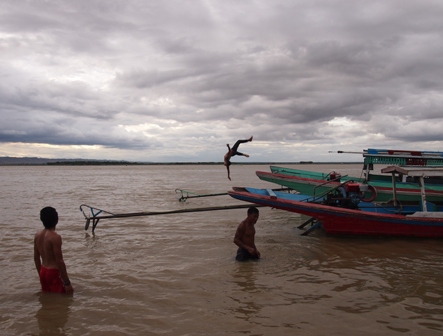 Boys playing in river at Pagan[/caption]
But there’s a boat waiting and I'm a passenger on it. The RV Orient Pandaw is heading upriver from Pagan to a small village past Mandalay and I can’t afford to miss my ride.
Sadly, only a few days in Pagan was all I had spare, the facts of travelling to a timetable not of one’s own making.
When time is limited in such a wonderful place, best to make the most of it.
One afternoon eight other passengers and I visited the tiny West Pwasaw farming village, hidden away amongst the thousands of historic sites in Pagan, where life is rustic and simple.
[caption id="attachment_3120" align="alignnone" width="377"]
Boys playing in river at Pagan[/caption]
But there’s a boat waiting and I'm a passenger on it. The RV Orient Pandaw is heading upriver from Pagan to a small village past Mandalay and I can’t afford to miss my ride.
Sadly, only a few days in Pagan was all I had spare, the facts of travelling to a timetable not of one’s own making.
When time is limited in such a wonderful place, best to make the most of it.
One afternoon eight other passengers and I visited the tiny West Pwasaw farming village, hidden away amongst the thousands of historic sites in Pagan, where life is rustic and simple.
[caption id="attachment_3120" align="alignnone" width="377"]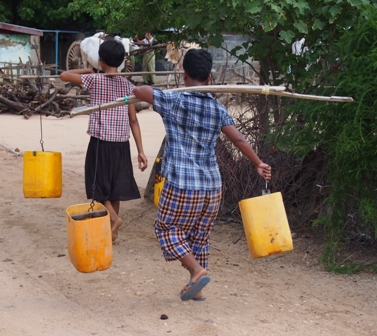 West Pwasaw village water carriers[/caption]
Previous visitors donated enough money to build a communal well. Water is collected each day and transported to villagers by manpower or bullock cart. Nine of us donated enough money to keep the village well pump operating for a further ten days.
[caption id="attachment_3119" align="alignnone" width="448"]
West Pwasaw village water carriers[/caption]
Previous visitors donated enough money to build a communal well. Water is collected each day and transported to villagers by manpower or bullock cart. Nine of us donated enough money to keep the village well pump operating for a further ten days.
[caption id="attachment_3119" align="alignnone" width="448"]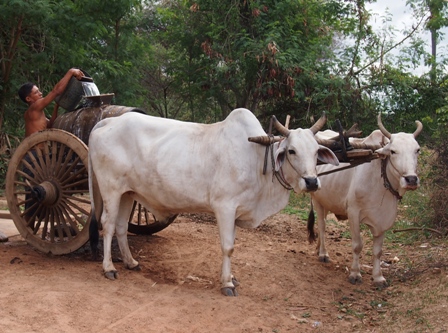 West Pwasaw village bullock cart hauling water[/caption]
Karma is a concept all travellers are wise to recognise. As the saying goes, ‘What comes around, goes around...’
[caption id="attachment_3136" align="alignnone" width="448"]
West Pwasaw village bullock cart hauling water[/caption]
Karma is a concept all travellers are wise to recognise. As the saying goes, ‘What comes around, goes around...’
[caption id="attachment_3136" align="alignnone" width="448"]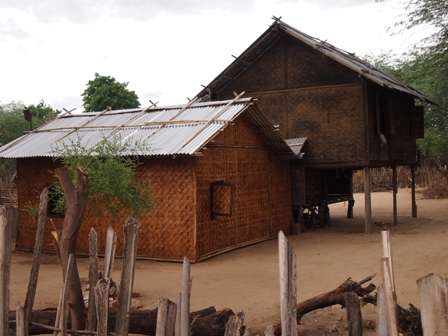 West Pwasaw village houses[/caption]
I found this village so entrancing I wanted to stay there indefinitely, learning the language, sharing local gossip all the while forgetting life's endless supply of conundrums.
Was I experiencing a common travel fantasy? Certainly I did.
Blame it on the mystique of Pagan, where the time continuum seems magically altered.
[caption id="attachment_3129" align="alignnone" width="336"]
West Pwasaw village houses[/caption]
I found this village so entrancing I wanted to stay there indefinitely, learning the language, sharing local gossip all the while forgetting life's endless supply of conundrums.
Was I experiencing a common travel fantasy? Certainly I did.
Blame it on the mystique of Pagan, where the time continuum seems magically altered.
[caption id="attachment_3129" align="alignnone" width="336"]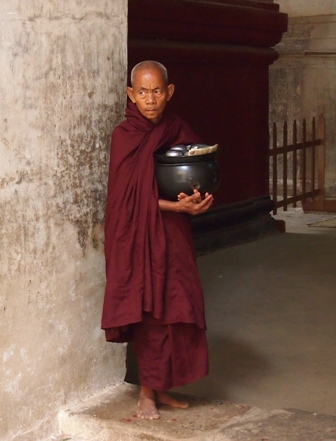 Monk at Manuha Temple Pagan[/caption]
Small ship expedition cruising is to a naked hungry traveller what Italian white truffles are to... well, a naked hungry traveller. They appeal in equal measures.
[caption id="attachment_3116" align="alignnone" width="448"]
Monk at Manuha Temple Pagan[/caption]
Small ship expedition cruising is to a naked hungry traveller what Italian white truffles are to... well, a naked hungry traveller. They appeal in equal measures.
[caption id="attachment_3116" align="alignnone" width="448"]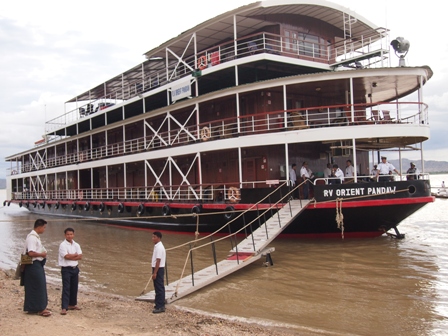 RV Orient Pandaw moored at Pagan[/caption]
The RV Orient Pandaw’s 20 cabins are occupied by merely 27 passengers on this season’s first cruise up the Irrawaddy River. 46 crew members are in attendance. Not that so many are needed for the requirements of so few passengers. Apparently a third are newbies, apprentices learning the boat's ropes and they’re excited as the passengers to be on board.
[caption id="attachment_3122" align="alignnone" width="336"]
RV Orient Pandaw moored at Pagan[/caption]
The RV Orient Pandaw’s 20 cabins are occupied by merely 27 passengers on this season’s first cruise up the Irrawaddy River. 46 crew members are in attendance. Not that so many are needed for the requirements of so few passengers. Apparently a third are newbies, apprentices learning the boat's ropes and they’re excited as the passengers to be on board.
[caption id="attachment_3122" align="alignnone" width="336"] Best bartenders on board RV Orient Pandaw[/caption]
We’re a happy bunch of travellers on a slow boat up Myanmar’s lifeline, the river of many footsteps, constant giver of all things from famine and plenty to tragedy and joy.
[caption id="attachment_3117" align="alignnone" width="423"]
Best bartenders on board RV Orient Pandaw[/caption]
We’re a happy bunch of travellers on a slow boat up Myanmar’s lifeline, the river of many footsteps, constant giver of all things from famine and plenty to tragedy and joy.
[caption id="attachment_3117" align="alignnone" width="423"]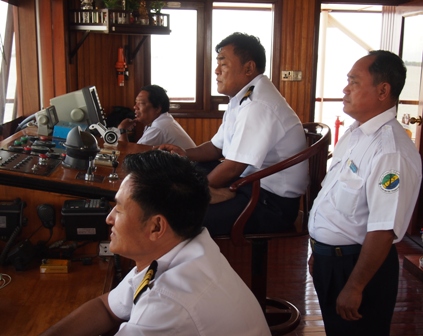 Bridge team on RV Orient Pandaw[/caption]
Stopping in Pakokku for a half day’s wander in this large market town halfway between Pagan and Mandalay allows a brief glimpse into life off the tourist trail.
[caption id="attachment_3123" align="alignnone" width="448"]
Bridge team on RV Orient Pandaw[/caption]
Stopping in Pakokku for a half day’s wander in this large market town halfway between Pagan and Mandalay allows a brief glimpse into life off the tourist trail.
[caption id="attachment_3123" align="alignnone" width="448"]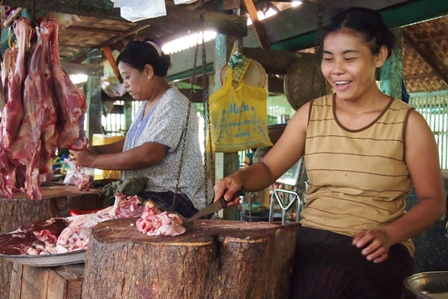 Pakokku market butchers[/caption]
There are no significant tourist sites in this ramshackle place and it’s really all the better for it. People wave almost in unison; as if they’re expecting Potemkin himself to approve their public works and maintenance program. The entire experience becomes utterly captivating.
I got caught up and lost track of time in the market, browsing the variety of foodstuffs, tools, kitchen implements, textiles, clothing and craft works. While chatting to one man whose facility with the English language reminded me of the formality used by George Orwell in his first book, 'Burmese Days', (a few elderly Myanmar people I met spoke English as if it was taught by a 1950s BBC news announcer) nearly married me off to three separate stall holders he claimed were his granddaughters. For a brief moment I was the centre of attention in a small world. If such moments as these are what perfect travel experiences are all about, I’m happy to play the part of available rootstock. The laughter and sharing are what matters most.
[caption id="attachment_3124" align="alignnone" width="448"]
Pakokku market butchers[/caption]
There are no significant tourist sites in this ramshackle place and it’s really all the better for it. People wave almost in unison; as if they’re expecting Potemkin himself to approve their public works and maintenance program. The entire experience becomes utterly captivating.
I got caught up and lost track of time in the market, browsing the variety of foodstuffs, tools, kitchen implements, textiles, clothing and craft works. While chatting to one man whose facility with the English language reminded me of the formality used by George Orwell in his first book, 'Burmese Days', (a few elderly Myanmar people I met spoke English as if it was taught by a 1950s BBC news announcer) nearly married me off to three separate stall holders he claimed were his granddaughters. For a brief moment I was the centre of attention in a small world. If such moments as these are what perfect travel experiences are all about, I’m happy to play the part of available rootstock. The laughter and sharing are what matters most.
[caption id="attachment_3124" align="alignnone" width="448"] Competing 'brides' at Pakokku market[/caption]
The following day we moored at Yandabo village, a speck of a place in the middle of nowhere on the eastern bank of the Irrawaddy.
[caption id="attachment_3127" align="alignnone" width="356"]
Competing 'brides' at Pakokku market[/caption]
The following day we moored at Yandabo village, a speck of a place in the middle of nowhere on the eastern bank of the Irrawaddy.
[caption id="attachment_3127" align="alignnone" width="356"]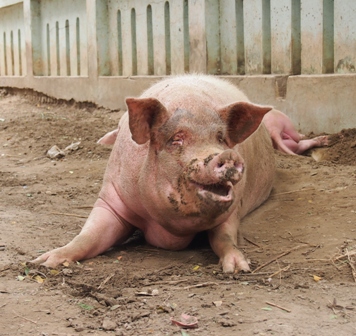 Happy sow in Yandabo main street[/caption]
Strong yet malleable clay is found in these parts and the families comprising the village’s entire population are apparently involved in terra cotta pot making.
[caption id="attachment_3139" align="alignnone" width="375"]
Happy sow in Yandabo main street[/caption]
Strong yet malleable clay is found in these parts and the families comprising the village’s entire population are apparently involved in terra cotta pot making.
[caption id="attachment_3139" align="alignnone" width="375"]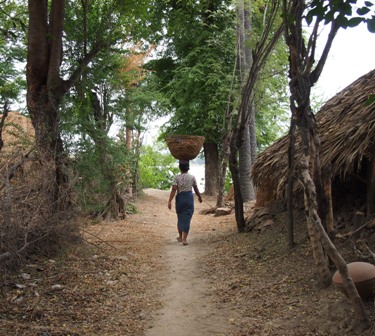 Woman walking in Yandabo street[/caption]
It’s a big business and the townspeople make a decent living from their hard work.
[caption id="attachment_3125" align="alignnone" width="336"]
Woman walking in Yandabo street[/caption]
It’s a big business and the townspeople make a decent living from their hard work.
[caption id="attachment_3125" align="alignnone" width="336"]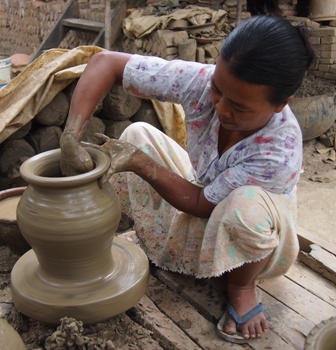 Yandabo potter creating a pot each three minutes[/caption]
[caption id="attachment_3189" align="alignnone" width="404"]
Yandabo potter creating a pot each three minutes[/caption]
[caption id="attachment_3189" align="alignnone" width="404"]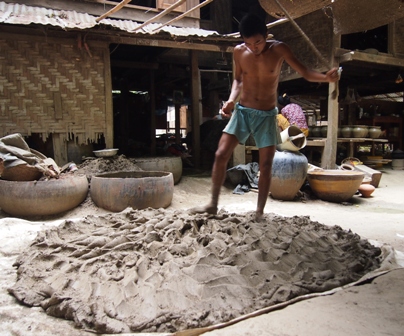 Preparing clay at Yandabo village[/caption]
All done by hand, the work is not about dabbling with figurines. Instead various jobs become specialties. Women tend to throw the best pots. I watched one expert potter create four in twelve minutes precisely. She made one pot each three minutes, her assistant, perhaps her husband, I never found out, operated the pottery wheel by foot, his constant backwards forwards movement on the foot pedal was rhythmic. He appeared napping while working the treadle. Ms. Potts grabbed a whopping great handful of clay from a nearby mound, threw it on the wheel and within three minutes she sliced the perfectly formed pot free with a bit of wire strung between two sticks and gently moved it to a growing stack of exactly the same sized and shaped pots, ready to be slid into the kiln, fired and then sold up and down the river.
[caption id="attachment_3126" align="alignnone" width="448"]
Preparing clay at Yandabo village[/caption]
All done by hand, the work is not about dabbling with figurines. Instead various jobs become specialties. Women tend to throw the best pots. I watched one expert potter create four in twelve minutes precisely. She made one pot each three minutes, her assistant, perhaps her husband, I never found out, operated the pottery wheel by foot, his constant backwards forwards movement on the foot pedal was rhythmic. He appeared napping while working the treadle. Ms. Potts grabbed a whopping great handful of clay from a nearby mound, threw it on the wheel and within three minutes she sliced the perfectly formed pot free with a bit of wire strung between two sticks and gently moved it to a growing stack of exactly the same sized and shaped pots, ready to be slid into the kiln, fired and then sold up and down the river.
[caption id="attachment_3126" align="alignnone" width="448"]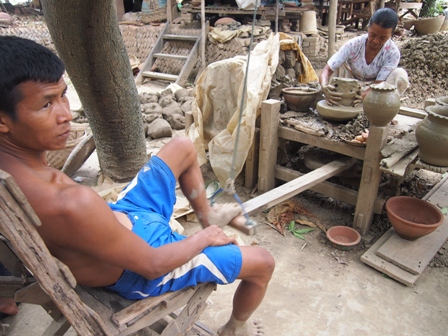 Yandabo pottery making[/caption]
The Pandaw Foundation supports an elementary school in Yandabo, which we were invited to visit.
The students sang songs in English for us while a quartet of fellow guests sang popular kids songs in English in turn. I’ll never hear ‘The Wheels on the Bus Go Round and Round’ in the same fashion ever again, nor do I want to but I was captivated by those kids.
[caption id="attachment_3128" align="alignnone" width="448"]
Yandabo pottery making[/caption]
The Pandaw Foundation supports an elementary school in Yandabo, which we were invited to visit.
The students sang songs in English for us while a quartet of fellow guests sang popular kids songs in English in turn. I’ll never hear ‘The Wheels on the Bus Go Round and Round’ in the same fashion ever again, nor do I want to but I was captivated by those kids.
[caption id="attachment_3128" align="alignnone" width="448"] Yandabo school kids[/caption]
Visitors to Myanmar are encouraged not to give money or sweets to kids. It's important for them to avoid associating foreign guests with free money, like walking ATMs ready to dispense treats without so much as a ‘You give money mister’ and no thanks as a reward.
The good people of RV Pandaw Cruises have developed a fruitful, mutually beneficial relationship with this particular school. The school receives badly needed funds while passengers are allowed an opportunity to engage with local kids without any perceived social stigmas attached.
[caption id="attachment_3130" align="alignnone" width="407"]
Yandabo school kids[/caption]
Visitors to Myanmar are encouraged not to give money or sweets to kids. It's important for them to avoid associating foreign guests with free money, like walking ATMs ready to dispense treats without so much as a ‘You give money mister’ and no thanks as a reward.
The good people of RV Pandaw Cruises have developed a fruitful, mutually beneficial relationship with this particular school. The school receives badly needed funds while passengers are allowed an opportunity to engage with local kids without any perceived social stigmas attached.
[caption id="attachment_3130" align="alignnone" width="407"]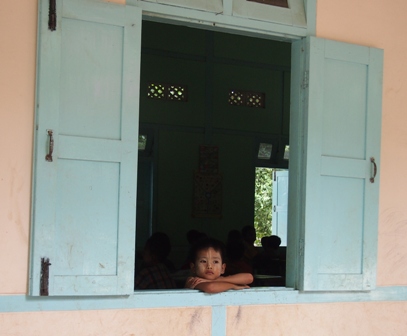 Yandabo kid in school window[/caption]
We all contributed to a significant donation that helps the school buy books and uniforms for its students. The interaction was all honest, above board and transparent. While in Yangon the previous week, I was informed that some schools accept donations while not necessarily forwarding the cash to benefit the students themselves. Instead the money is siphoned off by the principal or school managers. In a country where corruption is as prevalent as rain during the monsoon, it’s best to verify where your money goes before donating it.
Back on board the RV Orient Pandaw, the boat continued its stately progress up the muddy Irrawaddy.
[caption id="attachment_3131" align="alignnone" width="448"]
Yandabo kid in school window[/caption]
We all contributed to a significant donation that helps the school buy books and uniforms for its students. The interaction was all honest, above board and transparent. While in Yangon the previous week, I was informed that some schools accept donations while not necessarily forwarding the cash to benefit the students themselves. Instead the money is siphoned off by the principal or school managers. In a country where corruption is as prevalent as rain during the monsoon, it’s best to verify where your money goes before donating it.
Back on board the RV Orient Pandaw, the boat continued its stately progress up the muddy Irrawaddy.
[caption id="attachment_3131" align="alignnone" width="448"]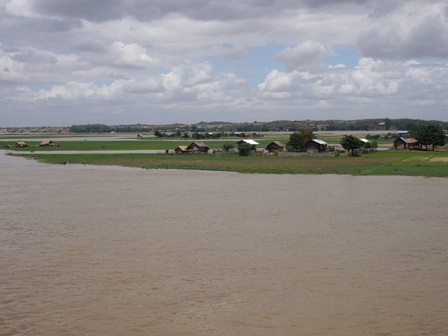 Irrawaddy River paddy fields[/caption]
Each cabin faced outwards, rattan chairs positioned directly outside the cabin door. The top deck bar and veranda was by far the most popular hang-out spot. By late afternoon, cocktail hour beckoned guests like bears to a honey pot. Who could resist a gin & tonic or Mojito made with local rum? Or an icy cold Myanmar beer?
[caption id="attachment_3132" align="alignnone" width="353"]
Irrawaddy River paddy fields[/caption]
Each cabin faced outwards, rattan chairs positioned directly outside the cabin door. The top deck bar and veranda was by far the most popular hang-out spot. By late afternoon, cocktail hour beckoned guests like bears to a honey pot. Who could resist a gin & tonic or Mojito made with local rum? Or an icy cold Myanmar beer?
[caption id="attachment_3132" align="alignnone" width="353"]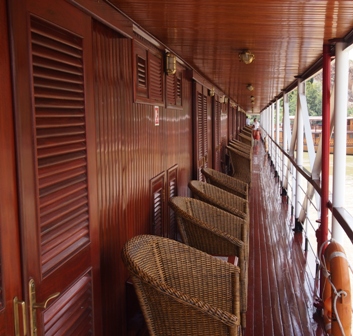 RV Orient Pandaw cabins[/caption]
The view from high atop the RV Orient Pandaw upper deck was endlessly mesmerising. Occasionally the Irrawaddy was seemingly all at once busy with heavy barges, crowded passenger ferries, jumbles of tied logs floating downstream destined for dismemberment at the timber factory or charcoal plant, small fishing boats, nets strung fore to aft or houseboats filled with local families whose lives are bound to the river’s flow. Rafts of floating vegetation swept by looking like small green islands constantly on the move. Mostly we were alone in a vast river, in places several kilometres wide, fishing birds soaring overhead our only company.
As the river’s depth changes with the season, varying up to fifteen metres depending on the monsoon rains, the shipping channels alter course constantly. Only experienced captains run larger ships up and down the Irrawaddy while local pilots were ferried on board to help navigate particularly challenging flows.
Occasionally groups of temples rose up from steep banks gleaming in bright sunlight. Wealthy temples invariably sported gold at the tips of their stupas and lit up like burnished stars when the rays struck the spires.
[caption id="attachment_3135" align="alignnone" width="365"]
RV Orient Pandaw cabins[/caption]
The view from high atop the RV Orient Pandaw upper deck was endlessly mesmerising. Occasionally the Irrawaddy was seemingly all at once busy with heavy barges, crowded passenger ferries, jumbles of tied logs floating downstream destined for dismemberment at the timber factory or charcoal plant, small fishing boats, nets strung fore to aft or houseboats filled with local families whose lives are bound to the river’s flow. Rafts of floating vegetation swept by looking like small green islands constantly on the move. Mostly we were alone in a vast river, in places several kilometres wide, fishing birds soaring overhead our only company.
As the river’s depth changes with the season, varying up to fifteen metres depending on the monsoon rains, the shipping channels alter course constantly. Only experienced captains run larger ships up and down the Irrawaddy while local pilots were ferried on board to help navigate particularly challenging flows.
Occasionally groups of temples rose up from steep banks gleaming in bright sunlight. Wealthy temples invariably sported gold at the tips of their stupas and lit up like burnished stars when the rays struck the spires.
[caption id="attachment_3135" align="alignnone" width="365"]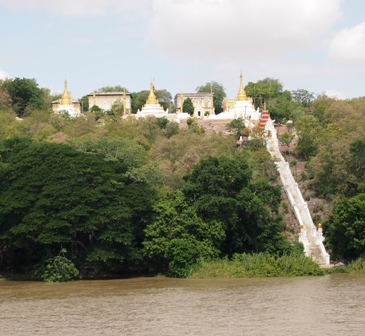 Unknown temple seen from Irrawaddy River[/caption]
[caption id="attachment_3202" align="alignnone" width="415"]
Unknown temple seen from Irrawaddy River[/caption]
[caption id="attachment_3202" align="alignnone" width="415"]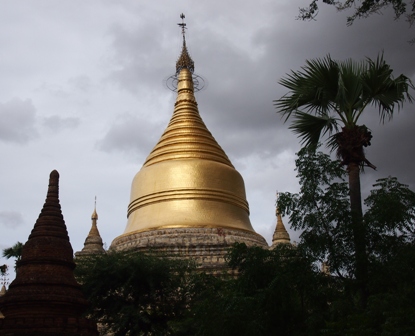 Sunlight on pagoda[/caption]
Mostly however, the scenery was a constant moving feast of neatly tended pastures, tiny villages in the near distance or forested mountains hanging in the far distance.
The crew were a microcosm of Myanmar. Several had worked at resorts in Thailand where their cocktail making skills were polished. Others had never been outside Myanmar.
[caption id="attachment_3204" align="alignnone" width="310"]
Sunlight on pagoda[/caption]
Mostly however, the scenery was a constant moving feast of neatly tended pastures, tiny villages in the near distance or forested mountains hanging in the far distance.
The crew were a microcosm of Myanmar. Several had worked at resorts in Thailand where their cocktail making skills were polished. Others had never been outside Myanmar.
[caption id="attachment_3204" align="alignnone" width="310"]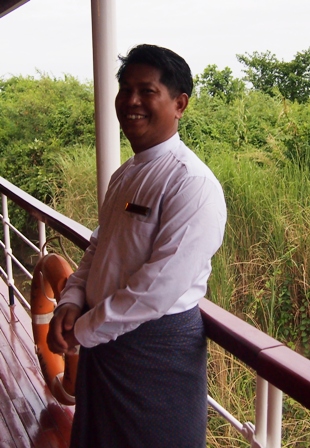 RV Orient Pandaw purser Ko Maung Naing[/caption]
What they all had in common was completely and transparently natural friendliness. Not a skerrick of forced bonhomie, not a touch of ersatz ingratiation. Everyone did their jobs well, always happy to do it.
[caption id="attachment_3203" align="alignnone" width="286"]
RV Orient Pandaw purser Ko Maung Naing[/caption]
What they all had in common was completely and transparently natural friendliness. Not a skerrick of forced bonhomie, not a touch of ersatz ingratiation. Everyone did their jobs well, always happy to do it.
[caption id="attachment_3203" align="alignnone" width="286"]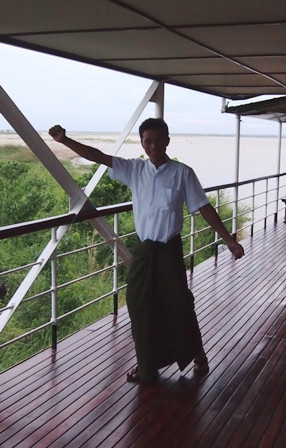 Crew member striking a pose[/caption]
Given the remote locations where supplies weren't readily available, I was genuinely surprised at how tasty the food was. One of the chefs clearly understood how to create feathery light pastries; a small miracle considering how hot it was outside and how doubly hot it must have been in the galley where butter would melt instantaneously.
This was the only cruise I’ve ever been on where I didn’t feel the desire to dine off the boat at least half the time. Had I wanted to, it would have been difficult as restaurants in rural Myanmar are non-existent. Lucky me the food on board was always fresh, interesting and well prepared, a mixture of Myanmar, Thai and European dishes comprised the menus.
Away from Pagan and Mandalay, we moored overnight in completely isolated places. Tied to convenient trees standing sentinel in ploughed fields, people appeared from nowhere to observe the curious sight of a big boat being tied up near their village and then disappeared into thin air. No roads could be seen from our mooring. No vehicular traffic noise, only the barking of dogs and the occasional lowing of a water buffalo for nocturnal auditory company.
[caption id="attachment_3140" align="alignnone" width="448"]
Crew member striking a pose[/caption]
Given the remote locations where supplies weren't readily available, I was genuinely surprised at how tasty the food was. One of the chefs clearly understood how to create feathery light pastries; a small miracle considering how hot it was outside and how doubly hot it must have been in the galley where butter would melt instantaneously.
This was the only cruise I’ve ever been on where I didn’t feel the desire to dine off the boat at least half the time. Had I wanted to, it would have been difficult as restaurants in rural Myanmar are non-existent. Lucky me the food on board was always fresh, interesting and well prepared, a mixture of Myanmar, Thai and European dishes comprised the menus.
Away from Pagan and Mandalay, we moored overnight in completely isolated places. Tied to convenient trees standing sentinel in ploughed fields, people appeared from nowhere to observe the curious sight of a big boat being tied up near their village and then disappeared into thin air. No roads could be seen from our mooring. No vehicular traffic noise, only the barking of dogs and the occasional lowing of a water buffalo for nocturnal auditory company.
[caption id="attachment_3140" align="alignnone" width="448"]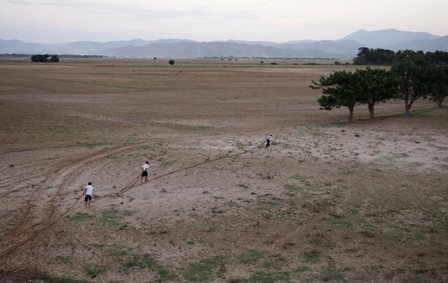 Crew setting mooring ropes to nearby trees[/caption]
On two separate evenings we were treated to a puppet show and a dance performance. Myanmar artists are renowned for their puppetry skills. The marionette show was a delight.
[caption id="attachment_3141" align="alignnone" width="448"]
Crew setting mooring ropes to nearby trees[/caption]
On two separate evenings we were treated to a puppet show and a dance performance. Myanmar artists are renowned for their puppetry skills. The marionette show was a delight.
[caption id="attachment_3141" align="alignnone" width="448"]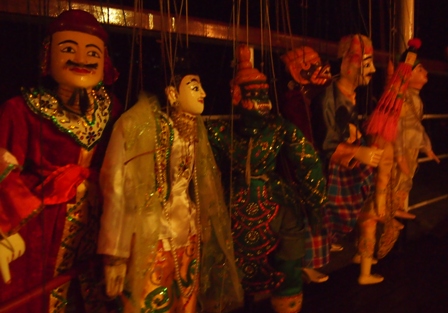 Puppets on board RV Orient Pandaw after show[/caption]
The dance performance was also a lot of fun while affording us greater insight into Myanmar traditions linked to early Hinduism.
[caption id="attachment_3142" align="alignnone" width="412"]
Puppets on board RV Orient Pandaw after show[/caption]
The dance performance was also a lot of fun while affording us greater insight into Myanmar traditions linked to early Hinduism.
[caption id="attachment_3142" align="alignnone" width="412"]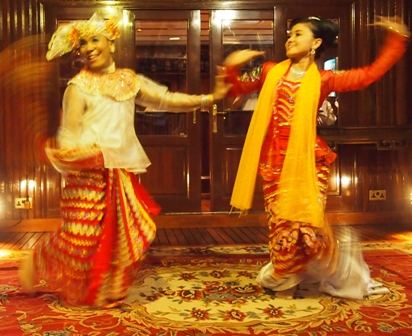 Mandalay dancers during on board performance[/caption]
Around Mandalay is Myanmar’s centre of history and tourist sights.
[caption id="attachment_3144" align="alignnone" width="299"]
Mandalay dancers during on board performance[/caption]
Around Mandalay is Myanmar’s centre of history and tourist sights.
[caption id="attachment_3144" align="alignnone" width="299"]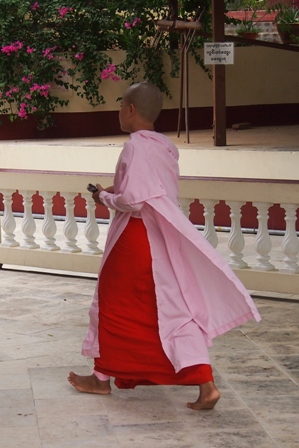 Young nun at Sagaing[/caption]
We spent a half day at Sagaing where over 5,000 monks and nuns live in Buddhist harmony. As the country’s premier meditation destination, it’s a quiet place. The views overlooking the river imbue a natural hush.
[caption id="attachment_3143" align="alignnone" width="382"]
Young nun at Sagaing[/caption]
We spent a half day at Sagaing where over 5,000 monks and nuns live in Buddhist harmony. As the country’s premier meditation destination, it’s a quiet place. The views overlooking the river imbue a natural hush.
[caption id="attachment_3143" align="alignnone" width="382"]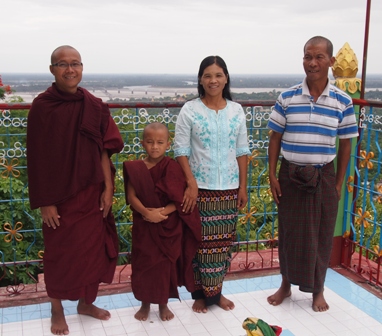 Family with young novice at Sagaing[/caption]
Across the river from Sagaing is Ava or Amarapura, a capital of old Myanmar for over four hundred years. It held sway over Myanmar after Pagan's end and before King Mindon founded Mandalay in 1857.
Ava (Innwa) is an island filled with past reminders, quiet as a ghost town, which it is not despite the local superstition. Accommodation options on the island are sparse so it’s become a day tripper’s destination from neighbouring Mandalay.
[caption id="attachment_3190" align="alignnone" width="448"]
Family with young novice at Sagaing[/caption]
Across the river from Sagaing is Ava or Amarapura, a capital of old Myanmar for over four hundred years. It held sway over Myanmar after Pagan's end and before King Mindon founded Mandalay in 1857.
Ava (Innwa) is an island filled with past reminders, quiet as a ghost town, which it is not despite the local superstition. Accommodation options on the island are sparse so it’s become a day tripper’s destination from neighbouring Mandalay.
[caption id="attachment_3190" align="alignnone" width="448"] Ava temple[/caption]
[caption id="attachment_3191" align="alignnone" width="448"]
Ava temple[/caption]
[caption id="attachment_3191" align="alignnone" width="448"]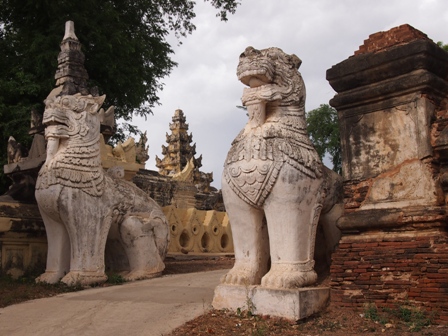 Ava city gates[/caption]
Horse drawn carts meet passengers at the single ferry wharf for a few hours gentle clop-clopping around the main temples and remnant city walls. Taking in Ava’s many historic sites provides a lovely way to spend an afternoon.
[caption id="attachment_3145" align="alignnone" width="336"]
Ava city gates[/caption]
Horse drawn carts meet passengers at the single ferry wharf for a few hours gentle clop-clopping around the main temples and remnant city walls. Taking in Ava’s many historic sites provides a lovely way to spend an afternoon.
[caption id="attachment_3145" align="alignnone" width="336"] Horse cart at Ava Amarapura[/caption]
[caption id="attachment_3146" align="alignnone" width="448"]
Horse cart at Ava Amarapura[/caption]
[caption id="attachment_3146" align="alignnone" width="448"]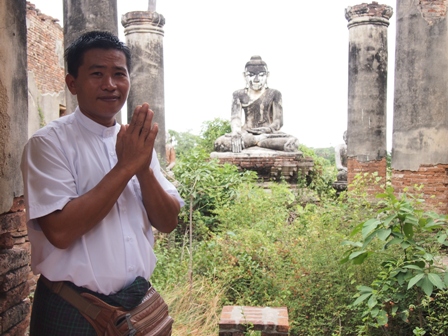 RV Orient Pandaw crew member at Ava temple ruin[/caption]
Also near old Ava is the famous U Bein footbridge. Touted as the world’s longest foot bridge made entirely from teak wood (1.2 kilometres) , it’s now something of a meeting place for local lovers looking for a tryst.
[caption id="attachment_3147" align="alignnone" width="448"]
RV Orient Pandaw crew member at Ava temple ruin[/caption]
Also near old Ava is the famous U Bein footbridge. Touted as the world’s longest foot bridge made entirely from teak wood (1.2 kilometres) , it’s now something of a meeting place for local lovers looking for a tryst.
[caption id="attachment_3147" align="alignnone" width="448"] Boat and U Bein bridge[/caption]
The Taungthaman Lake over which the bridge extends is shallow and warm. Small boats are paddled by Mandalay’s version of gondoliers (Hnge in Myanmar), a diversion of extreme pleasure, albeit entirely tourist-y. Paddling amongst the fisher folk and smitten lovers as sunset lowers over the lake is delightful, if innocently voyeuristic.
[caption id="attachment_3148" align="alignnone" width="418"]
Boat and U Bein bridge[/caption]
The Taungthaman Lake over which the bridge extends is shallow and warm. Small boats are paddled by Mandalay’s version of gondoliers (Hnge in Myanmar), a diversion of extreme pleasure, albeit entirely tourist-y. Paddling amongst the fisher folk and smitten lovers as sunset lowers over the lake is delightful, if innocently voyeuristic.
[caption id="attachment_3148" align="alignnone" width="418"] Boats at U Bein bridge lake[/caption]
Upriver one hundred kilometres north the Pandaw stopped at another terra cotta village, Nwe Nyein (Kyauk Myoung). Here the pots are giant sized and the manufacturing is, as in Yandabo, all done by hand and clearly very labour intensive.
[caption id="attachment_3149" align="alignnone" width="448"]
Boats at U Bein bridge lake[/caption]
Upriver one hundred kilometres north the Pandaw stopped at another terra cotta village, Nwe Nyein (Kyauk Myoung). Here the pots are giant sized and the manufacturing is, as in Yandabo, all done by hand and clearly very labour intensive.
[caption id="attachment_3149" align="alignnone" width="448"] Nwe Nyein pots waiting for shipment[/caption]
Pots strewn along the river await shipment. Though the town appears sleepy during late monsoon heat, local inhabitants work constantly forming the pots that are famous throughout Myanmar.
[caption id="attachment_3150" align="alignnone" width="448"]
Nwe Nyein pots waiting for shipment[/caption]
Pots strewn along the river await shipment. Though the town appears sleepy during late monsoon heat, local inhabitants work constantly forming the pots that are famous throughout Myanmar.
[caption id="attachment_3150" align="alignnone" width="448"] Nwe Nyein village potter[/caption]
I’ve seen copies of these pots in Australian garden centres; they make fine outdoor plant holders.
[caption id="attachment_3151" align="alignnone" width="432"]
Nwe Nyein village potter[/caption]
I’ve seen copies of these pots in Australian garden centres; they make fine outdoor plant holders.
[caption id="attachment_3151" align="alignnone" width="432"] Potters at Nwe Nyein village[/caption]
[caption id="attachment_3152" align="alignnone" width="448"]
Potters at Nwe Nyein village[/caption]
[caption id="attachment_3152" align="alignnone" width="448"] Nwe Nyein village potter's child[/caption]
[caption id="attachment_3153" align="alignnone" width="336"]
Nwe Nyein village potter's child[/caption]
[caption id="attachment_3153" align="alignnone" width="336"]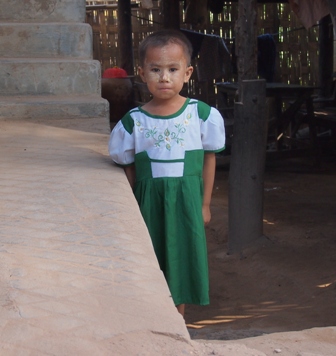 Nwe Nyein village child in her school uniform[/caption]
[caption id="attachment_3154" align="alignnone" width="336"]
Nwe Nyein village child in her school uniform[/caption]
[caption id="attachment_3154" align="alignnone" width="336"] Children laughing at Nwe Nyein village[/caption]
[caption id="attachment_3155" align="alignnone" width="448"]
Children laughing at Nwe Nyein village[/caption]
[caption id="attachment_3155" align="alignnone" width="448"]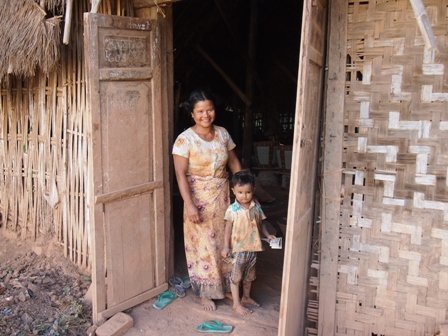 Nwe Nyein village mother and child[/caption]
Returning to Mandalay after a day travelling up and down the river to Nwe Nyein, we stop at Mingun, forever remembered as the place where the ‘greatest pile of bricks’ can be found. When King Bodawphaya began construction of this enormous temple in 1790, it would have been the largest in the world had he not fallen ill and died. An earthquake in 1838 split the temple in two and rendered it forever unfinished.
[caption id="attachment_3156" align="alignnone" width="448"]
Nwe Nyein village mother and child[/caption]
Returning to Mandalay after a day travelling up and down the river to Nwe Nyein, we stop at Mingun, forever remembered as the place where the ‘greatest pile of bricks’ can be found. When King Bodawphaya began construction of this enormous temple in 1790, it would have been the largest in the world had he not fallen ill and died. An earthquake in 1838 split the temple in two and rendered it forever unfinished.
[caption id="attachment_3156" align="alignnone" width="448"]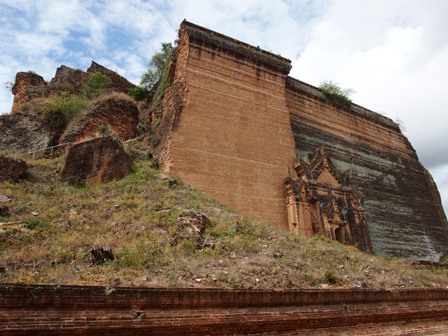 Mingun's famous 'pile of bricks' temple[/caption]
[caption id="attachment_3157" align="alignnone" width="422"]
Mingun's famous 'pile of bricks' temple[/caption]
[caption id="attachment_3157" align="alignnone" width="422"]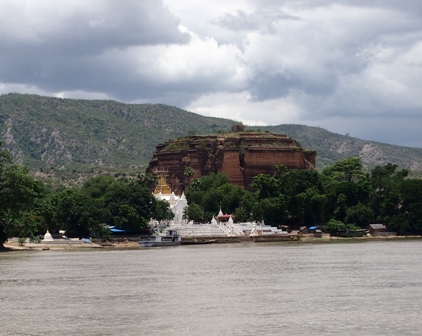 Mingun temple seen from river[/caption]
[caption id="attachment_3207" align="alignnone" width="377"]
Mingun temple seen from river[/caption]
[caption id="attachment_3207" align="alignnone" width="377"] Boats moored at Mingun[/caption]
Nearby is the also very large Myatheintan Pagoda, described as a Myanmar version of the Taj Mahal as it was built in 1816 by Crown Prince Ba Gyi Daw to commemorate his favourite princess, Sinbyume.
[caption id="attachment_3158" align="alignnone" width="448"]
Boats moored at Mingun[/caption]
Nearby is the also very large Myatheintan Pagoda, described as a Myanmar version of the Taj Mahal as it was built in 1816 by Crown Prince Ba Gyi Daw to commemorate his favourite princess, Sinbyume.
[caption id="attachment_3158" align="alignnone" width="448"] Myatheintan Pagoda[/caption]
Mingun’s single main street paralleling the riverbank has developed without formal intention into a short row of private art galleries. Good prices are found here, a place in which to buy original Myanmar artwork that costs much more in Yangon or Mandalay. Remember that antiques cannot be taken out of Myanmar and that not all artworks are unique. That being said, judicious shopping may discover an artist on the path to fame and fortune. There’s real talent to be seen in a few of Mingun’s local artists.
[caption id="attachment_3159" align="alignnone" width="336"]
Myatheintan Pagoda[/caption]
Mingun’s single main street paralleling the riverbank has developed without formal intention into a short row of private art galleries. Good prices are found here, a place in which to buy original Myanmar artwork that costs much more in Yangon or Mandalay. Remember that antiques cannot be taken out of Myanmar and that not all artworks are unique. That being said, judicious shopping may discover an artist on the path to fame and fortune. There’s real talent to be seen in a few of Mingun’s local artists.
[caption id="attachment_3159" align="alignnone" width="336"] Future artists of Mingun?[/caption]
The cruise ended in Mandalay, a city that conjures up exoticism to many people who’ve had their own private dreams of Kublai Khan. This was Myanmar’s last royal capital city, famous for never having its name changed by colonial powers, famous for witnessing the end of an era as Myanmar was overrun by Japanese forces (whose airplanes bombed the old walled city into oblivion). When the republic was declared as separate from British rule in 1948 under the guidance of the national hero, Aung San, father of another national heroine, Aung San Suu Kyi, the capital of new Myanmar became Yangon until it was moved again to Naypyidaw in 2005.
[caption id="attachment_3160" align="alignnone" width="448"]
Future artists of Mingun?[/caption]
The cruise ended in Mandalay, a city that conjures up exoticism to many people who’ve had their own private dreams of Kublai Khan. This was Myanmar’s last royal capital city, famous for never having its name changed by colonial powers, famous for witnessing the end of an era as Myanmar was overrun by Japanese forces (whose airplanes bombed the old walled city into oblivion). When the republic was declared as separate from British rule in 1948 under the guidance of the national hero, Aung San, father of another national heroine, Aung San Suu Kyi, the capital of new Myanmar became Yangon until it was moved again to Naypyidaw in 2005.
[caption id="attachment_3160" align="alignnone" width="448"]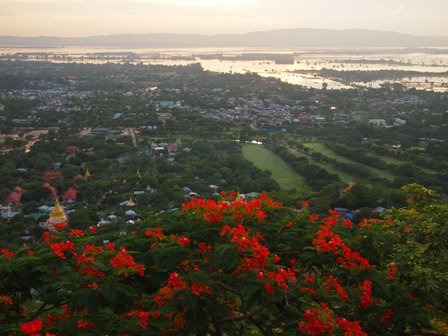 View over Mandalay from atop Mandalay Hill[/caption]
The country’s second largest city, it’s now famous as a bastion of conservative Buddhism, the gateway to the north and its relatively easy access to the dubious riches of modern China, in essence awaiting interchangeable exploitation.
As a crafts-maker city, it is unrivalled. Goldsmiths, silversmiths, stoneworkers, marble sculptors, wood carvers, basket weavers, cloth weavers and small scale food producers are everywhere. Lacquer ware is also a Myanmar specialty. The best lacquer ware artisan shops are found in Pagan and Mandalay.
[caption id="attachment_3161" align="alignnone" width="336"]
View over Mandalay from atop Mandalay Hill[/caption]
The country’s second largest city, it’s now famous as a bastion of conservative Buddhism, the gateway to the north and its relatively easy access to the dubious riches of modern China, in essence awaiting interchangeable exploitation.
As a crafts-maker city, it is unrivalled. Goldsmiths, silversmiths, stoneworkers, marble sculptors, wood carvers, basket weavers, cloth weavers and small scale food producers are everywhere. Lacquer ware is also a Myanmar specialty. The best lacquer ware artisan shops are found in Pagan and Mandalay.
[caption id="attachment_3161" align="alignnone" width="336"]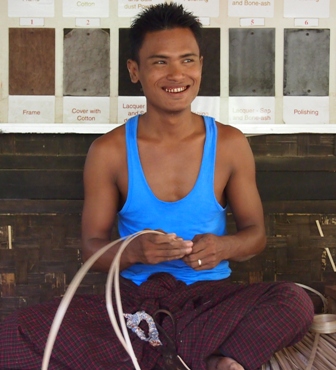 Preparing bamboo for lacquer ware[/caption]
[caption id="attachment_3162" align="alignnone" width="448"]
Preparing bamboo for lacquer ware[/caption]
[caption id="attachment_3162" align="alignnone" width="448"] Etching lacquer ware[/caption]
[caption id="attachment_3163" align="alignnone" width="393"]
Etching lacquer ware[/caption]
[caption id="attachment_3163" align="alignnone" width="393"]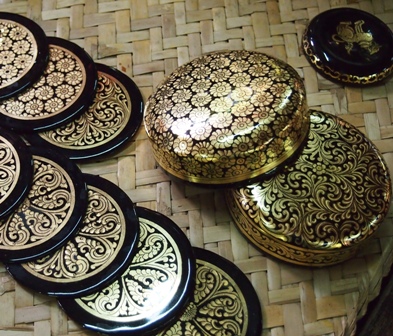 Lacquer ware in Myanmar[/caption]
[caption id="attachment_3164" align="alignnone" width="442"]
Lacquer ware in Myanmar[/caption]
[caption id="attachment_3164" align="alignnone" width="442"] Mandalay silversmiths[/caption]
The country’s second most important Buddhist shrine (after Shwe Dagon in Yangon) is the very impressive Mahamuni Pagoda located in central Mandalay. It’s a very holy place where all local devotees visit regularly.
[caption id="attachment_3165" align="alignnone" width="448"]
Mandalay silversmiths[/caption]
The country’s second most important Buddhist shrine (after Shwe Dagon in Yangon) is the very impressive Mahamuni Pagoda located in central Mandalay. It’s a very holy place where all local devotees visit regularly.
[caption id="attachment_3165" align="alignnone" width="448"] Mahamuni Pagoda[/caption]
The Buddha image in the main pagoda situated in the middle of the sprawling temple precinct is growing larger as I write this. One way to reach Nirvana via the faster road greased by lustre paid in cash is by rubbing a sheet of gold leaf on to the Buddha image. Only men are allowed this special privilege. (Sexism being customary across all religions is also a universal misfortune.) So much gold leaf is applied to this Buddha image that he is actually growing bigger. In my eyes, he looks like a fat bloke wrapped in a gold bubble suit. Sort of like a giant gold Michelin man. Pardon any sacrilegious inference here but this kind of completely wasteful ‘idol worship’ unnerves me.
[caption id="attachment_3166" align="alignnone" width="366"]
Mahamuni Pagoda[/caption]
The Buddha image in the main pagoda situated in the middle of the sprawling temple precinct is growing larger as I write this. One way to reach Nirvana via the faster road greased by lustre paid in cash is by rubbing a sheet of gold leaf on to the Buddha image. Only men are allowed this special privilege. (Sexism being customary across all religions is also a universal misfortune.) So much gold leaf is applied to this Buddha image that he is actually growing bigger. In my eyes, he looks like a fat bloke wrapped in a gold bubble suit. Sort of like a giant gold Michelin man. Pardon any sacrilegious inference here but this kind of completely wasteful ‘idol worship’ unnerves me.
[caption id="attachment_3166" align="alignnone" width="366"] Mahamuni Buddha gold statue[/caption]
Remember to be dressed appropriately or entry to the sacred inner shrine will be refused. For men no short shorts or singlets and for women no short skirts or bared shoulders are allowed. All shoes must be removed before entry as well.
Fortunately one of old Mandalay’s fabulous wooden temples survived the Japanese bombs as it was removed from within the old city walls to its present location in central Mandalay. The Shwe Nan Daw Kyaung or ‘Golden Palace’ monastery is a stunning reminder of how skilled local woodcarvers were and indeed are today. This place is truly a must see when visiting Mandalay. It’s popular with foreign visitors so choose your time wisely to avoid crowds.
[caption id="attachment_3167" align="alignnone" width="448"]
Mahamuni Buddha gold statue[/caption]
Remember to be dressed appropriately or entry to the sacred inner shrine will be refused. For men no short shorts or singlets and for women no short skirts or bared shoulders are allowed. All shoes must be removed before entry as well.
Fortunately one of old Mandalay’s fabulous wooden temples survived the Japanese bombs as it was removed from within the old city walls to its present location in central Mandalay. The Shwe Nan Daw Kyaung or ‘Golden Palace’ monastery is a stunning reminder of how skilled local woodcarvers were and indeed are today. This place is truly a must see when visiting Mandalay. It’s popular with foreign visitors so choose your time wisely to avoid crowds.
[caption id="attachment_3167" align="alignnone" width="448"] Shwe Nan Daw Kyaung 'Golden Palace'[/caption]
High up on Mandalay Hill is another important temple. The sunset views from here are quite simply remarkable. Local students linger on the hilltop to engage with foreign visitors. They benefit from the chance to practice their language skills (English mostly) and visitors benefit from a chance to interact with people outside the tourist bubble (i.e. hotel staff, taxi drivers, waiters, etc).
[caption id="attachment_3168" align="alignnone" width="448"]
Shwe Nan Daw Kyaung 'Golden Palace'[/caption]
High up on Mandalay Hill is another important temple. The sunset views from here are quite simply remarkable. Local students linger on the hilltop to engage with foreign visitors. They benefit from the chance to practice their language skills (English mostly) and visitors benefit from a chance to interact with people outside the tourist bubble (i.e. hotel staff, taxi drivers, waiters, etc).
[caption id="attachment_3168" align="alignnone" width="448"]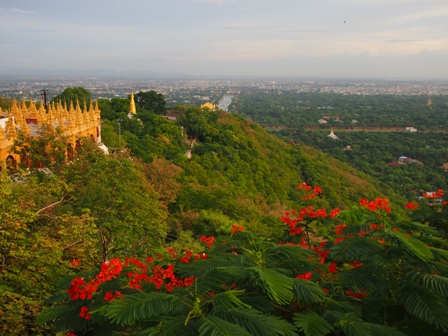 Mandalay Hill view[/caption]
I was a guest of two Grasshopper Adventure tours, one half day ‘Tea Shop’ tri-shaw tour and a half day 'Motorbike Tour' to the city’s rural outskirts.
I can’t recommend them highly enough. Both tours gave me insights into Mandalay life that I would simply never have discovered on my own, which is to say it would have taken me months of hard work and research to discover what I saw in a single day organised by people who really know what they're doing. As a tourist exercise, the two tours were perfection.
[caption id="attachment_3169" align="alignnone" width="347"]
Mandalay Hill view[/caption]
I was a guest of two Grasshopper Adventure tours, one half day ‘Tea Shop’ tri-shaw tour and a half day 'Motorbike Tour' to the city’s rural outskirts.
I can’t recommend them highly enough. Both tours gave me insights into Mandalay life that I would simply never have discovered on my own, which is to say it would have taken me months of hard work and research to discover what I saw in a single day organised by people who really know what they're doing. As a tourist exercise, the two tours were perfection.
[caption id="attachment_3169" align="alignnone" width="347"]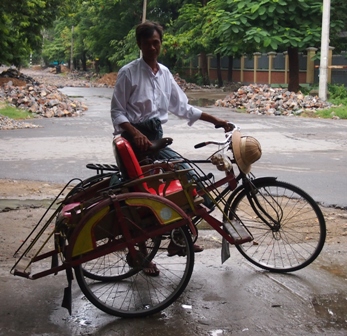 Trishaw driver Mandalay[/caption]
The ‘Tea Shop’ tour took me to a home noodle factory, the city’s best tempura stall (it's a wholesale shop tucked away in a side street near the Hotel on the Red Canal), the city’s best food market (Nan She or Eastern Market), the city’s best cafe (Shwe Le Ya 'Golden Cooking') where a fine bowl of mohinga (Myanmar fish soup) is served, the city’s best tea leaf salad cafe (Yee E. Don) and the city’s best cold drinks stand (also named Shwe Le Ya 'Golden Cooking' at the corner of 70th and 28th streets) and the city's best tea and coffee house (Shwe Pyi Moe near the Sedona Hotel opposite the old city walls on 66th Street). My guide Lu Wine has a profound knowledge of Mandalay's best places in which to eat authentic Myanmar food. He was absolutely charming, interesting company and great fun.
[caption id="attachment_3233" align="alignnone" width="336"]
Trishaw driver Mandalay[/caption]
The ‘Tea Shop’ tour took me to a home noodle factory, the city’s best tempura stall (it's a wholesale shop tucked away in a side street near the Hotel on the Red Canal), the city’s best food market (Nan She or Eastern Market), the city’s best cafe (Shwe Le Ya 'Golden Cooking') where a fine bowl of mohinga (Myanmar fish soup) is served, the city’s best tea leaf salad cafe (Yee E. Don) and the city’s best cold drinks stand (also named Shwe Le Ya 'Golden Cooking' at the corner of 70th and 28th streets) and the city's best tea and coffee house (Shwe Pyi Moe near the Sedona Hotel opposite the old city walls on 66th Street). My guide Lu Wine has a profound knowledge of Mandalay's best places in which to eat authentic Myanmar food. He was absolutely charming, interesting company and great fun.
[caption id="attachment_3233" align="alignnone" width="336"]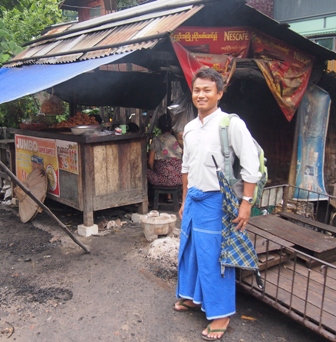 Grasshopper Adventure tours 'Tea House' tour guide Lu Wine outside Mandalay's best tempura stall.[/caption]
[caption id="attachment_3236" align="alignnone" width="445"]
Grasshopper Adventure tours 'Tea House' tour guide Lu Wine outside Mandalay's best tempura stall.[/caption]
[caption id="attachment_3236" align="alignnone" width="445"] Nan She market flower seller surrounded by lotus blossoms in Mandalay[/caption]
[caption id="attachment_3240" align="alignnone" width="448"]
Nan She market flower seller surrounded by lotus blossoms in Mandalay[/caption]
[caption id="attachment_3240" align="alignnone" width="448"]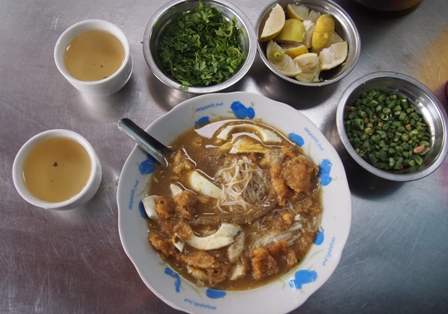 Bowl of Mohinga at Shwe Ye La cafe in Mandalay[/caption]
[caption id="attachment_3171" align="alignnone" width="354"]
Bowl of Mohinga at Shwe Ye La cafe in Mandalay[/caption]
[caption id="attachment_3171" align="alignnone" width="354"]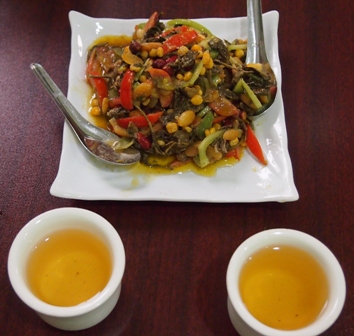 Best tea leaf salad in Mandalay[/caption]
[caption id="attachment_3172" align="alignnone" width="372"]
Best tea leaf salad in Mandalay[/caption]
[caption id="attachment_3172" align="alignnone" width="372"]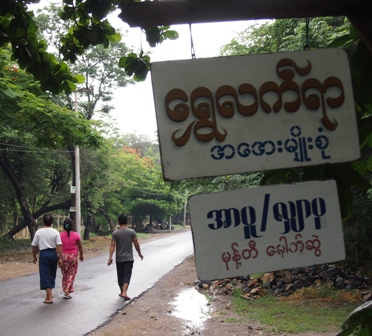 Shwe Le Ya, the best cold drinks stand in Mandalay[/caption]
Seen from the passenger seat of a tri-shaw, everywhere becomes more visible, shapes are clearly delineated and life is seen from up close and personal rather than distant. Instead of whizzing past in a cocooned air-conditioned car or coach, peddling along a busy street or quiet back alleyway is like being given a special lens into reality.
[caption id="attachment_3170" align="alignnone" width="448"]
Shwe Le Ya, the best cold drinks stand in Mandalay[/caption]
Seen from the passenger seat of a tri-shaw, everywhere becomes more visible, shapes are clearly delineated and life is seen from up close and personal rather than distant. Instead of whizzing past in a cocooned air-conditioned car or coach, peddling along a busy street or quiet back alleyway is like being given a special lens into reality.
[caption id="attachment_3170" align="alignnone" width="448"]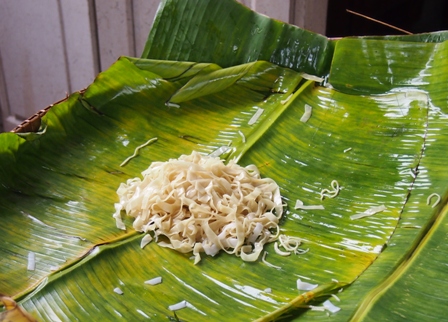 Fresh rice noodles in Mandalay[/caption]
About a kilometre from my hotel where I was to be dropped off in preparation for the afternoon motorcycle tour, I convinced my guide and driver to let me have a go peddling the tri-shaw. I don’t think the driver had ever sat in the passenger seat before. He almost shouted aloud when I veered close to a parked car or two. His perspective was derived from the driver’s seat, not the other way round. I didn’t hit any moving vehicles, or stationary for that matter, avoided colliding with pedestrians and water buffalo carts, children and dogs. Peddling two passengers (the driver and my guide) wasn’t the hard work I was expecting though I was drenched in perspiration when we reached the hotel. That being said, the brakes were a bit dodgy so I didn’t speed along the alleyways and streets. Hot days in Mandalay are not made for amateur tri-shaw drivers.
I was advised by both my passengers not to give up my day job.
[caption id="attachment_3178" align="alignnone" width="412"]
Fresh rice noodles in Mandalay[/caption]
About a kilometre from my hotel where I was to be dropped off in preparation for the afternoon motorcycle tour, I convinced my guide and driver to let me have a go peddling the tri-shaw. I don’t think the driver had ever sat in the passenger seat before. He almost shouted aloud when I veered close to a parked car or two. His perspective was derived from the driver’s seat, not the other way round. I didn’t hit any moving vehicles, or stationary for that matter, avoided colliding with pedestrians and water buffalo carts, children and dogs. Peddling two passengers (the driver and my guide) wasn’t the hard work I was expecting though I was drenched in perspiration when we reached the hotel. That being said, the brakes were a bit dodgy so I didn’t speed along the alleyways and streets. Hot days in Mandalay are not made for amateur tri-shaw drivers.
I was advised by both my passengers not to give up my day job.
[caption id="attachment_3178" align="alignnone" width="412"]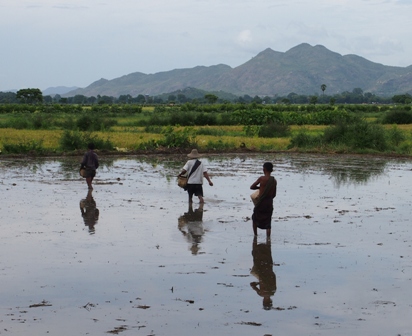 Rice sowing outside Mandalay[/caption]
My last afternoon in Mandalay, my last day in Myanmar in fact, was spent on a motorbike riding the rough and rugged muddy tracks of the city’s rural outskirts.
[caption id="attachment_3174" align="alignnone" width="426"]
Rice sowing outside Mandalay[/caption]
My last afternoon in Mandalay, my last day in Myanmar in fact, was spent on a motorbike riding the rough and rugged muddy tracks of the city’s rural outskirts.
[caption id="attachment_3174" align="alignnone" width="426"]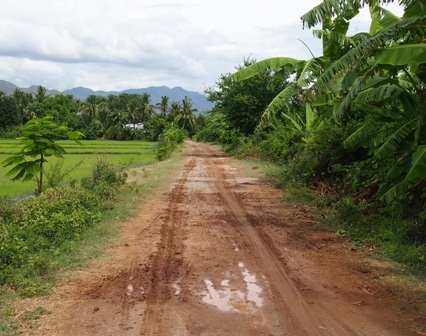 On the road to Mandalay[/caption]
My driver Soe Min Oo was terrific fun. We visited a tofu factory and a village with a prominent Nats (indigenous pagan spirits) shrine, rode through rice paddies spread against gloriously green countryside.
[caption id="attachment_3175" align="alignnone" width="382"]
On the road to Mandalay[/caption]
My driver Soe Min Oo was terrific fun. We visited a tofu factory and a village with a prominent Nats (indigenous pagan spirits) shrine, rode through rice paddies spread against gloriously green countryside.
[caption id="attachment_3175" align="alignnone" width="382"]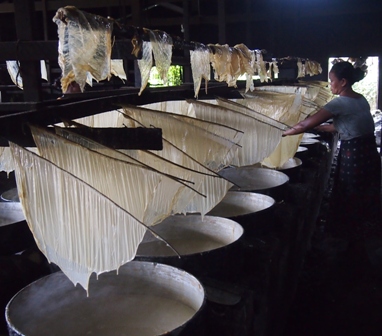 Tofu factory in Mandalay[/caption]
[caption id="attachment_3173" align="alignnone" width="336"]
Tofu factory in Mandalay[/caption]
[caption id="attachment_3173" align="alignnone" width="336"] Soe Min Oo Grasshopper Adventures Mandalay guide[/caption]
A stop at a toddy wine shop in a rice paddy was altogether different, a place I would never have discovered without a guide. Actually without a guide, I probably wouldn’t have been very welcomed. We sat at a wooden bench drinking from odd mugs, picking at bits of barbecued goat meat on sticks and eating overripe bananas. The toddy was cloudy and slightly fizzy, freshly fermented. Had I drunk a bit more I would have begun reciting from the Coward songbook, ‘to dine on yams and clams and human hands and vintage coconut wine, the taste of which was filthy, the after-effects divine...’ (Uncle Harry)
[caption id="attachment_3176" align="alignnone" width="448"]
Soe Min Oo Grasshopper Adventures Mandalay guide[/caption]
A stop at a toddy wine shop in a rice paddy was altogether different, a place I would never have discovered without a guide. Actually without a guide, I probably wouldn’t have been very welcomed. We sat at a wooden bench drinking from odd mugs, picking at bits of barbecued goat meat on sticks and eating overripe bananas. The toddy was cloudy and slightly fizzy, freshly fermented. Had I drunk a bit more I would have begun reciting from the Coward songbook, ‘to dine on yams and clams and human hands and vintage coconut wine, the taste of which was filthy, the after-effects divine...’ (Uncle Harry)
[caption id="attachment_3176" align="alignnone" width="448"]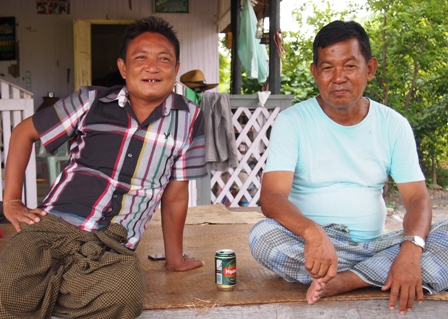 Toddy drinking buddies[/caption]
Our last stop for the day was Mandalay Hill. Sunset spread flames of light across the flooding landscape. The monsoon rains had drenched the north expanding the Irrawaddy to reach its widest banks. The fabled river seen from above the mystical city struck me dumb with pleasure.
[caption id="attachment_3177" align="alignnone" width="448"]
Toddy drinking buddies[/caption]
Our last stop for the day was Mandalay Hill. Sunset spread flames of light across the flooding landscape. The monsoon rains had drenched the north expanding the Irrawaddy to reach its widest banks. The fabled river seen from above the mystical city struck me dumb with pleasure.
[caption id="attachment_3177" align="alignnone" width="448"]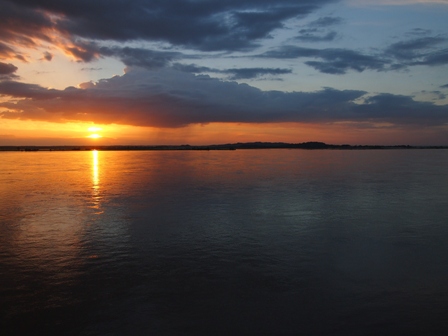 Irrawaddy sunset near Mandalay[/caption]
The river had been my constant companion from Yangon all the way up to Nwe Nyein and now it presented my last best view on this trip to Myanmar. From high atop Mandalay Hill, I could not have chosen a better place to say farewell, until we meet again.
Tom Neal Tacker travelled as a guest of RV Pandaw Cruises and Grasshopper Adventures.
Naked Facts:
Visitors to Myanmar are required to obtain a visa before entry. Contact the nearest Myanmar Embassy.
Pagan can be reached by air from Yangon. Since the by-elections in 2012, Myanmar has seen rapid growth in its airline industry.
Frequent flights connect Pagan with Yangon and Lake Inle. Pagan by road from Mandalay takes approximately four hours.
Mandalay is served from Bangkok by daily flights with Thai Airways, (www.thaiairways.com) and Bangkok Airways (www.bangkokairways.com)
For information about RV Pandaw Cruises in Myanmar and other southeast Asian countries, see www.pandaw.com
For information about bicycle and photography tours from a ground up perspective, see Grasshopper Adventures www.grasshopperadventures.com
Naked Sleeps:
The Hotel by the Red Canal is a boutique luxury hotel (with a swimming pool, a rarity in sweltering Mandalay), a well run establishment with a good Indian restaurant attached. The location is terrific, close to the old city and near the city’s best shopping streets. Formerly the Chinese Consulate, the rooms have been completely renovated (spy cameras removed). All vestiges of boring Chinese bureaucracy have been erased. Wi Fi is free and fairly reliable. See www.hotelredcanal.com
[caption id="attachment_3182" align="alignnone" width="182"]
Irrawaddy sunset near Mandalay[/caption]
The river had been my constant companion from Yangon all the way up to Nwe Nyein and now it presented my last best view on this trip to Myanmar. From high atop Mandalay Hill, I could not have chosen a better place to say farewell, until we meet again.
Tom Neal Tacker travelled as a guest of RV Pandaw Cruises and Grasshopper Adventures.
Naked Facts:
Visitors to Myanmar are required to obtain a visa before entry. Contact the nearest Myanmar Embassy.
Pagan can be reached by air from Yangon. Since the by-elections in 2012, Myanmar has seen rapid growth in its airline industry.
Frequent flights connect Pagan with Yangon and Lake Inle. Pagan by road from Mandalay takes approximately four hours.
Mandalay is served from Bangkok by daily flights with Thai Airways, (www.thaiairways.com) and Bangkok Airways (www.bangkokairways.com)
For information about RV Pandaw Cruises in Myanmar and other southeast Asian countries, see www.pandaw.com
For information about bicycle and photography tours from a ground up perspective, see Grasshopper Adventures www.grasshopperadventures.com
Naked Sleeps:
The Hotel by the Red Canal is a boutique luxury hotel (with a swimming pool, a rarity in sweltering Mandalay), a well run establishment with a good Indian restaurant attached. The location is terrific, close to the old city and near the city’s best shopping streets. Formerly the Chinese Consulate, the rooms have been completely renovated (spy cameras removed). All vestiges of boring Chinese bureaucracy have been erased. Wi Fi is free and fairly reliable. See www.hotelredcanal.com
[caption id="attachment_3182" align="alignnone" width="182"]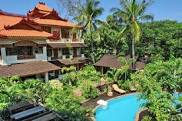 Hotel by the Red Canal Mandalay[/caption]
The Ma Ma Guest House run by the dynamic mother and daughter duo Alice and Sue is very friendly and reasonably priced. Rooms are large, very clean and airy. The guesthouse has all mod-cons, is situated in a convenient part of town close to the central business district. Best of all both Alice and Sue speak fluent English, are absolutely lovely people who understand the true meaning of hospitality. A rooftop restaurant and bar sporting lovely city views was scheduled to open at time of publishing. Highly recommended. See www.mamaguesthouse.com for more information and bookings.
[caption id="attachment_3179" align="alignnone" width="336"]
Hotel by the Red Canal Mandalay[/caption]
The Ma Ma Guest House run by the dynamic mother and daughter duo Alice and Sue is very friendly and reasonably priced. Rooms are large, very clean and airy. The guesthouse has all mod-cons, is situated in a convenient part of town close to the central business district. Best of all both Alice and Sue speak fluent English, are absolutely lovely people who understand the true meaning of hospitality. A rooftop restaurant and bar sporting lovely city views was scheduled to open at time of publishing. Highly recommended. See www.mamaguesthouse.com for more information and bookings.
[caption id="attachment_3179" align="alignnone" width="336"] Sue and Alice of Ma Ma Guesthouse in Mandalay[/caption]
Naked Tips:
Our wonder guide on board the RV Orient Pandaw was the inestimably charming, learned and talented San Lin Tun. What San doesn’t know (or feel) about Myanmar isn’t worth knowing. His candour and honesty are truly impressive. Myanmar politics is a nasty business. Not long ago, Myanmar people were locked in prison for speaking the truth about corruption and dishonesty. San’s patient explanations about Myanmar’s recent history and politics were very helpful and revealing.
[caption id="attachment_3183" align="alignnone" width="448"]
Sue and Alice of Ma Ma Guesthouse in Mandalay[/caption]
Naked Tips:
Our wonder guide on board the RV Orient Pandaw was the inestimably charming, learned and talented San Lin Tun. What San doesn’t know (or feel) about Myanmar isn’t worth knowing. His candour and honesty are truly impressive. Myanmar politics is a nasty business. Not long ago, Myanmar people were locked in prison for speaking the truth about corruption and dishonesty. San’s patient explanations about Myanmar’s recent history and politics were very helpful and revealing.
[caption id="attachment_3183" align="alignnone" width="448"]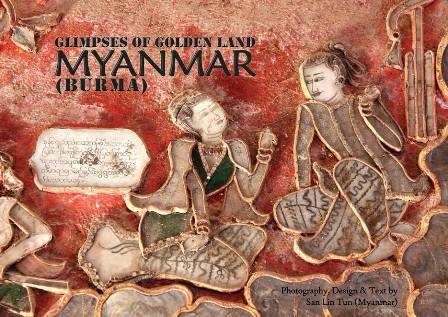 San's book cover[/caption]
While contracted to RV Pandaw Cruises, San also works as a freelance tour guide.
He’s also a talented photographer and has self-published a marvellous book of his pictures of the ‘Golden Land’. As a remembrance of Myanmar it’s invaluable. As a gift, it would be heartily appreciated. Priced at less than USD$20.00, shipping at an extra cost dependent on location, it’s a bargain. Contact San Lin Tun via email to order a copy: sanlintun74@gmail.com
San's book cover[/caption]
While contracted to RV Pandaw Cruises, San also works as a freelance tour guide.
He’s also a talented photographer and has self-published a marvellous book of his pictures of the ‘Golden Land’. As a remembrance of Myanmar it’s invaluable. As a gift, it would be heartily appreciated. Priced at less than USD$20.00, shipping at an extra cost dependent on location, it’s a bargain. Contact San Lin Tun via email to order a copy: sanlintun74@gmail.com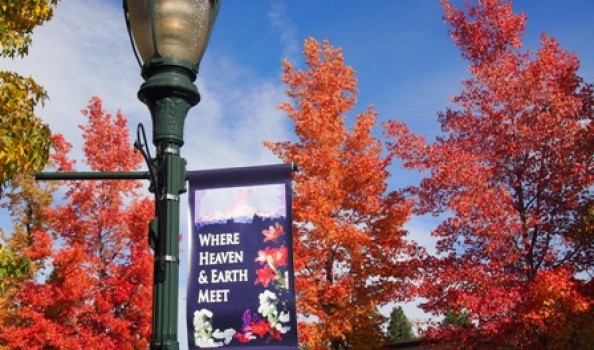 https://nakedhungrytraveller.com.au/wholly-shasta/ Wholly ShastaCrystals shine along Mount Shasta town’s main street. Clairvoyants, shamans, chakra aligners, yoga teachers, massage therapists, soul diggers; they’re all here because of the mountain. The new age shops proliferating in Mount Shasta town are drawn by the mountain’s reputation as a direct portal to another dimension. Lemuria, Atlantis, you name it, Shasta is the front door to a mystic house in an alien neighbourhood of alternate reality. [caption id="attachment_3354" align="alignnone" width="336"]
https://nakedhungrytraveller.com.au/wholly-shasta/ Wholly ShastaCrystals shine along Mount Shasta town’s main street. Clairvoyants, shamans, chakra aligners, yoga teachers, massage therapists, soul diggers; they’re all here because of the mountain. The new age shops proliferating in Mount Shasta town are drawn by the mountain’s reputation as a direct portal to another dimension. Lemuria, Atlantis, you name it, Shasta is the front door to a mystic house in an alien neighbourhood of alternate reality. [caption id="attachment_3354" align="alignnone" width="336"]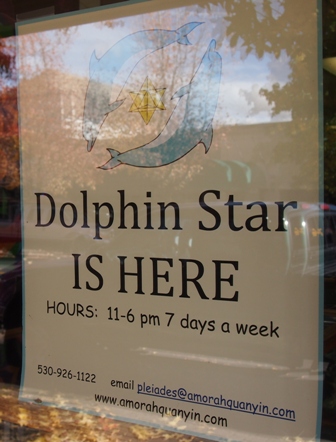 Mount Shasta shop sign[/caption]
After a brief gold rush in the 1850s, Mount Shasta grew into a small northern California timber town eking a living from tree chopping. Now it’s a small resort town that’s a magnet for big city folk searching for a permanent tree change... or at least a few days escape to the more natural world.
Mount Shasta is the magnet; travellers come here to marvel at its stature, some stay on in thrall to its constant snow capped majesty.
Whatever your inscribed beliefs may be, Mount Shasta is undeniably a stupendous geographical exclamation point. At 4,322 metres, it’s the second highest peak in the Cascade Range (Mount Rainier in Washington at 4,392 metres is the highest). Towering almost 3,000 metres above the surrounding landscape, it stands alone. By volume, it’s the biggest strato-volcano in the whole Cascade Range.
[caption id="attachment_3355" align="alignnone" width="409"]
Mount Shasta shop sign[/caption]
After a brief gold rush in the 1850s, Mount Shasta grew into a small northern California timber town eking a living from tree chopping. Now it’s a small resort town that’s a magnet for big city folk searching for a permanent tree change... or at least a few days escape to the more natural world.
Mount Shasta is the magnet; travellers come here to marvel at its stature, some stay on in thrall to its constant snow capped majesty.
Whatever your inscribed beliefs may be, Mount Shasta is undeniably a stupendous geographical exclamation point. At 4,322 metres, it’s the second highest peak in the Cascade Range (Mount Rainier in Washington at 4,392 metres is the highest). Towering almost 3,000 metres above the surrounding landscape, it stands alone. By volume, it’s the biggest strato-volcano in the whole Cascade Range.
[caption id="attachment_3355" align="alignnone" width="409"]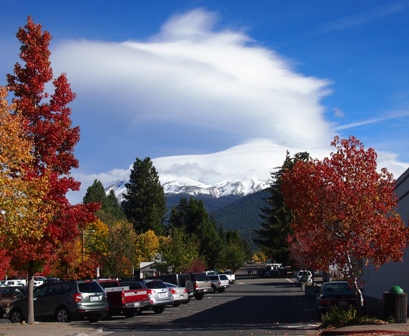 Mount Shasta street scene with Mount Shasta backdrop[/caption]
Though it’s officially dormant, the last significant eruption was only about 200 years ago on the massif’s Hotlum Cone. Supposedly the French explorer La Perouse witnessed the explosion while sailing off the California coast in 1786.
Like Mount Rainier, if and/or when Shasta blows again, its impact will be devastating.
But don’t let potential volcanic activity put you off visiting.
This is an environmentally significant wonderland. Endless Conifer forest, beautiful waterfalls, Native American historic sites, numerous national and state parks, excellent trekking and camping and a sophisticated accommodation and dining scene offer ample reasons to linger around the great mountain.
[caption id="attachment_3356" align="alignnone" width="380"]
Mount Shasta street scene with Mount Shasta backdrop[/caption]
Though it’s officially dormant, the last significant eruption was only about 200 years ago on the massif’s Hotlum Cone. Supposedly the French explorer La Perouse witnessed the explosion while sailing off the California coast in 1786.
Like Mount Rainier, if and/or when Shasta blows again, its impact will be devastating.
But don’t let potential volcanic activity put you off visiting.
This is an environmentally significant wonderland. Endless Conifer forest, beautiful waterfalls, Native American historic sites, numerous national and state parks, excellent trekking and camping and a sophisticated accommodation and dining scene offer ample reasons to linger around the great mountain.
[caption id="attachment_3356" align="alignnone" width="380"] Mount Shasta street plaque with Mount Shasta backdrop[/caption]
Northern California occupies one third of the state’s area but claims only 3% of its population.
When the crowds down south strain your patience levels, head north for peace and quiet seclusion.
Having visited California many times, I’d never ventured north of San Francisco other than via the Coast Road. While the redwood forests and wild coastline are inspiring, the inland around the Cascades provides an entirely different perspective to what the Golden State is all about.
After a few days ambling round the mountain checking out wineries, national parks and historic towns, I decided it was time to drive up high as I could.
[caption id="attachment_3357" align="alignnone" width="448"]
Mount Shasta street plaque with Mount Shasta backdrop[/caption]
Northern California occupies one third of the state’s area but claims only 3% of its population.
When the crowds down south strain your patience levels, head north for peace and quiet seclusion.
Having visited California many times, I’d never ventured north of San Francisco other than via the Coast Road. While the redwood forests and wild coastline are inspiring, the inland around the Cascades provides an entirely different perspective to what the Golden State is all about.
After a few days ambling round the mountain checking out wineries, national parks and historic towns, I decided it was time to drive up high as I could.
[caption id="attachment_3357" align="alignnone" width="448"]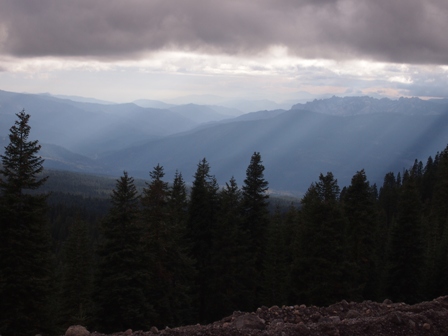 View south from near Mount Shasta summit[/caption]
The Mount Shasta summit road ends at a locked gate. Snowdrifts ahead, changing weather, unsafe conditions: explanations listed on an affixed sign said it all. Beyond that point there be dragons.
Alone and curious I walked to the next twist higher up the road. Mount Lassen’s snow covered peak (3,187 metres) shone in momentary bright sunlight from 60 kilometres away.
[caption id="attachment_3358" align="alignnone" width="448"]
View south from near Mount Shasta summit[/caption]
The Mount Shasta summit road ends at a locked gate. Snowdrifts ahead, changing weather, unsafe conditions: explanations listed on an affixed sign said it all. Beyond that point there be dragons.
Alone and curious I walked to the next twist higher up the road. Mount Lassen’s snow covered peak (3,187 metres) shone in momentary bright sunlight from 60 kilometres away.
[caption id="attachment_3358" align="alignnone" width="448"] Lassen Peak under snow[/caption]
I’d been there two days before walking amongst steam vents and scalding pools ringed by deep snow, animal tracks crisscrossing open meadows, hoping to see a wolf print, maybe a bear. Rumours of wolves moving south along the Cascade Range from Oregon were all at once real and enticing.
If wolves return to California, the southern Cascades would be their natural home.
[caption id="attachment_3359" align="alignnone" width="448"]
Lassen Peak under snow[/caption]
I’d been there two days before walking amongst steam vents and scalding pools ringed by deep snow, animal tracks crisscrossing open meadows, hoping to see a wolf print, maybe a bear. Rumours of wolves moving south along the Cascade Range from Oregon were all at once real and enticing.
If wolves return to California, the southern Cascades would be their natural home.
[caption id="attachment_3359" align="alignnone" width="448"] Lassen Peak reflected in an alpine lake[/caption]
Maybe they would mark Mount Shasta as a kind of homing beacon?
Long ago, Native American Indians saw it as a holy place; for most people it still is. Migrating from one food source to another, various Indian tribes used Shasta as a compass point.
Standing alone, sentinel, beacon, point of difference, whatever adjective applied, it’s a helluva’ mountain.
I’d been in its presence, indeed it’s the sort of mountain that demands presence before I decided to drive up the summit road. I’d chosen initially to observe from below, not wanting to disrespect the old spirits said to reside in its secret centre. I wanted to come to a gradual understanding of what Shasta means for all the creatures living around it.
You can’t help but be drawn to it. The mountain creates its own weather, famed for its lenticular cloud formations that hover around the peak like flying saucers.
Nestled into the mountain’s south western flank, Mount Shasta town is where most visitors stay. Here outdoor supply shops selling the newest camping equipment sidle up next to boutiques advertising natural healing or crystal reading and hardware stores offering discounts on pole stumpers and Stetson hats.
The town’s single main street extends for several kilometres curving towards Interstate Highway 5, lined with cafes, organic bakeries, cowboy bars, organic grocery stores, funky restaurants and an interesting collection of curio shops selling scented beeswax candles and books about how Mount Shasta is a portal into an alternate universe.
Strolling Shasta town’s main drag is a walking trip between California’s contemporary counter-culture and its Wild West gold-digging past.
If you spend a few days exploring the region, Mount Shasta town is its centre point; you’ll return to it often.
North of Mount Shasta along Interstate Highway 5 is Weed.
[caption id="attachment_3360" align="alignnone" width="441"]
Lassen Peak reflected in an alpine lake[/caption]
Maybe they would mark Mount Shasta as a kind of homing beacon?
Long ago, Native American Indians saw it as a holy place; for most people it still is. Migrating from one food source to another, various Indian tribes used Shasta as a compass point.
Standing alone, sentinel, beacon, point of difference, whatever adjective applied, it’s a helluva’ mountain.
I’d been in its presence, indeed it’s the sort of mountain that demands presence before I decided to drive up the summit road. I’d chosen initially to observe from below, not wanting to disrespect the old spirits said to reside in its secret centre. I wanted to come to a gradual understanding of what Shasta means for all the creatures living around it.
You can’t help but be drawn to it. The mountain creates its own weather, famed for its lenticular cloud formations that hover around the peak like flying saucers.
Nestled into the mountain’s south western flank, Mount Shasta town is where most visitors stay. Here outdoor supply shops selling the newest camping equipment sidle up next to boutiques advertising natural healing or crystal reading and hardware stores offering discounts on pole stumpers and Stetson hats.
The town’s single main street extends for several kilometres curving towards Interstate Highway 5, lined with cafes, organic bakeries, cowboy bars, organic grocery stores, funky restaurants and an interesting collection of curio shops selling scented beeswax candles and books about how Mount Shasta is a portal into an alternate universe.
Strolling Shasta town’s main drag is a walking trip between California’s contemporary counter-culture and its Wild West gold-digging past.
If you spend a few days exploring the region, Mount Shasta town is its centre point; you’ll return to it often.
North of Mount Shasta along Interstate Highway 5 is Weed.
[caption id="attachment_3360" align="alignnone" width="441"]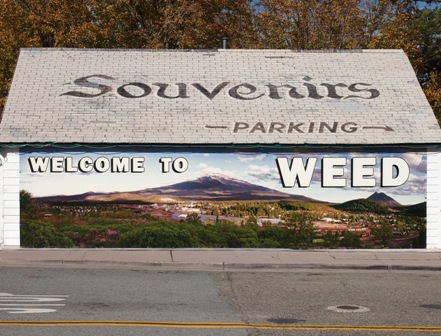 Welcome to Weed[/caption]
Named for a town founder, Mr Abner Weed, a lumberman who favoured the location because the winds funneling down Mount Shasta’s northern flanks were good for drying timber, Weed town is recognised these days primarily because of its unusual place name.
Fridge magnets and T-shirts with ‘WEED’ in large print and a dope leaf image are popular merchandise. I bought one of each and could have bought a couple freshly rolled joints just as easily but declined getting any higher than I already was at that altitude.
South of Mount Shasta, the towns McCloud and Dunsmuir provide a far more stimulating touristic experience.
McCloud is a former timber town where all inhabitants were company employees. Once a lively community whose heyday was in the 1920s, it dwindled into ghostly obscurity when logging operations were deemed unprofitable in the post war years. Residents were paid in company currency which was accepted only in company stores. Simply put, if you lived in McCloud, you worked in the McCloud sawmill and processing plant or had no other reason to be there. When logging ceased, McCloud emptied.
[caption id="attachment_3361" align="alignnone" width="336"]
Welcome to Weed[/caption]
Named for a town founder, Mr Abner Weed, a lumberman who favoured the location because the winds funneling down Mount Shasta’s northern flanks were good for drying timber, Weed town is recognised these days primarily because of its unusual place name.
Fridge magnets and T-shirts with ‘WEED’ in large print and a dope leaf image are popular merchandise. I bought one of each and could have bought a couple freshly rolled joints just as easily but declined getting any higher than I already was at that altitude.
South of Mount Shasta, the towns McCloud and Dunsmuir provide a far more stimulating touristic experience.
McCloud is a former timber town where all inhabitants were company employees. Once a lively community whose heyday was in the 1920s, it dwindled into ghostly obscurity when logging operations were deemed unprofitable in the post war years. Residents were paid in company currency which was accepted only in company stores. Simply put, if you lived in McCloud, you worked in the McCloud sawmill and processing plant or had no other reason to be there. When logging ceased, McCloud emptied.
[caption id="attachment_3361" align="alignnone" width="336"]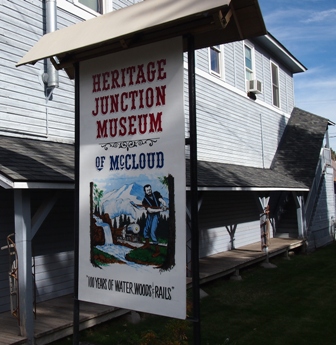 McCloud Heritage Museum sign[/caption]
Now McCloud is a kind of time-warp town as people have returned, renovating lovely wooden houses set in large blocks. Architecturally well-preserved, current residents have taken pride in saving what was once a thriving community. Tourism is the main game, B & B accommodation is popular (particularly with Bay Area folk looking for a mountain escape within a day’s drive) as the region gradually switched its economic focus from logging to eco-tourism.
[caption id="attachment_3362" align="alignnone" width="237"]
McCloud Heritage Museum sign[/caption]
Now McCloud is a kind of time-warp town as people have returned, renovating lovely wooden houses set in large blocks. Architecturally well-preserved, current residents have taken pride in saving what was once a thriving community. Tourism is the main game, B & B accommodation is popular (particularly with Bay Area folk looking for a mountain escape within a day’s drive) as the region gradually switched its economic focus from logging to eco-tourism.
[caption id="attachment_3362" align="alignnone" width="237"] McCloud lumberjack statue[/caption]
From McCloud, Mount Shasta’s downhill and alpine ski fields are within easy reach while trekking or rock-climbing in nearby Castle Crags or Trinity Alps state parks is a year-round drawcard.
[caption id="attachment_3375" align="alignnone" width="336"]
McCloud lumberjack statue[/caption]
From McCloud, Mount Shasta’s downhill and alpine ski fields are within easy reach while trekking or rock-climbing in nearby Castle Crags or Trinity Alps state parks is a year-round drawcard.
[caption id="attachment_3375" align="alignnone" width="336"] Log church at McCloud[/caption]
Not far from McCloud is equally interesting Dunsmuir. Boasting the ‘Cleanest Water in the World’, Dunsmuir was once an important railway town where trains stopped for water and supplies before making the steep ascent to the Mount Shasta foothills and the Cascade Range plateau beyond the great mountain. The forest around Dunsmuir is dense. In fact Dunsmuir is sequestered into a deep valley, a situation immediately apparent when driving into the town centre. Everything is looking up from the main street running along the railway track.
Like Mount Shasta town, Dunsmuir is a thriving municipality. Visitors and residents alike share an obvious fondness for both places. Civic pride is clear as the snow on Mount Shasta’s summit. Nearly everyone I met came here from somewhere else for good reason; escaping big city pressure in pursuit of a relaxed lifestyle was the answer I heard most often. That and living costs were less than in LA or San Francisco.
Wandering around Dunsmuir’s main street, checking out the restored Art Deco cinema, the assortment of cute art galleries and cafes, I ran into a big man in bikie leathers who noticed me taking photos. ‘Where are you from mister?’ he asked me good naturedly. Not accustomed to being greeted in such a friendly manner from an aggressive looking giant in black leather, I responded meekly, ‘Australia’. Cutting a long story short, it happened that the Harley-Davidson loving chap was the town’s mayor. Within a few minutes, he’d invited me into a nearby bar as his guest. Everyone in the bar knew him (how could they not given Dunsmuir’s small size and the mayor’s large presence?). With drink in hand and introductions all round, I suddenly had twenty new best friends.
[caption id="attachment_3363" align="alignnone" width="426"]
Log church at McCloud[/caption]
Not far from McCloud is equally interesting Dunsmuir. Boasting the ‘Cleanest Water in the World’, Dunsmuir was once an important railway town where trains stopped for water and supplies before making the steep ascent to the Mount Shasta foothills and the Cascade Range plateau beyond the great mountain. The forest around Dunsmuir is dense. In fact Dunsmuir is sequestered into a deep valley, a situation immediately apparent when driving into the town centre. Everything is looking up from the main street running along the railway track.
Like Mount Shasta town, Dunsmuir is a thriving municipality. Visitors and residents alike share an obvious fondness for both places. Civic pride is clear as the snow on Mount Shasta’s summit. Nearly everyone I met came here from somewhere else for good reason; escaping big city pressure in pursuit of a relaxed lifestyle was the answer I heard most often. That and living costs were less than in LA or San Francisco.
Wandering around Dunsmuir’s main street, checking out the restored Art Deco cinema, the assortment of cute art galleries and cafes, I ran into a big man in bikie leathers who noticed me taking photos. ‘Where are you from mister?’ he asked me good naturedly. Not accustomed to being greeted in such a friendly manner from an aggressive looking giant in black leather, I responded meekly, ‘Australia’. Cutting a long story short, it happened that the Harley-Davidson loving chap was the town’s mayor. Within a few minutes, he’d invited me into a nearby bar as his guest. Everyone in the bar knew him (how could they not given Dunsmuir’s small size and the mayor’s large presence?). With drink in hand and introductions all round, I suddenly had twenty new best friends.
[caption id="attachment_3363" align="alignnone" width="426"]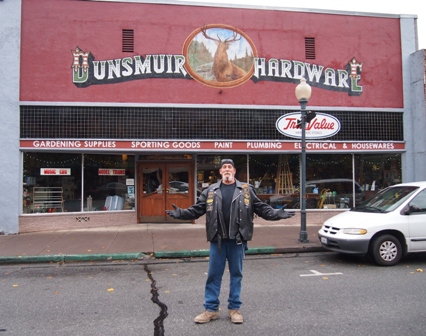 Dunsmuir mayor Dave Keisler[/caption]
Like I said, Mount Shasta has gifted its benevolent presence on all who visit it with hearts and minds wide open to new experience. The brief incident in Dunsmuir with the Hells Angels gang leader cum mayor is just one case in point.
Lassen Volcanic National Park was established in 1916 to protect the environment surrounding the world’s largest plug-dome volcano. (See www.basicplanet.com for detailed information about plug-dome volcanoes). The full service visitor centre at the southwest entrance (the easiest access point from Mount Shasta town) is an obligatory stop. USA national parks are among the best in the world. Employees are local experts, uniformly friendly and helpful.
[caption id="attachment_3364" align="alignnone" width="448"]
Dunsmuir mayor Dave Keisler[/caption]
Like I said, Mount Shasta has gifted its benevolent presence on all who visit it with hearts and minds wide open to new experience. The brief incident in Dunsmuir with the Hells Angels gang leader cum mayor is just one case in point.
Lassen Volcanic National Park was established in 1916 to protect the environment surrounding the world’s largest plug-dome volcano. (See www.basicplanet.com for detailed information about plug-dome volcanoes). The full service visitor centre at the southwest entrance (the easiest access point from Mount Shasta town) is an obligatory stop. USA national parks are among the best in the world. Employees are local experts, uniformly friendly and helpful.
[caption id="attachment_3364" align="alignnone" width="448"]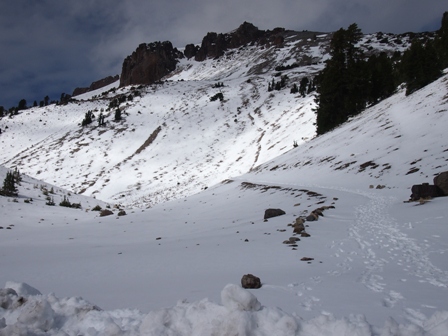 Tracks at the base of Lassen Peak[/caption]
Equally important is the McArthur-Burney Falls Memorial State Park. Saved from development by the McArthur ranching family, this small park (370 ha) is the second oldest in California.
The park’s star attraction is the mesmerising Burney Falls. Even during the worst droughts (such as the one California is suffering now), this waterfall gushes over 200 million litres of spring fed clear water every day. Volcanic fissures stretch deep into the Earth creating a seemingly endless stream that tumbles 39 metres over a basalt cliff into a deep reservoir that mirrors the surrounding forest on a clear day.
[caption id="attachment_3365" align="alignnone" width="448"]
Tracks at the base of Lassen Peak[/caption]
Equally important is the McArthur-Burney Falls Memorial State Park. Saved from development by the McArthur ranching family, this small park (370 ha) is the second oldest in California.
The park’s star attraction is the mesmerising Burney Falls. Even during the worst droughts (such as the one California is suffering now), this waterfall gushes over 200 million litres of spring fed clear water every day. Volcanic fissures stretch deep into the Earth creating a seemingly endless stream that tumbles 39 metres over a basalt cliff into a deep reservoir that mirrors the surrounding forest on a clear day.
[caption id="attachment_3365" align="alignnone" width="448"]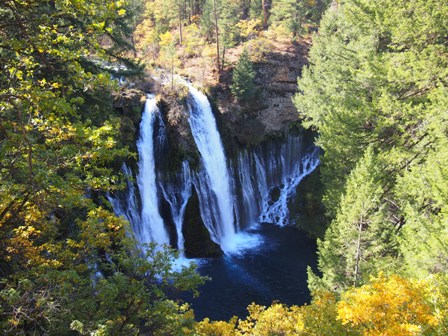 McArthur Burney Falls[/caption]
Native American Indians came to the falls during summer to cool off and during winter to avoid heavy snow. Game was always plentiful and the waterfall came to be known as a place of peace where the various migrating tribes met in harmony.
Between Mount Shasta and Lassen Volcano is Manton and its high and dry foothill country, good for Vitis Vinifera grapes, reds in particular. Approximately a half dozen vignerons around Manton produce cool climate wines of impressive stature. I checked out Indian Peak Winery outside Manton and am very glad I did. Owned and run by Fred and Donna Boots, it’s a small operation planted to Syrah, Cabernet Sauvignon and Chardonnay. The Reserve Cabernet Sauvignon is particularly good. Red rock volcanic soil and a relatively benign climate (short hot summers and long cool winters) are contributing factors to the high quality of the wines.
[caption id="attachment_3366" align="alignnone" width="357"]
McArthur Burney Falls[/caption]
Native American Indians came to the falls during summer to cool off and during winter to avoid heavy snow. Game was always plentiful and the waterfall came to be known as a place of peace where the various migrating tribes met in harmony.
Between Mount Shasta and Lassen Volcano is Manton and its high and dry foothill country, good for Vitis Vinifera grapes, reds in particular. Approximately a half dozen vignerons around Manton produce cool climate wines of impressive stature. I checked out Indian Peak Winery outside Manton and am very glad I did. Owned and run by Fred and Donna Boots, it’s a small operation planted to Syrah, Cabernet Sauvignon and Chardonnay. The Reserve Cabernet Sauvignon is particularly good. Red rock volcanic soil and a relatively benign climate (short hot summers and long cool winters) are contributing factors to the high quality of the wines.
[caption id="attachment_3366" align="alignnone" width="357"]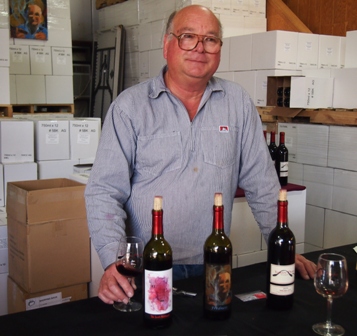 Fred Boots at Indian Peak Winery[/caption]
I wish I’d had more time to check out other wineries in the district but if time is short Indian Peak is well worth a detour. See www.indianpeakvineyards.net The cellar door is open 7 days a week but ring first to ensure a tasting. Tel: (530) 474 6126 or email ipv@frontier.net
South of Dunsmuir just off the Interstate Highway 5 is the Shasta Caverns. If viewing glistening stalagmites and stalactites while spelunking the Earth’s recesses hold interest, don’t miss this weirdly beautiful limestone cave. Access is from the visitor’s centre across artificial Lake Shasta (created by the Shasta Dam, another site well worth visiting).
[caption id="attachment_3368" align="alignnone" width="336"]
Fred Boots at Indian Peak Winery[/caption]
I wish I’d had more time to check out other wineries in the district but if time is short Indian Peak is well worth a detour. See www.indianpeakvineyards.net The cellar door is open 7 days a week but ring first to ensure a tasting. Tel: (530) 474 6126 or email ipv@frontier.net
South of Dunsmuir just off the Interstate Highway 5 is the Shasta Caverns. If viewing glistening stalagmites and stalactites while spelunking the Earth’s recesses hold interest, don’t miss this weirdly beautiful limestone cave. Access is from the visitor’s centre across artificial Lake Shasta (created by the Shasta Dam, another site well worth visiting).
[caption id="attachment_3368" align="alignnone" width="336"] Shasta Dam visitors sign[/caption]
Guided tours run several times daily and include a short boat trip across the lake, a steep ride in a bus up a winding road to the hidden cliff side cave and a couple hours exploring this underground marvel that was only discovered by a fisheries employee in 1878.
[caption id="attachment_3367" align="alignnone" width="448"]
Shasta Dam visitors sign[/caption]
Guided tours run several times daily and include a short boat trip across the lake, a steep ride in a bus up a winding road to the hidden cliff side cave and a couple hours exploring this underground marvel that was only discovered by a fisheries employee in 1878.
[caption id="attachment_3367" align="alignnone" width="448"]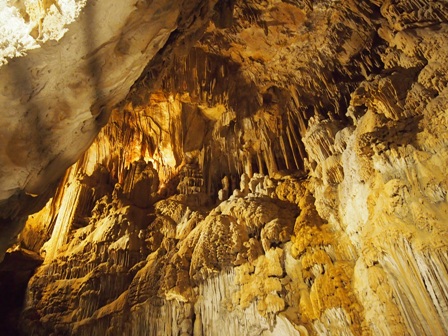 Shasta Caverns[/caption]
The cave’s visitor’s entrance is relatively new. Shasta Cavern was virtually hidden from the world by its remote location on the side of a steep cliff overlooking the Sacramento River. Descent was via a small hole in the ceiling until a new entrance was blasted into solid rock in the 1960s.
[caption id="attachment_3369" align="alignnone" width="448"]
Shasta Caverns[/caption]
The cave’s visitor’s entrance is relatively new. Shasta Cavern was virtually hidden from the world by its remote location on the side of a steep cliff overlooking the Sacramento River. Descent was via a small hole in the ceiling until a new entrance was blasted into solid rock in the 1960s.
[caption id="attachment_3369" align="alignnone" width="448"]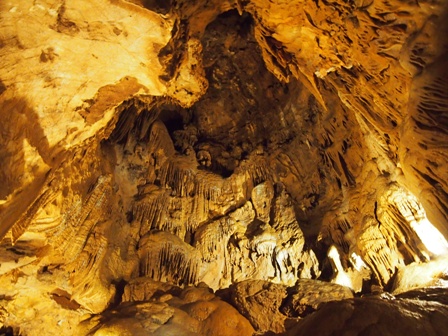 Shasta Caverns[/caption]
Most international visitors to Shasta travel by road up from San Francisco or the Central Valley. An airport at Redding allows quicker access though only three flights a day operate between Redding and San Francisco.
Redding is the region’s largest town. If you’re there for an overnight stay be sure to visit the Santiago Calatreva designed Sundial footbridge over the Sacramento River and the adjoining Turtle Bay Exploration Park.
[caption id="attachment_3370" align="alignnone" width="448"]
Shasta Caverns[/caption]
Most international visitors to Shasta travel by road up from San Francisco or the Central Valley. An airport at Redding allows quicker access though only three flights a day operate between Redding and San Francisco.
Redding is the region’s largest town. If you’re there for an overnight stay be sure to visit the Santiago Calatreva designed Sundial footbridge over the Sacramento River and the adjoining Turtle Bay Exploration Park.
[caption id="attachment_3370" align="alignnone" width="448"]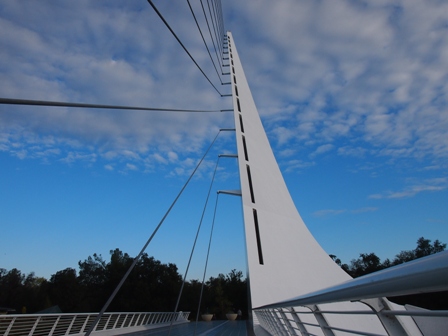 Sundial Bridge at Redding[/caption]
Turtle Bay is more than just a riverside public park. It’s a natural history museum, a wildlife sanctuary and zoo, a Native American Indian museum and an art gallery.
[caption id="attachment_3371" align="alignnone" width="448"]
Sundial Bridge at Redding[/caption]
Turtle Bay is more than just a riverside public park. It’s a natural history museum, a wildlife sanctuary and zoo, a Native American Indian museum and an art gallery.
[caption id="attachment_3371" align="alignnone" width="448"]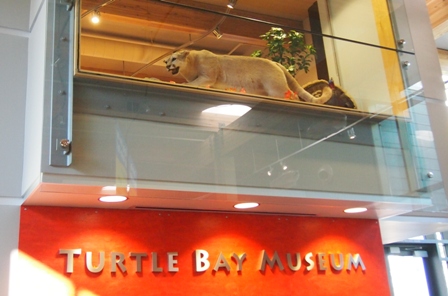 Turtle Bay Museum[/caption]
[caption id="attachment_3372" align="alignnone" width="417"]
Turtle Bay Museum[/caption]
[caption id="attachment_3372" align="alignnone" width="417"]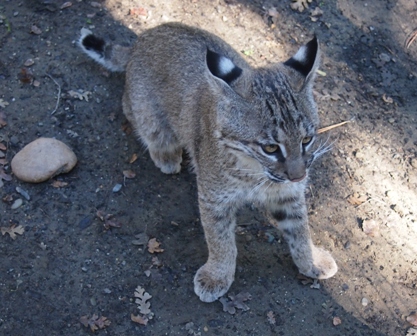 Bobcat kitten at Turtle Bay zoo[/caption]
Naked Tip:
If you notice an unusual number of apparently blissed out people wandering the streets of Redding quite likely they’re members of a former Assemblies of God church, now called Bethel Church. Espousing a kind of evangelical Christianity, Bethel Church is rather secretively run by a small hierarchy of church founders. The Bethel School of Supernatural Ministry attracts devotees from around the USA. Approximately 8,000 students attend the school while the church employs hundreds more. See www.bethelredding.com for more information. Many businesses in Redding employ Bethel Church goers. Places where visitors frequent such as motels, restaurants, bars and cafes are staffed by students attending the School of Supernatural Ministry. I inquired often and widely about how the church differentiates itself to other evangelical organisations but was never given a straightforward answer. My initial impression is that it’s a benign organisation that promotes world peace but I am less convinced by the simplistic adherence to doctrine interpreted by a select few church leaders. The church is also overwhelmingly white and middle class. Is it a cult? Of course it is but then I believe all religions are essentially cults run by hierarchies bent on retaining power no matter the spiritual cost incurred. Bethel College’s influence in Redding is overwhelming. Without it, the town’s economy would clearly suffer.
[caption id="attachment_3373" align="alignnone" width="419"]
Bobcat kitten at Turtle Bay zoo[/caption]
Naked Tip:
If you notice an unusual number of apparently blissed out people wandering the streets of Redding quite likely they’re members of a former Assemblies of God church, now called Bethel Church. Espousing a kind of evangelical Christianity, Bethel Church is rather secretively run by a small hierarchy of church founders. The Bethel School of Supernatural Ministry attracts devotees from around the USA. Approximately 8,000 students attend the school while the church employs hundreds more. See www.bethelredding.com for more information. Many businesses in Redding employ Bethel Church goers. Places where visitors frequent such as motels, restaurants, bars and cafes are staffed by students attending the School of Supernatural Ministry. I inquired often and widely about how the church differentiates itself to other evangelical organisations but was never given a straightforward answer. My initial impression is that it’s a benign organisation that promotes world peace but I am less convinced by the simplistic adherence to doctrine interpreted by a select few church leaders. The church is also overwhelmingly white and middle class. Is it a cult? Of course it is but then I believe all religions are essentially cults run by hierarchies bent on retaining power no matter the spiritual cost incurred. Bethel College’s influence in Redding is overwhelming. Without it, the town’s economy would clearly suffer.
[caption id="attachment_3373" align="alignnone" width="419"] Castle Lake under mist[/caption]
On my last day in Mount Shasta, I drove up to Castle Lake. When I was near Mount Shasta’s summit days before, I happened across a one-man-band beating a wide drum to a tune of his imagination. We were the only two people on the summit road that cold windy day. Sixty something and dressed like he’d spent most of his life reliving San Francisco’s ‘Summer of Love’, his face the colour of a smoked almond and virtually toothless. He reeked of weed was clearly stoned and at times incoherent. In short, he looked like a lot of people I’d noticed around Mount Shasta during previous days. He rambled on about how the mountain could change your life if you let it work its magic on your open mind. His tobacco stained fingers kept up a rhythmic beat on the brightly decorated drum while he strongly advised me to visit Castle Lake where I would see King Arthur’s sword and the Lady of the Lake.
[caption id="attachment_3374" align="alignnone" width="448"]
Castle Lake under mist[/caption]
On my last day in Mount Shasta, I drove up to Castle Lake. When I was near Mount Shasta’s summit days before, I happened across a one-man-band beating a wide drum to a tune of his imagination. We were the only two people on the summit road that cold windy day. Sixty something and dressed like he’d spent most of his life reliving San Francisco’s ‘Summer of Love’, his face the colour of a smoked almond and virtually toothless. He reeked of weed was clearly stoned and at times incoherent. In short, he looked like a lot of people I’d noticed around Mount Shasta during previous days. He rambled on about how the mountain could change your life if you let it work its magic on your open mind. His tobacco stained fingers kept up a rhythmic beat on the brightly decorated drum while he strongly advised me to visit Castle Lake where I would see King Arthur’s sword and the Lady of the Lake.
[caption id="attachment_3374" align="alignnone" width="448"] Clear waters of Castle Lake[/caption]
Why should I argue with someone so convinced I would see a legendary English hero in a Californian lake?
Alone at the end of the road again, I parked near Castle Lake’s shore. The water was so clear I could count the dead branches resting in deep water. An eerie wind blew snow flurries around like cold spirits looking for a nice place to get warm. I drew my coat collar closer round my neck asking myself why I had a compulsion to check out local superstition uttered by stoned drummers met on holy mountains.
Irresistible? Did I see Arthur’s sword or hear the Lady of the Lake’s song?
No. But I liked trying.
Mount Shasta is the sort of place where no one would question my motives.
[caption id="attachment_3382" align="alignnone" width="448"]
Clear waters of Castle Lake[/caption]
Why should I argue with someone so convinced I would see a legendary English hero in a Californian lake?
Alone at the end of the road again, I parked near Castle Lake’s shore. The water was so clear I could count the dead branches resting in deep water. An eerie wind blew snow flurries around like cold spirits looking for a nice place to get warm. I drew my coat collar closer round my neck asking myself why I had a compulsion to check out local superstition uttered by stoned drummers met on holy mountains.
Irresistible? Did I see Arthur’s sword or hear the Lady of the Lake’s song?
No. But I liked trying.
Mount Shasta is the sort of place where no one would question my motives.
[caption id="attachment_3382" align="alignnone" width="448"]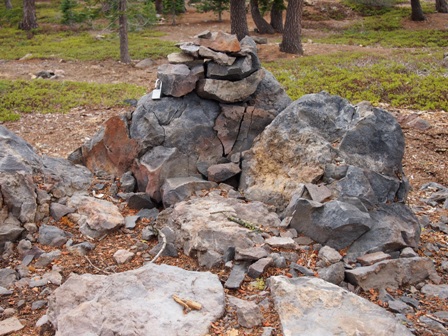 Stones with lock near Mount Shasta summit[/caption]
Tom Neal Tacker travelled as a guest of Visit California and the Shasta Cascade Wonderland Association.
Naked Facts:
Naked Routes:
Redding is a four to five hours easy drive north of San Francisco along Interstate Highway 5. Mount Shasta is an hour’s drive north of Redding along Interstate Highway 5. Redding’s surprisingly large airport is approximately 15 kilometres south of the city centre. Major car rental agencies (Hertz, Avis, Budget etc.) operate from the airport but hours are limited to meet the three daily flights from San Francisco. United Express is the only airline flying between San Francisco and Redding (1 hour flight time) and consequently fares are ridiculously expensive. Connections to other cities, including LA are via San Francisco. There’s a price paid for monopoly service. Guess who pays it? (Hint: That would be you customer.)
Naked Sleeps:
Mount Shasta Resort is a boutique luxury golf and eco-tourism resort on lovely grounds close to the western side of Mount Shasta town. I was lodged in a large fully self contained cabin among tall trees and visiting wildlife set overlooking the nearby shore of Lake Siskiyou. With a private entry and large back deck, a foyer with cloak wardrobe, fully equipped kitchen, large living and dining room with open fireplace, separate bedroom and well appointed bathroom, I could have moved in permanently and needed almost nothing except groceries, which the management would happily stock for guests who request supplies when they book. The cabins are separate from the main resort building and golf course approximately 300 metres up the road. A small spa operates on the premises but I didn't sample the treatments. I did dine one night at the resort, enjoyed the cooking but enjoyed the bar service more. It’s a very friendly place, well run by an exceptionally helpful team I would like to see at every hotel I stay in around the USA. See www.mountshastaresort.com
[caption id="attachment_3376" align="alignnone" width="448"]
Stones with lock near Mount Shasta summit[/caption]
Tom Neal Tacker travelled as a guest of Visit California and the Shasta Cascade Wonderland Association.
Naked Facts:
Naked Routes:
Redding is a four to five hours easy drive north of San Francisco along Interstate Highway 5. Mount Shasta is an hour’s drive north of Redding along Interstate Highway 5. Redding’s surprisingly large airport is approximately 15 kilometres south of the city centre. Major car rental agencies (Hertz, Avis, Budget etc.) operate from the airport but hours are limited to meet the three daily flights from San Francisco. United Express is the only airline flying between San Francisco and Redding (1 hour flight time) and consequently fares are ridiculously expensive. Connections to other cities, including LA are via San Francisco. There’s a price paid for monopoly service. Guess who pays it? (Hint: That would be you customer.)
Naked Sleeps:
Mount Shasta Resort is a boutique luxury golf and eco-tourism resort on lovely grounds close to the western side of Mount Shasta town. I was lodged in a large fully self contained cabin among tall trees and visiting wildlife set overlooking the nearby shore of Lake Siskiyou. With a private entry and large back deck, a foyer with cloak wardrobe, fully equipped kitchen, large living and dining room with open fireplace, separate bedroom and well appointed bathroom, I could have moved in permanently and needed almost nothing except groceries, which the management would happily stock for guests who request supplies when they book. The cabins are separate from the main resort building and golf course approximately 300 metres up the road. A small spa operates on the premises but I didn't sample the treatments. I did dine one night at the resort, enjoyed the cooking but enjoyed the bar service more. It’s a very friendly place, well run by an exceptionally helpful team I would like to see at every hotel I stay in around the USA. See www.mountshastaresort.com
[caption id="attachment_3376" align="alignnone" width="448"] Mount Shasta Resort cabin[/caption]
[caption id="attachment_3377" align="alignnone" width="439"]
Mount Shasta Resort cabin[/caption]
[caption id="attachment_3377" align="alignnone" width="439"] Mount Shasta Resort's beautiful landscaped gardens and golf course[/caption]
[caption id="attachment_3378" align="alignnone" width="369"]
Mount Shasta Resort's beautiful landscaped gardens and golf course[/caption]
[caption id="attachment_3378" align="alignnone" width="369"] Mount Shasta Resort chef dressed for Halloween[/caption]
The Fairfield Inn & Suites Marriott Redding is one of a number of utilitarian motels dotted along Interstate Highway 5 a few miles north of Redding’s CBD near the Bethel College campus. Put simply, these motels thrive because they offer good value accommodation in convenient locations next to major highways. While it’s lacking individuality or character, the rooms are clean and well maintained. What differentiates one of these motels from another is the quality of the employees. For this reason alone I can recommend this motel. From check in to check out, everyone I met was gracious and helpful. Breakfast was verging on dreadful (packaged everything and nothing cooked to order) but was made worthwhile because the lady running the operation was absolutely delightful. Had the food been as good as her sunny disposition I would recommend a side trip to this highway motel just for the catering. The managers adopted a stray cat named Jack who pays his room and board as an unofficial host. He made my stay even more enjoyable. See www.marriott.com/hotels/travel/rddre-fairfield-inn-and-suites-redding for information and bookings.
[caption id="attachment_3379" align="alignnone" width="336"]
Mount Shasta Resort chef dressed for Halloween[/caption]
The Fairfield Inn & Suites Marriott Redding is one of a number of utilitarian motels dotted along Interstate Highway 5 a few miles north of Redding’s CBD near the Bethel College campus. Put simply, these motels thrive because they offer good value accommodation in convenient locations next to major highways. While it’s lacking individuality or character, the rooms are clean and well maintained. What differentiates one of these motels from another is the quality of the employees. For this reason alone I can recommend this motel. From check in to check out, everyone I met was gracious and helpful. Breakfast was verging on dreadful (packaged everything and nothing cooked to order) but was made worthwhile because the lady running the operation was absolutely delightful. Had the food been as good as her sunny disposition I would recommend a side trip to this highway motel just for the catering. The managers adopted a stray cat named Jack who pays his room and board as an unofficial host. He made my stay even more enjoyable. See www.marriott.com/hotels/travel/rddre-fairfield-inn-and-suites-redding for information and bookings.
[caption id="attachment_3379" align="alignnone" width="336"]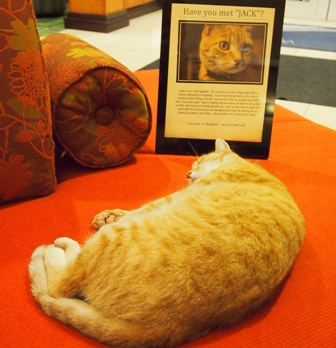 Jack catnapping at Fairview Suites Redding[/caption]
Naked Eats:
In Redding I tried two restaurants for dinner. Both were very good and I recommend them highly.
Jack’s Bar & Grill is in Redding’s downtown. This is the sort of place the USA does exceptionally well. Steaks and grilled chops are the go here. That and large cocktails, local colour, friendly service and an instant reminder of 50s Americana. I tackled a steak here and almost came out the winner. Small size America is large size everywhere else in the world. Don’t expect gourmet food at Jack’s. Instead you’ll get a no-nonsense plate of honestly prepared tucker comprised of best quality available ingredients. Jack’s Bar & Grill is open Monday to Saturday for dinner from 5pm, 1743 California Street, Redding, CA. Tel: (530) 241 9705 www.jacksgrillredding.com
View 202 restaurant is Redding’s fine diner. With a great location above the banks of the Sacramento River, its large back deck is the best spot in town to sip a well made cocktail while nibbling on hors d’oeuvres before heading inside to the capacious dining room for a splendid drawn out dinner cooked by a chef who knows what he’s doing. I really liked this place. Good food options in Redding are sparse. Dinner at View 202 is worth a night in Redding alone. It’s that good. View 202 is open 7 days for lunch and dinner. 202 Hemsted Ave. Redding, CA Tel: (530) 226 439 www.view202redding.com
[caption id="attachment_3380" align="alignnone" width="338"]
Jack catnapping at Fairview Suites Redding[/caption]
Naked Eats:
In Redding I tried two restaurants for dinner. Both were very good and I recommend them highly.
Jack’s Bar & Grill is in Redding’s downtown. This is the sort of place the USA does exceptionally well. Steaks and grilled chops are the go here. That and large cocktails, local colour, friendly service and an instant reminder of 50s Americana. I tackled a steak here and almost came out the winner. Small size America is large size everywhere else in the world. Don’t expect gourmet food at Jack’s. Instead you’ll get a no-nonsense plate of honestly prepared tucker comprised of best quality available ingredients. Jack’s Bar & Grill is open Monday to Saturday for dinner from 5pm, 1743 California Street, Redding, CA. Tel: (530) 241 9705 www.jacksgrillredding.com
View 202 restaurant is Redding’s fine diner. With a great location above the banks of the Sacramento River, its large back deck is the best spot in town to sip a well made cocktail while nibbling on hors d’oeuvres before heading inside to the capacious dining room for a splendid drawn out dinner cooked by a chef who knows what he’s doing. I really liked this place. Good food options in Redding are sparse. Dinner at View 202 is worth a night in Redding alone. It’s that good. View 202 is open 7 days for lunch and dinner. 202 Hemsted Ave. Redding, CA Tel: (530) 226 439 www.view202redding.com
[caption id="attachment_3380" align="alignnone" width="338"]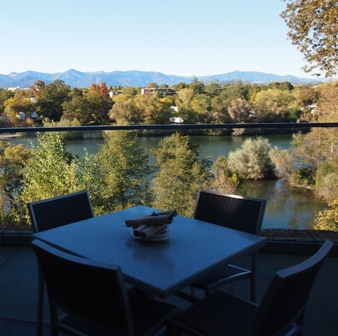 View 202 restaurant deck in Redding[/caption]
Mount Shasta and Dunsmuir towns punch well above their weight food and drinks wise.
I ate well at the Mount Shasta Resort (see above) and at the Trinity Cafe in Mount Shasta town. Trinity Cafe is small and absolutely delightful. Dining there was like coming to a friend’s house for dinner and being surprised at how good the food is. Owned and run by a gracious husband and wife team, Trinity Cafe is all about local produce cooked with fine attention to detail. Generosity of spirit is the modus operandi here. Open for dinner Wednesday to Saturday, 622 North Road, Mount Shasta, CA Tel: (530) 926 6200 www.trinitycafemountshasta.com
Also in Mount Shasta I enjoyed Seven Sons Coffee & Cafe for breakfast and a decent espresso. 1011 South Mount Shasta Blvd. Mount Shasta, CA Tel: (530) 926 9701
[caption id="attachment_3381" align="alignnone" width="441"]
View 202 restaurant deck in Redding[/caption]
Mount Shasta and Dunsmuir towns punch well above their weight food and drinks wise.
I ate well at the Mount Shasta Resort (see above) and at the Trinity Cafe in Mount Shasta town. Trinity Cafe is small and absolutely delightful. Dining there was like coming to a friend’s house for dinner and being surprised at how good the food is. Owned and run by a gracious husband and wife team, Trinity Cafe is all about local produce cooked with fine attention to detail. Generosity of spirit is the modus operandi here. Open for dinner Wednesday to Saturday, 622 North Road, Mount Shasta, CA Tel: (530) 926 6200 www.trinitycafemountshasta.com
Also in Mount Shasta I enjoyed Seven Sons Coffee & Cafe for breakfast and a decent espresso. 1011 South Mount Shasta Blvd. Mount Shasta, CA Tel: (530) 926 9701
[caption id="attachment_3381" align="alignnone" width="441"] Seven Sons cafe in Mount Shasta[/caption]
In Dunsmuir is the excellent Cafe Maddalena. I ate the best meal I had in northern California here. It’s a quirky joint, my kind of place actually. While the other restaurants I mention above are all well worth visiting, Cafe Maddalena struck a particularly impressive chord with me. There’s a fine line that needs crossing when a restaurateur moves from very good to exceptional. It’s the difference between competence and finesse. I only mention restaurants where competence is a given, otherwise why give them credit? I commend finesse when I see it. Cafe Maddalena served me an exceptional dinner with finesse. Open for dinner Thursday to Sunday from 5pm, 5801 Sacramento Ave. Dunsmuir, CA Tel: (530) 235 2725 www.cafemaddalena.com
Seven Sons cafe in Mount Shasta[/caption]
In Dunsmuir is the excellent Cafe Maddalena. I ate the best meal I had in northern California here. It’s a quirky joint, my kind of place actually. While the other restaurants I mention above are all well worth visiting, Cafe Maddalena struck a particularly impressive chord with me. There’s a fine line that needs crossing when a restaurateur moves from very good to exceptional. It’s the difference between competence and finesse. I only mention restaurants where competence is a given, otherwise why give them credit? I commend finesse when I see it. Cafe Maddalena served me an exceptional dinner with finesse. Open for dinner Thursday to Sunday from 5pm, 5801 Sacramento Ave. Dunsmuir, CA Tel: (530) 235 2725 www.cafemaddalena.com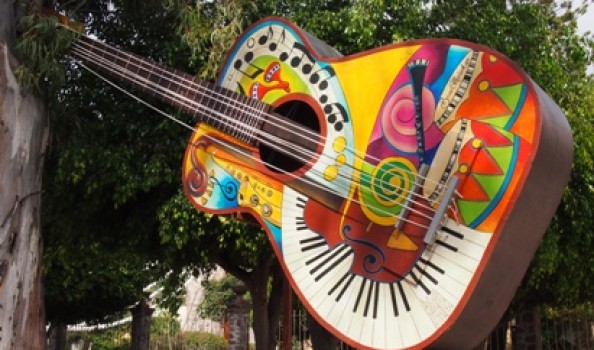 https://nakedhungrytraveller.com.au/mexico-magic/ Mexico MagicThe day began sunny and bright... again. No wonder this town is regularly nominated as having the world’s best climate. Ajijic is where the days and nights meld together in near perfect meteorological unity, a Goldilocks kind of town, not too hot, not too cold; just right. [caption id="attachment_3268" align="alignnone" width="448"]
https://nakedhungrytraveller.com.au/mexico-magic/ Mexico MagicThe day began sunny and bright... again. No wonder this town is regularly nominated as having the world’s best climate. Ajijic is where the days and nights meld together in near perfect meteorological unity, a Goldilocks kind of town, not too hot, not too cold; just right. [caption id="attachment_3268" align="alignnone" width="448"]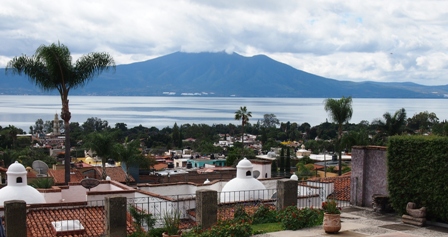 Lake Chapala at Ajijic[/caption]
This morning started at the weekly ‘tianguas’ market almost round the corner from the hotel. It's a weekly event that serves as a locus for growers and producers from most of the towns strung along the shores of Lake Chapala.
[caption id="attachment_3269" align="alignnone" width="252"]
Lake Chapala at Ajijic[/caption]
This morning started at the weekly ‘tianguas’ market almost round the corner from the hotel. It's a weekly event that serves as a locus for growers and producers from most of the towns strung along the shores of Lake Chapala.
[caption id="attachment_3269" align="alignnone" width="252"]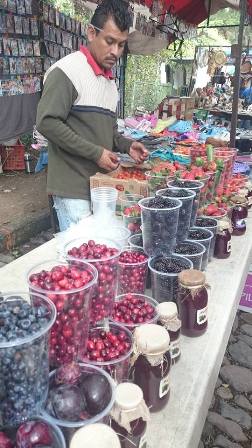 Fresh berries at the weekly tianguas[/caption]
Strawberries, raspberries, cherries and blackberries look luscious, dripping sweetness and glowing in the sunshine.
Fish trucked in fresh from nearby Puerto Vallarta array themselves in orderly school queues on ice. A large bonito looks as if it just jumped into the fishmonger’s arms, surprising them both.
[caption id="attachment_3270" align="alignnone" width="330"]
Fresh berries at the weekly tianguas[/caption]
Strawberries, raspberries, cherries and blackberries look luscious, dripping sweetness and glowing in the sunshine.
Fish trucked in fresh from nearby Puerto Vallarta array themselves in orderly school queues on ice. A large bonito looks as if it just jumped into the fishmonger’s arms, surprising them both.
[caption id="attachment_3270" align="alignnone" width="330"] Fishmonger at Ajijic tianguas[/caption]
Amongst the fruits, vegetables, meats and fish for sale are stalls selling freshly made tacos, tostadas and enchiladas. One of the busiest, a clear favourite with the locals, is doing a hot trade with tiny fried shrimp mixed with salsa and shredded cabbage, all rolled into a freshly made corn tortilla. I pay a few pesos and am rewarded with a flavour bomb: sweet prawns fried in their shells, a mildly spicy tomato salsa and cabbage with fresh lime squeezed overall. A tumbler of fresh pressed orange juice while I wait, large and coldly glistening with rivulets of condensed water washes it all down with gusto.
[caption id="attachment_3271" align="alignnone" width="252"]
Fishmonger at Ajijic tianguas[/caption]
Amongst the fruits, vegetables, meats and fish for sale are stalls selling freshly made tacos, tostadas and enchiladas. One of the busiest, a clear favourite with the locals, is doing a hot trade with tiny fried shrimp mixed with salsa and shredded cabbage, all rolled into a freshly made corn tortilla. I pay a few pesos and am rewarded with a flavour bomb: sweet prawns fried in their shells, a mildly spicy tomato salsa and cabbage with fresh lime squeezed overall. A tumbler of fresh pressed orange juice while I wait, large and coldly glistening with rivulets of condensed water washes it all down with gusto.
[caption id="attachment_3271" align="alignnone" width="252"]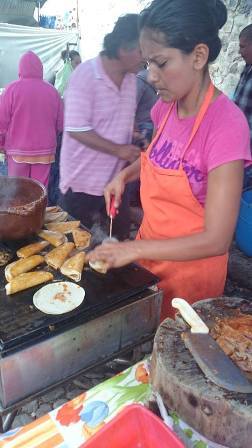 Tianguas tacos[/caption]
Later I watch a young man roasting coffee beans over a small fire before grinding them the old fashioned way using a hand operated contraption that looks like an heirloom from early last century. I buy a small cup of his cinnamon infused coffee, lean back against a tamarind tree and look up the long leaf canopied street that supports today’s ‘tianguas’, and am struck by a riot of colour and light.
[caption id="attachment_3272" align="alignnone" width="252"]
Tianguas tacos[/caption]
Later I watch a young man roasting coffee beans over a small fire before grinding them the old fashioned way using a hand operated contraption that looks like an heirloom from early last century. I buy a small cup of his cinnamon infused coffee, lean back against a tamarind tree and look up the long leaf canopied street that supports today’s ‘tianguas’, and am struck by a riot of colour and light.
[caption id="attachment_3272" align="alignnone" width="252"]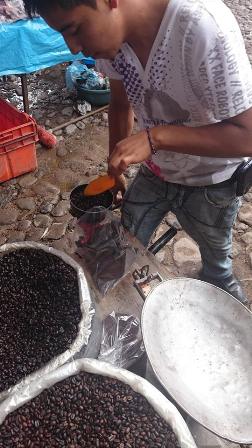 Tianguas coffee grinding[/caption]
Crafts and local arts are also on display. Curios of course, it’s a mixed bag of a market that offers something for everyone. Stopping at a CD stand, listening to a gentle guitar solo, I’m rapt. Something about the doleful sounds of Mexican classical guitar stirs me. If music evokes place, I’m in the right spot at the right time. I listen to that CD later (bought it of course) and feel guitar strumming pulling at my heartstrings.
[caption id="attachment_3273" align="alignnone" width="252"]
Tianguas coffee grinding[/caption]
Crafts and local arts are also on display. Curios of course, it’s a mixed bag of a market that offers something for everyone. Stopping at a CD stand, listening to a gentle guitar solo, I’m rapt. Something about the doleful sounds of Mexican classical guitar stirs me. If music evokes place, I’m in the right spot at the right time. I listen to that CD later (bought it of course) and feel guitar strumming pulling at my heartstrings.
[caption id="attachment_3273" align="alignnone" width="252"]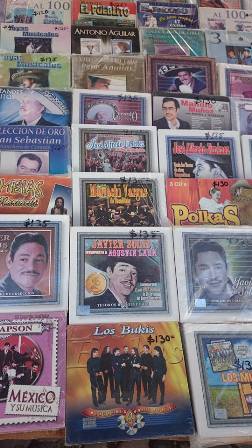 CDs for sale at tianguas[/caption]
Later that day while on a ‘Behind the Walls’ tour of a few grand haciendas highly respected for private art collections, emotions are stirred by the generosity shown by the owners who’ve opened their homes to complete strangers to benefit a worthy cause.
[caption id="attachment_3274" align="alignnone" width="273"]
CDs for sale at tianguas[/caption]
Later that day while on a ‘Behind the Walls’ tour of a few grand haciendas highly respected for private art collections, emotions are stirred by the generosity shown by the owners who’ve opened their homes to complete strangers to benefit a worthy cause.
[caption id="attachment_3274" align="alignnone" width="273"] Ajijic hacienda Behind the Walls[/caption]
The tour takes place only a few days of the year to coincide with the country’s largest artisan fair, the ‘Feria de Maestros del Arte’ (www.feriamaestros.com). Held in the public park at the Chapala Yacht Club (a grandiose term for the town marina), the fair is graciously spread out in lush gardens on the shore of the country’s largest lake, Chapala.
[caption id="attachment_3275" align="alignnone" width="336"]
Ajijic hacienda Behind the Walls[/caption]
The tour takes place only a few days of the year to coincide with the country’s largest artisan fair, the ‘Feria de Maestros del Arte’ (www.feriamaestros.com). Held in the public park at the Chapala Yacht Club (a grandiose term for the town marina), the fair is graciously spread out in lush gardens on the shore of the country’s largest lake, Chapala.
[caption id="attachment_3275" align="alignnone" width="336"] Textiles artist at the Feria[/caption]
Both the ‘Feria’ and the ‘Behind the Walls’ tours are non-profit and run by dedicated volunteers.
[caption id="attachment_3321" align="alignnone" width="448"]
Textiles artist at the Feria[/caption]
Both the ‘Feria’ and the ‘Behind the Walls’ tours are non-profit and run by dedicated volunteers.
[caption id="attachment_3321" align="alignnone" width="448"] Ceramics for sale at the Feria[/caption]
The ‘Behind the Walls’ tours’ monies go to a local school for kids with disabilities.
[caption id="attachment_3277" align="alignnone" width="402"]
Ceramics for sale at the Feria[/caption]
The ‘Behind the Walls’ tours’ monies go to a local school for kids with disabilities.
[caption id="attachment_3277" align="alignnone" width="402"]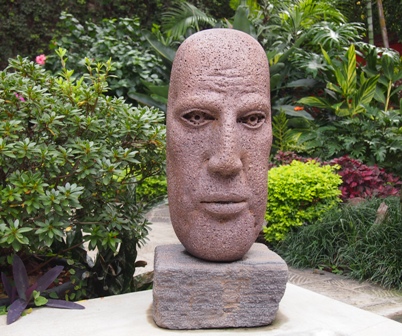 Behind the Walls garden sculpture[/caption]
The ‘Feria’ profits go directly to all the artists involved, no middle men allowed.
[caption id="attachment_3276" align="alignnone" width="336"]
Behind the Walls garden sculpture[/caption]
The ‘Feria’ profits go directly to all the artists involved, no middle men allowed.
[caption id="attachment_3276" align="alignnone" width="336"] Feria artist with ceramics[/caption]
The most recent ‘Feria’ drew in over 80 different artists from all over Mexico. Masters in ceramics, textiles, sculpture, painting, weaving and metalwork... all the major arts media are represented.
The fair was begun by an extraordinarily devoted and passionate woman who settled in Ajijic over two decades ago, Marianne Coulson.
[caption id="attachment_3278" align="alignnone" width="416"]
Feria artist with ceramics[/caption]
The most recent ‘Feria’ drew in over 80 different artists from all over Mexico. Masters in ceramics, textiles, sculpture, painting, weaving and metalwork... all the major arts media are represented.
The fair was begun by an extraordinarily devoted and passionate woman who settled in Ajijic over two decades ago, Marianne Coulson.
[caption id="attachment_3278" align="alignnone" width="416"]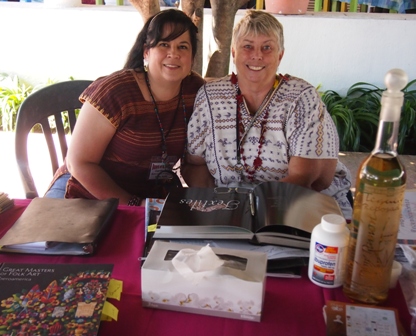 L Volunteer Board Member Diana Ayala R Board Director Marianne Coulson at the Feria[/caption]
Marianne wanted to ensure Mexico’s authentic arts and crafts traditions were not lost to large scale production while mass media focussed on a few big names at the expense of other equally talented artists who live in remote communities without access to flashy marketing or expensive advertising.
[caption id="attachment_3279" align="alignnone" width="314"]
L Volunteer Board Member Diana Ayala R Board Director Marianne Coulson at the Feria[/caption]
Marianne wanted to ensure Mexico’s authentic arts and crafts traditions were not lost to large scale production while mass media focussed on a few big names at the expense of other equally talented artists who live in remote communities without access to flashy marketing or expensive advertising.
[caption id="attachment_3279" align="alignnone" width="314"]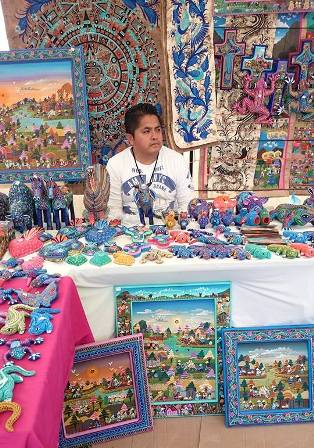 Feria artist with paintings[/caption]
Many of the artists are from tiny villages in far-flung mountain towns where Spanish is not spoken much less English, and electricity and running water are infrequently available.
[caption id="attachment_3280" align="alignnone" width="336"]
Feria artist with paintings[/caption]
Many of the artists are from tiny villages in far-flung mountain towns where Spanish is not spoken much less English, and electricity and running water are infrequently available.
[caption id="attachment_3280" align="alignnone" width="336"]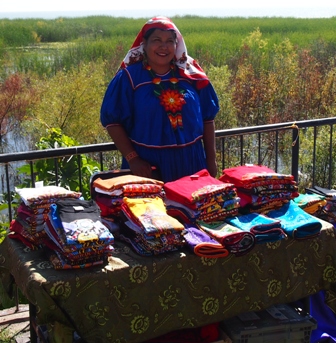 Feria textile artist at lakeside stall[/caption]
Over the years Marianne has gathered round her a loyal following of volunteers. The event has grown so large it’s beyond one person’s capacity to manage. The three day show attracts thousands of visitors from all round Mexico and abroad.
[caption id="attachment_3282" align="alignnone" width="370"]
Feria textile artist at lakeside stall[/caption]
Over the years Marianne has gathered round her a loyal following of volunteers. The event has grown so large it’s beyond one person’s capacity to manage. The three day show attracts thousands of visitors from all round Mexico and abroad.
[caption id="attachment_3282" align="alignnone" width="370"]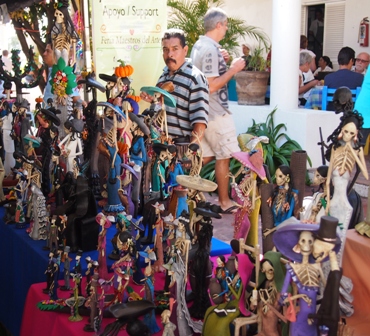 Feria Day of the Dead figurines[/caption]
The good people of Ajijic house and feed all the visiting artists, who don’t pay for their involvement but are treated as honoured guests. From these connections, long lasting friendships are founded.
‘Behind the Walls’ owners open their beautiful homes to strangers a couple times a year as a fundraiser for kids with disabilities, providing them with a school and specialist teachers.
[caption id="attachment_3283" align="alignnone" width="262"]
Feria Day of the Dead figurines[/caption]
The good people of Ajijic house and feed all the visiting artists, who don’t pay for their involvement but are treated as honoured guests. From these connections, long lasting friendships are founded.
‘Behind the Walls’ owners open their beautiful homes to strangers a couple times a year as a fundraiser for kids with disabilities, providing them with a school and specialist teachers.
[caption id="attachment_3283" align="alignnone" width="262"]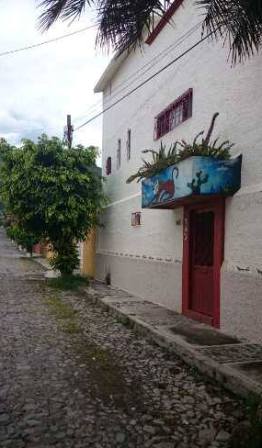 Behind these walls arts and gardens await[/caption]
The houses we visited varied from a converted 16th century convent (chapel still intact) to a sleek 21st century showpiece with large windows and clean angular lines. All the homes boast art that reflect their owner’s taste and collected during travels around Mexico.
[caption id="attachment_3322" align="alignnone" width="336"]
Behind these walls arts and gardens await[/caption]
The houses we visited varied from a converted 16th century convent (chapel still intact) to a sleek 21st century showpiece with large windows and clean angular lines. All the homes boast art that reflect their owner’s taste and collected during travels around Mexico.
[caption id="attachment_3322" align="alignnone" width="336"] Ceramic head for sale at the Feria[/caption]
We spent the day like old friends invited over for cool drinks and a warm chat.
After a week in Ajijic, I realise this town on Mexico’s largest lake is different to all others I’ve come to know over many years travelling.
The peaceful surrounds and natural beauty attracts a significant number of ex-pats, mostly from the USA and Canada but also from the UK, Europe and surprisingly... Australia. The cost of living is cheaper here.
[caption id="attachment_3285" align="alignnone" width="415"]
Ceramic head for sale at the Feria[/caption]
We spent the day like old friends invited over for cool drinks and a warm chat.
After a week in Ajijic, I realise this town on Mexico’s largest lake is different to all others I’ve come to know over many years travelling.
The peaceful surrounds and natural beauty attracts a significant number of ex-pats, mostly from the USA and Canada but also from the UK, Europe and surprisingly... Australia. The cost of living is cheaper here.
[caption id="attachment_3285" align="alignnone" width="415"]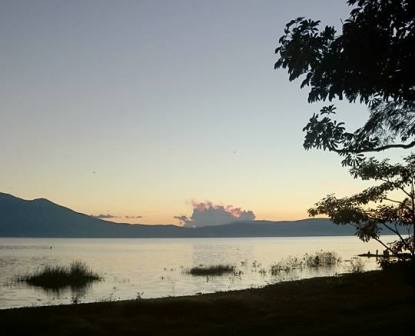 Lake Chapala from Nueva Posada hotel[/caption]
At over 1,600 metres altitude, Ajijic is recognised by National Geographic magazine as having one of the three best climates in the world.
[caption id="attachment_3323" align="alignnone" width="270"]
Lake Chapala from Nueva Posada hotel[/caption]
At over 1,600 metres altitude, Ajijic is recognised by National Geographic magazine as having one of the three best climates in the world.
[caption id="attachment_3323" align="alignnone" width="270"] Pancho Villa mural in Ajijic[/caption]
Despite Mexico’s ongoing struggle with narco-gang warfare (claiming over 50,000 lives since 2000), Ajijic and the area around Lake Chapala has remained relatively unscathed. Burglaries are rare. Violent crime is almost non-existent.
[caption id="attachment_3286" align="alignnone" width="178"]
Pancho Villa mural in Ajijic[/caption]
Despite Mexico’s ongoing struggle with narco-gang warfare (claiming over 50,000 lives since 2000), Ajijic and the area around Lake Chapala has remained relatively unscathed. Burglaries are rare. Violent crime is almost non-existent.
[caption id="attachment_3286" align="alignnone" width="178"]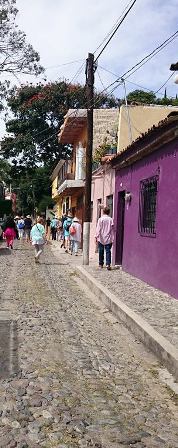 Ajijic street near Nueva Posada hotel[/caption]
Unlike ex-pat dominated towns in other parts of the world I’ve visited where cashed up outsiders live behind gilt gated estates protected by uniformed and armed security guards, Ajijic, Chapala and neighbouring towns have a much more integrated society.
[caption id="attachment_3287" align="alignnone" width="336"]
Ajijic street near Nueva Posada hotel[/caption]
Unlike ex-pat dominated towns in other parts of the world I’ve visited where cashed up outsiders live behind gilt gated estates protected by uniformed and armed security guards, Ajijic, Chapala and neighbouring towns have a much more integrated society.
[caption id="attachment_3287" align="alignnone" width="336"] Baby face mural in Ajijic[/caption]
I’ve never witnessed such large scale involvement in local affairs as I’ve seen here. The Mexican federal government is frugal with its education, environment and infrastructure funds so local people have stepped up to offer their help, establishing arts scholarships for students whose parents can’t afford tertiary education, environmental protection groups who safeguard the mountain forests surrounding the lake to preserve the watershed, animal protection groups to protect and sterilise all stray dogs and cats, finding them homes and helping local people to understand the importance of animal welfare. The aforementioned school for kids with disabilities is one of their most impressive projects.
[caption id="attachment_3288" align="alignnone" width="448"]
Baby face mural in Ajijic[/caption]
I’ve never witnessed such large scale involvement in local affairs as I’ve seen here. The Mexican federal government is frugal with its education, environment and infrastructure funds so local people have stepped up to offer their help, establishing arts scholarships for students whose parents can’t afford tertiary education, environmental protection groups who safeguard the mountain forests surrounding the lake to preserve the watershed, animal protection groups to protect and sterilise all stray dogs and cats, finding them homes and helping local people to understand the importance of animal welfare. The aforementioned school for kids with disabilities is one of their most impressive projects.
[caption id="attachment_3288" align="alignnone" width="448"] Mural in Ajijic[/caption]
In the centre of Ajijic, The Lake Chapala Society occupies what was once a private hacienda. Frequent art shows fill its gardens, films nights are popular and the whole small complex is open to visitors looking to engage with local people. It’s a nice place just to hang out. You never know who you’ll meet, a famous artist one day, a backpacking vagabond the next. All are welcome but the primary focus of the Society is to serve as a conduit for social benefit and charitable works.
[caption id="attachment_3289" align="alignnone" width="448"]
Mural in Ajijic[/caption]
In the centre of Ajijic, The Lake Chapala Society occupies what was once a private hacienda. Frequent art shows fill its gardens, films nights are popular and the whole small complex is open to visitors looking to engage with local people. It’s a nice place just to hang out. You never know who you’ll meet, a famous artist one day, a backpacking vagabond the next. All are welcome but the primary focus of the Society is to serve as a conduit for social benefit and charitable works.
[caption id="attachment_3289" align="alignnone" width="448"]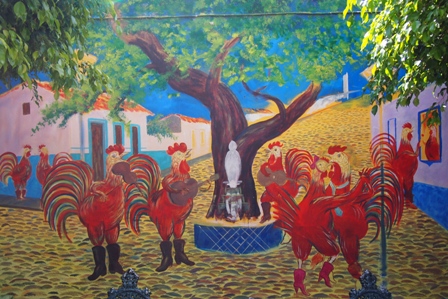 Chicken musicians and dancers mural[/caption]
The elaborate colourful painted murals you see on countless Ajijic walls clearly show how seriously this town takes its arts. Without private support, the murals wouldn’t be here. I’ve never seen so much public art in one small place.
[caption id="attachment_3290" align="alignnone" width="336"]
Chicken musicians and dancers mural[/caption]
The elaborate colourful painted murals you see on countless Ajijic walls clearly show how seriously this town takes its arts. Without private support, the murals wouldn’t be here. I’ve never seen so much public art in one small place.
[caption id="attachment_3290" align="alignnone" width="336"]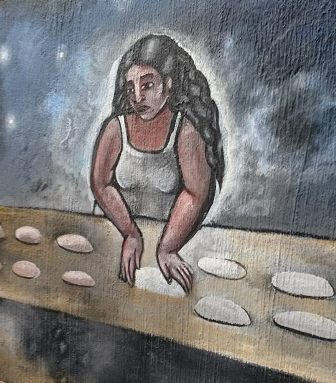 Bread making mural[/caption]
The ex-pat community also put its considerable energies into promoting local events such as the ‘Feria de Maestros del Arte’. Architectural preservation groups work hard to ensure Ajijic’s extraordinary assortment of centuries old colonial architecture is saved from insensitive development.
All this enthusiasm and respect for the region has resulted in a lively community that embraces the arts, music, good food and lots of social interaction.
[caption id="attachment_3324" align="alignnone" width="336"]
Bread making mural[/caption]
The ex-pat community also put its considerable energies into promoting local events such as the ‘Feria de Maestros del Arte’. Architectural preservation groups work hard to ensure Ajijic’s extraordinary assortment of centuries old colonial architecture is saved from insensitive development.
All this enthusiasm and respect for the region has resulted in a lively community that embraces the arts, music, good food and lots of social interaction.
[caption id="attachment_3324" align="alignnone" width="336"]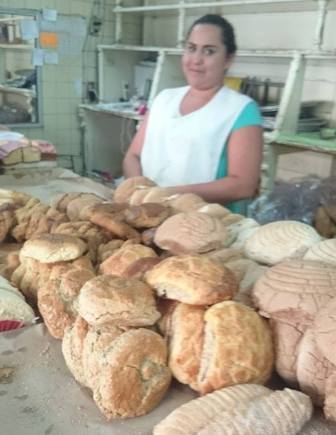 Bread shop in Ajijic[/caption]
Maybe the sense of social responsibility is in the air?
Breathe it in long enough and feel compelled to be involved?
I can’t explain it otherwise though Ajijic’s history is infused with a very strong sense of community involvement.
[caption id="attachment_3291" align="alignnone" width="298"]
Bread shop in Ajijic[/caption]
Maybe the sense of social responsibility is in the air?
Breathe it in long enough and feel compelled to be involved?
I can’t explain it otherwise though Ajijic’s history is infused with a very strong sense of community involvement.
[caption id="attachment_3291" align="alignnone" width="298"] Revolutionary heroes mural[/caption]
Before the Spanish invaders came to this part of Mexico early in the 16th century, Lake Chapala was already a spiritual centre. The lake fed its surrounding inhabitants with fish, waterfowl and insects (the larvae of lake flies were a popular food source, known at ‘ahuatli’ in the indigenous Nuahatl language, still spoken in remote areas in Jalisco and other mountainous provinces).
[caption id="attachment_3292" align="alignnone" width="421"]
Revolutionary heroes mural[/caption]
Before the Spanish invaders came to this part of Mexico early in the 16th century, Lake Chapala was already a spiritual centre. The lake fed its surrounding inhabitants with fish, waterfowl and insects (the larvae of lake flies were a popular food source, known at ‘ahuatli’ in the indigenous Nuahatl language, still spoken in remote areas in Jalisco and other mountainous provinces).
[caption id="attachment_3292" align="alignnone" width="421"]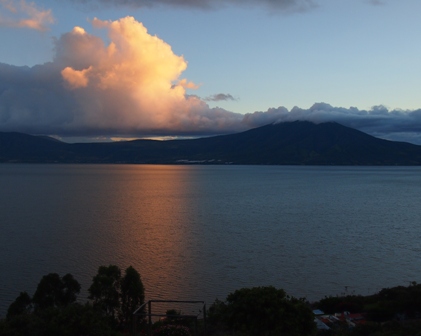 Lake Chapala sunset[/caption]
The Nueva Posada hotel has generously posted on its website a concise summary of the Nuahatl history of Lake Chapala: ‘Ajijic´s history dates back to a long time before the Spanish conquest. Descendents of the ancient Nahuatl tribe established themselves around the shores of Lake Chapala.
[caption id="attachment_3293" align="alignnone" width="381"]
Lake Chapala sunset[/caption]
The Nueva Posada hotel has generously posted on its website a concise summary of the Nuahatl history of Lake Chapala: ‘Ajijic´s history dates back to a long time before the Spanish conquest. Descendents of the ancient Nahuatl tribe established themselves around the shores of Lake Chapala.
[caption id="attachment_3293" align="alignnone" width="381"] Sangria de Mayo historic mural[/caption]
It is said that the first Nahuatl Indian arose from ashes on Mezcala Island. The island is now considered one of the four cardinal points in Nahuatl mythology.
Axixic in the ancient Nahuatl tongue means ¨Place where water is born¨ or ¨Place where water bubbles up.¨ This was mainly due to abundant natural springs of water that existed here many years ago.
[caption id="attachment_3294" align="alignnone" width="336"]
Sangria de Mayo historic mural[/caption]
It is said that the first Nahuatl Indian arose from ashes on Mezcala Island. The island is now considered one of the four cardinal points in Nahuatl mythology.
Axixic in the ancient Nahuatl tongue means ¨Place where water is born¨ or ¨Place where water bubbles up.¨ This was mainly due to abundant natural springs of water that existed here many years ago.
[caption id="attachment_3294" align="alignnone" width="336"]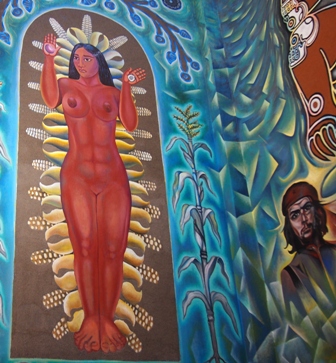 Goddess mural in Ajijic Town Hall[/caption]
Ajijic was renamed and founded by the Spaniards in 1531 and is one of the oldest villages in western Mexico. The conquest of the Chapalteco Sea as it was known back then, was accomplished by Sir Alonso Dávalos, and the conversion of natives to Christianity was the responsibility of father Fray Martín de Jesús, thus establishing Ajijic as one of the oldest convent towns in western Mexico. The convent was originally established in honour of Saint Francis of Assisi, but at a later date Saint Andrew became our patron Saint and still is to this day.’
[caption id="attachment_3295" align="alignnone" width="362"]
Goddess mural in Ajijic Town Hall[/caption]
Ajijic was renamed and founded by the Spaniards in 1531 and is one of the oldest villages in western Mexico. The conquest of the Chapalteco Sea as it was known back then, was accomplished by Sir Alonso Dávalos, and the conversion of natives to Christianity was the responsibility of father Fray Martín de Jesús, thus establishing Ajijic as one of the oldest convent towns in western Mexico. The convent was originally established in honour of Saint Francis of Assisi, but at a later date Saint Andrew became our patron Saint and still is to this day.’
[caption id="attachment_3295" align="alignnone" width="362"]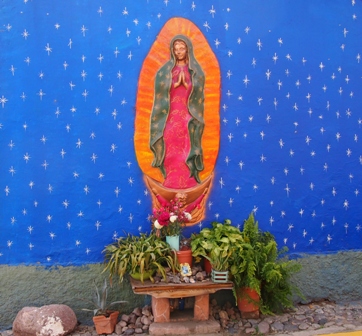 Virgin Mary mural[/caption]
It’s a place where the old stone speak, particularly at night when the majority of hard working Ajijic residents sleep.
[caption id="attachment_3296" align="alignnone" width="216"]
Virgin Mary mural[/caption]
It’s a place where the old stone speak, particularly at night when the majority of hard working Ajijic residents sleep.
[caption id="attachment_3296" align="alignnone" width="216"]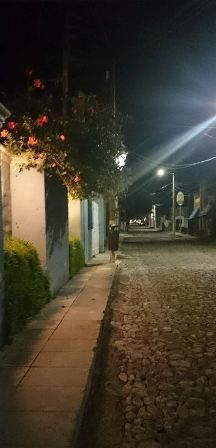 Night scene in Ajijic[/caption]
Wandering the streets at night became an occasional pastime. Being a rural village, most inhabitants are ‘early to bed, early to rise’. Suffering from a bout of insomnia, a long walk proved the best cure for my sleeplessness while enjoying the quiet nights, perusing the town’s murals or gazing over the lake all aglow in moonlight.
When a hoof strikes a cobblestone on a dead quiet night the familiar ‘clip-clop’ can’t be anything else.
[caption id="attachment_3297" align="alignnone" width="336"]
Night scene in Ajijic[/caption]
Wandering the streets at night became an occasional pastime. Being a rural village, most inhabitants are ‘early to bed, early to rise’. Suffering from a bout of insomnia, a long walk proved the best cure for my sleeplessness while enjoying the quiet nights, perusing the town’s murals or gazing over the lake all aglow in moonlight.
When a hoof strikes a cobblestone on a dead quiet night the familiar ‘clip-clop’ can’t be anything else.
[caption id="attachment_3297" align="alignnone" width="336"]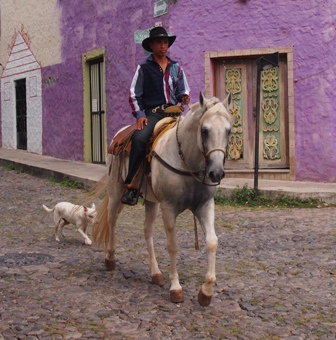 Horse and rider in daylight[/caption]
Seconds later, a horse appeared from behind the corner, its rider barely awake in the saddle. I say a quiet ‘Buenos noches’ and hear a grunted reply, ‘Noches’, from an old man, face hidden under a wide sombrero, serapi wrapped round his shoulders to ward off the night chill. He didn’t stop to chat.
I’d just left Tom’s Bar a short walk from the hotel, believing it was my sworn duty to check it out. Ten minutes desultory conversation was enough. A boring cricket-fixated dad and son duo touring from the UK couldn’t explain to me how Mexico fits into the global cricket scene (it doesn’t) was interspersed with hiccups and inane comments muttered by a hairy ex-pat Yankee regular who’d seen the bottoms of too many Tecate bottles. The bartender, acting as manager while the absentee owner was in Toronto, was clearly enjoying liberal access to what remained of the bar’s top shelf spirits. The whole scene left me feeling I’d missed the best part of a night at Tom’s Bar. I decided to amble back to the hotel, insomnia nearly cured.
[caption id="attachment_3298" align="alignnone" width="221"]
Horse and rider in daylight[/caption]
Seconds later, a horse appeared from behind the corner, its rider barely awake in the saddle. I say a quiet ‘Buenos noches’ and hear a grunted reply, ‘Noches’, from an old man, face hidden under a wide sombrero, serapi wrapped round his shoulders to ward off the night chill. He didn’t stop to chat.
I’d just left Tom’s Bar a short walk from the hotel, believing it was my sworn duty to check it out. Ten minutes desultory conversation was enough. A boring cricket-fixated dad and son duo touring from the UK couldn’t explain to me how Mexico fits into the global cricket scene (it doesn’t) was interspersed with hiccups and inane comments muttered by a hairy ex-pat Yankee regular who’d seen the bottoms of too many Tecate bottles. The bartender, acting as manager while the absentee owner was in Toronto, was clearly enjoying liberal access to what remained of the bar’s top shelf spirits. The whole scene left me feeling I’d missed the best part of a night at Tom’s Bar. I decided to amble back to the hotel, insomnia nearly cured.
[caption id="attachment_3298" align="alignnone" width="221"]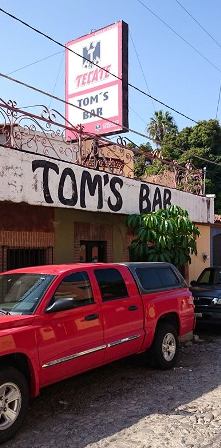 Tom's Bar in Ajijic[/caption]
The day had been long and filled with mental and physical activity but still I found it difficult to relax. My head spun with images from that day and the preceding week. Ever since arriving in tiny Ajijic, I’d been caught up in a whirlwind of enlivened imagination and delightful reality.
Taking the long way back to my hotel, I stopped to look at a few familiar murals, thinking they’d look different in the moonlight. The bright colours weren’t nearly as vibrant as they were in strong daylight, but I liked the subtler effect softer light evoked.
The horse popped into my wandering like an apparition from Pancho Villa’s days when this region in central Mexico fought for its freedom against Spanish occupation and economic rule by a greedy oligarchy.
Jalisco is one of Mexico’s most historic states. Ajijic is one of Jalisco’s most important villages.
[caption id="attachment_3319" align="alignnone" width="412"]
Tom's Bar in Ajijic[/caption]
The day had been long and filled with mental and physical activity but still I found it difficult to relax. My head spun with images from that day and the preceding week. Ever since arriving in tiny Ajijic, I’d been caught up in a whirlwind of enlivened imagination and delightful reality.
Taking the long way back to my hotel, I stopped to look at a few familiar murals, thinking they’d look different in the moonlight. The bright colours weren’t nearly as vibrant as they were in strong daylight, but I liked the subtler effect softer light evoked.
The horse popped into my wandering like an apparition from Pancho Villa’s days when this region in central Mexico fought for its freedom against Spanish occupation and economic rule by a greedy oligarchy.
Jalisco is one of Mexico’s most historic states. Ajijic is one of Jalisco’s most important villages.
[caption id="attachment_3319" align="alignnone" width="412"]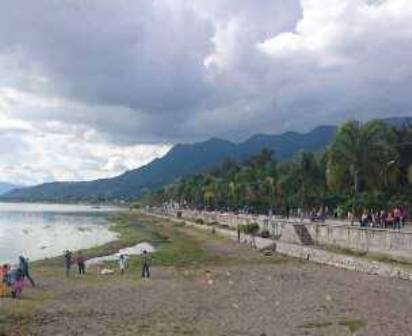 Ajijic Malecon on Lake Chapala[/caption]
For visitors keen to understand why Mexico is special, there aren’t many other villages better placed to foster that understanding.
After a lot of research and previous visits, we settled on Ajijic and Jalisco as the best first option.
This was the first tour we’d run in Mexico, a combination of luck and hard work.
[caption id="attachment_3318" align="alignnone" width="251"]
Ajijic Malecon on Lake Chapala[/caption]
For visitors keen to understand why Mexico is special, there aren’t many other villages better placed to foster that understanding.
After a lot of research and previous visits, we settled on Ajijic and Jalisco as the best first option.
This was the first tour we’d run in Mexico, a combination of luck and hard work.
[caption id="attachment_3318" align="alignnone" width="251"] Ajijic shop owner selling ceramic pots[/caption]
We chose Ajijic as our base for ten days of cultural immersion with lots of arts, history, great food and more interaction with interesting locals than you could shake a mariachi at.
From Ajijic, day trips to Guadalajara, Tlaquepaque and Tequila are easily accomplished.
Tlaquepaque, essentially an outer Guadalajara suburb, was once a separate village. Typically for Mexico, a large Catholic cathedral dominates the main square, sharing it with the ‘Municipalidad’ (Town Hall) whose porticos offer plenty of shade from the sun.
[caption id="attachment_3299" align="alignnone" width="313"]
Ajijic shop owner selling ceramic pots[/caption]
We chose Ajijic as our base for ten days of cultural immersion with lots of arts, history, great food and more interaction with interesting locals than you could shake a mariachi at.
From Ajijic, day trips to Guadalajara, Tlaquepaque and Tequila are easily accomplished.
Tlaquepaque, essentially an outer Guadalajara suburb, was once a separate village. Typically for Mexico, a large Catholic cathedral dominates the main square, sharing it with the ‘Municipalidad’ (Town Hall) whose porticos offer plenty of shade from the sun.
[caption id="attachment_3299" align="alignnone" width="313"]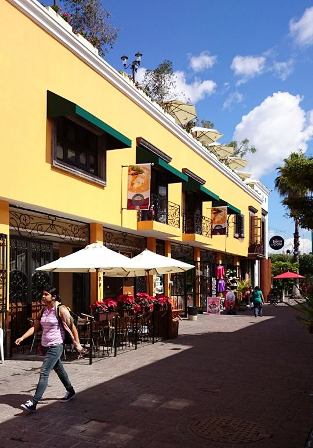 Tlaquepaque street scene[/caption]
[caption id="attachment_3317" align="alignnone" width="207"]
Tlaquepaque street scene[/caption]
[caption id="attachment_3317" align="alignnone" width="207"]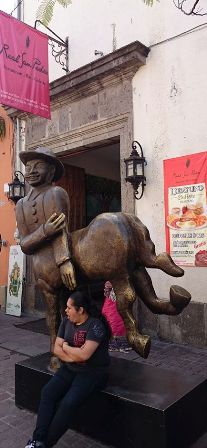 Tlaquepaque centaur sculpture[/caption]
Narrow streets are lined with dozens of art galleries filled with curios and antiques. Clothing boutiques, cafes and restaurants vie for attention. Tlaquepaque is a stroller’s ideal, wandering back streets leads to new discoveries, here a discount perfume shop, there another art gallery with prices cheaper than those in the main upscale shopping street, cantinas where locals munch on ‘totopos’ (corn chips) dipped in salsa.
[caption id="attachment_3316" align="alignnone" width="336"]
Tlaquepaque centaur sculpture[/caption]
Narrow streets are lined with dozens of art galleries filled with curios and antiques. Clothing boutiques, cafes and restaurants vie for attention. Tlaquepaque is a stroller’s ideal, wandering back streets leads to new discoveries, here a discount perfume shop, there another art gallery with prices cheaper than those in the main upscale shopping street, cantinas where locals munch on ‘totopos’ (corn chips) dipped in salsa.
[caption id="attachment_3316" align="alignnone" width="336"] Tlaquepaque waiter with angel wings[/caption]
[caption id="attachment_3300" align="alignnone" width="252"]
Tlaquepaque waiter with angel wings[/caption]
[caption id="attachment_3300" align="alignnone" width="252"]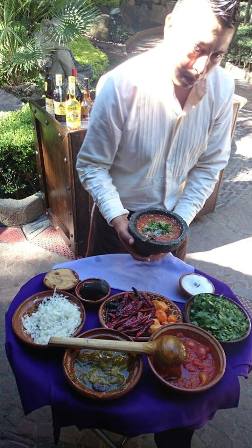 Guacamole and salsa freshly made at the table[/caption]
Waiting for a trio of chicken, bean or pork tacos doused with hot-as-hell salsa verde while sipping from huge tumblers of ‘horchata’ (almond milk drink) or frosty bottles of Coca-Cola, it’s cheap as proverbial chips and a chance to mingle with locals enjoying an inexpensive lunch.
(By the way, Mexicans drink more cola per capita than anywhere else in the world. Diabetes is more common here than anywhere else in the world as a consequence.)
Tequila is one of Mexico’s ‘Magic Villages’, an official tourism description denoting specially selected towns of historic and cultural significance.
It’s also the home to the beverage that bears its name.
On the high dry plains surrounding the Tequila town, thousands of blue agave plants are cultivated. Blue agave is the key ingredient for the distillation of authentic tequila.
[caption id="attachment_3301" align="alignnone" width="427"]
Guacamole and salsa freshly made at the table[/caption]
Waiting for a trio of chicken, bean or pork tacos doused with hot-as-hell salsa verde while sipping from huge tumblers of ‘horchata’ (almond milk drink) or frosty bottles of Coca-Cola, it’s cheap as proverbial chips and a chance to mingle with locals enjoying an inexpensive lunch.
(By the way, Mexicans drink more cola per capita than anywhere else in the world. Diabetes is more common here than anywhere else in the world as a consequence.)
Tequila is one of Mexico’s ‘Magic Villages’, an official tourism description denoting specially selected towns of historic and cultural significance.
It’s also the home to the beverage that bears its name.
On the high dry plains surrounding the Tequila town, thousands of blue agave plants are cultivated. Blue agave is the key ingredient for the distillation of authentic tequila.
[caption id="attachment_3301" align="alignnone" width="427"]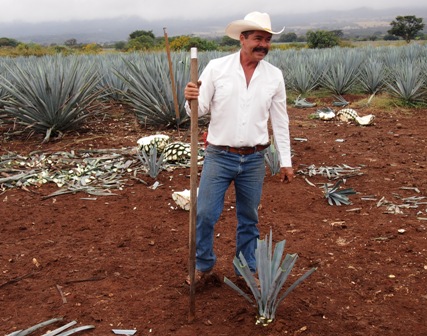 Harvesting blue agave near Tequila town[/caption]
Most of the tequila sold round the world is mixed with sugar cane spirit, more a rum/tequila mix than real tequila. Check the label; it should read ‘Tequila 100% puro agave’. If not it’s a ‘tequila mixto’ which requires only 51% agave, the remainder comprised of sugar cane spirit, caramel colour, oak extract flavouring, glycerine and other sugar based flavourings.
Aged tequila is like cognac and should be savoured. Lime and salt isn’t part of the tradition.
Visiting one of the oldest distilleries in the region, Don Jose Cuervo, we taste a range of its best tequilas: Tequila Silver, (Plata) or White (Platinum), un-aged tequila in its purest form. Reposado Tequila is aged in oak barrels from two months up to eleven months and has a good balance between wood and blue agave flavours. Anejo (Aged) Tequila is aged in oak barrels of no more than 600 litres size for at least one year and is golden hued. ‘Extra Anejo’ (more than two years in barrels) is rare, similar finesse to an aged Cognac and lip-smacking delicious.
[caption id="attachment_3302" align="alignnone" width="448"]
Harvesting blue agave near Tequila town[/caption]
Most of the tequila sold round the world is mixed with sugar cane spirit, more a rum/tequila mix than real tequila. Check the label; it should read ‘Tequila 100% puro agave’. If not it’s a ‘tequila mixto’ which requires only 51% agave, the remainder comprised of sugar cane spirit, caramel colour, oak extract flavouring, glycerine and other sugar based flavourings.
Aged tequila is like cognac and should be savoured. Lime and salt isn’t part of the tradition.
Visiting one of the oldest distilleries in the region, Don Jose Cuervo, we taste a range of its best tequilas: Tequila Silver, (Plata) or White (Platinum), un-aged tequila in its purest form. Reposado Tequila is aged in oak barrels from two months up to eleven months and has a good balance between wood and blue agave flavours. Anejo (Aged) Tequila is aged in oak barrels of no more than 600 litres size for at least one year and is golden hued. ‘Extra Anejo’ (more than two years in barrels) is rare, similar finesse to an aged Cognac and lip-smacking delicious.
[caption id="attachment_3302" align="alignnone" width="448"]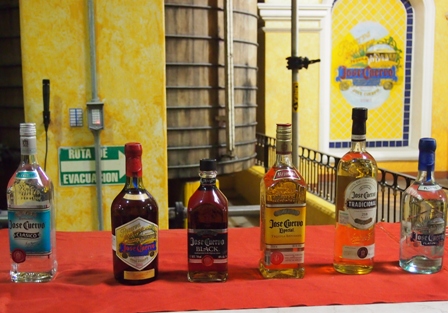 Don Jose Cuervo tequilas[/caption]
‘Tequila Gold’ or ‘Joven Oro’ is made from Tequila Mixto and is not 100% blue agave.
Don’t waste Anejo tequila in a Margarita cocktail. Tequila Plata is fine in a Margarita but most bars use Tequila Mixto.
Outside Mexico the Margarita is too often bastardised into a nasty drink made with ‘Margarita Mix’ (lime flavouring, colouring, sugar syrup and preservatives).
A Margarita is simplicity itself:
(Serves 1)
60 mils Tequila Silver or Plata
30 mils Triple Sec (or Cointreau)
30 mils freshly squeezed lime juice (add sugar syrup if you like your Margarita less sour)
Shake with ice and strain into a salt rimmed cocktail glass or pour into a salt lined tumbler.
(To salt a glass rim, use the squeezed lime skin to wet the rim of the glass and invert the glass into a saucer of fine salt. Shake off the excess salt and avoid wetting the glass with water.)
Serve alongside a basket of ‘totopos’ and a bowl of tomato/chilli salsa for dipping and you have the beginnings of a Mexican feast.
Better still, dip the corn ‘totopos’ into freshly made guacamole and enjoy one of Mexico’s greatest gifts to global gastronomy.
Guacamole:
(Serves 4 as a snack or starter)
3 large ripe avocadoes, flesh scooped from skins into a large bowl with
1 small finely diced peeled onion or large peeled shallot
1 ripe finely diced seeded tomato
1 finely diced chilli (jalapeno is fine) or a teaspoon of Tabasco sauce (or similar)
Handful of chopped fresh coriander leaves
Juice of one small freshly squeezed lime
Salt to taste
Note: use more or less chilli if desired; to each his own.
Lightly mix together all ingredients, not quite mashing the avocado flesh into a puree, small chunks are fine.
Serve immediately.
By the way, did you know that corn, avocados, tomatoes and chillies come from Latin America?
(Mexicans never add cream cheese or sour cream to pump up the guacamole. Why ruin a great dish?)
[caption id="attachment_3308" align="alignnone" width="252"]
Don Jose Cuervo tequilas[/caption]
‘Tequila Gold’ or ‘Joven Oro’ is made from Tequila Mixto and is not 100% blue agave.
Don’t waste Anejo tequila in a Margarita cocktail. Tequila Plata is fine in a Margarita but most bars use Tequila Mixto.
Outside Mexico the Margarita is too often bastardised into a nasty drink made with ‘Margarita Mix’ (lime flavouring, colouring, sugar syrup and preservatives).
A Margarita is simplicity itself:
(Serves 1)
60 mils Tequila Silver or Plata
30 mils Triple Sec (or Cointreau)
30 mils freshly squeezed lime juice (add sugar syrup if you like your Margarita less sour)
Shake with ice and strain into a salt rimmed cocktail glass or pour into a salt lined tumbler.
(To salt a glass rim, use the squeezed lime skin to wet the rim of the glass and invert the glass into a saucer of fine salt. Shake off the excess salt and avoid wetting the glass with water.)
Serve alongside a basket of ‘totopos’ and a bowl of tomato/chilli salsa for dipping and you have the beginnings of a Mexican feast.
Better still, dip the corn ‘totopos’ into freshly made guacamole and enjoy one of Mexico’s greatest gifts to global gastronomy.
Guacamole:
(Serves 4 as a snack or starter)
3 large ripe avocadoes, flesh scooped from skins into a large bowl with
1 small finely diced peeled onion or large peeled shallot
1 ripe finely diced seeded tomato
1 finely diced chilli (jalapeno is fine) or a teaspoon of Tabasco sauce (or similar)
Handful of chopped fresh coriander leaves
Juice of one small freshly squeezed lime
Salt to taste
Note: use more or less chilli if desired; to each his own.
Lightly mix together all ingredients, not quite mashing the avocado flesh into a puree, small chunks are fine.
Serve immediately.
By the way, did you know that corn, avocados, tomatoes and chillies come from Latin America?
(Mexicans never add cream cheese or sour cream to pump up the guacamole. Why ruin a great dish?)
[caption id="attachment_3308" align="alignnone" width="252"]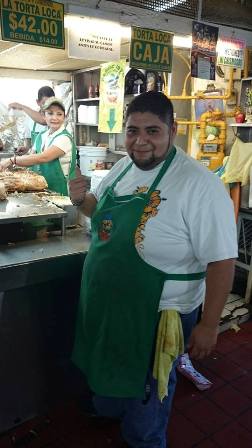 Guadalajara market torta (sandwich) stall[/caption]
Guadalajara is Mexico’s second largest municipal area, a big city with significant attractions (the Cathedral, the Hospicio Cabanas with its extraordinary Jose Orozco murals, the ornate Templo Expiatorio, the magnificent Teatro Degollado, the colonial Governor’s Palace which also boasts incredible Orozco murals and the city’s huge covered market, one of the largest in Latin America) which can easily explored in a day if you’re happy with a rush of sights.
[caption id="attachment_3313" align="alignnone" width="445"]
Guadalajara market torta (sandwich) stall[/caption]
Guadalajara is Mexico’s second largest municipal area, a big city with significant attractions (the Cathedral, the Hospicio Cabanas with its extraordinary Jose Orozco murals, the ornate Templo Expiatorio, the magnificent Teatro Degollado, the colonial Governor’s Palace which also boasts incredible Orozco murals and the city’s huge covered market, one of the largest in Latin America) which can easily explored in a day if you’re happy with a rush of sights.
[caption id="attachment_3313" align="alignnone" width="445"]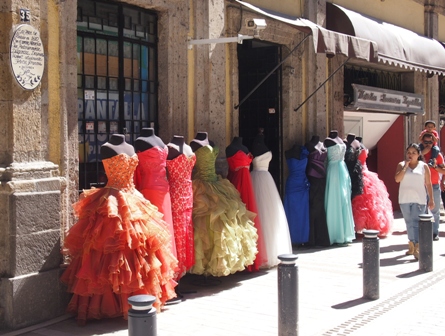 Dress shop display in Guadaljara[/caption]
[caption id="attachment_3303" align="alignnone" width="336"]
Dress shop display in Guadaljara[/caption]
[caption id="attachment_3303" align="alignnone" width="336"]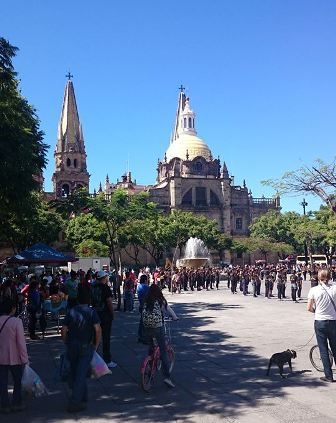 Guadalajara cathedral and square[/caption]
[caption id="attachment_3309" align="alignnone" width="448"]
Guadalajara cathedral and square[/caption]
[caption id="attachment_3309" align="alignnone" width="448"] Orozco anti-Fascist mural in Hospicio Cabanas[/caption]
Guadalajara’s central city is relatively compact. The major sites are within close walking proximity to one another and it’s an excellent place to explore on foot.
[caption id="attachment_3304" align="alignnone" width="448"]
Orozco anti-Fascist mural in Hospicio Cabanas[/caption]
Guadalajara’s central city is relatively compact. The major sites are within close walking proximity to one another and it’s an excellent place to explore on foot.
[caption id="attachment_3304" align="alignnone" width="448"]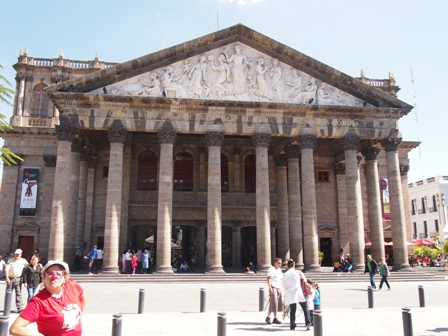 Teatro Degollado with photo bomber[/caption]
Feeling musical? Mariachi music’s origin is Guadalajara. The country’s best mariachi bands are from Guadalajara and good performances are everywhere, the majority in restaurants or small venues. Tickets are inexpensive.
[caption id="attachment_3305" align="alignnone" width="252"]
Teatro Degollado with photo bomber[/caption]
Feeling musical? Mariachi music’s origin is Guadalajara. The country’s best mariachi bands are from Guadalajara and good performances are everywhere, the majority in restaurants or small venues. Tickets are inexpensive.
[caption id="attachment_3305" align="alignnone" width="252"] Female mariachi band members from Tlaquepaque[/caption]
Not surprisingly given Mexico’s national tourism body’s fixation on promoting its beach resorts (aimed squarely at the USA, Canadian and European sun-seeking holiday market), central Mexico is mostly left off the mainstream travel routes.
[caption id="attachment_3306" align="alignnone" width="407"]
Female mariachi band members from Tlaquepaque[/caption]
Not surprisingly given Mexico’s national tourism body’s fixation on promoting its beach resorts (aimed squarely at the USA, Canadian and European sun-seeking holiday market), central Mexico is mostly left off the mainstream travel routes.
[caption id="attachment_3306" align="alignnone" width="407"] Young guitarist practicing outside Teatro Degollado[/caption]
While some smaller beach resort towns haven’t been totally ruined by excessive development, visiting a tourist town like Cozumel or Cabo San Lucas and claiming you’ve seen Mexico is like visiting HongKong and saying you’ve seen China.
[caption id="attachment_3310" align="alignnone" width="448"]
Young guitarist practicing outside Teatro Degollado[/caption]
While some smaller beach resort towns haven’t been totally ruined by excessive development, visiting a tourist town like Cozumel or Cabo San Lucas and claiming you’ve seen Mexico is like visiting HongKong and saying you’ve seen China.
[caption id="attachment_3310" align="alignnone" width="448"]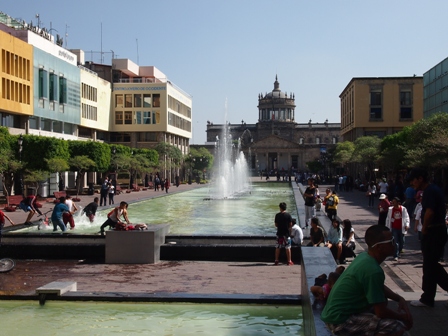 Guadalajara pedestrian zone with Hospicio Cabanas[/caption]
Mexico’s history, culture, arts and food are all unique. It’s one of a select few countries on this small planet where differences count for something special.
[caption id="attachment_3307" align="alignnone" width="228"]
Guadalajara pedestrian zone with Hospicio Cabanas[/caption]
Mexico’s history, culture, arts and food are all unique. It’s one of a select few countries on this small planet where differences count for something special.
[caption id="attachment_3307" align="alignnone" width="228"]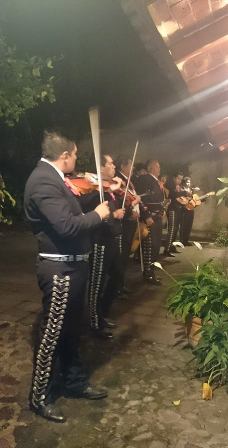 Cosala mariachi band playing near Ajijic[/caption]
[caption id="attachment_3315" align="alignnone" width="306"]
Cosala mariachi band playing near Ajijic[/caption]
[caption id="attachment_3315" align="alignnone" width="306"] Huevos Rancheros, fresh orange juice and cinnamon infused coffee in a Guadalajara cafe[/caption]
Ajijic is something of a microcosm of how Mexico is different from its neighbours, indeed from everywhere else.
[caption id="attachment_3311" align="alignnone" width="336"]
Huevos Rancheros, fresh orange juice and cinnamon infused coffee in a Guadalajara cafe[/caption]
Ajijic is something of a microcosm of how Mexico is different from its neighbours, indeed from everywhere else.
[caption id="attachment_3311" align="alignnone" width="336"]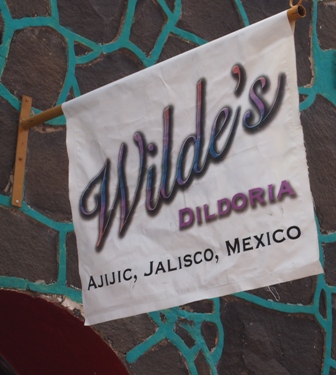 Ajijic specialty shop[/caption]
[caption id="attachment_3312" align="alignnone" width="419"]
Ajijic specialty shop[/caption]
[caption id="attachment_3312" align="alignnone" width="419"]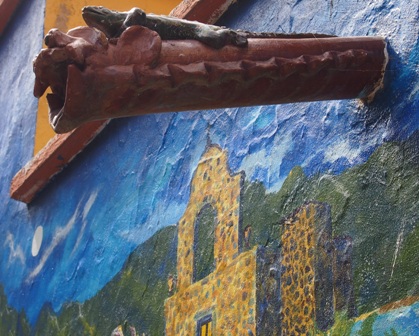 Ajijic iguana waterspout[/caption]
You’d be hard pressed to find an equally captivating home base.
Tom Neal Tacker travelled to Ajijic with Big Yellow Suitcase Tours, of which he is a co-owner.
Naked Facts:
Naked Routes:
Guadalajara’s international airport is approximately 15 ks south of the city centre and is served by frequent daily flights from all large North American cities.
Ajijic is 40 ks from Guadalajara on Lake Chapala. Best way to get there is by taxi from the airport. Use the official government taxi service for a preset fare. The journey from the airport to Ajijic takes approximately 45 minutes.
Naked Sleeps:
The Nueva Posada Hotel is one of Ajijic’s best. Family owned and operated, its location on Lake Chapala is unbeatable. The restaurant is open 7 days for dinner and breakfast for guests and visitors. The food is surprisingly good. A lovely garden opens onto the lake from the back of the hotel while a small swimming pool is very secluded. During a long stay I was the only person using it, rather like having my own private pool. See www.hotelnuevaposada.com
Naked Tips:
Big Yellow Suitcase operates small group tours to the world’s most interesting places. The emphasis is on cultural immersion while embracing the principles of slow travel.
Tours to Ajijic and beyond run for 10 days in both August and November.
See more information about tours to Sicily, Malta, Greece, Mexico, Costa Rica, New Orleans, France and Scotland.
www.bigyellowsuitcase.com.au
[caption id="attachment_3314" align="alignnone" width="448"]
Ajijic iguana waterspout[/caption]
You’d be hard pressed to find an equally captivating home base.
Tom Neal Tacker travelled to Ajijic with Big Yellow Suitcase Tours, of which he is a co-owner.
Naked Facts:
Naked Routes:
Guadalajara’s international airport is approximately 15 ks south of the city centre and is served by frequent daily flights from all large North American cities.
Ajijic is 40 ks from Guadalajara on Lake Chapala. Best way to get there is by taxi from the airport. Use the official government taxi service for a preset fare. The journey from the airport to Ajijic takes approximately 45 minutes.
Naked Sleeps:
The Nueva Posada Hotel is one of Ajijic’s best. Family owned and operated, its location on Lake Chapala is unbeatable. The restaurant is open 7 days for dinner and breakfast for guests and visitors. The food is surprisingly good. A lovely garden opens onto the lake from the back of the hotel while a small swimming pool is very secluded. During a long stay I was the only person using it, rather like having my own private pool. See www.hotelnuevaposada.com
Naked Tips:
Big Yellow Suitcase operates small group tours to the world’s most interesting places. The emphasis is on cultural immersion while embracing the principles of slow travel.
Tours to Ajijic and beyond run for 10 days in both August and November.
See more information about tours to Sicily, Malta, Greece, Mexico, Costa Rica, New Orleans, France and Scotland.
www.bigyellowsuitcase.com.au
[caption id="attachment_3314" align="alignnone" width="448"]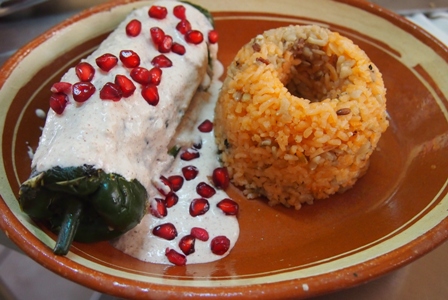 Chilles rellenos in Ajijic[/caption]
Chilles rellenos in Ajijic[/caption] https://nakedhungrytraveller.com.au/getting-great-ocean-road/ Getting Off the Great Ocean RoadBehind Victoria’s world famous Great Ocean Road is another country. A slight ripple on the water gives it away, though it could be a duck, a grebe perhaps? The small hairy back moves purposefully forward, dives and disappears. Not a duck or a grebe. It’s a platypus. They’ve survived for millions of years by practicing stealth tactics. Foraging in clean deep water for snails, insect larvae and worms, a little brown platypus is nearly impossible to spot in evening light. It takes a keen eye. Our guide, Brian Jackson, runs daily eco-tours out of the tiny central Otway Range’s regional town, Forrest, to nearby Lake Elizabeth. After years of spotting platypus, he has become an expert in their clandestine habits. [caption id="attachment_3086" align="alignnone" width="182"]
https://nakedhungrytraveller.com.au/getting-great-ocean-road/ Getting Off the Great Ocean RoadBehind Victoria’s world famous Great Ocean Road is another country. A slight ripple on the water gives it away, though it could be a duck, a grebe perhaps? The small hairy back moves purposefully forward, dives and disappears. Not a duck or a grebe. It’s a platypus. They’ve survived for millions of years by practicing stealth tactics. Foraging in clean deep water for snails, insect larvae and worms, a little brown platypus is nearly impossible to spot in evening light. It takes a keen eye. Our guide, Brian Jackson, runs daily eco-tours out of the tiny central Otway Range’s regional town, Forrest, to nearby Lake Elizabeth. After years of spotting platypus, he has become an expert in their clandestine habits. [caption id="attachment_3086" align="alignnone" width="182"]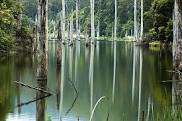 Lake Elizabeth[/caption]
Paddling quietly in canoes, Jackson knows the secret spots where this lake’s colony of approximately a half dozen platypus prefers to feed. We sit and wait in the gloaming. Not a bad way to spend an evening. The platypus sleeps tucked away deep and invisible in its extended riverbank burrow, feeding on average for three hours at dawn and three hours at dusk. Apparently they’re more active at dusk. We’re four passengers in two canoes sitting in absolute silence while Jackson guides us on several circuits of Lake Elizabeth’s placid waters in search of one of the world’s oddest creatures.
[caption id="attachment_3087" align="alignnone" width="259"]
Lake Elizabeth[/caption]
Paddling quietly in canoes, Jackson knows the secret spots where this lake’s colony of approximately a half dozen platypus prefers to feed. We sit and wait in the gloaming. Not a bad way to spend an evening. The platypus sleeps tucked away deep and invisible in its extended riverbank burrow, feeding on average for three hours at dawn and three hours at dusk. Apparently they’re more active at dusk. We’re four passengers in two canoes sitting in absolute silence while Jackson guides us on several circuits of Lake Elizabeth’s placid waters in search of one of the world’s oddest creatures.
[caption id="attachment_3087" align="alignnone" width="259"]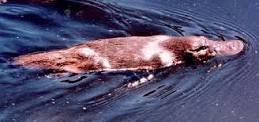 Platypus swimming[/caption]
The lake itself is an anomaly. Its waters were formed by a landslip in 1953 when the Upper Barwon River changed its course. In 1953 the lake’s average depth was approximately thirty metres. Now it’s five metres. No one knows exactly when the platypus took up residence. Dead tree trunks rise up like ghosts. Steep banks offer platypus excellent opportunity for burrowing and cover. The lake is well off the beaten track, is secluded and peaceful.
[caption id="attachment_3088" align="alignnone" width="260"]
Platypus swimming[/caption]
The lake itself is an anomaly. Its waters were formed by a landslip in 1953 when the Upper Barwon River changed its course. In 1953 the lake’s average depth was approximately thirty metres. Now it’s five metres. No one knows exactly when the platypus took up residence. Dead tree trunks rise up like ghosts. Steep banks offer platypus excellent opportunity for burrowing and cover. The lake is well off the beaten track, is secluded and peaceful.
[caption id="attachment_3088" align="alignnone" width="260"]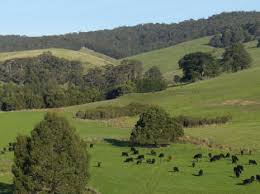 Scenery around Gosling Creek at Deans Marsh[/caption]
And yet, the two principle Great Ocean Road towns, Lorne and Apollo Bay are less than fifty kilometres away as the crow flies. Travellers in their hundreds of thousands use the Great Ocean Road, so much so that it has entered the ‘Australian Bucket List’ (a term I find increasingly derisory but will use it to describe an off-kilter effect of mass tourism) of innumerable international visitors, rivalling the Great Barrier Reef and Uluru in popularity.
The country beyond the Great Ocean Road remains largely unexplored.
Avoiding the increasingly heavy traffic on the Great Ocean Road, we drive inland to Birregurra. Rolling countryside recedes into the distant low rising Otway Ranges. There’s little traffic on the roads passing through tiny hamlets of Deans Marsh and Barwon Downs and the driving is pleasantly effortless.
Birregurra is firmly planted on the Australian gourmet map thanks to Dan Hunter. When Hunter left the Royal Mail Hotel in Dunkeld last year to assume ownership of Sunnybrae after George Biron and Diane Garrett sold their idyllically located restaurant and cooking school, tongues began salivating near and far. Dan Hunter at the Royal Mail hotel oversaw the village pub’s expansion into one of the country’s best regional restaurants. (See NHT story http://nakedhungrytraveller.com.au/epicurean-best-in-show/ The Royal Mail hotel’s new chef is the very talented Robin Wickens who has in less than one year proved himself very capable of maintaining the high standards set by Dan Hunter.)
Renamed ‘Brae’, the old homestead has been given a facelift without the loss of country tranquility. The 30 acres property already boasted one of Australia’s best kitchen gardens. Under Hunter’s stewardship, it’s growing into what will undoubtedly become the country’s best restaurant kitchen garden.
[caption id="attachment_3089" align="alignnone" width="336"]
Scenery around Gosling Creek at Deans Marsh[/caption]
And yet, the two principle Great Ocean Road towns, Lorne and Apollo Bay are less than fifty kilometres away as the crow flies. Travellers in their hundreds of thousands use the Great Ocean Road, so much so that it has entered the ‘Australian Bucket List’ (a term I find increasingly derisory but will use it to describe an off-kilter effect of mass tourism) of innumerable international visitors, rivalling the Great Barrier Reef and Uluru in popularity.
The country beyond the Great Ocean Road remains largely unexplored.
Avoiding the increasingly heavy traffic on the Great Ocean Road, we drive inland to Birregurra. Rolling countryside recedes into the distant low rising Otway Ranges. There’s little traffic on the roads passing through tiny hamlets of Deans Marsh and Barwon Downs and the driving is pleasantly effortless.
Birregurra is firmly planted on the Australian gourmet map thanks to Dan Hunter. When Hunter left the Royal Mail Hotel in Dunkeld last year to assume ownership of Sunnybrae after George Biron and Diane Garrett sold their idyllically located restaurant and cooking school, tongues began salivating near and far. Dan Hunter at the Royal Mail hotel oversaw the village pub’s expansion into one of the country’s best regional restaurants. (See NHT story http://nakedhungrytraveller.com.au/epicurean-best-in-show/ The Royal Mail hotel’s new chef is the very talented Robin Wickens who has in less than one year proved himself very capable of maintaining the high standards set by Dan Hunter.)
Renamed ‘Brae’, the old homestead has been given a facelift without the loss of country tranquility. The 30 acres property already boasted one of Australia’s best kitchen gardens. Under Hunter’s stewardship, it’s growing into what will undoubtedly become the country’s best restaurant kitchen garden.
[caption id="attachment_3089" align="alignnone" width="336"]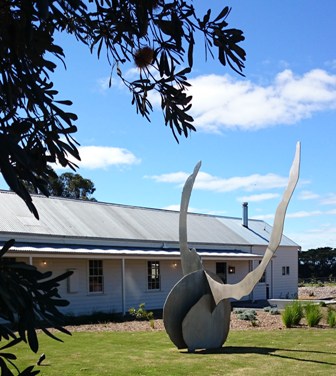 Sculpture outside Brae main entrance[/caption]
A meal at Brae is an ethereal experience. What I’ve always admired about Hunter's kitchen skills is his lightness of touch. Vegetables are the heroes, meat and fish are important players but they’re not the focus. After finishing twelve courses and accompanying exquisitely matched wines, I never feel bloated. The following day I don’t feel like I slept on a bowling ball. Instead I feel nourished, replenished.
[caption id="attachment_3090" align="alignnone" width="111"]
Sculpture outside Brae main entrance[/caption]
A meal at Brae is an ethereal experience. What I’ve always admired about Hunter's kitchen skills is his lightness of touch. Vegetables are the heroes, meat and fish are important players but they’re not the focus. After finishing twelve courses and accompanying exquisitely matched wines, I never feel bloated. The following day I don’t feel like I slept on a bowling ball. Instead I feel nourished, replenished.
[caption id="attachment_3090" align="alignnone" width="111"] Dan Hunter[/caption]
Hunter is setting permanent roots in Birregurra. He already has become a welcomed addition to the tightly knit community of farmers and vignerons.
Great restaurants are built upon relationships, that between the restaurateur and customer and that between the restaurateur and suppliers. Despite having access to the marvellous garden, Hunter has established good relationships with local growers. You can taste the freshness in the food; it’s all about close proximity and superb quality. (See www.braerestaurant.com)
Near Birregurra is tiny Murroon, not a town, more a location nestled into the Pennyroyal Creek valley. Here is the Pennyroyal Raspberry Farm, an immaculately tended orchard nearly hidden away in a lovely cul de sac overlooking the Pennyroyal Creek.
[caption id="attachment_3091" align="alignnone" width="335"]
Dan Hunter[/caption]
Hunter is setting permanent roots in Birregurra. He already has become a welcomed addition to the tightly knit community of farmers and vignerons.
Great restaurants are built upon relationships, that between the restaurateur and customer and that between the restaurateur and suppliers. Despite having access to the marvellous garden, Hunter has established good relationships with local growers. You can taste the freshness in the food; it’s all about close proximity and superb quality. (See www.braerestaurant.com)
Near Birregurra is tiny Murroon, not a town, more a location nestled into the Pennyroyal Creek valley. Here is the Pennyroyal Raspberry Farm, an immaculately tended orchard nearly hidden away in a lovely cul de sac overlooking the Pennyroyal Creek.
[caption id="attachment_3091" align="alignnone" width="335"]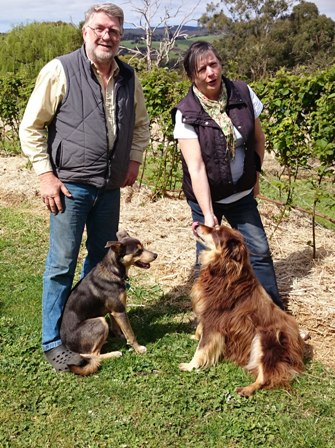 Mike and Katrine Juleff with Rusty and Bailey at Pennyroyal Raspberry Farm[/caption]
Owners Mike and Katrine Juleff’s farm has been organic since first planted back in 1985. 28 varieties of apple go into the authentic dry cider named, ‘The Crucible’. Made with Champagne yeast in the traditional method with long bottle aging, it’s a benchmark example of what cider really should be. The berries are top quality as are all the jams and preserves made from them. Mike also makes several gins from an assortment of berries. Remember what real sloe gin tastes like? His berry infused gins are much better. A cafe is open from November until April during harvest. Two fully self-contained cottages are available for accommodation at a reasonable price. (See www.pennyroyalraspberry.com)
[caption id="attachment_3092" align="alignnone" width="448"]
Mike and Katrine Juleff with Rusty and Bailey at Pennyroyal Raspberry Farm[/caption]
Owners Mike and Katrine Juleff’s farm has been organic since first planted back in 1985. 28 varieties of apple go into the authentic dry cider named, ‘The Crucible’. Made with Champagne yeast in the traditional method with long bottle aging, it’s a benchmark example of what cider really should be. The berries are top quality as are all the jams and preserves made from them. Mike also makes several gins from an assortment of berries. Remember what real sloe gin tastes like? His berry infused gins are much better. A cafe is open from November until April during harvest. Two fully self-contained cottages are available for accommodation at a reasonable price. (See www.pennyroyalraspberry.com)
[caption id="attachment_3092" align="alignnone" width="448"]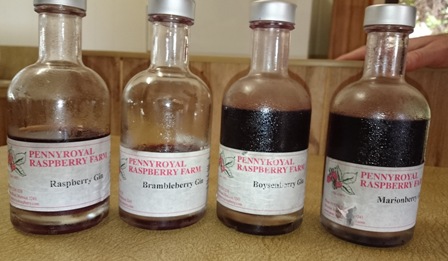 Pennyroyal Gins[/caption]
Four wineries operate in this district. Not yet large enough for official G.I. status (Geographical Indicator), they often get lumped into the greater Geelong wine region. Higher, cooler and wetter than Geelong, all four wineries specialise in Pinot Noir, Pinot Gris (Grigio), Chardonnay and Riesling. All four wineries also create splendid wines.
[caption id="attachment_3093" align="alignnone" width="162"]
Pennyroyal Gins[/caption]
Four wineries operate in this district. Not yet large enough for official G.I. status (Geographical Indicator), they often get lumped into the greater Geelong wine region. Higher, cooler and wetter than Geelong, all four wineries specialise in Pinot Noir, Pinot Gris (Grigio), Chardonnay and Riesling. All four wineries also create splendid wines.
[caption id="attachment_3093" align="alignnone" width="162"]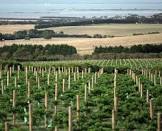 View from Gosling Creek Winery[/caption]
Three have cellar doors open on weekends and public holidays or by appointment: Blake Estate Vineyard & Winery (www.blakeestate.com.au), Dinny Goonan Wines (www.dinnygoonan.com.au) and Gosling Creek Winery (www.goslingcreek.com.au).
[caption id="attachment_3098" align="alignnone" width="276"]
View from Gosling Creek Winery[/caption]
Three have cellar doors open on weekends and public holidays or by appointment: Blake Estate Vineyard & Winery (www.blakeestate.com.au), Dinny Goonan Wines (www.dinnygoonan.com.au) and Gosling Creek Winery (www.goslingcreek.com.au).
[caption id="attachment_3098" align="alignnone" width="276"] Rosie Blake in vineyard[/caption]
[caption id="attachment_3094" align="alignnone" width="336"]
Rosie Blake in vineyard[/caption]
[caption id="attachment_3094" align="alignnone" width="336"]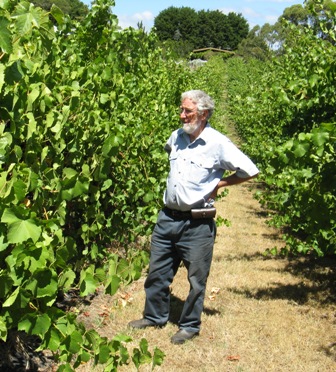 Roger Blake in vineyard[/caption]
The newest winery in this special quartet is Babenorek Winery & Olive Grove. While not open to the public, the excellent Pinot Noir and Pinot Grigio (made in the lighter Italian style, hence Grigio instead of Gris) are both excellent examples of what northern Otways’ terroir is all about; savoury, mineral-infused, complex and elegant. (www.babenorek.com.au)
[caption id="attachment_3095" align="alignnone" width="268"]
Roger Blake in vineyard[/caption]
The newest winery in this special quartet is Babenorek Winery & Olive Grove. While not open to the public, the excellent Pinot Noir and Pinot Grigio (made in the lighter Italian style, hence Grigio instead of Gris) are both excellent examples of what northern Otways’ terroir is all about; savoury, mineral-infused, complex and elegant. (www.babenorek.com.au)
[caption id="attachment_3095" align="alignnone" width="268"] Herman and Vicki Walcher of Babenorek Wines and Olive Grove[/caption]
[caption id="attachment_3096" align="alignnone" width="336"]
Herman and Vicki Walcher of Babenorek Wines and Olive Grove[/caption]
[caption id="attachment_3096" align="alignnone" width="336"] Babenorek Wines[/caption]
Blake’s is well known for its superb Champenoise sparkling wines made with 100% Pinot Noir (served coincidentally at Brae as the house sparkling wine, a fine opener to the meal). Roger Blake is a chemist/scientist by trade. His understanding of fickle Pinot Noir is innate. Both Dinny Goonan and Gosling Creek offer a slightly broader range of wines, Riesling makes a stand-out showing at both these wineries.
[caption id="attachment_3097" align="alignnone" width="336"]
Babenorek Wines[/caption]
Blake’s is well known for its superb Champenoise sparkling wines made with 100% Pinot Noir (served coincidentally at Brae as the house sparkling wine, a fine opener to the meal). Roger Blake is a chemist/scientist by trade. His understanding of fickle Pinot Noir is innate. Both Dinny Goonan and Gosling Creek offer a slightly broader range of wines, Riesling makes a stand-out showing at both these wineries.
[caption id="attachment_3097" align="alignnone" width="336"]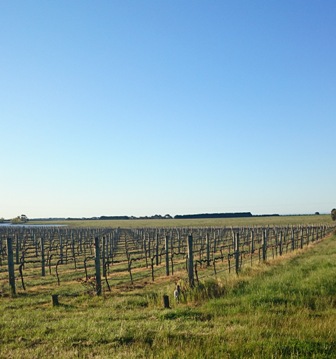 Dinny Goonan vineyard[/caption]
Birregurra’s single main street has evolved into something of an eats street. Birragurra Farm Foods (www.birregurrafarmfoods.com.au) is a deli and butcher selling local treats and organic meats. Stop here for the best lamb, beef, pork and chicken in the region. A range of local wines are on sale as well. A cafe adjoins the small shop.
[caption id="attachment_3099" align="alignnone" width="186"]
Dinny Goonan vineyard[/caption]
Birregurra’s single main street has evolved into something of an eats street. Birragurra Farm Foods (www.birregurrafarmfoods.com.au) is a deli and butcher selling local treats and organic meats. Stop here for the best lamb, beef, pork and chicken in the region. A range of local wines are on sale as well. A cafe adjoins the small shop.
[caption id="attachment_3099" align="alignnone" width="186"]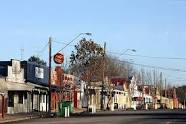 Birregurra main street[/caption]
The town’s pub has experienced its ups and downs but seems to have settled into an easy rhythm providing good food at reasonable prices. Another cafe further down the road towards Colac does a good coffee while its burgers are the best north of the Great Ocean Road.
Birregurra’s annual Festival and Art Show is the second weekend in October. The whole town becomes a fresh is best centre of goodness. (See www.birregurra.com)
In Forrest, the brother and sister team Matt and Sharon Bradshaw run the wonderful Forrest Brewing Company brewery and bistro serving wholesome well prepared food and excellent craft beer. Since this hot spot opened a couple years ago, Forrest finally got the terrific local hangout it deserved. (See www.forrestbrewing.com.au)
[caption id="attachment_3100" align="alignnone" width="269"]
Birregurra main street[/caption]
The town’s pub has experienced its ups and downs but seems to have settled into an easy rhythm providing good food at reasonable prices. Another cafe further down the road towards Colac does a good coffee while its burgers are the best north of the Great Ocean Road.
Birregurra’s annual Festival and Art Show is the second weekend in October. The whole town becomes a fresh is best centre of goodness. (See www.birregurra.com)
In Forrest, the brother and sister team Matt and Sharon Bradshaw run the wonderful Forrest Brewing Company brewery and bistro serving wholesome well prepared food and excellent craft beer. Since this hot spot opened a couple years ago, Forrest finally got the terrific local hangout it deserved. (See www.forrestbrewing.com.au)
[caption id="attachment_3100" align="alignnone" width="269"] Forrest Brewery[/caption]
Forrest is one of the world’s most famous mountain biking centres. Don’t be surprised to see scores of muddy Lycra clad cyclists scraping dirt off their shoes while sipping on cups of strong coffee or quaffing mugs of terrific beer.
Hippies shifted to Forrest back in the 70s, mixing in, or not, with the traditional, and notably conservative, logging community. Forrest is at once weird and wonderful as it attracts a very mixed assortment of visitors.
The Otway Ranges is the rainiest region in Australia. Note it’s not the wettest. Far north Queensland’s rainforests are wetter. It rains approximately 280 of 365 days per year in the Otways. A fairly constant drizzle which is a result of mist rising from the Southern Ocean meeting the Otway Range’s V shaped topography. The funnelling effect creates precipitation filled clouds that linger over the central ridgelines. The northern side of the Otways is usually dry, as are the beaches on the southern side. In the middle between Forrest and Gellibrand south to Beech Forest and Cape Otway itself, the weather is normally wet.
This unusual topography has blessed the Otway Ranges with stunning wet sclerophyll rainforest. Though logging has taken its toll, remnant stands of towering Mountain Ash interspersed with Australian Myrtle Beech, ferns and rare flora exist in pockets, protected mostly by the Great Otway National Park.
[caption id="attachment_3101" align="alignnone" width="300"]
Forrest Brewery[/caption]
Forrest is one of the world’s most famous mountain biking centres. Don’t be surprised to see scores of muddy Lycra clad cyclists scraping dirt off their shoes while sipping on cups of strong coffee or quaffing mugs of terrific beer.
Hippies shifted to Forrest back in the 70s, mixing in, or not, with the traditional, and notably conservative, logging community. Forrest is at once weird and wonderful as it attracts a very mixed assortment of visitors.
The Otway Ranges is the rainiest region in Australia. Note it’s not the wettest. Far north Queensland’s rainforests are wetter. It rains approximately 280 of 365 days per year in the Otways. A fairly constant drizzle which is a result of mist rising from the Southern Ocean meeting the Otway Range’s V shaped topography. The funnelling effect creates precipitation filled clouds that linger over the central ridgelines. The northern side of the Otways is usually dry, as are the beaches on the southern side. In the middle between Forrest and Gellibrand south to Beech Forest and Cape Otway itself, the weather is normally wet.
This unusual topography has blessed the Otway Ranges with stunning wet sclerophyll rainforest. Though logging has taken its toll, remnant stands of towering Mountain Ash interspersed with Australian Myrtle Beech, ferns and rare flora exist in pockets, protected mostly by the Great Otway National Park.
[caption id="attachment_3101" align="alignnone" width="300"]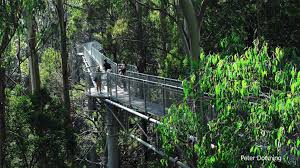 Otway Fly[/caption]
The Otway Fly opened earlier this decade to help educate visitors about the wonders of the Otway Range’s ecology. Located outside the hamlet of Beech Forest, the Otway Fly is open year round all day. While treading metal boardwalks suspended at tree canopy height is interesting, I’m taken by the notion of flying through the canopy instead.
[caption id="attachment_3102" align="alignnone" width="252"]
Otway Fly[/caption]
The Otway Fly opened earlier this decade to help educate visitors about the wonders of the Otway Range’s ecology. Located outside the hamlet of Beech Forest, the Otway Fly is open year round all day. While treading metal boardwalks suspended at tree canopy height is interesting, I’m taken by the notion of flying through the canopy instead.
[caption id="attachment_3102" align="alignnone" width="252"]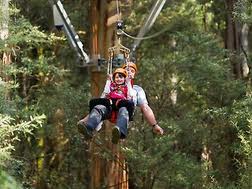 Ziplining at Otway Fly[/caption]
A zipline began operating soon after January 2011. Hanging from a thin cable, zippers speed from tree to tree, stopping just long enough to unhook gear from one zipline to another, an exhilarating way to get up close and personal with the rainforest, adrenalin rush included.
Two guides accompany ten zippers at all times. Their knowledge of Otway biodiversity is impressive and I’m swayed by their genuine enthusiasm for both the contemporary adventure and the immemorial impact the ancient forest has on us all.
During the longest zip, 120 metres from tree to tree, I have a flashback to the previous evening when I was canoeing on Lake Elizabeth looking for a platypus. The contrast between these two activities is remarkable, slow paddling one day, fast flying the next. No beaches. No crowds either. And I’ve got used to the constant rain.
The Otways fickle weather can be a dampener but that’s nothing dinner at Brae won’t fix in a hurry. As soon as I walk through the door any semblance of grey mood is banished. A glass of Blake’s Blanc de Noir is in hand and I feel good. Dan Hunter is working magic in the kitchen and all is right in the world.
Tom Neal Tacker travelled courtesy of Geelong Otways Tourism.
Naked Facts:
Road access to the Otway Ranges is easy. The closest airport is at Avalon with several daily Jetstar flights from Sydney. Alternatively, Melbourne’s International Airport at Tullamarine is approximately 2.5 hours drive to Birregurra.
See www.platypustours.net.au to check out Bruce Jackson’s Otway Eco Tours, including evening canoe trips on Lake Elizabeth.
The Otway Fly is open daily. The zipline has become very popular and bookings are essential. See www.otwayfly.com.au for more information.
Naked Sleeps:
Tarndwarncoort Homestead five kilometres from Birregurra is a heritage listed farming property in a beautiful rural location, famous for its indigenous Polwarth sheep. The eight bedroom homestead can easily accommodate large family groups.
[caption id="attachment_3105" align="alignnone" width="336"]
Ziplining at Otway Fly[/caption]
A zipline began operating soon after January 2011. Hanging from a thin cable, zippers speed from tree to tree, stopping just long enough to unhook gear from one zipline to another, an exhilarating way to get up close and personal with the rainforest, adrenalin rush included.
Two guides accompany ten zippers at all times. Their knowledge of Otway biodiversity is impressive and I’m swayed by their genuine enthusiasm for both the contemporary adventure and the immemorial impact the ancient forest has on us all.
During the longest zip, 120 metres from tree to tree, I have a flashback to the previous evening when I was canoeing on Lake Elizabeth looking for a platypus. The contrast between these two activities is remarkable, slow paddling one day, fast flying the next. No beaches. No crowds either. And I’ve got used to the constant rain.
The Otways fickle weather can be a dampener but that’s nothing dinner at Brae won’t fix in a hurry. As soon as I walk through the door any semblance of grey mood is banished. A glass of Blake’s Blanc de Noir is in hand and I feel good. Dan Hunter is working magic in the kitchen and all is right in the world.
Tom Neal Tacker travelled courtesy of Geelong Otways Tourism.
Naked Facts:
Road access to the Otway Ranges is easy. The closest airport is at Avalon with several daily Jetstar flights from Sydney. Alternatively, Melbourne’s International Airport at Tullamarine is approximately 2.5 hours drive to Birregurra.
See www.platypustours.net.au to check out Bruce Jackson’s Otway Eco Tours, including evening canoe trips on Lake Elizabeth.
The Otway Fly is open daily. The zipline has become very popular and bookings are essential. See www.otwayfly.com.au for more information.
Naked Sleeps:
Tarndwarncoort Homestead five kilometres from Birregurra is a heritage listed farming property in a beautiful rural location, famous for its indigenous Polwarth sheep. The eight bedroom homestead can easily accommodate large family groups.
[caption id="attachment_3105" align="alignnone" width="336"] Tarndwarncoort's dining room circa 1878[/caption]
A two bedroom cottage is also available for accommodation. Self catering is the way to go though owners, the Dennis family, are happy to stock the larder with advance notice. A small cafe operates during weekends and holidays. An art gallery featuring local works recently opened in the old cider cellar next to the wool and yarn shop. See www.tarndwarncoort.com for more information.
[caption id="attachment_3104" align="alignnone" width="334"]
Tarndwarncoort's dining room circa 1878[/caption]
A two bedroom cottage is also available for accommodation. Self catering is the way to go though owners, the Dennis family, are happy to stock the larder with advance notice. A small cafe operates during weekends and holidays. An art gallery featuring local works recently opened in the old cider cellar next to the wool and yarn shop. See www.tarndwarncoort.com for more information.
[caption id="attachment_3104" align="alignnone" width="334"] Tarndwarncoort veranda[/caption]
For further information about local B & B hostelries, festivals, touring routes and other attractions, check out www.otwayharvesttrail.com.au
Naked Tip:
Since Brae opened for business early 2014, accommodation in and around Birregurra tends to be booked out weeks in advance. The limited range of local B & Bs are all very good but with few rooms available. Brae will have onsite accommodation open sometime late in 2015, six rooms are planned. Though this addition to the narrow accommodation options is heartily welcomed, it won’t be enough to meet demand.
Tarndwarncoort veranda[/caption]
For further information about local B & B hostelries, festivals, touring routes and other attractions, check out www.otwayharvesttrail.com.au
Naked Tip:
Since Brae opened for business early 2014, accommodation in and around Birregurra tends to be booked out weeks in advance. The limited range of local B & Bs are all very good but with few rooms available. Brae will have onsite accommodation open sometime late in 2015, six rooms are planned. Though this addition to the narrow accommodation options is heartily welcomed, it won’t be enough to meet demand.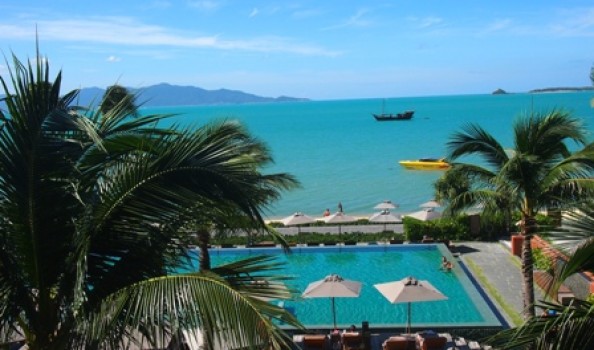 https://nakedhungrytraveller.com.au/thailand-can-beach-2/ Thailand Can Be a BeachThe sun is so bright my eyes hurt. I edge myself back into the shady veranda, not wanting to burn bright red on my first day at this small resort situated right on Koh Samui’s Bo Phut beach. From my private view, sprawled out on a day bed overlooking the pool bordering the beach, I pick out baking sun-seekers from Mittel Europe resting on chaises-longue a step from the water. They snared the best poolside lounges before breakfast, marking their territories with bags and beach towels. An Australian foursome, 60ish holiday-makers who are clearly frequent travelling companions splash about in the shallow end throwing a football around, making a lot of noise while annoying other guests. Hard working hotel employees ferry cold drinks to and from the pool bar to guests reading books, checking their smart phones or napping. Four children bob up and down in the smaller kiddie pool situated next to the larger adult’s pool. The kids aren’t as noisy as the four Australians. All the pool side lounge seats are occupied. The resort is operating at over 90% capacity. [caption id="attachment_3060" align="alignnone" width="389"]
https://nakedhungrytraveller.com.au/thailand-can-beach-2/ Thailand Can Be a BeachThe sun is so bright my eyes hurt. I edge myself back into the shady veranda, not wanting to burn bright red on my first day at this small resort situated right on Koh Samui’s Bo Phut beach. From my private view, sprawled out on a day bed overlooking the pool bordering the beach, I pick out baking sun-seekers from Mittel Europe resting on chaises-longue a step from the water. They snared the best poolside lounges before breakfast, marking their territories with bags and beach towels. An Australian foursome, 60ish holiday-makers who are clearly frequent travelling companions splash about in the shallow end throwing a football around, making a lot of noise while annoying other guests. Hard working hotel employees ferry cold drinks to and from the pool bar to guests reading books, checking their smart phones or napping. Four children bob up and down in the smaller kiddie pool situated next to the larger adult’s pool. The kids aren’t as noisy as the four Australians. All the pool side lounge seats are occupied. The resort is operating at over 90% capacity. [caption id="attachment_3060" align="alignnone" width="389"]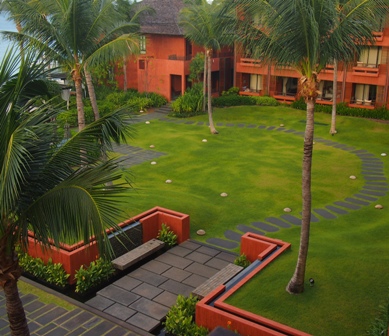 Hansar Samui garden[/caption]
It’s a scene I’ve seen played out in resorts all round the world.
The beach is nearly empty. Conversely, the pool is crowded.
I’m tempted by the beach to watch the passing parade but at midday, the passing parade isn’t much in evidence. Local Thais don’t visit the beach until sunset’s subsiding temperature provides cooling relief.
[caption id="attachment_3058" align="alignnone" width="448"]
Hansar Samui garden[/caption]
It’s a scene I’ve seen played out in resorts all round the world.
The beach is nearly empty. Conversely, the pool is crowded.
I’m tempted by the beach to watch the passing parade but at midday, the passing parade isn’t much in evidence. Local Thais don’t visit the beach until sunset’s subsiding temperature provides cooling relief.
[caption id="attachment_3058" align="alignnone" width="448"]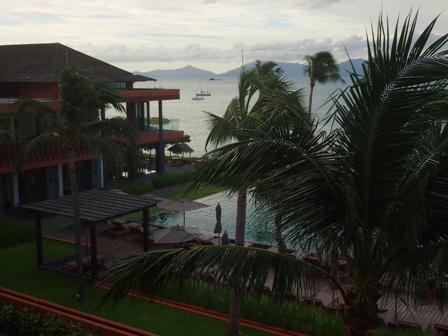 Sunset view from Hansar Samui[/caption]
Tourists apparently prefer a pool to a beach, particularly at this location as Bo Phut beach isn’t Koh Samui’s best. It’s a narrow sandy strip, not much to it at high tide while low tide necessitates a long wade out to reach chest deep water. There’s no shade to speak of either; not a Koh Samui coconut tree anywhere near.
The view however is spectacularly photogenic. Twenty kilometres away mountainous Koh Pha Ngan raises its leafy green head. Home to a famous monthly Full Moon Party, it’s a favourite hang-out for the backpacking set.
[caption id="attachment_3059" align="alignnone" width="448"]
Sunset view from Hansar Samui[/caption]
Tourists apparently prefer a pool to a beach, particularly at this location as Bo Phut beach isn’t Koh Samui’s best. It’s a narrow sandy strip, not much to it at high tide while low tide necessitates a long wade out to reach chest deep water. There’s no shade to speak of either; not a Koh Samui coconut tree anywhere near.
The view however is spectacularly photogenic. Twenty kilometres away mountainous Koh Pha Ngan raises its leafy green head. Home to a famous monthly Full Moon Party, it’s a favourite hang-out for the backpacking set.
[caption id="attachment_3059" align="alignnone" width="448"] High tide at Hansar Samui's Bo Phut beach[/caption]
At this bottom end of the Gulf of Thailand around Koh Samui, the Ang Thong National Marine Reserve speckles the sea with 40 or so islands and fringing coral reefs. Day trips (snorkelling or diving) to the park are easily arranged from Koh Samui. Inquire at your hotel or from one of dozens of travel agencies operating at Bo Phut, Chaweng and Lamai.
(Naked Tip: An airport is under construction on Koh Pha Ngan. Fairly soon, this ‘backwater’ will become just as crowded as Koh Samui.)
Though Koh Samui has become one of Thailand’s most popular beach hangouts, it’s still big enough to tempt the peace-seeking visitor with a few remaining quiet corners.
How to get the best out of your visit to a Thai beach destination?
Thailand’s biggest beach resorts offer a mixed bag of treats. By choosing carefully, the rewards should follow.
Pattaya is all about mass tourism, from gaudy to grotesque though its 'sex and sand' reputation is undergoing a revamp to attract families. The same description applies to much of Phuket, particularly around Patong town, though like Koh Samui, it’s also big enough to offer escape routes away from the crowds if needed.
This leaves one other large beach destination to the international crowds: Hua Hin, more on that later in this piece.
Not so long ago, the early 80s in fact, Koh Samui was being 'discovered’ by international vagabonds looking for a Thai island escape with excellent beaches.
Now it’s almost as crowded as Pattaya, Phuket and Hua Hin but the beaches are better on Koh Samui than at the other three destinations.
As Koh Samui continues its growth trajectory on the Top Ten Thai Tourist Traps list, construction is never-ending. Resorts pop up on Koh Samui like Pad Thai noodles; on every menu and just as common.
I’ve heard about concerned citizens’ attempts to limit further environmental damage on this ‘Island of a Million Coconut Trees’, but this being Thailand, there’s always a path to get round building restrictions. A cash gift slipped to the right hand, be it a politician or developer smooths the way.
For now, like Bali and dozens of other so-called island paradises, Koh Samui will be nice when it’s finished.
Even so, the place hasn’t been totally ruined yet.
The Hansar Samui Resort & Spa is one of Koh Samui’s finest, a gorgeous little hotel that has managed to avoid the excesses of Koh Samui’s rampant building boom.
Service is good, typically for a Thai resort. The Thai people have a knack for being genuinely friendly. I’ve yet to observe a Thai hospitality employee lose his or her cool, even when faced with a frustrated impatient tourist who doesn’t understand how embarrassing it is to show anger and lose face.
That being said, in my opinion, the best thing about the Hansar is the superior quality of the food and beverage choices.
Since it opened four years ago, the same executive chef has stayed on board. Chef Stephen Jean Dion has lifted the food and beverage bar at Hansar Samui Resort & Spa to another level entirely. The ‘H’ Bistro is really a stand-alone restaurant, certainly one of the best on the whole island.
Even if I wasn’t staying in house, I’d make a point of dining here.
Differentiating from the rest of Koh Samui’s hotel resorts, the Hansar team is developing an organic garden at the back of the hotel, a win-win for the kitchen team and guests alike. Given the sandy soil, extreme wet and dry weather conditions, the effort put into creating a kitchen garden is highly commendable.
The hotel’s LUXSA spa is drop-dead gorgeous. Unlike a lot of hotel spas, this one is spacious. The treatment menu covers a broad range, from the obligatory after-sun skin refreshers, to a range of massage types (Thai, Swedish, Reflexology, Shiatsu and combinations thereof), facials, manicures and pedicures, wraps and pampering packages.
The pool bar boasts a daily 5pm until 7pm two-for-one happy hour cocktail time. I arrived one evening at 6:55pm, ordered one drink and was given another well past the official happy hour end time. I like that generous quality in a bartender.
The rooms all overlook the single large pool, gardens and beach. Larger than most standard resort rooms I’ve slept in, they’re well appointed with bespoke toiletries, a wide-screen television with cable channel access, king sized beds, a room-for-two shower and plenty of wardrobe space. Free wi-fi is accessible throughout the resort.
Though Bophut beach isn’t Koh Samui’s best, it’s good enough, fairly clean and usually uncrowded. The resort is within a few minute’s walk to the ‘Fisherman’s Village’, certainly Koh Samui’s most pedestrian friendly shopping and dining precinct. An eclectic assortment of beachside bars, restaurants and cafes line its single long main strip. From cheap and cheerful to pricey and sophisticated, all kinds of eating establishments can be found here. Perfect if you need an excuse to dine away from the resort, though I haven’t found anywhere yet on Koh Samui serving food as good as at the Hansar.
400 Baht will get you by taxi in about 20 minutes to Samui’s biggest beach and tourist centre at Chaweng. Lamai beach is another 10 minutes from Chaweng’s southern end. Add another 100 Baht to the fare.
Five minute’s walk from the Hansar foyer door is the main road where ‘Songthaew’ (from the Thai ‘Two Rows’, a small pick-up truck with two under cover bench seats) regularly stop to collect passengers. 50 Baht will get you as far as Chaweng.
Motorbikes and hire cars are plentiful. Drive a motorbike or car at your own risk. Traffic on Koh Samui has increased exponentially in recent years along with commensurate number of motorbike injuries.
Hua Hin is Thailand’s royal resort. Since His Majesty the King and entourage are permanently ensconced, Hua Hin’s traffic is busier though the atmosphere remains reserved in respect to His Royal Majesty’s presence. Formerly the beachside bolthole for Thai royalty and aristocracy escaping Bangkok’s throbbing hustle, now it’s open to all comers, new and old. Girly strip bars, ladyboy clubs and the worst kind of Euro-trash drinking dives are informally forbidden.
Tourist sights in Hua Hin are relatively sparse. It’s a relaxed small beach city with a lot of hotels built right on the greyish sands. Water quality this close to Bangkok’s effluent drifting down from the Chao Praya river estuary isn’t great; murky is the word that best describes it.
[caption id="attachment_3061" align="alignnone" width="377"]
High tide at Hansar Samui's Bo Phut beach[/caption]
At this bottom end of the Gulf of Thailand around Koh Samui, the Ang Thong National Marine Reserve speckles the sea with 40 or so islands and fringing coral reefs. Day trips (snorkelling or diving) to the park are easily arranged from Koh Samui. Inquire at your hotel or from one of dozens of travel agencies operating at Bo Phut, Chaweng and Lamai.
(Naked Tip: An airport is under construction on Koh Pha Ngan. Fairly soon, this ‘backwater’ will become just as crowded as Koh Samui.)
Though Koh Samui has become one of Thailand’s most popular beach hangouts, it’s still big enough to tempt the peace-seeking visitor with a few remaining quiet corners.
How to get the best out of your visit to a Thai beach destination?
Thailand’s biggest beach resorts offer a mixed bag of treats. By choosing carefully, the rewards should follow.
Pattaya is all about mass tourism, from gaudy to grotesque though its 'sex and sand' reputation is undergoing a revamp to attract families. The same description applies to much of Phuket, particularly around Patong town, though like Koh Samui, it’s also big enough to offer escape routes away from the crowds if needed.
This leaves one other large beach destination to the international crowds: Hua Hin, more on that later in this piece.
Not so long ago, the early 80s in fact, Koh Samui was being 'discovered’ by international vagabonds looking for a Thai island escape with excellent beaches.
Now it’s almost as crowded as Pattaya, Phuket and Hua Hin but the beaches are better on Koh Samui than at the other three destinations.
As Koh Samui continues its growth trajectory on the Top Ten Thai Tourist Traps list, construction is never-ending. Resorts pop up on Koh Samui like Pad Thai noodles; on every menu and just as common.
I’ve heard about concerned citizens’ attempts to limit further environmental damage on this ‘Island of a Million Coconut Trees’, but this being Thailand, there’s always a path to get round building restrictions. A cash gift slipped to the right hand, be it a politician or developer smooths the way.
For now, like Bali and dozens of other so-called island paradises, Koh Samui will be nice when it’s finished.
Even so, the place hasn’t been totally ruined yet.
The Hansar Samui Resort & Spa is one of Koh Samui’s finest, a gorgeous little hotel that has managed to avoid the excesses of Koh Samui’s rampant building boom.
Service is good, typically for a Thai resort. The Thai people have a knack for being genuinely friendly. I’ve yet to observe a Thai hospitality employee lose his or her cool, even when faced with a frustrated impatient tourist who doesn’t understand how embarrassing it is to show anger and lose face.
That being said, in my opinion, the best thing about the Hansar is the superior quality of the food and beverage choices.
Since it opened four years ago, the same executive chef has stayed on board. Chef Stephen Jean Dion has lifted the food and beverage bar at Hansar Samui Resort & Spa to another level entirely. The ‘H’ Bistro is really a stand-alone restaurant, certainly one of the best on the whole island.
Even if I wasn’t staying in house, I’d make a point of dining here.
Differentiating from the rest of Koh Samui’s hotel resorts, the Hansar team is developing an organic garden at the back of the hotel, a win-win for the kitchen team and guests alike. Given the sandy soil, extreme wet and dry weather conditions, the effort put into creating a kitchen garden is highly commendable.
The hotel’s LUXSA spa is drop-dead gorgeous. Unlike a lot of hotel spas, this one is spacious. The treatment menu covers a broad range, from the obligatory after-sun skin refreshers, to a range of massage types (Thai, Swedish, Reflexology, Shiatsu and combinations thereof), facials, manicures and pedicures, wraps and pampering packages.
The pool bar boasts a daily 5pm until 7pm two-for-one happy hour cocktail time. I arrived one evening at 6:55pm, ordered one drink and was given another well past the official happy hour end time. I like that generous quality in a bartender.
The rooms all overlook the single large pool, gardens and beach. Larger than most standard resort rooms I’ve slept in, they’re well appointed with bespoke toiletries, a wide-screen television with cable channel access, king sized beds, a room-for-two shower and plenty of wardrobe space. Free wi-fi is accessible throughout the resort.
Though Bophut beach isn’t Koh Samui’s best, it’s good enough, fairly clean and usually uncrowded. The resort is within a few minute’s walk to the ‘Fisherman’s Village’, certainly Koh Samui’s most pedestrian friendly shopping and dining precinct. An eclectic assortment of beachside bars, restaurants and cafes line its single long main strip. From cheap and cheerful to pricey and sophisticated, all kinds of eating establishments can be found here. Perfect if you need an excuse to dine away from the resort, though I haven’t found anywhere yet on Koh Samui serving food as good as at the Hansar.
400 Baht will get you by taxi in about 20 minutes to Samui’s biggest beach and tourist centre at Chaweng. Lamai beach is another 10 minutes from Chaweng’s southern end. Add another 100 Baht to the fare.
Five minute’s walk from the Hansar foyer door is the main road where ‘Songthaew’ (from the Thai ‘Two Rows’, a small pick-up truck with two under cover bench seats) regularly stop to collect passengers. 50 Baht will get you as far as Chaweng.
Motorbikes and hire cars are plentiful. Drive a motorbike or car at your own risk. Traffic on Koh Samui has increased exponentially in recent years along with commensurate number of motorbike injuries.
Hua Hin is Thailand’s royal resort. Since His Majesty the King and entourage are permanently ensconced, Hua Hin’s traffic is busier though the atmosphere remains reserved in respect to His Royal Majesty’s presence. Formerly the beachside bolthole for Thai royalty and aristocracy escaping Bangkok’s throbbing hustle, now it’s open to all comers, new and old. Girly strip bars, ladyboy clubs and the worst kind of Euro-trash drinking dives are informally forbidden.
Tourist sights in Hua Hin are relatively sparse. It’s a relaxed small beach city with a lot of hotels built right on the greyish sands. Water quality this close to Bangkok’s effluent drifting down from the Chao Praya river estuary isn’t great; murky is the word that best describes it.
[caption id="attachment_3061" align="alignnone" width="377"]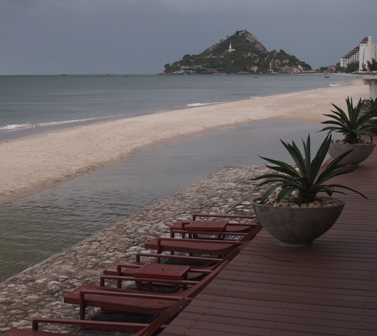 Beach from Let's Sea Al Fresco resort[/caption]
Like all popular seaside resort destinations in Thailand, property development is unrelenting. No fat cat with a spare Baht wants to miss out getting a piece of the golden tourist pie.
Hua Hin’s curse (and its blessing if a weekend escape from the capital is the ticket) is its relative close proximity to Bangkok. In a fast car, the journey between the Big Mango and Hua Hin is less than three hours.
Perfect for that weekend escape, simultaneously attractive to middle class Thais looking for a place to spend their retirement whilst not being too far removed from the family. Similarly, farangs hunting for cheaper-than-home beachside houses are buying up ‘house and land packages’ in some very dodgy instant towns, public transport, local shops and basic infrastructure not included.
Land speculation around Hua Hin appears grabbier than other parts of Thailand.
High rise towers line the beach all the way from Cha Am. Looking like a Thai Waikiki or Gold Coast strip than a quiet seaside resort, Hua Hin is bursting at its sandy seam.
Holiday units on upper levels face directly into the windows of other holiday units, all vying for prime position within skipping distance to the crowded beach. I look at this ridiculous overcrowding and think, ‘Holiday from Hell’.
For the casual visitor, Hua Hin boasts Thailand’s cleanest railway station (in respect to the King’s presence), a relic from an older age when steam trains carried the royal family from Bangkok to Klai Kangwon, the first palace built by King Rama Vll in 1928.
The royal palace grounds are open to the public, one of which is a lovely garden filled with middle class Thais doing a morning or evening jog on very tidy paths.
A very long stretch of beach extends for almost twenty kilometres from Cha Am in the northern fringe to its southern end at the monastery temple on the rocky outcrop at Wat Khao Taklap where Hua Hin’s urban sprawl finishes at An Taklap (Chopsticks Bay). The main beach of Hua Hin is a short walk from the historic railway station in the centre of town.
The Chatchai fresh food and seafood market also conveniently located in the centre of town is where all the tourist action is focused. Eating options vary from international menu dives selling familiar food (i.e. sausage and chips) to hapless farangs to street stalls grilling sticks of chicken, fish and squid. Som Dtam sold from countless mortars gets a constant pounding from smashing pestles. A few really good Thai joints boasting well-prepared local dishes rounds out the satisfying culinary picture. The Night Market virtually adjoining Chatchai opens daily. The whole place really starts hopping from sunset to about 10pm.
[caption id="attachment_3063" align="alignnone" width="299"]
Beach from Let's Sea Al Fresco resort[/caption]
Like all popular seaside resort destinations in Thailand, property development is unrelenting. No fat cat with a spare Baht wants to miss out getting a piece of the golden tourist pie.
Hua Hin’s curse (and its blessing if a weekend escape from the capital is the ticket) is its relative close proximity to Bangkok. In a fast car, the journey between the Big Mango and Hua Hin is less than three hours.
Perfect for that weekend escape, simultaneously attractive to middle class Thais looking for a place to spend their retirement whilst not being too far removed from the family. Similarly, farangs hunting for cheaper-than-home beachside houses are buying up ‘house and land packages’ in some very dodgy instant towns, public transport, local shops and basic infrastructure not included.
Land speculation around Hua Hin appears grabbier than other parts of Thailand.
High rise towers line the beach all the way from Cha Am. Looking like a Thai Waikiki or Gold Coast strip than a quiet seaside resort, Hua Hin is bursting at its sandy seam.
Holiday units on upper levels face directly into the windows of other holiday units, all vying for prime position within skipping distance to the crowded beach. I look at this ridiculous overcrowding and think, ‘Holiday from Hell’.
For the casual visitor, Hua Hin boasts Thailand’s cleanest railway station (in respect to the King’s presence), a relic from an older age when steam trains carried the royal family from Bangkok to Klai Kangwon, the first palace built by King Rama Vll in 1928.
The royal palace grounds are open to the public, one of which is a lovely garden filled with middle class Thais doing a morning or evening jog on very tidy paths.
A very long stretch of beach extends for almost twenty kilometres from Cha Am in the northern fringe to its southern end at the monastery temple on the rocky outcrop at Wat Khao Taklap where Hua Hin’s urban sprawl finishes at An Taklap (Chopsticks Bay). The main beach of Hua Hin is a short walk from the historic railway station in the centre of town.
The Chatchai fresh food and seafood market also conveniently located in the centre of town is where all the tourist action is focused. Eating options vary from international menu dives selling familiar food (i.e. sausage and chips) to hapless farangs to street stalls grilling sticks of chicken, fish and squid. Som Dtam sold from countless mortars gets a constant pounding from smashing pestles. A few really good Thai joints boasting well-prepared local dishes rounds out the satisfying culinary picture. The Night Market virtually adjoining Chatchai opens daily. The whole place really starts hopping from sunset to about 10pm.
[caption id="attachment_3063" align="alignnone" width="299"]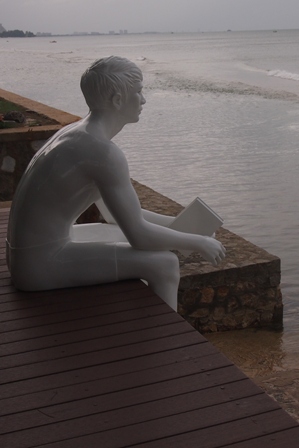 Seated statue at Let's Sea Al Fresco Resort[/caption]
I stayed at the Let’s Sea Al Fresco Resort in Hua Hin’s southern fringe, a boutique hotel that provides rare direct access to the beach. No higher than two stories, its forty or so rooms in two facing wings are large, airy and designed for cooling integration with the tropical climate. Each room faces one of the biggest swimming pools I’ve seen in Thailand. It’s a private lagoon instead of merely a pool, like a watery throughway bisecting the resort from lobby to beach.
[caption id="attachment_3062" align="alignnone" width="448"]
Seated statue at Let's Sea Al Fresco Resort[/caption]
I stayed at the Let’s Sea Al Fresco Resort in Hua Hin’s southern fringe, a boutique hotel that provides rare direct access to the beach. No higher than two stories, its forty or so rooms in two facing wings are large, airy and designed for cooling integration with the tropical climate. Each room faces one of the biggest swimming pools I’ve seen in Thailand. It’s a private lagoon instead of merely a pool, like a watery throughway bisecting the resort from lobby to beach.
[caption id="attachment_3062" align="alignnone" width="448"]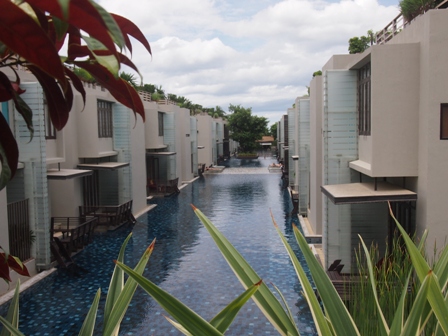 Let's Sea Al Fresco Resort pool[/caption]
I was upgraded to a second story room sporting a private roof garden with sun bed and outside shower. Getting to the pool was as easy as falling out my window; instead I used the stairs.
My bed was huge. The bathroom was enormous; a double shower and bathtub big enough for two completes the picture. I loved the space and used every corner.
Kids under 16 are not allowed so no loud splashing or screaming will be heard outside your door early in the morning, unless of course four 60ish Australians decide to play water polo and drink beer all day and night.
A small spa accompanies the picture. If a massage or facial is part of your holiday routine (like it is mine when I’m in Thailand), the list of treatments is long, enough to satisfy an ardent hedonist.
What I enjoyed most about the Let’s Sea Al Fresco Resort was the catering. The restaurant occupies a renovated house facing the beach. Later additions expanded the dining areas to accommodate small functions but no matter where you’re seated, the sense is that you’re a special customer with privileged access to a lovely restaurant situated on a quiet private beach. This is quite an achievement in crowded Hua Hin.
Each employee I engaged with at Let’s Sea was helpful and disarmingly friendly, smiles wide, ever ready with a respectful Wai and a Sabaidee Krub or Ka.
[caption id="attachment_3064" align="alignnone" width="336"]
Let's Sea Al Fresco Resort pool[/caption]
I was upgraded to a second story room sporting a private roof garden with sun bed and outside shower. Getting to the pool was as easy as falling out my window; instead I used the stairs.
My bed was huge. The bathroom was enormous; a double shower and bathtub big enough for two completes the picture. I loved the space and used every corner.
Kids under 16 are not allowed so no loud splashing or screaming will be heard outside your door early in the morning, unless of course four 60ish Australians decide to play water polo and drink beer all day and night.
A small spa accompanies the picture. If a massage or facial is part of your holiday routine (like it is mine when I’m in Thailand), the list of treatments is long, enough to satisfy an ardent hedonist.
What I enjoyed most about the Let’s Sea Al Fresco Resort was the catering. The restaurant occupies a renovated house facing the beach. Later additions expanded the dining areas to accommodate small functions but no matter where you’re seated, the sense is that you’re a special customer with privileged access to a lovely restaurant situated on a quiet private beach. This is quite an achievement in crowded Hua Hin.
Each employee I engaged with at Let’s Sea was helpful and disarmingly friendly, smiles wide, ever ready with a respectful Wai and a Sabaidee Krub or Ka.
[caption id="attachment_3064" align="alignnone" width="336"]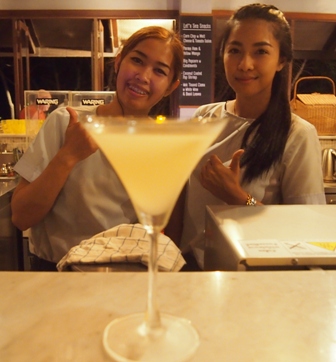 Let's Sea bartenders with a Tom Yum Martini[/caption]
Not one for spending more than one day sitting near a pool, nice as it occasionally is, I’m easily restless and opted for a day trip to the Sam Roi Yod (300 Peaks) National Park some forty kilometres south from Hua Hin. Here some of Thailand’s largest remaining mangrove forests and lagoons are protected despite continued encroachment from shrimp and mussel farms swallowing up surrounding wild land. Birdlife is extensive while a small population of Serow (a rare antelope that looks like a goat) exists amongst the peaks though habitat pressure from increasing tourism poses an ongoing threat.
[caption id="attachment_3070" align="alignnone" width="448"]
Let's Sea bartenders with a Tom Yum Martini[/caption]
Not one for spending more than one day sitting near a pool, nice as it occasionally is, I’m easily restless and opted for a day trip to the Sam Roi Yod (300 Peaks) National Park some forty kilometres south from Hua Hin. Here some of Thailand’s largest remaining mangrove forests and lagoons are protected despite continued encroachment from shrimp and mussel farms swallowing up surrounding wild land. Birdlife is extensive while a small population of Serow (a rare antelope that looks like a goat) exists amongst the peaks though habitat pressure from increasing tourism poses an ongoing threat.
[caption id="attachment_3070" align="alignnone" width="448"]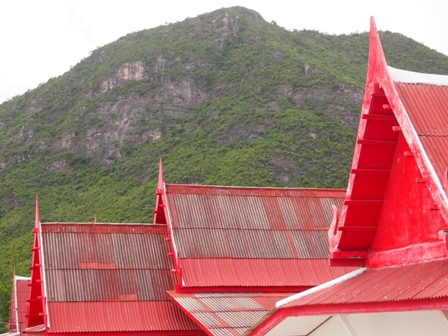 Temple roofs at Hoop Ta Khod[/caption]
Sprouting up from swampy lowlands like giant sugar cones, the karst peaks create breathtaking landscapes. Remote beaches are accessible but would require serious hiking to reach. I wish I’d had more time so I stopped at the touristy fishing village within the park instead of climbing steep mountains. From there a fast boat will take you across a shallow channel to a small island and the Than Phraya Nakhon, a large cave which is famous for King Chulalongkorn’s royal visit in the late 19th century, the same cave his father King Mongkut visited to witness the solar eclipse and where he coincidentally caught malaria which caused his death six weeks later.
[caption id="attachment_3071" align="alignnone" width="369"]
Temple roofs at Hoop Ta Khod[/caption]
Sprouting up from swampy lowlands like giant sugar cones, the karst peaks create breathtaking landscapes. Remote beaches are accessible but would require serious hiking to reach. I wish I’d had more time so I stopped at the touristy fishing village within the park instead of climbing steep mountains. From there a fast boat will take you across a shallow channel to a small island and the Than Phraya Nakhon, a large cave which is famous for King Chulalongkorn’s royal visit in the late 19th century, the same cave his father King Mongkut visited to witness the solar eclipse and where he coincidentally caught malaria which caused his death six weeks later.
[caption id="attachment_3071" align="alignnone" width="369"]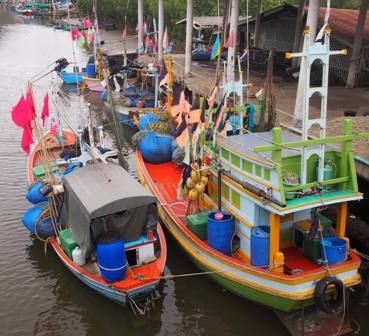 Boats moored at Sam Roi Yod fishing village[/caption]
Sad to say, I was bored by the whole exercise. The boat ride was overpriced, the water dirty, the cave littered and the island utterly disappointing. It looked so much better from a distance. Up close, I regretted the experience.
[caption id="attachment_3065" align="alignnone" width="448"]
Boats moored at Sam Roi Yod fishing village[/caption]
Sad to say, I was bored by the whole exercise. The boat ride was overpriced, the water dirty, the cave littered and the island utterly disappointing. It looked so much better from a distance. Up close, I regretted the experience.
[caption id="attachment_3065" align="alignnone" width="448"]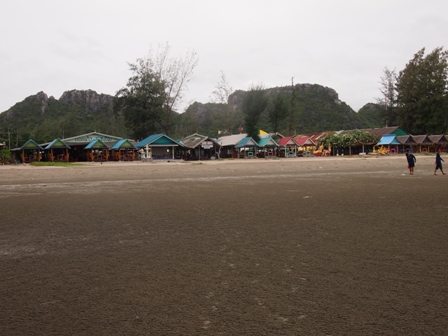 Beach at fishing village in Sam Yoi Rod National Park[/caption]
After a couple hours desultorily wandering round the glum village replete with tacky shops selling tourist tat, sleeping dogs bored out of their brains like me, I asked my guide if there was anywhere nearby to visit during the remainder of my one day tour. He was somewhat at a loss to provide alternative options. I’m not sure if he was being lazy or perhaps he misunderstood my wish to climb a mountain or walk in a mangrove swamp.
[caption id="attachment_3066" align="alignnone" width="448"]
Beach at fishing village in Sam Yoi Rod National Park[/caption]
After a couple hours desultorily wandering round the glum village replete with tacky shops selling tourist tat, sleeping dogs bored out of their brains like me, I asked my guide if there was anywhere nearby to visit during the remainder of my one day tour. He was somewhat at a loss to provide alternative options. I’m not sure if he was being lazy or perhaps he misunderstood my wish to climb a mountain or walk in a mangrove swamp.
[caption id="attachment_3066" align="alignnone" width="448"] Fishing Village dogs catching an afternoon nap[/caption]
A heavy smoker who coughed a lot, I forgave the guide his lack of energy, so we drove to the Three Buddha Temple (Hoop Ta Khot) in the middle of paddy fields at the edge of the national park. The walk from the car to the temple was fewer than ten metres but he sat in the car anyway.
[caption id="attachment_3067" align="alignnone" width="355"]
Fishing Village dogs catching an afternoon nap[/caption]
A heavy smoker who coughed a lot, I forgave the guide his lack of energy, so we drove to the Three Buddha Temple (Hoop Ta Khot) in the middle of paddy fields at the edge of the national park. The walk from the car to the temple was fewer than ten metres but he sat in the car anyway.
[caption id="attachment_3067" align="alignnone" width="355"]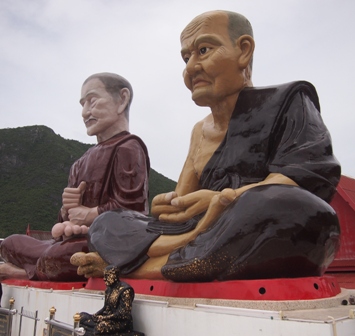 2 of 3 Buddha at Hoop Ta Khot temple[/caption]
After an hour at that temple, me killing time by taking photos of the three Buddha images from as many angles as possible, we stopped at the Wat Khao Taklap near Hua Hin where I was the only visiting farang.
[caption id="attachment_3073" align="alignnone" width="336"]
2 of 3 Buddha at Hoop Ta Khot temple[/caption]
After an hour at that temple, me killing time by taking photos of the three Buddha images from as many angles as possible, we stopped at the Wat Khao Taklap near Hua Hin where I was the only visiting farang.
[caption id="attachment_3073" align="alignnone" width="336"]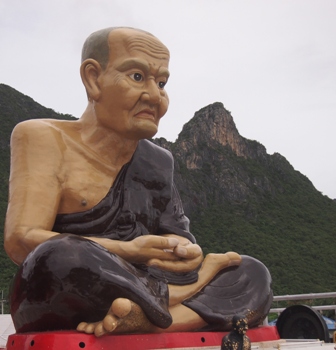 1 of 3 Buddha[/caption]
A Siamese cat scratched at my bare feet, begging for a rub behind the ears. I thought, ‘Funny this, my first Siamese cat in a Thai temple, how many trips to Thailand has it taken me to see a Thai cat in a Siamese temple?’ I think the sun was getting to me at that point so we drove back to the Let’s Sea Resort but not before I made a donation and bought a tiny brass Buddha statue in remembrance of the strange day. Incidentally, the view overlooking Hua Hin’s long beach is worth the climb to the top of the promontory.
[caption id="attachment_3068" align="alignnone" width="412"]
1 of 3 Buddha[/caption]
A Siamese cat scratched at my bare feet, begging for a rub behind the ears. I thought, ‘Funny this, my first Siamese cat in a Thai temple, how many trips to Thailand has it taken me to see a Thai cat in a Siamese temple?’ I think the sun was getting to me at that point so we drove back to the Let’s Sea Resort but not before I made a donation and bought a tiny brass Buddha statue in remembrance of the strange day. Incidentally, the view overlooking Hua Hin’s long beach is worth the climb to the top of the promontory.
[caption id="attachment_3068" align="alignnone" width="412"]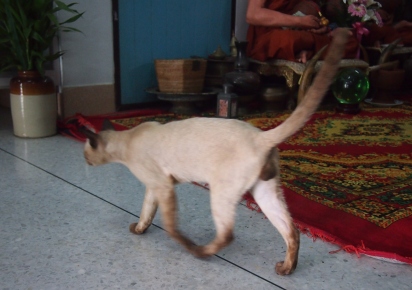 Siamese cat at Khao Tao temple[/caption]
By then I was ready for a Tom Yum Martini at the restaurant bar.
[caption id="attachment_3069" align="alignnone" width="336"]
Siamese cat at Khao Tao temple[/caption]
By then I was ready for a Tom Yum Martini at the restaurant bar.
[caption id="attachment_3069" align="alignnone" width="336"]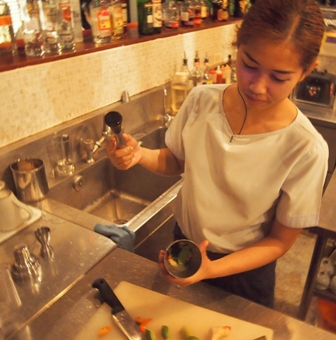 Tom Yum Martini making at Let's Sea[/caption]
Seated on a comfy deckchair, I watched the light change while nursing my sour, sweet, spicy, salty drink. Two Irrawaddy dolphins swam by not one hundred metres offshore. A bartender shouted ‘Lohmaa!’ (Dolphin!), while a small crowd of beachcombers gathered, watching as the dolphins swam south towards the temple I’d visited earlier.
Was it another ordinary day at a Thai beach resort town?
I don’t believe there’s any such thing as ordinary.
Tom Neal Tacker travelled courtesy of Tourism Authority of Thailand and as a guest of Hansar Samui Resort & Spa and Let’s Sea Al Fresco Resort.
Naked Facts:
Koh Samui is an hour’s flight from Bangkok. Both Bangkok Airways (www.bangkokair.com) and Thai Airways (www.thaiairways.com) offer frequent daily services.
Koh Samui’s airport is approximately fifteen minute’s drive from the Hansar Samui Resort & Spa. Private transfers can be included when booking.
Koh Samui is an hour’s ferry trip from the small port near Surat Thani. Ferries dock at Na Thon on Koh Samui’s western side. Bo Phut beach is approximately a half hour’s drive from Na Thon depending on traffic.
See www.hansarsamui.com for reservations and special offers.
Hua Hin is approximately three to four hour’s drive from Bangkok, depending on traffic. Train services operate daily direct from Bangkok to Hua Hin. The trip takes approximately four hours.
Let’s Sea Al Fresco Resort’s sister property in Bangkok is the new 5-star Lit Hotel (www.litbangkok.com). Private transfers operate once daily between the two properties at a minimal cost, approximately 400 Baht.
See www.leetussea.com for reservations and special offers.
Tom Yum Martini making at Let's Sea[/caption]
Seated on a comfy deckchair, I watched the light change while nursing my sour, sweet, spicy, salty drink. Two Irrawaddy dolphins swam by not one hundred metres offshore. A bartender shouted ‘Lohmaa!’ (Dolphin!), while a small crowd of beachcombers gathered, watching as the dolphins swam south towards the temple I’d visited earlier.
Was it another ordinary day at a Thai beach resort town?
I don’t believe there’s any such thing as ordinary.
Tom Neal Tacker travelled courtesy of Tourism Authority of Thailand and as a guest of Hansar Samui Resort & Spa and Let’s Sea Al Fresco Resort.
Naked Facts:
Koh Samui is an hour’s flight from Bangkok. Both Bangkok Airways (www.bangkokair.com) and Thai Airways (www.thaiairways.com) offer frequent daily services.
Koh Samui’s airport is approximately fifteen minute’s drive from the Hansar Samui Resort & Spa. Private transfers can be included when booking.
Koh Samui is an hour’s ferry trip from the small port near Surat Thani. Ferries dock at Na Thon on Koh Samui’s western side. Bo Phut beach is approximately a half hour’s drive from Na Thon depending on traffic.
See www.hansarsamui.com for reservations and special offers.
Hua Hin is approximately three to four hour’s drive from Bangkok, depending on traffic. Train services operate daily direct from Bangkok to Hua Hin. The trip takes approximately four hours.
Let’s Sea Al Fresco Resort’s sister property in Bangkok is the new 5-star Lit Hotel (www.litbangkok.com). Private transfers operate once daily between the two properties at a minimal cost, approximately 400 Baht.
See www.leetussea.com for reservations and special offers.
 https://nakedhungrytraveller.com.au/myanmar-meandering-yangon/ Myanmar Meandering in YangonIn 2010 when Myanmar’s repressive military government freed Aung San Suu Kyi from years of unjustified incarceration, the world took notice. Suddenly, closed doors opened. Strict visa laws applied to foreign tourists were relaxed. Interested bystanders bent on visiting Myanmar soon as possible welcomed the change with open arms and wallets. Almost overnight, Myanmar became the go-to country for all serious travellers. You simply have to go there before everyone else does. I can’t tell you how many times I’ve heard that given as a logical reason for visiting Myanmar: ‘Go there before it changes forever’ is the cliché at the tip of many globe-trotting tongues. If a popular destination can be smacked by impressions of desperation, Myanmar is it. I don’t believe all of Myanmar will change virtually overnight. The country has been isolated from the world for so long that real change won’t happen quickly. For now, change is mostly cosmetic. Politicians like those in power in Myanmar change stripes to suit a different tiger. Big business smells money and moves in fast to make an even faster buck. Where does this leave the majority of Myanmar people? I say, well behind. [caption id="attachment_2978" align="alignnone" width="448"]
https://nakedhungrytraveller.com.au/myanmar-meandering-yangon/ Myanmar Meandering in YangonIn 2010 when Myanmar’s repressive military government freed Aung San Suu Kyi from years of unjustified incarceration, the world took notice. Suddenly, closed doors opened. Strict visa laws applied to foreign tourists were relaxed. Interested bystanders bent on visiting Myanmar soon as possible welcomed the change with open arms and wallets. Almost overnight, Myanmar became the go-to country for all serious travellers. You simply have to go there before everyone else does. I can’t tell you how many times I’ve heard that given as a logical reason for visiting Myanmar: ‘Go there before it changes forever’ is the cliché at the tip of many globe-trotting tongues. If a popular destination can be smacked by impressions of desperation, Myanmar is it. I don’t believe all of Myanmar will change virtually overnight. The country has been isolated from the world for so long that real change won’t happen quickly. For now, change is mostly cosmetic. Politicians like those in power in Myanmar change stripes to suit a different tiger. Big business smells money and moves in fast to make an even faster buck. Where does this leave the majority of Myanmar people? I say, well behind. [caption id="attachment_2978" align="alignnone" width="448"] Market scene near Shwe Dagon Pagoda[/caption]
Slow travel is what Myanmar is all about. Slow change follows suit.
What have I learned about Myanmar?
To begin, let’s study some basic facts about tourism in Myanmar as it is right now.
During high season (November until April) hotels in tourism hot spots such as Pagan, Yangon, Lake Inle and Mandalay are packed to the rafters.
No surprises here.
Why?
First, there aren’t enough hotels to satisfy demand. Infrastructure isn’t keeping pace with demand despite more hotels going up almost overnight, particularly in Yangon.
Second, those four destinations rightly offer much to travellers and they’re justifiably popular. Beyond the four, mass tourism support is rudimentary at best.
Third, this quartet of Myanmar hot-spots is linked by frequent air services. The majority of roads in Myanmar are rougher than a local opium drug dealer.
For time poor travellers, flying is the essential transport mode. As a consequence, new airlines have popped up overnight to meet demand. I’m not certain about how well international safety procedures are followed but the country is keen on investment from foreign visitors so risk factors have been studiously reduced. Safe flying appears intact as official government policy though I have my doubts as Myanmar’s government is anything but transparent.
How to avoid overcrowding and extortionate pricing during high season?
Visit in the off or low season.
[caption id="attachment_2979" align="alignnone" width="448"]
Market scene near Shwe Dagon Pagoda[/caption]
Slow travel is what Myanmar is all about. Slow change follows suit.
What have I learned about Myanmar?
To begin, let’s study some basic facts about tourism in Myanmar as it is right now.
During high season (November until April) hotels in tourism hot spots such as Pagan, Yangon, Lake Inle and Mandalay are packed to the rafters.
No surprises here.
Why?
First, there aren’t enough hotels to satisfy demand. Infrastructure isn’t keeping pace with demand despite more hotels going up almost overnight, particularly in Yangon.
Second, those four destinations rightly offer much to travellers and they’re justifiably popular. Beyond the four, mass tourism support is rudimentary at best.
Third, this quartet of Myanmar hot-spots is linked by frequent air services. The majority of roads in Myanmar are rougher than a local opium drug dealer.
For time poor travellers, flying is the essential transport mode. As a consequence, new airlines have popped up overnight to meet demand. I’m not certain about how well international safety procedures are followed but the country is keen on investment from foreign visitors so risk factors have been studiously reduced. Safe flying appears intact as official government policy though I have my doubts as Myanmar’s government is anything but transparent.
How to avoid overcrowding and extortionate pricing during high season?
Visit in the off or low season.
[caption id="attachment_2979" align="alignnone" width="448"]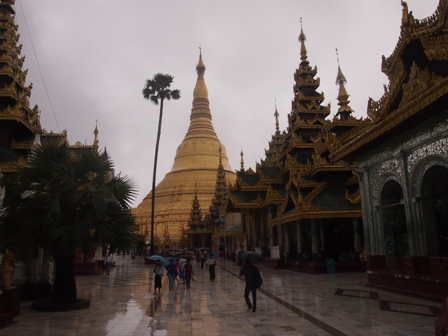 Shwe Dagon Pagoda under monsoon skies[/caption]
I was in Myanmar during the beginning of the monsoon. Hotels had rooms to spare. Prices were lower. Tourist sites were uncrowded. Like the Thais, Myanmar tourism apparatchik has embraced the descriptive phrase ‘Green Season’ as an attractive monsoon moniker. Certainly the slightly cooler though damp weather is enticing instead of May and June’s sweltering and dry heat.
Most travellers will begin and end their Myanmar visits in Yangon, the country’s largest and busiest city.
Since the capital was moved to Naypyidaw in 2005, (apparently on instruction from a general’s astrologer whose advice was so esteemed by the superstitious leader that an entire city was built at huge expense in the middle of nowhere) Yangon’s administrative and government buildings are now mostly vacant or under restoration while morphing into 5-star hotels or perhaps museums. No doubt a shopping centre is planned for a number of those great old relics.
[caption id="attachment_2980" align="alignnone" width="448"]
Shwe Dagon Pagoda under monsoon skies[/caption]
I was in Myanmar during the beginning of the monsoon. Hotels had rooms to spare. Prices were lower. Tourist sites were uncrowded. Like the Thais, Myanmar tourism apparatchik has embraced the descriptive phrase ‘Green Season’ as an attractive monsoon moniker. Certainly the slightly cooler though damp weather is enticing instead of May and June’s sweltering and dry heat.
Most travellers will begin and end their Myanmar visits in Yangon, the country’s largest and busiest city.
Since the capital was moved to Naypyidaw in 2005, (apparently on instruction from a general’s astrologer whose advice was so esteemed by the superstitious leader that an entire city was built at huge expense in the middle of nowhere) Yangon’s administrative and government buildings are now mostly vacant or under restoration while morphing into 5-star hotels or perhaps museums. No doubt a shopping centre is planned for a number of those great old relics.
[caption id="attachment_2980" align="alignnone" width="448"]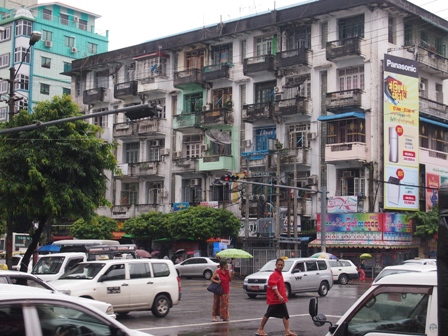 Not renovated yet? Old Yangon[/caption]
Yangon does nonetheless possess a nostalgic allure. When the British turned backwater Rangoon into the capital city in the late 19th century, the adoption of Victorian Raj-style architecture was apparently compulsory for urban planning under home rule. Much of that stuck-on heritage still exists; serving nicely as Yangon’s claim to fame amongst most travellers.
Compared to other southeast Asian cities where 19th century Anglo-Gallic architecture is saved only because greedy developers can’t get their dirty hands on the land, Yangon’s look of faded glory is conversely refreshing.
Just in time, local crooked property developers realise that in Yangon, maintaining an the old look, if only for the building’s facade, might just be the ticket to increased profitability.
The ‘Rip it down if it’s old and falling apart anyway’ mentality isn’t so prevalent in Yangon... yet.
If UNESCO grants World Heritage listing to Yangon’s CBD, as it’s rumoured to do, the nail on the heritage coffin won’t be struck down hard and the glorious faded ruins will get a fresh lick of paint as they’re tarted up for increasing numbers of tourists.
This current state of transition in Yangon partly fuels the ‘Go there before it changes’ attraction about Myanmar. Most savvy, albeit cynical, travellers realise how money talks universally.
Given the current Myanmar military government’s total embrace of corruption on a gigantic scale, no one would be mildly surprised to see the rules bent to suit the aims of the powers that be.
Yangon’s past is not yet guaranteed for saving.
Of course, Yangon isn’t all about nostalgic architecture tripping. It’s the home of the country’s most important Buddhist shrine, the sublime Shwe Dagon Pagoda.
[caption id="attachment_2981" align="alignnone" width="448"]
Not renovated yet? Old Yangon[/caption]
Yangon does nonetheless possess a nostalgic allure. When the British turned backwater Rangoon into the capital city in the late 19th century, the adoption of Victorian Raj-style architecture was apparently compulsory for urban planning under home rule. Much of that stuck-on heritage still exists; serving nicely as Yangon’s claim to fame amongst most travellers.
Compared to other southeast Asian cities where 19th century Anglo-Gallic architecture is saved only because greedy developers can’t get their dirty hands on the land, Yangon’s look of faded glory is conversely refreshing.
Just in time, local crooked property developers realise that in Yangon, maintaining an the old look, if only for the building’s facade, might just be the ticket to increased profitability.
The ‘Rip it down if it’s old and falling apart anyway’ mentality isn’t so prevalent in Yangon... yet.
If UNESCO grants World Heritage listing to Yangon’s CBD, as it’s rumoured to do, the nail on the heritage coffin won’t be struck down hard and the glorious faded ruins will get a fresh lick of paint as they’re tarted up for increasing numbers of tourists.
This current state of transition in Yangon partly fuels the ‘Go there before it changes’ attraction about Myanmar. Most savvy, albeit cynical, travellers realise how money talks universally.
Given the current Myanmar military government’s total embrace of corruption on a gigantic scale, no one would be mildly surprised to see the rules bent to suit the aims of the powers that be.
Yangon’s past is not yet guaranteed for saving.
Of course, Yangon isn’t all about nostalgic architecture tripping. It’s the home of the country’s most important Buddhist shrine, the sublime Shwe Dagon Pagoda.
[caption id="attachment_2981" align="alignnone" width="448"] A small side view of enormous Shwe Dagon Pagoda[/caption]
What St. Peter’s Basilica is to devout Italian Catholics, the Shwe Dagon Pagoda is to devout Burmese Buddhists. Eight hairs of the Buddha are embedded in the main pagoda, unseen but most assuredly there, so I was told by my guide and everyone else I asked.
The great gold wrapped Shwe Dagon is Yangon’s true beating heart. A whole industry revolves around it and the thousands of daily visitors who come to pay tribute to Buddha’s enshrined hairs and teachings whose influence inform whole populations of devotees.
Food markets, restaurants, monasteries filled with monks whose dawn perambulations, begging bowls in hand, saffron coloured robes swishing about their sinewy bodies populate the surrounding streets. Shops selling Buddhist relics mix in with florists selling kaleidoscopic arrays of plants for offering to Shwe Dagon’s numerous shrines. Astrologists operate out of miniscule holes-in-walls dispensing advice to starry eyed clients, me amongst them. Apparently I shouldn’t trust all my closest friends and a new business venture will grant me great riches next year.
[caption id="attachment_2982" align="alignnone" width="336"]
A small side view of enormous Shwe Dagon Pagoda[/caption]
What St. Peter’s Basilica is to devout Italian Catholics, the Shwe Dagon Pagoda is to devout Burmese Buddhists. Eight hairs of the Buddha are embedded in the main pagoda, unseen but most assuredly there, so I was told by my guide and everyone else I asked.
The great gold wrapped Shwe Dagon is Yangon’s true beating heart. A whole industry revolves around it and the thousands of daily visitors who come to pay tribute to Buddha’s enshrined hairs and teachings whose influence inform whole populations of devotees.
Food markets, restaurants, monasteries filled with monks whose dawn perambulations, begging bowls in hand, saffron coloured robes swishing about their sinewy bodies populate the surrounding streets. Shops selling Buddhist relics mix in with florists selling kaleidoscopic arrays of plants for offering to Shwe Dagon’s numerous shrines. Astrologists operate out of miniscule holes-in-walls dispensing advice to starry eyed clients, me amongst them. Apparently I shouldn’t trust all my closest friends and a new business venture will grant me great riches next year.
[caption id="attachment_2982" align="alignnone" width="336"]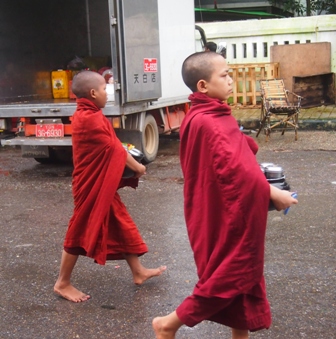 Young monks collecting alms near Shwe Dagon Pagoda[/caption]
I visited Shwe Dagon every day during an eight days visit to Yangon. If only to hang out at a ‘mohinga’ cafe (the country’s ubiquitous fish noodle soup, served normally at breakfast) or to sip from tiny cups of ‘lapayee’, Burmese super-strong sweet and milky tea, about 10 cents per cup, watching the Myanmar world proceed slowly by. During monsoon season when rain hammers down with the force of a boxer’s punch and humidity is soaking wet high, no one moves very fast.
[caption id="attachment_2983" align="alignnone" width="382"]
Young monks collecting alms near Shwe Dagon Pagoda[/caption]
I visited Shwe Dagon every day during an eight days visit to Yangon. If only to hang out at a ‘mohinga’ cafe (the country’s ubiquitous fish noodle soup, served normally at breakfast) or to sip from tiny cups of ‘lapayee’, Burmese super-strong sweet and milky tea, about 10 cents per cup, watching the Myanmar world proceed slowly by. During monsoon season when rain hammers down with the force of a boxer’s punch and humidity is soaking wet high, no one moves very fast.
[caption id="attachment_2983" align="alignnone" width="382"] Burmese tea, 'lapayee'.[/caption]
[caption id="attachment_2984" align="alignnone" width="448"]
Burmese tea, 'lapayee'.[/caption]
[caption id="attachment_2984" align="alignnone" width="448"] Hot bowls of 'mohinga' for breakfast[/caption]
Yangon’s other vital organ, its stomach, comparing favourably to Shwe Dagon’s beating heart, is the riverfront. Not a tourist site per se, the commodious wharves are busy from dawn to dusk with all manner of intrastate shipping. Low slung barges offload or load with bananas, coconuts, sugar cane, pineapples, bags of rice and tonnes of cargo readying for shipment downriver to the Delta or upriver to otherwise inaccessible towns lining the great Irrawaddy River.
[caption id="attachment_3018" align="alignnone" width="448"]
Hot bowls of 'mohinga' for breakfast[/caption]
Yangon’s other vital organ, its stomach, comparing favourably to Shwe Dagon’s beating heart, is the riverfront. Not a tourist site per se, the commodious wharves are busy from dawn to dusk with all manner of intrastate shipping. Low slung barges offload or load with bananas, coconuts, sugar cane, pineapples, bags of rice and tonnes of cargo readying for shipment downriver to the Delta or upriver to otherwise inaccessible towns lining the great Irrawaddy River.
[caption id="attachment_3018" align="alignnone" width="448"]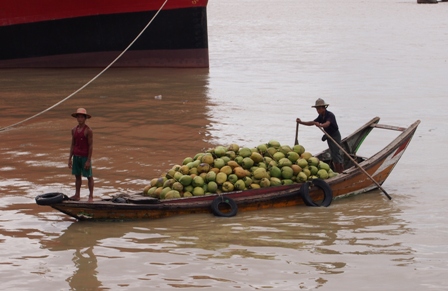 There is a boat under those coconuts[/caption]
At the Yangon River wharves Yangon city is alive and thriving. No industrial cranes operate at these inner city wharves. It’s all manpower or no power. Shifting 50 kilo bags of rice up and down shaky gangplanks while balanced on narrow shoulders is a job not suited to the weak.
[caption id="attachment_2985" align="alignnone" width="423"]
There is a boat under those coconuts[/caption]
At the Yangon River wharves Yangon city is alive and thriving. No industrial cranes operate at these inner city wharves. It’s all manpower or no power. Shifting 50 kilo bags of rice up and down shaky gangplanks while balanced on narrow shoulders is a job not suited to the weak.
[caption id="attachment_2985" align="alignnone" width="423"] Hard work under rice sacks at Yangon wharves[/caption]
If you visit Yangon, two stops are obligatory on the local tourist trail: Shwe Dagon Pagoda and the river wharves. See them both and begin to understand how this city lives.
[caption id="attachment_2987" align="alignnone" width="375"]
Hard work under rice sacks at Yangon wharves[/caption]
If you visit Yangon, two stops are obligatory on the local tourist trail: Shwe Dagon Pagoda and the river wharves. See them both and begin to understand how this city lives.
[caption id="attachment_2987" align="alignnone" width="375"]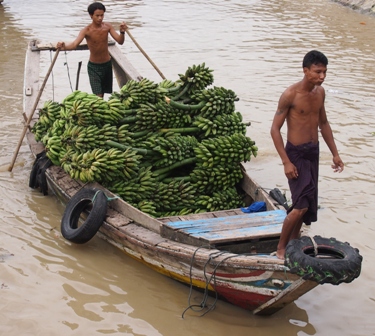 Banana boatmen[/caption]
One day I ventured with an excellent guide for a walk on the wild side. We made an excursion to the Yangon River’s opposite bank to Dalah village, where the rents are cheaper, where the living is harder and from where the local folk commute daily on grimy crowded ferries.
[caption id="attachment_2988" align="alignnone" width="363"]
Banana boatmen[/caption]
One day I ventured with an excellent guide for a walk on the wild side. We made an excursion to the Yangon River’s opposite bank to Dalah village, where the rents are cheaper, where the living is harder and from where the local folk commute daily on grimy crowded ferries.
[caption id="attachment_2988" align="alignnone" width="363"]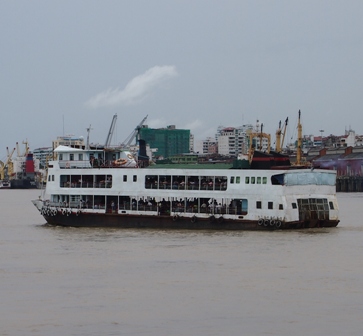 Yangon River ferry[/caption]
[caption id="attachment_3020" align="alignnone" width="448"]
Yangon River ferry[/caption]
[caption id="attachment_3020" align="alignnone" width="448"]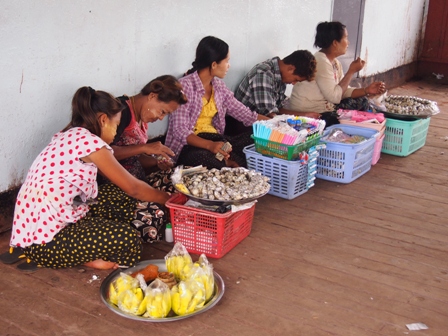 Peddlers aboard Dalah ferry[/caption]
A bridge has not yet been built over the Yangon River. Its bed is too silty and the bridge foundations would prove too costly were two explanations I was given.
[caption id="attachment_2989" align="alignnone" width="448"]
Peddlers aboard Dalah ferry[/caption]
A bridge has not yet been built over the Yangon River. Its bed is too silty and the bridge foundations would prove too costly were two explanations I was given.
[caption id="attachment_2989" align="alignnone" width="448"]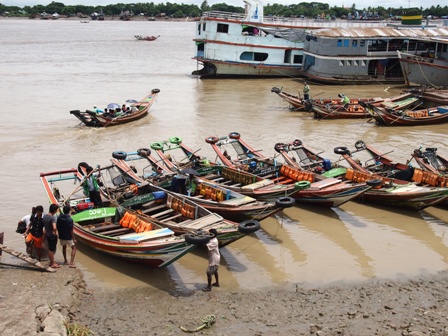 Empty water taxis waiting for afternoon rush[/caption]
Over in Dalah town, I visited yet another food market, this one so squalidly dirty that even I was a bit shocked. When you spy another decrepit pariah dog lying next to a slab of pig meat or a skinny chicken carcass covered in flies on a filthy bamboo table, butcher squatting nearby, machete in hand ready to chop off a gristly bit (the pig’s not the dog’s) for that night’s curry, the overall impression is one of complete exasperation touched with despair. How could I feel otherwise?
[caption id="attachment_2990" align="alignnone" width="422"]
Empty water taxis waiting for afternoon rush[/caption]
Over in Dalah town, I visited yet another food market, this one so squalidly dirty that even I was a bit shocked. When you spy another decrepit pariah dog lying next to a slab of pig meat or a skinny chicken carcass covered in flies on a filthy bamboo table, butcher squatting nearby, machete in hand ready to chop off a gristly bit (the pig’s not the dog’s) for that night’s curry, the overall impression is one of complete exasperation touched with despair. How could I feel otherwise?
[caption id="attachment_2990" align="alignnone" width="422"]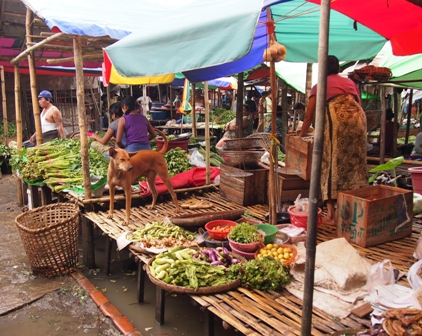 Dalah market scene with wandering dog[/caption]
Average annual incomes in Myanmar are stuck at the bottom end of extreme poverty levels as measured on OECD scales including annual income, nutrition intake, work accessibility, education levels and provision of health care. Villagers migrate to cities such as Yangon in search of a liveable wage, hopefully with enough cash to send to families steadfastly waiting for help in the home village. Despite political change, life for the great majority of Myanmar’s people continues to be inexorably challenging.
[caption id="attachment_2991" align="alignnone" width="448"]
Dalah market scene with wandering dog[/caption]
Average annual incomes in Myanmar are stuck at the bottom end of extreme poverty levels as measured on OECD scales including annual income, nutrition intake, work accessibility, education levels and provision of health care. Villagers migrate to cities such as Yangon in search of a liveable wage, hopefully with enough cash to send to families steadfastly waiting for help in the home village. Despite political change, life for the great majority of Myanmar’s people continues to be inexorably challenging.
[caption id="attachment_2991" align="alignnone" width="448"]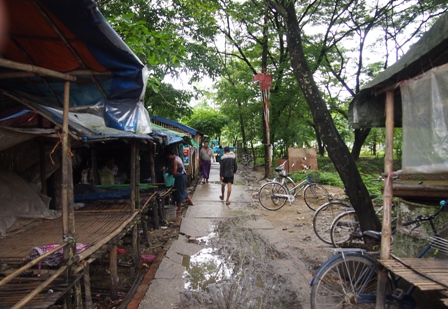 Dalah market laneway[/caption]
Worse still is a dog’s life. I felt sorry for all the street dogs I met in Myanmar. Theirs is not a contented life on the Buddhist wheel of reincarnation. Dalah’s dogs appear to have been meted an exceptionally dismal allotment in this life.
[caption id="attachment_2992" align="alignnone" width="448"]
Dalah market laneway[/caption]
Worse still is a dog’s life. I felt sorry for all the street dogs I met in Myanmar. Theirs is not a contented life on the Buddhist wheel of reincarnation. Dalah’s dogs appear to have been meted an exceptionally dismal allotment in this life.
[caption id="attachment_2992" align="alignnone" width="448"]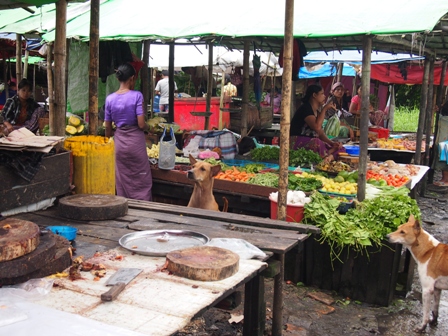 Hungry dogs at Dalah market[/caption]
[caption id="attachment_2994" align="alignnone" width="393"]
Hungry dogs at Dalah market[/caption]
[caption id="attachment_2994" align="alignnone" width="393"]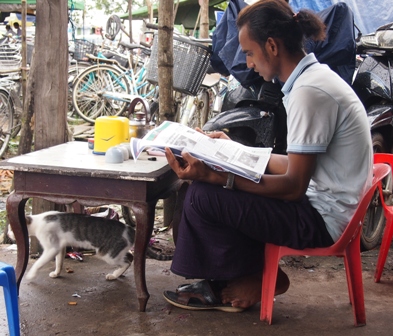 Myanmar cafes offer tiny plastic chairs, useful when waiting for rain to cease[/caption]
My guide and I sat under cover in a cafe out of the rain for a couple hours, chatting about politics and Myanmar’s unexpectedly rapid change to modernisation. We had hired a cyclo-rickshaw to cart us around. The driver was a fun guy, ever ready with a smile, sporting iron strong thighs toughened from hauling commuters to and from ferry wharves and the bustling though sodden market.
[caption id="attachment_2993" align="alignnone" width="394"]
Myanmar cafes offer tiny plastic chairs, useful when waiting for rain to cease[/caption]
My guide and I sat under cover in a cafe out of the rain for a couple hours, chatting about politics and Myanmar’s unexpectedly rapid change to modernisation. We had hired a cyclo-rickshaw to cart us around. The driver was a fun guy, ever ready with a smile, sporting iron strong thighs toughened from hauling commuters to and from ferry wharves and the bustling though sodden market.
[caption id="attachment_2993" align="alignnone" width="394"] Dalah cyclo driver at wharves[/caption]
Heavy rains for the past week nearly inundated most stallholders’ businesses. Dengue fever was rife. Hospitals were full of patients brought down by the dreaded ‘break-bone fever’.
[caption id="attachment_3017" align="alignnone" width="336"]
Dalah cyclo driver at wharves[/caption]
Heavy rains for the past week nearly inundated most stallholders’ businesses. Dengue fever was rife. Hospitals were full of patients brought down by the dreaded ‘break-bone fever’.
[caption id="attachment_3017" align="alignnone" width="336"]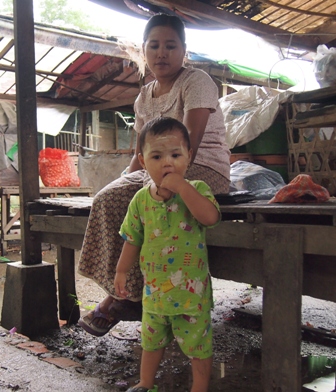 Dalah market, child with mother[/caption]
On another day, without a guide in tow, I hopped aboard the slow train around Yangon. In a country with few railroads, Yangon is blessed with a circle line. I kid you not.
[caption id="attachment_2995" align="alignnone" width="348"]
Dalah market, child with mother[/caption]
On another day, without a guide in tow, I hopped aboard the slow train around Yangon. In a country with few railroads, Yangon is blessed with a circle line. I kid you not.
[caption id="attachment_2995" align="alignnone" width="348"] Monk waiting for circle line train[/caption]
From Yangon’s faux Oriental folly of a central station, trains depart approximately once every two hours or so, one heading clockwise, another anti-clockwise. Punctuality is admirably respected. This adherence to an almost British sense of punctiliousness is in stark contrast to the state of the rail bed and engine speed.
A TGV train this is not.
For about one dollar, you get nearly three hours of gently unfolding glimpses of life, like looking through a coffee table book filled with arresting images.
Fetid slums swimming amidst barges of floating rubbish intersperse with narrow paddies planted edge to edge with water spinach or rice. Some neglected paddies supported cloaks of suffocating water hyacinth; others were bright spots of lotus plants whose blossoms tilted towards the sun hiding behind heavy dark clouds. Fellow passengers napped or chatted on their phones.
[caption id="attachment_2996" align="alignnone" width="336"]
Monk waiting for circle line train[/caption]
From Yangon’s faux Oriental folly of a central station, trains depart approximately once every two hours or so, one heading clockwise, another anti-clockwise. Punctuality is admirably respected. This adherence to an almost British sense of punctiliousness is in stark contrast to the state of the rail bed and engine speed.
A TGV train this is not.
For about one dollar, you get nearly three hours of gently unfolding glimpses of life, like looking through a coffee table book filled with arresting images.
Fetid slums swimming amidst barges of floating rubbish intersperse with narrow paddies planted edge to edge with water spinach or rice. Some neglected paddies supported cloaks of suffocating water hyacinth; others were bright spots of lotus plants whose blossoms tilted towards the sun hiding behind heavy dark clouds. Fellow passengers napped or chatted on their phones.
[caption id="attachment_2996" align="alignnone" width="336"]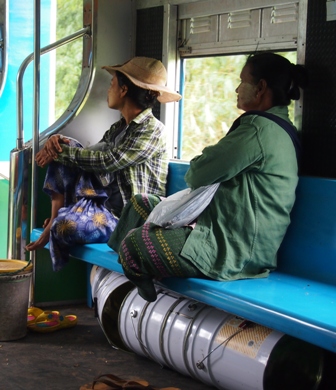 Passengers on board the circle line train[/caption]
Mobile phones have proliferated in Myanmar since the price of a phone fell from USD$2,000 to less than USD$10 in a quick three years. Though internet connection in Myanmar, even in Yangon, is still wonky and the government controls access to online search engines, people seem to have embraced device-life here as much as anywhere else in modern society.
[caption id="attachment_3016" align="alignnone" width="448"]
Passengers on board the circle line train[/caption]
Mobile phones have proliferated in Myanmar since the price of a phone fell from USD$2,000 to less than USD$10 in a quick three years. Though internet connection in Myanmar, even in Yangon, is still wonky and the government controls access to online search engines, people seem to have embraced device-life here as much as anywhere else in modern society.
[caption id="attachment_3016" align="alignnone" width="448"]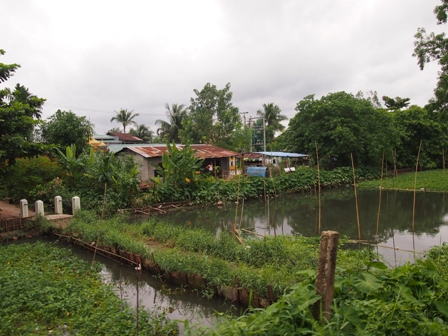 Paddies seen from circle line train[/caption]
Each station, (there were 38 and we stopped at each one during our 38 ks circumnavigation of Yangon) provided an opportunity to wave at passersby: noodle sellers, nut purveyors, cold drink hucksters and idle onlookers lazing the day watching slow moving trains.
Through open windows, no flyscreens or shades, just open space to let in fresh air, rain or clouds of flying insects, passengers are treated to outer Yangon’s rural scenery, the occasional water buffalo lifting its horned head from a swampy paddy or a horse cart trundling off into the distance to a market town up the Irrawaddy Delta.
[caption id="attachment_2997" align="alignnone" width="448"]
Paddies seen from circle line train[/caption]
Each station, (there were 38 and we stopped at each one during our 38 ks circumnavigation of Yangon) provided an opportunity to wave at passersby: noodle sellers, nut purveyors, cold drink hucksters and idle onlookers lazing the day watching slow moving trains.
Through open windows, no flyscreens or shades, just open space to let in fresh air, rain or clouds of flying insects, passengers are treated to outer Yangon’s rural scenery, the occasional water buffalo lifting its horned head from a swampy paddy or a horse cart trundling off into the distance to a market town up the Irrawaddy Delta.
[caption id="attachment_2997" align="alignnone" width="448"]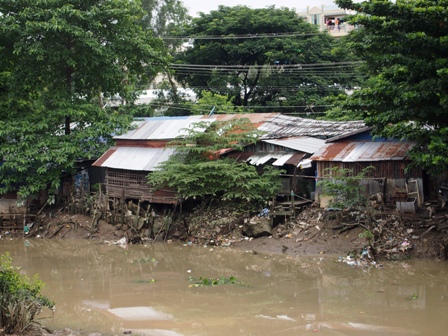 Shacks seen from circle line train[/caption]
This was the best value commuter experience I’ve had anywhere.
[caption id="attachment_2999" align="alignnone" width="448"]
Shacks seen from circle line train[/caption]
This was the best value commuter experience I’ve had anywhere.
[caption id="attachment_2999" align="alignnone" width="448"]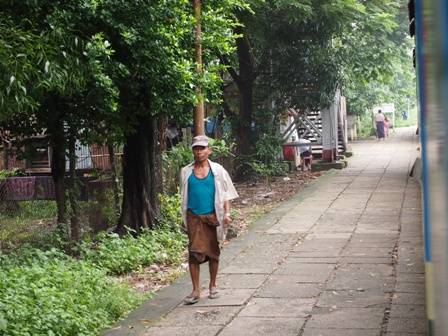 Circle line station scene[/caption]
My very first stop in Yangon, not twenty minutes after passing through a surprisingly congenial Customs & Immigration procedure, was at Aung San Suu Kyi’s house located next to Inya Lake in the city’s toniest neighbourhood. ‘The Lady’, as she’s known universally in Myanmar no longer lives full time in the house where she was imprisoned for so many years. Instead she lives mostly in Naypyidaw, or she’s travelling overseas or throughout Myanmar.
[caption id="attachment_2998" align="alignnone" width="448"]
Circle line station scene[/caption]
My very first stop in Yangon, not twenty minutes after passing through a surprisingly congenial Customs & Immigration procedure, was at Aung San Suu Kyi’s house located next to Inya Lake in the city’s toniest neighbourhood. ‘The Lady’, as she’s known universally in Myanmar no longer lives full time in the house where she was imprisoned for so many years. Instead she lives mostly in Naypyidaw, or she’s travelling overseas or throughout Myanmar.
[caption id="attachment_2998" align="alignnone" width="448"]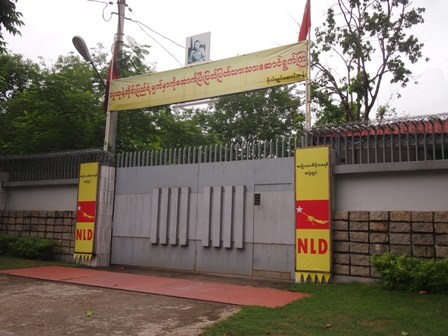 Gate at Aung San Suu Kyi's house[/caption]
Being something of a political animal incessantly curious about what makes governments tick, I also visited the National League of Democracy’s national headquarters in Yangon. I leave it to you dear reader to follow up on the vagaries of contemporary Myanmar politics. Suffice to say, it’s a nasty business where power is held in the hands of a small group of very nasty people, some related to the ruling junta who pull puppet strings behind the scenes.
[caption id="attachment_3001" align="alignnone" width="448"]
Gate at Aung San Suu Kyi's house[/caption]
Being something of a political animal incessantly curious about what makes governments tick, I also visited the National League of Democracy’s national headquarters in Yangon. I leave it to you dear reader to follow up on the vagaries of contemporary Myanmar politics. Suffice to say, it’s a nasty business where power is held in the hands of a small group of very nasty people, some related to the ruling junta who pull puppet strings behind the scenes.
[caption id="attachment_3001" align="alignnone" width="448"] NLD campaign volunteers at work[/caption]
Travelling in Myanmar requires a degree of incredulity checking. Gossip-mongering is rife. I heard tales that made my blood run cold; or my ire was raised conversely to boiling point. In such a poverty struck country, a few kleptocrats closely connected to government or actually in charge of it, have attained ill-gotten wealth that would cause a blush in the face of a Marcos or Assad or even a Mobutu or two.
[caption id="attachment_3000" align="alignnone" width="448"]
NLD campaign volunteers at work[/caption]
Travelling in Myanmar requires a degree of incredulity checking. Gossip-mongering is rife. I heard tales that made my blood run cold; or my ire was raised conversely to boiling point. In such a poverty struck country, a few kleptocrats closely connected to government or actually in charge of it, have attained ill-gotten wealth that would cause a blush in the face of a Marcos or Assad or even a Mobutu or two.
[caption id="attachment_3000" align="alignnone" width="448"] NLD headquarters[/caption]
The NLD headquarters continue to serve as a focus for military agents spying on campaign workers and visitors. The dingy drinks stalls directly across the road from where Aung San Suu Kyi’s volunteers crusade for transparency and justice in national government is where clandestine observers (i.e. paid thugs) are staked out, though their presence is not as stark as it was before the by-elections of 2012. I waved at a couple of them in hopes they’d photograph me from a flattering angle. No such luck.
[caption id="attachment_3002" align="alignnone" width="414"]
NLD headquarters[/caption]
The NLD headquarters continue to serve as a focus for military agents spying on campaign workers and visitors. The dingy drinks stalls directly across the road from where Aung San Suu Kyi’s volunteers crusade for transparency and justice in national government is where clandestine observers (i.e. paid thugs) are staked out, though their presence is not as stark as it was before the by-elections of 2012. I waved at a couple of them in hopes they’d photograph me from a flattering angle. No such luck.
[caption id="attachment_3002" align="alignnone" width="414"]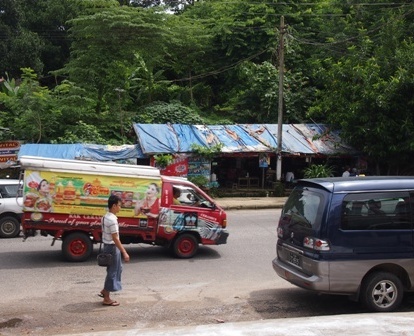 Tea shop opposite NLD headquaters[/caption]
I also visited the Bogyoke Aung San Museum, the home where Myanmar’s modern founder lived with his wife, two sons and daughter before his assassination on 19 July 1947 when he was only 32 years old. The house was owned by a Chinese woman and leased to Aung San. When he died, she donated the house to his memory but the museum was created and opened to the general public only recently.
The house was damaged during Cyclone Nargis in 2008, the worst natural disaster to strike Myanmar in recent times, coincidentally a catalyst for regime change due largely to the generals’ attempt to isolate global recovery and rescue efforts from the hardest hit areas in the Delta. It is still undergoing repair though the damage was relatively slight. Aung San’s assassination day is a national holiday in Myanmar. Known as Martyr’s Day, it is marked in commemoration of the country’s founding father and his independent legacy.
[caption id="attachment_3022" align="alignnone" width="341"]
Tea shop opposite NLD headquaters[/caption]
I also visited the Bogyoke Aung San Museum, the home where Myanmar’s modern founder lived with his wife, two sons and daughter before his assassination on 19 July 1947 when he was only 32 years old. The house was owned by a Chinese woman and leased to Aung San. When he died, she donated the house to his memory but the museum was created and opened to the general public only recently.
The house was damaged during Cyclone Nargis in 2008, the worst natural disaster to strike Myanmar in recent times, coincidentally a catalyst for regime change due largely to the generals’ attempt to isolate global recovery and rescue efforts from the hardest hit areas in the Delta. It is still undergoing repair though the damage was relatively slight. Aung San’s assassination day is a national holiday in Myanmar. Known as Martyr’s Day, it is marked in commemoration of the country’s founding father and his independent legacy.
[caption id="attachment_3022" align="alignnone" width="341"] NLD campaign workers[/caption]
The guards at this family museum wouldn’t allow me to photograph the house exterior or its gardens (photography is prohibited inside) so I had to be content with a photo of the museum sign instead.
[caption id="attachment_3003" align="alignnone" width="448"]
NLD campaign workers[/caption]
The guards at this family museum wouldn’t allow me to photograph the house exterior or its gardens (photography is prohibited inside) so I had to be content with a photo of the museum sign instead.
[caption id="attachment_3003" align="alignnone" width="448"]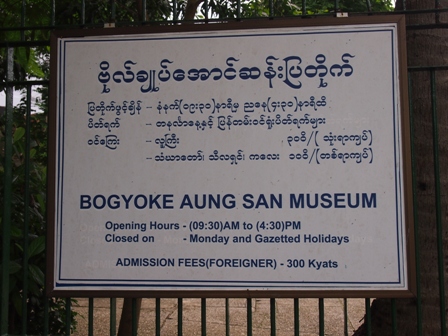 Bogyoke Aung San Museum sign[/caption]
I came away saddened at the loss of such a young, intelligent and innovative man. The museum is small yet feels intensely personal. Some of his favourite books sit on shelves in a small office. Beds swathed in mosquito netting where the children slept look almost as if they were recently occupied.
By contrast, the National Museum in Pyay Road, Dagon Township is impersonal and austere. The Lion Throne is a remembrance of former royal glory days. Filled with artefacts of Myanmar’s dynastic past when various regions held sway over greater Myanmar right up until the country was more or less unified by one ruler in the 1850s when Mandalay became the country’s last capital under one king, this is Myanmar’s showcase repository of national hegemony. Its curators have done a fine job, probably with minimal resources and they should be applauded.
By all means, visit both museums, easily done in a single day.
Yangon is thriving, there’s no doubt about that.
Go there before it changes forever, won’t you?
Tom Neal Tacker visited Yangon as a guest of Viator, Travel Indochina and Shangri-La hotels.
Naked Facts:
Naked Routes:
Yangon is easily accessible from Bangkok and Singapore airports with frequent daily flights. Overland travel is problematic in regions where the ruling government continues to quash regional independence movements such as in the Karen and Rohinga homelands.
Viator, the global tour operator’s (www.viator.com) local Myanmar adjunct is Khiri Travel owned and run by the top bloke and all round nice guy Edwin Briels. Edwin organised the British motoring show Top Gear’s expedition into Myanmar’s inaccessible border region with Thailand. What he doesn’t know about contemporary Myanmar isn’t really worth knowing anyway.
[caption id="attachment_3005" align="alignnone" width="336"]
Bogyoke Aung San Museum sign[/caption]
I came away saddened at the loss of such a young, intelligent and innovative man. The museum is small yet feels intensely personal. Some of his favourite books sit on shelves in a small office. Beds swathed in mosquito netting where the children slept look almost as if they were recently occupied.
By contrast, the National Museum in Pyay Road, Dagon Township is impersonal and austere. The Lion Throne is a remembrance of former royal glory days. Filled with artefacts of Myanmar’s dynastic past when various regions held sway over greater Myanmar right up until the country was more or less unified by one ruler in the 1850s when Mandalay became the country’s last capital under one king, this is Myanmar’s showcase repository of national hegemony. Its curators have done a fine job, probably with minimal resources and they should be applauded.
By all means, visit both museums, easily done in a single day.
Yangon is thriving, there’s no doubt about that.
Go there before it changes forever, won’t you?
Tom Neal Tacker visited Yangon as a guest of Viator, Travel Indochina and Shangri-La hotels.
Naked Facts:
Naked Routes:
Yangon is easily accessible from Bangkok and Singapore airports with frequent daily flights. Overland travel is problematic in regions where the ruling government continues to quash regional independence movements such as in the Karen and Rohinga homelands.
Viator, the global tour operator’s (www.viator.com) local Myanmar adjunct is Khiri Travel owned and run by the top bloke and all round nice guy Edwin Briels. Edwin organised the British motoring show Top Gear’s expedition into Myanmar’s inaccessible border region with Thailand. What he doesn’t know about contemporary Myanmar isn’t really worth knowing anyway.
[caption id="attachment_3005" align="alignnone" width="336"]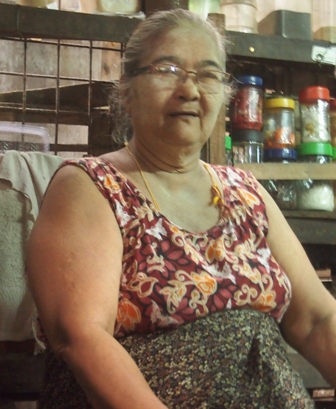 Herbal medicine seller at Shwe Dagon market[/caption]
See www.khiri.com Viator’s newest personalised tour in Yangon with private guide, most meals, driver and accommodation is a three day insight into how this amazingly complex city works. My guide Ms. Nina was utterly charming, helpful and caring. She clearly loves her country and was desperately keen that I share her enthusiasm. What more could anyone ask of a guide?
[caption id="attachment_3004" align="alignnone" width="448"]
Herbal medicine seller at Shwe Dagon market[/caption]
See www.khiri.com Viator’s newest personalised tour in Yangon with private guide, most meals, driver and accommodation is a three day insight into how this amazingly complex city works. My guide Ms. Nina was utterly charming, helpful and caring. She clearly loves her country and was desperately keen that I share her enthusiasm. What more could anyone ask of a guide?
[caption id="attachment_3004" align="alignnone" width="448"]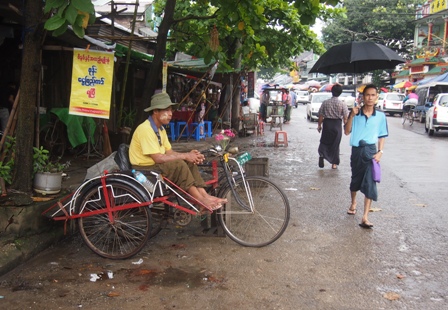 Cyclo driver waiting near Shwe Dagon market[/caption]
Travel Indochina’s local operator in Myanmar is Tour Mandalay managed excellently by Marek Lenarcik and Karen Salamanca. This is a very well run group similar to Khiri Travel and essential to travellers keen on seeing Myanmar from an off-the-beaten-track point of view.
[caption id="attachment_3006" align="alignnone" width="418"]
Cyclo driver waiting near Shwe Dagon market[/caption]
Travel Indochina’s local operator in Myanmar is Tour Mandalay managed excellently by Marek Lenarcik and Karen Salamanca. This is a very well run group similar to Khiri Travel and essential to travellers keen on seeing Myanmar from an off-the-beaten-track point of view.
[caption id="attachment_3006" align="alignnone" width="418"]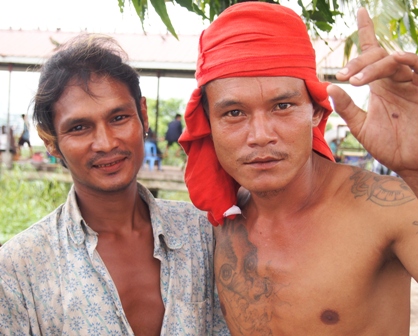 Yangon wharf workers[/caption]
[caption id="attachment_3015" align="alignnone" width="390"]
Yangon wharf workers[/caption]
[caption id="attachment_3015" align="alignnone" width="390"]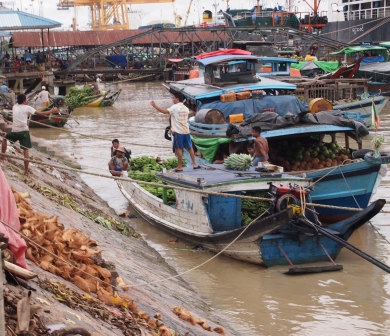 Yangon River scene[/caption]
I thoroughly enjoyed my one day tour with wonder guide Mr. Johnny while we explored the back streets of Dalah, the waterfront wharves of inner Yangon, the Bogyoke Aung San Museum and a valuable side trip to the NLD headquarters. See www.tourmandalay.travel or www.travelindochina.com.au for up close and personal tours in Myanmar.
[caption id="attachment_3007" align="alignnone" width="388"]
Yangon River scene[/caption]
I thoroughly enjoyed my one day tour with wonder guide Mr. Johnny while we explored the back streets of Dalah, the waterfront wharves of inner Yangon, the Bogyoke Aung San Museum and a valuable side trip to the NLD headquarters. See www.tourmandalay.travel or www.travelindochina.com.au for up close and personal tours in Myanmar.
[caption id="attachment_3007" align="alignnone" width="388"]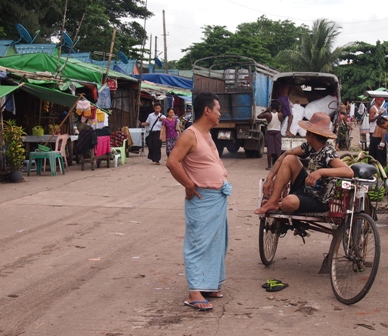 Yangon wharf cyclo driver[/caption]
Naked Tips:
Visas for Myanmar are required for all nationalities.
There is no international train service linking Myanmar with its neighbours.
Myanmar has no telephone roaming agreements with other countries. Internet cafes do exist but the connections may not be up to speed, literally.
ATMs have begun to pop up in major towns though they’re often ‘Out of Service’. Cash is dispensed in the local currency, the Kyat (pronounced ‘Chaht’).
US dollars are accepted in many tourist centres though not as frequently as they once were when US currency was compulsory for large purchases made by foreigners.
Credit cards are almost universally UN-accepted. 4 and 5-star hotels accept Visa and Mastercard, but only those with particular links to certain offshore banks. For instance, my HSBC Visa credit card was virtually useless as HSBC hasn’t yet negotiated an international agreement with Myanmar banks. Do not depend on using your credit card in Myanmar. It’s still a cash economy.
Myanmar people are some of the friendliest I’ve met anywhere in my travels. I would have thought since the country opened to mass tourism a few years ago that a Western white man’s face wouldn’t be such an object of curiosity but I was wrong. Away from the four main tourist centres, a Westerner is indeed a curiosity. Don’t be surprised to draw attention from unexpected sources. Kids will randomly follow you down a street. Market stallholders will stop suddenly mid-conversation with a customer to stare at you and smile. Passersby will angle their way towards you in order to get a closer look. This all being said, Myanmar people are respectful, polite and genuinely friendly. The curiosity is mostly entirely innocent. Almost none of the hard sell practices seen in other south Asian countries will confront you in Myanmar, though the street sellers in Pagan can be relentlessly pushy, albeit in a very friendly way.
[caption id="attachment_3008" align="alignnone" width="336"]
Yangon wharf cyclo driver[/caption]
Naked Tips:
Visas for Myanmar are required for all nationalities.
There is no international train service linking Myanmar with its neighbours.
Myanmar has no telephone roaming agreements with other countries. Internet cafes do exist but the connections may not be up to speed, literally.
ATMs have begun to pop up in major towns though they’re often ‘Out of Service’. Cash is dispensed in the local currency, the Kyat (pronounced ‘Chaht’).
US dollars are accepted in many tourist centres though not as frequently as they once were when US currency was compulsory for large purchases made by foreigners.
Credit cards are almost universally UN-accepted. 4 and 5-star hotels accept Visa and Mastercard, but only those with particular links to certain offshore banks. For instance, my HSBC Visa credit card was virtually useless as HSBC hasn’t yet negotiated an international agreement with Myanmar banks. Do not depend on using your credit card in Myanmar. It’s still a cash economy.
Myanmar people are some of the friendliest I’ve met anywhere in my travels. I would have thought since the country opened to mass tourism a few years ago that a Western white man’s face wouldn’t be such an object of curiosity but I was wrong. Away from the four main tourist centres, a Westerner is indeed a curiosity. Don’t be surprised to draw attention from unexpected sources. Kids will randomly follow you down a street. Market stallholders will stop suddenly mid-conversation with a customer to stare at you and smile. Passersby will angle their way towards you in order to get a closer look. This all being said, Myanmar people are respectful, polite and genuinely friendly. The curiosity is mostly entirely innocent. Almost none of the hard sell practices seen in other south Asian countries will confront you in Myanmar, though the street sellers in Pagan can be relentlessly pushy, albeit in a very friendly way.
[caption id="attachment_3008" align="alignnone" width="336"] Smiles under bananas at Yangon wharf[/caption]
Myanmar people are mostly very conservative. Displays of public affection are serious breaches of etiquette, though men hold other men’s hands and women walk arm in arm, side by side, physical interaction between opposite sexes in public is a public no-no. Though acceptable canoodling spots do exist, (Kandawgyi Lake and Inya Lake parks for example) men and women should not be seen kissing in public. Any display in public of sexual affection is almost anathema to Myanmar people.
All Buddhist temples, pagodas and shrines are sacred places. Men and women are not allowed to enter wearing shorts above the knees. Women should wear long loose fitting skirts or long pants. Low cut blouses or shirts are definitely not allowed. Cleavage is a no-go zone in Buddhist temples. Men should not wear singlets that expose shoulders. Under no circumstances may shoes and socks be worn inside a Buddhist pagoda, temple or shrine. Hats should also be removed. Never sit with your feet pointed at a Buddha image or another person for that matter. Never touch someone on the head, including a child unless the child belongs to a friend or is a close relative.
[caption id="attachment_3009" align="alignnone" width="267"]
Smiles under bananas at Yangon wharf[/caption]
Myanmar people are mostly very conservative. Displays of public affection are serious breaches of etiquette, though men hold other men’s hands and women walk arm in arm, side by side, physical interaction between opposite sexes in public is a public no-no. Though acceptable canoodling spots do exist, (Kandawgyi Lake and Inya Lake parks for example) men and women should not be seen kissing in public. Any display in public of sexual affection is almost anathema to Myanmar people.
All Buddhist temples, pagodas and shrines are sacred places. Men and women are not allowed to enter wearing shorts above the knees. Women should wear long loose fitting skirts or long pants. Low cut blouses or shirts are definitely not allowed. Cleavage is a no-go zone in Buddhist temples. Men should not wear singlets that expose shoulders. Under no circumstances may shoes and socks be worn inside a Buddhist pagoda, temple or shrine. Hats should also be removed. Never sit with your feet pointed at a Buddha image or another person for that matter. Never touch someone on the head, including a child unless the child belongs to a friend or is a close relative.
[caption id="attachment_3009" align="alignnone" width="267"]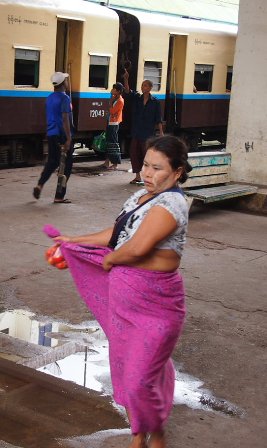 Woman readjusting her 'longyi'[/caption]
Myanmar women dress in colourful ‘longyi’. The sarong like garment (‘longyi’ for men is thin cotton sewn into a tube, for women it’s a tube or single sheet of cotton cloth) is wrapped round the waist with one end secured at the side. Men wear the same ankle length ‘longyi’ but in more subdued colours, blue, brown and russet checks being the preferred pattern and colour scheme. Men tie their ‘longyi’ around the waist in different fashion to women. It took me two days to perfect the method, which also meant I risked finding my ‘longyi’ wrapped round my ankles on several occasions. Given that public nudity in Myanmar is akin to sticking your feet in a Buddha image’s face, I was hyper-vigilant about any possible ‘wardrobe malfunction’. I learned how to hoist up my ‘longyi’ by drawing up the front fabric through my legs, gathering the excess at my lumbar region and securing it in place so that I had a very short pair of shorts, perfect for wading through high water in markets or riding a motorbike on a muddy track. I bought two ‘longyi’ during three weeks in Myanmar, one in the Dalah market for approximately USD$2.50 and the other from a persistent young man in Pagan for about USD$5.00.
Many men in Myanmar don’t wear underwear, I was informed, so I adopted the local practice, thanking myself daily for the extra freedom and immediate cooling relief. Going commando in 40C heat was a Buddhist godsend. Once I learned how to tie my ‘longyi’ in the proper Myanmar fashion, with a small bustle at my navel and two flaps clinging to my thighs, I was the recipient of numerous thumbs up signals coupled with broad smiles of appreciation, from both men and women I hasten to add. A 100% cotton ‘longyi’ dries quickly in Myanmar’s climate. I wore mine in the shower, stomped on it while shampooing my hair, draped it over the shower rail and had a fresh ‘longyi’ ready to wear the following day. Utter bliss. Add a T-shirt that covered my shoulders and a pair of thongs and I was dressed like a local ready for any Buddhist shrine or local cafe, maintaining a cool air of liberty while feeling the breeze blowing up my backside.
[caption id="attachment_3014" align="alignnone" width="336"]
Woman readjusting her 'longyi'[/caption]
Myanmar women dress in colourful ‘longyi’. The sarong like garment (‘longyi’ for men is thin cotton sewn into a tube, for women it’s a tube or single sheet of cotton cloth) is wrapped round the waist with one end secured at the side. Men wear the same ankle length ‘longyi’ but in more subdued colours, blue, brown and russet checks being the preferred pattern and colour scheme. Men tie their ‘longyi’ around the waist in different fashion to women. It took me two days to perfect the method, which also meant I risked finding my ‘longyi’ wrapped round my ankles on several occasions. Given that public nudity in Myanmar is akin to sticking your feet in a Buddha image’s face, I was hyper-vigilant about any possible ‘wardrobe malfunction’. I learned how to hoist up my ‘longyi’ by drawing up the front fabric through my legs, gathering the excess at my lumbar region and securing it in place so that I had a very short pair of shorts, perfect for wading through high water in markets or riding a motorbike on a muddy track. I bought two ‘longyi’ during three weeks in Myanmar, one in the Dalah market for approximately USD$2.50 and the other from a persistent young man in Pagan for about USD$5.00.
Many men in Myanmar don’t wear underwear, I was informed, so I adopted the local practice, thanking myself daily for the extra freedom and immediate cooling relief. Going commando in 40C heat was a Buddhist godsend. Once I learned how to tie my ‘longyi’ in the proper Myanmar fashion, with a small bustle at my navel and two flaps clinging to my thighs, I was the recipient of numerous thumbs up signals coupled with broad smiles of appreciation, from both men and women I hasten to add. A 100% cotton ‘longyi’ dries quickly in Myanmar’s climate. I wore mine in the shower, stomped on it while shampooing my hair, draped it over the shower rail and had a fresh ‘longyi’ ready to wear the following day. Utter bliss. Add a T-shirt that covered my shoulders and a pair of thongs and I was dressed like a local ready for any Buddhist shrine or local cafe, maintaining a cool air of liberty while feeling the breeze blowing up my backside.
[caption id="attachment_3014" align="alignnone" width="336"] 'Longyi' wearing workers preparing bananas for sale[/caption]
Women in Myanmar are highly respected if they adhere to society’s dress code. I was told that properly educated Myanmar women wear their hair long and clean, tied back with fresh flowers woven into the shimmering tresses. They smile demurely and keep to themselves. This was confirmed to me by a man of about 22 years. The times are changing slowly in Myanmar, though in both Yangon and Mandalay many women dress in Western style with short skirts and high heels. They get a lot of looks but hey, fashion victims are everywhere.
In Myanmar you will see women wearing smears of yellow-ish ochre painted on their cheeks and foreheads. This is ‘thanaka’, made from the powdered bark of the Thanaka tree (Murraya paniculata or exotica) ground down on a stone slab and mixed with water. Worn both for its cosmetic and skin care properties (anti-inflammatory and acne preventative as well as a whitening agent or sunscreen), the Thanaka tree thrives in Myanmar’s dry zones, mostly around Pagan and Mandalay. Men use ‘thanaka’ paste as well but tend to apply it before going to bed though it’s not unusual to see men wearing it during the day as well. The best ‘thanaka’ is authentic stuff, approximately USD$5.00 per jar. It smells vaguely sweet and musky. Cheaper imitations exist but they aren’t very effective. Its anti-ageing properties are also highly praised. It hasn’t worked for me but I’ve only just begun using it. Perhaps I should have started younger.
[caption id="attachment_3010" align="alignnone" width="336"]
'Longyi' wearing workers preparing bananas for sale[/caption]
Women in Myanmar are highly respected if they adhere to society’s dress code. I was told that properly educated Myanmar women wear their hair long and clean, tied back with fresh flowers woven into the shimmering tresses. They smile demurely and keep to themselves. This was confirmed to me by a man of about 22 years. The times are changing slowly in Myanmar, though in both Yangon and Mandalay many women dress in Western style with short skirts and high heels. They get a lot of looks but hey, fashion victims are everywhere.
In Myanmar you will see women wearing smears of yellow-ish ochre painted on their cheeks and foreheads. This is ‘thanaka’, made from the powdered bark of the Thanaka tree (Murraya paniculata or exotica) ground down on a stone slab and mixed with water. Worn both for its cosmetic and skin care properties (anti-inflammatory and acne preventative as well as a whitening agent or sunscreen), the Thanaka tree thrives in Myanmar’s dry zones, mostly around Pagan and Mandalay. Men use ‘thanaka’ paste as well but tend to apply it before going to bed though it’s not unusual to see men wearing it during the day as well. The best ‘thanaka’ is authentic stuff, approximately USD$5.00 per jar. It smells vaguely sweet and musky. Cheaper imitations exist but they aren’t very effective. Its anti-ageing properties are also highly praised. It hasn’t worked for me but I’ve only just begun using it. Perhaps I should have started younger.
[caption id="attachment_3010" align="alignnone" width="336"]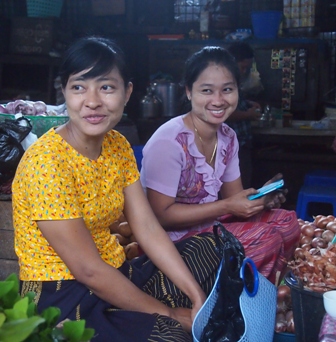 Young women wearing 'thanaka' at Shwe Dagon market[/caption]
Superstition is rife in Myanmar. Astrologers hold a lofty position in society. Their advice is sought by the most senior government officials. A prime example is this: when a ruling general was told by an astrologer that Myanmar would be better off if all drivers shifted from driving on the left to driving on the right, the country would be more easily governed or some such nonsense like that. Since the early 90s Myanmar drivers now drive on the right, despite the fact that over 90% of vehicles have steering wheels on the right as they’re directly imported without alteration from Japan. Myanmar’s most prominent neighbours, Bangladesh, Thailand and India all drive on the left. Myanmar is lately the odd country out, much to the consternation of local drivers and foreign passengers.
No major decision is taken in Myanmar without consulting an astrologer first. Weddings, anniversaries, births, funerals, home purchases, major business decisions, you name it. Without an astrologer’s wisdom, you’re cactus. Same rules apply to general living. One guide pointed at three small dot-point tattoos on the back of a man’s neck, telling me he had them placed there to ward off the effect of snakebite. The venom would pass no further than the tattoos, thus preventing it from reaching the man’s brain and therefore saving his life.
[caption id="attachment_3011" align="alignnone" width="425"]
Young women wearing 'thanaka' at Shwe Dagon market[/caption]
Superstition is rife in Myanmar. Astrologers hold a lofty position in society. Their advice is sought by the most senior government officials. A prime example is this: when a ruling general was told by an astrologer that Myanmar would be better off if all drivers shifted from driving on the left to driving on the right, the country would be more easily governed or some such nonsense like that. Since the early 90s Myanmar drivers now drive on the right, despite the fact that over 90% of vehicles have steering wheels on the right as they’re directly imported without alteration from Japan. Myanmar’s most prominent neighbours, Bangladesh, Thailand and India all drive on the left. Myanmar is lately the odd country out, much to the consternation of local drivers and foreign passengers.
No major decision is taken in Myanmar without consulting an astrologer first. Weddings, anniversaries, births, funerals, home purchases, major business decisions, you name it. Without an astrologer’s wisdom, you’re cactus. Same rules apply to general living. One guide pointed at three small dot-point tattoos on the back of a man’s neck, telling me he had them placed there to ward off the effect of snakebite. The venom would pass no further than the tattoos, thus preventing it from reaching the man’s brain and therefore saving his life.
[caption id="attachment_3011" align="alignnone" width="425"]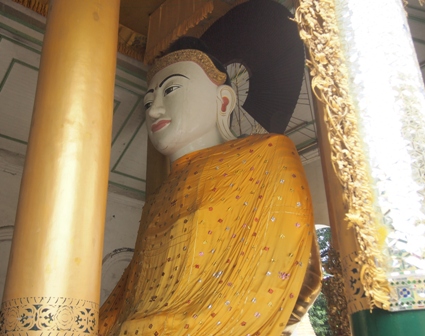 Buddha statue at Shwe Dagon Pagoda[/caption]
Though Buddhism is the country’s major religion, small minorities of Hindus, Muslims and Christians exist. Superstition is embedded in all religions, despite overriding dicta from authorities on high. Another example is Nats. 37 Great Nats are spirits who were formerly human beings that met violent deaths. Lesser Nats exist in trees, water and other natural features. There are hundreds of Lesser Nats. Nats shrines can be found in all villages and towns. They’re usually positioned under old banyan or mango trees and are festooned with offerings of food, candles and small trinkets much like Buddhist shrines are similarly adorned. The king of the Nats, Thagyamin, is usually depicted seated upon a lofty throne atop a white three-headed elephant. He holds a conch shell in one hand and a yak tail whisk in the other. Most homes in rural areas have a Nat shrine inside.
[caption id="attachment_3031" align="alignnone" width="448"]
Buddha statue at Shwe Dagon Pagoda[/caption]
Though Buddhism is the country’s major religion, small minorities of Hindus, Muslims and Christians exist. Superstition is embedded in all religions, despite overriding dicta from authorities on high. Another example is Nats. 37 Great Nats are spirits who were formerly human beings that met violent deaths. Lesser Nats exist in trees, water and other natural features. There are hundreds of Lesser Nats. Nats shrines can be found in all villages and towns. They’re usually positioned under old banyan or mango trees and are festooned with offerings of food, candles and small trinkets much like Buddhist shrines are similarly adorned. The king of the Nats, Thagyamin, is usually depicted seated upon a lofty throne atop a white three-headed elephant. He holds a conch shell in one hand and a yak tail whisk in the other. Most homes in rural areas have a Nat shrine inside.
[caption id="attachment_3031" align="alignnone" width="448"] Nats shrine in a village[/caption]
Great Nats spirits can be reincarnated in human beings as both men and women. Like Indian ‘Hijra’ whose spirits are linked to feminine deities, many Myanmar men reincarnated as female Nats spirits dress as transvestites and perform at frequent religious ceremonies throughout the country. The biggest annual Nats festival takes place during the August full moon in and around Mandalay. The festival has morphed somewhat into a big gay party that attracts lots of Thai ladyboys, gay men and lesbians and their supporters. Though Nats reincarnated spirits are not at all officially connected with GLBT international rights movements, Myanmar’s unique celebration of gender difference has evolved into something altogether unusual.
Myanmar food isn’t as chilli hot as in Thailand, though many exceptions exist. Chillies, chilli paste and chilli sauce spread liberally throughout cheap noodle snacks sold in every street in every Myanmar town prove the exception to the rule. Myanmar food is rather like an amalgamation of Bengali, Bangladeshi, southern Chinese and Thai. Rice is eaten daily if possible. Many Myanmar people can’t afford to eat rice every day. Rice noodles are cheap and widely available, served cold in a salad with a fishy broth, chillies and fresh herbs or hot in a soup such as ‘mohinga’.
Meat is expensive and abstemiously used in cooking. Chicken, mutton, pork or beef is typically cut into small portions and distributed in a savoury sauce such as curry. This is the norm. Fish is a national staple, particularly in the south on the Andaman Sea and Bay of Bengal coasts.
Tea is the national drink. A thermos of hot ‘Chinese’ tea, without milk or sugar is placed on every cafe table for free even if a milky sweet Myanmar tea is ordered.
Coffee culture is not prevalent yet in Myanmar. Espresso machines are rarely seen, normally only in big international hotels.
Myanmar beer is the preferred alcoholic beverage, locally brewed and served cold when refrigeration is available.
Locally made spirits (gin, whisky and rum) are cheap and widely available though not very good. Toddy palm spirit is cheap and widely available. Buyer beware, some toddy stinks of sour sap while a well made toddy can be quite delicious if consumed in the right circumstances. For me circumstances were right in the middle of nowhere when nothing else alcoholic was available to drink.
A couple wineries, fairly new to Myanmar, are established in the high country near Inye Lake. I drank a Shiraz/Carignan blend from Inle Valley winery and enjoyed it very much.
Myanmar people’s greatest vice apart from tobacco and opium addictions is the widespread consumption of betel nut. Mildly addictive, it’s a hunger staving stuff that stains teeth bright red when chewed and gives the chewer a sustained energy boost. Nearly all Myanmar men chew betel, either in a ‘pan’ preparation mixed with any or all of the following: green tobacco, cardamom, cloves, fennel seeds, fenugreek seeds, liquorice root and jaggery sugar and is available for a pittance at countless street stalls. The red spittle stains you see sprayed on random building walls or kerbs or in public toilets is expelled betel juice. Years of betel nut chewing will rot teeth, a real pity to see handsome young men with permanently stained rotten teeth. Most young women these days don’t chew betel. Is it vanity? Probably. I did see a lot of older women with tell-tale red stained teeth and gums. On them it seemed a quirky character trait, images from old National Geographic magazines leapt to mind. I felt immediately embarrassed at the thought, like an antiquated colonialist but each time I spied an old woman with red rotted teeth and gums, I thought, ‘Huh, she reminds of a photo I saw once.’
Tap water in Myanmar is not potable. Ice made from tap water will likely make you sick.
Hygiene in Myanmar is questionable. Most street food sold in Myanmar is not prepared with sensitive Western palates in mind. Hot water, soap and clean cloths for drying dishes, glasses, cups, etc is almost non-existent. I ate at many street stalls but only in the company of a guide. My guides would not eat at most street stalls for fear of dysentery or worse. The most popular busy restaurants and cafes are sure signs of good hygiene in practice. Myanmar people don’t want to be sick from eating bad food anymore than you would. Follow their lead when eating out. Most international hotels operate at a better standard of cleanliness, though exceptions exist. Use your nose and eyes. If it looks dodgy, avoid it no matter how hungry you are.
[caption id="attachment_3012" align="alignnone" width="336"]
Nats shrine in a village[/caption]
Great Nats spirits can be reincarnated in human beings as both men and women. Like Indian ‘Hijra’ whose spirits are linked to feminine deities, many Myanmar men reincarnated as female Nats spirits dress as transvestites and perform at frequent religious ceremonies throughout the country. The biggest annual Nats festival takes place during the August full moon in and around Mandalay. The festival has morphed somewhat into a big gay party that attracts lots of Thai ladyboys, gay men and lesbians and their supporters. Though Nats reincarnated spirits are not at all officially connected with GLBT international rights movements, Myanmar’s unique celebration of gender difference has evolved into something altogether unusual.
Myanmar food isn’t as chilli hot as in Thailand, though many exceptions exist. Chillies, chilli paste and chilli sauce spread liberally throughout cheap noodle snacks sold in every street in every Myanmar town prove the exception to the rule. Myanmar food is rather like an amalgamation of Bengali, Bangladeshi, southern Chinese and Thai. Rice is eaten daily if possible. Many Myanmar people can’t afford to eat rice every day. Rice noodles are cheap and widely available, served cold in a salad with a fishy broth, chillies and fresh herbs or hot in a soup such as ‘mohinga’.
Meat is expensive and abstemiously used in cooking. Chicken, mutton, pork or beef is typically cut into small portions and distributed in a savoury sauce such as curry. This is the norm. Fish is a national staple, particularly in the south on the Andaman Sea and Bay of Bengal coasts.
Tea is the national drink. A thermos of hot ‘Chinese’ tea, without milk or sugar is placed on every cafe table for free even if a milky sweet Myanmar tea is ordered.
Coffee culture is not prevalent yet in Myanmar. Espresso machines are rarely seen, normally only in big international hotels.
Myanmar beer is the preferred alcoholic beverage, locally brewed and served cold when refrigeration is available.
Locally made spirits (gin, whisky and rum) are cheap and widely available though not very good. Toddy palm spirit is cheap and widely available. Buyer beware, some toddy stinks of sour sap while a well made toddy can be quite delicious if consumed in the right circumstances. For me circumstances were right in the middle of nowhere when nothing else alcoholic was available to drink.
A couple wineries, fairly new to Myanmar, are established in the high country near Inye Lake. I drank a Shiraz/Carignan blend from Inle Valley winery and enjoyed it very much.
Myanmar people’s greatest vice apart from tobacco and opium addictions is the widespread consumption of betel nut. Mildly addictive, it’s a hunger staving stuff that stains teeth bright red when chewed and gives the chewer a sustained energy boost. Nearly all Myanmar men chew betel, either in a ‘pan’ preparation mixed with any or all of the following: green tobacco, cardamom, cloves, fennel seeds, fenugreek seeds, liquorice root and jaggery sugar and is available for a pittance at countless street stalls. The red spittle stains you see sprayed on random building walls or kerbs or in public toilets is expelled betel juice. Years of betel nut chewing will rot teeth, a real pity to see handsome young men with permanently stained rotten teeth. Most young women these days don’t chew betel. Is it vanity? Probably. I did see a lot of older women with tell-tale red stained teeth and gums. On them it seemed a quirky character trait, images from old National Geographic magazines leapt to mind. I felt immediately embarrassed at the thought, like an antiquated colonialist but each time I spied an old woman with red rotted teeth and gums, I thought, ‘Huh, she reminds of a photo I saw once.’
Tap water in Myanmar is not potable. Ice made from tap water will likely make you sick.
Hygiene in Myanmar is questionable. Most street food sold in Myanmar is not prepared with sensitive Western palates in mind. Hot water, soap and clean cloths for drying dishes, glasses, cups, etc is almost non-existent. I ate at many street stalls but only in the company of a guide. My guides would not eat at most street stalls for fear of dysentery or worse. The most popular busy restaurants and cafes are sure signs of good hygiene in practice. Myanmar people don’t want to be sick from eating bad food anymore than you would. Follow their lead when eating out. Most international hotels operate at a better standard of cleanliness, though exceptions exist. Use your nose and eyes. If it looks dodgy, avoid it no matter how hungry you are.
[caption id="attachment_3012" align="alignnone" width="336"]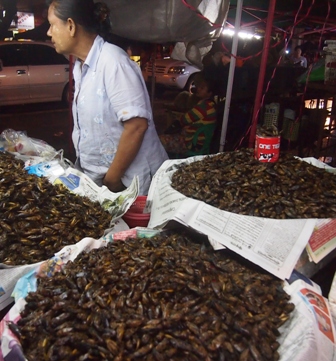 Fried crickets for sale at street stall[/caption]
Electricity supply in Myanmar is shall we say... intermittent? While I was in Yangon, the power went out for a couple hours on a daily basis. Most good hotels, large businesses and essential services (hospitals, the airport for example) run their own diesel generators. Those loud noxious contraptions you see planted permanently on the footpath next to a busy street is the generator, some are large as a shipping container. Imagine the noise.
Yangon’s public transport system is basic. Though I very much enjoyed the slow train around town, I wouldn’t want to rely on it to get me anywhere in a hurry. Public buses are common and useful though it helps to be fluent in Myanmar script otherwise you could easily board the wrong bus. Buses are slow and overcrowded. At least they’re cheap.
Taxis can be easily hailed in Yangon though don’t expect the driver to know every street. Some operate with metres running but most don’t. Negotiate the fare before you enter the taxi. Ask for local advice regards price and distance.
Yangon’s street numbering system outside the old British grid is based on a completely illogical system. Street signs, house numbers, business addresses listed by street name and number are fantasies.
Motorcycles are prohibited in Yangon, another silly general’s decree.
Medical facilities in Myanmar are not yet at an international standard of care and hygiene. If you become gravely ill, you’d better have a good travel insurance policy that provides a medical evacuation clause.
Universally applicable anti-smoking laws in public restaurants and cafes don’t yet exist in Myanmar. People light up in bars and many restaurants though most places catering to foreigners have a no-smoking policy or they provide a separate smoking area. Not so for bars where the smoke is thick as Irrawaddy Delta mud. Cough, cough.
For products that are made in Myanmar by local crafts experts, the NGO operated shop Pomelo is a one-stop shop for unusual gifts and souvenirs. Funky and like nowhere else in town, Pomelo is a great find. No. 89, 2nd floor, Thein Pyu Road, Botataung Township, Central Yangon. www.pomeloyangon.com
Since 2010 artistic expression in Myanmar has really exploded. Local artists are creating works that walk the fine line of political correctness and safety. They get away with criticising the government in ways that put journalists in prison. I am very impressed with many works I saw, though prices have risen to USD$10,000 per painting for many artists whose works are gaining international recognition. The best place I discovered in Yangon to buy art from respected artists at a fair price is Pansodan Gallery at No. 286, 1st floor, Pansodan Street near the Upper Block between Anawrahta and Bogyoke Aung San streets. www.pansodan,com
On most Tuesday nights the gallery runs an open house for visiting foreigners and guests. Many local ex-pats and writer/journalists stop in for this regular gathering. It’s a great place in which to learn more about Myanmar politics and society.
Near Pomelo shop is Genky 11, a Japanese-Myanmar massage therapy centre run as a charity and staffed by blind therapists. Inexpensive and excellent massages are available here, often without prior booking though during busy times, bookings are advised. Genky has two locations: Genky 1 and Genky 11. Ask a local for directions. Their website address is written in Myanmar script.
Naked Sleeps:
Yangon has five 5-star hotels that boast superior amenities: The Sule Shangri-La (formerly The Trader’s Hotel), The Strand Hotel, The Belmond Governor’s Residence, The Chatrium Hotel Royal Lake and The Savoy Hotel. Of the five, the Shangri-La is the most modern and offers the greatest number of dining options, conference facilities, spa, gymnasium and pool. The upper level Executive Rooms offer access to a private lounge where breakfasts, evening hors d’oeuvres and drinks are served daily. The hotel’s Summer Palace Chinese/Cantonese restaurant is really superb. The chef is from HongKong and he makes a mean dumpling or three. The lobby cafe area is very popular with local residents, primarily because the service is good and the hotel has an excellent wi-fi connection. I’ve never seen so many people nursing inexpensive pots of tea accompanied by two hours of free wi-fi. So many laptops opened... so many empty cups. The hotel is centrally located very near Scott’s Market area, the city’s main railway station and the Sule Pagoda. The old British Raj CBD is only a few minutes walk from the hotel. See www.shangri-la.com
[caption id="attachment_3036" align="alignnone" width="448"]
Fried crickets for sale at street stall[/caption]
Electricity supply in Myanmar is shall we say... intermittent? While I was in Yangon, the power went out for a couple hours on a daily basis. Most good hotels, large businesses and essential services (hospitals, the airport for example) run their own diesel generators. Those loud noxious contraptions you see planted permanently on the footpath next to a busy street is the generator, some are large as a shipping container. Imagine the noise.
Yangon’s public transport system is basic. Though I very much enjoyed the slow train around town, I wouldn’t want to rely on it to get me anywhere in a hurry. Public buses are common and useful though it helps to be fluent in Myanmar script otherwise you could easily board the wrong bus. Buses are slow and overcrowded. At least they’re cheap.
Taxis can be easily hailed in Yangon though don’t expect the driver to know every street. Some operate with metres running but most don’t. Negotiate the fare before you enter the taxi. Ask for local advice regards price and distance.
Yangon’s street numbering system outside the old British grid is based on a completely illogical system. Street signs, house numbers, business addresses listed by street name and number are fantasies.
Motorcycles are prohibited in Yangon, another silly general’s decree.
Medical facilities in Myanmar are not yet at an international standard of care and hygiene. If you become gravely ill, you’d better have a good travel insurance policy that provides a medical evacuation clause.
Universally applicable anti-smoking laws in public restaurants and cafes don’t yet exist in Myanmar. People light up in bars and many restaurants though most places catering to foreigners have a no-smoking policy or they provide a separate smoking area. Not so for bars where the smoke is thick as Irrawaddy Delta mud. Cough, cough.
For products that are made in Myanmar by local crafts experts, the NGO operated shop Pomelo is a one-stop shop for unusual gifts and souvenirs. Funky and like nowhere else in town, Pomelo is a great find. No. 89, 2nd floor, Thein Pyu Road, Botataung Township, Central Yangon. www.pomeloyangon.com
Since 2010 artistic expression in Myanmar has really exploded. Local artists are creating works that walk the fine line of political correctness and safety. They get away with criticising the government in ways that put journalists in prison. I am very impressed with many works I saw, though prices have risen to USD$10,000 per painting for many artists whose works are gaining international recognition. The best place I discovered in Yangon to buy art from respected artists at a fair price is Pansodan Gallery at No. 286, 1st floor, Pansodan Street near the Upper Block between Anawrahta and Bogyoke Aung San streets. www.pansodan,com
On most Tuesday nights the gallery runs an open house for visiting foreigners and guests. Many local ex-pats and writer/journalists stop in for this regular gathering. It’s a great place in which to learn more about Myanmar politics and society.
Near Pomelo shop is Genky 11, a Japanese-Myanmar massage therapy centre run as a charity and staffed by blind therapists. Inexpensive and excellent massages are available here, often without prior booking though during busy times, bookings are advised. Genky has two locations: Genky 1 and Genky 11. Ask a local for directions. Their website address is written in Myanmar script.
Naked Sleeps:
Yangon has five 5-star hotels that boast superior amenities: The Sule Shangri-La (formerly The Trader’s Hotel), The Strand Hotel, The Belmond Governor’s Residence, The Chatrium Hotel Royal Lake and The Savoy Hotel. Of the five, the Shangri-La is the most modern and offers the greatest number of dining options, conference facilities, spa, gymnasium and pool. The upper level Executive Rooms offer access to a private lounge where breakfasts, evening hors d’oeuvres and drinks are served daily. The hotel’s Summer Palace Chinese/Cantonese restaurant is really superb. The chef is from HongKong and he makes a mean dumpling or three. The lobby cafe area is very popular with local residents, primarily because the service is good and the hotel has an excellent wi-fi connection. I’ve never seen so many people nursing inexpensive pots of tea accompanied by two hours of free wi-fi. So many laptops opened... so many empty cups. The hotel is centrally located very near Scott’s Market area, the city’s main railway station and the Sule Pagoda. The old British Raj CBD is only a few minutes walk from the hotel. See www.shangri-la.com
[caption id="attachment_3036" align="alignnone" width="448"]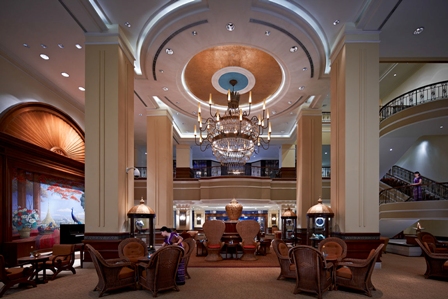 Sule Shangri-La Peacock Lounge lobby cafe[/caption]
[caption id="attachment_3037" align="alignnone" width="448"]
Sule Shangri-La Peacock Lounge lobby cafe[/caption]
[caption id="attachment_3037" align="alignnone" width="448"]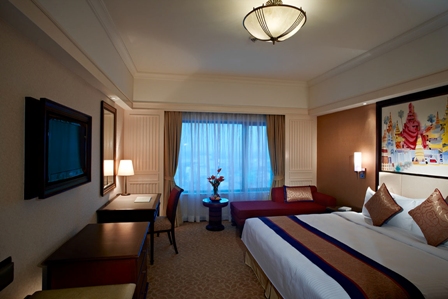 Sule Shangr-La Horizon Club room[/caption]
The Strand Hotel is the town’s original grand-dame hotel. Refurbished to a sparkling state, its 40 rooms are all suites, quite capacious and very well appointed. The hotel’s Long Bar is a local hang-out and popular Friday nights at Happy Hour. The hotel’s French restaurant is reportedly one of the best diners in town. There is no pool or garden however. The hotel is smack dab in the middle of The Strand road opposite the Strand Wharf (ferries to Dalah leave from here) so it’s a very busy location. Luckily all suites boast double-glazed windows so loud street noise isn’t an intrusive problem. The room rates are at the top end of acceptable pricing in my opinion. I’ve stayed in similar hotels in Paris, London and New York for an equal price. Good value? You be the judge. See www.hotelthestrand.com
Yangon lacks a good range of middle priced hotels, an unfortunate fact many travellers find out to their dismay during high season when rooms are full and vacancies are virtually non-existent. Even the most ordinary hotels will be full. The best of a disappointing lot is the small group of Clover Hotels. I stayed at one near Inya Lake, a bit far from the old centre but nearer to where most Yangon residents actually live. This Clover Hotel has nice views of Shwe Dagon Pagoda, particularly at night when the gold shrines are lit up like a bonanza. Breakfasts here are bloody awful. Eat somewhere else; 'mohinga' cafes are numerous. See www.cloverhotelsgroup.com
Clean no-frills hotels and hostels don’t really exist in Yangon, though very cheap doss houses with no facilities certainly can be found. Shop around, ask a local where a room for a nominal amount can be found and you may get lucky. Taxi drivers are sure-fire sources of information about local inexpensive accommodation.
Naked Eats:
Apart from very fine meals at the Sule Shangri-La’s Summer Palace restaurant and The Strand Hotel’s Cafe and Restaurant, I ate well in Yangon’s Chinatown in the old British CBD. Follow the local crowds to the cleanest places in which to dine.
The Corriander (sic) Leaf restaurant adjacent to the slightly sleazy Yangon International Hotel compound is the city’s best Indian restaurant. The food is primarily Punjabi. Tandoori oven cooking, northern Indian influenced curries, naan, rotis and chapattis made to order are the go. Cocktails are fairly good and fairly priced. See www.corrianderleaf.com
Naked Reads:
Every Anglophone with a literary mind will know Eric Blair’s (aka George Orwell) ‘Burmese Days’. Cheap Penguin rip-off copies are widely available. Orwell/Blair’s tongue-in-cheek sarcastic account of bored, racist and corrupt English colonialists and their hangers-on in early 20th century British Burma is enthrallingly dry reading. I couldn’t have liked it more.
U Thant’s grandson, Thant Myint-U’s masterpiece ‘River of Lost Footsteps’ is an excellent account of the great river Irrawaddy and the people who live on it, near it and depend on it for their livelihoods.
‘The King in Exile, the Fall of the Royal Family of Burma’ by Sudha Shah tells the tale of Burma’s lost nobility. Want to know what happened to the family that ruled over all Burma until approximately one hundred years ago? Read all about it here.
The Pagan Book House in Yangon’s CBD at No. 100 37th Street is a small shop that stocks a wide range of English books all about Myanmar/Burma.
The annual (there have been two festivals thus far) Irrawaddy Literary Festival is opening the world to Myanmar’s literary culture and Myanmar’s literary culture to the world. Still in early development, the festival has attracted highly regarded authors from round the globe, an effect of that ‘Go there before it changes’ opinion. Anyway, it’s a fun event spread over a few days, with a varied interesting programme. See www.irrawaddylitfest.com
Naked Note:
This is the first of two stories about a recent visit to Myanmar. The other story about Pagan, Mandalay and beyond will appear within two weeks.
Thanks for reading.
[caption id="attachment_3013" align="alignnone" width="448"]
Sule Shangr-La Horizon Club room[/caption]
The Strand Hotel is the town’s original grand-dame hotel. Refurbished to a sparkling state, its 40 rooms are all suites, quite capacious and very well appointed. The hotel’s Long Bar is a local hang-out and popular Friday nights at Happy Hour. The hotel’s French restaurant is reportedly one of the best diners in town. There is no pool or garden however. The hotel is smack dab in the middle of The Strand road opposite the Strand Wharf (ferries to Dalah leave from here) so it’s a very busy location. Luckily all suites boast double-glazed windows so loud street noise isn’t an intrusive problem. The room rates are at the top end of acceptable pricing in my opinion. I’ve stayed in similar hotels in Paris, London and New York for an equal price. Good value? You be the judge. See www.hotelthestrand.com
Yangon lacks a good range of middle priced hotels, an unfortunate fact many travellers find out to their dismay during high season when rooms are full and vacancies are virtually non-existent. Even the most ordinary hotels will be full. The best of a disappointing lot is the small group of Clover Hotels. I stayed at one near Inya Lake, a bit far from the old centre but nearer to where most Yangon residents actually live. This Clover Hotel has nice views of Shwe Dagon Pagoda, particularly at night when the gold shrines are lit up like a bonanza. Breakfasts here are bloody awful. Eat somewhere else; 'mohinga' cafes are numerous. See www.cloverhotelsgroup.com
Clean no-frills hotels and hostels don’t really exist in Yangon, though very cheap doss houses with no facilities certainly can be found. Shop around, ask a local where a room for a nominal amount can be found and you may get lucky. Taxi drivers are sure-fire sources of information about local inexpensive accommodation.
Naked Eats:
Apart from very fine meals at the Sule Shangri-La’s Summer Palace restaurant and The Strand Hotel’s Cafe and Restaurant, I ate well in Yangon’s Chinatown in the old British CBD. Follow the local crowds to the cleanest places in which to dine.
The Corriander (sic) Leaf restaurant adjacent to the slightly sleazy Yangon International Hotel compound is the city’s best Indian restaurant. The food is primarily Punjabi. Tandoori oven cooking, northern Indian influenced curries, naan, rotis and chapattis made to order are the go. Cocktails are fairly good and fairly priced. See www.corrianderleaf.com
Naked Reads:
Every Anglophone with a literary mind will know Eric Blair’s (aka George Orwell) ‘Burmese Days’. Cheap Penguin rip-off copies are widely available. Orwell/Blair’s tongue-in-cheek sarcastic account of bored, racist and corrupt English colonialists and their hangers-on in early 20th century British Burma is enthrallingly dry reading. I couldn’t have liked it more.
U Thant’s grandson, Thant Myint-U’s masterpiece ‘River of Lost Footsteps’ is an excellent account of the great river Irrawaddy and the people who live on it, near it and depend on it for their livelihoods.
‘The King in Exile, the Fall of the Royal Family of Burma’ by Sudha Shah tells the tale of Burma’s lost nobility. Want to know what happened to the family that ruled over all Burma until approximately one hundred years ago? Read all about it here.
The Pagan Book House in Yangon’s CBD at No. 100 37th Street is a small shop that stocks a wide range of English books all about Myanmar/Burma.
The annual (there have been two festivals thus far) Irrawaddy Literary Festival is opening the world to Myanmar’s literary culture and Myanmar’s literary culture to the world. Still in early development, the festival has attracted highly regarded authors from round the globe, an effect of that ‘Go there before it changes’ opinion. Anyway, it’s a fun event spread over a few days, with a varied interesting programme. See www.irrawaddylitfest.com
Naked Note:
This is the first of two stories about a recent visit to Myanmar. The other story about Pagan, Mandalay and beyond will appear within two weeks.
Thanks for reading.
[caption id="attachment_3013" align="alignnone" width="448"] Lone worker on Yangon wharf[/caption]
Lone worker on Yangon wharf[/caption]
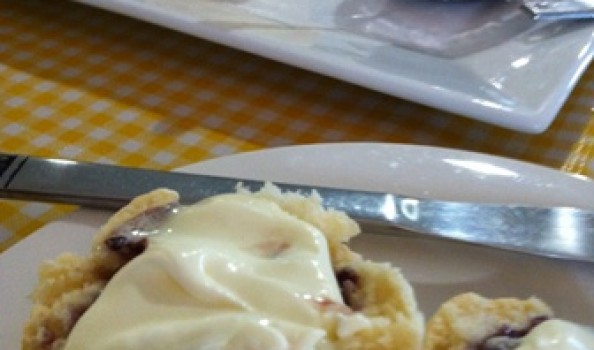 https://nakedhungrytraveller.com.au/australias-best-gourmet-region/ Australia's Best Gourmet RegionThe Northeast of Victoria is Australia’s most interestingly varied gourmet region. Call me prejudiced but I remain convinced. Having covered the wide brown land’s gourmet regions from the Barossa Valley in South Australia to the Sunshine Coast hinterland in Queensland, to Northern Tasmania’s Tamar Valley to Western Australia’s Margaret River and everywhere in New South Wales from the Northern Rivers/Byron Bay to the Southern Sapphire Coast around Eden and Merimbula (Have I left anywhere out?), I'm convinced. This is it. Victoria’s Northeast from Rutherglen to Stanley and Beechworth and all the lovely rolling country in between from Murray River flatlands to Alpine Highlands is the best. [caption id="attachment_2926" align="alignnone" width="439"]
https://nakedhungrytraveller.com.au/australias-best-gourmet-region/ Australia's Best Gourmet RegionThe Northeast of Victoria is Australia’s most interestingly varied gourmet region. Call me prejudiced but I remain convinced. Having covered the wide brown land’s gourmet regions from the Barossa Valley in South Australia to the Sunshine Coast hinterland in Queensland, to Northern Tasmania’s Tamar Valley to Western Australia’s Margaret River and everywhere in New South Wales from the Northern Rivers/Byron Bay to the Southern Sapphire Coast around Eden and Merimbula (Have I left anywhere out?), I'm convinced. This is it. Victoria’s Northeast from Rutherglen to Stanley and Beechworth and all the lovely rolling country in between from Murray River flatlands to Alpine Highlands is the best. [caption id="attachment_2926" align="alignnone" width="439"] Tiny town school between Wangaratta and Eldorado--if you spell the name right, you graduate with honours.[/caption]
Is it the combination of mineral rich soils and a huge range of climate zones contained in a relatively small area? The diverse community of keen farmers, vignerons and orchardists collaborating with a very talented group of restaurateurs and hoteliers?
All this and more set this region apart in terms of sheer variety of produce and human expertise working in perfect tandem.
I visited recently, this time to explore a smattering of King Valley wineries while sampling the gastronomic delights around Milawa.
Tiny Milawa is well known for its mustard factory and cheese shop. Brown Brothers winery put Milawa on the gourmet map many years ago.
[caption id="attachment_2911" align="alignnone" width="407"]
Tiny town school between Wangaratta and Eldorado--if you spell the name right, you graduate with honours.[/caption]
Is it the combination of mineral rich soils and a huge range of climate zones contained in a relatively small area? The diverse community of keen farmers, vignerons and orchardists collaborating with a very talented group of restaurateurs and hoteliers?
All this and more set this region apart in terms of sheer variety of produce and human expertise working in perfect tandem.
I visited recently, this time to explore a smattering of King Valley wineries while sampling the gastronomic delights around Milawa.
Tiny Milawa is well known for its mustard factory and cheese shop. Brown Brothers winery put Milawa on the gourmet map many years ago.
[caption id="attachment_2911" align="alignnone" width="407"]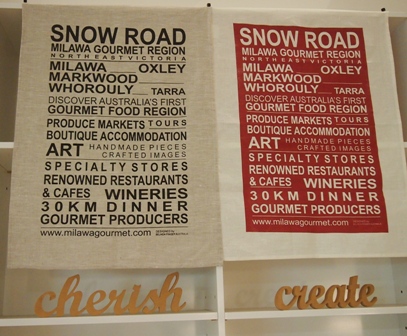 Snow Road Produce tea towels display[/caption]
Now a contemporary providore and cafe adds shinier lustre. Snow Road Produce (www.snowroadproduce.com) sells a wide range of local goods including a terrific range of wines and Beechworth’s Bridge Road beers.
[caption id="attachment_2936" align="alignnone" width="422"]
Snow Road Produce tea towels display[/caption]
Now a contemporary providore and cafe adds shinier lustre. Snow Road Produce (www.snowroadproduce.com) sells a wide range of local goods including a terrific range of wines and Beechworth’s Bridge Road beers.
[caption id="attachment_2936" align="alignnone" width="422"]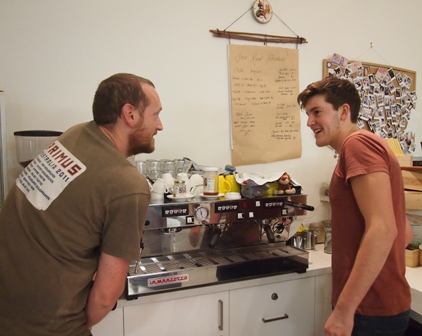 Snow Road Produce espresso team in action[/caption]
Owned and operated by hospitality professionals Lachlan and Emma Routledge, breakfast and lunch is served six days (closed Wednesdays) while a simple menu of pizzas and a few well-prepared main courses is served Friday and Sunday nights until about 9pm. Ring ahead to make a booking as the thin crust authentic pizzas are popular. Coffee by local roaster Honeybird of Mount Beauty is superb.
[caption id="attachment_2910" align="alignnone" width="448"]
Snow Road Produce espresso team in action[/caption]
Owned and operated by hospitality professionals Lachlan and Emma Routledge, breakfast and lunch is served six days (closed Wednesdays) while a simple menu of pizzas and a few well-prepared main courses is served Friday and Sunday nights until about 9pm. Ring ahead to make a booking as the thin crust authentic pizzas are popular. Coffee by local roaster Honeybird of Mount Beauty is superb.
[caption id="attachment_2910" align="alignnone" width="448"]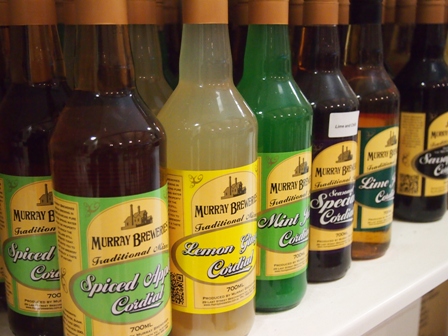 Snow Road Produce Murray Breweries cordials[/caption]
Around Milawa, Oxley and Everton lies a rich assortment of farm shops and wineries. Sam Miranda Wines just outside Oxley opened a schmick cellar door restaurant a few years ago in a striking new winery building alongside the picturesque King River. (www.sammiranda.com.au) The food and wine matching at Miranda’s restaurant is always interesting while the range of wines is comprehensive and well made.
Nearby Ciccone Estate and John Gehrig Wines both typify the expertly crafted wines of the region and offer a wide selection of styles with welcoming cellar doors. (www.cicconewines.com.au and www.johngehrigwines.com.au)
Of course the daddy of them all in these parts is Brown Brothers (www.brownbrothers.com.au) where education and innovation has long been essential to the Brown family’s success in conquering global markets.
[caption id="attachment_2912" align="alignnone" width="427"]
Snow Road Produce Murray Breweries cordials[/caption]
Around Milawa, Oxley and Everton lies a rich assortment of farm shops and wineries. Sam Miranda Wines just outside Oxley opened a schmick cellar door restaurant a few years ago in a striking new winery building alongside the picturesque King River. (www.sammiranda.com.au) The food and wine matching at Miranda’s restaurant is always interesting while the range of wines is comprehensive and well made.
Nearby Ciccone Estate and John Gehrig Wines both typify the expertly crafted wines of the region and offer a wide selection of styles with welcoming cellar doors. (www.cicconewines.com.au and www.johngehrigwines.com.au)
Of course the daddy of them all in these parts is Brown Brothers (www.brownbrothers.com.au) where education and innovation has long been essential to the Brown family’s success in conquering global markets.
[caption id="attachment_2912" align="alignnone" width="427"]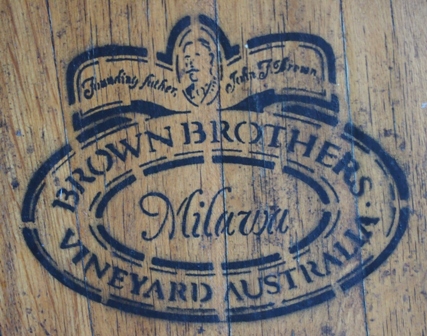 Brown Brothers barrel[/caption]
In my opinion Brown Brothers operates the country’s most professional cellar door. Long time employees charm customers with their generosity of spirit and warm welcome. I say this wholeheartedly though I know comments like this smack of advertorial. Honest-to-goodness hospitality pervades throughout the Brown Brothers business, setting a model that other less proactive businesses should have wisely emulated years ago.
[caption id="attachment_2913" align="alignnone" width="393"]
Brown Brothers barrel[/caption]
In my opinion Brown Brothers operates the country’s most professional cellar door. Long time employees charm customers with their generosity of spirit and warm welcome. I say this wholeheartedly though I know comments like this smack of advertorial. Honest-to-goodness hospitality pervades throughout the Brown Brothers business, setting a model that other less proactive businesses should have wisely emulated years ago.
[caption id="attachment_2913" align="alignnone" width="393"] Brown Brothers cellar door[/caption]
Wine making is essentially a farming business. Boom and bust periods are integral to life in a vineyard. Throughout lean and rich times the Brown family always endeavours to treat its employees like members of an extended clan.
The ethos of mutual respect runs true in everything the Brown family does, there for everyone to share.
Exemplified by its clever and long-running education program, Brown Brothers opened an Epicurean Centre years ago to showcase its broad range of wines matched with appropriate food. Several restaurant incarnations later, the excellent Patricia’s Table restaurant has reached a culinary pinnacle.
I’ve dined moderately well at Brown Brothers’ restaurant several times over the years. The most recent experience I enjoyed was the best yet. Head chef Douglas Elder has raised the bar to a higher level, specialising in maximum use of local seasonal produce.
[caption id="attachment_2914" align="alignnone" width="412"]
Brown Brothers cellar door[/caption]
Wine making is essentially a farming business. Boom and bust periods are integral to life in a vineyard. Throughout lean and rich times the Brown family always endeavours to treat its employees like members of an extended clan.
The ethos of mutual respect runs true in everything the Brown family does, there for everyone to share.
Exemplified by its clever and long-running education program, Brown Brothers opened an Epicurean Centre years ago to showcase its broad range of wines matched with appropriate food. Several restaurant incarnations later, the excellent Patricia’s Table restaurant has reached a culinary pinnacle.
I’ve dined moderately well at Brown Brothers’ restaurant several times over the years. The most recent experience I enjoyed was the best yet. Head chef Douglas Elder has raised the bar to a higher level, specialising in maximum use of local seasonal produce.
[caption id="attachment_2914" align="alignnone" width="412"]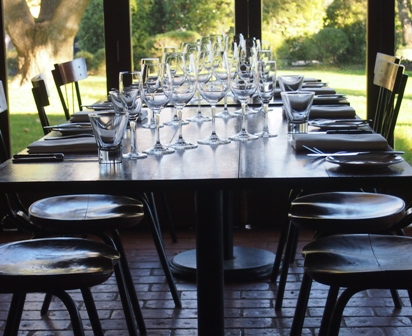 Patricia's Table restaurant at Brown Brothers[/caption]
An entree of Fried Masterstock quail with corn puree, black bean dressing, rolled chicken terrine and shaved coconut was truly delicious. The Cellar Door Release 2013 Pinot Noir Rose partnering the dish was equally inspired.
Other dishes enjoyed during a leisurely lunch on a sunny winter’s afternoon in a large room with floor to ceiling windows overlooking landscaped grounds proved to be real slices of the good life: Chestnut and Ricotta Raviolo with Autumn Mushrooms (mostly Pine mushrooms the day I visited), Porcini Custard and Consommé to wit. Another entree of Cold smoked salmon, Dill Crème Fraiche, Brioche, Cucumber Piccalilli and Red Onion was also superb. Wine matching excelled, respectively a 2012 Limited Release Tempranillo and Graciano blend and a 2012 ‘Banksdale’ Chardonnay.
Under restaurant manager Bec Deslandes’ resourceful and friendly guidance, service is flawless. Our server, Julie Willis, was a fount of local knowledge whose utter charm sprang forth like a premium vintage 'Patricia' sparkling wine.
From Milawa it’s a short drive up the King Valley to Whitfield where the majority of top-quality wineries have cellar doors open to the public most weekends and public holidays.
Patricia's Table restaurant at Brown Brothers[/caption]
An entree of Fried Masterstock quail with corn puree, black bean dressing, rolled chicken terrine and shaved coconut was truly delicious. The Cellar Door Release 2013 Pinot Noir Rose partnering the dish was equally inspired.
Other dishes enjoyed during a leisurely lunch on a sunny winter’s afternoon in a large room with floor to ceiling windows overlooking landscaped grounds proved to be real slices of the good life: Chestnut and Ricotta Raviolo with Autumn Mushrooms (mostly Pine mushrooms the day I visited), Porcini Custard and Consommé to wit. Another entree of Cold smoked salmon, Dill Crème Fraiche, Brioche, Cucumber Piccalilli and Red Onion was also superb. Wine matching excelled, respectively a 2012 Limited Release Tempranillo and Graciano blend and a 2012 ‘Banksdale’ Chardonnay.
Under restaurant manager Bec Deslandes’ resourceful and friendly guidance, service is flawless. Our server, Julie Willis, was a fount of local knowledge whose utter charm sprang forth like a premium vintage 'Patricia' sparkling wine.
From Milawa it’s a short drive up the King Valley to Whitfield where the majority of top-quality wineries have cellar doors open to the public most weekends and public holidays.
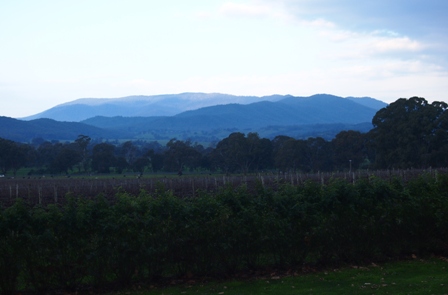 If an abundance of Italian surnames is noted, remember that this area was settled by migrants escaping the deprivations of war from 1918 onwards until the early 50s. Italian families' tobacco growing businesses once proliferated in the King Valley and surrounds. They brought with them (usually hidden in packages and trunks on board the ships carrying them to new pastures) Italian grape varieties' rootstock from ancestral vineyards. Making wine primarily for home use in a style they preferred, less alcoholic and more savoury than the fuller bodied and fruitier wines common in Australia until the early 80s, these pioneering families now dominate today’s local wine industry.
The verdant foothills of the Australian Alps in Northeast Victoria appear vaguely Tuscan in appearance, particularly after several glasses of Prosecco when autumn and winter mists set into the landscape like a finely embroidered cloak.
At Dal Zotto Wines, Prosecco, the light bodied grape responsible for the frothy sparkling wine captivating Australia, is the wine of the moment. Winemaker Michael Dal Zotto has spent many months studying and working around Valdobbiadene, Italy’s Prosecco headquarters North of Venice nestled in beautiful hill country. Here he learned how to make Prosecco in a fashion the most loyal Italo-phile would love.
Dal Zotto boasts a cozy cellar door facility and a great range of wines including stunning examples of Barbera, Nebbiolo and Arneis. (www.dalzotto.com.au)
By sheer happenstance I popped into Dal Zotto while Michael Dal Zotto and a small team of volunteers was cutting up free range pork for salami and sausages. An aura of secret men’s business pervades salami making but this was an open kitchen full of fun and ‘dolce vita’.
[caption id="attachment_2915" align="alignnone" width="448"]
If an abundance of Italian surnames is noted, remember that this area was settled by migrants escaping the deprivations of war from 1918 onwards until the early 50s. Italian families' tobacco growing businesses once proliferated in the King Valley and surrounds. They brought with them (usually hidden in packages and trunks on board the ships carrying them to new pastures) Italian grape varieties' rootstock from ancestral vineyards. Making wine primarily for home use in a style they preferred, less alcoholic and more savoury than the fuller bodied and fruitier wines common in Australia until the early 80s, these pioneering families now dominate today’s local wine industry.
The verdant foothills of the Australian Alps in Northeast Victoria appear vaguely Tuscan in appearance, particularly after several glasses of Prosecco when autumn and winter mists set into the landscape like a finely embroidered cloak.
At Dal Zotto Wines, Prosecco, the light bodied grape responsible for the frothy sparkling wine captivating Australia, is the wine of the moment. Winemaker Michael Dal Zotto has spent many months studying and working around Valdobbiadene, Italy’s Prosecco headquarters North of Venice nestled in beautiful hill country. Here he learned how to make Prosecco in a fashion the most loyal Italo-phile would love.
Dal Zotto boasts a cozy cellar door facility and a great range of wines including stunning examples of Barbera, Nebbiolo and Arneis. (www.dalzotto.com.au)
By sheer happenstance I popped into Dal Zotto while Michael Dal Zotto and a small team of volunteers was cutting up free range pork for salami and sausages. An aura of secret men’s business pervades salami making but this was an open kitchen full of fun and ‘dolce vita’.
[caption id="attachment_2915" align="alignnone" width="448"]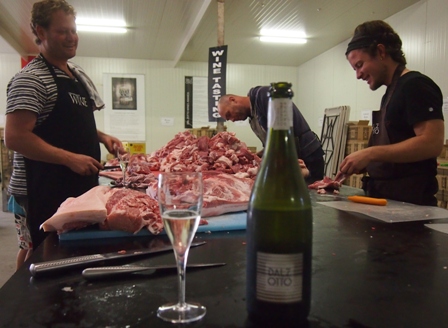 Salami preparation at Dal Zotto[/caption]
Other esteemed wineries in the neighbourhood are Pizzini Wines, Politini and Chrismont. (www.pizzini.com.au www.politiniwines.com.au and www.chrismont.com.au)
[caption id="attachment_2918" align="alignnone" width="448"]
Salami preparation at Dal Zotto[/caption]
Other esteemed wineries in the neighbourhood are Pizzini Wines, Politini and Chrismont. (www.pizzini.com.au www.politiniwines.com.au and www.chrismont.com.au)
[caption id="attachment_2918" align="alignnone" width="448"] Michael Dal Zotto and customers at the family cellar door[/caption]
Fred and Katrina Pizzini, like the Dal Zotto family, are local wine industry heroes. Katrina, an accomplished chef, runs a very successful cooking school from the winery. Fred has attained ‘Eminence Grise’ status while his kids continue the Pizzini tradition of creating stunning wines from their family vineyards. Fred Pizzini is the Nebbiolo guru in these parts. His ‘Vin Santo’ style wine is unique and well worth getting hold of a bottle when it’s available.
Chrismont’s excellent Riesling is sought after by knowledgeable wine buffs. The rest of the range is equally good.
Just down the road from Whitfield is Gracebrook Vineyards. Owned and operated by the Maples family, they've been farming here since the 1970s. The Gracebrook restaurant connected to the winery and cellar door is open seven days for lunch. This is authentic ‘Paddock to Plate’ dining as almost the entire menu is sourced from the family farm.
The kitchen is run by talented chef Colleen Maples who shares duties with two of her sisters. Another Maples progeny, Nathan, is a local builder who has helped construct the warmly rustic cellar door and restaurant dining room. Views from the veranda overlooking the valley and nearby mountains are mesmerising. (www.gracebrook.com.au)
[caption id="attachment_2919" align="alignnone" width="425"]
Michael Dal Zotto and customers at the family cellar door[/caption]
Fred and Katrina Pizzini, like the Dal Zotto family, are local wine industry heroes. Katrina, an accomplished chef, runs a very successful cooking school from the winery. Fred has attained ‘Eminence Grise’ status while his kids continue the Pizzini tradition of creating stunning wines from their family vineyards. Fred Pizzini is the Nebbiolo guru in these parts. His ‘Vin Santo’ style wine is unique and well worth getting hold of a bottle when it’s available.
Chrismont’s excellent Riesling is sought after by knowledgeable wine buffs. The rest of the range is equally good.
Just down the road from Whitfield is Gracebrook Vineyards. Owned and operated by the Maples family, they've been farming here since the 1970s. The Gracebrook restaurant connected to the winery and cellar door is open seven days for lunch. This is authentic ‘Paddock to Plate’ dining as almost the entire menu is sourced from the family farm.
The kitchen is run by talented chef Colleen Maples who shares duties with two of her sisters. Another Maples progeny, Nathan, is a local builder who has helped construct the warmly rustic cellar door and restaurant dining room. Views from the veranda overlooking the valley and nearby mountains are mesmerising. (www.gracebrook.com.au)
[caption id="attachment_2919" align="alignnone" width="425"]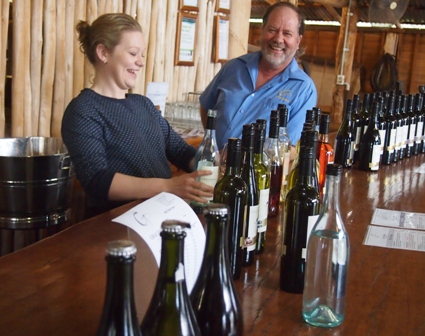 Colleen and David Maples, daughter and father team at Gracebrook cellar door[/caption]
David Maples makes wines according to basic organic principles with minimal intervention in the winery. I tasted a wide range of his wines, from an austere Sauvignon Blanc made very much in the Sancerre style to a complex Riesling from the 2005 vintage. A 2010 Savagnin Blanc was the best example I’ve tasted of this variety produced in Australia. (Savagnin Blanc rootstock was confused by import authorities for Albarino which has resulted in some unavoidable confusion.) A 2009 Sagrantino was also very good, earthy, tannic and crying out for a big plate of Osso Buco. I also liked Gracebrook’s Cabernet Sauvignon and Shiraz, both prime examples of adept cool climate wine-making techniques.
Apart from the great food at Brown Brothers and Snow Road Produce I dined at newest talented chef on the block Ben Bergmann’s excellent food at the Mountain View Hotel located in the centre of Whitfield. You can’t miss the Mountain View pub; it’s the only one in town. Owned by the Pizzini family and managed by German born Bergmann, this pub operates two distinct dining rooms. One is capacious and ‘pubby’ with a long bar running alongside widely spaced tables overlooking a huge beer garden where an imaginative menu appeals to both local residents who prefer a no fuss chicken Parma and smart travellers searching for great ingredients cooked with consummate skill by a chef who really knows what he’s doing.
[caption id="attachment_2920" align="alignnone" width="376"]
Colleen and David Maples, daughter and father team at Gracebrook cellar door[/caption]
David Maples makes wines according to basic organic principles with minimal intervention in the winery. I tasted a wide range of his wines, from an austere Sauvignon Blanc made very much in the Sancerre style to a complex Riesling from the 2005 vintage. A 2010 Savagnin Blanc was the best example I’ve tasted of this variety produced in Australia. (Savagnin Blanc rootstock was confused by import authorities for Albarino which has resulted in some unavoidable confusion.) A 2009 Sagrantino was also very good, earthy, tannic and crying out for a big plate of Osso Buco. I also liked Gracebrook’s Cabernet Sauvignon and Shiraz, both prime examples of adept cool climate wine-making techniques.
Apart from the great food at Brown Brothers and Snow Road Produce I dined at newest talented chef on the block Ben Bergmann’s excellent food at the Mountain View Hotel located in the centre of Whitfield. You can’t miss the Mountain View pub; it’s the only one in town. Owned by the Pizzini family and managed by German born Bergmann, this pub operates two distinct dining rooms. One is capacious and ‘pubby’ with a long bar running alongside widely spaced tables overlooking a huge beer garden where an imaginative menu appeals to both local residents who prefer a no fuss chicken Parma and smart travellers searching for great ingredients cooked with consummate skill by a chef who really knows what he’s doing.
[caption id="attachment_2920" align="alignnone" width="376"] Head chef and manager Ben Bergmann at Mountain View Hotel[/caption]
The other much smaller dining room is reserved for fine dining where a very moderately priced degustation menu allows Bergmann’s star to shine without dimming down. A comprehensive wine list comprising local favourites and imported beauties creates a very appealing package. (www.mvhotel.com.au)
[caption id="attachment_2921" align="alignnone" width="448"]
Head chef and manager Ben Bergmann at Mountain View Hotel[/caption]
The other much smaller dining room is reserved for fine dining where a very moderately priced degustation menu allows Bergmann’s star to shine without dimming down. A comprehensive wine list comprising local favourites and imported beauties creates a very appealing package. (www.mvhotel.com.au)
[caption id="attachment_2921" align="alignnone" width="448"]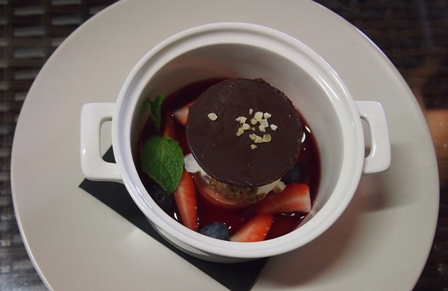 A berry good dessert at Mountain View Hotel[/caption]
Bergmann’s ambition for this winning gastro-pub is clear: he wants to create a destination diner. Four adjoining rooms have been renovated to superior accommodation standard as an encouragement for guests wanting to reduce worries about driving after drinking great wine.
Given Ben Bergmann’s drive and talent, I believe the Mountain View Hotel is poised to become Victoria’s newest stand-alone gourmet restaurant up to the task of proving correct the old Michelin adage: It’s Worth the Detour.
Down the valley on the main road between Wangaratta and Beechworth is miniscule Tarrawingee, essentially the hamlet with a gracious old pub attached.
Many times over the years I drove by the old pub and felt sad. It was unloved but still lovely looking. All it needed was tender care and someone with drive to primp its interior while returning it to former glory.
[caption id="attachment_2923" align="alignnone" width="448"]
A berry good dessert at Mountain View Hotel[/caption]
Bergmann’s ambition for this winning gastro-pub is clear: he wants to create a destination diner. Four adjoining rooms have been renovated to superior accommodation standard as an encouragement for guests wanting to reduce worries about driving after drinking great wine.
Given Ben Bergmann’s drive and talent, I believe the Mountain View Hotel is poised to become Victoria’s newest stand-alone gourmet restaurant up to the task of proving correct the old Michelin adage: It’s Worth the Detour.
Down the valley on the main road between Wangaratta and Beechworth is miniscule Tarrawingee, essentially the hamlet with a gracious old pub attached.
Many times over the years I drove by the old pub and felt sad. It was unloved but still lovely looking. All it needed was tender care and someone with drive to primp its interior while returning it to former glory.
[caption id="attachment_2923" align="alignnone" width="448"] Plough Inn wineglasses[/caption]
Lucky for us, dynamic duo Andrew and Feona Roscouet stepped in over a year ago. Andrew was the head chef at the sadly missed and excellent Wardens of Beechworth. He has plenty of street cred, having worked in fine restaurants in Melbourne and abroad. (www.theploughinn.com.au)
Put simply, he’s a gifted chef.
[caption id="attachment_2922" align="alignnone" width="336"]
Plough Inn wineglasses[/caption]
Lucky for us, dynamic duo Andrew and Feona Roscouet stepped in over a year ago. Andrew was the head chef at the sadly missed and excellent Wardens of Beechworth. He has plenty of street cred, having worked in fine restaurants in Melbourne and abroad. (www.theploughinn.com.au)
Put simply, he’s a gifted chef.
[caption id="attachment_2922" align="alignnone" width="336"]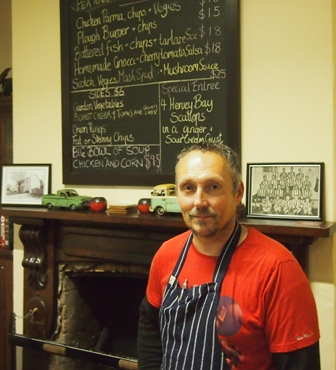 Andrew Roscouet chef owner at the Plough Inn[/caption]
He’s also one of the reasons I’m so enthused about this whole region as an Australian gourmet’s paradise.
The newly revamped Plough Inn at Tarrawingee is now one of the region’s finest restaurants. Service is top-notch (Thank you Kylie and Florence!) while Andrew and his talented sous-chef Tui rattle the pans with aplomb.
[caption id="attachment_2925" align="alignnone" width="448"]
Andrew Roscouet chef owner at the Plough Inn[/caption]
He’s also one of the reasons I’m so enthused about this whole region as an Australian gourmet’s paradise.
The newly revamped Plough Inn at Tarrawingee is now one of the region’s finest restaurants. Service is top-notch (Thank you Kylie and Florence!) while Andrew and his talented sous-chef Tui rattle the pans with aplomb.
[caption id="attachment_2925" align="alignnone" width="448"]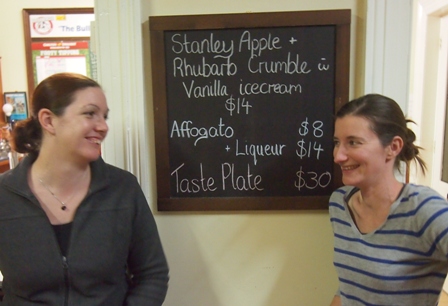 Kylie and Florence at the Plough Inn[/caption]
A very reasonably priced degustation menu (AUD$65 per person for five generous courses, AUD$90 per person with matching wines): Gratineed Scallops with Pea Puree, Crème Fraiche and Ginger crumbs were lip smacking succulent, sweet of the sea and cooked just enough to warm the juicy scallops to a state of perfection. A Twice-cooked Pork Belly with Sweetcorn Puree, Corn and Red Capsicum salsa and Goat’s cheese Croquettes was rich and exquisite. Beef cheek Agnolotti on a reduced sweet/savoury Onion Puree, thin slices of Fennel pickled in Chinese spices and rice wine vinegar with crunchy Savoury Corn Flakes was inspired if a little weird. Two Duck leg Confit spheres encased in bread crumbs then lightly fried over Lentils, Garlic Cream, tiny roast Pumpkin pieces and a house made Worcestershire sauce came together like a dream but by then I’d overloaded on protein and couldn’t finish. I had no problem polishing off the Sticky Date pudding with Poached Prune and house made Butterscotch Sauce which our server Kylie referred to as ’A Cup Of Heaven’. She was right about that.
We drank a complex and plummy/mushroom-y bottle of Ninth Mile Vineyard unfiltered 2011 Pinot Noir from a vineyard near Stanley sited approximately 800 metres altitude.
Before the Pinot Noir, to start we had two glasses of Ringer Reef Sauvignon Blanc from Porepunkah near Myrtleford, another cool climate wine from a great local producer.
Roscouet’s food verges on the generous side of rich. He says his local customers are meat eaters (farmers in this region tend to like their meat portions served giant sized) but I reckon he could add a vegetable course to the degustation to give us meat-wimps a chance to complete the feast without a nearby defibrillator powered up ready for action.
No matter, the old pub retains its historic atmosphere; the small front bar is direct from country Victoria casting, while the Roscouet family has wisely injected aspects of urban cool into the framework. For instance, the main dining room’s ceiling sports plywood sheeting draped over rafters hiding extra insulation. Melbourne and Sydney trendy renovated warehouse restaurants sport similar looks.
The Plough Inn also provides a modestly priced pub grub menu with terrific hamburgers, fish and chips and a small selection of items off the main restaurant menu.
Plans are afoot to open the rooms upstairs for overnight guests. A huge cellar under the old floorboards is set for renovation as well and a room off the front bar in the vicinity of the gent’s lavatory will become a boutique selling hard-to-find local wines.
Clearly this couple have big plans in mind for the ongoing success of the Plough Inn. They’re off to a smashing start.
Tom Neal Tacker visited Northeast Victoria as a guest of Tourism North East and the Rural City of Wangaratta.
Naked Facts:
The Northeast Valleys are approximately three hours easy driving from Melbourne via Wangaratta, the gateway town to the Northeast Valleys region via the Hume Highway.
Frequent daily flights operate between Melbourne and Sydney to Albury-Wodonga on the Victoria/New South Wales border, approximately 45 minutes drive to Beechworth or 60 minutes to Milawa.
Wangaratta is on the main Melbourne-Sydney train line. Sadly train service is patchy due to ongoing maintenance work on the recently repaired (badly) track bed in Victoria which has resulted in frequent replacement buses operating between the various towns linking Wangaratta and Melbourne. This service is not a clean, speedy V-Line and doesn't compare to the new-ish train service operating between Melbourne and Ballarat and Melbourne and Bendigo.
See www.victoriahighcountry.com.au and www.winesofthekingvalley.com.au for more information about accommodation, annual festivals, cellar door opening hours and tips on recommended driving routes.
A new site www.kingvalleyproseccoroad.com.au promotes the wonders of local Prosecco with extensive information about cellar doors, wine festivals and touring options.
For more information about Milawa’s gourmet produce and regional specialties check out: www.milawagourmet.com
The Murray to Mountains Rail Trail bicycle route between Rutherglen, Wangaratta, Beechworth and Bright is a very well maintained and popular touring option. Highly recommended, pedal to paddock is the way to go. See www.murraytomountains.com.au
Naked Sleeps:
[caption id="attachment_2924" align="alignnone" width="448"]
Kylie and Florence at the Plough Inn[/caption]
A very reasonably priced degustation menu (AUD$65 per person for five generous courses, AUD$90 per person with matching wines): Gratineed Scallops with Pea Puree, Crème Fraiche and Ginger crumbs were lip smacking succulent, sweet of the sea and cooked just enough to warm the juicy scallops to a state of perfection. A Twice-cooked Pork Belly with Sweetcorn Puree, Corn and Red Capsicum salsa and Goat’s cheese Croquettes was rich and exquisite. Beef cheek Agnolotti on a reduced sweet/savoury Onion Puree, thin slices of Fennel pickled in Chinese spices and rice wine vinegar with crunchy Savoury Corn Flakes was inspired if a little weird. Two Duck leg Confit spheres encased in bread crumbs then lightly fried over Lentils, Garlic Cream, tiny roast Pumpkin pieces and a house made Worcestershire sauce came together like a dream but by then I’d overloaded on protein and couldn’t finish. I had no problem polishing off the Sticky Date pudding with Poached Prune and house made Butterscotch Sauce which our server Kylie referred to as ’A Cup Of Heaven’. She was right about that.
We drank a complex and plummy/mushroom-y bottle of Ninth Mile Vineyard unfiltered 2011 Pinot Noir from a vineyard near Stanley sited approximately 800 metres altitude.
Before the Pinot Noir, to start we had two glasses of Ringer Reef Sauvignon Blanc from Porepunkah near Myrtleford, another cool climate wine from a great local producer.
Roscouet’s food verges on the generous side of rich. He says his local customers are meat eaters (farmers in this region tend to like their meat portions served giant sized) but I reckon he could add a vegetable course to the degustation to give us meat-wimps a chance to complete the feast without a nearby defibrillator powered up ready for action.
No matter, the old pub retains its historic atmosphere; the small front bar is direct from country Victoria casting, while the Roscouet family has wisely injected aspects of urban cool into the framework. For instance, the main dining room’s ceiling sports plywood sheeting draped over rafters hiding extra insulation. Melbourne and Sydney trendy renovated warehouse restaurants sport similar looks.
The Plough Inn also provides a modestly priced pub grub menu with terrific hamburgers, fish and chips and a small selection of items off the main restaurant menu.
Plans are afoot to open the rooms upstairs for overnight guests. A huge cellar under the old floorboards is set for renovation as well and a room off the front bar in the vicinity of the gent’s lavatory will become a boutique selling hard-to-find local wines.
Clearly this couple have big plans in mind for the ongoing success of the Plough Inn. They’re off to a smashing start.
Tom Neal Tacker visited Northeast Victoria as a guest of Tourism North East and the Rural City of Wangaratta.
Naked Facts:
The Northeast Valleys are approximately three hours easy driving from Melbourne via Wangaratta, the gateway town to the Northeast Valleys region via the Hume Highway.
Frequent daily flights operate between Melbourne and Sydney to Albury-Wodonga on the Victoria/New South Wales border, approximately 45 minutes drive to Beechworth or 60 minutes to Milawa.
Wangaratta is on the main Melbourne-Sydney train line. Sadly train service is patchy due to ongoing maintenance work on the recently repaired (badly) track bed in Victoria which has resulted in frequent replacement buses operating between the various towns linking Wangaratta and Melbourne. This service is not a clean, speedy V-Line and doesn't compare to the new-ish train service operating between Melbourne and Ballarat and Melbourne and Bendigo.
See www.victoriahighcountry.com.au and www.winesofthekingvalley.com.au for more information about accommodation, annual festivals, cellar door opening hours and tips on recommended driving routes.
A new site www.kingvalleyproseccoroad.com.au promotes the wonders of local Prosecco with extensive information about cellar doors, wine festivals and touring options.
For more information about Milawa’s gourmet produce and regional specialties check out: www.milawagourmet.com
The Murray to Mountains Rail Trail bicycle route between Rutherglen, Wangaratta, Beechworth and Bright is a very well maintained and popular touring option. Highly recommended, pedal to paddock is the way to go. See www.murraytomountains.com.au
Naked Sleeps:
[caption id="attachment_2924" align="alignnone" width="448"] The Baker's Cottage in Eldorado[/caption]
Wow! Could you ask for a better host than Sandy Bogusis of the lovingly restored Baker’s Cottage in historic off-the-beaten-track Eldorado?
I think not. Sandy is a qualified tour guide who specialises in Victorian wineries. She knows everyone worth knowing in the region where wine and food are concerned.
The Baker’s Cottage comprises two old miner's cottages linked by a rather odd shaped triangular dining room. With two bedrooms sporting queen sized beds, two lounge rooms, one large bathroom and one en-suite lavatory, a fully equipped kitchen and entrance hallway all set in a lovely garden, this is a home-away-from-home. I have never written that cliché before but I mean it. I could have moved permanently into the Baker’s Cottage and not needed anything else but my clothes.
[caption id="attachment_2931" align="alignnone" width="448"]
The Baker's Cottage in Eldorado[/caption]
Wow! Could you ask for a better host than Sandy Bogusis of the lovingly restored Baker’s Cottage in historic off-the-beaten-track Eldorado?
I think not. Sandy is a qualified tour guide who specialises in Victorian wineries. She knows everyone worth knowing in the region where wine and food are concerned.
The Baker’s Cottage comprises two old miner's cottages linked by a rather odd shaped triangular dining room. With two bedrooms sporting queen sized beds, two lounge rooms, one large bathroom and one en-suite lavatory, a fully equipped kitchen and entrance hallway all set in a lovely garden, this is a home-away-from-home. I have never written that cliché before but I mean it. I could have moved permanently into the Baker’s Cottage and not needed anything else but my clothes.
[caption id="attachment_2931" align="alignnone" width="448"]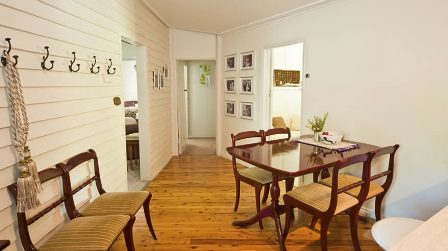 The Baker's Cottage dining area[/caption]
Next door is a real old baker’s oven that was used for bread making when Eldorado was a gold mining boom town in the 1850 and 1860s. Ask Sandy to open it if you want to glimpse how baking integrated into a slice of history from Australia’s fabulously rich gold rush era.
[caption id="attachment_2932" align="alignnone" width="448"]
The Baker's Cottage dining area[/caption]
Next door is a real old baker’s oven that was used for bread making when Eldorado was a gold mining boom town in the 1850 and 1860s. Ask Sandy to open it if you want to glimpse how baking integrated into a slice of history from Australia’s fabulously rich gold rush era.
[caption id="attachment_2932" align="alignnone" width="448"]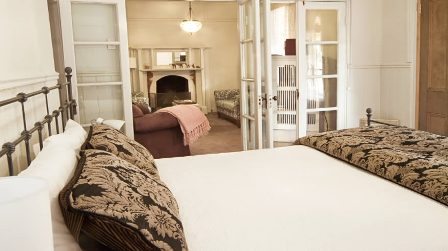 The Baker's Cottage main bedroom[/caption]
Sandy stocks the larder with all the breakfast fixings you’d need. I would have liked a fresh fruit juice as well but that’s a very minor quibble.
All mod cons are included: two large flat screen televisions, DVD player, CD player, stereo system and an open fireplace for those nights when a fire is what the romance doctor ordered.
Sandy is also happy to collect guests from Wangaratta's railway station.
www.thebakerscottage.com.au
Naked Tips:
Eldorado is about 20 minutes drive from Wangaratta or Milawa and 10 minutes to Tarrawingee or 30 minutes to Beechworth. It’s a centrally located hamlet that appears to have slipped off the radar.
[caption id="attachment_2928" align="alignnone" width="448"]
The Baker's Cottage main bedroom[/caption]
Sandy stocks the larder with all the breakfast fixings you’d need. I would have liked a fresh fruit juice as well but that’s a very minor quibble.
All mod cons are included: two large flat screen televisions, DVD player, CD player, stereo system and an open fireplace for those nights when a fire is what the romance doctor ordered.
Sandy is also happy to collect guests from Wangaratta's railway station.
www.thebakerscottage.com.au
Naked Tips:
Eldorado is about 20 minutes drive from Wangaratta or Milawa and 10 minutes to Tarrawingee or 30 minutes to Beechworth. It’s a centrally located hamlet that appears to have slipped off the radar.
[caption id="attachment_2928" align="alignnone" width="448"]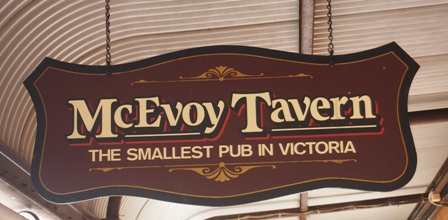 McEvoy tavern sign[/caption]
The McEvoy Tavern in Eldorado is a real delight. The smallest pub in Victoria packs in a lot of old country hospitality. Have a drink here and mix with real local people who love a chat about what makes Eldorado special.
[caption id="attachment_2929" align="alignnone" width="448"]
McEvoy tavern sign[/caption]
The McEvoy Tavern in Eldorado is a real delight. The smallest pub in Victoria packs in a lot of old country hospitality. Have a drink here and mix with real local people who love a chat about what makes Eldorado special.
[caption id="attachment_2929" align="alignnone" width="448"]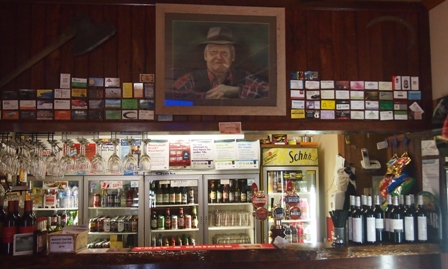 McEvoy Tavern interior[/caption]
McEvoy Tavern interior[/caption] https://nakedhungrytraveller.com.au/road-america/ The Road to AmericaThere is no other country more suited to a road trip than America. I put my foot down hard on the accelerator of opinion driving here I know. Counter claims? Park them by the wayside while I elaborate. Two lanes linking small towns all across America is the way to go. Avoid the interstate system at all cost. [caption id="attachment_2848" align="alignnone" width="275"]
https://nakedhungrytraveller.com.au/road-america/ The Road to AmericaThere is no other country more suited to a road trip than America. I put my foot down hard on the accelerator of opinion driving here I know. Counter claims? Park them by the wayside while I elaborate. Two lanes linking small towns all across America is the way to go. Avoid the interstate system at all cost. [caption id="attachment_2848" align="alignnone" width="275"]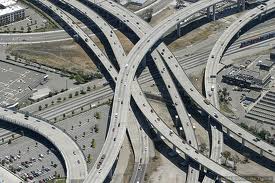 Interstate Highway junction[/caption]
Why?
In the early 1950s when President Eisenhower laid his blessing on the construction of the country’s interstate mega-highway system he also cursed great swathes of America into a state of unrelenting dullness marked by speedy access from one soulless chain store to another.
[caption id="attachment_2846" align="alignnone" width="272"]
Interstate Highway junction[/caption]
Why?
In the early 1950s when President Eisenhower laid his blessing on the construction of the country’s interstate mega-highway system he also cursed great swathes of America into a state of unrelenting dullness marked by speedy access from one soulless chain store to another.
[caption id="attachment_2846" align="alignnone" width="272"] President Eisenhower opens the Interstate System in 1956[/caption]
Within forty years the whole network of wide lanes with limited access had spread across the land. Four or more lanes allowed motorists to zip past as the highways were designed to skirt most small towns. Great for speedy transportation, a death knell for many family-owned businesses.
[caption id="attachment_2847" align="alignnone" width="233"]
President Eisenhower opens the Interstate System in 1956[/caption]
Within forty years the whole network of wide lanes with limited access had spread across the land. Four or more lanes allowed motorists to zip past as the highways were designed to skirt most small towns. Great for speedy transportation, a death knell for many family-owned businesses.
[caption id="attachment_2847" align="alignnone" width="233"]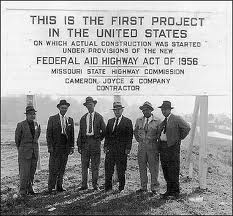 Interstate Highway System team[/caption]
Zoning laws were relaxed to allow multi-national corporations first claim to retail dominance. McDonalds, Pepsi-Cola, Coca-Cola and the like were given free reign.
A loss of regional gastronomic difference was an overwhelming consequence. A burger, fries and soft drink tastes the same in Maine as it does in Oregon when produced by companies that don’t give a damn about culture, history or individuality. And let’s not talk about health factors. Corn syrup derived fructose and lots of salt are the only ingredients common across America these days.
But all is not lost.
Regional differences are found in abundance once you leave the interstate highways behind. The trip may take longer but it will be infinitely more interesting and rewarding.
If you want to see America driven by individuality instead of herd mentality, stick to two-lane roads well away from the Interstate Highway System.
If like me, you consider a meal at a McDonalds or Denny’s or Applebee’s or Taco Bell or Arby's as a one-way trip to plastic purgatory with endless regurgitation as the only outcome, never use the Interstate Highways in hopes of finding a decent meal – or accommodation for that matter.
[caption id="attachment_2850" align="alignnone" width="186"]
Interstate Highway System team[/caption]
Zoning laws were relaxed to allow multi-national corporations first claim to retail dominance. McDonalds, Pepsi-Cola, Coca-Cola and the like were given free reign.
A loss of regional gastronomic difference was an overwhelming consequence. A burger, fries and soft drink tastes the same in Maine as it does in Oregon when produced by companies that don’t give a damn about culture, history or individuality. And let’s not talk about health factors. Corn syrup derived fructose and lots of salt are the only ingredients common across America these days.
But all is not lost.
Regional differences are found in abundance once you leave the interstate highways behind. The trip may take longer but it will be infinitely more interesting and rewarding.
If you want to see America driven by individuality instead of herd mentality, stick to two-lane roads well away from the Interstate Highway System.
If like me, you consider a meal at a McDonalds or Denny’s or Applebee’s or Taco Bell or Arby's as a one-way trip to plastic purgatory with endless regurgitation as the only outcome, never use the Interstate Highways in hopes of finding a decent meal – or accommodation for that matter.
[caption id="attachment_2850" align="alignnone" width="186"]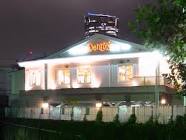 Denny's chain store restaurant[/caption]
Motel 6, Holiday Inn Express, Hampton Inns and similar, sterilised Bates Motels in all but name (check Hitchcock 'Psycho' reference), occupy prime verge position on America’s ‘Interstates’.
[caption id="attachment_2849" align="alignnone" width="275"]
Denny's chain store restaurant[/caption]
Motel 6, Holiday Inn Express, Hampton Inns and similar, sterilised Bates Motels in all but name (check Hitchcock 'Psycho' reference), occupy prime verge position on America’s ‘Interstates’.
[caption id="attachment_2849" align="alignnone" width="275"] A typical Holiday Inn in America[/caption]
Horrid food and nightmare inducing accommodation proliferate alongside these mega-highways, conjoined by convenience, pumped up by false advertising and sadly kept in business by customers blinded by excessive consumerism.
People talk about the ‘Real America’ like it’s a myth. There is no myth. Instead there is contemporary reality blended with subjective impressions.
My view is illuminated by nostalgia while occasionally clouded by a touch of cynicism. I see the American roadside’s wholesale embrace of corporate sameness as a lack of collective imagination and education. So I get off the main road and like magic, find excellence, individuality, spirit and eccentricity.
There I am reminded again why I love a road trip in America.
Accompanied by two keen travelling companions, we made an excursion from Savannah, Georgia to Charlottesville, Virginia via Asheville, North Carolina. I fell in love again with America’s back roads and small towns where many caring people are making a difference to their local environments. Perhaps driven by a need for independence from middle-of-the-road boredom, perhaps by desperation, no matter, I see them as having stubbornly, proudly chosen to avoid rampant mass consumerism. They thrive through imagination and sheer drive, that and the retail rents are probably cheaper.
If there is such a concept as a ‘Real America’ I am convinced travellers have a much better chance of experiencing it by taking the slow road to that tiny town you’ve never heard of while winding a way through lands where chain stores and strip malls are not found.
[caption id="attachment_2852" align="alignnone" width="335"]
A typical Holiday Inn in America[/caption]
Horrid food and nightmare inducing accommodation proliferate alongside these mega-highways, conjoined by convenience, pumped up by false advertising and sadly kept in business by customers blinded by excessive consumerism.
People talk about the ‘Real America’ like it’s a myth. There is no myth. Instead there is contemporary reality blended with subjective impressions.
My view is illuminated by nostalgia while occasionally clouded by a touch of cynicism. I see the American roadside’s wholesale embrace of corporate sameness as a lack of collective imagination and education. So I get off the main road and like magic, find excellence, individuality, spirit and eccentricity.
There I am reminded again why I love a road trip in America.
Accompanied by two keen travelling companions, we made an excursion from Savannah, Georgia to Charlottesville, Virginia via Asheville, North Carolina. I fell in love again with America’s back roads and small towns where many caring people are making a difference to their local environments. Perhaps driven by a need for independence from middle-of-the-road boredom, perhaps by desperation, no matter, I see them as having stubbornly, proudly chosen to avoid rampant mass consumerism. They thrive through imagination and sheer drive, that and the retail rents are probably cheaper.
If there is such a concept as a ‘Real America’ I am convinced travellers have a much better chance of experiencing it by taking the slow road to that tiny town you’ve never heard of while winding a way through lands where chain stores and strip malls are not found.
[caption id="attachment_2852" align="alignnone" width="335"]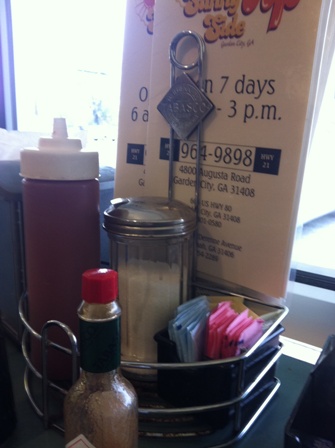 Sunny Side Up table condiments[/caption]
Not far from Savannah, we stopped at the Sunny Side Up roadside diner. (Sunny Side Up, 4800 Augusta Road, Garden City, GA Tel: +1 912 964 9898 Open 7 days 7am -3pm) It wasn’t great, nor was it an awful dive either. Instead it was typical. Suburban townsfolk were taking their working breakfasts. Truckers on the lookout for an authentic and inexpensive meal mixed tables with retirees out for a weekly social meal with old friends. Waitresses in pale blue aprons, hair tied up in buns or cut short, wearing sensible shoes with pens stuck behind ears or in apron pockets smiled and asked, ‘Morning y’all, coffee?’ all in one combined interrogatory exclamation.
[caption id="attachment_2854" align="alignnone" width="336"]
Sunny Side Up table condiments[/caption]
Not far from Savannah, we stopped at the Sunny Side Up roadside diner. (Sunny Side Up, 4800 Augusta Road, Garden City, GA Tel: +1 912 964 9898 Open 7 days 7am -3pm) It wasn’t great, nor was it an awful dive either. Instead it was typical. Suburban townsfolk were taking their working breakfasts. Truckers on the lookout for an authentic and inexpensive meal mixed tables with retirees out for a weekly social meal with old friends. Waitresses in pale blue aprons, hair tied up in buns or cut short, wearing sensible shoes with pens stuck behind ears or in apron pockets smiled and asked, ‘Morning y’all, coffee?’ all in one combined interrogatory exclamation.
[caption id="attachment_2854" align="alignnone" width="336"]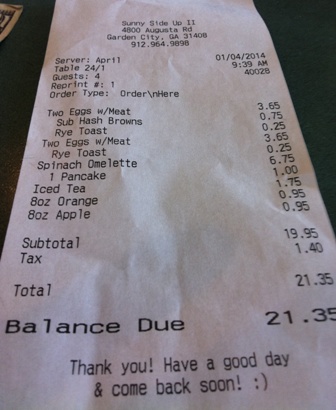 Sunny Side Up cafe breakfast account for three hungry travellers[/caption]
‘Good morning America how are you? Say, don’t you know me, I’m your native son’ wrote the famous folk muse Arlo Guthrie, a lyric in his song ‘City of New Orleans’. I remember it each time I breakfast in a rural American diner.
When I begin a day on an American road trip with a breakfast in an authentic diner like the Sunny Side Up, I am immediately put in a happier frame of mind.
Heading northwest through the flatlands of Georgia into South Carolina we stopped for lunch in Edgefield, approximately halfway between Augusta and Greenville. For uninitiated urban devotees familiar with rural stereotypes this is akin to stopping somewhere between Bugtussle and Petticoat Junction.
[caption id="attachment_2855" align="alignnone" width="362"]
Sunny Side Up cafe breakfast account for three hungry travellers[/caption]
‘Good morning America how are you? Say, don’t you know me, I’m your native son’ wrote the famous folk muse Arlo Guthrie, a lyric in his song ‘City of New Orleans’. I remember it each time I breakfast in a rural American diner.
When I begin a day on an American road trip with a breakfast in an authentic diner like the Sunny Side Up, I am immediately put in a happier frame of mind.
Heading northwest through the flatlands of Georgia into South Carolina we stopped for lunch in Edgefield, approximately halfway between Augusta and Greenville. For uninitiated urban devotees familiar with rural stereotypes this is akin to stopping somewhere between Bugtussle and Petticoat Junction.
[caption id="attachment_2855" align="alignnone" width="362"] Edgefield Turkey sculpture[/caption]
Nevertheless, Edgefield proved a gem. The home of ten former South Carolina governors, (a state gubernatorial home record), resplendent with a central business district fresh out of Main Street America central casting, graced with well maintained public buildings and gardens, little Edgefield increased our reassurance we’d chosen the slow road to Asheville with the benefit of hindsight’s wisdom.
[caption id="attachment_2856" align="alignnone" width="448"]
Edgefield Turkey sculpture[/caption]
Nevertheless, Edgefield proved a gem. The home of ten former South Carolina governors, (a state gubernatorial home record), resplendent with a central business district fresh out of Main Street America central casting, graced with well maintained public buildings and gardens, little Edgefield increased our reassurance we’d chosen the slow road to Asheville with the benefit of hindsight’s wisdom.
[caption id="attachment_2856" align="alignnone" width="448"]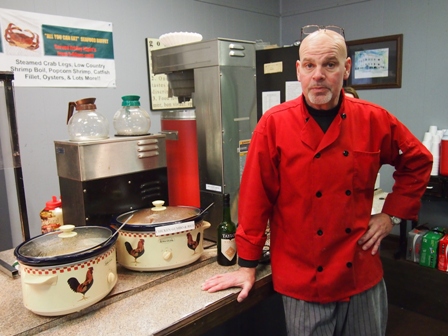 Chef Bob[/caption]
Chef Bob’s Cafe was a terrific find. Bob’s motto is ‘If ya leave hungry, it’s not my fault.’ He’s right. I’d go back there again just for his crab soup. (See www.bobssouthernsuppers.webs.com or Tel: +1 803 637 0008 located at 303 Main Street, Edgefield, SC 29824)
[caption id="attachment_2857" align="alignnone" width="448"]
Chef Bob[/caption]
Chef Bob’s Cafe was a terrific find. Bob’s motto is ‘If ya leave hungry, it’s not my fault.’ He’s right. I’d go back there again just for his crab soup. (See www.bobssouthernsuppers.webs.com or Tel: +1 803 637 0008 located at 303 Main Street, Edgefield, SC 29824)
[caption id="attachment_2857" align="alignnone" width="448"]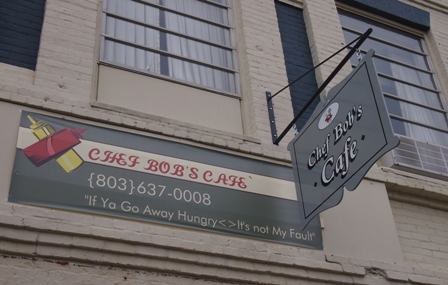 Chef Bob sign[/caption]
Around the corner from Chef Bob’s Cafe is Jane Bess Pottery (www.janebesspottery.com Tel: +1 803 637 2434 located at 206 Lynch Street, Edgefield, SC 29824) Bess found herself in rural South Carolina by a stroke of good fortune. Her kiln is attached to her small studio where she produces ceramics of wondrous expertise.
[caption id="attachment_2858" align="alignnone" width="352"]
Chef Bob sign[/caption]
Around the corner from Chef Bob’s Cafe is Jane Bess Pottery (www.janebesspottery.com Tel: +1 803 637 2434 located at 206 Lynch Street, Edgefield, SC 29824) Bess found herself in rural South Carolina by a stroke of good fortune. Her kiln is attached to her small studio where she produces ceramics of wondrous expertise.
[caption id="attachment_2858" align="alignnone" width="352"] Jane Bess pottery shop[/caption]
Chef Bob’s Cafe and Jane Bess Pottery are the sorts of treasures not found on an interstate highway.
[caption id="attachment_2859" align="alignnone" width="363"]
Jane Bess pottery shop[/caption]
Chef Bob’s Cafe and Jane Bess Pottery are the sorts of treasures not found on an interstate highway.
[caption id="attachment_2859" align="alignnone" width="363"]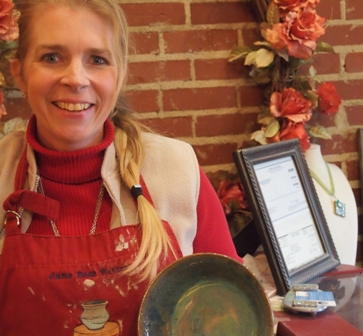 The lovely Jane Bess holding a bowl the writer bought[/caption]
Asheville, North Carolina has grown into one of America’s strongest counter-culture cities.
[caption id="attachment_2867" align="alignnone" width="448"]
The lovely Jane Bess holding a bowl the writer bought[/caption]
Asheville, North Carolina has grown into one of America’s strongest counter-culture cities.
[caption id="attachment_2867" align="alignnone" width="448"] Street art in Asheville[/caption]
With an active organic food ‘paddock to plate’ low carbon emissions ethos, its culinary scene is leading the way for many small rural cities across the USA.
[caption id="attachment_2862" align="alignnone" width="398"]
Street art in Asheville[/caption]
With an active organic food ‘paddock to plate’ low carbon emissions ethos, its culinary scene is leading the way for many small rural cities across the USA.
[caption id="attachment_2862" align="alignnone" width="398"] Asheville shops[/caption]
Architecture buffs will be well pleased to learn that Asheville boasts the country’s 2nd largest collection of Art-Deco buildings (Miami’s South Beach is 1st).
[caption id="attachment_2860" align="alignnone" width="432"]
Asheville shops[/caption]
Architecture buffs will be well pleased to learn that Asheville boasts the country’s 2nd largest collection of Art-Deco buildings (Miami’s South Beach is 1st).
[caption id="attachment_2860" align="alignnone" width="432"] Asheville Art-Deco[/caption]
With easy access to the Great Smoky Mountains National Park, Asheville is also where many keen outdoors specialists have found a home base.
[caption id="attachment_2861" align="alignnone" width="336"]
Asheville Art-Deco[/caption]
With easy access to the Great Smoky Mountains National Park, Asheville is also where many keen outdoors specialists have found a home base.
[caption id="attachment_2861" align="alignnone" width="336"] Asheville Art-Deco the Kress building[/caption]
The largest private residence in North America, Biltmore House, is also in Asheville. Funded by a Vanderbilt heir George Washington Vanderbilt 11 between 1880 and 1895, it was the last significant work designed by influential architect Richard Morris Hunt and famed landscape architect Frederick Law Olmsted. (See www.biltmore.com for tickets and more information) George Vanderbilt, unlike many of his family’s predecessors, was an intellectual and philanthropist, bent on building a monument to design while encouraging his enormous crew of construction workers to reside permanently in the hitherto backward region. He paid his employees well beyond the minimum wage and provided health care and free education.
[caption id="attachment_2863" align="alignnone" width="448"]
Asheville Art-Deco the Kress building[/caption]
The largest private residence in North America, Biltmore House, is also in Asheville. Funded by a Vanderbilt heir George Washington Vanderbilt 11 between 1880 and 1895, it was the last significant work designed by influential architect Richard Morris Hunt and famed landscape architect Frederick Law Olmsted. (See www.biltmore.com for tickets and more information) George Vanderbilt, unlike many of his family’s predecessors, was an intellectual and philanthropist, bent on building a monument to design while encouraging his enormous crew of construction workers to reside permanently in the hitherto backward region. He paid his employees well beyond the minimum wage and provided health care and free education.
[caption id="attachment_2863" align="alignnone" width="448"]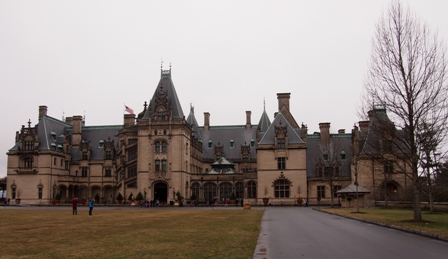 Biltmore House[/caption]
That may seem commonplace now but back then such acts of munificence were a rarity.
Is it a huge French chateau plonked down atop a mountain in the far west of North Carolina? Yes. It’s also where the bulk of the Vanderbilt fortune dwindled in a final display of ostentatious wealth. The house was inhabited by the family for less than twenty years.
[caption id="attachment_2864" align="alignnone" width="233"]
Biltmore House[/caption]
That may seem commonplace now but back then such acts of munificence were a rarity.
Is it a huge French chateau plonked down atop a mountain in the far west of North Carolina? Yes. It’s also where the bulk of the Vanderbilt fortune dwindled in a final display of ostentatious wealth. The house was inhabited by the family for less than twenty years.
[caption id="attachment_2864" align="alignnone" width="233"] Biltmore House overview[/caption]
Maintenance costs spiralled. When the great depression hit Appalachia hard in the early 1930s, even the Vanderbilt fortune could no longer support such a vast estate.
The Biltmore Estate is now run as a private enterprise.
Justifiably popular, tour tickets are available for purchase before visiting.
A completely different way to see Asheville is from a seat on the LaZoom tour bus. The gaily painted big purple bus is decked out with a DJ console and a narrow stage from which the guides perform a running commentary on Asheville’s past and present. Our two guides, the slattern and foul mouthed Erlene Hooch, (straight out of a local trailer park) and the hirsute nun Sister Hairy Mary, (a refugee from the order of the Sisters of Perpetual Indulgence), kept the laughs coming. The bus makes a pit stop at a pub, drinking is encouraged.
[caption id="attachment_2865" align="alignnone" width="448"]
Biltmore House overview[/caption]
Maintenance costs spiralled. When the great depression hit Appalachia hard in the early 1930s, even the Vanderbilt fortune could no longer support such a vast estate.
The Biltmore Estate is now run as a private enterprise.
Justifiably popular, tour tickets are available for purchase before visiting.
A completely different way to see Asheville is from a seat on the LaZoom tour bus. The gaily painted big purple bus is decked out with a DJ console and a narrow stage from which the guides perform a running commentary on Asheville’s past and present. Our two guides, the slattern and foul mouthed Erlene Hooch, (straight out of a local trailer park) and the hirsute nun Sister Hairy Mary, (a refugee from the order of the Sisters of Perpetual Indulgence), kept the laughs coming. The bus makes a pit stop at a pub, drinking is encouraged.
[caption id="attachment_2865" align="alignnone" width="448"]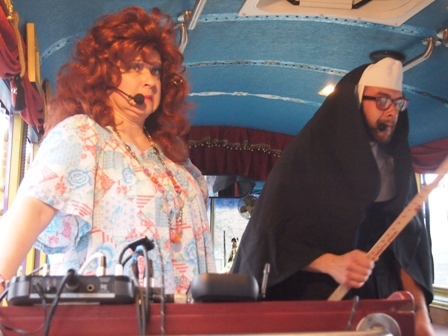 LaZoom's Erlene Hooch and Sister Hairy Mary[/caption]
If there’s a better way to explore Asheville while catching a running impression of what life is like in these parts, I’ve yet to discover the alternative. (See www.lazoomtours.com for bookings and more information.)
[caption id="attachment_2866" align="alignnone" width="448"]
LaZoom's Erlene Hooch and Sister Hairy Mary[/caption]
If there’s a better way to explore Asheville while catching a running impression of what life is like in these parts, I’ve yet to discover the alternative. (See www.lazoomtours.com for bookings and more information.)
[caption id="attachment_2866" align="alignnone" width="448"]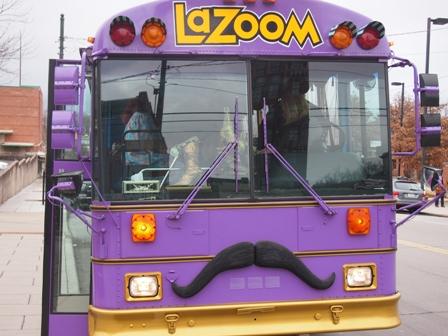 LaZoom bus[/caption]
An authentic American rural road, following one of the most scenic routes in the whole country is the Blue Ridge Parkway. It begins just outside Asheville and ends 469 miles northwards in Virginia.
[caption id="attachment_2870" align="alignnone" width="284"]
LaZoom bus[/caption]
An authentic American rural road, following one of the most scenic routes in the whole country is the Blue Ridge Parkway. It begins just outside Asheville and ends 469 miles northwards in Virginia.
[caption id="attachment_2870" align="alignnone" width="284"]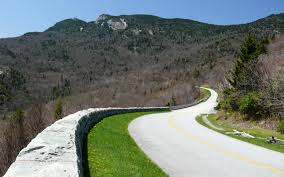 Blue Ridge Parkway scene[/caption]
For nearly its entire length the Parkway runs along the summits of the Blue Ridge Mountains overlooking the Shenandoah Valley amongst others. (See www.blueridgeparkway.org for up to date weather information, road conditions and fuel availability.)
[caption id="attachment_2868" align="alignnone" width="194"]
Blue Ridge Parkway scene[/caption]
For nearly its entire length the Parkway runs along the summits of the Blue Ridge Mountains overlooking the Shenandoah Valley amongst others. (See www.blueridgeparkway.org for up to date weather information, road conditions and fuel availability.)
[caption id="attachment_2868" align="alignnone" width="194"]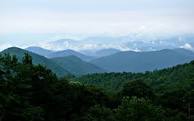 Blue Ridge Parkway near Asheville views[/caption]
We left the Parkway near tiny Wythville, Virginia for a spot of lunch. In Wythville’s single main street is Skeeter’s Hot Dogs, a 'world famous' cafe that’s been in business for over 60 years. I asked for the secret to the deliciousness of the hot dogs. ‘Steamed buns’ was the answer, that and true ingredients, not very healthy but a fun indulgence just the same. I ate three dogs with mustard, chilli and cheese and drank an orange juice. Cost? Less than USD$7.
[caption id="attachment_2871" align="alignnone" width="448"]
Blue Ridge Parkway near Asheville views[/caption]
We left the Parkway near tiny Wythville, Virginia for a spot of lunch. In Wythville’s single main street is Skeeter’s Hot Dogs, a 'world famous' cafe that’s been in business for over 60 years. I asked for the secret to the deliciousness of the hot dogs. ‘Steamed buns’ was the answer, that and true ingredients, not very healthy but a fun indulgence just the same. I ate three dogs with mustard, chilli and cheese and drank an orange juice. Cost? Less than USD$7.
[caption id="attachment_2871" align="alignnone" width="448"]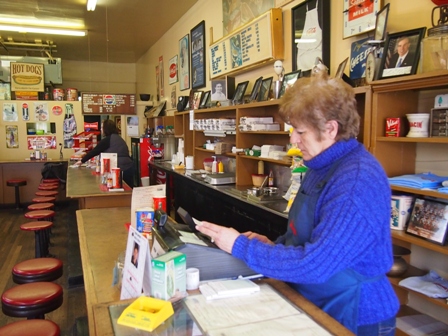 Manager/chef Wanda and Skeeter's Hot Dogs interior[/caption]
Upstairs from Skeeter’s Hot Dogs is the flat where Edith Bolling Wilson was born. She was First Lady to President Woodrow Wilson, the power behind the throne so to speak. When Wilson suffered a debilitating stroke, Edith stepped into the President’s shoes, hiding the true damaging extent of his illness while, for all intents and purposes, maintaining the office of the President until the next election. I never knew Edith Wilson was born in Wythville. Admittedly I’d never heard of Wythville either.
[caption id="attachment_2872" align="alignnone" width="391"]
Manager/chef Wanda and Skeeter's Hot Dogs interior[/caption]
Upstairs from Skeeter’s Hot Dogs is the flat where Edith Bolling Wilson was born. She was First Lady to President Woodrow Wilson, the power behind the throne so to speak. When Wilson suffered a debilitating stroke, Edith stepped into the President’s shoes, hiding the true damaging extent of his illness while, for all intents and purposes, maintaining the office of the President until the next election. I never knew Edith Wilson was born in Wythville. Admittedly I’d never heard of Wythville either.
[caption id="attachment_2872" align="alignnone" width="391"]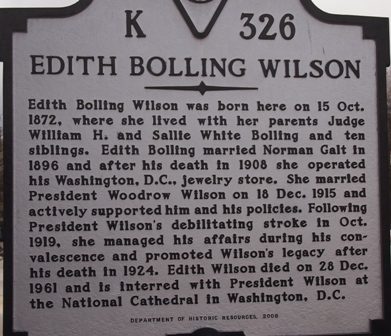 Edith Bolling Wilson sign marking her birthplace[/caption]
When you get off the Interstate Highways, surprising discoveries are made, Skeeter’s Hot Dogs and Edith Wilson history to wit.
Past Roanoke and on to Charlottesville, Virginia where the Thomas Jefferson designed University of Virginia dominates this small city’s economy.
[caption id="attachment_2873" align="alignnone" width="259"]
Edith Bolling Wilson sign marking her birthplace[/caption]
When you get off the Interstate Highways, surprising discoveries are made, Skeeter’s Hot Dogs and Edith Wilson history to wit.
Past Roanoke and on to Charlottesville, Virginia where the Thomas Jefferson designed University of Virginia dominates this small city’s economy.
[caption id="attachment_2873" align="alignnone" width="259"]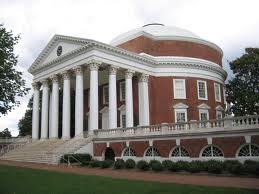 One of the University of Virginia buildings designed by Thomas Jefferson[/caption]
Near Charlottesville is Monticello, Thomas Jefferson’s home and final resting place.
As a finish to a back roads trip through rural America, Monticello is a fitting place to stop and wonder about how this great country has evolved in the 238 years since Jefferson wrote the Declaration of Independence.
[caption id="attachment_2874" align="alignnone" width="448"]
One of the University of Virginia buildings designed by Thomas Jefferson[/caption]
Near Charlottesville is Monticello, Thomas Jefferson’s home and final resting place.
As a finish to a back roads trip through rural America, Monticello is a fitting place to stop and wonder about how this great country has evolved in the 238 years since Jefferson wrote the Declaration of Independence.
[caption id="attachment_2874" align="alignnone" width="448"]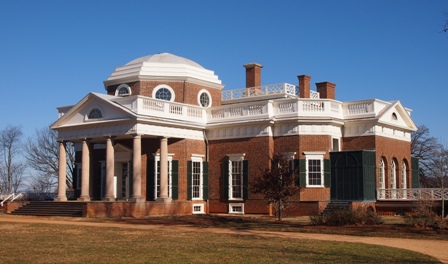 Monticello[/caption]
Jefferson played many roles during his illustrious life: a scientist, a botanist, a President, a statesman, an author, a legislator, and an architect. He was also a farmer. His estate at Monticello was a crowning glory of early American architectural achievement. There is no better place to gain an increased understanding of this remarkable man’s life and legacy.
[caption id="attachment_2875" align="alignnone" width="448"]
Monticello[/caption]
Jefferson played many roles during his illustrious life: a scientist, a botanist, a President, a statesman, an author, a legislator, and an architect. He was also a farmer. His estate at Monticello was a crowning glory of early American architectural achievement. There is no better place to gain an increased understanding of this remarkable man’s life and legacy.
[caption id="attachment_2875" align="alignnone" width="448"] Thomas Jefferson's grave at Monticello[/caption]
The house is open to the public nearly each day of the year. Tours during summer’s high season are booked out days in advance. (See www.monticello.org for more information and tour bookings.)
Naked Facts:
Naked Routes:
I flew Virgin Airlines/Delta Airlines to New York City from Melbourne direct to LA with a four hour transit at LA’s shockingly bad airport. The transit involved visits to three separate terminals, a needless waste of time and energy. Catering options in all three terminals are abysmally depressing, same old chain outlets selling overpriced crap to a captive audience.
The Virgin flight across the Pacific from Australia to the USA was bumpy, very bumpy. Service was interrupted throughout most of the flight in respect of safety for both crew and passengers. I’ve experienced bouts of extended turbulence on previous long haul flights but nothing like this particular flight. The pilot did his best to inform passengers of ongoing attempts to avert, avoid and minimise the turbulence but the weather got the best of us. The turbulence lasted over six hours. I’ve never seen so many full vomit bags carried by harried crew members back to the galley for disposal.
Stuck in the stinky worst seats in the back of the bus, the torture that is an east bound economy class flight between Australia and the USA is only exceeded by a westbound flight from the USA to Australia because it takes almost an hour longer.
Virgin’s IFE is good with enough new release blockbusters to divert attention from the shocking reality of economy flying in the 21st century.
Virgin’s meals in economy are execrable. Drinks service was rudimentary, one tiny bottle of wine was offered, no refills and my impression from harassed crew members was that I had better not ask for another bottle.
I tried to change my return flight home, same route via Brisbane to Melbourne, well after peak holiday season (I flew to the USA just before Christmas and paid over AUD$2,400). After wasting four hours on numerous phone calls with various Virgin customer service representatives, the best deal I was offered to change my flight date was an extra USD$1,000 (USD$200 international flight change fee plus an extra USD$800 for Virgin’s loss on my previous booking). I understand that airlines aren’t charities but this kind of price gouging infuriated me. I was opting to fly at a post-peak time where many extra seats were empty on flights from LAX to Australia. I wasn’t asking for anything other than a date change. For the total price I was asked to pay I could have bought a business class fare to the USA from another airline via an Asian connection. With Virgin I was still stuck in the worst seat in the back of the bus next to the busy galley and toilets, last in the queue for meals and drinks service and being treated like a bum from a Greyhound bus camp. All this for nearly AUD$4,000? What joy!
The domestic flights between LAX and NYC’s JFK with Delta were better than anticipated. Now that Delta has installed free IFE in almost all its cabins (offering a far more diverse movie selection than Virgin’s long-haul flights) the final leg between LAX and JFK is tolerable. There is no catering on Delta unless you’re in business or first class but then all American airlines have dispensed with something novel as free meals on long flights so no surprises there. Delta’s menu options are standard American fare, sandwiches and snacks from multi-national corporations chosen (bribed?) by Delta’s catering specialists that consider a meal comprising a turkey and cranberry sauce sandwich on white bread with crisps and a cookie to be ‘healthy fare’. This is all yours for only USD$8.95, served in a box, wrapped in plastic, tasting like plastic. Drinks are extra of course.
Due to miscommunications between Virgin Airlines staff in Australia and Delta Airlines staff in the USA, our connecting flight between LAX and JFK was overbooked so my partner and I were seated at opposite ends of the cabin. The same happened on the flight between JFK and LAX; we were separated despite having booked our tickets simultaneously and stating we were travelling together. We complained but ground crew expressed an inability to rectify the situation.
Returning from LAX to Melbourne via Brisbane, we along with over 100 other transit passengers, were required to queue at the Virgin Airlines transit desk to re-check our baggage and confirm or acquire a seat assignment for our domestic connections. Two Virgin ground crew members operated the transit desk. We waited in the queue for over an hour, shuffling along like sheep ready to be dipped, mewling ineffectively, exhausted, crumpled and grumpy as one always is after more than 14 hours in cramped conditions without sleep or adequate food or comfort.
Why Virgin hasn’t implemented something as practical as a ‘Bag Drop’ station for speedy disposal of baggage and an electronic checking of boarding passes is beyond me. Given the number of loud and angry complaints I heard while in the interminable queue at Brisbane’s inefficient airport (I was informed by a Virgin supervisor that the airline is waiting for more space to be allocated by the airport authority in order to expedite transit passengers in a more efficient and less onerous manner), I was not surprised to overhear murmurs from the shuffling crowd: ‘Never again!’, ‘This is shit!’, Why don’t they have more staff on?’ etc.
See www.virginaustralia.com or www.delta.com for your own special view into man’s inhumanity to man from the back of the air tube.
Naked Sleeps:
Asheville’s Albemarle Inn is a gracious and well appointed boutique guesthouse owned and run by two devoted hoteliers, Fabrizio and Rosemary Chiariello. Three course breakfasts are cooked to order with great attention to detail and flair. Espresso coffee is also available, unusual in this part of the world. Rosemary arranged tickets to Biltmore Estate and LaZoom Tours, saving us a lot of time and trouble. She made dinner reservations at two of Asheville’s best restaurants as well. Having such a resourceful concierge at hand made us feel we were staying in a big city 5-star hotel, but with true country hospitality as a bonus. See www.albemarleinn.com
[caption id="attachment_2876" align="alignnone" width="448"]
Thomas Jefferson's grave at Monticello[/caption]
The house is open to the public nearly each day of the year. Tours during summer’s high season are booked out days in advance. (See www.monticello.org for more information and tour bookings.)
Naked Facts:
Naked Routes:
I flew Virgin Airlines/Delta Airlines to New York City from Melbourne direct to LA with a four hour transit at LA’s shockingly bad airport. The transit involved visits to three separate terminals, a needless waste of time and energy. Catering options in all three terminals are abysmally depressing, same old chain outlets selling overpriced crap to a captive audience.
The Virgin flight across the Pacific from Australia to the USA was bumpy, very bumpy. Service was interrupted throughout most of the flight in respect of safety for both crew and passengers. I’ve experienced bouts of extended turbulence on previous long haul flights but nothing like this particular flight. The pilot did his best to inform passengers of ongoing attempts to avert, avoid and minimise the turbulence but the weather got the best of us. The turbulence lasted over six hours. I’ve never seen so many full vomit bags carried by harried crew members back to the galley for disposal.
Stuck in the stinky worst seats in the back of the bus, the torture that is an east bound economy class flight between Australia and the USA is only exceeded by a westbound flight from the USA to Australia because it takes almost an hour longer.
Virgin’s IFE is good with enough new release blockbusters to divert attention from the shocking reality of economy flying in the 21st century.
Virgin’s meals in economy are execrable. Drinks service was rudimentary, one tiny bottle of wine was offered, no refills and my impression from harassed crew members was that I had better not ask for another bottle.
I tried to change my return flight home, same route via Brisbane to Melbourne, well after peak holiday season (I flew to the USA just before Christmas and paid over AUD$2,400). After wasting four hours on numerous phone calls with various Virgin customer service representatives, the best deal I was offered to change my flight date was an extra USD$1,000 (USD$200 international flight change fee plus an extra USD$800 for Virgin’s loss on my previous booking). I understand that airlines aren’t charities but this kind of price gouging infuriated me. I was opting to fly at a post-peak time where many extra seats were empty on flights from LAX to Australia. I wasn’t asking for anything other than a date change. For the total price I was asked to pay I could have bought a business class fare to the USA from another airline via an Asian connection. With Virgin I was still stuck in the worst seat in the back of the bus next to the busy galley and toilets, last in the queue for meals and drinks service and being treated like a bum from a Greyhound bus camp. All this for nearly AUD$4,000? What joy!
The domestic flights between LAX and NYC’s JFK with Delta were better than anticipated. Now that Delta has installed free IFE in almost all its cabins (offering a far more diverse movie selection than Virgin’s long-haul flights) the final leg between LAX and JFK is tolerable. There is no catering on Delta unless you’re in business or first class but then all American airlines have dispensed with something novel as free meals on long flights so no surprises there. Delta’s menu options are standard American fare, sandwiches and snacks from multi-national corporations chosen (bribed?) by Delta’s catering specialists that consider a meal comprising a turkey and cranberry sauce sandwich on white bread with crisps and a cookie to be ‘healthy fare’. This is all yours for only USD$8.95, served in a box, wrapped in plastic, tasting like plastic. Drinks are extra of course.
Due to miscommunications between Virgin Airlines staff in Australia and Delta Airlines staff in the USA, our connecting flight between LAX and JFK was overbooked so my partner and I were seated at opposite ends of the cabin. The same happened on the flight between JFK and LAX; we were separated despite having booked our tickets simultaneously and stating we were travelling together. We complained but ground crew expressed an inability to rectify the situation.
Returning from LAX to Melbourne via Brisbane, we along with over 100 other transit passengers, were required to queue at the Virgin Airlines transit desk to re-check our baggage and confirm or acquire a seat assignment for our domestic connections. Two Virgin ground crew members operated the transit desk. We waited in the queue for over an hour, shuffling along like sheep ready to be dipped, mewling ineffectively, exhausted, crumpled and grumpy as one always is after more than 14 hours in cramped conditions without sleep or adequate food or comfort.
Why Virgin hasn’t implemented something as practical as a ‘Bag Drop’ station for speedy disposal of baggage and an electronic checking of boarding passes is beyond me. Given the number of loud and angry complaints I heard while in the interminable queue at Brisbane’s inefficient airport (I was informed by a Virgin supervisor that the airline is waiting for more space to be allocated by the airport authority in order to expedite transit passengers in a more efficient and less onerous manner), I was not surprised to overhear murmurs from the shuffling crowd: ‘Never again!’, ‘This is shit!’, Why don’t they have more staff on?’ etc.
See www.virginaustralia.com or www.delta.com for your own special view into man’s inhumanity to man from the back of the air tube.
Naked Sleeps:
Asheville’s Albemarle Inn is a gracious and well appointed boutique guesthouse owned and run by two devoted hoteliers, Fabrizio and Rosemary Chiariello. Three course breakfasts are cooked to order with great attention to detail and flair. Espresso coffee is also available, unusual in this part of the world. Rosemary arranged tickets to Biltmore Estate and LaZoom Tours, saving us a lot of time and trouble. She made dinner reservations at two of Asheville’s best restaurants as well. Having such a resourceful concierge at hand made us feel we were staying in a big city 5-star hotel, but with true country hospitality as a bonus. See www.albemarleinn.com
[caption id="attachment_2876" align="alignnone" width="448"] Albemarle Inn in Asheville[/caption]
About twenty kilometres from Charlottesville is the lovely historic property The Prospect Hill Plantation Inn. Owned and operated by Doc and Paula Findley, this is a family run business. The Findley's children were in residence during our brief stay, polite, well-behaved and friendly. The Plantation Inn is a rural residence, the oldest continually working frame-house plantation in Virginia. The principle manor house (circa 1699 with additions until 1850) is surrounded by extensive gardens and grazing paddocks. The long drive from the road to the main house itself is reminiscent of a scene from ‘Gone with the Wind’, atmospheric and quite grand. Like the Albemarle Inn, The Prospect Hill Plantation Inn takes great pride in its superlative catering. A popular restaurant operates weekends while in house guests are treated to excellent three course breakfasts. See www.prospecthill.com
[caption id="attachment_2877" align="alignnone" width="242"]
Albemarle Inn in Asheville[/caption]
About twenty kilometres from Charlottesville is the lovely historic property The Prospect Hill Plantation Inn. Owned and operated by Doc and Paula Findley, this is a family run business. The Findley's children were in residence during our brief stay, polite, well-behaved and friendly. The Plantation Inn is a rural residence, the oldest continually working frame-house plantation in Virginia. The principle manor house (circa 1699 with additions until 1850) is surrounded by extensive gardens and grazing paddocks. The long drive from the road to the main house itself is reminiscent of a scene from ‘Gone with the Wind’, atmospheric and quite grand. Like the Albemarle Inn, The Prospect Hill Plantation Inn takes great pride in its superlative catering. A popular restaurant operates weekends while in house guests are treated to excellent three course breakfasts. See www.prospecthill.com
[caption id="attachment_2877" align="alignnone" width="242"] Plantation House Inn near Charlottesville, Virginia[/caption]
Naked Eats:
In Asheville, try Cucina 24, a smart Italian influenced bistro right in the middle of town. House made pasta combined with terrific produce and excellent service make this an impressively sophisticated place in which to dine. See www.cucina24restaurant.com
Table Asheville is another cut above the rest of the dining pack. Like Cucina 24, quality produce is the key and it’s also conveniently located near the centre of town. Asheville’s chef brigade are rightly proud of surrounding organic farms and the marvellous ingredients they supply to the town’s most talented cooks. Table Asheville is modern-American style dining, with southern American flavours and a bit of French, a bit of Italian or Southeast Asian or Chinese or Latin American according to chef’s whim and what’s available from the local farms. The customer is the real winner here with such kitchen imagination serving up excellent food. See www.tableasheville.com
In Charlottesville, we dined really well on simply prepared and delicious food at Maya where everything is ‘made from scratch’. Maya has a Mexican slant to it but the food style tends towards traditional Southern USA wholesomeness. This is very much a local’s favourite hang-out. The bar is hopping every night and it’s an exceptionally friendly place. See www.maya-restaurant.com
Naked Reads:
‘Blue Highways’ by William Least Heat-Moon is a book I cherished long after reading it. Least Heat-Moon’s writing seeps into the soul while he travels the back roads in a search for America’s essence.
‘Old Glory’ by Jonathan Raban is a glorious book about southern American travels witnessed by a keen observer who delves into history, culture and politics as seen from a rural perspective.
Plantation House Inn near Charlottesville, Virginia[/caption]
Naked Eats:
In Asheville, try Cucina 24, a smart Italian influenced bistro right in the middle of town. House made pasta combined with terrific produce and excellent service make this an impressively sophisticated place in which to dine. See www.cucina24restaurant.com
Table Asheville is another cut above the rest of the dining pack. Like Cucina 24, quality produce is the key and it’s also conveniently located near the centre of town. Asheville’s chef brigade are rightly proud of surrounding organic farms and the marvellous ingredients they supply to the town’s most talented cooks. Table Asheville is modern-American style dining, with southern American flavours and a bit of French, a bit of Italian or Southeast Asian or Chinese or Latin American according to chef’s whim and what’s available from the local farms. The customer is the real winner here with such kitchen imagination serving up excellent food. See www.tableasheville.com
In Charlottesville, we dined really well on simply prepared and delicious food at Maya where everything is ‘made from scratch’. Maya has a Mexican slant to it but the food style tends towards traditional Southern USA wholesomeness. This is very much a local’s favourite hang-out. The bar is hopping every night and it’s an exceptionally friendly place. See www.maya-restaurant.com
Naked Reads:
‘Blue Highways’ by William Least Heat-Moon is a book I cherished long after reading it. Least Heat-Moon’s writing seeps into the soul while he travels the back roads in a search for America’s essence.
‘Old Glory’ by Jonathan Raban is a glorious book about southern American travels witnessed by a keen observer who delves into history, culture and politics as seen from a rural perspective.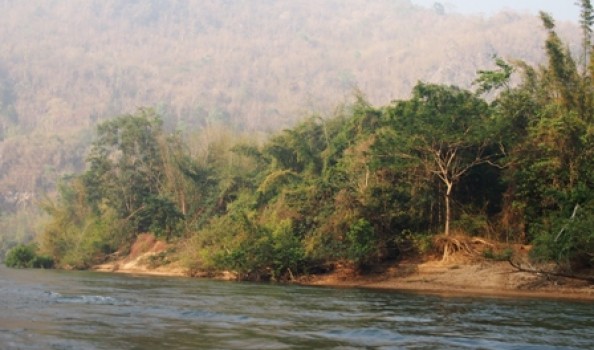 https://nakedhungrytraveller.com.au/many-bridges-kwai/ Many Bridges On This KwaiFlowing through Thailand’s Kanchanaburi Province, the river Kwai has seen its fair share of history. Nearly 70 years ago in October 1943, the infamous ‘Death Railway’ between Thailand and Myanmar reached completion. 415 kilometres of track, marked by terrible human toil and suffering through mountainous terrain, was laid in approximately sixteen months. [caption id="attachment_2766" align="alignnone" width="448"]
https://nakedhungrytraveller.com.au/many-bridges-kwai/ Many Bridges On This KwaiFlowing through Thailand’s Kanchanaburi Province, the river Kwai has seen its fair share of history. Nearly 70 years ago in October 1943, the infamous ‘Death Railway’ between Thailand and Myanmar reached completion. 415 kilometres of track, marked by terrible human toil and suffering through mountainous terrain, was laid in approximately sixteen months. [caption id="attachment_2766" align="alignnone" width="448"]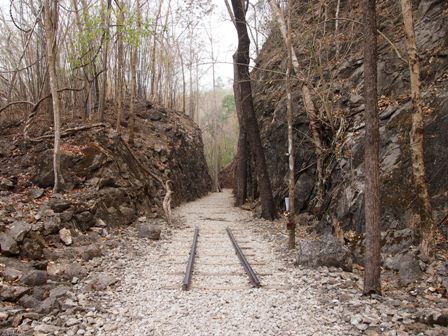 Hellfire Pass on the 'Death Railway', the Thai-Burma Railway[/caption]
Over 100,000 people were killed during its construction, the majority forced labourers from South, East and Southeast Asia. Most died from disease and starvation. Thousands of Australian, British, Dutch/Javanese and American POWs were tortured to death by Japanese soldiers and their paid Korean guards.
During a war of almost indescribable cruelty inflicted on innocent victims, this catastrophic episode ranks as amongst the worst for sheer waste of lives.
[caption id="attachment_2767" align="alignnone" width="376"]
Hellfire Pass on the 'Death Railway', the Thai-Burma Railway[/caption]
Over 100,000 people were killed during its construction, the majority forced labourers from South, East and Southeast Asia. Most died from disease and starvation. Thousands of Australian, British, Dutch/Javanese and American POWs were tortured to death by Japanese soldiers and their paid Korean guards.
During a war of almost indescribable cruelty inflicted on innocent victims, this catastrophic episode ranks as amongst the worst for sheer waste of lives.
[caption id="attachment_2767" align="alignnone" width="376"]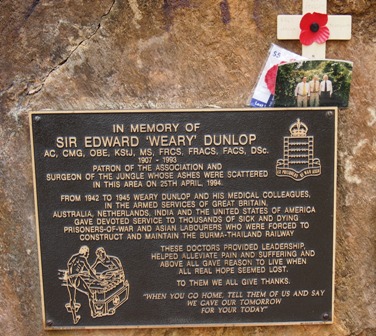 'Weary' Dunlop plaque at Hellfire Pass, one of many heroes[/caption]
The Japanese needed a railroad to haul war-making supplies from Ban Pong, Siam (Thailand) to Thanbyuzayat, Burma (Myanmar). They were willing to sacrifice just about anyone to get it built, rushing its construction beyond reason. Shortcuts were taken at every turn. For instance, 688 bridges were built but only 8 were made of steel and concrete. Given the tropical climate and propensity for wood to rot quickly was this planned obsolescence or simply crazed expediency?
POWs did everything they could to sabotage the work, using termite infested or flimsy wood, inserting wooden bolts instead of steel and using sand instead of concrete for foundations. If caught, their crimes resulted in immediate torture and execution.
[caption id="attachment_2771" align="alignnone" width="448"]
'Weary' Dunlop plaque at Hellfire Pass, one of many heroes[/caption]
The Japanese needed a railroad to haul war-making supplies from Ban Pong, Siam (Thailand) to Thanbyuzayat, Burma (Myanmar). They were willing to sacrifice just about anyone to get it built, rushing its construction beyond reason. Shortcuts were taken at every turn. For instance, 688 bridges were built but only 8 were made of steel and concrete. Given the tropical climate and propensity for wood to rot quickly was this planned obsolescence or simply crazed expediency?
POWs did everything they could to sabotage the work, using termite infested or flimsy wood, inserting wooden bolts instead of steel and using sand instead of concrete for foundations. If caught, their crimes resulted in immediate torture and execution.
[caption id="attachment_2771" align="alignnone" width="448"]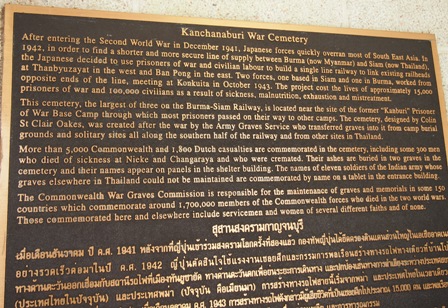 Kanchanaburi War Cemetery sign[/caption]
Though travellers to this region will see an emerging refocus from World War 2 remembrance to eco-tourism, anyone visiting Kanchanaburi town will undoubtedly be reminded of how vital the railroad’s demise was to the end of Japanese plans for imperialism in Southeast Asia.
[caption id="attachment_2768" align="alignnone" width="448"]
Kanchanaburi War Cemetery sign[/caption]
Though travellers to this region will see an emerging refocus from World War 2 remembrance to eco-tourism, anyone visiting Kanchanaburi town will undoubtedly be reminded of how vital the railroad’s demise was to the end of Japanese plans for imperialism in Southeast Asia.
[caption id="attachment_2768" align="alignnone" width="448"]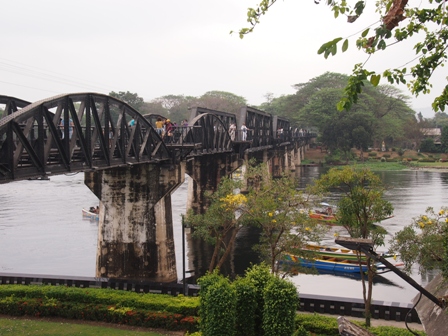 Current bridge over river Kwai at Kanchanaburi[/caption]
Day trippers from Bangkok tend to focus on the reconstructed bridge on the river Kwai at Kanchanaburi (the original Japanese bridge was successfully bombed and destroyed), the War Cemetery and nearby private JEATH museum. The acronym JEATH represents Japan as the controllers of the railway project and the five countries: England, America and Australia, Thailand and Holland involved in its construction. The simple displays commemorate lives lost, depicting a realistic POW hut while retelling personal stories behind the dreaded railroad. The museum is managed by the Wat Chaichumpol temple and was founded in 1977 by the chief abbot Venerable Phra Theppanyasuthee.
[caption id="attachment_2770" align="alignnone" width="448"]
Current bridge over river Kwai at Kanchanaburi[/caption]
Day trippers from Bangkok tend to focus on the reconstructed bridge on the river Kwai at Kanchanaburi (the original Japanese bridge was successfully bombed and destroyed), the War Cemetery and nearby private JEATH museum. The acronym JEATH represents Japan as the controllers of the railway project and the five countries: England, America and Australia, Thailand and Holland involved in its construction. The simple displays commemorate lives lost, depicting a realistic POW hut while retelling personal stories behind the dreaded railroad. The museum is managed by the Wat Chaichumpol temple and was founded in 1977 by the chief abbot Venerable Phra Theppanyasuthee.
[caption id="attachment_2770" align="alignnone" width="448"]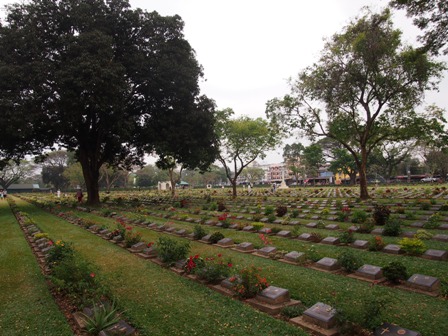 Kanchanaburi War Cemetery[/caption]
The drive from Bangkok can take up to four hours each way making for a very long day trip from the capital. I don’t recommend this option. It’s far better to allow at least a few days exploring the region.
[caption id="attachment_2772" align="alignnone" width="448"]
Kanchanaburi War Cemetery[/caption]
The drive from Bangkok can take up to four hours each way making for a very long day trip from the capital. I don’t recommend this option. It’s far better to allow at least a few days exploring the region.
[caption id="attachment_2772" align="alignnone" width="448"]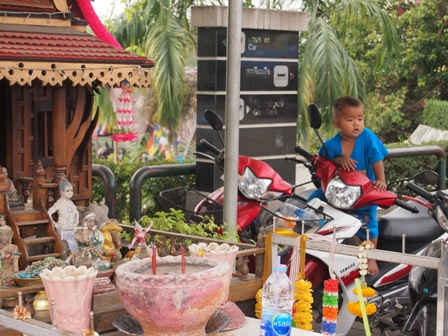 Kanchanaburi bridge shops and child[/caption]
A popular side trip is a ride on the old railway between Kanchanaburi and Wang Po. The trip takes approximately two hours travelling through flat fields of tapioca trees and rice paddies before arriving to Wang Po and its picturesque position on a ridge above the river.
[caption id="attachment_2774" align="alignnone" width="448"]
Kanchanaburi bridge shops and child[/caption]
A popular side trip is a ride on the old railway between Kanchanaburi and Wang Po. The trip takes approximately two hours travelling through flat fields of tapioca trees and rice paddies before arriving to Wang Po and its picturesque position on a ridge above the river.
[caption id="attachment_2774" align="alignnone" width="448"]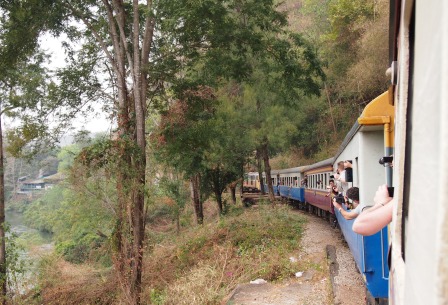 Train arriving at Wang Po[/caption]
A POW built cutting in the mountainside and trestle over the river remain as contrary testament to masterful engineering and obvious hardship endured by slave labourers.
[caption id="attachment_2773" align="alignnone" width="448"]
Train arriving at Wang Po[/caption]
A POW built cutting in the mountainside and trestle over the river remain as contrary testament to masterful engineering and obvious hardship endured by slave labourers.
[caption id="attachment_2773" align="alignnone" width="448"] Kanchanaburi bridge over river Kwai and visitors[/caption]
This is as far as the railway extends these days. The short-lived Thai-Burma Railroad was obliterated before the end of World War 2 and has not been rebuilt.
[caption id="attachment_2775" align="alignnone" width="448"]
Kanchanaburi bridge over river Kwai and visitors[/caption]
This is as far as the railway extends these days. The short-lived Thai-Burma Railroad was obliterated before the end of World War 2 and has not been rebuilt.
[caption id="attachment_2775" align="alignnone" width="448"]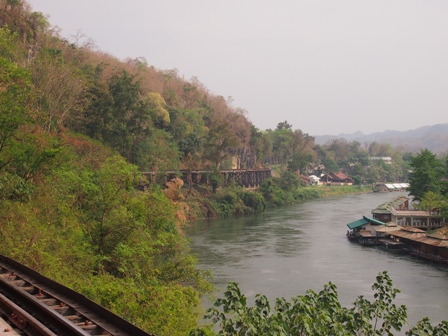 Trestle and cutting at Wang Po[/caption]
Approximately two hours drive further northwest of Kanchanaburi town is the Hellfire Pass Park. Here the Thai government has set aside a large swathe of forested land encompassing the old rail bed. The visitor’s centre and museum is well designed, guiding visitors from the earliest inception of the Thai-Burma Railway and its brief but horrendous existence under Japanese control to its ignominious conclusion.
A walk through Hellfire Pass is humbling. Most visitors stop at the end of the Hellfire Pass cutting and return to the centre, just under a two kilometres walk.
[caption id="attachment_2776" align="alignnone" width="448"]
Trestle and cutting at Wang Po[/caption]
Approximately two hours drive further northwest of Kanchanaburi town is the Hellfire Pass Park. Here the Thai government has set aside a large swathe of forested land encompassing the old rail bed. The visitor’s centre and museum is well designed, guiding visitors from the earliest inception of the Thai-Burma Railway and its brief but horrendous existence under Japanese control to its ignominious conclusion.
A walk through Hellfire Pass is humbling. Most visitors stop at the end of the Hellfire Pass cutting and return to the centre, just under a two kilometres walk.
[caption id="attachment_2776" align="alignnone" width="448"]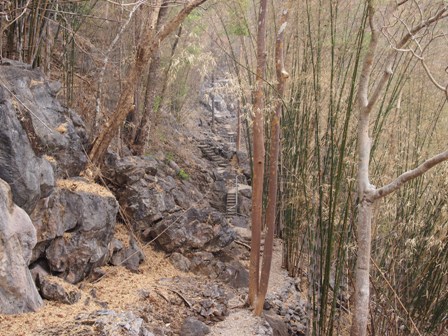 Track from Hellfire Pass[/caption]
Much more compelling is this option. Walk to the end of the track, approximately five kilometres. See what building this track of tears was really like for the slave labourers who lived in decrepit huts far down in the valley near the river. They walked up the mountain each day, worked twelve hour shifts in appalling conditions, subsisting on rice gruel while hauling stones up and down near vertical slopes. After a killing day’s work enduring unspeakable cruelty from their captors, they retraced their steps back down the steep mountainsides in the dark.
[caption id="attachment_2778" align="alignnone" width="448"]
Track from Hellfire Pass[/caption]
Much more compelling is this option. Walk to the end of the track, approximately five kilometres. See what building this track of tears was really like for the slave labourers who lived in decrepit huts far down in the valley near the river. They walked up the mountain each day, worked twelve hour shifts in appalling conditions, subsisting on rice gruel while hauling stones up and down near vertical slopes. After a killing day’s work enduring unspeakable cruelty from their captors, they retraced their steps back down the steep mountainsides in the dark.
[caption id="attachment_2778" align="alignnone" width="448"]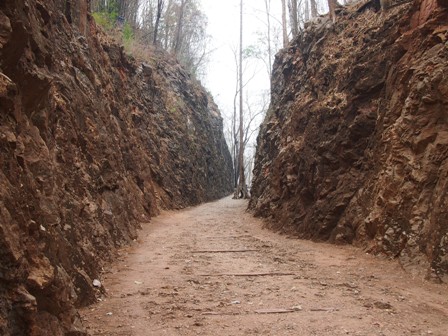 Konyu cutting at Hellfire Pass[/caption]
Over 100,000 workers and over 16,000 POWs died. Seeing the railroad from this perspective won’t ever let you forget that fact.
The hike is worthwhile. Remember to arrange transport from the end of the track or be prepared to return the same way, some ten kilometres and not recommended without water and food. The hottest time of year, April until July would be intolerably sultry. During monsoon, August until November, the track may be closed because of flooding.
Exploring the region at a more leisurely pace, preferably staying in one of the delightfully isolated river raft camps up the Kwai near the Myanmar border, only ten kilometres away as the crow flies, allows enough time in which to combine a visit to the Hellfire Pass Park and the entirely different experience of rural river life.
[caption id="attachment_2777" align="alignnone" width="448"]
Konyu cutting at Hellfire Pass[/caption]
Over 100,000 workers and over 16,000 POWs died. Seeing the railroad from this perspective won’t ever let you forget that fact.
The hike is worthwhile. Remember to arrange transport from the end of the track or be prepared to return the same way, some ten kilometres and not recommended without water and food. The hottest time of year, April until July would be intolerably sultry. During monsoon, August until November, the track may be closed because of flooding.
Exploring the region at a more leisurely pace, preferably staying in one of the delightfully isolated river raft camps up the Kwai near the Myanmar border, only ten kilometres away as the crow flies, allows enough time in which to combine a visit to the Hellfire Pass Park and the entirely different experience of rural river life.
[caption id="attachment_2777" align="alignnone" width="448"]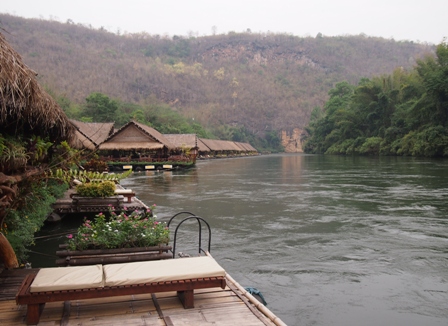 River Kwai Jungle Raft Camp[/caption]
Tourism on the river Kwai these days is shifting towards eco-experience.
The ethnically unique Mon people, whose language is completely different from Thai, dominate the ethnic mix of people living closest to the border. Having settled in Thailand from Myanmar to find more secure livelihoods, their lives have mostly improved economically.
[caption id="attachment_2779" align="alignnone" width="315"]
River Kwai Jungle Raft Camp[/caption]
Tourism on the river Kwai these days is shifting towards eco-experience.
The ethnically unique Mon people, whose language is completely different from Thai, dominate the ethnic mix of people living closest to the border. Having settled in Thailand from Myanmar to find more secure livelihoods, their lives have mostly improved economically.
[caption id="attachment_2779" align="alignnone" width="315"]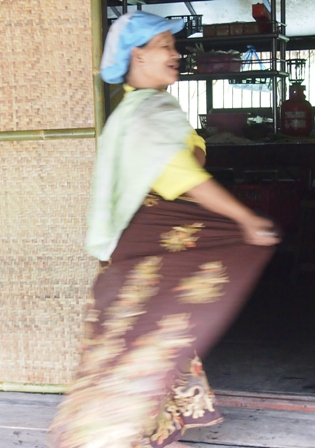 Mon villager cook at River Kwai Jungle Raft camp[/caption]
The River Kwai Jungle Raft camp is essentially a series of floating rafts moored permanently near a forested riverbank. Private rooms are affixed to separate sections of the rafts. Connected by shifting bridges, each raft is wide enough for shared verandas just outside the front door and small private verandas outside the back door. Rooms are self-contained with a small bathroom featuring a... shall we say, refreshing cold shower. There is no electricity. You get one kerosene lamp and a tiny torch attached to the room key.
[caption id="attachment_2780" align="alignnone" width="448"]
Mon villager cook at River Kwai Jungle Raft camp[/caption]
The River Kwai Jungle Raft camp is essentially a series of floating rafts moored permanently near a forested riverbank. Private rooms are affixed to separate sections of the rafts. Connected by shifting bridges, each raft is wide enough for shared verandas just outside the front door and small private verandas outside the back door. Rooms are self-contained with a small bathroom featuring a... shall we say, refreshing cold shower. There is no electricity. You get one kerosene lamp and a tiny torch attached to the room key.
[caption id="attachment_2780" align="alignnone" width="448"]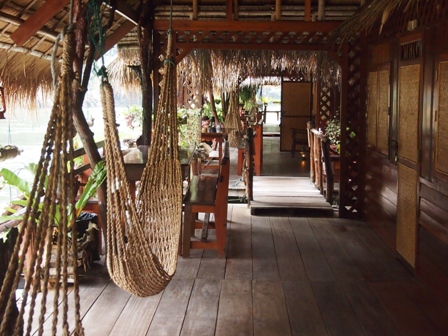 River Kwai Jungle Raft camp rooms and verandas[/caption]
Surprisingly, no rooms have been burnt to the water line, or so I hear. Fire extinguishers are thoughtfully provided nonetheless.
Invitingly looping hammocks feature throughout the public areas along with copious numbers of flower pots, chaise longues and shady verandas.
[caption id="attachment_2781" align="alignnone" width="448"]
River Kwai Jungle Raft camp rooms and verandas[/caption]
Surprisingly, no rooms have been burnt to the water line, or so I hear. Fire extinguishers are thoughtfully provided nonetheless.
Invitingly looping hammocks feature throughout the public areas along with copious numbers of flower pots, chaise longues and shady verandas.
[caption id="attachment_2781" align="alignnone" width="448"]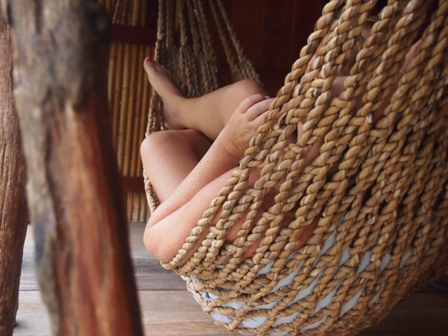 River Kwai Jungle Raft camp hammock in use[/caption]
A larger central raft serves as the lobby and reception. Attached is a bar with a combined undercover and open air dining area. Another undercover annex serves as a kind of communal massage area. Massages are inexpensive and enthusiastically executed albeit in very plain view.
The whole kit and caboodle is undeniably alluring. The lack of electricity (no bedside reading lamp, late night showering made more challenging without hot water, stumbling around in the dark on rocking planks tied together, you get the picture) may put off guests used to basic necessities but if you’re willing to ‘rough’ it, the camp delivers an altogether magical experience.
[caption id="attachment_2782" align="alignnone" width="448"]
River Kwai Jungle Raft camp hammock in use[/caption]
A larger central raft serves as the lobby and reception. Attached is a bar with a combined undercover and open air dining area. Another undercover annex serves as a kind of communal massage area. Massages are inexpensive and enthusiastically executed albeit in very plain view.
The whole kit and caboodle is undeniably alluring. The lack of electricity (no bedside reading lamp, late night showering made more challenging without hot water, stumbling around in the dark on rocking planks tied together, you get the picture) may put off guests used to basic necessities but if you’re willing to ‘rough’ it, the camp delivers an altogether magical experience.
[caption id="attachment_2782" align="alignnone" width="448"]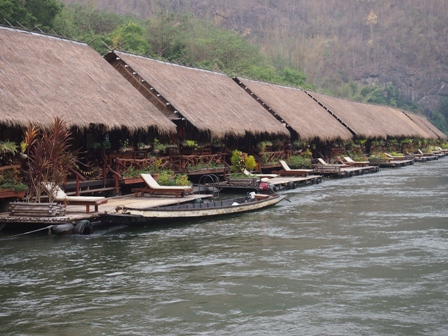 River Kwai Jungle Camp rooms[/caption]
My first night was almost sleepless. I couldn’t get used to the noise of water constantly rushing just beneath me, banging together the collection of wooden rafts sounding like a bamboo xylophone played loudly by a tone deaf sadist.
By the second night, I’d grown accustomed to unusual nocturnal perturbations and slept like a floating log.
Dawn on the river is beautiful. Mon people who work at the camp and live in the adjoining village maintain elephants as company and a source of added income for tourists coming along for the paid ride. Each morning I was fully awakened by the familiar hoots and trumpeting of elephants as they came to bathe outside my back door.
[caption id="attachment_2783" align="alignnone" width="448"]
River Kwai Jungle Camp rooms[/caption]
My first night was almost sleepless. I couldn’t get used to the noise of water constantly rushing just beneath me, banging together the collection of wooden rafts sounding like a bamboo xylophone played loudly by a tone deaf sadist.
By the second night, I’d grown accustomed to unusual nocturnal perturbations and slept like a floating log.
Dawn on the river is beautiful. Mon people who work at the camp and live in the adjoining village maintain elephants as company and a source of added income for tourists coming along for the paid ride. Each morning I was fully awakened by the familiar hoots and trumpeting of elephants as they came to bathe outside my back door.
[caption id="attachment_2783" align="alignnone" width="448"] Elephant outside my back door at River Kwai Jungle Raft camp[/caption]
The village is well worth visiting. No electricity here either, though solar generators power computers and tiny televisions. I was told the Wi-Fi connection was adequate if regularly interrupted.
[caption id="attachment_2797" align="alignnone" width="448"]
Elephant outside my back door at River Kwai Jungle Raft camp[/caption]
The village is well worth visiting. No electricity here either, though solar generators power computers and tiny televisions. I was told the Wi-Fi connection was adequate if regularly interrupted.
[caption id="attachment_2797" align="alignnone" width="448"]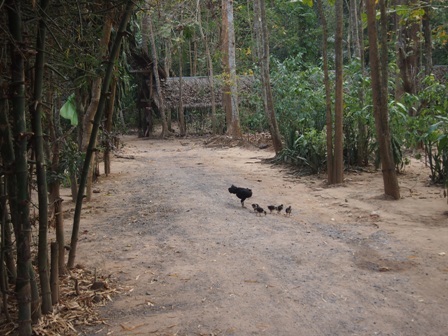 Mon village street scene[/caption]
A cooperatively owned small crafts shop selling intricately designed Mon fabrics, sarongs being the top sellers, is open most days until dusk.
[caption id="attachment_2784" align="alignnone" width="448"]
Mon village street scene[/caption]
A cooperatively owned small crafts shop selling intricately designed Mon fabrics, sarongs being the top sellers, is open most days until dusk.
[caption id="attachment_2784" align="alignnone" width="448"]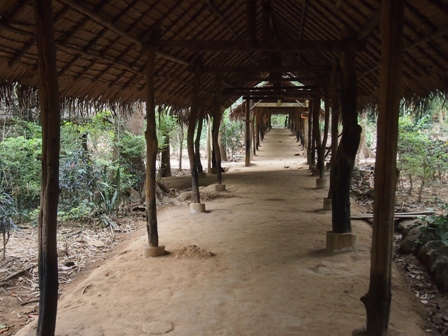 Mon village main pathway[/caption]
[caption id="attachment_2785" align="alignnone" width="448"]
Mon village main pathway[/caption]
[caption id="attachment_2785" align="alignnone" width="448"]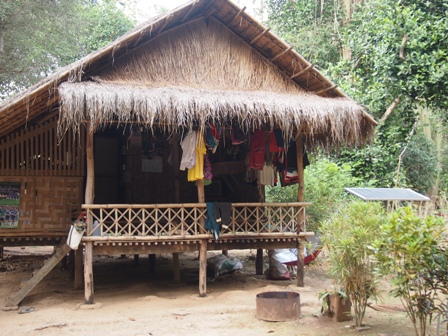 Mon village house with solar panel[/caption]
The elephant training camp and village school make for contrasting neighbours, children and elephants alike learning to interact politely with tourists. A soccer pitch typically occupied by boys kicking goals is a short walk from a small Buddhist temple secreted into the forest.
[caption id="attachment_2786" align="alignnone" width="371"]
Mon village house with solar panel[/caption]
The elephant training camp and village school make for contrasting neighbours, children and elephants alike learning to interact politely with tourists. A soccer pitch typically occupied by boys kicking goals is a short walk from a small Buddhist temple secreted into the forest.
[caption id="attachment_2786" align="alignnone" width="371"]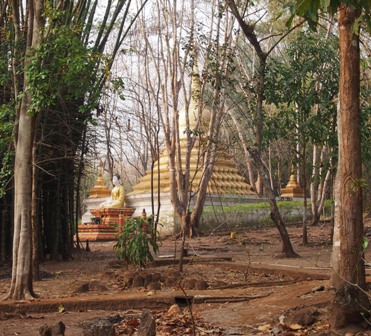 Mon village Buddhist temple[/caption]
An adjoining communal home for the monks is built in the open traditional style without windows. I spied a young monk apparently lost in his thoughts walking on its upper level from room to room. Is there such a thing as sacred voyeurism?
[caption id="attachment_2787" align="alignnone" width="448"]
Mon village Buddhist temple[/caption]
An adjoining communal home for the monks is built in the open traditional style without windows. I spied a young monk apparently lost in his thoughts walking on its upper level from room to room. Is there such a thing as sacred voyeurism?
[caption id="attachment_2787" align="alignnone" width="448"] Mon village schoolroom[/caption]
The idyllic scene described above obscures a present political reality. The majority of Mon people living in these parts are confined to Kanchanaburi Province. They are not allowed to live elsewhere in Thailand while their movements within Thailand are also restricted. Police roadblocks commonly seen during drives around the province are intended for non-compliant Mon people leaving the region without official permission.
[caption id="attachment_2788" align="alignnone" width="448"]
Mon village schoolroom[/caption]
The idyllic scene described above obscures a present political reality. The majority of Mon people living in these parts are confined to Kanchanaburi Province. They are not allowed to live elsewhere in Thailand while their movements within Thailand are also restricted. Police roadblocks commonly seen during drives around the province are intended for non-compliant Mon people leaving the region without official permission.
[caption id="attachment_2788" align="alignnone" width="448"]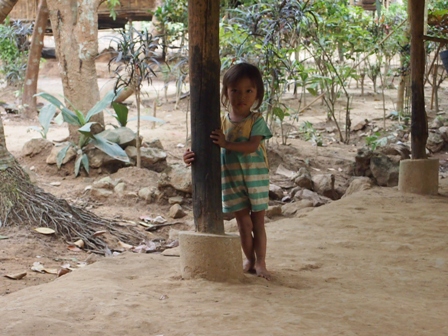 Shy young girl at Mon village[/caption]
After breakfast we hop on a long-tail boat motoring downriver to re-enter the contemporary world, a half hour ride past towering cliffs, mist rising gently off the deep Kwai, which invariably poses a shock to my river-lulled system.
[caption id="attachment_2789" align="alignnone" width="448"]
Shy young girl at Mon village[/caption]
After breakfast we hop on a long-tail boat motoring downriver to re-enter the contemporary world, a half hour ride past towering cliffs, mist rising gently off the deep Kwai, which invariably poses a shock to my river-lulled system.
[caption id="attachment_2789" align="alignnone" width="448"]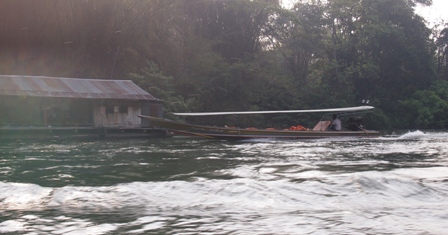 Long tail boat at dawn on river Kwai[/caption]
World War 2 historic sites aside, exploring Kanchanaburi’s other attractions poses limitations. This is not the Thailand of beach resort towns packed with endless strips of shops, cafes and restaurants. Nor is it replete with significant Buddhist temples such as at Sukhothai or Ayutthaya. This is rural Thailand. Tapioca plantations and rice paddies intersperse with forested mountains and tiny villages.
[caption id="attachment_2790" align="alignnone" width="448"]
Long tail boat at dawn on river Kwai[/caption]
World War 2 historic sites aside, exploring Kanchanaburi’s other attractions poses limitations. This is not the Thailand of beach resort towns packed with endless strips of shops, cafes and restaurants. Nor is it replete with significant Buddhist temples such as at Sukhothai or Ayutthaya. This is rural Thailand. Tapioca plantations and rice paddies intersperse with forested mountains and tiny villages.
[caption id="attachment_2790" align="alignnone" width="448"]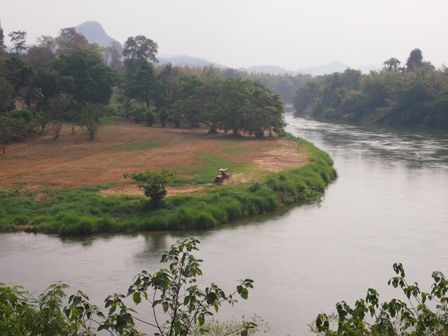 River Kwai at Wang Po[/caption]
Choose a river rafting trip, floating on bamboo logs strapped together with rope for a near immersion experience or opt for an elephant encounter, sharing a bath in the river or an amble through the jungle.
[caption id="attachment_2792" align="alignnone" width="448"]
River Kwai at Wang Po[/caption]
Choose a river rafting trip, floating on bamboo logs strapped together with rope for a near immersion experience or opt for an elephant encounter, sharing a bath in the river or an amble through the jungle.
[caption id="attachment_2792" align="alignnone" width="448"]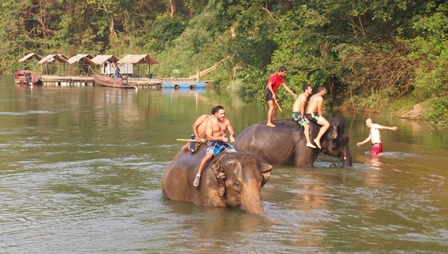 Travellers and elephants bathing at river Kwai elephant camp[/caption]
These two optional extras are the main alternatives to World War 2 memory trips.
[caption id="attachment_2791" align="alignnone" width="344"]
Travellers and elephants bathing at river Kwai elephant camp[/caption]
These two optional extras are the main alternatives to World War 2 memory trips.
[caption id="attachment_2791" align="alignnone" width="344"]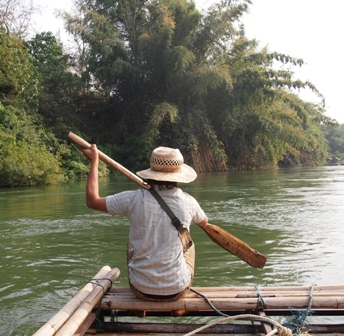 Rafting on the river Kwai[/caption]
Not far from Hellfire Pass Park is the Sai Yok Noi waterfall. Adjacent to the main road that links Kanchanaburi to the border, access is very easy. A fifty metres walk will see you standing in front of a small pool at the base of a pretty waterfall.
[caption id="attachment_2794" align="alignnone" width="443"]
Rafting on the river Kwai[/caption]
Not far from Hellfire Pass Park is the Sai Yok Noi waterfall. Adjacent to the main road that links Kanchanaburi to the border, access is very easy. A fifty metres walk will see you standing in front of a small pool at the base of a pretty waterfall.
[caption id="attachment_2794" align="alignnone" width="443"]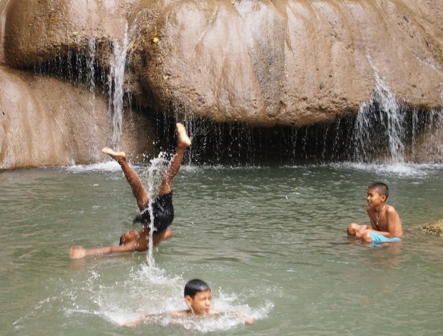 Local kids playing at Soi Yak Noi waterfall[/caption]
Not quite off the beaten track but neither is it on one. A strip of curio shops and takeaway joints stand opposite the waterfall, looking very much like tacky Thai style Niagara.
[caption id="attachment_2793" align="alignnone" width="448"]
Local kids playing at Soi Yak Noi waterfall[/caption]
Not quite off the beaten track but neither is it on one. A strip of curio shops and takeaway joints stand opposite the waterfall, looking very much like tacky Thai style Niagara.
[caption id="attachment_2793" align="alignnone" width="448"] Soi Yak Noi waterfall and pool[/caption]
Downriver a short distance from the River Kwai Jungle Raft camp, up a steep ascent perched above a more upmarket neighbouring river raft jungle camp (larger rooms on bigger rafts with electricity) is the Lawa Cave. Pay a small entry fee from an office situated at the track’s base otherwise the caves lights will remain turned off.
[caption id="attachment_2795" align="alignnone" width="448"]
Soi Yak Noi waterfall and pool[/caption]
Downriver a short distance from the River Kwai Jungle Raft camp, up a steep ascent perched above a more upmarket neighbouring river raft jungle camp (larger rooms on bigger rafts with electricity) is the Lawa Cave. Pay a small entry fee from an office situated at the track’s base otherwise the caves lights will remain turned off.
[caption id="attachment_2795" align="alignnone" width="448"]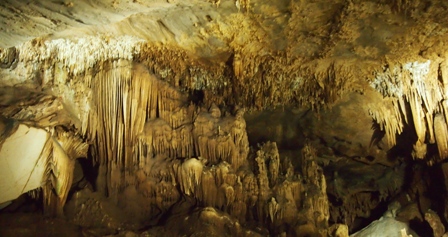 Inside Lawa cave[/caption]
Even so, remember to bring a torch if you intend exploring this dark place. Not being a keen spelunker, I found the cave only mildly interesting.
[caption id="attachment_2796" align="alignnone" width="297"]
Inside Lawa cave[/caption]
Even so, remember to bring a torch if you intend exploring this dark place. Not being a keen spelunker, I found the cave only mildly interesting.
[caption id="attachment_2796" align="alignnone" width="297"]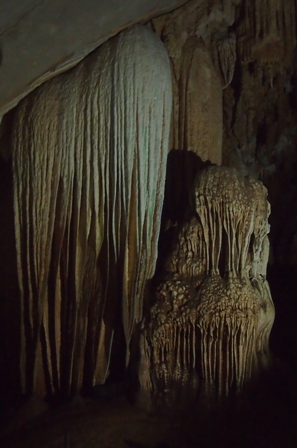 Inside Lawa cave[/caption]
A tiny Buddhist shrine is secreted into a small chamber just inside the entrance. Further in are much larger chambers, some with resident bats whose squeaks provided the only sounds within. The cave is mostly dry apart from the two deepest rooms where steadily dripping water continues to create stalagmites and stalactites.
[caption id="attachment_2798" align="alignnone" width="402"]
Inside Lawa cave[/caption]
A tiny Buddhist shrine is secreted into a small chamber just inside the entrance. Further in are much larger chambers, some with resident bats whose squeaks provided the only sounds within. The cave is mostly dry apart from the two deepest rooms where steadily dripping water continues to create stalagmites and stalactites.
[caption id="attachment_2798" align="alignnone" width="402"]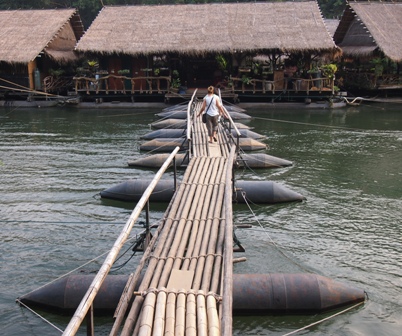 Bridge connecting River Kwai Jungle Raft camp with Mon village[/caption]
The river Kwai, Kanchanaburi and the Mon people portray a fascinating admixture of today’s Thailand with strong links to wartime memories.
For anyone keen to learn more about how Thailand manages to blend recent history, shifting society and a preserved environment in a contemporary setting, this is as good a place as anywhere in which to make a start.
Tom Neal Tacker travelled as a guest of the Tourism Authority of Thailand and Thai Airways.
Naked Facts:
Naked Routes:
Thai Airways offers the best direct connections to Bangkok from just about anywhere in the world. See www.thaiairways.com Though Thai Airways is currently experiencing financial problems service and reliability remain keynotes to its ongoing success. I never fail to be impressed by the genuine friendliness of each crew member I meet and I’ve yet to eat a bad meal on a Thai Airways flight, both in economy and business classes. Thai cuisine comes up trumps served at 10,000 metres; it’s all about the spice and freshness.
Visits to Kanchanaburi are easily arranged. Good travel agents offer a variety of options from day trips to longer excursions. It’s entirely possible to organise a visit yourself. Bear in mind that driving in Thailand, particularly on the crowded roads of Bangkok can be unnerving for the uninitiated. Hiring a vehicle, guide and driver is highly recommended.
Naked Sleeps:
The River Kwai Jungle Rafts has been in business since 1976. Package rates are available for two or three night stays. Prices vary between USD$119 and USD$172 per night per person including breakfast and dinner and long-tail boat transport from the main road access point approximately ten kilometres down river. See www.riverkwaijunglerafts.com for more information.
[caption id="attachment_2799" align="alignnone" width="448"]
Bridge connecting River Kwai Jungle Raft camp with Mon village[/caption]
The river Kwai, Kanchanaburi and the Mon people portray a fascinating admixture of today’s Thailand with strong links to wartime memories.
For anyone keen to learn more about how Thailand manages to blend recent history, shifting society and a preserved environment in a contemporary setting, this is as good a place as anywhere in which to make a start.
Tom Neal Tacker travelled as a guest of the Tourism Authority of Thailand and Thai Airways.
Naked Facts:
Naked Routes:
Thai Airways offers the best direct connections to Bangkok from just about anywhere in the world. See www.thaiairways.com Though Thai Airways is currently experiencing financial problems service and reliability remain keynotes to its ongoing success. I never fail to be impressed by the genuine friendliness of each crew member I meet and I’ve yet to eat a bad meal on a Thai Airways flight, both in economy and business classes. Thai cuisine comes up trumps served at 10,000 metres; it’s all about the spice and freshness.
Visits to Kanchanaburi are easily arranged. Good travel agents offer a variety of options from day trips to longer excursions. It’s entirely possible to organise a visit yourself. Bear in mind that driving in Thailand, particularly on the crowded roads of Bangkok can be unnerving for the uninitiated. Hiring a vehicle, guide and driver is highly recommended.
Naked Sleeps:
The River Kwai Jungle Rafts has been in business since 1976. Package rates are available for two or three night stays. Prices vary between USD$119 and USD$172 per night per person including breakfast and dinner and long-tail boat transport from the main road access point approximately ten kilometres down river. See www.riverkwaijunglerafts.com for more information.
[caption id="attachment_2799" align="alignnone" width="448"] River Kwai Jungle Raft camp sign[/caption]
Naked Reads:
My friend and colleague Christine Retschlag’s blog The Global Goddess has a new chapter devoted to a special employee of River Kwai Jungle Rafts, the inimitable Sam Season, a 22 year old Mon man who lives in the adjoining village and works at the camp. His inspiring story is required reading for anyone staying on the river. See www.theglobalgoddess.com/2014/03/10/a-new-season-for-sam/ for the latest update about love on the River Kwai.
[caption id="attachment_2800" align="alignnone" width="427"]
River Kwai Jungle Raft camp sign[/caption]
Naked Reads:
My friend and colleague Christine Retschlag’s blog The Global Goddess has a new chapter devoted to a special employee of River Kwai Jungle Rafts, the inimitable Sam Season, a 22 year old Mon man who lives in the adjoining village and works at the camp. His inspiring story is required reading for anyone staying on the river. See www.theglobalgoddess.com/2014/03/10/a-new-season-for-sam/ for the latest update about love on the River Kwai.
[caption id="attachment_2800" align="alignnone" width="427"]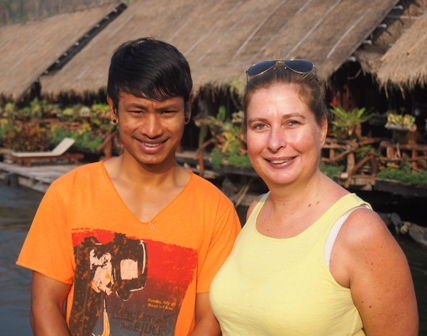 Sam Season and Christine Retschlag at River Kwai Jungle Raft camp[/caption]
Sam Season and Christine Retschlag at River Kwai Jungle Raft camp[/caption]
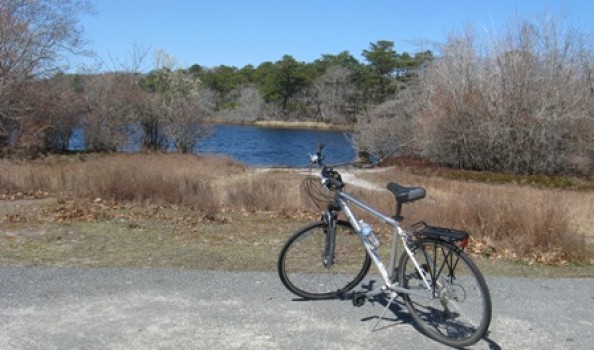 https://nakedhungrytraveller.com.au/pointing-towards-ptown/ Pointing Towards P'townSticking out at the end of Cape Cod’s sinewy finger, Provincetown is like a naughty geographical riposte, an ‘Up yours!’ to humdrum Middle America amassed somewhere west of Boston. P’town, as it’s called by regular visitors and permanent residents alike, has long been recognised as an artistic refuge. Artists and writers escaped to P’town for its topographical isolation, unique watery light and natural environment. Coincidentally, post World War 1 fishing industry incomes flat-lined due to greedily depleted stocks while industrial scale whaling died a thankful death. [caption id="attachment_2737" align="alignnone" width="279"]
https://nakedhungrytraveller.com.au/pointing-towards-ptown/ Pointing Towards P'townSticking out at the end of Cape Cod’s sinewy finger, Provincetown is like a naughty geographical riposte, an ‘Up yours!’ to humdrum Middle America amassed somewhere west of Boston. P’town, as it’s called by regular visitors and permanent residents alike, has long been recognised as an artistic refuge. Artists and writers escaped to P’town for its topographical isolation, unique watery light and natural environment. Coincidentally, post World War 1 fishing industry incomes flat-lined due to greedily depleted stocks while industrial scale whaling died a thankful death. [caption id="attachment_2737" align="alignnone" width="279"]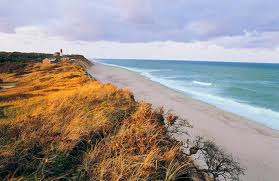 Cape Cod beach near P'town[/caption]
The Cape Cod School of Art was begun in 1899 by E. Ambrose Webster whose work was strongly influenced by Claude Monet. P’town and chiaroscuro have been inextricably artistically linked ever since.
By 1916 over 300 artists and students were in permanent or seasonal residence, which at the time caused the Boston Globe newspaper to exclaim, ‘Biggest art colony in the world at Provincetown.’
Serendipitously the town’s financial downturn during the Great Depression proved attractive to writers and painters seeking an enticing base and value for money in terms of accommodation.
Even so, P’town was already an established arts community by the advent of World War 2. Writers were drawn to the hubbub of creativity despite P’town having entered an economic napping phase in the 1930s.
Eugene O’Neill’s first hit play ‘Bound East for Cardiff’ was first staged at the Lewis Wharf theatre in the East End of P’town. Tennessee Williams lived and worked in P’town as well as Susan Glaspell and the former USA Poet Laureate Stanley Kunitz. Famous journalists John Reed, Louise Bryant and Mary Heaton Vorse also lived in P’town.
In the 30s surrealists Max Ernst, Arshile Gorky and Robert Matta worked frequently in P’town. Robert Motherwell also used P’town as an occasional base.
After World War 2 wandering artists truly placed P’town on the international map. Their abstract expressionist works were gaining recognition but hadn’t yet reached the tipping point of popularity. Jackson Pollock, Lee Krasner, Willem de Kooning, Helen Frankenthaler, Franz Kline and Fritz Bultman all worked in P’town while Robert Motherwell continued his semi-permanent residency
Norman Mailer lived there. Kurt Vonnegut also based himself in P’town for some time. Film director John Waters has lived in P’town too, which begs no surprises.
Back in the 60s when local rents were cheaper and the distance between it and larger towns further up the Cape maintained an air of isolation, P’town emerged as the end goal for vagabonds, wanderers and miscreants escaping socially repressive mores. Artists and writers continued to seek inspiration or refuge in P’town. Clearly the town’s allure wasn’t dimmed by increasing popularity.
[caption id="attachment_2738" align="alignnone" width="247"]
Cape Cod beach near P'town[/caption]
The Cape Cod School of Art was begun in 1899 by E. Ambrose Webster whose work was strongly influenced by Claude Monet. P’town and chiaroscuro have been inextricably artistically linked ever since.
By 1916 over 300 artists and students were in permanent or seasonal residence, which at the time caused the Boston Globe newspaper to exclaim, ‘Biggest art colony in the world at Provincetown.’
Serendipitously the town’s financial downturn during the Great Depression proved attractive to writers and painters seeking an enticing base and value for money in terms of accommodation.
Even so, P’town was already an established arts community by the advent of World War 2. Writers were drawn to the hubbub of creativity despite P’town having entered an economic napping phase in the 1930s.
Eugene O’Neill’s first hit play ‘Bound East for Cardiff’ was first staged at the Lewis Wharf theatre in the East End of P’town. Tennessee Williams lived and worked in P’town as well as Susan Glaspell and the former USA Poet Laureate Stanley Kunitz. Famous journalists John Reed, Louise Bryant and Mary Heaton Vorse also lived in P’town.
In the 30s surrealists Max Ernst, Arshile Gorky and Robert Matta worked frequently in P’town. Robert Motherwell also used P’town as an occasional base.
After World War 2 wandering artists truly placed P’town on the international map. Their abstract expressionist works were gaining recognition but hadn’t yet reached the tipping point of popularity. Jackson Pollock, Lee Krasner, Willem de Kooning, Helen Frankenthaler, Franz Kline and Fritz Bultman all worked in P’town while Robert Motherwell continued his semi-permanent residency
Norman Mailer lived there. Kurt Vonnegut also based himself in P’town for some time. Film director John Waters has lived in P’town too, which begs no surprises.
Back in the 60s when local rents were cheaper and the distance between it and larger towns further up the Cape maintained an air of isolation, P’town emerged as the end goal for vagabonds, wanderers and miscreants escaping socially repressive mores. Artists and writers continued to seek inspiration or refuge in P’town. Clearly the town’s allure wasn’t dimmed by increasing popularity.
[caption id="attachment_2738" align="alignnone" width="247"] P'town main street[/caption]
Roads improved while a budding reputation for sunny summer weather combined with wide sandy beaches proliferated. P’town’s tourism grew quickly as it acquired a reputation as a summer holiday destination.
[caption id="attachment_2742" align="alignnone" width="250"]
P'town main street[/caption]
Roads improved while a budding reputation for sunny summer weather combined with wide sandy beaches proliferated. P’town’s tourism grew quickly as it acquired a reputation as a summer holiday destination.
[caption id="attachment_2742" align="alignnone" width="250"] Herring Cove beach scene[/caption]
Since the early 80s and the beginning of the GLBT rights movement, P’town has grown steadily to become one of the world’s most sexually liberated towns. Currently it boasts the greatest per capita number of same-sex couples anywhere in the USA.
[caption id="attachment_2741" align="alignnone" width="191"]
Herring Cove beach scene[/caption]
Since the early 80s and the beginning of the GLBT rights movement, P’town has grown steadily to become one of the world’s most sexually liberated towns. Currently it boasts the greatest per capita number of same-sex couples anywhere in the USA.
[caption id="attachment_2741" align="alignnone" width="191"] P'town during Carnival[/caption]
Rents and house prices have subsequently increased while Provincetown has turned itself into a very trendy Bohemian coastal village. Welcome to gentrification at its most contemporary state as DINKs (Dual Incomes No Kids) rule this cocky roost.
P'town during Carnival[/caption]
Rents and house prices have subsequently increased while Provincetown has turned itself into a very trendy Bohemian coastal village. Welcome to gentrification at its most contemporary state as DINKs (Dual Incomes No Kids) rule this cocky roost.
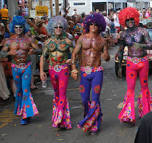 If in doubt about how gay P’town really is, try counting the rainbow flags hanging from just about every shopfront doorway. There are lots of them and it’s too easy (and fun) to lose track.
It’s also one of the friendliest towns in all America. Given the smiles plastered on almost every face I observed, I’d say just about everyone who comes to this picturesque, historic and slightly wacky town positioned at the end of a sand spit is well pleased to be there.
[caption id="attachment_2745" align="alignnone" width="276"]
If in doubt about how gay P’town really is, try counting the rainbow flags hanging from just about every shopfront doorway. There are lots of them and it’s too easy (and fun) to lose track.
It’s also one of the friendliest towns in all America. Given the smiles plastered on almost every face I observed, I’d say just about everyone who comes to this picturesque, historic and slightly wacky town positioned at the end of a sand spit is well pleased to be there.
[caption id="attachment_2745" align="alignnone" width="276"] P'town friendly faces[/caption]
Wacky? Have a close look at the singularly phallic Pilgrim Monument jutting skywards from a slight rise in the middle of town.
[caption id="attachment_2739" align="alignnone" width="275"]
P'town friendly faces[/caption]
Wacky? Have a close look at the singularly phallic Pilgrim Monument jutting skywards from a slight rise in the middle of town.
[caption id="attachment_2739" align="alignnone" width="275"] Pilgrim Monument rises above all[/caption]
Why is it here? Nearly every American is taught that the original Puritan religious refugees sailed on the Mayflower from England in 1620 and landed at Plymouth harbor (or at ‘Plymouth Rock’ which is how most history books referred to the landing place).
Not so. The Puritans first landed at P’town in November 1620 before sailing further west to Plymouth where they founded a colony based on peaceful cohabitation with Native Americans (the Thanksgiving holiday celebrates their acts of sharing and generosity of spirit) and religious freedom.
[caption id="attachment_2740" align="alignnone" width="275"]
Pilgrim Monument rises above all[/caption]
Why is it here? Nearly every American is taught that the original Puritan religious refugees sailed on the Mayflower from England in 1620 and landed at Plymouth harbor (or at ‘Plymouth Rock’ which is how most history books referred to the landing place).
Not so. The Puritans first landed at P’town in November 1620 before sailing further west to Plymouth where they founded a colony based on peaceful cohabitation with Native Americans (the Thanksgiving holiday celebrates their acts of sharing and generosity of spirit) and religious freedom.
[caption id="attachment_2740" align="alignnone" width="275"]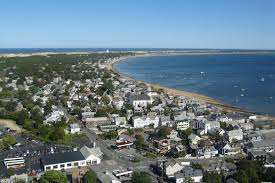 View of P'town from atop Pilgrim Monument[/caption]
The Pilgrim Monument, built between 1907 and 1912 is still the tallest all granite structure in the USA. It stands 252 feet fully erect while commanding a masterful position over all of P’town. It’s the first thing you see when entering town. The monument was built to remind visitors that P’town was the first pilgrim landing place and Plymouth harbor was second.
But most everyone has conveniently forgot that fact.
In his famous song ‘Anything Goes’ Cole Porter wrote about Plymouth Rock. As it often happens in popular history, a mistake becomes legend which becomes myth which is now entrenched into the general mindset.
P’town rate payers attempted to remind patriots that here was the site of the Puritan’s first landing by constructing a gigantic upwardly thrusting symbol commemorating a transit stop on the road to liberty. Instead they ended up with a stony exclamation mark that looks like a big grey knob.
This big grey knob is mid-point between P’town’s East End and West End. P’town stretched from end to end is essentially a long strip of two or three parallel streets. West End is the slightly more gentrified of the two halves. East End’s extremity borders cheaper summer accommodation places, tiny boxes packed closely together facing quiet bay beaches, all very family friendly but looking rather forlorn. The western end of East End is full of specialty shops and galleries. They don’t look as expensive as those in the West End.
The West End is where P’town’s narrow assortment of grand houses line up facing the water and where the shops appear tonier. In the middle is downtown, also where you’ll find the town’s main wharf. Here the busiest bars, flashiest shops and greatest concentration of restaurants gather in one great retail extravaganza of mostly independent operators. Chain stores, mainstream international brands and ‘malling of America’ ugliness are non-existent in P’town.
The monument and adjoining Provincetown Museum are perfect starting points in which to get a sense of this quirky town’s history. When the men of the Mayflower signed (not a single woman was a signatory) the Mayflower Compact in P’town harbor they officially espoused individual rights and freedoms. (See the original text and names of the signatories here: www.pilgrim-monument.org/mayflower-compact#.UzUcH87QsdY)
[caption id="attachment_2746" align="alignnone" width="90"]
View of P'town from atop Pilgrim Monument[/caption]
The Pilgrim Monument, built between 1907 and 1912 is still the tallest all granite structure in the USA. It stands 252 feet fully erect while commanding a masterful position over all of P’town. It’s the first thing you see when entering town. The monument was built to remind visitors that P’town was the first pilgrim landing place and Plymouth harbor was second.
But most everyone has conveniently forgot that fact.
In his famous song ‘Anything Goes’ Cole Porter wrote about Plymouth Rock. As it often happens in popular history, a mistake becomes legend which becomes myth which is now entrenched into the general mindset.
P’town rate payers attempted to remind patriots that here was the site of the Puritan’s first landing by constructing a gigantic upwardly thrusting symbol commemorating a transit stop on the road to liberty. Instead they ended up with a stony exclamation mark that looks like a big grey knob.
This big grey knob is mid-point between P’town’s East End and West End. P’town stretched from end to end is essentially a long strip of two or three parallel streets. West End is the slightly more gentrified of the two halves. East End’s extremity borders cheaper summer accommodation places, tiny boxes packed closely together facing quiet bay beaches, all very family friendly but looking rather forlorn. The western end of East End is full of specialty shops and galleries. They don’t look as expensive as those in the West End.
The West End is where P’town’s narrow assortment of grand houses line up facing the water and where the shops appear tonier. In the middle is downtown, also where you’ll find the town’s main wharf. Here the busiest bars, flashiest shops and greatest concentration of restaurants gather in one great retail extravaganza of mostly independent operators. Chain stores, mainstream international brands and ‘malling of America’ ugliness are non-existent in P’town.
The monument and adjoining Provincetown Museum are perfect starting points in which to get a sense of this quirky town’s history. When the men of the Mayflower signed (not a single woman was a signatory) the Mayflower Compact in P’town harbor they officially espoused individual rights and freedoms. (See the original text and names of the signatories here: www.pilgrim-monument.org/mayflower-compact#.UzUcH87QsdY)
[caption id="attachment_2746" align="alignnone" width="90"] Pilgrim Monument and Provincetown Museum[/caption]
By the mid 19th century P’town had become one of Massachusetts’ wealthiest towns with per capita incomes amongst the highest in the state. Cod fishing and whaling businesses both reaped fortunes, largely for the Portuguese migrants (the majority of them fishermen from the Azores Islands) who settled there earlier. The Portuguese heritage is still strongly felt in P’town as these hardy fisher-folk established an atmosphere of independent social, religious and cultural life.
These days P’town is a holiday resort town of unique attributes. For GLBT persons bent on kicking up heels and having a good time in a relaxed place where politically focused matters of sexuality can be read as ‘been there, done that, get over it’, this is one of the few places on America’s eastern seaboard where acceptance of same sex couples is a given.
[caption id="attachment_2747" align="alignnone" width="300"]
Pilgrim Monument and Provincetown Museum[/caption]
By the mid 19th century P’town had become one of Massachusetts’ wealthiest towns with per capita incomes amongst the highest in the state. Cod fishing and whaling businesses both reaped fortunes, largely for the Portuguese migrants (the majority of them fishermen from the Azores Islands) who settled there earlier. The Portuguese heritage is still strongly felt in P’town as these hardy fisher-folk established an atmosphere of independent social, religious and cultural life.
These days P’town is a holiday resort town of unique attributes. For GLBT persons bent on kicking up heels and having a good time in a relaxed place where politically focused matters of sexuality can be read as ‘been there, done that, get over it’, this is one of the few places on America’s eastern seaboard where acceptance of same sex couples is a given.
[caption id="attachment_2747" align="alignnone" width="300"]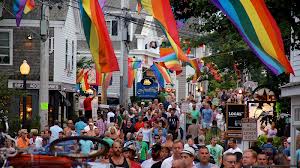 P'town during Carnival[/caption]
Only Fire Island, Rehoboth and Key West can compete on similar levels of liberating attitudinal conceptions. In my opinion, P’town is much more interesting.
Maybe it’s the cross breeding of puritan history, Portuguese influence and lately, sexual revolution that makes this town feel separately special.
For my money, the backdrop of calm waters in the bay to the west, rough open Atlantic to the north and east and the wonders of Cape Cod’s particularly interesting environment add extra incentives, enough to give P’town the edge over the aforementioned GLBT Meccas.
[caption id="attachment_2758" align="alignnone" width="280"]
P'town during Carnival[/caption]
Only Fire Island, Rehoboth and Key West can compete on similar levels of liberating attitudinal conceptions. In my opinion, P’town is much more interesting.
Maybe it’s the cross breeding of puritan history, Portuguese influence and lately, sexual revolution that makes this town feel separately special.
For my money, the backdrop of calm waters in the bay to the west, rough open Atlantic to the north and east and the wonders of Cape Cod’s particularly interesting environment add extra incentives, enough to give P’town the edge over the aforementioned GLBT Meccas.
[caption id="attachment_2758" align="alignnone" width="280"]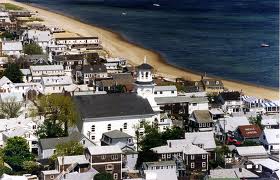 P'town overview[/caption]
A visit to P’town may be focused entirely on its abundance of arty shops, arty galleries, funky boutiques, cafes, restaurants and bars.
If nightlife is the main aim, remember that peak season summer nights in P’town stretch till dawn while the bars thrum with house music and sweaty, suntanned torsos twist round one another in an endless interpretation of how to do a ‘Bacchanalia’ in New England. There’s plenty of flash and splash to occupy oneself within the confines of central P’town. Even the most blasé hedonist will not lack pleasurable pursuits: Cape Cod, Escape Cod. Who needs a national park when a spunky muscle man or svelte sex goddess is in need of a bar side proposition?
For me it’s the lure of the adjacent nearby wild places that makes P’town so special. I hired a bicycle and had miles of very well maintained cycling trails in adjoining Cape Cod National Seashore Park pretty much to my lonesome during a half day’s rambling.
[caption id="attachment_2748" align="alignnone" width="120"]
P'town overview[/caption]
A visit to P’town may be focused entirely on its abundance of arty shops, arty galleries, funky boutiques, cafes, restaurants and bars.
If nightlife is the main aim, remember that peak season summer nights in P’town stretch till dawn while the bars thrum with house music and sweaty, suntanned torsos twist round one another in an endless interpretation of how to do a ‘Bacchanalia’ in New England. There’s plenty of flash and splash to occupy oneself within the confines of central P’town. Even the most blasé hedonist will not lack pleasurable pursuits: Cape Cod, Escape Cod. Who needs a national park when a spunky muscle man or svelte sex goddess is in need of a bar side proposition?
For me it’s the lure of the adjacent nearby wild places that makes P’town so special. I hired a bicycle and had miles of very well maintained cycling trails in adjoining Cape Cod National Seashore Park pretty much to my lonesome during a half day’s rambling.
[caption id="attachment_2748" align="alignnone" width="120"] Cycling around P'town[/caption]
Cycling from Herring Cove beach to Race Point and through the Beech Forest, I tallied about 30 kilometres of easy riding on well maintained tracks. Tiny lakes hidden in dense scrub forest sparkled between sand dunes while circling hawks screeched at bright red cardinals hop-searching for grubs in dim clearings. Pine, oak, beech, hemlock and hickory tree thickets obscured pretty ocean views.
[caption id="attachment_2749" align="alignnone" width="448"]
Cycling around P'town[/caption]
Cycling from Herring Cove beach to Race Point and through the Beech Forest, I tallied about 30 kilometres of easy riding on well maintained tracks. Tiny lakes hidden in dense scrub forest sparkled between sand dunes while circling hawks screeched at bright red cardinals hop-searching for grubs in dim clearings. Pine, oak, beech, hemlock and hickory tree thickets obscured pretty ocean views.
[caption id="attachment_2749" align="alignnone" width="448"] Cape Cod Race Point Lifesaving station house[/caption]
These cycling trails were the first ever built in an American national park. The detour proved a quick revivifying exit from P’town’s surfeit of fleshy excesses. Not thirty minutes easy pedalling from opposite the Pilgrim Monument brought me to reedy marshland filled with waterbirds that bordered a sheltered bay beach from which it’s possible to see whales migrating to and from Arctic waters during spring and autumn.
[caption id="attachment_2751" align="alignnone" width="250"]
Cape Cod Race Point Lifesaving station house[/caption]
These cycling trails were the first ever built in an American national park. The detour proved a quick revivifying exit from P’town’s surfeit of fleshy excesses. Not thirty minutes easy pedalling from opposite the Pilgrim Monument brought me to reedy marshland filled with waterbirds that bordered a sheltered bay beach from which it’s possible to see whales migrating to and from Arctic waters during spring and autumn.
[caption id="attachment_2751" align="alignnone" width="250"]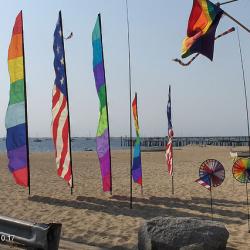 Herring Cove beach[/caption]
Close proximity to the cape’s wind scoured beaches grandstands hauntingly beautiful marshlands and forests, positioning P’town foremost in my mind as the funky town perched on an arboreal outpost wedged between sand hills. It’s most definitely a unique location.
If history is on the travel agenda, P’town bookends a fair share of colonial, post-revolutionary, mid-19th century marine commerce and 60s sexual liberation stories, quite a varied mix. Check out the town library’s reference collection (after visiting the Provincetown Museum).
Past Wellfleet near Eastham just off the road to P’town (US Highway 6) is the Old Cove Burial Ground. It’s a small cemetery, unmarked and rather lonely.
[caption id="attachment_2752" align="alignnone" width="448"]
Herring Cove beach[/caption]
Close proximity to the cape’s wind scoured beaches grandstands hauntingly beautiful marshlands and forests, positioning P’town foremost in my mind as the funky town perched on an arboreal outpost wedged between sand hills. It’s most definitely a unique location.
If history is on the travel agenda, P’town bookends a fair share of colonial, post-revolutionary, mid-19th century marine commerce and 60s sexual liberation stories, quite a varied mix. Check out the town library’s reference collection (after visiting the Provincetown Museum).
Past Wellfleet near Eastham just off the road to P’town (US Highway 6) is the Old Cove Burial Ground. It’s a small cemetery, unmarked and rather lonely.
[caption id="attachment_2752" align="alignnone" width="448"] Mayflower graves cemetery[/caption]
Here lie the only authenticated graves of the original Mayflower passengers. The headstones are worn smooth with age but a few remain legible, for instance the grave of Constance Hopkins Snow. She didn’t sign the Mayflower Compact but she was one of the famous pilgrims who landed at Plymouth Harbor (Rock) via P’town.
[caption id="attachment_2753" align="alignnone" width="436"]
Mayflower graves cemetery[/caption]
Here lie the only authenticated graves of the original Mayflower passengers. The headstones are worn smooth with age but a few remain legible, for instance the grave of Constance Hopkins Snow. She didn’t sign the Mayflower Compact but she was one of the famous pilgrims who landed at Plymouth Harbor (Rock) via P’town.
[caption id="attachment_2753" align="alignnone" width="436"]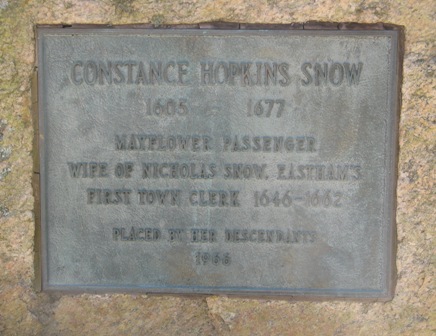 Constance Hopkins Snow gravestone[/caption]
Also near Eastham is the main visitor’s center of the Cape Cod National Seashore Park. Cape Cod’s ecology, geology and environment are intelligently described in a comprehensive group of exhibits and displays.
[caption id="attachment_2755" align="alignnone" width="275"]
Constance Hopkins Snow gravestone[/caption]
Also near Eastham is the main visitor’s center of the Cape Cod National Seashore Park. Cape Cod’s ecology, geology and environment are intelligently described in a comprehensive group of exhibits and displays.
[caption id="attachment_2755" align="alignnone" width="275"]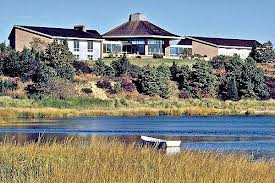 Cape Cod National Seashore visitor's center[/caption]
The park rangers working on site are invariably amiable and well informed. Typically, employees of the American national park service welcome questions. The wonders of Cape Cod are cheerfully explained. Queries are warmly welcomed and enthusiastically answered.
[caption id="attachment_2754" align="alignnone" width="260"]
Cape Cod National Seashore visitor's center[/caption]
The park rangers working on site are invariably amiable and well informed. Typically, employees of the American national park service welcome questions. The wonders of Cape Cod are cheerfully explained. Queries are warmly welcomed and enthusiastically answered.
[caption id="attachment_2754" align="alignnone" width="260"] Cape Cod visitor's center sign[/caption]
P’town’s permanent population numbers roughly 3,000. In summer it burgeons to over 60,000. Like a dance floor laser show it shimmers during summer’s hustle and bustle. Peak season is from May until September when accommodation, holiday houses and hospitality businesses are at their most frenetic. Off peak during spring and autumn is quieter, gentler and captivatingly beautiful. Winter is for true devotees, the only time when P’town’s party lights are dimmed... but they still cast a comely glow.
Tom Neal Tacker travelled as a guest of Qantas Airlines and Massachusetts Tourism Authority.
Naked Facts:
P’town’s annual calendar of events is packed with an extremely varied program from a film festival to a home made boat race, from a renowned arts festival to a gay bear’s week and to a Portuguese cultural celebration. The year’s biggest event is Carnival Week (3rd week in August), when the GLBT community is truly out in force.
See www.ptownchamber.com for more information including accommodation, touring and restaurant advice.
Naked Sleeps:
The Crowne Pointe Historic Inn & Spa is smack in the middle of town though gratefully positioned on a rise near the Pilgrim Monument just above the main road’s traffic and action centre.
[caption id="attachment_2756" align="alignnone" width="266"]
Cape Cod visitor's center sign[/caption]
P’town’s permanent population numbers roughly 3,000. In summer it burgeons to over 60,000. Like a dance floor laser show it shimmers during summer’s hustle and bustle. Peak season is from May until September when accommodation, holiday houses and hospitality businesses are at their most frenetic. Off peak during spring and autumn is quieter, gentler and captivatingly beautiful. Winter is for true devotees, the only time when P’town’s party lights are dimmed... but they still cast a comely glow.
Tom Neal Tacker travelled as a guest of Qantas Airlines and Massachusetts Tourism Authority.
Naked Facts:
P’town’s annual calendar of events is packed with an extremely varied program from a film festival to a home made boat race, from a renowned arts festival to a gay bear’s week and to a Portuguese cultural celebration. The year’s biggest event is Carnival Week (3rd week in August), when the GLBT community is truly out in force.
See www.ptownchamber.com for more information including accommodation, touring and restaurant advice.
Naked Sleeps:
The Crowne Pointe Historic Inn & Spa is smack in the middle of town though gratefully positioned on a rise near the Pilgrim Monument just above the main road’s traffic and action centre.
[caption id="attachment_2756" align="alignnone" width="266"] Crowne Pointe Inn exterior[/caption]
Large suites are decorated with antiques and Presidential memorabilia. My king sized bed in the Lincoln Room almost needed a small trampoline to help me get into it. From on high I had great views over the townscape and nearby bay. All mod cons functioned perfectly. A large bathroom had everything I needed, including good quality toiletries, a full bath and shower.
[caption id="attachment_2757" align="alignnone" width="275"]
Crowne Pointe Inn exterior[/caption]
Large suites are decorated with antiques and Presidential memorabilia. My king sized bed in the Lincoln Room almost needed a small trampoline to help me get into it. From on high I had great views over the townscape and nearby bay. All mod cons functioned perfectly. A large bathroom had everything I needed, including good quality toiletries, a full bath and shower.
[caption id="attachment_2757" align="alignnone" width="275"]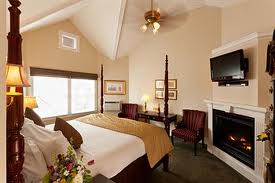 Crowne Pointe room interior[/caption]
Best of all, the catering is terrific. Breakfasts are cooked to order and served in a lovely dining room with an enclosed veranda and huge bay windows. Lunches and dinners are equally fine. A small bar adds more pizzazz to the whole scene.
An on site spa boasts an indulgent menu of treatments. In summer a private and secluded outside spa pool draws guests to indulge in social repartee.
www.crownepointe.com
Naked Eats and Drinks:
Apart from the excellent dining at the Crowne Pointe, I recommend Napi’s restaurant for its authentic American food prepared with Italian flair. The location in a back alley makes this a favourite with permanent residents.
www.napis-restaurant.com
Another established and reliable restaurant is the Lobster Pot. Obviously, ocean delights are the main drawcard here. Fresh local seafood and fish served by talented professional wait staff combine to create a winning dining package.
www.ptownlobsterpot.com
The Atlantic House (A-house) bar claims to be America’s oldest gay bar. This rambling pub is a lot of fun. If you’re fresh in town, it’s a perfect place to begin engaging in your best new friendship.
www.ahouse.com
Naked Reads:
Michael Cunningham (author of ‘The Hours’, ‘Specimen Days’, “A Home at the End of the World’, among others) bought a house in P’town years ago. Splitting his time between P’town and a home in New York, this insightful and accomplished writer is clearly very fond of P’town. His book, ‘Land’s End: A Walk in Provincetown’ is compulsory reading for its observant, witty and honest view of this outpost proudly set at the outer reaches of America. I found two copies at the local library, borrowed one my first night and finished it at the beginning of my third and last day. Packed with facts and random personal observations about P’town’s propensity for attracting oddballs, eccentrics and geniuses, I felt far better informed for having read it.
Crowne Pointe room interior[/caption]
Best of all, the catering is terrific. Breakfasts are cooked to order and served in a lovely dining room with an enclosed veranda and huge bay windows. Lunches and dinners are equally fine. A small bar adds more pizzazz to the whole scene.
An on site spa boasts an indulgent menu of treatments. In summer a private and secluded outside spa pool draws guests to indulge in social repartee.
www.crownepointe.com
Naked Eats and Drinks:
Apart from the excellent dining at the Crowne Pointe, I recommend Napi’s restaurant for its authentic American food prepared with Italian flair. The location in a back alley makes this a favourite with permanent residents.
www.napis-restaurant.com
Another established and reliable restaurant is the Lobster Pot. Obviously, ocean delights are the main drawcard here. Fresh local seafood and fish served by talented professional wait staff combine to create a winning dining package.
www.ptownlobsterpot.com
The Atlantic House (A-house) bar claims to be America’s oldest gay bar. This rambling pub is a lot of fun. If you’re fresh in town, it’s a perfect place to begin engaging in your best new friendship.
www.ahouse.com
Naked Reads:
Michael Cunningham (author of ‘The Hours’, ‘Specimen Days’, “A Home at the End of the World’, among others) bought a house in P’town years ago. Splitting his time between P’town and a home in New York, this insightful and accomplished writer is clearly very fond of P’town. His book, ‘Land’s End: A Walk in Provincetown’ is compulsory reading for its observant, witty and honest view of this outpost proudly set at the outer reaches of America. I found two copies at the local library, borrowed one my first night and finished it at the beginning of my third and last day. Packed with facts and random personal observations about P’town’s propensity for attracting oddballs, eccentrics and geniuses, I felt far better informed for having read it.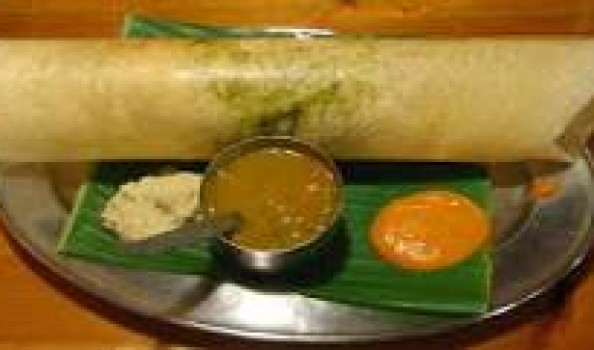 https://nakedhungrytraveller.com.au/chennai-on-a-plate/ Chennai on a Plate
https://nakedhungrytraveller.com.au/chennai-on-a-plate/ Chennai on a PlateChennai, biggest city in Tamil Nadu, is packed with eating options. Where to begin?
By the time I tumble out of a crowded overnight train from Kolkata, I’m ready to stretch my legs, breathe some fresh sea air and find authentic south Indian food. From Chennai's beehive-busy station, one of the focal points in this densely populated city of 8 million people, I hail a taxi. “Where's the best masala dosa in town?'' I ask the portly driver. “I'm taking you to my cousin's café, sir. Where are you from? Do you have money so we can be buying fuel as my taxi is empty?'' He responds in Indian fashion, mixing questions with surprising statements. We fill his tank and head into a rabbit-warren market. The driver finds a parking spot next to two cows chewing sugar canes. He takes me into his cousin's cafe and yells out that this gentleman from Kolkata wants a masala dosa. I offer to buy him one too but he declines, saying his taxi business mustn't be kept waiting. Within minutes cousin Balaji brings me a freshly cooked, crispy dosa pancake whose edges easily extend over my banana-leaf plate. It's filled with a warm potato curry accompanied by two little bowls: one of coconut sambar; the other a soupy tomato and lentil rasam. I wash my hands at a grimy basin, roll up my sleeves and tuck in. I taste fresh curry leaves, a hint of chilli, black pepper, acidic lime juice, mustard seeds, astringent chopped cabbage, onions and bitter fenugreek in the curry. The airy, flaky dosa is slightly sour from its fermented rice flour batter. The sambar is fiery hot; a touch of sweetness is imparted by creamy coconut and it's lightly salted. The rasam is even hotter with chilli, and it’s pungent with and coloured by turmeric. I have a glass of plain lassi, fresh yoghurt blended with cool water and a bit of salt. Then I finish with a tiny local banana. It isn't the best masala dosa I've ever eaten but it is memorable for its authenticity. Within an hour of arrival I'm eating one of Chennai’s signature dishes. It's fresh and lively and completely vegetarian: healthy and true to the city’s essential flavours. Simply, it's Chennai on a plate. [caption id="attachment_2816" align="alignnone" width="155"]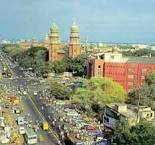 Central Chenna[/caption]
This capital of the Coromandel Coast is a fabled place. Arabs traded here when they dominated commerce between Asia and Europe. In exchange for cardamom, cinnamon and peppercorns, the locals obtained sandalwood, frankincense and myrrh. A spice bazaar was born; prices skyrocketed faster than a fakir could shimmy up a rope trick. Europeans developed an addiction for the aromatic masalas, as they're known in India, giving depth and richness to bland northern European fare. By the 17th century, the Portuguese were trading along the southern Indian coast, adding their own Lusitanian influences to the regional cuisine. They were followed successively by both the English and the French. In the 19th century the English were reaping riches from the Coromandel Coast. They called the collection of towns packed together here along this busy harbour, Madras. In 1996, along with a return to traditional pronunciations and historic associations that many other Indian cities experienced, Madras became Chennai.
[caption id="attachment_2812" align="alignnone" width="192"]
Central Chenna[/caption]
This capital of the Coromandel Coast is a fabled place. Arabs traded here when they dominated commerce between Asia and Europe. In exchange for cardamom, cinnamon and peppercorns, the locals obtained sandalwood, frankincense and myrrh. A spice bazaar was born; prices skyrocketed faster than a fakir could shimmy up a rope trick. Europeans developed an addiction for the aromatic masalas, as they're known in India, giving depth and richness to bland northern European fare. By the 17th century, the Portuguese were trading along the southern Indian coast, adding their own Lusitanian influences to the regional cuisine. They were followed successively by both the English and the French. In the 19th century the English were reaping riches from the Coromandel Coast. They called the collection of towns packed together here along this busy harbour, Madras. In 1996, along with a return to traditional pronunciations and historic associations that many other Indian cities experienced, Madras became Chennai.
[caption id="attachment_2812" align="alignnone" width="192"]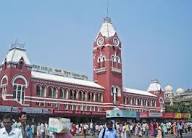 Chennai's main railway station[/caption]
Entrepreneurs introduced chillies, tomatoes and potatoes from South America to southern India. Locals took to these extraordinary new ingredients with gusto, and their export trade continued to prosper. By 1600, cardamom from Coromandel was worth more than gold.
[caption id="attachment_2815" align="alignnone" width="171"]
Chennai's main railway station[/caption]
Entrepreneurs introduced chillies, tomatoes and potatoes from South America to southern India. Locals took to these extraordinary new ingredients with gusto, and their export trade continued to prosper. By 1600, cardamom from Coromandel was worth more than gold.
[caption id="attachment_2815" align="alignnone" width="171"] Cardamom pods and seeds[/caption]
The coast brims with tropical tastes, mingling hot and sizzling with cool and seductive. Local chefs have constantly innovated, seeking new ways to use ingredients from all over the world. They exported their ingenuity as well: the Tamil word kari, or black pepper, was anglicised to curry.
[caption id="attachment_2814" align="alignnone" width="170"]
Cardamom pods and seeds[/caption]
The coast brims with tropical tastes, mingling hot and sizzling with cool and seductive. Local chefs have constantly innovated, seeking new ways to use ingredients from all over the world. They exported their ingenuity as well: the Tamil word kari, or black pepper, was anglicised to curry.
[caption id="attachment_2814" align="alignnone" width="170"] Typical curry[/caption]
I love eating in Chennai. Certainly, food hygiene is a challenge, though fortunately I have a cast-iron stomach. Other visitors to Chennai I've known haven't been so lucky. Shun unwashed fruits, vegetables and tap water. Avoid the dodgiest food stalls. Nonetheless, be prepared for digestive complaints – they’re unavoidable. You've heard of Delhi Belly? Wait till you experience Chennai Chunder.
Coromandel cuisine, or Chennai cooking, is best known for its vegetarian, fish, seafood and rice-based dishes. This sturdy quartet of local ingredients has altered little over the centuries. Modern cooking, however, has undergone revolutionary change. It's as if an omniscient kitchen god decided to increase the size of the chef's larder from broom cupboard to a mansion. This is the parable of Chennai, indeed pan-Indian, cooking: tradition is supremely important yet adaptation and innovation are equally desirable.
Highly important is Ayurvedic cooking, the ancient philosophy of understanding food as much for its health-giving qualities as for sustenance. Proper understanding and preparation of food enhances a long life; this is the credo of Ayurvedic cooking, a quasi science steeped in tradition and based on religious observances. Though modern Indian cooks eschew its restrictive use of food combinations and somewhat archaic attitude towards non-Indian ingredients, most of them do have an innate understanding of it.
Tamils believe that hospitality is essential to a balanced and karmic life; an important tenet for Chennai’s 80 per cent Hindu population. Fortunately, strict adherence to faith results in superior vegetarian meals. There are non-vegetarian exceptions, of course. Chettinad Pepper Chicken is celebrated throughout India as a favourite Tamil dish, and locally caught crabs in various fried incarnations with masalas are Chennai delights. Fried fish with squeezed lime eaten with fingers while seated on a stool at a wharfside diner may not be a gourmet's idea of sublime dining but in my opinion it's one of the best things about Chennai.
[caption id="attachment_2817" align="alignnone" width="259"]
Typical curry[/caption]
I love eating in Chennai. Certainly, food hygiene is a challenge, though fortunately I have a cast-iron stomach. Other visitors to Chennai I've known haven't been so lucky. Shun unwashed fruits, vegetables and tap water. Avoid the dodgiest food stalls. Nonetheless, be prepared for digestive complaints – they’re unavoidable. You've heard of Delhi Belly? Wait till you experience Chennai Chunder.
Coromandel cuisine, or Chennai cooking, is best known for its vegetarian, fish, seafood and rice-based dishes. This sturdy quartet of local ingredients has altered little over the centuries. Modern cooking, however, has undergone revolutionary change. It's as if an omniscient kitchen god decided to increase the size of the chef's larder from broom cupboard to a mansion. This is the parable of Chennai, indeed pan-Indian, cooking: tradition is supremely important yet adaptation and innovation are equally desirable.
Highly important is Ayurvedic cooking, the ancient philosophy of understanding food as much for its health-giving qualities as for sustenance. Proper understanding and preparation of food enhances a long life; this is the credo of Ayurvedic cooking, a quasi science steeped in tradition and based on religious observances. Though modern Indian cooks eschew its restrictive use of food combinations and somewhat archaic attitude towards non-Indian ingredients, most of them do have an innate understanding of it.
Tamils believe that hospitality is essential to a balanced and karmic life; an important tenet for Chennai’s 80 per cent Hindu population. Fortunately, strict adherence to faith results in superior vegetarian meals. There are non-vegetarian exceptions, of course. Chettinad Pepper Chicken is celebrated throughout India as a favourite Tamil dish, and locally caught crabs in various fried incarnations with masalas are Chennai delights. Fried fish with squeezed lime eaten with fingers while seated on a stool at a wharfside diner may not be a gourmet's idea of sublime dining but in my opinion it's one of the best things about Chennai.
[caption id="attachment_2817" align="alignnone" width="259"]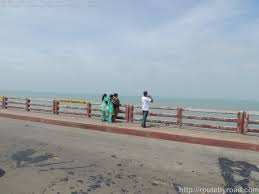 Sea front at Chennai[/caption]
Food is celebrated throughout Chennai. It has countless restaurants, cafes and roadside stands selling authentic Tamil food as well as other regional Indian food. Be aware of sanitation issues, of course, but sample broadly. This isn't a city for the fastidious diner. It's a place for unabashed gluttony.
Take for example the Tamil virundhu, a splendidly festive occasion where it is impolite to begin eating or to leave the table before anyone else. It’s usually a family social event, though business associates might get an invitation if they're lucky. Large banana leaves, or as they’re called here thali, are placed before each diner, the leaf tip pointing left and slightly upwards. If the meal is non-vegetarian, separate leaves will often be used for the grilled meats: chicken, fish or crabs.
[caption id="attachment_2818" align="alignnone" width="174"]
Sea front at Chennai[/caption]
Food is celebrated throughout Chennai. It has countless restaurants, cafes and roadside stands selling authentic Tamil food as well as other regional Indian food. Be aware of sanitation issues, of course, but sample broadly. This isn't a city for the fastidious diner. It's a place for unabashed gluttony.
Take for example the Tamil virundhu, a splendidly festive occasion where it is impolite to begin eating or to leave the table before anyone else. It’s usually a family social event, though business associates might get an invitation if they're lucky. Large banana leaves, or as they’re called here thali, are placed before each diner, the leaf tip pointing left and slightly upwards. If the meal is non-vegetarian, separate leaves will often be used for the grilled meats: chicken, fish or crabs.
[caption id="attachment_2818" align="alignnone" width="174"]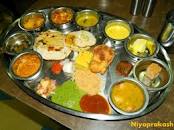 Full Thali[/caption]
Rice is added to the middle of the leaf when each guest is seated. Warm ghee or dahl is drizzled over the rice. Now everyone may begin to eat.
Sweets are eaten first to enliven the palate and are placed at the lower right of the leaf. This might be a small sampling of payasam, or sweet milky rice. (Fresh fruit is often served at the end of the meal to refresh after all the spice rich savoury courses.) At the top left is a pinch of salt or a pungent pickle, chutney or salad. In the middle will be fried banana chips, yams, potatoes, papads (deep-fried plain lentil flour crisps) or wafer-like appalams, (similar to papads but subtly spiced often with cumin, black pepper or garlic) or vadai (doughnut shaped fried savoury pastries) made from lentil, chickpea or rice flour. In the lower middle of the leaf will be a large mound of steamed rice and at the top right will be various curries: spicy, hot, sweet and sour and dry, rasam (tomato- and or tamarind-based soupy vegetable spice dishes often prepared with added lentils), koottu (like rasam but less soupy and usually with snake gourd or bitter gourd). Various sambars (highly spiced piquant and or pungent vegetable mixtures) finish off the top right of the thali leaf.
[caption id="attachment_2819" align="alignnone" width="266"]
Full Thali[/caption]
Rice is added to the middle of the leaf when each guest is seated. Warm ghee or dahl is drizzled over the rice. Now everyone may begin to eat.
Sweets are eaten first to enliven the palate and are placed at the lower right of the leaf. This might be a small sampling of payasam, or sweet milky rice. (Fresh fruit is often served at the end of the meal to refresh after all the spice rich savoury courses.) At the top left is a pinch of salt or a pungent pickle, chutney or salad. In the middle will be fried banana chips, yams, potatoes, papads (deep-fried plain lentil flour crisps) or wafer-like appalams, (similar to papads but subtly spiced often with cumin, black pepper or garlic) or vadai (doughnut shaped fried savoury pastries) made from lentil, chickpea or rice flour. In the lower middle of the leaf will be a large mound of steamed rice and at the top right will be various curries: spicy, hot, sweet and sour and dry, rasam (tomato- and or tamarind-based soupy vegetable spice dishes often prepared with added lentils), koottu (like rasam but less soupy and usually with snake gourd or bitter gourd). Various sambars (highly spiced piquant and or pungent vegetable mixtures) finish off the top right of the thali leaf.
[caption id="attachment_2819" align="alignnone" width="266"]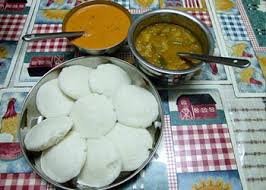 Vadai with rasam and dahl[/caption]
It is customary in Chennai, as it is throughout India to eat with the right hand. Keep the wrist loose, roll up any sleeves and dig in. Spoon whatever curry, rasam, koottu or sambar appeals into a portion of rice, scoop it up with the middle digits and thumb of the right hand and pop it into your mouth, making certain that it doesn't dribble down your arm or onto your neighbour's lap. It is something of a trick as the food is often quite runny. This is where the all-important rice is important as a sponge. Use the papads, appalams or vadai to help push the food into place and take small bites. Don't worry about not keeping up with other diners; no one will leave the table before everyone is finished. The waiters will continue to add more food to your thali as you begin to reduce the mounds of food.
[caption id="attachment_2820" align="alignnone" width="140"]
Vadai with rasam and dahl[/caption]
It is customary in Chennai, as it is throughout India to eat with the right hand. Keep the wrist loose, roll up any sleeves and dig in. Spoon whatever curry, rasam, koottu or sambar appeals into a portion of rice, scoop it up with the middle digits and thumb of the right hand and pop it into your mouth, making certain that it doesn't dribble down your arm or onto your neighbour's lap. It is something of a trick as the food is often quite runny. This is where the all-important rice is important as a sponge. Use the papads, appalams or vadai to help push the food into place and take small bites. Don't worry about not keeping up with other diners; no one will leave the table before everyone is finished. The waiters will continue to add more food to your thali as you begin to reduce the mounds of food.
[caption id="attachment_2820" align="alignnone" width="140"]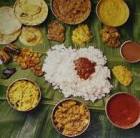 Typical Tamil Nadu virundhu[/caption]
Eventually everyone will begin to slow down and groan a bit. This is the signal that an end is in sight. Finally, rice with curds or buttermilk will be served to help digestion, then perhaps a small banana. Betel leaves or paan will be offered to guests to chew, and the virundhu is complete. Fingers and hands are washed and the banana leaves become food for the cows. I advise a long leisurely walk after a virundhu.
Meals are based on what Tamils regard as the six key tastes: sweet (milk, cream, butter or ghee, rice, honey, molasses sugar or jaggery), sour (citrus, limes, lemons, mango, tamarind and yoghurt), salty (salt or pickles), bitter (bitter gourd, fenugreek, turmeric, bitter greens), pungent (chillies, ginger, pepper, clove, mustard) and astringent (turmeric, beans, lentils, coriander and vegetables such as cabbage or cauliflower).
The masala dosa I eat after my long train trip incorporates the six elements, something I didn't note until hours later when I find a fruit juice stall where I take pause after my savoury dosa. I need re-hydration in this sweltering capital of Tamil Nadu. Luckily I find a juice stand where I can see the glasses washed in front of me in soapy water, a rarity for Chennai street stalls.
For breakfast or snacks between meals there is tiffin. This might be as simple as a masala dosa or idli (fermented and steamed rice) and urad (black lentil) dahl cakes served with sambar or chutney or puliyodarai (tamarind and rice fried together with spices, ground nuts, urad dahl, curry leaves, fenugreek and asofoetida). Murukku, fried urad dahl snacks, are prolific at street stalls. A traditional Tamil dessert is pongal, rice sweetened with coconut, raisins and almonds. Fresh juices such as mango, papaya, orange or pineapple are universally available from street vendors or cafes. Fresh sugar-cane juice flavoured with lime or orange is available in season.
Filtered coffee is a uniquely Chennai specialty, perhaps recalling the Arab connection from hundreds of years ago and quite unlike its bland filtered coffee cousins drunk in North America. Locally grown Arabica beans are dried, roasted and finely ground. Boiled water is added until the brew is deemed strong enough and is usually added to hot milk and sugar. Like Greek coffee, it's an acquired taste as the grounds are left settled in the bottom of the cup. The national drink is tea and is grown in the nearby Nilgiri Hills district.
[caption id="attachment_2821" align="alignnone" width="146"]
Typical Tamil Nadu virundhu[/caption]
Eventually everyone will begin to slow down and groan a bit. This is the signal that an end is in sight. Finally, rice with curds or buttermilk will be served to help digestion, then perhaps a small banana. Betel leaves or paan will be offered to guests to chew, and the virundhu is complete. Fingers and hands are washed and the banana leaves become food for the cows. I advise a long leisurely walk after a virundhu.
Meals are based on what Tamils regard as the six key tastes: sweet (milk, cream, butter or ghee, rice, honey, molasses sugar or jaggery), sour (citrus, limes, lemons, mango, tamarind and yoghurt), salty (salt or pickles), bitter (bitter gourd, fenugreek, turmeric, bitter greens), pungent (chillies, ginger, pepper, clove, mustard) and astringent (turmeric, beans, lentils, coriander and vegetables such as cabbage or cauliflower).
The masala dosa I eat after my long train trip incorporates the six elements, something I didn't note until hours later when I find a fruit juice stall where I take pause after my savoury dosa. I need re-hydration in this sweltering capital of Tamil Nadu. Luckily I find a juice stand where I can see the glasses washed in front of me in soapy water, a rarity for Chennai street stalls.
For breakfast or snacks between meals there is tiffin. This might be as simple as a masala dosa or idli (fermented and steamed rice) and urad (black lentil) dahl cakes served with sambar or chutney or puliyodarai (tamarind and rice fried together with spices, ground nuts, urad dahl, curry leaves, fenugreek and asofoetida). Murukku, fried urad dahl snacks, are prolific at street stalls. A traditional Tamil dessert is pongal, rice sweetened with coconut, raisins and almonds. Fresh juices such as mango, papaya, orange or pineapple are universally available from street vendors or cafes. Fresh sugar-cane juice flavoured with lime or orange is available in season.
Filtered coffee is a uniquely Chennai specialty, perhaps recalling the Arab connection from hundreds of years ago and quite unlike its bland filtered coffee cousins drunk in North America. Locally grown Arabica beans are dried, roasted and finely ground. Boiled water is added until the brew is deemed strong enough and is usually added to hot milk and sugar. Like Greek coffee, it's an acquired taste as the grounds are left settled in the bottom of the cup. The national drink is tea and is grown in the nearby Nilgiri Hills district.
[caption id="attachment_2821" align="alignnone" width="146"]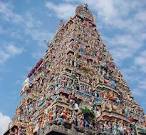 Chennai temple[/caption]
Chennai is packed with unexpected pleasures. Victorian Raj-era architecture mingles with ornate Dravidian Hindu temple buildings. The museums showcase Tamil culture. The visual arts are thriving: textiles, miniature paintings, local silks all come highly decorated. Tropical gardens offer needed diversions in this climate. Did I mention that Chennai is hot? The climate here varies between either hot and wet or hot and dry, according to the monsoon. Wear loose clothes and perambulate slowly. Luckily fresh sea breezes waft in from the Indian Ocean. Join the crowds at the shore. They’re there for good reason, to stay cool, be seen and to eat. I recommend a walk on the wild side in Chennai. Explore the densely populated streets and let your nose be your guide. If you're lucky you might find the city's best masala dosa. Tell Balaji I sent you.
Naked Facts:
Naked Eats:
The five-star hotels employ the best chefs in their signature Chennai Tamil restaurants, and the international hotels are reliable, though occasionally predictable and bland.
Chennai's seaside restaurants are where locals and tourists hang out. Fashions change faster than a Bollywood dance routine but the local crowds will lead you to the best places.
Avoid Western chain restaurants if you want authentic Tamil food and beware of empty dining rooms that promote western food. Usually they cater for tourists who wouldn't know an idli from a toasted sandwich, which incidentally is the worst item on any westernised Indian menu.
Use common sense: always look for fresh food and avoid dirty dining rooms. Chennai might not be India's cleanest city but good restaurants maintain proper sanitation standards.
[caption id="attachment_2822" align="alignnone" width="172"]
Chennai temple[/caption]
Chennai is packed with unexpected pleasures. Victorian Raj-era architecture mingles with ornate Dravidian Hindu temple buildings. The museums showcase Tamil culture. The visual arts are thriving: textiles, miniature paintings, local silks all come highly decorated. Tropical gardens offer needed diversions in this climate. Did I mention that Chennai is hot? The climate here varies between either hot and wet or hot and dry, according to the monsoon. Wear loose clothes and perambulate slowly. Luckily fresh sea breezes waft in from the Indian Ocean. Join the crowds at the shore. They’re there for good reason, to stay cool, be seen and to eat. I recommend a walk on the wild side in Chennai. Explore the densely populated streets and let your nose be your guide. If you're lucky you might find the city's best masala dosa. Tell Balaji I sent you.
Naked Facts:
Naked Eats:
The five-star hotels employ the best chefs in their signature Chennai Tamil restaurants, and the international hotels are reliable, though occasionally predictable and bland.
Chennai's seaside restaurants are where locals and tourists hang out. Fashions change faster than a Bollywood dance routine but the local crowds will lead you to the best places.
Avoid Western chain restaurants if you want authentic Tamil food and beware of empty dining rooms that promote western food. Usually they cater for tourists who wouldn't know an idli from a toasted sandwich, which incidentally is the worst item on any westernised Indian menu.
Use common sense: always look for fresh food and avoid dirty dining rooms. Chennai might not be India's cleanest city but good restaurants maintain proper sanitation standards.
[caption id="attachment_2822" align="alignnone" width="172"] Taj Coromandel hotel Chennai[/caption]
Recommended:
Bay View Point, Fisherman's Cove: Tamil fish and seafood specialties like mother would serve them at home. Phone +91 44 2747 2304.
Southern Spice, Taj Coromandel Hotel: This is Chennai's best in a superb location. Bill Clinton and Richard Gere have dined here. It's authentic and pricey. Reservations are necessary. Ask about a virundhu dinner. Phone +91 44 6600 2827.
Kaaraikudi: Traditional Tamil dining in a charming bungalow is perfect if you can't score an invitation to someone's home for true Tamil hospitality. Phone +91 44 826 9122.
Cooking schools:
Mrs Chandri Bhatt's Cooking Classes: She specialises in low-cholesterol Tamil cooking and is lots of fun. Phone +91 44 8211 434.
Malliki is Chennai's answer to Nigella Lawson, her cooking classes are popular on television. Phone +91 44 044 499 0872 or email spradeep@vsnl.com
Taj Coromandel hotel Chennai[/caption]
Recommended:
Bay View Point, Fisherman's Cove: Tamil fish and seafood specialties like mother would serve them at home. Phone +91 44 2747 2304.
Southern Spice, Taj Coromandel Hotel: This is Chennai's best in a superb location. Bill Clinton and Richard Gere have dined here. It's authentic and pricey. Reservations are necessary. Ask about a virundhu dinner. Phone +91 44 6600 2827.
Kaaraikudi: Traditional Tamil dining in a charming bungalow is perfect if you can't score an invitation to someone's home for true Tamil hospitality. Phone +91 44 826 9122.
Cooking schools:
Mrs Chandri Bhatt's Cooking Classes: She specialises in low-cholesterol Tamil cooking and is lots of fun. Phone +91 44 8211 434.
Malliki is Chennai's answer to Nigella Lawson, her cooking classes are popular on television. Phone +91 44 044 499 0872 or email spradeep@vsnl.com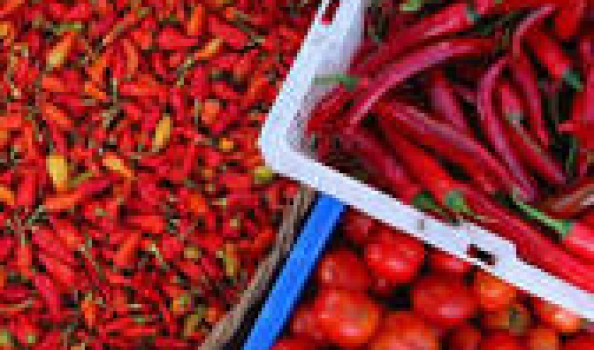 https://nakedhungrytraveller.com.au/jawing-on-javanese-food/ Jawing on Javanese Food
https://nakedhungrytraveller.com.au/jawing-on-javanese-food/ Jawing on Javanese FoodIndonesian food covers the flavour gamut, like the country itself it’s packed with worlds of difference.
The centre of this culinary universe is Jakarta, the biggest city and the country’s melting pot. [caption id="attachment_2825" align="alignnone" width="170"] Central Jakarta[/caption]
Indonesian food varies as much as the country itself. Six-thousand inhabited islands make for interesting noshing opportunities. The topography alone creates enormous differences in foodstuffs from the outright basic to the outrageously complex. There is a world of difference between a Javanese Rijsttafel and a plate of fried fish and taro from Irian Jaya. A Rijsttafel banquet served in a fashionable Jakarta restaurant, dozens of dishes, some with meat, some with seafood, some with fish, some vegetarian, some spicy, some mild, some creamy, some soupy but all intended to enhance a large platter of rice (Dutch: rijs, rice tafel, table Rijsttafel, rice table) poses a great difference to a bit of fresh tuna barbecued over coconut husks served with baked cassava eaten at a beach stall in Jayapura.
[caption id="attachment_2827" align="alignnone" width="186"]
Central Jakarta[/caption]
Indonesian food varies as much as the country itself. Six-thousand inhabited islands make for interesting noshing opportunities. The topography alone creates enormous differences in foodstuffs from the outright basic to the outrageously complex. There is a world of difference between a Javanese Rijsttafel and a plate of fried fish and taro from Irian Jaya. A Rijsttafel banquet served in a fashionable Jakarta restaurant, dozens of dishes, some with meat, some with seafood, some with fish, some vegetarian, some spicy, some mild, some creamy, some soupy but all intended to enhance a large platter of rice (Dutch: rijs, rice tafel, table Rijsttafel, rice table) poses a great difference to a bit of fresh tuna barbecued over coconut husks served with baked cassava eaten at a beach stall in Jayapura.
[caption id="attachment_2827" align="alignnone" width="186"]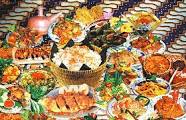 Typical Rijstaffel[/caption]
Constant to Indonesian cuisine are these ingredients: rice, tofu and tempeh, chillies, vegetables and a plethora of fruits, both tropical and temperate. Other staples are: Kecap Manis, Indonesian soy sauce and Ikan Bilis, fried and dried anchovies used as condiments, consumed universally from Medan to Ambon. Trasi or Belacan or Budu, depending on where in Indonesia you eat it, is a semi-solid fermented fish and/or shrimp paste with a flavour similar to Vietnamese Nuoc Mam or Thai Nam Pla. As a condiment which adds an umami (Japanese, meaning earthy, soy or truffle-like flavour) element to most dishes, particularly stir-fries, soups and stews, it is invaluable and also an important nutrient, rich in B vitamins and iodine. Its pungent aroma is quite head-clearing.
[caption id="attachment_2828" align="alignnone" width="185"]
Typical Rijstaffel[/caption]
Constant to Indonesian cuisine are these ingredients: rice, tofu and tempeh, chillies, vegetables and a plethora of fruits, both tropical and temperate. Other staples are: Kecap Manis, Indonesian soy sauce and Ikan Bilis, fried and dried anchovies used as condiments, consumed universally from Medan to Ambon. Trasi or Belacan or Budu, depending on where in Indonesia you eat it, is a semi-solid fermented fish and/or shrimp paste with a flavour similar to Vietnamese Nuoc Mam or Thai Nam Pla. As a condiment which adds an umami (Japanese, meaning earthy, soy or truffle-like flavour) element to most dishes, particularly stir-fries, soups and stews, it is invaluable and also an important nutrient, rich in B vitamins and iodine. Its pungent aroma is quite head-clearing.
[caption id="attachment_2828" align="alignnone" width="185"] Jakarta feast with satay[/caption]
Satay is ubiquitous; though it’s actually a Malay specialty, Indonesians claim equal rights to its origins. Real satay sauce must have fresh coconut cream and freshly ground peanuts. These are absolutely necessary. A good dousing of tamarind water is equally essential; its sour flavour counterpoints the sweet coconut and peanuts. Chillies should be freshly pounded in the mortar with lots of lemongrass and garlic added incrementally to the sauce as it begins to cook. Meats or fish or tofu should be marinated in lemongrass, chilli and garlic with a bit of soy sauce for a few hours before grilling. Coconut husk fire is best. Warm the satay sauce and ladle it on to the freshly cooked skewers. Freshly sliced cucumbers, chopped cabbage and carrot and quartered tomatoes are the usual accompaniments.
(Chef’s tip: If you make satay at home remember to soak the skewers in water for a few hours before threading whatever you’re grilling on to them first. It prevents burning on the open fire or grill.)
If you’re in search of good satay, let your nose guide you. Eschew all eateries that use bottled satay sauce.
Gado-Gado, the mixed salad of boiled eggs, lettuces, carrots, cabbage, bean sprouts, fried tofu or tempeh, lightly cooked green beans and boiled potatoes all smothered with satay sauce has saved many a vegetarian from sure starvation but I’ve yet to eat a Gado-Gado that didn’t make me think of ghastly lentil bakes and tofu surprise.
[caption id="attachment_2829" align="alignnone" width="163"]
Jakarta feast with satay[/caption]
Satay is ubiquitous; though it’s actually a Malay specialty, Indonesians claim equal rights to its origins. Real satay sauce must have fresh coconut cream and freshly ground peanuts. These are absolutely necessary. A good dousing of tamarind water is equally essential; its sour flavour counterpoints the sweet coconut and peanuts. Chillies should be freshly pounded in the mortar with lots of lemongrass and garlic added incrementally to the sauce as it begins to cook. Meats or fish or tofu should be marinated in lemongrass, chilli and garlic with a bit of soy sauce for a few hours before grilling. Coconut husk fire is best. Warm the satay sauce and ladle it on to the freshly cooked skewers. Freshly sliced cucumbers, chopped cabbage and carrot and quartered tomatoes are the usual accompaniments.
(Chef’s tip: If you make satay at home remember to soak the skewers in water for a few hours before threading whatever you’re grilling on to them first. It prevents burning on the open fire or grill.)
If you’re in search of good satay, let your nose guide you. Eschew all eateries that use bottled satay sauce.
Gado-Gado, the mixed salad of boiled eggs, lettuces, carrots, cabbage, bean sprouts, fried tofu or tempeh, lightly cooked green beans and boiled potatoes all smothered with satay sauce has saved many a vegetarian from sure starvation but I’ve yet to eat a Gado-Gado that didn’t make me think of ghastly lentil bakes and tofu surprise.
[caption id="attachment_2829" align="alignnone" width="163"]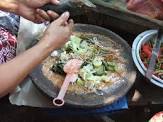 Preparing gado gado[/caption]
Bubur Ayam, or chicken porridge, is like congee but served with more accompaniments. As a breakfast treat after a night out on the turps, it’s a life saver.
[caption id="attachment_2830" align="alignnone" width="186"]
Preparing gado gado[/caption]
Bubur Ayam, or chicken porridge, is like congee but served with more accompaniments. As a breakfast treat after a night out on the turps, it’s a life saver.
[caption id="attachment_2830" align="alignnone" width="186"] Bubur ayam[/caption]
Rendang is another Indonesian success story in the international eating stakes. A rich stew usually made from beef it can also be made with goat, mutton, water buffalo, chicken, duck or jackfruit or cassava. Galangal, turmeric, ginger, chillies, lemongrass and coconut milk hold it all together and it’s served with rice.
When you truly believe that you couldn’t possibly eat another Nasi Goreng (fried rice) or fried Ayam (chicken), try refreshing your palate with Indonesia’s national salad, the Rujak. Made with chopped cucumber, jicama (yam bean), green apple, red papaya, pineapple, mango, chillies and flavoured with roasted peanuts, palm sugar and tamarind water, it’s a life saving palate cleanser and absolutely delicious.
The Best Soup:
Certainly Indonesians love their soups. Simple bowls of rice noodles in fish or chicken stock with trasi and some chopped greens, a bit of ikan bilis and a dash of chilli sambal and you’re right for the rest of the day. It’s cheap, satisfying in a way that only a good soup can be and it’s very wholesome. While appealing in their simplicity, I find most roadside stalls (warung) and street carts (kaki lima) serve somewhat dodgy soups. Beware of unwashed utensils, bowls and glasses. This could result in a meal that you won’t forget very quickly. Choose a restaurant or café or stall that is very busy, looks and smells clean and eat what most of the other diners are eating. The most popular and busiest warungs in Jakarta are near the market area of Old Batavia. Though this port district is sleazy and dirty, many inexpensive hotels cater to travellers here. Cheap and cheerful restaurants abound.
[caption id="attachment_2831" align="alignnone" width="142"]
Bubur ayam[/caption]
Rendang is another Indonesian success story in the international eating stakes. A rich stew usually made from beef it can also be made with goat, mutton, water buffalo, chicken, duck or jackfruit or cassava. Galangal, turmeric, ginger, chillies, lemongrass and coconut milk hold it all together and it’s served with rice.
When you truly believe that you couldn’t possibly eat another Nasi Goreng (fried rice) or fried Ayam (chicken), try refreshing your palate with Indonesia’s national salad, the Rujak. Made with chopped cucumber, jicama (yam bean), green apple, red papaya, pineapple, mango, chillies and flavoured with roasted peanuts, palm sugar and tamarind water, it’s a life saving palate cleanser and absolutely delicious.
The Best Soup:
Certainly Indonesians love their soups. Simple bowls of rice noodles in fish or chicken stock with trasi and some chopped greens, a bit of ikan bilis and a dash of chilli sambal and you’re right for the rest of the day. It’s cheap, satisfying in a way that only a good soup can be and it’s very wholesome. While appealing in their simplicity, I find most roadside stalls (warung) and street carts (kaki lima) serve somewhat dodgy soups. Beware of unwashed utensils, bowls and glasses. This could result in a meal that you won’t forget very quickly. Choose a restaurant or café or stall that is very busy, looks and smells clean and eat what most of the other diners are eating. The most popular and busiest warungs in Jakarta are near the market area of Old Batavia. Though this port district is sleazy and dirty, many inexpensive hotels cater to travellers here. Cheap and cheerful restaurants abound.
[caption id="attachment_2831" align="alignnone" width="142"] Jakarta soup peddlars, kaki lima[/caption]
The international embassy area contains Jakarta’s greatest concentration of shopping malls and slick chain restaurants. The usual deluxe hotels operate here too, air-conditioned and peaceful oasis in frantic and pedestrian unfriendly Jakarta. The Pasaraya Shopping Centre (Jl Iskandersyah ll/2, Blok M, Jakarta Selatan www.pasaraya.com) has its own gourmet food plaza located on the lower ground level. It’s very reasonably priced and offers a ‘suck it and see’ approach in immaculate surrounds.
The gargantuan Mall Taman Anggrek (Jl S. Parman West Jakarta www.taman-anggrek-mall.com) is a mini-city of shops, cafes and restaurants, all very schmick. If you fancy ice-skating in Jakarta, this is the place, I kid you not.
Of course the easiest way to avoid gastro-enteritis is to eat in a five-star hotel. In Jakarta, a five-star international hotel is not as expensive as it would be in Paris or Tokyo so this offers a plausible and safe alternative to the dodgy roadside stall. And you get clean cutlery. It’s how I found myself staying at the refurbished Hotel Indonesia Kempinski, itself a historic property as centrally and conveniently located as it’s possible to be in madhouse Jakarta. I was tired of walking on the wild side of town down near the funky wharf area that reeks of old ikan on its way to becoming trasi. Once I was ensconced in my refuge in Kempinski-world, I decided I was very hungry. Down to its buffet restaurant serving Indonesian food I went.
[caption id="attachment_2833" align="alignnone" width="176"]
Jakarta soup peddlars, kaki lima[/caption]
The international embassy area contains Jakarta’s greatest concentration of shopping malls and slick chain restaurants. The usual deluxe hotels operate here too, air-conditioned and peaceful oasis in frantic and pedestrian unfriendly Jakarta. The Pasaraya Shopping Centre (Jl Iskandersyah ll/2, Blok M, Jakarta Selatan www.pasaraya.com) has its own gourmet food plaza located on the lower ground level. It’s very reasonably priced and offers a ‘suck it and see’ approach in immaculate surrounds.
The gargantuan Mall Taman Anggrek (Jl S. Parman West Jakarta www.taman-anggrek-mall.com) is a mini-city of shops, cafes and restaurants, all very schmick. If you fancy ice-skating in Jakarta, this is the place, I kid you not.
Of course the easiest way to avoid gastro-enteritis is to eat in a five-star hotel. In Jakarta, a five-star international hotel is not as expensive as it would be in Paris or Tokyo so this offers a plausible and safe alternative to the dodgy roadside stall. And you get clean cutlery. It’s how I found myself staying at the refurbished Hotel Indonesia Kempinski, itself a historic property as centrally and conveniently located as it’s possible to be in madhouse Jakarta. I was tired of walking on the wild side of town down near the funky wharf area that reeks of old ikan on its way to becoming trasi. Once I was ensconced in my refuge in Kempinski-world, I decided I was very hungry. Down to its buffet restaurant serving Indonesian food I went.
[caption id="attachment_2833" align="alignnone" width="176"] Another sop buntut[/caption]
Before long I was chatting with one of the sous-chefs about Sop Buntut, the local oxtail soup. In a tropical country, this hot and hearty soup made from bones and meat that needs to be braised for hours, is both an anomaly and a life saver. I mean, how many nasi goreng, nasi lemak and satays can one human eat before taste overload overwhelms and a KFC begins to look like a plausible alternative for lunch?
Up to the plate, steps Sop Buntut. I’ve had it for breakfast, lunch and dinner and haven’t had the same soup twice.
[caption id="attachment_2832" align="alignnone" width="176"]
Another sop buntut[/caption]
Before long I was chatting with one of the sous-chefs about Sop Buntut, the local oxtail soup. In a tropical country, this hot and hearty soup made from bones and meat that needs to be braised for hours, is both an anomaly and a life saver. I mean, how many nasi goreng, nasi lemak and satays can one human eat before taste overload overwhelms and a KFC begins to look like a plausible alternative for lunch?
Up to the plate, steps Sop Buntut. I’ve had it for breakfast, lunch and dinner and haven’t had the same soup twice.
[caption id="attachment_2832" align="alignnone" width="176"]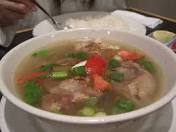 Sop buntut[/caption]
The Way to Sop Buntut:
This is by no means an authoritative recipe. Chef’s tip: Be generous with measurements as it keeps very well and the stock improves after a few days while the flavours set.
Start with a pot of fragrant broth made with oxtails, ginger, nutmeg, cloves and water. Once the broth has been clarified choose: carrots, shallots, leeks, celery stalks and leaves, tomatoes, potatoes and coriander. They are all part of the mix, but not always. Chef’s whim prevails. Sometimes the oxtails are seared in butter or oil first. Often they’re just thrown into the pot with a few knobs of crushed ginger, an array of spices and water. Bring the stock to a simmer, skim the rising scum and then add vegetables of your choice. Add rice noodles, fat ones or skinny ones, fresh or dried. Use the ones you prefer. If potatoes are added the rice noodles will be superfluous. Season the whole well with salt and black pepper.
At the Hotel Indonesia Kempinski my Sop Buntut also featured cardamom and a touch of cinnamon. I filled my bowl from the buffet’s gigantic stock-pot. The sous-chef was standing by watching me choose my additions: fried shallots, chopped fresh coriander, chilli sambal, some ikan bilis which weren’t necessary but raised an approving look from the sous-chef nonetheless, a drizzle of kecap manis and some finely chopped roasted peanuts. This Sop Buntut had rice noodles instead of potatoes, a bit of celery instead of carrots, a scattering of freshly diced tomatoes instead of tomato paste. After a thumbs-up from the enthusiastic sous-chef, I threw on some more chopped coriander and carried it back to my table.
The intense aroma of spice shot right to my inner nose, straight to the oldest part of the human brain, the part that senses smell. In short, mine was a visceral response. Was this the best Sop Buntut I’ve ever eaten?
After I finished the first bowl and had a second, I decided that it was.
Beware of pretenders to the Sop Buntut hall of fame. A few I’ve eaten have been ordinary. A hotel restaurant in Bandung offered bottled satay sauce as an accompaniment, a repellent prospect to be sure. Others have incorporated too many potatoes or carrots for my liking.
Sop Buntut should be redolent of spice and intense with umami from well braised oxtail meat and bone. It should be meaty and aromatic, restorative and nourishing. I like to see in my bowl of Sop Buntut a focal point of calm in crazy Jakarta. The spice draws me in, perfect for lingering.
Naked Drinks:
You know you’re in very secular Muslim Indonesia when you see Bintang t-shirts worn by locals, not just tourists wearing t-shirts that say ‘I’ve been wrecked on Bali’. The Dutch left behind not only their propensity for hearty eating (see Rijsttafel) but also for brewing. It’s where Heineken operates in the tropics and everyone drinks Bintang as a result. Yes, it’s cold and it’s quaffable but it’s not my favourite tipple. As with Foster’s or Budweiser, I leave it to the masses. Since 2005, a micro-brewery has operated in Denpasar called Storm Brewery. Though it’s still early days, this is a sign of good things to come. Storm’s beers are seriously good but few outlets outside Bali stock them.
Local spirits such as Arak and Tuak are made from palm fruit, sugar or coconuts. An aged Arak with tonic and fresh lime is as good as a rum, lime and soda or gin and tonic. Add fresh mint to it and you have your own Javanese Mojito.
Indonesia is the world’s third largest producer of coffee. The Javanese drink it strong and sweet, often with condensed milk. Of course, Kopi Luwak, made from beans which have run through the digestive tract of the Asian Palm civet, a cat like member of the weasel family which lives on Sumatra and Java, is famous for being the world’s most expensive coffee. Approximately 500 kilos of it is produced annually. The beans are cleaned and ground before brewing but it still has an edgy factor about it.
Tea is the preferred drink throughout Indonesia, served sweet and milky, like Indian chai but without the spice. Ginger tea is served at the end of most official religious feasts and is also widely available. Great for calming tummy rumbles.
Wine is imported into Indonesia. It’s very expensive and reserved for special occasions.
Naked Tips:
Indonesia is a tropical fruit lover’s paradise. Mangosteens, lychees, pineapples, melons, guava, custard apples, loquats, rambutan, soursops, salak (snakefruit), sawo (like a cross between mango and kiwifruit), mangos, papayas and bananas abound. Durian is a dare-devil’s proposition. It’s expensive but worth it. Just hold your nose upon first introduction. It stinks of carrion but tastes like mango, pineapple and banana custard.
Tom Neal Tacker travelled courtesy of Garuda Airlines and Jakarta Tourism Authority.
Naked Facts:
Garuda Indonesia Airlines flies direct to Jakarta from Amsterdam, Sydney and Melbourne. See www.garuda-indonesia.com
Hotel Indonesia Kempinski
Jl. MH Thamrin No 1 Jakarta 10310 Indonesia
Tel: +62 21 2358 3800 www.kempinski-jakarta.com
The Lara Jonggrang restaurant is housed in a historic renovated Javanese mansion and serves authentic Javanese cuisine, including a traditional Rijsttafel. Book ahead.
Jalan Teuku, Cik Di Tiro 4, Menteng Tel: +62 21 3153252
Sop buntut[/caption]
The Way to Sop Buntut:
This is by no means an authoritative recipe. Chef’s tip: Be generous with measurements as it keeps very well and the stock improves after a few days while the flavours set.
Start with a pot of fragrant broth made with oxtails, ginger, nutmeg, cloves and water. Once the broth has been clarified choose: carrots, shallots, leeks, celery stalks and leaves, tomatoes, potatoes and coriander. They are all part of the mix, but not always. Chef’s whim prevails. Sometimes the oxtails are seared in butter or oil first. Often they’re just thrown into the pot with a few knobs of crushed ginger, an array of spices and water. Bring the stock to a simmer, skim the rising scum and then add vegetables of your choice. Add rice noodles, fat ones or skinny ones, fresh or dried. Use the ones you prefer. If potatoes are added the rice noodles will be superfluous. Season the whole well with salt and black pepper.
At the Hotel Indonesia Kempinski my Sop Buntut also featured cardamom and a touch of cinnamon. I filled my bowl from the buffet’s gigantic stock-pot. The sous-chef was standing by watching me choose my additions: fried shallots, chopped fresh coriander, chilli sambal, some ikan bilis which weren’t necessary but raised an approving look from the sous-chef nonetheless, a drizzle of kecap manis and some finely chopped roasted peanuts. This Sop Buntut had rice noodles instead of potatoes, a bit of celery instead of carrots, a scattering of freshly diced tomatoes instead of tomato paste. After a thumbs-up from the enthusiastic sous-chef, I threw on some more chopped coriander and carried it back to my table.
The intense aroma of spice shot right to my inner nose, straight to the oldest part of the human brain, the part that senses smell. In short, mine was a visceral response. Was this the best Sop Buntut I’ve ever eaten?
After I finished the first bowl and had a second, I decided that it was.
Beware of pretenders to the Sop Buntut hall of fame. A few I’ve eaten have been ordinary. A hotel restaurant in Bandung offered bottled satay sauce as an accompaniment, a repellent prospect to be sure. Others have incorporated too many potatoes or carrots for my liking.
Sop Buntut should be redolent of spice and intense with umami from well braised oxtail meat and bone. It should be meaty and aromatic, restorative and nourishing. I like to see in my bowl of Sop Buntut a focal point of calm in crazy Jakarta. The spice draws me in, perfect for lingering.
Naked Drinks:
You know you’re in very secular Muslim Indonesia when you see Bintang t-shirts worn by locals, not just tourists wearing t-shirts that say ‘I’ve been wrecked on Bali’. The Dutch left behind not only their propensity for hearty eating (see Rijsttafel) but also for brewing. It’s where Heineken operates in the tropics and everyone drinks Bintang as a result. Yes, it’s cold and it’s quaffable but it’s not my favourite tipple. As with Foster’s or Budweiser, I leave it to the masses. Since 2005, a micro-brewery has operated in Denpasar called Storm Brewery. Though it’s still early days, this is a sign of good things to come. Storm’s beers are seriously good but few outlets outside Bali stock them.
Local spirits such as Arak and Tuak are made from palm fruit, sugar or coconuts. An aged Arak with tonic and fresh lime is as good as a rum, lime and soda or gin and tonic. Add fresh mint to it and you have your own Javanese Mojito.
Indonesia is the world’s third largest producer of coffee. The Javanese drink it strong and sweet, often with condensed milk. Of course, Kopi Luwak, made from beans which have run through the digestive tract of the Asian Palm civet, a cat like member of the weasel family which lives on Sumatra and Java, is famous for being the world’s most expensive coffee. Approximately 500 kilos of it is produced annually. The beans are cleaned and ground before brewing but it still has an edgy factor about it.
Tea is the preferred drink throughout Indonesia, served sweet and milky, like Indian chai but without the spice. Ginger tea is served at the end of most official religious feasts and is also widely available. Great for calming tummy rumbles.
Wine is imported into Indonesia. It’s very expensive and reserved for special occasions.
Naked Tips:
Indonesia is a tropical fruit lover’s paradise. Mangosteens, lychees, pineapples, melons, guava, custard apples, loquats, rambutan, soursops, salak (snakefruit), sawo (like a cross between mango and kiwifruit), mangos, papayas and bananas abound. Durian is a dare-devil’s proposition. It’s expensive but worth it. Just hold your nose upon first introduction. It stinks of carrion but tastes like mango, pineapple and banana custard.
Tom Neal Tacker travelled courtesy of Garuda Airlines and Jakarta Tourism Authority.
Naked Facts:
Garuda Indonesia Airlines flies direct to Jakarta from Amsterdam, Sydney and Melbourne. See www.garuda-indonesia.com
Hotel Indonesia Kempinski
Jl. MH Thamrin No 1 Jakarta 10310 Indonesia
Tel: +62 21 2358 3800 www.kempinski-jakarta.com
The Lara Jonggrang restaurant is housed in a historic renovated Javanese mansion and serves authentic Javanese cuisine, including a traditional Rijsttafel. Book ahead.
Jalan Teuku, Cik Di Tiro 4, Menteng Tel: +62 21 3153252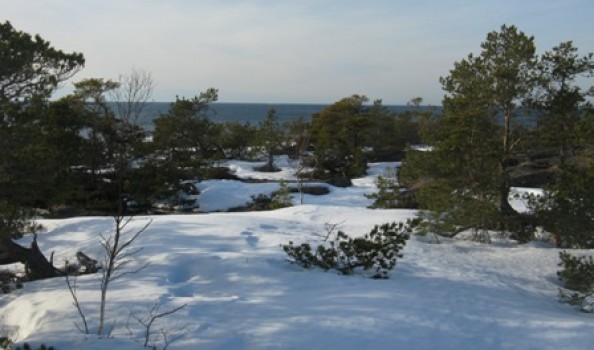 https://nakedhungrytraveller.com.au/from-stockholm-to-turku-via-aland/ From Stockholm to Turku via Aland
https://nakedhungrytraveller.com.au/from-stockholm-to-turku-via-aland/ From Stockholm to Turku via AlandHow to travel haphazardly from Stockholm to Turku during late winter in a few days? Try this itinerary for something different.
Stockholm:
Early Scandinavians were amongst the world’s most intrepid navigators. A visit to any one of Scandinavia’s capital cities will include an experience connected to water; it’s inevitable as the contemporary link to a seafaring past is enduring. One doesn’t exist without the other.
[caption id="attachment_2578" align="alignnone" width="189"] Stockholm coastline in winter[/caption]
Stockholm coastline in winter[/caption]
Stockholm is no exception of course. Its harbour is one of Europe’s loveliest and the city embraces the surrounding water to maximum benefit. A graceful metropolis and small scale despite the fact it’s Scandinavia’s largest.
[caption id="attachment_2586" align="alignnone" width="194"] Gamla Stan Stockholm overview[/caption]
Gamla Stan Stockholm overview[/caption]
Minimising my use of public transport, I decided to walk nearly everywhere in an attempt to see more from the pedestrian's view, usually from one museum or cafe or restaurant to another in an effort to keep warm.
Stockholm’s most important museums are centrally located, all within easy walking distance to one another so running between sights was minimal. I rocked up at each museum glowing, slightly breathless but comfortably thawed.
[caption id="attachment_2579" align="alignnone" width="169"]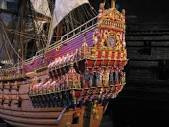 Stern of Vasa ship in Vasa Museum[/caption]
Stern of Vasa ship in Vasa Museum[/caption]
I’d heard about the Vasa Museum but I wasn’t prepared for such a surprise. It’s magnificent. I happily spent a whole day there fascinated by this great ship that never really went anywhere and was lost to time as the centuries passed. (See www.vasamuseet.se)
The Vasa is the only early 17th century ship ever to have been fully restored. With over 95% of the original timber still intact with recreated painted decorations looking as they did the day it launched, it’s like viewing living history. Designed by a Dutch master shipwright to act as Swedish king Gustav 2 Adolf’s flagship, the Vasa (the king’s family name) was intended to frighten opponents, in this instance the Poles for domination of the Baltic Sea.
But it was overmanned and over supplied with heavy cannons. The Vasa sank on its maiden voyage in 1628 about 1.2 kilometres (in the middle of Stockholm’s harbour) from where it was launched, an ignominious end to an embarrassingly short career.
[caption id="attachment_2580" align="alignnone" width="186"] Ship Vasa in its own museum[/caption]
Ship Vasa in its own museum[/caption]
After early efforts to salvage the sunken Vasa, within two centuries, the great ship was more or less lost in the depths of memory. Contemporary search methods helped to 'rediscover' the Vasa in the early 1950s. The ship was raised in 1961, its first time above the water line in 333 years.
Restoration took decades of painstaking work. The Vasa Museum opened in 1990. By 2004 a new climate control system was installed throughout the museum to stabilise temperature and humidity to protect the Vasa’s precious integrity.
Seeing the Vasa in its new home is humbling. How can it be otherwise? The beautiful ship can be witnessed as an example of supreme craftsmanship or simply as human folly.
They built something too big and overloaded it. Then it sank. Dozens of people drowned. A vast sum of money was wasted. The Swedish king took a huge hit to his prestige as did the Swedish navy.
Wandering the galleries surrounding the ship, I pondered all these facts but my thoughts were interrupted by two young men also discussing the sad fate of the Vasa. ‘It reminds me of Pirates of the Caribbean,’ said one. ‘Yeah, I can see Johnny Depp on the deck,’ added the other.
A curious fact about humanity: Everyone attempts to create a relative understanding to the extent of their knowledge and experience, in this instance a film series about cartoon pirates to a unique ship whose history is absolutely remarkable. So I was brought back to the present moment, a harsh reality. Two dunderheads making loud inane comments caused me to remember how something as grandiose and ill-conceived as the Vasa could have been built. Stupid human pride knows no boundaries does it?
This also reminded me why so many people visit somewhere and immediately make comparisons to what they already know, always looking for a link to what is familiar rather than just enjoying the difference for the sake of difference. ‘Those mountains look just like the ones near our place.’ ‘We’ve got the same stuff at home.’ ‘Why did I come all this way just to see what I see from my front window?’ All phrases I’ve overheard time and again. The repetition makes me sad.
Sadness appears inherent in Scandinavian psyche. Is there a more introspective, sensitive and aloof peoples on Earth?
While Swedes are notoriously depressive personality types, they’re also well recognised for letting their hair down when good food and strong drink are involved.
A trick of the travel trade I regularly put to effective use is to dine at a new city’s most innovative and best restaurant soon as possible, the first night in town if available. I did just this in Stockholm at Mathias Dahlgren’s eponymous restaurant in the posh Grand Hotel.
[caption id="attachment_2581" align="alignnone" width="182"]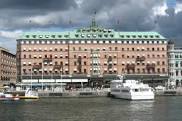 Grand Hotel in Stockholm[/caption]
Grand Hotel in Stockholm[/caption]
The food was divine of course. Two Michelin stars still occasionally mean something worth noting. Dahlgren’s food delivers cutting-edge Scandinavian cuisine along the lines of Rene Redzepi’s Noma in Copenhagen, if toned down somewhat to satisfy an average Swede’s natural tendency to conservatism. (See www.mathiasdahlgren.com)
[caption id="attachment_2582" align="alignnone" width="346"] Mathias Dahlgren restaurant interior[/caption]
Mathias Dahlgren restaurant interior[/caption]
Typically for such a respected restaurant, the waiters were excellent and well-informed. What I’ve learned is to ask the most tuned-in waiter where he or she eats on a night off. Invariably I’m supplied with a short list of a city’s most interesting and un-touristy restaurants/diners and an offer to make a booking on the spot for any subsequent nights I wish.
[caption id="attachment_2583" align="alignnone" width="134"] Rolf's Kok restaurant sign, a welcoming sight[/caption]
Rolf's Kok restaurant sign, a welcoming sight[/caption]
This is how I found Rolf’s Kok (Rolf’s Kitchen) in central Stockholm. Not as fancy or expensive (not by a long shot) as Mathias Dahlgren but the food was just as good, the service just as friendly and I enjoyed the whole experience even more. (See www.rolfskok.se)
[caption id="attachment_2584" align="alignnone" width="120"] Rolf's Kok interior[/caption]
Rolf's Kok interior[/caption]
My time in Stockholm was running short. I needed to get to Turku in Finland and then Helsinki to catch a flight onwards. I’d manage to walk the old town, Gamla Stan, from end to end without freezing to death. I’d visited the Royal Palace, the Swedish Economics Museum and the National Museum and I’d learned to use the underground metro trains without getting completely lost.
[caption id="attachment_2585" align="alignnone" width="178"] Gamla Stan buildings in Stockholm[/caption]
Gamla Stan buildings in Stockholm[/caption]
But the Baltic Sea was still icy. I wondered if I could ferry across it to Turku.
Aland:
‘Aland, where’s that?’ I ask. ‘An island between Sweden and Finland,’ I’m told by a Swedish tourism bureaucrat while discussing how I’ll travel between the two countries by boat during late winter. She raises her eyebrows at me as if to say, ‘Don’t you know anything?’
Admittedly, I knew next to nothing about Aland and its tiny capital town, Mariehamn, supposedly named after a Russian empress who liked the place so much her husband named the town after her in celebration of her fondness for its location. Later I discovered that wasn’t true.
What is true is that Aland is actually the name for the archipelago comprising some 6,550 tiny islands (many just rocky dots on a map called ‘skerries’) where over 90% of the 28,300 permanent inhabitants live on Fasta Aland (which means ‘Main Island’) where about 90% of those live in the island’s only sizable town, Mariehamn.
Aland’s name refers to the main island as well as the rest of the archipelago, which is governed by Finland (though it has autonomous status) and where the people speak Swedish.
Confused? I was.
As I learned more about this in-between island called island, I became increasingly interested.
In my opinion, any in-between place which is part of one country but doesn’t share that country’s language and which has gained semi-independence over the years because of demilitarisation and which now belongs essentially to no single country but is governed by its inhabitants in a quasi autonomous state has a lot to like about it.
Aland is close enough to Stockholm’s important harbour, Finland’s mainland and Russian/Prussian historic battles for domination over the Baltic Sea to have been hard fought over. Strategically, Aland is right in the middle of an old war zone. It was affirmed autonomy by the League of Nations in 1921 and effectively demilitarised shortly thereafter.
And I like the repetitive name: Aland (Island) Island. The root of the name Aland comes from Proto-Norse (Ahvaland) and means ‘Land of Water’.
Aland popped up from the shallow Gulf of Bothnia some 10,000 years ago, the blink of an eye geologically speaking. Fasta Aland is the biggest island in the group, granite in its northern reaches and alluvial sedimentary soil in the south where a bit of rich farming is worked on boggy land. The highest point in all of Aland, also on Fasta Aland, is Orrdals Hill which rises up 129 metres. These are low islands that hug the sea’s horizon, ‘Land of Water’ indeed.
[caption id="attachment_2587" align="alignnone" width="336"]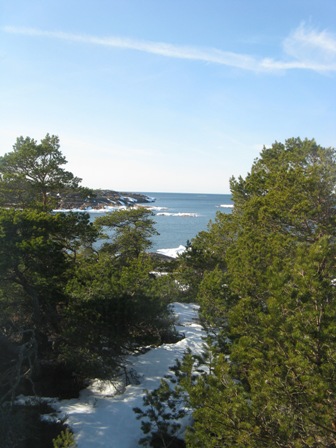 View from northern Aland over the Gulf of Bothnia[/caption]
View from northern Aland over the Gulf of Bothnia[/caption]
Mariehamn is a tidy town inhabited by comfortably well off residents. You know you’re in wintry Scandinavia when you’re surrounded by folk dressed snugly in goose down coats, fashionable boots and fur hats all looking very self-contained and disdainful as they march unsmilingly to business. Gross annual domestic product on Aland averages at about USD$56,000 per capita, so there’s money to be had in these islands.
You need money to live comfortably here. Goods and services on Aland average roughly 20% more expensive than mainland Sweden, which is already one of the world’s most expensive countries for travellers. Aland is a pricy place. No wonder everyone looks so smug.
Incomes are derived from tourism, shipping and retail profits from VAT free alcohol sales. The Viking Line ferry I was aboard, The Isabella, did a roaring trade in duty-free alcohol sales, the primary reason most of its passengers were travelling between Stockholm and Turku. Almost no one disembarked in Mariehamn. The majority of passengers remained on board ship to do their regular tax-free shopping.
Mariehamn was granted its name in 1861 by Tsar Alexander 2 in honour of his Tsarina. I’ve read that Maria Alexandrovna liked the location. I’ve also read that she never visited the place.
At any rate, the town was planned in Russian style with long boulevards and a waterside esplanade linking the two harbours that sideline the isthmus town’s borders. Streets in between follow a rigid grid pattern, perfect for funneling icy winds blowing straight down from the Arctic.
[caption id="attachment_2588" align="alignnone" width="186"] Mariehamn harbour in summer[/caption]
Mariehamn harbour in summer[/caption]
Mariehamn has a small history museum and art gallery that is worth exploring. I spent a couple hours there while idling around town. Admittedly I was the only idler to be seen. Winter is very low season on Aland. The town’s maritime museum is also interesting to gain an understanding of Aland’s quirky political history. The 19th century preserved sailing barque, 'The Pommern' is nearby and is also worth a look, particularly if you’re a sailor or nautical history buff. (See www.visitaland.com for details on the museums and hotel/restaurant recommendations.)
The town’s hotels looked very dour and resolutely unfriendly. According to the exceptionally helpful tourism bureaucrat I spoke with (desperately seeking advice as I’d made no plans and booked no hotel or restaurant), most of the town’s hotels open in winter were overpriced when Euros were measured against value. ‘So where do you recommend to stay,’ I ask?
‘There’s a place on the other side of the island that I recommend,’ she replied.
‘How do I get there?’
‘You go by taxi, there’s one still operating today, I’ll call him for you.’
Within fifteen minutes my bag is in the back seat and I’m driving through spruce forest, around ice cloaked lakes and picturesque little farms.
The driver says, ‘We have to watch for moose, but I don’t get many calls to go there in winter,’ he says, indicating how remote the other side of the island is and how rarely he ventures there. ‘They wander out of the forest at this time of year looking for food.’
I’m surprised moose live on Aland; it’s a long way from the mainland after all. ‘They walked here across the ice,’ he adds just as I was about to ask how moose came to be living on Aland.
I like this taxi driver. He’s friendly and exchanges information about his island home willingly.
‘The hotel you’re going to is supposed to be nice.’
‘You don’t know it,’ I ask?
‘I’ve never stayed there but people seem to like it.’
My one night on Aland takes a turn for the better. I’m not staying in austere and unfriendly appearing Mariehamn. Instead I’m on an adventure and staying at the only hotel on the far-flung northern side of the island thirty-seven kilometres from downtown Mariehamn.
As it happened, I’m glad I did. The Havs Vidden hotel occupies its own little peninsula overlooking the Bothnian Gulf. It’s small, exclusive and surprisingly connected to the whole world considering what I’d been led to believe by the taxi driver and Mariehamn tourist bureaucrats. I was half expecting to sleep in an igloo decked out with furs. Instead the hotel is all Scandinavian Contemporary design, lots of polished wood, fine fittings and simple style. (See www.havsvidden.com)
[caption id="attachment_2589" align="alignnone" width="336"]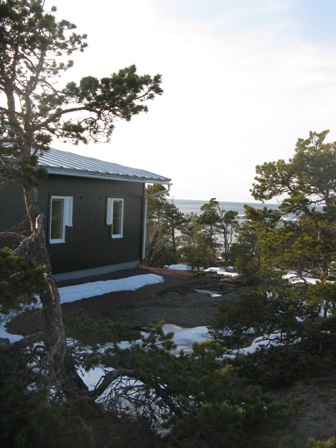 Outside room at Havs Vidden hotel Aland[/caption]
Outside room at Havs Vidden hotel Aland[/caption]
The Japanese and Scandinavians have a lot in common regards hotel room design. Form follows function is the rule. Authenticity is the modus operandi. Nothing is out of place or superfluous or sharp. Colour comes from outside, from the woods, water and sky. My room is wooden beige and I like the way it forces me to look out rather than in.
[caption id="attachment_2590" align="alignnone" width="175"] Havs Vidden room interior[/caption]
Havs Vidden room interior[/caption]
The Scandinavians have an ingrained affinity with nature. Their art and music is connected to it. To listen to a Sibelius symphony is to listen to the sounds of nature, birds whistling overhead, tree boughs cracking with ice, waves lapping against shoreline. You hear the picture.
My room is a cabin set in a patch of forest overlooking ice, snow and water. I’m all alone and I see no moose.
In this location, where nothing else is around, I’m lucky the hotel chef's cooking is delicious. I’m seated at my table by a lovely waitress who calls me by name. Offered an aperitif, subsequently told I’m to be served a three-course dinner. She sets the printed menu before me and asks if I can eat everything. ‘I think so, I’m hungry,’ I reply. ‘No, I mean have you allergies,’ she asks? ‘Only to bad food,’ which is my standard reply and one she understands.
I drank most of a bottle of Rioja while trying to enjoy my dinner in relative peace. (The owners are in residence, taking their dinner at a table near mine. They have a child who screams during most of the evening. The father cuddles the child but no one has the sense to remove it from the dining room so other guests can eat in peace.) After dinner I nursed a brandy in the lobby area near an open fire to contemplate life, liberty and the pursuit of demilitarisation far away from the loud spoiled child who should have been served a bowl of pasta in the kitchen out of earshot. Fortunately, the child’s shrieking didn’t negatively influence how I ultimately felt about the hotel.
Earlier I’d had a swim in the hotel’s indoor pool located in a spacious heated room with floor to ceiling windows overlooking the sea. I then sat in the sauna alone for a while, had a cold shower, dressed quickly and ran back across the snow and ice to my cabin and dressed for dinner. I slid-slipped across glistening ice covered wooden pathways to the candlelit dining room in the main building which serves as bar, reception and dining room, where I ate well, wrote notes and read my book.
This was one of those nights when I felt all had gone my way, despite one screaming kid. I’d spent my inheritance on the taxi to nowhere and on one night at the hotel on the edge of beyond just to feel truly far and away on Island Island Aland. I couldn’t have been happier, though the taxi fare back to Mariehamn the next morning was a reality shock.
Turku:
Following the one night on otherworldly Aland, by mid-afternoon I boarded another hardy Viking Line ice-breaking ferry to continue the passage across the lower Gulf of Bothnia to Turku, Finland’s old port, its former window on the world.
[caption id="attachment_2597" align="alignnone" width="178"] Turku in winter[/caption]
Turku in winter[/caption]
Previous visits to Finland prepared me for Finnish strangeness. For instance, Finns drink more milk per capita than any other nation, a curious fact. I’ve yet to discover why this is so. Finns love nothing more than to conduct business while slow roasting themselves nude in tiny wooden saunas. This I understand. Finland in winter is bleak and frigid. To sit naked in a hot box on a frigid winter’s day or night feels good. Finns are notorious for their truly ironic senses of humour. (What’s a Finnish joke? I don’t know, what’s a joke? Get it?) The language is of Finno-Ugraic origin, akin to Basque and Hungarian and therefore incomprehensible to linguistically challenged Romance Language speakers like me.
Finnish history is one of stalwart resistance to larger powers determined to put them out of existence i.e. Russia and Sweden. I admire the fact that Finland has survived intact past the 20th century. Finnish diplomacy has always metaphorically walked a tightrope of manipulation, acquiescence and courage under fire.
Finns make the Swedes look almost affable by comparison. Getting a Finn to crack a smile either requires a lot of booze or an innate comic ability akin to evincing a laugh at a North Korean Security Council meeting. Alcohol sold in Finland is horrendously expensive (when not bought VAT free in Aland) so coercing an unprompted laugh from a Finn can be a pricy undertaking.
Perhaps I’m being unfair. Many Finns I’ve met are warm souls keen to interact with strangers. Maybe I’m passing on stereotyped impressions?
[caption id="attachment_2592" align="alignnone" width="164"]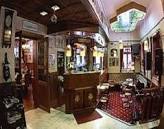 Park Hotel Turku lobby area[/caption]
Park Hotel Turku lobby area[/caption]
I stayed at the Park Hotel in Turku, a small-sized boutique hotel near the old cathedral and central to the old city centre. I liked the Park Hotel. (See www.parkhotelturku.fi) My room was small but cozy. I felt welcomed by all the hotel employees as an esteemed guest and not as a tax invoice.
[caption id="attachment_2591" align="alignnone" width="171"] Park Hotel facade Turku[/caption]
Park Hotel facade Turku[/caption]
Run by a local family, the mistress of the house gave me invaluable advice on where to dine during my one night in Turku, which is how I found the Rocca restaurant and where I enjoyed as fine a dinner as I had at vastly more expensive restaurants in Stockholm and Oslo. (See www.rocca.fi)
[caption id="attachment_2593" align="alignnone" width="192"]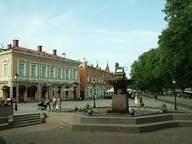 Rocca restaurant in Turku facade[/caption]
Rocca restaurant in Turku facade[/caption]
I really came to Turku to visit the Sibelius Museum. The great composer Jean Sibelius never lived in Turku (you can visit his home ‘Ainola’ outside Helsinki) but he did have a profound affect on the Turku Music Conservatorium which was instrumental in setting up the museum to the Finnish musical hero. (See www.abo.fi/fak/hf/musik/eng/museum/valkommen)
[caption id="attachment_2594" align="alignnone" width="172"] Turku cathedral in winter[/caption]
Turku cathedral in winter[/caption]
My visit to the Sibelius Museum was wonderful. I paid my 3 Euro entrance fee and chatted amiably to the young man who was running the reception desk. ‘You’re the only visitor,’ he informed me. ‘Do you want to hear anything in particular?’
‘What do you mean,’ I asked?
‘I can play on the loudspeaker system whatever you want to hear.’
Being the only visitor has its privileges obviously.
‘Okay, how about some of his more obscure violin pieces?’
‘Sure, I’ll put some on now,’ which is how it came to pass that I enjoyed the unique pleasure of having the Sibelius Museum all to myself while I wandered its galleries and displays filled with the master composer's instruments and copies of his scores all the while accompanied by a personalised soundtrack.
[caption id="attachment_2595" align="alignnone" width="190"] Sibelius Museum Turku facade[/caption]
Sibelius Museum Turku facade[/caption]
The greatest cathedral in all Finland is only 150 metres walk from the Sibelius Museum. For an hour, I sat alone in a back pew watching the late winter’s light play shadow tricks on stained glass windows while humming Sibelius tunes to myself.
[caption id="attachment_2596" align="alignnone" width="149"] Turku cathedral facade[/caption]
Turku cathedral facade[/caption]
Later that same day I caught a fast train to Helsinki then a bus connection to its airport, allowing plenty of time for rumination on how travelling in Scandinavia during late winter is rather a lovely thing to do.
Tom Neal Tacker visited Stockholm with assistance from Stockholm’s Tourist Authority.
Naked Routes:
The Viking Line ferries travel daily throughout the year (weather conditions permitting) between Stockholm and Turku with stops at Mariehamn. The trip takes approximately 12 hours, can be broken in half with an overnight stay in Mariehamn and is very scenic. The ship passes through Stockholm’s inner archipelago, its small forested islands sporting the favoured summer homes of the city’s elite. See www.vikingline.com
[caption id="attachment_2598" align="alignnone" width="182"]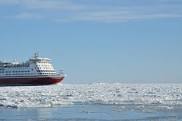 Viking Line ship Isabella plowing through ice[/caption]
Viking Line ship Isabella plowing through ice[/caption]
Naked Sleeps:
Stockholm’s First Hotel Amaranten is a centrally located modern hotel with about as much style as a Greyhound Bus Terminus. My key card opened a room that was already occupied. Open bags were on the bed and a make-up case was in the bathroom. Luckily the guest was not. Back at reception, I handed over the key card and said, ‘You’ve assigned me an occupied room.’ ‘No I haven’t,’ was the curt reply. The receptionist offered no immediate apology and tried to blame me for entering a room that was not mine. Alarmed at the obvious security risk the mistake clearly posed I repeated, ‘You’ve given me a room with someone already in it!’ She checked her computer records and said, ‘You’re correct. I’ll give you another room.’ Still no apology was offered. ‘I’ll upgrade you to another room.’ When I opened the door to the new room it was the same standard size and look as the one I’d be given before which was already occupied. I decided not to pursue the matter further. Sometimes it’s useless to fight a battle that’s already been lost. See www.firsthotels.com
[caption id="attachment_2599" align="alignnone" width="169"] First Hotel Amaranten facade[/caption]
First Hotel Amaranten facade[/caption]
Naked Tips:
Local resident adventure specialist Tomas Bergenfeldt runs a company aptly called Stockholm Adventures specialising in hiking, cycling and kayaking tours around Stockholm’s richly forested hinterland and idyllic inner archipelago. Had I visited Stockholm in spring, summer or autumn instead of winter, I would gladly have spent a couple days seeing Stockholm’s natural wonders from a bicycle or kayak seat as well as on foot. See www.stockholmadventures.com
[caption id="attachment_2601" align="alignnone" width="186"]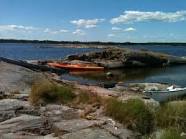 Stockholm Adventures day trip scenery in summer[/caption]
Stockholm Adventures day trip scenery in summer[/caption]
For more information about Stockholm’s many attractions, museums, special exhibitions, concerts, public transport and tickets, see www.visitstockholm.com
For more information about what to do and see in Turku, see www.visitturku.fi
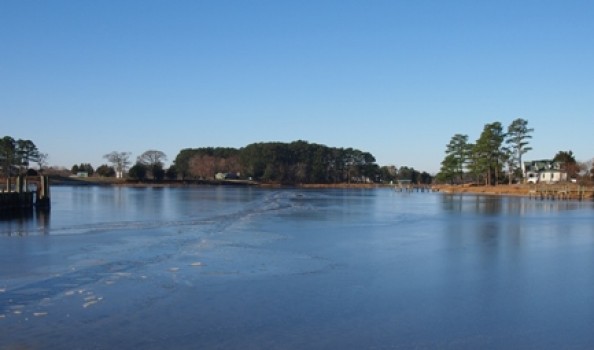 https://nakedhungrytraveller.com.au/americas-magical-bay/ America’s Magical Bay
https://nakedhungrytraveller.com.au/americas-magical-bay/ America’s Magical BayChesapeake Bay’s huge expanse of broad water and inlets has for centuries been Washington DC’s playground, the nation’s aquatic backdrop, its naval headquarters and unfortunately, a dumping ground for all kinds of industrial and agricultural waste.
Undergoing a renaissance and long delayed clean-up, now is the time to get back to the Bay and discover its backwater secrets. Morning mist lifts from the quiet waters off Deal Island. A Great Blue heron flaps its wings silently lifting its stilt like body into the air, constantly on the lookout for another soft shelled crab to flip into its long-beaked snout. A skipjack makes silent headway into the straits, readying its oyster dredge for another day’s fishing. Great flocks of ducks honk simultaneously while they signal a mass landing. Another autumnal morning on Chesapeake Bay evolves slowly. This bucolic scene repeats itself daily a mere hundred kilometres east of Washington DC. [caption id="attachment_2622" align="alignnone" width="202"]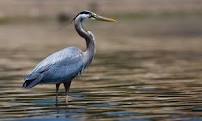 Great Blue Heron wading on Chesapeake Bay[/caption]
Sir Walter Raleigh explored the eastern coast of America for Queen Elizabeth 1 in 1584 and returned with tales of untold riches, safe harbours and rustic inhabitants. Captain John Smith followed in 1608 while he thoroughly explored the vastness of Chesapeake Bay, charting its shallow waters to establish a permanent colony at Jamestown in 1608. Here he met the princess Pocahontas and the first true American love story was begun.
Now, it is nearly impossible to imagine how Chesapeake (from an Algonquin Virginian Indian word meaning, ‘Greatest Water’) looked to Smith’s eyes. Descriptions of oyster shoals so immense that they rose from the water and posed hazards for passing ships are difficult to conceive today. Pristine clear water, washed perpetually pellucid from its northern headwaters at the mouth of the Susquehanna River’s drowned valley to its debouchment into the Atlantic Ocean at Cape Charles was a constant feature. The Bay extends 300 kilometres from north to south and expands nearly 50 kilometres to its widest point at the mouth of the Potomac River, the stories of crystal clear rivers feeding into the thriving estuary contrast completely with the murky waters seen later.
It remains however America’s largest marine estuary, a haven for wildlife and ships alike. A cradle of history and for centuries its most prolific fishery, the Bay has seen it all. Surrounded by rich agricultural lands as well as proliferating metropolitan centres, Chesapeake Bay’s water quality has suffered primarily due to nutrient runoff, mostly derived from nitrogen and phosphorus based fertilisers.
Deadly algal blooms in the 1970s were warning signs that the Bay was in dire straits, choking on the asphyxiating clouds of algae that sprouted from fertiliser runoff and industrial pollution. An ignominious end sped along by rampant, unchecked over-development of tidal marshes, the last refuges for fish hatcheries and water birds, was a real possibility. To make matters worse, over-fishing also contributed to the Bay’s ill health.
Oyster populations are estimated to be 2% of what they once were. The previously dense populations of oysters efficiently flushed clean the entire Bay in one day. Present numbers now take nearly one year to accomplish the same natural water filtration process.
Obviously rescue operations had become essential to the great Bay's immediate future. In 1983 the 'Chesapeake Bay Program' was created. Combining federal, state and local authorities in one decision-making body, this non-profit organisation helped to focus national attention on the Bay’s ecological plight. Further commitment was made in 2000 with the formation of the 'Chesapeake 2000' agreement which guided the Bay’s environmental restoration through to 2010.
The new agreement included New York, West Virginia and Delaware in this landmark plan that finally encompasses all the states in the Chesapeake Bay watershed. Strict controls are now in place regarding urban development, safeguarding wildlife breeding habitats and preventing further agricultural runoff into the Bay.
[caption id="attachment_2623" align="alignnone" width="170"]
Great Blue Heron wading on Chesapeake Bay[/caption]
Sir Walter Raleigh explored the eastern coast of America for Queen Elizabeth 1 in 1584 and returned with tales of untold riches, safe harbours and rustic inhabitants. Captain John Smith followed in 1608 while he thoroughly explored the vastness of Chesapeake Bay, charting its shallow waters to establish a permanent colony at Jamestown in 1608. Here he met the princess Pocahontas and the first true American love story was begun.
Now, it is nearly impossible to imagine how Chesapeake (from an Algonquin Virginian Indian word meaning, ‘Greatest Water’) looked to Smith’s eyes. Descriptions of oyster shoals so immense that they rose from the water and posed hazards for passing ships are difficult to conceive today. Pristine clear water, washed perpetually pellucid from its northern headwaters at the mouth of the Susquehanna River’s drowned valley to its debouchment into the Atlantic Ocean at Cape Charles was a constant feature. The Bay extends 300 kilometres from north to south and expands nearly 50 kilometres to its widest point at the mouth of the Potomac River, the stories of crystal clear rivers feeding into the thriving estuary contrast completely with the murky waters seen later.
It remains however America’s largest marine estuary, a haven for wildlife and ships alike. A cradle of history and for centuries its most prolific fishery, the Bay has seen it all. Surrounded by rich agricultural lands as well as proliferating metropolitan centres, Chesapeake Bay’s water quality has suffered primarily due to nutrient runoff, mostly derived from nitrogen and phosphorus based fertilisers.
Deadly algal blooms in the 1970s were warning signs that the Bay was in dire straits, choking on the asphyxiating clouds of algae that sprouted from fertiliser runoff and industrial pollution. An ignominious end sped along by rampant, unchecked over-development of tidal marshes, the last refuges for fish hatcheries and water birds, was a real possibility. To make matters worse, over-fishing also contributed to the Bay’s ill health.
Oyster populations are estimated to be 2% of what they once were. The previously dense populations of oysters efficiently flushed clean the entire Bay in one day. Present numbers now take nearly one year to accomplish the same natural water filtration process.
Obviously rescue operations had become essential to the great Bay's immediate future. In 1983 the 'Chesapeake Bay Program' was created. Combining federal, state and local authorities in one decision-making body, this non-profit organisation helped to focus national attention on the Bay’s ecological plight. Further commitment was made in 2000 with the formation of the 'Chesapeake 2000' agreement which guided the Bay’s environmental restoration through to 2010.
The new agreement included New York, West Virginia and Delaware in this landmark plan that finally encompasses all the states in the Chesapeake Bay watershed. Strict controls are now in place regarding urban development, safeguarding wildlife breeding habitats and preventing further agricultural runoff into the Bay.
[caption id="attachment_2623" align="alignnone" width="170"]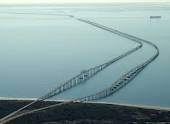 Chesapeake Bay Bridge & Tunnel connects sleepy Cape Charles to crowded Norfolk/Virginia Beach.[/caption]
For the casual traveller interested in exploring a part of America that is too often overlooked by international visitors, Chesapeake offers an intriguing insight into the heart of the nation. Far too large an area to explore in only one visit, I suggest that new visitors concentrate their time on the eastern shores of Maryland and Virginia with a side trip into Delaware to comprehend Chesapeake’s unique character.
[caption id="attachment_2624" align="alignnone" width="147"]
Chesapeake Bay Bridge & Tunnel connects sleepy Cape Charles to crowded Norfolk/Virginia Beach.[/caption]
For the casual traveller interested in exploring a part of America that is too often overlooked by international visitors, Chesapeake offers an intriguing insight into the heart of the nation. Far too large an area to explore in only one visit, I suggest that new visitors concentrate their time on the eastern shores of Maryland and Virginia with a side trip into Delaware to comprehend Chesapeake’s unique character.
[caption id="attachment_2624" align="alignnone" width="147"]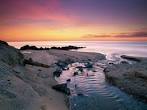 Chesapeake Bay sunset[/caption]
St. Michaels, nestled into a quiet inlet at the mid-section of the Bay is within a few hours drive from Washington DC. It’s a very good place in which to begin an exploration of Chesapeake's less developed side.
[caption id="attachment_2625" align="alignnone" width="184"]
Chesapeake Bay sunset[/caption]
St. Michaels, nestled into a quiet inlet at the mid-section of the Bay is within a few hours drive from Washington DC. It’s a very good place in which to begin an exploration of Chesapeake's less developed side.
[caption id="attachment_2625" align="alignnone" width="184"]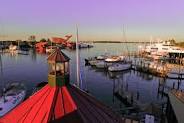 St Michaels' harbor scene[/caption]
The prolific author and long time resident of St. Michaels, James Michener, based himself in St. Michaels while he penned his authoritative history, simply entitled 'Chesapeake'. Though typically Michener-ian in its scope, thick as a doorstop and weighed down with sentences as long as the Chesapeake Bay Bridge & Tunnel, it’s still compulsory reading to gain a feeling for this special place.
St Michael's Chesapeake Bay Maritime Museum’s quirky displays help in understanding the Bay’s emergence as the nation’s first waterway. If children are involved, they will certainly enjoy being a sailor for a day. The Captain John Smith Water Trail is the U.S National Park’s first official water trail. Readily accessible sections of it are near St. Michaels on the Choptank River. Hire a canoe or kayak for a day’s exploration of the gently flowing tidal Choptank. It’s an opportunity to be Captain John Smith or Pocahontas for a day at least.
[caption id="attachment_2626" align="alignnone" width="177"]
St Michaels' harbor scene[/caption]
The prolific author and long time resident of St. Michaels, James Michener, based himself in St. Michaels while he penned his authoritative history, simply entitled 'Chesapeake'. Though typically Michener-ian in its scope, thick as a doorstop and weighed down with sentences as long as the Chesapeake Bay Bridge & Tunnel, it’s still compulsory reading to gain a feeling for this special place.
St Michael's Chesapeake Bay Maritime Museum’s quirky displays help in understanding the Bay’s emergence as the nation’s first waterway. If children are involved, they will certainly enjoy being a sailor for a day. The Captain John Smith Water Trail is the U.S National Park’s first official water trail. Readily accessible sections of it are near St. Michaels on the Choptank River. Hire a canoe or kayak for a day’s exploration of the gently flowing tidal Choptank. It’s an opportunity to be Captain John Smith or Pocahontas for a day at least.
[caption id="attachment_2626" align="alignnone" width="177"] Tilghman Island waterway scene[/caption]
Tilghman Island, connected to the mainland by an historic drawbridge, is quintessentially Chesapeake. Quiet and serene, it is a world unto itself. A small fleet of skipjacks, a Chesapeake invention that replaced the barge-like 'Bugeye' oyster boat as the best means in which to dredge for oysters, operates from Tilghman Island’s main harbour. Skipjacks occupy a special place in Chesapeake’s maritime history. Even today motorised boats are prohibited from dredging for oysters. Only sail powered skipjacks are allowed, a link to shipwright skills mostly lost in this era of contemporary steel and fiberglass speedboats.
[caption id="attachment_2627" align="alignnone" width="163"]
Tilghman Island waterway scene[/caption]
Tilghman Island, connected to the mainland by an historic drawbridge, is quintessentially Chesapeake. Quiet and serene, it is a world unto itself. A small fleet of skipjacks, a Chesapeake invention that replaced the barge-like 'Bugeye' oyster boat as the best means in which to dredge for oysters, operates from Tilghman Island’s main harbour. Skipjacks occupy a special place in Chesapeake’s maritime history. Even today motorised boats are prohibited from dredging for oysters. Only sail powered skipjacks are allowed, a link to shipwright skills mostly lost in this era of contemporary steel and fiberglass speedboats.
[caption id="attachment_2627" align="alignnone" width="163"] Tilghman Island skipjack bows and ducks[/caption]
The other place in which to see skipjacks at work is at Deal Island’s Wenona town harbour, where I inquire casually about sailing on one. My grizzled, salt-weathered respondent is laconic. 'You can just hire one at the wharf over there (pointing gruffly over his right shoulder) if you ask nicely. Or you can wait for the regatta. I’d take you out myself but you’d have to work hard or just pay me a lot of money.' This is typical Chesa-speak: direct, no-nonsense and to the point, very humorous too if you’re patient and have no expectations.
[caption id="attachment_2628" align="alignnone" width="187"]
Tilghman Island skipjack bows and ducks[/caption]
The other place in which to see skipjacks at work is at Deal Island’s Wenona town harbour, where I inquire casually about sailing on one. My grizzled, salt-weathered respondent is laconic. 'You can just hire one at the wharf over there (pointing gruffly over his right shoulder) if you ask nicely. Or you can wait for the regatta. I’d take you out myself but you’d have to work hard or just pay me a lot of money.' This is typical Chesa-speak: direct, no-nonsense and to the point, very humorous too if you’re patient and have no expectations.
[caption id="attachment_2628" align="alignnone" width="187"] Deal Island town street scene[/caption]
Deal Island is also a notable Wildlife Management Area famed for its water bird population. Impressive numbers of indigenous birds make their home here and it’s a safe rest stop on the Eastern Seaboard Flyway for migratory species from far away as Patagonia or the Arctic. Wenona hosts annual skipjack races in early September. It’s also a busy soft-shelled crabbing town whose businesses export crabs all over the world.
[caption id="attachment_2629" align="alignnone" width="161"]
Deal Island town street scene[/caption]
Deal Island is also a notable Wildlife Management Area famed for its water bird population. Impressive numbers of indigenous birds make their home here and it’s a safe rest stop on the Eastern Seaboard Flyway for migratory species from far away as Patagonia or the Arctic. Wenona hosts annual skipjack races in early September. It’s also a busy soft-shelled crabbing town whose businesses export crabs all over the world.
[caption id="attachment_2629" align="alignnone" width="161"]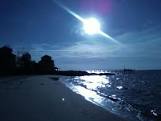 Deal Island beach scene[/caption]
For a dip into another world, with its busy beaches and restaurants, spend a day or evening in Rehoboth Beach just 90 minutes drive to the east of St. Michaels on the Delaware shore. Seductively positioned near-yet-far from Chesapeake Bay, Rehoboth’s sea breezes may come as a surprise when the Bay itself swelters under a relentless summer sun.
Well known for its thriving gay/lesbian scene, Rehoboth is also Washington DC’s party route to the sea. Clubs hum, cafes buzz and restaurants shimmer during the hot summer season.
But Rehoboth isn't all about sex and sun. Quiet beaches stretch into the horizon and though the water is chilly, the swimming is safe at patrolled areas. Rehoboth has the Delmarva Peninsula (the spike of land that juts into the Atlantic Ocean, forming the eastern boundary of Chesapeake), at its back, an abbreviated amalgamation of three state’s names: Delaware, Maryland and Virginia. It is easily the trendiest town between Miami and New York.
[caption id="attachment_2631" align="alignnone" width="182"]
Deal Island beach scene[/caption]
For a dip into another world, with its busy beaches and restaurants, spend a day or evening in Rehoboth Beach just 90 minutes drive to the east of St. Michaels on the Delaware shore. Seductively positioned near-yet-far from Chesapeake Bay, Rehoboth’s sea breezes may come as a surprise when the Bay itself swelters under a relentless summer sun.
Well known for its thriving gay/lesbian scene, Rehoboth is also Washington DC’s party route to the sea. Clubs hum, cafes buzz and restaurants shimmer during the hot summer season.
But Rehoboth isn't all about sex and sun. Quiet beaches stretch into the horizon and though the water is chilly, the swimming is safe at patrolled areas. Rehoboth has the Delmarva Peninsula (the spike of land that juts into the Atlantic Ocean, forming the eastern boundary of Chesapeake), at its back, an abbreviated amalgamation of three state’s names: Delaware, Maryland and Virginia. It is easily the trendiest town between Miami and New York.
[caption id="attachment_2631" align="alignnone" width="182"]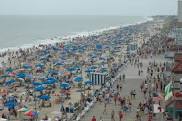 Rehoboth Beach boardwalk in summer, great if you like crowds[/caption]
Sample the town’s art galleries, cafes and bars to see what happens when Washingtonians let their bureaucratically controlled hair down. At one of the popular clubs a bartender says to me, 'We make the strongest Margaritas north of Mexico but ours are more expensive probably.' I admire his honesty. During the summer's gay/lesbian festival, one of the most popular events is 'Drag Beach Volleyball' played right downtown in front of the busiest section of the boardwalk. Kids love this event. Why is it that small children and large drag queens share the biggest laughs?
[caption id="attachment_2630" align="alignnone" width="181"]
Rehoboth Beach boardwalk in summer, great if you like crowds[/caption]
Sample the town’s art galleries, cafes and bars to see what happens when Washingtonians let their bureaucratically controlled hair down. At one of the popular clubs a bartender says to me, 'We make the strongest Margaritas north of Mexico but ours are more expensive probably.' I admire his honesty. During the summer's gay/lesbian festival, one of the most popular events is 'Drag Beach Volleyball' played right downtown in front of the busiest section of the boardwalk. Kids love this event. Why is it that small children and large drag queens share the biggest laughs?
[caption id="attachment_2630" align="alignnone" width="181"] Downtown Rehoboth in summer overview[/caption]
South of Rehoboth and well past tacky-touristy Ocean City (avoid this ugly mini-city of strip malls packed with cheap souvenir shops), the Delmarva Peninsula narrows as it separates the Bay from the Ocean and towns diminish in size and number. Quietude reigns again. Take time to explore the tiny settlements, their churches and curiously compelling cemeteries filled with weathered gravestones and memories of religious refugees searching for hope in new lands.
[caption id="attachment_2633" align="alignnone" width="181"]
Downtown Rehoboth in summer overview[/caption]
South of Rehoboth and well past tacky-touristy Ocean City (avoid this ugly mini-city of strip malls packed with cheap souvenir shops), the Delmarva Peninsula narrows as it separates the Bay from the Ocean and towns diminish in size and number. Quietude reigns again. Take time to explore the tiny settlements, their churches and curiously compelling cemeteries filled with weathered gravestones and memories of religious refugees searching for hope in new lands.
[caption id="attachment_2633" align="alignnone" width="181"]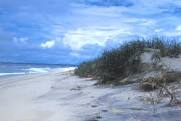 Assateague beach scene[/caption]
The Assateague Island National Park, just across the bridge from charming little Chincoteague town, is well known for its herds of feral ponies, made famous in Marguerite Henry’s renowned children’s book 'Misty of Chincoteague'.
[caption id="attachment_2634" align="alignnone" width="190"]
Assateague beach scene[/caption]
The Assateague Island National Park, just across the bridge from charming little Chincoteague town, is well known for its herds of feral ponies, made famous in Marguerite Henry’s renowned children’s book 'Misty of Chincoteague'.
[caption id="attachment_2634" align="alignnone" width="190"]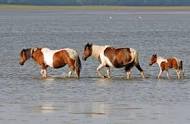 Chincoteague ponies wading[/caption]
Ponies were released by shipwrecked sailors hundreds of years ago and gradually established breeding herds unique to the area. The annual Pony Swim from Chincoteague to Assateague islands exemplifies the adaptability of the native ponies; they’re like ducks to water. The beaches at Assateague are splendid: windswept, awe-inspiring and lonely.
[caption id="attachment_2632" align="alignnone" width="176"]
Chincoteague ponies wading[/caption]
Ponies were released by shipwrecked sailors hundreds of years ago and gradually established breeding herds unique to the area. The annual Pony Swim from Chincoteague to Assateague islands exemplifies the adaptability of the native ponies; they’re like ducks to water. The beaches at Assateague are splendid: windswept, awe-inspiring and lonely.
[caption id="attachment_2632" align="alignnone" width="176"]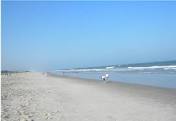 Assateague ocean beach[/caption]
Assateague ocean beach[/caption]
Tiny Onancock, (Pronounced ‘Oh-NAN-cock’. Don’t make the same mistake I did when stopping in a cafe to ask for directions to ‘ON-An-Cock’. I was politely corrected despite being given a harsh look) is Eastern Shore Virginia’s loveliest town. Blessed with a quiet and secluded harbour, two intersecting main streets lined with a small yet interesting assortment of shops, boasting two good restaurants (Bezzotto’s and The Charlotte Hotel restaurant) and graced with lovingly restored Victorian houses, here is where the description ‘quiet backwater’ can be best applied.
[caption id="attachment_2635" align="alignnone" width="448"] Onancock Market St at corner of King St[/caption]
Onancock Market St at corner of King St[/caption]
Chesapeake charm, too far from the big cities to attract day-tripping crowds and holiday house owners. There’s a strong sense of community here, largely due to this part of Virginia often being ignored by state legislators across the big Bay and far away in Richmond. [caption id="attachment_2648" align="alignnone" width="404"]
 Onancock harbour authority building[/caption]
Onancock harbour authority building[/caption]
At the end of the road at the great bay’s final exit into the Atlantic sits Cape Charles. One of the region’s most historic towns, where history is as common as crab cakes, this is indeed something to boast about. Cape Charles is an excellent place to hang back and relax in the sweetly somnolent atmosphere. It has one of the most extensive arrays of Victorian architecture on the East Coast and is mostly overlooked by the crowds rushing up and down the interstate highways over the Bay to the west.
[caption id="attachment_2637" align="alignnone" width="195"]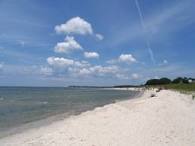 Cape Charles bayside beach[/caption]
Cape Charles bayside beach[/caption]
In fact, Cape Charles is a good place to watch the sun set over the water, an unusual claim to make on the eastern seaboard of the USA if you're not on Florida's Gulf Coast.The Cape Charles Museum and Welcome Center is inviting and useful to gain further insight into the origin of the town. When I ask a center volunteer about Cape Charles’ architectural heritage she hands me a map and tells me to 'Wander around a while and soak in the feel of the town. We’re not like any other place in Virginia. We’re special, kind of remote and most people who find us really want to be here.'
[caption id="attachment_2638" align="alignnone" width="177"]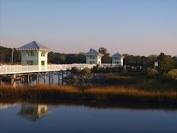 Bridge over wetlands at Cape Charles[/caption]
Bridge over wetlands at Cape Charles[/caption]
The nearby Virginia National Wildlife Refuge is another jewel in the Chesapeake crown for birdwatchers and wildlife enthusiasts, as is the Kiptopeke State Park, well known for its population of hawks and waterfowl.
Perhaps Cape Charles is an appropriate town in which to contemplate why Chesapeake Bay exists as it does today. Unlike other drowned river valleys scattered about the globe that make up the world’s great bays, Chesapeake was formed by a cataclysmic event that occurred approximately 35.5 million years ago during the Eocene Epoch. A bolide, (meaning large asteroid or comet), more than a mile wide plunged into the water just off Cape Charles. Travelling at a speed estimated to be 113,000 kilometres per hour, it obliterated all life on the east coast of America at the time. Billions of tonnes of ocean water were propelled upwards and vaporised. Millions of tonnes of rocks and debris were ejected into the atmosphere. The impact crater plunged hundreds of feet below the earth’s surface and remained hidden until scientists discovered it in 1983 when studying satellite images.
Fossil remains have been subjects of fascination since Chesapeake Bay was discovered by Europeans over four hundred years ago. The Algonquin tribes that occupied the region for millennium must have been equally intrigued by the number of prehistoric creatures embedded in calcified rocks sticking out of the Bay’s many cliffs and ledges.
[caption id="attachment_2639" align="alignnone" width="179"]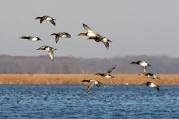 Ducks in flight over Chesapeake Bay[/caption]
Ducks in flight over Chesapeake Bay[/caption]
Chesapeake Bay has had a powerful impact on America, not because it was formed by one of the greatest explosions ever recorded in the history of the Earth, but also because it witnessed the birth of a nation, fed its earliest inhabitants, created untold riches for innumerable families and provided homes to countless species of fish, waterfowl and other animals. The Algonquin people got the name right; it is simply the ‘Greatest Water’.
Naked Facts:
Naked Sleeps:
[caption id="attachment_2640" align="alignnone" width="190"] Inn at Onancock street-facing facade[/caption]
Inn at Onancock street-facing facade[/caption]
The Inn at Onancock is an absolute delight. Owner operated, immaculately clean, well-appointed and to-die-for breakfasts make this small guesthouse the best place to stay in the whole lower Delmarva Peninsula. The drinks and canapes served each evening provide guests an excellent opportunity to exchange travel tips. The owners are always on hand, offering advice and suggestions about the region. They're a wealth of local knowledge. See www.innatonancock.com [caption id="attachment_2641" align="alignnone" width="209"]
 Typical guestroom at Inn at Onancock[/caption]
Typical guestroom at Inn at Onancock[/caption]
Naked Tips:
For more information about Cape Charles and Onancock see www.capecharles.org or www.onancock.org
For more information about Chesapeake's national park system and waterways including the Choptank River see www.nps.gov/cajo/
Chesapeake Bay is a year-round destination, though summer is easily the most popular time and consequently very crowded. Winters may be very cold though clear days and nights make it a special season with the least number of visitors. Mid-summer temperatures are often very hot with high humidity but onshore breezes from both the ocean and bay help relieve the heat. Spring and Autumn are typically the best seasons.
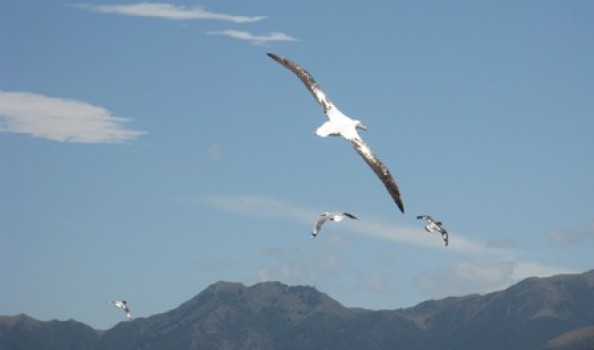 https://nakedhungrytraveller.com.au/kaikoura-capers/ Kaikoura Capers
https://nakedhungrytraveller.com.au/kaikoura-capers/ Kaikoura CapersKaikoura, the town where the mountains meet the sea on the east coast of New Zealand’s South Island has attained a well-deserved reputation for eco-tourism.
Best known for easy proximity to Sperm whales, where throughout the year the habitat is nigh on perfect to attract frequent visits of these ocean wanderers to the abyss just offshore. A geological oddity, Kaikoura’s deep underwater canyon provides the necessary conditions for regular giant squid and Sperm whale interaction.
[caption id="attachment_2551" align="alignnone" width="448"] Sperm whale and fellow passenger during Whale Watching Tour off Kaikoura.[/caption]
Sperm whale and fellow passenger during Whale Watching Tour off Kaikoura.[/caption]
The ocean floor plummets over 1,000 metres only a few kilometres from Kaikoura’s beach and tiny harbour. Sperm whales hunt while travellers needn’t venture far offshore to watch them surface in between deep dives for tasty squid and fish.
[caption id="attachment_2552" align="alignnone" width="448"]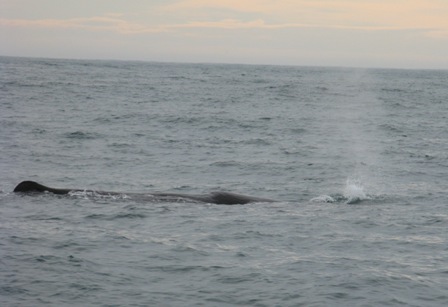 Sperm whale breathing off Kaikoura[/caption]
Sperm whale breathing off Kaikoura[/caption]
The huge population of local dusky dolphins and visiting seabirds that inhabit the area taking advantage of the abundance of seafood are added wildlife drawcards.
[caption id="attachment_2553" align="alignnone" width="185"]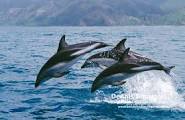 Dusky dolphins leaping[/caption]
Dusky dolphins leaping[/caption]
In a day, I ventured twice to the waters off Kaikoura’s spectacular coastline, first to mingle during a whale watching tour amongst a pod of young male Sperm whales as they repeatedly sounded between deep dives.
[caption id="attachment_2554" align="alignnone" width="448"]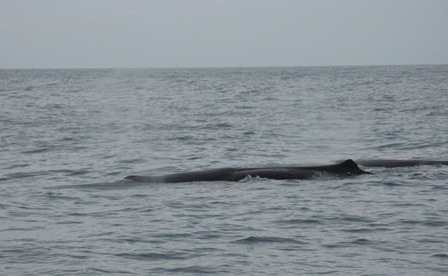 Two Sperm whales off Kaikoura[/caption]
Two Sperm whales off Kaikoura[/caption]
The planet’s largest carnivores (Moby Dick should ring a literary note) aren’t as frisky on the surface as Southern Humpback whales but what they may lack in acrobatic skills they make up for in sheer presence. Encountering these ocean wanderers is a rare occurrence. Kaikoura is one of the few places where sightings are dependable (the Azores islands in the mid-Atlantic is another).
Kaikoura is unique in that deep water is so close to shore. In fewer than thirty minutes leaving the town’s harbour, whales are seen lolling at the surface refilling their lungs and oxygenating their blood before the next plunge downwards.
[caption id="attachment_2555" align="alignnone" width="448"] Kaikoura coastline[/caption]
Kaikoura coastline[/caption]
While I know Melville’s tale of the great white whale was based on an apocryphal story and likely exaggerated to suit the plot, I loved his book as much for its telling of the mythical whale as I did for the human allegory. ‘Call me Ishmael’ as metaphor but call me Tom when it comes to admiring rare leviathans.
The morning began misty and cool, ideal for whale watching. The weather cleared by midday and the sun appeared for the day’s next excursion, an albatross tour.
[caption id="attachment_2556" align="alignnone" width="448"]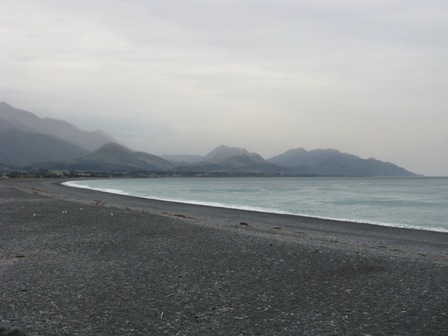 Beach at Kaikoura before whale watching tour[/caption]
Beach at Kaikoura before whale watching tour[/caption]
The whale-watching tour boat was crowded and noisy. The smaller albatross watching tour boat was nearly empty and quiet.
What does this say about comparable attractions? Whale watching is big business that has crossed over into mass tourism. Albatross watching is by contrast, new business that caters to aficionados.
[caption id="attachment_2557" align="alignnone" width="336"]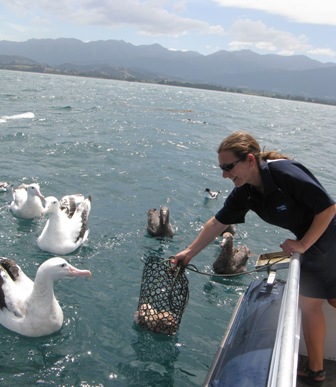 Feeding time during Albatross tour, with Wandering albatross[/caption]
Feeding time during Albatross tour, with Wandering albatross[/caption]
Sadly, the world’s albatross are at peril. Long-ling fishing continues to decimate global populations (despite improved fishing hooks that release caught albatross) and ongoing loss of habitat due to increased human populations plagues nesting colonies. Global warming and reduced fishing stocks add more pressure to these magnificent birds and their ability to breed fast enough to recover.
[caption id="attachment_2558" align="alignnone" width="389"]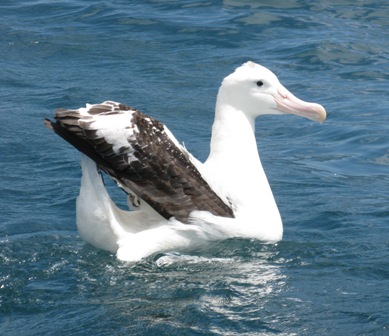 Young Wandering albatross[/caption]
Young Wandering albatross[/caption]
To see a Wandering albatross in flight is as rare an occurrence as seeing a Sperm whale lift its tail as it dives into the depths.
The Wandering albatross has the longest wingspan of any bird while its body is twice the size of a goose.
[caption id="attachment_2559" align="alignnone" width="448"]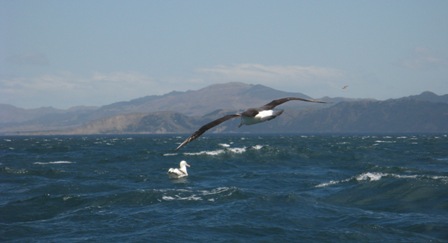 Wandering albatross in flight[/caption]
Wandering albatross in flight[/caption]
In short, it’s a bloody big bird with a menacing hooked beak that could lop off my hand if it came too close.
[caption id="attachment_2560" align="alignnone" width="362"] Wandering albatross and other seabirds battling over bait box[/caption]
Wandering albatross and other seabirds battling over bait box[/caption]
Just off Kaikoura, it’s possible to get up close and personal with a Sperm whale and a Wandering albatross all in the space of one day.
[caption id="attachment_2562" align="alignnone" width="336"]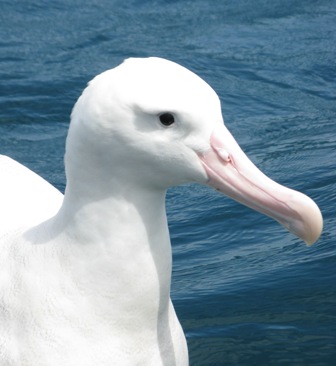 Wandering albatross up close[/caption]
Wandering albatross up close[/caption]
Dusky dolphins in their hundreds also call the waters off Kaikoura home. These acrobats of the water tumble and twirl high into the air, seemingly just for the fun of it.
[caption id="attachment_2561" align="alignnone" width="161"]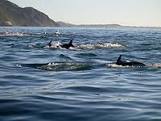 Dusky dolphins[/caption]
Dusky dolphins[/caption]
The dolphins accompanied both boats, in the morning during the whale watching tour and the afternoon during the albatross watching tour. Each time I saw a dolphin hurl itself out of the water, I smiled and laughed at the same time. My heart soared with them.
Kaikoura is a special place, not only for its incredible wildlife and scenic position where sheer mountains meet narrow green pastures close against deep blue sea.
It’s also home to one of New Zealand’s best cultural experiences.
Lucky for me, I had enough time to enjoy a half day’s outing with Maurice Manawatu of Maori Tours Kaikoura. Maurice and his wife Heather began showing visitors their side of Kaikoura back in 2002. Since then they’ve won numerous awards for their impeccably run family business that shows interested visitors what local Maori culture is all about.
[caption id="attachment_2563" align="alignnone" width="336"] Maurice Manawatu sings a welcome at beginning of Maori Tours Kaikoura[/caption]
Maurice Manawatu sings a welcome at beginning of Maori Tours Kaikoura[/caption]
The tour begins in a forest near the private marae linked to the Manawatu family and their relatives. The marae is private, open by invitation only but Maurice has permission to use the access road to the site with its stunning views over the Kaikoura coastline (you may see a whale or albatross from the cliff).
During a very friendly welcoming ceremony where Maurice allocates each tour member a Maori name, the family history is recounted in an easily comprehended summary, allowing everyone special insight into how Maori culture evolved over the centuries and how this particular family came to live in Kaikoura. It’s a fascinating account of living history interspersed with song and a lot of laughs.
[caption id="attachment_2567" align="alignnone" width="156"]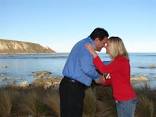 Maurice Manawatu greets a guest[/caption]
Maurice Manawatu greets a guest[/caption]
The tour takes in another favoured Kaikoura spot, parkland near the beach where Maurice and another family member show guests how to weave Maori baskets and other examples of treasured craft making. This could top the kitsch stakes but it doesn’t. Instead it’s a lot of fun, very interesting and interactive as well.
The half day’s tour finishes at Maurice and Heather’s home where guests are treated to a splendid afternoon tea and a chance to mingle with other family members while comparing notes and impressions with other tour guests.
I’ve done a few Maori cultural tours before, most frequently at Rotorua. While Rotorua is Kiwi-central for Maori driven cultural tourism, it’s big business that serves mass tourism, which is done well but often lacks authenticity.
The whole Maori Tours Kaikoura experience is completely authentic, ringing true at each moment. Maori Tours Kaikoura includes these words in its Social Responsibility Statement:
‘We believe in improving communities and play an active role in pursuit of a better place to live. We recognize we have a special obligation to whanau, hapu and iwi and this is reflected in our policies and actions. We care about our staff……..assist in community projects, businesses and individuals where we can; and encourage our staff and whanau to experience the joy of volunteering. We realise it takes commitment to make a difference in our community.’
Their Environmental Policy Statement reads in part:
‘As Maori children we are taught from birth that if we remove the core of ourselves and ruin the fundamental nature of the world we live in, there will be nothing left for our children, their children and the generations to come. We acknowledge the natural environment in which we operate is a valuable resource and we actively support its preservation and conservation which is shown in our policies and actions.’
This could also be read as a mission statement for Kaikoura itself, the town where eco-tourism isn’t merely a catchphrase or a PR stunt to attract tourists.
Kaikoura is a place where a few actions speak volumes of words. Here is where the environment is truly respected not only as a means to livelihood and income but also as the essence of life itself.
Tom Neal Tacker travelled to Kaikoura as a guest of Christchurch/Canterbury Tourism.
Naked Tips:
See www.maoritours.co.nz for more information about Maurice and Heather Manawatu’s excellent day tours.
For more information about Kaikoura whale sighting tours and bookings, see www.whalewatch.co.nz
For more information about Kaikoura albatross tours and bookings see www.albatrossencounter.co.nz
Naked Routes:
Kaikoura is approximately 2.5 hours drive north of Christchurch or approximately 2 hours drive south of Picton.
Both cities are frequently served by Air New Zealand. See www.airnewzealand.com
Naked Sleeps:
New Zealand does luxury lodges just about better than anywhere else in the world. While in Kaikoura treat yourself to at least one night and one dinner at Hapuku Lodge & Treehouses located approximately ten kilometres north of Kaikoura township on a sprawling coastal property.
[caption id="attachment_2568" align="alignnone" width="219"]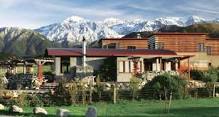 Hapuku Lodge main building and mountain backdrop[/caption]
Hapuku Lodge main building and mountain backdrop[/caption]
My one-bedroom ‘treehouse’ ten metres above the ground sported gob-smacking views over picturesque paddocks, surf-washed beach and nearby mountains.
[caption id="attachment_2564" align="alignnone" width="448"]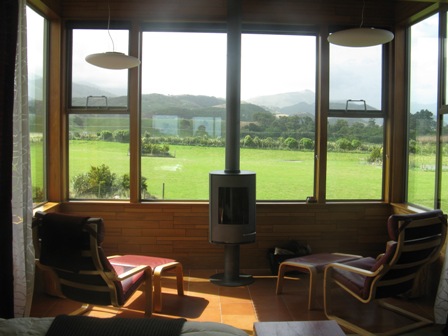 Hapuku Lodge Treehouse interior and view[/caption]
Hapuku Lodge Treehouse interior and view[/caption]
The room was an absolute treat of peace and quiet with all the mod-cons I’d ever need. A full sized spa bath and walk-in shower boasted top-of-the-line locally made toiletries. My bed was perfect, were I a princess the pea would never be discovered and I’d never have anything to complain about.
[caption id="attachment_2565" align="alignnone" width="448"]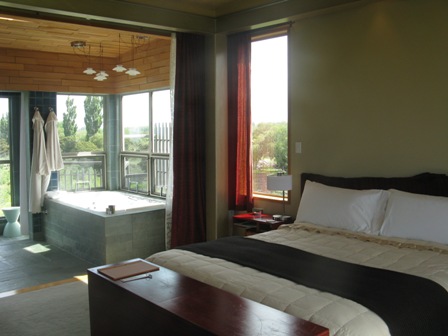 Hapuku Lodge Treehouse one bedroom bed and partial bathroom view[/caption]
Hapuku Lodge Treehouse one bedroom bed and partial bathroom view[/caption]
Catering at Hapuku Lodge is flawless. I ate my dinner at the kitchen facing bar so as to chat with the chefs, one of whom was visiting from Chez Panisse in Berkeley, California (one of the world’s most famous restaurants and the first in America to be organic well before the word became trendy). She kept supplying me with dishes I ‘must try’. Never one to say no to such offers, I was happy as a pig in the proverbial, full with food from the farm, not too heavy, not too light while prepared with skill and devotion to superb locally sourced ingredients. Wines poured by the glass were a bravura mix of Kiwi and imported French and Australian that perfectly matched each course of the degustation.
[caption id="attachment_2569" align="alignnone" width="214"]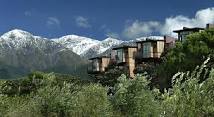 Hapuku Lodge Treehouses[/caption]
Hapuku Lodge Treehouses[/caption]
Breakfast in the same dining room where I ate dinner was equally good. Had I wanted it served in my ‘treehouse’, it could have been easily arranged.
See www.hapukulodge.com for more information and bookings.
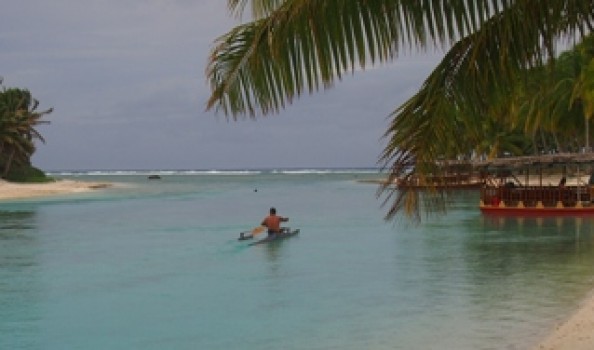 https://nakedhungrytraveller.com.au/considering-the-cook-islands/ Considering the Cook Islands
https://nakedhungrytraveller.com.au/considering-the-cook-islands/ Considering the Cook IslandsTua Pittman rides the tiller with stern command. Steering the Marumaru Atua northwards into the night, he scopes the greying horizon like it’s a familiar friend. As one of the few contemporary Master Navigators trained in the ancient ways of sailing by stars, moon, ocean currents and migrating birds, on this short voyage from Rarotonga towards Aitutaki, Pittman is recreating a past almost forgot to modern travellers.
[caption id="attachment_2414" align="alignnone" width="360"]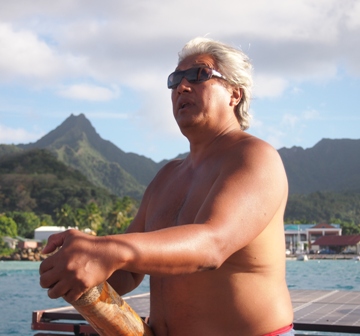 Master Navigator Tua Pittman at the tiller of the Marumaru Atua[/caption]
Master Navigator Tua Pittman at the tiller of the Marumaru Atua[/caption]
The Marumaru Atua is a double-hulled canoe/catamaran of about twenty-two metres length from bow to stern with a deck area of roughly fifteen metres by five metres. A mega-yacht this is not. A reminder of great voyages past, it is.
Sporting three russet coloured lateen sails decorated with ancient Polynesian motifs, she flies across the ocean's surface like a wandering albatross, beautiful and alone. There is no keel; the four metres long wooden tiller steers the 'vaka' easily.
[caption id="attachment_2416" align="alignnone" width="448"]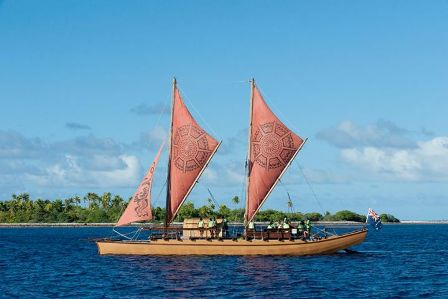 Marumaru Atua vaka with sails up[/caption]
Marumaru Atua vaka with sails up[/caption]
A small rattan roofed galley with enough space for two adults sits amidships.
[caption id="attachment_2418" align="alignnone" width="371"]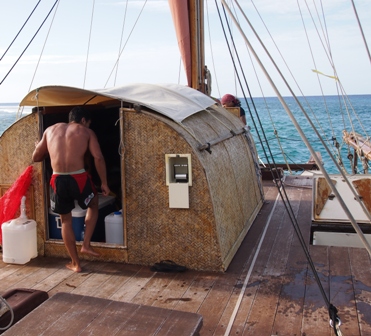 Crew member Malik entering Marumaru Atua galley[/caption]
Crew member Malik entering Marumaru Atua galley[/caption]
A single toilet with door is positioned in front of the galley faces the bow. When in use, leave the door open or closed; it's up to you. On such a small vessel everyone knows where everyone else is while privacy is respected. A bucket with rope attached is the flushing mechanism.
[caption id="attachment_2419" align="alignnone" width="375"]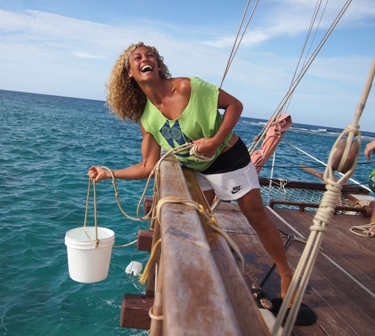 Crew member Erena Young hauling bucket of dunny water[/caption]
Crew member Erena Young hauling bucket of dunny water[/caption]
The remainder of the deck is open to the elements with two storage compartments that also serve as bench seats. Each separate canoe hull has enough space for eight bunk beds, sixteen altogether. There’s not enough space below deck to swing a cat, had one been aboard, creating a cozy arrangement that could make or break friendships.
[caption id="attachment_2420" align="alignnone" width="362"]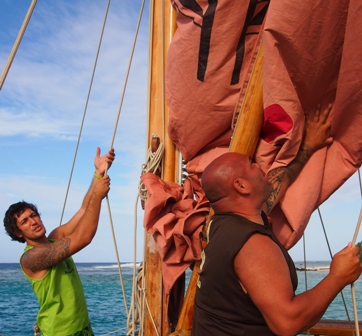 Alex Olon and Thomas Wynne raising mainsail[/caption]
Alex Olon and Thomas Wynne raising mainsail[/caption]
To comply with contemporary insurance regulations, the ‘vaka’ is equipped with a GPS and radio but we don’t rely on either. Running lights and cabin lights are powered by solar panels fitted to the stern timbers above the transom. During extended periods of cloudy weather a corkscrew propeller generator can be lowered between the hulls through a hatch to add a bit of extra juice. For our short journey, the propeller is lifted and secured beneath the deck.
[caption id="attachment_2421" align="alignnone" width="448"]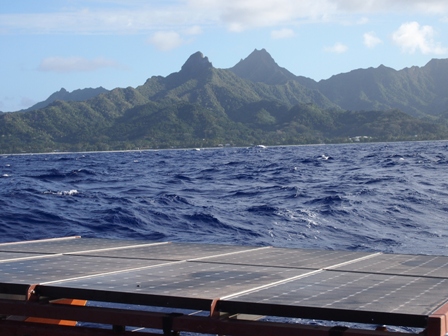 Solar panels on Marumaru Atua with Rarotonga receding in the distance[/caption]
Solar panels on Marumaru Atua with Rarotonga receding in the distance[/caption]
Wind energy is all we need this night. Given the weather conditions, there’s plenty of that.
I’m one of seven lucky passengers, four other writers, one public relations expert and a Pittman family friend who’s checking out the facilities on this maiden ‘tourist’ voyage.
[caption id="attachment_2422" align="alignnone" width="424"] Passengers aboard the Marumaru Atua ready to leave Avarua harbour[/caption]
Passengers aboard the Marumaru Atua ready to leave Avarua harbour[/caption]
The weather hasn’t kind for three days. A strong southeast wind is pushing waves to threatening heights. The narrow entrance to Aitutaki’s lagoon is closed due to rough seas.
No matter. We’re intent on pursuing the last voyage of 2013 before the summer cyclone season begins. A bit of nasty weather won’t put off true sailors but land-loving passengers may feel otherwise. A decision is taken to sail the ‘vaka’ in the direction of Aitutaki for approximately seventy nautical miles then turn round and return to Rarotonga, more or less matching the distance of a one-way trip from Rarotonga to Aitutaki.
[caption id="attachment_2423" align="alignnone" width="336"]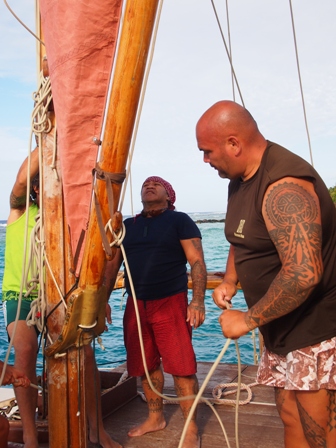 Alex Olon, Tefini Pekapo and Thomas Wynne raising mainsail[/caption]
Alex Olon, Tefini Pekapo and Thomas Wynne raising mainsail[/caption]
Two watches are assigned to the crew, the first from sunset until midnight, the second from midnight until dawn. Along with Pittman another Master Navigator and our Captain during this short voyage is ex-navy officer Peia Pataia. Pataia assumes overall command for the safety of the crew and passengers.
Pataia, Erena Young, Alex Olon and a young apprentice from a local school, Malik, take the first watch. Tua Pittman, his brother Noel Pittman, Tefini (‘T’) Pekapo and Thomas Wynne take the second.
[caption id="attachment_2424" align="alignnone" width="448"]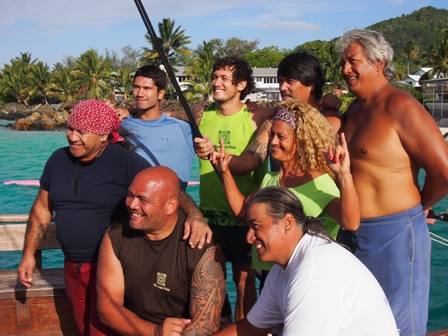 Marumaru Atua crew members. Clockwise from top left: Tefini Pekapo, Malik, Alex Olon, Captain Peia Pataia, Tua Pittman, Erena Young, Noel Pittman and Thomas Wynne[/caption]
Marumaru Atua crew members. Clockwise from top left: Tefini Pekapo, Malik, Alex Olon, Captain Peia Pataia, Tua Pittman, Erena Young, Noel Pittman and Thomas Wynne[/caption]
The swell reaches four metres once we’re a few nautical miles beyond Rarotonga’s sheltering reef. The Samoan Trench lies underneath. Bottom is over three thousand metres down. Once outside the reef, the water colour metamorphoses from tropical aquamarine to a deep steely blue.
[caption id="attachment_2426" align="alignnone" width="448"]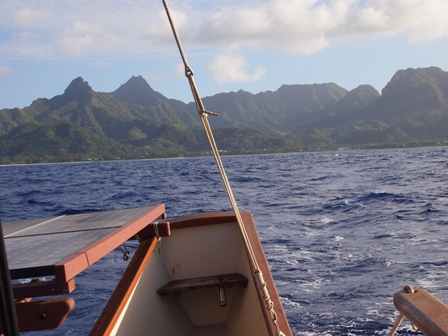 Rarotonga at a distance on board the Marumaru Atua[/caption]
Rarotonga at a distance on board the Marumaru Atua[/caption]
Three crew members are struck down with seasickness almost immediately, a common malady remedied only by steadfast dedication and gradual physical adaptation. Ginger tablets, Fisherman’s Friend lozenges and anti-nausea drugs may assist in reducing the symptoms of seasickness but they won’t cure it. My fellow passengers alternate between extreme seasickness and mild queasiness.
[caption id="attachment_2427" align="alignnone" width="448"] Noel and Tua Pittman leaving Avarua on board Marumaru Atua[/caption]
Noel and Tua Pittman leaving Avarua on board Marumaru Atua[/caption]
Another writer, a friend well known for his bush-walking and mountain biking prowess spends the whole fourteen hours voyage either rolled up in the fetal position on the deck or with his head hanging off the side filling the ocean with his stomach contents. By 21:00, all other fellow passengers are either trying to sleep down below on narrow and rocking bunks or curled up in blankets on the wet deck. Some hang heads over the side, muttering occasional groans. But not me.
[caption id="attachment_2472" align="alignnone" width="336"]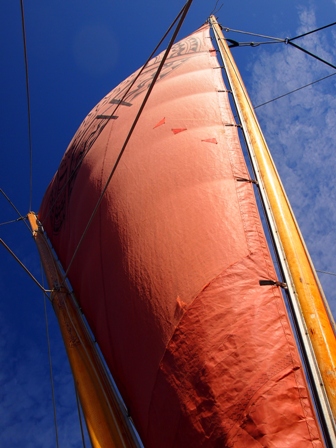 Marumaru Atua mainsail up[/caption]
Marumaru Atua mainsail up[/caption]
This was an experience in which I didn’t want to miss a minute. Requesting permission to sit on either of two stern end navigator’s seats, I happily sat through each seven hour watch, wide awake, often wet as a random wave washed over me, watching moonrise and moon set, the entire night's panoply of celestial grandeur, gazing at Venus rising as the sun set and later following its disappearance into the first light of dawn. Canopus the Dog Star became a familiar friend. I learned the difference between the false Southern Cross and the real Southern Cross. Orion’s Belt was a constant feature, nearly always highest in the sky and eminently visible.
I knew that if I went below and stretched out in a bunk, the risk of seasickness would increase. As long as I fixated on the horizon, the stars, the passing clouds and the moon’s position, I’d be fine.
I was reminded of something very important that night. Time really does stretch when modern markers are left behind. I lost track of it, was lost in my thoughts and thrilled to be alone. With nearly seven billion humans on this small planet, it’s not often I get to say that.
Peia, Erena and Alex were mostly quiet during their watch. Tua, Tefini (‘T’) and Thomas were also very quiet. Noel and Malik were both prostrate with seasickness, passed out on deck. Thomas suffers extreme seasickness but stayed his watch nonetheless. The man is a hero. I watched him sit the tiller in between frequent bouts of retching over the stern. Brief snippets of chat were rare, exchanges of information mostly. Checking position and adjusting the tiller to stay on course doesn’t necessitate a dialogue. I was mesmerised by the silver light dancing on the waves. Occasionally phosphorescence lingered in the tiller’s wake, like a glittering refrain at the end of a rousing speech, though nothing was to be heard other than waves crashing against the wooden hulls and wind ruffling full sails.
A thousand or so years ago, early Polynesians ventured across the planet’s largest ocean in search of new lands. They navigated mostly by the stars, a permanent planetarium seemingly embedded in their brains. These ingenious explorers migrated across huge expanses of uncharted waters without printed maps to guide them.
A few years ago, in commemoration of his ancestors’ remarkable explorations Pittman helped build a ‘vaka’, essentially a large canoe capable of deep sea travelling, at once recreating a vessel that the earliest Polynesians used to circumnavigate the Pacific Ocean well before European pioneers ‘discovered’ the unknown world. In building the ‘vaka’ Pittman and his friends simultaneously reconnected with their heritage.
That recreated canoe, the ‘vaka’ Marumaru Atua (meaning ‘Under the Protection of God’) sailed with six other canoes across the Pacific Ocean through the Golden Gate of San Francisco, proving that it was possible to sail vast distances without the benefit of modern navigation equipment.
Since that voyage in 2011/2012, the Marumaru Atua has been based in the Cook Islands at Rarotonga. Tua Pittman, his crew and benefactors have given the ‘vaka’ to the people of Rarotonga as a reminder of their intrepid past. Managed by Pittman and company, it now runs regular three hour evening trips beyond Rarotonga’s fringing reef, allowing passengers to witness southern stars far away from city lights as the big canoe sails beyond the island’s encircling reef on a short bout of sky tripping.
In March 2014, the Marumaru Atua and crew will begin monthly four day return voyages from Rarotonga to Aitutaki, approximately 180 kilometres north. Leaving late afternoon, the ‘vaka’ sails overnight to Aitutaki reaching the glorious lagoon’s shipping entrance by mid-morning. Passengers will have the choice of staying on board the ‘vaka’ or transferring to other accommodation on the island, returning to Rarotonga two days later.
Our brief trip is the ‘trial run’ in preparation for paying passengers. I’m pleased to report that a cruise on the Marumaru Atua from Rarotonga to Aitutaki is unique and should be on every real traveller’s so-called ‘bucket list’.
Sometimes the travel gods decide to bestow a gift. Fortunate recipients of this gift are well advised to remember it for they have received something both rare and priceless.
It has been my great fortune to be the recipient of random travel beneficence; this voyage beyond Rarotonga on the Marumaru Atua is one of the most memorable trips I’ve ever been lucky enough to experience.
For travellers interested in living Polynesian history, a voyage on the Marumaru Atua is essential.
For inquiries and bookings on the Marumaru Atua’s trips outside Rarotonga’s reef and to Aitutaki, contact Tua Pittman or Carmel Beattie at Island Discoveries via email: bookings@islanddiscoveries.co.ck
If a voyage on a ‘vaka’ doesn’t float your boat, don’t worry, there’s plenty else to discover on a visit to the Cook Islands.
[caption id="attachment_2428" align="alignnone" width="336"]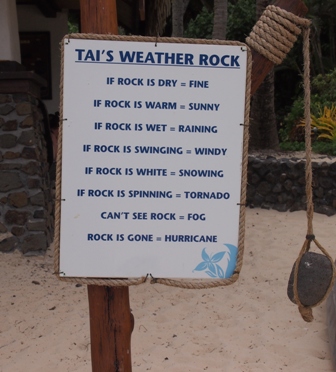 Tai's weather rock at Muri beach[/caption]
Tai's weather rock at Muri beach[/caption]
Best known for its ‘newlywed and nearlydead’ customer base, a recent expansion of Cook Islands’ tourism choices should appeal to visitors not celebrating a marriage nor interested in spending days welded to a banana lounge by a pool next to a white sand beach, though both those options remain very popular.
[caption id="attachment_2429" align="alignnone" width="448"]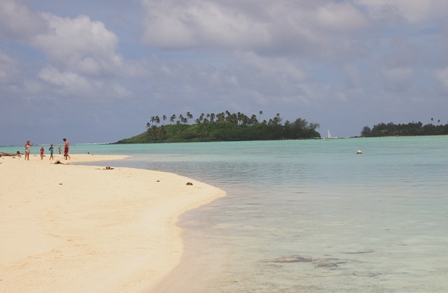 Muri beach and lagoon[/caption]
Muri beach and lagoon[/caption]
Rarotonga is basically Cook Islands central. The country’s only international airport is on Rarotonga and it’s the biggest island in the archipelago. Cook Islands’ total population is fewer than 20,000 inhabitants. Approximately 12,000 people live on Rarotonga while approximately 1,800 more call Aitutaki home.
[caption id="attachment_2430" align="alignnone" width="448"]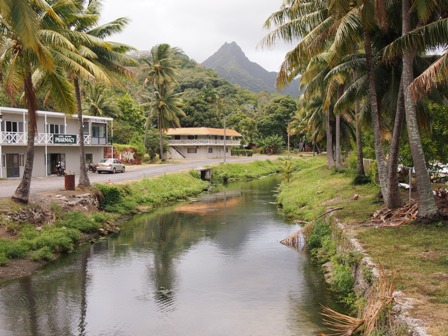 Uptown Avarua[/caption]
Uptown Avarua[/caption]
Rarotonga is a large volcanic island with peaks rising to over 600 metres in its densely forested centre. A double lane road of thirty-two kilometres circles the island. There is no cross-island road as the interior is too steep and rugged. A public bus runs two services, clockwise and anti-clockwise each thirty minutes. Passengers are picked up and dropped off wherever they choose to stop, sometimes only ten metres from one stop to the next. The night bus service runs clockwise only but not on Sundays. Hire car companies operate reliable services, renting small vehicles (Daihatsu mini convertibles are popular) and scooters to qualified drivers. A visitor’s driver’s licence is compulsory and can be purchased at the police station or through the rental agency. Bicycles are very popular transport options as well.
[caption id="attachment_2431" align="alignnone" width="448"]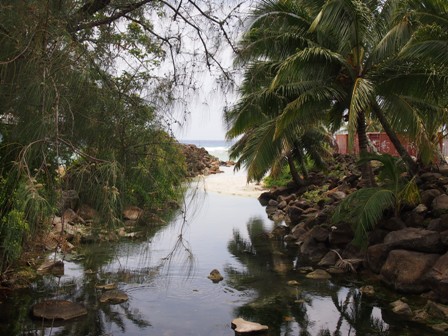 Fresh water stream running through Avarua[/caption]
Fresh water stream running through Avarua[/caption]
Rarotonga’s best beaches are at Muri and Titikaveka on the southern side. At Nikao and Arorangi on the northwest side more lovely beaches stretch along the lagoon. They’re not quite as gleaming smooth sandy white as those on the southern side but the sunset views are better. Dogs are frequent beach bums. Generally friendly and looking for free entertainment, local dogs have taken to working on behalf of Cook Islands Tourism as semi-official 'meeters and greeters'. A volunteer animal rescue program began working in the Cook Islands earlier this century. Now all animals are vaccinated and 'fixed'. No longer are visitors confronted by the distressing sight of injured and abandoned animals left to fend for themselves. Each dog I met on Rarotonga (there are no dogs on Aitutaki) was very friendly and good company.
[caption id="attachment_2432" align="alignnone" width="361"]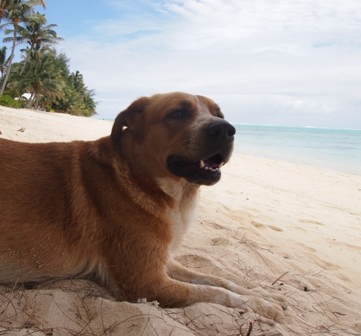 Friendly dog on Titikaveka beach[/caption]
Friendly dog on Titikaveka beach[/caption]
Little Avarua is the main town where the government meets and the country’s largest market, Punanga Nui, is held each Saturday morning. Rarotonga’s surprisingly active nightlife is centred in Avarua. Check out Trader Jack’s and Whatever! bars on Thursday or Friday nights to see how Rarotongans socialise when they’re not at church or work. Saturday night revelries are a tad quiet, church going starts at 9am and it’s considered socially bad form to turn up nursing a hangover.
[caption id="attachment_2433" align="alignnone" width="448"]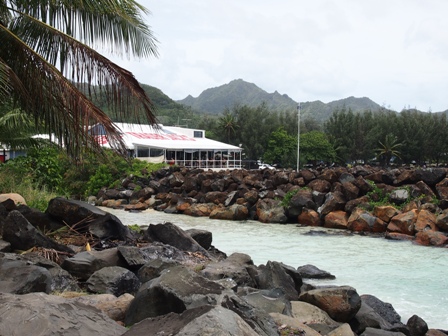 Trader Jack's bar at Avarua[/caption]
Trader Jack's bar at Avarua[/caption]
All major Rarotongan resorts sport restaurants and bars, some more lively than others. If your holiday wish list includes lively interactive post dinner activities, be advised to confirm the entertainment options when booking a room.
Aitutaki is much smaller, approximately seven kilometres long by three wide and is a remnant of an extinct volcano with an enormous encircling lagoon. Maungapu, is the highest point at 124 metres. Aitutaki’s lagoon is dotted with over a dozen motu that conjure images of tropical heaven: eye-popping white sand, water comprising every shade of blue, fringing coconut palms and coral gardens enticingly peppered with giant clams, black pearl oysters and an encyclopaedia’s worth of Indo-Pacific fish and crustacean species. I’ve seen quite a few tropical lagoons during my travels but few lagoons rival Aitutaki in terms of sheer blissful perfection.
[caption id="attachment_2434" align="alignnone" width="448"]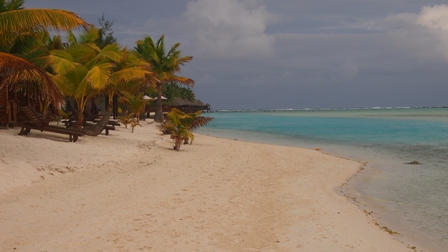 Typical Aitutaki beach and lagoon scene[/caption]
Typical Aitutaki beach and lagoon scene[/caption]
Eleven churches operate on Aitutaki. Considering the population is fewer than 1,800 people, an impressive per capita ratio of proselytising opportunities abound. Christianity rules over all on Aitutaki. A conservative movement to stop all Sunday flights has a strong following.
[caption id="attachment_2435" align="alignnone" width="448"]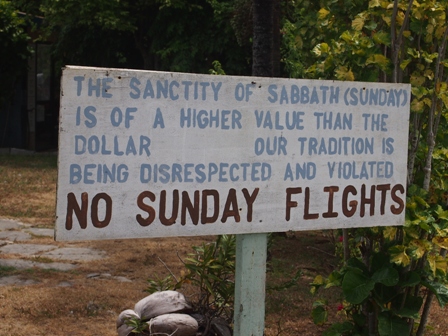 No Sunday Flights Aitutaki protest sign[/caption]
No Sunday Flights Aitutaki protest sign[/caption]
Cook Islands takes up a lot of space, over two million square kilometres, almost all of it water. Fifteen islands comprise the archipelago, eight in the southern group (including Rarotonga and Aitutaki, by far the most visited and populous) and seven in the northern group. Apart from the airports on Rarotonga and Aitutaki serviced by frequent Air Rarotonga flights, most of the other islands in the southern group can be reached only by charter flights. Both Penrhyn and Pukapuka in the northern group can be reached by air, charter flights only.
The Cooks is a mix of volcanic islands ringed by fringing reefs or coral atolls with lagoons of varying sizes. For more information about the whole country including the thirteen islands not often frequented by international travellers, check out www.cookislands.travel
[caption id="attachment_2471" align="alignnone" width="448"]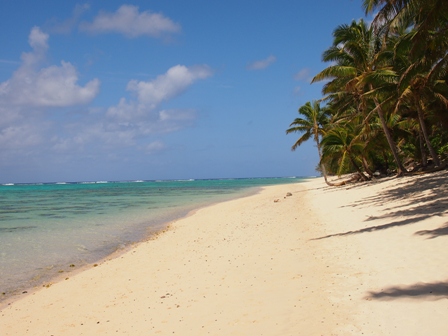 Titikaveka beach on Rarotonga[/caption]
Titikaveka beach on Rarotonga[/caption]
My job while on this trip to the Cook Islands was to explore what else there is to do other than get married, honeymoon or lash out on an expensive retirement trip.
That I reconnected with my inner soul during my night on the Marumaru Atua was purely incidental and a trick of lucky fate.
Here’s a list of ‘Must Do’ activities on Rarotonga. I list them in no particular order of importance.
A ‘Navigating Pacific Skies’ progressive dinner with Tua Pittman should be a number one priority for all visitors keen on Polynesian history. As a precursor either to the three hour excursion beyond Rarotonga’s fringing reef or the four day trip to Aitutaki, this dinner in Tua’s excellent company starts at the Waterline restaurant and ends at a private home for dessert and is highly recommended as an introduction to a trip on the Marumaru Atua. Tua chauffeurs guests around the island while pointing out important stars, explaining navigation skills and relating Polynesian history. Inquiries and bookings can be made via email: bookings@islanddiscoveries.co.ck
[caption id="attachment_2450" align="alignnone" width="448"]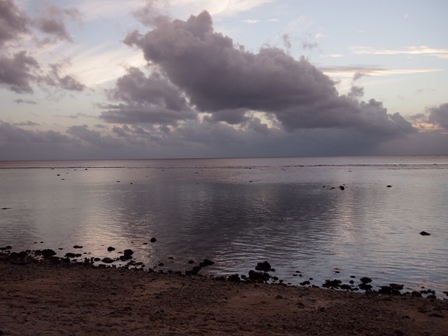 Waiting for sunset during Navigating Pacific Skies tour with Tua Pittman[/caption]
Waiting for sunset during Navigating Pacific Skies tour with Tua Pittman[/caption]
Sunday’s 10am church service at Arorongi’s Cooks Islands Christian church. It’s free and better still, allows a glimpse into local culture in the truest sense. The service I attended was led by the new pastor recently returned to Rarotonga after living in Sydney’s western suburbs. Replete with song and laughter, fire and brimstone, this was old time religion Cook Islands style.
[caption id="attachment_2436" align="alignnone" width="448"]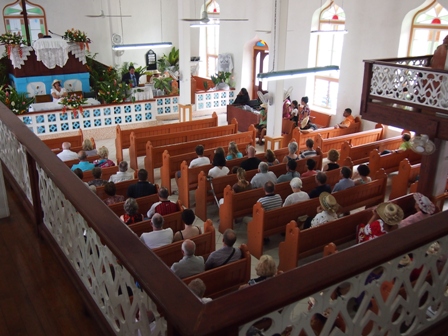 Arorongi church service[/caption]
Arorongi church service[/caption]
My mobile phone couldn’t lock on to a signal during my first two days on Rarotonga. Frustrated by the lack of connectivity, I resigned myself to be off-grid for at least a week. Seated in a pew on the upper balcony of this church, I listened intently to the first of a number of hymns sung by a group of regular parishioners dressed to the nines looking like they’d won a trip to a prestigious awards event. Apparently, like the Welsh, Tahitians and Samoans, Cook Islanders can carry a tune as if musicality is an inherent genetic trait, they sing like angels. Suddenly, my phone locked on to the local provider and text messages silently beeped their way into the service. Another fellow writer seated beside me, (she’s something of a tech-head), sent me a sideways glance as we both raised our eyes upwards and muttered, ‘Jesus!’ A funny thing happened on the way to church...
[caption id="attachment_2437" align="alignnone" width="411"]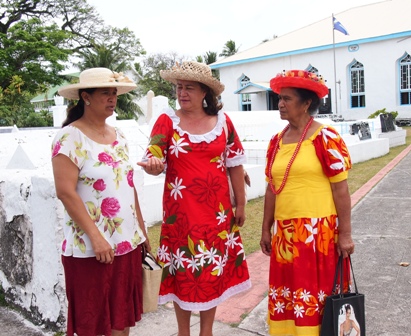 Arorongi church ladies leaving Sunday service[/caption]
Arorongi church ladies leaving Sunday service[/caption]
As a matter of particular interest, the preacher made several erroneous comments about ‘Diwali’ infiltrating pure Cook Islands Christianity. A number of Indian Fijian migrants have settled in Rarotonga in search of better paid work than can be secured in Fiji. While I was there Diwali was being celebrated by this vibrant Fijian Indian community. Diwali is one of the most important and cherished holidays during the Hindu year, a commemoration of the goddess of learning and light when children are invited by teachers to visit their schools though the schools are closed for the holiday, often bringing new books to stock the library. As proof that knowledge conquers ignorance, it’s an invaluable teaching aid. Most Hindu homes have candles or lanterns placed in doorways to banish dark evil spirits and to welcome in light and learning. It’s a wonderful holiday, not threatening to Christianity in any way at all, especially in a place as overwhelmingly Christian as the Cook Islands. Though I was upset by the ravings of an ignorant preacher who didn’t know that ‘Diwali’ is a revered Hindu holiday and not a religion of itself, I was interested to observe how the congregation reacted to the sermon. Judging by the looks on people’s faces, the reaction was fairly nonplussed. At the subsequent morning tea when all the congregation and visitors are invited into a nearby public hall to share donated food and non-alcoholic drinks, the talk I overheard was gossipy and fun, not frightful nor fuelled by resentment. I suspect the preacher has since been advised to monitor his hate mongering in public.
[caption id="attachment_2438" align="alignnone" width="397"] Arorongi church service, lady enjoying morning tea[/caption]
Arorongi church service, lady enjoying morning tea[/caption]
A Raro Safari 4WD tour of the island’s back roads and mountainous interior is terrific fun. Owned and operated by local environmentally minded enthusiasts of Rarotonga’s soft wilderness areas, this half day trip in an extravagantly decorated open 4WD is a lot of fun as well as insightful. We enjoyed the company of our guide, Mr Useless (many Cook Islanders are best known by their nicknames).
[caption id="attachment_2439" align="alignnone" width="448"]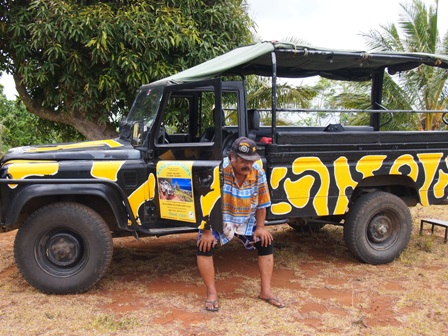 Mr Useless of Raro 4WD Safari taking a much needed break[/caption]
Mr Useless of Raro 4WD Safari taking a much needed break[/caption]
Mr Useless was anything but useless though he was occasionally a bit grumpy and difficult to understand, not because of a lack of English but because an absence of teeth often turned his words into unintelligible mumbles.
[caption id="attachment_2440" align="alignnone" width="336"] Emergency phone and Needle seen during Raro 4WD safari tour[/caption]
Emergency phone and Needle seen during Raro 4WD safari tour[/caption]
A Raro Safari tour is a fun day out following a somewhat random itinerary. Ask a lot of questions, show keen interest and the tour will certainly evolve into a very educational experience. See www.rarosafaritours.co.ck
[caption id="attachment_2441" align="alignnone" width="425"]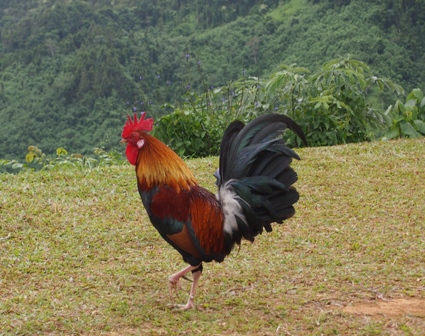 Rarotonga rooster joins Raro 4WD safari tour[/caption]
Rarotonga rooster joins Raro 4WD safari tour[/caption]
Definitely more fun than any of us anticipated was the Koka Lagoon Cruise on Muri’s fabulously picturesque lagoon.
[caption id="attachment_2451" align="alignnone" width="448"]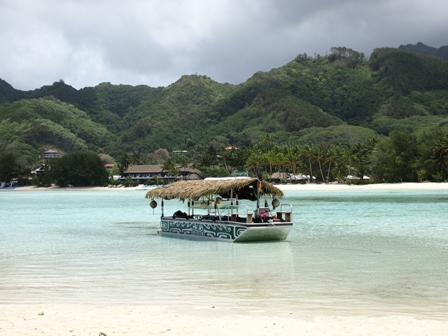 Koka Lagoon Cruises boat moored in Muri lagoon[/caption]
Koka Lagoon Cruises boat moored in Muri lagoon[/caption]
Billed as a ‘Glass Bottom Boat Adventure’, I had my doubts about authenticity as a driving force. I was dead wrong about that assumption.
[caption id="attachment_2443" align="alignnone" width="448"] Captain Awesome showing off his conch shell[/caption]
Captain Awesome showing off his conch shell[/caption]
The four crew members, Captain Awesome, Captain Amazing, Captain Jack Sparrow and Captain Cook (Captain Cook was the head cook for the afternoon lunch included in the cruise) proved that a day out in a small boat doing very touristy things like snorkelling around a coral renovation project, or snorkelling among large fish looking for a handout can be a wonderful way to pass a day in paradise.
[caption id="attachment_2445" align="alignnone" width="448"] Captain Jack Sparrow playing a ukulele[/caption]
Captain Jack Sparrow playing a ukulele[/caption]
Enjoying a picnic lunch on a motu just offshore from Muri’s beach while being entertained by this outstandingly energetic crew who taught us how to climb a coconut palm, how to husk a coconut, how to differentiate coconuts according to maturity, usefulness and flavour, how to plait palm fronds to make a hat or plate and how to play a ukulele made for a very full day. I tipped my old fishing cap to them all.
[caption id="attachment_2442" align="alignnone" width="448"]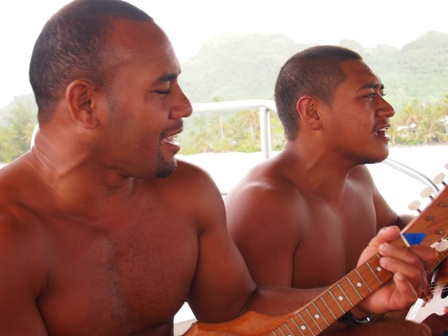 Captain Awesome and Captain Amazing singing during Koka Lagoon cruise[/caption]
Captain Awesome and Captain Amazing singing during Koka Lagoon cruise[/caption]
These guys could show a seasoned Vegas troupe a thing or three about how to maintain performance enthusiasm. I couldn’t have loved it more. See www.kokalagooncruises.com
[caption id="attachment_2444" align="alignnone" width="448"] Captain Awesome hanging off a coconut tree[/caption]
Captain Awesome hanging off a coconut tree[/caption]
The Cook Islands Whale & Wildlife Centre is a must visit for travellers who are concerned about Cook Islands’ marine environment and its preservation. Owned and run by local heroine Nan Hauser, who is an internationally recognised expert on whales, dolphins and porpoises. Her work on cetacean habitats, their migration routes and how their very existence is now dependent on humans learning to leave them alone to regenerate after the decimations of the past two whaling centuries is widely heralded. As a generalised information facility about cetaceans from around the world, it is invaluable and Cook Islanders are fortunate to have it as a resource and research centre. See www.whaleresearch.org
The Cook Islands National Museum and Library in Avarua’s uptown area at the corner of Victoria Road and Constitution Park is a very small museum that packs a punch. Open Mon-Fri 9am until 4pm. Entry fee is CI$5.
[caption id="attachment_2446" align="alignnone" width="124"] Cook Islands National Museum and Library entrance[/caption]
Cook Islands National Museum and Library entrance[/caption]
The Saturday market, Punanga Nui in Avarua’s downtown area is where everyone comes to shop or just hang out. Like mixed crafts and produce markets the world over, a visit to this lively site is obligatory for all curious visitors who are intent on gaining insight into what makes the Cook Islands tick.
[caption id="attachment_2448" align="alignnone" width="426"]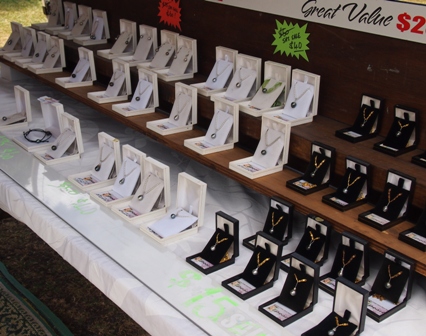 Black pearls on sale at Punanga Nui market stall[/caption]
Black pearls on sale at Punanga Nui market stall[/caption]
Top stalls are: Farm Direct Pearls for some of the best and most reputable deals on locally raised black pearls, Rito Cold Pressed Coconut Oil Products for edible flavoured oils, health and beauty products, Tokerau Jim for hand-crafted art objects and jewellery and KMD Ukuleles for its range of expertly made ukuleles from native woods.
[caption id="attachment_2447" align="alignnone" width="448"]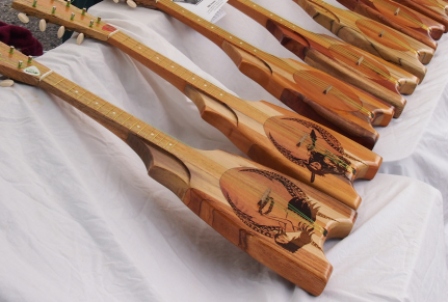 KMD ukuleles on sale at Punanga Nui market[/caption]
KMD ukuleles on sale at Punanga Nui market[/caption]
Of course numerous stalls selling fresh juices, fruit smoothies, icy frappes and healthy (or not) small meals and snacks are everywhere. Take your pick and pig out.
[caption id="attachment_2449" align="alignnone" width="336"] Punanga Nui market food and juices for sale[/caption]
Punanga Nui market food and juices for sale[/caption]
A visit to Island Living store is highly recommended. Owned and run by Minar Purotu Henderson, this little shop is a gem which sells locally made and designed fabrics and crafts. The noni juice produced from the trees at Island Living’s garden plantation is on sale here. As a cure-all for everything from gout to cancer, the benefits of noni juice are highly regarded by all Cook Islanders.
[caption id="attachment_2452" align="alignnone" width="448"] Noni fruit at Island Living garden and plantation[/caption]
Noni fruit at Island Living garden and plantation[/caption]
Henderson also runs the adjoining Plantation House restaurant which serves a set menu dinner for about twelve guests once a week, usually on Wednesday evenings. She’s a wonderful cook and uses her huge garden to great effect in the preparation of her special feasts. See www.islandlivingshop.com for reservations.
[caption id="attachment_2453" align="alignnone" width="448"]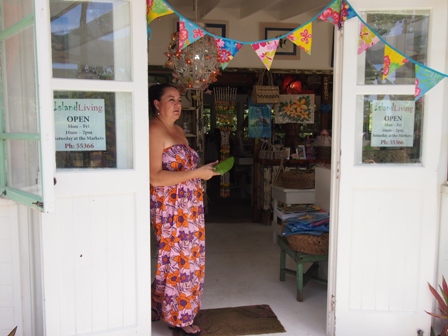 Minar Purotu Henderson at entrance to her Island Living shop[/caption]
Minar Purotu Henderson at entrance to her Island Living shop[/caption]
A Nature Walk with Pa is a unique treat. He’s a local hero and the recent winner of a prestigious tourism award. Pa is over seventy years old, walks barefoot dressed in a loincloth and takes limited numbers of guests on a hike around the Needle, a sharp spire carved by wind and rain from an ancient volcanic plug and into the island’s jungle interior. During the trek Pa also explains the benefits of indigenous plants as curatives and life preservers. He’s living proof of how a good diet and exercise may lead to a long healthy life. See www.pastreks.com
[caption id="attachment_2454" align="alignnone" width="448"]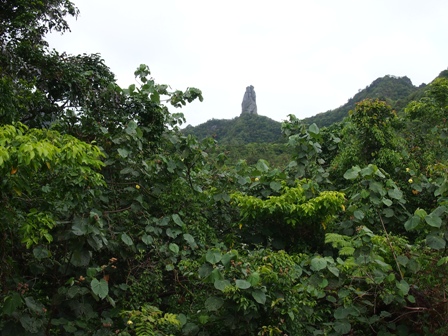 The Needle in Rarotonga's interior[/caption]
The Needle in Rarotonga's interior[/caption]
The sunset cultural tour and show at the Highland Paradise Cook Islands Cultural Centre held two or three times per week is a mixed bag of treats. The marae on the mountain is clearly an important historical site and the talk about it and its significance to Rarotongan culture is really interesting. While emcee Danny, dressed in full Cook Islands chiefly regalia, instructed guests not to cross the boundary to the marae unless invited, a woman accidentally crossed the line into the marae. Within seconds, a very large coconut nearly conked the man standing next to her on his head. Had it struck, he would surely have died. A marae can be a powerfully spooky place. The show and dinner that follows the visit to the adjoining marae is full of great music and dancing but Danny’s incessant patter is hammier than a Porky the Pig cartoon. See www.highlandparadise.co.ck
[caption id="attachment_2455" align="alignnone" width="448"] Emcee Danny of Highlands Paradise Cook Islands Cultural Centre[/caption]
Emcee Danny of Highlands Paradise Cook Islands Cultural Centre[/caption]
On Aitutaki Island these two ‘Must Do’ activities are highly recommended.
The Punarei Village Cultural Tour is an absolute wonder. The small company is owned and managed by Aitutaki born Ngaa Kitai Taria, a trained archaeologist who is now dedicating himself to revivifying Aitutaki culture as it was before Christianity’s impact caused the old ways to nearly disappear.
[caption id="attachment_2456" align="alignnone" width="227"] Ngaa Kitai Taria of Punarei Culture Tours[/caption]
Ngaa Kitai Taria of Punarei Culture Tours[/caption]
The half day tour includes lunch prepared from a do-it-yourself umukai (earth oven), a visit to an ancient marae and Ngaa’s full attention as he escorts visitors around his work-in-progress, Punarei village.
[caption id="attachment_2457" align="alignnone" width="448"] Preparing the umukai at Punarei[/caption]
Preparing the umukai at Punarei[/caption]
This excellent day out was a highlight of the visit to Aitutaki. I learnt more about Aitutaki’s past (and its future) in a scarce few hours than I ever would have learned traipsing around the island’s eleven churches in search of real or imagined history.
The lunch we helped prepare was actually quite delicious. As the umukai was truly authentic, the pork, chicken and fish tasted of mild smoke from fresh banana leaves layered over the hot rocks. The plantains, pumpkin, cassava and red bananas roasted along side were just as delicious. Fresh mangoes, guava, passionfruits and papayas were served with breadfruit salad and taro greens from the village garden.
[caption id="attachment_2458" align="alignnone" width="448"] Lunch of umukai at Punarei[/caption]
Lunch of umukai at Punarei[/caption]
We laughed and talked about how much Polynesian culture, politics and society has changed since Captain William Bligh first visited Aitutaki in 1798. The whole experience is both very moving and highly educational. See www.aitutakiculture.com
Aitutaki is rightly famous for its spectacularly beautiful lagoon. You’d be crazy to visit this island without venturing out on the lagoon. For that, you’ll need a boat and a guide.
[caption id="attachment_2485" align="alignnone" width="448"] Gaynor Stanley PR expert from PEPR Publicity and Elani of Wet n Wild enjoying a moment in Aitutaki's splendid lagoon[/caption]
Gaynor Stanley PR expert from PEPR Publicity and Elani of Wet n Wild enjoying a moment in Aitutaki's splendid lagoon[/caption]
Wet and Wild is owned and run by local experts, Quentin and his wife Malea. Their youngest child, daughter Elani accompanied us for the day on the lagoon.
[caption id="attachment_2459" align="alignnone" width="347"] Elani joins us for a Wet n Wild Aitutaki lagoon cruise[/caption]
Elani joins us for a Wet n Wild Aitutaki lagoon cruise[/caption]
Wet n Wild offers fly fishing trips (bonefish are the fisherman’s dream here) and snorkelling trips around the huge lagoon. I snorkelled over great beds of giant clams, all iridescent blue and green as they filter fed on the sandy lagoon bottom, explored a rope festooned with hanging black pearl oysters strung between coral bommies, had a quick walk around a motu famous for its ‘honeymoon money’ photo opportunities and its preserve as a refuge for red-tailed tropicbirds and other wandering sea birds. The urge to continually jump overboard into the swimming pool like lagoon is irresistible. See www.wetnwild-aitutaki.com
[caption id="attachment_2460" align="alignnone" width="448"]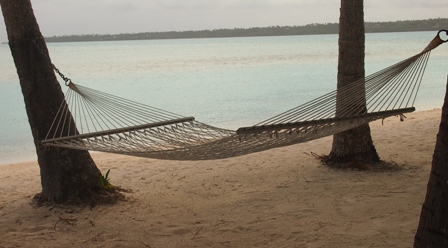 Beach hammock at Aitutaki Lagoon Resort & Spa[/caption]
Beach hammock at Aitutaki Lagoon Resort & Spa[/caption]
Tom Neal Tacker visited the Cook Islands as a guest of Cook Islands Tourism.
Naked Facts:
Naked Sleeps:
Rarotonga:
The Sunset Resort in Nikao, approximately three kilometres west of Rarotonga’s airport is a well run adults only boutique resort situated on a western facing beach. Two swimming pools delineate two areas of the same resort. The pool nearest the beach is closest to the best rooms. The other pool, despite being larger and slightly more inviting is surrounded by two two-story buildings that are nearer the lobby and reception area. The hotel carpark is also very close to one of these two buildings, the one I stayed in unfortunately. The rooms in the far side of this building are very badly positioned, being uncomfortably close to the island’s main road. I was assigned one of those rooms. Traffic noise was fairly constant, even in relatively sleepy Rarotonga. www.thesunsetresort.com
Over in Muri, on Rarotonga’s southeast facing coast is the Pacific Resort Rarotonga. One of the country’s best resorts, rooms either front a stunning beach or tropical garden area with fish ponds and a swimming pool. Most rooms are decorated in typical Polynesian style with bright colours, boast separate sleeping and living areas and newly renovated granite bathrooms. The hotel’s bar and restaurant are both deservedly popular. www.pacificresort.com
[caption id="attachment_2470" align="alignnone" width="448"]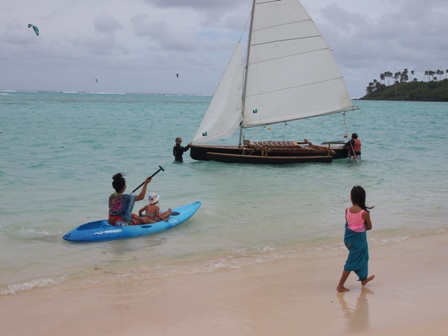 Muri beach scene at Pacific Resort Rarotonga[/caption]
Muri beach scene at Pacific Resort Rarotonga[/caption]
My wish list accommodation choice on Rarotonga is the Little Polynesian Resort & Spa. With fewer than twenty rooms, all facing the island’s best beach at Titikaveka, this is the pick of the abundant crop. While Muri beach is lined with small resorts, Titikaveka is mostly undeveloped. I hope it stays that way. www.littlepolynesian.com
Aitutaki:
The Aitutaki Lagoon Resort occupies its own tiny island just a short ferry ride across a clear running tidal channel separating Akitua from Aitutaki. Beach front bures are the top choice here, though three overwater bungalows are perennial favourites. The little villas all have outside showers and inside bathrooms. Private decks are attached to each villa, perfect for dropping into a beach lounge chair for a spot of navel contemplation. Dinner is fairly ordinary but the breakfast buffet was better than most I prospected in the Cook Islands. www.aitutakilagoonresort.com
[caption id="attachment_2461" align="alignnone" width="448"]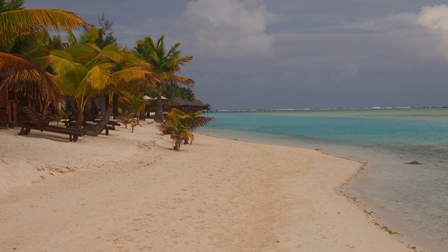 Aitutaki Lagoon Resort & Spa beach view[/caption]
Aitutaki Lagoon Resort & Spa beach view[/caption]
On Aitutaki’s western side is the very de luxe Pacific Resort Aitutaki (part of the same group that owns the Pacific Resort Rarotonga). The island’s best resort, the most expensive certainly, here the cooking is well above average in a country where too much food preparation is caught somewhere between 80s New Zealand Leagues Club inspiration and London Missionary Society reality. The infinity pool at this resort is one of the most photographed scenes in all the Cook Islands. The beach here, though superb by any concept of reality, is not as fine as the beach at the Aitutaki Lagoon Resort, advantage of occupying your own heavenly island off an island paradise perhaps? Were the Aitutaki Lagoon Resort beach transferred to the Pacific Resort Aitutaki’s superior facilities and style, we’d have a perfect winner. www.pacificresort.com
Naked Eats:
If the Cook Islands can claim a national dish, it’s probably ika mata, raw fish marinated in coconut milk, lime juice and mixed with chopped onions and/or tomatoes and if you're lucky a bit of chopped coriander. Tahitians, Samoans and Hawaiians prepare raw fish pretty much the same way. The Peruvians do it better and call it ceviche. In Mexico it’s served with more lime, coriander and a bit of chilli and is better still.
When the Cook Islands were occupied in the early 19th century by the London Missionary Society and Catholic church missionaries, local people coincidentally developed a fondness for tinned meats, tinned fruits and bland cooking. Much of that tradition continues today. New Zealanders are the Cook Islands most frequent visitors. Indeed, the Cook Islands are to Kiwis what Florida and Hawaii are to Americans and what Fiji is to Australians. For many Kiwis, their first overseas trip is to the Cook Islands. The influence middle-class Kiwis have had on contemporary Cook Islands cuisine is still a work in progress and appears to have been bogged down in 1980s low-brow cooking. I’ve had many truly excellent meals in New Zealand where innovative chefs winningly marry local produce with the country’s stunning wines. That innovation hasn’t yet fully reached the Cook Islands. This is my first impression. I heard there are several good restaurants on Rarotonga and Aitutaki but I didn’t dine at them.
[caption id="attachment_2463" align="alignnone" width="448"]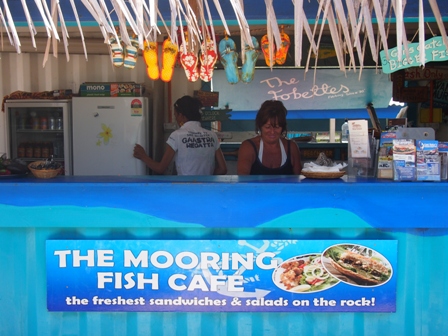 The Moorings Fish Cafe on Rarotonga[/caption]
The Moorings Fish Cafe on Rarotonga[/caption]
Unfortunately when I met Minar Purotu Henderson at her Island Living shop, it wasn’t a Wednesday and we weren’t on Rarotonga long enough to dine at her Plantation House. I read the menu at the Little Polynesian Resort & Spa and found it exciting and enticing but again, didn’t have time to dine there.
[caption id="attachment_2464" align="alignnone" width="422"]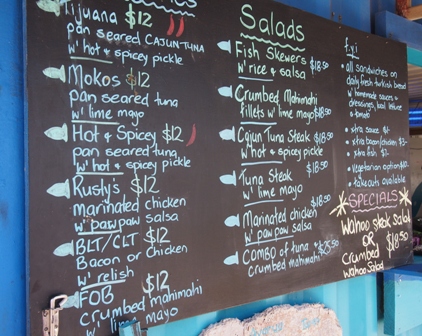 The Moorings Fish Cafe menu[/caption]
The Moorings Fish Cafe menu[/caption]
At The Moorings Cafe on Rarotonga, I ate a very good spicy fish sandwich and drank a fresh coconut juice (‘Nu’ juice in the Cook Islands). I’d like to go there again.
[caption id="attachment_2462" align="alignnone" width="448"]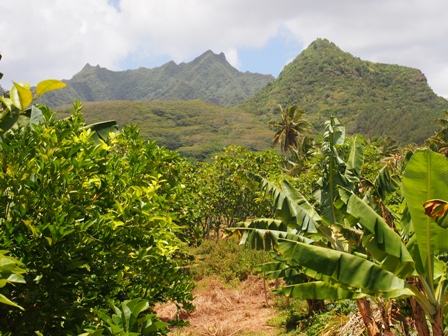 Island Living garden plantation on Rarotonga[/caption]
Island Living garden plantation on Rarotonga[/caption]
The umukai I shared during the Aitutaki Punarei Cultural Tour was really good because it was authentic, the ingredients were top quality and the freshness was outstanding. [caption id="attachment_2465" align="alignnone" width="336"]
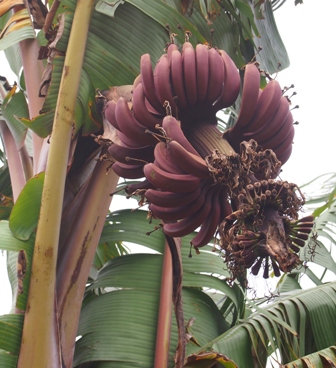 Red bananas in Punarei's garden on Aitutaki[/caption]
Red bananas in Punarei's garden on Aitutaki[/caption]
Samade On The Beach across the channel from Aitutaki Lagoon Resort & Spa is a lovely cafe/restaurant in a stunning location overlooking the lagoon right at the tip of the Ootu Peninsula. Recently acquired by an ex-Pacific Resorts GM, this place is set for great improvements. The small snack I ate of ika mata, fried calamari and plantain chips was very good and shows promise for better things to come. www.samadebeach.com
Also on Aitutaki is Tupuna’s Restaurant, highly recommended by trusted associates. The chilli crab cooked here has a strong following. Tupuna’s is open Mon-Sat from 6p and can be contacted via email: tupunarestaurant@aitutaki.net.ck or local telephone: 31 678.
The Cook Islands produce is essentially organic. Farms are small and clearly the soil is very fertile. The use of pesticides and fertilisers is almost unknown. The incredible freshness and flavour inherent in the produce is obvious. It’s a pity so many cooks don’t show innate respect for their ingredients or they’re stuck in a time warp of 80s Kiwi cooking when mayonnaise came out of large jars and curry powder was considered truly exotic.
Here’s hoping to a successfully evolving Cook Islands food culture driven by passionate and informed cooks.
Naked Routes:
Air New Zealand offers the best connections to Rarotonga. Daily flights operate between Auckland and Rarotonga providing easy one-stop connections with all Australian capital cities and all other New Zealand cities with Air New Zealand domestic services. A once weekly service connects Rarotonga to Sydney non-stop each Saturday. A once weekly non-stop service also connects Rarotonga to Los Angeles. Why Air New Zealand doesn’t do a better job promoting the LAX-Rarotonga-Sydney connection is one of those airline quandaries that puzzle me unceasingly. Imagine the holiday opportunities with that route. www.airnewzealand.co.nz
Virgin Pacific flies regularly between Australia and Rarotonga. www.virginaustralia.com
Air Tahiti operates a once weekly service between Papeete and Rarotonga as a code share arrangement with Air Rarotonga. www.airraro.com
A number of charter services connect all other Cook Islands that have an airstrip. It’s fairly easy, though relatively expensive, to get to Atiu, Mauke and Mangaia in the southern group. Penrhyn’s airstrip is over 1,300 kilometres north of Rarotonga. Charter flights to the northern group of islands that have an airstrip are hellishly expensive. Now that’s a ‘bucket list’ goal to bear in mind.
[caption id="attachment_2469" align="alignnone" width="448"]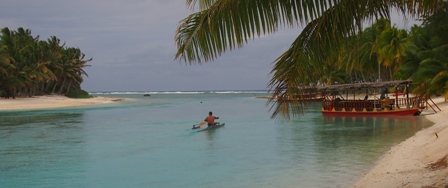 Cook Islands paddling[/caption]
Cook Islands paddling[/caption]
Naked Reads:
‘My Island Home’ by Helen Henry an ex-Kiwi and island resident, widowed to the nation’s first prime minister’s son. Her story is a fascinating one.
‘The Book of PukaPuka’ and ‘Island of Desire’ by American travel writer Robert Dean Frisbie who came to PukaPuka in 1924, married a local woman and stayed to open a general store.
Finally I'd like to say a big 'Kia Orana' to all my Cook Islands friends!
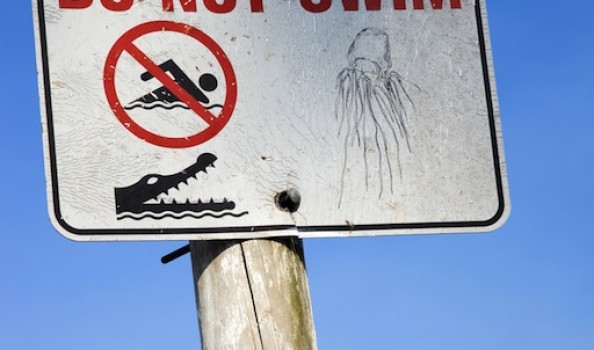 https://nakedhungrytraveller.com.au/dozing-in-darwin-during-the-wet/ Dozing in Darwin During the Wet
https://nakedhungrytraveller.com.au/dozing-in-darwin-during-the-wet/ Dozing in Darwin During the WetTropical torpor is unavoidable when the average humidity exceeds average temperature. Being in Darwin during the Wet is like being cloaked in damp inertia.
The NT News, Darwin's daily tabloid newspaper, is so outrageously hokey that it could be read as an alternative comedy script instead of a fact sheet. Apart from stories about alien landings and crocodile sightings (equally exaggerated), my favourite story during an entertaining week was the one about an angry woman arrested for doing burn-outs in a pub carpark. She was driving a Toyota Yaris, a car the size of a shopping cart with less power than a lawn mower. How she managed to make high speed doughnuts in a small space was never accurately reported. Fun stuff nonetheless. Despite the outrageously high cost of living passed on to visitors and residents like a great big new tax, the town still manages to project a slightly cheap impression. The lackadaisical service found in most hotels, restaurants and cafes and the bog standard food is best ignored if possible. Grin and bear it while you pay up. Darwin can grow on you like a rare mildew, initially repulsive then gradually becoming merely mildly off-putting. But I like Darwin. There is an air of raffishness about its buildings, many draped in vines hidden behind hibiscus or frangipani blooms that almost obscure the plain cement block construction. Note how many residents present an impression of petty criminality, as if a significant percentage of the population escaped to Darwin so as to avoid divorce settlement payments, accumulated parking fines, petty drug offences or all of the above. You get the distinct impression that Darwin could be the town where it's possible to disappear off the grid entirely. [caption id="attachment_1586" align="alignnone" width="448"]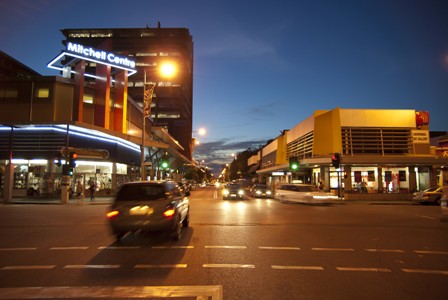 Downtown Darwin's Mitchell Street at dusk.[/caption]
This impression contradicts a pertinent fact. Darwin and the Northern Territory are the most over-governed constituencies on the planet.
That's one parliamentarian for approximately every seven thousand voters.
Per capita, NT politicians out number NT doctors, lawyers and landscape gardeners.
What to do during a wet week in Darwin other than hanging around the grandiose Northern Territory Parliament building waiting for advice from one of the 25 ubiquitous MPs?
Spend a day at the Museum & Art Gallery Northern Territory. This is Darwin's culturally artistic pride and joy. Rightly so as it is an impressive museum that combines natural history, cultural history and the arts in a very clever ensemble.
The Territory is historically rich. For instance, Charles Darwin never visited the town named after him. While in Australia, he remained in New South Wales.
In the museum, the Cyclone Tracy exhibit is particularly moving. Stop for a few minutes in the small dark room where a constantly replayed original recording of the relentless wind is sure to unsettle anyone not hard of hearing. The impression is akin to what it may have been like to have endured the night that tore old Darwin down. Free entry. (Closed Christmas Day, Boxing Day, New Year's Day and Good Friday) See www.magnt.nt.gov.au Conacher Street, Fannie Bay Tel: +61 (0)8 8909 8264
Located smack dab in the middle of backpacking, cafe and restaurant row, Crocosaurus Cove can’t be missed. 'Darwin's ultimate urban wildlife experience, Home to the Cage of Death.' hardly lays claim to a tasteful experience but I have to admit, I was impressed by how well run it is.
Essentially a private zoo, it features scarily large crocodiles as main attention grabbers. Happy-go-lucky tourists here have an opportunity to be dunked into a large pool with one or two gigantic estuarine crocodiles. There is something to be said about watching an adult human in a Perspex cage being lowered into a pool with a five metres long, 800 kilos man-chomping crocodile. All that was missing from the perspective of the onlookers was the theme from 'Jaws' as a musical backdrop.
I was more impressed by the reptile handling experience. The guide/keeper was extremely knowledgeable, professional and in control. While being draped with a two metres long, thick-as-three-fingers water python named Pretzel, I felt surprisingly calm, in good hands so to speak. See www.croccove.com for opening hours and details. General admission price is AUD$28 per adult. The 'Cage of Death' is extra. Bring your own swimwear. 58 Mitchell Street, Darwin City. Tel: +61 (0)8 8981 7522
The safe salt-water Lake Alexander Park at East Point is guaranteed crocodile and marine stingers free. Its verdant location in Darwin's nicest neighbourhood is an attraction in itself. Swimming is encouraged. Bring a picnic.
[caption id="attachment_1611" align="alignnone" width="299"]
Downtown Darwin's Mitchell Street at dusk.[/caption]
This impression contradicts a pertinent fact. Darwin and the Northern Territory are the most over-governed constituencies on the planet.
That's one parliamentarian for approximately every seven thousand voters.
Per capita, NT politicians out number NT doctors, lawyers and landscape gardeners.
What to do during a wet week in Darwin other than hanging around the grandiose Northern Territory Parliament building waiting for advice from one of the 25 ubiquitous MPs?
Spend a day at the Museum & Art Gallery Northern Territory. This is Darwin's culturally artistic pride and joy. Rightly so as it is an impressive museum that combines natural history, cultural history and the arts in a very clever ensemble.
The Territory is historically rich. For instance, Charles Darwin never visited the town named after him. While in Australia, he remained in New South Wales.
In the museum, the Cyclone Tracy exhibit is particularly moving. Stop for a few minutes in the small dark room where a constantly replayed original recording of the relentless wind is sure to unsettle anyone not hard of hearing. The impression is akin to what it may have been like to have endured the night that tore old Darwin down. Free entry. (Closed Christmas Day, Boxing Day, New Year's Day and Good Friday) See www.magnt.nt.gov.au Conacher Street, Fannie Bay Tel: +61 (0)8 8909 8264
Located smack dab in the middle of backpacking, cafe and restaurant row, Crocosaurus Cove can’t be missed. 'Darwin's ultimate urban wildlife experience, Home to the Cage of Death.' hardly lays claim to a tasteful experience but I have to admit, I was impressed by how well run it is.
Essentially a private zoo, it features scarily large crocodiles as main attention grabbers. Happy-go-lucky tourists here have an opportunity to be dunked into a large pool with one or two gigantic estuarine crocodiles. There is something to be said about watching an adult human in a Perspex cage being lowered into a pool with a five metres long, 800 kilos man-chomping crocodile. All that was missing from the perspective of the onlookers was the theme from 'Jaws' as a musical backdrop.
I was more impressed by the reptile handling experience. The guide/keeper was extremely knowledgeable, professional and in control. While being draped with a two metres long, thick-as-three-fingers water python named Pretzel, I felt surprisingly calm, in good hands so to speak. See www.croccove.com for opening hours and details. General admission price is AUD$28 per adult. The 'Cage of Death' is extra. Bring your own swimwear. 58 Mitchell Street, Darwin City. Tel: +61 (0)8 8981 7522
The safe salt-water Lake Alexander Park at East Point is guaranteed crocodile and marine stingers free. Its verdant location in Darwin's nicest neighbourhood is an attraction in itself. Swimming is encouraged. Bring a picnic.
[caption id="attachment_1611" align="alignnone" width="299"] Swimming around Darwin can be dangerous. Obey the signs.[/caption]
East Point juts into Darwin Harbour and was strategically important during WW2, when Darwin was bombed 64 times by Japanese aircraft from 1942 until 1943. The military museum here is well worth visiting, particularly for those interested in Darwin's history prior to 1974 when Cyclone Tracy virtually wiped the town off the map. See www.darwinmilitarymuseum.com.au for more details. 5453 Alec Fong Lim Drive, East Point, Darwin Tel +61 (0)8 8981 9702 AUD$12 per adult entry, open 7 days per week from 9:30 until 17:00.
Having nearly exhausted Darwin's tourist sights in three days, I decided to cross the harbour to Mandorah. Numerous cruise operators offer tours of Darwin's enormous harbour, three times the size of Sydney's, but during the wet season most tour owners are on leave.
The Sea-Cat Ferry leaves from Cullen Bay Marina, ten minute's drive from Darwin's CBD, offers a dozen daily crossings between Mandorah and Darwin. The trip takes about 20 minutes and costs AUD$23 for a return ticket.
The highlight of a visit to Mandorah is a visit to the Mandorah Beach Hotel, 500 metres walk from the Mandorah wharf. The beer garden here is a gem. Overlooking virtually all of Darwin Harbour, it's a very pleasant place to spend an afternoon or evening. Don't miss the return ferry however as it's 120 kilometres hard driving back to town on unsealed roads with wandering wildlife posing as traffic hazards. Late ferry departures operate on weekends. The hotel service is genuinely friendly; it's clearly a well managed business, quite a change from nearly all other establishments I sampled around Darwin. The Mandorah Beach Hotel is open 7 days. Rooms are available as well. Email: mandorahptyltd@bigpond.com
Darwin is unavoidable when visiting the northern Northern Territory. Visits to Kakadu and Litchfield National Parks start from here. The Tiwi Islands lie just to the north in the Arafura Sea. The town is surrounded by sublime natural beauty, yet it remains a curiosity of contrasts.
[caption id="attachment_1585" align="alignnone" width="448"]
Swimming around Darwin can be dangerous. Obey the signs.[/caption]
East Point juts into Darwin Harbour and was strategically important during WW2, when Darwin was bombed 64 times by Japanese aircraft from 1942 until 1943. The military museum here is well worth visiting, particularly for those interested in Darwin's history prior to 1974 when Cyclone Tracy virtually wiped the town off the map. See www.darwinmilitarymuseum.com.au for more details. 5453 Alec Fong Lim Drive, East Point, Darwin Tel +61 (0)8 8981 9702 AUD$12 per adult entry, open 7 days per week from 9:30 until 17:00.
Having nearly exhausted Darwin's tourist sights in three days, I decided to cross the harbour to Mandorah. Numerous cruise operators offer tours of Darwin's enormous harbour, three times the size of Sydney's, but during the wet season most tour owners are on leave.
The Sea-Cat Ferry leaves from Cullen Bay Marina, ten minute's drive from Darwin's CBD, offers a dozen daily crossings between Mandorah and Darwin. The trip takes about 20 minutes and costs AUD$23 for a return ticket.
The highlight of a visit to Mandorah is a visit to the Mandorah Beach Hotel, 500 metres walk from the Mandorah wharf. The beer garden here is a gem. Overlooking virtually all of Darwin Harbour, it's a very pleasant place to spend an afternoon or evening. Don't miss the return ferry however as it's 120 kilometres hard driving back to town on unsealed roads with wandering wildlife posing as traffic hazards. Late ferry departures operate on weekends. The hotel service is genuinely friendly; it's clearly a well managed business, quite a change from nearly all other establishments I sampled around Darwin. The Mandorah Beach Hotel is open 7 days. Rooms are available as well. Email: mandorahptyltd@bigpond.com
Darwin is unavoidable when visiting the northern Northern Territory. Visits to Kakadu and Litchfield National Parks start from here. The Tiwi Islands lie just to the north in the Arafura Sea. The town is surrounded by sublime natural beauty, yet it remains a curiosity of contrasts.
[caption id="attachment_1585" align="alignnone" width="448"] Darwin at night during the Wet monsoon season. Best place anywhere to see lightning storms.[/caption]
By all means, read the NT News while visiting Darwin. News written as fiction apparently doesn't bother the locals. Perhaps that explains much about Darwin in itself.
Naked Facts:
Naked Eats:
The Darwin restaurants I dined in were disappointing. I tried Pee Wee’s at the Point, (www.peewees.com.au Tel: +61 (0)8 8981 6888), Hanuman (www.hanuman.com.au 93 Mitchell Street at the back of the Holiday Inn Esplanade Tel: +61 (0)8 8941 3500), Il Lido, (www.illidodarwin.com.au Darwin City Waterfront f3-Wharf One Tel: +61 (0)8 8941 0900) and Garam Masala, (Shop 34 Mitchell Centre, Darwin City Tel: +61 (0)8 8981 1338). Low expectations may reward the fastidious diner at any of these mentioned here. I liked The Istanbul Café simply because it wasn’t trying to be something it couldn’t be. The location is ideal, prices reasonable and service friendly, a rare trio in Darwin. 12 Knuckey Street Darwin City Tel: +61 (0)8 8941 3777.
I heard that there were a few hidden dining gems in Darwin but during my visit they were either closed or remained hidden.
Naked Sleeps:
Choice of accommodation in Darwin is a dire proposition of averages: Two Holiday Inns, a Novotel, a Crowne Plaza, a Vibe, a Country Comfort and a Travelodge. I stayed at the newish Adina Darwin Waterfront. It's within hopping distance to the 'Wave Pool', Darwin's answer to a huge kiddie pool complete with a wave-making machine. The austere and impersonal outsized Darwin Convention Centre is opposite the hotel. The Adina Darwin Waterfront is just another bland 4-star hotel that serves one of the most disgusting breakfasts I've eaten in a modern hotel in Australia. The Curve restaurant and bar already needs a makeover. The lounges were dirty. Ashtrays overflowed. Service was of the disappearing, untrained kind. But the Adina sadly appears to be the best of a bad lot. See www.adina.com.au/darwin-accommodation for reservations and special deals.
Naked Routes:
Darwin is accessible from all Australian capital cities via Virgin, Qantas and Jetstar airlines. Garuda Indonesia airlines operates flights between Bali and Darwin. If you're heading to Dili, East Timor, Darwin is only an hour's flight away.
Darwin at night during the Wet monsoon season. Best place anywhere to see lightning storms.[/caption]
By all means, read the NT News while visiting Darwin. News written as fiction apparently doesn't bother the locals. Perhaps that explains much about Darwin in itself.
Naked Facts:
Naked Eats:
The Darwin restaurants I dined in were disappointing. I tried Pee Wee’s at the Point, (www.peewees.com.au Tel: +61 (0)8 8981 6888), Hanuman (www.hanuman.com.au 93 Mitchell Street at the back of the Holiday Inn Esplanade Tel: +61 (0)8 8941 3500), Il Lido, (www.illidodarwin.com.au Darwin City Waterfront f3-Wharf One Tel: +61 (0)8 8941 0900) and Garam Masala, (Shop 34 Mitchell Centre, Darwin City Tel: +61 (0)8 8981 1338). Low expectations may reward the fastidious diner at any of these mentioned here. I liked The Istanbul Café simply because it wasn’t trying to be something it couldn’t be. The location is ideal, prices reasonable and service friendly, a rare trio in Darwin. 12 Knuckey Street Darwin City Tel: +61 (0)8 8941 3777.
I heard that there were a few hidden dining gems in Darwin but during my visit they were either closed or remained hidden.
Naked Sleeps:
Choice of accommodation in Darwin is a dire proposition of averages: Two Holiday Inns, a Novotel, a Crowne Plaza, a Vibe, a Country Comfort and a Travelodge. I stayed at the newish Adina Darwin Waterfront. It's within hopping distance to the 'Wave Pool', Darwin's answer to a huge kiddie pool complete with a wave-making machine. The austere and impersonal outsized Darwin Convention Centre is opposite the hotel. The Adina Darwin Waterfront is just another bland 4-star hotel that serves one of the most disgusting breakfasts I've eaten in a modern hotel in Australia. The Curve restaurant and bar already needs a makeover. The lounges were dirty. Ashtrays overflowed. Service was of the disappearing, untrained kind. But the Adina sadly appears to be the best of a bad lot. See www.adina.com.au/darwin-accommodation for reservations and special deals.
Naked Routes:
Darwin is accessible from all Australian capital cities via Virgin, Qantas and Jetstar airlines. Garuda Indonesia airlines operates flights between Bali and Darwin. If you're heading to Dili, East Timor, Darwin is only an hour's flight away. https://nakedhungrytraveller.com.au/eating-green-in-the-usa/ Eating Green in the USA
https://nakedhungrytraveller.com.au/eating-green-in-the-usa/ Eating Green in the USAIn the land of the fat saturated, genetically modified hotdog, it’s easier than you think to eat healthily, if you know where to look.
While soulless supermarkets expand across America, turning food shopping into task management, farmers’ markets put the soul back into eating well. Small country towns from Maine to Hawaii provide school grounds, council squares and public parks to entrepreneurial local growers keen to see their goods sold directly to consumers rather than to anonymous wholesalers. Now it’s rare to find a country town that doesn’t have at least one devoted market day per week on its calendar. Farmers' markets have become nexus points where community interaction dominates localised good food networks. They're also where savvy travellers go to check out what’s happening on the local scene. If you’re bored in Middle America, a visit to the farmer’s market is the place to find a quick cure. On a trip to northern central Indiana, I luckily discovered a hungry traveller’s ironical feast. A sunburnt, grizzled local grower told me that, ‘We got all kinds of termatoes growin’ round here, big red ones and little green ones.’ Discussing the possibilities of pickling the unripe green ‘termatoes’ (tomatoes), we agreed that the big red ones tasted best eaten right off the plant, warmed by the sun. As social centres, markets are invaluable. Check out www.localharvest.org for a listing of farmers’ markets operating across the USA. The Waipa Foundation based in Hanalei, Kaua’i sets the pace, an inspiring volunteer operation where travellers are welcomed with open arms. Each Thursday morning, interested visitors (register your interest online to ensure a place) are invited to help with the weekly poi making. Made from boiled, mashed and fermented taro, pure Waipa poi is packaged for sale during Tuesday’s weekly public market. [caption id="attachment_2311" align="alignnone" width="336"]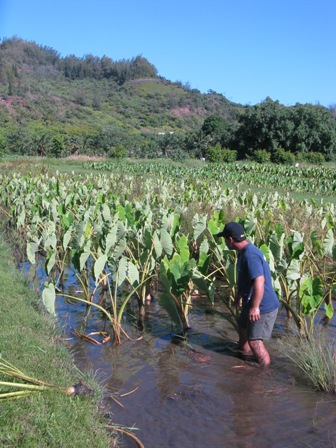 Pulling taro at Waipa farm on Kauai.[/caption]
Part of the joy here is the rare chance to ‘talk story’ with real Hawaiian people. ‘Talking story’ is exchanging histories while having a chat. The people of Hanalei are some of the friendliest in all Hawaii. See www.waipafoundation.org to get a place at the taro peeling table. If you’re lucky you may be asked to stay for lunch. This is as far from Honolulu’s tacky beach tourism as it gets.
Taro is the lifeblood of ancient Hawaiian culture. This most remote archipelago on the planet was always a difficult place in which to find food. First Hawaiians brought taro with them on their voyages across the Pacific Ocean. As a supplement to a primarily protein based diet, it was essential to good health. Over a thousand years later, poi represents the renaissance of Hawaiian culture itself. Making poi in the old way near the shores of Hanalei Bay is experiencing true Hawaiian culture and the emergence of green food tourism.
In 2000 the old Ferry Terminal building in San Francisco became the nation’s first large scale organic direct-from-the-farm produce market, selling everything from wine to beer, fish to fruit, vegetables and artisan cheeses. The renovated industrial site has grown to become one of San Francisco’s most important tourism sights and is open daily. Nearly all retailers here sell their goods based on the principles of the green food movement. (See www.ferrybuildingmarketplace.org for a listing of purveyors)
[caption id="attachment_2314" align="alignnone" width="216"]
Pulling taro at Waipa farm on Kauai.[/caption]
Part of the joy here is the rare chance to ‘talk story’ with real Hawaiian people. ‘Talking story’ is exchanging histories while having a chat. The people of Hanalei are some of the friendliest in all Hawaii. See www.waipafoundation.org to get a place at the taro peeling table. If you’re lucky you may be asked to stay for lunch. This is as far from Honolulu’s tacky beach tourism as it gets.
Taro is the lifeblood of ancient Hawaiian culture. This most remote archipelago on the planet was always a difficult place in which to find food. First Hawaiians brought taro with them on their voyages across the Pacific Ocean. As a supplement to a primarily protein based diet, it was essential to good health. Over a thousand years later, poi represents the renaissance of Hawaiian culture itself. Making poi in the old way near the shores of Hanalei Bay is experiencing true Hawaiian culture and the emergence of green food tourism.
In 2000 the old Ferry Terminal building in San Francisco became the nation’s first large scale organic direct-from-the-farm produce market, selling everything from wine to beer, fish to fruit, vegetables and artisan cheeses. The renovated industrial site has grown to become one of San Francisco’s most important tourism sights and is open daily. Nearly all retailers here sell their goods based on the principles of the green food movement. (See www.ferrybuildingmarketplace.org for a listing of purveyors)
[caption id="attachment_2314" align="alignnone" width="216"]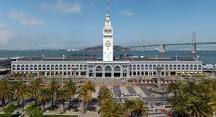 San Francisco Ferry Terminal exterior.[/caption]
California arguably claims to be the birthplace of America’s organic food revolution. Esteemed chef Alice Waters opened Berkeley’s acclaimed Chez Panisse restaurant (see www.chezpanisse.com for reservations) way back in 1971. The Chez Panisse kitchen used locally sourced organic produce well before the practice became fashionable.
[caption id="attachment_2315" align="alignnone" width="162"]
San Francisco Ferry Terminal exterior.[/caption]
California arguably claims to be the birthplace of America’s organic food revolution. Esteemed chef Alice Waters opened Berkeley’s acclaimed Chez Panisse restaurant (see www.chezpanisse.com for reservations) way back in 1971. The Chez Panisse kitchen used locally sourced organic produce well before the practice became fashionable.
[caption id="attachment_2315" align="alignnone" width="162"]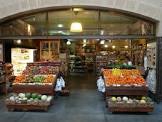 Ferry Terminal market stall.[/caption]
Waters is called the ‘Mother of American food’ and for forty years has publicly embraced sustainability and healthy eating. Vice-President of the International Slow Food movement since 2002 she promotes bio-diversity, local food traditions and small scale quality products. (See www.slowfood.com for contacts across the USA)
Chez Panisse sous-chef Carrie Wilkinson tells me, ‘Forty years later and Chez Panisse is still trail blazing. As much of our menu as possible is sourced locally and is organic.’ Locavoring, sourcing all supplies locally to avoid fuel waste, is the latest buzzword to enter the restaurant world. Chez Panisse was carbon offsetting well before climate change entered public consciousness.
The USA green food movement gains inspiration from indigenous traditions. In this country of new migrants, tradition has simultaneously remained important. Native Americans maintain significant influence over localised food scenes, nowhere more so than in New Mexico. The area around Santa Fe and Taos in the state’s north is noted for its organically raised sustainable food driven culture.
[caption id="attachment_2335" align="alignnone" width="448"]
Ferry Terminal market stall.[/caption]
Waters is called the ‘Mother of American food’ and for forty years has publicly embraced sustainability and healthy eating. Vice-President of the International Slow Food movement since 2002 she promotes bio-diversity, local food traditions and small scale quality products. (See www.slowfood.com for contacts across the USA)
Chez Panisse sous-chef Carrie Wilkinson tells me, ‘Forty years later and Chez Panisse is still trail blazing. As much of our menu as possible is sourced locally and is organic.’ Locavoring, sourcing all supplies locally to avoid fuel waste, is the latest buzzword to enter the restaurant world. Chez Panisse was carbon offsetting well before climate change entered public consciousness.
The USA green food movement gains inspiration from indigenous traditions. In this country of new migrants, tradition has simultaneously remained important. Native Americans maintain significant influence over localised food scenes, nowhere more so than in New Mexico. The area around Santa Fe and Taos in the state’s north is noted for its organically raised sustainable food driven culture.
[caption id="attachment_2335" align="alignnone" width="448"]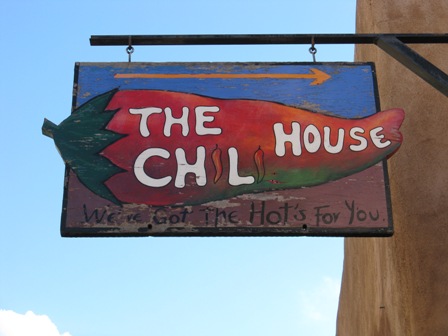 Santa Fe shop sign.[/caption]
Naked Tip: Check out Georgia O’Keeffe’s museum in Santa Fe. O’Keeffe was a talented cook as well as renowned artist. Her compound at Abiquiu was planted with an extensive kitchen garden as O’Keeffe deplored the poor selection of vegetables available in Santa Fe. She wrote a cookbook about how to use organic produce. (See www.okeeffemuseum.org for opening hours and directions to her houses at Abiquiu and Ghost Ranch.)
[caption id="attachment_2316" align="alignnone" width="155"]
Santa Fe shop sign.[/caption]
Naked Tip: Check out Georgia O’Keeffe’s museum in Santa Fe. O’Keeffe was a talented cook as well as renowned artist. Her compound at Abiquiu was planted with an extensive kitchen garden as O’Keeffe deplored the poor selection of vegetables available in Santa Fe. She wrote a cookbook about how to use organic produce. (See www.okeeffemuseum.org for opening hours and directions to her houses at Abiquiu and Ghost Ranch.)
[caption id="attachment_2316" align="alignnone" width="155"] Georgia O'Keeffe Museum exterior.[/caption]
For a city with a relatively small population, Santa Fe is blessed with restaurants specialising in regional cuisine sourced from organic produce.
[caption id="attachment_2334" align="alignnone" width="356"]
Georgia O'Keeffe Museum exterior.[/caption]
For a city with a relatively small population, Santa Fe is blessed with restaurants specialising in regional cuisine sourced from organic produce.
[caption id="attachment_2334" align="alignnone" width="356"]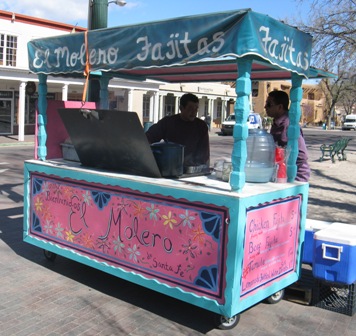 Fajitas stall in Santa Fe's main town square.[/caption]
Green is good has been a slogan here for decades. It’s an arts city fuelled by an extraordinarily sophisticated dining culture. Check out the Coyote Café (www.coyotecafe.com) or Café Pasqual (www.pasquals.com) to discover what’s hot on the sustainable food scene in New Mexico.
The Midwest is historically strongly connected to the land. Surprising given its industrial roots, Chicago is one of America’s greenest cities. (See www.explorechicago.org for a listing of green hotels, green restaurants and green buildings.) Chicago’s 7 million plus square feet of green roofs comprise more than all other USA cities combined. Rooftop gardens have literally sprouted up all over this huge metropolis, like broccoli flowers on tall stalks.
[caption id="attachment_2318" align="alignnone" width="300"]
Fajitas stall in Santa Fe's main town square.[/caption]
Green is good has been a slogan here for decades. It’s an arts city fuelled by an extraordinarily sophisticated dining culture. Check out the Coyote Café (www.coyotecafe.com) or Café Pasqual (www.pasquals.com) to discover what’s hot on the sustainable food scene in New Mexico.
The Midwest is historically strongly connected to the land. Surprising given its industrial roots, Chicago is one of America’s greenest cities. (See www.explorechicago.org for a listing of green hotels, green restaurants and green buildings.) Chicago’s 7 million plus square feet of green roofs comprise more than all other USA cities combined. Rooftop gardens have literally sprouted up all over this huge metropolis, like broccoli flowers on tall stalks.
[caption id="attachment_2318" align="alignnone" width="300"] One of Chicago's many private rooftop gardens.[/caption]
The green food movement here relies heavily on its famously enthusiastic adherents. Star-studded chefs like acclaimed Grant Achatz (who trained under Charlie Trotter's guidance) at Alinea (see www.alinea-restaurant.com for reservations) embraced sustainable harvesting practices right from the get-go of their illustrious careers.
Wisconsin is known as the Dairy State. Though encumbered by mass production (tasteless ‘cheese curds’ remain a popular snack), an emergent artisan cheese industry is taking keen restaurateurs and purveyors by storm. Wisconsin is brimming with picture postcard farms, especially in the hilly southwest region. The scenery here is some of America’s most bucolic and peaceful. See www.eatwisconsincheese.com and download its Traveler’s Guide to see how far an artisan organic cheese adventure will take you around the dairy state. Be prepared for a surprisingly long trip. At latest count, 44 artisan cheese makers are plying their wares to the public.
[caption id="attachment_2319" align="alignnone" width="145"]
One of Chicago's many private rooftop gardens.[/caption]
The green food movement here relies heavily on its famously enthusiastic adherents. Star-studded chefs like acclaimed Grant Achatz (who trained under Charlie Trotter's guidance) at Alinea (see www.alinea-restaurant.com for reservations) embraced sustainable harvesting practices right from the get-go of their illustrious careers.
Wisconsin is known as the Dairy State. Though encumbered by mass production (tasteless ‘cheese curds’ remain a popular snack), an emergent artisan cheese industry is taking keen restaurateurs and purveyors by storm. Wisconsin is brimming with picture postcard farms, especially in the hilly southwest region. The scenery here is some of America’s most bucolic and peaceful. See www.eatwisconsincheese.com and download its Traveler’s Guide to see how far an artisan organic cheese adventure will take you around the dairy state. Be prepared for a surprisingly long trip. At latest count, 44 artisan cheese makers are plying their wares to the public.
[caption id="attachment_2319" align="alignnone" width="145"]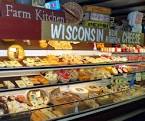 Wisconsin cheese display.[/caption]
Naked Tip: Don’t miss Frank Lloyd Wright’s studio at Taliesin outside Spring Green. Known as the father of ‘Organic Architecture’, Wright’s buildings are a synthesis of the natural environment melding into personal space. See www.taliesinpreservation.org for directions and opening times.
[caption id="attachment_2320" align="alignnone" width="185"]
Wisconsin cheese display.[/caption]
Naked Tip: Don’t miss Frank Lloyd Wright’s studio at Taliesin outside Spring Green. Known as the father of ‘Organic Architecture’, Wright’s buildings are a synthesis of the natural environment melding into personal space. See www.taliesinpreservation.org for directions and opening times.
[caption id="attachment_2320" align="alignnone" width="185"] Part of Taliesin's extensive garden.[/caption]
There is a strong green food movement operating in the Piedmont region. Food activists such as Barbara Kingsolver (see her 2007 book ‘Animal, Vegetable, Miracle’) and Michael Pollan (see his ‘The Omnivore’s Dilemma’ published in 2006) have written extensively about the so-called ‘catchatarian’ and ‘locavorian’ movements, based on living off the land, using all local ingredients.
Naked Tip: America’s third president, Thomas Jefferson, was an avid gardener and started one of the world’s first seed banks. His heritage property Monticello (see www.monticello.org for details and visiting times) located in the foothills of Virginia’s Shenandoah Mountains near Charlottesville has recreated the original kitchen garden, all organic.
[caption id="attachment_2321" align="alignnone" width="179"]
Part of Taliesin's extensive garden.[/caption]
There is a strong green food movement operating in the Piedmont region. Food activists such as Barbara Kingsolver (see her 2007 book ‘Animal, Vegetable, Miracle’) and Michael Pollan (see his ‘The Omnivore’s Dilemma’ published in 2006) have written extensively about the so-called ‘catchatarian’ and ‘locavorian’ movements, based on living off the land, using all local ingredients.
Naked Tip: America’s third president, Thomas Jefferson, was an avid gardener and started one of the world’s first seed banks. His heritage property Monticello (see www.monticello.org for details and visiting times) located in the foothills of Virginia’s Shenandoah Mountains near Charlottesville has recreated the original kitchen garden, all organic.
[caption id="attachment_2321" align="alignnone" width="179"] Monticello exterior.[/caption]
Around Asheville, North Carolina another green food movement has evolved, this one based on foraging from the enormous quantities of food Americans continue to waste each year. Though rummaging through rubbish bins is potentially a risky route to gourmet green eating, it’s a concept that has taken off among people who are trying to avoid the worst excesses of America’s dominant agri-business driven consumerist society.
Clover, (a pseudonym) is one of seven followers of an underground food movement sharing an abandoned house in central Asheville. He says, ‘We’re just living way simple, super low-impact, deep green.’ The house has been repainted greenish grey, courtesy of twenty-three cans of leftover paint from Home Depot. ‘We don’t dumpster McDonald’s,’ he adds but leftover sushi is okay as long as it didn’t sit in the rubbish bins overnight.
For more information about America’s newest hunting and gathering revolution, read green food activist and writer Sandor Katz’ books, ‘Wild Fermentation’ and ‘The Revolution Will Not Be Microwaved’.
A useful guide for hungry green-going visitors is www.eatwellguide.org, an extensive listing of restaurants, farm shops and markets around the USA and Canada.
[caption id="attachment_2322" align="alignnone" width="89"]
Monticello exterior.[/caption]
Around Asheville, North Carolina another green food movement has evolved, this one based on foraging from the enormous quantities of food Americans continue to waste each year. Though rummaging through rubbish bins is potentially a risky route to gourmet green eating, it’s a concept that has taken off among people who are trying to avoid the worst excesses of America’s dominant agri-business driven consumerist society.
Clover, (a pseudonym) is one of seven followers of an underground food movement sharing an abandoned house in central Asheville. He says, ‘We’re just living way simple, super low-impact, deep green.’ The house has been repainted greenish grey, courtesy of twenty-three cans of leftover paint from Home Depot. ‘We don’t dumpster McDonald’s,’ he adds but leftover sushi is okay as long as it didn’t sit in the rubbish bins overnight.
For more information about America’s newest hunting and gathering revolution, read green food activist and writer Sandor Katz’ books, ‘Wild Fermentation’ and ‘The Revolution Will Not Be Microwaved’.
A useful guide for hungry green-going visitors is www.eatwellguide.org, an extensive listing of restaurants, farm shops and markets around the USA and Canada.
[caption id="attachment_2322" align="alignnone" width="89"] Not all Americans look like this.[/caption]
Though many Americans continue to live gratuitously off the land, getting fatter by the day, the green food movement is well established despite whatever MacDonald’s may advertise to the contrary.
Tom Neal Tacker travelled courtesy of United Airlines, Hawaiian Airlines, Hawaii Tourism and New Mexico Tourism.
Not all Americans look like this.[/caption]
Though many Americans continue to live gratuitously off the land, getting fatter by the day, the green food movement is well established despite whatever MacDonald’s may advertise to the contrary.
Tom Neal Tacker travelled courtesy of United Airlines, Hawaiian Airlines, Hawaii Tourism and New Mexico Tourism.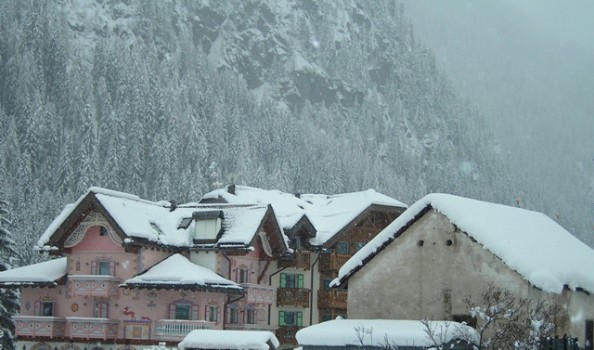 https://nakedhungrytraveller.com.au/bella-italia/ Bella Italia!The Dolomite Alps in winter is a snowy wonderland. Canazei hardly seems real. Its houses, pretty and decorated, are from fairytales and nursery rhymes. They are Hansel and Gretel houses, gingerbread houses, green, blue, yellow and pink with pretty chimneys and hobbit doors. Under a blanket of snow, Canazei is a Christmas card. It lies in the Val di Fassa, deep in the Dolomite Mountains and it sits impossibly picture perfect in any season. The whole valley defies superlatives. Its spruce and fir trees, heavily laden with snow in winter, lie thickly at the base of the truly awesome mountains of the Gruppo Sella and the wonderful, evocatively named Marmolada. It’s got me talking in teenage-speak but here, in this little town in this beautiful valley, I’m almost certain they invented the word “awe”. In the middle of the town runs its pretty stream, the Torrente Avisio. It bubbles along under snow beds and old, wooden bridges. Here and there, in Canazei and the neighbouring towns, the fountains are frozen to create sculptures of cascading, blue ice. [caption id="attachment_1539" align="alignnone" width="448"]
https://nakedhungrytraveller.com.au/bella-italia/ Bella Italia!The Dolomite Alps in winter is a snowy wonderland. Canazei hardly seems real. Its houses, pretty and decorated, are from fairytales and nursery rhymes. They are Hansel and Gretel houses, gingerbread houses, green, blue, yellow and pink with pretty chimneys and hobbit doors. Under a blanket of snow, Canazei is a Christmas card. It lies in the Val di Fassa, deep in the Dolomite Mountains and it sits impossibly picture perfect in any season. The whole valley defies superlatives. Its spruce and fir trees, heavily laden with snow in winter, lie thickly at the base of the truly awesome mountains of the Gruppo Sella and the wonderful, evocatively named Marmolada. It’s got me talking in teenage-speak but here, in this little town in this beautiful valley, I’m almost certain they invented the word “awe”. In the middle of the town runs its pretty stream, the Torrente Avisio. It bubbles along under snow beds and old, wooden bridges. Here and there, in Canazei and the neighbouring towns, the fountains are frozen to create sculptures of cascading, blue ice. [caption id="attachment_1539" align="alignnone" width="448"]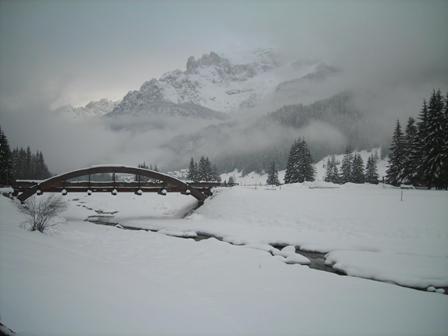 Canazei's bridge in winter. By Marisa Spiller.[/caption]
The towns of the Val di Fassa have names like Campitello, Campestrin, Fontanazzo, Alba and, the jewel in the crown, Canazei. Each boasts pretty houses and churches with onion-shaped steeple tops. We sit and have pizza in locales that have lacy curtains and where everything is wood-turned and carved. It is a place of folk art and a quaintness that is impossible to resist. You feel like you’ve been here before because you remember all those childhood stories about woodcutters, red apples and houses iced with sugar and dripping with sweets. Doors are adorned here with copper pots, teddy bears and sprigs of spruce.
There is no doubt that the locals are born out of this environment. They are mountain people, weathered and resilient with that ruddy colour that comes from living an age in the snow. They have knotty walking canes and appropriate boots and hats embellished with feathers and brushes. They look like fairy wood folk, their woodpiles neatly stacked by their doors. And, just when your mouth couldn’t get any more agape, a white horse-drawn sleigh with chiming bells jingles into view. Now you know it’s not real.
We stay at La Pineta, a family-run chalet a little out from the town centre. It sits in a field of snow where, in late January every year, Nordic skiers contesting the 72-kilometre Marcialonga, fly past its doors to the sound of cow bells, cheering and singing.
This is Canazei and it’s a wonderland.
by Marisa Tarascio Spiller
Naked Facts:
Albergo Hotel Chalet La Pineta
Via del Ciuch, 34
38032 Canazei di Fassa, Trentino Alto Adige, Italy
Canazei's bridge in winter. By Marisa Spiller.[/caption]
The towns of the Val di Fassa have names like Campitello, Campestrin, Fontanazzo, Alba and, the jewel in the crown, Canazei. Each boasts pretty houses and churches with onion-shaped steeple tops. We sit and have pizza in locales that have lacy curtains and where everything is wood-turned and carved. It is a place of folk art and a quaintness that is impossible to resist. You feel like you’ve been here before because you remember all those childhood stories about woodcutters, red apples and houses iced with sugar and dripping with sweets. Doors are adorned here with copper pots, teddy bears and sprigs of spruce.
There is no doubt that the locals are born out of this environment. They are mountain people, weathered and resilient with that ruddy colour that comes from living an age in the snow. They have knotty walking canes and appropriate boots and hats embellished with feathers and brushes. They look like fairy wood folk, their woodpiles neatly stacked by their doors. And, just when your mouth couldn’t get any more agape, a white horse-drawn sleigh with chiming bells jingles into view. Now you know it’s not real.
We stay at La Pineta, a family-run chalet a little out from the town centre. It sits in a field of snow where, in late January every year, Nordic skiers contesting the 72-kilometre Marcialonga, fly past its doors to the sound of cow bells, cheering and singing.
This is Canazei and it’s a wonderland.
by Marisa Tarascio Spiller
Naked Facts:
Albergo Hotel Chalet La Pineta
Via del Ciuch, 34
38032 Canazei di Fassa, Trentino Alto Adige, Italy
 https://nakedhungrytraveller.com.au/escape-to-windy-wellington/ Escape to Windy Wellington
https://nakedhungrytraveller.com.au/escape-to-windy-wellington/ Escape to Windy WellingtonIt’s only 2 hours from eastern Australia if there’s a strong tailwind…
Before the Hobbit and the Lord of the Rings films came to dominate New Zealand’s tourism scene, the two main islands were best known for stunning scenery, adventure tourism, ski resorts and sheep, lots and lots of sheep. In a country with approximately 4.4 million inhabitants, the sheep population stands at approximately 31.1 million, resulting in a sheep-to-human ratio of seven to one, a significant drop from the peak year, 1982, when 70.3 million sheep outnumbered 3.18 million people by 22 to 1. Its three big cities: Auckland, Christchurch and Wellington hardly rank highly on most international visitors' lists of ‘must do’ destinations. [caption id="attachment_2338" align="alignnone" width="259"] Cable car from Lambton Quay to Kelburn near the Botanic Gardens.[/caption]
These three metropolises currently claim over half the country’s total population. Like Australians, Kiwis have embraced the cosmopolitan life, choosing city life over country life in overwhelming proportions.
There’s a reason why Kiwis gravitate to their cities, employment being the primary reason. Secondly, if you want city lights and urban excitement in New Zealand, the choices are naturally limited.
[caption id="attachment_2345" align="alignnone" width="213"]
Cable car from Lambton Quay to Kelburn near the Botanic Gardens.[/caption]
These three metropolises currently claim over half the country’s total population. Like Australians, Kiwis have embraced the cosmopolitan life, choosing city life over country life in overwhelming proportions.
There’s a reason why Kiwis gravitate to their cities, employment being the primary reason. Secondly, if you want city lights and urban excitement in New Zealand, the choices are naturally limited.
[caption id="attachment_2345" align="alignnone" width="213"]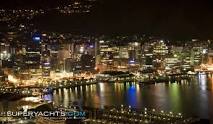 Lambton Quay Wellington's waterfront at night.[/caption]
Here Wellington takes top line honours and there’s hardly a sheep in sight. Boredom as a kind of travel stasis rarely comes to mind when considering Wellington as a choice destination.
While Wellington has become the film capital of New Zealand, it has also grown into a fun loving small city packed with surprises.
Wellingtonians will happily point out the 'Tipping Buckets' fountain in Cuba Street right in the centre of town where Frodo Baggins (aka Elijah Wood) was cautioned by the police to remove himself from its uppermost pail after getting a bit tipsy with the locals during a pub crawl.
[caption id="attachment_2339" align="alignnone" width="448"]
Lambton Quay Wellington's waterfront at night.[/caption]
Here Wellington takes top line honours and there’s hardly a sheep in sight. Boredom as a kind of travel stasis rarely comes to mind when considering Wellington as a choice destination.
While Wellington has become the film capital of New Zealand, it has also grown into a fun loving small city packed with surprises.
Wellingtonians will happily point out the 'Tipping Buckets' fountain in Cuba Street right in the centre of town where Frodo Baggins (aka Elijah Wood) was cautioned by the police to remove himself from its uppermost pail after getting a bit tipsy with the locals during a pub crawl.
[caption id="attachment_2339" align="alignnone" width="448"]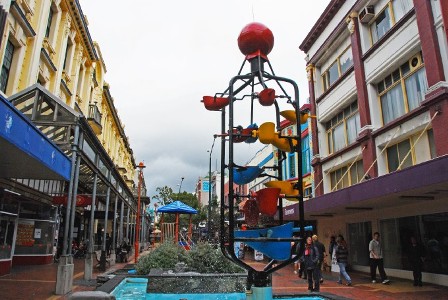 Cuba St Tipping Buckets Fountain by Peter Fisher.[/caption]
Apparently, the hobbits were enjoying just another night out while filming the Lord of the Rings trilogy that put Wellington on the map of notoriety in a way that earthquakes, horrendous storms, freakish winds and famed local author Katherine Mansfield couldn’t.
[caption id="attachment_2348" align="alignnone" width="127"]
Cuba St Tipping Buckets Fountain by Peter Fisher.[/caption]
Apparently, the hobbits were enjoying just another night out while filming the Lord of the Rings trilogy that put Wellington on the map of notoriety in a way that earthquakes, horrendous storms, freakish winds and famed local author Katherine Mansfield couldn’t.
[caption id="attachment_2348" align="alignnone" width="127"] WETA studios building.[/caption]
If you’re a keen hobbit fan, then Wellington is definitely the NZ town in which to satisfy your curiosity. Which is a pity really... The capital of NZ is so much more than the back lot for a film, even if Peter Jackson uses it as one.
[caption id="attachment_2340" align="alignnone" width="93"]
WETA studios building.[/caption]
If you’re a keen hobbit fan, then Wellington is definitely the NZ town in which to satisfy your curiosity. Which is a pity really... The capital of NZ is so much more than the back lot for a film, even if Peter Jackson uses it as one.
[caption id="attachment_2340" align="alignnone" width="93"] Gollum figure at Weta Studios.[/caption]
For instance, Te Papa, the national museum of New Zealand has become Wellington’s cultural locus. Opened in 1998, the museum is a rapidly running success story with over 10 million visitors thus far and still counting.
[caption id="attachment_2341" align="alignnone" width="164"]
Gollum figure at Weta Studios.[/caption]
For instance, Te Papa, the national museum of New Zealand has become Wellington’s cultural locus. Opened in 1998, the museum is a rapidly running success story with over 10 million visitors thus far and still counting.
[caption id="attachment_2341" align="alignnone" width="164"] Te Papa Tongarewa Museum of New Zealand main entrance.[/caption]
Don’t miss viewing the enlarged copy of the Treaty of Waitangi which went a long way to protect Maori land rights during a time when British colonists were not often intent on even admitting that indigenous peoples actually had rights at all. (The original copy is housed under glass in the National Archives building also in Wellington.) Te Papa should be an obligatory stop on your itinerary and is an amazing insight into the Maori homeland Aotearoa, which translates as The Land of the Long White Cloud. Or The Land of the Long Flat Vowel as some Australian pundits describe the Kiwi’s predilection for flattening vowels so they all sound like ‘eh’.
The Karori Wildlife Sanctuary is another surprise. Within walking distance of the CBD are 252 hectares of pest-free sanctuary devoted to the rehabilitation of many of NZ’s threatened species. Kiwis, wekas, kakas and wetas thrive here under protection from roaming feral cats, dogs, rats and destructive possums.
[caption id="attachment_2342" align="alignnone" width="185"]
Te Papa Tongarewa Museum of New Zealand main entrance.[/caption]
Don’t miss viewing the enlarged copy of the Treaty of Waitangi which went a long way to protect Maori land rights during a time when British colonists were not often intent on even admitting that indigenous peoples actually had rights at all. (The original copy is housed under glass in the National Archives building also in Wellington.) Te Papa should be an obligatory stop on your itinerary and is an amazing insight into the Maori homeland Aotearoa, which translates as The Land of the Long White Cloud. Or The Land of the Long Flat Vowel as some Australian pundits describe the Kiwi’s predilection for flattening vowels so they all sound like ‘eh’.
The Karori Wildlife Sanctuary is another surprise. Within walking distance of the CBD are 252 hectares of pest-free sanctuary devoted to the rehabilitation of many of NZ’s threatened species. Kiwis, wekas, kakas and wetas thrive here under protection from roaming feral cats, dogs, rats and destructive possums.
[caption id="attachment_2342" align="alignnone" width="185"] Karori Wildlife Sanctuary entrance.[/caption]
Hearing birdsong here is unforgettable, a sound memory of what NZ may have been like before so many of its native bird species were wiped out from deforestation, loss of habitat and the introduction of predators previously unknown to New Zealand.
At Karori, it’s also possible to get close a weta, a cricket-like bug the size of a child’s hand, a memorably spooky experience. Peter Jackson's Wellington film production business is called Weta Studios. Scary looking insect names major international film production house?
[caption id="attachment_2343" align="alignnone" width="191"]
Karori Wildlife Sanctuary entrance.[/caption]
Hearing birdsong here is unforgettable, a sound memory of what NZ may have been like before so many of its native bird species were wiped out from deforestation, loss of habitat and the introduction of predators previously unknown to New Zealand.
At Karori, it’s also possible to get close a weta, a cricket-like bug the size of a child’s hand, a memorably spooky experience. Peter Jackson's Wellington film production business is called Weta Studios. Scary looking insect names major international film production house?
[caption id="attachment_2343" align="alignnone" width="191"]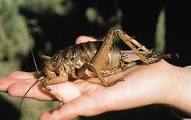 Weta in hand.[/caption]
Wellington’s nightlife is unusually sophisticated for a city this size. It rocks. I wasn’t expecting much but Wellington really hums with delicious activity. Pubs, nightclubs, cafes and restaurants are packed and friendly. With over 400 dining options, it outranks even Sydney on a per capita basis. It’s certainly not the sleepy government town I anticipated. Clearly, having a collection of embassies, high commissions and their foreign workers has added much to Wellington’s cultural diversity.
[caption id="attachment_2344" align="alignnone" width="178"]
Weta in hand.[/caption]
Wellington’s nightlife is unusually sophisticated for a city this size. It rocks. I wasn’t expecting much but Wellington really hums with delicious activity. Pubs, nightclubs, cafes and restaurants are packed and friendly. With over 400 dining options, it outranks even Sydney on a per capita basis. It’s certainly not the sleepy government town I anticipated. Clearly, having a collection of embassies, high commissions and their foreign workers has added much to Wellington’s cultural diversity.
[caption id="attachment_2344" align="alignnone" width="178"]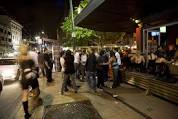 Wellington nightlife can be quite busy.[/caption]
And if you decide to wear furry costume feet in public whilst trying to appear very small, I’m sure no one will notice.
Tom Neal Tacker visited Wellington as a guest of its tourism authority.
Naked Facts:
Note: Wellington is a windy city. On lists of the world’s windiest cities, it ranks first according to most global meteorological websites. Hold on to your umbrellas and hats travellers!
www.WellingtonNZ.com for general information on greater Wellington.
www.wellingtonrover.co.nz for Lord of the Rings Tours.
www.tepapa.govt.nz for upcoming exhibitions at Te Papa.
www.sanctuary.org.nz for more about Karori Wildlife Sanctuary.
Wellington nightlife can be quite busy.[/caption]
And if you decide to wear furry costume feet in public whilst trying to appear very small, I’m sure no one will notice.
Tom Neal Tacker visited Wellington as a guest of its tourism authority.
Naked Facts:
Note: Wellington is a windy city. On lists of the world’s windiest cities, it ranks first according to most global meteorological websites. Hold on to your umbrellas and hats travellers!
www.WellingtonNZ.com for general information on greater Wellington.
www.wellingtonrover.co.nz for Lord of the Rings Tours.
www.tepapa.govt.nz for upcoming exhibitions at Te Papa.
www.sanctuary.org.nz for more about Karori Wildlife Sanctuary.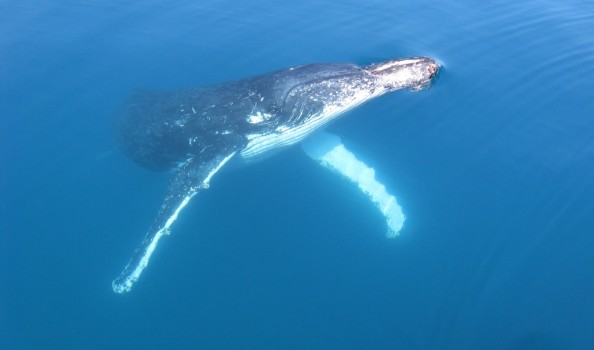 https://nakedhungrytraveller.com.au/where-the-whales-play/ Where the Whales Play
https://nakedhungrytraveller.com.au/where-the-whales-play/ Where the Whales PlayWhen southern humpback whales stop for a rest at Queensland’s Great Sandy Strait off Fraser Island, human travellers happily share the layover.
Do southern humpback whales frolic? It’s a question I often ask myself whenever I get up close and personal with a group of ‘humpies’ relaxing in Queensland’s Great Sandy Strait off Fraser Island. While two adolescent male whales apparently show as much interest in a boat packed with cetacean-crazed travellers as the travellers do in them, I’m inclined to say yes, they do frolic in the limelight. Like kids on a sugary lolly rush, two young whales play near our boat with boundless enthusiasm, flipper slapping, tail wagging, body rolling and head bobbing. They run the full gamut of recognised southern humpback whale play, much to the audible delight of all the passengers on board the Quick Cat 2. [caption id="attachment_1648" align="alignnone" width="448"]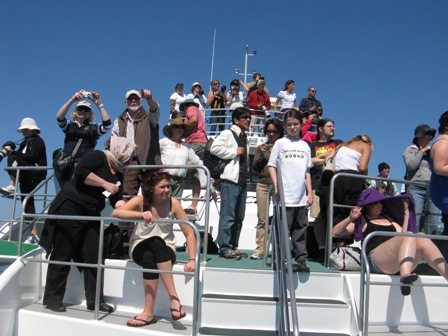 Whale watchers on Hervey Bay.[/caption]
Nowadays, passengers are encouraged to create lots of noise when whales are sighted to attract their attention, hopefully encouraging enough curiosity in the whales to linger socially around the boat. When I first ventured on a southern humpback whale sighting adventure in Hervey Bay some twelve years ago, the overall experience was marked by hushed solemnity, as if simply being silent in the presence of these endangered animals was sufficient thrill in itself. But times have changed and much has been learned about southern humpback whale behaviour.
The number of whales that migrate along the eastern seaboard of mainland Australia has increased to such an extent that no longer are whale sightings considered rare events. Instead it has become commonplace during their late winter and early spring migration to see southern humpback whales all along the eastern shore of Australia from the northern extremity of Queensland’s outer Great Barrier Reef to southern Tasmania as the whales proceed to summer feeding areas off Antarctica’s icy shores. But Queensland’s Great Sandy Strait is undoubtedly whale watching central.
Previously hushed day trips out to the calm waters of shallow Platypus Bay off Fraser Island are no longer quiet. Southern humpback whales are attracted to noisy human activity. Waving, shouting, trilling and singing are encouraged by captain and crew. Don’t be surprised to find that whale watching trips in the Great Sandy Strait have become significantly louder on the decibel scale. I have the questionably good luck to be standing next to a young boy whose ability to replicate the sound of a revved up jet engine guarantees that all whales within earshot swim to us as quickly as their big fins can manage. The whales appear enthralled that such a small animal can make such a piercingly loud noise. I plant my hands over my ears and enjoy the spectacle of large whales peering intently at a small human who is peering at large whales but can’t determine which is more fascinated by which. I am also enthralled that such an incredibly visceral noise can be uttered by a human adolescent.
[caption id="attachment_1649" align="alignnone" width="448"]
Whale watchers on Hervey Bay.[/caption]
Nowadays, passengers are encouraged to create lots of noise when whales are sighted to attract their attention, hopefully encouraging enough curiosity in the whales to linger socially around the boat. When I first ventured on a southern humpback whale sighting adventure in Hervey Bay some twelve years ago, the overall experience was marked by hushed solemnity, as if simply being silent in the presence of these endangered animals was sufficient thrill in itself. But times have changed and much has been learned about southern humpback whale behaviour.
The number of whales that migrate along the eastern seaboard of mainland Australia has increased to such an extent that no longer are whale sightings considered rare events. Instead it has become commonplace during their late winter and early spring migration to see southern humpback whales all along the eastern shore of Australia from the northern extremity of Queensland’s outer Great Barrier Reef to southern Tasmania as the whales proceed to summer feeding areas off Antarctica’s icy shores. But Queensland’s Great Sandy Strait is undoubtedly whale watching central.
Previously hushed day trips out to the calm waters of shallow Platypus Bay off Fraser Island are no longer quiet. Southern humpback whales are attracted to noisy human activity. Waving, shouting, trilling and singing are encouraged by captain and crew. Don’t be surprised to find that whale watching trips in the Great Sandy Strait have become significantly louder on the decibel scale. I have the questionably good luck to be standing next to a young boy whose ability to replicate the sound of a revved up jet engine guarantees that all whales within earshot swim to us as quickly as their big fins can manage. The whales appear enthralled that such a small animal can make such a piercingly loud noise. I plant my hands over my ears and enjoy the spectacle of large whales peering intently at a small human who is peering at large whales but can’t determine which is more fascinated by which. I am also enthralled that such an incredibly visceral noise can be uttered by a human adolescent.
[caption id="attachment_1649" align="alignnone" width="448"]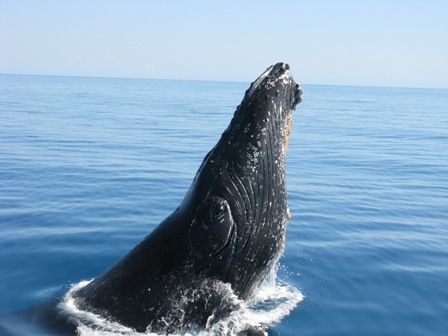 Southern Humpback spy-hopping.[/caption]
Last year’s southern humpback whale watching season was hugely successful. As the population of whales recovers from ruthless hunting, evidently the whales’ collective genetic memory is shifting from innate fear to curious interest. The whales show little wariness of humans while they rest at their historical watery wayside in the tranquillity of the Great Sandy Strait en route to Antarctica. A few individual whales have become familiar, recognised regular visitors, a positive sign as to the longevity of the species and the effects of long term protection.
The protected waters between Fraser Island and Queensland offer safe sanctuary for mothers with calves, adolescent whales gaining strength for the long swim south, mature males stopping in for a spy-hop or two, checking out females for potential future dalliances and whole family groups of mixed ages. Some whales stay only for a day. Many stay for five days or longer. Quick Cat 2 skipper Brian Perry tells me that from only dozens of whales spotted during an entire season in the late 80s, the number of southern humpback whales lounging around near the white sandy beaches of Fraser Island’s western shore has since grown to hundreds if not thousands.
The Perry family pioneered whale watching trips to Platypus Bay and the Great Sandy Strait 23 years ago. In 2009, they linked up with Kingfisher Resort at Kingfisher Bay on Fraser Island to offer half-day whale watching trips to nearby Platypus Bay. Though numerous whale-watching day excursions leave from Hervey Bay’s central marina, the Perry operation, using their speedy catamaran Quick Cat 2 specially equipped with hydrophone and underwater camera, departs Kingfisher Bay Resort’s wharf midway along Fraser Island’s western shore. Passengers are smack dab in the middle of serious southern humpback whale action within 45 minutes.
[caption id="attachment_1650" align="alignnone" width="448"]
Southern Humpback spy-hopping.[/caption]
Last year’s southern humpback whale watching season was hugely successful. As the population of whales recovers from ruthless hunting, evidently the whales’ collective genetic memory is shifting from innate fear to curious interest. The whales show little wariness of humans while they rest at their historical watery wayside in the tranquillity of the Great Sandy Strait en route to Antarctica. A few individual whales have become familiar, recognised regular visitors, a positive sign as to the longevity of the species and the effects of long term protection.
The protected waters between Fraser Island and Queensland offer safe sanctuary for mothers with calves, adolescent whales gaining strength for the long swim south, mature males stopping in for a spy-hop or two, checking out females for potential future dalliances and whole family groups of mixed ages. Some whales stay only for a day. Many stay for five days or longer. Quick Cat 2 skipper Brian Perry tells me that from only dozens of whales spotted during an entire season in the late 80s, the number of southern humpback whales lounging around near the white sandy beaches of Fraser Island’s western shore has since grown to hundreds if not thousands.
The Perry family pioneered whale watching trips to Platypus Bay and the Great Sandy Strait 23 years ago. In 2009, they linked up with Kingfisher Resort at Kingfisher Bay on Fraser Island to offer half-day whale watching trips to nearby Platypus Bay. Though numerous whale-watching day excursions leave from Hervey Bay’s central marina, the Perry operation, using their speedy catamaran Quick Cat 2 specially equipped with hydrophone and underwater camera, departs Kingfisher Bay Resort’s wharf midway along Fraser Island’s western shore. Passengers are smack dab in the middle of serious southern humpback whale action within 45 minutes.
[caption id="attachment_1650" align="alignnone" width="448"]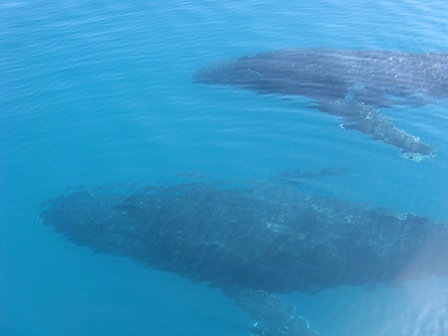 Humpback mother and calf submerged near boat.[/caption]
I relish the opportunity to spend more time interacting with whales and less time spent travelling between Hervey Bay’s marina and Platypus Bay. Luckily I’m rewarded with dozens of sightings. A female courted by three young males breaches fifty metres from the boat. The males take turns spy-hopping, balancing on rear fins. Their massive heads are completely out of the water as they all have a long look around. The female takes the opportunity to elude her bothersome suitors. They’re too young for serious mating activity. For now, it’s a practice game, fun for them, annoying for the female. Another female with a young calf, six months old Perry estimates, cruises near the boat. She shields her calf constantly but shyness is overcome by inquisitiveness while mother and infant both check out the hullabaloo coming from aboard the Quick Cat 2.
[caption id="attachment_1651" align="alignnone" width="448"]
Humpback mother and calf submerged near boat.[/caption]
I relish the opportunity to spend more time interacting with whales and less time spent travelling between Hervey Bay’s marina and Platypus Bay. Luckily I’m rewarded with dozens of sightings. A female courted by three young males breaches fifty metres from the boat. The males take turns spy-hopping, balancing on rear fins. Their massive heads are completely out of the water as they all have a long look around. The female takes the opportunity to elude her bothersome suitors. They’re too young for serious mating activity. For now, it’s a practice game, fun for them, annoying for the female. Another female with a young calf, six months old Perry estimates, cruises near the boat. She shields her calf constantly but shyness is overcome by inquisitiveness while mother and infant both check out the hullabaloo coming from aboard the Quick Cat 2.
[caption id="attachment_1651" align="alignnone" width="448"]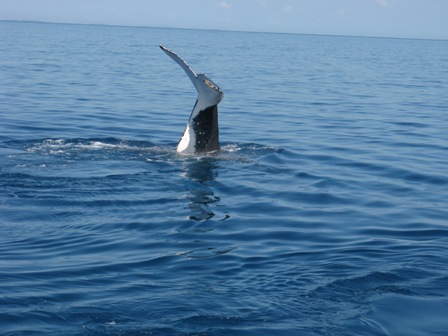 Southern Humpback diving.[/caption]
After five hours of whale watching, Perry and crew circulate word that it’s time to head back to Kingfisher Resort. When a waiter at the resort’s bar told me the night before that it was like ‘whale soup out there in Platypus Bay’, I nodded complacently, not believing a word of it. The most whales I’d seen on previous trips never exceeded ten at most. Today I’ve seen over thirty, whale soup indeed.
Naked Facts:
Getting There:
Hervey Bay is the closest airport to Fraser Island’s Kingfisher Bay Resort. Virgin and Jetstar airlines both offer daily flights from Australian capital cities. Transfers between the airport and the resort may be booked via www.kingfisherbay.com
Staying There:
Kingfisher Bay Resort offers 3-day packages including buffet breakfast from AUD$141 per person per day. See www.kingfisherbay.com for specials and bookings. Half-day eco-tours to Platypus Bay and the Great Sandy Strait on board the Quick Cat 2 can be arranged via the resort's tour specialists. Whale watching season begins mid-August finishing late October depending on seasonal migration patterns. Kingfisher Bay Resort also offers a variety of eco-tourism day trips around Fraser Island as well as a 3 day nature photography tour conducted by Danielle Lancaster of Blue Dog Photography late each August. Check with Kingfisher Bay Resort for further details.
Southern Humpback diving.[/caption]
After five hours of whale watching, Perry and crew circulate word that it’s time to head back to Kingfisher Resort. When a waiter at the resort’s bar told me the night before that it was like ‘whale soup out there in Platypus Bay’, I nodded complacently, not believing a word of it. The most whales I’d seen on previous trips never exceeded ten at most. Today I’ve seen over thirty, whale soup indeed.
Naked Facts:
Getting There:
Hervey Bay is the closest airport to Fraser Island’s Kingfisher Bay Resort. Virgin and Jetstar airlines both offer daily flights from Australian capital cities. Transfers between the airport and the resort may be booked via www.kingfisherbay.com
Staying There:
Kingfisher Bay Resort offers 3-day packages including buffet breakfast from AUD$141 per person per day. See www.kingfisherbay.com for specials and bookings. Half-day eco-tours to Platypus Bay and the Great Sandy Strait on board the Quick Cat 2 can be arranged via the resort's tour specialists. Whale watching season begins mid-August finishing late October depending on seasonal migration patterns. Kingfisher Bay Resort also offers a variety of eco-tourism day trips around Fraser Island as well as a 3 day nature photography tour conducted by Danielle Lancaster of Blue Dog Photography late each August. Check with Kingfisher Bay Resort for further details. https://nakedhungrytraveller.com.au/sailing-against-the-aegean/ Sailing Against the Aegean
https://nakedhungrytraveller.com.au/sailing-against-the-aegean/ Sailing Against the AegeanThe ship rounds Cape Sounion heading straight into a fierce north wind blowing down the Aegean Sea with cyclonic force. Poseidon’s Temple perched on the Cape’s steep cliff is the last mainland sight we see, a fateful omen or a lucky glimpse. When the ‘Meltemi’ revs up, it’s time to batten down the hatches and trim the sails.
It’s my first night aboard the Star Clipper during a week’s voyage around the Cyclades Islands between Greece and Turkey. My cabin is on the starboard side athwart the Plimsoll line. Ploughing through rough seas, driven by the remorseless wind, the ship is listing heavily to the right. My single porthole window plunges below the waterline between waves. The view is like looking through the glass of a front-loading washing machine, all suds, froth and swirling water. Luckily I’m not prone to seasickness so I choose the sensible option to while away the hours of a rough two day crossing from Piraeus to Kusadasi and retreat to the ship’s small library. There I nurse gins and tonic, peruse navigation charts laid out on one of two round tables and study framed maps of the Aegean Sea lining the wood panelled walls, wondering if that large island we passed hours before was Andros or Tinos. Joining me is a baker’s dozen other passengers possessed of similar hearty constitutions. We exchange introductions and pleasantries, commenting on whether or not an unscheduled stop at Samos’ southern shore is imminent because the open passage into Kusadasi’s harbour may prove too difficult to access. For a group of novice navigators, our assumptions are based solely on rumour and surmise. The crew are tight-lipped about any possible changes to the following day’s destination while passengers resort to a guessing game. Will we reach Turkey’s shore according to schedule or will we spend a day on Samos instead? I’m happy either way, content with a book, dinner and more gins and tonic or a Negroni. Cruise itineraries are still largely ruled by weather conditions. In this day and age of stabilisers and state-of-the-art navigation software, when really bad weather strikes, even the mega-ships may have to alter course, stopping at ports not included in the official itinerary. In his ‘Sailing Issues’ website, Diederek Willemsen describes the 'Meltemi' as, ‘wind known by the old Greeks as the Etesian northern winds, and results from a high pressure system (>1025) laying over the Balkan/Hungary area and a relatively low pressure (<1010) system over Turkey. Although this katabatic wind can bring about harsh sailing conditions it also provides cooling, low humidity and good visibility. Furthermore, it can be characterized as one of the few Mediterranean winds that do not necessarily die out at the end of the day and can easily last more than three to six days. In the wide corridor between the Dodecanese and Cycladic islands the 'Meltemi' blows undisturbed over 100 miles. Within six hours of a 30-knot wind, the waves can reach heights over three metres. The adverse currents make these waves steeper, which can be seriously dangerous for yachts smaller than 10 metre.’ The Star Clipper measures a bit less than 110 metres and weighs 2,298 tonnes. It’s big enough to face safely the 'Meltemi’s' relentless onslaught. When the huge mainsail is unfurled, it’s a dizzying view gazing up the main mast’s 68.5 metre length. Any musings I have about playing bosun climbing up and down the ship’s masts are dashed. The main mast sways in the wind like a rope trick, the rigging screams banshee howls. She plunges in and out of the huge swell like a marine-loving racehorse, shaking off sparkling water as it runs off her teak decks, thrusting her bow deep into the ancient sea. A friendly passenger mentions memories of galleons lost in time. [caption id="attachment_2330" align="alignnone" width="300"]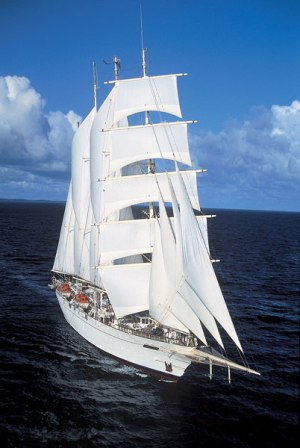 Star Clipper with all sails unfurled, full speed ahead.[/caption]
Evoking Homer’s Odyssey during times like these is damnably tantalising. During the worst of the 'Meltemi’s' battering, passengers are prohibited from leaving the central deck; it’s simply too dangerous venturing out on the bow deck.
Our little band of sailing stalwarts chats amiably in the library or gathers around the bar under cover at cocktail hour.
Wandering the corridors is ill advised while the ship bounces from wave to wave, the bucking bronco marine-loving seahorse is enjoying the wild ride.
It’s less thrilling when you’re trying to walk to your cabin without tumbling over topsy-turvy. I discover that many passengers have retreated to their cabins doped up on Dramamine or other anti-seasickness medications. The first night’s dinner in the single main dining room is scarcely attended, though an occasional breaking glass flying off a bar shelf adds a bit of cheery noise.
Someone yells out ‘Taxi!’ when another tumbler crashes to the floor. I’ve sorted the enthusiastic travellers from the retiring tourists in one night. They’re a fun bunch.
The Star Clipper is a different ship, relatively small and agile with a shallow enough draft (5.6 metres) to visit ports bigger ships can’t. It’s a wonderful experience to be a passenger from the only ship in a harbour, particularly in waters as busy as the Aegean’s where pleasure barges bigger than many small towns expel thousands of passengers all at once, crowding normally quiet ports.
A majority of Aegean harbours can’t handle large ships. The Star Clipper sails into many ports alone, appearing special in its aloofness. I note a barely suppressed feeling of pride shared amongst my fellow passengers. In less than two days, we’ve acquired a private yacht.
She’s a gleaming white four-masted sailing vessel and rides magnificently when all sixteen of her sails are unleashed in action. There’s something magical about being aboard a large sailing ship while she’s racing through strong winds. Perhaps it’s metaphysical. Is the ship itself happiest when she’s riding the high waves, flags flying, sails on parade, crew working like sea sprites on Poseidon’s Olympian bow?
We’re sailing across the Aegean Sea, facing its most challenging summer weather conditions and I have to say, I quite like the feeling of freedom that true sailing engenders.
Maximum passenger capacity is 170 persons with approximately 72 crew members. This late northern summer’s cruise numbers 112 passengers aboard, roughly half hail from the UK, about a third claim Germany as their home base. A dozen Americans, a dozen French, a few Scandinavians and Dutch proudly exclaim their origins. Four from Australia, me included, round out the ship’s contingent.
The crew were a veritable international assembly: Italian, Swedish, Dutch, Greek, West Indian/Caribbean, Filipino, Pakistani, Bangladeshi, Sri Lankan and Indian.
A United Nations afloat.
During the first night the ship did call unexpectedly into Patmos to unload one frightened, seasick passenger. We docked quietly. The lone ill passenger and her husband disembarked without trace.
We weighed anchor within an hour arriving at the modern beach resort, Camliami, right on schedule early the same morning.
Once in sight of Turkey’s coast, the 'Meltemi' winds receded as if they never existed. Gale force conditions were replaced by late summer’s somnolent heat, previous dramas nearly forgot.
[caption id="attachment_2135" align="alignnone" width="336"]
Star Clipper with all sails unfurled, full speed ahead.[/caption]
Evoking Homer’s Odyssey during times like these is damnably tantalising. During the worst of the 'Meltemi’s' battering, passengers are prohibited from leaving the central deck; it’s simply too dangerous venturing out on the bow deck.
Our little band of sailing stalwarts chats amiably in the library or gathers around the bar under cover at cocktail hour.
Wandering the corridors is ill advised while the ship bounces from wave to wave, the bucking bronco marine-loving seahorse is enjoying the wild ride.
It’s less thrilling when you’re trying to walk to your cabin without tumbling over topsy-turvy. I discover that many passengers have retreated to their cabins doped up on Dramamine or other anti-seasickness medications. The first night’s dinner in the single main dining room is scarcely attended, though an occasional breaking glass flying off a bar shelf adds a bit of cheery noise.
Someone yells out ‘Taxi!’ when another tumbler crashes to the floor. I’ve sorted the enthusiastic travellers from the retiring tourists in one night. They’re a fun bunch.
The Star Clipper is a different ship, relatively small and agile with a shallow enough draft (5.6 metres) to visit ports bigger ships can’t. It’s a wonderful experience to be a passenger from the only ship in a harbour, particularly in waters as busy as the Aegean’s where pleasure barges bigger than many small towns expel thousands of passengers all at once, crowding normally quiet ports.
A majority of Aegean harbours can’t handle large ships. The Star Clipper sails into many ports alone, appearing special in its aloofness. I note a barely suppressed feeling of pride shared amongst my fellow passengers. In less than two days, we’ve acquired a private yacht.
She’s a gleaming white four-masted sailing vessel and rides magnificently when all sixteen of her sails are unleashed in action. There’s something magical about being aboard a large sailing ship while she’s racing through strong winds. Perhaps it’s metaphysical. Is the ship itself happiest when she’s riding the high waves, flags flying, sails on parade, crew working like sea sprites on Poseidon’s Olympian bow?
We’re sailing across the Aegean Sea, facing its most challenging summer weather conditions and I have to say, I quite like the feeling of freedom that true sailing engenders.
Maximum passenger capacity is 170 persons with approximately 72 crew members. This late northern summer’s cruise numbers 112 passengers aboard, roughly half hail from the UK, about a third claim Germany as their home base. A dozen Americans, a dozen French, a few Scandinavians and Dutch proudly exclaim their origins. Four from Australia, me included, round out the ship’s contingent.
The crew were a veritable international assembly: Italian, Swedish, Dutch, Greek, West Indian/Caribbean, Filipino, Pakistani, Bangladeshi, Sri Lankan and Indian.
A United Nations afloat.
During the first night the ship did call unexpectedly into Patmos to unload one frightened, seasick passenger. We docked quietly. The lone ill passenger and her husband disembarked without trace.
We weighed anchor within an hour arriving at the modern beach resort, Camliami, right on schedule early the same morning.
Once in sight of Turkey’s coast, the 'Meltemi' winds receded as if they never existed. Gale force conditions were replaced by late summer’s somnolent heat, previous dramas nearly forgot.
[caption id="attachment_2135" align="alignnone" width="336"]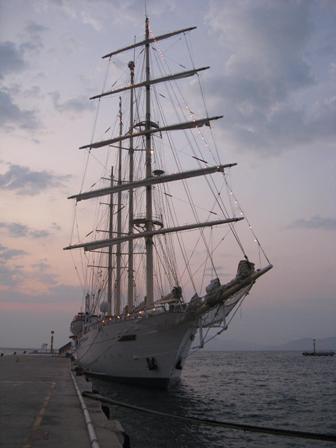 Star Clipper moored at Kusadasi.[/caption]
After a few hours spent swimming or wandering about Camliami’s small beach, we rejoined the Star Clipper for the short trip around a headland to Kusadasi, where most passengers disembarked to visit Ephesus and Kusadasi’s old town centre.
The wicked 'Meltemi' was all but forgotten.
Despite my somewhat romantically infused first impressions, real 21st century problems leaked into the Elysian picture.
Unfortunately, en route to Kusadasi my cabin became awash in bilge water bubbling up from the shower stall’s drain. Evidently, the ship’s pumps struggled to move waste water through the recycling system. Due to the strong list during the worst of the winds, most of the waterline cabins on the leeward side suffered the same problem.
Murky, smelly waste water made my cabin uninhabitable while cabin stewards worked furiously to solve the problem. Large exhaust fans were placed inside, my bags lifted off the floor onto the bunks, my soiled clothes were dry cleaned or laundered and excuses were made.
Later I was informed the captain didn’t want to run the pumps at full throttle during the rough crossing. A formal apology was never offered by the captain or senior management, nor was a logical explanation proffered.
This was the only technical problem I encountered. It marred slightly what was essentially a good trip though I still can’t get the scent memory of stinky bilge water out of my nose.
A small ship attracts a different clientele. I heard this affirmed quite a number of times.
Many of this Star Clipper cruise passengers were repeat guests, among them a number of couples making their third or fourth cruise that year. There was an obvious love affair going on with the ship.
Love is often accompanied by a certain acceptance of eccentric behaviour from one's partner, or lover.
Couples survive relationships partly because they tolerate their partner’s oddities. I observed a similar behavioural pattern among loyal passengers, the Star Clipper ship and its crew.
For instance, catering, though occasionally elaborately presented (five courses each dinner, lavish breakfast buffet and afternoon teas) suffered primarily because the quality of the cooking was generally lacklustre. After two consecutive dinners on board after leaving Piraeus, I decided another dinner on the Star Clipper would rob me of savouring authentic Greek fare in a local tavern or beachside restaurant. But the majority of passengers returned religiously to the ship for dinner, indeed many passengers never left the ship at all, taking all their meals on board. I never heard them complain.
For me, the most enjoyable social times on board were during the sunset 'Magic Hour' at the Tropical Bar where the two resident bartenders mixed a mean Negroni or poured the Champagne with real fizzy style. At the bar we had the best laughs with our like-minded fellow travellers, sharing a bit of ship’s gossip, making smart quips about Bulgarian pianist Evgeni’s sad repertory of 70s Vegas lounge hits or commenting on why the same tape recording of what sounded like the Russian anthem was played every time the ship weighed anchor, hoisted sails and left port.
The passengers I grew to like most took advantage of the daily shore excursions, making full use of the long days in port, dining in local restaurants, exploring on their own and sharing their experiences over breakfast or cocktail hour the following evening.
Nearing the end of a wonderful day at Ephesus with eight other passengers who chose to linger at the ruined city’s stupendous theatre, we discovered one person in the group, an Australian, was celebrating a birthday. We sang Happy Birthday to him while marvelling at the theatre’s outstanding acoustics.
[caption id="attachment_1531" align="alignnone" width="336"]
Star Clipper moored at Kusadasi.[/caption]
After a few hours spent swimming or wandering about Camliami’s small beach, we rejoined the Star Clipper for the short trip around a headland to Kusadasi, where most passengers disembarked to visit Ephesus and Kusadasi’s old town centre.
The wicked 'Meltemi' was all but forgotten.
Despite my somewhat romantically infused first impressions, real 21st century problems leaked into the Elysian picture.
Unfortunately, en route to Kusadasi my cabin became awash in bilge water bubbling up from the shower stall’s drain. Evidently, the ship’s pumps struggled to move waste water through the recycling system. Due to the strong list during the worst of the winds, most of the waterline cabins on the leeward side suffered the same problem.
Murky, smelly waste water made my cabin uninhabitable while cabin stewards worked furiously to solve the problem. Large exhaust fans were placed inside, my bags lifted off the floor onto the bunks, my soiled clothes were dry cleaned or laundered and excuses were made.
Later I was informed the captain didn’t want to run the pumps at full throttle during the rough crossing. A formal apology was never offered by the captain or senior management, nor was a logical explanation proffered.
This was the only technical problem I encountered. It marred slightly what was essentially a good trip though I still can’t get the scent memory of stinky bilge water out of my nose.
A small ship attracts a different clientele. I heard this affirmed quite a number of times.
Many of this Star Clipper cruise passengers were repeat guests, among them a number of couples making their third or fourth cruise that year. There was an obvious love affair going on with the ship.
Love is often accompanied by a certain acceptance of eccentric behaviour from one's partner, or lover.
Couples survive relationships partly because they tolerate their partner’s oddities. I observed a similar behavioural pattern among loyal passengers, the Star Clipper ship and its crew.
For instance, catering, though occasionally elaborately presented (five courses each dinner, lavish breakfast buffet and afternoon teas) suffered primarily because the quality of the cooking was generally lacklustre. After two consecutive dinners on board after leaving Piraeus, I decided another dinner on the Star Clipper would rob me of savouring authentic Greek fare in a local tavern or beachside restaurant. But the majority of passengers returned religiously to the ship for dinner, indeed many passengers never left the ship at all, taking all their meals on board. I never heard them complain.
For me, the most enjoyable social times on board were during the sunset 'Magic Hour' at the Tropical Bar where the two resident bartenders mixed a mean Negroni or poured the Champagne with real fizzy style. At the bar we had the best laughs with our like-minded fellow travellers, sharing a bit of ship’s gossip, making smart quips about Bulgarian pianist Evgeni’s sad repertory of 70s Vegas lounge hits or commenting on why the same tape recording of what sounded like the Russian anthem was played every time the ship weighed anchor, hoisted sails and left port.
The passengers I grew to like most took advantage of the daily shore excursions, making full use of the long days in port, dining in local restaurants, exploring on their own and sharing their experiences over breakfast or cocktail hour the following evening.
Nearing the end of a wonderful day at Ephesus with eight other passengers who chose to linger at the ruined city’s stupendous theatre, we discovered one person in the group, an Australian, was celebrating a birthday. We sang Happy Birthday to him while marvelling at the theatre’s outstanding acoustics.
[caption id="attachment_1531" align="alignnone" width="336"]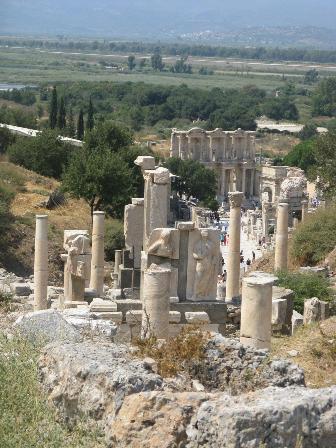 Ephesus main street looking towards its ancient library.[/caption]
At Patmos, my partner and I spent a whole day at St John Theologos’ monastery atop the island’s highest point with another passenger, a Scots writer researching a book on small ship cruising.
We climbed up and down the mountain, sweating profusely on a very hot afternoon when even the crows had stopped cawing, making the pilgrimage to the monastery that much more intensely felt on a physical level with a bit of spirituality on the side.
At the small cave shrine where the Apostle John was inspired to write the Book of Revelation, we gazed in wonderment at the niche carved into the cave wall where the saint supposedly laid his head while dreaming of the Apocalypse.
Back in the island’s main town, we lunched on fried calamari, sardines, fried potatoes and country salad, drinking strong rose wine from large carafes at a small wharf side restaurant surrounded by local family groups doing much the same thing. Any Apocalyptic thoughts were conveniently forgot.
[caption id="attachment_1532" align="alignnone" width="448"]
Ephesus main street looking towards its ancient library.[/caption]
At Patmos, my partner and I spent a whole day at St John Theologos’ monastery atop the island’s highest point with another passenger, a Scots writer researching a book on small ship cruising.
We climbed up and down the mountain, sweating profusely on a very hot afternoon when even the crows had stopped cawing, making the pilgrimage to the monastery that much more intensely felt on a physical level with a bit of spirituality on the side.
At the small cave shrine where the Apostle John was inspired to write the Book of Revelation, we gazed in wonderment at the niche carved into the cave wall where the saint supposedly laid his head while dreaming of the Apocalypse.
Back in the island’s main town, we lunched on fried calamari, sardines, fried potatoes and country salad, drinking strong rose wine from large carafes at a small wharf side restaurant surrounded by local family groups doing much the same thing. Any Apocalyptic thoughts were conveniently forgot.
[caption id="attachment_1532" align="alignnone" width="448"]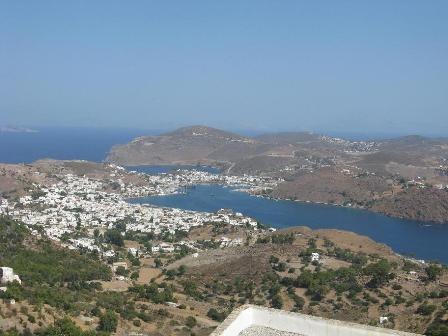 Patmos harbour seen en route to St John's monastery.[/caption]
The Star Clipper was the only ship in Patmos’ harbour. We had the island’s famous sites pretty much to ourselves.
On Amorgos, right off the Aegean’s beaten tourist path (Mykonos, Milos, Santorini, Rhodos and Crete) a quiet island relatively untouched by tourism we visited the incredible 11th century cliff hanging Panagia of Hozoviotissos monastery overlooking the beach where much of Luc Besson’s film, ‘The Big Blue’ was filmed. The monastery is not a tourist site as such, monks still worship there and though visitors are welcome, numbers are limited. All visitors must be appropriately attired. Shorts or singlets are not allowed.
[caption id="attachment_1533" align="alignnone" width="336"]
Patmos harbour seen en route to St John's monastery.[/caption]
The Star Clipper was the only ship in Patmos’ harbour. We had the island’s famous sites pretty much to ourselves.
On Amorgos, right off the Aegean’s beaten tourist path (Mykonos, Milos, Santorini, Rhodos and Crete) a quiet island relatively untouched by tourism we visited the incredible 11th century cliff hanging Panagia of Hozoviotissos monastery overlooking the beach where much of Luc Besson’s film, ‘The Big Blue’ was filmed. The monastery is not a tourist site as such, monks still worship there and though visitors are welcome, numbers are limited. All visitors must be appropriately attired. Shorts or singlets are not allowed.
[caption id="attachment_1533" align="alignnone" width="336"]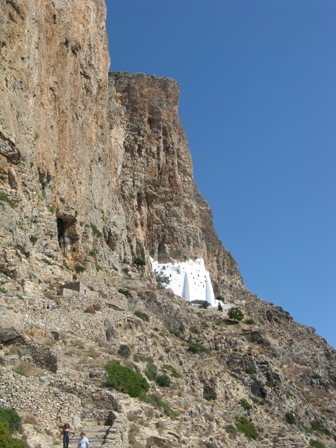 Panagia of Hozoviotissos monastery on Amorgos' southern coast.[/caption]
Access to the monastery is up a very steep set of steps carved into solid rock. Views to the open sea from the monastery’s balconies are gobsmacking. The site marks the spot where a lost Palestinian pilgrim carrying one part of an icon found refuge on the sheltered beach (probably during a 'Meltemi') and was inspired to create a shrine to the icon’s image, the Virgin Mary.
Construction of the monastery proved difficult as each day’s work was inexplicably destroyed during the night. Prayers were sent to heaven in search of an answer to the riddle of the mystery vandal.
Miraculously, a worker’s tool was found imbedded in rock hundreds of metres above the building site nearer the beach, a sure sign from God that this must be the right place to build the Virgin’s monastery; into a cliff virtually inaccessible unless you could fly.
The rusty iron stick has since become idolised as a holy relic. Fellow passengers referred to it as the ‘Holy Tool’. I confess that was my suggested nickname.
Incidentally, the other part of the icon found its way to Patmos where a different monastery was built.
From Amorgos to Mykonos, where the Star Clipper docked offshore early morning, proved a notable change of scene from Amorgos’ sleepy atmosphere. Mykonos is Greece’s international party island. It’s something of a gay destination too. During the height of the summer season, men gather here like bears drawn to one big honey pot. It’s also a family destination with a few placidly safe beaches and surprisingly kiddie friendly. Idiomatically speaking, both sides of the one fence occasionally cast longing glances over one another.
We chose the studious option, avoiding the crowds in Mykonos town’s labyrinthine lanes packed with shops selling tourist trinkets, its fashionable bars and cafes to spend a half day exploring the nearby island of Delos, birthplace of Apollo and one of Greece’s most important ancient sites. At Delos, it becomes obvious why this tiny island became known as the place where the god of the sun emerged from light on water. The harsh sun reflects off the white marble and limestone with blindingly sharp clarity.
[caption id="attachment_1534" align="alignnone" width="448"]
Panagia of Hozoviotissos monastery on Amorgos' southern coast.[/caption]
Access to the monastery is up a very steep set of steps carved into solid rock. Views to the open sea from the monastery’s balconies are gobsmacking. The site marks the spot where a lost Palestinian pilgrim carrying one part of an icon found refuge on the sheltered beach (probably during a 'Meltemi') and was inspired to create a shrine to the icon’s image, the Virgin Mary.
Construction of the monastery proved difficult as each day’s work was inexplicably destroyed during the night. Prayers were sent to heaven in search of an answer to the riddle of the mystery vandal.
Miraculously, a worker’s tool was found imbedded in rock hundreds of metres above the building site nearer the beach, a sure sign from God that this must be the right place to build the Virgin’s monastery; into a cliff virtually inaccessible unless you could fly.
The rusty iron stick has since become idolised as a holy relic. Fellow passengers referred to it as the ‘Holy Tool’. I confess that was my suggested nickname.
Incidentally, the other part of the icon found its way to Patmos where a different monastery was built.
From Amorgos to Mykonos, where the Star Clipper docked offshore early morning, proved a notable change of scene from Amorgos’ sleepy atmosphere. Mykonos is Greece’s international party island. It’s something of a gay destination too. During the height of the summer season, men gather here like bears drawn to one big honey pot. It’s also a family destination with a few placidly safe beaches and surprisingly kiddie friendly. Idiomatically speaking, both sides of the one fence occasionally cast longing glances over one another.
We chose the studious option, avoiding the crowds in Mykonos town’s labyrinthine lanes packed with shops selling tourist trinkets, its fashionable bars and cafes to spend a half day exploring the nearby island of Delos, birthplace of Apollo and one of Greece’s most important ancient sites. At Delos, it becomes obvious why this tiny island became known as the place where the god of the sun emerged from light on water. The harsh sun reflects off the white marble and limestone with blindingly sharp clarity.
[caption id="attachment_1534" align="alignnone" width="448"]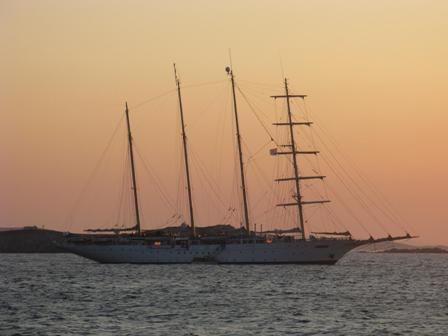 Star Clipper anchored off Mykonos at sunset.[/caption]
Delos is the heart of the Cyclades Vortex, a confluence of wind and light exists there like nowhere else in the Mediterranean Basin. Fortunately Star Clipper’s preferred guide proved to be both entertaining and informative. She brought to life the complex layered ruins of old Delos and its importance to the lives and deaths of all ancient Greeks. Its former glory can only be wondered at. Extensive foundations remain and much reconstruction has occurred over the last sixty years, but Delos remains unique among Greece’s most fascinating archaeological sites, if only for its abundant ability to provoke the imagination.
[caption id="attachment_1535" align="alignnone" width="448"]
Star Clipper anchored off Mykonos at sunset.[/caption]
Delos is the heart of the Cyclades Vortex, a confluence of wind and light exists there like nowhere else in the Mediterranean Basin. Fortunately Star Clipper’s preferred guide proved to be both entertaining and informative. She brought to life the complex layered ruins of old Delos and its importance to the lives and deaths of all ancient Greeks. Its former glory can only be wondered at. Extensive foundations remain and much reconstruction has occurred over the last sixty years, but Delos remains unique among Greece’s most fascinating archaeological sites, if only for its abundant ability to provoke the imagination.
[caption id="attachment_1535" align="alignnone" width="448"]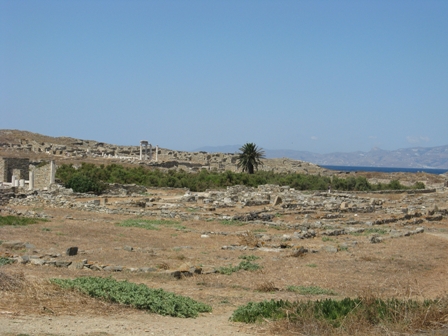 Delos Sacred Pool where the god Apollo was born.[/caption]
I once lived on Mykonos, working a summer in a restaurant on the relatively quiet northern side of the island at Panormos beach. Where I worked has now become a fancy beach diner. It’s no longer the quirky bordello next to a stretch of deserted sand, operating without electricity or running water on a kilometre of beach with no road access or regular boat service. We managed to attract roughly a hundred customers in a day, mostly Scandinavians or Germans, in sarongs or nude, getting away from the crowds on the trendy southern beaches nearer Mykonos town itself.
In the twenty years since I worked there, times have changed for Mykonos. A new reservoir has been built. Mains water and electricity now reaches that previously remote northern beach. A sealed road has been paved and the crowds have come, clothed and with families. We hired motorbikes and covered the island. The routes hadn’t changed but the traffic had increased, so too the mounds of rubbish lining the roads outside town.
Greece’s economic meltdown has affected public services in populated areas. Rubbish collection, road maintenance and infrastructure support has declined severely since 2008. The consequences of political economic mismanagement were most evident on Mykonos during this trip, where the tourist numbers were at their greatest.
Our last port of call was on the Peloponnesian mainland, at its southern extremity, the medieval fortress town called Monemvasia. First it was a Byzantine port of great importance, then a Venetian fortress, then an Ottoman outpost and after World War 2, a Greek historical gem caught in a time warp. Again the Star Clipper was the only ship moored off Monemvasia’s tiny harbour. We had the old town’s walled majesty virtually to ourselves.
[caption id="attachment_1536" align="alignnone" width="448"]
Delos Sacred Pool where the god Apollo was born.[/caption]
I once lived on Mykonos, working a summer in a restaurant on the relatively quiet northern side of the island at Panormos beach. Where I worked has now become a fancy beach diner. It’s no longer the quirky bordello next to a stretch of deserted sand, operating without electricity or running water on a kilometre of beach with no road access or regular boat service. We managed to attract roughly a hundred customers in a day, mostly Scandinavians or Germans, in sarongs or nude, getting away from the crowds on the trendy southern beaches nearer Mykonos town itself.
In the twenty years since I worked there, times have changed for Mykonos. A new reservoir has been built. Mains water and electricity now reaches that previously remote northern beach. A sealed road has been paved and the crowds have come, clothed and with families. We hired motorbikes and covered the island. The routes hadn’t changed but the traffic had increased, so too the mounds of rubbish lining the roads outside town.
Greece’s economic meltdown has affected public services in populated areas. Rubbish collection, road maintenance and infrastructure support has declined severely since 2008. The consequences of political economic mismanagement were most evident on Mykonos during this trip, where the tourist numbers were at their greatest.
Our last port of call was on the Peloponnesian mainland, at its southern extremity, the medieval fortress town called Monemvasia. First it was a Byzantine port of great importance, then a Venetian fortress, then an Ottoman outpost and after World War 2, a Greek historical gem caught in a time warp. Again the Star Clipper was the only ship moored off Monemvasia’s tiny harbour. We had the old town’s walled majesty virtually to ourselves.
[caption id="attachment_1536" align="alignnone" width="448"]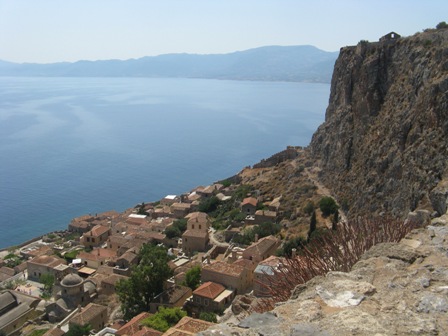 Overlooking Monemvassia from its high plateau.[/caption]
One of Greece’s impregnable towns, defensible because it sits on a rock jutting out to sea connected to the mainland by a narrow isthmus, Monemvasia is quite simply stunning. Many of its derelict houses have been sensitively restored, some operating as small guesthouses and bringing life back into the nearly abandoned town. A few restaurants do a good business, serving simple country Greek food to travellers and locals alike.
As had happened every day, we ran across fellow passengers while wandering up and down the steep narrow streets, stopping to share notes, impressions, tips and a laugh or two.
At the end of a full week crossing the Aegean Sea, the same conclusion had apparently been reached. We had shared time in treasured ports on fabled islands spread over a gloriously mythical sea.
Best of all, that gleaming white ship moored just offshore was ours, if only for a brief week in Paradise.
Tom Neal Tacker travelled as a guest of Star Clippers.
Naked Facts:
See www.starclippers.com for a full list of cruises. The seven day Northern Cyclades cruise described here runs three times during the northern summer and departs from Piraeus (Athens). Dependent on cabin size and deck level, costs per person vary between approximately AUD$2,800 and AUD$4,600 inclusive of three meals per day. Alcoholic drinks, shore excursions (approximately AUD$75 to AUD$175 per person) and port charges (AUD$295 per person) are not included. Flights to and from Athens are also not included. Cruise itineraries may be combined, for instance Northern and Southern Cyclades cruises, depending on coinciding departure dates. Star Clippers can reserve or recommend hotels in Athens and arrange transport to and from hotels from Piraeus at the beginning or end of the cruise.
Naked Sleeps
While in Athens, I can heartily recommend the King George Palace hotel located in protest central, Syntagma Square. See www.kinggeorgepalace.com for information and reservations. The rooms facing away from the square are quiet but you don’t get a view of the Acropolis or Parliament, or the latest rallies pitting struggling Athenians against government troops. I’d choose a good night’s sleep over a Parthenon view, particularly when I can step outside the hotel entrance and walk to it in 30 minutes. Fortunately, the roof top terrace restaurant where breakfast is served (included in the room rate), provides amazing views to the Acropolis buildings (Parthenon included), most of the Plaka, all of busy Syntagma Square, Parliament House and the Zappeion Gardens behind it. The hotel sources its produce from organic Cretan farms and Cretan delicacies feature strongly on the menu. I’ve eaten the best breakfasts in all of Greece at this hotel. The service at the hotel, from doormen to receptionists to concierge to waiters to housekeepers is outstandingly efficient, friendly and genuinely warm. Real Greek hospitality rules here. Opa!
Writer's Naked Rant:
My interactions with huge ships filled with cruise passengers have been intentionally minimal. I don’t like being caught, even inadvertently, mingling with herds of passengers ‘doing’ the South Pacific or anywhere else for that matter in less than ten days in between trips to the midnight buffet, the casino and the cigar bar.
A latent negative opinion of mass marketed cruising has become my learned judgment, a state of mind I’ve accepted as unalterable.
I’ve travelled on lots of passenger ferries, across the Baltic Sea, the North Sea, the Mediterranean Sea, the Irish Sea, up the Nile River, down the Mekong River, down the Rhone, up the Rhine, across Lakes Superior and Geneva and between various Polynesian Islands and enjoyed each voyage.
I’m interested in small ship exploratory voyages with limited passenger numbers, high crew to passenger ratios and unlimited dining time options. I don’t want to share a cabin with a stranger and I don’t want to get drunk with nitwits who don't give a shit about where they are or where they're going nor am I interested in scoring a drug deal with a sly steward.
I avoid regimentation when travelling. I won’t wear a lanyard bearing my ID so a ship’s officer can recognise me as a legitimate passenger and I don’t like to queue at an all-you-can-eat buffet watching corpulent people load their plates with lots of very ordinary food.
In other words, if I want to holiday among the masses, I’ll opt for a get-out-of-gaol free card while visiting Disneyland with an eight hour pass, preferably on a weekday while avoiding school holiday peak periods.
Overlooking Monemvassia from its high plateau.[/caption]
One of Greece’s impregnable towns, defensible because it sits on a rock jutting out to sea connected to the mainland by a narrow isthmus, Monemvasia is quite simply stunning. Many of its derelict houses have been sensitively restored, some operating as small guesthouses and bringing life back into the nearly abandoned town. A few restaurants do a good business, serving simple country Greek food to travellers and locals alike.
As had happened every day, we ran across fellow passengers while wandering up and down the steep narrow streets, stopping to share notes, impressions, tips and a laugh or two.
At the end of a full week crossing the Aegean Sea, the same conclusion had apparently been reached. We had shared time in treasured ports on fabled islands spread over a gloriously mythical sea.
Best of all, that gleaming white ship moored just offshore was ours, if only for a brief week in Paradise.
Tom Neal Tacker travelled as a guest of Star Clippers.
Naked Facts:
See www.starclippers.com for a full list of cruises. The seven day Northern Cyclades cruise described here runs three times during the northern summer and departs from Piraeus (Athens). Dependent on cabin size and deck level, costs per person vary between approximately AUD$2,800 and AUD$4,600 inclusive of three meals per day. Alcoholic drinks, shore excursions (approximately AUD$75 to AUD$175 per person) and port charges (AUD$295 per person) are not included. Flights to and from Athens are also not included. Cruise itineraries may be combined, for instance Northern and Southern Cyclades cruises, depending on coinciding departure dates. Star Clippers can reserve or recommend hotels in Athens and arrange transport to and from hotels from Piraeus at the beginning or end of the cruise.
Naked Sleeps
While in Athens, I can heartily recommend the King George Palace hotel located in protest central, Syntagma Square. See www.kinggeorgepalace.com for information and reservations. The rooms facing away from the square are quiet but you don’t get a view of the Acropolis or Parliament, or the latest rallies pitting struggling Athenians against government troops. I’d choose a good night’s sleep over a Parthenon view, particularly when I can step outside the hotel entrance and walk to it in 30 minutes. Fortunately, the roof top terrace restaurant where breakfast is served (included in the room rate), provides amazing views to the Acropolis buildings (Parthenon included), most of the Plaka, all of busy Syntagma Square, Parliament House and the Zappeion Gardens behind it. The hotel sources its produce from organic Cretan farms and Cretan delicacies feature strongly on the menu. I’ve eaten the best breakfasts in all of Greece at this hotel. The service at the hotel, from doormen to receptionists to concierge to waiters to housekeepers is outstandingly efficient, friendly and genuinely warm. Real Greek hospitality rules here. Opa!
Writer's Naked Rant:
My interactions with huge ships filled with cruise passengers have been intentionally minimal. I don’t like being caught, even inadvertently, mingling with herds of passengers ‘doing’ the South Pacific or anywhere else for that matter in less than ten days in between trips to the midnight buffet, the casino and the cigar bar.
A latent negative opinion of mass marketed cruising has become my learned judgment, a state of mind I’ve accepted as unalterable.
I’ve travelled on lots of passenger ferries, across the Baltic Sea, the North Sea, the Mediterranean Sea, the Irish Sea, up the Nile River, down the Mekong River, down the Rhone, up the Rhine, across Lakes Superior and Geneva and between various Polynesian Islands and enjoyed each voyage.
I’m interested in small ship exploratory voyages with limited passenger numbers, high crew to passenger ratios and unlimited dining time options. I don’t want to share a cabin with a stranger and I don’t want to get drunk with nitwits who don't give a shit about where they are or where they're going nor am I interested in scoring a drug deal with a sly steward.
I avoid regimentation when travelling. I won’t wear a lanyard bearing my ID so a ship’s officer can recognise me as a legitimate passenger and I don’t like to queue at an all-you-can-eat buffet watching corpulent people load their plates with lots of very ordinary food.
In other words, if I want to holiday among the masses, I’ll opt for a get-out-of-gaol free card while visiting Disneyland with an eight hour pass, preferably on a weekday while avoiding school holiday peak periods. https://nakedhungrytraveller.com.au/off-beaten-track-in-ireland/ Off-Beaten Track in Ireland
https://nakedhungrytraveller.com.au/off-beaten-track-in-ireland/ Off-Beaten Track in IrelandThe back roads and byways of off-the-beaten-track Ireland reveal there’s much more to the old sod than blarney stone and Dingle drives.
Wandering round the hidden corners of Ireland seems a wonderful notion. Tiny one-pub villages connected by quaint laneways shaded by grand oak trees, picturesque paddocks filled with fluffy sheep, rough stone walls lining isolated farmhouses … you get the picture. Driving the back roads of Ireland should be like a jaunt in the park.My jaunt around the back roads of Ireland begins in Dublin. Heading north from Dublin's northern suburbs en route to Drogheda and my first stop, the Newgrange tumulus, I make the first of innumerable wrong turns. Believing I’d followed the signs to this ancient Stone Age site correctly, I was wrong, a wrong turn right from the start, my Irish mantra for a week and a half. One phone call later, a stop to ask for location clarification (thank goodness the Irish are mostly friendly, love to chat with strangers and don’t mind providing directions to lost travellers), I pull in to Newgrange's Bru na Boinne Visitor Centre over an hour late for an appointment. Hustled on to a tourist bus which transports visitors to and from the official visitor centre and the site itself, it heads to the site by the road I had mistakenly used an hour before. If only I’d paid attention to directions indicating all visitors must report to the visitor centre to visit the archaeological site, I would have saved myself an hour of lost time.
[caption id="attachment_2217" align="alignnone" width="274"]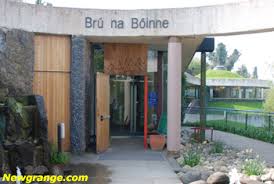 Bru na Boinne Visitors Centre entrance.[/caption]
Bru na Boinne Visitors Centre entrance.[/caption]
Newgrange is one of Europe’s most interesting Stone Age passage tombs. A number of tomb mounds mark the surrounding landscape but Newgrange is the largest and most studied. By all means stop for at least an hour at the excellent visitor centre (there’s a decent cafe here too) and read all there is about ancient Ireland in preparation for exploring Newgrange itself. The tumulus’ (mound) history is entirely fascinating after greater understanding of its origin, purpose and importance to early inhabitants is clearly understood.
[caption id="attachment_2207" align="alignnone" width="448"]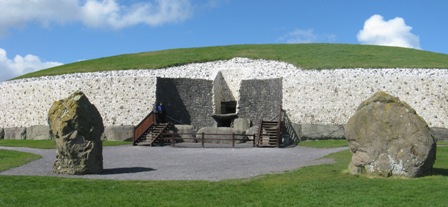 Newgrange tumulus entrance.[/caption]
Newgrange tumulus entrance.[/caption]
Over each winter solstice, dawn sunlight pierces into the long tunnel directly to the burial chamber itself, illuminating both the symbolic importance of the site’s position and the construction’s wonderfully precise alignment with the sunrise in conjunction with the shortest day of the year.
A national lottery is conducted annually which allows a lucky twenty or so visitors access to the tumulus for three days: preceding the solstice, the solstice and the day after, each dawn (if weather permits) opening the tumulus’ greater purpose to the lottery winners. The inner burial chamber is quite small. I’m crowded into it with fewer than fifteen other visitors while we take turns exploring the graves’ positions, wall carvings and the impressive architectural design. The inner chamber is completely dry by the way. No water has ever leaked into the inner chamber, not bad for a roof built over 5,000 years ago by craftsmen using rudimentary tools, even more impressive considering Ireland’s wet weather and harsh climate.
From Newgrange I head further north to Carlingford to dine at the Ghan House hotel’s fine restaurant, sampling some of Ireland’s better country cooking at a heritage hotel in this lovely out-of-the-way town on the border. The dining room is comfortably grand, 19th century furnishings, lots of candles, warm service and a dinner far better than I’m used to eating in rural Ireland.
Carlingford isn’t big enough in which to get lost but a derelict castle in prime position overlooking the loch evokes feelings of times lost to history. Signage at this castle is scant, much of it is barred from exploration and local residents have used it as something of a trysting place, condom wrappers tossed into stony corners indicating that a lonely castle conveniently located close to the town centre also has advantages other than links to historical roots.
From Carlingford I head towards County Monaghan, aiming for Hilton Park, a grand estate where I’m booked to spend a night. The GPS provided by the hire car company is absolutely useless. New roads haven’t been programmed into its system and the border area’s previous political tensions have caused some roads to be purposely left unmarked. I’ve been lost for two hours while searching for Hilton Park. Driven almost mad with frustration at the lack of signage, equipped with a GPS programmed with Irish roads that don’t appear to exist, all the while I’m thinking that if I continue to turn left, an entire circuit of the island nation will be complete, finally reaching my start point. Thoughts of returning to Carlingford's lovely countryside pop into mind. Should I abandon ship, ditch the car and get a bus back to Carlingford? Not willing to admit defeat so early in the trip, I head for Clones again, doubling back the way I just came. [caption id="attachment_1590" align="alignnone" width="337"]
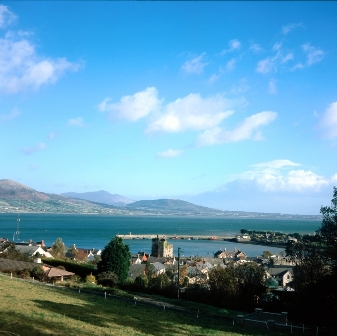 Carlingford, County Louth on the way to 'The North'.[/caption]
The local postmaster in Clones described the way to Hilton Park an hour earlier. 'You can’t miss it,' he says. 'Well, you could miss it but if you’ve gone past the golf course, you have,' he adds laconically. I return to the car, point it to the road I’ve driven down twice before and decide to try again.
I turn haphazardly into a driveway marked by a sign half hidden by dense holly. The lettering has faded into total obscurity. I chance it anyway. The postmaster told me it wasn’t easy to spot, despite having twice gone as far as the golf course he instructed me not to go past. I’m ready for anything now.
Five kilometres along a winding unsealed driveway, I come face to face with a drop dead gorgeous Georgian mansion, a Eureka moment.
[caption id="attachment_2220" align="alignnone" width="259"]
Carlingford, County Louth on the way to 'The North'.[/caption]
The local postmaster in Clones described the way to Hilton Park an hour earlier. 'You can’t miss it,' he says. 'Well, you could miss it but if you’ve gone past the golf course, you have,' he adds laconically. I return to the car, point it to the road I’ve driven down twice before and decide to try again.
I turn haphazardly into a driveway marked by a sign half hidden by dense holly. The lettering has faded into total obscurity. I chance it anyway. The postmaster told me it wasn’t easy to spot, despite having twice gone as far as the golf course he instructed me not to go past. I’m ready for anything now.
Five kilometres along a winding unsealed driveway, I come face to face with a drop dead gorgeous Georgian mansion, a Eureka moment.
[caption id="attachment_2220" align="alignnone" width="259"] First view of Hilton Park.[/caption]
While I park the car, already feeling agog with the grandeur of the place, a young man dressed like a county squire strides across the gravel drive that fronts his family home, Hilton Park. Extending his hand in greeting, he says, 'I’m Fred Madden. You must be Tom. So, you’ve found us. It mustn’t have been easy. How was your trip?' I’ve been driving in and out of Ulster, commonly referred to as ‘The North’ since my late morning departure from Carlingford in County Louth, part of the Republic, commonly referred to as ‘The South’, wandering blithely around County Monaghan and now I’m right up against the border again. Ulster’s County Fermanagh is only a few miles away. Road maps are next to useless in much of this apparently unmarked country. From one minute to the next, I’m never sure if I’m in Ulster, ‘The North’ or in the Republic, ‘The South’.
The northern corner of county Monaghan has been off the radar for decades, deemed by most travellers as being too close to ‘The Troubles’, therefore potentially unsafe. The lack of visitors is a common complaint I hear often during my days in off-the-beaten track Ireland. I also visit County Leitrim and County Westmeath, two other counties virtually ignored by the majority of travellers. I’ve been led to believe that here is where the ‘real old Ireland’ still exists.
Hilton Park has been in Madden’s family since it was built in 1734. Since ‘The Troubles’ finished, business in County Monaghan has increased. Hilton Park has reached the 21st century in a relatively healthy position.
[caption id="attachment_2221" align="alignnone" width="275"]
First view of Hilton Park.[/caption]
While I park the car, already feeling agog with the grandeur of the place, a young man dressed like a county squire strides across the gravel drive that fronts his family home, Hilton Park. Extending his hand in greeting, he says, 'I’m Fred Madden. You must be Tom. So, you’ve found us. It mustn’t have been easy. How was your trip?' I’ve been driving in and out of Ulster, commonly referred to as ‘The North’ since my late morning departure from Carlingford in County Louth, part of the Republic, commonly referred to as ‘The South’, wandering blithely around County Monaghan and now I’m right up against the border again. Ulster’s County Fermanagh is only a few miles away. Road maps are next to useless in much of this apparently unmarked country. From one minute to the next, I’m never sure if I’m in Ulster, ‘The North’ or in the Republic, ‘The South’.
The northern corner of county Monaghan has been off the radar for decades, deemed by most travellers as being too close to ‘The Troubles’, therefore potentially unsafe. The lack of visitors is a common complaint I hear often during my days in off-the-beaten track Ireland. I also visit County Leitrim and County Westmeath, two other counties virtually ignored by the majority of travellers. I’ve been led to believe that here is where the ‘real old Ireland’ still exists.
Hilton Park has been in Madden’s family since it was built in 1734. Since ‘The Troubles’ finished, business in County Monaghan has increased. Hilton Park has reached the 21st century in a relatively healthy position.
[caption id="attachment_2221" align="alignnone" width="275"] My bedroom at Hilton Park.[/caption]
Madden’s mother Lucy writes historical essays for the local newspapers and is something of an expert on all things Hilton Park and the nearby town of Clones. Over breakfast she shares her enthusiasm. 'Tyrone Guthrie, the famous critic and theatrical impresario was born just near here. Oscar Wilde’s two half sisters lived near here too.'
Placing a pot of her homemade jam in front of me she continues her summary, 'Clones is a wonderful town. You know the director, Neil Jordan of ‘The Crying Game’ among other films? He comes to stay here regularly, calls Clones his microcosm of the world. If it doesn’t work in Clones, it won’t work anywhere else, he says.' Lucy Madden is a raconteur of distinction, a wonderful example of Irish charm and bonhomie. No wonder Jordan enjoys his stays at Hilton Park.
Fred Madden shows me around the 600 acre estate. The park and gardens are like a film set. I understand Jordan’s high regard for the place. Expecting to see ladies wearing bonnets and bustles emerge from behind shrubbery at any moment, gossiping dialogue from a Thackeray novel or reciting lines from one of Wilde’s plays, I wonder how this hidden gem has escaped attention for so long, despite ‘The Troubles’. Though my stay at Hilton Park is brief, it is memorable.
[caption id="attachment_2205" align="alignnone" width="336"]
My bedroom at Hilton Park.[/caption]
Madden’s mother Lucy writes historical essays for the local newspapers and is something of an expert on all things Hilton Park and the nearby town of Clones. Over breakfast she shares her enthusiasm. 'Tyrone Guthrie, the famous critic and theatrical impresario was born just near here. Oscar Wilde’s two half sisters lived near here too.'
Placing a pot of her homemade jam in front of me she continues her summary, 'Clones is a wonderful town. You know the director, Neil Jordan of ‘The Crying Game’ among other films? He comes to stay here regularly, calls Clones his microcosm of the world. If it doesn’t work in Clones, it won’t work anywhere else, he says.' Lucy Madden is a raconteur of distinction, a wonderful example of Irish charm and bonhomie. No wonder Jordan enjoys his stays at Hilton Park.
Fred Madden shows me around the 600 acre estate. The park and gardens are like a film set. I understand Jordan’s high regard for the place. Expecting to see ladies wearing bonnets and bustles emerge from behind shrubbery at any moment, gossiping dialogue from a Thackeray novel or reciting lines from one of Wilde’s plays, I wonder how this hidden gem has escaped attention for so long, despite ‘The Troubles’. Though my stay at Hilton Park is brief, it is memorable.
[caption id="attachment_2205" align="alignnone" width="336"]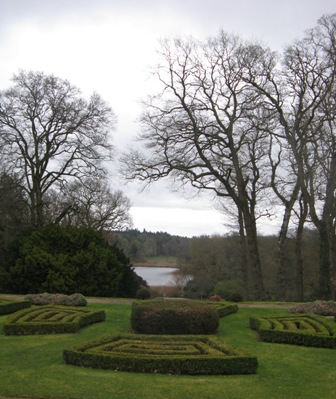 A small section of Hilton Park's immense gardens.[/caption]
Ireland is internationally famous for its literary giants, Yeats, Beckett, Wilde to name just a few. Though famous in Ireland, Patrick Kavanagh’s work is less known though the study of his works is compulsory in Irish schools.
'But I’ve not heard of him before this week,' I explain to Rosaleen Kearney, manager of the Patrick Kavanagh Centre in Iniskeen, County Monaghan. 'You’re not alone Tom,' she says, 'Patrick Kavanagh is not well known outside Ireland, which is a pity as his poetry is as important to us as Yeats.' With volunteer guide Art Agnew and Kearney, I explore the Kavanagh Trail, a route marked as a self-guided tour funded by the local tourism authority.
[caption id="attachment_2203" align="alignnone" width="336"]
A small section of Hilton Park's immense gardens.[/caption]
Ireland is internationally famous for its literary giants, Yeats, Beckett, Wilde to name just a few. Though famous in Ireland, Patrick Kavanagh’s work is less known though the study of his works is compulsory in Irish schools.
'But I’ve not heard of him before this week,' I explain to Rosaleen Kearney, manager of the Patrick Kavanagh Centre in Iniskeen, County Monaghan. 'You’re not alone Tom,' she says, 'Patrick Kavanagh is not well known outside Ireland, which is a pity as his poetry is as important to us as Yeats.' With volunteer guide Art Agnew and Kearney, I explore the Kavanagh Trail, a route marked as a self-guided tour funded by the local tourism authority.
[caption id="attachment_2203" align="alignnone" width="336"] Rosaleen Kearney and Art Agnew at Kavanagh's grave.[/caption]
Kearney and Agnew take turns reciting Kavanagh’s lyrical poetry in their softly burring local accents while we visit Kavanagh’s birthplace, the school he attended, the barn where he waltzed at local dances and finally his grave. 'The Monaghan hills are hard country and folk here have always been poor,' Agnew admits sadly. I imagine the land has changed little since Kavanagh was born in Mucker, a collection of houses just a few kilometres from Iniskeen village. Eldest son of a cobbler and farmer of nine acres, Patrick Kavanagh left school aged thirteen to become a cobbler and farmer like his father. What set him apart was his writing, which he did by candlelight in an upstairs room away from the chaos in the family kitchen.
In Kavanagh’s own words from his poem simply entitled ‘Monaghan Hills’,
'Monaghan hills,
You have made me the sort of man I am,
A fellow who can never care a damn
For Everestic thrills'
Rough country around Iniskeen and Mucker makes or breaks farmers, more often breaking them.
[caption id="attachment_2202" align="alignnone" width="362"]
Rosaleen Kearney and Art Agnew at Kavanagh's grave.[/caption]
Kearney and Agnew take turns reciting Kavanagh’s lyrical poetry in their softly burring local accents while we visit Kavanagh’s birthplace, the school he attended, the barn where he waltzed at local dances and finally his grave. 'The Monaghan hills are hard country and folk here have always been poor,' Agnew admits sadly. I imagine the land has changed little since Kavanagh was born in Mucker, a collection of houses just a few kilometres from Iniskeen village. Eldest son of a cobbler and farmer of nine acres, Patrick Kavanagh left school aged thirteen to become a cobbler and farmer like his father. What set him apart was his writing, which he did by candlelight in an upstairs room away from the chaos in the family kitchen.
In Kavanagh’s own words from his poem simply entitled ‘Monaghan Hills’,
'Monaghan hills,
You have made me the sort of man I am,
A fellow who can never care a damn
For Everestic thrills'
Rough country around Iniskeen and Mucker makes or breaks farmers, more often breaking them.
[caption id="attachment_2202" align="alignnone" width="362"]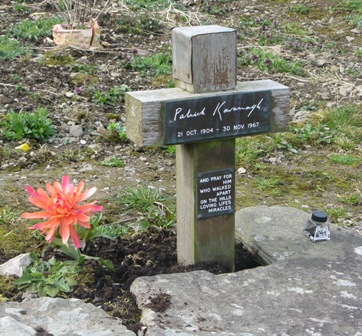 Kavanagh's grave.[/caption]
From County Monaghan I venture into County Leitrim, another part of Ireland well off the beaten track. This region suffered massive depopulation during the potato famine and the Great Depression of the 1920s. It’s now one of Ireland’s most sparsely populated counties. Wildlife is making a comeback here, fields have been left fallow for decades and birdlife has returned in large numbers.
Leitrim Landscapes Guided Walks owner Nuala McNulty covers the county from an environmental perspective. She knows more about the hidden eco-tourism wonders of this region better than anyone. I’ve been walking with her for two hours while the fickle weather takes a turn for the worse. Driving rain prevents us from climbing a nearby hill for its western views over County Sligo to the Atlantic Ocean. Instead we follow a flooded river down a steep valley, past a waterfall, slipping and sliding on smooth stones, exchanging stories about curious characters we’ve met here and elsewhere on our individual travels.
McNulty is quick as a whip with an infectious laugh. Just off the path is a tiny shrine devoted to a holy spring, which I’ve overlooked as it’s invisible behind thick shrubbery. McNulty tells me, 'Springs like this one are scattered about the county and were holy even before St Patrick came along to convert us heathens', she explains, dipping her hands into the running water. The open sided shrine is large enough to shelter a small child, no more.
[caption id="attachment_2201" align="alignnone" width="336"]
Kavanagh's grave.[/caption]
From County Monaghan I venture into County Leitrim, another part of Ireland well off the beaten track. This region suffered massive depopulation during the potato famine and the Great Depression of the 1920s. It’s now one of Ireland’s most sparsely populated counties. Wildlife is making a comeback here, fields have been left fallow for decades and birdlife has returned in large numbers.
Leitrim Landscapes Guided Walks owner Nuala McNulty covers the county from an environmental perspective. She knows more about the hidden eco-tourism wonders of this region better than anyone. I’ve been walking with her for two hours while the fickle weather takes a turn for the worse. Driving rain prevents us from climbing a nearby hill for its western views over County Sligo to the Atlantic Ocean. Instead we follow a flooded river down a steep valley, past a waterfall, slipping and sliding on smooth stones, exchanging stories about curious characters we’ve met here and elsewhere on our individual travels.
McNulty is quick as a whip with an infectious laugh. Just off the path is a tiny shrine devoted to a holy spring, which I’ve overlooked as it’s invisible behind thick shrubbery. McNulty tells me, 'Springs like this one are scattered about the county and were holy even before St Patrick came along to convert us heathens', she explains, dipping her hands into the running water. The open sided shrine is large enough to shelter a small child, no more.
[caption id="attachment_2201" align="alignnone" width="336"]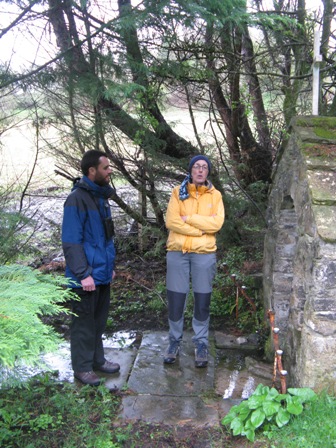 Rob and Nuala at sacred spring in North Leitrim.[/caption]
From McNulty I learn that Leitrim is a county even the Irish seemed to have forgotten. She adds, 'No one wanted to live here for ages. Not so now. It’s become something of a new age centre with folk who care about the environment, a good place to live now, not mad like Dublin. People are friendly here.' Though I didn’t find Dubliners unfriendly, the attitudinal difference between people here and those in Dublin is noticeable, the capital is frantically busy in comparison to Leitrim’s peaceful calm.
I spend a lovely night in Roscommon at Mary Gleeson's Townhouse, the town's best hostelry conveniently located right in the town's centre. Mary and her husband Eammon run an authentic Irish guesthouse. Comfort and hospitality are king while the small hotel's restaurant does a booming trade with locals and visitors alike.
[caption id="attachment_2210" align="alignnone" width="259"]
Rob and Nuala at sacred spring in North Leitrim.[/caption]
From McNulty I learn that Leitrim is a county even the Irish seemed to have forgotten. She adds, 'No one wanted to live here for ages. Not so now. It’s become something of a new age centre with folk who care about the environment, a good place to live now, not mad like Dublin. People are friendly here.' Though I didn’t find Dubliners unfriendly, the attitudinal difference between people here and those in Dublin is noticeable, the capital is frantically busy in comparison to Leitrim’s peaceful calm.
I spend a lovely night in Roscommon at Mary Gleeson's Townhouse, the town's best hostelry conveniently located right in the town's centre. Mary and her husband Eammon run an authentic Irish guesthouse. Comfort and hospitality are king while the small hotel's restaurant does a booming trade with locals and visitors alike.
[caption id="attachment_2210" align="alignnone" width="259"] Mary Gleesons Townhouse in Roscommon.[/caption]
Hospitality like this is rare. Mary tells me, 'You won't be spending an evening on your own will you? Come join us. We're going to a play, 'The Quare Land'. The actors are staying with us. I'm sure you'll like it.' The play is funny and timely, all about Ireland's recent history of land speculation gone mad. We head to the local pub for refreshment afterwards. Eammon insists I sample a broad range of Irish whisky. I can't say no.
[caption id="attachment_2211" align="alignnone" width="201"]
Mary Gleesons Townhouse in Roscommon.[/caption]
Hospitality like this is rare. Mary tells me, 'You won't be spending an evening on your own will you? Come join us. We're going to a play, 'The Quare Land'. The actors are staying with us. I'm sure you'll like it.' The play is funny and timely, all about Ireland's recent history of land speculation gone mad. We head to the local pub for refreshment afterwards. Eammon insists I sample a broad range of Irish whisky. I can't say no.
[caption id="attachment_2211" align="alignnone" width="201"]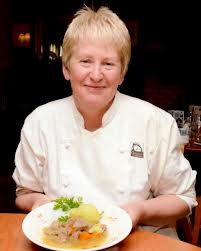 Mary Gleeson with a serving of Irish stew.[/caption]
The following day I meet artist Helen Conneely at the Celtic Roots Studio in Ballinahown, County Westmeath. Within ten minutes Conneely has me hard at work in her studio, sandpaper in hand polishing a piece of oak bog wood approximately 5,000 years old. From trekking through sodden forests one day to manual labour in a hot workshop the next, this Irish trip has become seriously disjointed. I drank an excess of Irish whiskey the night before arriving late (yet again because I’m lost) at the Celtic Roots Studio and I suspect Conneely has little sympathy for my aching head. 'You’re doing okay with that piece, just rub it a bit harder with this paper and I’ll get some olive oil for you to finish it with,' she says. 'Oh, that looks nice,' she comments, 'Don’t give up your day job though.'
[caption id="attachment_2212" align="alignnone" width="276"]
Mary Gleeson with a serving of Irish stew.[/caption]
The following day I meet artist Helen Conneely at the Celtic Roots Studio in Ballinahown, County Westmeath. Within ten minutes Conneely has me hard at work in her studio, sandpaper in hand polishing a piece of oak bog wood approximately 5,000 years old. From trekking through sodden forests one day to manual labour in a hot workshop the next, this Irish trip has become seriously disjointed. I drank an excess of Irish whiskey the night before arriving late (yet again because I’m lost) at the Celtic Roots Studio and I suspect Conneely has little sympathy for my aching head. 'You’re doing okay with that piece, just rub it a bit harder with this paper and I’ll get some olive oil for you to finish it with,' she says. 'Oh, that looks nice,' she comments, 'Don’t give up your day job though.'
[caption id="attachment_2212" align="alignnone" width="276"]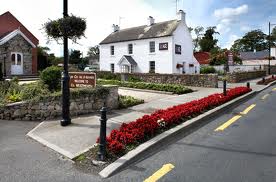 Celtic Roots Studio exterior.[/caption]
Bog wood is akin to Irish gold. Petrified forests of oak, yew and Scot’s pine sourced underneath ancient blanket bogs are among Ireland’s most important geological treasures. Little authentic bog land still exists. Much of it has for centuries been mined for peat. Conneely explains that, 'Irish craftwork and jewellery are making a comeback due to bog wood. I’ve been working with it for years, as you can see,' she shows me a few of her artfully crafted pieces ranging from necklaces and earrings to lamps and objets d’art, 'and it’s grand to see a part of our heritage come to life again.' In no small part due to her efforts I believe.
[caption id="attachment_2213" align="alignnone" width="275"]
Celtic Roots Studio exterior.[/caption]
Bog wood is akin to Irish gold. Petrified forests of oak, yew and Scot’s pine sourced underneath ancient blanket bogs are among Ireland’s most important geological treasures. Little authentic bog land still exists. Much of it has for centuries been mined for peat. Conneely explains that, 'Irish craftwork and jewellery are making a comeback due to bog wood. I’ve been working with it for years, as you can see,' she shows me a few of her artfully crafted pieces ranging from necklaces and earrings to lamps and objets d’art, 'and it’s grand to see a part of our heritage come to life again.' In no small part due to her efforts I believe.
[caption id="attachment_2213" align="alignnone" width="275"]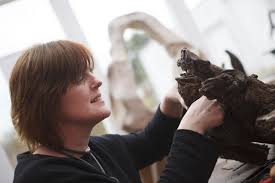 Helen Conneely of Celtic Roots Studio.[/caption]
I make a side trip to Mossfield Organic farm to meet its owners Ralph and Lorraine Haslam, makers of Ireland's finest hard cheese. Ralph invites me on a tour of his highland property, located almost exactly in the geographical heart of Ireland in West Offaly County approximately ten kilometres from Birr. We meet in Birr before so I can follow Ralph to Mossfield farm. Without Ralph's help I never would have found his farm. After over a week in rural Ireland, I've learnt the hard way to rely on local guidance.
[caption id="attachment_2208" align="alignnone" width="345"]
Helen Conneely of Celtic Roots Studio.[/caption]
I make a side trip to Mossfield Organic farm to meet its owners Ralph and Lorraine Haslam, makers of Ireland's finest hard cheese. Ralph invites me on a tour of his highland property, located almost exactly in the geographical heart of Ireland in West Offaly County approximately ten kilometres from Birr. We meet in Birr before so I can follow Ralph to Mossfield farm. Without Ralph's help I never would have found his farm. After over a week in rural Ireland, I've learnt the hard way to rely on local guidance.
[caption id="attachment_2208" align="alignnone" width="345"]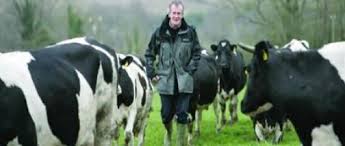 Ralph Haslam with a few of his prized cows.[/caption]
Mossfield cheese is superb. As Ralph explains, 'It's all about the milk and happy cows.' We sample from a number of aged rounds, picking one out of five as the best of a lot. 'You've helped me choose the cheese that's being served for a state banquet during Queen Elizabeth's upcoming visit. I hope she likes it, if not I'm blaming you.' We have a laugh and eat some more delicious cheese. Ralph gives me a few delicately wrapped chunks to take away, typical Irish hospitality. At the farm gate he instructs, 'Turn right at the crossing, go to the next village, turn left and you'll be at the main road. The way to Cashel is marked there.' I never find that main road and it doesn't exist on the GPS either but I do enjoy munching on the cheese when I pull the car over to a wayside to check my useless map once again.
[caption id="attachment_2209" align="alignnone" width="274"]
Ralph Haslam with a few of his prized cows.[/caption]
Mossfield cheese is superb. As Ralph explains, 'It's all about the milk and happy cows.' We sample from a number of aged rounds, picking one out of five as the best of a lot. 'You've helped me choose the cheese that's being served for a state banquet during Queen Elizabeth's upcoming visit. I hope she likes it, if not I'm blaming you.' We have a laugh and eat some more delicious cheese. Ralph gives me a few delicately wrapped chunks to take away, typical Irish hospitality. At the farm gate he instructs, 'Turn right at the crossing, go to the next village, turn left and you'll be at the main road. The way to Cashel is marked there.' I never find that main road and it doesn't exist on the GPS either but I do enjoy munching on the cheese when I pull the car over to a wayside to check my useless map once again.
[caption id="attachment_2209" align="alignnone" width="274"]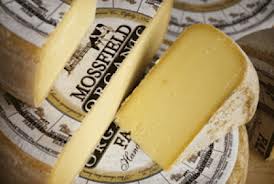 Some of Mossfield's prize cheeses.[/caption]
My off-beat journey reveals much about the Irish, some of it stereotypical. Is there another European country populated by such colloquial and amiable citizens as Ireland? It’s a country of surprises too. The conflict in the North has taken its emotional and physical toll on many, dour dispositions alternate with ironic humour for good reason, life has been tough here for a very long time. Patrick Kavanagh should have a final say on this peculiarly Irish contrast of moods, from ‘Stony Grey Soil’:
‘O stony grey soil of Monaghan,
The laugh from my love you thieved;
You took the gay child of my passion
And gave me your clod-conceived’
Tom Neal Tacker travelled courtesy of Thai Airways, Aer Lingus and Failte Ireland, the National Tourism Development Authority.
Naked Facts:
Naked Routes:
Thai Airways flies to Europe via Bangkok from most Australian mainland cities. See www.thaiairways.com for details and bookings. Aer Lingus has a comprehensive network connecting Dublin, Cork and Shannon airports to many European and North American cities linked to Thai Airways’ network. See www.aerlingus.com for details and bookings.
Naked Sleeps:
Ghan House hotel in picturesque Carlingford, County Louth, is a real gem. Great food in a graciously restored 19th century boutique hotel makes tiny Carlingford a real gourmet's destination. For more information and seasonal special deals, see www.ghanhouse.com
Hilton Park Luxury House offers antique filled, fabulously decorated historic rooms and excellent cuisine prepared using local ingredients, much of the food from the estate’s garden. See www.hiltonpark.ie for details and bookings.
Ard Nahoo in Mullagh, Dromahair County Leitrim is an eco-retreat offering massage therapy and yoga classes in a rustic location with well appointed fully self-contained cottages. See www.ardnahoo.com for details and bookings.
Mary Gleesons Townhouse is right in Roscommon's bustling centre. There may be more elegant (and expensive) lodgings in rural Ireland, but few are as warmly inviting as this: www.gleesonstownhouse.com
In Dublin, Number 31 Leeson Close is top notch for service, location and accommodation in a Georgian era townhouse. 31 Leeson Close has won awards for best breakfasts in Ireland and is highly recommended. See www.number31.ie for details and bookings.
Naked Tips:
Newgrange is one of Ireland's most important archaeological sites. Unmissable. www.newgrange.com
Kavanagh Country: www.patrickkavanaghcountry.com
Leitrim Landscapes Guided Walks: www.tawnylustlodge.com
Celtic Roots Studio: www.celticroots.ie
Mossfield Organic Farm near Birr in West Offaly County may be visited by prior arrangement: www.mossfield.ie
Irish Tourism inquiries and advice: www.discoverireland.com
Some of Mossfield's prize cheeses.[/caption]
My off-beat journey reveals much about the Irish, some of it stereotypical. Is there another European country populated by such colloquial and amiable citizens as Ireland? It’s a country of surprises too. The conflict in the North has taken its emotional and physical toll on many, dour dispositions alternate with ironic humour for good reason, life has been tough here for a very long time. Patrick Kavanagh should have a final say on this peculiarly Irish contrast of moods, from ‘Stony Grey Soil’:
‘O stony grey soil of Monaghan,
The laugh from my love you thieved;
You took the gay child of my passion
And gave me your clod-conceived’
Tom Neal Tacker travelled courtesy of Thai Airways, Aer Lingus and Failte Ireland, the National Tourism Development Authority.
Naked Facts:
Naked Routes:
Thai Airways flies to Europe via Bangkok from most Australian mainland cities. See www.thaiairways.com for details and bookings. Aer Lingus has a comprehensive network connecting Dublin, Cork and Shannon airports to many European and North American cities linked to Thai Airways’ network. See www.aerlingus.com for details and bookings.
Naked Sleeps:
Ghan House hotel in picturesque Carlingford, County Louth, is a real gem. Great food in a graciously restored 19th century boutique hotel makes tiny Carlingford a real gourmet's destination. For more information and seasonal special deals, see www.ghanhouse.com
Hilton Park Luxury House offers antique filled, fabulously decorated historic rooms and excellent cuisine prepared using local ingredients, much of the food from the estate’s garden. See www.hiltonpark.ie for details and bookings.
Ard Nahoo in Mullagh, Dromahair County Leitrim is an eco-retreat offering massage therapy and yoga classes in a rustic location with well appointed fully self-contained cottages. See www.ardnahoo.com for details and bookings.
Mary Gleesons Townhouse is right in Roscommon's bustling centre. There may be more elegant (and expensive) lodgings in rural Ireland, but few are as warmly inviting as this: www.gleesonstownhouse.com
In Dublin, Number 31 Leeson Close is top notch for service, location and accommodation in a Georgian era townhouse. 31 Leeson Close has won awards for best breakfasts in Ireland and is highly recommended. See www.number31.ie for details and bookings.
Naked Tips:
Newgrange is one of Ireland's most important archaeological sites. Unmissable. www.newgrange.com
Kavanagh Country: www.patrickkavanaghcountry.com
Leitrim Landscapes Guided Walks: www.tawnylustlodge.com
Celtic Roots Studio: www.celticroots.ie
Mossfield Organic Farm near Birr in West Offaly County may be visited by prior arrangement: www.mossfield.ie
Irish Tourism inquiries and advice: www.discoverireland.com
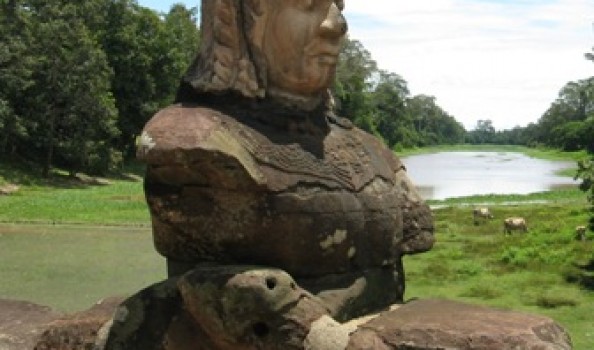 https://nakedhungrytraveller.com.au/temples-and-tears-in-cambodia/ Temples and Tears in Cambodia
https://nakedhungrytraveller.com.au/temples-and-tears-in-cambodia/ Temples and Tears in CambodiaThere’s so much more to Cambodia than day-tripping to Angkor Wat.
When the rainy season reaches full stride during the torrid Cambodian summer, life here changes rapidly. Fickle climate change has increased unpredictability. Now, heavy rain may fall at any time, though January through May is normally dry. By August however the dust has turned to mud, roads are almost impassable and a farmer’s wishful thoughts turn to the Mekong River and its tributary lake, the great Tonle Sap. The flood down the Mekong can be intense so that water begins to back up the Tonle Sap channel, annually refilling this amorphously shallow lake. [caption id="attachment_2166" align="alignnone" width="261"]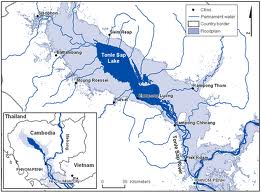 Tonle Sap map: pale blue outline shows lake at extent of annual flood.[/caption]
Fish fatten, rice paddies flourish and the people eat well. Sadly, new dams upstream in southern China where the Mekong begins its journey through Southeast Asia present potentially damaging environmental problems in a country that has already experienced more than most. Despite the flooding, the lake level is at a historic low and fish harvests are down.
[caption id="attachment_2167" align="alignnone" width="276"]
Tonle Sap map: pale blue outline shows lake at extent of annual flood.[/caption]
Fish fatten, rice paddies flourish and the people eat well. Sadly, new dams upstream in southern China where the Mekong begins its journey through Southeast Asia present potentially damaging environmental problems in a country that has already experienced more than most. Despite the flooding, the lake level is at a historic low and fish harvests are down.
[caption id="attachment_2167" align="alignnone" width="276"]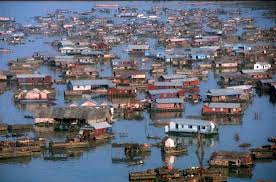 Tonle Sap floating village.[/caption]
To recount a Cambodian chronology is to reflect on years of hardship. In the late 1960s, great swathes of countryside were fire-bombed, whole towns were reduced to rubble. During the 1970s, Pol Pot’s Khmer Rouge murdered some three million people. The Vietnamese killed most of the wildlife and bombed temples in the 1980s. Then the Thais, the Chinese and the Vietnamese purloined many of the country’s artworks in the 1990s. Add rampant local corruption to the tale and sadness becomes the overarching narrative.
Most travellers in Siem Reap spend a few days at the great temples, undoubtedly among Asia’s magnificent sights. Given the scores of camera-toting tourists lined up at the artificial lake in front of Angkor Wat waiting for the requisite dawn or dusk money shot, it continues to be a global tourism drawcard.
[caption id="attachment_2168" align="alignnone" width="448"]
Tonle Sap floating village.[/caption]
To recount a Cambodian chronology is to reflect on years of hardship. In the late 1960s, great swathes of countryside were fire-bombed, whole towns were reduced to rubble. During the 1970s, Pol Pot’s Khmer Rouge murdered some three million people. The Vietnamese killed most of the wildlife and bombed temples in the 1980s. Then the Thais, the Chinese and the Vietnamese purloined many of the country’s artworks in the 1990s. Add rampant local corruption to the tale and sadness becomes the overarching narrative.
Most travellers in Siem Reap spend a few days at the great temples, undoubtedly among Asia’s magnificent sights. Given the scores of camera-toting tourists lined up at the artificial lake in front of Angkor Wat waiting for the requisite dawn or dusk money shot, it continues to be a global tourism drawcard.
[caption id="attachment_2168" align="alignnone" width="448"]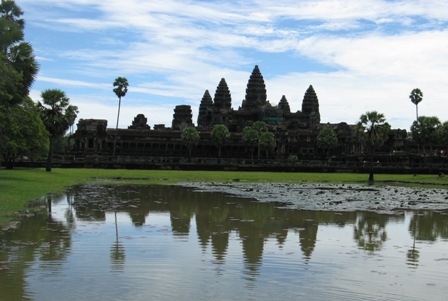 Angkor Wat in late morning sunlight.[/caption]
Other temples such as Angkor Thom and Bayon attract similar sized crowds. Angelina Jolie fans at Ta Prohm temple duly recreate scenes from the Lara Croft Tomb Raider film shot here in 2001.
[caption id="attachment_2184" align="alignnone" width="336"]
Angkor Wat in late morning sunlight.[/caption]
Other temples such as Angkor Thom and Bayon attract similar sized crowds. Angelina Jolie fans at Ta Prohm temple duly recreate scenes from the Lara Croft Tomb Raider film shot here in 2001.
[caption id="attachment_2184" align="alignnone" width="336"]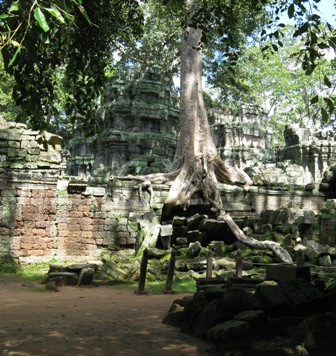 Strangler fig tree at Ta Prohm.[/caption]
Gigantic fig vines twist around ancient stones recreating an alluring film set atmosphere.
[caption id="attachment_2182" align="alignnone" width="448"]
Strangler fig tree at Ta Prohm.[/caption]
Gigantic fig vines twist around ancient stones recreating an alluring film set atmosphere.
[caption id="attachment_2182" align="alignnone" width="448"] Ta Prohm face statues details.[/caption]
Relatively few visitors are aware that the Siem Reap region contains over 200 temples, most of them infrequently seen. To gain an appreciation of what lies waiting to be explored, head to Phnom Bakheng atop Temple Mountain and be amazed at the sweeping vista, a sure invitation to venture further a field.
[caption id="attachment_2169" align="alignnone" width="275"]
Ta Prohm face statues details.[/caption]
Relatively few visitors are aware that the Siem Reap region contains over 200 temples, most of them infrequently seen. To gain an appreciation of what lies waiting to be explored, head to Phnom Bakheng atop Temple Mountain and be amazed at the sweeping vista, a sure invitation to venture further a field.
[caption id="attachment_2169" align="alignnone" width="275"]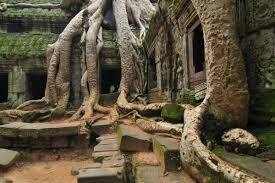 Ta Prohm temple and strangling fig trees.[/caption]
I spend a hot humid afternoon at Beng Mealea and Koh Ker temples. My guide, a survivor from Pol Pot’s decimation of the educated elite, mentions that a dark corridor I am tempted to explore at Beng Mealea is rife with ‘scorpions and cobras’ and that it is unwise to proceed.
[caption id="attachment_2187" align="alignnone" width="262"]
Ta Prohm temple and strangling fig trees.[/caption]
I spend a hot humid afternoon at Beng Mealea and Koh Ker temples. My guide, a survivor from Pol Pot’s decimation of the educated elite, mentions that a dark corridor I am tempted to explore at Beng Mealea is rife with ‘scorpions and cobras’ and that it is unwise to proceed.
[caption id="attachment_2187" align="alignnone" width="262"]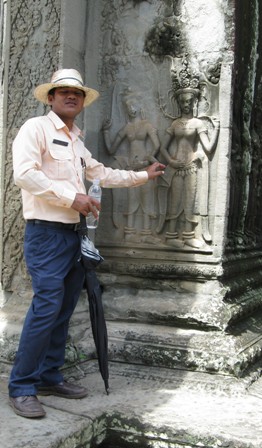 Guide with Apsara statues at Angkor Wat.[/caption]
Landmines scattered around this area have only recently been removed with the help of a German aid organisation.
[caption id="attachment_2179" align="alignnone" width="407"]
Guide with Apsara statues at Angkor Wat.[/caption]
Landmines scattered around this area have only recently been removed with the help of a German aid organisation.
[caption id="attachment_2179" align="alignnone" width="407"] Landmine clearing sign.[/caption]
Carried away again by the tomb raiding atmosphere, I completely forget that it’s a jungle out here. There is no one else about.
[caption id="attachment_2170" align="alignnone" width="448"]
Landmine clearing sign.[/caption]
Carried away again by the tomb raiding atmosphere, I completely forget that it’s a jungle out here. There is no one else about.
[caption id="attachment_2170" align="alignnone" width="448"]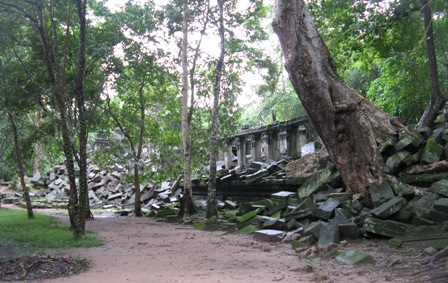 Beng Melea is far from Angkor Wat's madding crowds.[/caption]
At Bantey Srey, a lovely pink-hued sandstone temple, known also as the ‘Citadel of the Women’ for its delicately carved inlays of village women, we are also alone. These sites are only 90 minute’s bone-rattling drive from Angkor Wat, but off the beaten track. There are numerous nearly forgotten places, just as hauntingly beautiful as Angkor Wat but minus thousands of tourists.
[caption id="attachment_2171" align="alignnone" width="448"]
Beng Melea is far from Angkor Wat's madding crowds.[/caption]
At Bantey Srey, a lovely pink-hued sandstone temple, known also as the ‘Citadel of the Women’ for its delicately carved inlays of village women, we are also alone. These sites are only 90 minute’s bone-rattling drive from Angkor Wat, but off the beaten track. There are numerous nearly forgotten places, just as hauntingly beautiful as Angkor Wat but minus thousands of tourists.
[caption id="attachment_2171" align="alignnone" width="448"] Bantey Srey temple, 'Citadel of Women'.[/caption]
While the less popular temples are undeniably stunning, eerily quiet and peaceful, after a few days I’ve reached temple overload. A sort of ‘not another bloody temple’ experience akin to too many European cathedrals in a week or too many masterpieces in the Louvre museum in a day. In short, I’m not appreciating what I should be appreciating and need a break. I consult with my hosts and ask their advice.
[caption id="attachment_2181" align="alignnone" width="336"]
Bantey Srey temple, 'Citadel of Women'.[/caption]
While the less popular temples are undeniably stunning, eerily quiet and peaceful, after a few days I’ve reached temple overload. A sort of ‘not another bloody temple’ experience akin to too many European cathedrals in a week or too many masterpieces in the Louvre museum in a day. In short, I’m not appreciating what I should be appreciating and need a break. I consult with my hosts and ask their advice.
[caption id="attachment_2181" align="alignnone" width="336"]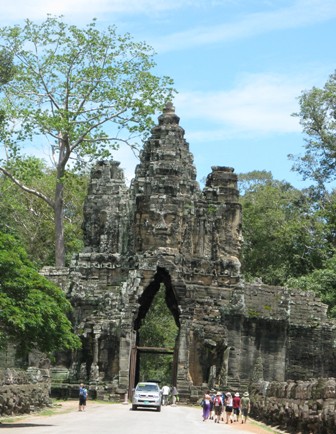 Angkor Wat complex gateway arch.[/caption]
Prepared for a week’s touring around Siem Reap to focus on Angkor Wat and to sample some of Cambodia’s intriguing cuisine, I am fortunate instead to be allowed a glimpse into present day realities, a privilege granted by the Hotel de la Paix. I could have stayed at any one of numerous hotels in Siem Reap, the pickings are ripe. Admittedly, the de la Paix is a 5-star hotel, slick and cool with efficient plumbing and an in-house generator that kicks in when the town’s power supply shuts down, which occurred daily while I was there. A reliable internet connection, sensational food and a bar that wouldn’t look out of place in Miami’s South Beach complete the picture. It’s also run by people with big hearts and keen social awareness. While many hotel managers in Siem Reap have retrenched staff during the global financial downturn, the de la Paix management team took a collective pay cut in order to retain all part time and casual workers. One income supports a dozen people around Siem Reap, a fact other hoteliers have callously ignored.
Among many experiences available to travellers: cultural wonders, food tourism, river boating, beach havens, wildlife and eco-tourism spring immediately to mind, Cambodians themselves inspire hope. I believe two choices await visitors to Cambodia. Wear blinders or go with eyes open to daily reality. For me, a visit to Cambodia is emotionally charged. Each day I laugh hysterically or sob uncontrollably, usually both.
My itinerary is altered and my impressions instantly change. First up is the Hotel de la Paix Sewing Training Centre, founded by volunteers to keep women employed as full-time seamstresses or designers rather than as construction site labourers earning less than USD $1 per day making bricks. The following day, I visit the Green Geckos Project, also supported by the hotel. It’s an orphanage for abandoned children, keeping them off the streets from a life of begging or worse. At a special English school, again partially funded by the hotel with over 400 students, helping to expand employment potential in a very tight labour market, I give impromptu lessons in English much to the amusement of the students. Evidently they aren’t given many opportunities to hear a foreigner make a fool of himself in public while he tries to explain the subjunctive text. I’ve gone from temples to tears to laughter in two days.
[caption id="attachment_2172" align="alignnone" width="424"]
Angkor Wat complex gateway arch.[/caption]
Prepared for a week’s touring around Siem Reap to focus on Angkor Wat and to sample some of Cambodia’s intriguing cuisine, I am fortunate instead to be allowed a glimpse into present day realities, a privilege granted by the Hotel de la Paix. I could have stayed at any one of numerous hotels in Siem Reap, the pickings are ripe. Admittedly, the de la Paix is a 5-star hotel, slick and cool with efficient plumbing and an in-house generator that kicks in when the town’s power supply shuts down, which occurred daily while I was there. A reliable internet connection, sensational food and a bar that wouldn’t look out of place in Miami’s South Beach complete the picture. It’s also run by people with big hearts and keen social awareness. While many hotel managers in Siem Reap have retrenched staff during the global financial downturn, the de la Paix management team took a collective pay cut in order to retain all part time and casual workers. One income supports a dozen people around Siem Reap, a fact other hoteliers have callously ignored.
Among many experiences available to travellers: cultural wonders, food tourism, river boating, beach havens, wildlife and eco-tourism spring immediately to mind, Cambodians themselves inspire hope. I believe two choices await visitors to Cambodia. Wear blinders or go with eyes open to daily reality. For me, a visit to Cambodia is emotionally charged. Each day I laugh hysterically or sob uncontrollably, usually both.
My itinerary is altered and my impressions instantly change. First up is the Hotel de la Paix Sewing Training Centre, founded by volunteers to keep women employed as full-time seamstresses or designers rather than as construction site labourers earning less than USD $1 per day making bricks. The following day, I visit the Green Geckos Project, also supported by the hotel. It’s an orphanage for abandoned children, keeping them off the streets from a life of begging or worse. At a special English school, again partially funded by the hotel with over 400 students, helping to expand employment potential in a very tight labour market, I give impromptu lessons in English much to the amusement of the students. Evidently they aren’t given many opportunities to hear a foreigner make a fool of himself in public while he tries to explain the subjunctive text. I’ve gone from temples to tears to laughter in two days.
[caption id="attachment_2172" align="alignnone" width="424"]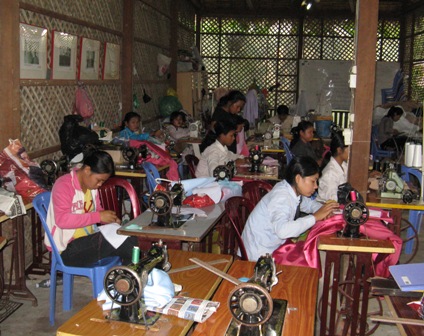 Sewing Centre students.[/caption]
None of these efforts is mentioned in the hotel’s publicity material, though guests are encouraged to get involved if they wish, discreet inquiries lead to open doors. The Hotel de la Paix commits to charity because it’s the right thing to do. Profits flow on from good works, hopefully. In this hotel’s case, they do. Operating at over 80% capacity, both the restaurant and bar are full every night. Other 5-star hotels I visit are nearly empty, an example of good karma in action. I suspect that a lot of hard work behind the scenes helps.
[caption id="attachment_2173" align="alignnone" width="448"]
Sewing Centre students.[/caption]
None of these efforts is mentioned in the hotel’s publicity material, though guests are encouraged to get involved if they wish, discreet inquiries lead to open doors. The Hotel de la Paix commits to charity because it’s the right thing to do. Profits flow on from good works, hopefully. In this hotel’s case, they do. Operating at over 80% capacity, both the restaurant and bar are full every night. Other 5-star hotels I visit are nearly empty, an example of good karma in action. I suspect that a lot of hard work behind the scenes helps.
[caption id="attachment_2173" align="alignnone" width="448"] Students at English speaking school.[/caption]
At Green Geckos, I meet with founders Tania Palmer, an Australian from Sydney and her Cambodian husband Rem Poum. Unlike other orphanages, Green Geckos operates as a sanctuary and school for kids whose parents are alive but have abandoned them to the streets. They are the forgotten offspring of living parents trapped by drug addiction or the sex trade, incapable of supporting their children. Until Green Geckos rescued them from the streets most had never been to school. Palmer tells me that, ‘We’ve had three independent assessments done by volunteer child psychologists. I was told that each of our kids has been physically abused, some of them sexually.’
[caption id="attachment_2174" align="alignnone" width="275"]
Students at English speaking school.[/caption]
At Green Geckos, I meet with founders Tania Palmer, an Australian from Sydney and her Cambodian husband Rem Poum. Unlike other orphanages, Green Geckos operates as a sanctuary and school for kids whose parents are alive but have abandoned them to the streets. They are the forgotten offspring of living parents trapped by drug addiction or the sex trade, incapable of supporting their children. Until Green Geckos rescued them from the streets most had never been to school. Palmer tells me that, ‘We’ve had three independent assessments done by volunteer child psychologists. I was told that each of our kids has been physically abused, some of them sexually.’
[caption id="attachment_2174" align="alignnone" width="275"] Green Geckoes Project kids.[/caption]
Green Geckos send their kids to the local school where they follow the national curriculum. At 3pm they return home to two more hours of school to learn English and other skills. They share the duties of preparing the evening meal, the older children helping to supervise the younger ones. One hundred and three kids live here, all rescued from a miserable life on the streets of Siem Reap. Some parents try to stay involved in their children’s lives but most don’t. They voluntarily place their kids at Green Geckos though Palmer assures me that it’s a difficult process. ‘We try to help the parents escape from horrible circumstances but some are so addicted to alcohol, drugs or worse that it’s an almost impossible task. Some of our kids sleep here because it’s not safe at home but spend some of the weekends with their parents to maintain some family connection. A few parents struggle to change their lives and we’re able to help them as best we can, my husband Prem is a social worker with a network of other local charities. A couple of them have been able to change their lives but still can’t look after their children. Some are handicapped due to war injuries. I’m sure that most of the parents have suffered abuse themselves and they can’t earn enough money to support themselves much less their children.’
[caption id="attachment_2175" align="alignnone" width="259"]
Green Geckoes Project kids.[/caption]
Green Geckos send their kids to the local school where they follow the national curriculum. At 3pm they return home to two more hours of school to learn English and other skills. They share the duties of preparing the evening meal, the older children helping to supervise the younger ones. One hundred and three kids live here, all rescued from a miserable life on the streets of Siem Reap. Some parents try to stay involved in their children’s lives but most don’t. They voluntarily place their kids at Green Geckos though Palmer assures me that it’s a difficult process. ‘We try to help the parents escape from horrible circumstances but some are so addicted to alcohol, drugs or worse that it’s an almost impossible task. Some of our kids sleep here because it’s not safe at home but spend some of the weekends with their parents to maintain some family connection. A few parents struggle to change their lives and we’re able to help them as best we can, my husband Prem is a social worker with a network of other local charities. A couple of them have been able to change their lives but still can’t look after their children. Some are handicapped due to war injuries. I’m sure that most of the parents have suffered abuse themselves and they can’t earn enough money to support themselves much less their children.’
[caption id="attachment_2175" align="alignnone" width="259"]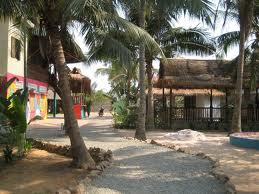 Green Geckoes Project school and part of grounds.[/caption]
She gestures at the kids as they return from school. I notice one boy sit at a nearby table and immediately open his notebook. ‘Watch him,’ Palmer instructs. ‘He lost his father last week to a drug overdose. He’s 13, a lovely boy. He didn’t attend his father’s funeral. We didn’t force him to go either. His father beat him every day of his life, he’s so insecure and unloved but he’s coming out of his shell now. His story is so much like all the others here.’ The look on the boy’s face tells me much, a hidden sadness, deep-rooted and permanent. Palmer continues, ‘We think that we’ve got all the kids off the streets of Siem Reap now though by no means do all the kids not in our care go to school. This global financial crisis is taking its toll on the countryside. More people are leaving their villages to find work in Siem Reap. The pity is that there is no work here either.’
[caption id="attachment_2185" align="alignnone" width="259"]
Green Geckoes Project school and part of grounds.[/caption]
She gestures at the kids as they return from school. I notice one boy sit at a nearby table and immediately open his notebook. ‘Watch him,’ Palmer instructs. ‘He lost his father last week to a drug overdose. He’s 13, a lovely boy. He didn’t attend his father’s funeral. We didn’t force him to go either. His father beat him every day of his life, he’s so insecure and unloved but he’s coming out of his shell now. His story is so much like all the others here.’ The look on the boy’s face tells me much, a hidden sadness, deep-rooted and permanent. Palmer continues, ‘We think that we’ve got all the kids off the streets of Siem Reap now though by no means do all the kids not in our care go to school. This global financial crisis is taking its toll on the countryside. More people are leaving their villages to find work in Siem Reap. The pity is that there is no work here either.’
[caption id="attachment_2185" align="alignnone" width="259"]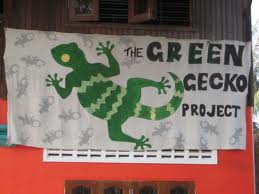 Green Geckoes sign.[/caption]
The boy’s story parallels Cambodia’s. Pervasive sadness is readily evident. How can there not be? The genocide wiped out a third of the population. A whole generation bears the ultimate cost; many survivors have no living relatives. The emotional damage I observe in their faces overwhelms me. Strangers I meet tell me that they lost parents, siblings, grandparents and now they’re completely alone, disconnected from their family history but bound by the country’s past.
At Angkor Wat I talk to kids as young as five selling postcards and cheap jewellery to tourists. ‘Where do you go to school?’ I ask them via my guide acting as translator. ‘We have no school today,’ they reply. My guide tells me they always say that, reneging on school, working instead around the temples paying off the police to gain access and making less than USD $2 per day if they’re lucky. The money buys them a little food but most of it goes to their families. I invite two of them to join us for lunch, hoping that this one meal will be enough. I don’t want to give money as I’m not sure if it will go to their parents’ drug habits or worse. They smile while they devour noodles and vegetables with a fried egg on top. I buy them fresh coconuts to drink and watch them walk away in the extreme heat, skinny legs barely coping with the weight of trays laden with tourist tat. Back in my cocooned room at the de la Paix, I weep.
I spend a full day with Nick Butler, manager for the Angkor Center for Conservation of Biodiversity (ACCB) and the Sam Veasna Center. His role is to train and organise a team of local guides to run the Center’s eco-tours while spreading the message that Cambodia harbours a shrinking though incredibly diverse eco-system. When I ask him about the Vietnamese massacre of Cambodian wildlife, he concurs. ‘After the Pol Pot regime finally ended, the Vietnamese came in and nearly wiped out vast areas of pristine wilderness. There was an area in the northeast that was known as the ‘Serengeti of Asia’ because of its population of migratory herd animals and predators such as tigers. But most of it is gone now because of logging and deforestation due to bombing raids. The Vietnamese and Chinese trade in endangered species has certainly nailed down the coffin lids.’ We’re in his clapped out 4WD bouncing through enormous potholes on flooded roads on our way to Ang Tropaeng Thmor, a bird sanctuary two and a half hours drive from Siem Reap. Rare water birds flock here, a reservoir dating to Angkorian times with the largest concentration of Sarus Cranes and Lesser Adjutant Storks in Southeast Asia.
[caption id="attachment_2186" align="alignnone" width="412"]
Green Geckoes sign.[/caption]
The boy’s story parallels Cambodia’s. Pervasive sadness is readily evident. How can there not be? The genocide wiped out a third of the population. A whole generation bears the ultimate cost; many survivors have no living relatives. The emotional damage I observe in their faces overwhelms me. Strangers I meet tell me that they lost parents, siblings, grandparents and now they’re completely alone, disconnected from their family history but bound by the country’s past.
At Angkor Wat I talk to kids as young as five selling postcards and cheap jewellery to tourists. ‘Where do you go to school?’ I ask them via my guide acting as translator. ‘We have no school today,’ they reply. My guide tells me they always say that, reneging on school, working instead around the temples paying off the police to gain access and making less than USD $2 per day if they’re lucky. The money buys them a little food but most of it goes to their families. I invite two of them to join us for lunch, hoping that this one meal will be enough. I don’t want to give money as I’m not sure if it will go to their parents’ drug habits or worse. They smile while they devour noodles and vegetables with a fried egg on top. I buy them fresh coconuts to drink and watch them walk away in the extreme heat, skinny legs barely coping with the weight of trays laden with tourist tat. Back in my cocooned room at the de la Paix, I weep.
I spend a full day with Nick Butler, manager for the Angkor Center for Conservation of Biodiversity (ACCB) and the Sam Veasna Center. His role is to train and organise a team of local guides to run the Center’s eco-tours while spreading the message that Cambodia harbours a shrinking though incredibly diverse eco-system. When I ask him about the Vietnamese massacre of Cambodian wildlife, he concurs. ‘After the Pol Pot regime finally ended, the Vietnamese came in and nearly wiped out vast areas of pristine wilderness. There was an area in the northeast that was known as the ‘Serengeti of Asia’ because of its population of migratory herd animals and predators such as tigers. But most of it is gone now because of logging and deforestation due to bombing raids. The Vietnamese and Chinese trade in endangered species has certainly nailed down the coffin lids.’ We’re in his clapped out 4WD bouncing through enormous potholes on flooded roads on our way to Ang Tropaeng Thmor, a bird sanctuary two and a half hours drive from Siem Reap. Rare water birds flock here, a reservoir dating to Angkorian times with the largest concentration of Sarus Cranes and Lesser Adjutant Storks in Southeast Asia.
[caption id="attachment_2186" align="alignnone" width="412"]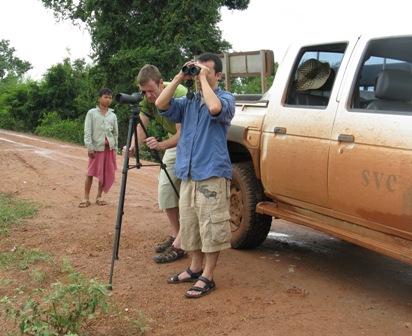 Nick Butler and local student guide setting up to search for Sarus Cranes.[/caption]
It’s also home for the endangered Eld’s deer. But water levels are high and the birds are widely dispersed, the deer are invisible in dense undergrowth. Perched on a muddy embankment peering in vain for Sarus Cranes through humidity clouded binoculars, I watch instead a motley crew of fishermen fling nets into the lake. They wade chest deep pulling in a meagre catch.
[caption id="attachment_2176" align="alignnone" width="448"]
Nick Butler and local student guide setting up to search for Sarus Cranes.[/caption]
It’s also home for the endangered Eld’s deer. But water levels are high and the birds are widely dispersed, the deer are invisible in dense undergrowth. Perched on a muddy embankment peering in vain for Sarus Cranes through humidity clouded binoculars, I watch instead a motley crew of fishermen fling nets into the lake. They wade chest deep pulling in a meagre catch.
[caption id="attachment_2176" align="alignnone" width="448"]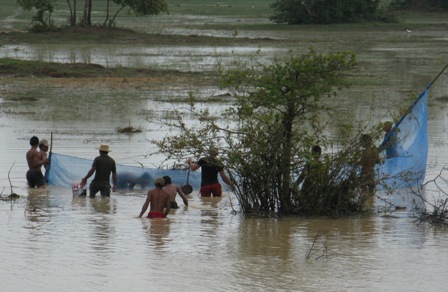 Fishermen at Ang Tropaeng Thmor.[/caption]
A few rare Milky Storks, white like ghosts, shadow the fishermen patiently pursuing escaped fish. For a minute I forget about the misery that preys on my mind. The bucolic scenery is like a heart tonic.
[caption id="attachment_2178" align="alignnone" width="288"]
Fishermen at Ang Tropaeng Thmor.[/caption]
A few rare Milky Storks, white like ghosts, shadow the fishermen patiently pursuing escaped fish. For a minute I forget about the misery that preys on my mind. The bucolic scenery is like a heart tonic.
[caption id="attachment_2178" align="alignnone" width="288"]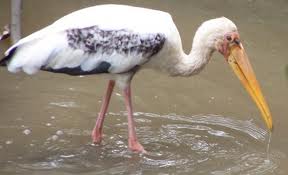 Milky Stork.[/caption]
I joke with Butler that, ‘It’s hard work on the posterior this twitching for Sore-ass Cranes business.’ We laugh, give up bird watching for the day and share a small bunch of bananas while squatting on our heels in the sticky ooze. Butler tells me that he’ll never look at this endangered crane the same way again. Late afternoon thunderclouds roll in, rain pelts down and we run for the truck.
[caption id="attachment_2177" align="alignnone" width="258"]
Milky Stork.[/caption]
I joke with Butler that, ‘It’s hard work on the posterior this twitching for Sore-ass Cranes business.’ We laugh, give up bird watching for the day and share a small bunch of bananas while squatting on our heels in the sticky ooze. Butler tells me that he’ll never look at this endangered crane the same way again. Late afternoon thunderclouds roll in, rain pelts down and we run for the truck.
[caption id="attachment_2177" align="alignnone" width="258"]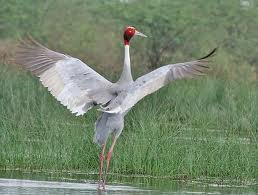 A Sarus (Sore-ass) Crane we didn't see.[/caption]
Out of the rain again, driving through flooded fields, Butler tells me how Ang Tropaeng Thmor has been saved. ‘Some of it’s due to luck. The local people need this water to help feed their families but corrupt property developers with offshore funds have their eyes on it for possible resort potential. It’s not as bad as what’s happening in the south though.’ Returning to Siem Reap we attempt an alternate route to avoid the worst of the deepening potholes. Passing through a colourful though clearly impoverished village, rickety wooden shacks surround a modest Buddhist temple, the town’s focal point. I prod Butler for more of his insider knowledge about corruption and its effect on wildlife. ’Government ministers who should know better have attained land in national parks for upmarket resorts,’ he affirms, shifting into 4 wheel drive as we navigate another flooded road, detouring into a paddy field. On the same theme he adds, ‘Illegal logging continues in the Cardamom Mountains, the proceeds go right out of the country. If there are many Indochinese tigers left in Cambodia, they live there. No one knows how many but there’s little chance of survival if their habitat is continually under threat.’
Back in Siem Reap, my mood has also shifted to low gear. Cambodia contains amazing beauty amid the widespread misery, a juxtaposition that is frustratingly enervating. I decide to stop for a pick-me-up drink at Miss Wong bar, owned by a New Zealander I met on my first night in Siem Reap. He worked as an agriculture and media advisor before deciding to open this funky little gem in The Lane not far from the Old Market. Advertised as ‘A Sip of Old Shanghai’, it’s a fun place popular with Siem Reap’s small ex-pat community. Coincidentally, one of the de la Paix’s senior managers joins me and I’m happy to catch up with him again. When I recount my day of alternating highs and lows of bird-watching in the mud, he tells me a story about falling into a canal on his way home the night before. Siem Reap’s streets are poorly lit. Incessant rain has turned roadside canals into small rivers and nocturnal journeys have become perilous as a consequence. His tuk-tuk driver misjudged a turning and drove into a canal. ‘No one was hurt but we made a lot of noise. Neighbours came out of their homes to investigate the commotion.’ He sips from his beer. ‘They all stood there and pissed themselves laughing. No help whatsoever! I was soaked to the skin and ruined a nice pair of shoes.’ I imagine the scene. He’s a very dapper fellow, and laugh into my rum sour. The incident takes on hilarious aspects. ‘I’m tired, long day at work. You’re fixed for tomorrow’s flight back to Bangkok right?’ he asks. I remember that I’m leaving Cambodia the following day. The time here has passed quickly.
[caption id="attachment_2180" align="alignnone" width="448"]
A Sarus (Sore-ass) Crane we didn't see.[/caption]
Out of the rain again, driving through flooded fields, Butler tells me how Ang Tropaeng Thmor has been saved. ‘Some of it’s due to luck. The local people need this water to help feed their families but corrupt property developers with offshore funds have their eyes on it for possible resort potential. It’s not as bad as what’s happening in the south though.’ Returning to Siem Reap we attempt an alternate route to avoid the worst of the deepening potholes. Passing through a colourful though clearly impoverished village, rickety wooden shacks surround a modest Buddhist temple, the town’s focal point. I prod Butler for more of his insider knowledge about corruption and its effect on wildlife. ’Government ministers who should know better have attained land in national parks for upmarket resorts,’ he affirms, shifting into 4 wheel drive as we navigate another flooded road, detouring into a paddy field. On the same theme he adds, ‘Illegal logging continues in the Cardamom Mountains, the proceeds go right out of the country. If there are many Indochinese tigers left in Cambodia, they live there. No one knows how many but there’s little chance of survival if their habitat is continually under threat.’
Back in Siem Reap, my mood has also shifted to low gear. Cambodia contains amazing beauty amid the widespread misery, a juxtaposition that is frustratingly enervating. I decide to stop for a pick-me-up drink at Miss Wong bar, owned by a New Zealander I met on my first night in Siem Reap. He worked as an agriculture and media advisor before deciding to open this funky little gem in The Lane not far from the Old Market. Advertised as ‘A Sip of Old Shanghai’, it’s a fun place popular with Siem Reap’s small ex-pat community. Coincidentally, one of the de la Paix’s senior managers joins me and I’m happy to catch up with him again. When I recount my day of alternating highs and lows of bird-watching in the mud, he tells me a story about falling into a canal on his way home the night before. Siem Reap’s streets are poorly lit. Incessant rain has turned roadside canals into small rivers and nocturnal journeys have become perilous as a consequence. His tuk-tuk driver misjudged a turning and drove into a canal. ‘No one was hurt but we made a lot of noise. Neighbours came out of their homes to investigate the commotion.’ He sips from his beer. ‘They all stood there and pissed themselves laughing. No help whatsoever! I was soaked to the skin and ruined a nice pair of shoes.’ I imagine the scene. He’s a very dapper fellow, and laugh into my rum sour. The incident takes on hilarious aspects. ‘I’m tired, long day at work. You’re fixed for tomorrow’s flight back to Bangkok right?’ he asks. I remember that I’m leaving Cambodia the following day. The time here has passed quickly.
[caption id="attachment_2180" align="alignnone" width="448"] Miss Wong bar interior.[/caption]
After midnight I wander home to the de la Paix refuge, reflecting again on all I have seen in one roller-coaster of an emotional week. Near the old market a teenaged girl offers a massage. ‘Hello mister. You want massage? Hah? Cheap, very nice.’ She tries to smile alluringly but looks merely desperate. Then a pock-marked young man offers drugs and a massage, ‘Hey mister. You like smoke hash? Massage? You want?’ I spurn him politely, not wanting to encourage conversation. It’s business as usual on the dark streets of Siem Reap. Later I shed a few more tears before bedtime. But I have gained hope that life in Cambodia will finally change for the better.
Tom Neal Tacker travelled courtesy of Bangkok Airways and Small Luxury Hotels.
Naked Facts:
Naked Routes:
Siem Reap is easily accessible via daily flights from Bangkok with Bangkok Airways. Tourist Visas can be purchased upon arrival. See www.bangkokairways.comfor flight details and reservations.
Naked Sleeps:
The Hotel de la Paix is located in the centre of Siem Reap in Sivatha Boulevard opposite the Central Market. See www.hoteldelapaix.com It is also a member of the Small Luxury Hotels of the World Group.
[caption id="attachment_2191" align="alignnone" width="448"]
Miss Wong bar interior.[/caption]
After midnight I wander home to the de la Paix refuge, reflecting again on all I have seen in one roller-coaster of an emotional week. Near the old market a teenaged girl offers a massage. ‘Hello mister. You want massage? Hah? Cheap, very nice.’ She tries to smile alluringly but looks merely desperate. Then a pock-marked young man offers drugs and a massage, ‘Hey mister. You like smoke hash? Massage? You want?’ I spurn him politely, not wanting to encourage conversation. It’s business as usual on the dark streets of Siem Reap. Later I shed a few more tears before bedtime. But I have gained hope that life in Cambodia will finally change for the better.
Tom Neal Tacker travelled courtesy of Bangkok Airways and Small Luxury Hotels.
Naked Facts:
Naked Routes:
Siem Reap is easily accessible via daily flights from Bangkok with Bangkok Airways. Tourist Visas can be purchased upon arrival. See www.bangkokairways.comfor flight details and reservations.
Naked Sleeps:
The Hotel de la Paix is located in the centre of Siem Reap in Sivatha Boulevard opposite the Central Market. See www.hoteldelapaix.com It is also a member of the Small Luxury Hotels of the World Group.
[caption id="attachment_2191" align="alignnone" width="448"] Hotel de la Paix courtyard dining entry.[/caption]
See www.slh.com for further information about hotel packages. Double rooms from USD$ 202.00 per night.
[caption id="attachment_2190" align="alignnone" width="448"]
Hotel de la Paix courtyard dining entry.[/caption]
See www.slh.com for further information about hotel packages. Double rooms from USD$ 202.00 per night.
[caption id="attachment_2190" align="alignnone" width="448"] Hotel de la Paix pool at night.[/caption]
Naked Volunteers:
To visit the Hotel de la Paix Sewing Training Centre, inquire at the hotel. Visits to various English language schools may be similarly arranged.
See www.samveasna.org to arrange tours of Cambodia’s remaining wildlife wonders.
See www.greengeckoproject.org for further information or inquiries about donations.
Hotel de la Paix pool at night.[/caption]
Naked Volunteers:
To visit the Hotel de la Paix Sewing Training Centre, inquire at the hotel. Visits to various English language schools may be similarly arranged.
See www.samveasna.org to arrange tours of Cambodia’s remaining wildlife wonders.
See www.greengeckoproject.org for further information or inquiries about donations.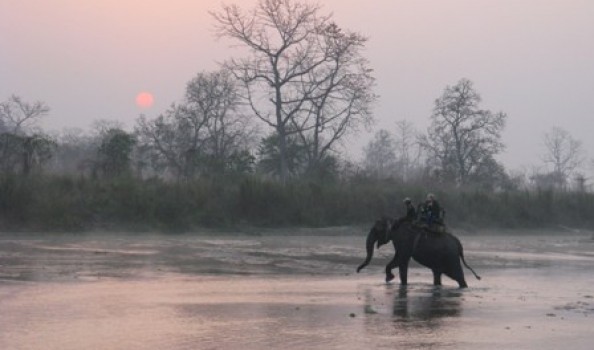 https://nakedhungrytraveller.com.au/the-heart-of-the-jungle/ The Heart of the Jungle
https://nakedhungrytraveller.com.au/the-heart-of-the-jungle/ The Heart of the JungleChitwan, Nepal’s oldest national park is the heart of the jungle, an ark in a world of diminishing wild places.
I put my arms around her head and lean forwards. Playfully, she tosses me into the air like a rag doll. At two and a half years old, Chandra Kali is a big girl. Each morning I purloin a few apples and bananas from the breakfast buffet to share with my favourite elephant at Tiger Tops. Mischievously, I pull her tail and dash around to twirl her trunk like it’s a whirly-gig. She squeals at me with joy. Her companions are all adults and I believe that my playmate misses roughhouse play with a creature closer to her size. Travellers normally come to Tiger Tops Lodge, a unique privately owned and operated safari business situated wholly within the park’s borders, to see endangered Bengal tigers but I also fall in love with an adorable elephant. In the local language, Chitwan means ‘the heart of the jungle.’ Established in 1973, the Royal Chitwan National Park also attained UNESCO World Heritage Site status in 1984. Its 932 sq. kilometres make it one of Nepal’s largest wilderness areas. Located in the country’s southern Terai region it stretches along the Indian border for more than 50 kilometres and adjoins the Parsa Wildlife Reserve, creating a complex eco-system that combines riverine forest, open grasslands and the rugged Churia and Someshwor Hills, themselves part of the greater Himalayan range. As a globally significant environment which Nepal takes great pride in protecting, the national army stations guards in camps scattered around the park. Their constant presence is a strong deterrence to would-be poachers. The education programme set up by the Tiger Tops’ management team and the Nepal’s Parks and Wildlife Service engages successfully with surrounding villages whose combined efforts have turned the corner to conservation’s favour. Finally, local people are beginning to understand that a live tiger is worth more than a dead one. The Bengal tigers of Chitwan National Park may yet survive the 21st century. It’s one of the last places on Earth where they still roam relatively safely. Tigers are the star attractions here, and like most large predators, they sleep for nearly twenty hours per day. Seeing one is an extraordinarily rare event for even the most devoted wildlife seeker. Their silent nocturnal perambulations cover many square kilometres of territory, ensuring that they remain practically invisible. A tigress with her two nearly full grown cubs prowled near the lodge one night. They left behind only fresh pug marks. I heard nothing. [caption id="attachment_2147" align="alignnone" width="260"] Bengal tiger posing in Chitwan.[/caption]
Elephants on the other hand, sleep for only a few hours and they never cease to entertain. Active for nearly twenty hours a day, they communicate via almost imperceptible movements, use low range vibrations or send messages via frequencies inaudible to humans. Conversely, they can also be quite noisy. An elephant hullabaloo is a deafening experience. Sleep is impossible when they’re in the mood to party, I discover after a long day doing the rounds of the park searching for tigers.
Seeing a tiger run across a river is a thrilling sight, so I’m told by a well-pleased gent from the English Midlands when our elephants cross paths during a morning safari. There are few guests at Tiger Tops; with only twenty rooms it’s very private and exclusive. This is a rare chance encounter with another guest. We quietly exchange notes from an elephant trunk’s distance. His watery eyes peer behind thick glasses. ‘I just come here last night. Guess I can go home now, got to see what I come for.’ ‘What did you see?’ I ask. ‘Tiger. Oo-er, you should’ve seen it, quick as lightening it were.’ But my own view was blocked by the aptly named elephant grass. I can barely see the looming Himalaya Mountains much less a striped cat running through its perpendicular patterns. Tiger camouflage is near perfect. Later, I return to Chandra Kali to assuage my disappointment. She tosses me into the air. While I roll back into the dirt, arms akimbo and legs buckled, I am convinced that she is laughing with me.
[caption id="attachment_2148" align="alignnone" width="369"]
Bengal tiger posing in Chitwan.[/caption]
Elephants on the other hand, sleep for only a few hours and they never cease to entertain. Active for nearly twenty hours a day, they communicate via almost imperceptible movements, use low range vibrations or send messages via frequencies inaudible to humans. Conversely, they can also be quite noisy. An elephant hullabaloo is a deafening experience. Sleep is impossible when they’re in the mood to party, I discover after a long day doing the rounds of the park searching for tigers.
Seeing a tiger run across a river is a thrilling sight, so I’m told by a well-pleased gent from the English Midlands when our elephants cross paths during a morning safari. There are few guests at Tiger Tops; with only twenty rooms it’s very private and exclusive. This is a rare chance encounter with another guest. We quietly exchange notes from an elephant trunk’s distance. His watery eyes peer behind thick glasses. ‘I just come here last night. Guess I can go home now, got to see what I come for.’ ‘What did you see?’ I ask. ‘Tiger. Oo-er, you should’ve seen it, quick as lightening it were.’ But my own view was blocked by the aptly named elephant grass. I can barely see the looming Himalaya Mountains much less a striped cat running through its perpendicular patterns. Tiger camouflage is near perfect. Later, I return to Chandra Kali to assuage my disappointment. She tosses me into the air. While I roll back into the dirt, arms akimbo and legs buckled, I am convinced that she is laughing with me.
[caption id="attachment_2148" align="alignnone" width="369"] A tiger the writer didn't see in Royal Chitwan National Park.[/caption]
From the first day, I feel like a latter day Mowgli. I’m on an old fashioned shikari minus the trophy hunting. My goal is to see as many live animals as possible, to try to understand them and gain a better sense of this remote region. Perched high on my Chitwan mount, Chan Chun Kali Jacks, I envisage going completely native. The climate is amenable. It’s either cool and dry in winter or wet and hot in summer. I estimate that my chances of survival are fair. Dhani, my eagle-eyed guide on these excellent adventures, interrupts my reverie by pointing out a python’s sinuous track. It looks like a log has been dragged in soft earth. ‘It’s gone to that hole over there, see?’ he indicates what looks like an excavation site. ‘Big snake,’ I say. ‘Yes, but not the biggest, I’ve seen one swallowing a whole chital.’
[caption id="attachment_2151" align="alignnone" width="259"]
A tiger the writer didn't see in Royal Chitwan National Park.[/caption]
From the first day, I feel like a latter day Mowgli. I’m on an old fashioned shikari minus the trophy hunting. My goal is to see as many live animals as possible, to try to understand them and gain a better sense of this remote region. Perched high on my Chitwan mount, Chan Chun Kali Jacks, I envisage going completely native. The climate is amenable. It’s either cool and dry in winter or wet and hot in summer. I estimate that my chances of survival are fair. Dhani, my eagle-eyed guide on these excellent adventures, interrupts my reverie by pointing out a python’s sinuous track. It looks like a log has been dragged in soft earth. ‘It’s gone to that hole over there, see?’ he indicates what looks like an excavation site. ‘Big snake,’ I say. ‘Yes, but not the biggest, I’ve seen one swallowing a whole chital.’
[caption id="attachment_2151" align="alignnone" width="259"]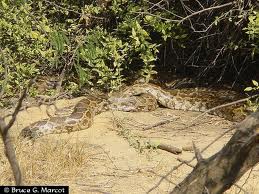 Indian Rock pythons can grow to eight metres.[/caption]
Sambar and chital deer roam these grasslands between the riverine jungles in huge herds. An adult chital deer weighs at least 80 kilos, more than me. ‘So, I could become python food Dhani?’ I ask. ‘Sure, but the tigers, the gaur, the rhinos and the marsh mugger crocodiles are more dangerous.’ He mentions four large indigenous animals casually. Maybe I’m not Mowgli material after all because now I don’t feel so safe on Chan Chun Kali Jacks. I saw a clip on YouTube of a tiger attack in an Indian national park. The traveller who captured the footage was lucky not to have been ripped apart.
Dhani taps me on my shoulder and whispers, ‘Sloth bear and her cub at 3 o’clock.’ The sloth bear is rarer than a tiger. I’m very lucky to see one with a cub.
[caption id="attachment_2150" align="alignnone" width="259"]
Indian Rock pythons can grow to eight metres.[/caption]
Sambar and chital deer roam these grasslands between the riverine jungles in huge herds. An adult chital deer weighs at least 80 kilos, more than me. ‘So, I could become python food Dhani?’ I ask. ‘Sure, but the tigers, the gaur, the rhinos and the marsh mugger crocodiles are more dangerous.’ He mentions four large indigenous animals casually. Maybe I’m not Mowgli material after all because now I don’t feel so safe on Chan Chun Kali Jacks. I saw a clip on YouTube of a tiger attack in an Indian national park. The traveller who captured the footage was lucky not to have been ripped apart.
Dhani taps me on my shoulder and whispers, ‘Sloth bear and her cub at 3 o’clock.’ The sloth bear is rarer than a tiger. I’m very lucky to see one with a cub.
[caption id="attachment_2150" align="alignnone" width="259"] Sloth bear in a more relaxed pose.[/caption]
A shaggy black coat emerges from behind a tree. Shielding her cub behind her, she raises herself up on hind legs, adopting a threatening posture. Though she’s equipped with long front claws and a reputedly short temper, she’s no match for our elephant, who responds by stamping her feet and attempting a mock charge. Our phanit, (the Nepalese word for mahout) settles Chan Chun Kali Jacks while the bear moves her adolescent cub to a safe distance. We follow them until they disappear down a creek bank. ‘You’re very lucky,’ says Dhani. ‘I’ve only seen two other bears this year.’ I beam with delight, my inner Mowgli is overjoyed.
Dhani Damang has worked at Tiger Tops since 1969. He’s the wonder guide, able to pinpoint a tiny scarlet minivet in the uppermost branch of a flowering kapok tree as if it were the size of a road-train on its way to Darwin. ‘I can’t see it Dhani,’ I say, which has been my refrain since arrival. Dhani takes my avian myopia in his stride. Tim Edwards, one of Tiger Tops’ owners tells me that Dhani is completely lost in a city so I feel slightly less inept. The Edwards family began Tiger Tops more than forty years ago as a privately owned luxury camp set in a remote wilderness, its primary purpose being to educate visitors about the wonders of wild Nepal. Past guests have included various British royal family members, Mick Jagger and most recently, Orlando Bloom. Dhani tells me that he has seen nature at its best while working at Tiger Tops for so many years. But my constant failure to sight tiny birds in faraway places is embarrassing. The sloth bear I can see, the miniscule red bird perched between maroon kapok flowers fifty metres away I can’t, but there’s hope for me yet.
[caption id="attachment_2149" align="alignnone" width="371"]
Sloth bear in a more relaxed pose.[/caption]
A shaggy black coat emerges from behind a tree. Shielding her cub behind her, she raises herself up on hind legs, adopting a threatening posture. Though she’s equipped with long front claws and a reputedly short temper, she’s no match for our elephant, who responds by stamping her feet and attempting a mock charge. Our phanit, (the Nepalese word for mahout) settles Chan Chun Kali Jacks while the bear moves her adolescent cub to a safe distance. We follow them until they disappear down a creek bank. ‘You’re very lucky,’ says Dhani. ‘I’ve only seen two other bears this year.’ I beam with delight, my inner Mowgli is overjoyed.
Dhani Damang has worked at Tiger Tops since 1969. He’s the wonder guide, able to pinpoint a tiny scarlet minivet in the uppermost branch of a flowering kapok tree as if it were the size of a road-train on its way to Darwin. ‘I can’t see it Dhani,’ I say, which has been my refrain since arrival. Dhani takes my avian myopia in his stride. Tim Edwards, one of Tiger Tops’ owners tells me that Dhani is completely lost in a city so I feel slightly less inept. The Edwards family began Tiger Tops more than forty years ago as a privately owned luxury camp set in a remote wilderness, its primary purpose being to educate visitors about the wonders of wild Nepal. Past guests have included various British royal family members, Mick Jagger and most recently, Orlando Bloom. Dhani tells me that he has seen nature at its best while working at Tiger Tops for so many years. But my constant failure to sight tiny birds in faraway places is embarrassing. The sloth bear I can see, the miniscule red bird perched between maroon kapok flowers fifty metres away I can’t, but there’s hope for me yet.
[caption id="attachment_2149" align="alignnone" width="371"]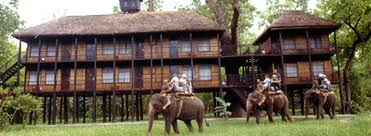 Elephant safari leaves from outside Tiger Tops' main building.[/caption]
I count forty-eight rhinos in a week. Twenty years ago I saw only three in as many days. Tim informs me proudly that Tiger Tops and the government’s conservation efforts have been effective. There hasn’t been a rhino poached here in several years. Chitwan’s ideal habitat creates perfect conditions for rhinoceros unicornis, the highly endangered Great One-Horned rhino.
[caption id="attachment_2194" align="alignnone" width="448"]
Elephant safari leaves from outside Tiger Tops' main building.[/caption]
I count forty-eight rhinos in a week. Twenty years ago I saw only three in as many days. Tim informs me proudly that Tiger Tops and the government’s conservation efforts have been effective. There hasn’t been a rhino poached here in several years. Chitwan’s ideal habitat creates perfect conditions for rhinoceros unicornis, the highly endangered Great One-Horned rhino.
[caption id="attachment_2194" align="alignnone" width="448"] Asian One-horned rhino in elephant grass.[/caption]
Fewer than 3,000 are left in the wild, most of them here and in India’s Assam Province. I see pregnant females, numerous adolescents and on one fine morning, a newly born calf with its mother strolling through a meadow.
[caption id="attachment_1628" align="alignnone" width="448"]
Asian One-horned rhino in elephant grass.[/caption]
Fewer than 3,000 are left in the wild, most of them here and in India’s Assam Province. I see pregnant females, numerous adolescents and on one fine morning, a newly born calf with its mother strolling through a meadow.
[caption id="attachment_1628" align="alignnone" width="448"]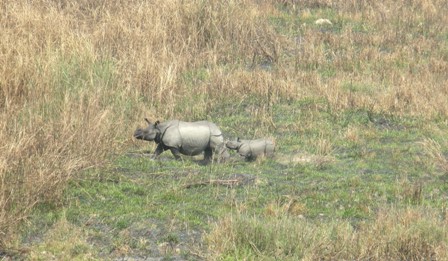 Asian rhino mother with new born calf.[/caption]
Another success story in Chitwan, is that of the gharial. The second largest member of the crocodilian species, males regularly attain a length of six metres and weigh over a tonne, females are slightly smaller. These fish eating crocodiles were once hunted to the brink of extinction. At Chitwan eggs are collected from nests, incubated at a hatchery and released when the young are deemed large enough to survive. Their greatest threat is loss of habitat and scarce fish stocks due to low river levels caused by, experts say, global warming. Industrial pollution has wiped them out in less remote areas. For now, the Rapti River which flows through Chitwan is a safe sanctuary. One afternoon I paddle in a wooden canoe downriver to a popular sunning spot. A dozen adults lie basking on a sand bank mid-stream. The harem’s dominant male, stretched out on the hot sand merely a canoe’s length away is at least five metres long. He splashes me thoroughly with his spatulate tail while retreating hastily into deep water.
[caption id="attachment_1629" align="alignnone" width="448"]
Asian rhino mother with new born calf.[/caption]
Another success story in Chitwan, is that of the gharial. The second largest member of the crocodilian species, males regularly attain a length of six metres and weigh over a tonne, females are slightly smaller. These fish eating crocodiles were once hunted to the brink of extinction. At Chitwan eggs are collected from nests, incubated at a hatchery and released when the young are deemed large enough to survive. Their greatest threat is loss of habitat and scarce fish stocks due to low river levels caused by, experts say, global warming. Industrial pollution has wiped them out in less remote areas. For now, the Rapti River which flows through Chitwan is a safe sanctuary. One afternoon I paddle in a wooden canoe downriver to a popular sunning spot. A dozen adults lie basking on a sand bank mid-stream. The harem’s dominant male, stretched out on the hot sand merely a canoe’s length away is at least five metres long. He splashes me thoroughly with his spatulate tail while retreating hastily into deep water.
[caption id="attachment_1629" align="alignnone" width="448"] Big gharial on Rapti River sandbank.[/caption]
The days at Chitwan acquire a special rhythm. I’m seduced by their mesmerising quality. Waking before dawn, I wash quickly in dim light. Dressed in loose fitting khaki and wearing rubber thongs, I walk to the dining hall. Dhani and I share a cup of chai while we discuss our approach to the day. Will I see a tiger? He desperately wants me to see a tiger. My lack of expertise with the birds is bringing out his latent pity. If a half blind Liverpudlian can spot a tiger in only one day, why can’t I in a week? We walk the short distance to the elephant camp, say hello to Chan Chun Kali Jacks and her phanit, Shira. On to her back I climb, slipping my bare feet behind her ears. We trundle into the cool mist, her low rumbling signalling to other elephants that all is well in the heart of the jungle. Sunlight glimmers through sal tree boughs. Steamy vapours lift lazily off the river, a rhino lumbers into view. He’s a big bull. ‘Crazy rhino that one,’ says Dhani, familiar with this rhino’s unpredictable habits. He tells me that occasionally rhinos charge so we keep our distance. ‘If an elephant is attacked by a rhino, it’s difficult to get them close again. They never like rhino after that.’ Avoiding a head-on collision with the rhino disguised as a Mack truck, we head into the forest. A gaur cow was killed by a tiger the night before and there’s a good chance the big cat will linger near the carcass. The gaur is the world’s largest wild cattle so this is no small display of tiger power.
[caption id="attachment_2152" align="alignnone" width="284"]
Big gharial on Rapti River sandbank.[/caption]
The days at Chitwan acquire a special rhythm. I’m seduced by their mesmerising quality. Waking before dawn, I wash quickly in dim light. Dressed in loose fitting khaki and wearing rubber thongs, I walk to the dining hall. Dhani and I share a cup of chai while we discuss our approach to the day. Will I see a tiger? He desperately wants me to see a tiger. My lack of expertise with the birds is bringing out his latent pity. If a half blind Liverpudlian can spot a tiger in only one day, why can’t I in a week? We walk the short distance to the elephant camp, say hello to Chan Chun Kali Jacks and her phanit, Shira. On to her back I climb, slipping my bare feet behind her ears. We trundle into the cool mist, her low rumbling signalling to other elephants that all is well in the heart of the jungle. Sunlight glimmers through sal tree boughs. Steamy vapours lift lazily off the river, a rhino lumbers into view. He’s a big bull. ‘Crazy rhino that one,’ says Dhani, familiar with this rhino’s unpredictable habits. He tells me that occasionally rhinos charge so we keep our distance. ‘If an elephant is attacked by a rhino, it’s difficult to get them close again. They never like rhino after that.’ Avoiding a head-on collision with the rhino disguised as a Mack truck, we head into the forest. A gaur cow was killed by a tiger the night before and there’s a good chance the big cat will linger near the carcass. The gaur is the world’s largest wild cattle so this is no small display of tiger power.
[caption id="attachment_2152" align="alignnone" width="284"]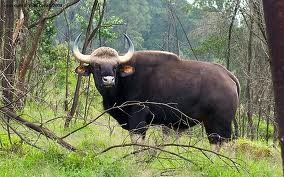 Gaur, world's largest bovine.[/caption]
A cloud of flies signal that the carcass is nearby. The stench is strong too. All is quiet. Is the tiger guarding its leftovers? There are hooves, bits of backbone and a haunch in the bloodied grass, but there’s no tiger here. Dhani tells me that a tigress probably did it. ‘If it was taken by a male, he would stay with it. The females hide undercover instead, leaving the kill to male tigers, hyenas or jackals. The females are more secretive.’ I learn another fact while I wonder how much a tiger can eat. ‘Forty kilos in one sitting,’ Dhani tells me. That’s a lot of gaur grub.
An hour later back in the sal forest, we see claw marks on a tree. The deep scratches are four metres up its trunk. ‘Big male,’ Dhani confirms. ‘They patrol their territory all the time using trees like this to let other tigers know where they are and not to come too close.’ We climb down from Chan Chun Kali Jacks’ back to examine the marks more closely. ‘Here, smell this spot here,’ he instructs while pointing to a dark stain on the bark. I sniff reluctantly. A whiff of ammonia, spice notes and a slight muskiness pervade. ‘It’s where this tiger also scent marks.’ An aroma I won’t forget quickly. ‘How can you tell it’s a male?’ I ask. ‘It’s further up the tree, males urinate higher.’ ‘So, this contest occurs outside pubs too?’ But when I translate my weak joke Dhani doesn’t understand the Aussie reference. You can’t take the man out of the jungle…
Back at the lodge, I take stock. The rhino count is increasing and my tiger encounters are becoming more physical. I breakfast like a starving Mowgli, grab an extra apple, a couple of bananas and head down to the ellie-stables for playtime with Chandra Kali. After joining her at the river for a bath, I return to the lodge and write notes on the verandah while the elephants have a siesta. Lunch is brief. We saddle Chan Chun Kali Jacks for the day’s last safari. There’s always more bird watching to be done. 523 species are known to inhabit Chitwan. I think I’ve seen at least 50 but can’t be sure. I’m beginning to confuse egrets with storks. Dhani successively points out a rufous necked thrush, a sparrow hawk and a red-banded bulbul, all of which I glimpse momentarily. A female muntjac, a.k.a. barking deer bounces into view for an instant, her dainty feet barely touching the ground.
[caption id="attachment_2153" align="alignnone" width="254"]
Gaur, world's largest bovine.[/caption]
A cloud of flies signal that the carcass is nearby. The stench is strong too. All is quiet. Is the tiger guarding its leftovers? There are hooves, bits of backbone and a haunch in the bloodied grass, but there’s no tiger here. Dhani tells me that a tigress probably did it. ‘If it was taken by a male, he would stay with it. The females hide undercover instead, leaving the kill to male tigers, hyenas or jackals. The females are more secretive.’ I learn another fact while I wonder how much a tiger can eat. ‘Forty kilos in one sitting,’ Dhani tells me. That’s a lot of gaur grub.
An hour later back in the sal forest, we see claw marks on a tree. The deep scratches are four metres up its trunk. ‘Big male,’ Dhani confirms. ‘They patrol their territory all the time using trees like this to let other tigers know where they are and not to come too close.’ We climb down from Chan Chun Kali Jacks’ back to examine the marks more closely. ‘Here, smell this spot here,’ he instructs while pointing to a dark stain on the bark. I sniff reluctantly. A whiff of ammonia, spice notes and a slight muskiness pervade. ‘It’s where this tiger also scent marks.’ An aroma I won’t forget quickly. ‘How can you tell it’s a male?’ I ask. ‘It’s further up the tree, males urinate higher.’ ‘So, this contest occurs outside pubs too?’ But when I translate my weak joke Dhani doesn’t understand the Aussie reference. You can’t take the man out of the jungle…
Back at the lodge, I take stock. The rhino count is increasing and my tiger encounters are becoming more physical. I breakfast like a starving Mowgli, grab an extra apple, a couple of bananas and head down to the ellie-stables for playtime with Chandra Kali. After joining her at the river for a bath, I return to the lodge and write notes on the verandah while the elephants have a siesta. Lunch is brief. We saddle Chan Chun Kali Jacks for the day’s last safari. There’s always more bird watching to be done. 523 species are known to inhabit Chitwan. I think I’ve seen at least 50 but can’t be sure. I’m beginning to confuse egrets with storks. Dhani successively points out a rufous necked thrush, a sparrow hawk and a red-banded bulbul, all of which I glimpse momentarily. A female muntjac, a.k.a. barking deer bounces into view for an instant, her dainty feet barely touching the ground.
[caption id="attachment_2153" align="alignnone" width="254"] Muntjac deer pauses for breath.[/caption]
Langur monkeys leap effortlessly from one sisal tree to another. A lone hog deer speeds into a thicket, head down with long back legs pumping furiously. A family of wild boar saunter by. ‘More tiger food,’ Dhani assures me. ‘Ham sandwich,’ he adds. We’ve become easy companions. He tells bad jokes as well as I. Dusk envelops the jungle. A peacock sits on a low-hanging branch, singing a mournful tune, the first bird I spot without Dhani’s help. Its spread of feathers wouldn’t look out of place at a disco, unsurprising that I don’t miss it. Perhaps I’m getting the hang of this twitcher’s game after all, but no tigers. We return to the lodge for dinner. Meals are communal, allowing an opportunity to share stories and compare notes. Tonight’s convivial table chat is all about tiger sightings. ‘Did you see the tiger today, the one near that gaur carcass?’ someone asks me. ‘No,’ I respond. ‘But I did see two crested serpent eagles and one honey buzzard.’ I look down the table and catch a look of disappointment on Dhani’s face. I grin and he flashes me a relieved smile. Returning to my room later that night, fully content after another day in the heart of the jungle, I drift off to sleep and dream about tigers burning brightly on aspiring wings, (with apologies to William Blake.)
Tom Neal Tacker travelled courtesy of Thai Airways and Tiger Tops.
Naked Facts:
Naked Routes:
Muntjac deer pauses for breath.[/caption]
Langur monkeys leap effortlessly from one sisal tree to another. A lone hog deer speeds into a thicket, head down with long back legs pumping furiously. A family of wild boar saunter by. ‘More tiger food,’ Dhani assures me. ‘Ham sandwich,’ he adds. We’ve become easy companions. He tells bad jokes as well as I. Dusk envelops the jungle. A peacock sits on a low-hanging branch, singing a mournful tune, the first bird I spot without Dhani’s help. Its spread of feathers wouldn’t look out of place at a disco, unsurprising that I don’t miss it. Perhaps I’m getting the hang of this twitcher’s game after all, but no tigers. We return to the lodge for dinner. Meals are communal, allowing an opportunity to share stories and compare notes. Tonight’s convivial table chat is all about tiger sightings. ‘Did you see the tiger today, the one near that gaur carcass?’ someone asks me. ‘No,’ I respond. ‘But I did see two crested serpent eagles and one honey buzzard.’ I look down the table and catch a look of disappointment on Dhani’s face. I grin and he flashes me a relieved smile. Returning to my room later that night, fully content after another day in the heart of the jungle, I drift off to sleep and dream about tigers burning brightly on aspiring wings, (with apologies to William Blake.)
Tom Neal Tacker travelled courtesy of Thai Airways and Tiger Tops.
Naked Facts:
Naked Routes:
Thai Airways has a convenient one-stop connection from North American, European and Australian capital cities to Kathmandu via its hub in Bangkok. See www.thaiairways.com for reservations and flight schedules. Transfers to Chitwan National Park’s airstrip at Meghauli with Yeti Airlines and into the park via a river crossing and a short 4-WD journey can be booked through Tiger Tops. Naked Sleeps: For Tiger Tops’ information and reservations:
All meals are included in the tariff and there is a well-stocked bar where guests meet to discuss the day’s events. Package deals including hotel accommodation in Kathmandu, internal flights and transfers, park fees, elephant safaris and activities can be seen on the website. The park and lodge are both closed during the monsoon from July to October. Travellers will inevitably stay some nights in Kathmandu. Highly recommended is the Dwarika’s Hotel. [caption id="attachment_2156" align="alignnone" width="259"]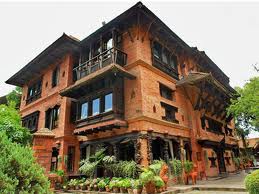 Dwarikas Hotel exterior.[/caption]
It houses a treasure trove of Nepalese art, is run like a Swiss watch and has the added benefit of its own generator.
[caption id="attachment_2157" align="alignnone" width="267"]
Dwarikas Hotel exterior.[/caption]
It houses a treasure trove of Nepalese art, is run like a Swiss watch and has the added benefit of its own generator.
[caption id="attachment_2157" align="alignnone" width="267"] Dwarikas hotel swimming pool.[/caption]
Electricity supplies in Kathmandu can be very erratic particularly when drought affects hydro-electricity power supplies.
Tel: (997-1) 4479488/ 4470770
Dwarikas hotel swimming pool.[/caption]
Electricity supplies in Kathmandu can be very erratic particularly when drought affects hydro-electricity power supplies.
Tel: (997-1) 4479488/ 4470770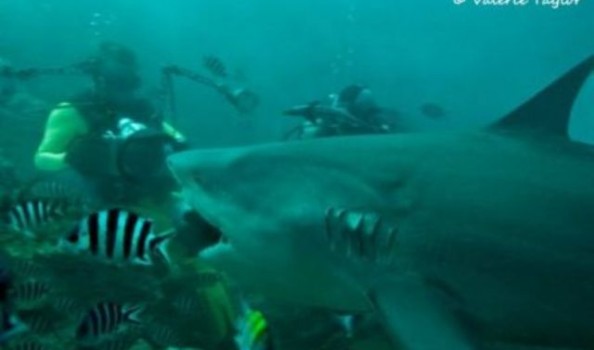 https://nakedhungrytraveller.com.au/swimming-with-sharks/ Swimming with Sharks in Fiji
https://nakedhungrytraveller.com.au/swimming-with-sharks/ Swimming with Sharks in FijiFiji offers much to the intrepid traveller beyond the resort cliches.
Vanua Levu, Fiji’s second island, a.k.a. the ‘Friendly North’. Across Bligh Water at the western end of the Koro Sea my one hour flight first covers Viti Levu’s mountainous interior. Innumerable atolls and submerged reefs separate the two islands. I see a Fiji beyond private white sand beaches and gated resort communities. Away from the tourist centres of the Yasawa and Mamanuca Islands and the purpose-built Denarau Island, another world exists. It’s very far from the packaged holiday trip most visitors to Fiji experience. The small plane descends over SavuSavu Bay, crosses a peninsula and the township of SavuSavu. A lone cow grazes on the fringes of the short runway. Trade winds, undulating palm fronds, scarlet hibiscus and white frangipani, purple prose material abounds. The Pacific Sun Airways twin-prop taxis to the boxy terminal building, its plain concrete walls are mildewed by the constant tropical humidity. A small hand-painted sign states simply, ‘SavuSavu’. I am one of two passengers. [caption id="attachment_2095" align="alignnone" width="362"]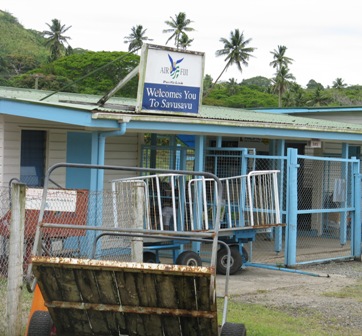 SavuSavu airport terminal buidling.[/caption]
The two pilots help unload the cargo. I pick up my bag from the tarmac and wave good-bye. It’s a classic South Pacific scene: idle, indolent and idyllic.
[caption id="attachment_2087" align="alignnone" width="448"]
SavuSavu airport terminal buidling.[/caption]
The two pilots help unload the cargo. I pick up my bag from the tarmac and wave good-bye. It’s a classic South Pacific scene: idle, indolent and idyllic.
[caption id="attachment_2087" align="alignnone" width="448"]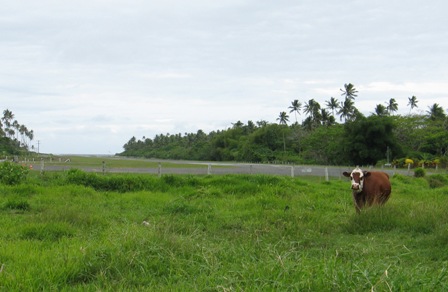 SavuSavu airport landing strip with cow.[/caption]
‘Bula Vinaka!’ I’m greeted warmly. One of Jean-Michel Cousteau Resort managers collects me outside the terminal. ‘Bula’, hello and welcome wrapped into one very gregarious word, is Fiji’s calling card. The Cousteau resort is a short drive from the airport.
[caption id="attachment_2088" align="alignnone" width="448"]
SavuSavu airport landing strip with cow.[/caption]
‘Bula Vinaka!’ I’m greeted warmly. One of Jean-Michel Cousteau Resort managers collects me outside the terminal. ‘Bula’, hello and welcome wrapped into one very gregarious word, is Fiji’s calling card. The Cousteau resort is a short drive from the airport.
[caption id="attachment_2088" align="alignnone" width="448"]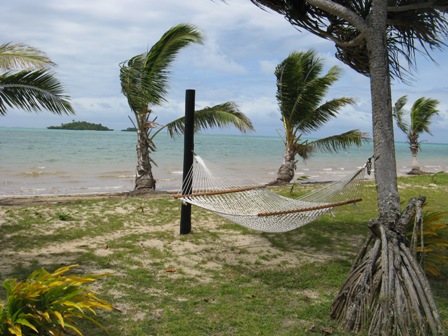 JM Cousteau resort hammock.[/caption]
The name Cousteau and scuba are synonymous and this resort is unlike any other in Fiji. A full-time marine biologist works here and I’m set to explore surrounding waters with him. We decide to dive the ‘Golden Nuggets’, three bommies approximately one kilometre offshore adorned in golden soft coral unlike any I’ve seen. Blazing colours decorate these outcrops festooned with coral. Unusually, multi-hued tropical fish pale in comparison. It’s a dazzling effect. For a moment I wonder idiotically if I should have worn sunglasses. Diving with a marine biologist is a privilege. I point at something I don’t recognise and he writes its name in English and Latin on a water resistant sketch pad. Like being in a singularly informative private classroom, it’s the two of us, schools of fish and I’m in fish school. Top marks for keeping my mouth shut. Point and learn, an attractive methodology.
[caption id="attachment_2116" align="alignnone" width="259"]
JM Cousteau resort hammock.[/caption]
The name Cousteau and scuba are synonymous and this resort is unlike any other in Fiji. A full-time marine biologist works here and I’m set to explore surrounding waters with him. We decide to dive the ‘Golden Nuggets’, three bommies approximately one kilometre offshore adorned in golden soft coral unlike any I’ve seen. Blazing colours decorate these outcrops festooned with coral. Unusually, multi-hued tropical fish pale in comparison. It’s a dazzling effect. For a moment I wonder idiotically if I should have worn sunglasses. Diving with a marine biologist is a privilege. I point at something I don’t recognise and he writes its name in English and Latin on a water resistant sketch pad. Like being in a singularly informative private classroom, it’s the two of us, schools of fish and I’m in fish school. Top marks for keeping my mouth shut. Point and learn, an attractive methodology.
[caption id="attachment_2116" align="alignnone" width="259"]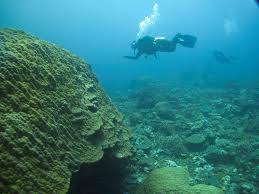 JM Cousteau resort dive on nearby reef.[/caption]
Cousteau runs a tight ship. I know that kids are scampering about the resort grounds but I rarely see them. Each child is appointed a minder upon arrival. With only 26 bures and separate areas for adults and children, it’s where parents can enjoy themselves knowing that the tots are well cared for. After the ‘Golden Nuggets’ dive I wander along the resort’s beach for a late afternoon walk. Three children with three nannies are sitting under a coconut palm in the sand. I pause to say ‘Bula’. The women smile but the kids are preoccupied. As I pass I hear one of the nannies say, ‘Ok, it’s your turn to bury him now.’ Out of context, it’s a funny thought.
[caption id="attachment_2114" align="alignnone" width="448"]
JM Cousteau resort dive on nearby reef.[/caption]
Cousteau runs a tight ship. I know that kids are scampering about the resort grounds but I rarely see them. Each child is appointed a minder upon arrival. With only 26 bures and separate areas for adults and children, it’s where parents can enjoy themselves knowing that the tots are well cared for. After the ‘Golden Nuggets’ dive I wander along the resort’s beach for a late afternoon walk. Three children with three nannies are sitting under a coconut palm in the sand. I pause to say ‘Bula’. The women smile but the kids are preoccupied. As I pass I hear one of the nannies say, ‘Ok, it’s your turn to bury him now.’ Out of context, it’s a funny thought.
[caption id="attachment_2114" align="alignnone" width="448"]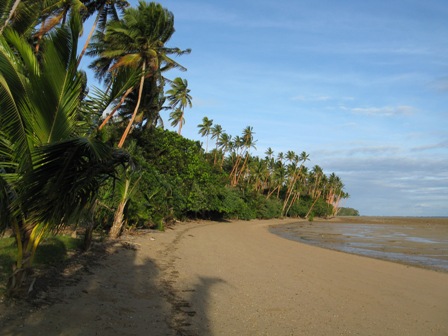 JM Cousteau resort beach at low tide just before sunset.[/caption]
A dining area is set aside for the little ones. Parents may choose to join them or not. I dine in the adults-only poolside restaurant on three courses of tasty French influenced fare. Part of the service here is a cocktail and hors d’oeuvres platter brought to my bure before dinner. I try a mango daiquiri and sample the chilled poached prawns with lemon mayonnaise, deciding then that I may have to feign injury to avoid leaving the next day. Another treat is a foot and leg massage which is offered to all guests as part of the welcome-to-paradise introduction. My foot massage preceded a full body massage in an open bure located right on the sand. I could see and hear the water lapping at the base of the massage table. No need for ambient spa muzak here. My grandmotherly masseuse whispers in my ear after treating my scalp to her heavenly touch, ‘Mr Tom. Don’t get up. Take all the time you want. A glass of cool spring water is next to your clothes if you are thirsty.’ I forgot I was naked under the cotton sheet. Actually I forgot everything and fell asleep.
A pearl farm operates down the road from the resort. Pearl farm visits normally excite me about as much as a visit to the dentist but this was different. The J. Hunter Pearl Farm pearls are cultivated literally outside the farm office and shop. SavuSavu Bay is unique. The name means ‘hot springs’.
[caption id="attachment_2119" align="alignnone" width="337"]
JM Cousteau resort beach at low tide just before sunset.[/caption]
A dining area is set aside for the little ones. Parents may choose to join them or not. I dine in the adults-only poolside restaurant on three courses of tasty French influenced fare. Part of the service here is a cocktail and hors d’oeuvres platter brought to my bure before dinner. I try a mango daiquiri and sample the chilled poached prawns with lemon mayonnaise, deciding then that I may have to feign injury to avoid leaving the next day. Another treat is a foot and leg massage which is offered to all guests as part of the welcome-to-paradise introduction. My foot massage preceded a full body massage in an open bure located right on the sand. I could see and hear the water lapping at the base of the massage table. No need for ambient spa muzak here. My grandmotherly masseuse whispers in my ear after treating my scalp to her heavenly touch, ‘Mr Tom. Don’t get up. Take all the time you want. A glass of cool spring water is next to your clothes if you are thirsty.’ I forgot I was naked under the cotton sheet. Actually I forgot everything and fell asleep.
A pearl farm operates down the road from the resort. Pearl farm visits normally excite me about as much as a visit to the dentist but this was different. The J. Hunter Pearl Farm pearls are cultivated literally outside the farm office and shop. SavuSavu Bay is unique. The name means ‘hot springs’.
[caption id="attachment_2119" align="alignnone" width="337"]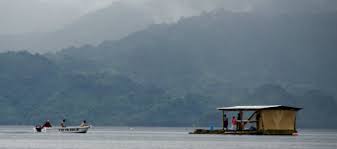 J Hunter Pearl Farm on Savu Savu Bay.[/caption]
Deep water flushed with nutrients and minerals brings out a unique coppery bronze colour. A single strand sells for thousands of dollars.
[caption id="attachment_2118" align="alignnone" width="317"]
J Hunter Pearl Farm on Savu Savu Bay.[/caption]
Deep water flushed with nutrients and minerals brings out a unique coppery bronze colour. A single strand sells for thousands of dollars.
[caption id="attachment_2118" align="alignnone" width="317"] Unique bronze pearl from J Hunter Pearl Farm.[/caption]
On calm days, guided snorkelling tours of the pearl oysters hanging on ropes in the depths make an interesting diversion, like underwater retail therapy.
[caption id="attachment_2120" align="alignnone" width="318"]
Unique bronze pearl from J Hunter Pearl Farm.[/caption]
On calm days, guided snorkelling tours of the pearl oysters hanging on ropes in the depths make an interesting diversion, like underwater retail therapy.
[caption id="attachment_2120" align="alignnone" width="318"]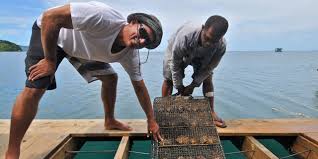 J Hunter Pearl Farm workers.[/caption]
From real pearls to pearly teeth, it’s an exhilarating experience to scuba dive with large sharks. On previous shark dives in South Africa I was alone in a cage while Great Whites eyeballed me. Though these were extraordinarily exciting dives, I felt like a sliced lunch at the seal diner, cold and unappetising. In contrast this warm water dive in the Beqa Island channel off Viti Levu’s Pacific Harbour is sheer adrenalin rush. No cage and lots of open water all around. Here, I’m with five other divers, an equal number of guides and countless sharks. Whitetip, Blacktip and Grey Reef dominate while Tawny Nurse, Silvertips and Sicklefin Lemon sharks all compete for attention in the food chain. A guide is feeding a frenzy of Whitetips and Greys from a small bucket of fishy scraps. From only a few metres away, the sharks dart like silver bullets missing one another by mere centimetres. Their sleek bodies are streamlined, capable of impressive bursts of speed.
Seven Bull sharks circle overhead, like grey submarines, bulky and watchful. Are they hungry or aggressive? Unpleasant scenarios eerily pass through my mind. During the pre-dive briefing, I signed a personal liability insurance form. My life is essentially my own responsibility. If I do something stupid I will bear the cost. The dive master warns me not to point at anything while I’m on the bottom at the feeding station. No sense in offering the sharks something else to bite I assume. These reputed human-chomping sharks swim above me in a tight formation. I lay low. This dive isn’t an easy cruise through coral gardens, rather it's a test of nerves and mine are on edge.
Like a beached walrus, I lumber as I avoid damaging fragile soft coral with a misplaced fin. Accidentally sideswiping the poisonous barbs of the lionfish hiding in my shadow wouldn’t be wise either. Something nips my left wrist. Annoyed and distracted I look down. A blue clown fish the size of my palm is defending its territory. It swims in front of my mask. His anemone home has been invaded. We have a momentary face-off. Nemo is biting me while I’m surrounded by man-eating Bull sharks? The irony is hysterically funny but in the deep, no one can hear you laugh.
[caption id="attachment_2096" align="alignnone" width="448"]
J Hunter Pearl Farm workers.[/caption]
From real pearls to pearly teeth, it’s an exhilarating experience to scuba dive with large sharks. On previous shark dives in South Africa I was alone in a cage while Great Whites eyeballed me. Though these were extraordinarily exciting dives, I felt like a sliced lunch at the seal diner, cold and unappetising. In contrast this warm water dive in the Beqa Island channel off Viti Levu’s Pacific Harbour is sheer adrenalin rush. No cage and lots of open water all around. Here, I’m with five other divers, an equal number of guides and countless sharks. Whitetip, Blacktip and Grey Reef dominate while Tawny Nurse, Silvertips and Sicklefin Lemon sharks all compete for attention in the food chain. A guide is feeding a frenzy of Whitetips and Greys from a small bucket of fishy scraps. From only a few metres away, the sharks dart like silver bullets missing one another by mere centimetres. Their sleek bodies are streamlined, capable of impressive bursts of speed.
Seven Bull sharks circle overhead, like grey submarines, bulky and watchful. Are they hungry or aggressive? Unpleasant scenarios eerily pass through my mind. During the pre-dive briefing, I signed a personal liability insurance form. My life is essentially my own responsibility. If I do something stupid I will bear the cost. The dive master warns me not to point at anything while I’m on the bottom at the feeding station. No sense in offering the sharks something else to bite I assume. These reputed human-chomping sharks swim above me in a tight formation. I lay low. This dive isn’t an easy cruise through coral gardens, rather it's a test of nerves and mine are on edge.
Like a beached walrus, I lumber as I avoid damaging fragile soft coral with a misplaced fin. Accidentally sideswiping the poisonous barbs of the lionfish hiding in my shadow wouldn’t be wise either. Something nips my left wrist. Annoyed and distracted I look down. A blue clown fish the size of my palm is defending its territory. It swims in front of my mask. His anemone home has been invaded. We have a momentary face-off. Nemo is biting me while I’m surrounded by man-eating Bull sharks? The irony is hysterically funny but in the deep, no one can hear you laugh.
[caption id="attachment_2096" align="alignnone" width="448"]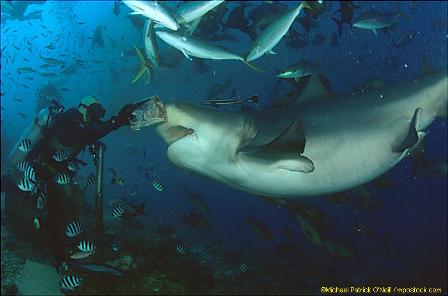 Grandma Bull Shark pays a visit.[/caption]
I turn slightly to check with my guide. He signals, okay? I respond affirmatively. Why wouldn’t I be okay? This is a once in a lifetime experience. To be this close to a top predator in the wild is a wildlife lover’s objective, to observe without harm, blending into the background. I want to be invisible, content to watch sharks and whatever else comes into view. Healthy seas support large populations of sharks. I like to see sharks. When they’re not around, I worry. Overfishing has drastically reduced shark populations: superfluously supplying flavourless fins to expensive soups or posing as flake in fish and chips takeaways, sharks are suffering at the expense of our misinformed greedy appetites. Their slaughter has been augmented by drifting shark nets and our vengeful retaliation to ridiculously over-hyped shark attack stories.
In the Beqa Channel however, sharks appear to thrive. They’re in good company. As if on cue, a huge Giant Grouper appears like a levitating boulder. Suddenly there, its bulk forces smaller sharks aside to get at the bait fish. A Java Moray eel pokes its sinuous head out of a hidey-hole, mouth agape, protuberant teeth on full view. If I lean left I can stroke its chin, but don’t. A school of Giant Trevally do a fly-by, checking out the scene. They glint pewter shades in the deep blue light. We’re settled 35 metres deep, holding on to a rock shelf and surrounded by so much life that the ocean itself seems to pulsate. I don’t know where to look next. The thirty minutes of down time have flown by faster than the sharks took devouring their small lunch. Now, we must ascend. The eel looks lonely as I check for bull sharks, Nemo and my fellow divers. We have two safety stops to make and my air supply is low. The bull sharks are thankfully disinterested in the group's collective ascent and remain at the bottom.
[caption id="attachment_2089" align="alignnone" width="448"]
Grandma Bull Shark pays a visit.[/caption]
I turn slightly to check with my guide. He signals, okay? I respond affirmatively. Why wouldn’t I be okay? This is a once in a lifetime experience. To be this close to a top predator in the wild is a wildlife lover’s objective, to observe without harm, blending into the background. I want to be invisible, content to watch sharks and whatever else comes into view. Healthy seas support large populations of sharks. I like to see sharks. When they’re not around, I worry. Overfishing has drastically reduced shark populations: superfluously supplying flavourless fins to expensive soups or posing as flake in fish and chips takeaways, sharks are suffering at the expense of our misinformed greedy appetites. Their slaughter has been augmented by drifting shark nets and our vengeful retaliation to ridiculously over-hyped shark attack stories.
In the Beqa Channel however, sharks appear to thrive. They’re in good company. As if on cue, a huge Giant Grouper appears like a levitating boulder. Suddenly there, its bulk forces smaller sharks aside to get at the bait fish. A Java Moray eel pokes its sinuous head out of a hidey-hole, mouth agape, protuberant teeth on full view. If I lean left I can stroke its chin, but don’t. A school of Giant Trevally do a fly-by, checking out the scene. They glint pewter shades in the deep blue light. We’re settled 35 metres deep, holding on to a rock shelf and surrounded by so much life that the ocean itself seems to pulsate. I don’t know where to look next. The thirty minutes of down time have flown by faster than the sharks took devouring their small lunch. Now, we must ascend. The eel looks lonely as I check for bull sharks, Nemo and my fellow divers. We have two safety stops to make and my air supply is low. The bull sharks are thankfully disinterested in the group's collective ascent and remain at the bottom.
[caption id="attachment_2089" align="alignnone" width="448"] Beqa Island channel.[/caption]
That was the second of two shark dives in the Beqa Channel and it was as exciting as the first. The waters between Fiji’s big island and this small island off its southern coast are some of the richest pelagic fish viewing in the country, if not the world. No two dives are alike as there is no certainty about which species will appear. Hammerhead sharks one day, Tiger sharks the next. I’m told by my guide that Giant Groupers are very rare, we were fortunate. Evidently Bull sharks make frequent appearances but not daily. Seeing seven together on one dive is also rare.
Out of the deep and into the foam, I venture on an all day white-water rafting adventure down the Upper Navua River on Viti Levu, 26 kilometres of rapids, canyons, rainforest and swimming. The landscape I flew over en route to Vanua Levu is all verdant and lush. From ground level, it’s mostly dense native forest though plantations of imported mahogany have reduced some areas to bleak monoculture, resulting in loss of bio-diversity. Mahogany timber plantations are wreaking havoc on indigenous vegetation due to the Caribbean import’s impact on soil chemistry. It leaches excessive acidity into the dirt. The overall impression however is tropically Eden-esque, but there are problems in this eco-Paradise. Get rid of the mahogany and native trees evidently return but the valuable timber is a cash crop in this remote backwoods area, no tourist resorts here and poverty-struck local people rely on logging for work.
[caption id="attachment_2090" align="alignnone" width="339"]
Beqa Island channel.[/caption]
That was the second of two shark dives in the Beqa Channel and it was as exciting as the first. The waters between Fiji’s big island and this small island off its southern coast are some of the richest pelagic fish viewing in the country, if not the world. No two dives are alike as there is no certainty about which species will appear. Hammerhead sharks one day, Tiger sharks the next. I’m told by my guide that Giant Groupers are very rare, we were fortunate. Evidently Bull sharks make frequent appearances but not daily. Seeing seven together on one dive is also rare.
Out of the deep and into the foam, I venture on an all day white-water rafting adventure down the Upper Navua River on Viti Levu, 26 kilometres of rapids, canyons, rainforest and swimming. The landscape I flew over en route to Vanua Levu is all verdant and lush. From ground level, it’s mostly dense native forest though plantations of imported mahogany have reduced some areas to bleak monoculture, resulting in loss of bio-diversity. Mahogany timber plantations are wreaking havoc on indigenous vegetation due to the Caribbean import’s impact on soil chemistry. It leaches excessive acidity into the dirt. The overall impression however is tropically Eden-esque, but there are problems in this eco-Paradise. Get rid of the mahogany and native trees evidently return but the valuable timber is a cash crop in this remote backwoods area, no tourist resorts here and poverty-struck local people rely on logging for work.
[caption id="attachment_2090" align="alignnone" width="339"]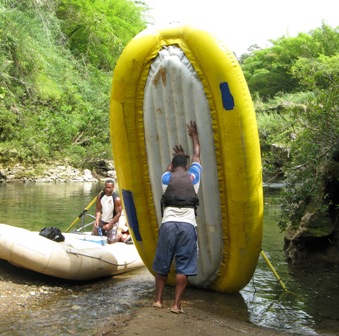 Moses makes ready our raft.[/caption]
The trip down the Upper Navua River is a wonder, a wet wonder but lots of fun despite the occasional dousing. The guides are all professional jokesters as well as expert raft handlers. I'm with Moses, the white water expert and guide. Any jokes about Moses floating down a river are quickly dismissed. 'When I say, you paddle left, you paddle left. When I say you paddle right, you paddle right. I haven't lost anyone yet so listen to me and we'll all be fine,' he commands. Though blessed with a good sense of humour, rafting down rapids can quickly turn very serious and Moses insists we take his instructions to heart and head.
We’re provided with helmets, life-jackets, paddles, lunch and laughs. Gliding down a pristine river surrounded by waterfalls and steep volcanic walls is an experience that most tourists don’t imagine when they consider a trip to Fiji. During the cyclone season, the river runs very high and levels quickly rise by as much as ten metres. It’s another adrenalin junkie’s must-do on a list of crazy-if-it-doesn’t-kill-you experiences.
[caption id="attachment_2092" align="alignnone" width="359"]
Moses makes ready our raft.[/caption]
The trip down the Upper Navua River is a wonder, a wet wonder but lots of fun despite the occasional dousing. The guides are all professional jokesters as well as expert raft handlers. I'm with Moses, the white water expert and guide. Any jokes about Moses floating down a river are quickly dismissed. 'When I say, you paddle left, you paddle left. When I say you paddle right, you paddle right. I haven't lost anyone yet so listen to me and we'll all be fine,' he commands. Though blessed with a good sense of humour, rafting down rapids can quickly turn very serious and Moses insists we take his instructions to heart and head.
We’re provided with helmets, life-jackets, paddles, lunch and laughs. Gliding down a pristine river surrounded by waterfalls and steep volcanic walls is an experience that most tourists don’t imagine when they consider a trip to Fiji. During the cyclone season, the river runs very high and levels quickly rise by as much as ten metres. It’s another adrenalin junkie’s must-do on a list of crazy-if-it-doesn’t-kill-you experiences.
[caption id="attachment_2092" align="alignnone" width="359"]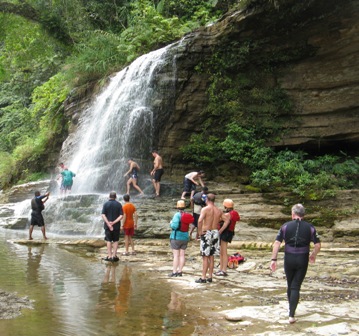 Upper Navua River waterfall and rafting group.[/caption]
I go along for the ride and send thanks to the weather gods for their forbearance. My river trip is at the tail end of the dry season. The river is low, slow-going in places and much the better for it. There's plenty of time to take in the scenery while floating at a leisurely pace. I’ll take my risks with the sharks instead.
[caption id="attachment_2091" align="alignnone" width="448"]
Upper Navua River waterfall and rafting group.[/caption]
I go along for the ride and send thanks to the weather gods for their forbearance. My river trip is at the tail end of the dry season. The river is low, slow-going in places and much the better for it. There's plenty of time to take in the scenery while floating at a leisurely pace. I’ll take my risks with the sharks instead.
[caption id="attachment_2091" align="alignnone" width="448"]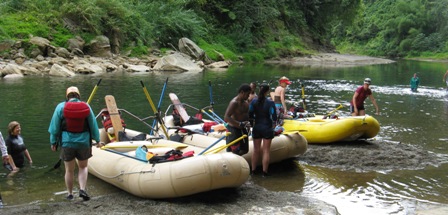 Rafting group on Upper Navua River Viti Levu.[/caption]
Despite a military dictatorship running the government in Suva, everyone I meet is smiling and unfailingly happy. I’m a visitor here. I bring income. Of course I’m treated well but not all writers experience the same reception. The government has clamped down hard on its free press. International news journalists experience mixed welcomes and mutual distrust is pervasive. The country’s two newspapers now read like simplistic tourism brochures, virtually news-free and positively spun by the government. Informed persons tell me that if they want to gain more than rudimentary knowledge about Fijian politics, they read the New Zealand or Australian press.
Fiji is nevertheless a safe country for tourists. By 2012, approximately 400,000 visitors from Australia chose Fiji as a holiday destination, an increase of more than 100,000 since 2009. Obviously people are voting with their feet, their preference for Fiji firmly in place. I make no judgment call. Educated sources reliably tell me that in recent times local chiefs parked themselves inside polling stations to monitor how their people voted. The ‘wrong’ vote could result in social ostracising or worse. For Fijian Indians, marginalised and disadvantaged, the political situation has often been dire with disenfranchisement a distinct threat.
The present government is promising a new constitution that will rectify many such wrongs though a date has yet to be confirmed for its ratification.
Fijians are patient. Is it the climate? The laissez-faire attitude to change that serves also to dampen progress? Certainly Fiji is a poor nation. Tourism is its largest domestic earner, greater than sugar, mining, timber and fisheries combined. If the tourism industry nosedives, many innocent Fijians will suffer. No money for school fees, transport or basic essentials much less luxuries like uniforms and books. While the present government’s heavy handedness regarding freedom of press and its overall quashing of criticism is deplorable, Fijians I meet are candidly philosophical about the future. If there’s such a belief as tropical stoicism, Fijians are adept practitioners of its tenets.
Tom Neal Tacker travelled courtesy of Fiji's national tourism authority.
Naked Facts:
Naked Routes:
Newly rebranded (formerly Air Pacific) Fiji Airways has daily flights from Sydney, Melbourne, LA and other Pacific nations to Fiji's international airport at Nadi. See www.fijiairways.com
Jetstar and Virgin Pacific also fly from Sydney and Melbourne. Domestic flights are with Pacific Sun Airways. See www.pacificsun.com.fj
Naked Sleeps:
Inevitably visitors will spend a day or two near Nadi International Airport. The Sofitel Fiji Resort and Spa on Denarau Island is my top pick. 15 minutes drive from both Nadi town or the airport. Good food and service. Rates from F$290 per night. See www.sofitelfiji.com.fj
[caption id="attachment_2123" align="alignnone" width="275"]
Rafting group on Upper Navua River Viti Levu.[/caption]
Despite a military dictatorship running the government in Suva, everyone I meet is smiling and unfailingly happy. I’m a visitor here. I bring income. Of course I’m treated well but not all writers experience the same reception. The government has clamped down hard on its free press. International news journalists experience mixed welcomes and mutual distrust is pervasive. The country’s two newspapers now read like simplistic tourism brochures, virtually news-free and positively spun by the government. Informed persons tell me that if they want to gain more than rudimentary knowledge about Fijian politics, they read the New Zealand or Australian press.
Fiji is nevertheless a safe country for tourists. By 2012, approximately 400,000 visitors from Australia chose Fiji as a holiday destination, an increase of more than 100,000 since 2009. Obviously people are voting with their feet, their preference for Fiji firmly in place. I make no judgment call. Educated sources reliably tell me that in recent times local chiefs parked themselves inside polling stations to monitor how their people voted. The ‘wrong’ vote could result in social ostracising or worse. For Fijian Indians, marginalised and disadvantaged, the political situation has often been dire with disenfranchisement a distinct threat.
The present government is promising a new constitution that will rectify many such wrongs though a date has yet to be confirmed for its ratification.
Fijians are patient. Is it the climate? The laissez-faire attitude to change that serves also to dampen progress? Certainly Fiji is a poor nation. Tourism is its largest domestic earner, greater than sugar, mining, timber and fisheries combined. If the tourism industry nosedives, many innocent Fijians will suffer. No money for school fees, transport or basic essentials much less luxuries like uniforms and books. While the present government’s heavy handedness regarding freedom of press and its overall quashing of criticism is deplorable, Fijians I meet are candidly philosophical about the future. If there’s such a belief as tropical stoicism, Fijians are adept practitioners of its tenets.
Tom Neal Tacker travelled courtesy of Fiji's national tourism authority.
Naked Facts:
Naked Routes:
Newly rebranded (formerly Air Pacific) Fiji Airways has daily flights from Sydney, Melbourne, LA and other Pacific nations to Fiji's international airport at Nadi. See www.fijiairways.com
Jetstar and Virgin Pacific also fly from Sydney and Melbourne. Domestic flights are with Pacific Sun Airways. See www.pacificsun.com.fj
Naked Sleeps:
Inevitably visitors will spend a day or two near Nadi International Airport. The Sofitel Fiji Resort and Spa on Denarau Island is my top pick. 15 minutes drive from both Nadi town or the airport. Good food and service. Rates from F$290 per night. See www.sofitelfiji.com.fj
[caption id="attachment_2123" align="alignnone" width="275"]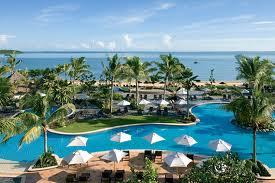 Sofitel Denarau Island main pool and grounds.[/caption]
The Pearl South Pacific Resort at Pacific Harbour is a boutique hotel and highly recommended. Rates from F$365 per night. See www.thepearlsouthpacific.com
[caption id="attachment_2122" align="alignnone" width="293"]
Sofitel Denarau Island main pool and grounds.[/caption]
The Pearl South Pacific Resort at Pacific Harbour is a boutique hotel and highly recommended. Rates from F$365 per night. See www.thepearlsouthpacific.com
[caption id="attachment_2122" align="alignnone" width="293"]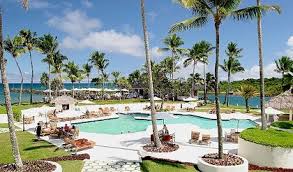 Pearl South Pacific Resort pool and grounds.[/caption]
The Jean-Michel Cousteau Resort is exquisite. Rates from F$750 per night including breakfast and dinner. See www.fijiresort.com
[caption id="attachment_2094" align="alignnone" width="448"]
Pearl South Pacific Resort pool and grounds.[/caption]
The Jean-Michel Cousteau Resort is exquisite. Rates from F$750 per night including breakfast and dinner. See www.fijiresort.com
[caption id="attachment_2094" align="alignnone" width="448"]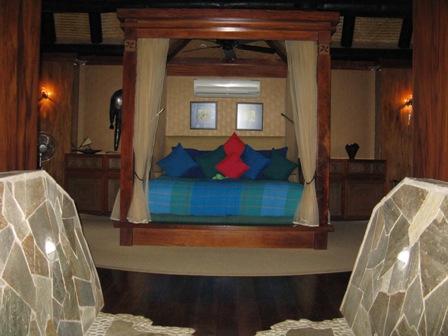 JM Cousteau resort villa bedroom.[/caption]
[caption id="attachment_2093" align="alignnone" width="448"]
JM Cousteau resort villa bedroom.[/caption]
[caption id="attachment_2093" align="alignnone" width="448"]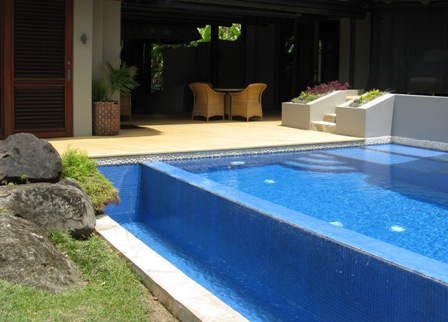 JM Cousteau resort villa pool.[/caption]
Naked Fun:
Day trips on the Upper Navua River (www.riversfiji.com) and Beqa Adventure Divers' incredible dives with sharks (www.fijisharkdive.com) can also be arranged via the Pearl South Pacific Resort or direct contact.
J. Hunter Pearl Farm visits may be organised via Jean-Michel Cousteau Resort. See www.pearlsfiji.com
JM Cousteau resort villa pool.[/caption]
Naked Fun:
Day trips on the Upper Navua River (www.riversfiji.com) and Beqa Adventure Divers' incredible dives with sharks (www.fijisharkdive.com) can also be arranged via the Pearl South Pacific Resort or direct contact.
J. Hunter Pearl Farm visits may be organised via Jean-Michel Cousteau Resort. See www.pearlsfiji.com
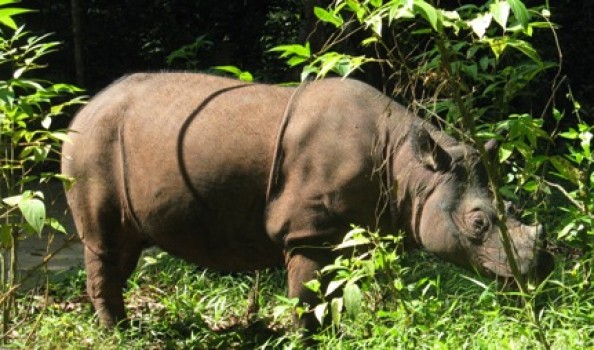 https://nakedhungrytraveller.com.au/sumatras-rarest-animals/ Sumatra’s Rarest Animals
https://nakedhungrytraveller.com.au/sumatras-rarest-animals/ Sumatra’s Rarest AnimalsOrang-utans, Tigers, Rhinos and Elephants are some of Indonesia’s star animal attractions. The going may be rough to see them, but it’s always worth it.
Orangutans aren’t the only endangered species struggling to survive in Indonesia’s diverse eco-systems. In southern Sumatra I visited Way Kambas National Park, home to Sumatran tigers, Sumatran rhinos, Asian elephants, Malaysian tapirs, false gharials, clouded leopards, fishing cats and Sun bears; all rare and all extraordinarily difficult to find. Way Kambas’ 130,000 hectares comprise riverine jungle, low-lying marshlands and towering rainforest. I also see siamangs, the world’s largest gibbons. Their hooting calls wake me at dawn. Cute black faces peek around dense foliage high up in the trees. The gibbons are the loudest of all forest animals, their cries can be heard from more than a kilometre away. Overhead, fifty metres up, a deafening hullabaloo shatters any semblance of morning calm. Heavy metal music has a rival. The rarest of all animals here is the Sumatran rhino. Way Kambas is home to the world’s only successful breeding programme managed in this amazing animal’s native habitat. [caption id="attachment_2038" align="alignnone" width="448"] Way Kambas Sumatran Rhino Foundation sign.[/caption]
The Sumatran, or Hairy rhino, is the smallest of the five rhino species. Up close, it’s an impressively large animal; there’s really no such thing as a small adult rhino. But the Sumatran rhino is oddly dainty looking. Elusive and quiet, it moves through the forest like a ghost. I see one pregnant female, and two mature males. If .Sumatran rhinos have a chance at seeing out this century, Way Kambas is one of the few places where the odds aren’t completely against them.
[caption id="attachment_2039" align="alignnone" width="410"]
Way Kambas Sumatran Rhino Foundation sign.[/caption]
The Sumatran, or Hairy rhino, is the smallest of the five rhino species. Up close, it’s an impressively large animal; there’s really no such thing as a small adult rhino. But the Sumatran rhino is oddly dainty looking. Elusive and quiet, it moves through the forest like a ghost. I see one pregnant female, and two mature males. If .Sumatran rhinos have a chance at seeing out this century, Way Kambas is one of the few places where the odds aren’t completely against them.
[caption id="attachment_2039" align="alignnone" width="410"]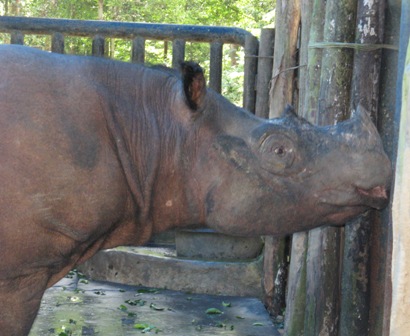 Protected pregnant female at Way Kambas.[/caption]
For a day, I was invited to join a mahout and his elephant for an outing.
[caption id="attachment_2040" align="alignnone" width="300"]
Protected pregnant female at Way Kambas.[/caption]
For a day, I was invited to join a mahout and his elephant for an outing.
[caption id="attachment_2040" align="alignnone" width="300"] Mahout and elephant getting ready for jungle trek.[/caption]
During a stroll into a plain near the elephant training camp located at the centre of Way Kambas, we spy an enormous lone wild bull elephant grazing in the far distance. A king cobra slides into a palmetto grove, its body as thick as my arm. The mahout points to it and says, ‘Raja cobra.’ Indeed, it is the king of snakes and I am thankful to be atop an elephant.
[caption id="attachment_2196" align="alignnone" width="260"]
Mahout and elephant getting ready for jungle trek.[/caption]
During a stroll into a plain near the elephant training camp located at the centre of Way Kambas, we spy an enormous lone wild bull elephant grazing in the far distance. A king cobra slides into a palmetto grove, its body as thick as my arm. The mahout points to it and says, ‘Raja cobra.’ Indeed, it is the king of snakes and I am thankful to be atop an elephant.
[caption id="attachment_2196" align="alignnone" width="260"] World's largest venomous snake, the King cobra.[/caption]
A Sambar deer stands motionless in tall grass. Muntjac deer scamper from one clump of cover to another, constantly wary when crossing open ground.
[caption id="attachment_2041" align="alignnone" width="448"]
World's largest venomous snake, the King cobra.[/caption]
A Sambar deer stands motionless in tall grass. Muntjac deer scamper from one clump of cover to another, constantly wary when crossing open ground.
[caption id="attachment_2041" align="alignnone" width="448"]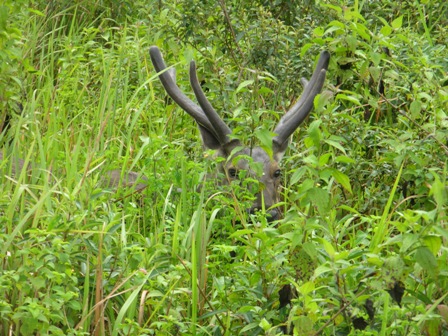 Sambar deer in high grass.[/caption]
An estimated 50 Sumatran tigers live in Way Kambas, one of their last hold-outs. Tallying tigers is tricky business I’m told by the park’s chief tiger expert. He walks a ten square kilometre perimeter each fortnight, checking hidden cameras and recording tiger movements. Walking the grid takes five or six days, camping in the jungle under canvas tarpaulins, sometimes sleeping in trees when the tigers prowl too near.
[caption id="attachment_2197" align="alignnone" width="267"]
Sambar deer in high grass.[/caption]
An estimated 50 Sumatran tigers live in Way Kambas, one of their last hold-outs. Tallying tigers is tricky business I’m told by the park’s chief tiger expert. He walks a ten square kilometre perimeter each fortnight, checking hidden cameras and recording tiger movements. Walking the grid takes five or six days, camping in the jungle under canvas tarpaulins, sometimes sleeping in trees when the tigers prowl too near.
[caption id="attachment_2197" align="alignnone" width="267"] Male Sumatran tiger in the wild.[/caption]
Though he has lived in Way Kambas for three years, he has seen tigers only twice. ‘I hear them all the time but I almost never see them,’ he tells me. ‘One of my assistants saw a tiger on this road here,’ pointing down the single lane track that leads into the park from the ranger station. ‘It was walking in the middle just there only a few hundred metres away.’ I ask if that tiger was seen again. ‘I don’t think so but that boy was so lucky. You could be here for a year and never see a tiger.’
[caption id="attachment_2042" align="alignnone" width="299"]
Male Sumatran tiger in the wild.[/caption]
Though he has lived in Way Kambas for three years, he has seen tigers only twice. ‘I hear them all the time but I almost never see them,’ he tells me. ‘One of my assistants saw a tiger on this road here,’ pointing down the single lane track that leads into the park from the ranger station. ‘It was walking in the middle just there only a few hundred metres away.’ I ask if that tiger was seen again. ‘I don’t think so but that boy was so lucky. You could be here for a year and never see a tiger.’
[caption id="attachment_2042" align="alignnone" width="299"]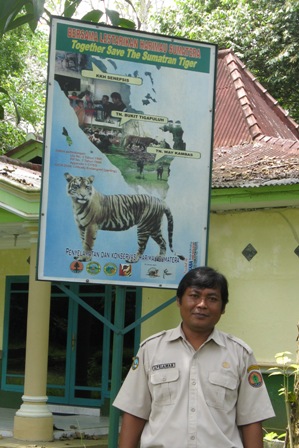 Way Kambas park manager in charge of monitoring Sumatran tigers.[/caption]
My last day in Way Kambas is spent on a long walk through soggy jungle. We’re heading to a bird blind many kilometres away, up a river in a small boat, then on foot along endless muddy tracks.
[caption id="attachment_2044" align="alignnone" width="448"]
Way Kambas park manager in charge of monitoring Sumatran tigers.[/caption]
My last day in Way Kambas is spent on a long walk through soggy jungle. We’re heading to a bird blind many kilometres away, up a river in a small boat, then on foot along endless muddy tracks.
[caption id="attachment_2044" align="alignnone" width="448"]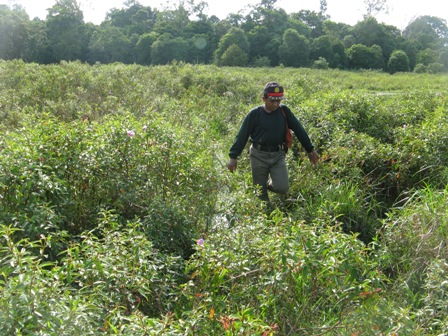 Guide tracking through swampland.[/caption]
Though I liberally apply leech and mosquito repellent, the leeches ignore it. My sandals are alive with them not long after wading across the third creek. The repellent washes away and I can’t reapply it quickly enough. When I stand still, I see dozens of tiny waving heads marching towards my bare feet, unerringly latching to the soft spots between my toes. I decide to live and let live.
[caption id="attachment_2045" align="alignnone" width="336"]
Guide tracking through swampland.[/caption]
Though I liberally apply leech and mosquito repellent, the leeches ignore it. My sandals are alive with them not long after wading across the third creek. The repellent washes away and I can’t reapply it quickly enough. When I stand still, I see dozens of tiny waving heads marching towards my bare feet, unerringly latching to the soft spots between my toes. I decide to live and let live.
[caption id="attachment_2045" align="alignnone" width="336"]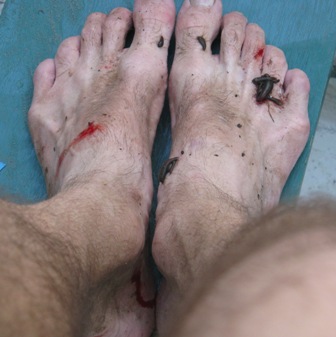 Author's leechy feet.[/caption]
We arrive at a vast shallow lake with a lone tree at least 50 metres away. In its thin branches a wooden platform is balanced precariously over water. ‘That’s the bird blind?’ I ask. ‘The tree was not in water last week,’ my guide informs me. ‘We have had much rain.’
[caption id="attachment_2051" align="alignnone" width="448"]
Author's leechy feet.[/caption]
We arrive at a vast shallow lake with a lone tree at least 50 metres away. In its thin branches a wooden platform is balanced precariously over water. ‘That’s the bird blind?’ I ask. ‘The tree was not in water last week,’ my guide informs me. ‘We have had much rain.’
[caption id="attachment_2051" align="alignnone" width="448"]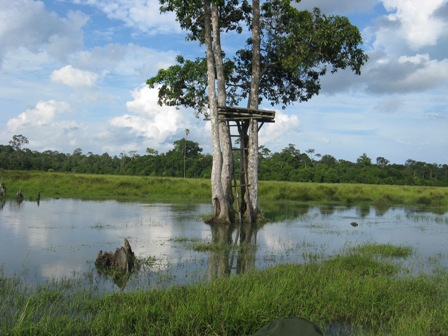 Bird blind surrounded by water in Way Kambas.[/caption]
Another guide points to a rippling movement in the water. He opens his arms wide and slaps them shut. I recognise the universal sign for crocodiles as well as the next man and say, ‘You go first. I’ll be the main course.’ Translated my comment evinces a nervous giggle. ‘Don’t worry,’ I add, ‘I’m only kidding, you’re too skinny anyway, the crocodile is waiting for me.’ That works a treat; we’re not moving any closer. Standing knee-deep in water watching a herd of Sambar deer running into the jungle, a good idea I think. There are no birds to be seen anywhere, the white-winged ducks we’ve come all this way to see are absent. I’m told two species of leeches live in Way Kambas. One loves water. The other loves wet land. Now I’m being attacked by both species while a crocodile is waiting for its turn.
[caption id="attachment_2050" align="alignnone" width="448"]
Bird blind surrounded by water in Way Kambas.[/caption]
Another guide points to a rippling movement in the water. He opens his arms wide and slaps them shut. I recognise the universal sign for crocodiles as well as the next man and say, ‘You go first. I’ll be the main course.’ Translated my comment evinces a nervous giggle. ‘Don’t worry,’ I add, ‘I’m only kidding, you’re too skinny anyway, the crocodile is waiting for me.’ That works a treat; we’re not moving any closer. Standing knee-deep in water watching a herd of Sambar deer running into the jungle, a good idea I think. There are no birds to be seen anywhere, the white-winged ducks we’ve come all this way to see are absent. I’m told two species of leeches live in Way Kambas. One loves water. The other loves wet land. Now I’m being attacked by both species while a crocodile is waiting for its turn.
[caption id="attachment_2050" align="alignnone" width="448"] Crocodile swamp in Way Kambas.[/caption]
We decide that bird watching is not at its best today and return to the river via the same track. The leeches appear to have set up feeding stations, assured that I’d be back this way soon. In the boat I remove my sandals and see movement on my feet, like opening a can of hungry worms. I take great joy in plucking the little suckers and flinging them back into the river. My guides cluck like mother hens when they look at my bleeding feet.
[caption id="attachment_2046" align="alignnone" width="448"]
Crocodile swamp in Way Kambas.[/caption]
We decide that bird watching is not at its best today and return to the river via the same track. The leeches appear to have set up feeding stations, assured that I’d be back this way soon. In the boat I remove my sandals and see movement on my feet, like opening a can of hungry worms. I take great joy in plucking the little suckers and flinging them back into the river. My guides cluck like mother hens when they look at my bleeding feet.
[caption id="attachment_2046" align="alignnone" width="448"]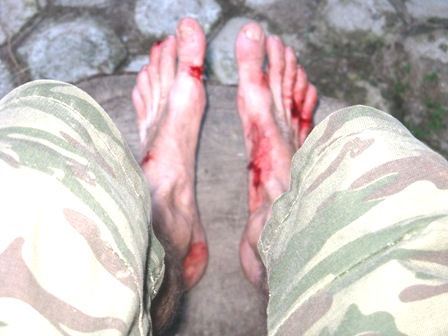 Author's de-leeched bleeding feet.[/caption]
Hours later, thoroughly de-leeched, we’re in the 4WD returning to Satwa Elephant Eco-Lodge, my home at the edge of Way Kambas. Driving slowly along the park’s single narrow road, a small elephant herd exits stage left from the forest not twenty metres in front of us. We stop. A female lifts her forefeet off the ground and reaches for a particular tree branch. She ignores us completely. Two adolescent elephants play with a broken branch, kicking it between them and then, as quickly and unexpectedly as they appeared, the elephants disappear into the impenetrable green wall.
My feet have stopped bleeding; I smile at my guides and point at my feet. ‘No more blood, stopped. See.’ But their attention is turned to the jungle, looking for the next surprise. I follow their lead, knowing that whatever surprise wild Indonesia has in store for me, the chances of seeing it are dwindling.
Tom Neal Tacker travelled courtesy of Garuda Indonesia Airlines and Eco Lodges Indonesia.
Naked Facts:
Garuda Indonesia flies from Amsterdam, most Asian and Middle Eastern capital cities, Melbourne and Sydney to Jakarta for easy connections to most Indonesian centres. Garuda Indonesia flies daily from Jakarta to Bukit Timur in southern Sumatra. Eco-Lodges Indonesia arranges land transport to Way Kambas (2 hours drive). See www.garuda-indonesia.com for information and bookings.
Non-profit Eco-Lodges Indonesia, the only Green Globe accredited accommodation group in Indonesia is based at Udayana Lodge, Jimbaran Bay, Bali. Eco-Lodges Indonesia operates according to Australian management practice with locally employed supervisory staff. Profits are spent preserving local habitats and endangered species rescue operations. Cost inclusive of park fees, transport into and out of the park, guide services and most meals is approximately USD$250 per day. Transport to Way Kambas from Bukit Timur’s airport is approximately USD$100 for 1 to 4 passengers. See www.ecolodgesindonesia.com for other tour packages and rates.
Author's de-leeched bleeding feet.[/caption]
Hours later, thoroughly de-leeched, we’re in the 4WD returning to Satwa Elephant Eco-Lodge, my home at the edge of Way Kambas. Driving slowly along the park’s single narrow road, a small elephant herd exits stage left from the forest not twenty metres in front of us. We stop. A female lifts her forefeet off the ground and reaches for a particular tree branch. She ignores us completely. Two adolescent elephants play with a broken branch, kicking it between them and then, as quickly and unexpectedly as they appeared, the elephants disappear into the impenetrable green wall.
My feet have stopped bleeding; I smile at my guides and point at my feet. ‘No more blood, stopped. See.’ But their attention is turned to the jungle, looking for the next surprise. I follow their lead, knowing that whatever surprise wild Indonesia has in store for me, the chances of seeing it are dwindling.
Tom Neal Tacker travelled courtesy of Garuda Indonesia Airlines and Eco Lodges Indonesia.
Naked Facts:
Garuda Indonesia flies from Amsterdam, most Asian and Middle Eastern capital cities, Melbourne and Sydney to Jakarta for easy connections to most Indonesian centres. Garuda Indonesia flies daily from Jakarta to Bukit Timur in southern Sumatra. Eco-Lodges Indonesia arranges land transport to Way Kambas (2 hours drive). See www.garuda-indonesia.com for information and bookings.
Non-profit Eco-Lodges Indonesia, the only Green Globe accredited accommodation group in Indonesia is based at Udayana Lodge, Jimbaran Bay, Bali. Eco-Lodges Indonesia operates according to Australian management practice with locally employed supervisory staff. Profits are spent preserving local habitats and endangered species rescue operations. Cost inclusive of park fees, transport into and out of the park, guide services and most meals is approximately USD$250 per day. Transport to Way Kambas from Bukit Timur’s airport is approximately USD$100 for 1 to 4 passengers. See www.ecolodgesindonesia.com for other tour packages and rates.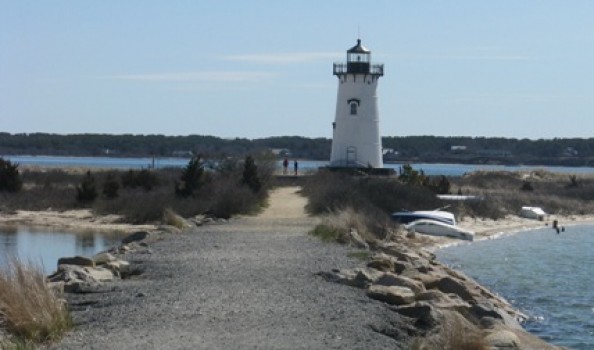 https://nakedhungrytraveller.com.au/the-perfect-island/ The Perfect Island?
https://nakedhungrytraveller.com.au/the-perfect-island/ The Perfect Island?The world is peppered with thousands of small islands. Many are beautiful, some stunning and some poor losers are ghastly ugly. Travellers dream of discovering one to call home, if only for a holiday.
Hanging off the coast of Massachusetts is a cluster of small islands. Not far from these islands were once some of the world’s most productive fishing grounds. Killing fleets nearly eradicated whales from the whole of the North Atlantic. Overfishing killed the golden goose while whale oil was finally replaced by petroleum. Those days are past. These days see better management practices in place while fish stocks recover. Still, fortunes made off huge catches are the stuff of memory.
[caption id="attachment_1964" align="alignnone" width="448"]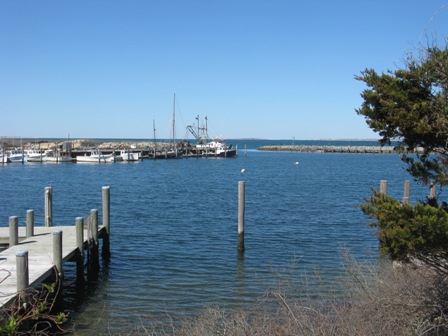 Menemsha harbor is still a working fishing port.[/caption]
Menemsha harbor is still a working fishing port.[/caption]
Money is made in the big cities nowadays, Boston, Hartford, Providence and New York. Banking, stock markets, insurance and financial services lead to big incomes. Where do local rich people play if they don’t want to venture far from home?
The Hamptons at Long Island’s end and Newport at Rhode Island’s bottom come to mind when thinking of ubiquitous wealth and ostentatious spending. Both places attract old money and new money in apparently equal measures. The islands off Massachusetts are also well known as an American moneyed set’s playground.
Hyannis on the mainland is the gateway port for Nantucket and Martha’s Vineyard. The Kennedy family compound is at Hyannis overlooking Nantucket Sound, a yachtsman’s paradise of shallow clean water with safe anchorages on the islands’ northern shores and all along the mainland.
If the world was perfect it would be a lot like Martha’s Vineyard. The world isn’t perfect so little spots like Martha’s Vineyard perform stand-in roles in global theatre’s constantly travelling play, ‘The Search for Perfection’.
I was seduced by Martha’s Vineyard right from my first impression. Its tourism officials are some of the friendliest people I’ve dealt with on a professional basis. What swept me off my feet was the frank honesty about their little island. Amidst all that wealth, the people employed to spruik the island’s attractions showed genuine humility delightfully paired with frank humour. Expecting a wade through a bath of bullshit, I was surprised instead by undressed honesty. PR spin was reeled out at a bare minimum, if at all.
[caption id="attachment_1957" align="alignnone" width="448"] Edgartown church and visitor's center.[/caption]
Edgartown church and visitor's center.[/caption]
What separates prosperous Hamptons and Newport from Martha’s Vineyard is the difference between blatant show and not much substance and discreet show with a lot of substance. Inconspicuous wealth is the key to Martha’s Vineyard’s charm.
And the fact that much of that money has gone into protecting the island’s environment.
Edgartown is the island’s big town. It ranks as one of the prettiest villages in all the USA. Across the narrow channel from the town harbour is tiny Chappaquiddick, an island off an island but considered part of Edgartown.
[caption id="attachment_1960" align="alignnone" width="448"] Typical Edgartown houses.[/caption]
Typical Edgartown houses.[/caption]
The island’s main library is in Edgartown as is the town hall and administrative offices. Lots of tiny shops, cafes and a few restaurants complete the tidy tourist picture. A photogenic lighthouse juts up from the sand dune off Edgartown’s harbour front, signalling the passage between Chappaquiddick and central Edgartown.
During a mid-spring visit, I got the impression that many of Edgartown’s houses are essentially summer homes for holidaying semi-permanent residents. The average cost for a moderate house in Edgartown is over USD$ 1 million.
[caption id="attachment_1955" align="alignnone" width="448"] Edgartown North Water St former sea captain houses.[/caption]
Edgartown North Water St former sea captain houses.[/caption]
Outside the busy summer season, the island’s other town of consequence, Vineyard Haven/Oak Bluffs is where the majority of the island’s permanent residents hang out and live. Vineyard Haven is the island’s ferry port to the mainland, crowded with maritime businesses compared to Edgartown’s leisurely yachting sidelines. While Edgartown seemed to be in a napping state before summer’s onslaught of visitors, little Vineyard Haven thrummed with life.
I’ve noticed a queer fact about human living patterns; no matter how small the living area is people will separate themselves into sections. Martha’s Vineyard, approximately 30 kilometres long by 15 kilometres wide is divided into Up Island and Down Island. Up Island is west of Vineyard Haven/Oak Bluffs, consisting of hamlets like North Tisbury, West Tisbury, Aquinnah, Chilmark and Menemsha. Up Island officially ends at Gay Head, a series of bluffs facing into the North Atlantic Ocean. I hear the local council has a challenging time maintaining its Gay Head signs, theft is common and vandals make the most of Gay Head’s punning opportunities.
[caption id="attachment_1959" align="alignnone" width="434"]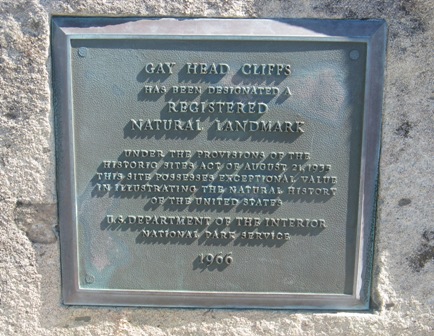 Gay Head sign.[/caption]
Gay Head sign.[/caption]
Down Island are Edgartown and Chappaquiddick. Considering that only about 16,000 people call ‘The Vineyard’ home all year round, I was surprised the community has split itself pretty much right down the middle. Up Islanders tend to be permanent residents. Down Islanders tend to be semi-permanent.
To make geographical matters even more complicated, a fierce rivalry exists between ‘The Vineyard’ and nearby neighbour, Nantucket Island. ‘Martha’s Vineyard has hills. Nantucket is flat.’ ‘The Vineyard is open to visitors, Nantucket isn’t.’ After a couple days I just had to accept a majority opinion, ‘Nantucket is weird.’
I look forward to visiting Nantucket to find out for myself.
Martha’s Vineyard is a popular place. Keep this fact in perspective: during summer’s peak season June, July and August, the island’s population swells to over 100,000 people, almost ten times the average population. That almost everyone manages to maintain a friendly outlook during the summer rush of visitors is testament to the island’s innate attraction. It’s as if everyone has decided to adopt a democratically positive attitude. Why be bothered to sulk in such a peaceful environment?
US Presidents holiday at Martha’s Vineyard; it’s that private. Obama and his family rented a secluded house Up Island early during his presidency. Bill and Hillary Clinton sailed off its shores during several executive office breaks. Of course members of the Kennedy clan have been making regular visits since the 40s. Some of those visits became notorious. Remember Ted Kennedy’s car accident in 1969? He drove off a bridge on Chappaquiddick; survived the crash but his secretary Mary Jo Kopechne didn’t. She drowned in the back seat. Kennedy reported the accident to local police some hours later. He had found time to dry his clothes but his hopes for a successful run at the presidency were dashed forever.
Steven Spielberg took a liking to the island and used it as the setting for his ground-breaking film ‘Jaws’. A number of local kids appeared in it. A local company operates random ‘Jaws’ tours of the island by appointment. One of the kids who appeared as a film extra apparently works as a guide.
What to do on Martha’s Vineyard? Officially speaking there are no major tourist attractions. A great part of the island’s charm is that no chain restaurants, theme parks, retail conglomerates or very important significant historic sites exist. Is it the perfect contemporary mass marketing vacuum? Thankfully yes.
[caption id="attachment_1966" align="alignnone" width="448"]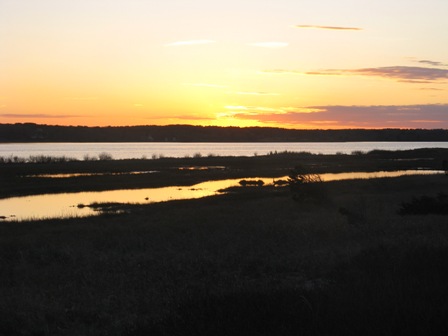 Sunset at Felix Neck.[/caption]
Sunset at Felix Neck.[/caption]
For me it’s one of those rare places where I didn’t feel compelled to do anything other than to wander blithely experiencing one kismet moment after another: a spectacular sunset on the sandy road between Oak Bluffs and Edgartown looking towards Felix Neck Wildlife Sanctuary. Chatting with a shopkeeper at Menemsha’s little port, him boasting that he made the island’s best clam chowder. Large empty cans of watery potatoes in his small kitchen had me wondering at his comical bluster. “Why don’t you use fresh potatoes?” I asked. “People seem to like it this way. You want some or not?” I left smiling but didn’t try the canned chowder.
[caption id="attachment_1963" align="alignnone" width="336"]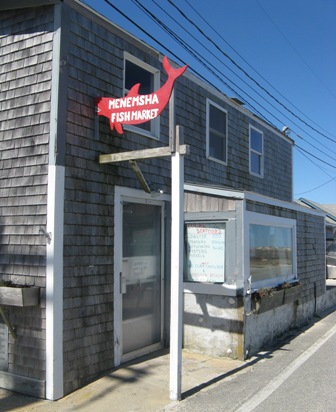 Menemsha Fish Market, home of the island's 'best' clam chowder.[/caption]
Menemsha Fish Market, home of the island's 'best' clam chowder.[/caption]
Meeting a 60 something couple walking their dog at Lambert Cove beach, one of the island’s prettiest. We were the only people there. She works as an itinerant housecleaner in luxurious summer homes rented by rich visitors. Her retired partner spends most of the year on the mainland near Barnstable doing odd jobs but “loves” the Vineyard. He returns to the island to see her and get away from mainland life’s trials and tribulations. They were so much in love it was a glad day just to walk with them along the beach while they told me all about living on the “most beautiful island in the whole northeast”. I learnt much from them about the social divides between wealthy residents and those less fortunate, a largely live and let live co-existence. Another moment was richly felt while exploring the excellent Vineyard Haven Bookshop and Art Gallery with its lovely collection of works by local artists and a fine selection of thoughtfully chosen books. Yet another was spent chatting with a librarian at Edgartown’s esteemed and well-used town library. Asking him about the original inhabitants, the Wampanoag tribe, I was invited into his office for a long informative chat about the tribe’s long fought battle to secure a permanent landholding at Aquinnah. Other fine moments were spent briefly stopping my rental vehicle three separate times so families of Canadian geese could cross safely, goslings waddling behind parents as fast as their little legs could carry them. Passersby waved at me as did fellow drivers, cheering goose commuters onwards? Finally, after a long day spent collecting snippets of island life far-reaching insight was captured while standing alone at Gay Head looking out over the vastness of the North Atlantic imagining how little the island had changed in 10,000 years. That’s my short list of serendipitous moments during a day of wonder on the perfect island.
[caption id="attachment_1962" align="alignnone" width="448"]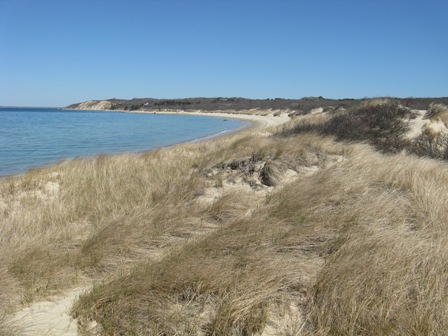 Lambert Cove beach.[/caption]
Lambert Cove beach.[/caption]
Had I another spare day I would have hired a bicycle and made use of the island’s extensive bike trails.
Dreaming of that possibility had I another spare day in addition to the cycling day, I would have made better use of the island’s extensive walking trails.
A subsequent spare day would have been spent sitting on the veranda of my hotel reading a book, perhaps ‘Caleb’s Crossing’ by resident author and ex-pat Australian Geraldine Brooks.
Fantasising about days spent idling on a perfect island is a contagious mindset.
Martha’s Vineyard conjures scenes of director Peter Weir’s 1998 film ‘The Truman Show’ with Jim Carrey, Laura Linney and Ed Harris. It’s the sort of place that engenders comparisons with impossibly perfect places. Fairly or unfairly, the small island cops criticism for being elitist and separatist. I don’t agree. For me, ‘The Vineyard’ is a microcosm of American current reality. Dig deep enough and financial stress coupled with economic troubles is uncovered easily enough even on this speck of overriding affluence. But that’s not what this holiday island is all about. Largely it’s a dream made real where the living is relatively easy and ostentatious wealth is frowned upon by the wealthy and middle class alike.
[caption id="attachment_1956" align="alignnone" width="448"]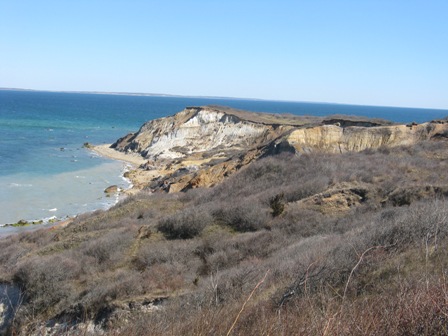 Aquinnah cliffs.[/caption]
Aquinnah cliffs.[/caption]
Since 2008, much social media discussion has revolved around how America has changed from a land of opportunity for everyone to a land of opportunity for the already rich. Statistics bear out the truth of this accusation as increased wealth rests in fewer select hands while the poor struggle to hold on to a diminishing portion of the gross national fortune.
[caption id="attachment_1965" align="alignnone" width="448"] Oldest house in Edgartown, a reminder of when the island was poor.[/caption]
Oldest house in Edgartown, a reminder of when the island was poor.[/caption]
Martha’s Vineyard is one of those rare places in the USA where it’s possible to witness how great wealth held closely in the hands of the few is clearly juxtaposed with moderate means in the hands of many. They co-habit with a visible degree of equanimity, each possessed of their inalienable right to a good life whatever its price.
Is this an island ethos driven by an absence of envy?
Probably not, but nowhere is perfect.
Tom Neal Tacker travelled courtesy of Qantas Airways and Massachusetts Tourism Authority.
Naked Routes:
Getting to Martha’s Vineyard is easy. During high season daily ferries run between Hyannis, Falmouth and Fairhaven, Massachusetts’ ports only a few hours sailing time to Vineyard Haven. I flew as a guest of Massachusetts Tourism authority on Cape Air from Boston and from the island to Hyannis. The two hops in 10 seater twin-prop Cessna aircraft were geographical revelations. The flight path takes in Boston Bay, the Upper Cape and Nantucket Sound. On a clear day, it’s a wonderful trip. See www.capeair.com for information and bookings.
Naked Sleeps:
Martha’s Vineyard tourism hosts looked after me splendidly. I was lodged for two nights in one of the island’s best hostelries, The Harbor View hotel in Edgartown. Overlooking Edgartown’s picturesque harbour and lighthouse with Chappaquiddick’s beach lights twinkling in the near distance at night, it’s a terrific hotel comprising one grandly renovated building with a huge sea-front veranda and several converted out buildings, formerly private residences from the days when Edgartown made its money from whaling and fishing, all set in manicured gardens lending an added atmosphere of space and exclusivity. Local birds loved the gardens too. My suite on the upper level in one of the old refurbished sea captain’s houses was faultless: full king sized bed made up with luxurious linens in an enormous bedroom with an open fireplace, separate dressing room, bathroom big enough for a whale with huge tub and separate shower, sitting room with another open fireplace, leather lounges, large table and armchairs made it seem like a home instead of a hotel. Two wide screen televisions, a good music system and free wi-fi brought me back to modern reality. It was absolutely private and very quiet. The hotel’s free private off-street parking away from Edgartown’s narrow streets was also a bonus. Service was kind, friendly and absolutely genuine. Breakfasts are cooked to order and served by gracious and friendly waiters in a cheerily sunny conservatory in the main building. Thank goodness, it’s a no buffet zone. Steam baths filled with gluggy scrambled eggs, soggy bacon and old toast aren’t in keeping with the Harbor View style. Freshly squeezed juices were complimented by an espresso machine that employees knew how to operate. In the land that coffee has essentially forgot, this was also a real bonus. Sunset cocktails in the lobby bar were the icing on a grand accommodation cake. It’s pricey but well worth the spend.
See www.harbor-view.com for reservations and information. Prices are from USD$476 per night.
[caption id="attachment_1961" align="alignnone" width="448"] Harbor View hotel in Edgartown.[/caption]
Harbor View hotel in Edgartown.[/caption]
Naked Eats:
New England’s coastal communities are justifiably famous for seafood and fish, particularly now that fisheries are managed more sustainably. Clam chowder is basically the state of Massachusetts official dish, despite Boston beans alternative claim to the local culinary crown. Lobster is widely available at a price. Sadly, it’s a crustacean that is poorly understood by many local chefs who continue to overcook it to a rubbery death. Maybe ask to have it served rare? Same rule applies to scallops and clams. Don’t overcook either. Local oysters are also a revered delicacy. At least they weren’t cooked.
Martha’s Vineyard’s local clientele is fairly savvy. What else would one expect in such educated surrounds? I ate well from simple menus (in off season) at The Offshore Alehouse in Oak Bluffs (30 Kennebec Ave Tel: +1 508 693 2626) and the Martha’s Vineyard Chowder House Company (9 Oak Bluffs Ave Tel: +1 508 696 3000) also in Oak Bluffs, both unstuffy restaurants with loyal local followers. These were not really tourist restaurants as they stay open out of season to cater for the island’s permanent inhabitants. They both sport popular bars with bartenders who know how to make a cocktail with a generous pour.
Many of The Vineyard’s restaurants fine diners are open only during high season from May through to October.
Check out the West Tisbury Farmer’s Market on Wednesdays and Saturdays (Tel: +1 508 693 9561), the Mermaid Farm in Chilmark (Tel: +1 508 645 3492), the Fiddlehead Farmstand in Vineyard Haven (Tel: +1 508 696 6700) and Eden Market & Garden Center also in Vineyard Haven (Tel: +1 508 693 5202) for the best of the island’s farm produce including raw milk products, local stone fruits picked fresh during summer and locally made jams, mustards and honey. Menemsha has a fisherman’s co-op store selling fish and seafood fresh off the boats, open most days even in off season.
See www.mvy.com or www.massvacation.com for more information about accommodation, island-mainland transport options, seasonal activities and local festivals and events.
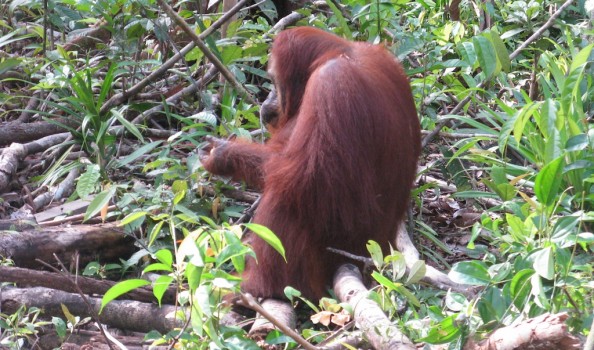 https://nakedhungrytraveller.com.au/orangutans-and-others/ Orangutans and Others
https://nakedhungrytraveller.com.au/orangutans-and-others/ Orangutans and OthersIndonesia’s wildly diverse eco-systems harbour an incredible variety of animals. Orangutans are the stars of the show at Camp Leakey.
A long hairy arm extends over my shoulder, fingers tickle my torso. I reach around to hold her hand behind my back, like we’re canoodling at the cinema hoping no one will notice. She turns to me and smiles. Her mouth is full of stinky sweet durian and her lower lip protrudes comically. It’s an intimate moment and I return the smile, completely smitten. Siswe and I are sharing a simple wooden bench on the veranda of Dr. Birute Galdikas’ home at Camp Leakey in Borneo’s Tanjung Puting National Park. Siswe is approximately 35 years old, the local troupe’s alpha orangutan female and as strong as ten men. ‘She could dislocate your arm as easily as you would snap a twig you know,’ says Galdikas, ‘but she likes men, particularly older men.’ I don’t know if I’ve just been insulted or complimented. I’m seated between two alpha females and feel that if I don’t show proper respect, I could be in big trouble. It’s not as if I haven’t been exposed to enough already. Borneo’s rainforests aren’t for the faint-hearted. I’ve travelled two hours on a small boat up a river full of crocodiles to get here. Venomous snakes are everywhere, leeches too. Borneo is alive with things that bite, sting or suck. If I trip on a boardwalk and fall into the surrounding swamp that encompasses Camp Leakey, I may not live to tell the tale. But I’ve come to meet one of my human heroes, Dr. Birute Galdikas and to get up close and personal with a few other animal heroes, the critically endangered orangutans of Indonesia. The risks involved are minimal compared to the rewards gained. [caption id="attachment_1945" align="alignnone" width="448"]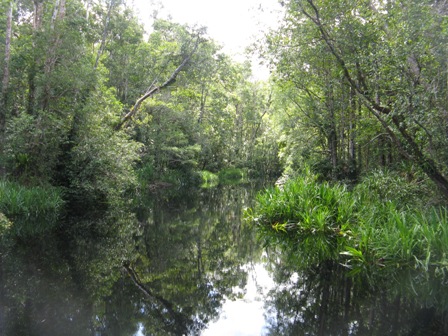 River near Camp Leakey in Tanjing Puting National Park.[/caption]
Once there were three. Now there is one remaining Leakey angel still working in the field. Jane Goodall retired from studying chimpanzees in Tanzania over twenty years ago to launch her own wildlife preservation foundation. Dian Fossey was murdered in 1985 while studying mountain gorillas in Rwanda. Birute Galdikas continues her field research where it all started in 1971, in Indonesia’s Kalimantan Province on the island of Borneo. Her research station in Tanjung Puting National Park is called Camp Leakey in honour of her mentor, the great anthropologist Louis Leakey.
Before meeting Galdikas I wander around Camp Leakey with a few fellow travellers. The orangutans are supplied with fruits twice a day at various feeding stations arrayed in the surrounding forest, enough to supplement their diet but not enough to encourage dependency in place of natural foraging. The hours between feeding times allow visitors to explore the camp unsupervised. I find a black-handed gibbon positioned in a small tree outside the cook’s cabin. Normally gibbons are high up in a tree as possible, invisible in the upper canopy. Without excellent vision, binoculars and luck, they’re difficult to spot. This gibbon posed for me from a few metres away, looking for companionship or a handout or both.
[caption id="attachment_1946" align="alignnone" width="436"]
River near Camp Leakey in Tanjing Puting National Park.[/caption]
Once there were three. Now there is one remaining Leakey angel still working in the field. Jane Goodall retired from studying chimpanzees in Tanzania over twenty years ago to launch her own wildlife preservation foundation. Dian Fossey was murdered in 1985 while studying mountain gorillas in Rwanda. Birute Galdikas continues her field research where it all started in 1971, in Indonesia’s Kalimantan Province on the island of Borneo. Her research station in Tanjung Puting National Park is called Camp Leakey in honour of her mentor, the great anthropologist Louis Leakey.
Before meeting Galdikas I wander around Camp Leakey with a few fellow travellers. The orangutans are supplied with fruits twice a day at various feeding stations arrayed in the surrounding forest, enough to supplement their diet but not enough to encourage dependency in place of natural foraging. The hours between feeding times allow visitors to explore the camp unsupervised. I find a black-handed gibbon positioned in a small tree outside the cook’s cabin. Normally gibbons are high up in a tree as possible, invisible in the upper canopy. Without excellent vision, binoculars and luck, they’re difficult to spot. This gibbon posed for me from a few metres away, looking for companionship or a handout or both.
[caption id="attachment_1946" align="alignnone" width="436"]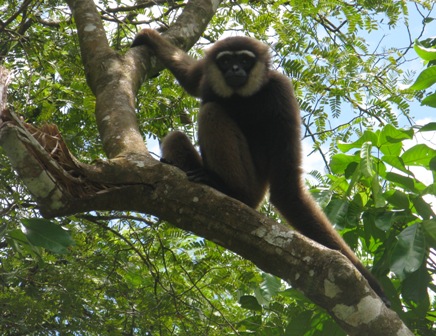 Black handed gibbon at Camp Leakey.[/caption]
Not so the proboscis monkeys. They sit in the trees along the river in full view, catching the morning sun’s rays. The males sport continually erect penises, ever ready to service the females in their troupe. The local Dayaks call them the Dutch monkeys, drawing attention to the resemblance of the monkey’s protuberant noses to those of the country’s former colonial masters.
[caption id="attachment_2138" align="alignnone" width="217"]
Black handed gibbon at Camp Leakey.[/caption]
Not so the proboscis monkeys. They sit in the trees along the river in full view, catching the morning sun’s rays. The males sport continually erect penises, ever ready to service the females in their troupe. The local Dayaks call them the Dutch monkeys, drawing attention to the resemblance of the monkey’s protuberant noses to those of the country’s former colonial masters.
[caption id="attachment_2138" align="alignnone" width="217"]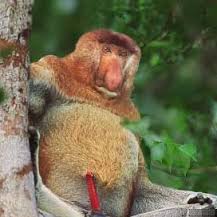 Male Proboscis monkey full frontal.[/caption]
A family of wild pigs scampered about. Piglets squeal with delight in an open area near the dining room. One of the adult female pigs is blind; she has no trouble avoiding tree stumps, unlike me while I continually trip over tree roots in the dimly lit forest.
[caption id="attachment_1947" align="alignnone" width="403"]
Male Proboscis monkey full frontal.[/caption]
A family of wild pigs scampered about. Piglets squeal with delight in an open area near the dining room. One of the adult female pigs is blind; she has no trouble avoiding tree stumps, unlike me while I continually trip over tree roots in the dimly lit forest.
[caption id="attachment_1947" align="alignnone" width="403"]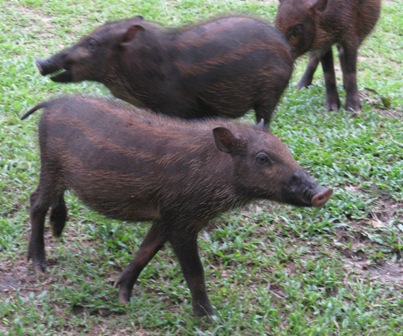 Wild pigs at Camp Leakey.[/caption]
Siswe is one of Galdikas’ favourites and a regular at Camp Leakey. Though essentially a wild animal, she has adapted to occasional human company. ‘Sometimes I hear her banging around on my roof while I’m trying to sleep,’ adds Galdikas, ‘but usually she’s off somewhere in the forest reminding other orangutans who’s boss.’ It’s difficult to imagine Siswe as a tyrant. Instead her gentle caresses lead me to believe otherwise. Her giant hand rests easily on my shoulder, her fingers are a bit grotty and sticky from the sugary durian, like a child’s hand that has spent too much time in the lolly jar. Her intelligence is comparable to that of a three year old human child’s too. Like most kids, Siswe charms, cajoles, manipulates emotions and throws temper tantrums, yet I detect wisdom in her eyes that comes from learned experience. She is a picture of calm sitting next to me yet still unpredictable, hence Galdikas’ warning.
[caption id="attachment_1948" align="alignnone" width="448"]
Wild pigs at Camp Leakey.[/caption]
Siswe is one of Galdikas’ favourites and a regular at Camp Leakey. Though essentially a wild animal, she has adapted to occasional human company. ‘Sometimes I hear her banging around on my roof while I’m trying to sleep,’ adds Galdikas, ‘but usually she’s off somewhere in the forest reminding other orangutans who’s boss.’ It’s difficult to imagine Siswe as a tyrant. Instead her gentle caresses lead me to believe otherwise. Her giant hand rests easily on my shoulder, her fingers are a bit grotty and sticky from the sugary durian, like a child’s hand that has spent too much time in the lolly jar. Her intelligence is comparable to that of a three year old human child’s too. Like most kids, Siswe charms, cajoles, manipulates emotions and throws temper tantrums, yet I detect wisdom in her eyes that comes from learned experience. She is a picture of calm sitting next to me yet still unpredictable, hence Galdikas’ warning.
[caption id="attachment_1948" align="alignnone" width="448"]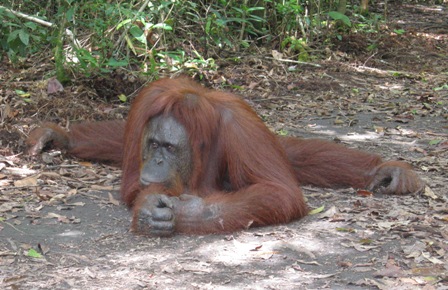 Siswe sprawled.[/caption]
The light grows crepuscular; night descends quickly at this latitude. Heavy rain resumes. Siswe sighs melodramatically, scratches her head with her left hand, leaving her right around my waist giving me a slight squeeze. ‘She gets depressed when it rains,’ says Galdikas, her shoulders slump in sympathy with Siswe’s glum attitude. I find this ironic, they both live in a rainforest. ‘Maybe you two need to move to a drier climate,’ I suggest. Galdikas has a hearty frequent laugh. Though her reputation for not suffering fools gladly puts her in strife with logging and mining companies, I find her an amiable companion. I’m on her side of the ecological argument after all. When Soeharto was president of Indonesia, Galdikas was kidnapped and beaten. Her position in Indonesia was a frequent topic during government cabinet meetings, deportation being a regular discussion point. Threats continue to thwart her work to save both the rainforest environment and all the creatures that live in it but now her work is supported by both the police and forestry authorities. She was given Indonesia’s Hero of the Earth award as national recognition for her work to save not only orangutans but all remaining wild habitats left in Indonesia.
Illegal logging and mining jeopardise the park’s boundaries though lately the damage in the park itself has been minimal. Not so outside the park. ‘Not far from where you’re staying is a huge palm oil plantation. The young male orangutan you saw outside your cabin yesterday has nowhere else to go so he’s travelling along the river looking for somewhere to cross into the park. There’s no food or shelter for him or other orangutans on the opposite side of the river,’ she tells me. ‘Gold mining upriver is polluting the eco-system too.’ I worry for the local Dayak people who live on, wash in, drink from and fish out of the river. Mercury poisoning is a real long-term threat. Galdikas’ mood shifts, not just from the rain, ‘The whole system here is so caught up in corruption and greed. I’ve been fighting against it for almost forty years, saving 95,000 hectares of land as a buffer for the park but the destruction continues. We have perhaps 4,000 or 5,000 orangutans left in Borneo, fewer than a 1,000 in Sumatra. Unless the world does something quickly, they may not survive. I do what I can but it’s not enough.’ Galdikas cares for approximately 300 orangutans in her sanctuary. They are protected by 200 local employees. Her foundation runs by the sniff of an oily rag, margins are tight, costs increase and her income is derived solely through donations.
[caption id="attachment_1951" align="alignnone" width="336"]
Siswe sprawled.[/caption]
The light grows crepuscular; night descends quickly at this latitude. Heavy rain resumes. Siswe sighs melodramatically, scratches her head with her left hand, leaving her right around my waist giving me a slight squeeze. ‘She gets depressed when it rains,’ says Galdikas, her shoulders slump in sympathy with Siswe’s glum attitude. I find this ironic, they both live in a rainforest. ‘Maybe you two need to move to a drier climate,’ I suggest. Galdikas has a hearty frequent laugh. Though her reputation for not suffering fools gladly puts her in strife with logging and mining companies, I find her an amiable companion. I’m on her side of the ecological argument after all. When Soeharto was president of Indonesia, Galdikas was kidnapped and beaten. Her position in Indonesia was a frequent topic during government cabinet meetings, deportation being a regular discussion point. Threats continue to thwart her work to save both the rainforest environment and all the creatures that live in it but now her work is supported by both the police and forestry authorities. She was given Indonesia’s Hero of the Earth award as national recognition for her work to save not only orangutans but all remaining wild habitats left in Indonesia.
Illegal logging and mining jeopardise the park’s boundaries though lately the damage in the park itself has been minimal. Not so outside the park. ‘Not far from where you’re staying is a huge palm oil plantation. The young male orangutan you saw outside your cabin yesterday has nowhere else to go so he’s travelling along the river looking for somewhere to cross into the park. There’s no food or shelter for him or other orangutans on the opposite side of the river,’ she tells me. ‘Gold mining upriver is polluting the eco-system too.’ I worry for the local Dayak people who live on, wash in, drink from and fish out of the river. Mercury poisoning is a real long-term threat. Galdikas’ mood shifts, not just from the rain, ‘The whole system here is so caught up in corruption and greed. I’ve been fighting against it for almost forty years, saving 95,000 hectares of land as a buffer for the park but the destruction continues. We have perhaps 4,000 or 5,000 orangutans left in Borneo, fewer than a 1,000 in Sumatra. Unless the world does something quickly, they may not survive. I do what I can but it’s not enough.’ Galdikas cares for approximately 300 orangutans in her sanctuary. They are protected by 200 local employees. Her foundation runs by the sniff of an oily rag, margins are tight, costs increase and her income is derived solely through donations.
[caption id="attachment_1951" align="alignnone" width="336"] Welcome sign at Camp Leakey.[/caption]
I look at Siswe chewing her durian while we sit out the storm. She leans against me as if I can keep the raindrops away. Galdikas sips her coffee while pausing to collect her thoughts. Reality has intruded into the magic and the rain has dampened my mood too.
I am sitting on a rustic wooden bench with one of the world’s leading anthropologists and one of its rarest apes. The combination this represents could not for me be more pertinent. Here in one of the planet’s few remaining wildernesses, my thoughts focus on its future. Galdikas knows what she’s talking about. Her project has recorded more than 100,000 hours of observation of a single mammalian species, the longest ever in the history of scientific field research. In addition to direct study of orangutans and other primates and monkeys, Galdikas and her team have studied regional ecology since 1971. If someone more qualified to speak the truth about the decimation of rainforest habitats throughout the world exists, Galdikas would trump him. Her expertise is unparalleled. ‘The main problem in Kalimantan is the palm oil plantations. Poaching is more of a problem in Sarawak and Sabah. While the logging clears the land, the logging roads allow access to the hunters hired by the logging companies.’ Her conclusions are based on years of experience. Again I am humbled by her stoicism. Lesser minds would have given up long ago. Galdikas’ intellect, compassion and energy are remarkably constant. She breaks into my thoughts. ‘And now it’s time we headed to the dining room, the third bell just sounded and we’re making the staff late for their dinner. They don’t like it when I’m late and they won’t start eating without me.’ Her employees will wait for Galdikas to eat, knowing how hard she works they look after her and show their respect waiting for the boss.
Sharing dinner in the communal dining room, she insists that visitors stand and recount a brief history of how they came to be there, their work and family backgrounds. It’s an important custom for the Dayak people. Galdikas translates my words into Bahasa Indonesian. I explain that I am a writer interested in Indonesia’s wonderful flora and fauna and that I have come a long way to meet Dr. Galdikas and hopefully observe the work being done at Camp Leakey to preserve Indonesia’s remaining wild forests. I have come to thank them all for their hard work and promise to help spread the word about what they do. They in turn thank me and welcome me to their land. Galdikas says, ‘You must be hungry, so let’s eat. I’m starving.’
[caption id="attachment_1949" align="alignnone" width="357"]
Welcome sign at Camp Leakey.[/caption]
I look at Siswe chewing her durian while we sit out the storm. She leans against me as if I can keep the raindrops away. Galdikas sips her coffee while pausing to collect her thoughts. Reality has intruded into the magic and the rain has dampened my mood too.
I am sitting on a rustic wooden bench with one of the world’s leading anthropologists and one of its rarest apes. The combination this represents could not for me be more pertinent. Here in one of the planet’s few remaining wildernesses, my thoughts focus on its future. Galdikas knows what she’s talking about. Her project has recorded more than 100,000 hours of observation of a single mammalian species, the longest ever in the history of scientific field research. In addition to direct study of orangutans and other primates and monkeys, Galdikas and her team have studied regional ecology since 1971. If someone more qualified to speak the truth about the decimation of rainforest habitats throughout the world exists, Galdikas would trump him. Her expertise is unparalleled. ‘The main problem in Kalimantan is the palm oil plantations. Poaching is more of a problem in Sarawak and Sabah. While the logging clears the land, the logging roads allow access to the hunters hired by the logging companies.’ Her conclusions are based on years of experience. Again I am humbled by her stoicism. Lesser minds would have given up long ago. Galdikas’ intellect, compassion and energy are remarkably constant. She breaks into my thoughts. ‘And now it’s time we headed to the dining room, the third bell just sounded and we’re making the staff late for their dinner. They don’t like it when I’m late and they won’t start eating without me.’ Her employees will wait for Galdikas to eat, knowing how hard she works they look after her and show their respect waiting for the boss.
Sharing dinner in the communal dining room, she insists that visitors stand and recount a brief history of how they came to be there, their work and family backgrounds. It’s an important custom for the Dayak people. Galdikas translates my words into Bahasa Indonesian. I explain that I am a writer interested in Indonesia’s wonderful flora and fauna and that I have come a long way to meet Dr. Galdikas and hopefully observe the work being done at Camp Leakey to preserve Indonesia’s remaining wild forests. I have come to thank them all for their hard work and promise to help spread the word about what they do. They in turn thank me and welcome me to their land. Galdikas says, ‘You must be hungry, so let’s eat. I’m starving.’
[caption id="attachment_1949" align="alignnone" width="357"]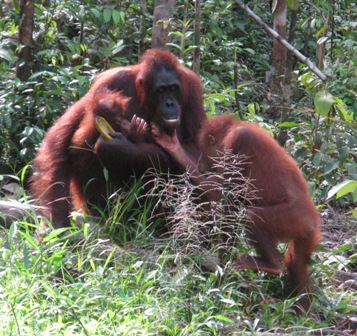 Orangutan family group.[/caption]
After midnight I reboard my rickety boat, and head downstream to Rimba Orangutan Lodge. I sit on the top deck under a canvas shelter, peering into a small circle of brightness illuminated by the boat’s single light globe. Crocodile eyes cast reddish-orange reflections. Fireflies flutter around me. A water monitor lizard swims quickly into tall reeds. I write more notes. Before I was first introduced to Siswe on a path outside Galdikas’ house, I met a younger female, Princess. Of all the orangutans I encountered at Camp Leakey, Princess is the most famous. Sir David Attenborough filmed her while she paddled a boat across a small river. No one taught her to do it. Orangutans don’t swim. They hitch rides on floating logs… or they learn to paddle a boat. Princess copied one of the workers at Camp Leakey while he rowed a small boat from one side of a stream to another. Princess’ feat of ingenuity was the first recorded instance of an ape using a boat in the same manner as a human. I also met Princess’ infants, Percy and Putri. No doubt Percy and Putri will begin operating a ferry service in the near future given their mother’s natural boating skills.
[caption id="attachment_1950" align="alignnone" width="305"]
Orangutan family group.[/caption]
After midnight I reboard my rickety boat, and head downstream to Rimba Orangutan Lodge. I sit on the top deck under a canvas shelter, peering into a small circle of brightness illuminated by the boat’s single light globe. Crocodile eyes cast reddish-orange reflections. Fireflies flutter around me. A water monitor lizard swims quickly into tall reeds. I write more notes. Before I was first introduced to Siswe on a path outside Galdikas’ house, I met a younger female, Princess. Of all the orangutans I encountered at Camp Leakey, Princess is the most famous. Sir David Attenborough filmed her while she paddled a boat across a small river. No one taught her to do it. Orangutans don’t swim. They hitch rides on floating logs… or they learn to paddle a boat. Princess copied one of the workers at Camp Leakey while he rowed a small boat from one side of a stream to another. Princess’ feat of ingenuity was the first recorded instance of an ape using a boat in the same manner as a human. I also met Princess’ infants, Percy and Putri. No doubt Percy and Putri will begin operating a ferry service in the near future given their mother’s natural boating skills.
[caption id="attachment_1950" align="alignnone" width="305"]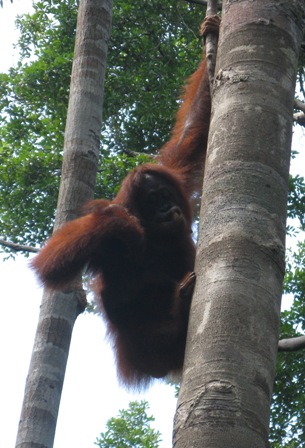 Orangutan in tree at Camp Leakey.[/caption]
Finally I return to my cabin once the boat is safely moored back at Rimba Orangutan Lodge. I’ve been allocated Julia Roberts’ cabin. My guide, a long time employee, announced enthusiastically upon my arrival at the airport a few days prior that, ‘You are sleeping in Julia Roberts’ bed!’ I was surprised and commented, ‘But she stayed here ten years ago when that documentary was made,’ referring to the documentary film Roberts starred in while she drew attention to the orangutan’s plight. ‘Yes, but it is a new mattress,’ he confirmed. I sleep very well in Julia Roberts’ bed.
Tom Neal Tacker travelled courtesy of Garuda Indonesia Airways and Eco Lodges Indonesia.
Naked Facts:
Garuda Indonesia flies from Amsterdam, most Asian capital cities, Melbourne and Sydney to Jakarta for easy connections to most Indonesian centres. Express Air flies daily from Jakarta to Pangkalan Bun in southern Kalimantan. Eco-Lodges Indonesia arranges land transport to Kumai (45 minutes drive) and river transport (2.5 hours) from Kumai to Rimba Orangutan Lodge at the edge of Tanjung Puting National Park. All national park entry fees are included in Eco-Lodges Indonesia package rates. Costs per day inclusive of park fees, transport by river boat to and from Camp Leakey (2 hours), a superior room with ensuite bathroom and most meals is approximately USD$250 per day. Transport from Kumai to Rimba Lodge is USD$110 for 1 to 4 passengers.
Non-profit Eco-Lodges Indonesia, the only Green Globe accredited accommodation group in Indonesia is based at Udayana Lodge, Jimbaran Bay, Bali. Eco-Lodges Indonesia operates according to Australian management practice with locally employed supervisory staff. Profits are spent preserving local habitats and endangered species rescue operations.
Orangutan in tree at Camp Leakey.[/caption]
Finally I return to my cabin once the boat is safely moored back at Rimba Orangutan Lodge. I’ve been allocated Julia Roberts’ cabin. My guide, a long time employee, announced enthusiastically upon my arrival at the airport a few days prior that, ‘You are sleeping in Julia Roberts’ bed!’ I was surprised and commented, ‘But she stayed here ten years ago when that documentary was made,’ referring to the documentary film Roberts starred in while she drew attention to the orangutan’s plight. ‘Yes, but it is a new mattress,’ he confirmed. I sleep very well in Julia Roberts’ bed.
Tom Neal Tacker travelled courtesy of Garuda Indonesia Airways and Eco Lodges Indonesia.
Naked Facts:
Garuda Indonesia flies from Amsterdam, most Asian capital cities, Melbourne and Sydney to Jakarta for easy connections to most Indonesian centres. Express Air flies daily from Jakarta to Pangkalan Bun in southern Kalimantan. Eco-Lodges Indonesia arranges land transport to Kumai (45 minutes drive) and river transport (2.5 hours) from Kumai to Rimba Orangutan Lodge at the edge of Tanjung Puting National Park. All national park entry fees are included in Eco-Lodges Indonesia package rates. Costs per day inclusive of park fees, transport by river boat to and from Camp Leakey (2 hours), a superior room with ensuite bathroom and most meals is approximately USD$250 per day. Transport from Kumai to Rimba Lodge is USD$110 for 1 to 4 passengers.
Non-profit Eco-Lodges Indonesia, the only Green Globe accredited accommodation group in Indonesia is based at Udayana Lodge, Jimbaran Bay, Bali. Eco-Lodges Indonesia operates according to Australian management practice with locally employed supervisory staff. Profits are spent preserving local habitats and endangered species rescue operations.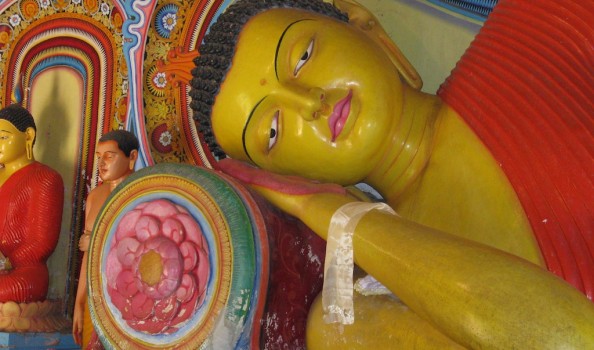 https://nakedhungrytraveller.com.au/the-road-to-nirvana/ The Road to Nirvana
https://nakedhungrytraveller.com.au/the-road-to-nirvana/ The Road to NirvanaSri Lanka continues to seduce in surprising ways.
Chamindah stops the van. He turns around, smiles at me and points to a large tortoise trying to cross the road. I climb out, pick it up and place it gently near a tree in the direction it was travelling. Chamindah clasps his hands together giving thanks to Buddha and we set off towards the rock monastery fortress of Sigiriya. I decide that I like our local guide and driver Chamindah despite his hapless nature and his lackadaisical attitude about punctuality. He’s a faithful Buddhist, has a grin as wide as the rear end of a water buffalo and stops for all animals no matter how small they are. He dodges kittens and puppies with sacred alacrity. [caption id="attachment_1914" align="alignnone" width="448"]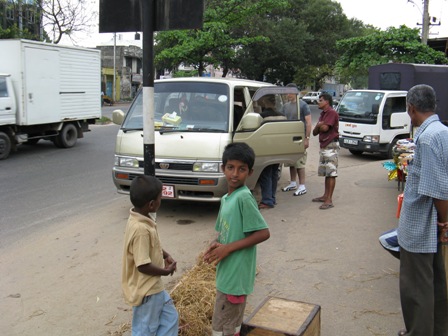 Broken down in Colombo.[/caption]
When the van broke down days before, the first of many times, he turned round smiled and said “One minute.” Hours later the van was repaired. According to Chamindah time, one minute means two hours. Two hours means days. Luckily he never says “In a couple of days.” No doubt I’d still be in Sri Lanka, plodding along like my friend the tortoise, safe from death by road kill but never punctual.
[caption id="attachment_1915" align="alignnone" width="448"]
Broken down in Colombo.[/caption]
When the van broke down days before, the first of many times, he turned round smiled and said “One minute.” Hours later the van was repaired. According to Chamindah time, one minute means two hours. Two hours means days. Luckily he never says “In a couple of days.” No doubt I’d still be in Sri Lanka, plodding along like my friend the tortoise, safe from death by road kill but never punctual.
[caption id="attachment_1915" align="alignnone" width="448"]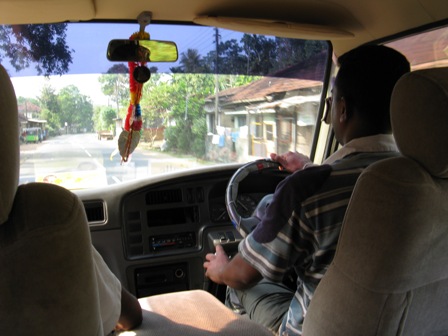 Chamindah at the wheel.[/caption]
But I don’t mind. All mishaps provide opportunities for chatting with friendly local mechanics who can apparently fix a broken radiator hose with a rubber band. A disconnected fly-wheel is repaired with a piece of scrap metal and twisted wire. Smiles all around, endless cups of tea, maybe a beer if it’s late in the afternoon, it’s so easy to while away the hours. I’m riding on serendipity time; recalling this island nation’s previous moniker, Serendib and I’m ready for unexpected pleasures no matter the form they take. Sri Lanka has had many names. For me they all mean the same, Halfway to Paradise on the Road to Nirvana.
Chamindah at the wheel.[/caption]
But I don’t mind. All mishaps provide opportunities for chatting with friendly local mechanics who can apparently fix a broken radiator hose with a rubber band. A disconnected fly-wheel is repaired with a piece of scrap metal and twisted wire. Smiles all around, endless cups of tea, maybe a beer if it’s late in the afternoon, it’s so easy to while away the hours. I’m riding on serendipity time; recalling this island nation’s previous moniker, Serendib and I’m ready for unexpected pleasures no matter the form they take. Sri Lanka has had many names. For me they all mean the same, Halfway to Paradise on the Road to Nirvana.
Breaking the journey with a stay in Galle at the exquisite Galle Fort Hotel, hanging round the hotel pool interspersed with relaxing walks within the old city’s walled centre or visiting nearby beaches, the impact of tourism is never far away. Southern Sri Lanka is the favoured winter respite for many visiting European tourists. Galle has mostly resisted being turned into a beach destination but beachside towns between Colombo and Galle have thoroughly embraced tourism. Large hotels continue to sprout up like mushrooms in compost while not all developments are built in best taste.
[caption id="attachment_1916" align="alignnone" width="448"] Galle Fort Hotel pool.[/caption]
[caption id="attachment_1928" align="alignnone" width="336"]
Galle Fort Hotel pool.[/caption]
[caption id="attachment_1928" align="alignnone" width="336"]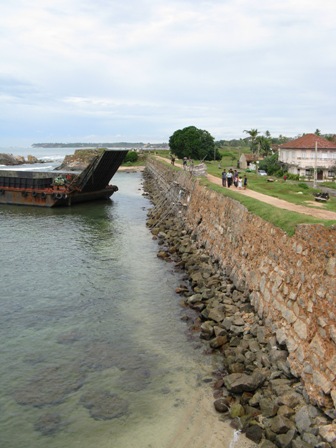 Part of old sea wall at Galle.[/caption]
Part of old sea wall at Galle.[/caption]
East of Galle, development is less rampant as a few beach towns between Galle and the Yala National Park’s western border haven’t all been swamped by tourism money making schemes.
We find some respite and crowd relief in tiny Talalla while staying in a pseudo-holistic beach resort. I say pseudo because the whole area is holistic. The beach is entirely devoid of large-scale development, a relief to ears and eyes. An evening walk in nearby Gandara provides a gift; a glimpse into Sri Lanka before war and political corruption wrecked a lot of lives. Even the 2004 tsunami’s after effects seem less dire here.
[caption id="attachment_1930" align="alignnone" width="448"]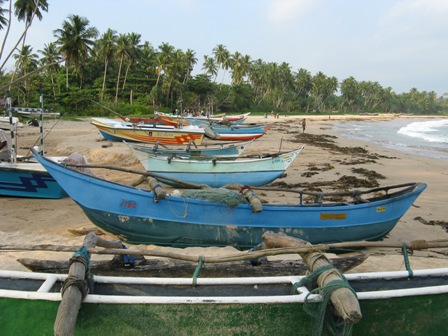 Fishing boats on beach at Talalla.[/caption]
[caption id="attachment_1917" align="alignnone" width="448"]
Fishing boats on beach at Talalla.[/caption]
[caption id="attachment_1917" align="alignnone" width="448"]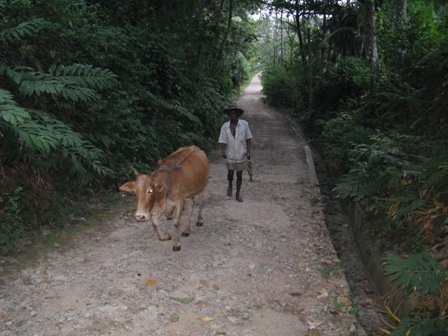 Koongaha Junction at Gandara village near Talalla.[/caption]
Koongaha Junction at Gandara village near Talalla.[/caption]
Beach combing attractions aside, Sri Lanka’s interior is historically, ecologically and culturally more interesting. We stop for a day at Pinnawalla elephant orphanage, checking out its reputation for admirable elephant care. Though it’s something of a tourist show, particularly when some of the orphanage’s elephants walk to the river for a daily bath, the whole place has an atmosphere of openness. Elephants roam freely among visitors though a couple of mature males in musth are chained to posts and visitors are warned away. Greater emphasis on education about these endangered animals would be beneficial but as an orphanage accessible to the general public, it’s not a bad place in which to begin an understanding of Asian elephants and their plight for safe habitats in overcrowded countries.
[caption id="attachment_1918" align="alignnone" width="448"] Pinnawalla Elephant Orphanage.[/caption]
Pinnawalla Elephant Orphanage.[/caption]
Kandy is a requisite stop. Sri Lanka’s holy city is the entry point to the central highlands and key to understanding the importance of Buddhism to the national identity. The Sri Dalada Magiwala (Sacred Tooth Temple) is the country’s most important religious shrine, an obligatory pilgrimage stop for any visit to Sri Lanka. Kandy is also the country’s cultural centre. Music and dance performances abound, some aimed at tourists, more at local celebrants. The central Kandy market is one of the country’s best. As the commercial focus for this small city’s permanent population, it’s the town's heart and the most important nexus in which to gauge how Kandy town differs greatly from Colombo city.
Tea plantations cover much of Sri Lanka’s interior. The town of Nuwara Eliya (meaning ‘City of Light’ or ‘City of the Plain’) is near the ecologically significant Horton Plains National Park and is more or less tea central. Great paddocks of tea plants (camellia sinensis) surround the whole area. The Victoria Park in the centre of town is worth visiting, if only to read signs indicating what not to do, wear, speak or behave. Prissy Victorian English mores took root in the highlands of Sri Lanka while remnant traditions remain. Much of Nuwara Eliya’s architecture is Anglo-Indian, a bit of the Raj in central Sri Lanka.
[caption id="attachment_1919" align="alignnone" width="448"]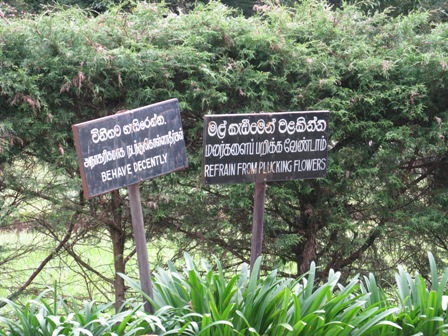 Nuwara Eliya Victoria Park warning signs.[/caption]
From Kandy, we drive haphazardly into the interior, our destination the Cultural Triangle. Here Sri Lanka’s kingdoms held sway over the whole of the island centuries ago. From the capital at Anuradhapura a great dynasty ruled. While other south Asian historic ruins: Angkor Wat, Ayutthaya and Borobudur are known to most travellers, Sri Lanka’s are not, which is a pity as they’re packed with architectural treasures. Since the fighting between the Tamil Tigers and the National Army ceased in 2010, the going is easier though occasional road blocks remain in place. The area around the Cultural Triangle was formerly the border zone caught between opposing sides. Now it’s well within control of the Sri Lankan Government. No matter your political views, the local people have suffered due to a lack of travellers from abroad and recovery is slow.
It’s very quiet in this region, few visitors are about. Police roadblocks check passing vehicles but we’re never bothered. As soon as they see a couple of foreigners in the clapped out van they wave us on with a smile. The Sri Lankan economy depends heavily on tourism. Combined disasters: the tsunami of 2004 and the internecine war fought for over thirty years have proved knock-out blows to international tourism. Two paramount concerns prevail: unemployment and lack of income. We are welcomed everywhere we go with open arms; clearly our visit is a boon for local businesses.
The road north from Kandy leads first to the evocatively mysterious cave temples at Dambulla. Its frescos and statues depicting the Buddha in numerous poses are marvels of painterly consistency and stony constancy. The Buddha’s smiles are so subtly different that the artisans crafting his serene visage must have had a master template from which to work. A few enormous statues barely fit into their gallery like caves, adapted to the natural contours of the sloping walls.
[caption id="attachment_1936" align="alignnone" width="448"]
Nuwara Eliya Victoria Park warning signs.[/caption]
From Kandy, we drive haphazardly into the interior, our destination the Cultural Triangle. Here Sri Lanka’s kingdoms held sway over the whole of the island centuries ago. From the capital at Anuradhapura a great dynasty ruled. While other south Asian historic ruins: Angkor Wat, Ayutthaya and Borobudur are known to most travellers, Sri Lanka’s are not, which is a pity as they’re packed with architectural treasures. Since the fighting between the Tamil Tigers and the National Army ceased in 2010, the going is easier though occasional road blocks remain in place. The area around the Cultural Triangle was formerly the border zone caught between opposing sides. Now it’s well within control of the Sri Lankan Government. No matter your political views, the local people have suffered due to a lack of travellers from abroad and recovery is slow.
It’s very quiet in this region, few visitors are about. Police roadblocks check passing vehicles but we’re never bothered. As soon as they see a couple of foreigners in the clapped out van they wave us on with a smile. The Sri Lankan economy depends heavily on tourism. Combined disasters: the tsunami of 2004 and the internecine war fought for over thirty years have proved knock-out blows to international tourism. Two paramount concerns prevail: unemployment and lack of income. We are welcomed everywhere we go with open arms; clearly our visit is a boon for local businesses.
The road north from Kandy leads first to the evocatively mysterious cave temples at Dambulla. Its frescos and statues depicting the Buddha in numerous poses are marvels of painterly consistency and stony constancy. The Buddha’s smiles are so subtly different that the artisans crafting his serene visage must have had a master template from which to work. A few enormous statues barely fit into their gallery like caves, adapted to the natural contours of the sloping walls.
[caption id="attachment_1936" align="alignnone" width="448"]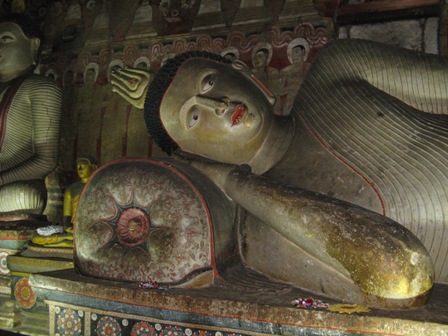 One of Dambulla's many reclining Buddha statues.[/caption]
Cool interiors and dimly lit spaces contrast dramatically with the heat and hard light outside. We’ve climbed hundreds of steps to reach the plateau where five caves extend in a line along a natural fold in the mountain. The statues were carved during the reign of King Valagamba (1st century BCE). Over 150 Buddha images may be seen here. I lose count after 80.
[caption id="attachment_1920" align="alignnone" width="448"]
One of Dambulla's many reclining Buddha statues.[/caption]
Cool interiors and dimly lit spaces contrast dramatically with the heat and hard light outside. We’ve climbed hundreds of steps to reach the plateau where five caves extend in a line along a natural fold in the mountain. The statues were carved during the reign of King Valagamba (1st century BCE). Over 150 Buddha images may be seen here. I lose count after 80.
[caption id="attachment_1920" align="alignnone" width="448"] Macaque monkey at Dambulla.[/caption]
Atop the terraced ledge from which the caves overlook surrounding countryside, I stop to gaze at monsoon drenched paddy fields and palm groves. Three silent macaque monkeys sitting lotus like in a tree branch directly above my head also take in the view. For a moment, I imagine they are calmed by the Buddha’s presence as me.
Though Sri Lanka is an island roughly the size of Tasmania, they have in common a perception of immensity. My eyes wander towards the central highlands, its highest elevations marking 2,000 plus metres. The sharp peaks, densely forested slopes and tea plantations make me wonder if I’m looking at a continent. It seems that big.
The volcanic outcrop of Sigiriya thrusts upwards. From the heights of Dambulla, the geological wonder that is Sigiriya stands alone. On a vast jungle plain criss-crossed by elephant tracks and dotted with small villages tucked away in swards of green, Sigiriya looks like a fantasy fortress. How the monks and their assistants built anything atop the sheer walled promontory is a wonder in itself.
[caption id="attachment_1921" align="alignnone" width="448"]
Macaque monkey at Dambulla.[/caption]
Atop the terraced ledge from which the caves overlook surrounding countryside, I stop to gaze at monsoon drenched paddy fields and palm groves. Three silent macaque monkeys sitting lotus like in a tree branch directly above my head also take in the view. For a moment, I imagine they are calmed by the Buddha’s presence as me.
Though Sri Lanka is an island roughly the size of Tasmania, they have in common a perception of immensity. My eyes wander towards the central highlands, its highest elevations marking 2,000 plus metres. The sharp peaks, densely forested slopes and tea plantations make me wonder if I’m looking at a continent. It seems that big.
The volcanic outcrop of Sigiriya thrusts upwards. From the heights of Dambulla, the geological wonder that is Sigiriya stands alone. On a vast jungle plain criss-crossed by elephant tracks and dotted with small villages tucked away in swards of green, Sigiriya looks like a fantasy fortress. How the monks and their assistants built anything atop the sheer walled promontory is a wonder in itself.
[caption id="attachment_1921" align="alignnone" width="448"] Sigiraya Fortress Monastery.[/caption]
The surrounding water gardens add to the overall impression that the whole complex is something of a miracle in its inception, much less its completion. Moats encompass the gardens, signs warning visitors not to get too close for fear of crocodiles and water monitors keep even the foolhardy from indulging in a cooling dip. Snakes hide in the rushes searching for frogs. Langurs and macaques loop from one tree to the next. The scene is Eden-esque, outwardly tamed but secretly wild. Making our way to the famous boulder gardens, ancient watercourses marking the path, a hornet’s nest is the only danger we encounter. The sign indicating the presence of the little beasties is one of the few modern touches, albeit a silly one. Evidently the best thing to do when encountering a swarm of angry hornets is to wave one’s arms furiously about whilst sprinting like an Olympian in pursuit of a gold medal.
[caption id="attachment_1922" align="alignnone" width="448"]
Sigiraya Fortress Monastery.[/caption]
The surrounding water gardens add to the overall impression that the whole complex is something of a miracle in its inception, much less its completion. Moats encompass the gardens, signs warning visitors not to get too close for fear of crocodiles and water monitors keep even the foolhardy from indulging in a cooling dip. Snakes hide in the rushes searching for frogs. Langurs and macaques loop from one tree to the next. The scene is Eden-esque, outwardly tamed but secretly wild. Making our way to the famous boulder gardens, ancient watercourses marking the path, a hornet’s nest is the only danger we encounter. The sign indicating the presence of the little beasties is one of the few modern touches, albeit a silly one. Evidently the best thing to do when encountering a swarm of angry hornets is to wave one’s arms furiously about whilst sprinting like an Olympian in pursuit of a gold medal.
[caption id="attachment_1922" align="alignnone" width="448"]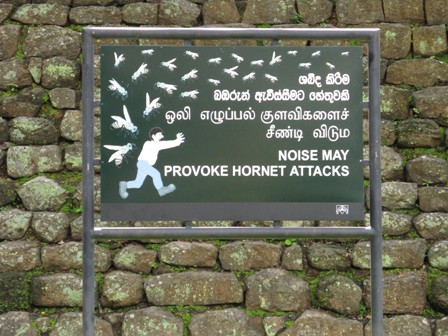 Hornet's nest warning sign at Sigiraya.[/caption]
Sigiriya’s history reveals much. Once believed to have been the fortress sanctuary of a 4th century CE king, archaeologists now consider that by the 3rd century BCE, Sigiriya was an important monastery devoted to Mahayana-Theravada Buddhism which also supported a thriving city. The whole monument was declared a UNESCO World Heritage Site in 1982.
Climbing to the top of Sigiriya is best done slowly. After a couple hours wandering around the ancient city's foundations, walls and gardens, we’re at the base of the fortress itself. Two huge carved lion’s paws, all that’s left of a gigantic leonine statue that guarded the entrance to the final ascent, grasp the bottom steps. It’s like passing between two stupendous costume party shoes. The Mirror Wall we pass on the way to the summit forms a long corridor that protects dizzy climbers from tumbling down the sheer rock face. A thousand years of graffiti adorns its glazed surface. Linguists have been studying versions of ‘I was here with Chamindah’ since Sigiriya was re-discovered in 1898 by the British archaeologist H.C.P. Bell. Early Sinhalese translated from the Mirror Wall has helped to understand its development into the national language.
Finally we reach the summit just in time for a soaking tropical downpour. We run for the nearest tree and wait under it with a couple of langur monkeys, a small flock of Indian mynah birds and three German women who, with us, are Sigiriya’s only foreign visitors that day. As suddenly as the rain begins, it disappears. Steam rises off the nearby plains. The sun beats hard again, instantly drying my soaked t-shirt. A rainbow caps off the whole panorama. I understand now why the monks were so inspired by this place. It does seem but a short step to Nirvana from here.
[caption id="attachment_1923" align="alignnone" width="448"]
Hornet's nest warning sign at Sigiraya.[/caption]
Sigiriya’s history reveals much. Once believed to have been the fortress sanctuary of a 4th century CE king, archaeologists now consider that by the 3rd century BCE, Sigiriya was an important monastery devoted to Mahayana-Theravada Buddhism which also supported a thriving city. The whole monument was declared a UNESCO World Heritage Site in 1982.
Climbing to the top of Sigiriya is best done slowly. After a couple hours wandering around the ancient city's foundations, walls and gardens, we’re at the base of the fortress itself. Two huge carved lion’s paws, all that’s left of a gigantic leonine statue that guarded the entrance to the final ascent, grasp the bottom steps. It’s like passing between two stupendous costume party shoes. The Mirror Wall we pass on the way to the summit forms a long corridor that protects dizzy climbers from tumbling down the sheer rock face. A thousand years of graffiti adorns its glazed surface. Linguists have been studying versions of ‘I was here with Chamindah’ since Sigiriya was re-discovered in 1898 by the British archaeologist H.C.P. Bell. Early Sinhalese translated from the Mirror Wall has helped to understand its development into the national language.
Finally we reach the summit just in time for a soaking tropical downpour. We run for the nearest tree and wait under it with a couple of langur monkeys, a small flock of Indian mynah birds and three German women who, with us, are Sigiriya’s only foreign visitors that day. As suddenly as the rain begins, it disappears. Steam rises off the nearby plains. The sun beats hard again, instantly drying my soaked t-shirt. A rainbow caps off the whole panorama. I understand now why the monks were so inspired by this place. It does seem but a short step to Nirvana from here.
[caption id="attachment_1923" align="alignnone" width="448"]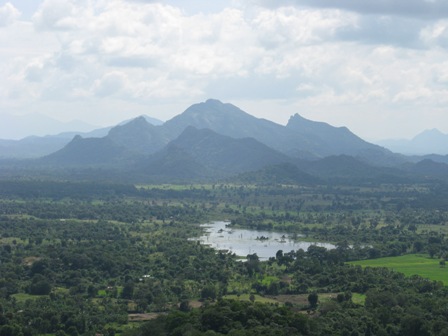 From atop Sigiraya the central highlands are very close.[/caption]
Days later at Mihintale, the sacred mountain where Buddhism was first introduced to Sri Lanka many centuries ago by the Emporer Ashoka’s son Prince Mahinda, we are met by a guide as soon as we step from the van. “Welcome! Welcome! You are my only guests today. Please let me show you this place.” Trained by the government’s archaeology unit, he is a source of informed wonder.
[caption id="attachment_1925" align="alignnone" width="448"]
From atop Sigiraya the central highlands are very close.[/caption]
Days later at Mihintale, the sacred mountain where Buddhism was first introduced to Sri Lanka many centuries ago by the Emporer Ashoka’s son Prince Mahinda, we are met by a guide as soon as we step from the van. “Welcome! Welcome! You are my only guests today. Please let me show you this place.” Trained by the government’s archaeology unit, he is a source of informed wonder.
[caption id="attachment_1925" align="alignnone" width="448"] Mihintale seated Buddha statue.[/caption]
We clamber along precarious ledges that hide the original sanctuaries, dug out by hermitic monks long before the ancient monastery itself was built. “The monks came here to meditate and commune with nature,” says our guide.
[caption id="attachment_1937" align="alignnone" width="448"]
Mihintale seated Buddha statue.[/caption]
We clamber along precarious ledges that hide the original sanctuaries, dug out by hermitic monks long before the ancient monastery itself was built. “The monks came here to meditate and commune with nature,” says our guide.
[caption id="attachment_1937" align="alignnone" width="448"] Government sign posted at Mihintale reminding visitors the sanctity of all life.[/caption]
A snake slips out of a cleft in a cave and I experience an Indiana Jones moment. “A good omen,” continues our fearless leader, “nature is everywhere here, you can sense it, feel how cool it is inside this cave.” I don’t really want to be in a cave where the snake just left but am drawn to it nonetheless. Hairs on my neck are at attention and I prefer to be back at the thousand year old stupa, or dagoba as it’s called in Sri Lanka, looking at the bas-reliefs sculptures of elephants, lions and peacocks. Instead I graze my scalp painfully on the low-slung rock ceiling, cursing my inattention while concentrating instead on imaginary slithering at my feet.
[caption id="attachment_1924" align="alignnone" width="336"]
Government sign posted at Mihintale reminding visitors the sanctity of all life.[/caption]
A snake slips out of a cleft in a cave and I experience an Indiana Jones moment. “A good omen,” continues our fearless leader, “nature is everywhere here, you can sense it, feel how cool it is inside this cave.” I don’t really want to be in a cave where the snake just left but am drawn to it nonetheless. Hairs on my neck are at attention and I prefer to be back at the thousand year old stupa, or dagoba as it’s called in Sri Lanka, looking at the bas-reliefs sculptures of elephants, lions and peacocks. Instead I graze my scalp painfully on the low-slung rock ceiling, cursing my inattention while concentrating instead on imaginary slithering at my feet.
[caption id="attachment_1924" align="alignnone" width="336"] Mihintale Dagoba.[/caption]
Later that day we stop at a 12 metre high standing Buddha, carved in the ‘ashiva mudra’ (blessing) pose out of a rock cliff in the middle of nowhere. The Buddha at Aukana is surely off the beaten path; we are the only non-Sri Lankans among the pilgrims who come here to pray at Buddha’s feet. Aukana means ‘sun-eating’, morning is the best time to visit it. So masterfully executed in its proportions that I’m assured a single drop of water descending from the Buddha’s forehead will fall precisely halfway between his feet resting on a huge lotus plinth. Of course I wait to see it for myself and am pleased to see the splash between Buddha’s toes.
[caption id="attachment_1926" align="alignnone" width="336"]
Mihintale Dagoba.[/caption]
Later that day we stop at a 12 metre high standing Buddha, carved in the ‘ashiva mudra’ (blessing) pose out of a rock cliff in the middle of nowhere. The Buddha at Aukana is surely off the beaten path; we are the only non-Sri Lankans among the pilgrims who come here to pray at Buddha’s feet. Aukana means ‘sun-eating’, morning is the best time to visit it. So masterfully executed in its proportions that I’m assured a single drop of water descending from the Buddha’s forehead will fall precisely halfway between his feet resting on a huge lotus plinth. Of course I wait to see it for myself and am pleased to see the splash between Buddha’s toes.
[caption id="attachment_1926" align="alignnone" width="336"] Aukana Standing Buddha.[/caption]
Anuradhapura became the capital in 380BCE and ruled greater Sri Lanka for nearly a thousand years. It spreads out over a vast area at the boundary of modern Anuradhapura, a frontier town at the edge of the formerly Tamil Tiger controlled north. Here the modern and ancient mingle loosely. High rise dagobas stand out as they did hundreds of years ago. Soldiers stand at gates striking poses probably like they did when this was the centre of a highly militarised society constantly defending itself from southern Indian invaders.
[caption id="attachment_1927" align="alignnone" width="336"]
Aukana Standing Buddha.[/caption]
Anuradhapura became the capital in 380BCE and ruled greater Sri Lanka for nearly a thousand years. It spreads out over a vast area at the boundary of modern Anuradhapura, a frontier town at the edge of the formerly Tamil Tiger controlled north. Here the modern and ancient mingle loosely. High rise dagobas stand out as they did hundreds of years ago. Soldiers stand at gates striking poses probably like they did when this was the centre of a highly militarised society constantly defending itself from southern Indian invaders.
[caption id="attachment_1927" align="alignnone" width="336"]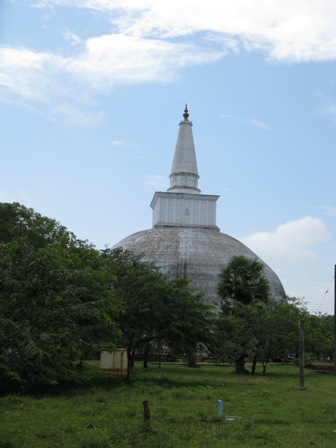 Sacred collarbone Dagoba at Anuradhapura.[/caption]
Despite the army falderal, Anuradhapura’s main claim to eternal fame is Sri Maha Bodhi, the sacred bodhi tree. Grown from a cutting, it was taken from the Tree of Enlightenment at Bodhgaya in India by Princess Sangamitta, sister of Prince Mahinda who introduced Buddhism at Mihintale. The Sri Maha Bodhi is the world’s oldest authenticated tree, successively guarded for over 2,000 years even during foreign occupation. This is one of Sri Lanka’s holiest sites, indeed it is for all Buddhists. Unlike the Buddha’s Sacred Tooth Temple in Kandy and Sri Pada (Adam’s Peak) where Buddha supposedly left a footprint while he ascended to heaven, here fellow travellers are few and far between. The aura is palpable, it is an enchanted scene though not at all like many of the world’s other holy places. Monkeys tease the temple’s cats, dogs leap about playing with one another, there is much laughter and people idle away the time while they make puja, chat, pray and gossip. It’s all so relaxed, family friendly and peaceful that I almost forget that I’m standing in front of the world’s oldest sacred tree. I think the Buddha would have liked that. And if this isn’t enough to satisfy an ardent Buddha relic collector, the most ancient visible stupa in the world, the nearby Thuparama Dagoba is said to house the Buddha’s right collarbone.
Anuradhapura is packed with temples, holy lakes, dagobas and palaces. Moonstones and accompanying guard stones are scattered liberally around the ruins. Inscribed with intricate carvings signifying steps taken on the path to Nirvana, these temple platforms educate acolytes and visitors alike. I am entranced that so many bare feet have been here before mine but, on the road to Nirvana, we’re all blessed with our own personal point of view.
[caption id="attachment_1929" align="alignnone" width="448"]
Sacred collarbone Dagoba at Anuradhapura.[/caption]
Despite the army falderal, Anuradhapura’s main claim to eternal fame is Sri Maha Bodhi, the sacred bodhi tree. Grown from a cutting, it was taken from the Tree of Enlightenment at Bodhgaya in India by Princess Sangamitta, sister of Prince Mahinda who introduced Buddhism at Mihintale. The Sri Maha Bodhi is the world’s oldest authenticated tree, successively guarded for over 2,000 years even during foreign occupation. This is one of Sri Lanka’s holiest sites, indeed it is for all Buddhists. Unlike the Buddha’s Sacred Tooth Temple in Kandy and Sri Pada (Adam’s Peak) where Buddha supposedly left a footprint while he ascended to heaven, here fellow travellers are few and far between. The aura is palpable, it is an enchanted scene though not at all like many of the world’s other holy places. Monkeys tease the temple’s cats, dogs leap about playing with one another, there is much laughter and people idle away the time while they make puja, chat, pray and gossip. It’s all so relaxed, family friendly and peaceful that I almost forget that I’m standing in front of the world’s oldest sacred tree. I think the Buddha would have liked that. And if this isn’t enough to satisfy an ardent Buddha relic collector, the most ancient visible stupa in the world, the nearby Thuparama Dagoba is said to house the Buddha’s right collarbone.
Anuradhapura is packed with temples, holy lakes, dagobas and palaces. Moonstones and accompanying guard stones are scattered liberally around the ruins. Inscribed with intricate carvings signifying steps taken on the path to Nirvana, these temple platforms educate acolytes and visitors alike. I am entranced that so many bare feet have been here before mine but, on the road to Nirvana, we’re all blessed with our own personal point of view.
[caption id="attachment_1929" align="alignnone" width="448"] There's always a smile to be found in Sri Lanka.[/caption]
Naked Facts:
Getting There:
Malaysian Airways has excellent connections via its hub in Kuala Lumpur to Colombo. Alternatively Singapore Airlines has flights to Colombo via Singapore. Air Lanka flies from Europe and major Indian cities to Colombo.
Anuradhapura is approximately 200 kilometres north of the national capital Colombo. From Colombo there is a daily train to Anuradhapura. Beware it is unreliable. Hire cars and drivers may be arranged from major hotels in Colombo.
Naked Sleeps:
The Palm Garden Village located roughly 6 kilometres from Anuradhapura is a joint Italian-Sri Lankan owned hotel in a huge, extravagantly lush garden setting. All rooms are in villas or duplexes and widely spread throughout the 38 hectare property. A huge pool is rarely used, making a swim an inviting pastime between temple visits. A boutique selling discounted Italian fashion adjoins the bar and restaurant area. There is also an Ayurvedic spa on the premises that offers massages and facial treatments. A large lake and preserve at the rear of the property is frequently visited by wild elephants. Guests are warned not to wander alone at night because of them. www.palmgardenvillage.com
Rates: approximately USD$100 per night including breakfast.
[caption id="attachment_1931" align="alignnone" width="448"]
There's always a smile to be found in Sri Lanka.[/caption]
Naked Facts:
Getting There:
Malaysian Airways has excellent connections via its hub in Kuala Lumpur to Colombo. Alternatively Singapore Airlines has flights to Colombo via Singapore. Air Lanka flies from Europe and major Indian cities to Colombo.
Anuradhapura is approximately 200 kilometres north of the national capital Colombo. From Colombo there is a daily train to Anuradhapura. Beware it is unreliable. Hire cars and drivers may be arranged from major hotels in Colombo.
Naked Sleeps:
The Palm Garden Village located roughly 6 kilometres from Anuradhapura is a joint Italian-Sri Lankan owned hotel in a huge, extravagantly lush garden setting. All rooms are in villas or duplexes and widely spread throughout the 38 hectare property. A huge pool is rarely used, making a swim an inviting pastime between temple visits. A boutique selling discounted Italian fashion adjoins the bar and restaurant area. There is also an Ayurvedic spa on the premises that offers massages and facial treatments. A large lake and preserve at the rear of the property is frequently visited by wild elephants. Guests are warned not to wander alone at night because of them. www.palmgardenvillage.com
Rates: approximately USD$100 per night including breakfast.
[caption id="attachment_1931" align="alignnone" width="448"]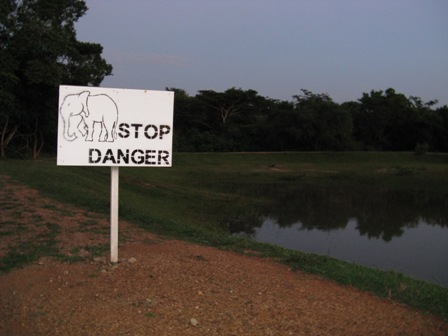 Elephant warning sign at Palm Garden Village hotel.[/caption]
The Galle Fort hotel is stunning. See www.galleforthotel.com for bookings. It is one of the best small hotels in all Sri Lanka.
The Hilton Colombo is very good and in an excellent location. The food in its restaurants is some of the best in town. See www3.hilton.com/en/hotels/sri-lanka
The Villa Rosa outside Kandy is lovely. See www.villarosa-kandy.com A boutique hotel with loads of atmosphere, fine service and great location overlooking Kandy’s sacred river.
[caption id="attachment_1932" align="alignnone" width="448"]
Elephant warning sign at Palm Garden Village hotel.[/caption]
The Galle Fort hotel is stunning. See www.galleforthotel.com for bookings. It is one of the best small hotels in all Sri Lanka.
The Hilton Colombo is very good and in an excellent location. The food in its restaurants is some of the best in town. See www3.hilton.com/en/hotels/sri-lanka
The Villa Rosa outside Kandy is lovely. See www.villarosa-kandy.com A boutique hotel with loads of atmosphere, fine service and great location overlooking Kandy’s sacred river.
[caption id="attachment_1932" align="alignnone" width="448"]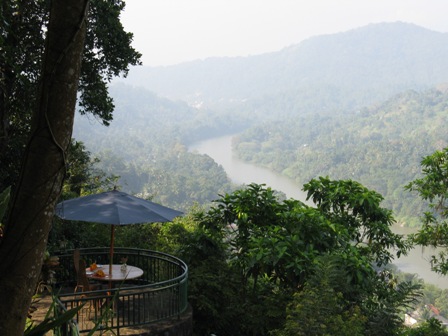 View from Villa Rosa terrace near Kandy.[/caption]
View from Villa Rosa terrace near Kandy.[/caption]
Sri Lanka’s official tourism website: www.srilankatourism.org is recommended for hotel and internal travel recommendations.
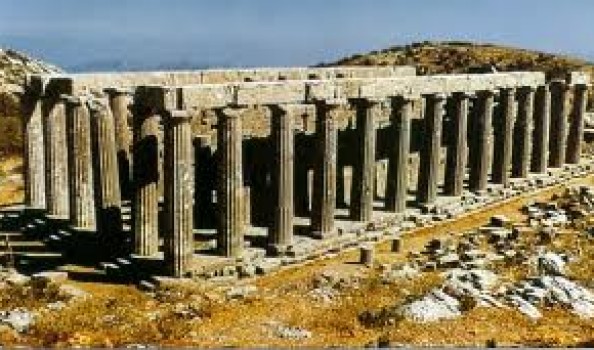 https://nakedhungrytraveller.com.au/greece-is-the-word/ Greece Is The Word
https://nakedhungrytraveller.com.au/greece-is-the-word/ Greece Is The WordGreece is going through a rough time. Unemployment is high and wages have nose-dived. What hasn’t changed is Greek hospitality, which continues to be boisterously generous. Though times may be hard, the Greek spirit is strong.
If Greece has a heartland, arguably the Peloponnese is it. Many of the nation’s most famous ruins are here: Olympia, Epidaurus, Mycenae, Corinth and Sparta spring immediately to mind. Less known is the temple of Bassae dedicated to Apollo Epikourios, or Apollo the Helper.
[caption id="attachment_1817" align="alignnone" width="448"] Temple of Bassae (Vassae) before being covered for restoration.[/caption]
Temple of Bassae (Vassae) before being covered for restoration.[/caption]
Built in the 5th century BCE, designed by Iktinos (architect of Athens’ Parthenon and Temple of Hephaestus), it’s one of the best preserved monuments in all of ancient Greece. The setting is magnificent, high up in the Arcadian mountains (now part of the province of Messenia), the site commands its position just as you’d expect a temple dedicated to the supreme sun god would.
At over 1,100 metres in a little valley on the side of Mount Kotylion, Bassae was effectively saved by its remoteness. Most ancient temples were altered to serve Christianity or worse, destroyed as examples of paganism.
[caption id="attachment_1822" align="alignnone" width="336"]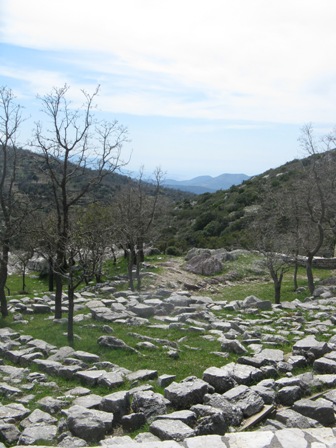 View to south from Temple of Bassae.[/caption]
View to south from Temple of Bassae.[/caption]
Bassae survived because it was (and is) so far off the beaten track, nearly everyone forgot it.
The first time I visited, I was simply awe-struck. The temple stood alone in a near perfect state of preservation. Acid rain hadn’t taken much of a toll on its limestone and marble, though snow and ice had caused cracks to appear in some of the pillars. Now the temple is covered by a huge tent while restoration work is undertaken.
[caption id="attachment_1820" align="alignnone" width="336"]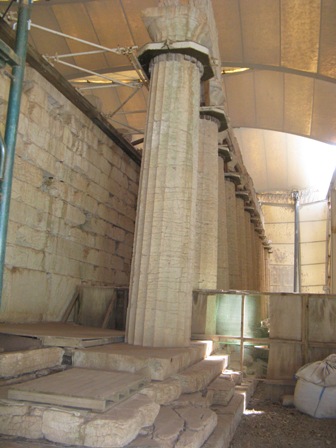 Bassae temple under cover for restoration.[/caption]
Bassae temple under cover for restoration.[/caption]
The light on Apollo’s house isn’t so bright these days. Hopefully, when the work is completed it will be uncovered to the sun and elements as I believe it should be.
A narrow two-lane road winds up the mountain from tiny Andritsena to Bassae. Signs to the temple are few and not clearly marked. In winter the road is mostly impassable and I definitely wouldn’t want to be caught up there during a summer’s lightning storm. The site is very exposed but the views, particularly to the south are magnificent. On a clear day, the blue sea glimmers mirror like in the far distance.
[caption id="attachment_1823" align="alignnone" width="448"]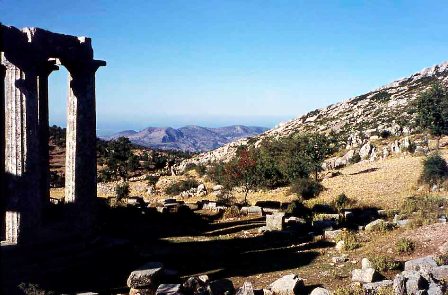 View from temple of Bassae.[/caption]
View from temple of Bassae.[/caption]
There is no nearby accommodation. Andritsena is approximately 15 kilometres away, plenty of pension guesthouses and small hotels there.
Walks around the mountains and valleys from Andritsena are the best way to explore this beautiful pocket of Arcadia.
[caption id="attachment_1784" align="alignnone" width="448"]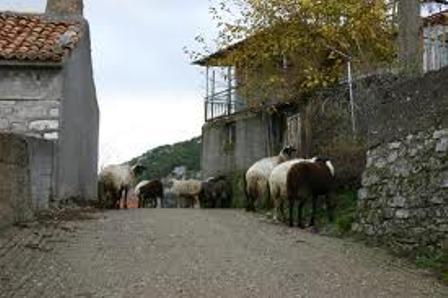 Andritsena street with sheep and goats.[/caption]
[caption id="attachment_1783" align="alignnone" width="448"]
Andritsena street with sheep and goats.[/caption]
[caption id="attachment_1783" align="alignnone" width="448"] Andritsena seen from eastern approach.[/caption]
Andritsena seen from eastern approach.[/caption]
I had the whole temple and its surrounds to myself during my first visit. There were no other travellers on that autumn day years ago. Recently, I repeated the experience. On a perfect spring’s day, I had the place to myself again. Three Israeli travellers left ten minutes after I arrived. I was alone at Apollo’s sanctuary for the next two hours.
Bassae was inscribed on to the World Heritage List in 1986, the first ancient site in Greece. What’s it like having a UNESCO World Heritage site all on your lonesome for a day?
I felt privileged of course. Then I felt completely alone. The wind whistled through poppy flowers and wild olives. Scattered around the site white limestone boulders glistened in bright sunshine, remainders of the thriving ancient sanctuary. I was reminded again of an essential fact: we come into this world alone and we leave it the same way. People we meet along the way, loves lost, loves gained; constant friendships are what matter most but sometimes it’s necessary to be alone. Better to understand the journey.
I returned to Greece for nostalgic reasons. Always one of my favourite countries, it has also confounded me while simultaneously delighting me.
Over the years my feelings haven't changed much.
An old friend once told me, ‘Never forget that Greece is halfway between Italy and Syria and it has a lot more in common with Syria.’ He was being a wag, but a Grecophile wag nonetheless.
Syria’s current crisis is an ongoing disaster driven primarily by religious differences, a dispute over land rights and the corrupt Assad regime. Syria is obviously not Greece.
Italy’s latest national election illustrated continuing political dramas. For an advanced European nation with a sizeable economy, Italy is a country whose factional differences cause it to lurch from right to left or left to right like a pendulum that never reaches equilibrium. Italy is obviously not Greece.
Greece however is still caught between the two, half occidental, half oriental. Leaving religious histories aside, Greece has more in common with Turkey than it has with Spain, despite the Mediterranean connection.
Government mismanagement has taken a huge toll on Greece's economy. Wealthy Greeks are masters at hiding income as tax evasion has almost become the national pastime. More money leaves Greece than stays in it and now the whole country has come to a virtual standstill while a new government sorts out its relationship with the EU. Funds provided by the EU were spent somewhat recklessly or worse still, squandered on political follies.
Proud hard working middle class Greeks, whose incomes have been severely reduced or cut altogether have been reduced to begging for medications, food and shelter.
In a society where family relationships still remain preeminent, rates of homelessness have sky-rocketed.
Latest data indicates a shift towards a less dire economic situation but the problems will never be solved until Greeks understand that paying taxes is a civic duty. If they're not happy with how their politicians spend the revenue, vote them out.
It's a curious scenario to witness such extreme political alienation in the land that birthed democracy. All Greeks have been affected by the economic disaster.
Maybe I’ll never fully understand Greece but I’ll continue to try. The countryside is blessed with stunning natural beauty. Greek reliance on hospitality as a key national character trait, though challenged, continues to be the cultural norm. Historical patrimony remains an international draw card and Greeks are rightly proud of their past.
During this recent visit, the Peloponnese drew me into its charms once again.
I hired a car in Athens and headed west along the new motorway. Since the Athens Olympics of 2004, Greece was afforded more funds from the EU to improve infrastructure projects, spanking new motorways among them.
The trip to Corinth from Athens’ new airport took fewer than two hours. Not so long ago, the road west to the Peloponnese was overcrowded and narrow. The same journey could take up to six hours, particularly on holiday weekends when upwardly mobile Athenians left town for their country villas.
Zipping past modern Corinth, as ever the mountain outcrop of ancient Acro-Corinth looming over the gulf and surrounding countryside, signalling the end of urban sprawl, I sped onwards towards Tripoli, exiting the motorway at the road to Vytina, my base for a few days exploration of the province once called Morea by Venetian and Ottoman conquerors and Arcadia by classical Greeks.
Vytina has grown into a get-away spot for townies trying to escape the city’s hubbub while international travellers focus on island hopping or getting as quickly as possible from Delphi to Olympia and back to Athens.
Random and narrow back lanes criss-cross the countryside around Vytina. I got lost a number of times while searching for a shrine to Theodoros Kolokotronis. The shrine became a chimera of sorts; I never found it. Instead I discovered a sacred spring and a tiny chapel in the woods.
No one else was there, a state I was getting used to after a few days in this part of the Peloponnese.
[caption id="attachment_1824" align="alignnone" width="448"] Vytina's central square.[/caption]
[caption id="attachment_1828" align="alignnone" width="336"]
Vytina's central square.[/caption]
[caption id="attachment_1828" align="alignnone" width="336"]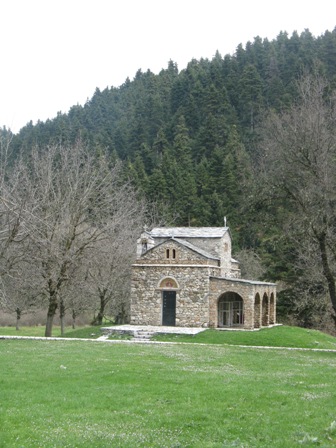 Deserted country chapel outside Vytina.[/caption]
[caption id="attachment_1812" align="alignnone" width="336"]
Deserted country chapel outside Vytina.[/caption]
[caption id="attachment_1812" align="alignnone" width="336"]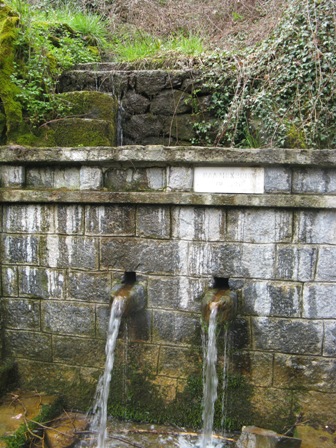 Sacred spring outside Vytina.[/caption]
[caption id="attachment_1825" align="alignnone" width="448"]
Sacred spring outside Vytina.[/caption]
[caption id="attachment_1825" align="alignnone" width="448"]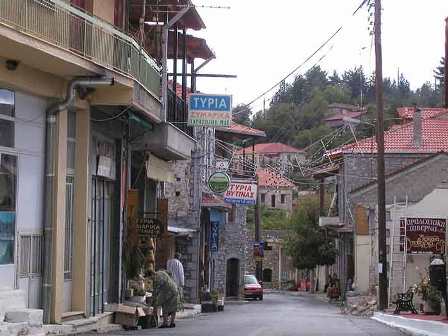 Vytina's main street.[/caption]
Vytina's main street.[/caption]
Many villages have emptied, there’s no work and people leave to seek work in the big cities. The countryside is depopulated as a consequence.
But some villages survive. Domestic tourism helps while wealthy Athenians use parts of ancient Arcadia as boltholes to escape Athens’ summer heat and crowds. International travellers stick to the traditional archaeological sites, the route from Mycenae to Epidaurus to Olympia, across the new Rion-Antirion bridge to Delphi and back to Athens, mostly giving the Peloponnesian interior a big miss.
Three villages are considered the gems of upper Arcadia: Vytina, Dimitsana and Stemnitsa.
[caption id="attachment_1792" align="alignnone" width="270"] Dimitsana Stemnitsa road sign.[/caption]
Dimitsana Stemnitsa road sign.[/caption]
Mostly overlooked by travellers, this isn’t the Greece of tourism brochures and online entreaties. No white houses or sandy beaches here. Instead, russet tiled roofs, grey stone houses, pine forests, isolated valleys and snow-capped mountains dominate the central Peloponnese highlands.
Roads are rough, not well signed and mostly empty. The only traffic I encounter is on the motorway leaving Athens. Sheep cross the road willy-nilly. Shepherds are moving their flocks to summer pastures higher up the mountains. Donkeys graze along roadsides while chickens peck at grubs emerging in warmer weather.
[caption id="attachment_1829" align="alignnone" width="336"]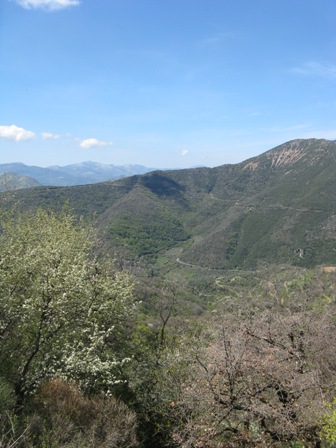 Typical mountain roads in Arcadia.[/caption]
[caption id="attachment_1796" align="alignnone" width="259"]
Typical mountain roads in Arcadia.[/caption]
[caption id="attachment_1796" align="alignnone" width="259"]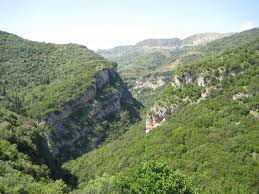 Loussios River Gorge below Dimitsana.[/caption]
Loussios River Gorge below Dimitsana.[/caption]
The Loussios River flows through a canyon below Dimitsana.
A track follows the river for approximately ten kilometres and is one of the region’s best walks. In summer local operators run white water rafting trips through the Loussios Gorge.
Walkers should beware that during heavy rains the river rises very quickly and may inundate the track.
[caption id="attachment_1800" align="alignnone" width="259"]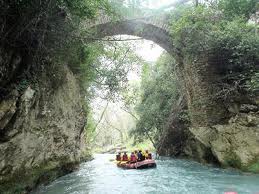 Loussios River rafting.[/caption]
[caption id="attachment_1799" align="alignnone" width="230"]
Loussios River rafting.[/caption]
[caption id="attachment_1799" align="alignnone" width="230"] Loussios River canyon below Dimitsana.[/caption]
Loussios River canyon below Dimitsana.[/caption]
Both Stemnitsa and Dimitsana are stunningly sited villages, perched almost precariously along steep ridgelines with cliffs falling away on both sides of each village.
This part of the Peloponnese was integral in the Greek War of Independence between 1821 and 1832, sheltering many of its heroes during the revolutionary period that heralded the birth of the Greek state.
[caption id="attachment_1813" align="alignnone" width="246"]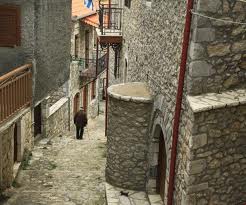 Stemnitsa laneway.[/caption]
[caption id="attachment_1809" align="alignnone" width="275"]
Stemnitsa laneway.[/caption]
[caption id="attachment_1809" align="alignnone" width="275"]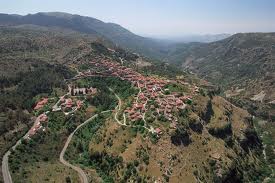 Dimitsana seen from road.[/caption]
Dimitsana seen from road.[/caption]
The revolutionary hero and general, Theodoros Kolokotronis, controlled many of his battle campaigns against the Ottoman Turks from a base in Stemnitsa. I never did find the shrine dedicated to his memory. No matter, the wild country still evokes places where an old revolutionary could easily hide out even today.
By the way, his son Ioannis Kolokotronis, (nicknamed ‘Gennaios’, meaning ‘brave’) was baptised in Stemnitsa. He later became the last Prime Minister to serve under King Otto.
[caption id="attachment_1815" align="alignnone" width="259"]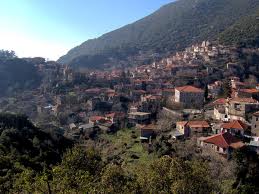 Stemnitsa village.[/caption]
[caption id="attachment_1789" align="alignnone" width="194"]
Stemnitsa village.[/caption]
[caption id="attachment_1789" align="alignnone" width="194"]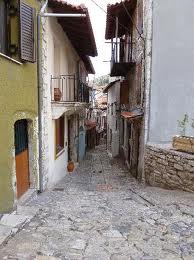 Dimitsana laneway.[/caption]
Dimitsana laneway.[/caption]
From Arcadia I visited Napflio, the first capital of the Greek Hellenic Republic from 1821 until 1834 when the capital was moved to Athens. It was the capital of the ‘Kingdom of Morea’ under Venetian rule in the late 17th and early 18th centuries until the Ottomans captured the city in 1715. The Venetians built the enormous Palamidi castle to protect it from Ottoman invasion, to no avail obviously. The Ottoman Turks recaptured Napflio anyway.
[caption id="attachment_1787" align="alignnone" width="448"]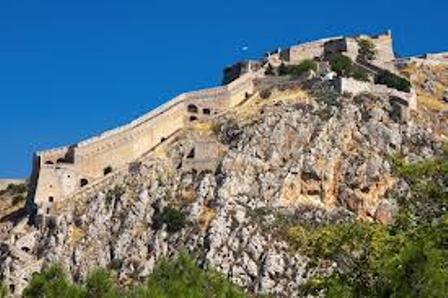 Palamidi Castle in Napflio.[/caption]
[caption id="attachment_1805" align="alignnone" width="259"]
Palamidi Castle in Napflio.[/caption]
[caption id="attachment_1805" align="alignnone" width="259"]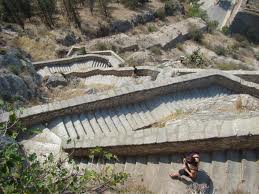 Path up to Palamidi Castle.[/caption]
Path up to Palamidi Castle.[/caption]
The path up to Palamidi Castle is steep but the view from atop is well worth the effort.
It was the Venetian empire’s last major construction undertaken overseas. The castle dominates the city to this day. That’s quite a history for a small, albeit ancient, city.
[caption id="attachment_1785" align="alignnone" width="448"]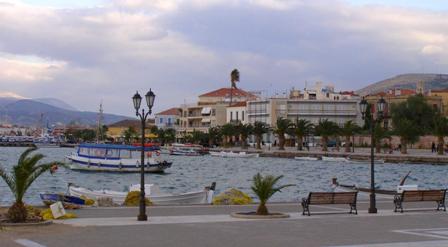 Harbour esplanade at Napflio.[/caption]
[caption id="attachment_1801" align="alignnone" width="271"]
Harbour esplanade at Napflio.[/caption]
[caption id="attachment_1801" align="alignnone" width="271"]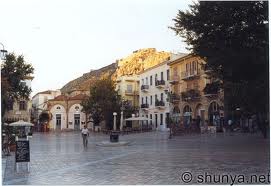 Napflio's main square.[/caption]
Napflio's main square.[/caption]
Napflio makes an excellent base from which to explore nearby sites such as Epidaurus, Mycenae and Tyrins with its original Cyclopean walls.
Nowadays, Napflio is a fairly laid-back seaside town on the Argolic Gulf, again overlooked by most international travellers. Most of the narrow central streets are reserved for pedestrians only and the harbour esplanade is quite lovely.
It’s a place that embraces the sea and its history in equal measures. The seaside walk leading from town to a beach and camping site some ten kilometres along the Argolic Gulf is simply wonderful. Napflio is a town made for walking.
[caption id="attachment_1803" align="alignnone" width="336"] Napflio sea walk.[/caption]
Napflio sea walk.[/caption]
The Peloponnese has a special place in my own heart. It’s where I first fell in love with this always consternating sometimes crazy country. That loving feeling has been constant ever since I fell under the spell of lonely Bassae and Arcadian vales.
Go there. I hope you feel the same way.
[caption id="attachment_1795" align="alignnone" width="448"]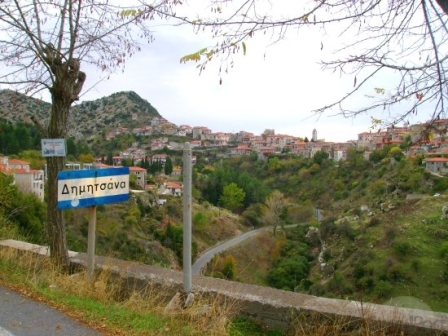 Dimitsana is this way.[/caption]
Dimitsana is this way.[/caption]
Naked Facts:
Rather than visiting Greece on a packed super-ship cruising the islands or on board a full coach touring the major archaeological sites, consider a small scale alternative, the do-it-yourself option with local help.
Two smart entrepreneurial Greek women started an unusual hotel booking service business a few years ago. While travelling around their beloved homeland they’ve sought out small privately owned and run hotels, brought them together under one banner and put their collection out to the travelling public.
Before this bespoke booking service was created, ‘buyer beware’ circumstances governed internet searches for boutique country accommodation in Greece. Small inns or farm stays chosen at random via an internet search may not always prove to be so attractive when experienced in person. Hard enough suffering the consequences of making unfortunate choices; consider also the time spent organising multiple accommodation selections. Anyone trying to arrange sequential hotel bookings unless fluent in Greek, would find the process difficult. Not anymore.
I stayed in Napflio at the Omorfi Poli Hotel, six rooms in a beautifully restored townhouse a few minutes walk from the town’s harbour and its assortment of waterside restaurants and cafes.
[caption id="attachment_1807" align="alignnone" width="140"]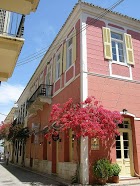 Pension Omorfi Poli.[/caption]
Pension Omorfi Poli.[/caption]
After a few nights I felt like a member of a family, just what I needed after weeks of travelling solo.
[caption id="attachment_1808" align="alignnone" width="148"] Pension Omorfi Poli from street.[/caption]
Pension Omorfi Poli from street.[/caption]
The Guest Inn collection is a carefully selected group of reasonably priced small family run guesthouses spread around the country, many of them in off-the-beaten-track locations.
See www.guestinn.com for details, suggested itineraries and bookings.
In Vytina, I stayed at another family run hotel, the Grand Vytina. It’s not really a grand hotel, more a typical middle-ranged boutique guesthouse. Rooms are well maintained but basic. Breakfast was very ordinary.
[caption id="attachment_1830" align="alignnone" width="448"]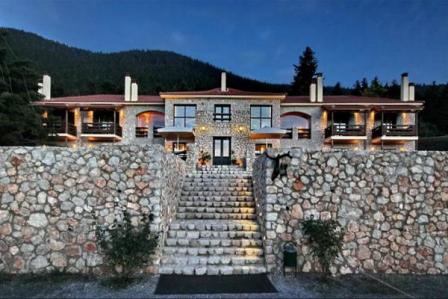 Grand Vytina hotel.[/caption]
Grand Vytina hotel.[/caption]
The best thing about the Grand Vytina is its location about 500 metres pleasant walk from the town centre.
Naked Eating:In Vytina, the Taverna Klimataria is the best in town. Run by a lovely couple, Eleni and Theodoros, (Eleni’s English is excellent), the menu is entirely comprised of locally sourced produce cooked with care and love. Arcadian honey is also sold here.
In Napflio the restaurants Amalou on the town’s main central square and Omorfi Napflio on the harbour esplanade walk are both recommended. I ate reasonably good meals in both, though friendly service won out over slightly above average food.
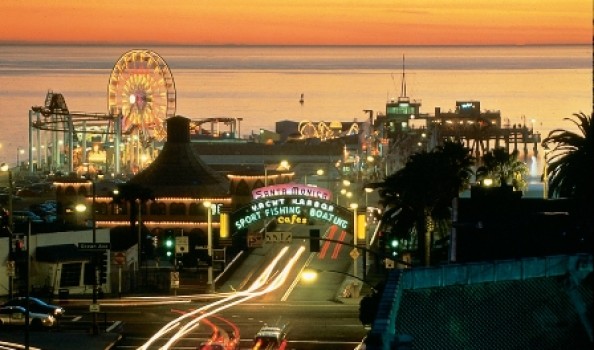 https://nakedhungrytraveller.com.au/santa-monica-end-of-the-road/ Santa Monica, End of the Road
https://nakedhungrytraveller.com.au/santa-monica-end-of-the-road/ Santa Monica, End of the RoadLA is a megalopolis.
I keep trying to get my head around its ever increasing expansion but it’s a tough mental challenge.
Santa Monica is like an escape hatch from urban sprawl. It’s a perfect town within a city so why not make it a base of operations while exploring the rest of LA?
[caption id="attachment_1730" align="alignnone" width="448"]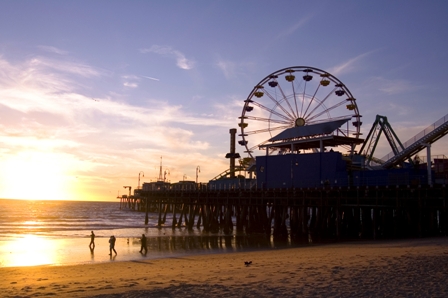 The Ferris wheel at the end of Santa Monica's pier.[/caption]
The Ferris wheel at the end of Santa Monica's pier.[/caption]
According to Mapping LA Project’s 2010 data, 272 neighbourhoods co-exist as separate entities within the city’s official limits. This doesn’t include the suburbs outside Los Angeles’ boundary lines.
Los Angeles County contains another 87 incorporated cities in addition to Los Angeles city itself.
The LA megalopolis of Orange, Ventura, San Bernardino and Riverside counties list well over another 100 incorporated cities, with new names being added yearly.
Over 50 years ago, the wonderfully acerbic New York based writer Dorothy Parker worked for a time as a Hollywood scriptwriter. She described Los Angeles as, ’72 suburbs in search of a city’.
Parker’s description still resonates today.
By 2013, some 15 million people are claimed by official census counts to live in greater LA but that number is surely a cautious underestimate. Migrants from round the world, but primarily from Central and South America, add hundreds of thousands more to the population tally, albeit unofficially.
LA has a kind of downtown but it’s nothing at all like New York City’s or Chicago’s downtowns, both of which are easily located on maps and criss-crossed by public transport networks.
Seen from space, LA sprawls ever outwards at the speed of light like a whirling galaxy lit by an infinite number of car headlights.
Yes, this is the original smog city. Cars rule LA. Despite an impressive underground rail network systematically embedded into the grid since 1990 (Metro Rail: six lines, a mix of heavy and light rail currently operate, boasting just over 360,000 customers per average weekday) that mixes and connects with the city’s rapid transit bus service, LA is still almost entirely consumed by roads packed with millions of vehicles.
So, how does a traveller cope with this kind of geographical enormity?
Driving is not recommended. It takes more than two hours, even on a slow traffic day just to cross from The Valley (San Fernando Valley) to Long Beach.
Surely, a travelling life is too short to be wasted sitting in traffic on an LA freeway.
I suggest a stay-put-and-focus-on-a-few-neighbourhoods-approach. Grasping the sheer scope of LA’s depth and breadth is easier this way.
One of the oldest registered towns in greater LA, indeed California, is Santa Monica, a perfect place to stay put while making sense of LA’s vastness.
Beachside, funky, gentrified but not dead, expensive, cheap, colourful and best of all, fairly central to whatever the centre of LA actually is, are descriptions that come to mind when I consider Santa Monica.
[caption id="attachment_1731" align="alignnone" width="448"] A section of Santa Monica's 3rd St Promenade, where the shopping is seriously good.[/caption]
A section of Santa Monica's 3rd St Promenade, where the shopping is seriously good.[/caption]
It’s not Hollywood boho, nor is it Beverly Hills chic. It’s not way out weird, retro-hippy stoner-ville Venice, though Venice’s beach is just a few kilometres down from Santa Monica’s beach. Uber-rich Malibu is just a few kilometres up the same beach road for comparison’s sake. To its east are sky-scrapered downtown LA, corporatised Culver City and Century City and one of America’s oldest Chinatowns.
The horrendous LAX isn’t too far away either, close enough to facilitate an easy escape and far enough so jet engine noise is beyond hearing.
In short, you could do far worse when considering a pleasant base in which to settle during a visit to La-La Land.
Blessedly bordered by a typical LA beach, wide, windswept, usually crowded and equally blessed by well maintained public gardens and parks, Santa Monica is the sort of LA suburb that seems a tiny bit like paradise secreted into an urban hell.
There are cool, trendy star-spotted restaurants. There’s also a scattering of down-home diners in traditional American style where a breakfast of Mexican omelette, hashed brown potatoes, bacon and endless cups of bad coffee will cost less than USD$15, toast, jam and butter included.
There are beachside bars that rival those in Cannes or Venice for film celebrity spotting. And there are bars that can best be described as dives but perfect for meeting local characters who aren’t in show business, or they used to be but don’t want to talk about it anymore.
So what’s essential to a visit in Santa Monica? Apart from strolling up and down the beach walk, don’t miss the famous Santa Monica Pier. Here is where tourists collect like bees to a queen that’s loaded with honey. It’s the photo money shot, a great place to watch the passing foot parade, watch a sunset over the Pacific and buy tourist junk.
[caption id="attachment_1741" align="alignnone" width="448"]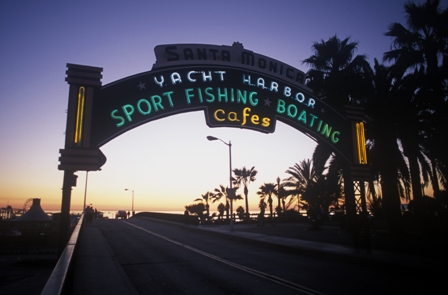 Entrance to Santa Monica's Yacht Harbor. Image by G. Peterson courtesy of Santa Monica's CVB.[/caption]
Entrance to Santa Monica's Yacht Harbor. Image by G. Peterson courtesy of Santa Monica's CVB.[/caption]
Better yet, it’s where America’s most famous national highway, Route 66 ends, or begins. From Santa Monica’s pier, up the Santa Monica Freeway to downtown LA and beyond, the road that inspired a truckload of songs continues to Chicago. A small map affixed to one of the pier’s buildings shows the old route, including a potted history of the road that brought the rest of America to California.
[caption id="attachment_1736" align="alignnone" width="448"]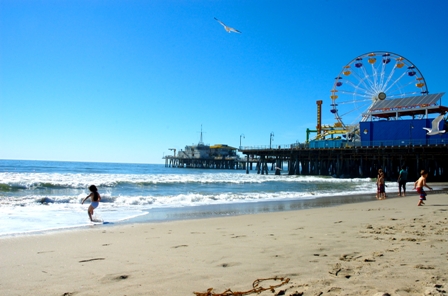 The pier seen from Santa Monica's beach.[/caption]
The pier seen from Santa Monica's beach.[/caption]
There’s a Santa Monica Museum of Art ( www.smmoa.org ) to wander through, filled with local and international talent. The museum is connected to the Bergamot Station Art Center, (by 2016 Santa Monica will link to downtown LA via Metro Rail’s newest line at Bergamot Station) which also houses over 40 private art galleries.
As one of California’s oldest settlements, the appropriately named, Santa Monica History Museum ( www.santamonicahistory.org ) is also worth visiting, if only to gain some understanding of how much times have changed in fewer than 500 years of colonial settlement.
Third Street Promenade is right in the centre of town, a pedestrian zone packed with upscale, low-scale and everything in between shops and cafes. In a city overrun with cars, any street dedicated to pedestrians is a godsend.
[caption id="attachment_1732" align="alignnone" width="296"]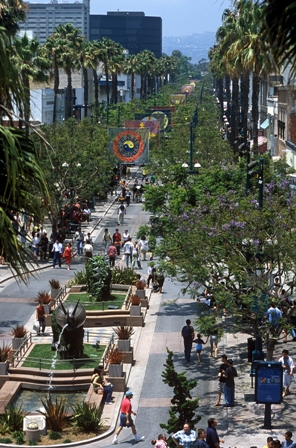 3rd St Promenade. Image by M. Caine courtesy of Santa Monica's CVB.[/caption]
3rd St Promenade. Image by M. Caine courtesy of Santa Monica's CVB.[/caption]
Befitting its health-conscious status, Santa Monica offers four farmer’s markets each week, rain or shine according to its website www.smgov.net/portals/farmersmarket/ . I spent a glorious Wednesday morning at the Arizona Street market chatting with growers who had driven to Santa Monica from as far away as Bakersfield, over 150 kilometres as the crow flies.
[caption id="attachment_1733" align="alignnone" width="295"] Santa Monica's farmer's market. Image by M. Caine.[/caption]
Santa Monica's farmer's market. Image by M. Caine.[/caption]
Visiting the farmer’s market was one of the best experiences I’d had in Santa Monica, a lucky find as I wasn’t looking for a market, instead wandering the back streets away from the beach in an attempt to grasp the feel of this town within a city.
[caption id="attachment_1735" align="alignnone" width="448"]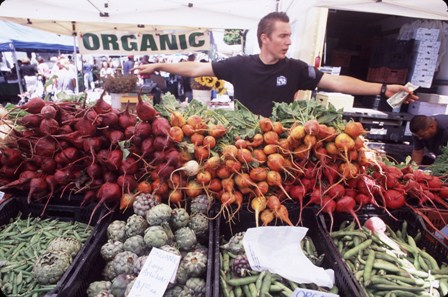 Santa Monica's farmer's market.[/caption]
Santa Monica's farmer's market.[/caption]
The ex-patriot American writer Gertrude Stein once said that ‘There is no there, there’ when she described her childhood home town Oakland, California. I often wonder the same when I think of LA, mentally searching for a soulful centre in a city that many cynical travellers like me believe has none.
Though I’m still looking for LA’s soul, for me Santa Monica has become a reasonably fine base while the search continues.
Tom Neal Tacker travelled as a guest of Qantas Airways and the Santa Monica Visitors Bureau.
Naked Facts:
See www.santamonica.com for the latest updates on events, festivals, shows and general information.
Naked Sleeps:
The Shore Hotel is the newest boutique kid on the beach block. Quite spacious rooms with all the mod-cons a 5-star property is supposed to have, including a fabulous location overlooking the tatty-famous pier, the beach and its adjoining glorious stretch of parklands, it’s a small-ish hotel that really delivers the goods.
[caption id="attachment_1737" align="alignnone" width="401"] Shore Hotel exterior on a sunny southern California day.[/caption]
Shore Hotel exterior on a sunny southern California day.[/caption]
The Shore is partnered with Sea-thos Foundation, a non-profit that promotes education and awareness of human impact on the world’s oceans. It’s also the only newly built Gold certified LEED hotel in Santa Monica.
[caption id="attachment_1738" align="alignnone" width="448"] Shore Hotel exterior at night. Image by Skott Snider.[/caption]
Shore Hotel exterior at night. Image by Skott Snider.[/caption]
I got lucky with a deluxe top floor beach facing room with floor to ceiling windows, double glazed to keep out traffic noise thankfully, with views that extended all the way to Malibu.
[caption id="attachment_1739" align="alignnone" width="448"]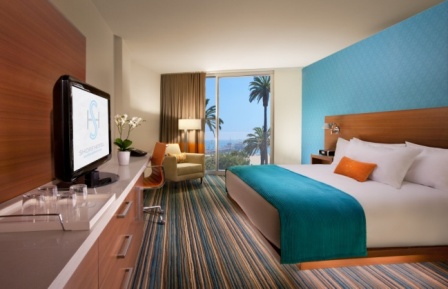 Shore Hotel room interior.[/caption]
Shore Hotel room interior.[/caption]
My room’s colour scheme was a cool mix of 70s orange with more contemporary blues and greens, very aquatic oriented without being kitsch.
Room decor certainly differs from the hotel’s overall appearance. The public areas are wide open and very well lit with lots of glass, eye-poppingly bright on a sunny southern California day.
Back to my room, the huge bathroom was stocked with decent toiletries, had good lighting (a failure in so many hotels) and a roomy shower stall with a large shower rose.
A small entry foyer fully separated the bedroom from any noise emanating from the hallway, a very nice feature I appreciated fully while trying to catch up on sleep.
The bed was a king-sized monster that gripped me like a lover. Wrapped in high quality linen, I slept exceedingly well. A single comfortable armchair and a low side table completed the stylish picture.
Wifi was free. The desk size was more than adequate though I was distracted by the views over the beach and Malibu so I didn’t get much work done. No complaints there.
[caption id="attachment_1740" align="alignnone" width="448"]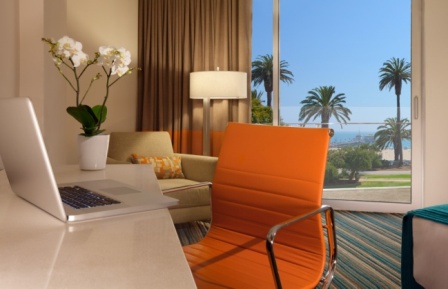 Shore Hotel room interior facing beach.[/caption]
Shore Hotel room interior facing beach.[/caption]
Since my recent stay, the hotel has opened a restaurant/bar next to its pool. It’s called Blue Plate Taco and is part of a small chain of local restaurants. I’ve heard good reports.
Rates average USD$400 per night not including tax. See www.shorehotel.com
Naked Eats:
Right next door to The Shore Hotel is Ivy at the Shore, part of a small group of restaurants. The Santa Monica Ivy is as known for its celebrity spotting as it is for its food. A kind of LA trade-off where average food sold at high prices is compensated by the chance to dine in the same room as a soap opera star. Anyway, the food at this Ivy is above average. Views over the park and beach from street side tables are highly desirable. Good cocktails. You’d need to reserve a table here. 1535 Ocean Ave. Tel: +1 310 393 3113
Jinky’s is an old fashioned American diner that serves reasonable food at reasonable prices. Breakfast here is the go. 1447 2nd St. Tel: +1 310 917 3311
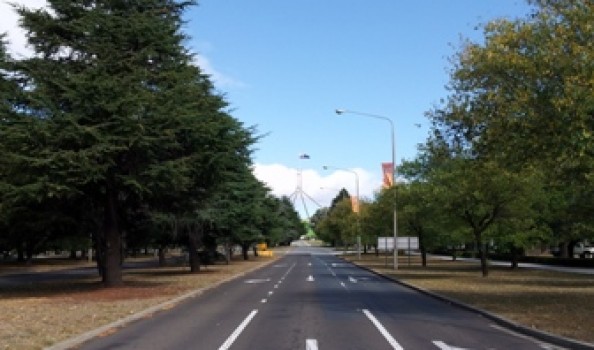 https://nakedhungrytraveller.com.au/canberras-not-dead/ Canberra's Not Dead
https://nakedhungrytraveller.com.au/canberras-not-dead/ Canberra's Not DeadCanberra’s surprisingly delectable delights compete for attention. Memorials, museums and politicians’ haunts get the lion’s share of the national capital’s attention. This is no longer a fair go…
Canberra: It has four distinct seasons, bushland and paddocks stretching in all directions with average altitude ranging between 600 metres and 900 metres. The variety of soils and slopes offers a challenge to winemakers. Happily the challenge has been met. There are over 140 vineyards around Canberra with 35 cellar doors open for wine fanciers. Many of the cellar doors also sell locally made olive oils, jams, preserves and condiments. It’s a complimentary arrangement that shows off the best products available.
Accommodation has broadened its base finally to include a few deluxe countrified guesthouses as well as a number of urban hotels that match any in the other capital cities. Cafes and restaurants are serving top-notch tucker with commensurate levels of table service. Old Canberra represented by the idée fixe of urban desert populated by even drier public servants mixing in with shady pollies has gradually shifted to one of a bushy oasis with great wines, superb restaurants and produce purveyors, though driving around Canberra’s Parliamentary Precinct mid-week after 10pm or on a weekend may still have a haunting affect on some (like me…where is everyone?) and some of those pollies are shadier than ever. As to the latter observation, la plus ca change…
For anyone who hasn’t been to Canberra in the last five years or so, I heartily recommend a visit.
[caption id="attachment_2076" align="alignnone" width="336"] Ben Chifley John Curtin, former PMs, statue in Parliament precinct.[/caption]
Ben Chifley John Curtin, former PMs, statue in Parliament precinct.[/caption]
Make a trip and help celebrate the capital city’s 100th birthday. Hard to believe isn’t it? Merely one hundred years ago, Canberra was basically a series of disconnected sheep paddocks.
When a political deal was made declaring the new city had to be at least 100 miles from Sydney but within the state of New South Wales, an arrangement aimed to settle the ongoing rivalry between Sydney and Melbourne, the former sheep station grew from a compromise between warring state’s factions into the Bush Capital we see now. An international competition to design the world's newest capital city was announced. The race was on.
A lot can happen in one hundred years.
At the National Archives, the rarely seen original plans and drawings for the competition are on display. To see the genius of Walter Burley Griffin’s design coupled with Marion Mahony’s splendid draughtsmanship is a rare treat.
[caption id="attachment_1708" align="alignnone" width="448"]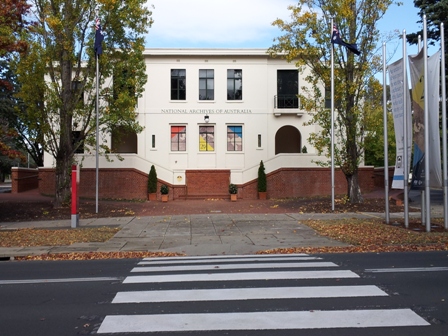 National Archives exterior.[/caption]
National Archives exterior.[/caption]
The international design competition was launched in 1911. In 1912 it was decided that Walter Burley Griffin with his wife and business partner Marion Mahony had won the prize with their novel entry, which described the future city ensconced in bushy parkland blessed by sweeping vistas and gracious public spaces.
Clearly, they were not averse to using a round-about as a traffic calming strategy. Canberra is Australia’s round-about capital, a circle within a sphere within a circumference. Canberra's only geographically straight streets extend from one grand public edifice to another: Parliament House, The Australian War Memorial, the Governor General's house at Yarralumla (close to the Prime Minister's residence, The Lodge) and the main road north from the downtown Civic precinct. The arrangement allows for many sweeping views. The remainder of Canberra's 'streetscapes' is essentially a circular argument.
[caption id="attachment_1709" align="alignnone" width="336"]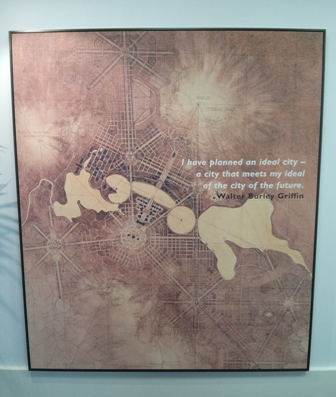 Walter Burley Griffin design layout for Canberra at National Archives.[/caption]
Walter Burley Griffin design layout for Canberra at National Archives.[/caption]
Officially construction commenced 12 March 1913 with the laying of the foundation stone of the commencement column. The National Archives’ collection of Jack Mildenhall’s photographs help to illuminate how barren Canberra’s landscape once was.
The Burley-Griffin’s concept was quite different to others on the short list. French designer Donat-Alfred Agache’s design is like an antipodean version of Paris with lots of formal water gardens. Eliel Saarinen’s design resembles an Art-Deco stand-in for Helsinki. Australians, Walter Scott Griffiths, Robert Charles Coulter and Charles Caswell’s design is surprisingly industrial.
The National Archives is situated in Canberra’s former main Post Office building, interesting in itself. By all means, have a look at the competing designs and pick your own winner. Complimentary use of interpretive iPads is available to accompany the already well researched displays.
[caption id="attachment_1712" align="alignnone" width="336"]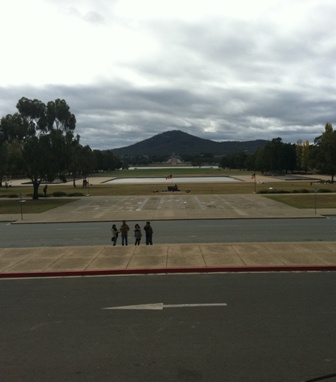 Looking towards the Australian War Memorial from the steps of the Old Parliament House.[/caption]
Looking towards the Australian War Memorial from the steps of the Old Parliament House.[/caption]
The Old Parliament House is now the Museum of Australian Democracy at Old Parliament House. A marvellous museum packed with exhibits stretching back to the birth of democracy in Athens up to contemporary concerns such as Australia becoming a republic. The whole museum is very engaging with lots of interactive displays (vote for a Republic?) competing with the solemnity of the House of Representatives and the Senate chambers. The former Prime Minister’s office is open to the public as well. Bob Hawke was its last full time incumbent, not so very long ago.
The Old Parliament House rose gardens have recently been restored and are now open to the public. Nice spot for a picnic.
[caption id="attachment_1711" align="alignnone" width="335"] Old Parliament House rose gardens have been recently restored.[/caption]
Old Parliament House rose gardens have been recently restored.[/caption]
The new National Portrait Gallery, conveniently located next door to the National Gallery of Australia, is also quite marvellous. Stepping back into time, gazing at faces from the colonial era reveals a past many Australians often forget. Contemporary portraits are like looking at old friends and familiar faces. It’s the kind of museum where you may find yourself pointing at someone’s face you know, hanging on a wall for everyone else to see.
[caption id="attachment_1713" align="alignnone" width="448"] National Portrait Gallery.[/caption]
National Portrait Gallery.[/caption]
Like most international capital cities, Canberra is blessed with an abundance of museums and galleries. I won’t list them all here but must make special mention of the National Museum of Australia and the Australian War Memorial. A visit to Canberra that doesn’t include stopping at both these excellent museums is culturally and intellectually bereft.
[caption id="attachment_1714" align="alignnone" width="336"] National Gallery exterior.[/caption]
National Gallery exterior.[/caption]
For a city designed like a huge garden space, Canberra is also blessed with superb public gardens foremost among them are the National Botanic Gardens and the National Arboretum.
[caption id="attachment_1715" align="alignnone" width="448"]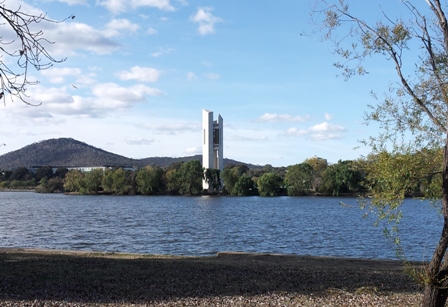 On the shores of Lake Walter Burley Griffin the Carillon was given to Australia by the British government on Canberra's 50th anniversary.[/caption]
On the shores of Lake Walter Burley Griffin the Carillon was given to Australia by the British government on Canberra's 50th anniversary.[/caption]
The National Capital Exhibition is also highly recommended for its exhibits devoted to local Indigenous culture and Canberra’s history before it grew into a modern city.
Both the High Court and Parliament House are open to the public. Parliamentary proceedings are open to visitors. Question time is 2pm when the House is sitting. (BYO vuvuzela?) Likewise the High Court is open to the public. Proceedings are accessible to visitors though tours must be booked in advance. Online is best. When the High Court is sitting, visitors are welcome to view the action from any one of the three courtrooms.
All that cultural and historical stimulation also requires sustenance of a more basic kind: food and drink.
I’ve done the hard yards and condensed the array of dining, wining and shopping choices to the following summary. It’s by no means a locked in and secure list. Instead it’s a subjective approach to what I’ve experienced and is certainly open-ended. All I can say is that this is a thriving region for hungry, thirsty people like me. Bring it on.
Naked Drinking:
Canberra’s wineries are more or less spread out in two different directions from the city centre, east to Bungendore and north to Murrumbateman with a few others closer to town and a few nestled into the slope bordering on the ever mysterious Lake George, though the Lake George wineries are usually included in maps that focus on Bungendore.
It’s best to divide your visits accordingly and try not to combine the two centres in one day. Spend at least one day in and around Bungendore and do the same for Murrumbateman. This will reduce driving time and allow for a relaxing lunch and shopping.
The Canberra District Wine Industry Association & Spirited Communications has produced a very good free map. Check www.visitcanberra.com.au
Be sure to check opening hours for all wineries. Some keep public holiday and weekends only visiting hours or require an appointment first.
Clonakilla Winery
Crisps Lane, Murrumbateman
(02) 6227 5877
Tim Kirk is one of Canberra’s gifted-with-the-grape geniuses. What he can do with Shiraz and Viognier verges on alchemy. Clonakilla slays them at the wine shows when it enters. Tim’s cellar door is charmingly rustic, much like the man himself. Like so much of Canberra’s terrain, the Clonakilla vineyard appears weathered, old and hunkered down. Shiraz loves it. The wines are pure cool climate, spicy and incredibly complex.
Helm Wines
Butts Road, Murrumbateman
(02) 6227 5953
Ken and Judith Helm are local heroes having owned and operated their eponymous winery since 1973, one of the oldest in the district. Ken makes a standout Riesling, Chardonnay and Cabernet Sauvignon. The Riesling is ethereal, seductive and lifts itself from the glass like a ballerina on point, all grace and beauty. The cellar door, formerly the local schoolhouse, is a pure delight. Check out former school mistress Miss Minnie May Young’s photo near the door. She taught there from 1897 until 1904 and ran temperance classes where you now sample Helm’s wines. Further irony… she married an Armstrong who didn’t drink and later became former National Party leader Ian Armstrong’s great aunt.
Gallagher Wines
2770 Dog Trap Road, Murrumbateman
(02) 6227 0555
This charming winery has a typical cool climate range of Canberra-friendly grape varieties. Trophies on display usually mean that there’s good stuff to taste. There are plenty of awards and trophies adorning Gallagher’s wines but what entranced me most was that Mrs. Gallagher also makes what I’ve learned is Canberra’s only regional cheese, marinated labne, a soft cheese perfect for spreading over a slice of wood fired sourdough bread.
Shaw Vineyard Estate
34 Isabell Drive, Murrumbateman
(02) 6227 5827
At over 30 hectares, Shaw is one of Canberra’s largest as well as newest vineyards. It’s definitely worth a look to see what the newest kids on the block are doing. With so much area to work with, Shaw is doing an interesting range. This is a great opportunity to catch a rising star.
Pankhurst Wines
Old Woodgrove Road, Hall
(02) 6230 2592
Set in a stunning location overlooking the Brindabella Ranges stretching across to the southern horizon, this winery does a mean Chardonnay among other varieties. As it’s close to Hall, try stopping there to have a look at what was the local village before Canberra was built. Hall has retained its colonial roots and hosts a large produce and crafts market the first Sunday of each month except in January.
Mount Majura Vineyard
RMB 314 Majura Road, Majura
(02) 6262 3070
Majura is on the outskirts of Canberra at the foot of Mount Majura. The spanking new cellar door also houses an evolving contemporary art gallery space. Very funky. Winemaker Frank van der Loo is doing wonderful things with Majura’s Chardonnay, Riesling, Shiraz, Pinot Gris and Tempranillo. All five of these varieties are showing up splendid examples under Frank’s expert skills. The Dinny’s Blend, a Cabernet Franc dominant house blend is also a little ripper. The Tempranillo is certainly one of the best I’ve tasted made in Australia. Frank also makes a Riesling based Vino Cotto (cooked grape must) that is a gift to any enterprising cook. Majura conducts a walkabout 'Gumboot Tour' of the vineyards offering the visitor a rare opportunity to get close and personal with the grapes, the soil and the terroir.
Lerida Estate
Westering Federal Highway, Lake George
(02) 6295 6640 or weekends (02) 4848 0231
I’ve certainly enjoyed the wines here. Lerida bought neighbouring Madew Estate some years ago, acquiring top quality Chardonnay, Riesling and Pinot Gris vineyards in addition to its Shiraz, Pinot Noir, Merlot, Cabernet Franc and Viognier. I particularly like the Merlot/Cabernet Franc blend, as close as we get to a Pomerol style wine in Australia. Lerida Estate has a lovely airy cellar door perched on the slope overlooking the vineyards and the distant and nearly always dry Lake George. Cafe Lerida is the winery’s excellent restaurant adjoining the tasting bar. It’s well worth combining a tasting visit with an eating visit. Certainly the wines taste even better when they’re paired so winningly with the food. Best of all, the cellar door and restaurant are open 10am to 5pm daily.
Lambert Vineyards and Café
810 Norton Road, Wamboin
(02) 6238 3866
Steve and Ruth Lambert established their winery in 1991. The café came along a little later and has proved to be a win-win combination. Steve’s wines are uniformly terrific, particularly his Pinot Gris, Chardonnay, Shiraz and an easy on the palate Rose. The Lamberts have provided a needed lift to the Bungendore food scene. The views over the countryside and vineyards are sublimely peaceful.
Lark Hill Winery
521 Bungendore Road, Bungendore
(02) 6238 1393
Owner/winemaker family, Dave, Sue and Chris Carpenter comprise a biodynamic trio. This is the Canberra district’s highest vineyard; the scenery from 860 metres up is beautiful and wildlife abounds. The biodynamic pesticide free environment attracts the friendliest of furry and feathered neighbours--like the very large mob of roos when I visited. The cellar door is all old stone and atmosphere. The wines are dead set excellent, yields are at the extreme end of low and the vines suffer for their success. Benchmark Pinot Noir, Riesling and Chardonnay set a hard-to-follow standard for the Canberra wine community. Qantas has both Lark Hill Chardonnay and Pinot Noir on offer in its Business Class. Un-miss-able. If you're feeling hungry, stay for lunch at their new-ish restaurant. With country cooking this good, Lark Hill wines show off even better.
Naked Eating:
Canberra’s food-fanatical coterie of devotees has developed into something quite interesting. I try to keep up with the best but it’s an ever-evolving scene. Here at least is my edited selection of some of the best.
Fyshwick Markets
Dalby and Mildura Streets, Fyshwick
Weekly Thursday to Sunday
This is Canberra’s main fresh food market open for retail as well as wholesale. Check out what the restaurateurs are buying. Talk to the purveyors to ascertain the best on offer. Check out The Mart (ask directions to which corner of the market it’s located in) for the Canberra deli to beat all other delis.
The Capital Region Farmers Market
Weekly every Saturday
Exhibition Park, Mitchell
A great selection of the region's best produce--straight from paddock to plate.
Old Bus Depot Market
Wentworth Avenue, Kingston
Every Sunday from 10am until 4pm
All Australian made arts, crafts and farm grown products place this market in the special category. Talk to the growers. Meet the makers. Shop with pride.
Silo Bakery
36 Giles Street, Kingston
(02) 6260 6060
This café/bakery does the best bread in Canberra. It also offers some of the best lunch options anywhere. The walk-in cheese room is full of what can’t be bought elsewhere in town. Stock up now and don’t forget the fruit pastries
The Ginger Room—closed and awaiting a new proprietor.
Old Parliament House, King George Terrace, Parkes
(02) 6270 8262
This was once one of Canberra’s best restaurants. The Ginger Room stood out for me for its glimpse of Canberra’s past. The restaurant occupies one of the member’s dining rooms and after the room was stripped of layers of paint, smoke stain and dirt it revealed wonderfully painted wall panels of ginger flowers. The room now reeks with an undeniable style of its own. An adjoining cocktail bar is closed and awaiting a new proprietor, a sad end to a refreshed start. The cafe operating in the Museum of Australian Democracy (Old Parliament House) also acts as a retailer selling locally grown and made produce. Sadly, the food is ordinary and derivative, obviously sourced from a catering company off site.
Benchmark Wine Bar
65 Northbourne Avenue, Civic
(02) 6262 6522
This is Canberra’s best wine bar since 2003. The choice of wines is breathtaking. Opt for a flight to sample three related wines at the one time, pausing to compare and contrast the differences between them. Dining here is certainly wine focused but the food usually matches the pace set by the high standard of the array of wines for sale.
Aubergine
18 Barker St, Griffith
(02) 6260 8666
Canberra isn't replete with fine dining establishments, slim pickings at the top end but Aubergine fills an empty space with flair. Though Aubergine is fairly casual, the quality of the cooking combined with an interesting wine list and good service makes this one of the capital's most enticing restaurants.
Ottoman Cuisine
9 Broughton St, Barton
(02) 6273 6111
This Turkish inspired dining room has grown into a local institution. Spot the 'pollie' between courses of accomplished Turkish food is a fun game to play while waiting on the next plate of exquisite stuffed vegetables or wrapped meats.
Kingston Grind Café
Jardine Street, Green Square, Kingston
(02) 6295 8189
Arguably serving Canberra’s best coffee though I realise that making a claim like that invites a certain degree of competitive wrath. I like the Grind, thought it’s seen better days. Its position on the square in trendy Kingston with big windows looking out to the mundane YMCA second hand store across the road and its normally friendly service all appeal. Breakfast isn’t bad either.
Poachers Pantry Smokehouse Café and Wily Trout Vineyard
“Marakei”
Nanima Road, Hall
(02) 6230 2487
What a lovely place this is! The 1930s era weatherboard farm cottage graciously restored into a café restaurant and tasting room is unique. Certainly the smoked meats on sale and for tasting are like none elsewhere. Smoked chicken, quail, duck, lamb, pork, emu and kangaroo present more choice than even the most dedicated smoked meats fan can narrow down to a couple of favourites. The kangaroo prosciutto is so succulent it melts in the mouth. The smoked duck breast floats my boat any day. Try the Wily Trout wines while at Poachers, mix or match them with the smoked meats. Even better, eat at the café and see what the resident chefs do with this superb produce.
Grazing Restaurant and Café
The Royal Hotel
Cnr Cork and Harp Streets, Gundaroo
(02) 6236 8777
This is definitely one of Australia’s finest country restaurants. The food is home-hearty but refined. Flavours are distinctly delineated; nothing is too jumbled or confused. A country terrine arrives warm and sautéed rather than cold and congealed. The house made savoury tomato relish that accompanies it contrasts nicely against the unctuous fattiness in the terrine. A Guinness, beef and mushroom pie with mash would normally feed a football team. Here it more than feeds one without leaving a bulge around the midriff, its flavours being more important than mere bulk. A quince and vanilla custard tart with sour cream ice cream left me speechless with delight. The wine list comprises solely Canberra District wines. This is not only a Canberra treasure. It’s a national treasure.
Naked Tips:
The venues listed here are all very popular with the in crowd. Ring ahead to make a booking or be prepared to wait. The markets are at their best either very early or very late when the 'specials' are available for a bargain price.
Naked Accommodation:
Once the domain of soulless corporate motels, Canberra has emerged as a holiday destination offering the best of boutique hotel and apartment stays. Here’s a preferred short list.
[caption id="attachment_1710" align="alignnone" width="353"] To The Hotel Realm and a local plastic surgeon--on a public funded road sign?[/caption]
To The Hotel Realm and a local plastic surgeon--on a public funded road sign?[/caption]
Hyatt Hotel Canberra
Commonwealth Avenue, Yarralumla
(02) 6270 1234
www.canberra.hyatt.com
Yeah, I know, it’s the only real 5-star place in town and at times it can be soulless and corporate--I bite my tongue--but the hotel has history. This was the Liberal party’s home away from home. With a bit of imagination, it’s possible to see the ghosts of John Gorton or 'Pig Iron' Bob Menzies himself leaning against a wall in the lobby. Oh so tastefully restored and dignified, lots of room for functions and exhibitions, the Hyatt sometimes appears over-gentrified but where else in Canberra can you get 24-hours room service and a taxi when you need one? Avoid the rooms overlooking the back car park. The noise levels are often intrusive.
The Hotel Kurrajong
National Circuit, Barton
(02) 6234 4444
The Kurrajong has grown on me. The hotel shares the Australian International Hotel School attached to it and occasionally the student help seems more 'student' than polished professional but that’s part of its charm. Like the Canberra, the Kurrajong is one of Canberra’s original great hotels but this was the Labor party’s hangout. Ben Chifley stayed, lived, worked and eventually died here and his room is now something of a shrine. The other rooms have been updated and refurbished but haven’t lost their sense of history. There’s plenty of soul and in a building with a truly important past too. Don’t miss having a drink or meal on the verandah in the courtyard garden. New managers were announced recently. The hotel will soon become part of the Travelodge chain. Hopefully this large hotel group won’t ruin the place.
Country Guesthouse Schonegg
381 Hillview Drive, Murrumbateman
(02) 6227 0344
A rare gem, The Schonegg has six lovely suites; it’s small and exclusive. Owner operators Richard and Evelyn Everson have a wealth of combined experience and talent in the hospitality game. It certainly shows in their seemingly effortless ability to make the guest seem very welcome and looked after. Richard is a chef of outstanding talent. Dinners and breakfasts are included in the overall tariff. Don’t miss them under any circumstance. Evelyn is a dab hand with pastries and cakes and as the major-domo she rules with utter grace and warmth.
The Realm Precinct
18 National Circuit, Barton
(02) 6163 1800
Conveniently located in the Parliamentary Precinct, this cool and clean hotel claims 5-star status.
During a recent visit, I was pleasantly surprised, mostly by the professionalism of its staff members, less so by the quality of the catering. I’m sick to death of tired buffet breakfasts in Australian hotels.
If I see another large bowl of Bircher muesli that looks like plasterer's putty and a platter of very unripe watermelon, muskmelon, rockmelon and pineapple slices posing as ‘fresh fruit’ I’ll yell very loudly. Quantities of scrambled and poached eggs congealing in metal tins sitting in a warm water bath are an abomination. The only good use for a bain-marie in these days of intelligent cooking is emptied out and filled with dirt to be used as a garden planter. The packaged juices dispensed from large urns with spigots and a toasting machine that takes forever to toast a stale slice of bread were equally unappealing. Coffee out of a ‘use-it-yourself’ espresso machine stocked with very ordinary coffee beans added more insult to injury. All this for an extra $25 per person? I should have gone to the Silo Bakery instead.
Rooms on the executive level are spacious and moderately well-appointed. We could have used a full length mirror and better bathroom lighting, but these are minor quibbles.
When or if The Realm sorts out its breakfast service, I’d stay there again.
Naked Tips:
Visit the Visitor’s Centres in Canberra or in Yass for more recommendations regarding accommodation. There are numerous B & B guesthouses dotted all around Canberra’s countryside, some slick and professional, some too twee for words. For longer stays, Canberra has many very good serviced apartments, particularly around Kingston, Griffith, Barton and Yarralumla.
Best time to visit: Anytime really. Canberra has become something of an events and festivals city so take care and book well ahead if something really big is on. Four seasons mean four distinct average temperature ranges. Spring and Autumn are perfect.
Most under-rated aspect: The wines, the restaurants and the surrounding countryside. Get away from the city roundabouts!
Most over-rated aspects: The Summernats rev-heads car crash festival in January is when people who like to wine and dine give Canberra a big miss.
Prepare yourself for: Biting cold in winter and damned annoying blowflies in summer.
Watch out for: Time. You’ll need more of it than you may anticipate for having a really good look around.
Best value: Some Canberra wineries are among Australia’s best and they represent incredible value for the serious shopper.
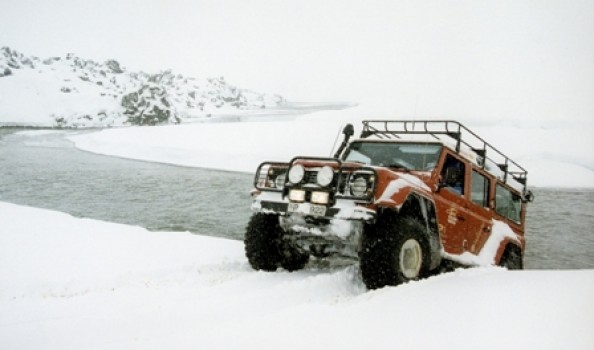 https://nakedhungrytraveller.com.au/iceland-in-winter-why-bother/ Iceland in Winter, Why Bother?
https://nakedhungrytraveller.com.au/iceland-in-winter-why-bother/ Iceland in Winter, Why Bother?Trekking around Iceland’s highlands in winter takes some fortitude. Is it worth it?
When I flew into Reykjavik’s Keflavik airport a fierce wind was blowing from the North Atlantic. Sleet was turning to snow before my eyes. I stepped outside the terminal building and faced into what felt like a cold shave with ice water and a dull blade. It hurt. Iceland? What can I add to rumours of an early spring season in Iceland? The commonly held myth about Iceland being green and that Greenland conversely is white is basically wrong. Iceland is icy in winter, spring and autumn.All I wanted to do was curl up under the duck down doona in my room at the Radisson Blu and hide from frozen reality, or at least until the weather cleared. Instead, after a short but cozy night’s sleep under that much loved doona (a sadly brief relationship) the following morning I boarded an outsized jeep contraption with seven other travellers and headed for the hills outside Reykjavik.
Our first weather report: Force Ten Gale, 25 metres per second winds, blowing snow with blizzard conditions. All sensible persons are advised to remain indoors under doonas. Actually I made up that last bit but if I was running Iceland’s weather bureau, this is the sort of advice I would find useful.
Until I visited Iceland, I didn’t know that wind velocity could be measured by increments of metres per second. I am accustomed to hearing wind speeds announced either in kilometres per hour or miles per hour, not metres per second. I ask one of our guides, ‘How fast is 25 metres per second?’ He responds, ‘Fast enough to blow you over.’ Hmm. ‘That’s fast,’ I say. ‘Yes, and it’s supposed to become faster.’ Hmm. ‘How much faster are the winds expected to reach?’ I ask. ‘Maybe 30 metres per second,’ he responds somewhat coldly. ‘That’s bad right?’ I ask. ‘Yes, fast enough to blow the jeep over and off the road. We may have to change our plans.’
I am not a masochist. I am not a masochist.
My mantra for the rest of a week in Icy-land.
[caption id="attachment_1754" align="alignnone" width="448"]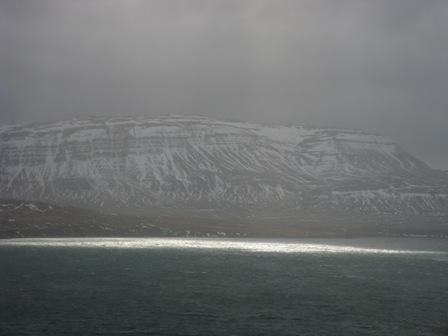 Last bit of sunshine on first day of Winter Highlights trek.[/caption]
Last bit of sunshine on first day of Winter Highlights trek.[/caption]
On our initial day, we have a picnic. I like picnicking: cheese, bread, fruit, maybe a pate or terrine, a quiche perhaps? Chilled bottles of wine drunk in warm countryside.
Instead, we’re huddled under a canopy at the Thingvellir National Park, the site of Iceland and supposedly the world’s first parliament (the Thingvellir Viking Parliament) in a valley surrounded by low volcanic mountains which coincidentally share the fault line where western Iceland separates from eastern Iceland. Split politically right from the start. Same as it ever was.
[caption id="attachment_1752" align="alignnone" width="336"]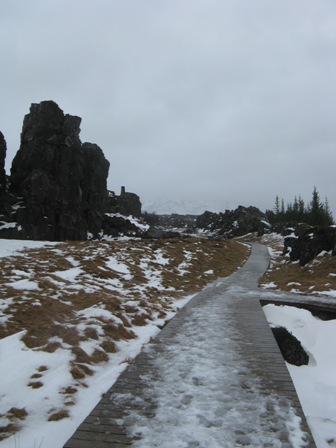 Viking Parliament national park walkway.[/caption]
Viking Parliament national park walkway.[/caption]
The wind blows my instant chicken noodle soup clear out of the plastic mug. I put my back to the ceaseless icy wind, feeling shards of frozen sleet blast against my hooded parka. My hands are stiff with cold. Trying hard to respect the important austerity of Iceland’s most historic pilgrimage place, I can only think about how I can hold a second mug of soup out of the wind long enough for me to drink it.
This is not a picnic. This is a test of wills. Mine is losing against the elements.
We were scheduled to spend our fabulous first night on a 'Winter Highlights' expedition jeep trek across Iceland’s mountainous interior in a farmhouse near a beach popular with seals at Skagafjord on Iceland's northern coast. Our guide reached the owner of the hut by phone warning him of our imminent arrival. The reply was daunting. ‘Don’t come. I can’t get the door open. The wind is blowing too hard against it.’
We continue driving up the spectacularly beautiful western coast road along Faza Bay on the Thjodvegur Road past to Hrutey and turn inland towards Akureyri then south some twenty kilometres to a different farmhouse better sheltered against the furious winds.
[caption id="attachment_1753" align="alignnone" width="336"] Highway Number 1 along west coast.[/caption]
Highway Number 1 along west coast.[/caption]
We arrive just before dark, enough time to cross country to visit an isolated ice cave. We chat about elves and trolls that are said to inhabit caves throughout Iceland. Evidently there are trolls in this cave. I don’t see trolls but I do see an extended white frozen tunnel, an extinct lava tube that recedes into darkness. If a coven of vampires were looking for a hang-out in Iceland, this would be prime habitat. I’m blue with cold. We’ve hiked a kilometre from where we left the super jeep across snowy fields to reach Dracula’s lair, a.k.a. troll cave.
The weather then took a turn for the worse.
[caption id="attachment_1755" align="alignnone" width="336"] Facing into the Icelandic wind.[/caption]
Facing into the Icelandic wind.[/caption]
The following day, conditions became absolutely appalling. We bounced from one snow drift to another. 'White Out' was the meteorological operative phrase for two whole days of driving. No horizon, no landscape, simply hour after hour of white nothingness which we traversed via GPS. The road had disappeared completely. We pressed on to a mountain hut, donned snowshoes and walked around a hot springs area while trying to remain standing so as not to fall into the scalding sulfurous water.
[caption id="attachment_1756" align="alignnone" width="336"] Single road sign. Where's the road?[/caption]
Single road sign. Where's the road?[/caption]
Outside the jeep all I could see was white. Inside the jeep, all I could see was white windows or fellow frozen passengers. Once we stopped to look out over a lake behind a dam, part of western central Iceland’s hydro-electric system. An Arctic fox ran quickly away from us, a smart move I thought It ran with purpose, probably to its den in a protected position out of the wind. For a moment, I felt jealous.
[caption id="attachment_1757" align="alignnone" width="414"]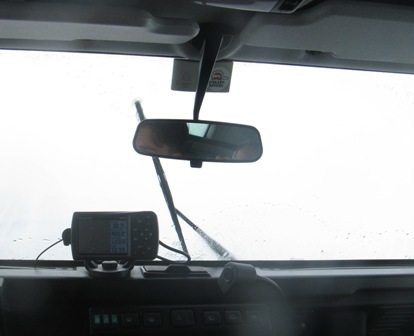 Inside the Superjeep, same white out view for three days.[/caption]
Inside the Superjeep, same white out view for three days.[/caption]
I am not a masochist. I am not a masochist.
On day three, while trying to ascend a dormant volcanic crater rim that overlooks other dormant volcanoes I felt my feet lifting off the ground. Through the driving snow I could almost see the hand in front of my face that was gripping a rock while the other was gripping a rope fence. I ran downhill back to the jeep, an easy feat as the wind was at my back for a change. I may have skipped a few steps and felt quite uplifted while doing it.
[caption id="attachment_1758" align="alignnone" width="448"]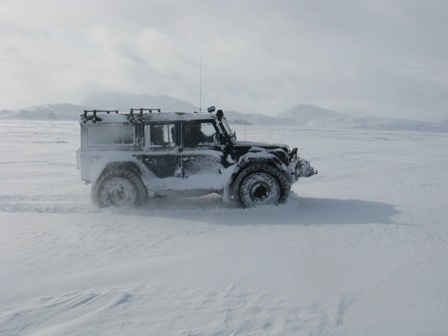 Superjeep on the road again.[/caption]
Superjeep on the road again.[/caption]
We visited another dramatic canyon riven by steam vents and waterfalls tumbling along its sheer cliffs. Only a few kilometres from our accommodation, I chose to walk back, relieved to be out of the jeep.
[caption id="attachment_1759" align="alignnone" width="448"]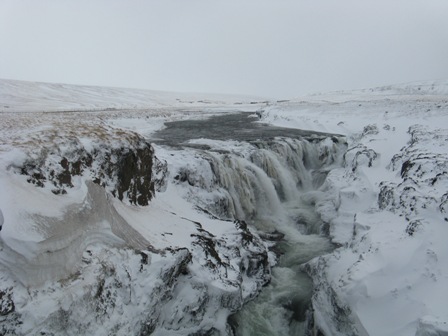 Waterfall inland from Akureyri.[/caption]
Waterfall inland from Akureyri.[/caption]
The wind was at my back and though I nearly froze solid, it was worth it just to come across a small herd of Icelandic horses corralled about a kilometre from the farmhouse where we stayed.
These amazingly hardy small horses are unique to Iceland. They can tough out the harsh winter conditions unlike other horses. Well insulated under shaggy coats, rear ends perpetually facing the biting winds, they look placid, as if this blizzard without end is just another walk in the park.
[caption id="attachment_1760" align="alignnone" width="336"]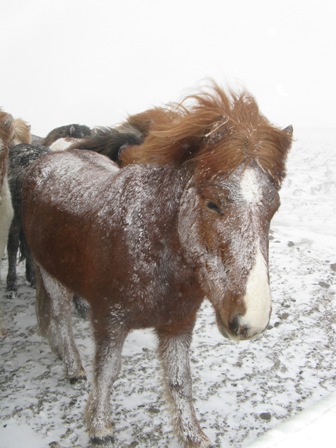 Icelandic horse enjoying the weather.[/caption]
Icelandic horse enjoying the weather.[/caption]
Interestingly, if an Icelandic horse is taken off the island, it's never allowed to return. No other breed of horse is allowed on Iceland either. The local horses have the place all to themselves. Were I given to anthropomorphising animals, from the look on the faces of these horses, I would guess that they're quite happy having Iceland all to themselves.
Each night we arrive at a different remote, deserted mountain hut, unpack our gear, prepare dinner and go to bed early. One night I cooked fried fish. Another night one of our guides prepared lamb stew. It had lamb, carrots and onions. We ate it again the next day for lunch but then we called it lamb soup.
[caption id="attachment_1761" align="alignnone" width="448"]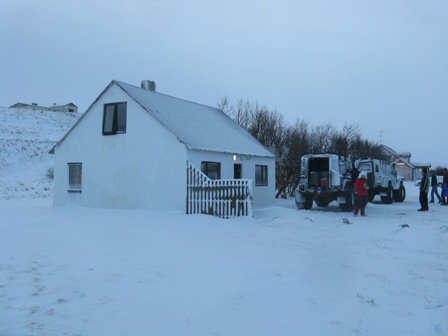 Overnight accommodation in another remote farmhouse.[/caption]
Overnight accommodation in another remote farmhouse.[/caption]
Here’s an interesting titbit of information. Iceland's national dish is rotten shark called ‘Hakarl’. Icelandic farmers like to eat it interspersed with straight shots of ‘Brennivin’, a.k.a. ‘Black Death’, the local version of aquavit.
To prepare: A gutted and headless shark is buried in a gravelly pit for several months. The putrid shark flesh is then air dried in a shed until it reaches cardboard stiffness. After months of curing, this delicacy is ready to eat. Rotten air dried shark reeks of ammonia and rancidity, sort of what I imagine very old cheap blue cheese that has been pissed on by a football team full of beer would taste like if it was left out of the fridge for a month or two. This national culinary delight invokes much patriotism among local people. It’s best not to criticise it in a room full of Icelanders as they may take offence and push you from a pub outside into a Force 10 gale. I have heard tales...
Iceland’s scenery is undeniably awe-inspiring, when weather permits seeing it. As the Earth cracks up the middle of Iceland, volcanoes, geysers and mountains with gushing waterfalls are created. One of the most famous waterfalls, Gullfloss, is an incredible sight. Nearly encased in cliffs of ice, torrents of water continue to run down a long canyon that ends in a drop off into a bluish abyss, it is truly impressive. With landscapes like these, it’s completely understandable that early Icelanders were wonder-struck by their shaky island.
[caption id="attachment_1762" align="alignnone" width="448"]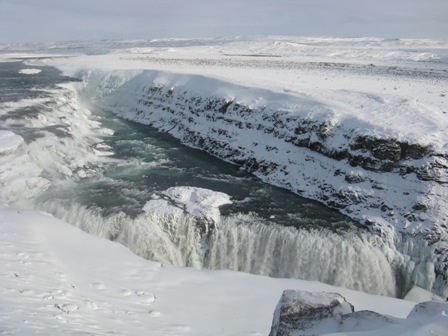 Gullfloss waterfall frozen in winter.[/caption]
Gullfloss waterfall frozen in winter.[/caption]
By day four the weather began to clear a bit. Mount Hekla was nearby but we went higher up to a remote valley, ‘floating’ over snow in our super-Jeeps with their huge tyres from Hveravellir to Landmannalaugar where we stayed the night.
[caption id="attachment_1763" align="alignnone" width="448"]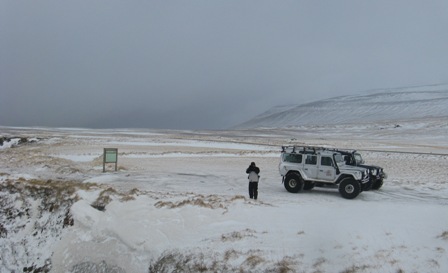 Atop the western plateau.[/caption]
[caption id="attachment_1772" align="alignnone" width="448"]
Atop the western plateau.[/caption]
[caption id="attachment_1772" align="alignnone" width="448"]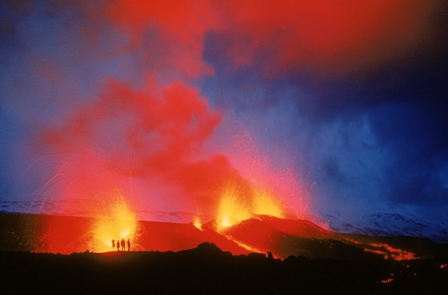 Mount Hekla at play.[/caption]
Mount Hekla at play.[/caption]
In summer, Landmannalaugar is justifiably popular with trekkers and campers. Hot springs bubble away near the single large accommodation hut. A lovely alpine river flows across the valley ringed by mountains and meadows.
[caption id="attachment_1764" align="alignnone" width="448"] River at Landmannalaugar.[/caption]
River at Landmannalaugar.[/caption]
We struggle to cross the swiftly running river. Its banks are now frozen, ice piled high on both sides. One Superjeep has to be towed out by another. Our two vehicles are rapidly encased in ice. Tyre pressure has to be lowered again. It takes 45 minutes to cross the river. It takes as long to clear the axles and tyres of solid ice when we get across to our accommodation.
[caption id="attachment_1765" align="alignnone" width="448"]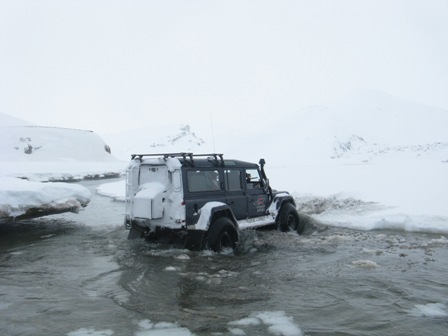 River crossing at Landmannalaugar.[/caption]
River crossing at Landmannalaugar.[/caption]
In winter, Landmannalaugar is a vastly different place; empty and almost forlorn. The hut has no running water because of frozen pipes and no electricity. We hook up to car batteries to supplement the one hard working solar cell, essentially useless in these dark, cloudy conditions. To make matters worse, the outside bathroom toilet hut has nearly disappeared under snow.
[caption id="attachment_1766" align="alignnone" width="336"]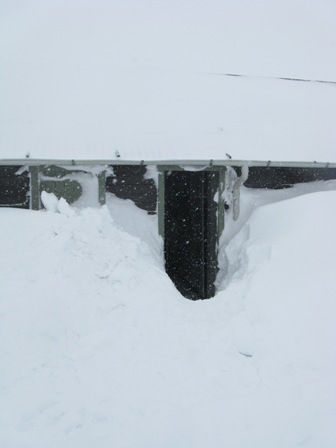 Toilet facilities are basic at Landmannalaugar.[/caption]
Toilet facilities are basic at Landmannalaugar.[/caption]
To make the most of a fairly dire situation, we snowshoed up the valley, over a rocky ridge and across glacier crevasses. The guides seemed to know what they were doing so I went along for the hike, thankful not to be stuck in the back of a jeep again, or worse, in the hut where I was to spend the night. With diminishing winds, the land appeared stark in various shades of white. No one else was there. It's a very remote place.
[caption id="attachment_1767" align="alignnone" width="320"] Snowshoe trekking again.[/caption]
[caption id="attachment_1768" align="alignnone" width="336"]
Snowshoe trekking again.[/caption]
[caption id="attachment_1768" align="alignnone" width="336"]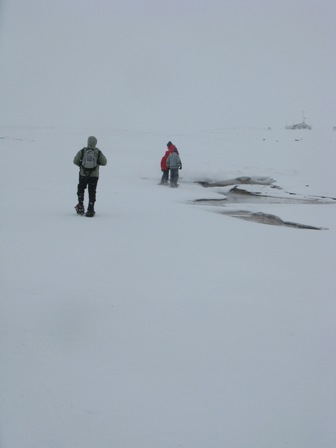 Trekking around hot springs in snowshoes.[/caption]
Trekking around hot springs in snowshoes.[/caption]
300,000 people live in Iceland, 200,000 of them reside in and near Reykjavik, which is essentially a large country town with a few funky bars equipped with sound systems playing lots of Bjork and a few other significant Icelandic bands unknown outside Iceland. The country is the size of Kentucky or Victoria, to give you an idea of land proportions compared to population. There is a lot of empty space, almost none of it arable. Now I know why as it's mostly uninhabitable too.
On our last day, we return to Reykjavik via Geysir. This is the original geyser, the mother of all geysers as the rest of the world's geysers take their name from this one.
[caption id="attachment_1770" align="alignnone" width="448"]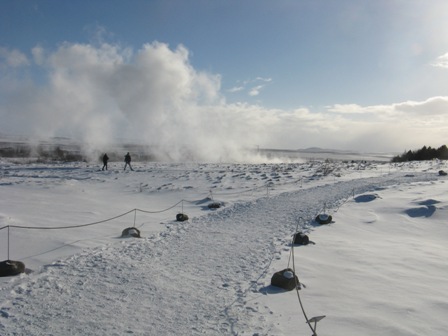 Geysir.[/caption]
Geysir.[/caption]
The incessant wind has mercifully begun to subside. Steam rising from Geysir lifts almost straight up into a pale blue sky, a vision I thought I'd never see again.
[caption id="attachment_1769" align="alignnone" width="448"]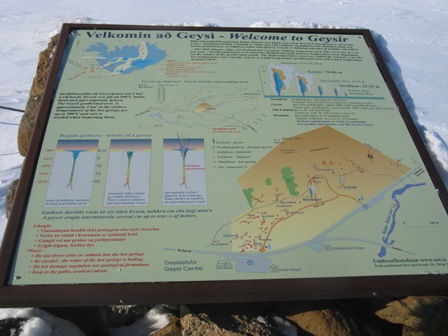 Welcome to Geysir sign.[/caption]
Welcome to Geysir sign.[/caption]
Some twenty kilometres outside Reykjavik we stop at a famous crater whose name I promptly forgot. The weather has turned fierce again, low clouds crept in after leaving Geysir. The wind has picked up and we're back to normal. The crater is deep and forbidding. A troll would be happy living in it no doubt.
[caption id="attachment_1771" align="alignnone" width="448"] Crater near Reykjavik.[/caption]
Crater near Reykjavik.[/caption]
The six days of hard travel across Iceland's interior during one of the season's worst storms has been challenging but I'm glad I did it, if only to boast later that I survived the ordeal. Travel makes us all stronger doesn't it?
[caption id="attachment_1773" align="alignnone" width="448"]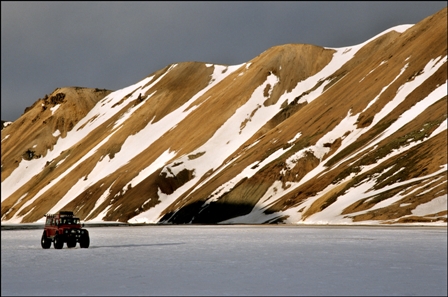 Superjeep on winter tour in Iceland.[/caption]
Superjeep on winter tour in Iceland.[/caption]
I've come to understand a bit about the national character. To live, indeed prosper in this awful climate takes a special fortitude. No wonder Icelanders are known for being tough, stubborn and resourceful.
It's certainly one of the world's most curious countries.
I must mention that Icelanders are all related to one another, that they are either completely humourless or have bizarre senses of humour, that the country is flat broke with nary a Kroner to its name, that the value of its currency has fallen by 50% in two years and that its PM is a lesbian who is trying to put the house of Iceland back in working order while the men focus on drinking more beer and eating rotten shark bits.
[caption id="attachment_1774" align="alignnone" width="336"]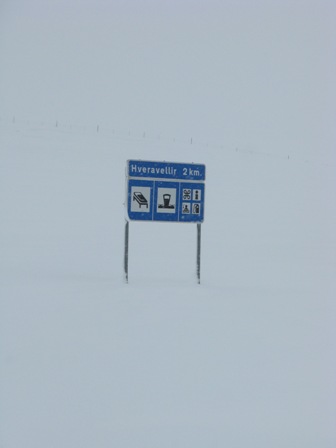 Road sign under snow, which way to the park?[/caption]
Road sign under snow, which way to the park?[/caption]
I do like Iceland despite its off-putting wintry climate.
[caption id="attachment_1778" align="alignnone" width="319"]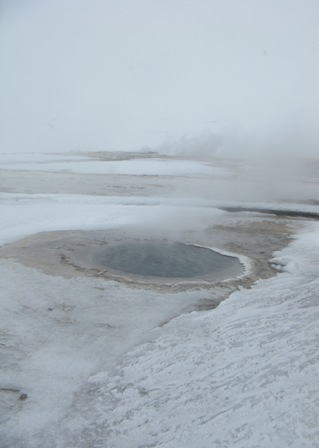 Hot springs on central highlands.[/caption]
Hot springs on central highlands.[/caption]
In many respects it's my kind of country as it's packed with eccentrics who are relatively harmless. There are hydrogen re-fill stations around Reykjavik for hydrogen fuelled vehicles. Wind and solar (solar would have to be very efficient technology, during my time in Iceland I saw the sun for all of five minutes) energy plants are being initiated as the usual geo-thermal plants are considered exhaustible; a curious notion on an island famously called the 'Land of Fire and Ice'. You'd think there would be enough steam power in Iceland to keep the turbines turning for eons but the geologists beg to differ.
Finally, in case you're wondering, it's pronounced: Eh-ya-fee-yalla-th-yoa-kool and it's not expected to blow again for another two hundred years. The ones to watch out for are Katla and Grimsvotn. When they blow up, flights may be disrupted for more than a year or two.
Tom Neal Tacker travelled courtesy of Thai Airways, SAS Airways and Mountain Guides Iceland.
Naked Facts:
See www.moutainguides.is for information about treks around Iceland. A very reputable company in business since 1996 with well trained guides and expert local knowledge.
Iceland’s airline operates from most European and many North American cities to Reykjavik’s Keflavik international airport. See www.icelandair.com for more information.
Naked Sleeps:
Reykjavik’s Radisson Blu 1919 hotel is highly recommended with far better than average hotel food and great service in an excellent location. See www.radissonblu.com/1919hotel-reykjavik for deals and bookings.
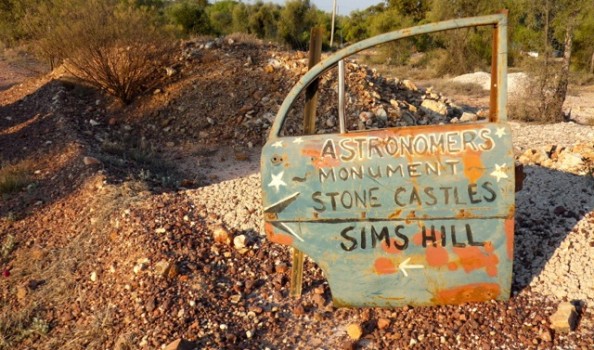 https://nakedhungrytraveller.com.au/opal-odyssey/ Opal OdysseyAustralian Festival of Travel Writing's 2013 winner of 'Best Australian Story' is by Sydney based writer, Marian McGuinness.
https://nakedhungrytraveller.com.au/opal-odyssey/ Opal OdysseyAustralian Festival of Travel Writing's 2013 winner of 'Best Australian Story' is by Sydney based writer, Marian McGuinness. Many thanks to all the other writers who sent in their stories. The selection process wasn't easy. Obviously, there are lots of budding writers out there seeking a voice in a crowded publishing world. Good luck to all of you but only one winner is allowed in this contest and Marian's story topped the short list.
We like Marian's story most for its warmly heart-felt sense of place. Using accurate descriptions and colourful phrasing, she captures Lightning Ridge during her short visit.
All the images in this story are also Marian's.
NHT hopes you like Marian's story about this eccentric outback town as much as we do.
Many thanks to all the other writers who sent in their stories. The selection process wasn't easy. Obviously, there are lots of budding writers out there seeking a voice in a crowded publishing world. Good luck to all of you but only one winner is allowed in this contest and Marian's story topped the short list.
We like Marian's story most for its warmly heart-felt sense of place. Using accurate descriptions and colourful phrasing, she captures Lightning Ridge during her short visit.
All the images in this story are also Marian's.
NHT hopes you like Marian's story about this eccentric outback town as much as we do.
Opal Odyssey
Lightning Ridge, NSW
by Marian McGuinness
It’s been a long, hot nine-hour drive from Sydney. The colonial towns we’ve passed through could have come straight out of a C.J. Dennis poem. The car tyres beat out the rhythm of Gilgandra, Gulargambone and Coonamble along bitumen and gravel as we race families of emus, part seas of flocking galahs and stop in our tracks for slithering red-bellied black snakes. We’ve passed golden canola fields and horizons of cotton plantations and we’ve stopped and chatted with a 10-year-old girl droving cattle along the red-rutted road. Her father is kilometres behind, bringing up the rear. We’re in the outback. Things are different. At dusk, the landscape changes. The silver scrub whooshes by camouflaging the grey kangaroos that make a break in front of our car as they play their game of hit and miss. It’s hard to see them as our windscreen is fractured like stained glass, with baked-on-bugs. After almost 800 kilometres we arrive in opal country. Black opal. Prized and rare. It is the only stone that has the colour of every other gemstone in it. The landscape belies the beauty found beneath. It’s kind of post-apocalyptic. Mad-Max meets Russell Drysdale’s earthy canvases of abandonment. The sign welcomes us. LIGHTNING RIDGE Population? The first thing we come to is the Artesian Bore Bath, a large round pool in the middle of the grey, stony earth blobbed with weeds and other dabs of desert greenery. It’s like a scene out of the 80s movie, Cocoon. A few local miners are soaking in the 42-degree mineral rich water that’s spent the last two million years underground. I chat to them while I stretch my legs. They’re wrinkly and weathered and animated. Even with their broken English it’s obvious they were bitten by the opal bug a lifetime ago. We’re on first name terms only, no surnames are offered. I ask about the sign with the question mark and they tell me it’s because nobody knows how many people are down the shafts. The census doesn’t help, as most don’t fill it in, “there are people out here who don’t want to be found.” The town earned its name in the 1870s when a drover and his sheep were sheltering from a fierce electrical storm. The lightning struck the ironstone ridge killing the drover, his dog and his 600 sheep. Straight away I feel a connection to this outback place. It’s ethereal and enigmatic. I don’t know what I’m going to find. The Dreamtime story adds to the magic. The opals are found here because of a huge fire wheel that fell to earth. As it spiralled, it sprayed the land with brilliantly coloured stones. Having been to the mostly underground opal town of Coober Pedy in South Australia, I’m surprised when driving through The Ridge to find so much activity above ground. Apart from the petrol station (where I’m propositioned by a toned and tanned bushie to come out to the diggings and see his shaft), there’s an IGA supermarket, cafes, pubs, art galleries and even a desert-version of an Olympic pool theme park. After spending the night in comfortable and spotless self-contained holiday cabins at Chasin’ Opal, my friends and I are ready to explore. Driving through the moonscape there are miners’ mullock heaps, rusty-tin covered mineshafts and mineral claims marked by regulation metre-high steel pickets and barbed wire. Rusty buckets dangle from crudely made windlasses. It’s wise to follow the local etiquette. When you see a mullock heap, don’t noodle it, as the miner still has to fossick it to find his pay dirt. There are ‘No Specking – Keep Off ’ signs studding the claims that bristle with grasses and tumbleweeds. Concrete mixers litter the landscape like art installations. They’ve been modified to agitate and separate the clay from the opal. In The Ridge, nothing is wasted. Lean-tos and huts have sprouted out of cans, bottles, tin and rock. At the Visitors Information Centre we pick up a brochure about the self-drive Car Door Tours. It’s a quirky enterprise for tourists to see the local sights and a unique way to recycle car doors. [caption id="attachment_1511" align="alignnone" width="480"]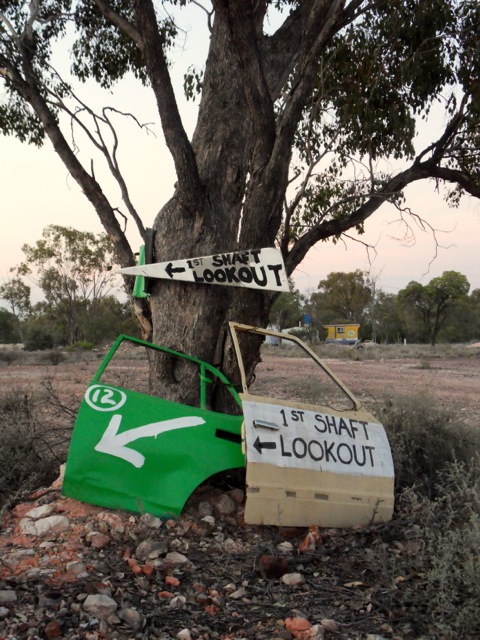 Lightning Ridge Car Door Tours sign.[/caption]
There are four itineraries, each one following a series of painted and numbered doors. There’s the red, blue, green and yellow tour. Each one takes around 30 minutes, but by the time you get out of your car and have a look around, it’s best to leave an hour for each tour.
One of the eccentricities on the Car Door Tours is Amigo’s Castle. Amigo was inspired by the Roman ruins near his home in northern Italy. After digging for opals, his luck never came, but with the ironstone extracted from his mining tunnels, rather than live in a camp he built his own castle, complete with turrets, trapdoors and a dungeon.
[caption id="attachment_1512" align="alignnone" width="640"]
Lightning Ridge Car Door Tours sign.[/caption]
There are four itineraries, each one following a series of painted and numbered doors. There’s the red, blue, green and yellow tour. Each one takes around 30 minutes, but by the time you get out of your car and have a look around, it’s best to leave an hour for each tour.
One of the eccentricities on the Car Door Tours is Amigo’s Castle. Amigo was inspired by the Roman ruins near his home in northern Italy. After digging for opals, his luck never came, but with the ironstone extracted from his mining tunnels, rather than live in a camp he built his own castle, complete with turrets, trapdoors and a dungeon.
[caption id="attachment_1512" align="alignnone" width="640"]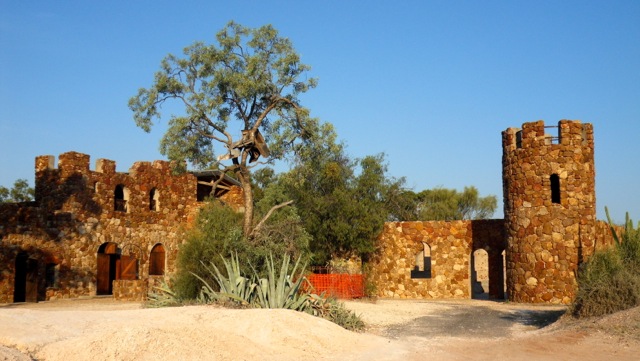 Amigo's Castle, built from ironstone extracted from his mining tunnels.[/caption]
The Astronomers’ Monument is another curiosity. Built as a tribute to the Polish astronomer Copernicus, fellow Pole and miner Alex Szperlak, used concrete in various bucket sizes to form the pillars. He then inscribed every surface with references to astronomy.
At Lunatic Hill we meet Brian. He’s in his 80s with eyes as bright as the opal he mines. “I’ve been 43 years in the game and too old to change.” He spins the yarn of how in 1911 some men went to mine the hill. “Whoever goes up there to mine’s a lunatic!” he mimics the codgers of old. “After seven weeks they got opal; helmets full of orange and green stone!” Brian’s told the story thousands of times, but he still laughs with delight, “when you get opal, there’s a hell of a lot of it.”
[caption id="attachment_1513" align="alignnone" width="480"]
Amigo's Castle, built from ironstone extracted from his mining tunnels.[/caption]
The Astronomers’ Monument is another curiosity. Built as a tribute to the Polish astronomer Copernicus, fellow Pole and miner Alex Szperlak, used concrete in various bucket sizes to form the pillars. He then inscribed every surface with references to astronomy.
At Lunatic Hill we meet Brian. He’s in his 80s with eyes as bright as the opal he mines. “I’ve been 43 years in the game and too old to change.” He spins the yarn of how in 1911 some men went to mine the hill. “Whoever goes up there to mine’s a lunatic!” he mimics the codgers of old. “After seven weeks they got opal; helmets full of orange and green stone!” Brian’s told the story thousands of times, but he still laughs with delight, “when you get opal, there’s a hell of a lot of it.”
[caption id="attachment_1513" align="alignnone" width="480"]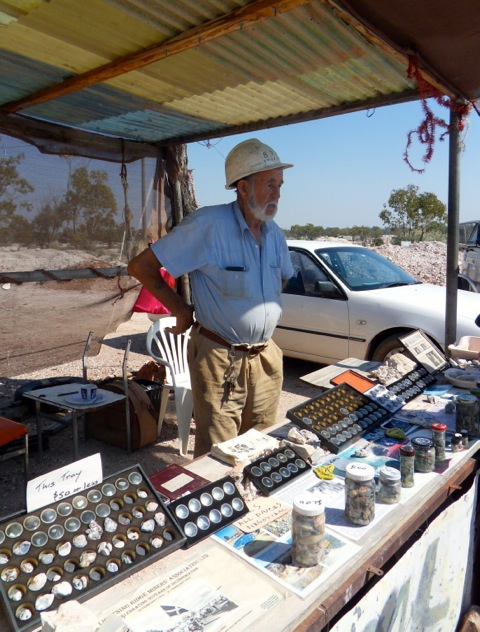 Brian, the prospector at Lunatic Hill, selling his wares.[/caption]
Tall tales and true tales, take your pick, there are plenty. There’s Harold Hodges, who had his false teeth made out of opals. After years of being asked to smile, Hodges put his colourful choppers on display for all to see at his local pub, by cementing them into the wall.
There are stories of the ratters of the 1900s. Like their namesakes, if these guys were found down other miners’ shafts they were tarred and feathered and run out of town. Just like in the Wild West.
Then there’s laconic John from the cactus farm. While checking out his cut opals, I remarked on how easy it would be to get rid of a body down one of the thousands of mine shafts. Not so, he replied, knowingly, “If you wanna make someone vanish, it’s easier to feed them to the wild pigs.” With that Hitchcock moment we left the prickly cacti and headed to another part of The Ridge, to the Indiana Jones sounding Chambers of the Black Hand.
Eighty steps down into the cool, damp 100-year-old mineshaft and we’re given the rundown on finding opal. Veteran miner, Don, explains that, unlike Coober Pedy, nobody lives underground here. It’s too moist. Bad for arthritis and besides, everything rusts. Not everybody strikes it rich. “I extracted a tennis court a meter and a half deep and ended up with colour in the palm of my hand. Two months’ work!”
[caption id="attachment_1514" align="alignnone" width="640"]
Brian, the prospector at Lunatic Hill, selling his wares.[/caption]
Tall tales and true tales, take your pick, there are plenty. There’s Harold Hodges, who had his false teeth made out of opals. After years of being asked to smile, Hodges put his colourful choppers on display for all to see at his local pub, by cementing them into the wall.
There are stories of the ratters of the 1900s. Like their namesakes, if these guys were found down other miners’ shafts they were tarred and feathered and run out of town. Just like in the Wild West.
Then there’s laconic John from the cactus farm. While checking out his cut opals, I remarked on how easy it would be to get rid of a body down one of the thousands of mine shafts. Not so, he replied, knowingly, “If you wanna make someone vanish, it’s easier to feed them to the wild pigs.” With that Hitchcock moment we left the prickly cacti and headed to another part of The Ridge, to the Indiana Jones sounding Chambers of the Black Hand.
Eighty steps down into the cool, damp 100-year-old mineshaft and we’re given the rundown on finding opal. Veteran miner, Don, explains that, unlike Coober Pedy, nobody lives underground here. It’s too moist. Bad for arthritis and besides, everything rusts. Not everybody strikes it rich. “I extracted a tennis court a meter and a half deep and ended up with colour in the palm of my hand. Two months’ work!”
[caption id="attachment_1514" align="alignnone" width="640"] Mine shaft in foreground with rusty tin sheets and an extractor positioned over another mine shaft.[/caption]
As well as checking out the opal-bearing drives (tunnels), the other fascination is that for the last 14 years, miner, Ron Canlin has sculptured an underground art gallery using only a butter knife and spoon.
He’s chiseled an Egyptian chamber complete with a sarcophagus, hieroglyphics and Nefertiti. There’s The Last Supper, Nostradamus, the Terracotta Warriors, samurais and a huge Buddha. For the children, there’s a jungle room filled with African animals, and a plethora of Super Heroes. Canlin has even sculptured his own version of Mount Rushmore, but with Aussie Prime Ministers.
Back above ground we check out John Murray’s art gallery in Opal Street. His paintings capture life in the bush in all its quirks. His lightning storms are unique and his wit sparkles on canvas as he depicts the similarities of human and animal situations. You can see why his art hangs in many of the biggest boardrooms in Australia.
At sunset we head to the outskirts of town, to the original sandstone-capped mining area called Nettleton’s First Shaft. The landscape softens from rusty orange to watermelon pink. It’s crunch-dry beneath my shoes as I fossick in the clay and trace, hoping to turn over a bit of colour.
I’m walking on the sea floor of 120 million years ago, where toothy marine monsters sank in their death that ironically became their future. Opalised bones, flippers and teeth are being found daily, and Lightning Ridge has become a hot new playground for paleontologists, but I’m not destined to be a player. My reward is esoteric.
The whirr of miners’ wind turbines catches the dusk breeze. Distant birdsong stipples the sough of wind down the myriad mine shafts left uncovered by rusty sheets of tin. We gather in a kind of prayerful reverence with other tourists on the edge of the ridge and raise our wine-filled glasses to the west, to the centre of our continent until the sun flames like liquid opal and melts into the horizon.
Naked Facts:
For more information about Lightning Ridge, including accommodation options, tours and festivals, see: www.lightningridgeinfo.com.au or www.visitnsw.com
Mine shaft in foreground with rusty tin sheets and an extractor positioned over another mine shaft.[/caption]
As well as checking out the opal-bearing drives (tunnels), the other fascination is that for the last 14 years, miner, Ron Canlin has sculptured an underground art gallery using only a butter knife and spoon.
He’s chiseled an Egyptian chamber complete with a sarcophagus, hieroglyphics and Nefertiti. There’s The Last Supper, Nostradamus, the Terracotta Warriors, samurais and a huge Buddha. For the children, there’s a jungle room filled with African animals, and a plethora of Super Heroes. Canlin has even sculptured his own version of Mount Rushmore, but with Aussie Prime Ministers.
Back above ground we check out John Murray’s art gallery in Opal Street. His paintings capture life in the bush in all its quirks. His lightning storms are unique and his wit sparkles on canvas as he depicts the similarities of human and animal situations. You can see why his art hangs in many of the biggest boardrooms in Australia.
At sunset we head to the outskirts of town, to the original sandstone-capped mining area called Nettleton’s First Shaft. The landscape softens from rusty orange to watermelon pink. It’s crunch-dry beneath my shoes as I fossick in the clay and trace, hoping to turn over a bit of colour.
I’m walking on the sea floor of 120 million years ago, where toothy marine monsters sank in their death that ironically became their future. Opalised bones, flippers and teeth are being found daily, and Lightning Ridge has become a hot new playground for paleontologists, but I’m not destined to be a player. My reward is esoteric.
The whirr of miners’ wind turbines catches the dusk breeze. Distant birdsong stipples the sough of wind down the myriad mine shafts left uncovered by rusty sheets of tin. We gather in a kind of prayerful reverence with other tourists on the edge of the ridge and raise our wine-filled glasses to the west, to the centre of our continent until the sun flames like liquid opal and melts into the horizon.
Naked Facts:
For more information about Lightning Ridge, including accommodation options, tours and festivals, see: www.lightningridgeinfo.com.au or www.visitnsw.com
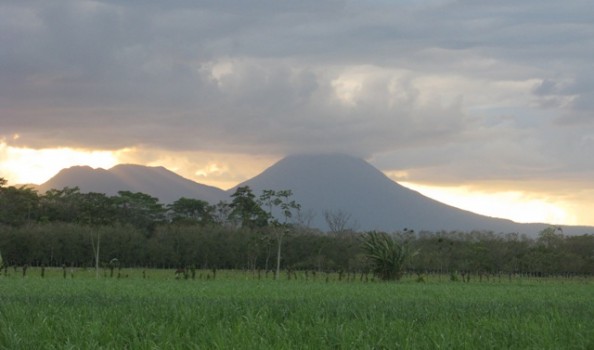 https://nakedhungrytraveller.com.au/by-the-shade-of-arenal-costa-ricas-perfect-volcano/ By the Shade of Arenal, Costa Rica's Perfect VolcanoCosta Rica’s businesses are doing a roaring trade in sustainable travel and eco-tourism. For a small country, it packs a lot in.
https://nakedhungrytraveller.com.au/by-the-shade-of-arenal-costa-ricas-perfect-volcano/ By the Shade of Arenal, Costa Rica's Perfect VolcanoCosta Rica’s businesses are doing a roaring trade in sustainable travel and eco-tourism. For a small country, it packs a lot in. I’m minding my own business, sipping from a cup of coffee while meandering through a three day old copy of the International Herald, waiting patiently for an order of huevos rancheros to be delivered. So far, it’s been another beautiful morning of bright sunshine, clear skies and fresh air at Tabacon Grand Spa Thermal Resort. A few kilometres away volcanic Mount Arenal thrusts upwards into its perpetual cloud halo, green summit peaking above like a pointed cap on a white sombrero brim.
[caption id="attachment_2125" align="alignnone" width="261"]
I’m minding my own business, sipping from a cup of coffee while meandering through a three day old copy of the International Herald, waiting patiently for an order of huevos rancheros to be delivered. So far, it’s been another beautiful morning of bright sunshine, clear skies and fresh air at Tabacon Grand Spa Thermal Resort. A few kilometres away volcanic Mount Arenal thrusts upwards into its perpetual cloud halo, green summit peaking above like a pointed cap on a white sombrero brim.
[caption id="attachment_2125" align="alignnone" width="261"]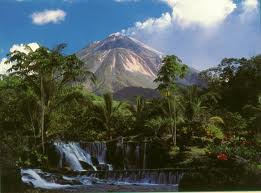 Arenal volcano looming over Tabacon resort.[/caption]
Gelled into a state of scenic euphoria by Arenal’s constant beauty, I barely notice the waitress as she approaches with my plate. She walks straight towards me from the open air kitchen but stops suddenly and looks over her right shoulder, not in my direction but back towards the kitchen away from Arenal’s commanding presence. Eventually she slides my huevos on to the table. ‘Coatis,’ she says. ‘En la cocina.’
[caption id="attachment_2126" align="alignnone" width="339"]
Arenal volcano looming over Tabacon resort.[/caption]
Gelled into a state of scenic euphoria by Arenal’s constant beauty, I barely notice the waitress as she approaches with my plate. She walks straight towards me from the open air kitchen but stops suddenly and looks over her right shoulder, not in my direction but back towards the kitchen away from Arenal’s commanding presence. Eventually she slides my huevos on to the table. ‘Coatis,’ she says. ‘En la cocina.’
[caption id="attachment_2126" align="alignnone" width="339"]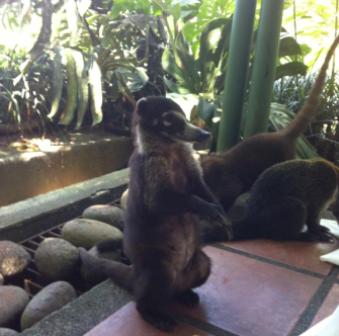 Coati Mundi begging at Tabacon breakfast.[/caption]
A troupe of coati-mundis is making a daily visit at the end of the morning’s service, searching for a hand out. Today’s treats are pancakes. I quickly finish my breakfast, down a glass of freshly squeezed orange juice, grab my camera and join the coatis for their turn at the breakfast buffet.
The previous night, a raccoon scampered behind my bar stool while I was sipping on a potent mango daiquiri in the hotel lobby's garden bar. Universally nicknamed 'masked bandits' this particular black-eyed shape-shifter pauses only to sniff an empty table (no leftover peanuts) and nearby lounge chair (no leftover food scraps hidden in the cushion) then disappears into the night.
While quaffing my second daiquiri, other guests also began to appear comically raccoon-ish, an effect of candlelight reflecting off sun burnt faces outlined by absent sunglasses.
Earlier that same day, shortly after my arrival to Tabacon I spied a basilisk lizard camouflaged behind a fern, positioning itself in a manicured plant arrangement as if frozen in space and time. When I turned to another guest and exclaimed, ‘Look, a rare lizard,’ the basilisk had suddenly disappeared and I was caught pointing uselessly and somewhat stupidly at a plain palm frond. That damn lizard was not seen again but I did have my camera ready.
[caption id="attachment_2127" align="alignnone" width="336"]
Coati Mundi begging at Tabacon breakfast.[/caption]
A troupe of coati-mundis is making a daily visit at the end of the morning’s service, searching for a hand out. Today’s treats are pancakes. I quickly finish my breakfast, down a glass of freshly squeezed orange juice, grab my camera and join the coatis for their turn at the breakfast buffet.
The previous night, a raccoon scampered behind my bar stool while I was sipping on a potent mango daiquiri in the hotel lobby's garden bar. Universally nicknamed 'masked bandits' this particular black-eyed shape-shifter pauses only to sniff an empty table (no leftover peanuts) and nearby lounge chair (no leftover food scraps hidden in the cushion) then disappears into the night.
While quaffing my second daiquiri, other guests also began to appear comically raccoon-ish, an effect of candlelight reflecting off sun burnt faces outlined by absent sunglasses.
Earlier that same day, shortly after my arrival to Tabacon I spied a basilisk lizard camouflaged behind a fern, positioning itself in a manicured plant arrangement as if frozen in space and time. When I turned to another guest and exclaimed, ‘Look, a rare lizard,’ the basilisk had suddenly disappeared and I was caught pointing uselessly and somewhat stupidly at a plain palm frond. That damn lizard was not seen again but I did have my camera ready.
[caption id="attachment_2127" align="alignnone" width="336"]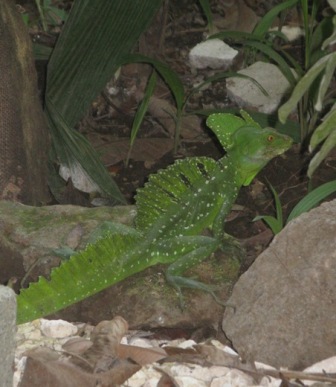 Basilisk Lizard at Tabacon.[/caption]
The following day in my room, gazing into jungle before breakfast from behind a wall of windows, I sit at my desk checking emails when a passing toucan chooses to perch on a tree limb just a few metres away from my laptop. So entranced by this bird’s sudden appearance, I forget to grab my camera. Do I need to have the camera permanently attached to my face while staying at Tabacon? Probably yes if I'm to have any luck taking snapshots of ethereal wildlife.
[caption id="attachment_2128" align="alignnone" width="248"]
Basilisk Lizard at Tabacon.[/caption]
The following day in my room, gazing into jungle before breakfast from behind a wall of windows, I sit at my desk checking emails when a passing toucan chooses to perch on a tree limb just a few metres away from my laptop. So entranced by this bird’s sudden appearance, I forget to grab my camera. Do I need to have the camera permanently attached to my face while staying at Tabacon? Probably yes if I'm to have any luck taking snapshots of ethereal wildlife.
[caption id="attachment_2128" align="alignnone" width="248"]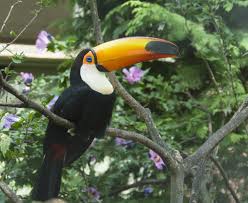 A missed toucan but you get the picture.[/caption]
Raccoons and coati-mundis are cousins, in the same animal family. Their paths cross only in Central America. Raccoons are North Americans. Coatis are South Americans. They occasionally meet in the middle, often where mango daiquiris are served. Costa Rica is in the middle of Central America, well known for the quality of its superlative mango daiquiris and raccoon coati interaction.
Politically speaking, Costa Rica is something of an anomaly. Surrounded by countries where corruption and guerrilla warfare are common, it sits peacefully like a green oasis in a desert of political destruction.
What’s Central America infamous for apart from exploding volcanoes, hurricanes and mono-cultured banana plantations?
Insurrection and revolution come immediately to mind. Since the late 60s, El Salvador, Nicaragua, Panama, Guatemala and Honduras have all been damaged severely by internecine strife.
During the last fifty years, only Belize (independent from the U.K since 1981) and Costa Rica have remained continuously safe for travellers.
In 1949, Costa Rica became one of the world’s few countries to abolish its military force by constitutional decree. A police force continues to operate, keeping crime mostly in check, but an army is non-existent.
Call me pie-eyed, but I feel very safe in a country without military personnel.
Environmentally speaking, Costa Rica is a world leader. Nearly 26% of its land area is devoted to national parks, biological reserves and officially protected forest areas, representing some 1,304,000 hectares. Each year over 300,000 visitors come to Costa Rica just to venture into its parks.
Back to breakfast... Coati-mundis have long tapered claws and sharp teeth, which belie their outward appearance. These small, furry and cute scroungers have the table manners of tiger sharks. It’s a snatch-and-grab breakfast frenzy, the dominant females and males hiss at low ranking troupe members, snapping at them if they get too close to choice bits of pancakes fresh off the griddle. I toss a few pieces over their dominant heads, aiming for the troupe’s outsiders.
Unlike the raccoon, basilisk lizard and toucan, the coatis are in full view of other late breakfasting guests. I need not say, ‘But it was there a second ago.’
Tabacon Grand Spa Thermal Resort is indeed something of a haven for wildlife. Everywhere I look other creatures are having a look at me, or grabbing pancakes from my hand.
Perhaps it’s possible to visit Tabacon and not see wildlife, but I don’t see that as being realistic. The Costa Rican highland jungles throb with life. Bio-diversity in these areas is a catch-phrase for ‘the neighbourhood’.
Though wildlife adds much to Tabacon’s undoubted charms, most visitors come here to take the waters. The whole resort is promoted to potential customers through its private access to volcanic thermal springs. Mount Arenal’s thermal steamy vents bubble underground like massive pressure cookers, heating fresh mountain water to various degrees of warmth, from scalding to tepid. In a region where average annual rainfall is around 350 centimetres, there’s plenty of water to go round, above ground and below.
[caption id="attachment_2132" align="alignnone" width="135"]
A missed toucan but you get the picture.[/caption]
Raccoons and coati-mundis are cousins, in the same animal family. Their paths cross only in Central America. Raccoons are North Americans. Coatis are South Americans. They occasionally meet in the middle, often where mango daiquiris are served. Costa Rica is in the middle of Central America, well known for the quality of its superlative mango daiquiris and raccoon coati interaction.
Politically speaking, Costa Rica is something of an anomaly. Surrounded by countries where corruption and guerrilla warfare are common, it sits peacefully like a green oasis in a desert of political destruction.
What’s Central America infamous for apart from exploding volcanoes, hurricanes and mono-cultured banana plantations?
Insurrection and revolution come immediately to mind. Since the late 60s, El Salvador, Nicaragua, Panama, Guatemala and Honduras have all been damaged severely by internecine strife.
During the last fifty years, only Belize (independent from the U.K since 1981) and Costa Rica have remained continuously safe for travellers.
In 1949, Costa Rica became one of the world’s few countries to abolish its military force by constitutional decree. A police force continues to operate, keeping crime mostly in check, but an army is non-existent.
Call me pie-eyed, but I feel very safe in a country without military personnel.
Environmentally speaking, Costa Rica is a world leader. Nearly 26% of its land area is devoted to national parks, biological reserves and officially protected forest areas, representing some 1,304,000 hectares. Each year over 300,000 visitors come to Costa Rica just to venture into its parks.
Back to breakfast... Coati-mundis have long tapered claws and sharp teeth, which belie their outward appearance. These small, furry and cute scroungers have the table manners of tiger sharks. It’s a snatch-and-grab breakfast frenzy, the dominant females and males hiss at low ranking troupe members, snapping at them if they get too close to choice bits of pancakes fresh off the griddle. I toss a few pieces over their dominant heads, aiming for the troupe’s outsiders.
Unlike the raccoon, basilisk lizard and toucan, the coatis are in full view of other late breakfasting guests. I need not say, ‘But it was there a second ago.’
Tabacon Grand Spa Thermal Resort is indeed something of a haven for wildlife. Everywhere I look other creatures are having a look at me, or grabbing pancakes from my hand.
Perhaps it’s possible to visit Tabacon and not see wildlife, but I don’t see that as being realistic. The Costa Rican highland jungles throb with life. Bio-diversity in these areas is a catch-phrase for ‘the neighbourhood’.
Though wildlife adds much to Tabacon’s undoubted charms, most visitors come here to take the waters. The whole resort is promoted to potential customers through its private access to volcanic thermal springs. Mount Arenal’s thermal steamy vents bubble underground like massive pressure cookers, heating fresh mountain water to various degrees of warmth, from scalding to tepid. In a region where average annual rainfall is around 350 centimetres, there’s plenty of water to go round, above ground and below.
[caption id="attachment_2132" align="alignnone" width="135"] Tabacon's thermal pools are idyllic.[/caption]
The scalding pools are proscribed as wisely off limits to visitors while the hot, warm, tepid or cool springs are open to hotel guests and visitors alike, though hotel guests receive special passports to the best bits of the vast areas of springs and pools tumbling through lush jungle gardens.
[caption id="attachment_2129" align="alignnone" width="259"]
Tabacon's thermal pools are idyllic.[/caption]
The scalding pools are proscribed as wisely off limits to visitors while the hot, warm, tepid or cool springs are open to hotel guests and visitors alike, though hotel guests receive special passports to the best bits of the vast areas of springs and pools tumbling through lush jungle gardens.
[caption id="attachment_2129" align="alignnone" width="259"]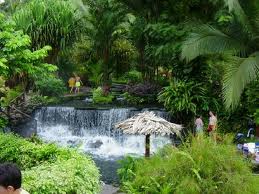 A small section of Tabacon's thermal pools and gardens.[/caption]
To describe these springs as Eden-esque doesn’t do them justice. Sometimes mankind and nature come together in a semblance of perfect harmony.
[caption id="attachment_2131" align="alignnone" width="277"]
A small section of Tabacon's thermal pools and gardens.[/caption]
To describe these springs as Eden-esque doesn’t do them justice. Sometimes mankind and nature come together in a semblance of perfect harmony.
[caption id="attachment_2131" align="alignnone" width="277"]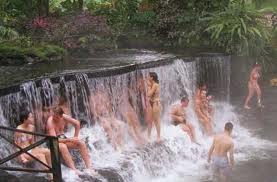 One of Tabacon's many thermal waterfalls.[/caption]
Tabacon’s springs and its gardens are prime examples of how best to integrate nature and commerce with low-impact human adjustment.
[caption id="attachment_2130" align="alignnone" width="259"]
One of Tabacon's many thermal waterfalls.[/caption]
Tabacon’s springs and its gardens are prime examples of how best to integrate nature and commerce with low-impact human adjustment.
[caption id="attachment_2130" align="alignnone" width="259"] Relaxing in one of Tabacon's thermal pools.[/caption]
Tabacon is a fully self-contained resort. The region’s main tourist town, La Fortuna is approximately ten kilometres away. It’s packed with low-budget hostels like I’ve seen everywhere else in similar tourist towns from Egypt to Indonesia. Cafes advertising banana pancakes, milkshakes and burgers look pretty much the same here as they do in Des Moines, Iowa, except here the streets are slightly more littered but the hand painted signs are more quaint.
After more than 400 years of dormancy, in 1968 Mount Arenal erupted spectacularly and suddenly, killing 87 people and burying three nearby villages: Tabacon, San Luis and Pueblo Nuevo under metres of volcanic ash. La Fortuna (The Fortune) town subsequently emerged as the main entry point to the Tabacon tourist zone, its national park and gorgeous lake at the base of the volcano itself.
Tabacon Grand Spa Thermal Resort is the region’s best and well worth the price. If a break from laying about on one of Costa Rica’s enticing beaches or from enthusiastically enjoying one of its many national park treks is needed, a bit of luxury at a volcanic springs is the ticket.
Just watch out for coati-mundi greed at breakfast, camera shy toucans, basilisk lizards practicing invisibility tricks and bar hopping raccoons.
Tom Neal Tacker visited Costa Rica as a guest of Tabacon Grand Spa Thermal Resort.
Naked Facts:
See www.tabacon.com for details and bookings.
The resort operates a professional spa, aptly named the Grand Spa, as well as maintaining the gardens and water quality of its private volcanic springs. The usual massages, manicures, pedicures, facials and other healing options are on offer. The Grand Spa’s treatment rooms and grounds look impressive but I’m unable to lend advice about the quality of its treatments. None was offered. Bookings were difficult to come by and I felt a bit at the low end of the totem pole in terms of access.
The resort operates two restaurants, one at the thermal springs approximately 500 metres walk from the resort itself and one in the resort grounds near its pool. The thermal spring’s restaurant caters to both hotel guests and day-trippers and operates as a buffet. Enough said.
The more upmarket restaurant on the resort grounds is actually quite lovely. Food is well above standard resort fare in this part of the world with some dishes indicating thoughtful and talented execution.
Service in all areas of the resort is flawless. All employees with whom I interacted were friendly, efficient, informed and downright charming.
I was given a suite for my two night’s stay. I think it was the same one the actor Will Smith occupied when he stayed in the area while making a film. It was huge and well appointed with large floor to ceiling windows. Unfortunately, building repairs were taking place outside my windows in the rooms next door. Construction noise intruded during the day but didn’t seem to bother the toucan.
Tabacon Grand Spa Thermal Resort is approximately three hours drive from Costa Rica’s capital city, San Jose. Private mini-bus transport to and from various hotels in San Jose to Tabacon can be organised by the resort when booking. Cost is approximately USD$100 return trip. Taxis to and from San Jose and the resort are available but vastly more expensive. Negotiate the fare before departure. Costa Rican roads are narrow and crowded. Journeys take much longer than distance would lead one to assume. Go slow and enjoy the ride. The scenery is magnificent and people are obedient to road rules.
Naked Tips:
Costa Rica’s Tourism Board operates a website. See: www.visitcostarica.com
My experience dealing with the official tourism board was very disappointing. Three separate email enquiries went unanswered. Frustrated, I rang the international marketing representative in the USA, reached a voice mail message, left a reply with contact details and reference to unanswered emails but never received a reply to that message either.
For a country so heavily reliant upon tourism for its economic success, I found its national tourism board’s inaction farcical in its treatment of genuine inquiries about travel to and within its country.
NHT’s advice is to view the website merely as a suggestive information source. Gaining real sound advice from a Costa Rican national tourism board employee is apparently a chimera.
Relaxing in one of Tabacon's thermal pools.[/caption]
Tabacon is a fully self-contained resort. The region’s main tourist town, La Fortuna is approximately ten kilometres away. It’s packed with low-budget hostels like I’ve seen everywhere else in similar tourist towns from Egypt to Indonesia. Cafes advertising banana pancakes, milkshakes and burgers look pretty much the same here as they do in Des Moines, Iowa, except here the streets are slightly more littered but the hand painted signs are more quaint.
After more than 400 years of dormancy, in 1968 Mount Arenal erupted spectacularly and suddenly, killing 87 people and burying three nearby villages: Tabacon, San Luis and Pueblo Nuevo under metres of volcanic ash. La Fortuna (The Fortune) town subsequently emerged as the main entry point to the Tabacon tourist zone, its national park and gorgeous lake at the base of the volcano itself.
Tabacon Grand Spa Thermal Resort is the region’s best and well worth the price. If a break from laying about on one of Costa Rica’s enticing beaches or from enthusiastically enjoying one of its many national park treks is needed, a bit of luxury at a volcanic springs is the ticket.
Just watch out for coati-mundi greed at breakfast, camera shy toucans, basilisk lizards practicing invisibility tricks and bar hopping raccoons.
Tom Neal Tacker visited Costa Rica as a guest of Tabacon Grand Spa Thermal Resort.
Naked Facts:
See www.tabacon.com for details and bookings.
The resort operates a professional spa, aptly named the Grand Spa, as well as maintaining the gardens and water quality of its private volcanic springs. The usual massages, manicures, pedicures, facials and other healing options are on offer. The Grand Spa’s treatment rooms and grounds look impressive but I’m unable to lend advice about the quality of its treatments. None was offered. Bookings were difficult to come by and I felt a bit at the low end of the totem pole in terms of access.
The resort operates two restaurants, one at the thermal springs approximately 500 metres walk from the resort itself and one in the resort grounds near its pool. The thermal spring’s restaurant caters to both hotel guests and day-trippers and operates as a buffet. Enough said.
The more upmarket restaurant on the resort grounds is actually quite lovely. Food is well above standard resort fare in this part of the world with some dishes indicating thoughtful and talented execution.
Service in all areas of the resort is flawless. All employees with whom I interacted were friendly, efficient, informed and downright charming.
I was given a suite for my two night’s stay. I think it was the same one the actor Will Smith occupied when he stayed in the area while making a film. It was huge and well appointed with large floor to ceiling windows. Unfortunately, building repairs were taking place outside my windows in the rooms next door. Construction noise intruded during the day but didn’t seem to bother the toucan.
Tabacon Grand Spa Thermal Resort is approximately three hours drive from Costa Rica’s capital city, San Jose. Private mini-bus transport to and from various hotels in San Jose to Tabacon can be organised by the resort when booking. Cost is approximately USD$100 return trip. Taxis to and from San Jose and the resort are available but vastly more expensive. Negotiate the fare before departure. Costa Rican roads are narrow and crowded. Journeys take much longer than distance would lead one to assume. Go slow and enjoy the ride. The scenery is magnificent and people are obedient to road rules.
Naked Tips:
Costa Rica’s Tourism Board operates a website. See: www.visitcostarica.com
My experience dealing with the official tourism board was very disappointing. Three separate email enquiries went unanswered. Frustrated, I rang the international marketing representative in the USA, reached a voice mail message, left a reply with contact details and reference to unanswered emails but never received a reply to that message either.
For a country so heavily reliant upon tourism for its economic success, I found its national tourism board’s inaction farcical in its treatment of genuine inquiries about travel to and within its country.
NHT’s advice is to view the website merely as a suggestive information source. Gaining real sound advice from a Costa Rican national tourism board employee is apparently a chimera. https://nakedhungrytraveller.com.au/dateline-samoa/ Dateline, Samoa
https://nakedhungrytraveller.com.au/dateline-samoa/ Dateline, SamoaPolynesia’s friendliest archipelago is also its historical heartland.
On 29 December 2011, Samoa changed time. Moving itself across the International Dateline from west to east, Samoa and its 186,000 inhabitants all at once became closer to Australia and New Zealand. Not physically of course. The archipelago stays where it is. What has happened is that Samoa has stepped back in time, literally. Visitors flying from eastern Australia will no longer arrive earlier the same day, instead arriving later the same day. Leaving Samoa will no longer involve losing an entire day. From December 31, 2011 visitors flying out of Samoa’s international airport at Faleolo (45 minutes drive from the capital city, Apia) will arrive in Melbourne or Sydney the same day. Losing an entire day upon returning from Samoa has become a thing of the past. Given that over 60% of visitors to Samoa are from Australia and New Zealand, the time shift has meant that travel to Samoa became vastly easier. Samoa, known by many savvy travellers as the heart of Polynesia, is blessed. I could say Samoa is also blessed with some of the most attractive beaches in all of the South Pacific, friendly people too, comfortable tropical weather certainly. What I also mean is that it is blessed every day between 6pm and 7pm, the so-called ‘evening prayer curfew’ when all good Samoans indulge in some quiet down time, hopefully in contemplation or prayer according to Samoa’s government policy. In nearly every one of Samoa’s 362 villages there is a church. There may not be a shop or a post office, but there is a church. The only competition to churches as Samoa’s dominant shopfront presence, are remittance offices. Though tourism is Samoa’s largest industry, many Samoans rely heavily on remittance money from family members working abroad, mostly in either New Zealand or Australia. Remittance payments are Samoa’s second largest source of income. Don’t be surprised to see a Jehovah’s Witness hall next to a LMS (London Missionary Society) church next to a Western Union office in nearly all Samoan villages. [caption id="attachment_2385" align="alignnone" width="166"] One of many churches in Samoa.[/caption]
Samoa was colonised primarily by Congregational Christians, Catholics and Methodists. Like Tonga, Samoa is proud of its fiercely conservative Christian ethos. Seventh Day Adventists, Mormons and Jehovah’s Witnesses also have a significant presence in the god bothering community.
Though the heads of these churches hold much moral power in their holy hands, some 18,000 matai (chiefs), retain social and political power. Through them Samoan culture and history is preserved.
What the Lord taketh away, the Lord giveth back, right? While church going is part and parcel to Samoa’s way of life, I must add it’s all very relaxed. Balmy heat and cooling offshore breezes have taken some of the steam out of the proselytising. Thank goodness as it gives visitors plenty of opportunity to engage with some of the friendliest people in all of Polynesia.
First time visitors to Samoa should prepare to do nothing. Quite simply there isn’t a lot to do. No adventure theme parks. No casinos (not yet anyway though rumours abound that a planning permit to build a casino at Aggie Grey's Resort has been granted by the Samoan Government). There are no mega-resort hotels with kiddie activities and hundreds of rooms. No zoos or Sea World type aquatic attractions boasting frustrated orcas held captive in small tanks. No major sporting events, unless the Samoan rugby team wins big and hosts a Cup match. No large yachting marinas full of pleasure palaces. No thumping bars full of pie-eyed backpackers on a bar-hopping world tour.
Don’t come to Samoa and expect a light show in a disco. Don’t even expect a disco for that matter.
Apia is small and mostly quiet. Even more quiet as recent spates of violence between competing gangs of bored youths have been suppressed by police. One particularly notorious nightclub, almost next door to famed Aggie Grey’s hotel in sleep downtown Apia, has been condemned and closed. Apparently much of the violence originated there. The place now looks a wreck, seedy from the outside, dingy and reeking of stale beer and vomit inside. Once it may have been a fun place to down a few cans of Vailima (meaning ‘Five Waters’ and also the name of Robert Louis Stevenson’s estate) Samoa’s local brew, but those days are long gone. Demolition has been scheduled with shops and offices as replacements.
[caption id="attachment_2381" align="alignnone" width="184"]
One of many churches in Samoa.[/caption]
Samoa was colonised primarily by Congregational Christians, Catholics and Methodists. Like Tonga, Samoa is proud of its fiercely conservative Christian ethos. Seventh Day Adventists, Mormons and Jehovah’s Witnesses also have a significant presence in the god bothering community.
Though the heads of these churches hold much moral power in their holy hands, some 18,000 matai (chiefs), retain social and political power. Through them Samoan culture and history is preserved.
What the Lord taketh away, the Lord giveth back, right? While church going is part and parcel to Samoa’s way of life, I must add it’s all very relaxed. Balmy heat and cooling offshore breezes have taken some of the steam out of the proselytising. Thank goodness as it gives visitors plenty of opportunity to engage with some of the friendliest people in all of Polynesia.
First time visitors to Samoa should prepare to do nothing. Quite simply there isn’t a lot to do. No adventure theme parks. No casinos (not yet anyway though rumours abound that a planning permit to build a casino at Aggie Grey's Resort has been granted by the Samoan Government). There are no mega-resort hotels with kiddie activities and hundreds of rooms. No zoos or Sea World type aquatic attractions boasting frustrated orcas held captive in small tanks. No major sporting events, unless the Samoan rugby team wins big and hosts a Cup match. No large yachting marinas full of pleasure palaces. No thumping bars full of pie-eyed backpackers on a bar-hopping world tour.
Don’t come to Samoa and expect a light show in a disco. Don’t even expect a disco for that matter.
Apia is small and mostly quiet. Even more quiet as recent spates of violence between competing gangs of bored youths have been suppressed by police. One particularly notorious nightclub, almost next door to famed Aggie Grey’s hotel in sleep downtown Apia, has been condemned and closed. Apparently much of the violence originated there. The place now looks a wreck, seedy from the outside, dingy and reeking of stale beer and vomit inside. Once it may have been a fun place to down a few cans of Vailima (meaning ‘Five Waters’ and also the name of Robert Louis Stevenson’s estate) Samoa’s local brew, but those days are long gone. Demolition has been scheduled with shops and offices as replacements.
[caption id="attachment_2381" align="alignnone" width="184"]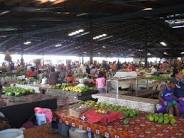 Fugalei food market in Apia.[/caption]
Two markets are the lively places in which to hang out during a day or two in Apia, the Savalalo Flea Market, open seven days, and the Fugalei Fruit Produce market, also open seven days.
[caption id="attachment_2382" align="alignnone" width="217"]
Fugalei food market in Apia.[/caption]
Two markets are the lively places in which to hang out during a day or two in Apia, the Savalalo Flea Market, open seven days, and the Fugalei Fruit Produce market, also open seven days.
[caption id="attachment_2382" align="alignnone" width="217"]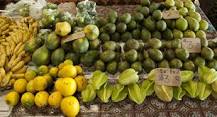 Fruits and vegetables for sale.[/caption]
Siapo is the best buy. Tapa is the Tongan word. In Samoan, it's siapo. They're the same thing apart from different design themes representing tribal or family origins.
[caption id="attachment_2386" align="alignnone" width="190"]
Fruits and vegetables for sale.[/caption]
Siapo is the best buy. Tapa is the Tongan word. In Samoan, it's siapo. They're the same thing apart from different design themes representing tribal or family origins.
[caption id="attachment_2386" align="alignnone" width="190"]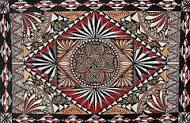 A more complex Samoan siapo design.[/caption]
These hand-painted and hand-made textiles from the indigenous mulberry tree, or u’a in Samoan, are good buys at Savalolo. Fugalei is the place to mix with Apians shopping for the day’s groceries.
[caption id="attachment_2380" align="alignnone" width="283"]
A more complex Samoan siapo design.[/caption]
These hand-painted and hand-made textiles from the indigenous mulberry tree, or u’a in Samoan, are good buys at Savalolo. Fugalei is the place to mix with Apians shopping for the day’s groceries.
[caption id="attachment_2380" align="alignnone" width="283"] Savololo Flea Market scene.[/caption]
While cruising through Apia’s ramshackle and mostly boring assortment of shops, I found a 2009 diary on sale at a second hand Christian bookshop, marked down to ten tala. What anyone would do with an outdated diary is beyond me but I considered the shopkeeper’s attempt as shelf filling quite endearing. Try as I might, I couldn’t find a 2008 diary for five tala to create a mismatched set.
The most fun I had in Apia was during a ride on a 'Pasi Liupapa', Samoa's answer to public transport. A motley collection of privately owned antiquated buses circulate both main islands as a service to the majority of Samoans.
[caption id="attachment_2376" align="alignnone" width="198"]
Savololo Flea Market scene.[/caption]
While cruising through Apia’s ramshackle and mostly boring assortment of shops, I found a 2009 diary on sale at a second hand Christian bookshop, marked down to ten tala. What anyone would do with an outdated diary is beyond me but I considered the shopkeeper’s attempt as shelf filling quite endearing. Try as I might, I couldn’t find a 2008 diary for five tala to create a mismatched set.
The most fun I had in Apia was during a ride on a 'Pasi Liupapa', Samoa's answer to public transport. A motley collection of privately owned antiquated buses circulate both main islands as a service to the majority of Samoans.
[caption id="attachment_2376" align="alignnone" width="198"]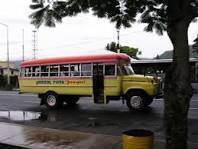 Public transport Samoan style.[/caption]
Though the bus chassis are imported, the rest of the vehicle is made proudly by Samoans. Picture an old Bedford truck chassis attached to a brightly painted wooden frame often festooned with cartoon figures. The handmade windows are cloudy and scratched Perspex slats pulled up from inside the framework that fit inside the window frame itself. To close, press against the Perspex, lift and let it drop back into the frame. When twenty slats are dropped simultaneously into their hard wooden frames, a sharp cracking noise ensues, which happens constantly during frequent but heavy downpours.
[caption id="attachment_2377" align="alignnone" width="191"]
Public transport Samoan style.[/caption]
Though the bus chassis are imported, the rest of the vehicle is made proudly by Samoans. Picture an old Bedford truck chassis attached to a brightly painted wooden frame often festooned with cartoon figures. The handmade windows are cloudy and scratched Perspex slats pulled up from inside the framework that fit inside the window frame itself. To close, press against the Perspex, lift and let it drop back into the frame. When twenty slats are dropped simultaneously into their hard wooden frames, a sharp cracking noise ensues, which happens constantly during frequent but heavy downpours.
[caption id="attachment_2377" align="alignnone" width="191"]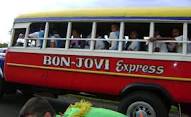 Bon Jovi is played here.[/caption]
Each 'Pasi Liupapa' boasts an impressive sound system, the only contemporary accessory deemed compulsory. Drivers compete with one another in a contest to see who can play the strangest medley of tunes the loudest. When I visited Samoa shortly before the Christmas holiday, I heard various imaginative mixes of popular Christmas carols interspersed with Michael Jackson, Usher, Bing Crosby, Black Sabbath and Lady Gaga. Once I could have sworn I heard Rosemary Clooney.
[caption id="attachment_2378" align="alignnone" width="112"]
Bon Jovi is played here.[/caption]
Each 'Pasi Liupapa' boasts an impressive sound system, the only contemporary accessory deemed compulsory. Drivers compete with one another in a contest to see who can play the strangest medley of tunes the loudest. When I visited Samoa shortly before the Christmas holiday, I heard various imaginative mixes of popular Christmas carols interspersed with Michael Jackson, Usher, Bing Crosby, Black Sabbath and Lady Gaga. Once I could have sworn I heard Rosemary Clooney.
[caption id="attachment_2378" align="alignnone" width="112"]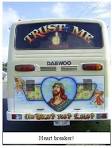 Jesus rides this bus.[/caption]
Timetables are virtually non-existent. At random I picked a Pasi outside the Savalalo market's Pasi park simply because it was the first Pasi ready for departure. On the ride out to Apia's hillside suburbs near the university, a quiet neighbourhood until my Pasi trundled down its sleepy streets blaring out 'Thriller' from loudspeakers that would make those in LA's Coliseum sound meek, we stopped in front of someone's house. One of the nicest aspects of riding a Pasi is that you can pull the cord connected to a buzzer near the driver's seat and he'll stop anywhere at anytime, from house to house if needs be.
[caption id="attachment_2379" align="alignnone" width="226"]
Jesus rides this bus.[/caption]
Timetables are virtually non-existent. At random I picked a Pasi outside the Savalalo market's Pasi park simply because it was the first Pasi ready for departure. On the ride out to Apia's hillside suburbs near the university, a quiet neighbourhood until my Pasi trundled down its sleepy streets blaring out 'Thriller' from loudspeakers that would make those in LA's Coliseum sound meek, we stopped in front of someone's house. One of the nicest aspects of riding a Pasi is that you can pull the cord connected to a buzzer near the driver's seat and he'll stop anywhere at anytime, from house to house if needs be.
[caption id="attachment_2379" align="alignnone" width="226"]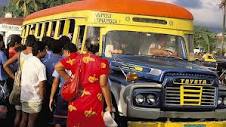 Passengers boarding bus.[/caption]
Riding a Pasi is not about arriving anywhere in a hurry; it's about the ride itself. A large female passenger descended from the Pasi but got wedged in the door. Many Samoan ladies are of ample proportions, particularly around the hip area and this one managed to get herself stuck in the door like a cork in a bottle of Champagne. If she was going to come out, she'd no doubt do it with a bang. The driver, an agile young man, leapt out from his window, ran round to the door and grabbed hold of her arms. Her friends, who had already descended from the Pasi, grabbed her legs. Another female passenger shoved her backside from inside. Eventually she popped out of the Pasi and fell on to the grassy verge. What was so charming and funny about the whole scene was the shared laughter. The lady giggled uncontrollably during the whole potentially embarrassing experience. As did her friends and everyone else on the Pasi, including me. The two hour circumnavigation of Apia's outer villages was an excursion of sheer joy and cost me about USD$5.
[caption id="attachment_2359" align="alignnone" width="335"]
Passengers boarding bus.[/caption]
Riding a Pasi is not about arriving anywhere in a hurry; it's about the ride itself. A large female passenger descended from the Pasi but got wedged in the door. Many Samoan ladies are of ample proportions, particularly around the hip area and this one managed to get herself stuck in the door like a cork in a bottle of Champagne. If she was going to come out, she'd no doubt do it with a bang. The driver, an agile young man, leapt out from his window, ran round to the door and grabbed hold of her arms. Her friends, who had already descended from the Pasi, grabbed her legs. Another female passenger shoved her backside from inside. Eventually she popped out of the Pasi and fell on to the grassy verge. What was so charming and funny about the whole scene was the shared laughter. The lady giggled uncontrollably during the whole potentially embarrassing experience. As did her friends and everyone else on the Pasi, including me. The two hour circumnavigation of Apia's outer villages was an excursion of sheer joy and cost me about USD$5.
[caption id="attachment_2359" align="alignnone" width="335"]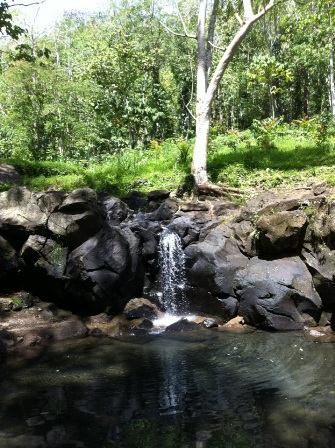 Pool at Vailima used by Robert Louis Stevenson and his family.[/caption]
Apia's other highlight is Robert Louis Stevenson's home and gardens at Vailima, approximately five kilometres from central Apia. Stevenson's final years are commemorated in the small museum. The house is a shrine to his memory and the impact he had on Samoans. 'Tusitala', the story-teller (as he was known locally) has grown large into one of Samoa's national heroes, a remarkable honour granted to a Scotsman who came late in his life to Samoa. The hike up to his grave is well worth the effort. Bring mosquito repellent and wear sturdy shoes.
[caption id="attachment_2360" align="alignnone" width="335"]
Pool at Vailima used by Robert Louis Stevenson and his family.[/caption]
Apia's other highlight is Robert Louis Stevenson's home and gardens at Vailima, approximately five kilometres from central Apia. Stevenson's final years are commemorated in the small museum. The house is a shrine to his memory and the impact he had on Samoans. 'Tusitala', the story-teller (as he was known locally) has grown large into one of Samoa's national heroes, a remarkable honour granted to a Scotsman who came late in his life to Samoa. The hike up to his grave is well worth the effort. Bring mosquito repellent and wear sturdy shoes.
[caption id="attachment_2360" align="alignnone" width="335"] RLS tomb at Vailima.[/caption]
Outside Apia and its modest night life, the remainder of Samoa is utterly quiet. Most visitors like it that way. The Samoans obviously prefer their peaceful yet fun loving way of life too.
Come to Samoa and do nothing much at all, though choices abound: surfing, sea kayaking, beach combing, swimming, snorkelling or SCUBA diving. After a few days of beach-y somnolence, making a choice poses an outlandish challenge. It’s far easier to sit by a pool and read a book. I trekked in a rainforest national park to Lake Lanutoo, the highest point on Upolu but found it strangely uninspiring. Indulging in doing lots of pleasurable nothing quickly became the goal I aspired to but sadly wasn’t able to attain. Perhaps I needed more time?
Outside Apia, Upolu becomes even more tranquil. The island’s best beaches are on the southern side, almost entirely recovered since the disastrous tsunami of 29 September 2009. Nearly three years later, almost all the physical destruction has disappeared, though the emotional damage persists. I spoke with several people who had lost close friends and cherished family. The worst hit areas from Saleopaga to Mulivai have fully recovered and the numerous small resorts are open for business and eager to welcome visitors.
[caption id="attachment_2362" align="alignnone" width="448"]
RLS tomb at Vailima.[/caption]
Outside Apia and its modest night life, the remainder of Samoa is utterly quiet. Most visitors like it that way. The Samoans obviously prefer their peaceful yet fun loving way of life too.
Come to Samoa and do nothing much at all, though choices abound: surfing, sea kayaking, beach combing, swimming, snorkelling or SCUBA diving. After a few days of beach-y somnolence, making a choice poses an outlandish challenge. It’s far easier to sit by a pool and read a book. I trekked in a rainforest national park to Lake Lanutoo, the highest point on Upolu but found it strangely uninspiring. Indulging in doing lots of pleasurable nothing quickly became the goal I aspired to but sadly wasn’t able to attain. Perhaps I needed more time?
Outside Apia, Upolu becomes even more tranquil. The island’s best beaches are on the southern side, almost entirely recovered since the disastrous tsunami of 29 September 2009. Nearly three years later, almost all the physical destruction has disappeared, though the emotional damage persists. I spoke with several people who had lost close friends and cherished family. The worst hit areas from Saleopaga to Mulivai have fully recovered and the numerous small resorts are open for business and eager to welcome visitors.
[caption id="attachment_2362" align="alignnone" width="448"]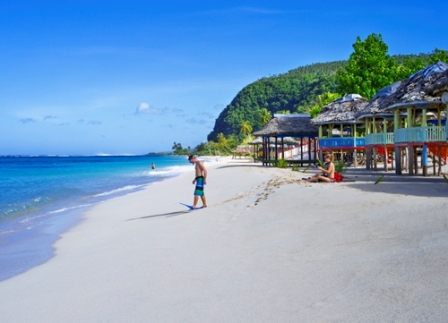 Typical Samoan beach scene.[/caption]
I stayed at Litia Sini Beach Resort, a small family owned collection of fales right on one of the most beautiful beaches in all Samoa. This was one of the resorts completely wiped away during the tsunami and had to be completely rebuilt. Though Litia Sini is bare basic accommodation with shared facilities and simple food, the spirit of hospitality is genuine. I've yet to experience a better place to while away the days doing nothing but floating dreamily in the crystalline waters of the lagoon, rather like a baby in a warm womb, very reluctant to emerge into the real world.
[caption id="attachment_2363" align="alignnone" width="448"]
Typical Samoan beach scene.[/caption]
I stayed at Litia Sini Beach Resort, a small family owned collection of fales right on one of the most beautiful beaches in all Samoa. This was one of the resorts completely wiped away during the tsunami and had to be completely rebuilt. Though Litia Sini is bare basic accommodation with shared facilities and simple food, the spirit of hospitality is genuine. I've yet to experience a better place to while away the days doing nothing but floating dreamily in the crystalline waters of the lagoon, rather like a baby in a warm womb, very reluctant to emerge into the real world.
[caption id="attachment_2363" align="alignnone" width="448"]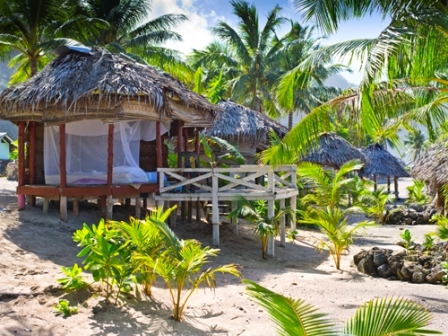 Samoan beach fale.[/caption]
Enticed by my Tourism Samoa host to wake from my napping mind state, I felt roused enough to join a day’s ocean kayaking excursion to nearby Namua Island out past Upolu's barrier reef. I'm thankful I did. With owner and chief paddler, Morten Hansen, a globe-trotting Danish yachtsman who ended up in Samoa while sailing around the world, we rowed into the wide open ocean swell. During the winter season (June to August) Southern humpback whales make occasional paddling companions, as do dolphins. We were happy with a dozen or so green turtles doing laps in the reef’s shipping passage. After a quick discussion we decided the fifteen kilometres paddling back to the beach off Litia Sini would be an exhilarating finish to the day, in stark contrast to my newly embraced Samoan influenced pastime of floating on my back in gently rocking tepid water while contemplating why lime and mangoes make such wonderful cocktail ingredients when blended with rum.
[caption id="attachment_2364" align="alignnone" width="336"]
Samoan beach fale.[/caption]
Enticed by my Tourism Samoa host to wake from my napping mind state, I felt roused enough to join a day’s ocean kayaking excursion to nearby Namua Island out past Upolu's barrier reef. I'm thankful I did. With owner and chief paddler, Morten Hansen, a globe-trotting Danish yachtsman who ended up in Samoa while sailing around the world, we rowed into the wide open ocean swell. During the winter season (June to August) Southern humpback whales make occasional paddling companions, as do dolphins. We were happy with a dozen or so green turtles doing laps in the reef’s shipping passage. After a quick discussion we decided the fifteen kilometres paddling back to the beach off Litia Sini would be an exhilarating finish to the day, in stark contrast to my newly embraced Samoan influenced pastime of floating on my back in gently rocking tepid water while contemplating why lime and mangoes make such wonderful cocktail ingredients when blended with rum.
[caption id="attachment_2364" align="alignnone" width="336"]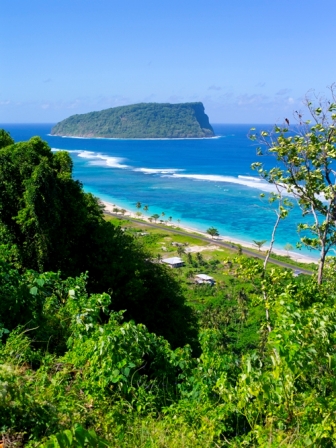 Kayaking beyond the barrier reef to Namua Island off Upolu is a lot of fun.[/caption]
By the time I moved on to Coconuts Beach Club, where I stayed for two nights of rum infused beach combing inactivity, I became convinced that Samoa is time averse. There simply is no concept of time for most Samoans. Days are ruled by sunrise and sunset with a bit of church thrown in to sort out the truly guilty from the quasi guilty.
[caption id="attachment_2375" align="alignnone" width="228"]
Kayaking beyond the barrier reef to Namua Island off Upolu is a lot of fun.[/caption]
By the time I moved on to Coconuts Beach Club, where I stayed for two nights of rum infused beach combing inactivity, I became convinced that Samoa is time averse. There simply is no concept of time for most Samoans. Days are ruled by sunrise and sunset with a bit of church thrown in to sort out the truly guilty from the quasi guilty.
[caption id="attachment_2375" align="alignnone" width="228"]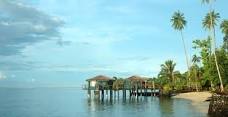 Coconuts Beach Club Resort & Spa overwater bungalows.[/caption]
Next door to Coconuts is Samoa’s most luxurious small resort, the Sinalei Reef Resort and Spa. I can vouch for the food here as I ate the best meal I’d had anywhere in Samoa.
[caption id="attachment_2374" align="alignnone" width="174"]
Coconuts Beach Club Resort & Spa overwater bungalows.[/caption]
Next door to Coconuts is Samoa’s most luxurious small resort, the Sinalei Reef Resort and Spa. I can vouch for the food here as I ate the best meal I’d had anywhere in Samoa.
[caption id="attachment_2374" align="alignnone" width="174"] Sinalei Resort pool.[/caption]
Though Upolu is Samoa’s most populous island, Savaii is bigger, much of it still uninhabited. Dominated by Mount Silisili (1,858 metres), Savaii is the fourth largest island in Polynesia after New Zealand’s South and North Islands and Hawaii.
I came to Savaii to look for palolo, the spawn of coral reef worms that rise on the high tides after the spring equinox during the full moons in either October or November. The ‘palolo rise’ (as it’s called in Samoa) in November is best off Upolu, in October off Savaii. I got the months mixed and was in the wrong place at the wrong time.
It was late November and I was in a dinghy off Asau in northern Savaii right at the edge of an offshore reef about a kilometre from the beach. Palolo skimming takes place just before dawn, any later and the worms dissolve in the strong sunlight. Swishing my mosquito netted bamboo hoop into warm water, I managed to gather up a few remnants of palolo.
[caption id="attachment_2372" align="alignnone" width="170"]
Sinalei Resort pool.[/caption]
Though Upolu is Samoa’s most populous island, Savaii is bigger, much of it still uninhabited. Dominated by Mount Silisili (1,858 metres), Savaii is the fourth largest island in Polynesia after New Zealand’s South and North Islands and Hawaii.
I came to Savaii to look for palolo, the spawn of coral reef worms that rise on the high tides after the spring equinox during the full moons in either October or November. The ‘palolo rise’ (as it’s called in Samoa) in November is best off Upolu, in October off Savaii. I got the months mixed and was in the wrong place at the wrong time.
It was late November and I was in a dinghy off Asau in northern Savaii right at the edge of an offshore reef about a kilometre from the beach. Palolo skimming takes place just before dawn, any later and the worms dissolve in the strong sunlight. Swishing my mosquito netted bamboo hoop into warm water, I managed to gather up a few remnants of palolo.
[caption id="attachment_2372" align="alignnone" width="170"]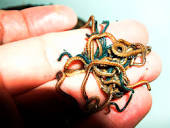 Palolo worms in hand.[/caption]
Most Samoans eat palolo fresh from the sea. Tasting somewhat like cheap caviar with a consistency akin to mucus, palolo is an acquired taste. Though it can be frozen, it’s best consumed fresh. I was hoping to experiment with palolo and arranged the use of the resort’s kitchen to try out a couple of recipes. Most Samoans, when not eating palolo right from the net, fry it in margarine or butter and serve it on toasted white bread. I was keen to try it in a version of risotto nero or fresh pasta marinara with chilli and lemon. Unfortunately all I got was enough for a half teaspoonful, barely a taste. The tiny strands of greenish palolo shimmered bleakly in waning moonlight from the bottom of my hand-made net. I squashed a few worms between my fingers, licked them and tasted sticky salt water.
[caption id="attachment_2389" align="alignnone" width="160"]
Palolo worms in hand.[/caption]
Most Samoans eat palolo fresh from the sea. Tasting somewhat like cheap caviar with a consistency akin to mucus, palolo is an acquired taste. Though it can be frozen, it’s best consumed fresh. I was hoping to experiment with palolo and arranged the use of the resort’s kitchen to try out a couple of recipes. Most Samoans, when not eating palolo right from the net, fry it in margarine or butter and serve it on toasted white bread. I was keen to try it in a version of risotto nero or fresh pasta marinara with chilli and lemon. Unfortunately all I got was enough for a half teaspoonful, barely a taste. The tiny strands of greenish palolo shimmered bleakly in waning moonlight from the bottom of my hand-made net. I squashed a few worms between my fingers, licked them and tasted sticky salt water.
[caption id="attachment_2389" align="alignnone" width="160"] The palolo I didn't get.[/caption]
Palolo has traditionally been an important source of much needed protein, particularly for early Samoans. Nowadays, with Polynesia’s embrace of all junk foods a l’American (Spam, Hormel’s tinned corned beef or various tinned beef stews and tinned tunas), palolo is not as important. Instead palolo is harvested as much for social interaction as it once was for food. Many boats filled with chatty Samoans were casting nets for palolo off Savaii when I was there. We all should have been off Upolu instead had we been truly serious about gathering quantities of palolo but I suspect the pleasure of paddling into the night to watch the sunrise over Mount Silisili was the real drawcard.
[caption id="attachment_2373" align="alignnone" width="169"]
The palolo I didn't get.[/caption]
Palolo has traditionally been an important source of much needed protein, particularly for early Samoans. Nowadays, with Polynesia’s embrace of all junk foods a l’American (Spam, Hormel’s tinned corned beef or various tinned beef stews and tinned tunas), palolo is not as important. Instead palolo is harvested as much for social interaction as it once was for food. Many boats filled with chatty Samoans were casting nets for palolo off Savaii when I was there. We all should have been off Upolu instead had we been truly serious about gathering quantities of palolo but I suspect the pleasure of paddling into the night to watch the sunrise over Mount Silisili was the real drawcard.
[caption id="attachment_2373" align="alignnone" width="169"] Netting palolo the traditional way.[/caption]
Daunted by Savaii’s lack of palolo, I went under water instead to look for other marine life. Only one dive operation exists on Savaii, aptly named Dive Savaii. Consistent with Samoa’s relaxed approach to all physical activity except football, diving from Fagamalo/Manase beach is a doddle. Wading into the water from a white sand beach, gear in hand, I boarded a small dive boat. We motored five minutes off shore, anchored, checked equipment and fell backwards into twenty metres of clear coral reef filled ocean. The main attraction there is the wreck of the Juno, a small schooner wrecked during a storm in 1881. The Juno was transporting missionaries from England to Samoa. No lives were lost, all passengers and crew swam safely to shore, no doubt taking their luck as a sign from heaven that the heathens were destined to be saved as well.
During another day when I was forced from the addictive Samoan state of tropical torpor, I drove up to Mount Matavanu and hiked up to its crater. As in Vanuatu and most South Pacific nations, the land around the crater is privately owned and a custom price needs to be paid to gain entry.
[caption id="attachment_2368" align="alignnone" width="335"]
Netting palolo the traditional way.[/caption]
Daunted by Savaii’s lack of palolo, I went under water instead to look for other marine life. Only one dive operation exists on Savaii, aptly named Dive Savaii. Consistent with Samoa’s relaxed approach to all physical activity except football, diving from Fagamalo/Manase beach is a doddle. Wading into the water from a white sand beach, gear in hand, I boarded a small dive boat. We motored five minutes off shore, anchored, checked equipment and fell backwards into twenty metres of clear coral reef filled ocean. The main attraction there is the wreck of the Juno, a small schooner wrecked during a storm in 1881. The Juno was transporting missionaries from England to Samoa. No lives were lost, all passengers and crew swam safely to shore, no doubt taking their luck as a sign from heaven that the heathens were destined to be saved as well.
During another day when I was forced from the addictive Samoan state of tropical torpor, I drove up to Mount Matavanu and hiked up to its crater. As in Vanuatu and most South Pacific nations, the land around the crater is privately owned and a custom price needs to be paid to gain entry.
[caption id="attachment_2368" align="alignnone" width="335"] Cr8erman's hand painted signs spread everywhere at the volcano.[/caption]
Here the land is managed, after a fashion by ‘Cr8erman’, an eccentric local character very fond of erecting hand painted signs around the crater’s rim, the track to its summit and the road between the entrance gate and the crater itself.
[caption id="attachment_2367" align="alignnone" width="335"]
Cr8erman's hand painted signs spread everywhere at the volcano.[/caption]
Here the land is managed, after a fashion by ‘Cr8erman’, an eccentric local character very fond of erecting hand painted signs around the crater’s rim, the track to its summit and the road between the entrance gate and the crater itself.
[caption id="attachment_2367" align="alignnone" width="335"] Cr8erman's work never stops.[/caption]
‘Cr8erman’ has a lot of time on his hands obviously or he’s unusually industrious for a laid-back Samoan man. I stopped counting his artworks after twenty colourful signs, deciding marvelling over the views of northern Savaii from Matavanu’s heights was a better use of my time.
[caption id="attachment_2365" align="alignnone" width="423"]
Cr8erman's work never stops.[/caption]
‘Cr8erman’ has a lot of time on his hands obviously or he’s unusually industrious for a laid-back Samoan man. I stopped counting his artworks after twenty colourful signs, deciding marvelling over the views of northern Savaii from Matavanu’s heights was a better use of my time.
[caption id="attachment_2365" align="alignnone" width="423"]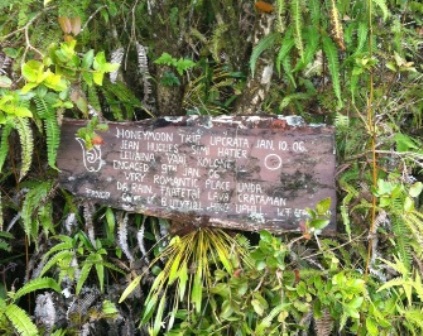 Cr8erman is very busy painting signs.[/caption]
One of the reasons Savaii is still relatively unpopulated is because Mount Matavanu erupted from 1905 until 1911, causing a large migration to Upolu’s less volcanically active landscape.
[caption id="attachment_2366" align="alignnone" width="335"]
Cr8erman is very busy painting signs.[/caption]
One of the reasons Savaii is still relatively unpopulated is because Mount Matavanu erupted from 1905 until 1911, causing a large migration to Upolu’s less volcanically active landscape.
[caption id="attachment_2366" align="alignnone" width="335"]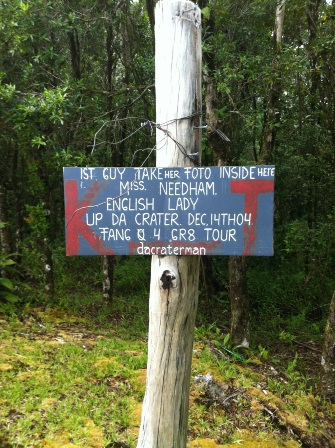 Cr8erman's work.[/caption]
Savaii’s other main tourist attraction, if it can be called that, is the Taga Blow Hole on the western side of the island. Facing the full force of the Pacific Ocean without the calming benefit of a barrier reef, this coastline is riddled with volcanic crevices, one of which has eroded into an underwater chamber with a hole in its ceiling. When the ocean swell is running high, Taga blows a fountain of seawater nearly a hundred metres into the air. I visited on a particularly calm day when the blowhole was about as strong as the current from my bathroom shower. Funnily enough, an elderly gentleman gains an income here by throwing green coconuts into the blowhole which are eventually swept into the current and expelled with great force high into the air. You pay him for the coconuts, stand back and wait to see a large nut shot into the sky. Pina coladas are not included in the ticket price. It’s an intriguing way to make a living.
[caption id="attachment_2371" align="alignnone" width="240"]
Cr8erman's work.[/caption]
Savaii’s other main tourist attraction, if it can be called that, is the Taga Blow Hole on the western side of the island. Facing the full force of the Pacific Ocean without the calming benefit of a barrier reef, this coastline is riddled with volcanic crevices, one of which has eroded into an underwater chamber with a hole in its ceiling. When the ocean swell is running high, Taga blows a fountain of seawater nearly a hundred metres into the air. I visited on a particularly calm day when the blowhole was about as strong as the current from my bathroom shower. Funnily enough, an elderly gentleman gains an income here by throwing green coconuts into the blowhole which are eventually swept into the current and expelled with great force high into the air. You pay him for the coconuts, stand back and wait to see a large nut shot into the sky. Pina coladas are not included in the ticket price. It’s an intriguing way to make a living.
[caption id="attachment_2371" align="alignnone" width="240"] Blowhole at Taga on a rough sea day.[/caption]
Fa’a Samoa, the Samoan way of life, is unavoidably at the heart of any discussion about Samoa. Centred in culture, religion and family, Fa’a Samoa is the bond that holds Samoa together in a hectic world.
Sunday is the day when families gather together for lunch, after everyone has attended morning church services of course. Like a Kiwi hungi; instead of burying the meat, fish and vegetables, a fire is lit, stones are placed on top and food is laid on the stones, covered and baked or steamed from early morning until midday. Then all the clans convene and feast until it’s time for an afternoon nap. After napping, most family groups make their way to the beach for a cooling dip or to watch the kids play in the shallows. Maybe a game of touch-rugby or a walk along the beach ensues. Evening prayer time follows, all beguilingly laid-back and pure in its old-fashioned innocence.
Go to Samoa to discover Fa’a Samoa. It may not shake your groove thing, but it will shake your conscience.
Tom Neal Tacker travelled to Samoa courtesy of Samoa's Tourism Authority.
Naked Facts:
Naked Sleeps:
[caption id="attachment_2383" align="alignnone" width="183"]
Blowhole at Taga on a rough sea day.[/caption]
Fa’a Samoa, the Samoan way of life, is unavoidably at the heart of any discussion about Samoa. Centred in culture, religion and family, Fa’a Samoa is the bond that holds Samoa together in a hectic world.
Sunday is the day when families gather together for lunch, after everyone has attended morning church services of course. Like a Kiwi hungi; instead of burying the meat, fish and vegetables, a fire is lit, stones are placed on top and food is laid on the stones, covered and baked or steamed from early morning until midday. Then all the clans convene and feast until it’s time for an afternoon nap. After napping, most family groups make their way to the beach for a cooling dip or to watch the kids play in the shallows. Maybe a game of touch-rugby or a walk along the beach ensues. Evening prayer time follows, all beguilingly laid-back and pure in its old-fashioned innocence.
Go to Samoa to discover Fa’a Samoa. It may not shake your groove thing, but it will shake your conscience.
Tom Neal Tacker travelled to Samoa courtesy of Samoa's Tourism Authority.
Naked Facts:
Naked Sleeps:
[caption id="attachment_2383" align="alignnone" width="183"] Aggie Grey's exterior in Apia.[/caption]
Aggie Grey’s Hotel is an Apia institution. Great central location, very friendly and well managed. Rooms aren’t flash but they’re comfortable. An ongoing renovation in 2013 is expanding and upgrading all facilities. The restaurants here are some of the best in all Samoa. See www.aggiegreys.com
Tanoa Tusitala Hotel in Apia is more modern than Aggie Grey’s, bigger rooms with slightly more upmarket facilities. See www.tanoatusitala.com
Coconuts Beach Club Resort & Spa on Upolu's southern coast is one of the country's best. www.cbcsamoa.com
Sinalei resort is Samoa's most luxurious boutique accommodation. Sophisticated cooking, excellent facilities and a sublime location makes this a stand-out place to stay. www.sinalei.com
Litia Sini is perfectly positioned on Upolu's best beach. Considering how many great beaches there are on Upolu, this is high praise indeed. Litia Sini is small, family owned and operated and very moderately priced. Accommodation is fairly basic but immaculately clean. Shared facilities (bathrooms) create a kind of 'camp' atmosphere, okay for some but not all travellers will cope with nocturnal toilet visits. Luckily the resort's single restaurant and bar is well run though the food is not very contemporary. www.litiasinibeach.ws
Naked Tips:
The Robert Louis Stevenson Museum and Mount Vaea Scenic Reserve on Apia’s outskirts is Samoa’s single most important tourist destination. Well worth visiting. See www.samoa.travel.com
Aggie Grey's exterior in Apia.[/caption]
Aggie Grey’s Hotel is an Apia institution. Great central location, very friendly and well managed. Rooms aren’t flash but they’re comfortable. An ongoing renovation in 2013 is expanding and upgrading all facilities. The restaurants here are some of the best in all Samoa. See www.aggiegreys.com
Tanoa Tusitala Hotel in Apia is more modern than Aggie Grey’s, bigger rooms with slightly more upmarket facilities. See www.tanoatusitala.com
Coconuts Beach Club Resort & Spa on Upolu's southern coast is one of the country's best. www.cbcsamoa.com
Sinalei resort is Samoa's most luxurious boutique accommodation. Sophisticated cooking, excellent facilities and a sublime location makes this a stand-out place to stay. www.sinalei.com
Litia Sini is perfectly positioned on Upolu's best beach. Considering how many great beaches there are on Upolu, this is high praise indeed. Litia Sini is small, family owned and operated and very moderately priced. Accommodation is fairly basic but immaculately clean. Shared facilities (bathrooms) create a kind of 'camp' atmosphere, okay for some but not all travellers will cope with nocturnal toilet visits. Luckily the resort's single restaurant and bar is well run though the food is not very contemporary. www.litiasinibeach.ws
Naked Tips:
The Robert Louis Stevenson Museum and Mount Vaea Scenic Reserve on Apia’s outskirts is Samoa’s single most important tourist destination. Well worth visiting. See www.samoa.travel.com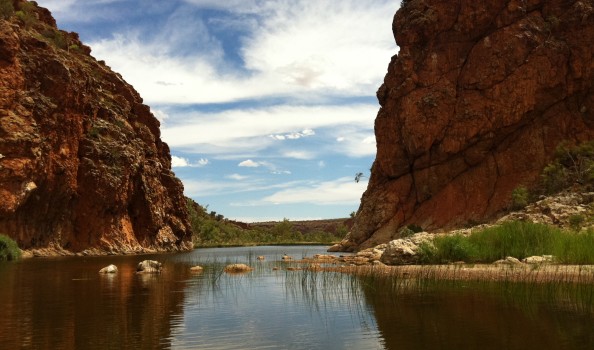 https://nakedhungrytraveller.com.au/hot-alice/ Hot Alice!It's hot in the Red Centre in summer and getting hotter. New high temperature records have been since 2103. Many years have passed since I’ve been to Alice Springs, the heart of the Red Centre. That visit included an eventful camel trek in the eastern MacDonnell’s Ranges, countless blowflies and spiritually uplifting days at Uluru coinciding with indigenous land ownership conflicts. It was late October and heat waves were beginning to shimmer off red sand and pale green Spinifex grass. Sun stroke was a real threat, countered by copious amounts of water, lots of shade and an afternoon siesta. I survived, loved the timelessness of the place and came away with the opinion that the light around The Alice is like nowhere else on planet Earth. This time, I’ve opted for a mid-summer visit, arriving Christmas Eve, staying over New Year’s Eve followed by a recovery of a few more days. The heat is so intense it’s like trying to live in a blast furnace. Early 2013’s temperatures set new records. The national bureau of meteorology recalibrated its forecast maps indicating that average daily maximum temperatures between Alice Springs and Oodnadatta were predicted to exceed 50C. Frying eggs on a car bonnet was no longer just a rural myth. Actually you could scramble a dozen eggs and fry bacon on a Mini Cooper roof in that kind of heat. I stopped checking the temperatures after about a week. Why bother? I knew each day was going to be blisteringly hot, followed by another scorching night. Perspiration evaporates almost immediately in the intensely dry conditions. My skin’s not sticky, no small relief but sweat seeps off me like water from a red melon. Walking anywhere in the Red Centre during high summer requires preparation. As soon as I down one litre of water, I’m ready for a second. The heat is relentless, like being trapped in a never ending Bikram yoga class. But I’m feeling quite cleansed, toxins literally exuding from my body no matter how hard I top up the toxin ratio with another cooling cocktail, mango Daiquiris one night, Negronis mixed with tonic water the next. Despite the heat, Alice Springs is packed with tourists, mostly Europeans, though a few Yankee accents occasionally break the sound barrier particularly in tourist magnets like Kings Canyon (Watarrka National Park) and Glen Helen Gorge in the Western MacDonnell’s Range. Aussie travellers pull up barstools at Alice Spring’s Lasseters Casino or loiter in the few restaurants wise enough to remain open during the ‘Off Season’. For reasons unknown (budget cuts are hinted as being the most likely cause), Alice Spring’s prime tourist destination, the Araluen Cultural Precinct is closed from 24 December until 7 January, two days after I leave town. Opened with full political fanfare in 1999, I’ve wanted to see its seven sacred Aboriginal sites, Strehlow Reserch Centre and Collection, Albert Namatjira Gallery, Museum of Central Australia and the Central Australian Aviation Museum for a very long time. I had been advised by a former employee the Cultural Precinct was shut only on Christmas Day. Obviously, I had been misinformed and am hugely disappointed to find the whole huge Cultural Precinct closed for an extended holiday. With thousands of visitors in town, this is something of a public relations disaster for Alice Spring’s tourism reputation. I visit the town’s Information Centre, thankfully operational, and chat with a long serving staff member. She expresses shock the Araluen Cultural Precinct is closed. It had never before closed during a peak holiday period. Sure, it’s hot and it’s not peak season (mid-winter) but given the numbers of international travellers in town searching for attractions, meals and something to do besides sweat, this had become a PR nightmare for Information Centre employees. When I ask her why the Cultural Precinct is closed, I’m informed, ‘No idea why. Budget cuts? Who knows? It’s crazy to close it for this long. They could have kept it open with a skeleton staff at least. What do I tell people here? Where in town can I send them? Once they’ve visited the Alice Springs Desert Park and the Royal Flying Doctors Service museum, that’s pretty much it in terms of popular attractions.’ It doesn’t help either that a few of Alice Spring’s limited selection of halfway decent restaurants are also closed for the holiday. With this news, filling the days in Alice Springs suddenly poses greater challenges than coping with heat stress. Restaurants in this town aren’t famed for their cutting edge cuisine, at least the ones still open aren’t. Limiting decent dining options cut deeply into remaining pleasure factors. I know everyone needs a holiday but in a tourist town like Alice Springs, I can’t for the life of me comprehend why smart operators don’t take an annual holiday in February or March when the heat is still intense and travellers are fewer and further between? Shutting up shop between Christmas and Australia Day (January 26) is a good example of hospitality ignorance in full flight. Luckily a few reputable art galleries are open in Alice Spring’s main tourist strip, the car-free Todd Mall. It’s here where I learn some of what I’ve missed at the Cultural Precinct. Thank goodness for private enterprise. Thank goodness too that the great outdoors is wide open and ready for anyone brave enough to withstand the heat. Some of Australia’s most inspiring landscapes stretch along the whole length of the MacDonnell Ranges. [caption id="attachment_1601" align="alignnone" width="448"]
https://nakedhungrytraveller.com.au/hot-alice/ Hot Alice!It's hot in the Red Centre in summer and getting hotter. New high temperature records have been since 2103. Many years have passed since I’ve been to Alice Springs, the heart of the Red Centre. That visit included an eventful camel trek in the eastern MacDonnell’s Ranges, countless blowflies and spiritually uplifting days at Uluru coinciding with indigenous land ownership conflicts. It was late October and heat waves were beginning to shimmer off red sand and pale green Spinifex grass. Sun stroke was a real threat, countered by copious amounts of water, lots of shade and an afternoon siesta. I survived, loved the timelessness of the place and came away with the opinion that the light around The Alice is like nowhere else on planet Earth. This time, I’ve opted for a mid-summer visit, arriving Christmas Eve, staying over New Year’s Eve followed by a recovery of a few more days. The heat is so intense it’s like trying to live in a blast furnace. Early 2013’s temperatures set new records. The national bureau of meteorology recalibrated its forecast maps indicating that average daily maximum temperatures between Alice Springs and Oodnadatta were predicted to exceed 50C. Frying eggs on a car bonnet was no longer just a rural myth. Actually you could scramble a dozen eggs and fry bacon on a Mini Cooper roof in that kind of heat. I stopped checking the temperatures after about a week. Why bother? I knew each day was going to be blisteringly hot, followed by another scorching night. Perspiration evaporates almost immediately in the intensely dry conditions. My skin’s not sticky, no small relief but sweat seeps off me like water from a red melon. Walking anywhere in the Red Centre during high summer requires preparation. As soon as I down one litre of water, I’m ready for a second. The heat is relentless, like being trapped in a never ending Bikram yoga class. But I’m feeling quite cleansed, toxins literally exuding from my body no matter how hard I top up the toxin ratio with another cooling cocktail, mango Daiquiris one night, Negronis mixed with tonic water the next. Despite the heat, Alice Springs is packed with tourists, mostly Europeans, though a few Yankee accents occasionally break the sound barrier particularly in tourist magnets like Kings Canyon (Watarrka National Park) and Glen Helen Gorge in the Western MacDonnell’s Range. Aussie travellers pull up barstools at Alice Spring’s Lasseters Casino or loiter in the few restaurants wise enough to remain open during the ‘Off Season’. For reasons unknown (budget cuts are hinted as being the most likely cause), Alice Spring’s prime tourist destination, the Araluen Cultural Precinct is closed from 24 December until 7 January, two days after I leave town. Opened with full political fanfare in 1999, I’ve wanted to see its seven sacred Aboriginal sites, Strehlow Reserch Centre and Collection, Albert Namatjira Gallery, Museum of Central Australia and the Central Australian Aviation Museum for a very long time. I had been advised by a former employee the Cultural Precinct was shut only on Christmas Day. Obviously, I had been misinformed and am hugely disappointed to find the whole huge Cultural Precinct closed for an extended holiday. With thousands of visitors in town, this is something of a public relations disaster for Alice Spring’s tourism reputation. I visit the town’s Information Centre, thankfully operational, and chat with a long serving staff member. She expresses shock the Araluen Cultural Precinct is closed. It had never before closed during a peak holiday period. Sure, it’s hot and it’s not peak season (mid-winter) but given the numbers of international travellers in town searching for attractions, meals and something to do besides sweat, this had become a PR nightmare for Information Centre employees. When I ask her why the Cultural Precinct is closed, I’m informed, ‘No idea why. Budget cuts? Who knows? It’s crazy to close it for this long. They could have kept it open with a skeleton staff at least. What do I tell people here? Where in town can I send them? Once they’ve visited the Alice Springs Desert Park and the Royal Flying Doctors Service museum, that’s pretty much it in terms of popular attractions.’ It doesn’t help either that a few of Alice Spring’s limited selection of halfway decent restaurants are also closed for the holiday. With this news, filling the days in Alice Springs suddenly poses greater challenges than coping with heat stress. Restaurants in this town aren’t famed for their cutting edge cuisine, at least the ones still open aren’t. Limiting decent dining options cut deeply into remaining pleasure factors. I know everyone needs a holiday but in a tourist town like Alice Springs, I can’t for the life of me comprehend why smart operators don’t take an annual holiday in February or March when the heat is still intense and travellers are fewer and further between? Shutting up shop between Christmas and Australia Day (January 26) is a good example of hospitality ignorance in full flight. Luckily a few reputable art galleries are open in Alice Spring’s main tourist strip, the car-free Todd Mall. It’s here where I learn some of what I’ve missed at the Cultural Precinct. Thank goodness for private enterprise. Thank goodness too that the great outdoors is wide open and ready for anyone brave enough to withstand the heat. Some of Australia’s most inspiring landscapes stretch along the whole length of the MacDonnell Ranges. [caption id="attachment_1601" align="alignnone" width="448"]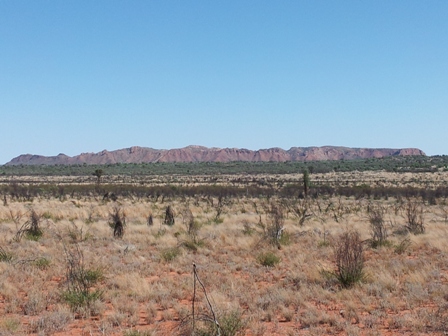 Gosse Bluff, part of the Western MacDonnell Ranges.[/caption]
Ormiston Gorge and Glen Helen Gorge both have enough fresh water for a refreshing dip. Bird life collects in both magnificent locations proving once again that animals have a sixth sense about finding life giving water in the most unlikely places. Glen Helen Resort is something of a quirky delight. Its restaurant has won a few reputable awards, a feat of clever survival in this difficult location. I’m told that Glen Helen Resort has become the preferred hideaway for Alice Spring’s residents when they yearn to get away from it all but don’t want to leave their creature comforts behind. Read: naughty weekend escape route. It’s a well run and managed lodge with basic facilities set in a spectacular location on the Finke River just next to Glen Helen Gorge. Stop there for a cool drink or meal. Better yet, stay a couple nights to avoid the madding crowds in The Alice.
[caption id="attachment_1495" align="alignnone" width="448"]
Gosse Bluff, part of the Western MacDonnell Ranges.[/caption]
Ormiston Gorge and Glen Helen Gorge both have enough fresh water for a refreshing dip. Bird life collects in both magnificent locations proving once again that animals have a sixth sense about finding life giving water in the most unlikely places. Glen Helen Resort is something of a quirky delight. Its restaurant has won a few reputable awards, a feat of clever survival in this difficult location. I’m told that Glen Helen Resort has become the preferred hideaway for Alice Spring’s residents when they yearn to get away from it all but don’t want to leave their creature comforts behind. Read: naughty weekend escape route. It’s a well run and managed lodge with basic facilities set in a spectacular location on the Finke River just next to Glen Helen Gorge. Stop there for a cool drink or meal. Better yet, stay a couple nights to avoid the madding crowds in The Alice.
[caption id="attachment_1495" align="alignnone" width="448"]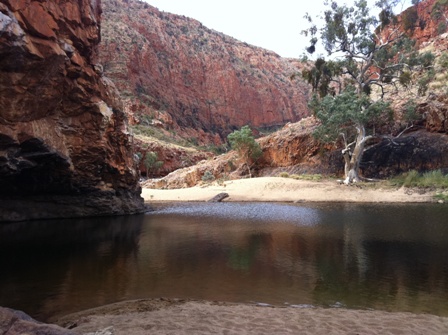 Ormiston Gorge on a late summer's afternoon.[/caption]
Watarrka National Park (Kings Canyon) has grown sufficiently in popularity to rival Uluru and Kata Tjuta as must-see attractions for international travellers. At Kings Canyon Resort, where its Thirsty Dingo Bar is doing a roaring nightly trade in bog standard pub grub, Europeans outnumber Australians by at least three to one. Further down the road (there’s only one) just inside the park’s southern boundary is APT’s Kings Canyon Wilderness Lodge. The dining room is ostensibly reserved only for in-house guests but having earnestly implored its manager to allow three diners access for at least one decent meal in this remote location works some magic and we score a space at a shared table of eight. We’re treated to a three course table d’hote meal seated under a canopy of clear skies and a full moon. Our dinner is of surprisingly good quality with wines from a list that indicates intelligent sourcing. Lanterns illuminate smiling faces around a large candlelit table. We’re dining with a lovely Belgian family of four and a Swiss couple, all well travelled and delightful dining companions.
[caption id="attachment_1496" align="alignnone" width="478"]
Ormiston Gorge on a late summer's afternoon.[/caption]
Watarrka National Park (Kings Canyon) has grown sufficiently in popularity to rival Uluru and Kata Tjuta as must-see attractions for international travellers. At Kings Canyon Resort, where its Thirsty Dingo Bar is doing a roaring nightly trade in bog standard pub grub, Europeans outnumber Australians by at least three to one. Further down the road (there’s only one) just inside the park’s southern boundary is APT’s Kings Canyon Wilderness Lodge. The dining room is ostensibly reserved only for in-house guests but having earnestly implored its manager to allow three diners access for at least one decent meal in this remote location works some magic and we score a space at a shared table of eight. We’re treated to a three course table d’hote meal seated under a canopy of clear skies and a full moon. Our dinner is of surprisingly good quality with wines from a list that indicates intelligent sourcing. Lanterns illuminate smiling faces around a large candlelit table. We’re dining with a lovely Belgian family of four and a Swiss couple, all well travelled and delightful dining companions.
[caption id="attachment_1496" align="alignnone" width="478"]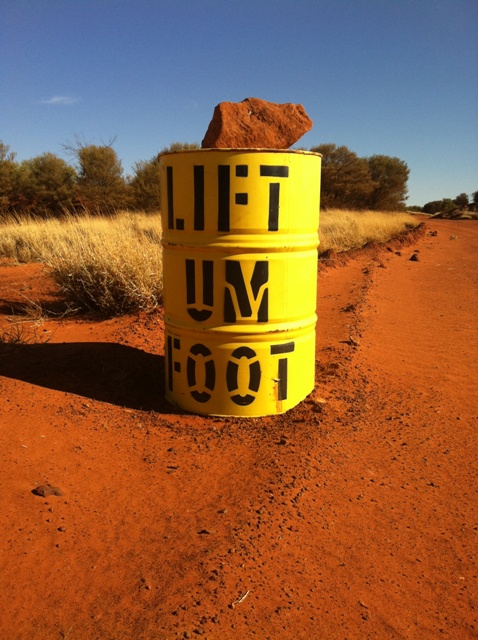 En route to Watarrka National Park (King's Canyon) on the Mereenie Road from Hermannsburg.[/caption]
The Wilderness Lodge dinner is the best we eat outside Alice Springs. Kings Canyon Resort’s sole dining option, the Thirsty Dingo Bar, is utterly disappointing with poor service and even worse food. The fine dining restaurant Desert Oaks Bistro is closed for renovation. Within the whole of Watarrka National Park, there are two places where meals can be bought. Uluru is hundreds of kilometres away, Alice Springs even further. Jealous thoughts arise as I observe caravans with kitchens settle into the Resort’s camping sites.
[caption id="attachment_1597" align="alignnone" width="448"]
En route to Watarrka National Park (King's Canyon) on the Mereenie Road from Hermannsburg.[/caption]
The Wilderness Lodge dinner is the best we eat outside Alice Springs. Kings Canyon Resort’s sole dining option, the Thirsty Dingo Bar, is utterly disappointing with poor service and even worse food. The fine dining restaurant Desert Oaks Bistro is closed for renovation. Within the whole of Watarrka National Park, there are two places where meals can be bought. Uluru is hundreds of kilometres away, Alice Springs even further. Jealous thoughts arise as I observe caravans with kitchens settle into the Resort’s camping sites.
[caption id="attachment_1597" align="alignnone" width="448"]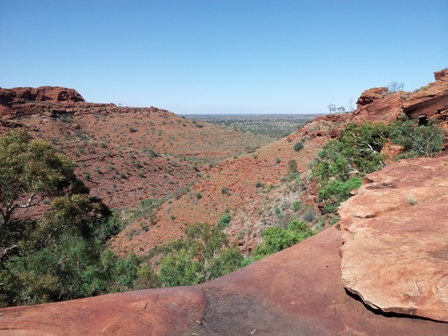 King's Canyon overview.[/caption]
Travellers obviously don’t travel thousands of kilometres to Kings Canyon for fine dining. They come to marvel at nature’s geological miracles. If you’re not prepared to don hiking boots and hoof it, you’ll miss all the Red Centre’s best bits.
The Kings Canyon rim walk is approximately seven kilometres without side tracks. We leave at sunrise and finish the hike just before 10am, taking an extra hour or so to revel in the solitude of the ‘Garden of Eden’, a permanent soak deeply hidden in a narrow cleft atop the canyon itself. The temperature had risen to 38C by 10am and we were nearly out of potable water, a perfect time to retreat to our cabin for a cool shower and another siesta.
[caption id="attachment_1598" align="alignnone" width="448"]
King's Canyon overview.[/caption]
Travellers obviously don’t travel thousands of kilometres to Kings Canyon for fine dining. They come to marvel at nature’s geological miracles. If you’re not prepared to don hiking boots and hoof it, you’ll miss all the Red Centre’s best bits.
The Kings Canyon rim walk is approximately seven kilometres without side tracks. We leave at sunrise and finish the hike just before 10am, taking an extra hour or so to revel in the solitude of the ‘Garden of Eden’, a permanent soak deeply hidden in a narrow cleft atop the canyon itself. The temperature had risen to 38C by 10am and we were nearly out of potable water, a perfect time to retreat to our cabin for a cool shower and another siesta.
[caption id="attachment_1598" align="alignnone" width="448"] Garden of Eden in Watarrka National Park.[/caption]
Finke Gorge National Park’s Palm Valley is empty of visitors. No wonder. At midday it’s 40C+ and intolerably hot. An isolated forest of Red Cabbage Palms (Livistona Mariae) has made Palm Valley famous. First thought to be remnants of Australia’s wetter past, now genetic testing has led to a change of opinion among contemporary botanic experts. The palm seeds are believed to have been carried amongst other foodstuffs into this isolated valley by indigenous wanderers some 15,000 years ago. (Reference: Science Now 6 March 2012). No matter, approximately 3,000 palms live in the usually bone dry Finke River Gorge, eking out a moist existence in the middle of the world’s driest continent, drawing from water reserves under the hard red sandstone after intermittent flooding.
[caption id="attachment_1497" align="alignnone" width="448"]
Garden of Eden in Watarrka National Park.[/caption]
Finke Gorge National Park’s Palm Valley is empty of visitors. No wonder. At midday it’s 40C+ and intolerably hot. An isolated forest of Red Cabbage Palms (Livistona Mariae) has made Palm Valley famous. First thought to be remnants of Australia’s wetter past, now genetic testing has led to a change of opinion among contemporary botanic experts. The palm seeds are believed to have been carried amongst other foodstuffs into this isolated valley by indigenous wanderers some 15,000 years ago. (Reference: Science Now 6 March 2012). No matter, approximately 3,000 palms live in the usually bone dry Finke River Gorge, eking out a moist existence in the middle of the world’s driest continent, drawing from water reserves under the hard red sandstone after intermittent flooding.
[caption id="attachment_1497" align="alignnone" width="448"]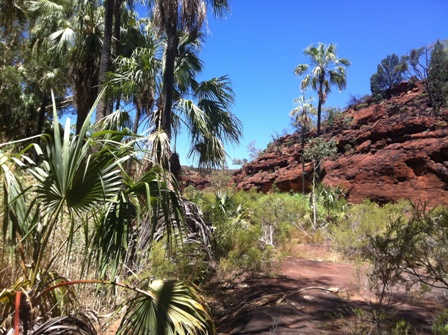 Palm Valley in Finke Gorge National Park[/caption]
Palm Valley is accessible only by 4WD with high clearance. It’s a rough corrugated road with numerous washouts and steep rocky sections carved out by the mysterious river which floods once or twice a decade. Wandering through Palm Valley on the Mpulungkinya track is a primeval experience. When I first walked up and down the valley twenty years ago, I would have been unsurprised to see a dinosaur poke its scaly head from behind a palm frond. It’s that kind of place. I felt the same way this recent visit but instead of a dinosaur, a young Perentie propelled by its skinny legs leaps out from behind a stand of rare cycads and startled me. I feel a cool shiver run up my spine, a pleasant relief.
The Finke is one of the Northern Territory’s ‘Upside Down Rivers’ so-called for their reserves of hidden underground waters, even in the driest seasons. If you dig deep enough, there be water... so the saying goes.
The Finke is commonly named the world’s oldest river. It’s not but it’s certainly old enough to merit the unproven claim. Much like the Red Centre itself, the stony river bed is starkly beautiful, crystalline light glistening off mica and quartz pierces eyesight. Blood red sandstone cliffs towering against sapphire sky squeezes eyelids shut. It’s all so blindingly bright it’s painful, a hurtful kind of beauty.
I’ve returned to the Red Centre to find art and culture, peace and beauty. Finding art is easy. Alice Spring’s galleries specialise in indigenous art but as always, it’s buyer beware. Fortunately I have a local connection which allows a side trip to Yuendumu, 300 kilometres northwest of Alice Springs on the Tanami Track. We’ve managed to arrange a private visit to the fully Aboriginal owned and governed Warlukurlangu Artists Aboriginal Corporation where 100% of proceeds go directly back to the artists and their community projects.
[caption id="attachment_1509" align="alignnone" width="448"]
Palm Valley in Finke Gorge National Park[/caption]
Palm Valley is accessible only by 4WD with high clearance. It’s a rough corrugated road with numerous washouts and steep rocky sections carved out by the mysterious river which floods once or twice a decade. Wandering through Palm Valley on the Mpulungkinya track is a primeval experience. When I first walked up and down the valley twenty years ago, I would have been unsurprised to see a dinosaur poke its scaly head from behind a palm frond. It’s that kind of place. I felt the same way this recent visit but instead of a dinosaur, a young Perentie propelled by its skinny legs leaps out from behind a stand of rare cycads and startled me. I feel a cool shiver run up my spine, a pleasant relief.
The Finke is one of the Northern Territory’s ‘Upside Down Rivers’ so-called for their reserves of hidden underground waters, even in the driest seasons. If you dig deep enough, there be water... so the saying goes.
The Finke is commonly named the world’s oldest river. It’s not but it’s certainly old enough to merit the unproven claim. Much like the Red Centre itself, the stony river bed is starkly beautiful, crystalline light glistening off mica and quartz pierces eyesight. Blood red sandstone cliffs towering against sapphire sky squeezes eyelids shut. It’s all so blindingly bright it’s painful, a hurtful kind of beauty.
I’ve returned to the Red Centre to find art and culture, peace and beauty. Finding art is easy. Alice Spring’s galleries specialise in indigenous art but as always, it’s buyer beware. Fortunately I have a local connection which allows a side trip to Yuendumu, 300 kilometres northwest of Alice Springs on the Tanami Track. We’ve managed to arrange a private visit to the fully Aboriginal owned and governed Warlukurlangu Artists Aboriginal Corporation where 100% of proceeds go directly back to the artists and their community projects.
[caption id="attachment_1509" align="alignnone" width="448"]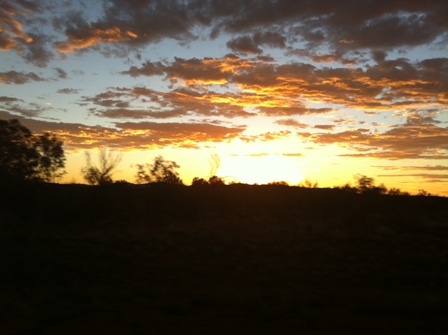 Sunset on the Tanami Track en route from Yuendumu.[/caption]
Yuendumu town is frankly quite squalid. Plastic rubbish collects like confetti along razor wire fences, shabby houses are surrounded by all sorts of 21st century detritus: broken cars, rusted bedspring frames and junkyard trash. I hear residents threatening one another from two houses just across the road. An air of desperation pervades the heat haze in this fringe community where domestic violence is rampant and clan battles dominate town politics. There’s no tourist accommodation in town, it’s a long drive on the dirt track back to Alice but Warlukurlangu itself is something of a revelation. Over 200 artists contribute to Warlukurlangu where some 5,000 paintings are produced each year. Galleries spread around the world sell their work. I wonder how much poorer Yuendumu would be without Warlukurlangu’s contribution to local incomes.
[caption id="attachment_1599" align="alignnone" width="448"]
Sunset on the Tanami Track en route from Yuendumu.[/caption]
Yuendumu town is frankly quite squalid. Plastic rubbish collects like confetti along razor wire fences, shabby houses are surrounded by all sorts of 21st century detritus: broken cars, rusted bedspring frames and junkyard trash. I hear residents threatening one another from two houses just across the road. An air of desperation pervades the heat haze in this fringe community where domestic violence is rampant and clan battles dominate town politics. There’s no tourist accommodation in town, it’s a long drive on the dirt track back to Alice but Warlukurlangu itself is something of a revelation. Over 200 artists contribute to Warlukurlangu where some 5,000 paintings are produced each year. Galleries spread around the world sell their work. I wonder how much poorer Yuendumu would be without Warlukurlangu’s contribution to local incomes.
[caption id="attachment_1599" align="alignnone" width="448"]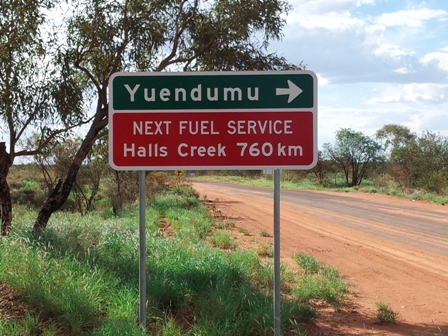 Road sign outside Yuendumu.[/caption]
There are other NT communities that boast communal art centres, all of which require advance notice in which to visit. At certain times of year, many communities are closed to the general public for ‘men’s business’ or ‘women’s business’, when coming of age ceremonies or rites of passage take precedence over commercialism, such as it is.
Yuendumu and Utopia are rightly world famous for their dot point acrylic painting styles. Both communities are represented in two galleries in Alice Springs, respectively Talapi and Mbantua in Todd Mall. These two galleries work closely with the communities they represent, the lion’s share of profits returning to the artists. Talapi also promotes the lesser known Ampilatwatja art centre, one to watch out for according to local experts. The Papunya Tula gallery, also in Todd Mall has the largest collection of work from Western Desert artists from around Kintore and Kiwirrkura but it is sadly closed over the Christmas holiday period so I peer curiously through its street front windows instead. There are dozens of small arts centres speckled throughout the Red Centre, from eastern Western Australia to northern South Australia. Many of them have their works represented in reputable galleries such as Talapi, Mbantua and Papunya Tula.
Stroll up and down Todd Mall any afternoon and undoubtedly you will see a few locals sitting on the grass near the historic Adelaide House or the Old Courthouse with a few paintings spread out around them for sale. These are random opportunities and again it’s a case of buyer beware. Remember that a canvas first needs to be stretched and prepared professionally before any acrylic colours are applied.
Hermannsburg Potters and watercolourists are justly famous. Albert Namatjira put tiny yet historic Hermannsburg on the map of international arts renown. A monument to his work and life is on the Larapinta Drive just outside Hermannsburg and is well worth stopping at to remember the man’s sorrowful life story and the positive impact he had on local culture. The view from the monument to his favourite subject, Mount Sonder is memorable.
[caption id="attachment_1600" align="alignnone" width="448"]
Road sign outside Yuendumu.[/caption]
There are other NT communities that boast communal art centres, all of which require advance notice in which to visit. At certain times of year, many communities are closed to the general public for ‘men’s business’ or ‘women’s business’, when coming of age ceremonies or rites of passage take precedence over commercialism, such as it is.
Yuendumu and Utopia are rightly world famous for their dot point acrylic painting styles. Both communities are represented in two galleries in Alice Springs, respectively Talapi and Mbantua in Todd Mall. These two galleries work closely with the communities they represent, the lion’s share of profits returning to the artists. Talapi also promotes the lesser known Ampilatwatja art centre, one to watch out for according to local experts. The Papunya Tula gallery, also in Todd Mall has the largest collection of work from Western Desert artists from around Kintore and Kiwirrkura but it is sadly closed over the Christmas holiday period so I peer curiously through its street front windows instead. There are dozens of small arts centres speckled throughout the Red Centre, from eastern Western Australia to northern South Australia. Many of them have their works represented in reputable galleries such as Talapi, Mbantua and Papunya Tula.
Stroll up and down Todd Mall any afternoon and undoubtedly you will see a few locals sitting on the grass near the historic Adelaide House or the Old Courthouse with a few paintings spread out around them for sale. These are random opportunities and again it’s a case of buyer beware. Remember that a canvas first needs to be stretched and prepared professionally before any acrylic colours are applied.
Hermannsburg Potters and watercolourists are justly famous. Albert Namatjira put tiny yet historic Hermannsburg on the map of international arts renown. A monument to his work and life is on the Larapinta Drive just outside Hermannsburg and is well worth stopping at to remember the man’s sorrowful life story and the positive impact he had on local culture. The view from the monument to his favourite subject, Mount Sonder is memorable.
[caption id="attachment_1600" align="alignnone" width="448"]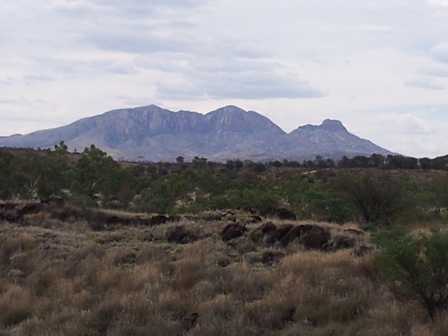 Mt Sonder seen from near Hermannsburg.[/caption]
My quest to find art, culture, peace and beauty is fulfilled. The Red Centre landscape is the source of all the four elements I desired this trip. Art and culture are both strongly linked to indigenous dreaming stories. As an outsider I’ve learned to appreciate both from an Aboriginal perspective but realise the path to full understanding is a wandering one. I see beauty everywhere I travel in this ancient land and from that appreciation, the peace I sought is found.
Naked Facts:
These recommended Alice Spring’s art galleries are all located in Todd Mall:
Talapi Gallery (www.talapi.com.au)
Mbantua Gallery (www.mbantua.com.au)
Papunya Tula Gallery (www.papunyatula.com.au/gallery/)
Visits to Warlukurlangu Artists Aboriginal Corporation in Yuendumu must be pre-arranged. See www.warlu.com for details. Warlukurlangu also runs a volunteer programme for interested visitors trying to arrange longer stays in a remote community. The corporation has open days for visitors occasionally. Check the website for dates and details.
Red Kangaroo Books (79 Todd Mall, +61 (0)8 8953 2137) has an excellent selection of books covering indigenous history, politics, social issues, Northern Territory history and country yarns, local maps and fiction focused on Northern Territory locations. www.redkangaroobooks.com
Dining:
Honestly speaking, the only really good food I ate in Alice Springs was a dinner prepared at a friend’s house. Alice Springs does suffer for its isolation. Absolutely fresh produce is expensive and often not best quality. In the interest of fairness, I tried as many decent (as in clean and not part of an international chain) local restaurants as possible.
Here’s a short list of the best of an average lot:
Sukra at Lasseters Casino (www.lhc.com.au/dining/sukra) is okay. At least it’s trying to be good. A small dining room lends some intimacy. Food is Asian driven with an emphasis on sub-continental Indian.
Barra on Todd (www.chifleyhotels.com.au/alice-springs/chifley-alice-springs-resort/alice-springs-dining-facilities/) in The Chifley hotel is a slightly above average motel/hotel dining room. After a week in Alice Springs I was starting to feel desperate about finding an open restaurant (Christmas/Australia Day holiday ‘Let’s shut up shop and leave town!’ philosophy was taking its toll) that wasn’t a rip off steak joint or ersatz indigenous food tourist trap. Barra on Todd specialises in barramundi, which is fished in waters 2,000 kilometres further north. Fresh? You must be kidding.
Hanuman (www.hanuman.com.au/hanuman_asp.htm) in the Crowne Plaza hotel is at least better than its counterpart in Darwin. Southeast and south Asian cuisine dominates the menu selection, perfect food for Alice Spring’s climate. I tried a red fish curry (frozen gemfish) which was actually quite tasty. The fish married well with the subtly spiced house-made curry paste. Unfortunately, we were the last diners in for the night (arriving 8:45p, kitchen closes at 9p) but instead of being seated in a corner away from the reception desk and busy bar service area, were assigned a tiny table in a wide open space next to the bar where staff members gossiped loudly about their friends and customers. Just another example of an overwhelming lack of professionalism I encountered in nearly each restaurant I tried during this visit to the Northern Territory. It’s the fault of slack management, not necessarily the fault of typically young employees who haven’t been adequately trained.
Casa Nostra Pizza and Spaghetti House (1 Undoolya St, +61 (0)8 8952 6749) has a good reputation among locals and is BYO but it was closed for the holiday season.
Flavours of India (20 Undoolya St, +61 (0)8 8952 3721) also has a favourable reputation among locals. When I attempted to dine there, arriving at 8:35p, it was closing up for the night. Had I telephoned before, perhaps I would have had better luck. Hot tip: Restaurants in Alice Springs close early.
Katja’s Kafe (Fan Arcade, 10/63 Todd Mall, +61 (0)8 8952 7632) I enjoyed several fine breakfasts and light lunches in this local’s favourite cafe situated in the Fan Arcade, a short alleyway just off Todd Mall between Parsons St and Gregory Terrace behind Papunya Tula gallery. Katja’s Kafe is open most days from early morning till late afternoon. Hot tip: Katja’s cakes and tartes, made in house, are worth a visit in itself.
I heard of a quite good Vietnamese restaurant near the airport which has its own kitchen garden but it also closes early and I missed trying a meal there.
The Glen Helen Resort (www.glenhelen.com.au) at the edge of the western MacDonnell’s range offers far better food than one would expect given its isolated location, proof that a remote spot doesn’t necessarily negate culinary care and respect for its customers.
Watarrka National Park (Kings Canyon) offers two dining choices: the execrably bad Thirsty Dingo at King’s Canyon Resort (www.kingscanyonresort.com.au/) or the delightfully rustic with well prepared food at the Kings Canyon Wilderness Lodge (www.aptouring.com.au/travel-styles/Wilderness-Lodges/Northern-Territory).
Naked Fact File:
For general information about travel in the Red Centre (what to do and more importantly, what not to do during high summer), see www.travelnt.com
Further reading:
The Lizard Eaters by Douglas Lockwood, 1964, reprinted by New Holland Publishers Australia 2011.
Ted Strehlow’s biography: www.adb.anu.edu.au/biography/strehlow-theodor-george-henry-ted-11792
Albert Namatjira’s biography: www.adb.anu.edu.au/biography/namatjira-albert-elea-11217
A Town Like Alice by Nevil Shute, 1950
Mt Sonder seen from near Hermannsburg.[/caption]
My quest to find art, culture, peace and beauty is fulfilled. The Red Centre landscape is the source of all the four elements I desired this trip. Art and culture are both strongly linked to indigenous dreaming stories. As an outsider I’ve learned to appreciate both from an Aboriginal perspective but realise the path to full understanding is a wandering one. I see beauty everywhere I travel in this ancient land and from that appreciation, the peace I sought is found.
Naked Facts:
These recommended Alice Spring’s art galleries are all located in Todd Mall:
Talapi Gallery (www.talapi.com.au)
Mbantua Gallery (www.mbantua.com.au)
Papunya Tula Gallery (www.papunyatula.com.au/gallery/)
Visits to Warlukurlangu Artists Aboriginal Corporation in Yuendumu must be pre-arranged. See www.warlu.com for details. Warlukurlangu also runs a volunteer programme for interested visitors trying to arrange longer stays in a remote community. The corporation has open days for visitors occasionally. Check the website for dates and details.
Red Kangaroo Books (79 Todd Mall, +61 (0)8 8953 2137) has an excellent selection of books covering indigenous history, politics, social issues, Northern Territory history and country yarns, local maps and fiction focused on Northern Territory locations. www.redkangaroobooks.com
Dining:
Honestly speaking, the only really good food I ate in Alice Springs was a dinner prepared at a friend’s house. Alice Springs does suffer for its isolation. Absolutely fresh produce is expensive and often not best quality. In the interest of fairness, I tried as many decent (as in clean and not part of an international chain) local restaurants as possible.
Here’s a short list of the best of an average lot:
Sukra at Lasseters Casino (www.lhc.com.au/dining/sukra) is okay. At least it’s trying to be good. A small dining room lends some intimacy. Food is Asian driven with an emphasis on sub-continental Indian.
Barra on Todd (www.chifleyhotels.com.au/alice-springs/chifley-alice-springs-resort/alice-springs-dining-facilities/) in The Chifley hotel is a slightly above average motel/hotel dining room. After a week in Alice Springs I was starting to feel desperate about finding an open restaurant (Christmas/Australia Day holiday ‘Let’s shut up shop and leave town!’ philosophy was taking its toll) that wasn’t a rip off steak joint or ersatz indigenous food tourist trap. Barra on Todd specialises in barramundi, which is fished in waters 2,000 kilometres further north. Fresh? You must be kidding.
Hanuman (www.hanuman.com.au/hanuman_asp.htm) in the Crowne Plaza hotel is at least better than its counterpart in Darwin. Southeast and south Asian cuisine dominates the menu selection, perfect food for Alice Spring’s climate. I tried a red fish curry (frozen gemfish) which was actually quite tasty. The fish married well with the subtly spiced house-made curry paste. Unfortunately, we were the last diners in for the night (arriving 8:45p, kitchen closes at 9p) but instead of being seated in a corner away from the reception desk and busy bar service area, were assigned a tiny table in a wide open space next to the bar where staff members gossiped loudly about their friends and customers. Just another example of an overwhelming lack of professionalism I encountered in nearly each restaurant I tried during this visit to the Northern Territory. It’s the fault of slack management, not necessarily the fault of typically young employees who haven’t been adequately trained.
Casa Nostra Pizza and Spaghetti House (1 Undoolya St, +61 (0)8 8952 6749) has a good reputation among locals and is BYO but it was closed for the holiday season.
Flavours of India (20 Undoolya St, +61 (0)8 8952 3721) also has a favourable reputation among locals. When I attempted to dine there, arriving at 8:35p, it was closing up for the night. Had I telephoned before, perhaps I would have had better luck. Hot tip: Restaurants in Alice Springs close early.
Katja’s Kafe (Fan Arcade, 10/63 Todd Mall, +61 (0)8 8952 7632) I enjoyed several fine breakfasts and light lunches in this local’s favourite cafe situated in the Fan Arcade, a short alleyway just off Todd Mall between Parsons St and Gregory Terrace behind Papunya Tula gallery. Katja’s Kafe is open most days from early morning till late afternoon. Hot tip: Katja’s cakes and tartes, made in house, are worth a visit in itself.
I heard of a quite good Vietnamese restaurant near the airport which has its own kitchen garden but it also closes early and I missed trying a meal there.
The Glen Helen Resort (www.glenhelen.com.au) at the edge of the western MacDonnell’s range offers far better food than one would expect given its isolated location, proof that a remote spot doesn’t necessarily negate culinary care and respect for its customers.
Watarrka National Park (Kings Canyon) offers two dining choices: the execrably bad Thirsty Dingo at King’s Canyon Resort (www.kingscanyonresort.com.au/) or the delightfully rustic with well prepared food at the Kings Canyon Wilderness Lodge (www.aptouring.com.au/travel-styles/Wilderness-Lodges/Northern-Territory).
Naked Fact File:
For general information about travel in the Red Centre (what to do and more importantly, what not to do during high summer), see www.travelnt.com
Further reading:
The Lizard Eaters by Douglas Lockwood, 1964, reprinted by New Holland Publishers Australia 2011.
Ted Strehlow’s biography: www.adb.anu.edu.au/biography/strehlow-theodor-george-henry-ted-11792
Albert Namatjira’s biography: www.adb.anu.edu.au/biography/namatjira-albert-elea-11217
A Town Like Alice by Nevil Shute, 1950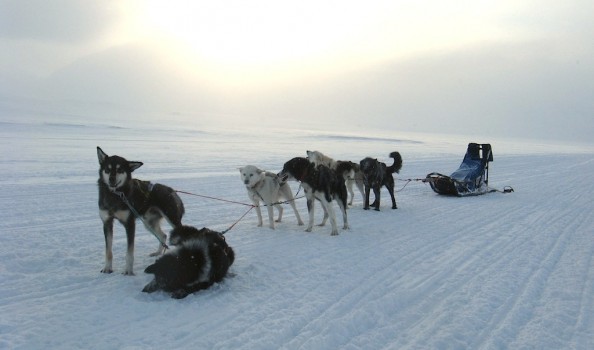 https://nakedhungrytraveller.com.au/dog-sledging-svalbard-style/ Dog Sledging Svalbard Style
https://nakedhungrytraveller.com.au/dog-sledging-svalbard-style/ Dog Sledging Svalbard StyleDogs are supposedly man’s best friend. In the frozen lands of Norway’s Svalbard Archipelago, dogs are also man’s best transport option.
It’s the end of the road. I’ve reached Longyearbyen on Spitsbergen Island, latitude 78.13 degrees north. This northernmost extent of permanent human habitation draws an imaginary line around the globe and Longyearbyen is the only dot on that line. The North Pole is a mere 1,338 kilometres further. No people live permanently between Svalbard and the North Pole. Norway’s capital city, Oslo is 2,313 kilometres south while the nearest town of any consequence, Tromso, the capital of Norway's Arctic Region, is an hour's flight south some 1,000 kilometres across the Arctic Ocean. I’m here to join a dogsled expedition to the ‘Ship in the Ice’, a two-masted refurbished schooner stuck fast in the thick ice of Tempelfjord, a hard day’s journey across frozen wilderness populated by reindeer, polar bears and Arctic foxes. [caption id="attachment_1570" align="alignnone" width="448"]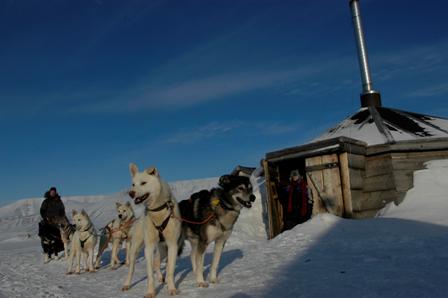 Main dog camp outside Longyearbyen, Svalbard.[/caption]
During late March, each day grows longer by an average of 40 minutes. When I arrived to participate in the dog sledging tour, sunset was at 7pm. A week later I write notes about huskies and polar bears at 11pm while an eerie light illuminates the sky. The evening view from my hotel window is all blue and white with shades of grey shining off nearby peaks. The Aurora Borealis flashes streaks brilliant green with reddish orange tints while disappearing in scintillating seconds.
Sunrise is at 3:30am. By 19 April the sun won't set again until late August. Spring has arrived finally and the locals are behaving as if they’ve been released from four months of darkened prison confinement.
The town’s few bars are full. Sustained exuberance is in ample evidence.
Cognac is the preferred tipple. Good incomes can be made here in Longyearbyen from scientific research projects, coal mining and seasonal tourism. Longyearbyeners have survived another winter of frigid darkness and the festive mood coincides with increasing sunlight.
Main dog camp outside Longyearbyen, Svalbard.[/caption]
During late March, each day grows longer by an average of 40 minutes. When I arrived to participate in the dog sledging tour, sunset was at 7pm. A week later I write notes about huskies and polar bears at 11pm while an eerie light illuminates the sky. The evening view from my hotel window is all blue and white with shades of grey shining off nearby peaks. The Aurora Borealis flashes streaks brilliant green with reddish orange tints while disappearing in scintillating seconds.
Sunrise is at 3:30am. By 19 April the sun won't set again until late August. Spring has arrived finally and the locals are behaving as if they’ve been released from four months of darkened prison confinement.
The town’s few bars are full. Sustained exuberance is in ample evidence.
Cognac is the preferred tipple. Good incomes can be made here in Longyearbyen from scientific research projects, coal mining and seasonal tourism. Longyearbyeners have survived another winter of frigid darkness and the festive mood coincides with increasing sunlight.
Some 2,300 hardy souls live on this huge archipelago, mostly in the capital town, Longyearbyen. Svalbard’s islands constitute an area roughly the size of Denmark.
At the Svalbard Museum I read two forbidding descriptions of life in this isolated frigid place, one written in 1935 by Christiane Ritter: ‘This place is abandoned by God and ought to have been abandoned a long time ago by mankind as well.’ I’m told a few dozens of fringe dwellers live further a field, isolated for months at a time, subsisting off fur trapping or fishing. The second description is more daunting, ‘The ability to adapt, and the art of resignation, is some of what is needed most by those who shall live in Svalbard,’ wrote Liv Balstad in 1956. My ability to adapt to Svalbard’s extreme conditions will be sorely tested.
Approximately 3,000 polar bears also live on Svalbard. During four days of dog sledging around the main island Spitsbergen, I’ve seen a few bears from a safe distance. One bear was in the vicinity of the dog camp five kilometres from town. It was spotted strolling down the same icy snow covered path I and my motley dog team were using the previous evening. Seal pups have left their dens and are following their parents to open water. Polar bears instinctively follow as the sea ice begins breaking up outside the fjords, the best time to fatten up before the lean summer months. Spring is prime time to fatten up on seal pups before summer's thaw, the hardest season for hungry polar bears. While ice packs recede in warmer Arctic Ocean waters, seal hunting has become even more challenging for the bears. I know hungry bears are less discriminating when an easy meal is available. As a weak and slow-footed human, I'd be considered an easy meal. One of my two dog sledging guides explains to me when I ask about polar bear attacks: 'They prefer fatty seals to skinny humans.' I take her remark as a wayward compliment but also note a recent bear attack on a group of young English campers during a summer school excursion. One student was killed and several were injured. The guilty bear was shot dead. The bears I see are searching for food elsewhere; I am indeed ignored. Dog sledging (dog-sledding) is hard work. I thought I'd be gently pulled across frozen fjords and glaciated valleys, standing at the back of my sledge, the master of my domain. Like a scene from a Judy Garland movie when everyone is singing light opera in open horse-drawn carriages, a fantasy that has proven very far from reality. Instead my arms ache from righting the constantly wavering sledge. Legs are like solid trunks of ice, inflexible and stiff. My back hurts from manhandling the dogs, lifting them by their shoulder harnesses and pulling them into line when they become recalcitrant. [caption id="attachment_1577" align="alignnone" width="336"]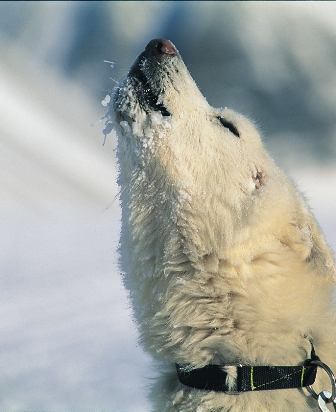 Sled dog Ecco getting ready to rock and roll.[/caption]
Frostbite is a real concern. To prevent it, I’m wearing two layers of thermal underwear, waterproof hiking trousers, a Gore-tex hooded undercoat, three pairs of socks made from three types of cold-resistant fabrics, two fleecy jumpers, a down jacket, two balaclavas, one with a nose guard to keep my nose from freezing, two scarves wrapped around my neck, a woolen cap to keep the balaclavas in place, ski goggles to protect from snow glare and wind, down under-gloves, polar mittens, polar boots with felt inner linings that reach up to my knees and a full body hooded polar suit with a waist to neck zipper. I’m unrecognisable and need fifteen minutes advanced planning to urinate; unzipping all the garments requires a degree in mechanical engineering.
The dogs must be cared for by their sledge masters: fed twice a day on specially fattened super rich husky food interspersed with treats of frozen seal meat and blubber. Their droppings must be shoveled and removed to a safe location hundreds of metres away from base camp so as not to attract hungry bears. They have to be watered (luckily my huskies like to eat snow), cuddled and reassured that all is well in this frozen wasteland of cold affection.
[caption id="attachment_1575" align="alignnone" width="448"]
Sled dog Ecco getting ready to rock and roll.[/caption]
Frostbite is a real concern. To prevent it, I’m wearing two layers of thermal underwear, waterproof hiking trousers, a Gore-tex hooded undercoat, three pairs of socks made from three types of cold-resistant fabrics, two fleecy jumpers, a down jacket, two balaclavas, one with a nose guard to keep my nose from freezing, two scarves wrapped around my neck, a woolen cap to keep the balaclavas in place, ski goggles to protect from snow glare and wind, down under-gloves, polar mittens, polar boots with felt inner linings that reach up to my knees and a full body hooded polar suit with a waist to neck zipper. I’m unrecognisable and need fifteen minutes advanced planning to urinate; unzipping all the garments requires a degree in mechanical engineering.
The dogs must be cared for by their sledge masters: fed twice a day on specially fattened super rich husky food interspersed with treats of frozen seal meat and blubber. Their droppings must be shoveled and removed to a safe location hundreds of metres away from base camp so as not to attract hungry bears. They have to be watered (luckily my huskies like to eat snow), cuddled and reassured that all is well in this frozen wasteland of cold affection.
[caption id="attachment_1575" align="alignnone" width="448"] Approaching home in the ice in Tempelfjord, Svalbard.[/caption]
After breakfast when it's time to venture forth into the great white beyond, the madly eager dogs are collected from their open air sleeping spots, (hay is used for bedding which helps insulate them from the ice) coaxed into their leads then harnessed to the sledge’s main lead rope in a rigidly prescribed pecking order so as to avoid unnecessary squabbles. The entire team is then secured from a chain attached to an ice pick driven securely into the snow, the other end to the two lead dogs. The sledge anchor must always remain pushed hard into the snow so the dogs don't take off like bats out of hell without a driver. When all sledges and drivers with teams of six dogs each are lined up, we’re finally ready to mush off into the blisteringly cold daylight. This represents ninety minutes of physically demanding work.
We are a group of six travellers with two guides, responsible for our own sledges and dogs, though feeding and shoveling duties are shared among us. There are eight humans, seven with teams of six dogs each with one of our two armed guides driving ten dogs for his larger sledge. His dogs are Greenland huskies, larger and more rambunctious than the other teams of Alaskan huskies which are slightly smaller and of varying gentler temperaments. We travel with 46 dogs in total. Five other dogs are already in residence at our base camp, the Noorderlicht or 'North Light', ship in the Tempelfjord approximately 50 kilometres hard travelling northeast from Longyearbyen.
[caption id="attachment_2019" align="alignnone" width="448"]
Approaching home in the ice in Tempelfjord, Svalbard.[/caption]
After breakfast when it's time to venture forth into the great white beyond, the madly eager dogs are collected from their open air sleeping spots, (hay is used for bedding which helps insulate them from the ice) coaxed into their leads then harnessed to the sledge’s main lead rope in a rigidly prescribed pecking order so as to avoid unnecessary squabbles. The entire team is then secured from a chain attached to an ice pick driven securely into the snow, the other end to the two lead dogs. The sledge anchor must always remain pushed hard into the snow so the dogs don't take off like bats out of hell without a driver. When all sledges and drivers with teams of six dogs each are lined up, we’re finally ready to mush off into the blisteringly cold daylight. This represents ninety minutes of physically demanding work.
We are a group of six travellers with two guides, responsible for our own sledges and dogs, though feeding and shoveling duties are shared among us. There are eight humans, seven with teams of six dogs each with one of our two armed guides driving ten dogs for his larger sledge. His dogs are Greenland huskies, larger and more rambunctious than the other teams of Alaskan huskies which are slightly smaller and of varying gentler temperaments. We travel with 46 dogs in total. Five other dogs are already in residence at our base camp, the Noorderlicht or 'North Light', ship in the Tempelfjord approximately 50 kilometres hard travelling northeast from Longyearbyen.
[caption id="attachment_2019" align="alignnone" width="448"]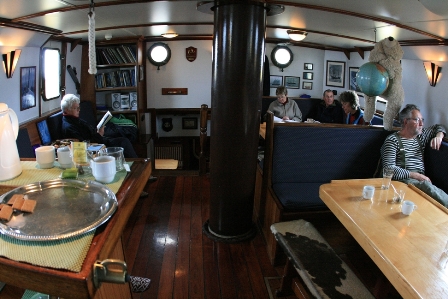 Basecamp main saloon, a welcome sight after a long day's sledging.[/caption]
It takes us almost seven hours to reach the ship, our welcoming home in the ice. We cover the distance without serious mishap apart from mild frostbite and aching muscles. The temperature varies between -25C and -20C with winds up to 70 kilometres per hour. The wind chill of approximately -85C is scary cold. One minute of exposed flesh results in bad frostbite.
Driving the sledges over jagged windswept plains, up and down sharp ice ridges and through dry snow drifts that can easily tip over a shaky sledge isn’t a doddle in the ice park. The sledges have no brake pads, no steel springs or shock absorbers. The driver stands on two runners at the back and holds on for dear life while balancing one foot on a runner and the other over a steel frame attached to metal claws that serve as emergency brakes. If one team runs along another or overtakes it, chaos ensues as the dogs begin barking loudly at each other, or fornicating or fighting. The melee’s noise can be deafening.
[caption id="attachment_1574" align="alignnone" width="448"]
Basecamp main saloon, a welcome sight after a long day's sledging.[/caption]
It takes us almost seven hours to reach the ship, our welcoming home in the ice. We cover the distance without serious mishap apart from mild frostbite and aching muscles. The temperature varies between -25C and -20C with winds up to 70 kilometres per hour. The wind chill of approximately -85C is scary cold. One minute of exposed flesh results in bad frostbite.
Driving the sledges over jagged windswept plains, up and down sharp ice ridges and through dry snow drifts that can easily tip over a shaky sledge isn’t a doddle in the ice park. The sledges have no brake pads, no steel springs or shock absorbers. The driver stands on two runners at the back and holds on for dear life while balancing one foot on a runner and the other over a steel frame attached to metal claws that serve as emergency brakes. If one team runs along another or overtakes it, chaos ensues as the dogs begin barking loudly at each other, or fornicating or fighting. The melee’s noise can be deafening.
[caption id="attachment_1574" align="alignnone" width="448"]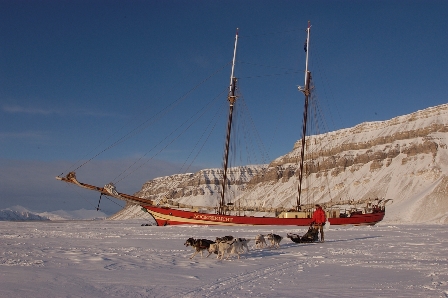 At the 'Noorderlicht' frozen into Tempelfjord, Svalbard.[/caption]
The second day we drive our sledges up the frozen Tempelfjord past Kap Schultz to the base of the Tuna glacier. It's so cold I fall into a mild coma of incomprehension. I've been looking through a tunnel of fleece, down and synthetic garments with such intense focus I can't really see anything apart from my feet and the dogs in front of me. Removing one of two balaclavas, parka hood and polar suit hood, I look up and see a blue white cliff towering over me. I take my camera from its bag resting inside the sledge pack but the shutter is frozen. The new batteries are dead, an effect of sub-zero temperatures. The glacier’s other-worldliness justifies the journey in itself without photos; it’s a breath-taking sight.
Dog sledging can be noisy. The dogs always begin barking as soon as the sledge stops moving. They don't bark when they're exhausted, almost never, or when asleep. They are quite remarkable animals however, resilient, tough, intelligent, often comical, each one possessed of a singular personality. When trotting at a steady pace over smooth ice or wind-swept clean flat snow, they’re strangely quiet. Only panting and gentle foot pads softly touching the icy surface can be heard, a magical series of brief moments.
[caption id="attachment_1572" align="alignnone" width="448"]
At the 'Noorderlicht' frozen into Tempelfjord, Svalbard.[/caption]
The second day we drive our sledges up the frozen Tempelfjord past Kap Schultz to the base of the Tuna glacier. It's so cold I fall into a mild coma of incomprehension. I've been looking through a tunnel of fleece, down and synthetic garments with such intense focus I can't really see anything apart from my feet and the dogs in front of me. Removing one of two balaclavas, parka hood and polar suit hood, I look up and see a blue white cliff towering over me. I take my camera from its bag resting inside the sledge pack but the shutter is frozen. The new batteries are dead, an effect of sub-zero temperatures. The glacier’s other-worldliness justifies the journey in itself without photos; it’s a breath-taking sight.
Dog sledging can be noisy. The dogs always begin barking as soon as the sledge stops moving. They don't bark when they're exhausted, almost never, or when asleep. They are quite remarkable animals however, resilient, tough, intelligent, often comical, each one possessed of a singular personality. When trotting at a steady pace over smooth ice or wind-swept clean flat snow, they’re strangely quiet. Only panting and gentle foot pads softly touching the icy surface can be heard, a magical series of brief moments.
[caption id="attachment_1572" align="alignnone" width="448"]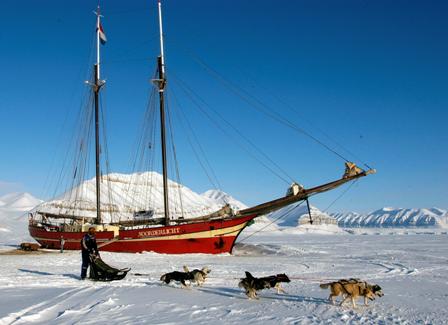 Ready to go. From the 'Noorderlicht' in Tempelfjord, Svalbard.[/caption]
We leave the glacier to ascend a nearby mountain whose summit shelters the hidden Nuisda valley. One of the guides visited two years previously and believes it will be a sheltered place in which to stop for lunch. Before ascending the steep slope that leads to the valley, he fires a gunshot into the air checking for avalanche possibility---though I think the dogs could have barked down an entire mountain of snow without a problem. I push my sledge uphill with the dogs pulling hard. They look backwards constantly checking to ensure I’m doing my fair share of pushing the heavy sledge. If I stop pushing uphill through deep snow, the dogs stop pulling and we began to slide downhill. The dogs view this as a jolly good lark, a golden opportunity to entangle their leads like strands of well cooked spaghetti. The sorting out of leads can take hours, requiring removal of mittens, a painful experience for naked human hands so I push while keeping my team together.
[caption id="attachment_2011" align="alignnone" width="283"]
Ready to go. From the 'Noorderlicht' in Tempelfjord, Svalbard.[/caption]
We leave the glacier to ascend a nearby mountain whose summit shelters the hidden Nuisda valley. One of the guides visited two years previously and believes it will be a sheltered place in which to stop for lunch. Before ascending the steep slope that leads to the valley, he fires a gunshot into the air checking for avalanche possibility---though I think the dogs could have barked down an entire mountain of snow without a problem. I push my sledge uphill with the dogs pulling hard. They look backwards constantly checking to ensure I’m doing my fair share of pushing the heavy sledge. If I stop pushing uphill through deep snow, the dogs stop pulling and we began to slide downhill. The dogs view this as a jolly good lark, a golden opportunity to entangle their leads like strands of well cooked spaghetti. The sorting out of leads can take hours, requiring removal of mittens, a painful experience for naked human hands so I push while keeping my team together.
[caption id="attachment_2011" align="alignnone" width="283"]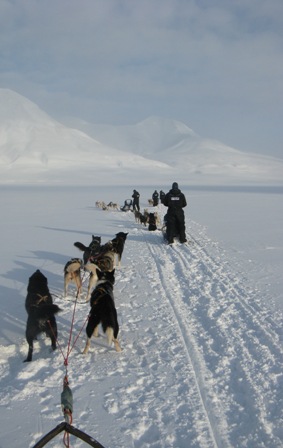 Mushing en route to a glacier.[/caption]
After much pushing and cajoling the dogs, shoving the proverbial up a steep hill, we reach a prime picnic position in the sheltered leeward side of the valley. Our field lunch is a freeze dried packet of organic meat stew. Served in a cup, I pour hot water over both it and me because of my cold clumsy mitten clad hands. I drink warm reconstituted currant juice and nibble at a bit of frozen chocolate. Seated cross-legged on reindeer skins in a semi-circle of snow, we look very much, I imagine, like a line of frozen seated Buddha statues. My dogs grab the opportunity to nap, curling themselves into tight circles, heads tucked under brushy tails, backs facing the wind. Within seconds they’ve calmed into tranquil silence. The wind subsides and quiet pervades. No one speaks when raw beauty of this grandeur speaks for itself.
[caption id="attachment_2009" align="alignnone" width="336"]
Mushing en route to a glacier.[/caption]
After much pushing and cajoling the dogs, shoving the proverbial up a steep hill, we reach a prime picnic position in the sheltered leeward side of the valley. Our field lunch is a freeze dried packet of organic meat stew. Served in a cup, I pour hot water over both it and me because of my cold clumsy mitten clad hands. I drink warm reconstituted currant juice and nibble at a bit of frozen chocolate. Seated cross-legged on reindeer skins in a semi-circle of snow, we look very much, I imagine, like a line of frozen seated Buddha statues. My dogs grab the opportunity to nap, curling themselves into tight circles, heads tucked under brushy tails, backs facing the wind. Within seconds they’ve calmed into tranquil silence. The wind subsides and quiet pervades. No one speaks when raw beauty of this grandeur speaks for itself.
[caption id="attachment_2009" align="alignnone" width="336"] Napping huskies.[/caption]
After lunch, we cross to the other side of the valley searching for a way back to Tempelfjord; it’s unmarked territory. We haven’t seen anyone for two days apart from a few travellers on fast snowmobiles, their revving engines reminding me that dog’s barking is infinitely preferable to a snowmobile engine’s shrill pitch.
The navigational challenge of descending the valley necessitates an interesting dog sledge manoeuvre I call 'ski sledging'. One foot remains on the brake so the sledge doesn't overtake the dogs. The other foot balances the sledge itself. I make it safely all the way down the steep slopes but run into a snow drift metres from the bottom. The sledge and I almost part company. During the expedition briefing a day before leaving Longyearbyen, I was told in no uncertain terms that I must NEVER EVER NEVER EVER let go of my sledge if I fall off. The dogs will continue to run all the way to Russia via Canada and I will have to find them... on foot. Holding on with my right hand, I’m dragged for twenty metres across hard sharp ice, bruising my shoulder. The loosened anchor fortunately catches hold of the ice and the sledge slows enough allowing me to grab hold with my free left hand. Back in standing position I push hard on the brake. When the sledge finally stops each of my six furry friends looks back at me as if to ask, ‘What the hell are you doing with our ride?’
[caption id="attachment_2013" align="alignnone" width="362"]
Napping huskies.[/caption]
After lunch, we cross to the other side of the valley searching for a way back to Tempelfjord; it’s unmarked territory. We haven’t seen anyone for two days apart from a few travellers on fast snowmobiles, their revving engines reminding me that dog’s barking is infinitely preferable to a snowmobile engine’s shrill pitch.
The navigational challenge of descending the valley necessitates an interesting dog sledge manoeuvre I call 'ski sledging'. One foot remains on the brake so the sledge doesn't overtake the dogs. The other foot balances the sledge itself. I make it safely all the way down the steep slopes but run into a snow drift metres from the bottom. The sledge and I almost part company. During the expedition briefing a day before leaving Longyearbyen, I was told in no uncertain terms that I must NEVER EVER NEVER EVER let go of my sledge if I fall off. The dogs will continue to run all the way to Russia via Canada and I will have to find them... on foot. Holding on with my right hand, I’m dragged for twenty metres across hard sharp ice, bruising my shoulder. The loosened anchor fortunately catches hold of the ice and the sledge slows enough allowing me to grab hold with my free left hand. Back in standing position I push hard on the brake. When the sledge finally stops each of my six furry friends looks back at me as if to ask, ‘What the hell are you doing with our ride?’
[caption id="attachment_2013" align="alignnone" width="362"] A break in the journey with mountain backdrop.[/caption]
Never one to let an interesting experience happen just once, feeling cheekily confident after four days of dog sledging, on our last day I fall off the sledge again while making a sharp turn uphill outside the main dog camp. Three other fellow dog mushers make the same misjudgement in taking the sharp turn too quickly and cop it much worse than me. Eighteen dogs are now tangled up in blue so to speak and it takes two hours of collective effort to sort out the mess before finally heading back to Longyearbyen, a warm shower and a quiet meal without the background music of barking dogs.
I suspect that my dog sledging days are numbered. The intensely felt moments of perfection when the dogs are jogging together in silent union, when all around is serenely wonderful and the earth is a majestic white jewel are in distinct disproportion to the innumerable hours of struggle against nearly impossible elements: weather, track conditions, frostbite and fatigue. This combined with canine cunning winning nine times out of ten against human ineptitude has surely put me off becoming anything but an amateur dog sledger.
On second thought, practice does make perfect.
A break in the journey with mountain backdrop.[/caption]
Never one to let an interesting experience happen just once, feeling cheekily confident after four days of dog sledging, on our last day I fall off the sledge again while making a sharp turn uphill outside the main dog camp. Three other fellow dog mushers make the same misjudgement in taking the sharp turn too quickly and cop it much worse than me. Eighteen dogs are now tangled up in blue so to speak and it takes two hours of collective effort to sort out the mess before finally heading back to Longyearbyen, a warm shower and a quiet meal without the background music of barking dogs.
I suspect that my dog sledging days are numbered. The intensely felt moments of perfection when the dogs are jogging together in silent union, when all around is serenely wonderful and the earth is a majestic white jewel are in distinct disproportion to the innumerable hours of struggle against nearly impossible elements: weather, track conditions, frostbite and fatigue. This combined with canine cunning winning nine times out of ten against human ineptitude has surely put me off becoming anything but an amateur dog sledger.
On second thought, practice does make perfect.
Tom Neal Tacker travelled courtesy of 50 Degrees North, Thai Airways and SAS Airways.
Naked Facts:50 Degrees North offers dog sledging and other trips to Svalbard during the short spring season, March and April. See www.fiftydegreesnorth.com or contact 1300 422 821 for more information. Costs for a Dogsled Expedition to the Ship in the Ice are approximately $AUD3,510 per person including most meals, safety equipment, polar suits and boots, accommodation for three nights onboard the ‘Noorderlicht’ and two nights at Basecamp Trapper’s Lodge in central Longyearbyen. Extra nights at Trapper’s Lodge are from 1450 Norwegian Kroner (AUD$250) a night. The meals cooked on board the 'Nooderlicht's' tiny galley are surprisingly tasty and nutritious. Full credit to the crew (two very resourceful Dutch women) for their ingenuity, resourcefulness and warm hospitality.
SAS has a return fare from Oslo to Longyearbyen via Tromso from approximately $AUD500 depending on the season. See www.flysas.com
Naked Eats:
The Huset restaurant, café and nightclub two kilometres from Trapper’s Lodge, offers superb dining. Local delicacies such as Arctic char, reindeer and cloudberries accompany a surprisingly extensive wine list. See www.huset.com and be sure to reserve first, Tel: +79 02 25 00. Open Monday to Sunday from 19:00 until 22:00 for dinner.
The Kroa restaurant and bar behind Trapper’s Lodge in Longyearbyen’s Sentrum district is funky and fun serving well prepared food. Try their specially imported Jenssen XO Cognac ‘on tap’. The seafood soup or one of the smoked fish pizzas is recommended. Reserve a table first. Tel: +79 02 13 00. Open 7 days and nights.
Naked Tips:
Inevitably, a few days will be passed in Longyearbyen. Don't miss the town's historical museum located on the fjord edge off the main road to and from the airport. See www.svalbardmseum.no for more information.Near the airport on the north facing side of a mountain juts a glassy glittering gateway to a secret world, a single lane road running off the main drag between town and the airport winds up to what appears to be a rather expensively kitted out mine shaft. Here lies the Global Seed Vault, established early this century by an international consortium of science organisations. The striking entry was designed by a local architectural firm, the tunnels cleverly drilled into rocky permafrost by a local engineering company, Leonhard Nilsen & Sonner. Something of an engineering marvel, the tunnels require constant maintenance as the permafrost continually buckles walls, floors and door frames.
[caption id="attachment_2004" align="alignnone" width="448"]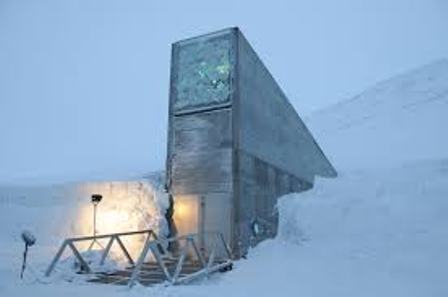 Global Seed Vault entrance.[/caption]
Global Seed Vault entrance.[/caption]
Sadly, the Global Seed Vault is off limits to casual visitors. Luckily I was allowed inside for a couple hours to see the planet’s essential safeguard for our continuing existence if nuclear holocaust or a natural catastrophe occurs and most of the world’s population is obliterated, crops are destroyed and harvests dwindle to nothing.
[caption id="attachment_2005" align="alignnone" width="448"] Global Seed Vault interior.[/caption]
Global Seed Vault interior.[/caption]
If human beings are to survive, food must be found. Hopefully to ensure our future if worse comes to worst, millions of seeds collected from around the planet are stored in deep tunnels drilled into permafrost, the seeds’ vitality is more or less guaranteed for thousands of years.
[caption id="attachment_2007" align="alignnone" width="448"]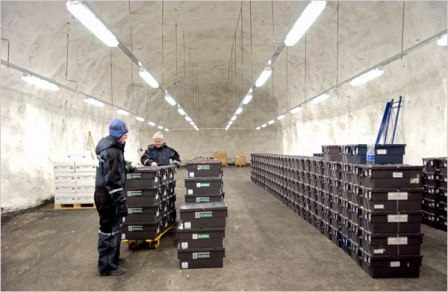 Global Seed Vault interior with employees checking seed storage.[/caption]
Global Seed Vault interior with employees checking seed storage.[/caption]
The project is an ongoing one. Currently over 3 million seeds are in storage. More are being added regularly. Lined up on shelves, protected in thick plastic sealed bags then stacked in specially designed boxes, these seeds represent mankind’s best effort to face a plausible reality, frightening as it may seem. The implicit future the Global Seed Vault represents sends chilling thoughts deep into my soul as I wander through deep tunnels filled with seeds to save us from our most horrific nightmare.
See www.regjeringen.no for more information.
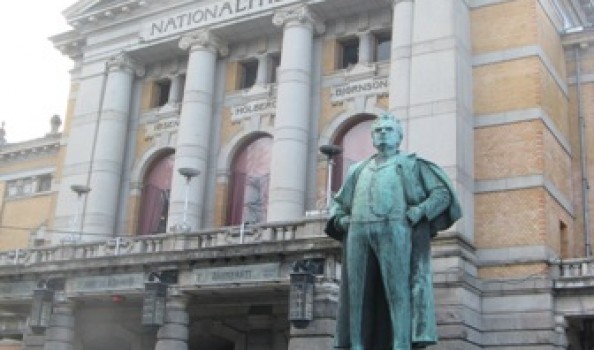 https://nakedhungrytraveller.com.au/all-sides-oslo/ All Sides OsloFew capital cities have an outdoor sculpture park like Oslo’s Vigelandsparken. More than 200 granite, cast iron and bronze statues are modelled on people Gustav Vigeland observed during his 74 years, almost all of it spent in Oslo. His old house is next to the park named after him, close enough for the master to see his work simply through looking out his front windows. The park is open 7 days from dawn till dusk, free entry, a welcome enticement in this expensive city. At Vigelandsparken, watching Norwegians watch themselves as if cast straight from life’s exigencies, reveals a side of the national character that is usually hidden. I first visited the park before Anders Behring Breivik’s horrific massacre and bombing in Oslo of 22 July 2011. It was the worst mass murder in Norway’s modern history and it shook up the national psyche. Breivik’s slaughtering of innocents driven by his extremely nationalistic political beliefs allowed an overall view into contemporary Norwegian society and its changing demographics. An increase of migrants from Africa and Asia has forever altered Norway’s overwhelmingly white colour palette. No one in Norway apparently would have believed immigration could be the root cause of such livid hatred. Norwegians are proud, imbued with a sense history derived of collective hardships. Inclement weather, geographical isolation and challenging terrain have inculcated an independent culture at the edge of the continent, tied only loosely to Europe’s dominance. As a sea faring country, Norwegians have always been great travellers, forging links to other cultures far from home, often in sympathy with folks of equally humble origins. Norway’s humanitarian stance to immigration encouraged an influx of refugees, the majority from Sub-Saharan Africa. For a few Norwegians, the government’s policies have been anathema to racial purity and Norwegian cultural integrity. Sadly, one maniac chose to commit mass murder therefore making his insanity abundantly clear to everyone. His abominable crime should not be viewed as representative of a majority opinion. On the contrary, Norwegians are internationally acclaimed as peace purveyors, generous with their new found wealth and very welcoming of an expanding multi-cultural society and the increased richness of life it engenders. That said, Norwegians are also notoriously aloof, often unfriendly and shy around strangers. Like most Scandinavians when they’ve had too much to drink, the reserve becomes less glacial after a few beers or aquavits. Booze fuelled warmth loosens hard faces into cheery smiles. Oslogians (Oslo residents) can let their hair down when the conditions are right. Back at Vigelandsparken, I witnessed whole family groups interacting with the sculptures. Kids climbed up bronze images of kids like them, robustly figured, pudgily muscled and coolly smiling as if they had a secret they didn’t want to share. Well dressed parents observed from close by, avoiding eye contact with other strangers or parents, safe in their private worlds while their children played quietly amongst the statues of family groups. Grandparents were the most demonstrative emotionally. Some of Vigeland’s works generate strong emotions. Age wearies while youth blooms, difficult appearances to emulate in stone or metal. Many of Vigeland’s sculptures are capable of evincing passion for lost youth and old age consumed by work for scant gain. [caption id="attachment_2079" align="alignnone" width="316"]
https://nakedhungrytraveller.com.au/all-sides-oslo/ All Sides OsloFew capital cities have an outdoor sculpture park like Oslo’s Vigelandsparken. More than 200 granite, cast iron and bronze statues are modelled on people Gustav Vigeland observed during his 74 years, almost all of it spent in Oslo. His old house is next to the park named after him, close enough for the master to see his work simply through looking out his front windows. The park is open 7 days from dawn till dusk, free entry, a welcome enticement in this expensive city. At Vigelandsparken, watching Norwegians watch themselves as if cast straight from life’s exigencies, reveals a side of the national character that is usually hidden. I first visited the park before Anders Behring Breivik’s horrific massacre and bombing in Oslo of 22 July 2011. It was the worst mass murder in Norway’s modern history and it shook up the national psyche. Breivik’s slaughtering of innocents driven by his extremely nationalistic political beliefs allowed an overall view into contemporary Norwegian society and its changing demographics. An increase of migrants from Africa and Asia has forever altered Norway’s overwhelmingly white colour palette. No one in Norway apparently would have believed immigration could be the root cause of such livid hatred. Norwegians are proud, imbued with a sense history derived of collective hardships. Inclement weather, geographical isolation and challenging terrain have inculcated an independent culture at the edge of the continent, tied only loosely to Europe’s dominance. As a sea faring country, Norwegians have always been great travellers, forging links to other cultures far from home, often in sympathy with folks of equally humble origins. Norway’s humanitarian stance to immigration encouraged an influx of refugees, the majority from Sub-Saharan Africa. For a few Norwegians, the government’s policies have been anathema to racial purity and Norwegian cultural integrity. Sadly, one maniac chose to commit mass murder therefore making his insanity abundantly clear to everyone. His abominable crime should not be viewed as representative of a majority opinion. On the contrary, Norwegians are internationally acclaimed as peace purveyors, generous with their new found wealth and very welcoming of an expanding multi-cultural society and the increased richness of life it engenders. That said, Norwegians are also notoriously aloof, often unfriendly and shy around strangers. Like most Scandinavians when they’ve had too much to drink, the reserve becomes less glacial after a few beers or aquavits. Booze fuelled warmth loosens hard faces into cheery smiles. Oslogians (Oslo residents) can let their hair down when the conditions are right. Back at Vigelandsparken, I witnessed whole family groups interacting with the sculptures. Kids climbed up bronze images of kids like them, robustly figured, pudgily muscled and coolly smiling as if they had a secret they didn’t want to share. Well dressed parents observed from close by, avoiding eye contact with other strangers or parents, safe in their private worlds while their children played quietly amongst the statues of family groups. Grandparents were the most demonstrative emotionally. Some of Vigeland’s works generate strong emotions. Age wearies while youth blooms, difficult appearances to emulate in stone or metal. Many of Vigeland’s sculptures are capable of evincing passion for lost youth and old age consumed by work for scant gain. [caption id="attachment_2079" align="alignnone" width="316"] Oslo's Vigelandsparken statue of a happy child.[/caption]
Oslo is a small city, compact and rather constrained by its fjord side location. Open water girds its southern limits while steep hills prevent northern urban sprawl.
From a traveller’s viewpoint, Oslo is clearly a wealthy town. For instance, everything works. The air is clean. The streets are almost entirely uncluttered with litter. Low rise 19th century buildings mix stylishly with low rise 20th century buildings. Down by the waterfront, splashy, sleek urban renewal projects have sprouted up among the old warehouses providing apartments for hipsters, urban groovers and trendy elites.
The downtown neighbourhood is traversable by foot or bicycle, while a very efficient public transport network of buses, trams, ferries and trains makes outlying suburbs easily accessible.
Many central shopping streets have been allocated entirely to pedestrians. Cars are banned. On my first day in Oslo I wandered up a main street, Storgata, and noted an adult store next to a clothing store. Large windows made it clear the sex shop was busy with customers. The clothing store was not. Curious, I walked in and immediately observed two adolescent boys acting out a Viking sword fight with two hefty dildos. Their parents were lingering in the lacy lingerie section further back unaware of their offspring’s novel use of large black sex toys. Other customers took no notice whatsoever of the boys’ antics.
This was one of my first impressions of Oslo and its inhabitants. I decided then that I would like Oslo, if only for a nonchalant attitude to an alternative use of sex toys. Scandinavian’s well known social embrace of sex as a means of fun instead of merely a reproductive act best performed in private is well entrenched in Oslo.
Oslo continually ranks highly on lists of the world’s most liveable cities, a fact I believe is worth pointing out at this juncture in the story.
Because of the North Sea oil boom, Norway has grown very wealthy. From the late 1970s oil has been profitably extracted from offshore rigs. Subsequently, the nation’s bottom line has improved dramatically. Previously a poor cousin riding on Sweden’s economic success, sending workers across the border to sign up with Volvo, Saab and Ericsson, Norway’s economy was once reliant almost entirely on fishing, forestry and tourism.
Times have changed. These days young Swedes cross the border looking for work in Oslo’s restaurants and bars. The wages are better and work is easy to find. When I asked a few restaurateurs why they hired so many young Swedes, the response was universal: they’re friendlier and they work harder.
I don’t see Swedes as being more outwardly friendly than Norwegians but my perspective is naturally an outsider’s view. That being said, Scandinavians in general are a cool group. If national character can be judged by an awareness of social limitations, both Norwegians and Swedes aren’t going to win international popularity contests when it comes to the friendliness category. A well regarded locally made television documentary shown in both countries debated why the countries’ inhabitants are so hesitant to make friends with strangers. That debate is ongoing while plausible answers are still being addressed. Meanwhile, back at the hospitality coalface, Swedish employees dominate Oslo’s restaurants and bars.
Oslo’s array of museums is an interesting one for such a relatively small city.
I fell in love with the Fram Museum, named after the polar exploration ship it houses. 2011 was the centenary of Amundsen’s expedition to the South Pole. Since then, Norwegians have been riding a polar history high. It’s fascinating stuff.
I knew little about Fridtjof Nansen before visiting this small museum essential to understanding the physical, psychological and emotional challenges Nansen and Amundsen faced as they sought to conquer both poles. Roald Amundsen is one of the world’s greatest explorers, well known and studied, largely due to his conquering of the South Pole. Nansen deserves equal attention. He’s a national hero, winner of the Nobel Peace Prize in 1922 for his work helping displaced persons post World War 1 and for his vital assistance in forming the League of Nations, the precursor to the United Nations.
Nansen reached latitude North 86.14 during his polar expedition of 1893-1896. In 1888 another expedition led by him crossed Greenland’s interior for the first time in recorded human history. Nansen’s ship, the Fram carried him to northern polar waters. The same ship also served Amundsen’s explorations into southern polar waters. It’s the only ship to have been essential to both North and South Pole discoveries.
One of Norway’s esteemed contributors to literature and theatre, Henrik Ibsen, also lived in Oslo. His apartment has become a museum devoted to his life and work. An appointment is necessary to visit but can be simply arranged by email.
Oslo is rich with arts. Don’t miss: The National Gallery (Edvard Munch’s most famous painting, ‘The Scream’ is here), the Munch Museum (Munch donated his collection to the city of Oslo), the National Museum of Contemporary Art, the Henie Onsted Art Centre, the Museum of Decorative Arts and Design (Scandinavian design is rightly world famous) and the International Museum of Children’s Art.
Oslo is a skier’s town for six months of the year. The subway and tram carriages are filled with people of all ages carrying skis, on their way to nearby ski fields or on their way home after a long day’s schussing. Cross country (Nordic) skiing is particularly loved by Norwegians. They have the thigh muscles to prove it.
The Holmenkollen Ski Museum and Tower is a short trip on public transport from Oslo’s centre. Any traveller keen on ski history should visit this small museum housed at the base of this futuristic designed ski jump. The jump and museum building underneath is visible from many points in Oslo’s cityscape, a much loved local icon.
Thor Heyerdahl is another famous Norwegian ocean voyager and explorer. The Kon Tiki museum is devoted to his contemporary explorations. The museum also offers permanent exhibitions linking his voyages to early navigators and is located close to the Viking Ship Museum and the Fram Museum. Make it a celebratory global navigation day and visit all three museums. I dare you not to be impressed by Norway’s long maritime history; seemingly inbred into the Norwegian national psyche.
Scarcely populated Norway (approximately 5 million inhabitants) is tied to land and sea in equal measures. An obvious love affair exists between Norwegians and their environment, despite logging, mining and offshore oil rigs.
Fish and seafood dominate most restaurant menus. I haven’t eaten a bad meal yet in Oslo. Indeed on a recent visit I ate three particularly fine meals at: Engebret Cafe opposite the old Christiania Theatre where Munch and other artists and writers used to dine or drink Absinthe, Lofoten Fiskerestaurant in the newish harbour side development and at the Grand Hotel’s Grand Cafe. Luckily I visited Oslo during the cod (skrei) season. If a fish can lay claim to forming a nation, the cod has done much to support Norway’s developing national identity.
Oslo’s City Hall is the perfect end or start to any visit. Construction began in 1931, completed in 1947 after an interruption because of World War 2. Here the Nobel Peace Prize is awarded each year on December 10. The murals within tell the story of modern Norway. The figures depicted strongly resemble those spread throughout Vigelandsparken. Oslo’s human spirit is a constant presence.
Tom Neal Tacker travelled to Oslo courtesy of Thai Airways and was a guest of Oslo's tourism bureau.
Naked Facts:
Naked Sleeps:
The Grand Hotel (www.grand.no) is the city’s best. Sure it’s expensive but it’s worth the price. History lives in this hotel. Nobel Peace Prize laureates stay in the top floor suite overlooking the city’s National Theatre, between the Parliament and Royal Palace. The rooms are spacious, quiet and elegantly understated. Service is exemplary as is the food served in all the hotel’s restaurants.
The Thon Opera hotel (www.thonhotels.com) near the city’s central railway station, also where the Airport Express leaves each 15 minutes, is well situated overlooking the new Opera House and the Oslo fjord. Rooms are surprisingly small and mostly utilitarian with little decoration. That said, the hotel restaurant, Scala (opera=Scala), is actually quite good as far as bland hotel restaurants go.
Naked Eats:
Cafe Engebret (www.engebret-cafe.no), open Mon-Sat is one of the city’s oldest. Dine here for a refresher course of traditional Norwegian food combined with modern technique. Reindeer and skrei (cod) are specialties of the house. Excellent service with a fine wine list and bar with a wide ranging selection of local aquavits complete the whole superlative package.
Lofoten (www.lofoten-fiskerestaurant.no) is open 7 days. Local hero chef, Bjorn Tore Furset opened Lofoten (named after a small clean and green archipelago off the Norwegian coast) in 1997, the first in his small group of top quality restaurants in Oslo. Obviously, the emphasis is on seafood and fish of all kinds. It’s not cutting edge cuisine like Rene Redzepi’s in Copenhagen or Mathias Dahlgren’s in Stockholm but as an example of constancy in Oslo’s dining scene, it’s one of the city’s best.
Naked Essentials:
For a list of Oslo’s museums, galleries, attractions and exhibitions, see www.visitoslo.com Use this site to book online Oslo’s indispensable Oslo Pass for unlimited access to Oslo's public transport, reduced museum entry fees and discounts at selected restaurants. The Airport Express train is not included in the Oslo Pass.
Oslo's Vigelandsparken statue of a happy child.[/caption]
Oslo is a small city, compact and rather constrained by its fjord side location. Open water girds its southern limits while steep hills prevent northern urban sprawl.
From a traveller’s viewpoint, Oslo is clearly a wealthy town. For instance, everything works. The air is clean. The streets are almost entirely uncluttered with litter. Low rise 19th century buildings mix stylishly with low rise 20th century buildings. Down by the waterfront, splashy, sleek urban renewal projects have sprouted up among the old warehouses providing apartments for hipsters, urban groovers and trendy elites.
The downtown neighbourhood is traversable by foot or bicycle, while a very efficient public transport network of buses, trams, ferries and trains makes outlying suburbs easily accessible.
Many central shopping streets have been allocated entirely to pedestrians. Cars are banned. On my first day in Oslo I wandered up a main street, Storgata, and noted an adult store next to a clothing store. Large windows made it clear the sex shop was busy with customers. The clothing store was not. Curious, I walked in and immediately observed two adolescent boys acting out a Viking sword fight with two hefty dildos. Their parents were lingering in the lacy lingerie section further back unaware of their offspring’s novel use of large black sex toys. Other customers took no notice whatsoever of the boys’ antics.
This was one of my first impressions of Oslo and its inhabitants. I decided then that I would like Oslo, if only for a nonchalant attitude to an alternative use of sex toys. Scandinavian’s well known social embrace of sex as a means of fun instead of merely a reproductive act best performed in private is well entrenched in Oslo.
Oslo continually ranks highly on lists of the world’s most liveable cities, a fact I believe is worth pointing out at this juncture in the story.
Because of the North Sea oil boom, Norway has grown very wealthy. From the late 1970s oil has been profitably extracted from offshore rigs. Subsequently, the nation’s bottom line has improved dramatically. Previously a poor cousin riding on Sweden’s economic success, sending workers across the border to sign up with Volvo, Saab and Ericsson, Norway’s economy was once reliant almost entirely on fishing, forestry and tourism.
Times have changed. These days young Swedes cross the border looking for work in Oslo’s restaurants and bars. The wages are better and work is easy to find. When I asked a few restaurateurs why they hired so many young Swedes, the response was universal: they’re friendlier and they work harder.
I don’t see Swedes as being more outwardly friendly than Norwegians but my perspective is naturally an outsider’s view. That being said, Scandinavians in general are a cool group. If national character can be judged by an awareness of social limitations, both Norwegians and Swedes aren’t going to win international popularity contests when it comes to the friendliness category. A well regarded locally made television documentary shown in both countries debated why the countries’ inhabitants are so hesitant to make friends with strangers. That debate is ongoing while plausible answers are still being addressed. Meanwhile, back at the hospitality coalface, Swedish employees dominate Oslo’s restaurants and bars.
Oslo’s array of museums is an interesting one for such a relatively small city.
I fell in love with the Fram Museum, named after the polar exploration ship it houses. 2011 was the centenary of Amundsen’s expedition to the South Pole. Since then, Norwegians have been riding a polar history high. It’s fascinating stuff.
I knew little about Fridtjof Nansen before visiting this small museum essential to understanding the physical, psychological and emotional challenges Nansen and Amundsen faced as they sought to conquer both poles. Roald Amundsen is one of the world’s greatest explorers, well known and studied, largely due to his conquering of the South Pole. Nansen deserves equal attention. He’s a national hero, winner of the Nobel Peace Prize in 1922 for his work helping displaced persons post World War 1 and for his vital assistance in forming the League of Nations, the precursor to the United Nations.
Nansen reached latitude North 86.14 during his polar expedition of 1893-1896. In 1888 another expedition led by him crossed Greenland’s interior for the first time in recorded human history. Nansen’s ship, the Fram carried him to northern polar waters. The same ship also served Amundsen’s explorations into southern polar waters. It’s the only ship to have been essential to both North and South Pole discoveries.
One of Norway’s esteemed contributors to literature and theatre, Henrik Ibsen, also lived in Oslo. His apartment has become a museum devoted to his life and work. An appointment is necessary to visit but can be simply arranged by email.
Oslo is rich with arts. Don’t miss: The National Gallery (Edvard Munch’s most famous painting, ‘The Scream’ is here), the Munch Museum (Munch donated his collection to the city of Oslo), the National Museum of Contemporary Art, the Henie Onsted Art Centre, the Museum of Decorative Arts and Design (Scandinavian design is rightly world famous) and the International Museum of Children’s Art.
Oslo is a skier’s town for six months of the year. The subway and tram carriages are filled with people of all ages carrying skis, on their way to nearby ski fields or on their way home after a long day’s schussing. Cross country (Nordic) skiing is particularly loved by Norwegians. They have the thigh muscles to prove it.
The Holmenkollen Ski Museum and Tower is a short trip on public transport from Oslo’s centre. Any traveller keen on ski history should visit this small museum housed at the base of this futuristic designed ski jump. The jump and museum building underneath is visible from many points in Oslo’s cityscape, a much loved local icon.
Thor Heyerdahl is another famous Norwegian ocean voyager and explorer. The Kon Tiki museum is devoted to his contemporary explorations. The museum also offers permanent exhibitions linking his voyages to early navigators and is located close to the Viking Ship Museum and the Fram Museum. Make it a celebratory global navigation day and visit all three museums. I dare you not to be impressed by Norway’s long maritime history; seemingly inbred into the Norwegian national psyche.
Scarcely populated Norway (approximately 5 million inhabitants) is tied to land and sea in equal measures. An obvious love affair exists between Norwegians and their environment, despite logging, mining and offshore oil rigs.
Fish and seafood dominate most restaurant menus. I haven’t eaten a bad meal yet in Oslo. Indeed on a recent visit I ate three particularly fine meals at: Engebret Cafe opposite the old Christiania Theatre where Munch and other artists and writers used to dine or drink Absinthe, Lofoten Fiskerestaurant in the newish harbour side development and at the Grand Hotel’s Grand Cafe. Luckily I visited Oslo during the cod (skrei) season. If a fish can lay claim to forming a nation, the cod has done much to support Norway’s developing national identity.
Oslo’s City Hall is the perfect end or start to any visit. Construction began in 1931, completed in 1947 after an interruption because of World War 2. Here the Nobel Peace Prize is awarded each year on December 10. The murals within tell the story of modern Norway. The figures depicted strongly resemble those spread throughout Vigelandsparken. Oslo’s human spirit is a constant presence.
Tom Neal Tacker travelled to Oslo courtesy of Thai Airways and was a guest of Oslo's tourism bureau.
Naked Facts:
Naked Sleeps:
The Grand Hotel (www.grand.no) is the city’s best. Sure it’s expensive but it’s worth the price. History lives in this hotel. Nobel Peace Prize laureates stay in the top floor suite overlooking the city’s National Theatre, between the Parliament and Royal Palace. The rooms are spacious, quiet and elegantly understated. Service is exemplary as is the food served in all the hotel’s restaurants.
The Thon Opera hotel (www.thonhotels.com) near the city’s central railway station, also where the Airport Express leaves each 15 minutes, is well situated overlooking the new Opera House and the Oslo fjord. Rooms are surprisingly small and mostly utilitarian with little decoration. That said, the hotel restaurant, Scala (opera=Scala), is actually quite good as far as bland hotel restaurants go.
Naked Eats:
Cafe Engebret (www.engebret-cafe.no), open Mon-Sat is one of the city’s oldest. Dine here for a refresher course of traditional Norwegian food combined with modern technique. Reindeer and skrei (cod) are specialties of the house. Excellent service with a fine wine list and bar with a wide ranging selection of local aquavits complete the whole superlative package.
Lofoten (www.lofoten-fiskerestaurant.no) is open 7 days. Local hero chef, Bjorn Tore Furset opened Lofoten (named after a small clean and green archipelago off the Norwegian coast) in 1997, the first in his small group of top quality restaurants in Oslo. Obviously, the emphasis is on seafood and fish of all kinds. It’s not cutting edge cuisine like Rene Redzepi’s in Copenhagen or Mathias Dahlgren’s in Stockholm but as an example of constancy in Oslo’s dining scene, it’s one of the city’s best.
Naked Essentials:
For a list of Oslo’s museums, galleries, attractions and exhibitions, see www.visitoslo.com Use this site to book online Oslo’s indispensable Oslo Pass for unlimited access to Oslo's public transport, reduced museum entry fees and discounts at selected restaurants. The Airport Express train is not included in the Oslo Pass.
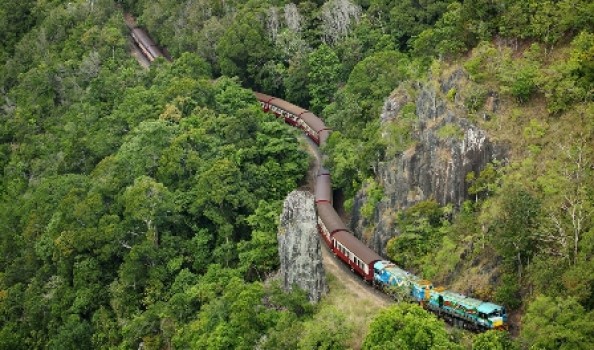 https://nakedhungrytraveller.com.au/getting-high-in-fnq/ Getting High in FNQ
https://nakedhungrytraveller.com.au/getting-high-in-fnq/ Getting High in FNQFar north tropical Queensland, a.k.a. FNQ or TNQ (Tropical North Queensland), has taken a couple of huge hits in recent years. Cyclone Larry ripped through the area around Tully, Innisfail and Babinda in March of 2006 while Cyclone Yasi rammed into the coast between Mission Beach and Cardwell in February 2011. Billions of dollars in damage ensued but thankfully, no lives were lost. Yasi shattered history. It was one of the biggest storms ever recorded.
It’s said that Queenslanders are built tough. I don’t doubt that. Two huge cyclones, floods and the economic downturn have taken an emotional toll but the spirit is strong. I can report that FNQ is now looking renewed. Most travellers while away their time on the beach, day tripping to the nearby Great Barrier Reef to snorkel or SCUBA dive. The reef and the rainforest represent the quintessential combination while visiting the region. (See NHT’s story nakedhungrytraveller.com.au/troppo-in-fnq) Less familiar is the Atherton Tablelands adjacent to the coast, higher up and a lot cooler. Weather-wise that is, not flash or glam-wise. There are no glitzy resorts. Tourism is small-scale and laid-back. Pastoral country dominates south of Atherton town, where the landscape is eternally green and forested. Scruffier and drier country dominates around Mareeba and beyond to Cooktown. In between a scattering of villages are dotted amongst volcanic lakes and protected swathes of rainforest where the canopy occasionally opens to long views to the Coral Sea beyond. From this naked hungry traveller’s perspective, in general the Atherton Tablelands ooze quirky, eccentric and off-beat in equal measures. Try this itinerary for a change. From Cairns, drive south for approximately 90 minutes along the Bruce Highway past Innisfail to Paronella Park. While not exactly smack dab in the middle of the Tablelands, Paronella Park near the tiny village of Mena Creek, is at its edge and as good a destination as any to begin a tour of the upper echelons of FNQ. Jose Paronella’s phantasmagorical park opened to visitors 77 years ago. It was the dream of a Spanish migrant in love with his new country. He devoted his life’s energy to creating a wonder world amongst the sugar cane fields and steep forested mountains. Sadly Paronella Park had fallen into neglectful disrepair by the 1980s. Good luck prevailed and it was purchased in 1993 by Victorians Mark and Judy Evans. The whole park, its camping grounds, cafe and gift shop have gradually and lovingly been renovated or added to since then. Now it’s a necessary stop on the FNQ traveller’s trail, well worth the time spent, particularly during the daily evening tours of the ephemeral grounds when the coloured lights illuminate the rainforest garden and waterfalls. To see the Moorish inspired castle in a green-scape on a summer’s evening while fruit bats flutter around its tower and balustrade, is to witness one of Australia’s most quirky sites. And don’t forget to enquire about Jose’s lover, her sister, his family and his fight with the Black Hand, the local branch of Italy’s Camorra and Sicily’s Mafia. From Mena Creek up into the highlands to Mamu Rainforest Canopy Walk, a slow and winding drive along the Palmerston Highway leads to this excellent adventure into Australia’s oldest and wettest rainforest, the green heart of the World Heritage Wet Tropics of Queensland, 8,940 km2 including seven national parks and over 700 areas of protected land, many privately owned. [caption id="attachment_1549" align="alignnone" width="448"]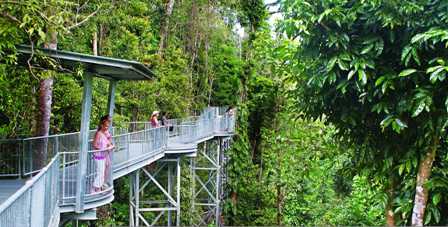 Mamu Rainforest Canopy walkway.[/caption]
The walk may take a couple hours or it can take a whole day. Photographic opportunities are in abundance and wildlife enthusiasts will be rewarded by patience, particularly early morning or at dusk. Hundreds of rare species thrive in this part of the northern tropics bio-sphere national park and reserve. The Wet Tropics contain the world’s greatest concentration of ancient flowering plant families in the world.
From Mamu via Milaa Milaa and Ravenshoe to Herberton, the landscape changes from wet to dry. In the 1880s Herberton became a wealthy mining town. Gold was the main aim but huge deposits of tin were discovered instead. As the tin was plundered down to the last ounce, the town’s importance eventually dwindled. Tin mining ceased operations in 1978.
Like Paronella Park, a large part of old Herberton was ‘rescued’ by a southern family with money and drive. It has become an open air museum, a small town with over thirty buildings packed with memorabilia. A good cafe operates from an old store in the centre of Historic Herberton Village, perfect for afternoon tea or lunch when the Aussie history touring experience begins to take its toll and heads fill with interesting trivia. There’s a lot of information to take in here, well worth absorbing as it’s laid out over several city blocks. I needed a head clearing espresso after a few hours and was only half way through Herberton’s illustrious past.
From Herberton Historic Village head back to the main Herberton-Atherton Road to the Kennedy Highway then to Yungaburra on the Gillies Highway.
Yungaburra is tiny, a one-pub town rather lost in time, lately being rediscovered by tree-changers and organic farmers bent on escaping from the hurly-burly of life on the lowlands.
[caption id="attachment_1607" align="alignnone" width="448"]
Mamu Rainforest Canopy walkway.[/caption]
The walk may take a couple hours or it can take a whole day. Photographic opportunities are in abundance and wildlife enthusiasts will be rewarded by patience, particularly early morning or at dusk. Hundreds of rare species thrive in this part of the northern tropics bio-sphere national park and reserve. The Wet Tropics contain the world’s greatest concentration of ancient flowering plant families in the world.
From Mamu via Milaa Milaa and Ravenshoe to Herberton, the landscape changes from wet to dry. In the 1880s Herberton became a wealthy mining town. Gold was the main aim but huge deposits of tin were discovered instead. As the tin was plundered down to the last ounce, the town’s importance eventually dwindled. Tin mining ceased operations in 1978.
Like Paronella Park, a large part of old Herberton was ‘rescued’ by a southern family with money and drive. It has become an open air museum, a small town with over thirty buildings packed with memorabilia. A good cafe operates from an old store in the centre of Historic Herberton Village, perfect for afternoon tea or lunch when the Aussie history touring experience begins to take its toll and heads fill with interesting trivia. There’s a lot of information to take in here, well worth absorbing as it’s laid out over several city blocks. I needed a head clearing espresso after a few hours and was only half way through Herberton’s illustrious past.
From Herberton Historic Village head back to the main Herberton-Atherton Road to the Kennedy Highway then to Yungaburra on the Gillies Highway.
Yungaburra is tiny, a one-pub town rather lost in time, lately being rediscovered by tree-changers and organic farmers bent on escaping from the hurly-burly of life on the lowlands.
[caption id="attachment_1607" align="alignnone" width="448"]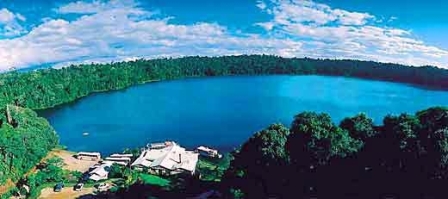 Lake Barrine overview.[/caption]
Outside Yungaburra is a duo of volcanic crater lakes, perfect for a cooling dip on hot muggy days. Lakes Eacham and Barrine are the centrepieces of the Crater Lakes National Park, each perfectly formed jewel drops filled with rainwater. To the east at the back of the lakes rise the mountains Bartle Frere and Bellenden Ker, Queensland’s highest peaks, 1,622 metres and 1,593 metres respectively. They are both ‘cloud-catchers’, their eastern slopes record Australia’s highest annual rainfall, 4048 mm. In 1979 Bellenden Ker Mountain was drenched with 11,251mm, the highest recorded in modern Australian history.
[caption id="attachment_1483" align="alignnone" width="155"]
Lake Barrine overview.[/caption]
Outside Yungaburra is a duo of volcanic crater lakes, perfect for a cooling dip on hot muggy days. Lakes Eacham and Barrine are the centrepieces of the Crater Lakes National Park, each perfectly formed jewel drops filled with rainwater. To the east at the back of the lakes rise the mountains Bartle Frere and Bellenden Ker, Queensland’s highest peaks, 1,622 metres and 1,593 metres respectively. They are both ‘cloud-catchers’, their eastern slopes record Australia’s highest annual rainfall, 4048 mm. In 1979 Bellenden Ker Mountain was drenched with 11,251mm, the highest recorded in modern Australian history.
[caption id="attachment_1483" align="alignnone" width="155"]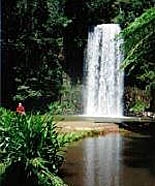 Millaa Millaa Falls in the Atherton Tablelands[/caption]
The rain shadow northwest of the high peaks grows in size further north towards Mareeba and the great outback.
Atherton town at 766 metres above sea level is FNQ’s dairy country capital town, quite lush with verdant grassy paddocks surrounding the town. Further along the Kennedy Highway Mareeba sits at 410 metres, the northernmost extent of the Atherton Tablelands, much drier, though small pockets of rainforest exist in the deep valleys and gullies around town.
Above average accommodation options are fairly sparse. Bog-standard motels, caravan parks and town pubs fill the short list. Sophisticated guesthouses or boutique hotels are mostly found on the coast itself.
I was lucky to find peace and serenity at Allawah Retreat on a large farming/grazing property just outside Tolga village between Atherton and Mareeba. A sweet collection of fully self contained cottages, all sporting stunning views from capacious decks (with spa baths) overlooking the expanse of the Tablelands. Each house has a fully equipped kitchen, lounge room with television (never used during my visit), shelves lined with books about the area’s history and wildlife, large bathrooms and king sized beds. Allawah is basically a couple’s retreat, not for kids. The wallabies hopping around my cottage each morning brought out my inner kid, as did the kookaburras perched on the deck railing while they laughed at me flopping in the spa bath. The owner kindly stocked the fridge with salads, steaks for the barbecue, breakfast makings with freshly baked bread and home made jams. The eggs were from the farm, the steaks from local beef and the fruit platter was from down the road. A reasonably priced wine list added even more value.
Mareeba was once FNQ’s dope capital, now it’s the caffeine capital. Italian migrants settled there in the 1920s to grow tobacco. The Black Hand moved in and gradually gained control of the local drug trade. Weed is still grown in abundance on hidden locations scattered round town but coffee has taken root as the prime agricultural money maker, that and tropical fruits. Coffee Works is in the centre of Mareeba and though it’s more touristy tacky than I like, its museum concerning the history of coffee and tea is quite fascinating. Well worth a few hours visit.
Outside town is Skybury Coffee plantation, a truly well run establishment that produces some of Australia’s best coffee. Mareeba’s dry, warm to hot climate is perfect for Arabica coffee bean growth. Don’t miss stopping at Skybury’s restaurant for at least one cuppa. Lunches are very good as well, particularly when enjoyed on the veranda overlooking the rows of evergreen coffee trees.
Besides coffee, the area around Mareeba is mango territory. By January, mangoes and other tropical fruits are at their best condition. If a farm stand is open by a roadside, stop and buy something. Support the local growers while you buy direct from the farm.
Quirky FNQ displays itself well at de Bruey’s Boutique Winery outside Mareeba on the road to Kuranda. Family owned and run, tropical fruit driven wine is the modus operandi here. Never tasted passionfruit wine or jaboticaba wine, lychee wine, bush cherry wine, mulberry wine, star apple or indeed mango wine before? Well, here’s your chance. Personally I find wine made from fruits other than grapes to be alcoholic novelties better suited to the punch bowl but I came away from this place admiring the skill involved in making wine from fruits that are expensive to cultivate and difficult to ferment. The wine made from limes won me over in the end. I took a bottle with me and enjoyed it a few nights later with a splash of gin and some ice.
From Mareeba the Kennedy Highway leads east to Kuranda, itself the terminus for both the Scenic Kuranda Railway and Skyrail Rainforest Cableway. These are among FNQ’s top tourist attractions and rightly so.
The recommended route is train up, cable car down, though this reflects a personal preference. Either way is a great day trip. The KSR operates a ‘Gold Class’ carriage with more spacious seating, a light meal, wine or beer and table service. The train trip between Cairns and Kuranda takes about two hours. Spend a few hours wandering around Kuranda’s array of shops, art galleries, its craft market and an assortment of cafes. Join the Skyrail Rainforest Cableway down the escarpment back to Cairns. A couple hours wandering along Kuranda’s single main street is enough but ensure enough time remains before the last train or cableway departs.
[caption id="attachment_1550" align="alignnone" width="448"]
Millaa Millaa Falls in the Atherton Tablelands[/caption]
The rain shadow northwest of the high peaks grows in size further north towards Mareeba and the great outback.
Atherton town at 766 metres above sea level is FNQ’s dairy country capital town, quite lush with verdant grassy paddocks surrounding the town. Further along the Kennedy Highway Mareeba sits at 410 metres, the northernmost extent of the Atherton Tablelands, much drier, though small pockets of rainforest exist in the deep valleys and gullies around town.
Above average accommodation options are fairly sparse. Bog-standard motels, caravan parks and town pubs fill the short list. Sophisticated guesthouses or boutique hotels are mostly found on the coast itself.
I was lucky to find peace and serenity at Allawah Retreat on a large farming/grazing property just outside Tolga village between Atherton and Mareeba. A sweet collection of fully self contained cottages, all sporting stunning views from capacious decks (with spa baths) overlooking the expanse of the Tablelands. Each house has a fully equipped kitchen, lounge room with television (never used during my visit), shelves lined with books about the area’s history and wildlife, large bathrooms and king sized beds. Allawah is basically a couple’s retreat, not for kids. The wallabies hopping around my cottage each morning brought out my inner kid, as did the kookaburras perched on the deck railing while they laughed at me flopping in the spa bath. The owner kindly stocked the fridge with salads, steaks for the barbecue, breakfast makings with freshly baked bread and home made jams. The eggs were from the farm, the steaks from local beef and the fruit platter was from down the road. A reasonably priced wine list added even more value.
Mareeba was once FNQ’s dope capital, now it’s the caffeine capital. Italian migrants settled there in the 1920s to grow tobacco. The Black Hand moved in and gradually gained control of the local drug trade. Weed is still grown in abundance on hidden locations scattered round town but coffee has taken root as the prime agricultural money maker, that and tropical fruits. Coffee Works is in the centre of Mareeba and though it’s more touristy tacky than I like, its museum concerning the history of coffee and tea is quite fascinating. Well worth a few hours visit.
Outside town is Skybury Coffee plantation, a truly well run establishment that produces some of Australia’s best coffee. Mareeba’s dry, warm to hot climate is perfect for Arabica coffee bean growth. Don’t miss stopping at Skybury’s restaurant for at least one cuppa. Lunches are very good as well, particularly when enjoyed on the veranda overlooking the rows of evergreen coffee trees.
Besides coffee, the area around Mareeba is mango territory. By January, mangoes and other tropical fruits are at their best condition. If a farm stand is open by a roadside, stop and buy something. Support the local growers while you buy direct from the farm.
Quirky FNQ displays itself well at de Bruey’s Boutique Winery outside Mareeba on the road to Kuranda. Family owned and run, tropical fruit driven wine is the modus operandi here. Never tasted passionfruit wine or jaboticaba wine, lychee wine, bush cherry wine, mulberry wine, star apple or indeed mango wine before? Well, here’s your chance. Personally I find wine made from fruits other than grapes to be alcoholic novelties better suited to the punch bowl but I came away from this place admiring the skill involved in making wine from fruits that are expensive to cultivate and difficult to ferment. The wine made from limes won me over in the end. I took a bottle with me and enjoyed it a few nights later with a splash of gin and some ice.
From Mareeba the Kennedy Highway leads east to Kuranda, itself the terminus for both the Scenic Kuranda Railway and Skyrail Rainforest Cableway. These are among FNQ’s top tourist attractions and rightly so.
The recommended route is train up, cable car down, though this reflects a personal preference. Either way is a great day trip. The KSR operates a ‘Gold Class’ carriage with more spacious seating, a light meal, wine or beer and table service. The train trip between Cairns and Kuranda takes about two hours. Spend a few hours wandering around Kuranda’s array of shops, art galleries, its craft market and an assortment of cafes. Join the Skyrail Rainforest Cableway down the escarpment back to Cairns. A couple hours wandering along Kuranda’s single main street is enough but ensure enough time remains before the last train or cableway departs.
[caption id="attachment_1550" align="alignnone" width="448"]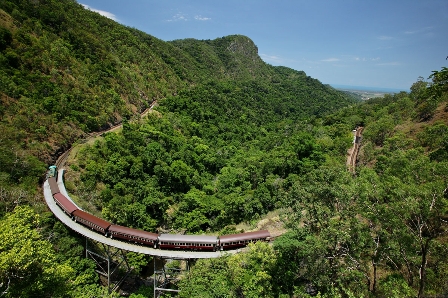 KSR passing over Stoney Creek en route to Kuranda from Cairns.[/caption]
Tickets combining both routes can be purchased from both companies. They work in tandem to coordinate their timetables.
In this instance, it’s the trip, not the destination that takes precedence. The railway was a masterwork of engineering when it was built. The gradient rise is impressive, as are the switchbacks, tunnels and sidings that make up the relatively short journey. The railway was built to provide a link to the Tableland’s mineral riches and the ports of Cairns and Port Douglas. All that Herberton tin had to be shipped somewhere to be worth something. The small museum at Freshwater station a few kilometres outside Cairns’ town centre (the preferred departure point from Cairns though the train actually begins its daily journeys from the main railway station in town) is well worth a visit to understand how much effort, at considerable cost to human life, was involved in constructing the railway.
[caption id="attachment_1551" align="alignnone" width="448"]
KSR passing over Stoney Creek en route to Kuranda from Cairns.[/caption]
Tickets combining both routes can be purchased from both companies. They work in tandem to coordinate their timetables.
In this instance, it’s the trip, not the destination that takes precedence. The railway was a masterwork of engineering when it was built. The gradient rise is impressive, as are the switchbacks, tunnels and sidings that make up the relatively short journey. The railway was built to provide a link to the Tableland’s mineral riches and the ports of Cairns and Port Douglas. All that Herberton tin had to be shipped somewhere to be worth something. The small museum at Freshwater station a few kilometres outside Cairns’ town centre (the preferred departure point from Cairns though the train actually begins its daily journeys from the main railway station in town) is well worth a visit to understand how much effort, at considerable cost to human life, was involved in constructing the railway.
[caption id="attachment_1551" align="alignnone" width="448"] KSR stopped at Barron Falls outside Kuranda.[/caption]
The Skyrail on the other hand is all about its environmental angle. Two ‘eco-stations’ have been built at strategic points along its 7.5 kilometres route. Do not miss these stops as they are essential to gaining a better understanding of the marvels of the Wet Tropics rainforest ecology. Each station has a visitor’s information centre with great thought and care put into creating interactive displays, particularly with a child’s view in mind. The cable car trip should take about two hours, much faster if the eco-stations are skipped but that would be missing the main objective of the ride wouldn’t it?
Both the railway and the cable car are leisurely trips, best appreciated slowly. As the train engine tugs its line of antique carriages inexorably up the escarpment, an excellent vista of coastal mangrove swamps, forested mountains, sugar cane fields and Coral Sea becomes more enriching the higher up you go. Spectacular waterfalls cascade right next to the track, particularly during the Wet Season from December until April.
[caption id="attachment_1608" align="alignnone" width="336"]
KSR stopped at Barron Falls outside Kuranda.[/caption]
The Skyrail on the other hand is all about its environmental angle. Two ‘eco-stations’ have been built at strategic points along its 7.5 kilometres route. Do not miss these stops as they are essential to gaining a better understanding of the marvels of the Wet Tropics rainforest ecology. Each station has a visitor’s information centre with great thought and care put into creating interactive displays, particularly with a child’s view in mind. The cable car trip should take about two hours, much faster if the eco-stations are skipped but that would be missing the main objective of the ride wouldn’t it?
Both the railway and the cable car are leisurely trips, best appreciated slowly. As the train engine tugs its line of antique carriages inexorably up the escarpment, an excellent vista of coastal mangrove swamps, forested mountains, sugar cane fields and Coral Sea becomes more enriching the higher up you go. Spectacular waterfalls cascade right next to the track, particularly during the Wet Season from December until April.
[caption id="attachment_1608" align="alignnone" width="336"] Barron Falls lookout from KSR stop near Kuranda.[/caption]
The tiny skyrail cable cars skim the treetops while descending from Kuranda. You’re not merely watching the rainforest slide by as much as actually becoming part of it. There was controversy concerning potential damage to trees when the cable car towers were installed but due care was taken and tree loss was minimal. Now the opportunity to appreciate the hidden wonders of the forest canopy is available to many more environmentally minded travellers, a fact that goes some way to mitigate previous concerns.
I like the fact that I spent a whole day travelling between Kuranda and Cairns, less than 20 kilometres as the crow flies. The close contact helped me to understand how the great escarpment acts as a sort of green wall between the coastal lowlands and the Atherton Tablelands, a metaphorical wall, one with many doorways to the hidden world of FNQ, all easily opened with a gentle slow push.
Tom Neal Tacker was a guest of Tourism QLD.
Naked Facts:
For the best car hire deals and service see:
www.vroomvroomvroom.com.au
Paronella Park offers campsites and accommodation in small, air-conditioned cabins. The cabins are simple yet comfortable but without en suite bathrooms. Luckily the amenities block is a few metres away.
For more information see: www.paronellapark.com.au
Mamu Rainforest Canopy Walk is owned and co-managed by the Ma:Mu Aboriginal people and the Queensland Government’s Department of National Parks.
See www.nprsr.qld.gov.au/parks/mamu for more information.
For information about Herberton Historic Village including special events,
See: www.herbertonhistoricvillage.com.au
For bookings and special deals at Allawah Retreat outside Tolga off the main Kennedy Highway between Atherton and Mareeba,
See: www.allawah-retreat.com.au
Skybury Coffee is just outside Mareeba.
See www.skybury.com.au for restaurant bookings and tours.
In Mareeba, don’t miss Coffee Works for its range of coffee, teas and chocolates.
See www.coffeeworks.com.au for more information.
de Bruey’s Winery is a small gem. Don’t miss it. Arrange a tasting of their large range of weird and wonderful fruit wines before visiting.
See www.debrueys.com.au
Kuranda Scenic Railway operates return trips between Cairns and Kuranda twice daily.
See www.ksr.com.au for reservations and information.
The Skyrail Rainforest Cableway operates daily with frequent departures from its station 15 minutes from Cairns in the suburb Caravonica or from Kuranda’s town centre next to the railway station.
See www.skyrail.com.au
If stopping a night in Kuranda, the moderately priced, well maintained and exceptionally friendly B & B Miju Rainforest Retreat is highly recommended. See www.mijurainforestretreat.com for details and reservations.
Barron Falls lookout from KSR stop near Kuranda.[/caption]
The tiny skyrail cable cars skim the treetops while descending from Kuranda. You’re not merely watching the rainforest slide by as much as actually becoming part of it. There was controversy concerning potential damage to trees when the cable car towers were installed but due care was taken and tree loss was minimal. Now the opportunity to appreciate the hidden wonders of the forest canopy is available to many more environmentally minded travellers, a fact that goes some way to mitigate previous concerns.
I like the fact that I spent a whole day travelling between Kuranda and Cairns, less than 20 kilometres as the crow flies. The close contact helped me to understand how the great escarpment acts as a sort of green wall between the coastal lowlands and the Atherton Tablelands, a metaphorical wall, one with many doorways to the hidden world of FNQ, all easily opened with a gentle slow push.
Tom Neal Tacker was a guest of Tourism QLD.
Naked Facts:
For the best car hire deals and service see:
www.vroomvroomvroom.com.au
Paronella Park offers campsites and accommodation in small, air-conditioned cabins. The cabins are simple yet comfortable but without en suite bathrooms. Luckily the amenities block is a few metres away.
For more information see: www.paronellapark.com.au
Mamu Rainforest Canopy Walk is owned and co-managed by the Ma:Mu Aboriginal people and the Queensland Government’s Department of National Parks.
See www.nprsr.qld.gov.au/parks/mamu for more information.
For information about Herberton Historic Village including special events,
See: www.herbertonhistoricvillage.com.au
For bookings and special deals at Allawah Retreat outside Tolga off the main Kennedy Highway between Atherton and Mareeba,
See: www.allawah-retreat.com.au
Skybury Coffee is just outside Mareeba.
See www.skybury.com.au for restaurant bookings and tours.
In Mareeba, don’t miss Coffee Works for its range of coffee, teas and chocolates.
See www.coffeeworks.com.au for more information.
de Bruey’s Winery is a small gem. Don’t miss it. Arrange a tasting of their large range of weird and wonderful fruit wines before visiting.
See www.debrueys.com.au
Kuranda Scenic Railway operates return trips between Cairns and Kuranda twice daily.
See www.ksr.com.au for reservations and information.
The Skyrail Rainforest Cableway operates daily with frequent departures from its station 15 minutes from Cairns in the suburb Caravonica or from Kuranda’s town centre next to the railway station.
See www.skyrail.com.au
If stopping a night in Kuranda, the moderately priced, well maintained and exceptionally friendly B & B Miju Rainforest Retreat is highly recommended. See www.mijurainforestretreat.com for details and reservations. https://nakedhungrytraveller.com.au/do-you-tango-in-buenos-aires/ Do You Tango in Buenos Aires?
https://nakedhungrytraveller.com.au/do-you-tango-in-buenos-aires/ Do You Tango in Buenos Aires?There’s been enough written about how integrated the tango is into Buenos Aires culture that it’s become an unavoidable travel cliché. Quite simply, when in Buenos Aires, tango’s rhythm is heard all round in constant replay. So you may as well accept the fact and see a tango show at its best.
Two venues impressed me: Madero Tango at Puerto Madera offers a dinner package that is dazzling in its athleticism, tango prowess and sheer glitter factor. This show wouldn’t be out of place at Caesar’s Palace in Las Vegas. The other is Rojo Tango at the very swish Faena Hotel located in BA’s trendiest waterfront redevelopment named simply, the Faena District. The Rojo Tango show was smaller, more intimate and oozed authenticity. I loved both shows so much that I booked my partner and I into a tango lesson at Madero Tango star Mora Godoy’s studio in central BA. We had an hour’s lesson, enough to convince me that I really should have started dancing the tango at age six. I felt so un-suave and un-coordinated that I marvelled anew at the incredible grace and physical perfection of professional dancers. Of course if splashy tango is too much, you can always take in a coffee at one of the many cafes that line the La Boca waterfront and see a miniature tango show performed randomly. Usually it's a young couple in from the provinces trying to make a few extra pesos. Their dancing isn't truly professional but charming nonetheless for its authenticity and joie de vie. Apart from tango, upwardly mobile Portenos are enormously fond of eating lots of meat. Smoking like chimneys is also common; non-smoking sections in restaurants are still works-in-progress. Their favourite weekend pastime appears to be browsing at local markets or during summer, escaping to Uruguay’s Punta del Este’s trendy beaches or a country estado up the Parana River. Less cashed up Portenos stuck at home during the torrid summer months go on strike with alarming regularity so don’t be surprised if taxis suddenly disappear, metro trains stop running, baggage handlers walk off the job leaving mountains of luggage at all airports and the whole country seems to stop. A landmark restaurant for feasting in old BA style is La Cabana restaurant, also in central BA. It’s a famous place; everyone knows it. I went so far as to take a barbecue class before dinner. I cooked nearly every bit of flesh it’s possible to slice from: a pig, a cow and a sheep. In Argentina most barbecue restaurants specialise in asado, more a social occasion than a simple dinner out. Be prepared to see enough flesh on a plate to feed a small army of carnivores. The specialised grill, known as the parrilla, used by keen Argentinian barbecue chefs is obligatory equipment. Sadly it’s not easily exported home, far too heavy. Fortunately, the cookbook given to me at the finish of my lesson still reminds me of the importance that meat has in both the country’s economic and social histories. I use the cookbook for inspiration when I’m listening to an Astor Piazzolla CD I bought at the Plaza Dorrego San Telmo flea market. How best to replicate the taste of Buenos Aires in my home kitchen remains a challenge. So far, I’ve not had much success getting the right amount of smokiness into my chops though my hips have begun moving like Carlos Gardel’s. Argentinian wines have rightly gained global prominence. Famed for its Malbec and Cabernet Sauvignon, these red wines of good quality are normally sold at prices ranging between USD$7 and USD$17 per bottle and are ubiquitous on restaurant lists and retail shops alike. Wines priced above USD$20 per bottle will typically result in a very memorable vinous experience. Torrontes, a white variety akin to Chenin Blanc or Verdelho in flavour is also commonly available; it has grown into the Argentinian white grape of choice. Of course wines sold in top restaurants will cost a bit more but quality of the glassware will at least be better. Argentina’s top selling beer is Quilmes. It’s on tap at most cantinas and is a refreshing brew, particularly after a hot summer’s day spent wandering through the markets. Like their Spanish cousins, Portenos dine late, normally after 9pm. After dinner the bars and clubs don’t begin throbbing until 2am. Tango sounds best late at night when love or pain is in the air. BA is packed with hotels of the usual sort offered by such a huge metropolis, ranging from bargain basements (literally) to luxurious grand establishments. I stayed very happily at the boutique Park Hyatt-Palacio Duhau just a few steps away from the famous Alvear Palace. The Park Hyatt won me over with its generous and completely sound-proofed rooms, gigantic bathrooms and friendly helpful staff. We dined exceptionally well at its formal restaurant, one of the few in BA that offers a non-smoking section. A superb local wine list added pizzazz. The cheese room next door to the restaurant revealed a growing industry in the production of artisan cheeses. Nearby is a Buenos Aires’ sacred site, La Recoleta Cemetery. Follow the crowds to Eva Peron’s grave. Many graves feature sculptures created by some of Argentina’s most illustrious sculptors, comprising one of the city’s most interesting outdoor art galleries. Most of Argentina’s past presidents and military figures are interred here. As are numerous famous poets, writers and artists. I also liked the Palermo Soho All Suites Hotel in the sophisticated Soho Palermo neighbourhood. Finding a restaurant, café or boutique in this part of town is as easy as falling out the door of the hotel. Our two-bedroom apartment had a workable kitchen, two bathrooms and a balcony overlooking the passing parade below. I could have lived there. Buenos Aires is a veritable shopper’s paradise. The devalued peso has made life tougher (yet again) for Argentinians but for travellers in pursuit of good value, this was a dream come true. European fashion labels are prevalent, leather goods are incredibly good value and yes the bargains on offer are numerous. Naked Facts: A few tips: Be wary of counterfeit currency. It’s rife. I used a global bank’s ATM and was surprised to discover counterfeit notes amongst the withdrawn amount. Be careful of pickpockets, particularly at tourist markets. Taxis regularly go on strike. Public transport is crowded but extensive and easy to use. Few people speak English. Spanish is the lingua franca. Vegetarians may find an extended stay challenging. Argentina charges a USD$100 ‘reciprocity’ fee for entry into the country via its international airports and ferry terminals in BA. The fee is valid for one year and covers multiple entries. As of October 2012, the fee may be paid online before departure. For reservations and enquiries, The Park-Hyatt Palacio Duhau can be contacted at: buenosaires.park@hyatt.com Palermo Soho All Suites Hotel can be found at: www.sohoallsuites.com https://nakedhungrytraveller.com.au/troppo-in-fnq/ Troppo in FNQ
https://nakedhungrytraveller.com.au/troppo-in-fnq/ Troppo in FNQTropical far north Queensland’s biggest little town, Port Douglas boasts the World Heritage Wet Tropics and Great Barrier Reef at its doorstep. What’s not to like? From November through April, the rain may fall but the fun doesn't stop.
Flying through air with the greatest of ease… but it’s no trapeze and this isn’t the Cirque du Soleil. Instead I’m zip-lining, one of the latest in the list of death-defying adventure travel romps designed to scare the bejesus out of most sane world wanderers. I’ve zip-lined in Hawaii, Fiji and southern Victoria. Now I’m in far northern Queensland, high up in the rainforest canopy, yelling my lungs out while speeding over deep ravines. A hard rain is pelting down; it’s warm and slightly sticky. Or is it me? I’ve been sweating buckets trudging up the steep track to the first zip point. Then it’s up a ladder attached to a black bean gum tree towering over forty metres. One of the guides mentioned that snakes like to sun themselves on the track, though in this rain I think a stretch of the imagination is at play. My hands are clammy. Did that fallen branch on the track just move? Within screaming distance is Cape Tribulation, the extreme end of the Wet Tropics World Heritage Area and the location for take-off on the Jungle Surfing Canopy Tours. I’m strapped into a safety harness that looks like an abseiling rig, hung from a steel cable and propelled from one tall tree to another, making loud Tarzan-like whoops while flying through the air swinging from tree to tree. It’s late on a Saturday morning and I’m thinking, I could be home at a familiar café sipping a latte. Balderdash! This is much more fun. Jungle surfing is about getting very close to the rainforest itself. It’s also an adrenalin rush of rare quality, something I relish despite the fact I’ve screamed like a little girl in a fake horror house on a Halloween’s midnight. The jungle surfing tour takes roughly two hours. I’m never alone, as I wouldn’t be due to safety concerns and public liability insurance issues. This is rain forest, home of cassowaries, crocodiles and large pythons and venomous snakes. Yep, it’s a jungle out there. Two guides, both well versed in the local ecology, its animals, reptiles and plant life, escort the surfers from one jump-off platform to the next. One zip includes hurtling over a fast flowing creek far below in a narrow ravine, bordered on all sides by towering trees. From the highest point on the tour, one view sums it all up. Swathes of multi-hued green extend in all directions. There are no towns or people to be seen. Beneath me in the near distance is the Coral Sea and the Great Barrier Reef, clearly visible as blotches of opalescent water surrounding coral atolls, islands in the endless cerulean blue. (Not usually given to purple prose, in this instance the scene calls for it.) The Daintree rainforest, one of the oldest on the planet, is Australia’s most bio-diverse eco-system. Insects, amphibians and reptiles are still being discovered as biologists hurry to record and classify all the species in the Daintree, a laborious task seemingly without end. The rainforest’s environment is comprised of different climactic zones; it’s not all soaking wet, nor is it always cloaked in heavy clouds. The forest at sea level tends to be drier and is the favoured habitat for the endangered Southern cassowary, Australia’s largest animal. The Red kangaroo is taller, as is the Emu, but the cassowary is heaviest. Between the three, I’d prefer a close encounter with either a kangaroo or an emu. The cassowary can be aggressively territorial, particularly when the males are guarding chicks. Cassowaries can inflict serious injury, the talon on its middle toe is dagger sharp and its kick can be fierce. Unfortunately, cassowary numbers have declined in recent decades due to human encroachment into their breeding areas, death due to traffic accidents and worst of all, predation from introduced animals such as feral dogs and pigs. Sadly, without the cassowary’s ability to distribute seeds through its digestive tract, the rainforest itself is in peril. The cassowary is considered a keystone species, essential to the rainforest’s capacity to regenerate itself. Without them, many of the rain forest’s trees cannot reproduce therefore the forest itself is threatened through loss of bio-diversity. Southern cassowaries are protected by law. If you’re lucky enough to see one in the wild, leave it alone to live in peace. The rainforest breathes life, literally. So many creatures live here, I’d like to spend weeks exploring the forest’s animals and plants but I’m no biologist. Instead I choose the layman’s option and visit a zoo. To be precise, I visit a zoo that isn’t actually a zoo. It’s more like a huge open park that operates as an information centre about wildlife and botany. Covering over twenty hectares of reclaimed wasteland, previously logged and denuded of all trees and undergrowth, the Hartley’s Crocodile Adventures park was re-planted to native species. The stars at Hartley are crocodiles, big ones and bigger ones, some weighing up to 750 kilograms. Commonly called ‘Salties’, Estuarine Crocodiles can be found in all the Daintree’s many rivers, swimming in them is ill-advised. Locals say it’s not the crocodile you see that gets you. These crocs are called ‘salties’ because they’ve adapted to living in saltwater. Large males have been spotted far out to sea cruising along the Great Barrier Reef making return trips to Papua New Guinea in search of new territory. While I’ve yet to encounter a migrating crocodile when diving along the Great Barrier Reef, I do get up close and personal with less daunting species of underwater life. Several experienced tour companies operate out of Port Douglas’ main wharf, running daily trips to the outer barrier reef or the nearby coral encrusted Low Isles. The Low Isles are approximately thirty minutes by boat from the wharf, the outer reef itself anywhere from one to two hours depending on the boat’s engine and size. Certified divers and snorkelling enthusiasts alike are catered for, with a few boat owners offering both onboard SCUBA facilities as well as masks, snorkels and fins for those interested in paddling on the surface instead of plumbing the depths. I spend a day on the reef with a small family owned local operator, Calypso Snorkel & Dive, doing three dives in the one day. Of sixty passengers on board, ten are certified divers. There is no crowding while divers and snorkellers go about exploring three different dive sites around Osprey Reef at their leisure. A dive anywhere on the Great Barrier Reef never ceases to thrill. Over the years, I’ve dived the reef from its southern extremity at Lady Elliot Island to its northern reaches off Lizard Island, never once failing to see something I hadn’t before, always feeling privileged to enter a magical world known to few. This day, along with requisite reef sharks, Maori wrasse, schools of blue grenadier, clown fish and countless other species of fish, molluscs and crustaceans, I spy a trio of harlequin patterned shrimp tucked into a coral cleft 22 metres deep. Waving their antennae at me like a welcome sign, each shrimp stroked my fingers with delicate feelers while shuffling back and forth in its reclusive private world. I feel welcomed, like I’ve shaken hands with tiny neighbours, which is a lot less risky than shaking claws with a large crocodile. Back in Port Douglas town, it’s time to kick back and let the adrenalin rushes wash over me. I’ve been zipping in rain, sloshing in mud and diving with denizens of the deep. Now I feel the need for snazzy food and revivifying drink. Where to go? I head for the town’s weekend markets in search of a man that sells rare delicacies. Tied with simple twine into a small bundle, looking very much like a bunch of moist black sticks, I lift the sticky sweet mass up to my nose and inhale deeply. Intoxicatingly perfumed, fecund and sensuous, it’s pure vanilla. Being a keen cook, I’m excited as a kid in a candy store. Real vanilla is a chef’s treat, akin to fresh truffles or authentic saffron. I’ve been wandering around the Port Douglas open air market looking for the ‘Vanilla Man’, as he’s known locally. Russell Stanton, former stonemason, hippy surfer and globe trotter set down roots nearly a decade ago on a lush rain-forested property on Port Douglas’s outskirts and decided to grow vanilla. He runs a stand in Port Douglas’ busy public market selling his vanilla beans and essence. I ask him why he chose to produce vanilla. He explains, ‘It’s a long term investment and I wanted to do something different. I worked as a stonemason, helping to build Keith Williams’ hotels on Hamilton Island and creating mosaics for Doris Duke’s Hawaiian estate and I’d had enough hard yakka. It’s not easy being a stonemason. Growing vanilla is easier.’ Well, it’s sort of easier. Imagine waiting three years for the vanilla beans to cure before ready to package and sell. Vanilla seed pods need careful management after they’re hand-picked. The seed pods of an orchid flower, vanilla is delicate and difficult to cultivate successfully. Its natural home is the wet tropics. The region around Port Douglas and the Daintree forest of tropical north Queensland is a wet tropics habitat, prime vanilla producing territory. With my AUD$10 bundle of six vanilla pods and a small AUD$20 bottle of Stanton’s pure vanilla essence in hand, I gloat inwardly (Crème brulee? Vanilla custard?), while continuing my exploration of the busy market. Storm clouds have gathered and a heavy but short deluge descends, soaking everyone, customers and stallholders alike. Thirty minutes later, the sun re-appears, clothes drying while the shopping continues. Feeling the heat, I stop for a freshly squeezed glass of sugar cane juice with added lime to cut the sweetness. It costs a single Aussie dollar. Later I buy three bars of handmade soap for AUD$12 from an Aboriginal man who discusses the local bush plants he uses in making his soaps like a pharmacist giving advice about what to do with an itchy skin condition. Native lemon myrtle, wild honey and finger limes dominate the soap blends. Shopping mission accomplished, I continue wandering up and down Port Douglas’ main drag, Macrossan Street. Saturday morning has passed languidly to mid-afternoon. Cocktail bar staff members are reporting for duty, floors are being swept and cleaned. Chairs and tables are set in preparation for the first sundowner of the evening. Meanwhile the cafes are packed; customers are sipping iced coffees, picking over cake crumbs left on nearly empty plates. I’m seeking inspiration. Where to have dinner? The Salsa Bar & Grill or the Nautilus? Salsa is tonight’s choice. I checked the cocktail menu posted in the restaurant’s doorway, deciding that mango, lime and rum would be a fitting start to a night on the town. Port Douglas has become one of Queensland’s pre-eminent holiday villages. Little ‘Port’, as it’s called locally is a combination of tropical enclave, resort town and a la mode destination for the smart set. Cashed up southerners have bought lavish boltholes here to escape the worst of winter, returning each season like migrating birds to relax in this sophisticated outpost. Fortunately, it’s not all excess cash and glamour. The town is bordered on one side by nearby mountains covered with impenetrable rain forest, sugar cane and mango plantations, the other by beautiful Coral Sea. Not every local is rich or famous, thank goodness, which keeps the place in a state of continual reality check. Designer duds mix in well with a working man’s singlets and stubby shorts. Thongs come in all sizes and price tags in Port Douglas and remain the universal footwear of choice. Apparently, no one is allowed airs or graces; the person standing next to you in the local pub may be worth ten million or ten cents, appearances often lead to incorrect assumptions. The cliché, laid-back and relaxed, is the rule of thumb in ‘Port’. If laid-back and relaxed conversely means a distinct lack of activity, the reef and rain forest are at your doorstep. Port Douglas prides itself as being the place where the Great Barrier Reef and the Daintree Rain Forest come together in blue green harmony. Naked Facts: For the best car hire deals and service see: www.vroomvroomvroom.com.au Naked Dining: Port Douglas offers a wide range of dining options from cheap and cheerful take-away joints to sophisticated restaurants that would appeal to the well-travelled gourmet. My top pick is The Nautilus Restaurant. With new chef Dave Perry in charge, the food at The Nautilus has improved almost beyond imagination. I relished a seven course degustation with matching wines for AUD$220 which rivalled any superior dinner I’ve eaten anywhere else in the state. Top marks to the talented kitchen team for getting the combination of clever food and wine combinations right in a tropical climate where appetites are tempered by extreme heat and humidity. Nautilus Restaurant 17 Murphy Street Port Douglas, QLD 4877 Phone: +61 (0)7 4099 5330 Web: www.nautilus-restaurant.com.au Also very good with smart, knowledgeable service, an extensive wine list, killer cocktails and decent food is the Salsa Bar & Grill. Salsa Bar & Grill 28 Wharf Street Port Douglas, QLD 4877 Phone: +61 (0)7 4099 4922 Web: www.salsaportdouglas.com.au Highly recommended are: The French inspired Harrison's Restaurant led by head chef Spencer Patrick, is one of Port's best. www.harrisonsrestaurant.com.au. Both Bel Cibo (www.belcibo.com.au) and Bucci (www.bucci-ristorante.com) do Italian food with tropical flair. Sassi Cantina offers value for money pizzas, spuntini, home made pasta and simple Italian food. See www.sassi.com.au. Bistro 3 does contemporary Australian food with an emphasis on local produce and seafood. See www.bistro3.com In the Daintree rain forest don’t miss Whet café, bar, restaurant and cinema, serving surprisingly good food in a location that demands know-how and real skill in order to succeed, which they do admirably. Whet Lot 1, Cape Tribulation Road Cape Tribulation, QLD 4873 Phone: +61 (0)7 4098 0007 Email: whetcapetrib@gmail.com Naked Accommodation: In Port Douglas, the family owned small hotel, the Port Douglas Peninsula Boutique Hotel is deluxe, friendly and sophisticated. Breakfasts are served a la carte by the poolside. A small cocktail bar and restaurant facing The Esplanade and Four Mile Beach is a great alternative when venturing into Port Douglas’ frantic restaurant scene becomes too much. Good food and better cocktails. The Peninsula Boutique Hotel occupies a prime location, at the end of Macrossan Street on the corner of The Esplanade, facing Port Douglas’ famous Four Mile Beach. It’s within walking distance of the town’s most popular attractions including the public wharf for all trips to the reef, restaurants, the market and the town’s bar and café scene. A winner. Port Douglas Peninsula Boutique Hotel 9-13 The Esplanade Port Douglas, QLD 4877 Free call1800 676 674 (within Australia) Phone: +61 (0)7 4099 9100 Email: res@peninsulahotel.com.au Web: www.peninsulahotel.com.au Accommodation options in the Daintree rain forest are sparse. I checked out a couple of small resorts that cater to campers and backpackers but found them mostly unimpressive, downtrodden and very rustic. There are only two superior choices, the Heritage Lodge & Spa is a four-star resort lodge while the well appointed though basic Crocodylus Village caters to travellers mindful of bottom line costs. Heritage Lodge & Spa is located right in the Daintree rainforest. The clear running and crocodile free Cooper Creek runs alongside the resort, a perfect place to cool off after a day spent exploring the wonders of the local environment. All rooms have en suite facilities and are air-conditioned. Meals served in the small resort’s restaurant, ‘On the Turps’ are well prepared and tasty. Lot 236 Turpentine Road DIWAN Daintree Rainforest, QLD 4873 Phone: +61 (0)7 4098 9321 Email: reservations@heritagelodge.net.au Web: www.heritagelodge.net.au Budget conscious travellers will find satisfaction at Crocodylus Village, set in a prime location adjacent to Cow Bay and its stunning beaches. A variety of accommodation options are available from self-contained to shared facilities. A licensed bar and restaurant, tours and eco-friendly activities add to the simple yet well-run package. Lot 5, Buchanan Creek Road Cow Bay, QLD 4873 Phone: +61 (0)7 4098 9166 Web: www.crocodyluscapetrib.com Naked Touring: Note: Port Douglas and the Daintree experiences two seasons, wet and hot or dry and hot. During the ‘Green Season’, December until April, heavy tropical rain may fall every day and cyclonic storms may occur. From late April, the prevailing monsoon winds begin to shift northwards, leaving cooler and drier air in its wake. May through November is peak touring season in Port Douglas and the Daintree. The weather is normally drier and days are marginally cooler. Hotels and restaurants are full, reservations are strongly advised. During the heaviest rains, trips to the outer Great Barrier Reef may be cancelled with little notice. Roads into the Daintree rain forest and to Cape Tribulation may close due to flooding. Port Douglas’ produce and craft market is open every Saturday from 9am. Location: Wharf Street at the end of Macrossan Street in the town’s main public park. Vanilla Australia isn’t open for business on a daily basis, however if Russell Spanton isn’t operating his stall at the Port Douglas market, arrangements can be made to visit the plantation itself. Contact: Organic Vanilla Beans & Essence Russell and Mary Spanton Captain Cook Highway Phone: +61 (0)7 4099 3380 Email: vanillaaustralia@bigpond.com Getting up close and personal with a crocodile or cassowary or a big python is easy when visiting Hartley’s Crocodile Adventures. Learn what makes the rain forest tick. Hartley’s Crocodile Adventures Captain Cook Highway at Hartley’s Creek (20 minutes drive from Port Douglas) Open 7 days from 9am until 6pm Phone +61 (0)7 4055 3576 Web: www.crocodileadventures.com Calypso trips to the Great Barrier Reef should be reserved in advance and operate most days weather permitting. SCUBA divers should carry their PADI cards when diving anywhere in Australia. Contact: Tropical Journeys Personalised Reef and Rainforest Tours Eleanor Jones Phone +61 (0)7 4099 6999 Web: www.tropicaljourneys.com In the Daintree, Jungle Surfing Canopy Tours should be reserved in advance. Tours run daily, weather permitting, and include transfers from all Daintree accommodation or arrange to meet at Mason’s Cape Trib Store and Café in Cape Tribulation Road for a free transfer to the Jungle Surfing headquarters, approximately ten minutes drive. Phone: +61 (0)7 4098 0043 Email: info@junglesurfing.com Web: www.junglesurfing.com.au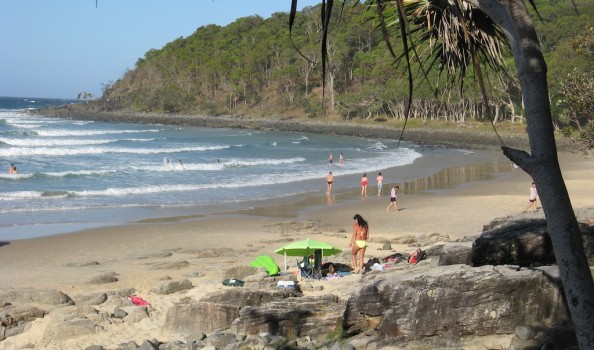 https://nakedhungrytraveller.com.au/noshing-round-noosa/ Noshing Round Noosa
https://nakedhungrytraveller.com.au/noshing-round-noosa/ Noshing Round NoosaNoosa is as well known for its foodie delights as it is for its surf breaks, gentle climate and pizzazz.
Jam Guru Jamie Milverton stirs an enormous stockpot full of gently simmering tomato chutney while explaining that his mother taught him much of what he knows about jam. ‘She wins a lot of gold at the Rockie show for her jams. I grew up learning from her.’ Not something usually uttered by a Queensland bloke who looks like he’d be happy mustering cattle as he is creating jams and chutneys. Over many years, his mother has won numerous gold medals for country culinary expertise at the rural Rockhampton agricultural show. Jamie is a regular guest chef at FreeStyle Escape, a beautifully sited property perched high up in the Blackall Ranges overlooking the Noosa hinterland that offers accommodation and cooking classes. [caption id="attachment_1565" align="alignnone" width="336"]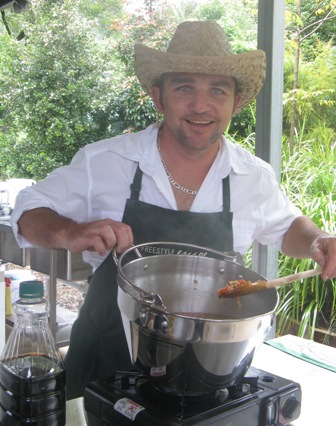 Jamie Milverton making jam at FreeStyle Escape outside Noosa.[/caption]
Two tastefully decorated, fully equipped holiday houses serve as top-end accommodation while the open air kitchen built to take advantage of the marvellous views operates as both an al fresco dining room and classroom. If there’s a better place in which to learn how to make tomato chutney using local ingredients, I’ve yet to find it.
This part of Queensland is recognised widely for its agricultural richness. Far enough away from the salt spray of the coast yet close enough to kilometres of golden sand and warm water, (a half hour’s drive downhill from FreeStyle Escape will get you to any number of the Sunshine Coast’s famous surf breaks), the Blackall Ranges’ rich soil, sub-tropical climate and reliable rainfall guarantees agricultural plenty.
Plant a bare stick in this ground and watch it grow, seemingly overnight, into a tree. If the gardening world’s rich tapestry has an Eden pocket, this may well be it.
I’m part of a small group of roving food fanatics brought here to see what’s beyond the restaurant hype constantly touted by Noosa’s tourism authorities. Over the years, I’ve had my share of sadly overpriced and below average food in too many restaurants in this cashed-up beachside village. If Australia has a St. Tropez, this is supposed to be it.
Sometimes Noosa’s tourism advertising bravado goes well beyond its stated brief. Extolling the realities of dining in this town, which is essentially an easy task; there are reasons why the food scene here is above average compared to other rural destinations scattered around the wide brown land, should be something of a no-brainer.
As in any exclusive resort town, some restaurateurs and chefs have been overly dependent on advertising hyperbole rather than actually having to deliver authentic goods. The result is meals priced above mean average Sydney or Melbourne equivalents without the commensurate quality. As hungry tourists continue to visit in increasing numbers, a pervasive attitude of lassez-faire to pricing and value has sadly taken root and flourished. Caveat emptor rules here just like anywhere else.
But Noosa does continue to promote itself as a foodie destination. The annual Noosa Food & Wine Festival held in May (see www.noosafoodandwine.com.au) has grown into one of the region’s major tourism events, rivalling the surfing carnival and jazz festival.
This festival strikes me as one of mass appeal rather than special interest. The food media brought in to participate and report on the festival represents a predictable collection of minor telly stars and big city newspaper restaurant critics. A few of the media hacks have been around for so long that an element of safe predictability impairs the festival programme’s capacity to surprise or illuminate.
Estimated attendance for the weekend’s festival was approximately 25,000. According to principle festival organiser and sponsorship manager, Jim Berardo, it has reached its relative maximum number of attendees. Successful by anyone’s measure, the logical next question is, where to from here?
How about another food event, the Sunshine Coast Real Food Festival? This is a ‘weekend of celebration of authentic food experiences’, I read from the festival’s brochure. Having met one of its organisers, Julie Shelton, I gather that this festival is differentiating itself from the much larger Noosa Food & Wine Festival while it promotes the values of slow food, local providores (locavoring is the buzz word as it is throughout the known gourmet world), eating sensibly from organically raised crops and the clear benefits in reducing carbon emissions while sourcing food.
Either festival will deliver the goods to anyone with more than a passing interest in quality produce, authoritative cooking tips and gustatory hoopla. Putting my carping aside in favour of objective fairness, Noosa’s dining scene is one of Australia’s most consistently interesting.
I chat with FreeStyle Escape co-owner Martin Duncan, a tree-change escapee from the hard life of running a Sydney restaurant. Easy going and generous in his praise of other local chefs, Martin is clearly in love with his surrounds. (See his blog: http://freestyle-freestyler.blogspot.com/ for fun on-the-spot updates.) He and his partner spent years redeveloping their bush property. From an abandoned noxious weed-infested paddock, they have turned it into a garden of wonders. Most of the herbs and fruits we use to prepare our lunch after Jamie’s chutney making class come from the garden. The basil leaves scattered on the wood fired pizzas we rolled out earlier still have dew on them. It really doesn’t get any fresher than this.
[caption id="attachment_1557" align="alignnone" width="336"]
Jamie Milverton making jam at FreeStyle Escape outside Noosa.[/caption]
Two tastefully decorated, fully equipped holiday houses serve as top-end accommodation while the open air kitchen built to take advantage of the marvellous views operates as both an al fresco dining room and classroom. If there’s a better place in which to learn how to make tomato chutney using local ingredients, I’ve yet to find it.
This part of Queensland is recognised widely for its agricultural richness. Far enough away from the salt spray of the coast yet close enough to kilometres of golden sand and warm water, (a half hour’s drive downhill from FreeStyle Escape will get you to any number of the Sunshine Coast’s famous surf breaks), the Blackall Ranges’ rich soil, sub-tropical climate and reliable rainfall guarantees agricultural plenty.
Plant a bare stick in this ground and watch it grow, seemingly overnight, into a tree. If the gardening world’s rich tapestry has an Eden pocket, this may well be it.
I’m part of a small group of roving food fanatics brought here to see what’s beyond the restaurant hype constantly touted by Noosa’s tourism authorities. Over the years, I’ve had my share of sadly overpriced and below average food in too many restaurants in this cashed-up beachside village. If Australia has a St. Tropez, this is supposed to be it.
Sometimes Noosa’s tourism advertising bravado goes well beyond its stated brief. Extolling the realities of dining in this town, which is essentially an easy task; there are reasons why the food scene here is above average compared to other rural destinations scattered around the wide brown land, should be something of a no-brainer.
As in any exclusive resort town, some restaurateurs and chefs have been overly dependent on advertising hyperbole rather than actually having to deliver authentic goods. The result is meals priced above mean average Sydney or Melbourne equivalents without the commensurate quality. As hungry tourists continue to visit in increasing numbers, a pervasive attitude of lassez-faire to pricing and value has sadly taken root and flourished. Caveat emptor rules here just like anywhere else.
But Noosa does continue to promote itself as a foodie destination. The annual Noosa Food & Wine Festival held in May (see www.noosafoodandwine.com.au) has grown into one of the region’s major tourism events, rivalling the surfing carnival and jazz festival.
This festival strikes me as one of mass appeal rather than special interest. The food media brought in to participate and report on the festival represents a predictable collection of minor telly stars and big city newspaper restaurant critics. A few of the media hacks have been around for so long that an element of safe predictability impairs the festival programme’s capacity to surprise or illuminate.
Estimated attendance for the weekend’s festival was approximately 25,000. According to principle festival organiser and sponsorship manager, Jim Berardo, it has reached its relative maximum number of attendees. Successful by anyone’s measure, the logical next question is, where to from here?
How about another food event, the Sunshine Coast Real Food Festival? This is a ‘weekend of celebration of authentic food experiences’, I read from the festival’s brochure. Having met one of its organisers, Julie Shelton, I gather that this festival is differentiating itself from the much larger Noosa Food & Wine Festival while it promotes the values of slow food, local providores (locavoring is the buzz word as it is throughout the known gourmet world), eating sensibly from organically raised crops and the clear benefits in reducing carbon emissions while sourcing food.
Either festival will deliver the goods to anyone with more than a passing interest in quality produce, authoritative cooking tips and gustatory hoopla. Putting my carping aside in favour of objective fairness, Noosa’s dining scene is one of Australia’s most consistently interesting.
I chat with FreeStyle Escape co-owner Martin Duncan, a tree-change escapee from the hard life of running a Sydney restaurant. Easy going and generous in his praise of other local chefs, Martin is clearly in love with his surrounds. (See his blog: http://freestyle-freestyler.blogspot.com/ for fun on-the-spot updates.) He and his partner spent years redeveloping their bush property. From an abandoned noxious weed-infested paddock, they have turned it into a garden of wonders. Most of the herbs and fruits we use to prepare our lunch after Jamie’s chutney making class come from the garden. The basil leaves scattered on the wood fired pizzas we rolled out earlier still have dew on them. It really doesn’t get any fresher than this.
[caption id="attachment_1557" align="alignnone" width="336"]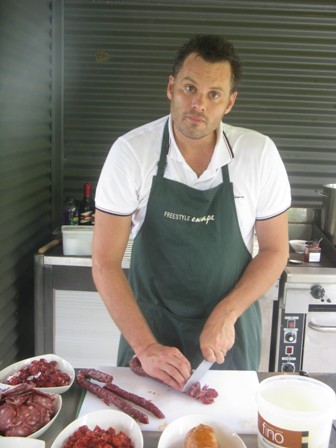 Martin Duncan at Free Style escape.[/caption]
FreeStyle Escape shows me what genuine talent combined with care for nature really means. Noosa and its hinterland are full of ersatz boutique guesthouses, gourmet restaurants and cute shops. It’s a lovely area to visit. It must be a rewarding place to live if a love of good food is a prerequisite for putting down roots and FreeStyle Escape ticks all the boxes in all the right places. There’s nothing ersatz about this foodie haven.
The environment around Noosa, particularly its bucolic hinterland, is very conducive to kicking back and revelling in the glossy good life. Choose accommodation and restaurants wisely and the rewards are obvious. Choose recklessly and pay the inflated price.
To its everlasting credit, the Noosa Farmers Market is held each Sunday, rain or shine, from 7am until 12pm. Located at 155 Weyba Road in Noosaville, it's in a very convenient location. Here is where you see local products displayed at their very best condition. The atmosphere is relaxed and fun. By all means, spend a morning here and stock up on terrific goods. Here is where residents mix with visitors in a completely casual environment.
[caption id="attachment_1561" align="alignnone" width="336"]
Martin Duncan at Free Style escape.[/caption]
FreeStyle Escape shows me what genuine talent combined with care for nature really means. Noosa and its hinterland are full of ersatz boutique guesthouses, gourmet restaurants and cute shops. It’s a lovely area to visit. It must be a rewarding place to live if a love of good food is a prerequisite for putting down roots and FreeStyle Escape ticks all the boxes in all the right places. There’s nothing ersatz about this foodie haven.
The environment around Noosa, particularly its bucolic hinterland, is very conducive to kicking back and revelling in the glossy good life. Choose accommodation and restaurants wisely and the rewards are obvious. Choose recklessly and pay the inflated price.
To its everlasting credit, the Noosa Farmers Market is held each Sunday, rain or shine, from 7am until 12pm. Located at 155 Weyba Road in Noosaville, it's in a very convenient location. Here is where you see local products displayed at their very best condition. The atmosphere is relaxed and fun. By all means, spend a morning here and stock up on terrific goods. Here is where residents mix with visitors in a completely casual environment.
[caption id="attachment_1561" align="alignnone" width="336"] Noosa Farmers Market sale.[/caption]
[caption id="attachment_1563" align="alignnone" width="336"]
Noosa Farmers Market sale.[/caption]
[caption id="attachment_1563" align="alignnone" width="336"]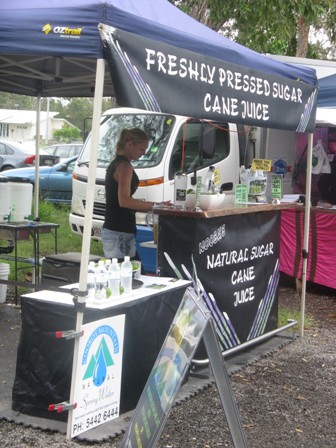 Noosa Farmers Market freshly squeezed sugar cane juice for sale.[/caption]
[caption id="attachment_1558" align="alignnone" width="336"]
Noosa Farmers Market freshly squeezed sugar cane juice for sale.[/caption]
[caption id="attachment_1558" align="alignnone" width="336"]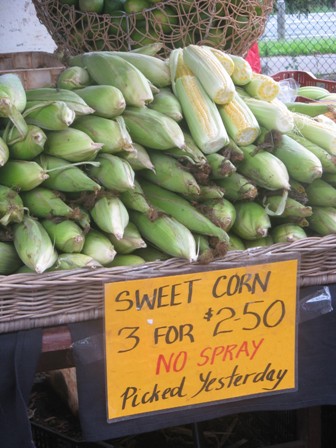 Noosa Farmers Market fresh sweet corn display.[/caption]
I get another sampling of just how good Noosa’s few hinterland gems can be at Spicer’s on the Range Clovelly Estate, a fine small hotel almost hidden away behind touristy-twee Montville.
Here at the hotel’s The Long Apron restaurant I have the finest meal I’ve eaten anywhere around Noosa, in all of southeast Queensland for that matter. Chef Cameron Matthews is as talented a chef as I’ve encountered anywhere. That he works in a hotel restaurant located more or less in the back blocks of Noosa is a wonder, a real find. I have a degustation here that puts me in mind of similar feats of gastronomic expertise that I’ve enjoyed eating Dan Hunter’s food at The Royal Mail hotel in Dunkeld, Victoria. The wine pairing component of the degustation isn’t yet up to the same standard as at The Royal Mail but the food is certainly on the same par.
At the end of a long weekend of noshing around Noosa, I’m still of two minds about how this town of gourmet reputation sells itself honestly, or not. The Noosa Food & Wine Festival does a good job of promoting the hell out of the pleasures of eating both well and wisely but in my opinion, the programme is a mixed bag of boring old fish and chips seasoned with a smidgen of spice. Metaphorically, I’ve tasted it all before and don’t need to go there again. The Sunshine Coast Real Food Festival may prove to be the extra allure I need in order to proclaim that Noosa’s purported superlative food scene achieves what it claims, something beyond the ordinary, say… beyond Master Chef.
In the meantime, I’m happy to revisit one of Jamie Milverton’s jam classes at FreeStyle Escape, pull a pizza out of the wood fired oven while chatting amiably with Martin Duncan. I’ll be sure to leave enough room for dinner at The Long Apron later that same night too. Cameron Matthews’ star is on the rise and I want to catch it for as long as I can.
Naked Facts:
See www.booking.com/Spicers-Clovelly-Estate for reservations. The Spicers Group operate a number of boutique luxury lodges around Queensland. They are highly recommended.
These three restaurants have lately caught my attention because of their combination of great food, service and good value:
Pitchfork Restaurant in Peregian. A small BYO only set in Peregian's small central square. Classy interesting food (Gazpacho with local spanner crab for instance) at moderate prices, from AUD$22 to AUD$32 for a generous main course is full of visitors and local residents alike.
5/4 Kingfisher Drive
Peregian Beach, QLD
(07) 5471 3697
www.pitchforkrestaurant.com.au
In Sunshine Beach, Embassy XO offers Tuesday, Wednesday 'locals' specials, three courses set price AUD$39.00 per person. Imaginative and inspired SE Asian food done with obvious talent. The Hervey Bay scallop dumplings on the shell are outstanding. A very smart spicy food friendly wine list shows off innate understanding of how food and wine matching can be done well.
1st floor, Cnr of Duke St and Bryan St
Sunshine Beach, QLD
(07) 5455 4460
www.embassyxo.com.au
Coconut Grove Bar and Bistro, also in Sunshine Beach does a local's special Tues-Thurs, three courses plus a glass of house wine (white or red) for AUD$32.50 represents outstanding value. Excellent service in a large airy room with a popular bar combines with food I'm happy to compare with capital city dining in Melbourne, Sydney or Brisbane. Open 7 nights too.
46 Duke St
Sunshine Beach, QLD
(07) 5449 2333
www.coconutgrovebistro.com
See www.visitnoosa.com.au for more information.
Noosa Farmers Market fresh sweet corn display.[/caption]
I get another sampling of just how good Noosa’s few hinterland gems can be at Spicer’s on the Range Clovelly Estate, a fine small hotel almost hidden away behind touristy-twee Montville.
Here at the hotel’s The Long Apron restaurant I have the finest meal I’ve eaten anywhere around Noosa, in all of southeast Queensland for that matter. Chef Cameron Matthews is as talented a chef as I’ve encountered anywhere. That he works in a hotel restaurant located more or less in the back blocks of Noosa is a wonder, a real find. I have a degustation here that puts me in mind of similar feats of gastronomic expertise that I’ve enjoyed eating Dan Hunter’s food at The Royal Mail hotel in Dunkeld, Victoria. The wine pairing component of the degustation isn’t yet up to the same standard as at The Royal Mail but the food is certainly on the same par.
At the end of a long weekend of noshing around Noosa, I’m still of two minds about how this town of gourmet reputation sells itself honestly, or not. The Noosa Food & Wine Festival does a good job of promoting the hell out of the pleasures of eating both well and wisely but in my opinion, the programme is a mixed bag of boring old fish and chips seasoned with a smidgen of spice. Metaphorically, I’ve tasted it all before and don’t need to go there again. The Sunshine Coast Real Food Festival may prove to be the extra allure I need in order to proclaim that Noosa’s purported superlative food scene achieves what it claims, something beyond the ordinary, say… beyond Master Chef.
In the meantime, I’m happy to revisit one of Jamie Milverton’s jam classes at FreeStyle Escape, pull a pizza out of the wood fired oven while chatting amiably with Martin Duncan. I’ll be sure to leave enough room for dinner at The Long Apron later that same night too. Cameron Matthews’ star is on the rise and I want to catch it for as long as I can.
Naked Facts:
See www.booking.com/Spicers-Clovelly-Estate for reservations. The Spicers Group operate a number of boutique luxury lodges around Queensland. They are highly recommended.
These three restaurants have lately caught my attention because of their combination of great food, service and good value:
Pitchfork Restaurant in Peregian. A small BYO only set in Peregian's small central square. Classy interesting food (Gazpacho with local spanner crab for instance) at moderate prices, from AUD$22 to AUD$32 for a generous main course is full of visitors and local residents alike.
5/4 Kingfisher Drive
Peregian Beach, QLD
(07) 5471 3697
www.pitchforkrestaurant.com.au
In Sunshine Beach, Embassy XO offers Tuesday, Wednesday 'locals' specials, three courses set price AUD$39.00 per person. Imaginative and inspired SE Asian food done with obvious talent. The Hervey Bay scallop dumplings on the shell are outstanding. A very smart spicy food friendly wine list shows off innate understanding of how food and wine matching can be done well.
1st floor, Cnr of Duke St and Bryan St
Sunshine Beach, QLD
(07) 5455 4460
www.embassyxo.com.au
Coconut Grove Bar and Bistro, also in Sunshine Beach does a local's special Tues-Thurs, three courses plus a glass of house wine (white or red) for AUD$32.50 represents outstanding value. Excellent service in a large airy room with a popular bar combines with food I'm happy to compare with capital city dining in Melbourne, Sydney or Brisbane. Open 7 nights too.
46 Duke St
Sunshine Beach, QLD
(07) 5449 2333
www.coconutgrovebistro.com
See www.visitnoosa.com.au for more information.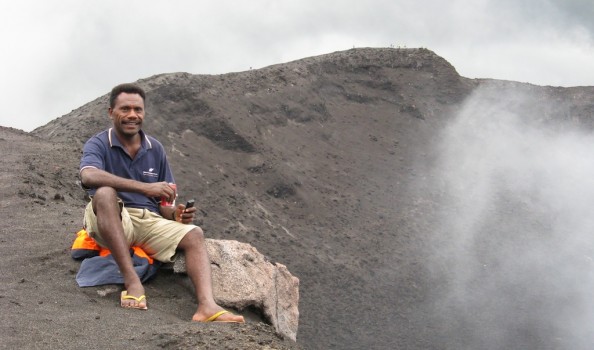 https://nakedhungrytraveller.com.au/volcanic-cults-explode-on-tanna/ Volcanic Cults Explode on Tanna
https://nakedhungrytraveller.com.au/volcanic-cults-explode-on-tanna/ Volcanic Cults Explode on TannaTravelling to Vanuatu is fairly easy these days. Cruise ships stop frequently off Port Vila for a day or half-day shopping reconnaissance, turning the tiny capital town into a mini-mall for an hour or two.
Port Vila is the country’s crossroads, though most informed travellers wisely pass through it on their way to a tropical paradisaical resort elsewhere on Efate, itself the most populous island. Smart naked travellers change planes to proceed to another island altogether, a wise choice in fact as Efate has mostly been given over to tourism. When I was whiling away the days in Port Vila mostly waiting for flight confirmations to other islands, part of the national prison burned and its fences were damaged, allowing convicts easy access to retail therapy. Much to my surprise, no impromptu riots or armed police wielding batons on convicts’ heads were in sight. It was all very relaxed. Several cruise ships were also in port for the day. Lanyard wearing name-tagged passengers uniformly dressed in baggy shorts and large sunhats strolled about town mixing in with the crims as they were being rounded up and returned to gaol. Coincidentally whenever a cruise ship arrives, local shop owners increase prices. As soon as the boats leave, prices return to normal mark-ups. After Saturday night brawling in downtown Port Vila, Sundays are quiet. Sundays anywhere else in Vanuatu are practically silent. Religious observation is seriously upheld by local communities as Christianity of a more conservative kind holds sway, a holdover from earlier missionary days. On the more remote islands, indigenous beliefs meld into imported beliefs, an updated neo-paganism. Piles of garbage litter the streets and most of downtown Port Vila looks seedy. The food market area is a favourite focal point, particularly on Saturday mornings when local people from all around Efate come in to sell whatever they’ve harvested or fished. The market area is littered like the rest of Port Vila but somehow organic food rubbish doesn't look as bad as empty beer cans and plastic bottles and empty plastic bags piled into mounds scattered around the rest of the small city. At night, a few dingy bars open for hard drinking and an occasional brawl. Though most Nis-Van people are very friendly, Port Vila after dark represents the less amiable aspects of Nis-Van society. Vanuatu was jointly run by the French and British until 1980. Officially termed a condominium, the archipelago was actually under colonial control with imported whites ruling over indigenous blacks. Now Vanuatu has emerged into the 21st century as a weird combination of Gallic/Anglo culture self-governed by Melanesian Nis-Van people who simultaneously embrace modern democratic life and its old habits. [caption id="attachment_1504" align="alignnone" width="448"]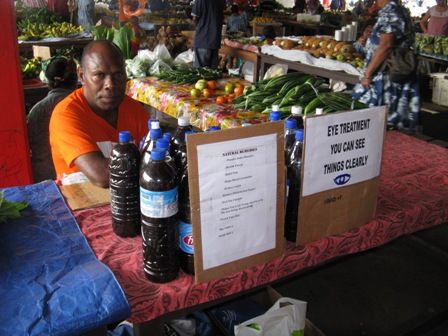 Port Vila market stall holder.[/caption]
Those old habits continue to thrive in contemporary Vanuatu. For instance, ‘Kastom’, the unwritten book of codes that control all village life remains ubiquitously prevalent. When you see a sign that reads, ‘Kastom’ fixed prominently on a wooden placard at the entrance to private property including many popular tourist spots, it means that without payment to the traditional landowners entry is denied. Most ‘Kastom’ villages have separate male and female areas while some villages reserve special places for menstruating women, which can pose tricky situations for uninformed visitors. Offence may be taken, but usually isn’t. The Nis-Van people are, if anything, resolutely friendly and very polite. Casual infringements regarding ‘Kastom’ rules are rarely enforced upon visitors.
After a few days on Efate checking out the dubious charms of Port Vila and its surrounds, sampling over-priced badly cooked French inspired fare and drinking over-priced ordinary wine shipped in from France or Australia, I escaped to Tanna, 45 minute’s flight to the south on one of Air Vanuatu’s trusty workhorse twin-prop inter-island ATR-47s. En route flying low over Erromango Island was a treat; it looks ravishingly beautiful.
Flights to Tanna are diurnal; no lights or advanced navigational instruments are in place for its short landing strip on a cliff at the edge of the South Pacific. Rather it’s like landing into the past a la James Michener’s Bali Hai of the South Pacific.
Incidentally, Michener was stationed in Vanuatu during WW2 so the comparison bears historical veracity.
There are no security checks at Tanna airport. No luggage carrousel, nor diner, nor crowds either. One small curio shop runs its opening hours that suit the infrequent flights.
[caption id="attachment_1501" align="alignnone" width="448"]
Port Vila market stall holder.[/caption]
Those old habits continue to thrive in contemporary Vanuatu. For instance, ‘Kastom’, the unwritten book of codes that control all village life remains ubiquitously prevalent. When you see a sign that reads, ‘Kastom’ fixed prominently on a wooden placard at the entrance to private property including many popular tourist spots, it means that without payment to the traditional landowners entry is denied. Most ‘Kastom’ villages have separate male and female areas while some villages reserve special places for menstruating women, which can pose tricky situations for uninformed visitors. Offence may be taken, but usually isn’t. The Nis-Van people are, if anything, resolutely friendly and very polite. Casual infringements regarding ‘Kastom’ rules are rarely enforced upon visitors.
After a few days on Efate checking out the dubious charms of Port Vila and its surrounds, sampling over-priced badly cooked French inspired fare and drinking over-priced ordinary wine shipped in from France or Australia, I escaped to Tanna, 45 minute’s flight to the south on one of Air Vanuatu’s trusty workhorse twin-prop inter-island ATR-47s. En route flying low over Erromango Island was a treat; it looks ravishingly beautiful.
Flights to Tanna are diurnal; no lights or advanced navigational instruments are in place for its short landing strip on a cliff at the edge of the South Pacific. Rather it’s like landing into the past a la James Michener’s Bali Hai of the South Pacific.
Incidentally, Michener was stationed in Vanuatu during WW2 so the comparison bears historical veracity.
There are no security checks at Tanna airport. No luggage carrousel, nor diner, nor crowds either. One small curio shop runs its opening hours that suit the infrequent flights.
[caption id="attachment_1501" align="alignnone" width="448"]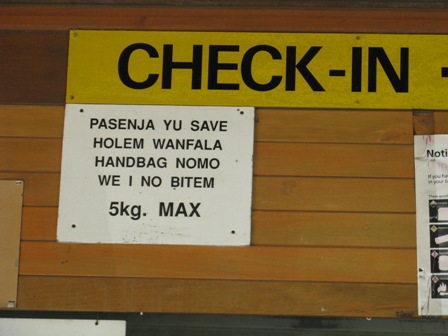 Tanna Island Airport check in sign.[/caption]
A few kilometres from the airport, I stayed at the White Grass Ocean Resort. It’s the best on the island. White Grass also runs daily trips (weather and conditions permitting) to Mount Yasur, the island’s volcanic furnace.
Yasur erupts continually, like Kilauea on the Big Island of Hawaii or Mount Bromo in East Java but as far as tourism goes, unlike the other two, numbers of visitors are minimal.
Vanuatu doesn’t trip off the tongues of most travellers when remote countries are mentioned. A trip to Yasur may include only you and your guide.
Since a few visitors were killed by lava projectiles a few years ago, the Nis-Van government has subsequently insisted that all visitors are accompanied by a knowledgeable professional guide.
[caption id="attachment_1505" align="alignnone" width="336"]
Tanna Island Airport check in sign.[/caption]
A few kilometres from the airport, I stayed at the White Grass Ocean Resort. It’s the best on the island. White Grass also runs daily trips (weather and conditions permitting) to Mount Yasur, the island’s volcanic furnace.
Yasur erupts continually, like Kilauea on the Big Island of Hawaii or Mount Bromo in East Java but as far as tourism goes, unlike the other two, numbers of visitors are minimal.
Vanuatu doesn’t trip off the tongues of most travellers when remote countries are mentioned. A trip to Yasur may include only you and your guide.
Since a few visitors were killed by lava projectiles a few years ago, the Nis-Van government has subsequently insisted that all visitors are accompanied by a knowledgeable professional guide.
[caption id="attachment_1505" align="alignnone" width="336"]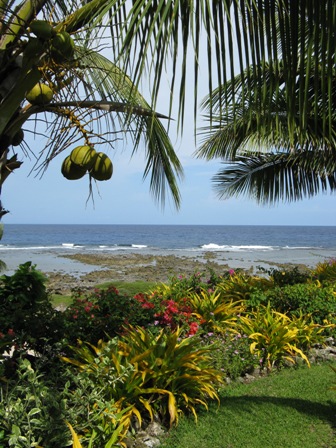 White Grass Resort on Tanna Island, beach at low tide.[/caption]
My guide knew his facts but was strangely nonplussed by the volcano. I discovered later that his demeanour was essentially religiously inspired, a sort of innate respect for the most holy of holies. My discussion with him went like this:
‘So, that was a large explosion,’ I comment while feeling nearly blown off the edge of the caldera after a particularly loud boom.
‘Yes, but not very strong,’ he says.
‘How much stronger can it be? I mean to say, what was that on the scale of explosions?’ I question the level of ferocity of the eruption according to scientific levels of magnitude: Level 1 through to Level 5, one being merely deafening and scary and five being Gotterdammerung and Armageddon combined.
Level 2 indicates that due care must be taken. Most days a visit to Mount Yasur is at Level 1, lots of rumbling and lava bubbling but no risk of flying lava boulders.
[caption id="attachment_1506" align="alignnone" width="448"]
White Grass Resort on Tanna Island, beach at low tide.[/caption]
My guide knew his facts but was strangely nonplussed by the volcano. I discovered later that his demeanour was essentially religiously inspired, a sort of innate respect for the most holy of holies. My discussion with him went like this:
‘So, that was a large explosion,’ I comment while feeling nearly blown off the edge of the caldera after a particularly loud boom.
‘Yes, but not very strong,’ he says.
‘How much stronger can it be? I mean to say, what was that on the scale of explosions?’ I question the level of ferocity of the eruption according to scientific levels of magnitude: Level 1 through to Level 5, one being merely deafening and scary and five being Gotterdammerung and Armageddon combined.
Level 2 indicates that due care must be taken. Most days a visit to Mount Yasur is at Level 1, lots of rumbling and lava bubbling but no risk of flying lava boulders.
[caption id="attachment_1506" align="alignnone" width="448"]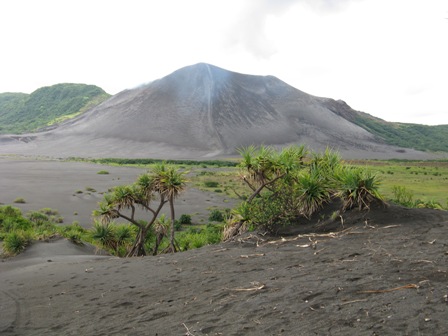 Mount Yasur on Tanna Island from a kilometre away on a low level eruption day.[/caption]
‘That was maybe 2.5,’ he suggests.
‘And if a lava boulder comes towards us, what do we do?’ I ask him worriedly.
The booms are getting louder. I’ve never felt energy like this. I see a red cataclysm spouting upwards some 500 metres away from deep in the caldera. Huge geysers of molten orange-red lava jettison upwards to the sky turning moist air into steam. A deafening sonic boom follows. I actually feel the blast shoot through my body. My first instinct is to run away as fast as possible screaming like a banshee.
‘Stand still. Then you can see where the rock lands,’ my guide responds succinctly. ‘Otherwise you may get hit on your head and die.’
He gazes into the hell directly beneath us so nonchalantly that I wonder if he had been struck by enough bits of molten rock to cause brain damage. Either that or he was stoned.
Actually, being struck on the head by projectile lava rocks does result in certain death. Basically you blow up, incinerate and melt. It’s a quick way to die with no margin for error or escape. It makes sense to stand still while watching overhead for burning hot rocks the size of Mini-Coopers coming at you. Don’t try to outrun them. You’ll lose the race. In effect, it’s your last race.
‘What happens when the volcano reaches Level 3?’ I ask him when I calm down slightly after resigning myself to the fact that death by lava rock is at least very quick if only instantaneously painful. Turning into a human torch for a second or two followed by gruesome implosion can’t be all bad surely.
‘We don’t park the van so close. We watch from over there,’ he demonstrates by pointing to a ridge rising above some burnt forest about two kilometres away. A previous Level 3 eruption scoured that area a few years ago.
To get to Mount Yasur you travel across a vast ash covered valley that looks like the surface of the planet Mercury. After parking the van on the lower side of the mountain, you ascend 250 metres up a bare rock and rubble strewn path. Often a sulphurous mist envelops the summit and the path to the rim of the caldera disappears completely. Travelling at your own risk when applied to these conditions is understating the facts.
Back to my conversation with the laid-back guide. I can’t resist pursuing this inevitable line of questioning. ‘And what happens when it’s Level 4?’
‘We don’t come here,’ he replies while looking at a particularly large lump of lava whizzing up above the rim of the caldera above my line of sight. If it turns our way I am faced with choosing to run or standing still. I’m still not sure what I’ll do. My instincts are on such high alert that I don’t think my mind will obey reason. The rock lands about 50 metres from our feet. I can feel its thud as it strikes the slope and rolls back into the fiery hole.
I gulp. ‘And what happens when it’s Level 5?’ This is the highest on the scale.
‘We leave the island.’ Of course, I knew that. What else is there to do? Most of Tanna would go up in smoke after this one almighty grand boom.
Though Yasur represents the potential geological demise of Tanna, it also means much to the Tannese people. Here a particular form of Cargo Cult has taken hold. John Frum and his ghostly army are said to live in the volcano, like the goddess Pele of Hawaii, John Frum may bring destruction or life.
Established approximately 75 years ago John Frum cultism is one of the world’s newest religions. Its origins are in fact based on a legend. A local deity, Keraperamun, said to come from Tanna’s highest mountain, Tukosmera, was manifested by a local man named Manehivi who took the alias John Frum and walked among the Tannese dressed like a westerner making promises about future gifts and offers of prized largesse if they forsook western ways and rejected goods given to them by missionaries and colonists.
Manehivi cum John Frum was, according to some reports, something of an oracle. He prophesised that if the Nis-Van people rejected white missionaries and western connections that the people would benefit from the timely departure of all colonialism from Vanuatu. The wealth would subsequently flow back to indigenous people rather than vice-versa.
Since ‘black-birding’, the insidious practice of white venture capitalists capturing Melanesian men from Vanuatu and the Solomon Islands to work in sugar plantations on mainland Australia was prevalent, its destructive social impact left local people feeling disabused as to the overall benefits of white colonialism.
Many Nis-Van sold up everything they owned in the belief that if they rejected white society, John Frum would return with the goods which were sanctified by Frum himself. Many people moved to the more remote interiors of the islands, particularly on Tanna. Here John Frum-ism gained its popular roots deep in the rich volcanic soil of Tanna’s mountainous interior.
When black American servicemen appeared on Tanna and other islands of the Vanuatu archipelago during WW2, most Nis-Van people had never before met or even seen black persons in positions of wealth and authority. Like most Americans stationed in the Melanesian Pacific during WW2, those on Tanna brought foodstuff the Nis-Van had never seen before, tinned meats and Hershey’s chocolate bars for example. When the war ended and the Americans returned home, the locals started hoping for the return of one ‘John from America’, a.k.a. John Frum, and his splendid array of treats and other desirable items.
From its beginnings as a Keraperamun manifested by Manehivi a.k.a. John Frum cult only a decade earlier, it appeared to the people of Tanna that their wishes had come true, more or less. To this day the villagers around Sulphur Bay near Mount Yasur hold ceremonies honouring John Frum and his cargo buddies in the belief that deliverance from rule controlled beyond the sea will be forever banished from purist Vanuatu.
Even more incredible is the fact that certain other village populations around Sulphur Bay believe in the return of a great white saviour who is consort to a powerful lady who emerged from Yasur, in this case Prince Philip, HRH the Duke of Edinburgh. When Queen Elizabeth and Prince Philip visited Vanuatu in 1974, the Yaohnenen people believed him to be the living incarnation of a spirit who left the volcano to marry a great female spirit. Each year Prince Philip’s June birthday is celebrated in hopes that his divine presence will once again grace the inhabitants of Tanna. The Prince Philip cult has its foundation in John Frum cultism and ‘Kastom’ practices, albeit something of a credibility stretch in an already incredible official religion.
Official? Yes, indeed. The Nis-Van parliament recognises John Frum adherents as bone fide citizens with due representation in parliament.
[caption id="attachment_1507" align="alignnone" width="448"]
Mount Yasur on Tanna Island from a kilometre away on a low level eruption day.[/caption]
‘That was maybe 2.5,’ he suggests.
‘And if a lava boulder comes towards us, what do we do?’ I ask him worriedly.
The booms are getting louder. I’ve never felt energy like this. I see a red cataclysm spouting upwards some 500 metres away from deep in the caldera. Huge geysers of molten orange-red lava jettison upwards to the sky turning moist air into steam. A deafening sonic boom follows. I actually feel the blast shoot through my body. My first instinct is to run away as fast as possible screaming like a banshee.
‘Stand still. Then you can see where the rock lands,’ my guide responds succinctly. ‘Otherwise you may get hit on your head and die.’
He gazes into the hell directly beneath us so nonchalantly that I wonder if he had been struck by enough bits of molten rock to cause brain damage. Either that or he was stoned.
Actually, being struck on the head by projectile lava rocks does result in certain death. Basically you blow up, incinerate and melt. It’s a quick way to die with no margin for error or escape. It makes sense to stand still while watching overhead for burning hot rocks the size of Mini-Coopers coming at you. Don’t try to outrun them. You’ll lose the race. In effect, it’s your last race.
‘What happens when the volcano reaches Level 3?’ I ask him when I calm down slightly after resigning myself to the fact that death by lava rock is at least very quick if only instantaneously painful. Turning into a human torch for a second or two followed by gruesome implosion can’t be all bad surely.
‘We don’t park the van so close. We watch from over there,’ he demonstrates by pointing to a ridge rising above some burnt forest about two kilometres away. A previous Level 3 eruption scoured that area a few years ago.
To get to Mount Yasur you travel across a vast ash covered valley that looks like the surface of the planet Mercury. After parking the van on the lower side of the mountain, you ascend 250 metres up a bare rock and rubble strewn path. Often a sulphurous mist envelops the summit and the path to the rim of the caldera disappears completely. Travelling at your own risk when applied to these conditions is understating the facts.
Back to my conversation with the laid-back guide. I can’t resist pursuing this inevitable line of questioning. ‘And what happens when it’s Level 4?’
‘We don’t come here,’ he replies while looking at a particularly large lump of lava whizzing up above the rim of the caldera above my line of sight. If it turns our way I am faced with choosing to run or standing still. I’m still not sure what I’ll do. My instincts are on such high alert that I don’t think my mind will obey reason. The rock lands about 50 metres from our feet. I can feel its thud as it strikes the slope and rolls back into the fiery hole.
I gulp. ‘And what happens when it’s Level 5?’ This is the highest on the scale.
‘We leave the island.’ Of course, I knew that. What else is there to do? Most of Tanna would go up in smoke after this one almighty grand boom.
Though Yasur represents the potential geological demise of Tanna, it also means much to the Tannese people. Here a particular form of Cargo Cult has taken hold. John Frum and his ghostly army are said to live in the volcano, like the goddess Pele of Hawaii, John Frum may bring destruction or life.
Established approximately 75 years ago John Frum cultism is one of the world’s newest religions. Its origins are in fact based on a legend. A local deity, Keraperamun, said to come from Tanna’s highest mountain, Tukosmera, was manifested by a local man named Manehivi who took the alias John Frum and walked among the Tannese dressed like a westerner making promises about future gifts and offers of prized largesse if they forsook western ways and rejected goods given to them by missionaries and colonists.
Manehivi cum John Frum was, according to some reports, something of an oracle. He prophesised that if the Nis-Van people rejected white missionaries and western connections that the people would benefit from the timely departure of all colonialism from Vanuatu. The wealth would subsequently flow back to indigenous people rather than vice-versa.
Since ‘black-birding’, the insidious practice of white venture capitalists capturing Melanesian men from Vanuatu and the Solomon Islands to work in sugar plantations on mainland Australia was prevalent, its destructive social impact left local people feeling disabused as to the overall benefits of white colonialism.
Many Nis-Van sold up everything they owned in the belief that if they rejected white society, John Frum would return with the goods which were sanctified by Frum himself. Many people moved to the more remote interiors of the islands, particularly on Tanna. Here John Frum-ism gained its popular roots deep in the rich volcanic soil of Tanna’s mountainous interior.
When black American servicemen appeared on Tanna and other islands of the Vanuatu archipelago during WW2, most Nis-Van people had never before met or even seen black persons in positions of wealth and authority. Like most Americans stationed in the Melanesian Pacific during WW2, those on Tanna brought foodstuff the Nis-Van had never seen before, tinned meats and Hershey’s chocolate bars for example. When the war ended and the Americans returned home, the locals started hoping for the return of one ‘John from America’, a.k.a. John Frum, and his splendid array of treats and other desirable items.
From its beginnings as a Keraperamun manifested by Manehivi a.k.a. John Frum cult only a decade earlier, it appeared to the people of Tanna that their wishes had come true, more or less. To this day the villagers around Sulphur Bay near Mount Yasur hold ceremonies honouring John Frum and his cargo buddies in the belief that deliverance from rule controlled beyond the sea will be forever banished from purist Vanuatu.
Even more incredible is the fact that certain other village populations around Sulphur Bay believe in the return of a great white saviour who is consort to a powerful lady who emerged from Yasur, in this case Prince Philip, HRH the Duke of Edinburgh. When Queen Elizabeth and Prince Philip visited Vanuatu in 1974, the Yaohnenen people believed him to be the living incarnation of a spirit who left the volcano to marry a great female spirit. Each year Prince Philip’s June birthday is celebrated in hopes that his divine presence will once again grace the inhabitants of Tanna. The Prince Philip cult has its foundation in John Frum cultism and ‘Kastom’ practices, albeit something of a credibility stretch in an already incredible official religion.
Official? Yes, indeed. The Nis-Van parliament recognises John Frum adherents as bone fide citizens with due representation in parliament.
[caption id="attachment_1507" align="alignnone" width="448"] Tanna Island villagers make wonderful welcoming committees. Near Sulphur Bay.[/caption]
February 15 is official John Frum day. Incidentally, the year of his return is not known. On the 15th, celebrations on Tanna include faux-American soldiers dressed in camouflage battle fatigues sporting shoulder holstered rough hewn wooden guns looking like WW2 machine guns march up and down imitation runways studded with imitation control towers. Serious though the procession may be, an air of festivity does prevail. It’s quite a sight to see in the jungles of Tanna with divine Mount Yasur rumbling auspiciously in the background and perfectly safe as long as you’re not there on a Level 5 day.
Naked Facts:
White Grass Ocean Resort is not far from Tanna’s airport. Transfers can be arranged when booking. White Grass is all inclusive and though the food isn’t gourmet by any means, considerable effort is made to ensure that meals are far better than average Nis-Van fare. The fresh local crayfish is a treat. Ask the chef please not to overcook it.
The lagoon off White Grass resort is prime Green Sea Turtle habitat. Snorkelling with them when they’re in the vicinity is easily arranged. Unfortunately White Grass Ocean Resort does not offer diving facilities. The offshore reef system is wondrous. If Mount Yasur is off limits, time spent exploring other ‘Kastom’ villages, the famous white horses of the White Grass plateau and the reefs off White Grass are equally rewarding ways to enjoy Tanna.
See www.whitegrassvanuatu.com.vu for bookings.
White Grass Ocean Resort
PO Box 5
Lenakel, Tanna
Vanuatu
Tel: +678 30010
Flights to Vanuatu are best served by the national carrier. See www.airvanuatu.com
Tanna Island villagers make wonderful welcoming committees. Near Sulphur Bay.[/caption]
February 15 is official John Frum day. Incidentally, the year of his return is not known. On the 15th, celebrations on Tanna include faux-American soldiers dressed in camouflage battle fatigues sporting shoulder holstered rough hewn wooden guns looking like WW2 machine guns march up and down imitation runways studded with imitation control towers. Serious though the procession may be, an air of festivity does prevail. It’s quite a sight to see in the jungles of Tanna with divine Mount Yasur rumbling auspiciously in the background and perfectly safe as long as you’re not there on a Level 5 day.
Naked Facts:
White Grass Ocean Resort is not far from Tanna’s airport. Transfers can be arranged when booking. White Grass is all inclusive and though the food isn’t gourmet by any means, considerable effort is made to ensure that meals are far better than average Nis-Van fare. The fresh local crayfish is a treat. Ask the chef please not to overcook it.
The lagoon off White Grass resort is prime Green Sea Turtle habitat. Snorkelling with them when they’re in the vicinity is easily arranged. Unfortunately White Grass Ocean Resort does not offer diving facilities. The offshore reef system is wondrous. If Mount Yasur is off limits, time spent exploring other ‘Kastom’ villages, the famous white horses of the White Grass plateau and the reefs off White Grass are equally rewarding ways to enjoy Tanna.
See www.whitegrassvanuatu.com.vu for bookings.
White Grass Ocean Resort
PO Box 5
Lenakel, Tanna
Vanuatu
Tel: +678 30010
Flights to Vanuatu are best served by the national carrier. See www.airvanuatu.com
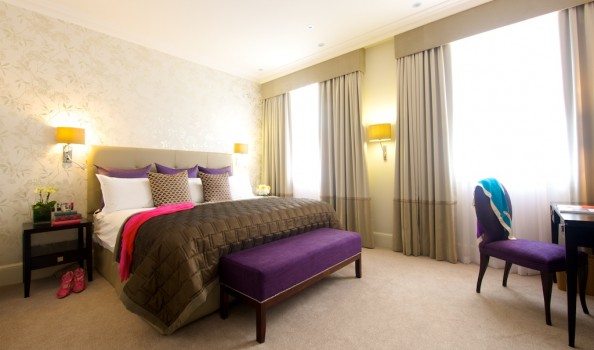 https://nakedhungrytraveller.com.au/londons-best-digs/ London’s Best Digs?
https://nakedhungrytraveller.com.au/londons-best-digs/ London’s Best Digs?Famous grand hotels in London aren’t hidden away are they? The Savoy. The Connaught. Claridges. Brown’s. The Dorchester. Ask any London cabbie to take you to anyone of these hotels and the driver could probably get you there blindfolded.
Much as I like the grand entrances and ‘olde worlde’ atmosphere of those hotels, the Taj Group’s 51 Buckingham Gate is my pick from this top bunch of de luxe lodgings. 51 Buckingham Gate is a bit hidden away, sort of. Looking out one of the windows of my suite I can see Buckingham Palace and St James’ Park. If I lean out the window I can see Big Bend and Parliament. Hidden? Hardly. Discreetly tucked away? Yes indeed. Probably why a number of Hollywood and Bollywood stars prefer to stay here. It’s a paparazzi free zone. An acquaintance told me that a certain Australian red-headed Oscar winning actress stayed here recently for a month en famille. She wanted some privacy with her two children, which she got evidently. All I wanted was a quiet hotel in which to lay my tired head after travelling non-stop for six weeks. I wanted good food, service and a good location too. Doesn’t everyone? What I want and what I get however don’t always coincide. Good location often means next to a major throughway, noisy and crowded with rumbling traffic. Quiet often means so far from the centre of the action that the hotel could simultaneously operate as a retirement home. Service is the constant inconsistency. Rarely do I encounter reliably well-trained staff members that have all read from the same training manuals. 51 Buckingham Gate is the first London hotel I’ve stayed in where the service was absolutely flawless. [caption id="attachment_1568" align="alignnone" width="300"]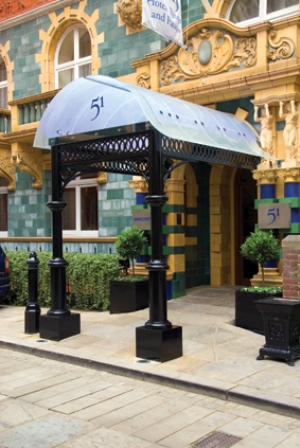 51 Buckingham Gate's unobtrusive entry.[/caption]
A few examples: Shortly after check-in I asked the concierge for help arranging a flight from Dubrovnik to Athens the following week. Within fifteen minutes I had a complete listing of all available transport options including prices for hiring a car to drive myself, train timetables, bus timetables and ferry timetables, slipped quietly under my door, followed by a phone call to enquire if I needed anything else. He wasn’t happy with the options immediately available and wanted to do further research which may take a couple more hours.
By the way, I also learned that flying from Dubrovnik to Athens was ridiculously overpriced, that Dubrovnik has no railway station, that the bus to Athens went via Belgrade and took nearly two days to get there and that I couldn’t hire a car in Croatia and leave it in Greece without paying an added hefty surcharge.
This became a challenge so perplexing that the concierge, a lovely man from Brazil, worked on my problem during a Sunday, his day off, to come up with a plausible solution, which he did.
The breakfast room maitre d’hotel, a Turk from Istanbul made me feel so comfortable that my first breakfast lasted three hours. Reading the Guardian and the Times and Independent newspapers in a state of complete relaxation is a treat I don’t often enjoy even at home.
The head housekeeper, a marvellous Italian lady of impeccable discretion fixed a problem about a leaky ceiling in my suite (someone had overfilled a bath in the floor above mine) with such professionalism and alacrity that I forgot about it. The carpet in my hallway was completely dry when I returned. How she managed to get it cleaned and dry within a few hours continues to surprise me. Magic powers?
The hotel’s Michelin starred restaurant, Quilon, serves the best Indian food I’ve ate outside India. Quilon also offers a better wine list, more comfortable seating with more room between tables and with better background music. And the service was better than in the majority of Indian fine diners I've tried in India.
The hotel’s general manager, the exquisite Ms. Araceli Rius-Perez, a Spaniard who clearly loves her hotel, made me feel so welcomed, appreciated and valued that I hugged her when leaving. I don’t normally hug hotel managers. They don’t normally hug me either. Nuff said.
The employees at 51 Buckingham Gate represent something of a microcosm of current London society, a hodgepodge of nationalities from around the globe. What they all have in common here is a sense of shared purpose. The goal is to make the guest feel at home, esteemed, as if he or she is the single most important person met that whole day.
This kind of service is endangered in my experience. In so many hotels I visit these days, I’m merely a number. Eye contact between employee and guest is often avoided. Personal interaction is limited to hello and goodbye.
It helps too that 51 Buckingham Gate’s overall impression is marked by the quality of the accommodation itself. The suites are all extravagantly large. Mine was larger than the two-bedroom flat I once rented in Camberwell about an hour's walk from Brixton’s market.
The colours in the suites are somewhat muted, erring on the beige side of bland but I didn’t really mind all that much. Hotels ruled by design features tend to err on the side of discomfort. There were no sharp edges anywhere in my suite.
Though colour schemes were scaled back, a liberal spread of vases full of fresh flowers added pizzazz.
All up however, everything functioned perfectly: work station at the desk with plug-ins accessible for the laptop, extra stationery, pens, notepads etc. and all lighting was set at human sized levels pointed where they were best suited to gain maximum illumination. The plumbing worked perfectly in this land of generally inadequate water pressure. I enjoyed a huge shower with copious amounts of hot water, a separate spa tub, voluminously soft towels, good toiletries (Molton-Brown) and the bed was as plushly comfortable as I’ve slept in anywhere else at this 5-star level. Double glazed windows kept out the constant thrum of London's ceaseless traffic. Black out curtains completed this picture of totally excellent sleep inducing conditions.
A small butler's pantry was equipped as a kitchen with enough gadgets in case I decided to call in a chef to serve a meal at my eight-seated dining table. Quality glassware, cutlery and crockery completed the gastronomic necessities.
Summing up, I could actually live at 51 Buckingham Gate.
For reservations and special offers:
www.51-buckinghamgate.com
51 Buckingham Gate's unobtrusive entry.[/caption]
A few examples: Shortly after check-in I asked the concierge for help arranging a flight from Dubrovnik to Athens the following week. Within fifteen minutes I had a complete listing of all available transport options including prices for hiring a car to drive myself, train timetables, bus timetables and ferry timetables, slipped quietly under my door, followed by a phone call to enquire if I needed anything else. He wasn’t happy with the options immediately available and wanted to do further research which may take a couple more hours.
By the way, I also learned that flying from Dubrovnik to Athens was ridiculously overpriced, that Dubrovnik has no railway station, that the bus to Athens went via Belgrade and took nearly two days to get there and that I couldn’t hire a car in Croatia and leave it in Greece without paying an added hefty surcharge.
This became a challenge so perplexing that the concierge, a lovely man from Brazil, worked on my problem during a Sunday, his day off, to come up with a plausible solution, which he did.
The breakfast room maitre d’hotel, a Turk from Istanbul made me feel so comfortable that my first breakfast lasted three hours. Reading the Guardian and the Times and Independent newspapers in a state of complete relaxation is a treat I don’t often enjoy even at home.
The head housekeeper, a marvellous Italian lady of impeccable discretion fixed a problem about a leaky ceiling in my suite (someone had overfilled a bath in the floor above mine) with such professionalism and alacrity that I forgot about it. The carpet in my hallway was completely dry when I returned. How she managed to get it cleaned and dry within a few hours continues to surprise me. Magic powers?
The hotel’s Michelin starred restaurant, Quilon, serves the best Indian food I’ve ate outside India. Quilon also offers a better wine list, more comfortable seating with more room between tables and with better background music. And the service was better than in the majority of Indian fine diners I've tried in India.
The hotel’s general manager, the exquisite Ms. Araceli Rius-Perez, a Spaniard who clearly loves her hotel, made me feel so welcomed, appreciated and valued that I hugged her when leaving. I don’t normally hug hotel managers. They don’t normally hug me either. Nuff said.
The employees at 51 Buckingham Gate represent something of a microcosm of current London society, a hodgepodge of nationalities from around the globe. What they all have in common here is a sense of shared purpose. The goal is to make the guest feel at home, esteemed, as if he or she is the single most important person met that whole day.
This kind of service is endangered in my experience. In so many hotels I visit these days, I’m merely a number. Eye contact between employee and guest is often avoided. Personal interaction is limited to hello and goodbye.
It helps too that 51 Buckingham Gate’s overall impression is marked by the quality of the accommodation itself. The suites are all extravagantly large. Mine was larger than the two-bedroom flat I once rented in Camberwell about an hour's walk from Brixton’s market.
The colours in the suites are somewhat muted, erring on the beige side of bland but I didn’t really mind all that much. Hotels ruled by design features tend to err on the side of discomfort. There were no sharp edges anywhere in my suite.
Though colour schemes were scaled back, a liberal spread of vases full of fresh flowers added pizzazz.
All up however, everything functioned perfectly: work station at the desk with plug-ins accessible for the laptop, extra stationery, pens, notepads etc. and all lighting was set at human sized levels pointed where they were best suited to gain maximum illumination. The plumbing worked perfectly in this land of generally inadequate water pressure. I enjoyed a huge shower with copious amounts of hot water, a separate spa tub, voluminously soft towels, good toiletries (Molton-Brown) and the bed was as plushly comfortable as I’ve slept in anywhere else at this 5-star level. Double glazed windows kept out the constant thrum of London's ceaseless traffic. Black out curtains completed this picture of totally excellent sleep inducing conditions.
A small butler's pantry was equipped as a kitchen with enough gadgets in case I decided to call in a chef to serve a meal at my eight-seated dining table. Quality glassware, cutlery and crockery completed the gastronomic necessities.
Summing up, I could actually live at 51 Buckingham Gate.
For reservations and special offers:
www.51-buckinghamgate.com https://nakedhungrytraveller.com.au/venturing-into-vietnam/ Venturing into Vietnam
https://nakedhungrytraveller.com.au/venturing-into-vietnam/ Venturing into VietnamPacked with natural charms, Vietnam is a study in contrasting delights.
Vietnam stretches for nearly 1,500 kilometres from its northern border with China to its vast Mekong River delta in its southern extremity. A mountainous spine bridges the northern, central and southern regions. Indeed Vietnam is competing against Thailand for south eastern Asia’s hot-spot beach destination, so popular has it become in such a short time. First time visitors will be pleasantly surprised at the local laissez-faire attitude to enterprise. Though the Vietnamese are naturally entrepreneurial, they don’t push a hard sell. Wandering through bustling markets elsewhere in Asia can be a trying experience, as in, ‘Try this’ or ‘Try that’ yelled from every corner but here it’s more relaxed. Of course a sale will suffuse a vendor’s face with delight, but a simple reply ‘No thanks,’ doesn’t offend either. It’s as if fifty years of self-reliant government has had the effect of encouraging people to rest assured that the state will provide and that money is not necessarily the basis for a contented life. This is not intended to portray the locals as glum. Rather, with a smile and hello spoken in Vietnamese, faces light up radiantly. More naturally friendly people are hard to find. If other countries proclaim that they are the land of smiles, Vietnam is surely the land of the big grin. Coinciding with Vietnam’s rise in global travel esteem has been its government’s opening to foreign trade. Though Vietnam’s socialist government was founded in the hotbed atmosphere of the decade’s long conflict with the French and later the Americans, it has relaxed its attitude to visitors. Gone are the days when foreign tourists were watched closely by government officials. Only fifteen years ago, cultural regions such as those around the northwest at Sa Pa were virtually closed to travellers. Now a luxuriously appointed tourist train takes visitors directly from Hanoi to a town near Sa Pa where treks to Mount Fansipan (Southeast Asia’s highest peak) and to neighbouring hill tribes’ villages are widely promoted by tourism authorities. Two big cities dominate Vietnam: Ho Chi Minh City (HCMC) still referred to by the locals as Saigon and Hanoi. The first is the economic powerhouse of the nation. Vibrant and brimming with activity, it’s the place in which to do business. It’s also a shopper’s paradise. Hanoi is the bureaucratic heartland, more relaxed, historic and atmospheric. A visit to Vietnam without seeing both its major cities is to leave the country half-explored. Hanoi is filled with culturally significant sights. The Ho Chi Minh Mausoleum is the country’s pilgrimage place. Uncle Ho’s house and gardens near the mausoleum are open to the public. They are both particularly poignant. He is the founding father of modern Vietnam and his place in the national esteem is unparalleled. Due respect is required for a visit to his mausoleum. It is unforgettable. Hanoi’s ancient university, The Temple of Literature gives insight to the importance of Confucianism in the country’s religious history. Hanoi’s university is one of the oldest in the world; its grounds are very beautifully restored. Both the Kim Lien (Golden Lotus) Pagoda on the shore of West Lake and the restored One Pillar Pagoda near the Temple of Literature are two of the oldest in the country. Visit the Kim Lien Pagoda at dawn to take part in an impromptu Tai Chi class. The old quarter at Hoan Kiem District is Hanoi’s retail therapy centre. Don’t miss 17 Nha Chung Street’s Hanoi Art gallery filled with propaganda posters reminiscent of depression era artwork from Australia or America. Haiphong in the Red River delta is the nation’s largest port and an industrial giant. Its close proximity to picturesque Halong Bay makes it worthy of acquaintance. Few travellers get here and as such, it’s virtually untouched by tourism. Halong Bay is Vietnam’s significant contribution to UNESCO’s World Heritage list. Its landscape is the stuff of dreams, karst mountains jut out of an enclosed bay for as far as the eyes can see. Sadly the bay has become littered with plastic rubbish left behind by hundreds of thousands of annual visitors. Though Vietnamese authorities try to tackle the problem of too many visitors boarding too many day tripping boats, their attempts at controlling pollution have so far been lacklustre. Numerous boats make day trips to various beauty spots in the bay but if time allows, The Emeraude, a restored French steamer does an overnight cruise that permits visitors to see more of the bay than a simple day trip provides. To relax on the upper deck of the Emeraude, G & T in hand, while progressing at a stately pace through densely forested peaks that lean sideways forming hidden coves, is to experience Halong Bay at its most sublime despite the rubbish strewn water. See www.emeraude-cruises.com for details. HCMC, or Saigon, may lack the cultural weight of Hanoi but its Reunification Palace, the War Museum, the Museum of Fine Arts and the Jade Emperor Pagoda are all not-to-be-missed regardless. Dong Khoi Street is still the city’s lifeline, as it was when Graham Greene visited it and mentioned it in his novel, The Quiet American. Le Thanh Ton street in District One near the central Ben Thanh markets is packed with bespoke tailors. Choose carefully, ask lots of questions and be prepared to order in large quantities: custom made suits, shirts and dresses for a fraction of what they cost at home. Saigon is the country’s centre for tailors, though Hoi An gives it a run for its money. If the heat of the plains or Saigon’s sultry humidity becomes more than bearable, the old French hill resort of Dalat is only a 40 minute’s flight away. At over 1,700 metres the surrounding countryside is verdant and agriculturally rich. Strawberries, artichokes and cabbage fields spread out along the often misty slopes. Dalat itself is a history buff’s endpoint: French colonial architecture reached its apex here. It’s also a golfer’s paradise. Vietnam’s premier course is here and well worth visiting, as is the heritage railway station, the town’s horticultural gardens and its innumerable cafes. Hoi An near Da Nang is one of Vietnam’s most picturesque towns. Protected by government building restrictions and therefore historically intact, it is easily negotiated in a matter of hours. The beaches nearby at Dien Ban, its famous China Beach, are ringed by the Marble Mountains and offer a variety of resorts, some super luxurious, some very family friendly. The long sweeping sands edged by the warm waters of the South China Sea are endlessly inviting. Further south at Nha Trang, lush resorts invite travellers to indulge in more sun and sea worshipping. It’s a win-win combination. Both Mui Ne and Phan Thiet (180 kilometres northeast of HCMC) are reputedly the sunniest towns in Vietnam. Laid back tourism is the key claim here. Relax on relatively uncrowded beaches and practice your newly discovered Vietnamese passion. It’s unavoidable. Never forget that the Vietnamese live to eat. Fresh foods abound. Try the national dishes: pho bo (beef noodle soup) or its close cousin pho ga (chicken noodle soup) for breakfast. It’s a very healthy start to the day. Vietnamese fish sauce, Nuoc Mam, is integral to nearly all Vietnamese cooking. The best of it, labelled Ca Com, indicates that only long jawed anchovies were used in its making. The level of protein, no higher than 40N, is indicated on the label and is essential to Vietnamese dental health. It’s also a preventative for parasitical worms. The best Nuoc Mam is prohibited for export, so highly is it esteemed by the Vietnamese. But you can buy some for personal use and take it home. Fact File: See www.vietnamtourism.com for more details and trip planning advice. Most western citizens must obtain a Tourist Visa before travelling to Vietnam.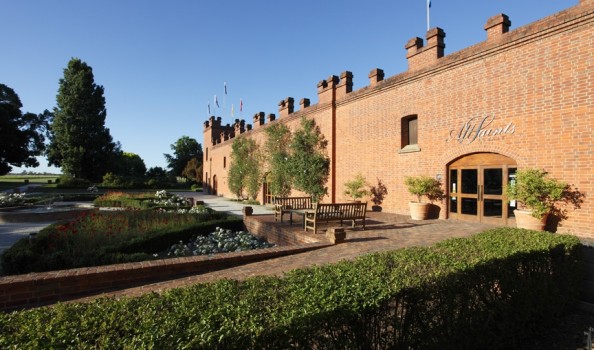 https://nakedhungrytraveller.com.au/rustic-rutherglen-gets-fresh/ Rustic Rutherglen Gets Fresh
https://nakedhungrytraveller.com.au/rustic-rutherglen-gets-fresh/ Rustic Rutherglen Gets FreshAnyone claiming a casual familiarity with the wines of Rutherglen most likely thinks of sweet fortified and heavy duty reds.
Fair enough since these have been the bread and butter of Rutherglen for more than a century. Well, times are changing and they’re changing in a very pleasant fashion. While the bread and butter wines, Muscat, Topaque (formerly Tokay) and strong reds mostly made from Durif, continue to deliver outstanding wines of excellent quality, other grapes such as Marsanne, Roussanne, Tempranillo and dry wines made from Portuguese varieties such as Touriga, Tinta Cao and Tinta Barocca are adding new excitement to the array of tastes. Rutherglen is steeped in tradition. The Winemakers of Rutherglen has some twenty wineries operating in the region. Fifteen are owned by multigenerational families, some in business as far back as the 1850s. Breathing new life into the region, some have been in operation for only a few years. What I like most about Rutherglen is the camaraderie between competitors. Let’s face it. The wine business is a tough one, particularly in these cruel economic times. Imports into Australia have sunk in price while local winemakers face rising costs. And this fact doesn’t take into account seasonal problems with drought or frost or hail. A farmer’s life has never been easy, particularly winemaking farmers. They have to market, distribute and sell their products as well as nurturing them from ground up. Winemakers are farmers plus producers plus retailers plus salesmen. Any one of those jobs would occupy a clever person full time. Performing four jobs simultaneously in harsh conditions is nigh on impossible. To do any of them well requires absolute dedication and something of a crazy streak. The Rutherglen winemakers are a friendly lot, willing to share among peers, encouraging and helpful of one another, especially when times are tougher than usual. It’s wonderful to behold this sort of fraternal cooperation. As one of the newer kids on the block, Anton Therkildsen of Valhalla Wines mentions that he couldn’t have succeeded without the support of his peers. Therkildsen’s wines are in the new Rutherglen style. He doesn’t make a fortified, sees no reason to compete with others making such wonderful wines, instead choosing to focus on creating lighter reds and dry whites as alternatives to the region’s traditional stalwarts. Mandy Jones of Jones Winery and Vineyard is another talented winemaker who’s focused on tweaking the traditions. Her Marsanne and Roussanne whites are clear examples of how the old can become new with shifting attitudes. Like Therkildsen, Jones believes she shouldn’t compete with tradition but embrace it while exploring fresh ways making wines from grapes that historically grow well in the region. Over at Scion Vineyard, another new entrant on the local scene, mother and son team, Jan and Rowly Milhinch are working innovatively with Durif, creating an elegant wine from a gutsy grape. Their Viognier, a bone dry aromatic white also indicates a regional shift to working wonders with alternative grapes well suited to the climate. [caption id="attachment_1593" align="alignnone" width="448"]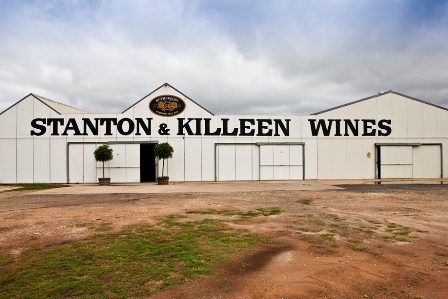 Stanton & Killeen main building outside Rutherglen.[/caption]
Members of the young generations are having their say in favour of exploring the new as well. Simon Killeen at Stanton & Killeen is working wonders with his favourite Portuguese varieties. Though his family winery continues to make amazingly rich vintage port style wines from grapes like Touriga, Touriga Nacional, Tinta Rouriz and Tinta Souza, charmingly enthusiastic Simon is establishing his lush dry red, ‘The Prince’ as a wine to watch out for.
[caption id="attachment_1592" align="alignnone" width="335"]
Stanton & Killeen main building outside Rutherglen.[/caption]
Members of the young generations are having their say in favour of exploring the new as well. Simon Killeen at Stanton & Killeen is working wonders with his favourite Portuguese varieties. Though his family winery continues to make amazingly rich vintage port style wines from grapes like Touriga, Touriga Nacional, Tinta Rouriz and Tinta Souza, charmingly enthusiastic Simon is establishing his lush dry red, ‘The Prince’ as a wine to watch out for.
[caption id="attachment_1592" align="alignnone" width="335"] Simon Killeen at his winery.[/caption]
Similarly, Jen Pfeiffer, daughter of Chris Pfeiffer of long standing champion Pfeiffer Wines is creating wizardry in her family’s winery. Young Jen is a wunderkind, all the while honouring tradition while breathing impressive energy into an established brand. Her Shiraz is one of the region’s best dry reds.
Something all winemakers appear to have in common is a love of good food. With great wines come great meals.
Though Rutherglen is essentially a tiny town of fewer than 3,000 inhabitants, the region is bountifully blessed with fresh, tasty ingredients. Fortunately, fine cooking is available as the perfect accompaniment to the uniformly superb wines.
During a lavish lunch hosted by owner/operator Eliza Brown at All Saints Estate’s Terrace restaurant, I was impressed again by how hard everyone in the region works at doing the best they possibly can. Brown and her family acquired All Saints just over a decade ago in somewhat trying circumstances. Without the support of other local winemakers she told me her job would have been much harder, if not impossible.
I confess, Rutherglen has always been one of my favourite wine making regions in the country. It’s compact, therefore easy to get around and blessed with a curiously unfussy tradition despite its long history. Give me a glass of a complex Cofield sparkling wine or a stand-out Stanton & Killeen vintage port or a Pfeiffer flor fino sherry style aperitif or one of David Morris’ memorable Muscats and I’m like a kid in a lolly shop.
Nowadays, I’m even happier with the wines of Rutherglen. There’s more to sample, fresh tastes and new grapes with great food. And the winemakers of Rutherglen make me happy.
Naked Facts:
Jones Café
61 Jones Road, Rutherglen
02 6032 8496
Open Thurs-Sun 10am-5pm
Pickled Sisters Café and Cofield Wines
Distillery Road, Wahgunyah
02 6033 3798
Open Mon-Sat 9am-5pm Sun 10am-5pm
All Saints, The Terrace Restaurant
All Saints Road, Wahgunyah
1800 021 621
Open 7 days until 5:30pm
Tuileries Restaurant
13-35 Drummond St, Rutherglen
02 6032 9033
Open 7 nights from 6:30pm
Rutherglen’s annual gourmet event, Tastes of Rutherglen is in March and takes place over two consecutive weekends.
All tickets can be purchased online at:
www.winemakers.com.au or
1300 787 929
Bicycling around Rutherglen is easy. See www.murraytomountains.com.au for information about bicycle hire, bicycle transport, itineraries, maps and accommodation.
Stay:
John Foord Guesthouse
7 Braintree Avenue, Corowa
02 6033 5284
www.corowaaccommodation.com.au
John Foord Guesthouse offers four bedrooms and two lounge rooms with a fully equipped kitchen. Spotlessly clean and very comfortable, it’s the kind of holiday house you could easily live in.
Tuileries also operates as a fine accommodation provider. This collection of cottages overlooking a vineyard within ten minutes walk of Rutherglen’s town centre is the best in town. See www.tuileriesrutherglen.com.au or telephone +61 (0)2 6032 9033 for more details and reservations.
Alternatively check out www.rutherglenvic.com for a comprehensive listing of accommodation within the region.
Simon Killeen at his winery.[/caption]
Similarly, Jen Pfeiffer, daughter of Chris Pfeiffer of long standing champion Pfeiffer Wines is creating wizardry in her family’s winery. Young Jen is a wunderkind, all the while honouring tradition while breathing impressive energy into an established brand. Her Shiraz is one of the region’s best dry reds.
Something all winemakers appear to have in common is a love of good food. With great wines come great meals.
Though Rutherglen is essentially a tiny town of fewer than 3,000 inhabitants, the region is bountifully blessed with fresh, tasty ingredients. Fortunately, fine cooking is available as the perfect accompaniment to the uniformly superb wines.
During a lavish lunch hosted by owner/operator Eliza Brown at All Saints Estate’s Terrace restaurant, I was impressed again by how hard everyone in the region works at doing the best they possibly can. Brown and her family acquired All Saints just over a decade ago in somewhat trying circumstances. Without the support of other local winemakers she told me her job would have been much harder, if not impossible.
I confess, Rutherglen has always been one of my favourite wine making regions in the country. It’s compact, therefore easy to get around and blessed with a curiously unfussy tradition despite its long history. Give me a glass of a complex Cofield sparkling wine or a stand-out Stanton & Killeen vintage port or a Pfeiffer flor fino sherry style aperitif or one of David Morris’ memorable Muscats and I’m like a kid in a lolly shop.
Nowadays, I’m even happier with the wines of Rutherglen. There’s more to sample, fresh tastes and new grapes with great food. And the winemakers of Rutherglen make me happy.
Naked Facts:
Jones Café
61 Jones Road, Rutherglen
02 6032 8496
Open Thurs-Sun 10am-5pm
Pickled Sisters Café and Cofield Wines
Distillery Road, Wahgunyah
02 6033 3798
Open Mon-Sat 9am-5pm Sun 10am-5pm
All Saints, The Terrace Restaurant
All Saints Road, Wahgunyah
1800 021 621
Open 7 days until 5:30pm
Tuileries Restaurant
13-35 Drummond St, Rutherglen
02 6032 9033
Open 7 nights from 6:30pm
Rutherglen’s annual gourmet event, Tastes of Rutherglen is in March and takes place over two consecutive weekends.
All tickets can be purchased online at:
www.winemakers.com.au or
1300 787 929
Bicycling around Rutherglen is easy. See www.murraytomountains.com.au for information about bicycle hire, bicycle transport, itineraries, maps and accommodation.
Stay:
John Foord Guesthouse
7 Braintree Avenue, Corowa
02 6033 5284
www.corowaaccommodation.com.au
John Foord Guesthouse offers four bedrooms and two lounge rooms with a fully equipped kitchen. Spotlessly clean and very comfortable, it’s the kind of holiday house you could easily live in.
Tuileries also operates as a fine accommodation provider. This collection of cottages overlooking a vineyard within ten minutes walk of Rutherglen’s town centre is the best in town. See www.tuileriesrutherglen.com.au or telephone +61 (0)2 6032 9033 for more details and reservations.
Alternatively check out www.rutherglenvic.com for a comprehensive listing of accommodation within the region.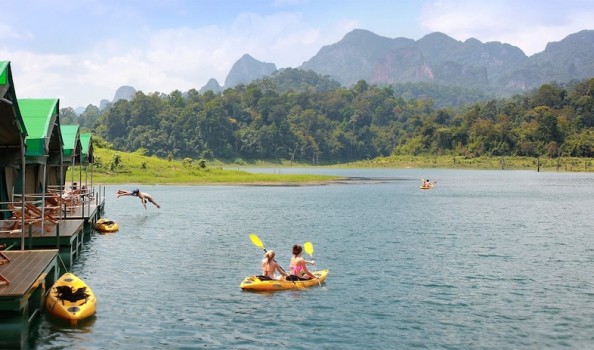 https://nakedhungrytraveller.com.au/between-beaches-in-thailand/ Between Beaches in Thailand
https://nakedhungrytraveller.com.au/between-beaches-in-thailand/ Between Beaches in ThailandThere’s a lot more to a holiday in Thailand than a beach.
Heading west to east from Khao Lak north of overcrowded Phuket, we leave the beaches behind and head for the hills, first stop, Elephant Hills Rainforest Camp nestled among the dominating limestone karst outcrops, jutting like rocky white spears into the humid air. If you know the scenery around Guilin in southern China or Halong Bay of Vietnam or Vang Vieng in Laos, the high peaks of southern Thailand may come as a surprise. The limestone peaks here are the highest of their kind in all of Southeast Asia, soaring up to 600 metres. Between the spires lies the greatest stretch of intact rainforest in southern Thailand. Khao Sok National Park is a hotspot of bio-diversity. Approximately halfway between the enormously popular islands of Phuket and Koh Samui, where Thailand’s international beach holiday experience is most strongly focused, lies this huge swathe of green rainforest, more than one hundred square kilometres of virtually unknown national park. Elephant Hills is privately owned, treading very lightly on its surrounds. At the main camp on the border of the park an Asian elephant sanctuary operates as a learning centre rather than a safari park. Here you don’t ride the elephants. You feed them and wash them. The whole two or three day ‘Jungle Safari’ is about interacting with the ecology, including some of the indigenous species such as the Asian elephants, rather than viewing them as if at a zoo. Within an hour of arriving at the camp, I’m in an open air kitchen, machete knife in hand, with large bowls of fruits and vegetables, bamboo stalks and banana fronds in front of me spread out over a large bench. Chop, slice and dice. The elephants are lining up for their afternoon feed and they don’t like to be kept waiting for lunch. For a moment, I’m reminded of an ‘All You Can Eat’ brunch buffet at a run down Las Vegas casino I once visited. The feeding is a frenzied affair. Some elephants chew while holding bananas, pineapple slices and pumpkin pieces curled in their trunks, waiting to be thrust into the endless operating machines that are their digestive processors. We can barely keep up chopping, slicing and dicing. Others politely finish eating what’s in their mouths before snatching from your hand the next course. Elephant etiquette is as varied as that practiced by humans; some individuals have no manners, some are gracious. Eventually the enormous piles of vegetable matter are consumed; something I didn’t believe possible when I first saw how much food was laid out. Indeed it’s an elephantine lunch. [caption id="attachment_1623" align="alignnone" width="448"]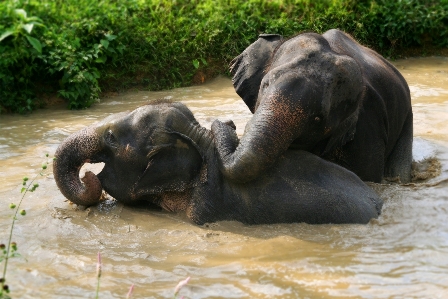 Bathing ellies near Khao Sok National Park.[/caption]
After the feast, we stroll down to a pond for a bath. Then we walk back to a common area for a wash and scrub. I’m handed a wad of twisted coir rope and a bucket of organic soap and water. One of my travelling companions holds a hose for rinsing. I dip the prickly sponge into the soapy water and scrub clean my elephant’s very full belly, around her tail, under her legs, her neck and behind her ears. She whacks me a few times with her trunk if I miss a remaining dirty spot. Rinsed as clean as a shiny new grey Mercedes, she squirts me one last time and wanders off to join her companions. By now, I’m covered in grime and badly need a shower.
[caption id="attachment_1622" align="alignnone" width="448"]
Bathing ellies near Khao Sok National Park.[/caption]
After the feast, we stroll down to a pond for a bath. Then we walk back to a common area for a wash and scrub. I’m handed a wad of twisted coir rope and a bucket of organic soap and water. One of my travelling companions holds a hose for rinsing. I dip the prickly sponge into the soapy water and scrub clean my elephant’s very full belly, around her tail, under her legs, her neck and behind her ears. She whacks me a few times with her trunk if I miss a remaining dirty spot. Rinsed as clean as a shiny new grey Mercedes, she squirts me one last time and wanders off to join her companions. By now, I’m covered in grime and badly need a shower.
[caption id="attachment_1622" align="alignnone" width="448"]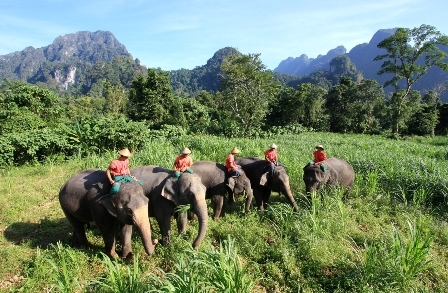 Near Elephant Camp outside Khao Sok National Park.[/caption]
Instead, our small group board canoes and paddle down a nearby river. Tree snakes loop around over hanging branches. Well hidden monkeys peer from behind dense foliage. A few sets of easy rapids and narrow channels create enough excitement to turn the doddle down the river into a slight thrill. After a few hours, we shore our canoes at a deep spot where ropes tied to large branches have been suspended over the water. Grabbing hold of one, I swing out over the water, let go and am cleansed of mud, sweat and elephant dung. The desire to yell out like Tarzan is barely suppressed.
[caption id="attachment_1624" align="alignnone" width="448"]
Near Elephant Camp outside Khao Sok National Park.[/caption]
Instead, our small group board canoes and paddle down a nearby river. Tree snakes loop around over hanging branches. Well hidden monkeys peer from behind dense foliage. A few sets of easy rapids and narrow channels create enough excitement to turn the doddle down the river into a slight thrill. After a few hours, we shore our canoes at a deep spot where ropes tied to large branches have been suspended over the water. Grabbing hold of one, I swing out over the water, let go and am cleansed of mud, sweat and elephant dung. The desire to yell out like Tarzan is barely suppressed.
[caption id="attachment_1624" align="alignnone" width="448"]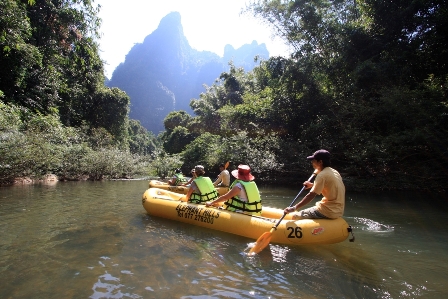 Elephant Hills kayak safari.[/caption]
Back at the tented camp, it’s time for a Mekong whisky and tonic, dinner and a chat with our hosts about wildlife, how the park evolved and its ongoing problems. Deforestation surrounding the park continues to be a challenge. Though Khao Sok’s total area is large, animals such at Asian elephants and Indo Chinese tigers require huge areas in which to thrive. Inbreeding presents a different set of problems as do poaching and water pollution.
Elephants Hills’ newest camp is on Cheow Larn Lake, which the Khao Sok national park completely encircles. The Cheow Larn dam was built in the 60s, sadly flooding one of southern Thailand’s last pristine river systems. The lake filled the deep valley, flushing out Thailand’s last insurgent communist strongholds, though the government at the time spruiked the hydroelectric power generation and clean water source for Surat Thani province as its main reasoning behind the dam’s construction. The dam’s destruction of riverine habitat also accompanied the expansion of another habitat, the rainforest itself. To protect the watershed around the lake, the park has become one of the last refuges for wildlife in this rapidly developing region.
There are a few other lake camps, mostly used by holidaying Thais, rarely by international travellers. Though these camps are integrated into the surrounding forests, their waste management, power generation and recycling facilities leave much to be desired.
[caption id="attachment_1626" align="alignnone" width="448"]
Elephant Hills kayak safari.[/caption]
Back at the tented camp, it’s time for a Mekong whisky and tonic, dinner and a chat with our hosts about wildlife, how the park evolved and its ongoing problems. Deforestation surrounding the park continues to be a challenge. Though Khao Sok’s total area is large, animals such at Asian elephants and Indo Chinese tigers require huge areas in which to thrive. Inbreeding presents a different set of problems as do poaching and water pollution.
Elephants Hills’ newest camp is on Cheow Larn Lake, which the Khao Sok national park completely encircles. The Cheow Larn dam was built in the 60s, sadly flooding one of southern Thailand’s last pristine river systems. The lake filled the deep valley, flushing out Thailand’s last insurgent communist strongholds, though the government at the time spruiked the hydroelectric power generation and clean water source for Surat Thani province as its main reasoning behind the dam’s construction. The dam’s destruction of riverine habitat also accompanied the expansion of another habitat, the rainforest itself. To protect the watershed around the lake, the park has become one of the last refuges for wildlife in this rapidly developing region.
There are a few other lake camps, mostly used by holidaying Thais, rarely by international travellers. Though these camps are integrated into the surrounding forests, their waste management, power generation and recycling facilities leave much to be desired.
[caption id="attachment_1626" align="alignnone" width="448"]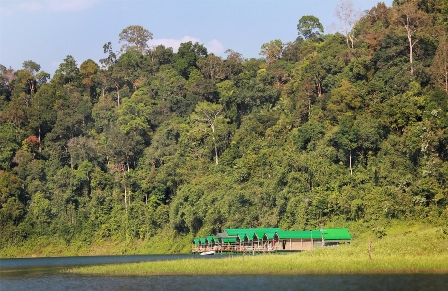 Khao Sok National Park Rainforest Camp on Cheow Larn lake.[/caption]
Much further up the lake from the other camps, Elephant Hills Cheow Larn Lake tented camp is completely isolated. Fully powered by solar cells and all water is treated on site before it’s allowed to re-enter the surrounding lake. The ten individual floating tents, insect proof with mosquito nets and flyscreens and all with ensuite bathrooms are models of sensible environmentally aware management and construction. Each tent has a kayak floating just outside its door. One main open air dining area serves as reception room, dining room, breakfast room and bar. It’s very small scale, very private and extremely secluded. In short, this is bliss for any traveller bent on escaping the crowded beaches of Phuket and Koh Samui.
As soon as I put my bag on a bench next to my bed, I step out on to my deck and jump into the emerald green waters of the lake, swimming out to look back at my floating tent, the white limestone mountains, the dense forest and feeling completely at ease.
[caption id="attachment_1620" align="alignnone" width="448"]
Khao Sok National Park Rainforest Camp on Cheow Larn lake.[/caption]
Much further up the lake from the other camps, Elephant Hills Cheow Larn Lake tented camp is completely isolated. Fully powered by solar cells and all water is treated on site before it’s allowed to re-enter the surrounding lake. The ten individual floating tents, insect proof with mosquito nets and flyscreens and all with ensuite bathrooms are models of sensible environmentally aware management and construction. Each tent has a kayak floating just outside its door. One main open air dining area serves as reception room, dining room, breakfast room and bar. It’s very small scale, very private and extremely secluded. In short, this is bliss for any traveller bent on escaping the crowded beaches of Phuket and Koh Samui.
As soon as I put my bag on a bench next to my bed, I step out on to my deck and jump into the emerald green waters of the lake, swimming out to look back at my floating tent, the white limestone mountains, the dense forest and feeling completely at ease.
[caption id="attachment_1620" align="alignnone" width="448"]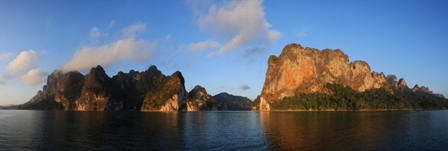 Cheow Larn Lake in Khao Sok National Park.[/caption]
Exploring this rare forest by kayaking through narrow channels is exhilarating and simply wonderful. Flocks of hornbills fly from one tree to the next, honking their weird calls directly overhead. Lars gibbons hoot constantly. Kingfishers dart among banks of reeds, flashing blue and green while diving for tiny fish.
I’m told that a local fisherman recently tied his boat to a tree near the camp, walked into the forest, returned and found a clouded leopard asleep in his seat. Wild elephants come down to the lake to drink. Tapirs, fishing cats, tigers, wild pigs, pangolin, Asian ox and deer inhabit its fringes.
With permission from the camp manager, I embark by kayak for a solo dawn exploration. I’m hoping to see elephants or if I’m very lucky, a tiger. I’m alone on a big lake. Over 100 kilometres of countless channels and dozens of little islands constitute Cheow Larn’s expanse. I paddle silently while the sun rises over mist enshrouded peaks. Gibbons begin to hoot, claiming their territory, announcing in gibbon-ese from across the lake, ‘We’re here! Nice day isn’t it?’ I lie back in the kayak, close my eyes and revel in my solitude.
No tigers sighted that morning or elephants either, but the gibbons and hornbills prove good company anyway.
Naked Facts:
Accommodation and transports to Elephant Hills Rainforest and Cheow Larn Lake camps can be booked here: www.elephant-hills.com
Cheow Larn Lake in Khao Sok National Park.[/caption]
Exploring this rare forest by kayaking through narrow channels is exhilarating and simply wonderful. Flocks of hornbills fly from one tree to the next, honking their weird calls directly overhead. Lars gibbons hoot constantly. Kingfishers dart among banks of reeds, flashing blue and green while diving for tiny fish.
I’m told that a local fisherman recently tied his boat to a tree near the camp, walked into the forest, returned and found a clouded leopard asleep in his seat. Wild elephants come down to the lake to drink. Tapirs, fishing cats, tigers, wild pigs, pangolin, Asian ox and deer inhabit its fringes.
With permission from the camp manager, I embark by kayak for a solo dawn exploration. I’m hoping to see elephants or if I’m very lucky, a tiger. I’m alone on a big lake. Over 100 kilometres of countless channels and dozens of little islands constitute Cheow Larn’s expanse. I paddle silently while the sun rises over mist enshrouded peaks. Gibbons begin to hoot, claiming their territory, announcing in gibbon-ese from across the lake, ‘We’re here! Nice day isn’t it?’ I lie back in the kayak, close my eyes and revel in my solitude.
No tigers sighted that morning or elephants either, but the gibbons and hornbills prove good company anyway.
Naked Facts:
Accommodation and transports to Elephant Hills Rainforest and Cheow Larn Lake camps can be booked here: www.elephant-hills.com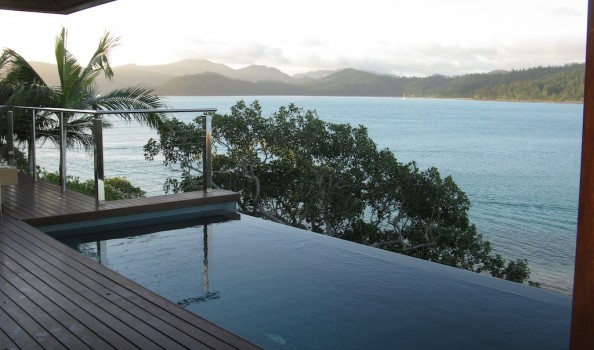 https://nakedhungrytraveller.com.au/whats-a-qualia/ What’s a Qualia?
https://nakedhungrytraveller.com.au/whats-a-qualia/ What’s a Qualia?The Whitsunday Islands in Queensland have a new star.
Qualia, according to its cashed-up owners, the Oatley family (yes, they sold Rosemount Wines to Southcorp with perfect timing, wine sales have dropped out the bottom of the proverbial spit bucket since then) comes from the Latin, ‘quality of conscious experience’, implying that Qualia’s discerning guests should know the difference between humdrum and bespoke. When I last visited Hamilton Island, in the Whitsunday group of islands midway up Queensland’s Great Barrier Reef between Townsville and Mackay, it looked like a small version of the Gold Coast, or Miami or worse. Three high rises poke up beside the island’s single accessible beach. Another monstrosity overlooks the airport, not exactly indicating a quality conscious experience unless you were blind, deaf and dumb. But post Oatley takeover and $300 million investment into infrastructure and an all round tidy up, old Hamilton is looking decidedly better. Gone is Keith Williams and his dream of creating a lagoon for a humpback whale just off Hamilton’s only beach. Yes, I kid you not. Old Williams intended to show his greenie stripes by corralling a large migratory whale into a small space for the education of the ignorant masses. The Oatley family is much smarter and greener. Unlike many people with excess cash, they have taste. [caption id="attachment_1658" align="alignnone" width="448"]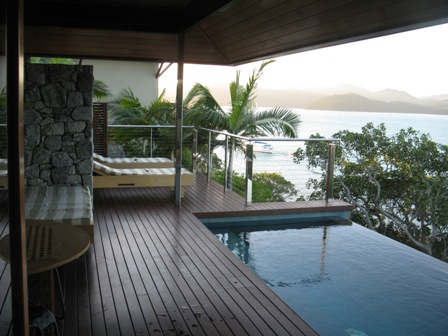 Pool Pavilion exterior.[/caption]
Qualia resort provides singularly excellent accommodation. It’s low-keyed in all the right places. No kids. No noise. No planned activities and no jet-skies. Woo Hoo!
[caption id="attachment_1653" align="alignnone" width="448"]
Pool Pavilion exterior.[/caption]
Qualia resort provides singularly excellent accommodation. It’s low-keyed in all the right places. No kids. No noise. No planned activities and no jet-skies. Woo Hoo!
[caption id="attachment_1653" align="alignnone" width="448"]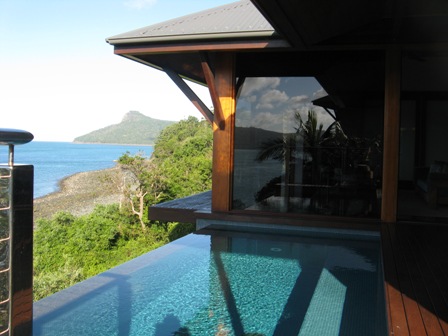 Qualia pool pavilion exterior.[/caption]
There are no rooms here. There are instead, pavilions. Half of the pavilions are on the leeward side and have no pools. The other half of the slightly larger pavilions are positioned on a hillside facing the windward side, each having its own infinity pool. Guests are appointed their own revved up golf buggy to get around the resort and the island. Service is of the sort that is so subtle and yet so efficient that I forgot that I was in Queensland. My golf buggy was recharged overnight by a special buggy man who patrols the pavilions in the dead of night ensuring that they’re plugged in and ready to zoom the next morning hooning guests down for breakfast to either of two dining rooms, one overlooking a drop dead gorgeous beachside pool, the other overlooking the drop-dead gorgeous Whitsunday Passage. Tough choice. Breakfast is incidentally the best resort breakfast I’ve ever eaten in Australia. Bowls of fresh passionfruit, raspberries, figs, sweet strawberries and whatever fruit is in season that actually tastes real. And freshly squeezed orange juice or the house blend of freshly squeezed mixed fruits. And real coffee out of an espresso machine operated by well trained staff, or real leaf tea in a real heated pot. Real Eggs Benedict or real omelettes with imaginative ingredients. I shouldn’t have to list these necessities but so often it’s done so badly in 99% of resorts that I feel I should call attention to the difference.
[caption id="attachment_1654" align="alignnone" width="448"]
Qualia pool pavilion exterior.[/caption]
There are no rooms here. There are instead, pavilions. Half of the pavilions are on the leeward side and have no pools. The other half of the slightly larger pavilions are positioned on a hillside facing the windward side, each having its own infinity pool. Guests are appointed their own revved up golf buggy to get around the resort and the island. Service is of the sort that is so subtle and yet so efficient that I forgot that I was in Queensland. My golf buggy was recharged overnight by a special buggy man who patrols the pavilions in the dead of night ensuring that they’re plugged in and ready to zoom the next morning hooning guests down for breakfast to either of two dining rooms, one overlooking a drop dead gorgeous beachside pool, the other overlooking the drop-dead gorgeous Whitsunday Passage. Tough choice. Breakfast is incidentally the best resort breakfast I’ve ever eaten in Australia. Bowls of fresh passionfruit, raspberries, figs, sweet strawberries and whatever fruit is in season that actually tastes real. And freshly squeezed orange juice or the house blend of freshly squeezed mixed fruits. And real coffee out of an espresso machine operated by well trained staff, or real leaf tea in a real heated pot. Real Eggs Benedict or real omelettes with imaginative ingredients. I shouldn’t have to list these necessities but so often it’s done so badly in 99% of resorts that I feel I should call attention to the difference.
[caption id="attachment_1654" align="alignnone" width="448"] View from pool pavilion windward side over Whitsunday Passage.[/caption]
Dinners and lunches are of equal standard. The Long Pavilion chef, Jane-Therese Mulry worked with Marco Pierre White in London. She was the only female allowed into White’s misogynistic realm, quite an achievement actually and surprising as Jane-Therese is quite petite. But she’s a damned fine chef. After a few days of hard yakka at Qualia I needed to spend more time in my windward pavilion in order to drink the Rothschild 06 Rose Champagne left chilling in an ice bucket while watching one of over 200 films available on the high-def widescreen television in my lounge room overlooking Whitsunday Island and the occasional sea turtle swimming by. Jane-Therese sent via speedy golf buggy a 3-course meal so I could plop myself in front of the Champagne, the turtles and the 2nd part of the Twilight film series. Deadened, wooden acting never looked so good.
[caption id="attachment_1659" align="alignnone" width="448"]
View from pool pavilion windward side over Whitsunday Passage.[/caption]
Dinners and lunches are of equal standard. The Long Pavilion chef, Jane-Therese Mulry worked with Marco Pierre White in London. She was the only female allowed into White’s misogynistic realm, quite an achievement actually and surprising as Jane-Therese is quite petite. But she’s a damned fine chef. After a few days of hard yakka at Qualia I needed to spend more time in my windward pavilion in order to drink the Rothschild 06 Rose Champagne left chilling in an ice bucket while watching one of over 200 films available on the high-def widescreen television in my lounge room overlooking Whitsunday Island and the occasional sea turtle swimming by. Jane-Therese sent via speedy golf buggy a 3-course meal so I could plop myself in front of the Champagne, the turtles and the 2nd part of the Twilight film series. Deadened, wooden acting never looked so good.
[caption id="attachment_1659" align="alignnone" width="448"]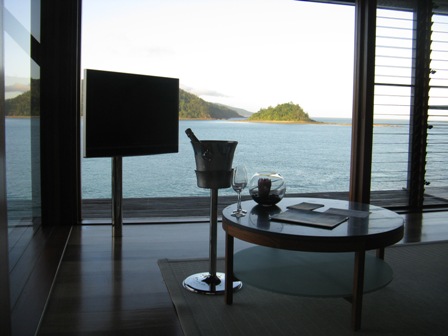 Pool pavilion. Champagne chilled and waiting.[/caption]
In one’s own pavilion no one can hear nasty comments about Robert Pattinson’s perfect hair, see one lick the plates clean, or drain the entire contents of a lovely bottle of Champagne either. I waddled back to my dream sleep bed, feet pointing in the direction of heaven and sighed my contented self into the most peaceful slumber I’ve had in years.
[caption id="attachment_1655" align="alignnone" width="448"]
Pool pavilion. Champagne chilled and waiting.[/caption]
In one’s own pavilion no one can hear nasty comments about Robert Pattinson’s perfect hair, see one lick the plates clean, or drain the entire contents of a lovely bottle of Champagne either. I waddled back to my dream sleep bed, feet pointing in the direction of heaven and sighed my contented self into the most peaceful slumber I’ve had in years.
[caption id="attachment_1655" align="alignnone" width="448"]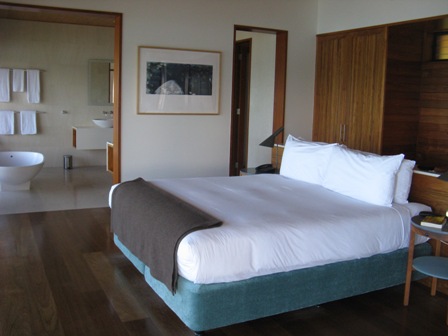 Qualia pool pavilion bed.[/caption]
If the stress of avoiding the occasional child on a scooter or obese tourist on a very slow buggy heading up Hamilton’s steep hills, a visit to Spa Qualia is in order. Using Li’Tya products, made from all Australian ingredients derived from nature (I read the press material), my masseuse rubbed me luxuriously into another long nap state. I had a signature Qualia massage using a Li’Tya oil that I chose from four bespoke oils made specially for people whose noses are not out of joint. After my massage I had a Vichy shower in an outside garden filled with native plants. I think my buggy began to drive itself after that experience; my feet didn’t touch the pedals and steering just appeared to happen without guidance from me.
[caption id="attachment_1656" align="alignnone" width="448"]
Qualia pool pavilion bed.[/caption]
If the stress of avoiding the occasional child on a scooter or obese tourist on a very slow buggy heading up Hamilton’s steep hills, a visit to Spa Qualia is in order. Using Li’Tya products, made from all Australian ingredients derived from nature (I read the press material), my masseuse rubbed me luxuriously into another long nap state. I had a signature Qualia massage using a Li’Tya oil that I chose from four bespoke oils made specially for people whose noses are not out of joint. After my massage I had a Vichy shower in an outside garden filled with native plants. I think my buggy began to drive itself after that experience; my feet didn’t touch the pedals and steering just appeared to happen without guidance from me.
[caption id="attachment_1656" align="alignnone" width="448"]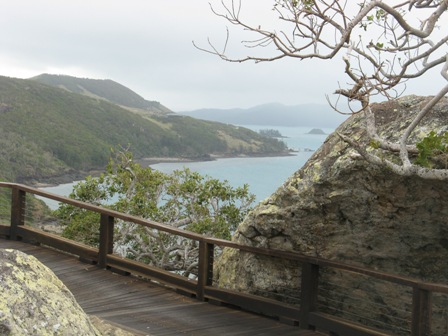 Hamilton Island's steep hillsides make for demanding buggy driving.[/caption]
Once past the silly gigantic Jurassic Park-like entrance gates, Qualia is a world away from good old daggy Hamilton Island. I swear I didn’t know that Keith Williams and his gang of white shoes straight from destroying Queensland’s Gold Coast had ever laid a heavy hand on Hamilton, such is the effect that Qualia has on me.
[caption id="attachment_1657" align="alignnone" width="448"]
Hamilton Island's steep hillsides make for demanding buggy driving.[/caption]
Once past the silly gigantic Jurassic Park-like entrance gates, Qualia is a world away from good old daggy Hamilton Island. I swear I didn’t know that Keith Williams and his gang of white shoes straight from destroying Queensland’s Gold Coast had ever laid a heavy hand on Hamilton, such is the effect that Qualia has on me.
[caption id="attachment_1657" align="alignnone" width="448"]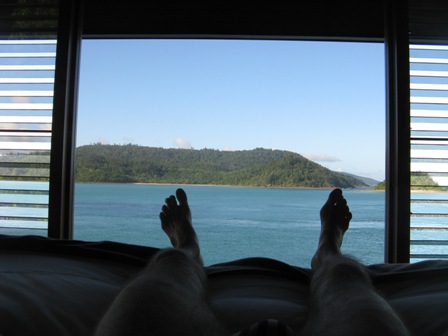 View from bed with author's feet.[/caption]
Now there is a logical reason to visit Hamilton Island, to get away from it all. Never did I imagine I would utter those words in reference to Hamilton Island but Qualia made me do it.
Naked Facts:
See www.Qualia.com.au for reservations and special packages. Qualia plays host to the Great Barrier Feast, a three day celebration of all things tasty and delicious in late November.
View from bed with author's feet.[/caption]
Now there is a logical reason to visit Hamilton Island, to get away from it all. Never did I imagine I would utter those words in reference to Hamilton Island but Qualia made me do it.
Naked Facts:
See www.Qualia.com.au for reservations and special packages. Qualia plays host to the Great Barrier Feast, a three day celebration of all things tasty and delicious in late November.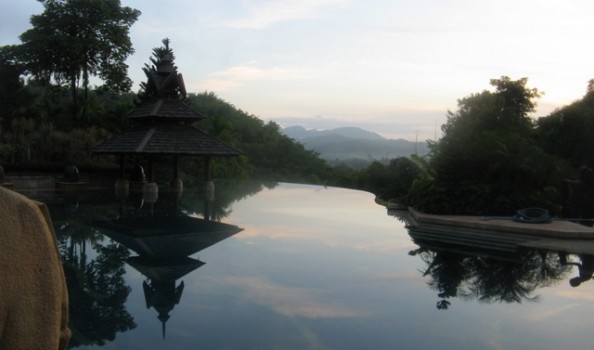 https://nakedhungrytraveller.com.au/opium-and-elephants-in-the-golden-triangle/ Opium and Elephants in the Golden Triangle
https://nakedhungrytraveller.com.au/opium-and-elephants-in-the-golden-triangle/ Opium and Elephants in the Golden TriangleCombined success stories: rescuing elephants from a life of street walking and people from drug addiction, the Golden Triangle reveals its latest quixotic changes.
Rising up from the nearby banks of the Mekong River, a modern monolith emerges from surrounding forest. Marble and concrete, bunker-ish and austerely graceful, resembling any number of museums scattered around the world. Yet, its location is certainly off the beaten track, as far north in Thailand as it’s possible to go. Burma and Laos are literally within easy view. Former Alaskan Governor and Vice-Presidential candidate Sarah Palin could say truthfully, ‘I can see Burma and Laos from my house.’ Strange place for a museum you ask? Welcome to the Hall of Opium, a project begun in 1994 by HRH Princess Srinagarindra, the late Princess Mother of His Majesty the King of Thailand. Devoted to all things narcotic; it’s a museum filled with intelligently designed exhibits pertaining to drugs from around the world, though the emphasis here is on opium. After all, we’re smack dab in the middle of the fabled Golden Triangle. In 1988, 88 years old and quite frail, the Princess Mother declared that she would devote the remainder of her life to restoring the region to its historic position as one of the country’s most agriculturally and culturally rich. Her work fixed on reforesting the denuded hillsides, ridding the destitute population from the evils of opium poppy production and securing productive employment for all inhabitants. Not bad for a feisty lady near the end of a long life. She died in 1995, as old as the century but she achieved the goals she set out in 1988. The video clip shown in the main theatre as part of the museum’s introduction includes a long shot of the Princess Mother’s helicopter descending from a bright sky, settling onto a bare patch of earth. She emerges from the cabin, a tiny hand resting on a loyal retainer’s arm. Facing the camera with sagaciously passionate eyes, she announces that she will commit her remaining energy to saving the people from poverty and corruption. It’s like watching an angel coming down from heaven. Prior to the Princess Mother’s involvement, the region was off limits to travellers. Kidnapping, robbery, banditry; they were all serious deterrents to any visitor. Even the Thai police force had given up taming this lawless corner in the north. A local warlord ran the province like a private fiefdom, extorting farmers to grow more poppies, paying them a pittance, harassing them when they didn’t toe the line. Murders and rape were common crimes. Now it’s a changed landscape. The greening project has worked. The Royal Family’s agricultural project focussed on encouraging Arabica coffee bean and cashew nut plantations as well as numerous other safe cash crops such as organic vegetable production. Schools have reopened as have health clinics. Ethnically diverse hill tribes occupy their loftily situated villages with peaceful impunity. From a mess of intrigue and danger, the region has become one of tranquillity and fecundity. The Princess Mother’s reforestation project has succeeded. Formerly barren slopes are once again vegetated, erosion problems mostly solved. Key to reminding travellers in the region how important this change has been is the Hall of Opium, the locus of the Golden Triangle Park. The museum successfully provides visitors with a balanced overview of the history of drug addiction and drug production. From the beginnings of mankind’s fascination with hallucinatory drugs such as mushrooms, once used by shamans to obtain a trance state in order to forecast events, to the current domination of cheap mass produced drugs such as crystal methamphetamine, ‘ice’, the museum’s clearly detailed exhibits cover the drug gamut. From the Opium Wars between Britain and China to contemporary cocaine production in Colombia, from deceptively addictive medical marvels such as morphine, to the overall effects of drugs and efforts to curb global drug use, it’s all here, simply presented. Though the educational emphasis is placed on detrimental effects of drug use, it’s done with a lightly edifying touch, not patronising but with compassion and tact. A brief walk across the road from the Hall of Opium reveals the Anantara Resort Golden Triangle and Asian Elephant Foundation Camp. If you’re considering becoming a professional mahout, this is as good a place as any in which to explore a possible career change. The camp operates as an elephant sanctuary, a home for rescued elephants and their families. Rather than simply buying the elephants from indigent mahouts, the hotel management team purchases the entire kit and caboodle: elephant, mahout, his wife (mahout work in Thailand is universally male dominated) and family. Though it may look as if humans as well as the elephants are up for sale, it’s not the case. Were the elephant bought from the mahout, he would buy another elephant from a dealer, likely illegally sourced from the wild population in either Laos or Burma where the species is under serious threat. They’d both soon be on the road again begging for money from tourists keen to exchange 50 baht for a photo but who wouldn’t know a suffering elephant from an imitation Gucci bag. Touting for treats, Thai street elephants lead lives of appalling squalor, suffering from hearing loss due to traffic noise, impaired vision due to dust and terrible malnutrition, among other chronic ailments. Their owners live similar lives, marginalised from society and in a penurious state, paying off corrupt police to stay on the road and living literally hand-to-mouth. It’s a bleak situation for both man and animal. Stepping in as rescuers, the Asian Elephant Foundation Camp based at Anantara Resort Golden Triangle operates with scant resources, relying on guests’ donations and charity events such as the annual Elephant Polo match in Hua Hin to keep the project going. The hotel management, elephants and mahout families work together, offering guests a variety of mahout classes and lessons in elephant human interaction, all coordinated by an expert team. The mahouts work with healthy well-cared for animals in a safe environment. Coincidentally, their wives have organised a cooperative silk weaving industry and are making more money than their husbands, much to their delight. I witnessed a merry atmosphere during a visit to their small shop and factory at the camp. The fabrics aren’t cheap but they’re selling well, hence the satisfied looks. The families live in clean though simple wooden houses, their kids go to school. Food is plentiful and nutritious. Modern sanitation, medical clinics, recreation activities and shared interests, they’re all here. It’s as if an elephant and mahout Utopia found itself a perfect place in which to thrive. In a part of the world where success stories are few and far between, this is one sure thing. The elephants live contentedly, well fed and busy. Though they will never be returned to the wild, their lives are far better than they would be on the street. The same goes for the mahouts. Instead of relentless daily problems faced in a continual search for food and money, they live peacefully among the animals they love. And it is love. The bond between mahout and elephant is a very strong one. Once, they shared victimisation. Now they share a modest bounty. Watching the two species working together is humbling. The elephants could easily crush their co-workers. Instead they permit the mahouts to become close; it’s an intimate relationship between men and animal that is rarely observed in our modern world. [caption id="attachment_1995" align="alignnone" width="329"]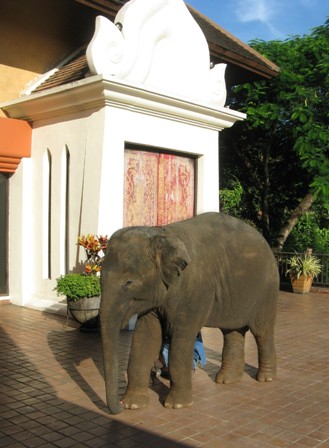 Adolescent elephant joins guests for breakfast at Anantara Golden Triangle resort.[/caption]
As a visitor, you can interact as much as your boundaries permit. During the classes in elephant handling, the mahouts are with you every moment, correcting missteps, yours and the elephants. You’re given a beginner’s dictionary of elephant mahout speak, a mix of Thai, northern Thai and elephant languages, itself an intriguing combination of vocal commands and body movements.
My elephant, Bhoona, is a 32 year old matriarch, a gentle lady whose sheer bulk belies her dainty foot movements. Handing small bananas to her trunk while I balance on her neck, she shoves several at once into her mouth and devours them with relish, walking at the same time, a feat many humans find difficult to replicate strolling down a city street whilst chewing gum. I guide her forward along a muddy path as we head across country for an afternoon bath with some of her fellow elephants like a party of adolescents and adults all out for a jolly piscine excursion. ‘Pai, Bhoona, pai,’ I repeatedly urge, my bare feet tickling her ears. Forward, Bhoona, forward. ‘How, Bhoona!’ Stop Bhoona, I say, gently squeezing my thighs around her neck as we outpace the mahout walking alongside. Once in the water, I try, ‘Dum Lung, Bhoona.’ Submerge your head in water Bhoona. She does. I swim above her, dodging dung floating past while Bhoona disappears completely into the murky depths. Paddling in a tight circle somewhere above my submerged elephant, I keep my eyes on her flatulent companions. How long can an elephant hold her breath? Long enough for the dung balls to come very close is how long. I’m reminded of swimming at Bondi beach before the sewage outfall pipe began operating. Two minutes? A blast of water erupts from a grey trunk. It looks like a prehistoric periscope. I aim for Bhoona’s gigantic bulk while it rises up underneath me. I straddle her neck again as she rights herself, a sensation akin to negotiating an escalator during an earthquake. I’m entirely at her mercy. We’re both soaking wet. We’ve had a bath together, a peculiarly intimate experience. Now, I really need a shower with lots of soap and to wash my muddy dung smeared clothes. Bhoona snorts and reaches for more bananas while we walk back to the camp, but I’ve run out, the remaining fruit floated away. I haven’t learned how to say, ‘Yes, we have no bananas,’ in Thai-elephant-ese but I figure that Bhoona knows that already. She’s one smart elephant.
Naked Facts:
The Hall of Opium Golden Triangle Park is approximately 60 kilometres north of Chiang Rai’s airport. Open from 8:30 to 16:00 Tuesday to Sunday. Entry fees: BHT 300 for foreign visitors.
Ph: 66 (0) 5378 4444-6
See www.maefahluang.org for further details.
Anantara Resort Golden Triangle
229 Moo 1 Chiang Saen, Chiang Rai, 57150 Thailand
Ph: 66 (0) 5378 4084
Email: infogt@anantara.com
Reservations: 66 (0) 2477 0760
Info: www.anantara.com
The four day Mahout Discovery Package starts from THB 10,850 per person per night for a single room and includes breakfast, mahout training and entry to the Hall of Opium.
Getting there:
Thai Airways has the best connections to Chiang Rai from its hub in Bangkok. Domestic connections to Chiang Rai airport operate daily. See www.thaiairways.com
Adolescent elephant joins guests for breakfast at Anantara Golden Triangle resort.[/caption]
As a visitor, you can interact as much as your boundaries permit. During the classes in elephant handling, the mahouts are with you every moment, correcting missteps, yours and the elephants. You’re given a beginner’s dictionary of elephant mahout speak, a mix of Thai, northern Thai and elephant languages, itself an intriguing combination of vocal commands and body movements.
My elephant, Bhoona, is a 32 year old matriarch, a gentle lady whose sheer bulk belies her dainty foot movements. Handing small bananas to her trunk while I balance on her neck, she shoves several at once into her mouth and devours them with relish, walking at the same time, a feat many humans find difficult to replicate strolling down a city street whilst chewing gum. I guide her forward along a muddy path as we head across country for an afternoon bath with some of her fellow elephants like a party of adolescents and adults all out for a jolly piscine excursion. ‘Pai, Bhoona, pai,’ I repeatedly urge, my bare feet tickling her ears. Forward, Bhoona, forward. ‘How, Bhoona!’ Stop Bhoona, I say, gently squeezing my thighs around her neck as we outpace the mahout walking alongside. Once in the water, I try, ‘Dum Lung, Bhoona.’ Submerge your head in water Bhoona. She does. I swim above her, dodging dung floating past while Bhoona disappears completely into the murky depths. Paddling in a tight circle somewhere above my submerged elephant, I keep my eyes on her flatulent companions. How long can an elephant hold her breath? Long enough for the dung balls to come very close is how long. I’m reminded of swimming at Bondi beach before the sewage outfall pipe began operating. Two minutes? A blast of water erupts from a grey trunk. It looks like a prehistoric periscope. I aim for Bhoona’s gigantic bulk while it rises up underneath me. I straddle her neck again as she rights herself, a sensation akin to negotiating an escalator during an earthquake. I’m entirely at her mercy. We’re both soaking wet. We’ve had a bath together, a peculiarly intimate experience. Now, I really need a shower with lots of soap and to wash my muddy dung smeared clothes. Bhoona snorts and reaches for more bananas while we walk back to the camp, but I’ve run out, the remaining fruit floated away. I haven’t learned how to say, ‘Yes, we have no bananas,’ in Thai-elephant-ese but I figure that Bhoona knows that already. She’s one smart elephant.
Naked Facts:
The Hall of Opium Golden Triangle Park is approximately 60 kilometres north of Chiang Rai’s airport. Open from 8:30 to 16:00 Tuesday to Sunday. Entry fees: BHT 300 for foreign visitors.
Ph: 66 (0) 5378 4444-6
See www.maefahluang.org for further details.
Anantara Resort Golden Triangle
229 Moo 1 Chiang Saen, Chiang Rai, 57150 Thailand
Ph: 66 (0) 5378 4084
Email: infogt@anantara.com
Reservations: 66 (0) 2477 0760
Info: www.anantara.com
The four day Mahout Discovery Package starts from THB 10,850 per person per night for a single room and includes breakfast, mahout training and entry to the Hall of Opium.
Getting there:
Thai Airways has the best connections to Chiang Rai from its hub in Bangkok. Domestic connections to Chiang Rai airport operate daily. See www.thaiairways.com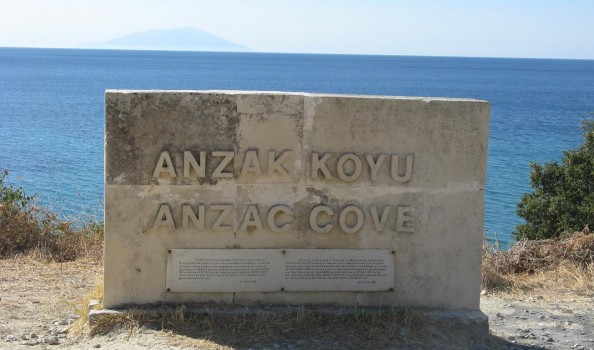 https://nakedhungrytraveller.com.au/turn-left-when-you-leave-istanbul/ Turn Left When You Leave Istanbul
https://nakedhungrytraveller.com.au/turn-left-when-you-leave-istanbul/ Turn Left When You Leave IstanbulIt’s a new Turkey on the road from Troy to Halicarnassus.
Travellers from Europe and Australasia tend to go directly from Istanbul to Gallipolis for obvious reasons, to engage in an ANZAC tradition. Other visitors veer off in the direction of Troy (Truva) but without going too far off this well-trod track, another Turkey, one that is equal parts old and new emerges with surprisingly little driving involved. From Gallipolis a short ferry trip across the Dardanelles, better known ages ago as the Hellespont, all roads lead to Canakkale and Troy. [caption id="attachment_1702" align="alignnone" width="448"] Gallipoli Peninsula countryside looking southeast to The Dardanelles.[/caption]
Ancient Troy’s nine layers of history confounded archaeologists since Heinrich Schliemann expressed amazement at purportedly seeing the treasure of King Priam back in the 1870s. A UNESCO World Heritage Site for several years, the ruins begin to make sense to the visitor since better signage was installed. Still, it’s a complex puzzle that requires leaps of imagination that would daunt a modern Hercules.
[caption id="attachment_1685" align="alignnone" width="448"]
Gallipoli Peninsula countryside looking southeast to The Dardanelles.[/caption]
Ancient Troy’s nine layers of history confounded archaeologists since Heinrich Schliemann expressed amazement at purportedly seeing the treasure of King Priam back in the 1870s. A UNESCO World Heritage Site for several years, the ruins begin to make sense to the visitor since better signage was installed. Still, it’s a complex puzzle that requires leaps of imagination that would daunt a modern Hercules.
[caption id="attachment_1685" align="alignnone" width="448"]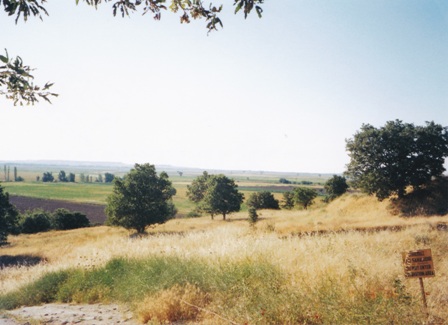 The plain of Troy looking towards The Dardanelles.[/caption]
With American and German archaeology teams continuing to make headway as they dig deeper into Troy’s incomparable past, the unravelling is becoming clearer. It is an evocative site. The barely cultivated plains stretch to the sea much as they did centuries ago, poppies bloom in profusion and goats forage amongst the wild herbs, bleating peacefully, their backsides often directed to the nearby Mediterranean. With a little imagination the wind blowing through the stones will carry the voices of Achilles, Hector, Helen, Paris and a few Trojan Women as well.
[caption id="attachment_1686" align="alignnone" width="448"]
The plain of Troy looking towards The Dardanelles.[/caption]
With American and German archaeology teams continuing to make headway as they dig deeper into Troy’s incomparable past, the unravelling is becoming clearer. It is an evocative site. The barely cultivated plains stretch to the sea much as they did centuries ago, poppies bloom in profusion and goats forage amongst the wild herbs, bleating peacefully, their backsides often directed to the nearby Mediterranean. With a little imagination the wind blowing through the stones will carry the voices of Achilles, Hector, Helen, Paris and a few Trojan Women as well.
[caption id="attachment_1686" align="alignnone" width="448"] The ancient ruins of Troy are multi-layered.[/caption]
The ersatz wooden Trojan horse placed at the entrance to the ruins is a modern addition placed to add veracity to history. If anything it’s certainly a prime photo opportunity in situ. Disney would have loved it. It also bears about as much resemblance to Brad Pitt’s Achilles in Troy as a badly packed kebab does to fine dining but that’s completely off track.
[caption id="attachment_1687" align="alignnone" width="448"]
The ancient ruins of Troy are multi-layered.[/caption]
The ersatz wooden Trojan horse placed at the entrance to the ruins is a modern addition placed to add veracity to history. If anything it’s certainly a prime photo opportunity in situ. Disney would have loved it. It also bears about as much resemblance to Brad Pitt’s Achilles in Troy as a badly packed kebab does to fine dining but that’s completely off track.
[caption id="attachment_1687" align="alignnone" width="448"]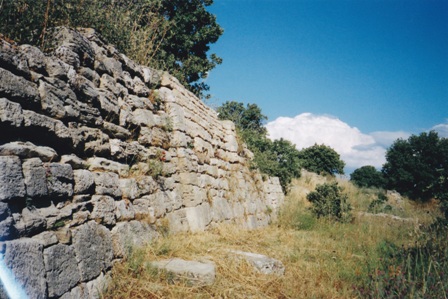 An excavated section of the ancient walls of Troy.[/caption]
Leaving Troy and Canakkale behind, a quick trip over the heavily forested Ida Mountains to the port of Ayvalik leads to a setting of cheek by jowl seaside resorts encircled by dense olive groves. The beaches leave much to be desired though the waterside fish restaurants serve up an enticing array of local produce. Turkish wines are available at most restaurants; vineyards spread throughout the Dardanelles region. Sample the local grog before it becomes outrageously trendy. Failing a chilled wine or beer, most Turks prefer raki (pronounced raka) with water as the drink to go with grilled fish. Why not begin with a raki and then try a local Chardonnay/Colombard blend? In this most secular of Islamic nations, booze is cheap and readily available.
Ayvalik’s spectacular coastal scenery retreats as the road leads inland to modern Pergama a.k.a. Pergamum, one of Mediterranean history’s most stunning sites posed majestically atop a rocky promontory overlooking the busy trade route below.
[caption id="attachment_1689" align="alignnone" width="448"]
An excavated section of the ancient walls of Troy.[/caption]
Leaving Troy and Canakkale behind, a quick trip over the heavily forested Ida Mountains to the port of Ayvalik leads to a setting of cheek by jowl seaside resorts encircled by dense olive groves. The beaches leave much to be desired though the waterside fish restaurants serve up an enticing array of local produce. Turkish wines are available at most restaurants; vineyards spread throughout the Dardanelles region. Sample the local grog before it becomes outrageously trendy. Failing a chilled wine or beer, most Turks prefer raki (pronounced raka) with water as the drink to go with grilled fish. Why not begin with a raki and then try a local Chardonnay/Colombard blend? In this most secular of Islamic nations, booze is cheap and readily available.
Ayvalik’s spectacular coastal scenery retreats as the road leads inland to modern Pergama a.k.a. Pergamum, one of Mediterranean history’s most stunning sites posed majestically atop a rocky promontory overlooking the busy trade route below.
[caption id="attachment_1689" align="alignnone" width="448"]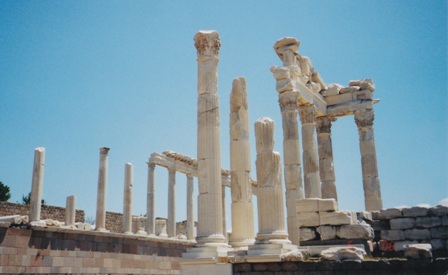 Pergama's Asklepion temple ruins.[/caption]
Here was the renowned Asklepion, an education centre for medicine and healing known throughout the ancient world. It was also a royal sanctuary.
[caption id="attachment_1688" align="alignnone" width="448"]
Pergama's Asklepion temple ruins.[/caption]
Here was the renowned Asklepion, an education centre for medicine and healing known throughout the ancient world. It was also a royal sanctuary.
[caption id="attachment_1688" align="alignnone" width="448"]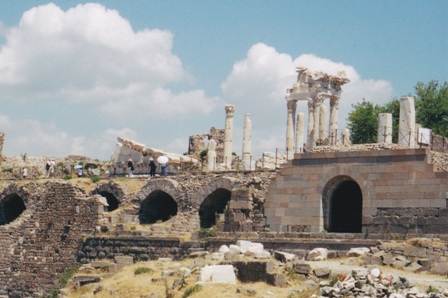 A section of Pergama's Asklepion temple.[/caption]
Six ruined palaces set in one street confirm the rulers’ preferred location next to the Roman fortress and armoury. Pergamum is also a modern wonder. The ancient theatre with seating for over 10,000 is still used today. The acoustics are marvellous. A day spent at Pergamum is a day well spent even if the drive to Selcuk and Ephesus is rushed. The new toll road through Izmir accelerates this progress. I noticed that the 110 k.p.h. limit is paid little attention, though the police do regular patrols. Beware of speed cameras.
Selcuk is within a bicyclist’s saunter to the ruins of Ephesus. The remains are in such a well-preserved state that little imagination is required in which to recreate its reputation as an important metropolitan crossroads.
[caption id="attachment_1701" align="alignnone" width="336"]
A section of Pergama's Asklepion temple.[/caption]
Six ruined palaces set in one street confirm the rulers’ preferred location next to the Roman fortress and armoury. Pergamum is also a modern wonder. The ancient theatre with seating for over 10,000 is still used today. The acoustics are marvellous. A day spent at Pergamum is a day well spent even if the drive to Selcuk and Ephesus is rushed. The new toll road through Izmir accelerates this progress. I noticed that the 110 k.p.h. limit is paid little attention, though the police do regular patrols. Beware of speed cameras.
Selcuk is within a bicyclist’s saunter to the ruins of Ephesus. The remains are in such a well-preserved state that little imagination is required in which to recreate its reputation as an important metropolitan crossroads.
[caption id="attachment_1701" align="alignnone" width="336"] Ephesus main street looking towards the library.[/caption]
It’s all here; popular houses of prostitution and a very public dunny included. Who didn’t pass through Ephesus two thousand years ago? It’s a very short list of the who’s who of antiquity. The Virgin Mary supposedly spent her last years in a little house above the ruins. Look for the signs to Mother Mary’s House to find her shrine on the hill. Ephesus also claims one of the ancient world’s seven wonders, the great Temple of Artemis. Though the temple has disappeared the foundation is visible; it’s huge. If that isn’t enough, the nearly intact library and theatre are much easier for the mind to conjure on a grand scale.
[caption id="attachment_1700" align="alignnone" width="448"]
Ephesus main street looking towards the library.[/caption]
It’s all here; popular houses of prostitution and a very public dunny included. Who didn’t pass through Ephesus two thousand years ago? It’s a very short list of the who’s who of antiquity. The Virgin Mary supposedly spent her last years in a little house above the ruins. Look for the signs to Mother Mary’s House to find her shrine on the hill. Ephesus also claims one of the ancient world’s seven wonders, the great Temple of Artemis. Though the temple has disappeared the foundation is visible; it’s huge. If that isn’t enough, the nearly intact library and theatre are much easier for the mind to conjure on a grand scale.
[caption id="attachment_1700" align="alignnone" width="448"]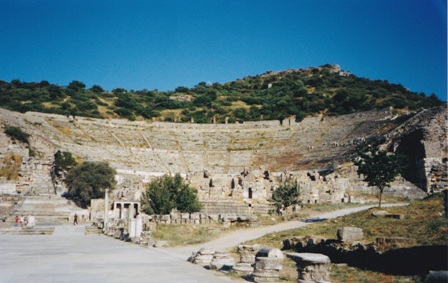 Ephesus theatre.[/caption]
Rather than staying overnight in Selcuk, drive eight kilometres further into the nearby mountains to Sirince. This perfectly preserved village has maintained its original Grecian allure and added modern Turkish charm. There is a thriving viticultural industry in the surrounding hills with many wine cellars dotted throughout, most of which offer samples to taste.
[caption id="attachment_1691" align="alignnone" width="448"]
Ephesus theatre.[/caption]
Rather than staying overnight in Selcuk, drive eight kilometres further into the nearby mountains to Sirince. This perfectly preserved village has maintained its original Grecian allure and added modern Turkish charm. There is a thriving viticultural industry in the surrounding hills with many wine cellars dotted throughout, most of which offer samples to taste.
[caption id="attachment_1691" align="alignnone" width="448"]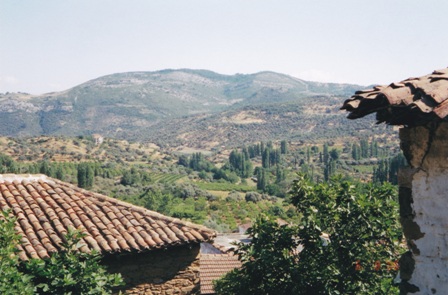 Sirince countryside is abundant with vineyards and fruit orchards.[/caption]
Sirince may have entered into Turkey’s booming tourism market but it has certainly remained off the beaten track. The Nisanyan hotel comprises a selection of several exquisitely renovated four hundred year old houses with contemporary facilities.
[caption id="attachment_1695" align="alignnone" width="364"]
Sirince countryside is abundant with vineyards and fruit orchards.[/caption]
Sirince may have entered into Turkey’s booming tourism market but it has certainly remained off the beaten track. The Nisanyan hotel comprises a selection of several exquisitely renovated four hundred year old houses with contemporary facilities.
[caption id="attachment_1695" align="alignnone" width="364"]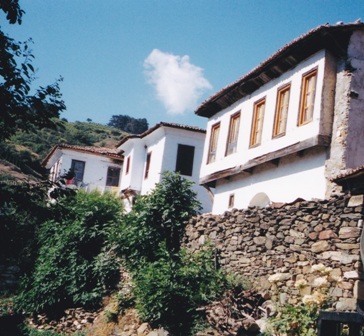 Hotel Nisanyan facade.[/caption]
The owners, a well known Turkish travel writer and his historian partner, re-discovered Sirince ten years ago and rescued the first of their houses, at the time sadly used as a donkey barn. Despite local opposition and jealous competitors, they have succeeded in creating a delightfully unique hotel.
[caption id="attachment_1692" align="alignnone" width="448"]
Hotel Nisanyan facade.[/caption]
The owners, a well known Turkish travel writer and his historian partner, re-discovered Sirince ten years ago and rescued the first of their houses, at the time sadly used as a donkey barn. Despite local opposition and jealous competitors, they have succeeded in creating a delightfully unique hotel.
[caption id="attachment_1692" align="alignnone" width="448"] Sirince town scene.[/caption]
Down the road and back on the highway from Selcuk, you enter into the ancient kingdom of Midas the “golden touch” where pinkish white marble glistens from the mountain backdrops and the valleys are painted golden green with apricot groves. Near the sea is modern Dydima, where the enormous temple dedicated to Apollo is smack in the middle of downtown.
[caption id="attachment_1699" align="alignnone" width="448"]
Sirince town scene.[/caption]
Down the road and back on the highway from Selcuk, you enter into the ancient kingdom of Midas the “golden touch” where pinkish white marble glistens from the mountain backdrops and the valleys are painted golden green with apricot groves. Near the sea is modern Dydima, where the enormous temple dedicated to Apollo is smack in the middle of downtown.
[caption id="attachment_1699" align="alignnone" width="448"]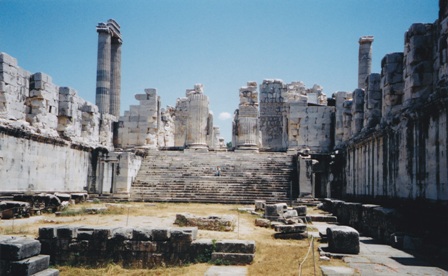 Temple to Apollo, Dydima.[/caption]
The god of light certainly knew how to pick a site for a temple dedicated to the sun. Dydima glows in its Aegean halo. This far to the south, you leave the relatively verdant northern Aegean and enter into a sun-seeker’s paradise of dry lands fragrant with wild thyme and rosemary, a sort of freely natural aromatherapy kit.
Dydima is on the way to the Bodrum peninsula, better known as ancient Halicarnassus. King Mausolus and Queen Artemisia were power mongers of the Hellenic world. The tomb built by Artemisia for her beloved husband became the world’s first mausoleum and one of its seven ancient wonders. Today Bodrum is a party town full of clubs, cafes and boutiques crammed with back-packers and package tourists, though the old village atmosphere has been miraculously preserved. Founded by the Knights of St. John in 1404, the castle of St. Peter situated on a point jutting into the Bodrum harbour also houses one of the world’s best, if not only, marine archaeology museums. What local sponge divers discovered in offshore wrecks over the last two hundred years is housed in a world heritage building. Don’t miss the house of glass with its splendidly displayed artefacts stretching from those of ancient Byzantium to early Ottoman Empire.
On the quietly exclusive northern side of Bodrum is the practically unpronounceable Golturkbuku (try Gourl-turk-bourke-ker). This village is widely considered to be the St. Tropez of Turkey. Given the number of swish cocktail bars and restaurants lining its beautiful harbour chocked full with posh yachts, I’m not surprised at the comparison. Despite the high prices, my raki cost me the price of a dinner elsewhere, Golturkbuku offers good value for celebrity seekers.
If this is the new Turkey resting comfortably against the old, I’m all for the juxtaposition, even if at the slightest notion of it, old Mausolus is turning in his famous grave.
Naked Facts:
Getting around:
Hire a car outside Istanbul. Drivers in the big Turkish smoke are crazily aggressive. Neophyte drivers in Istanbul are forewarned. All of the international car rental companies are represented in Turkey. Hire cars may be arranged for pick-up outside Istanbul where the driving is safer. Obtain a good road map before setting out. Leave the car at Bodrum’s busy airport and fly back to Istanbul. One-way flights from Bodrum to Istanbul are approximately USD$100.
Accommodation:
Ayvalik offers an abundance of seaside hotels. Check the local tourist office for current deals and availability.
At Sirince, Nisanyan House hotel can be contacted at: +90 232 898 3208 or hotel@nisanyan.com
At Golturkbuku, Turkey’s only member of the esteemed Relais & Chateaux chain, the Ada Hotel is quite simply wonderful. Contact: +90 252 377 5915 or Relais & Chateaux website.
Temple to Apollo, Dydima.[/caption]
The god of light certainly knew how to pick a site for a temple dedicated to the sun. Dydima glows in its Aegean halo. This far to the south, you leave the relatively verdant northern Aegean and enter into a sun-seeker’s paradise of dry lands fragrant with wild thyme and rosemary, a sort of freely natural aromatherapy kit.
Dydima is on the way to the Bodrum peninsula, better known as ancient Halicarnassus. King Mausolus and Queen Artemisia were power mongers of the Hellenic world. The tomb built by Artemisia for her beloved husband became the world’s first mausoleum and one of its seven ancient wonders. Today Bodrum is a party town full of clubs, cafes and boutiques crammed with back-packers and package tourists, though the old village atmosphere has been miraculously preserved. Founded by the Knights of St. John in 1404, the castle of St. Peter situated on a point jutting into the Bodrum harbour also houses one of the world’s best, if not only, marine archaeology museums. What local sponge divers discovered in offshore wrecks over the last two hundred years is housed in a world heritage building. Don’t miss the house of glass with its splendidly displayed artefacts stretching from those of ancient Byzantium to early Ottoman Empire.
On the quietly exclusive northern side of Bodrum is the practically unpronounceable Golturkbuku (try Gourl-turk-bourke-ker). This village is widely considered to be the St. Tropez of Turkey. Given the number of swish cocktail bars and restaurants lining its beautiful harbour chocked full with posh yachts, I’m not surprised at the comparison. Despite the high prices, my raki cost me the price of a dinner elsewhere, Golturkbuku offers good value for celebrity seekers.
If this is the new Turkey resting comfortably against the old, I’m all for the juxtaposition, even if at the slightest notion of it, old Mausolus is turning in his famous grave.
Naked Facts:
Getting around:
Hire a car outside Istanbul. Drivers in the big Turkish smoke are crazily aggressive. Neophyte drivers in Istanbul are forewarned. All of the international car rental companies are represented in Turkey. Hire cars may be arranged for pick-up outside Istanbul where the driving is safer. Obtain a good road map before setting out. Leave the car at Bodrum’s busy airport and fly back to Istanbul. One-way flights from Bodrum to Istanbul are approximately USD$100.
Accommodation:
Ayvalik offers an abundance of seaside hotels. Check the local tourist office for current deals and availability.
At Sirince, Nisanyan House hotel can be contacted at: +90 232 898 3208 or hotel@nisanyan.com
At Golturkbuku, Turkey’s only member of the esteemed Relais & Chateaux chain, the Ada Hotel is quite simply wonderful. Contact: +90 252 377 5915 or Relais & Chateaux website.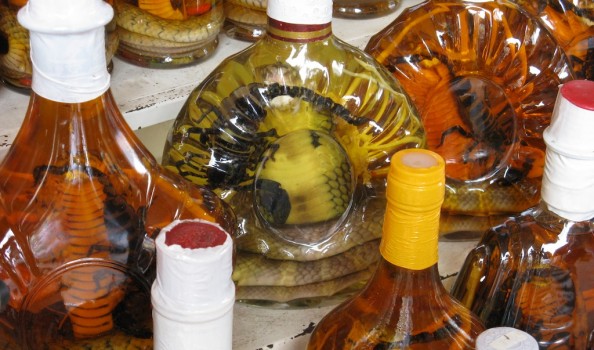 https://nakedhungrytraveller.com.au/dont-eat-the-snake/ Don’t Eat the Snake
https://nakedhungrytraveller.com.au/dont-eat-the-snake/ Don’t Eat the SnakeTravelling and reporting: responsible tourism takes its lead from responsible travel writing. Leading from the front, travel writing is supposed to set an example for those who follow. What happens if it’s a bad example?
Did you read about that lovely pristine Thai island a while ago, the one that no one visited? It was in all the backpackers’ magazines. It’s not pristine any more. Another full moon party has landed and the plastic rubbish left behind on the beach each month stays there. The island has no recycling system or rubbish removal. It doesn’t have a sewerage system either. What a pity about all the garbage on the beach and the raw sewage in the water. It has lost all its appeal now. Do you feel the need to get away from it all? Siberia? Tibet? The Amazon? Alaska? Borneo? The Congo? Did you read the feature in the glossy monthly magazine about the trip of a lifetime? It all seemed amazingly attractively remote. The trackless wildernesses that remain are either being logged wantonly or rent with sealed roads to engender free access for more tourism to benefit the economy simultaneously allowing mining, wildlife poaching, more logging and eventually permanent settlement without the infrastructure to support it. The short-term jobs created by short-term pillage pay little to the locals. The big profits nearly always go somewhere else. But let’s not focus too much on the facts; they get in the way of a good story, right? By all means, go there while you can. See it while it lasts. Before everyone else does at least… In an article that recently appeared in the weekend travel section of a respected newspaper, the author gave an account of his lunch at a restaurant located near Hanoi. He ate a snake. In increasingly vivid detail, he described the preparation of the meal with meticulous remarks about flavour, texture and the apparent male sexual energy boost derived from drinking the live snake’s bile stirred into Mekong whisky, a kind of serpent Cialis shooter. I question the story’s failure to address the ethical dilemmas that it clearly presents: that it is wrong to bring a live snake to a table to kill it with a razor blade and extract its bile while its heart still beats, to remove its lung, liver and other organs and finally to skin it in order to carve its flesh from its skeleton to put into a soup. That snakes are being harvested in the wild to serve a trade which harms the local environment and ultimately the people who live there. My respect for snakes is maintained through mutually well-defined distance; we are not close companions. However, I would not authorise via payment the torture of any animal, no matter how little regard I had for it, nor would I endorse its slaughter to provide a cocktail mixer and a bowl of soup. The reporting of its death was neither fair nor balanced. What is important is the journalistic nonchalance that uses a cheapened life, even a snake’s life, to milk a story out of cultural difference perceived as ersatz exoticism. Will the article influence its readers to include a snake banquet on their next trip to Vietnam? No, it probably won’t. What it will do however is encourage its readers to think that it’s perfectly acceptable to buy a snake when they do visit Vietnam (cobras are more expensive by the way) and have it executed without bearing a guilty conscience. “What’s the chef’s special? Snake you say? Ah yes, I read about that. It sounds good. Let’s have it. Gosh, I can’t wait to tell my friends at home about this.” Possibly, more underpaid snake wranglers will catch more snakes to sell to restaurateurs because they’ve had an increase in business from other countries, where this meal would likely be illegal. The environmental ramification implicit in the ensuing snake vs. rodent population imbalance was not discussed in the luncheon of snake travel article. There was no consideration made in regards to the environmental and moral issues. The natural scarcity or rarity of the species of snakes on the menu was not investigated. The writer’s gauche lunch in Vietnam panders to the tourist as voyeur. The subject is moral turpitude posing as an easily obtainable thrill. I consider this a sad tourism fantasy. It’s a metaphor for the tip of the sinking iceberg of global tourism with nary a thought given to the inherent social, environmental and ecological consequences. Disaster looms on many dot points. To connect the dots is to see a bleak outline. I believe the snake lunch in Vietnam to be an example of the worst sort of ubiquitous gonzo travel writing that encourages misguided travellers to ignore their collective impact wherever they go. I offer the snake lunch article as an insight into how a too cute story can result in unforseen, possibly dire circumstances. Multiply this type of story hundreds of times, written by irresponsible journalists around the world, read by millions of people and it’s little wonder that so much of the world is being literally trampled underfoot, eaten into oblivion, trashed indiscriminately and lost forever to gross popularity. If we’re not being coerced for the sake of “the experience” to eat a snake in Vietnam, we’re being dared to sup on another expensive bowl of shark’s fin soup in Hongkong when visiting on a “shopover”. Have you seen a shark off the coast of Southeast China lately? There are almost none left. They’ve gone into the famous soup you have to try at least once, right down to the last shark left in the world’s oceans. The shark is caught, its dorsal fins are sliced off and its crippled body is thrown back into the water where it dies shortly thereafter. The special soup was featured in an article on the exciting Hongkong food scene in another mass circulation newspaper. Score ten for the ignorant gourmand and zero for the shark. Responsible travel writing has the potential to help secure the ecological and environmental health of the planet we share. It is possible to tell the truth objectively, to help the reader to manage his/her expectations, to illuminate, perhaps to educate without accompanying patronising cant and to write a jolly good read that fosters a desire to venture forth responsibly. I believe it is necessary to help preserve the destinations described or perhaps help to improve them. Responsible tourism needn’t take the fun out of travel. Nor should the reporting of it take the fun out of reading about it. There is certainly no dearth of options when a responsible traveller decides to go on a trip somewhere to benefit the locals, their environment and perhaps their culture. The numerous study trips available through universities, scientific foundations, charities and eco-friendly tourism operators are myriad in their reach and price range. A conscientious travel writer need only pay attention to his creative ethic as he nurtures his sense of responsibility in helping to assure that the destination will be preserved for everyone instead of just the lucky few that may travel there before all the rest. The environmentalist’s mantra of “leave behind only footprints”, while not rejected is hardly endorsed universally by the greater tourism industry. Many industry opinion makers, i.e. travel writers, do not appear to adhere to a Code of Practice regarding what is widely known as Responsible Tourism. Are these one-eyed writers to be believed when they express dismay about the corner of the world they always held dear, wrote about glowingly, promoted to readers far and wide, when they discover it has been subsequently ruined by eager tourists (readers) whose feet left behind a hell of a lot more than footprints? Fellow writers, beware what you sow, so shall you reap and that snake will come back and bite you. What is Responsible Tourism? Eco-tourism is described by the The International Ecotourism Society (TIES) as: “Responsible travel to natural areas that conserves the environment and improves the well-being of local people." Responsible tourism takes the principles of eco-tourism, but recognises that they apply to all tourism, not just to natural areas. Responsible tourism can be more-or-less defined as travel that takes into consideration the ‘triple bottom line’ issues of: • Environment: travel that minimises negative environmental impacts and, where possible, makes positive contributions to the conservation of biodiversity, wilderness, natural and human heritage. Where travellers and locals learn and share information leading to better appreciation and understanding. • Social/Cultural: travel that respects culture and traditions and recognises the rights of all peoples to be involved in decisions that affect their lives and to determine their future. By involving and engaging local people, there is authentic interaction and greater understanding between travellers and hosts, which builds cultural pride and community confidence. • Economic: travel that has financial benefits for the host community and operates on the principles of fair trade. Monies spent by travellers remain in the community through the use of locally-owned accommodation, staff and services; funding community initiatives, training or other in-kind support. * * Excerpt from Code Green: Trips of a Lifetime that Won’t Cost the Earth, by Kerry Lorimer, Co-ordinating author, published by Lonely Planet, April 06.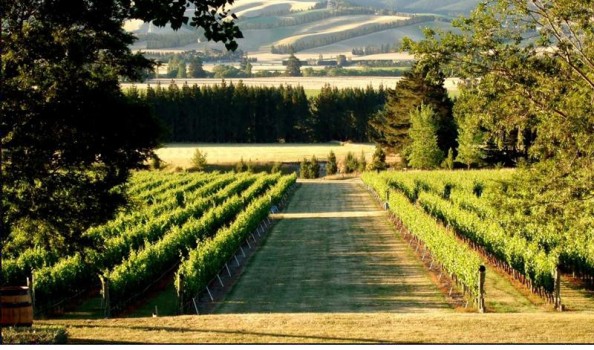 https://nakedhungrytraveller.com.au/winding-a-way-in-the-waipara/ Winding a Way in the Waipara
https://nakedhungrytraveller.com.au/winding-a-way-in-the-waipara/ Winding a Way in the WaiparaThere’s more depth to the Kiwi wine scene than bucket loads of Sauvignon Blanc.
The Marlborough region is dumping wine in huge quantities on the global market. Credit given where credit is due; some of the gooseberry infused S.B. from the northern parts of the South Island is eminently quaffable. Quaffable yes, but also boring and predictable. Wind your way down, or up, to the Waipara for a walk on the wild side of wine. Not famous, yet, this region is the newest kid to emerge from the Kiwi vine block. Cool climate, scenic and conveniently located, a real pity it’s often overlooked in favour of the well-known South Island regions, Marlborough or Central Otago. Sixty minutes drive time from Christchurch’s CBD will land you in the middle of this pocket of fine wine land. [caption id="attachment_1641" align="alignnone" width="448"] Waipara landscape.[/caption]
As it’s still relatively new, the first vines were planted here in the early 80s, the Waipara remains a closely knit community of keen grape growers and talented winemakers. Large scale wine tourism hasn’t hit hard. Instead a visit here involves direct interaction with owner/operators. Cellar doors are usually small cosy spaces run by the winemakers themselves, friendly and welcoming.
Dominant grape varieties in the Waipara are Pinot Noir, Riesling and Chardonnay, the king makers in the world of wine.
[caption id="attachment_1642" align="alignnone" width="336"]
Waipara landscape.[/caption]
As it’s still relatively new, the first vines were planted here in the early 80s, the Waipara remains a closely knit community of keen grape growers and talented winemakers. Large scale wine tourism hasn’t hit hard. Instead a visit here involves direct interaction with owner/operators. Cellar doors are usually small cosy spaces run by the winemakers themselves, friendly and welcoming.
Dominant grape varieties in the Waipara are Pinot Noir, Riesling and Chardonnay, the king makers in the world of wine.
[caption id="attachment_1642" align="alignnone" width="336"] Waipara vintage harvest.[/caption]
Only two wineries could reasonably be called middle sized, Pegasus Bay Winery (263 Stockgrove Road, T: +64 (0)3 314 6869 www.pegasusbay.com) and Mud House Winery & Café (780 Glasnevin Road, T: +64 (0)3 314 6900 www.mudhousewineryandcafe.co.nz). Both are open 7 days.
Torlesse Wines (Loffhagen Drive, Tel: +64 (0)3 314 6929 www.torlesse.co.nz) and Waipara Springs Winery & Café (SH1, Tel: +64 (0)3 314 6777 www.waiparasprings.co.nz) are definitely in the realm of boutique sized but they’re also open 7 days per week.
Greystone Wines (SH1, 376 Omihi Road, Tel: +64 (0)3 314 6100 www.greystonewines.co.nz) is open October-April from Friday-Sunday 11am – 5pm. The same opening hours apply to Fiddler’s Green winery (246 Georges Road, Tel: +64 (0)3 314 6979 www.fiddlersgreen.co.nz).
All other wineries in the Waipara are open to the public by appointment only. It’s not a case of snobbery in action, more a lack of overall visitation. The number of annual visitors here is few. It’s more cost effective for wineries to open doors to travellers when a personalised request is made. Canny Kiwis don’t waste time or money.
A trip to the Waipara does require some advance planning in order to take advantage of all the winery visits this region has to offer. As so many wineries are open only with advance notice, my experience has been more like a celebrity tour. If a visitor is keen enough to contact the winery to request a tasting, the red carpet is rolled out to welcome him or her.
Here are a few wineries that should be placed high on your ‘must visit’ list: Mountford Estate (Tel: +64 (0) 3 314 6199), Dancing Water (Tel: +64 (0)3 314 6114), Harris Estate (+64 (0)3 314 6767) and Mount Brown (Tel: +64 (0)3 314 352 3191).
The effort of contacting the wineries before dropping in becomes a relatively effortless and pleasant exercise when the proximity of one winery to another is taken into account. That and the fact that the wines are so bloody good, moderately priced, hence great value for money.
Cycling between wineries is a recommended option. They stretch out along a beautifully sited valley for approximately ten kilometres. The terrain is mostly flat and the roads don’t carry much traffic. Few wine regions in the world compete on this scale of easy access.
Tip: The best option is to hire a bicycle in Christchurch from one of many bike shops scattered around town. Bike hire in the Waipara isn’t possible. But it is possible to transport a bike to the Waipara via the daily coach service or hire a bike rack when renting a vehicle.
Naked Facts:
Accommodation in the Waipara is also small scale. There are no large hotels or motels. Luxury cottages or B & B is the only choice. Try Dry Paddocks Country Retreat (two bedroom fully self-contained cottage, 325 Purchas Road, Amberley, Tel +64 (0)3 314 9639 www.drypaddocks.co.nz) or Annie’s Loft & Studio (169 Mackenzies Road, Waipara Valley, Tel: +64 (0)3 314 6184 www.anniesloft.co.nz) or Dunnolly Luxury Vineyard Cottage and Villa (157 Church Road, Waipara Valley, Tel: +64 (0)3 314 6940 www.vineyardcottage-dunnolly.com).
I ate at Mud House Café and enjoyed it. Pegasus Bay Winery runs a reputable restaurant. Overall choices are limited however. Some self-catering may be necessary. The Nor’Wester Café in Amberley (Tel: +64 (0)3 314 9411) comes highly recommended and is open 7 days, a rarity in this part of rural New Zealand.
My magic Waipara moment occurred when I climbed to the top of The Gradient vineyard at Mountford Estate and was rewarded with a gob-smacking view over the valley, beyond the Canterbury Plains and right up to the Southern Alps. Behind me were lush green rounded hills reaching eastward to the southern Pacific Ocean. Sheep studded the surrounding slopes like fluffy moving shrubbery.
The joy I felt at being one with such a stunning landscape was increased tenfold when I tasted the Pinot Noir from The Gradient vineyard. It was simply one of the finest wines I’ve had all year and certainly ranks among the best made in New Zealand.
All cycling from then on was too easy.
The Waipara region is about an hour’s drive north of Christchurch. Daily bus services pass through frequently. The Waipara is dissected by National Highway One. For convenience, hiring a rental vehicle is recommended. Most major car rental companies operate from Christchurch’s international airport.
Christchurch is open for business and recovering quickly since the earthquakes struck in 2010 and 2011. The international airport has never closed. All major roads in and out of town are fully repaired. See www.christchurchnz.com for more information about accommodation and touring options.
Waipara vintage harvest.[/caption]
Only two wineries could reasonably be called middle sized, Pegasus Bay Winery (263 Stockgrove Road, T: +64 (0)3 314 6869 www.pegasusbay.com) and Mud House Winery & Café (780 Glasnevin Road, T: +64 (0)3 314 6900 www.mudhousewineryandcafe.co.nz). Both are open 7 days.
Torlesse Wines (Loffhagen Drive, Tel: +64 (0)3 314 6929 www.torlesse.co.nz) and Waipara Springs Winery & Café (SH1, Tel: +64 (0)3 314 6777 www.waiparasprings.co.nz) are definitely in the realm of boutique sized but they’re also open 7 days per week.
Greystone Wines (SH1, 376 Omihi Road, Tel: +64 (0)3 314 6100 www.greystonewines.co.nz) is open October-April from Friday-Sunday 11am – 5pm. The same opening hours apply to Fiddler’s Green winery (246 Georges Road, Tel: +64 (0)3 314 6979 www.fiddlersgreen.co.nz).
All other wineries in the Waipara are open to the public by appointment only. It’s not a case of snobbery in action, more a lack of overall visitation. The number of annual visitors here is few. It’s more cost effective for wineries to open doors to travellers when a personalised request is made. Canny Kiwis don’t waste time or money.
A trip to the Waipara does require some advance planning in order to take advantage of all the winery visits this region has to offer. As so many wineries are open only with advance notice, my experience has been more like a celebrity tour. If a visitor is keen enough to contact the winery to request a tasting, the red carpet is rolled out to welcome him or her.
Here are a few wineries that should be placed high on your ‘must visit’ list: Mountford Estate (Tel: +64 (0) 3 314 6199), Dancing Water (Tel: +64 (0)3 314 6114), Harris Estate (+64 (0)3 314 6767) and Mount Brown (Tel: +64 (0)3 314 352 3191).
The effort of contacting the wineries before dropping in becomes a relatively effortless and pleasant exercise when the proximity of one winery to another is taken into account. That and the fact that the wines are so bloody good, moderately priced, hence great value for money.
Cycling between wineries is a recommended option. They stretch out along a beautifully sited valley for approximately ten kilometres. The terrain is mostly flat and the roads don’t carry much traffic. Few wine regions in the world compete on this scale of easy access.
Tip: The best option is to hire a bicycle in Christchurch from one of many bike shops scattered around town. Bike hire in the Waipara isn’t possible. But it is possible to transport a bike to the Waipara via the daily coach service or hire a bike rack when renting a vehicle.
Naked Facts:
Accommodation in the Waipara is also small scale. There are no large hotels or motels. Luxury cottages or B & B is the only choice. Try Dry Paddocks Country Retreat (two bedroom fully self-contained cottage, 325 Purchas Road, Amberley, Tel +64 (0)3 314 9639 www.drypaddocks.co.nz) or Annie’s Loft & Studio (169 Mackenzies Road, Waipara Valley, Tel: +64 (0)3 314 6184 www.anniesloft.co.nz) or Dunnolly Luxury Vineyard Cottage and Villa (157 Church Road, Waipara Valley, Tel: +64 (0)3 314 6940 www.vineyardcottage-dunnolly.com).
I ate at Mud House Café and enjoyed it. Pegasus Bay Winery runs a reputable restaurant. Overall choices are limited however. Some self-catering may be necessary. The Nor’Wester Café in Amberley (Tel: +64 (0)3 314 9411) comes highly recommended and is open 7 days, a rarity in this part of rural New Zealand.
My magic Waipara moment occurred when I climbed to the top of The Gradient vineyard at Mountford Estate and was rewarded with a gob-smacking view over the valley, beyond the Canterbury Plains and right up to the Southern Alps. Behind me were lush green rounded hills reaching eastward to the southern Pacific Ocean. Sheep studded the surrounding slopes like fluffy moving shrubbery.
The joy I felt at being one with such a stunning landscape was increased tenfold when I tasted the Pinot Noir from The Gradient vineyard. It was simply one of the finest wines I’ve had all year and certainly ranks among the best made in New Zealand.
All cycling from then on was too easy.
The Waipara region is about an hour’s drive north of Christchurch. Daily bus services pass through frequently. The Waipara is dissected by National Highway One. For convenience, hiring a rental vehicle is recommended. Most major car rental companies operate from Christchurch’s international airport.
Christchurch is open for business and recovering quickly since the earthquakes struck in 2010 and 2011. The international airport has never closed. All major roads in and out of town are fully repaired. See www.christchurchnz.com for more information about accommodation and touring options.
The Naked Truth
-

 Family Travelling Travails – Thanks for the Memories?
January 26, 2017
Family Travelling Travails – Thanks for the Memories?
January 26, 2017 -

 Making LAX Bearable
November 27, 2015
Making LAX Bearable
November 27, 2015 -

 Eat, Drink and Be Rich
December 13, 2014
Eat, Drink and Be Rich
December 13, 2014

-

 / Krakow: Bright Future, Dark Past /
/ Krakow: Bright Future, Dark Past / -

 / Family Travelling Travails - Thanks for the Memories? /
/ Family Travelling Travails - Thanks for the Memories? / -

 / Making Most of the Macedon Ranges /
/ Making Most of the Macedon Ranges / -

 / Tokyo Temptations /
/ Tokyo Temptations / -
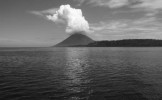
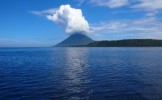 / Sulawesi and Ambon -- Spice and Pirates /
/ Sulawesi and Ambon -- Spice and Pirates / -

 / Kyoto, the Jewel of Japan /
/ Kyoto, the Jewel of Japan / -

 / Doing the Voodoo in New Orleans and Other Fun Stuff /
/ Doing the Voodoo in New Orleans and Other Fun Stuff / -

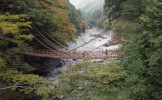 / Shikoku, Japan's Not So Little Island /
/ Shikoku, Japan's Not So Little Island / -

 / Beechworth Worthiness /
/ Beechworth Worthiness / -
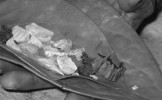
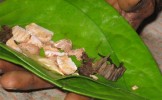 / Hot and Not So Hot, Indian Food /
/ Hot and Not So Hot, Indian Food / -
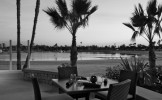
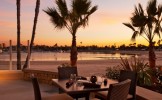 / Making LAX Bearable /
/ Making LAX Bearable / -
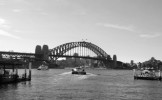
 / Sydney: Beyond Thunderdome? /
/ Sydney: Beyond Thunderdome? / -

 / Myanmar Meandering Pagan to Mandalay /
/ Myanmar Meandering Pagan to Mandalay / -

 / Wholly Shasta /
/ Wholly Shasta / -

 / Mexico Magic /
/ Mexico Magic / -

 / Getting Off the Great Ocean Road /
/ Getting Off the Great Ocean Road / -
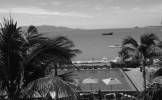
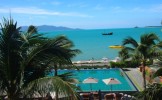 / Thailand Can Be a Beach /
/ Thailand Can Be a Beach / -

 / Myanmar Meandering in Yangon /
/ Myanmar Meandering in Yangon / -

 / Australia's Best Gourmet Region /
/ Australia's Best Gourmet Region / -

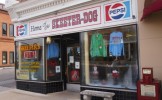 / The Road to America /
/ The Road to America / -

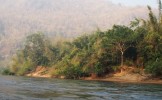 / Many Bridges On This Kwai /
/ Many Bridges On This Kwai / -

 / Pointing Towards P'town /
/ Pointing Towards P'town / -
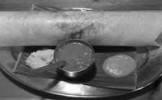
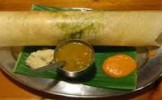 / Chennai on a Plate /
/ Chennai on a Plate / -

 / Jawing on Javanese Food /
/ Jawing on Javanese Food / -

 / From Stockholm to Turku via Aland /
/ From Stockholm to Turku via Aland / -

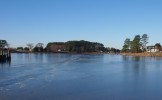 / America’s Magical Bay /
/ America’s Magical Bay / -

 / Kaikoura Capers /
/ Kaikoura Capers / -

 / Considering the Cook Islands /
/ Considering the Cook Islands / -

 / Dozing in Darwin During the Wet /
/ Dozing in Darwin During the Wet / -

 / Eating Green in the USA /
/ Eating Green in the USA / -

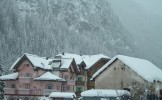 / Bella Italia! /
/ Bella Italia! / -

 / Escape to Windy Wellington /
/ Escape to Windy Wellington / -

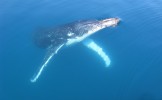 / Where the Whales Play /
/ Where the Whales Play / -

 / Sailing Against the Aegean /
/ Sailing Against the Aegean / -

 / Off-Beaten Track in Ireland /
/ Off-Beaten Track in Ireland / -

 / Temples and Tears in Cambodia /
/ Temples and Tears in Cambodia / -

 / The Heart of the Jungle /
/ The Heart of the Jungle / -

 / Swimming with Sharks in Fiji /
/ Swimming with Sharks in Fiji / -

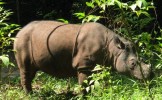 / Sumatra’s Rarest Animals /
/ Sumatra’s Rarest Animals / -

 / The Perfect Island? /
/ The Perfect Island? / -

 / Orangutans and Others /
/ Orangutans and Others / -

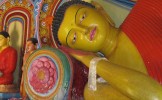 / The Road to Nirvana /
/ The Road to Nirvana / -
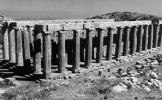
 / Greece Is The Word /
/ Greece Is The Word / -

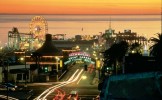 / Santa Monica, End of the Road /
/ Santa Monica, End of the Road / -

 / Canberra's Not Dead /
/ Canberra's Not Dead / -

 / Iceland in Winter, Why Bother? /
/ Iceland in Winter, Why Bother? / -

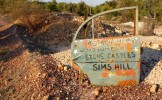 / Opal Odyssey /
/ Opal Odyssey / -
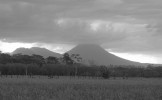
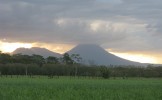 / By the Shade of Arenal, Costa Rica's Perfect Volcano /
/ By the Shade of Arenal, Costa Rica's Perfect Volcano / -
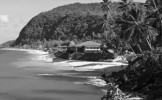
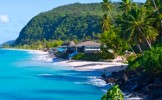 / Dateline, Samoa /
/ Dateline, Samoa / -

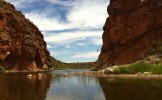 / Hot Alice! /
/ Hot Alice! / -
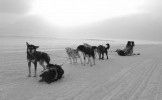
 / Dog Sledging Svalbard Style /
/ Dog Sledging Svalbard Style / -

 / All Sides Oslo /
/ All Sides Oslo / -

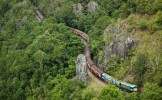 / Getting High in FNQ /
/ Getting High in FNQ / -

 / Do You Tango in Buenos Aires? /
/ Do You Tango in Buenos Aires? / -
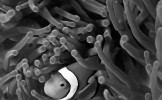
 / Troppo in FNQ /
/ Troppo in FNQ / -
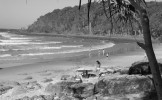
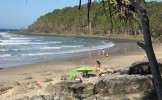 / Noshing Round Noosa /
/ Noshing Round Noosa / -

 / Volcanic Cults Explode on Tanna /
/ Volcanic Cults Explode on Tanna / -

 / London’s Best Digs? /
/ London’s Best Digs? / -

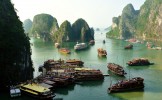 / Venturing into Vietnam /
/ Venturing into Vietnam / -

 / Rustic Rutherglen Gets Fresh /
/ Rustic Rutherglen Gets Fresh / -
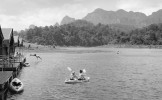
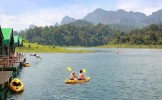 / Between Beaches in Thailand /
/ Between Beaches in Thailand / -
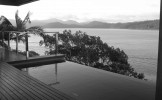
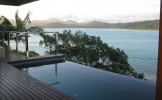 / What’s a Qualia? /
/ What’s a Qualia? / -
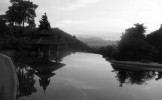
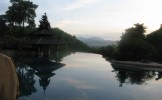 / Opium and Elephants in the Golden Triangle /
/ Opium and Elephants in the Golden Triangle / -

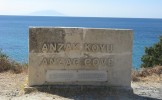 / Turn Left When You Leave Istanbul /
/ Turn Left When You Leave Istanbul / -
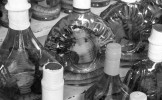
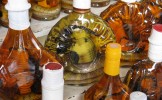 / Don’t Eat the Snake /
/ Don’t Eat the Snake / -

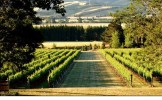 / Winding a Way in the Waipara /
/ Winding a Way in the Waipara /

Where we’ve been
Are you a fan of Naked?
Click here for information about our upcoming small group tours to the world's most exciting destinations specially chosen for NHT readers.
[nm-mc-form fid="4"]
Chesapeake Bay’s huge expanse of broad water and inlets has for centuries been Washington DC’s playground, the nation’s aquatic backdrop, its naval headquarters and unfortunately, a dumping ground for all kinds of industrial and agricultural waste.
Traveller Alert!
Below is a press release circulated late last year on various wire services:
‘October 15, 2013, TripAdvisor, Inc. today announced it has acquired Oyster.com, a hotel review website site featuring expert reviews and photos covering about 150 cities. Oyster will continue to operate out of New York City and will be incorporated into Smarter Travel Media. “We’re pleased to add the Oyster team to the TripAdvisor family,” said Steve Kaufer, co-founder and CEO TripAdvisor, Inc. “Oyster has created some wonderful photo and editorial content of hotels in popular destinations and it will be a strong addition to the TripAdvisor brand.” Terms of the acquisition will not be disclosed.’
I recently contacted Oyster.com in reference to an advertisement seen on MediaBistro.com in mid-January 2014 calling for freelance writers interested in contributing hotel reviews to the website.
Within one week, I received this email in response:
‘Hi Tom Neal,
Thanks so much for your interest in Oyster.com and for applying for the role of Freelance Hotel Review Writer. We’re happy to tell you that you’ve made it to the second phase of our interview process! Congrats!
Oyster.com is a hotel research tool that provides expert reviews and photos, and we’re getting ready to review more hotels around the world. Our photographers will visit thousands of hotels in the coming year, and they will provide our writers with surveys from their visits and hundreds of high-quality photos for each hotel (allowing the writer to get a visual tour of the property).
Since we will be covering so many hotels, we are looking for writers who will work with us on an ongoing basis and who will have the bandwidth for 10-20 hotel reviews a week. We will be hiring two people in the short-term, and will be looking to bring on more writers in the coming months.
We pay $50 per 500-word review that you write. Please note that this role does not involve travel.
****If you’re interested in the position, we’re asking that you complete an edit test for us.**** This allows us to compare qualified applicants “apples to apples” and is a crucial part of our recruitment process.
WRITING TEST
• Deadline: Monday, Jan. 27th, 5 p.m. EST
• To submit your test, reply to this email and ATTACH your work as a document.
• PLEASE VIEW INSTRUCTIONS HERE: http://bit.ly/19LPQen
Please let us know if you are planning to do the test. We look forward to reviewing your work!
Best,
The Oyster.com Team
I quote the Oyster.com email in full but am unable to quote my response as it was sent via Oyster.com’s CMS email system and I’m unable to retrieve it.
I can summarise my reply here.
I refused the offer of work as I believe an honest hotel review should be written based on the writer’s experience of staying at the hotel. I pointed out that my integrity as a critic would be jeopardised if I contributed to Oyster.com under these circumstances. I stated that I didn’t believe it possible to review a hotel I’d never even seen much less slept in. I also pointed out that the payment of 10 cents per word was derisory.
Here are a number of photo examples Oyster.com provided upon which I was to base my review as part of their application to contribute process. All the photos were sent in low res format. I haven’t altered the size of the files.
What does this all mean for travellers?
From my point of view, the major problem with the content on user generated travel websites is that it’s too easily manipulated and is often based on erroneous data collection. The other outstanding problem is the one of unfair criticism.
For instance, TripAdvisor is continually having problems in managing its content. Too many competitors with axes to grind against competing businesses have got away with writing negative reviews based purely upon jealousy or anger or both. Those reviews get published and the innocent victims are business owners trying to run their operations as best they can.
For owners of very small hotels and restaurants who are doing the right thing, too much valuable time can be spent replying to un-justified and erroneous complaints sent in by shonky operators or jealous competitors.
TripAdvisor has attempted to rectify the problems with its monitoring system but large gaps continue to cause great damage in the overall hospitality framework.
Good operators suffer while dishonest operators manipulate TripAdvisor to their own advantage.
Of course the ones who suffer most are readers and users.
Any reader naive enough to rely on Oyster.com for an authentic hotel review should study the facts first.
The reviews are not based on an actual experience.
The reviews are written based on a cursory scan of neutral photographs of properties the author has no actual experience visiting in person.
Imagine a film review based on a press release, the reviewer didn’t see the film. Or a theatrical review where the critic didn’t see the play? Or an automobile review the writer didn’t drive?
Would any sensible person take those reviews seriously?
I believe not.
A hotel review written based on zero personal experience, not seeing it or sleeping in it, is just as misleading to the reader.
It’s time to talk seriously and critically about the elephant in the room.
The press release of October 15, 2013 finishes here:
‘About TripAdvisor TripAdvisor® is the world’s largest travel site*, enabling travelers to plan and have the perfect trip. TripAdvisor offers trusted advice from real travelers and a wide variety of travel choices and planning features with seamless links to booking tools. TripAdvisor branded sites make up the largest travel community in the world, with more than 260 million unique monthly visitors**, and more than 100 million reviews and opinions covering more than 2.7 million accommodations, restaurants and attractions. The sites operate in 34 countries worldwide, including China under daodao.com. TripAdvisor also includes TripAdvisor for Business, a dedicated division that provides the tourism industry access to millions of monthly TripAdvisor visitors.’
Be aware travellers, be very aware.
Kaikoura, the town where the mountains meet the sea on the east coast of New Zealand’s South Island has attained a well-deserved reputation for eco-tourism.
Australia is well known internationally for its vibrant regional tourism scene, primarily driven by landscapes and wildlife.
Ask a typical international traveller what they think of when they consider Australia (if they do at all) and they’ll respond in one of two ways, wildlife: kangaroos, koalas and maybe platypus or landscape: Uluru, Great Barrier Reef and maybe Kakadu.
The ATC (Australia Tourism Commission see www.tourism.australia.com) has for decades based its international marketing campaigns largely on those holy grails of Australian tourism. Scenery dominates almost all television and print media coverage, which isn’t necessarily a bad approach. Uluru, the Great Barrier Reef and Kakadu are all unique and should be visited by tourists bent on signing off on their personal bucket lists.
But times are changing, largely due to an ever increasing sophistication of tastes and social media’s widening reach into markets dominated by food and wine tourists intent on exploring culture represented by what local people eat and drink.
The difference between people who eat (and drink) to live and people who live to eat (and drink) is more distinct than ever. Let’s face it, mass produced fast food and soft drinks will always appeal to lowest common denominator demographics where price is the primary decision maker. I’m talking about real statistics here and though there are always exceptions to every rule, the difference in average tourism spend between a Macca’s eating Coke drinking regular customer and one who avoids Macca’s and Coke as authentic sustenance is noticeably distinct.
Honestly speaking, I’ve never seen a McDonald’s food wrapper or an empty plastic bottle of Coke left behind at a boutique wine cellar door as carelessly tossed rubbish. It’s as if a social divide exists between one customer base and another. A Macmeal and Coke consumer tends not to care very much about saltbush fed lamb and Pinot Noir.
My theory about food and wine oriented tourism in Australia is a simple one based on close observation over a number of years.
In marketing terms, wine is the early adaptor. Wineries set the pace and other tourism businesses follow once a clear market led by visitors keen not only to buy wines, but dine and rest well when doing so is identified.
When an interesting, small-scale, family owned local wine industry is established, a few smart restaurateurs set up shop to take advantage of growing numbers of cellar door visitors and the significantly increased local customer base, a process that takes about ten years.
After another ten years or so, a few really outstanding boutique accommodation places open their doors to visitors looking for somewhere lovely to lay their heads and rest their stomachs after consuming bucket loads of great wine and food. Good-bye Country Comfort, Flag Inn and other bog standard motels and hello Hunter Valley’s Tower Lodge (www.towerestatewines.com), Barossa Valley’s The Louise (www.thelouise.com.au), Lower Alpine Valleys in Victoria the Lindenwarrah Lodge (www.lancemore.com.au) and Margaret River’s Cape Lodge (www.capelodge.com.au) citing for example, four outstanding small boutique hotels whose businesses are almost totally reliant on wine tourism.
Eventually, a thriving industry of concomitant businesses creates a self-sustaining local economy based on tourism, food, wine and all the operators involved in purveying goods and services to those businesses. Well trained hospitality employees settle in these wine and food driven regional areas and very soon the roll on effect of infused fresh energy adds more pizzazz to the entire scene.
Here’s a short list of established Australian wine and food driven tourist areas: in New South Wales it’s the Hunter Valley, Orange district, Mudgee district and around Canberra and Yass. In South Australia it’s the Barossa, Clare and Eden Valleys, the Adelaide Hills, McLaren Vale and Coonawarra. In Western Australia it’s the Margaret River region and the Great Southern region around Denmark and Frankland. In Tasmania it’s the Tamar Valley and Piper’s Brook region near Launceston and the Upper Derwent River and Coal River Valley outside Hobart. Victoria’s list of wine focussed tourism regions is the longest in Australia: Yarra Valley, Mornington Peninsula, the Beechworth region, Macedon Ranges to Daylesford, the northern Otway slopes around Birregurra to Bannockburn near Geelong, the Bellarine Peninsula, the King and Ovens Valley, Rutherglen, Milawa to Shepparton and the Goulburn Valley into the Strathbogie Ranges, West Gippsland around Leongatha and East Gippsland around Bairnsdale. Queensland’s Granite Ranges is the state’s best wine region and is slowly developing a more tantalising dining scene as a couple top end boutique hotels join the fun.
Tourism driven by wineries is worth over 1 billion dollars annually. Some state tourism authorities understand that fact and make use of it, most don’t.
South Australia’s tourism marketing campaign is largely driven by a food and wine focus, Victoria’s to a slightly lesser extent though in Victoria it’s the regions that drive the wine tourism marketing campaign, not the state tourism authority as a whole. Tasmania’s wine tourism is still in its nascent stage but improving as it grows in scale and reach. New South Wales and Queensland both lag behind in wine driven tourism marketing, seeing it more as a value add rather than a driver in and of itself. Western Australia’s wine tourism marketing is almost entirely focussed on the Margaret River region and suffers because of the lack of comprehensive coverage.
All states and territories tourism authorities are well advised to take note of the extraordinary value inherent in promoting wine and food tourism.
Travellers who love to eat and drink, discovering keys to local culture through interaction with people who care about what they eat and drink and the environment from which they source their livelihoods, spend more per capita than the average tourist does.
About Us
Why naked? We get asked this all the time.
As much as we’d like to say it’s because with bodies like ours, we have nothing to be ashamed of, but that’s not the case, not by a long shot. Instead we describe ourselves as Naked Hungry Travellers because we’re nakedly honest and we’re hungry for everything wonderful about travel.
Read more...
Copyright © 2014
Last Tweets
- RT @vince05656201: At our local Indian restaurant. “We offer a complimentary rice for one dollar”, Jun 4
- RT @vanbadham: I wept in terror. https://t.co/Y5okZfIB1f, Jun 2
- After years of unimaginative paint-by-numbers restaurant reviews in The Age @BeshaRodell is making a difference. Vola Foods. Thank you!, May 24
- I wonder how their break up is going. https://t.co/Ktg27U246v, May 23
- I wonder what will happen when Shorten and Morrison bump into each other around the back bench., May 21


